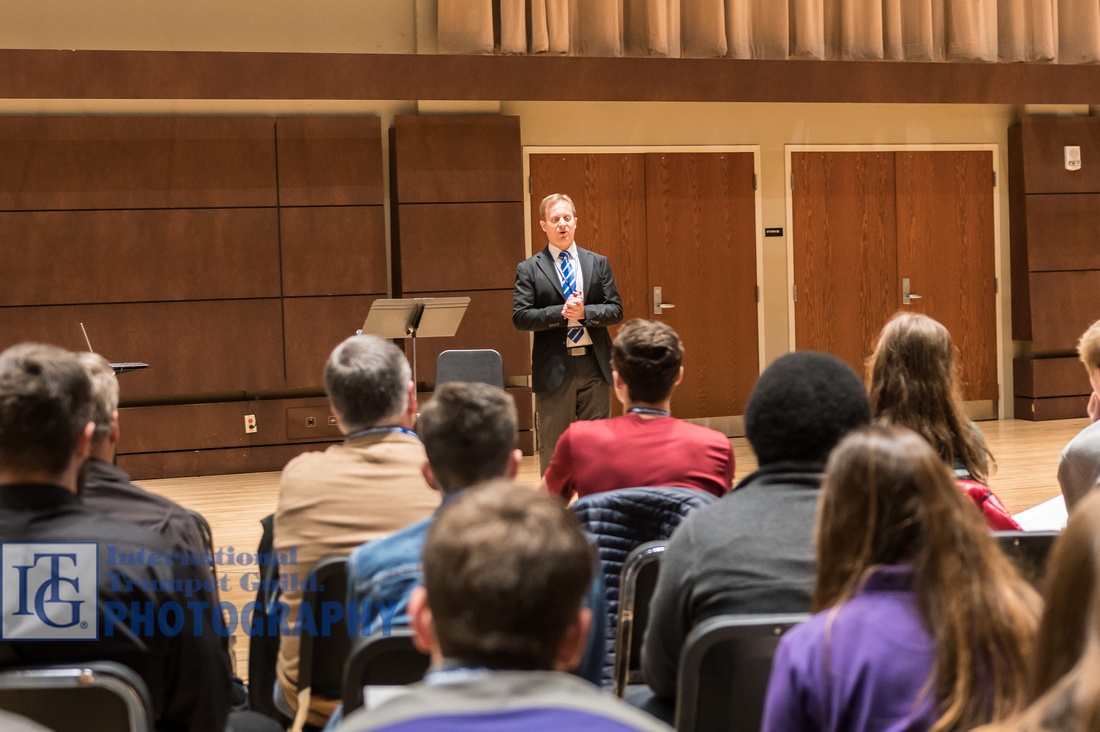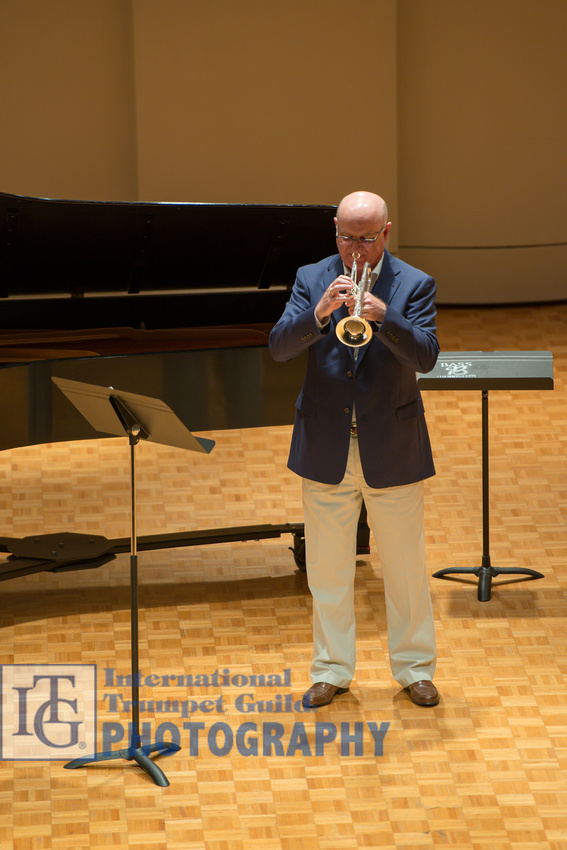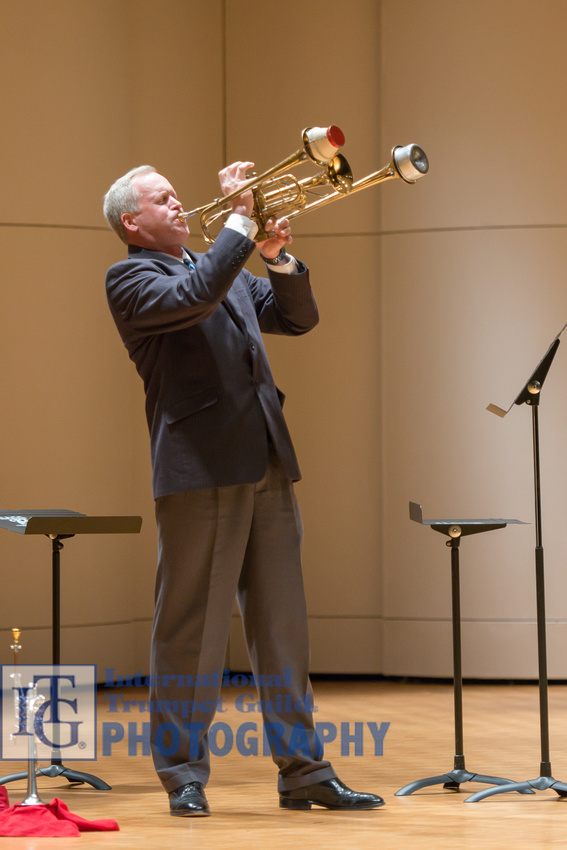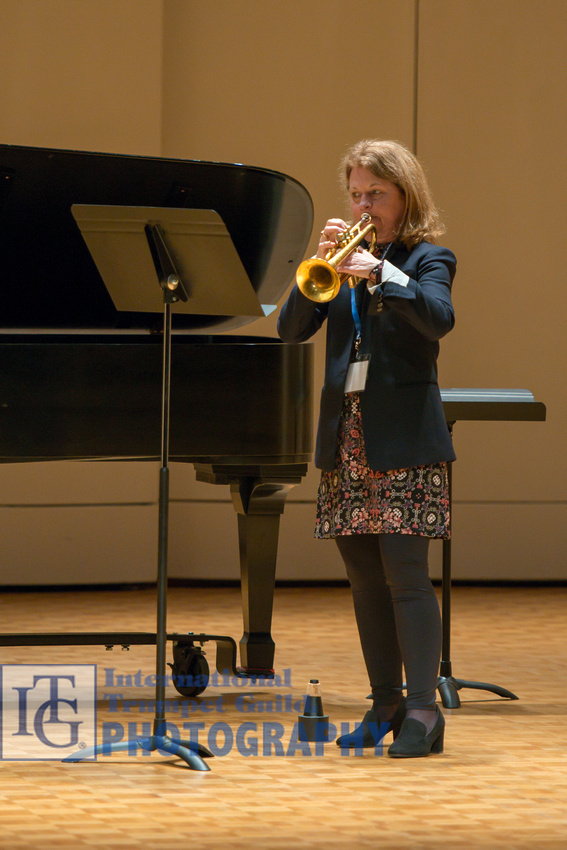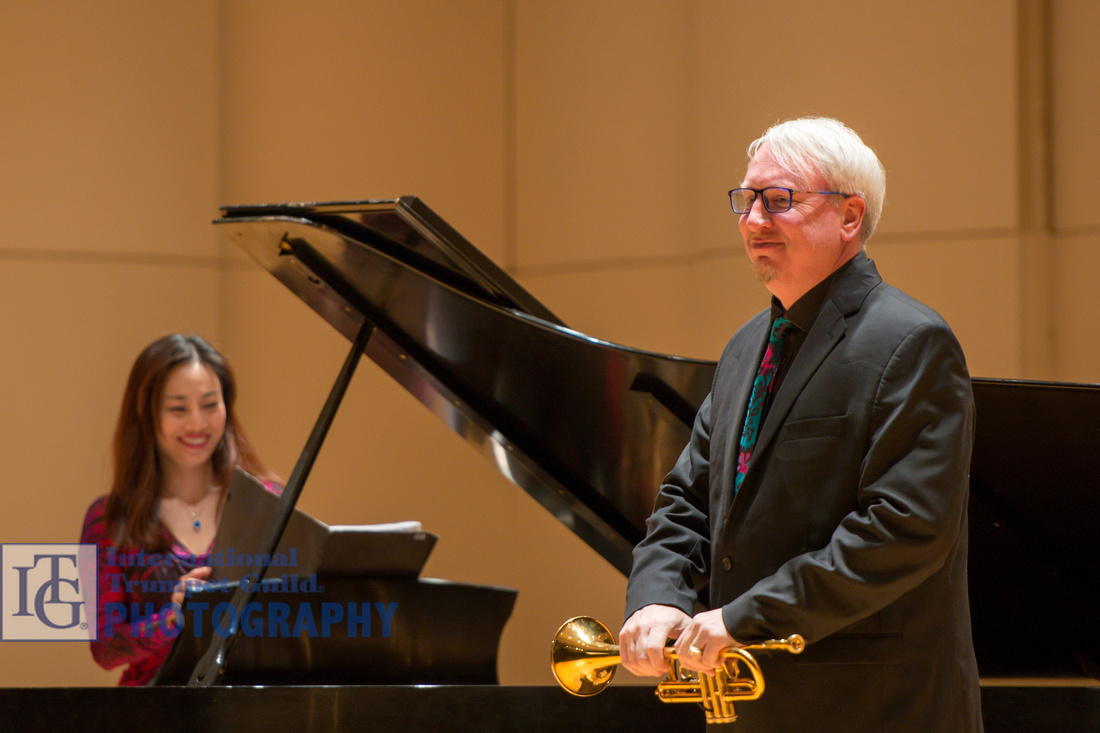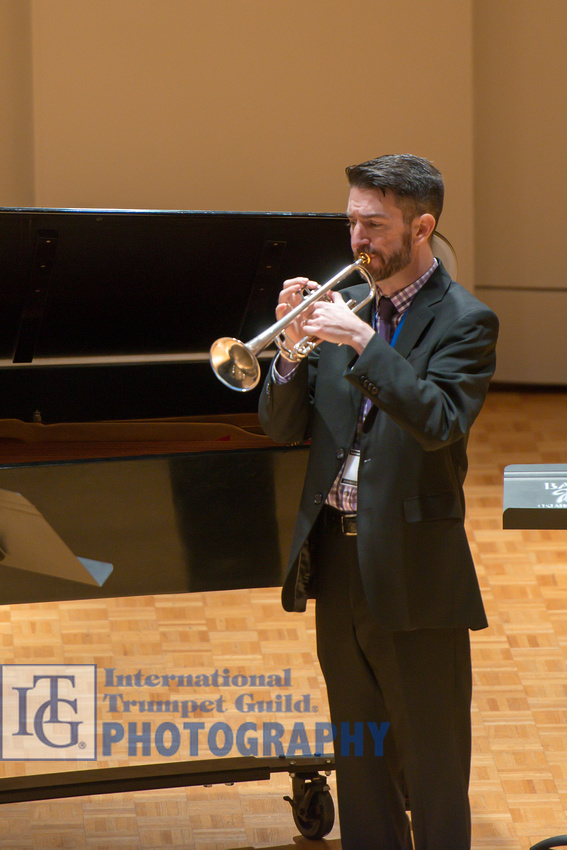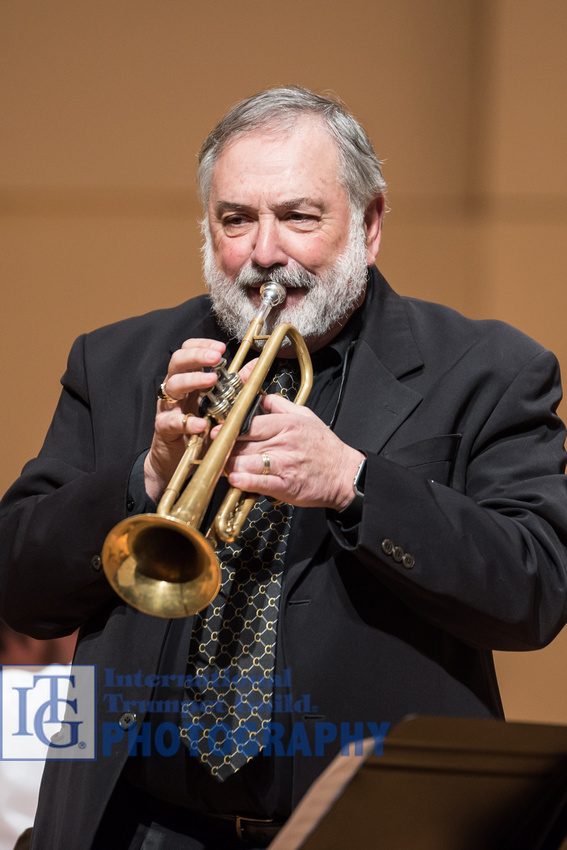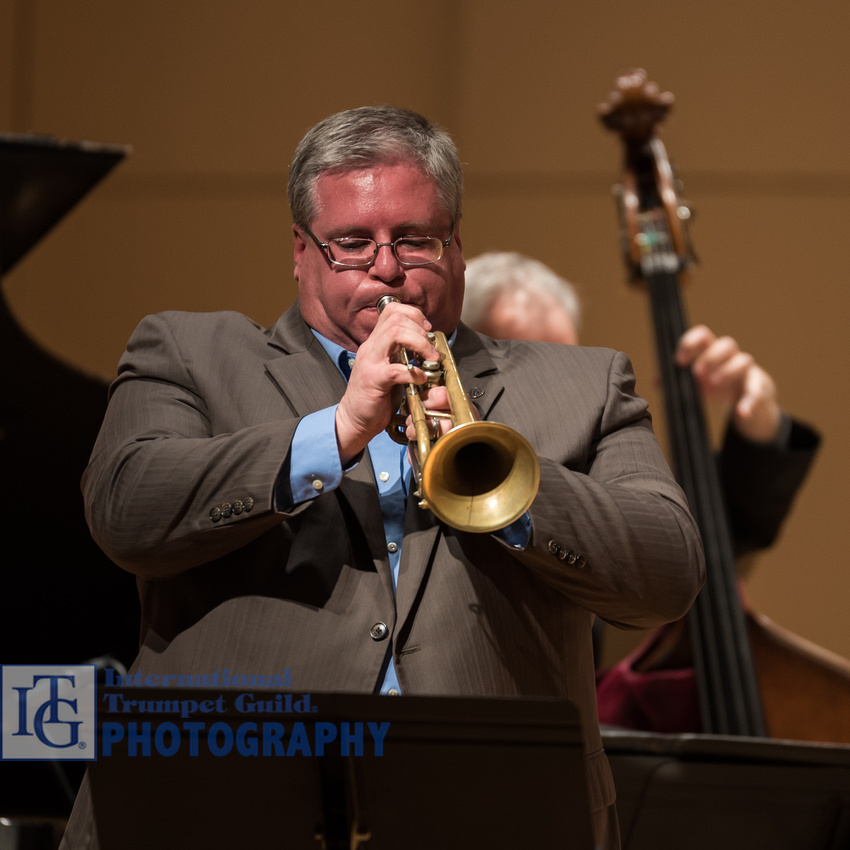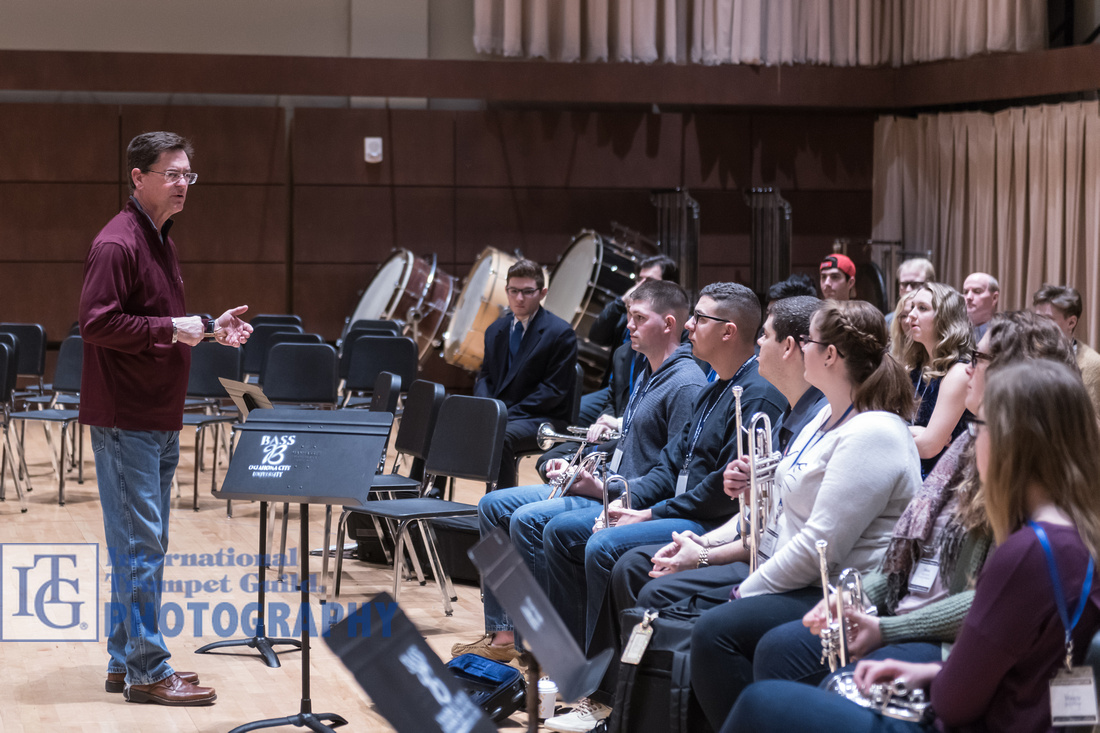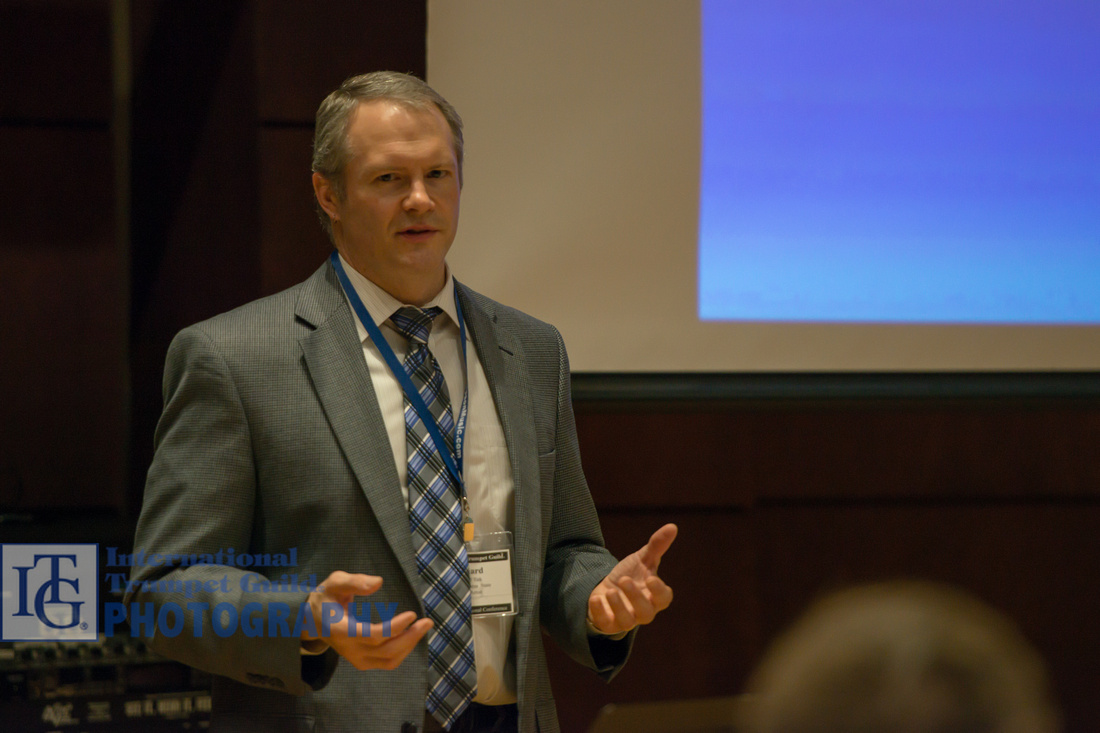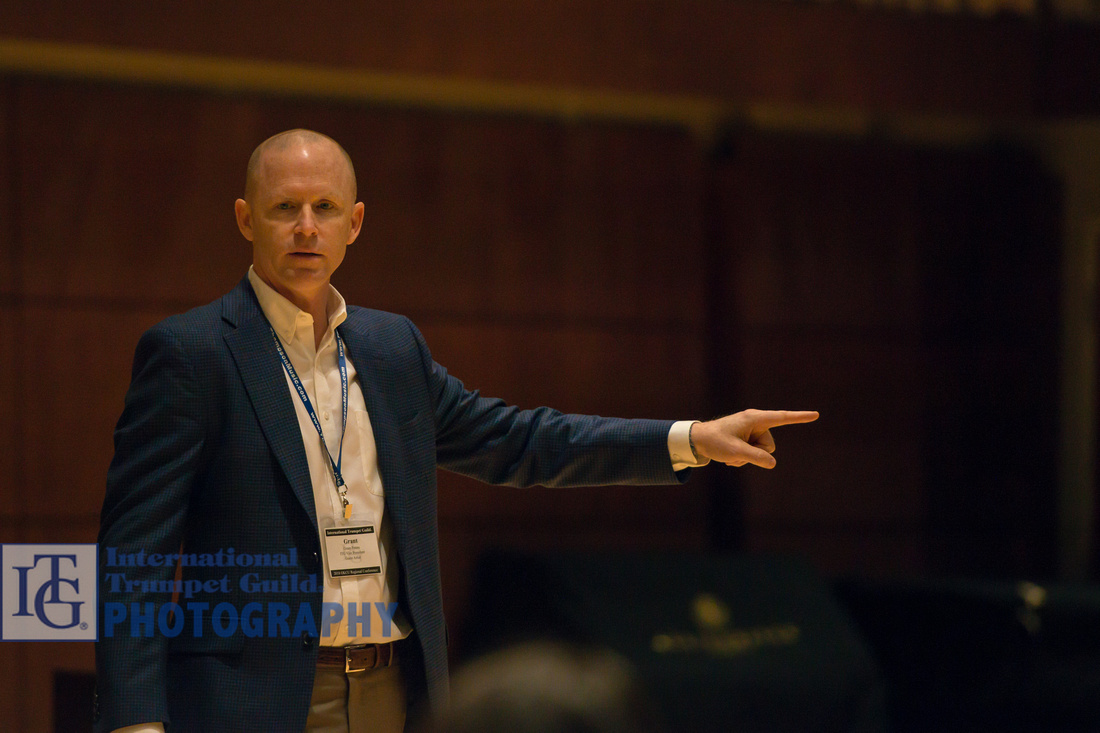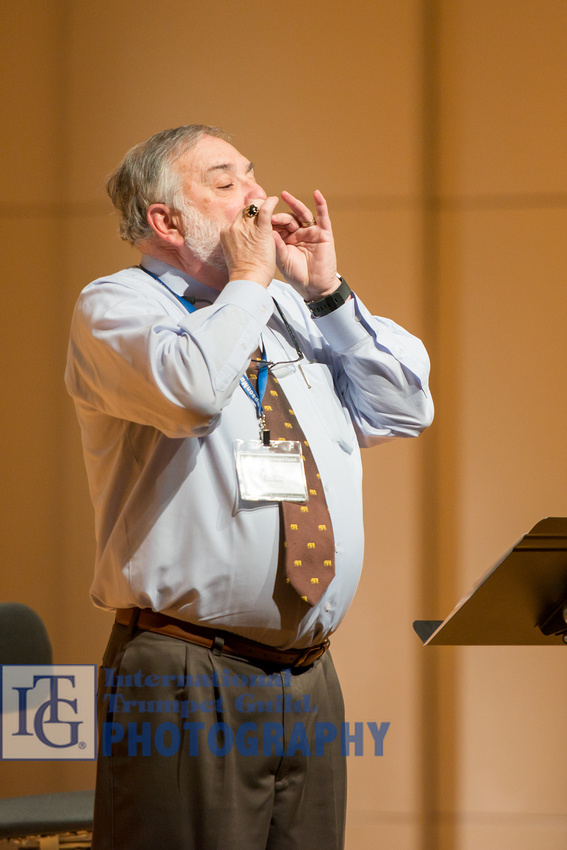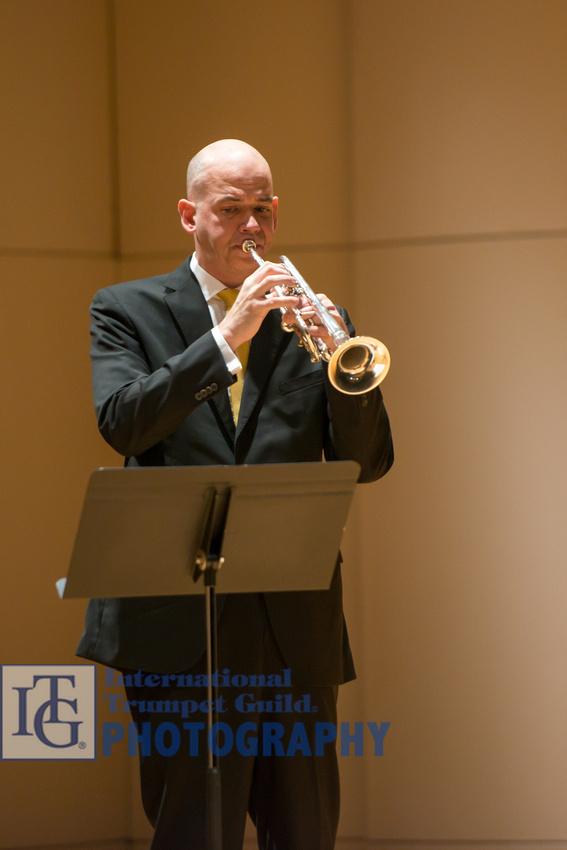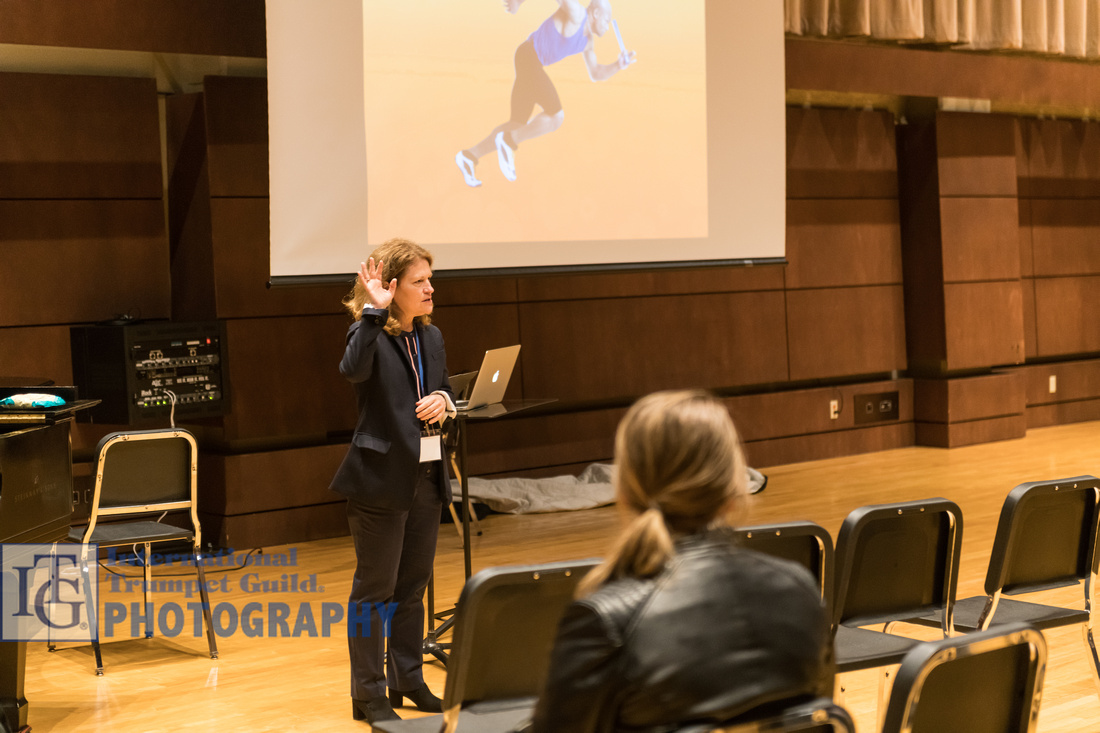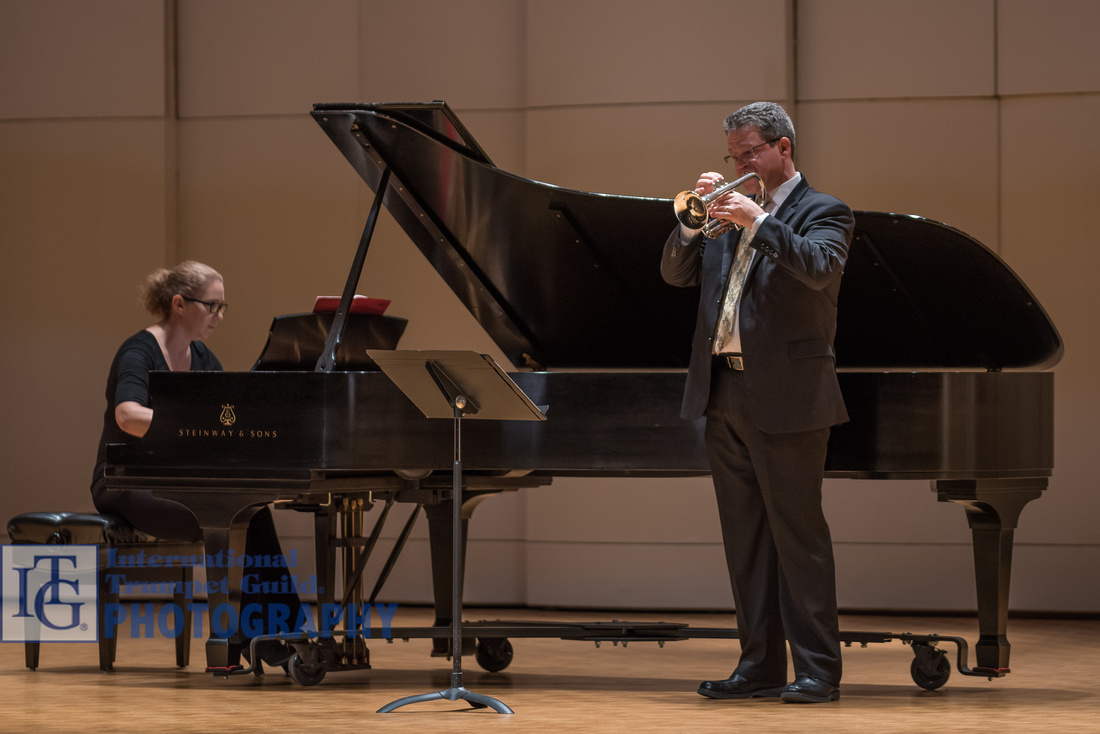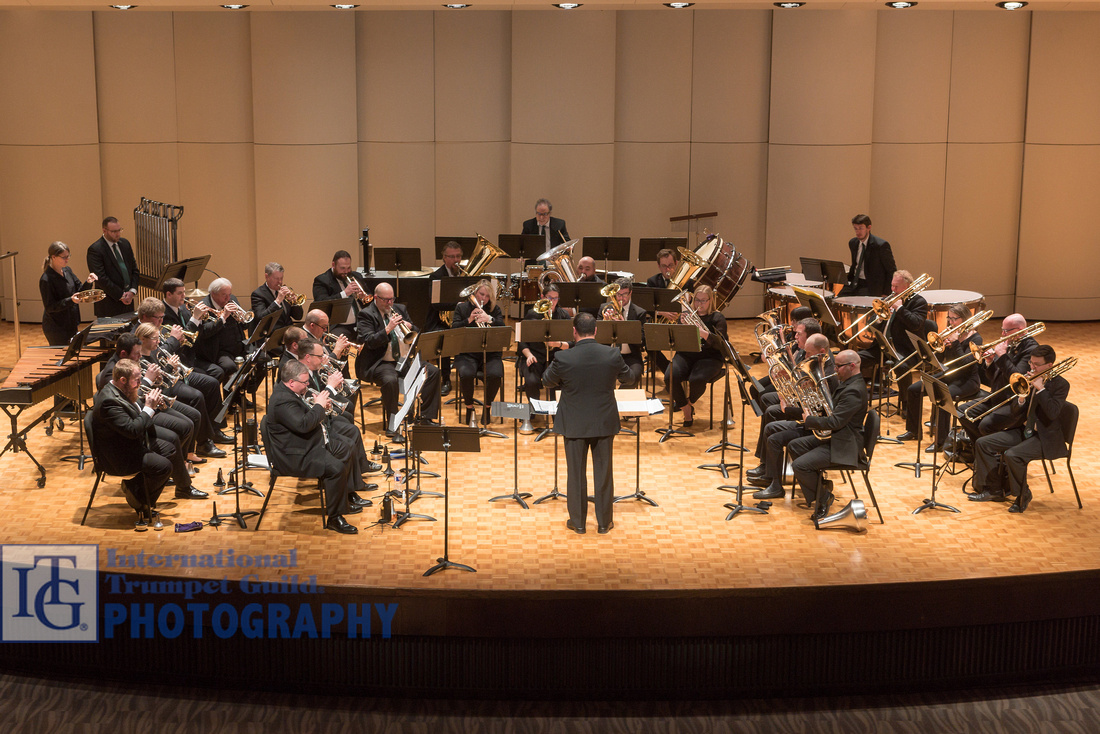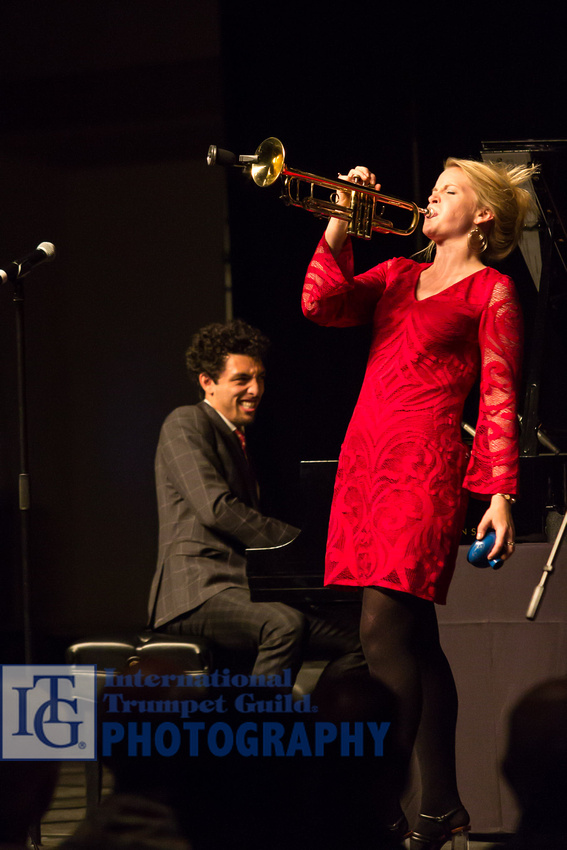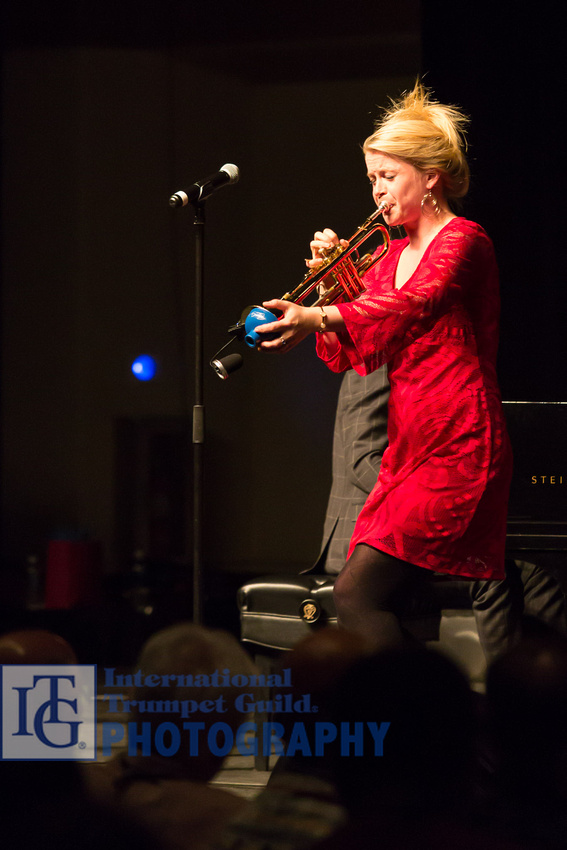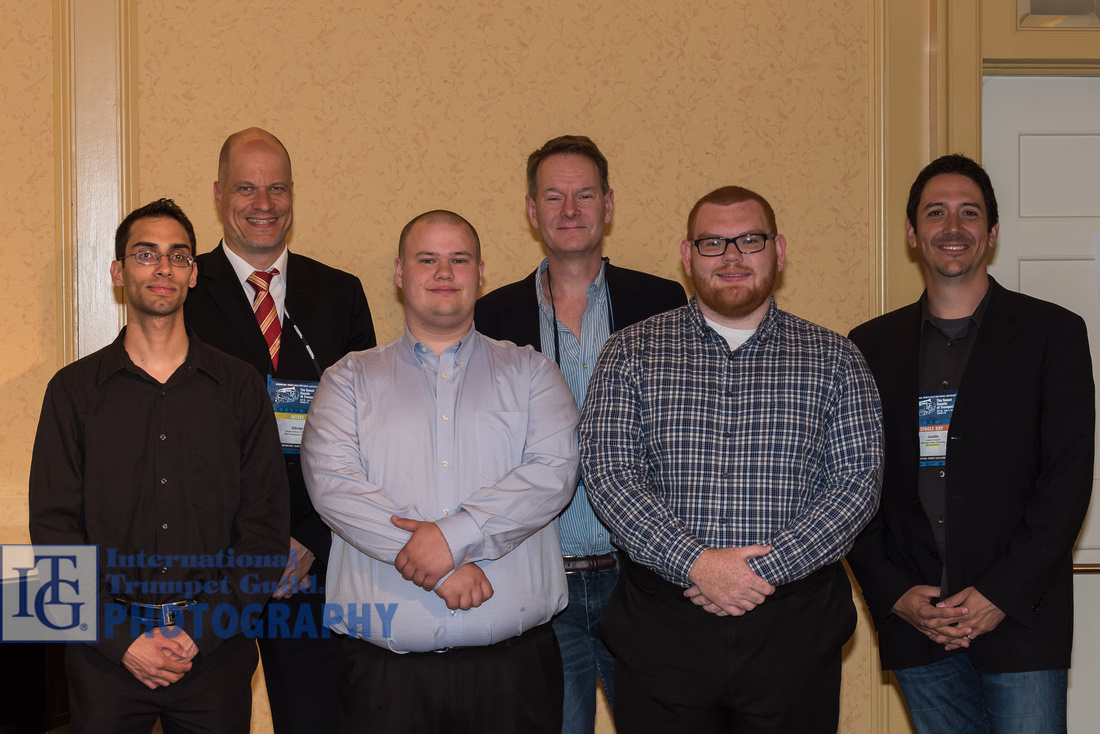Compiled by Peter Wood
2024 Conference Prelude Performances
Groups are listed alphabetically.
Angelo State University - Angelo State University Trumpet Ensemble
Dr. John Irish, director
Jesse Crawford, Jacob Flint, Manuel Garcia, Caden Kaufman, and Gabriel Muñoz, trumpets
Seven for Five by Erik Morales

Arkansas State University - A-State Trumpet Ensemble
Dr. Nairam Simoes, director
Cody Daughertee, Grayden Fields, Jeremiah Hendrix, Zane Kenzik, and Carlos Mejia, trumpets
X1 by Erik Morales

Baylor University - Baylor "Gold"
Wiff Rudd and Mark Schubert, directors
Matthew Burn, Jacob Lira, Camden Smith, Paul Stancampiano, and Mason Stokes, trumpets
Open One Improvised
Recreation; Souvenir; Scherzo; March Militaire by Ernest Williams

Brigham Young University - BYU Trumpet Ensemble
Dr. Randy Lee, director
Thomas Eskelsen, Carter Glass, Luke Gunnerson, Brandon Haynie, and Lola Henniger, trumpets
Amazing Grace arr. Erik Morales and Carter Glass

Colorado State University - CSU Baroque Trumpet Ensemble
Dr. Stanley Curtis, director
Stanley Curtis, Alex Gregory, Hunter Luedtke, Ethyn Bazzeghin, Kris Usrey, Alexa Hudson, and Enzo Barrett, trumpets
Six Short and Light Fanfares by Martin Mösl

Concordia University-Irvine - Concordia University Trumpet Ensemble
Dr. Hyungbin Jung, director
Noah Gonzales, Dhruv Kagatimath, Troy Randall, Keith Ransons, and Hyungbin Jung, trumpets
Path of Discovery by Erik Morales

Conservatoire National Supérieur Musique et Danse de Lyon - Ensemble de trompette CNSMDL
Clément Saunier, director
Samuel Bertrand, Tristan Boisseranc, Quentin Demougeot, Arthur Gass, Raphaël Horrach, Dylan Jerome, Briac Lemaréchal, Antoine Lory, Miguel Muñoz, Yannaël Ortega, Luce Perret, and Rémi Pierrat, trumpets
Festive Overture by Dmitri Shostakovich, arr. Caleb Hudson
"Toccata" from Symphony No. 5. by Charles-Marie Widor, arr. Clément Saunier
Maurice André Fanfare Anniversaire by Thierry Caens

Duquesne University - Duquesne Trumpet Ensemble
Dr. Christopher Wilson, director
Nathan Coffman, Christopher Cox, Caleb Drayer, Tim Hering, Ty Lewis, and Charles Prijatelj, trumpets
Conquest by Erik Morales
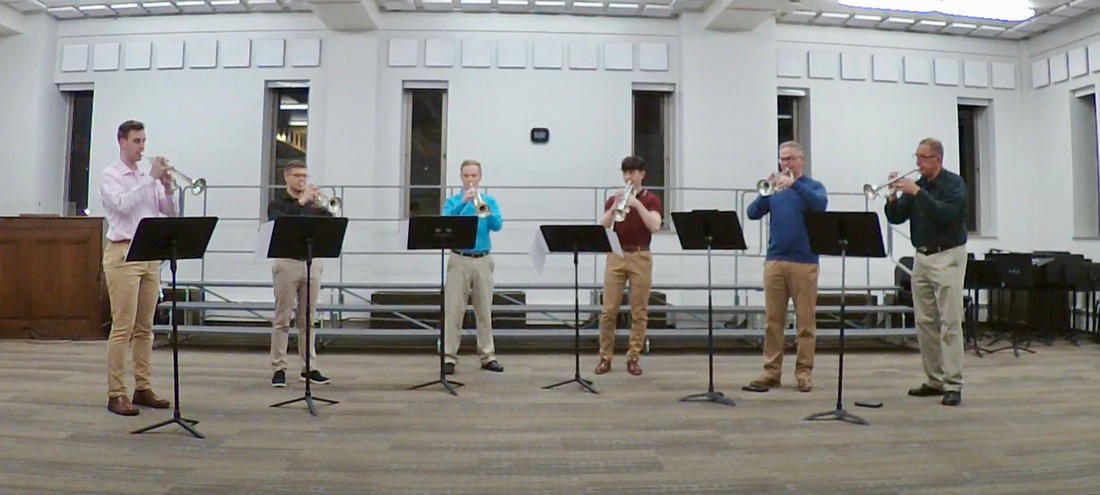
Eastern Michigan University - Eastern Michigan University Trumpet Quintet
Dr. Anderson Romero, director
Nathan Bohr, Carter Coyne, Adriano Estraiotto, Eric Pereira, and Emily Smith, trumpets
X1 by Erik Morales

Eastern New Mexico University - Eastern New Mexico University Trumpet Ensemble
Dr. Sidney Shuler, director
Aliyah Atencio, Dominique Barrera, Natalie Begaye, Mila Ensminger, Jared Fishburn, Roman Galvan, Zane Gassman, Jaden Harden, Nathan Jemmett, Landon Jordan, Marcos Lopez, Jordan Moody, Ignacio Perez, Christopher Rueda, Genesis Ruiz, and John Sanborn, trumpets
Möbius by Kenyon Wilson

Eastlake High School - Resonance du Lac
Caleb Tullius, director
Antiphon for Trumpet by Pethel
If Thou be Near by Bach
[No photo submitted]
Glendale Community College - GCC Trumpet Ensemble
Stephen Martin, director
David Alvarado, Jonathan Kendal Jackson, Noris Lopez, Juan Morales, Javier Ramirez, Christopher Scrivens, and Elias Villa, trumpets
Cityscapes by Erik Morales

ITG Non-Pro Ensemble
Divertimento by Brendan Collins
[No photo submitted]
ITG Pre-Professional Quintet
Robert Collins, Taryn Hairston, Tyler Helms, Johniel Nájera, and Mikayla Sweet, trumpets
Spitballing by Connor Johnson

Loyola University New Orleans - Loyola Trumpet Ensemble
Dr. Nick Volz, director
Diego Benjamin Delgado, Anna Hills, Ryan Kuhn, Collin Ledesma, and Matthew Perronne, trumpets
“Rush Hour” from Cityscapes by Erik Morales
Divertimento in Blue by Erik Morales

Mountain Ridge High School - Mountain Ridge Trumpet Ensemble
Dr. Brandon Dicks, director
Sara Bertini, Jonah Cain, Kay Carson, Averie Downey, Sophia Ramirez, Nolan Wilson, and Conner Segraves, trumpets
Ice Town by Mike D’Ambrosio
Cityscapes by Erik Morales

North Dakota State University - NDSU Trumpet Ensemble
Dr. Jeremy Brekke, director
Hannah Baum, Zach Breidenbach, Josh Maki, Jaden Rohrich, Kody Robinson, Rylie Schick, and Toby Steiner, trumpets
Metallic Fury by Erik Morales

Purdue University Fort Wayne - PFW Trumpet Ensemble
Dr. Elijah Denecke, director
Faith Bradley, Mason Meyers, Jared Ragsdale, Una VanWynsberghe, and Connor Wooley, trumpets
Rondeau by Jean-Joseph Mouret
Carillon Fanfare by Paul Bryan
Toccata for Trumpets by Paul M. Stouffer

Royal Danish Academy of Music - North Atlantic Brass
Erling Róbert Eydal, horn; Gunnar Helgason, trombone; Theodor Djursaa Hvidt, tuba; Frederik Treu Pehrson and Gunnar Kristinn Óskarsson, trumpets
Brass Quintet No. 1, Op. 79 by Vagn Holmboe
"Allegro" from Four Sketches by Anthony Plog

Royal Irish Academy of Music - RIAM Trumpet Ensemble
Prof. David Collins, director
Glen Carr, Paul Kiernan, Jack O'Reilly, and Grace Taite, trumpets
Fanfare MT 1844 by Anthony Plog
Threnody for Three Trumpets by Amanda McCullough

Southern Arkansas University - SAU Trumpet Ensemble
Dr. Flint Angeroth Franks, director
Tristan Brown, Alex Cude, Bryce Cummings, Josh Green, Rayden Maddox, Andrew Murphy, and Kade Schutte, trumpets
Salute by Leslie Bassett

Southern Utah University - SUU Red Trumpet Ensemble
David D. Torres, director
Kobi Brittenham, Landon Fowles, Kail Limb, Spencer Lloyd, Camille Overson, and Seth Seegmiller, trumpets
Westward Ho by Joseph Price
Clare De Lune by Claude Debussy, arr. Erik Morales

Tennessee Tech University - Tennessee Tech Trumpet Ensemble
Dr. Scott Hagarty, director
Ryan Alsup, Nox Carter, Maddux Fleming, Sam Hood, Steven Lawson, Joseph O'Donnell, and Thomas Ward, trumpets
Brooklyn Fanfare by Douglas Hedwig
Irish Folksong Suite arr. Dennis Horton

United States Marine Corps - III Marine Expeditionary Force Band Trumpet Ensemble
Sgt Edgar Ramirez, director
Sgt Ricardo Hernandez, Sgt Edgar Ramirez, Cpl Josue Villegas, and Sgt Timothy Weiss, trumpets
Cinematic Medley arr. Cpl Josue Villegas
The Incredibles arranger unknown
Fanfare for an Angel by James Stephenson

University of Missouri - Mizzou Trumpet Ensemble
Dr. Iskander Akhmadullin, director
Calvin Banks, Sophie Bock, Layden Dukes, Patrick Ferguson, Jesse Hamilton, Maddy Haugsven, Ava Lairmore, Emily Rahn, Douglas Schaedler, Brandon Sconce, and Bryce Taylor, trumpets
Deep River Traditional, arr. Coleridge-Taylor/Akhmadullin
Fantasia Brasileira by Jose de Silva “Duda”

University of Nevada, Las Vegas - UNLV Trumpet Ensemble
Dr. Barbara Hull, director
Michael Benner, Carolina De La Rosa, David Diaz, Tanner Farish, Elijah Gohl, Brandon O'Donohue, Shawn Scott, and Jacob Zell, trumpets
Intrada Dramatica by Joseph Price
Divertimento in Blue Erik Morales

University of Redlands - Redlands Trumpet Ensemble
Dr. David L Scott, director
Paul Dempsey, Denny Duran-Flores, Zachary Martin, Angel Rivas, and Ivan Rivas, trumpets
Madrigal, “Moro lasso al mio duolo” by Carlo Gesualdo
Celestial Dance Erik Morales

University of Southern Mississippi - University of Southern Mississippi Trumpet Ensemble
Dr. T. J. Tesh, director
Zachary Dake, Douglas Hutchison, Clayton Jacocks, Kyle Matthees, and Robert Smith, trumpets
Music for Five Trumpets by Verne Reynolds

University of Texas at San Antonio - Los Correcaminos
Dr. Oswaldo Zapata, director
Christopher Barrera, Kenedy Cardenas, Jacqueline Kolada, Gustavo Medrano, Normandy Morzynski, Celestino Rodriguez, Raymon Saldana, Daniel Vazquez, and Karim Vazquez, trumpets
Infinite Ascent by Erik Morales

University of Wyoming - University of Wyoming Trumpet Ensemble
Dr. David Wharton, director
Ethan Bishop, Tim Hosler, Darik Johnson, Liam Jones, Jordan Peschong, Jack Tinnell, Jordan Swayze, and David Wharton, trumpets
Poet and Peasant Overture by Franz von Suppe

Westminster College - Westminster College Trumpet Ensemble
Dr. Tim Winfield, director
Isabella Dienes, Michael Everhart, Hunter Hoag, Madison Mueller-Howell, Karissa Petruso, Cameron Stahl, and Dalton Stoops, trumpets
El Camino Real by Alfred Reed, arr. Michael Everhart

William Carey University - William Carey University Trumpet Ensemble
Mr. Peter Nionakis, director
Gracee Barnes, Tyler Broadway, Landon Day, Jade Flint, Ryan Sawyer, Trey Smith, McKenzie Sullivan, and Cody Thornton, trumpets
Infinite Ascent by Erik Morales

Competitions Coordinator: Marc Reed
Chamber Music Division
Christopher Scanlon, chair
1st place (tie): North Atlantic Brass, Royal Danish Academy of Music (Denmark), students of Nikolaj Viltoft
1st place (tie): Baylor Gold Trumpet Ensemble, Baylor University (USA), students of Wiff Rudd and Mark Schubert
3rd place: Fresno State Trumpet Ensemble, California State University, Fresno (USA), students of Nathan Sobieralski
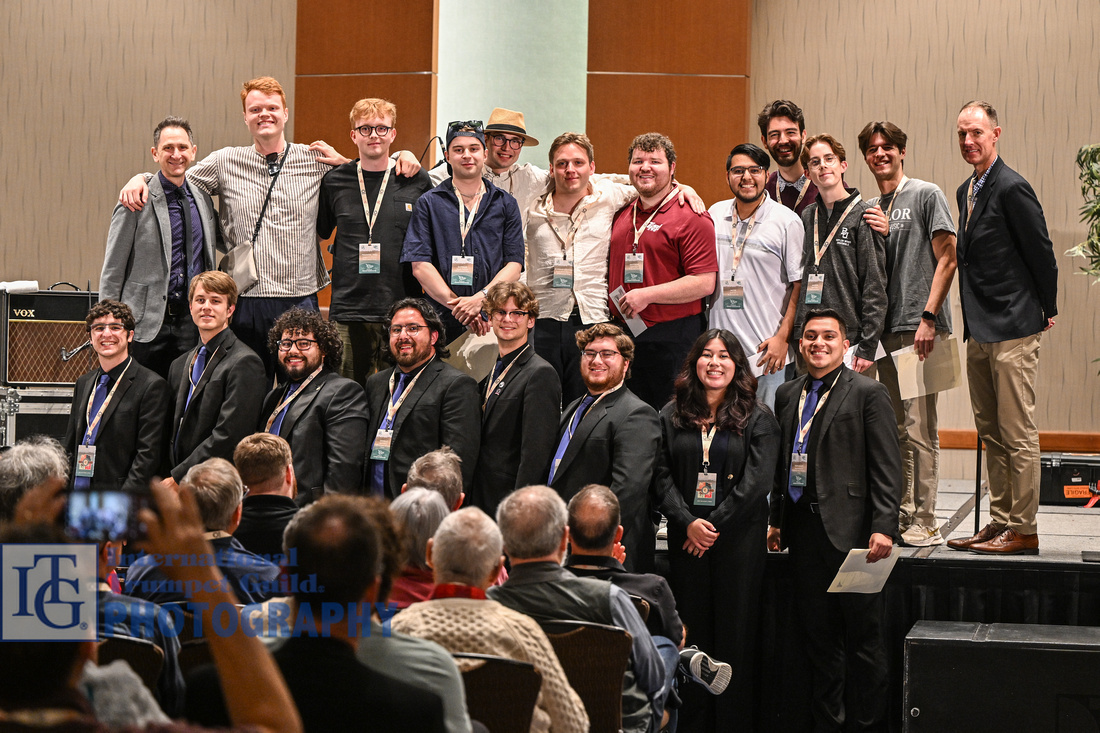 Jazz Improvisation Division
Jazz Improvisation Division
George Carpten IV, chair
1st place: Kellin Hanas, Manhattan School of Music (USA), student of Ingrid Jensen
2nd place: Kyle Pogline, Toronto, Ontario (Canada), student of Mario Guarneri
3rd place: Aaron Ouellette, Eastman School of Music (USA), student of Clay Jenkins
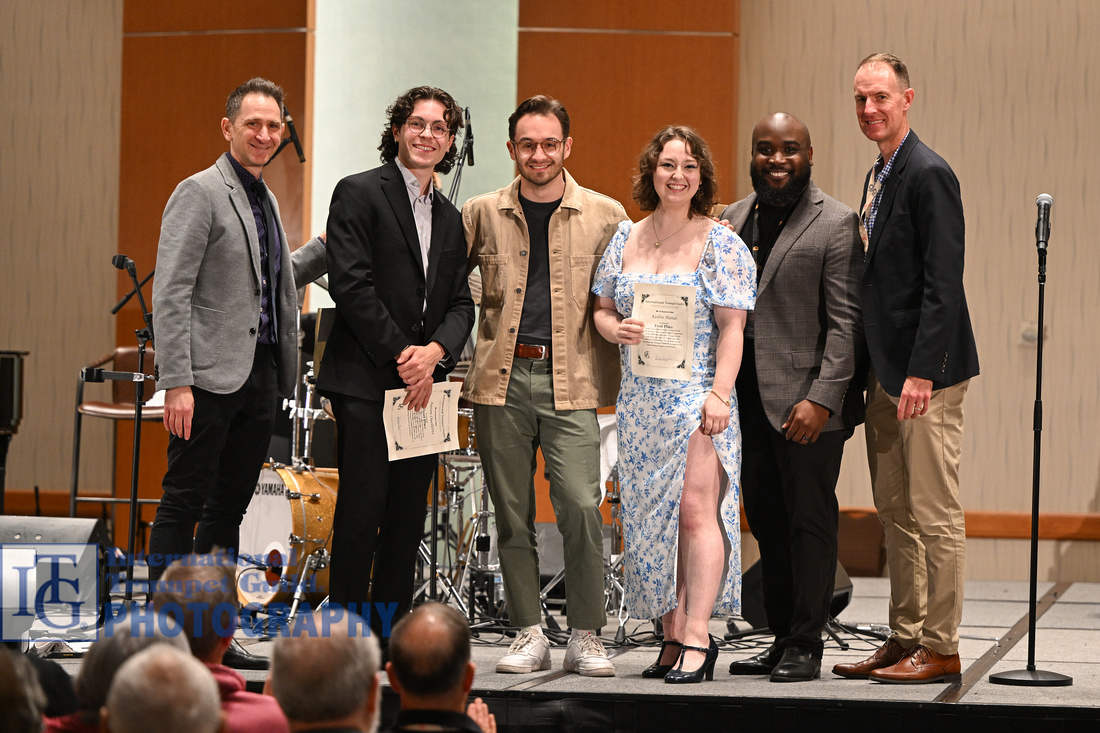
Orchestral Excerpts Division
Christopher Wilson, chair
1st place: Xanji Yang, Central Conservatory of Music (China), student of Zhonghui Dai
2nd place: Adam Warnke, University of Colorado Boulder (USA), student of Ryan Gardner
3rd place: Chase Domke, Michigan State University (USA), student of Justin Emerich
 Solo Performance Division
Solo Performance Division
André Bonnici, chair
1st place: Jiawei Chen, Central Conservatory of Music (China), student of Zhonghui Dai
2nd place: Raphael Horrach, Lyon Superior Conservatory of France, student of Clément Saunier
3rd place: Dylan Johnson, California State University, Long Beach (USA), student of Robert Frear
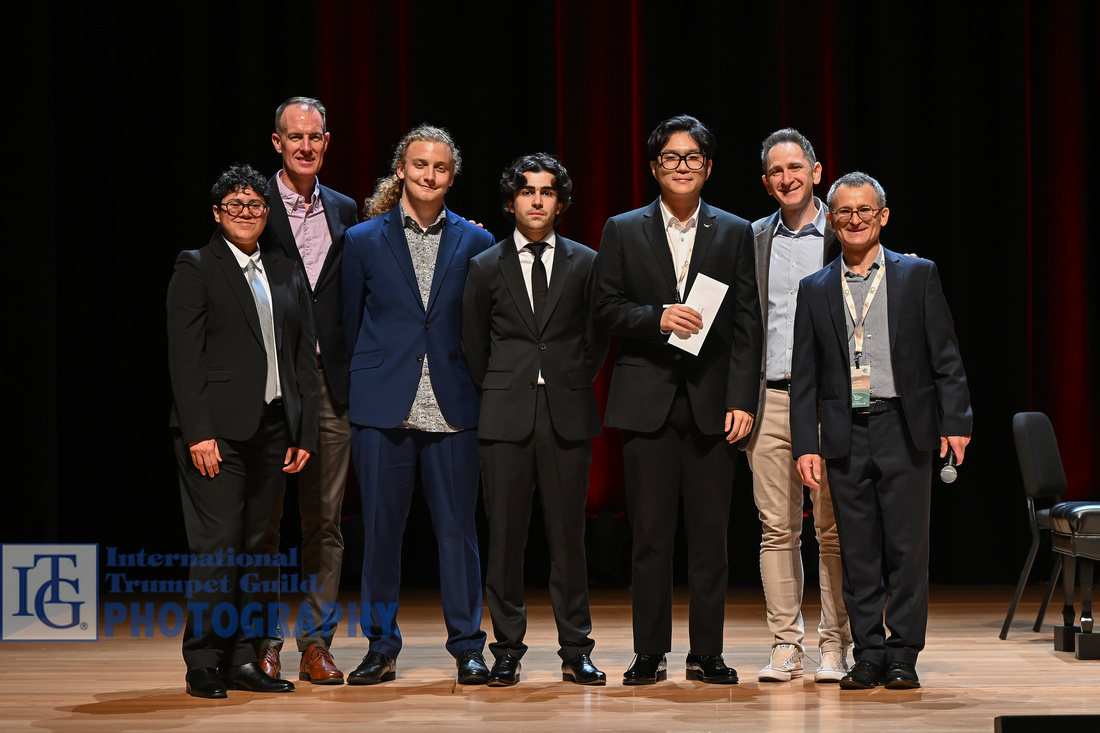
Wind Band Excerpts Division
Jenna Veverka, chair
1st place: Mason Stokes, Baylor University (USA), student of Wiff Rudd and Mark Schubert
2nd place: Nathan Coffman, Duquesne University (USA), student of Christopher Wilson
3rd place: Johniel Najera, Baylor University (USA), student of Wiff Rudd and Mark Schubert
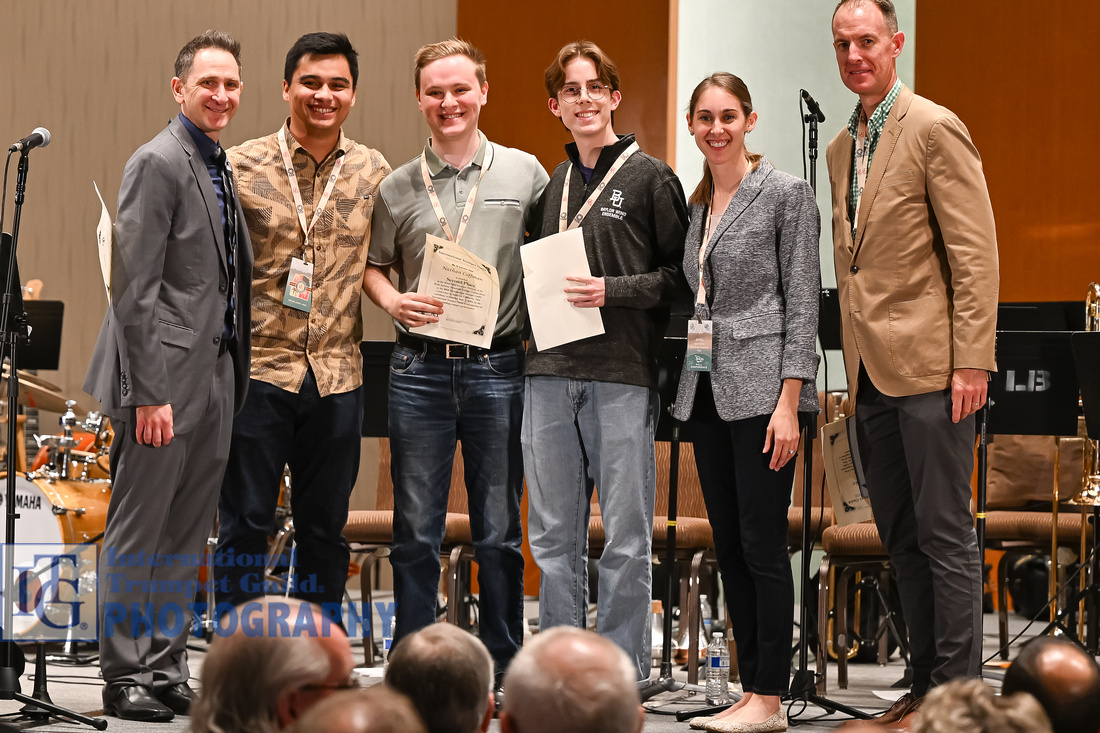
Senior Youth Division
Erika Izaguirre, chair
1st place: Yuntong Li, NCPA (China), student of Rui Li
2nd place: Yinglu Liu, Yehudi Menuhuin School Qingdao (China), student of Dai Zhonghui
3rd place: Stefan Gorgiev, Artistic School “Franco, Lucic” (Croatia), student of Tomislav Spoljar
 Junior Youth Division
Junior Youth Division
Erika Izaguirre, chair
1st place: Triin Ustav, Tallinn School of Music and Ballet, student of Neeme Ots
2nd place: Michelle Park, Palo Alto High School, student of Mark Nemoyten
3rd place: Juhan (Tony) Lee, Santiago Hills Elementary School, student of Rui Li
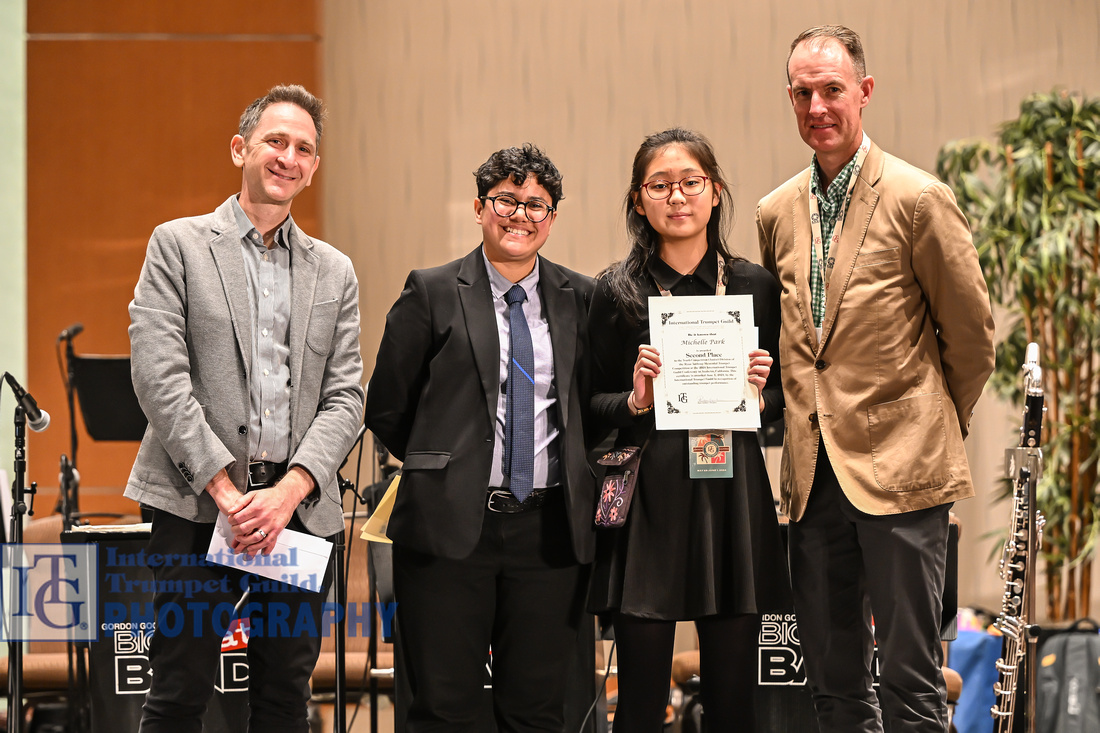
ITG Conference Scholarships for Students
Sarah Stoneback, chair

Cliff and Bunny Blackburn Scholarship
Donor: Cliff and Bunny Blackburn
•Olivia Clifton, Winthrop University, student of Dr. Marisa Youngs
•Abigail Clouser, Stetson University, student of Dr. Aaron Witek
Donald P. Bullock Memorial Fund Scholarship
William Isenhour, Winthrop University, student of Dr. Marisa Youngs
Keith Clark Memorial Fund Scholarship
Hsueh-Yang Yang, Trinity School of Midland, student of Dr. John Irish
Gard Bags Scholarship
Donor: Talwar Brothers Ltd.
•Stefan Gjorgiev, Artistic School “Franjo, Lucic,” student of Tomislav Spoljar
•Katherine Gillette, Conneaut Area Senior High, student of Elizabeth Heckman
ITG Legacy Fund Scholarship
Donor: ITG Legacy Fund
Dillon Niles, Crane School of Music at SUNY Potsdam, student of Dr. Brianne Borden
Richard B. Lehman Memorial Fund Scholarship
Joshua Puente, Florida State University, student of Dr. Christopher Moore
Bill Pfund Scholarship
Donor: Bill Pfund Trumpets
•Tori Gervais, Boston University, student of Terry Everson
•Sharavan Duvvuri, Florida State University, student of Dr. Christopher Moore
Wiff and Jeanette Rudd Scholarship
Donors: Wiff and Jeanette Rudd
Ryan Perry, University of South Alabama, student of Dr. Peter Wood
Schagerl Scholarship
Donor: Karl Schagerl
Chanan Mallanoo, Yong SiewnToh Conservatory of Music, student of Lau Wen Rong
Renold O. Schilke Memorial Fund Scholarship
Madison Sinan, University of Colorado Boulder, student of Dr. Ryan Gardner
Stuart D. Shanler Scholarship
Donor: Stuart Shanler
Luke Young, University of North Texas, student of Philip Dizack
Stoneback Brass Scholarship
Donor: Stoneback Family
Danielle Consolo, Bowling Green State University, student of Charles Saenz
Franz X. Streitwieser Memorial Scholarship
Donor: B and K Streitwieser
Vito Bell, Florida State University, student of Dr. Christopher Moore
Thane Trumpets Scholarship
Donor: Thane Trumpets
Jid-Anan Netthai, The Orchestra Now, Bard College
Thompson Music Co. Scholarship
Donor: Thompson Music Co.
Andy Hou, Flintridge Preparatory School, student of Caster Teoh
Dino Tofanelli Memorial Scholarship
Donor: Tofanelli Family, Andrea Tofanelli
Peter Dai, Los Angeles Youth Orchestra, student of Caster Teoh
Terry Warburton Young Innovator Scholarship
50 Year Anniversary Scholarship
Donor: Terry Warburton
•Juhan Tony Lee, Santiago Hills Elementary, student of Matthew Kim
•Christian Garner, Minnetonka High School, student of Robert Dorer
•Michelle Park, Palo Alto High School, student of Mark Nemoyten
Marvin Wilt Memorial Scholarship
Donors: Rebecca Wilt and Mark Clodfelter
•Noah Andreason, Spruce Creek High School, student of Dr. Aaron Witek
•Sophia Hsu, Young Artists Orchestra of Los Angeles, student of Caster Teoh
]]>
Special Daily Report • Compiled by Peter Wood
Photos by Michael Anderson, Jason Harrelson, Daniel Kelly, and Steve Stricker
Saturday, June 1, 2024
Click here for more photos from the ITG Conference
Bronson Pascual Warm-Up Session - It’s Not Rocket Science: Keep It Simple
Saturday morning’s warm-up session, led by Bronson Pascual, set a relaxed, structured, and simplified tone for the final day of the Conference. With a strong turnout, eager minds gathered to absorb new warm-up studies. Pascual structured the presentation into three clear sections: air, sound, and purpose. Balancing discussion with practical application, attendees were able to grasp key concepts from each section and apply them with ease under his leadership. A standout feature of the session was Pascual’s ability to knock down mental barriers to focus more on the beauty of sound. The overall laid-back approach to warming up provided a fitting transition to wind down the conference, leaving attendees with a high energy, yet palpable, sense of relaxation. (Benjamin Dubbert)
David Detwiler - Chop Problems
David Detwiler gave an informative and impressive presentation on Chop Problems on Saturday morning. He brought stories and information from his own personal experiences, as well as advice from Phil Smith, Wayne Bergeron, Chris Gekker, Ashley Tighe-Hall, Chip Crotts, Chris Carrillo, SGM Kenneth Mcgee, and Josh Kauffman. All the conversations that Detwiler described spoke of physical, psychological, and spiritual conflicts through different kinds of chop challenges. Detwiler summarized that the most effective ways to conquer chop problems are through resting, maintaining patience, and paying attention to sound over feel. (Jacinda Ripley)
Brianne Borden - Mindful Practice for Performance Anxiety
In Dr. Brianne Borden’s presentation, she helped attendees better understand their relationship with their own bodies, how performers typically respond to performance anxiety, and ways to correct that within ourselves. At the outset of her session, Borden discussed the origins of anxious feelings. That varies from person to person, but these feelings can come from our inherent sense of perfectionism, from the importance we consciously or unconsciously place on a particular situation, imposter syndrome, or even past unresolved trauma. In the latter part of her presentation, Borden provided strategies and walked the attendees through exercises to promote greater mindfulness. She applied Cognitive Behavioral Therapy breathing techniques and then helped attendees understand how they can apply those exercises to trumpet practicing. (Joseph Nibley)
Youth Competition: Junior Division
In the final round of the Youth Junior division for The Ryan Anthony Memorial Trumpet Competition, the soloists performed a variety of etudes and solos. The first performer, Yilang Li, displayed very strong technique. Juhan (Tony) Lee performed an energetic Bach arrangement, showing off great technical skills and dynamic contrast. Tyler Mebust performed Getchell #77 with a clear tone and strong energy. Michelle Park performed an etude by Bousquet with exciting dynamic contrasts, great phrasing, and strong technical work. The final contestant was Triin Ustav, who demonstrated great command of multiple tonguing, style, and dynamic phrasing. Each competitor showed that the future of trumpet performance is bright! (Flint Angeroth Franks)
Anthony Plog - Perpetual Progress: Nurturing the Lifelong Student in You
To kick off this session, a well-versed Non-Pro Trumpet Ensemble very impressively premiered the first movement of Brendan Collins’s Divertimento. For the main event, Anthony Plog delivered a thorough presentation saturated with wisdom, in which he played inspirational videos between talking points. His opening idea revolved around passion, in which he encouraged us to surround ourselves with people who are excited about what they do, who are more talented than we are, and who possess loving, kind, and empathetic qualities. To fuel our passion, Plog mentioned that we should always strive to be an enthusiastic student, regardless of where we are, talent-wise. We must maintain a healthy work ethic and place the utmost importance on spending our lives doing what we really enjoy. Finally he emphasized that stoking our curiosity will aid in filling our lives with richer experiences, rather than wasting it away on social media. (Peter Nionakis)

Adrienne Doctor - Celebrating Underrepresented Populations
This session opened with the Eastern New Mexico University trumpet ensemble’s fine performance of Erik Morales’s “Infinite Ascent.” SFC Adrienne Doctor (“Pershing’s Own” US Army Band) hosted this informative session about underrepresented groups in the music performance and academic fields. The panel members discussed the experiences and challenges they and others have faced in their careers, from their early education to their current positions. The importance of inclusion in the field was highlighted, including encouraging the next generation of musicians, building a wider audience, incorporating new ideas in a group or organization, and changing the culture of a group to better represent the public, among others. They also pointed out several ways the trumpet community can help lead this change, from being mindful of guest artist and audition panelist invitations; being more aware of how we may relate differently to students or colleagues of disparate groups; being more inclusive in hiring and recruiting, selecting repertoire, and mentoring; and having greater respect for underrepresented students and colleagues. (Daniel Kelly)
Julia Bell Youth Session - Music and Marketability: Career Development
Julia Bell gave an insightful presentation to young aspiring musicians about marketability and career development. She gave tools and ideas for what students can do right now in preparation of their future. Topics included goal setting, organization, networking, technology, and marketing. Bell was engaging and fun as she maneuvered through topics that can be daunting to students as they think of the future. The students did self-reflections to guide their next steps in the short and long term. The presentation was well received and useful for pre-professionals and professionals alike. (Jacinda Ripley)
Jens Lindemann Youth Session - Stage Ready: Your Guide to Audition and Competition Success
On the final morning of the Conference, Jens Lindemann gave a terrific presentation geared especially to younger musicians. The session was preceded by a highly engaging performance from the Mountain Ridge High School Trumpet Ensemble of Mike D’Ambrosio’s “Ice Town” and Erik Morales’s “Cityscapes.” Jens first explained and demonstrated how to approach the horn, beginning with posture, breathing, etiquette, and more. Throughout the session, he consistently reinforced healthy habits such as keeping an open mind and a positive energy and being always curious. He kept the audience engaged and entertained throughout the entirety of the session with interactive activities, call and response, and many, many jokes. A few points he continued to reiterate throughout the session were to always be kind, sensitive, aware, and focused when playing the trumpet. This session was useful, entertaining, and very educational for musicians of all ages and levels. (Maryna Pohlman)
ITG General Meeting
As Ryan Gardner concludes his first year as ITG President, he shared that his personal goals for ITG include his continued dedication to promoting diversity, equity, and inclusion, as well as increasing membership. In addition, the Guild is prioritizing overall transparency to its members. Interim Conference Director Rebecca Wilt provided information on next year’s 2025 ITG Conference at the University of Utah, and ITG Treasurer TJ Tesh presented a financial report. To expand ITG’s activities throughout the year, the board has several projects that promise to be of interest to Guild members outside of the Conference and Journal. In the bear future, members of ITG can expect a new record label/streaming service, which will replace the annual CD recording. The board revealed that there are plans for a 2025 regional conference in Croatia. The board also recognized the outstanding contributions of outgoing ITG Website Director Michael Anderson (who started the ITG Website in 1996) and plans to hire a new webmaster and complete an overhaul of the website in the near future. (Madison Barton)
Recital - Dan Rosenboom’s Polarity Quintet
The Dan Rosenboom Quintet featured tunes from his most recent album, “Polarity” (in a history of over twenty albums). Starting with a blend of tunes that segue together, the quintet started with “The Age of Snakes” and “A Paper Tiger.” Rosenboom dedicated the second tune to all the students competing at the Conference, stating that anything is possible and that competitors should believe in themselves. Throughout the concert, Rosenboom displayed a world-class sound that he shaped, colored, and manipulated to the full extent of his imagination; nothing got in his way. All the tunes created multiple layers and textures among the players, and each member navigated the music with seamless ideas and seeming ease. The entire program allowed this extremely fine group to display an electric level of intensity. (Will Koehler)
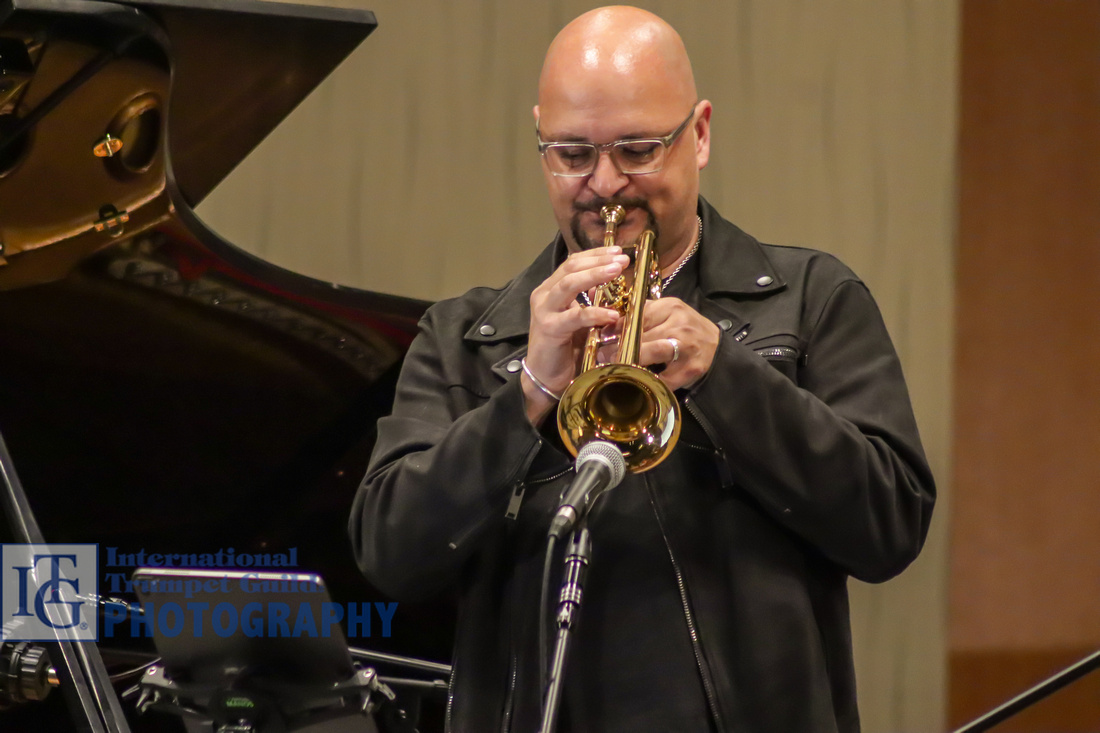
Jennifer Marotta - Efficient and Effective Practice Methods
In Saturday’s afternoon Youth Session, Jennifer Marotta (trumpet professor at USC’s Thornton School of Music) gave a great clinic on how to make the most of our practice sessions. At the beginning of the clinic, Marotta shared the session’s guiding insight: “Being technically proficient on our instrument allows us easier access to our musical voice.” She described how she sets long-term goals and reverse-engineers those goals into smaller, accomplishable, short-term goals. Practicing on the border of our current abilities in order to keep progress manageable and progressive was a recurring theme throughout. Other concepts included “ingredients” to great trumpet playing - making honest assessments, finding our own borders, listening actively, and practicing musically. Taking ownership of our practice and incorporating musical and technical elements, she explained, is foundational for building successful habits as a professional trumpet player. (Joseph Nibley)
Festival of Trumpets Concerts
Taking advantage of the Conference hotel’s proximity to Disneyland, the Festival of Trumpets performed two identical concerts in the outdoor amphitheater at Downtown Disney. The various ensembles performed both on stage and in different locations throughout the open quad in a fast-paced collage format. The Colorado Trumpet Ensemble opened with “Olympic Fanfare” and was quickly followed by Jim Olcott’s excellent arrangement of the “Star Wars Main Theme,” which included trombone and tuba. Queen’s “Bohemian Rhapsody” showcased excellent lead playing by Tyler Helms and segued into a cantabile arrangement of the traditional “Shenandoah.” The Delaware Trumpet Ensemble gave an impressive rendition of “William Tell” Overture. No pops concert would be complete without the theme from “Raiders of the Lost Ark” and a light jazz arrangement - in this case, “Down by the Riverside.” An arrangement of “America the Beautiful” was a welcome addition to this program, which was set on a pleasant afternoon in beautiful southern California weather. To close out the Disney shows, Jim Olcott wrote a mass trumpet ensemble arrangement of “When You Wish Upon a Star,” which included all 84 ensemble members involved in the concert and featured solo parts performed by Jens Lindemann and Jonathan Bhatia. The concerts, very smoothly coordinated by Dr. Nairam Simoes from Arkansas State University, were well attended by an appreciative public audience and a steady flow of pedestrians passing by, who have probably never heard that many trumpets perform at the same time. (Nick Volz)
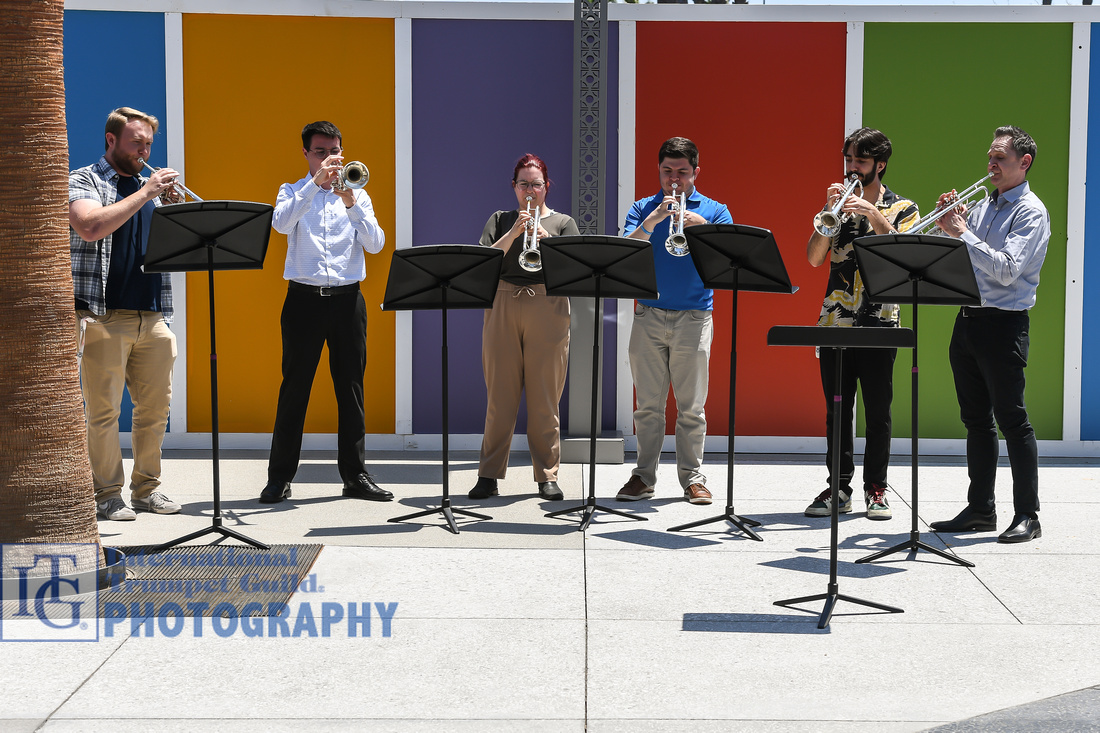
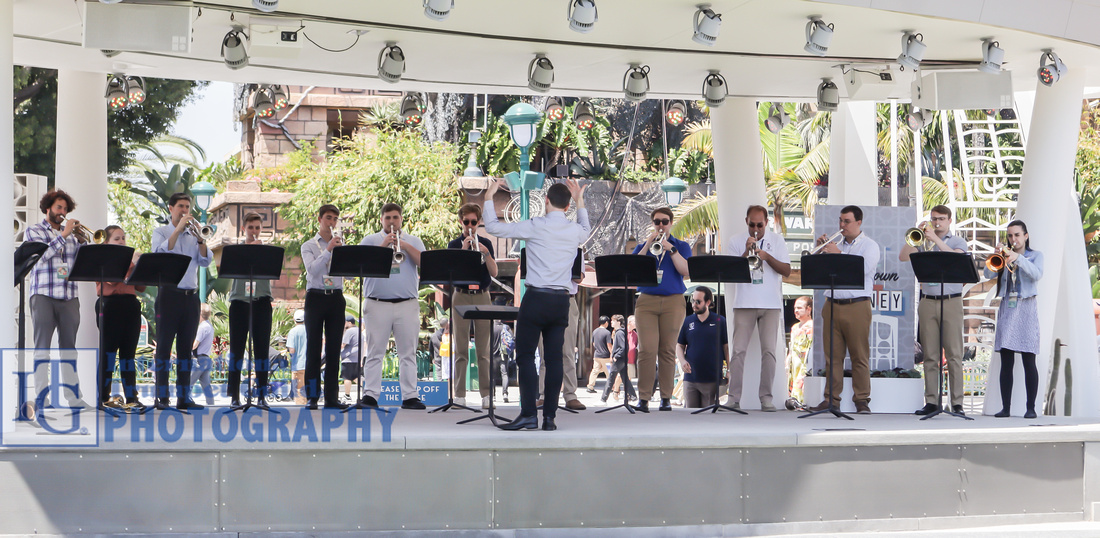
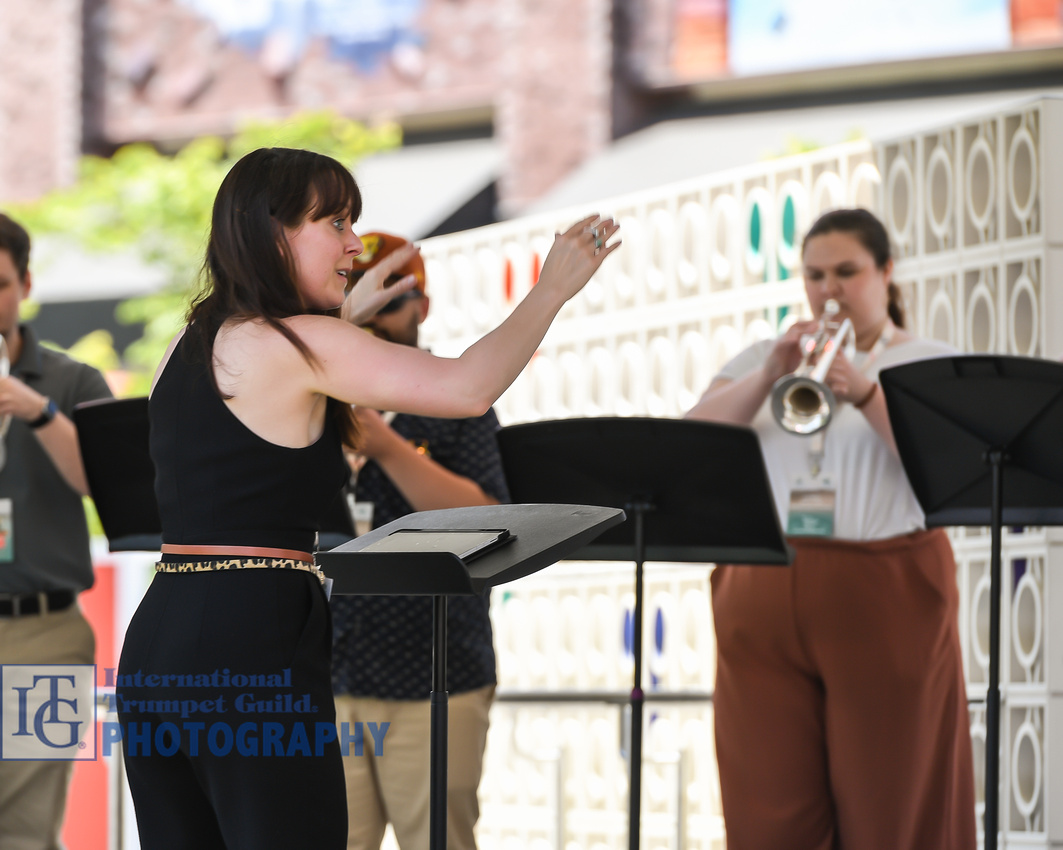
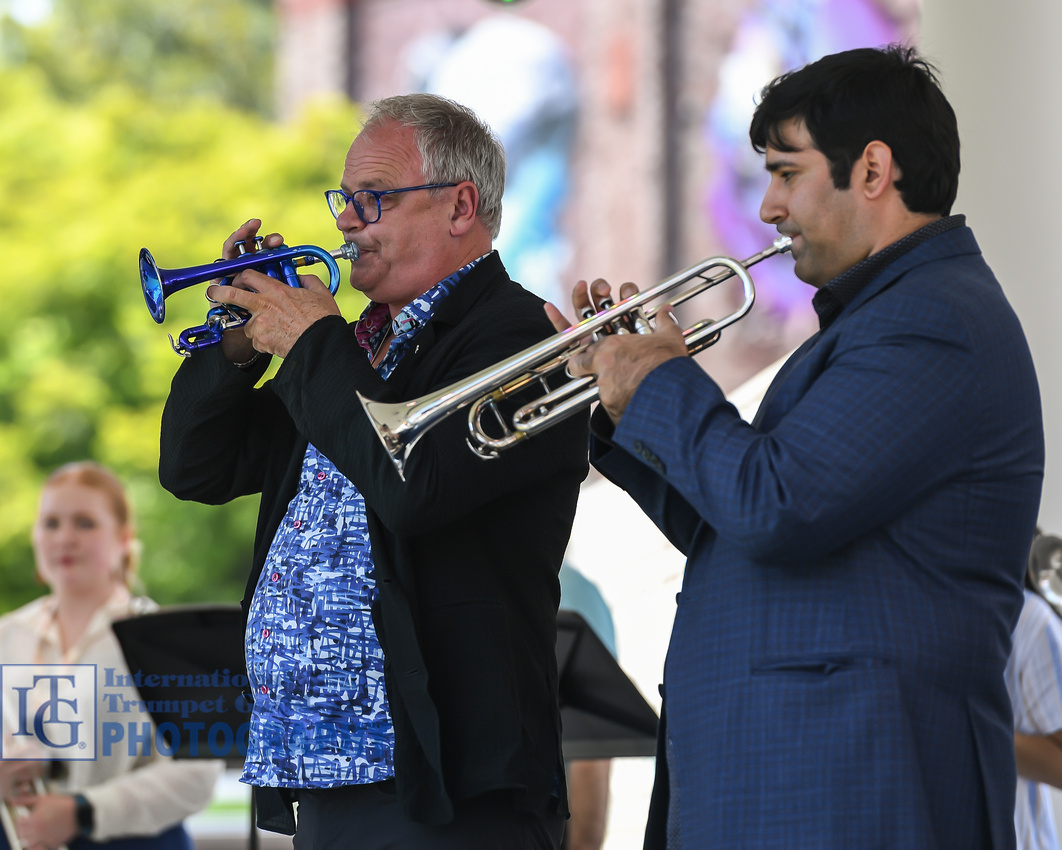
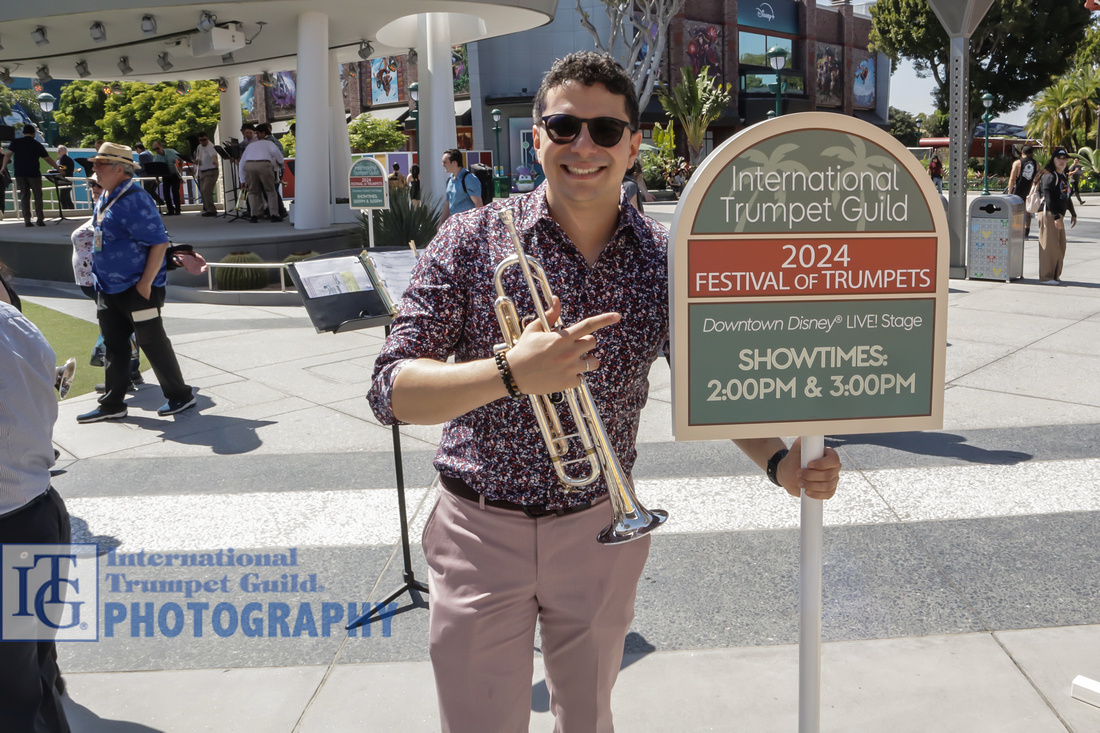
Erika Izaguirre - Senior Youth Trumpet Ensemble Reading Session
Dr. Erika Izaguirre led the Senior Youth Trumpet Ensemble Reading Session on Saturday afternoon. Participants, largely between the ages of fifteen and nineteen, played four trumpet ensemble pieces, including “Sojourn” by Nicole Piunno, “Jubilance” by Rodney S. Miller, “Canterbury Fanfare” by Gordon Jacob, and an arrangement of Gershwin’s “Someone to Watch Over Me.” Izaguirre directed an energetic rehearsal, introducing concepts of playing in a chamber group, while giving each participant a chance to play different roles in the ensemble. The students had the opportunity to play exciting music and meet their peers in a highly positive environment. (Flint Angeroth Franks)
Abby Temple - Junior Youth Trumpet Ensemble Reading Session
This Junior Youth Trumpet Ensemble Reading Session was led by Abby Temple, who also selected the excellent and accessible trumpet ensemble literature. She began by leading the group in a warm-up chorale that centered on listening for tonal blend, intonation, and coordination across the ensemble. The first piece that the ensemble read was Eric Ewazen’s “Concert Fanfare.” After the initial playthrough, Temple engaged the students by helping them identify the elements of the music that could be improved, such as playing cantabile in contrast to the fanfare sections. Then the ensemble read Telemann’s “Trumpet Tune,” in which the rehearsal focused on playing in the Baroque style and bringing out different types of articulations. The session ended with a reading of Michael Stewart’s “Waltz of the Squirrels,” which had extremely enjoyable and dynamic parts for each person. Temple marvelously led this session that was musically enriching for all those participating. (Spencer Brand)
Selina Ott Recital
To kick off Selina Ott’s highly anticipated recital, the trumpet quartet from the Royal Irish Academy of Music performed Anthony Plog’s rousing “Fanfare FT 1844.” Selina Ott then took the stage with her collaborator and pianist, En-Chia Lin. She opened her recital with a bang, Arthur Honegger’s “Intrada,” which showcased her powerful sound throughout the range of the instrument and her luscious, full sound. She continued with Florent Schmitt’s Suite, followed by Vladimir Peskin’s Concerto No. 3. For an intermission, En-Chia Lin performed Alfred Schnittke’s “Aus ‘5 Präludien und Fuge für Klavier.”’
Ott continued her program with Ricardo Mollá’s “The Overton Window,” Kurt Schwertsik’s “Serenata,” and Jean Baptiste-Arban’s “Variations on a Theme from Bellini’s ‘Norma,’” receiving an extremely enthusiastic standing ovation. Ott’s dazzling sound, virtuosity, and ability to capture the attention of the audience was on full display in every selection she played. She concluded her highly captivating recital with Felix Mendelssohn’s “Lied ohne Worte in F# minor, Op. 67/2,” receiving numerous standing ovations. Brava! (Maryna Pohlman)
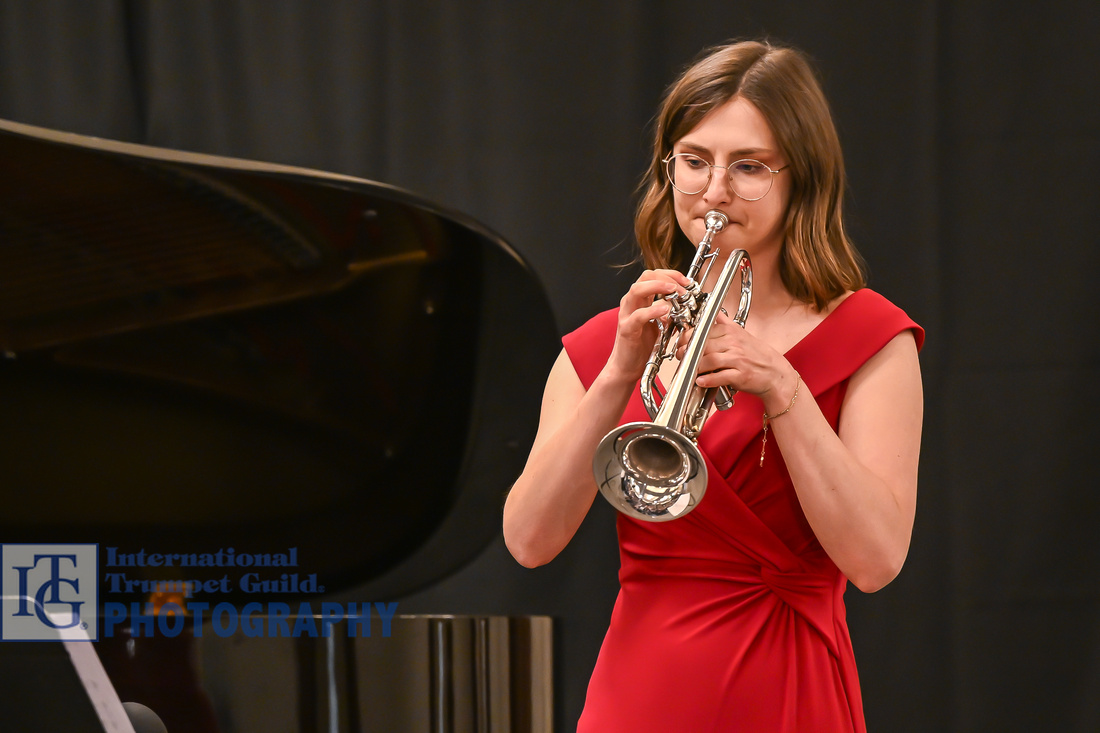
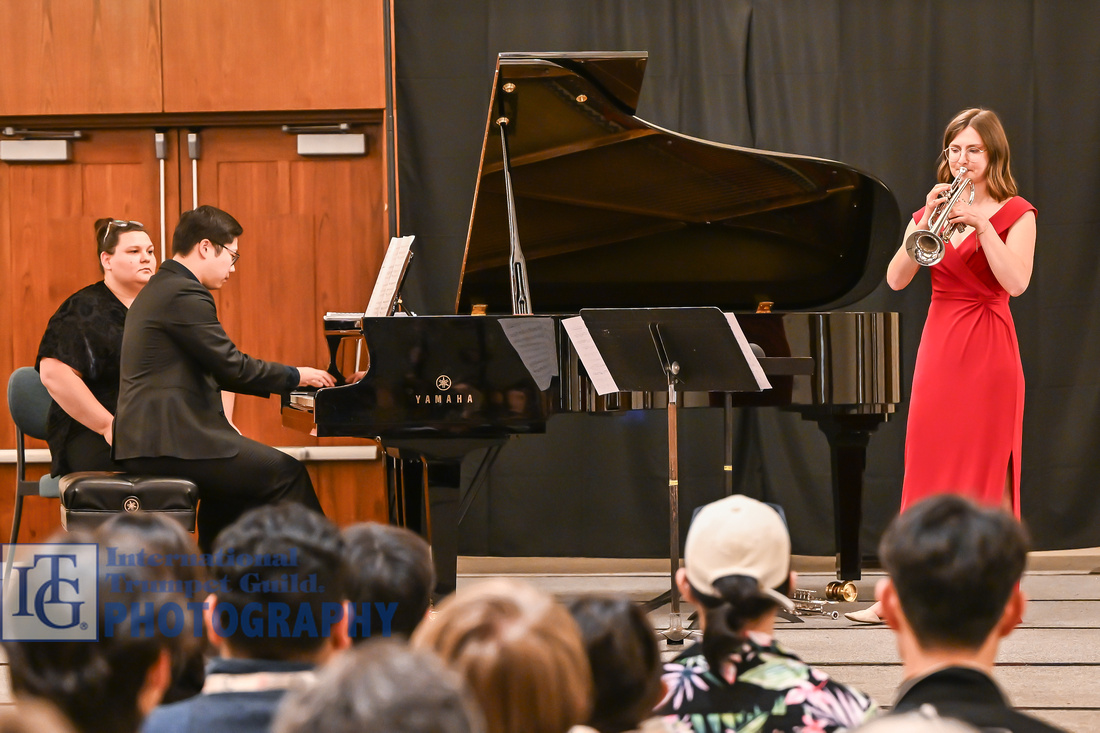
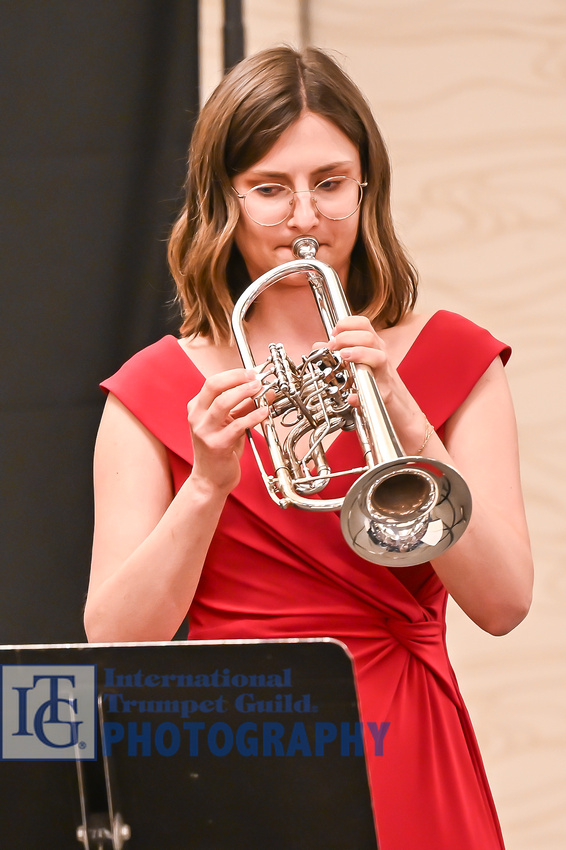
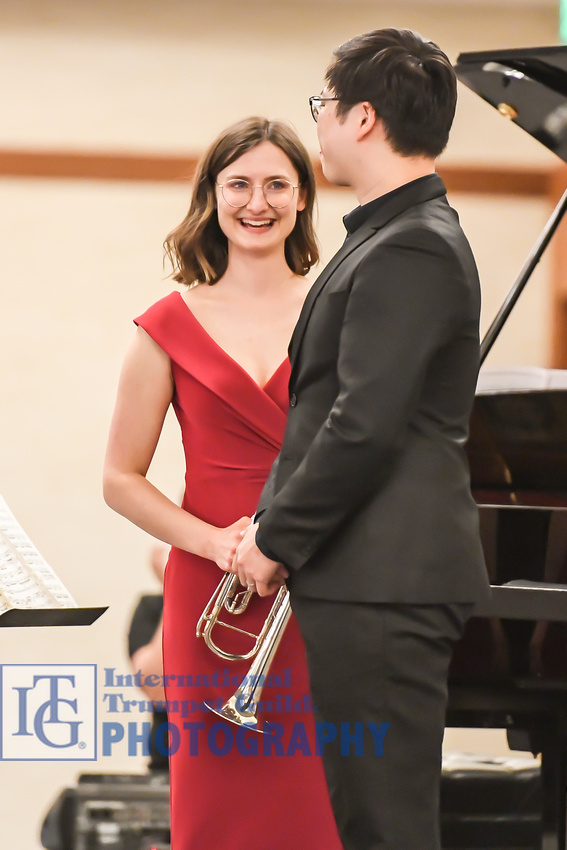
Closing Concert - Gordon Goodwin’s Big Phat Band
To start the final concert of the 2024 ITG Conference, Youth Competition Chair Erika Izaguirre announced the winners of the Youth Junior division of The Ryan Anthony Memorial Trumpet Competition. The third-place winner was Juhan (Tony) Lee. Second-place honors went to Michelle Park. The first prize was awarded to Triin Ustav.

Following these awards, Gordon Goodwin’s Big Phat Band performed, and they certainly did not disappoint. Lead alto Sal Lozano explained that this concert was the first gig, in the 25-year history of the band, in which Gordon Goodwin could not appear (due to a mild illness). Undeterred, they opened with “TOP Adjacent,” a Tower of Power-inspired funk chart with plenty of sass from the trumpet section and burning solos from Brian Scanlon on tenor, followed by Goodwin’s “El Garage Gato” with solos by Lozano (flute) and Francisco Torres (trombone) and featuring the percussion section. An early highlight of the evening was Goodwin’s arrangement of “Rhapsody in Blue” with a Basie-style swing feel, a tenor battle between Scanlon and Alex Hahn, and a few tasty solo lines from Wayne Bergeron. The Goodwin favorite, “Hunting Wabbits,” featured the tight sax section in his comical take on cartoon and film music. Solo time went to Jay Mason (bari sax), Andy Martin (trombone), Eric Nam (trumpet), Kevin Axt (bass), and Jim Cox (piano).
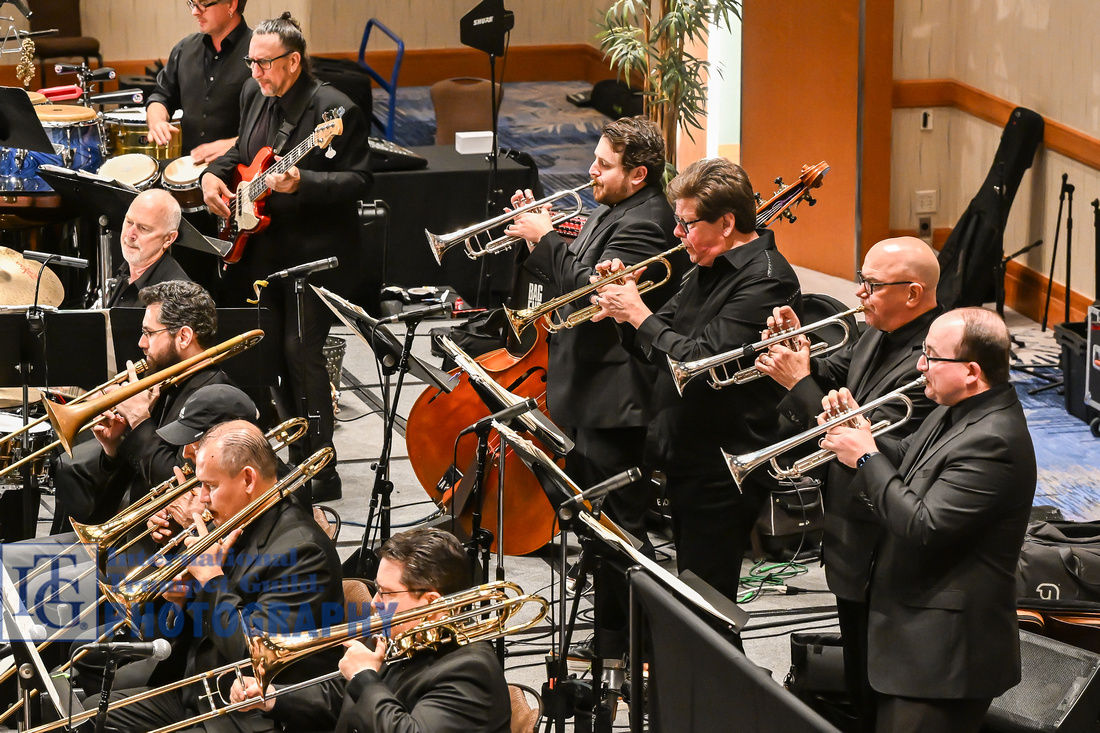
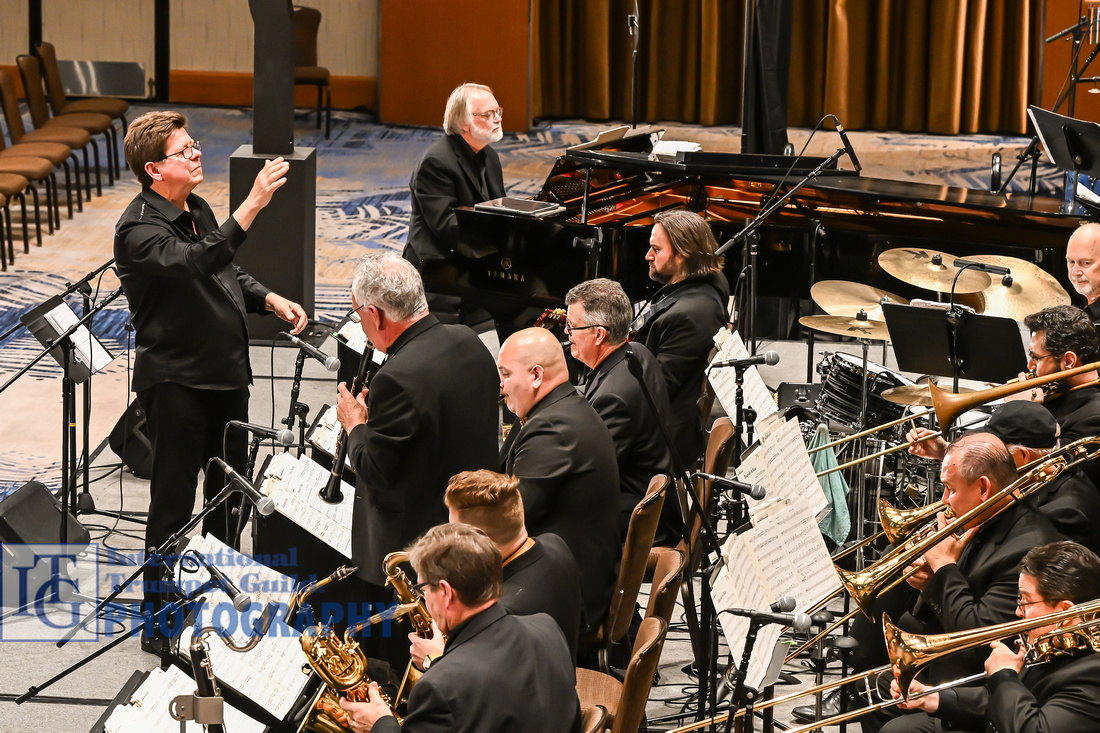 Bria Skonberg was invited to the stage for solo and vocal duties on a funky Goodwin arrangement of “The Beat Goes On,” made famous by Cher. Brian Lynch joined the band for his “The Palmieri Effect,” with solos by Hahn, Cox, Torres and plenty of blazing choruses by Lynch. The trumpet section was featured next on Goodwin’s “Backrow Politics,” and as expected, they didn’t hold back on their solo opportunities; a battle royale was enjoyed by all! Skonberg and Lynch took the stage again for the final tune, a fast-paced “Cherokee” on which neither soloist – nor the band – held back. The Big Phat Band provided a perfect conclusion to the 2024 ITG Conference! (Daniel Kelly)
Bria Skonberg was invited to the stage for solo and vocal duties on a funky Goodwin arrangement of “The Beat Goes On,” made famous by Cher. Brian Lynch joined the band for his “The Palmieri Effect,” with solos by Hahn, Cox, Torres and plenty of blazing choruses by Lynch. The trumpet section was featured next on Goodwin’s “Backrow Politics,” and as expected, they didn’t hold back on their solo opportunities; a battle royale was enjoyed by all! Skonberg and Lynch took the stage again for the final tune, a fast-paced “Cherokee” on which neither soloist – nor the band – held back. The Big Phat Band provided a perfect conclusion to the 2024 ITG Conference! (Daniel Kelly)
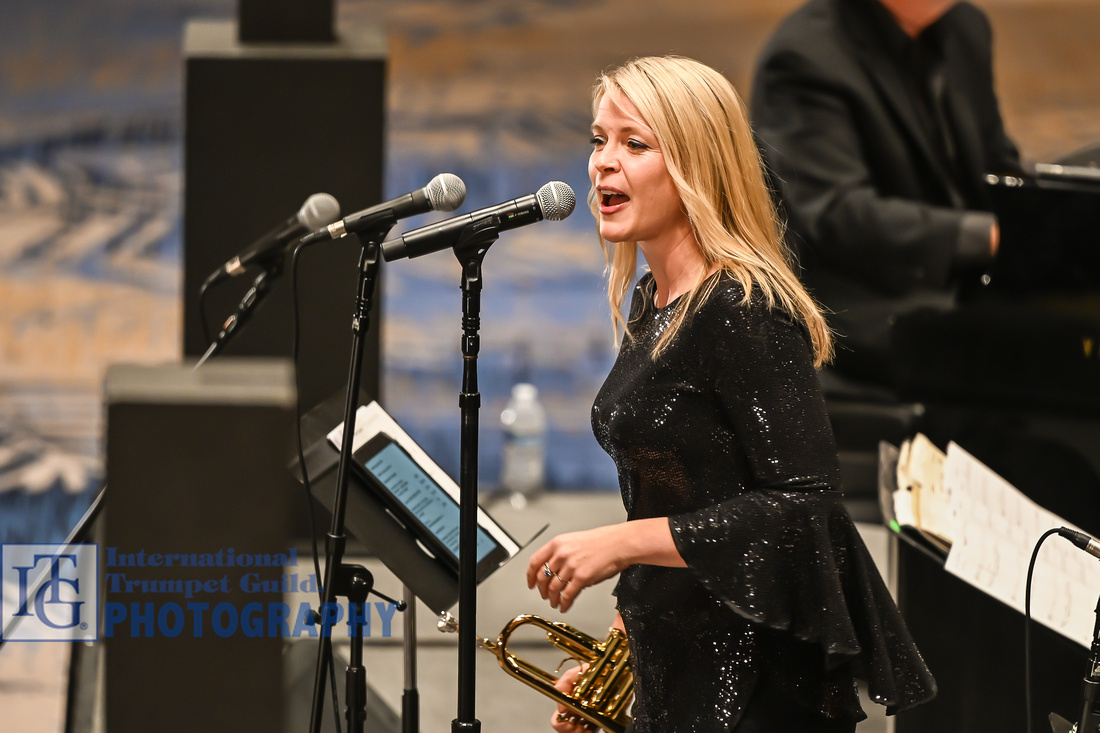

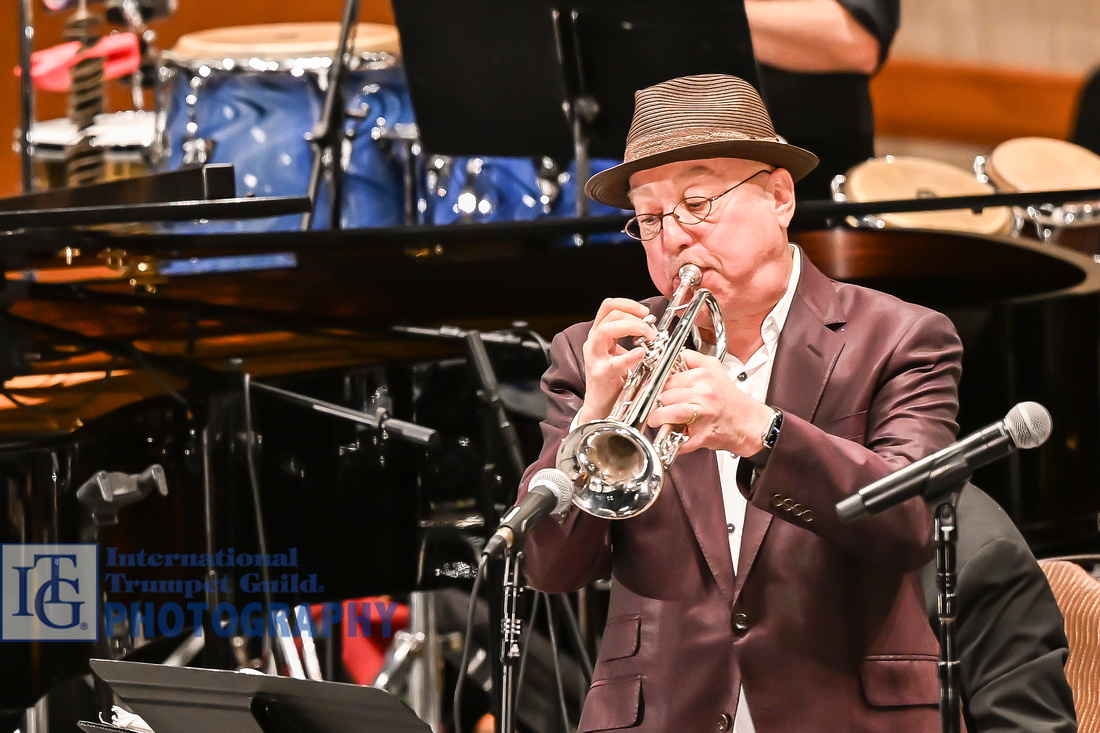
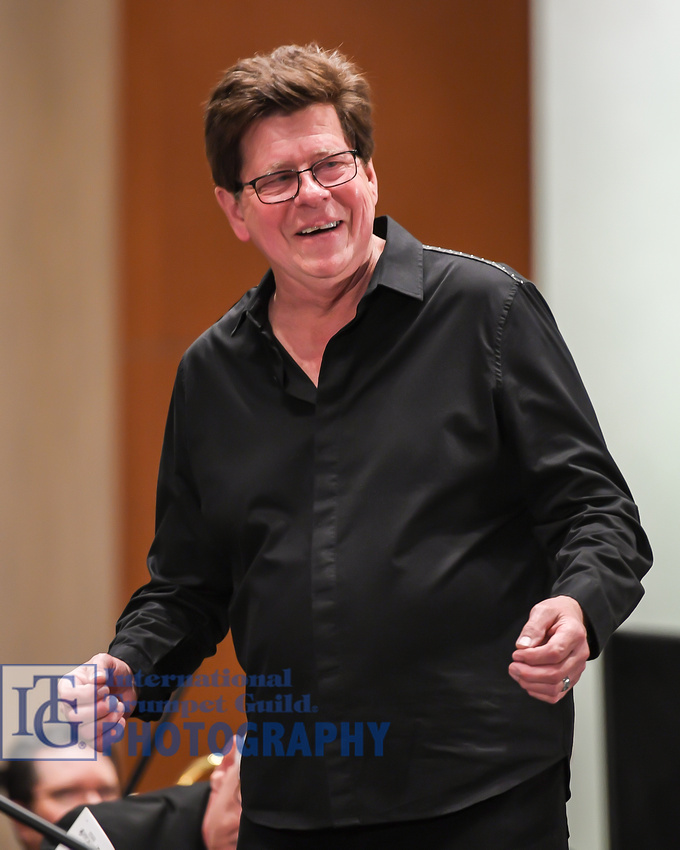
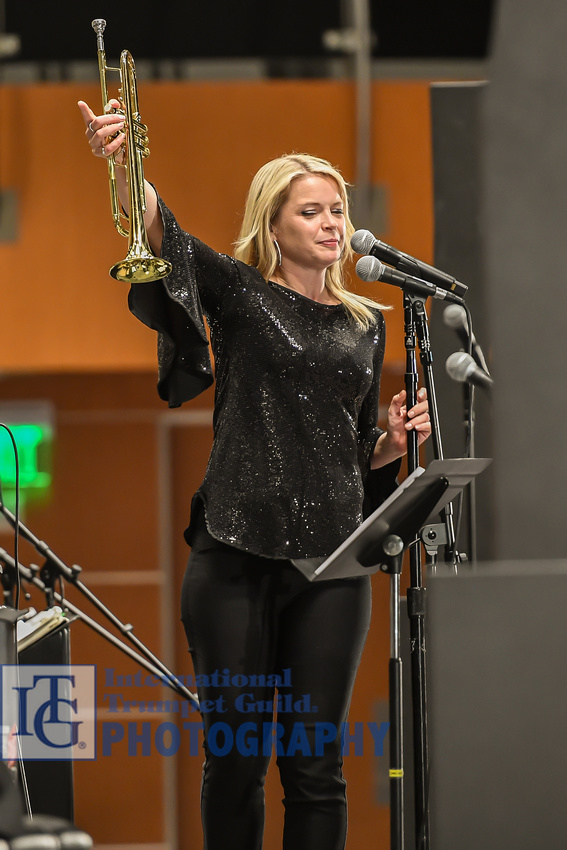
Click here for more photos from the ITG Conference
]]>
Special Daily Report • Compiled by Peter Wood
Photos by Michael Anderson, Jason Harrelson, Daniel Kelly, and Steve Stricker
Friday, May 31, 2024
Click here for more photos from the ITG Conference
Ryan Stransky Youth Warm-Up Session - The Routine 30 Minutes for YOU!
Dr. Ryan Stransky, instructor of brass at Alcorn State University, presented his first-ever session at the ITG Conference, kicking off the Youth Extravaganza weekend. His “Routine-30 Minutes for YOU!” explored how a warm-up routine can be structured to fit personal daily needs both mentally and physically. With the individual in mind, Stransky’s routine offers a creative and organized way to build and set small goals. He demonstrated a step-by-step guide to building an effective routine that utilizes breathing, buzzing, flow studies, and fundamentals. To end the routine, Stransky encouraged everyone to work on etudes to incorporate every building block at once. Stransky’s overall focus is on developing individuals, and that can involve a variety of combinations and methods. (Madison Barton)
Jason Dovel Non-Pro Players Warm-Up Session
In Dr. Jason Dovel’s session for the non-pro players, a full room of trumpeters received valuable insights into how warmups can provide a foundation for improvement and increase accuracy in one’s overall playing. Dovel shared exercises from his routine, taking the players through key exercises that he incorporates daily. His approach involves helping the trumpeter establish good habits and unlearn bad habits while working on accuracy. Dovel emphasized the importance of practicing throughout the full range and dynamic spectrum of the instrument each day in the warmup. Ultimately, each concept mentioned in the session encourages participants to “warm up for tomorrow, not today,” which will foster quicker improvement. Trumpeters in attendance are sure to benefit from Dovel’s sound principles of warming up and now have excellent exercises to incorporate into their daily warm up session. (Sarah Stoneback)
Adán Delgado Warm-Up Session - Organizing Your Body and Mind with Balance and Common Sense
Spanish trumpet soloist Adán Delgado began the warm-up session by playing descending long tones, Cichowicz flow study patterns, and an expanding G-major scale, inviting the more than sixty attendees to copy his playing. Delgado explained that an effective warmup sets up good breathing and a relaxed posture. He pointed out that if one knows what is important, it is possible to adapt any method to suit one’s individual needs. Finally, he closed the session by demonstrating effective slur patterns. (Stanley Curtis)
Josh Rzepka - Mastering Mutes
Selecting the right mute for the job is important, and Josh Rzepka offered a wealth of information in this well-attended session. With a tremendous number of mutes laid out, guests were surely in for a treat. Rzepka began by addressing the most vital qualities that a player should analyze when choosing the right mute: core, projection, articulation, response, tonal color, and intonation. Rather than asking which mute to choose, players must consider their circumstances: their role within the ensemble or composition, the size of the venue, the acoustic layout, and other demands of whatever job they are playing. The session continued with helpful tips and tricks, such as filing your corks down - because not all bell flares are created equal! Lastly, Rzepka brought a group of players to the stage to demonstrate some classical and jazz excerpts, each time repeated with a mute consisting of different material and design than the one before. (Peter Nionakis)
Youth Competition: Senior Division
The finals of The Ryan Anthony Memorial Trumpet Competition, senior youth division, featured sixteen finalists from across the globe performing a variety of etudes and solos, including works by Charlier and Brandt. David Zhao was the first contestant, performing Charlier #10 with clear style and great pacing through many of the etude’s intervallic challenges. The second finalist, Emily Ayala, performed a Vannetelbosch etude with strong, contrasting dynamics and infectious energy. Leon Ye demonstrated a clear, beautiful tone and good musicianship in his performance of Charlier #2. The fourth contestant, Christian Garner, displayed great ease of playing in Charlier #6, highlighting great dynamics and a resonant sound. Hsueh-Yang Yang performed the technical passages of Charlier #23 with ease and a clear sound in all registers. Stefan Gjorgiev performed Charlier #2, displaying a beautiful vibrato with great pacing and style. Joshua Tan chose to perform Brandt #23, highlighting great dynamic contrast throughout. Natasha Hernandez played selections from the Neruda Concerto, representing great tone and phrasing.
Following a short break, Yinglu Liu began the second half with a performance embodied by finessed technical playing and clear articulation. Soren Hershkowitz demonstrated an ease of playing and vibrant tone in his rendition of Charlier #4. Marshall Lin displayed a strong command of the technical elements, and a full beautiful sound in his performance. Owen Kearney performed Charlier #6 with terrific dynamic contrast and a resonant tone. Yuntong Li did a wonderful job with Charlier #24, channeling the drama and the passion of the Wagner operas. Daniel Lee showed off his great sound and musical pacing throughout his performance. Sean Kobayashi played Charlier #2 with strong timing and great flexibility throughout all registers. The final contestant was Andy Hao, performing Charlier #6 with beautiful tone in both technical and lyrical passages. All of these finalists demonstrated great passion and joy in their performances. (Flint Angeroth Franks)
Jason Dovel Non-Pro Masterclass - Trumpet Rules of Thumb
Jason Dovel gave an impressive and informative masterclass for non-pro trumpeters after his 8:30 a.m. warm-up class. Dovel included tips and tricks, his “Rules of Thumb” for embouchure, tempo, intonation, endurance, phrasing, breathing efficiency, and “unbreaking” bad habits. Two concepts that serve as cornerstones in his teaching are embouchure and endurance. Regarding embouchure, he shared, “Mouthpiece pressure is not the ‘boogeyman;’ rather, where the pressure is being applied is the boogeyman.” He stressed the importance of more pressure being distributed on the bottom lip than on the top lip. Endurance is helpful to think about as a budget – how much does it “cost” you for each note you play?Three non-pro trumpeters performed for Dovel, and all demonstrated marked improvement after receiving Dovel’s useful advice. The audience, including one person who was a friend and colleague of the legendary pedagogue Sigmund Hering, was very supportive and aided in great conversation. (Jacinda Ripley and Sarah Stoneback)
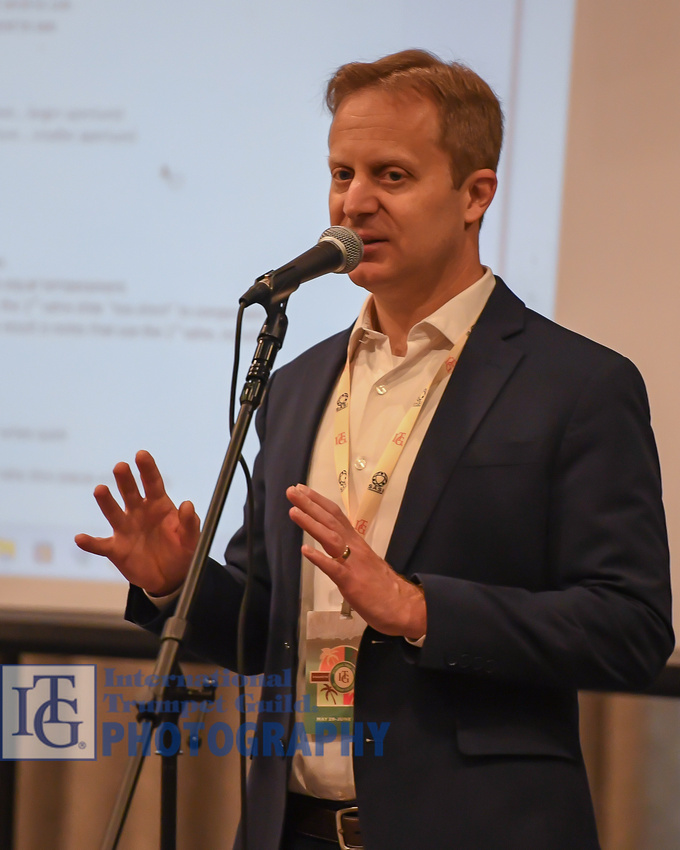
Micah Killion - Trumpet Practice Playbook: Quality vs. Quantity
In this session, Dr. Micah Killion described his valuable research on the importance of detailed practice vs. unfocused practice and on how we learn how to practice. Killion earned a PhD in Music and Human Learning from the University of Texas, and he encouraged detailed, focused work with healthy practice habits and mindsets. He also explained how these elements contribute to learning. He shared a short video clip of Master Sgt. Amy McCabe practicing and gave a real-time analysis of her effective process for addressing errors and solving problems in the practice room. Killion closed the session by sharing a link (https://umkc.co1.qualtrics.com/jfe/form/SV_6gwPFpeTDI9sD9s?Q_CHL=qr) to his study on how musicians learn about music practicing. (Madison Barton)
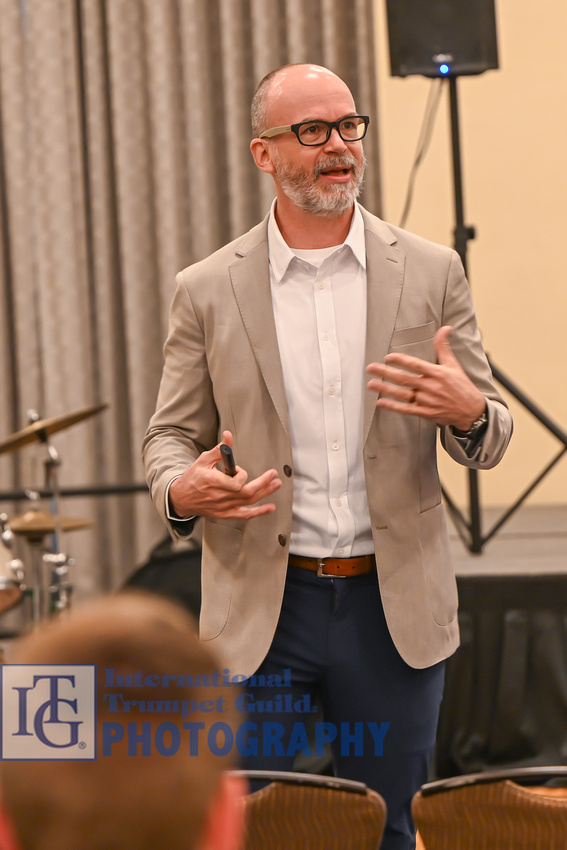
Rick Baptist - The Soundtrack of My Life in Hollywood
Recording over 1300 movies and thousands of TV shows, Rick Baptist is someone about whom most of us have heard at some time in our lives. His journey started when he was diagnosed with asthma as a child. To help improve his situation, the doctor recommended a wind instrument. That recommendation, along with the inspiration that Baptist gained from listening to Harry James, would be the catalyst for an astronomical career in music. His session was full of stories from as early as age twelve to the recording of the movie “Up,” in which a 1938 solotone mute would serve for the perfect character the composer was intending. Baptist discussed his mentors, early experience, and career highlights, and he sprinkled in advice to younger players. He expressed his fondness for playing music for cartoons. The insightful sessions ended with Baptist explaining that in 2020, he achieved the goal of having every musician receive mention in the ending credits for movies. (Will Koehler)
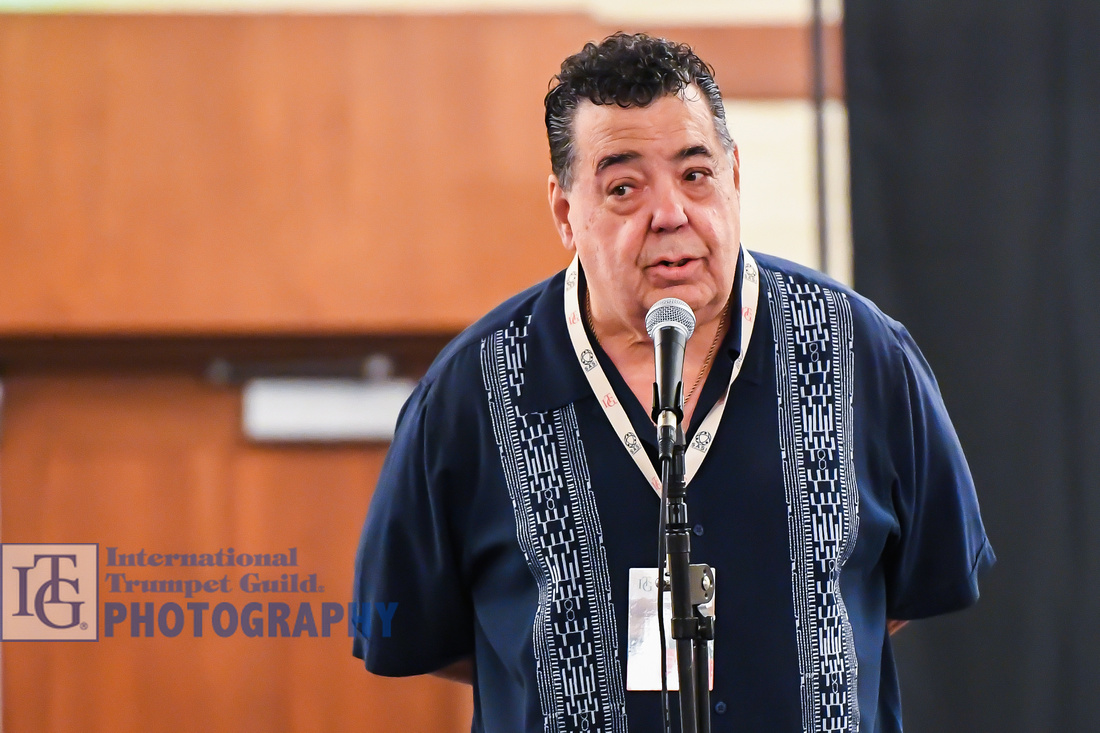
University Professor Spotlight Recital
Gabriel DiMartino, Michael Gause, Merrie Klazek, Mikio Sasaki, and Peydon Shelton
The Tennessee Tech University opened this new University Professor Spotlight Recital with an exciting performance of Doulas Hedwig’s “Brooklyn Fanfare” and Dennis Horton’s “Irish Folk Song Suite.” Peyden Sheldon performed Turrin’s “Three Excursions,” handling the technical demands with a bold, clear sound and crisp articulation. Michael Gause performed the third and fourth movements of Santiago Baez’s “Piezas Andaluzas.” The third movement features sinuous lines over a rhapsodic piano part, while the fourth is a rondo with an energetic, angular theme, all handled with ease by Gause. Mikio Sasaki presented Kenji Bunch’s “Tango Morendo,” with moments from lyrical to sultry and steamy, as well as a few quotes surely recognizable to listeners of a certain vintage. Sasaki concluded with a beautiful performance of “Flower of Patience,” a sweet, melancholic Japanese children’s folk song arranged by Tadaaki Ohno and edited by Timofei Dokshizer. Merrie Klazek performed three works from her latest album, featuring her own arrangements of music from around the globe. She opened on piccolo trumpet with an elegant and tastefully embellished performance of Jeremiah Clarke’s Minuet and Gigue. She switched to flugelhorn for Philippe Bruneau’s “La Complainte de la Folkloriste,” with the instrument providing dark undertones to Bruneau’s plaintive melodies. Klazek closed her performance with Astor Piazzolla’s beloved “Libertango.” Gabriel DiMartino closed the recital with the outer movements of Allen Vizzutti’s Sonata No. 2. DiMartino’s performance was spirited, clear, and quite exciting. The indefatigable Gail Novak accompanied all of the soloists with her customary grace and skill. (Daniel Kelly)
Brad Goode - Understanding Injury in Trumpet Players
In his highly informative presentation, Brad Goode clarified much of the confusing aspects of embouchure injuries. The highly accomplished jazz artist and professor from the University of Colorado Boulder suffered two accidents early in his career, which prompted decades of research into recovery and healthy embouchure training. Unlike muscles that are attached to bones, the orbicularis oris muscle responds differently to injury and requires special recovery. Goode explored symptoms and causes of muscle injury, as well as related nerve symptoms. He also demonstrated exercises developed by Dr. Simon McGrail, the Canadian surgeon who coined the term “Satchmo Syndrome,” referring to Louis Armstrong’s ruptured orbicularis oris. Goode made a plea for change; brass instructors need to change habits that make students susceptible to injury. One important factor in avoiding injury is engaging the buccinator muscles, which support the orbicularis oris and help to manage mouthpiece pressure. He was incredibly articulate and intentional in his remarks about a very sensitive subject. A common message to those struggling is: “It’s an injury, so you must treat it like an injury; but you’ll be fine.” (Nick Volz)
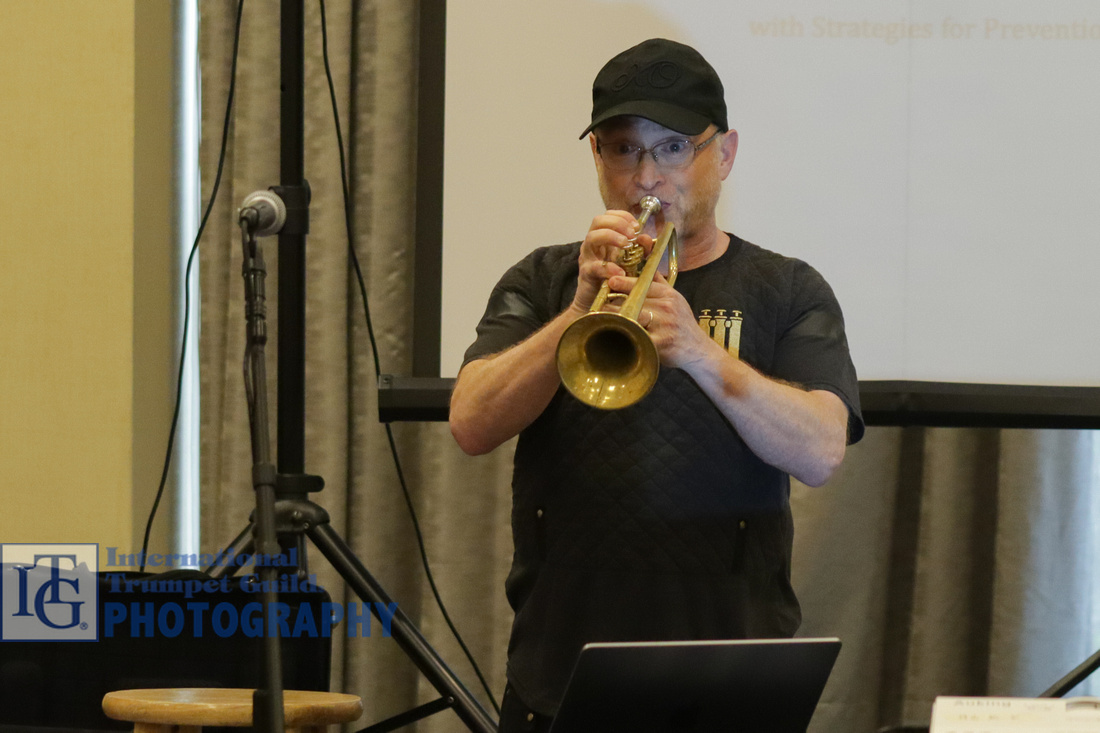
New Works Recital II
The Pre-Professional Quintet opened the New Works Recital with a strong performance of Connor Johnson’s trumpet ensemble piece “Spitballing,” which was an exciting work with a fiery opening, a soft lyrical section on flugelhorn, and a return to the fiery material to close.
The first piece on the second New Works Recital of the conference was the first movement of JaKobe Henry’s “American Dream,” titled “Chugga, Chugga, Chugga.” This crossover piece for trumpet and piano blended contemporary melodic figurations with jazz and blues-inspired tunes. Henry performed his own piece and had no difficulty navigating the changing styles.
Will Koehler performed the second and third movements, “Fugue” and “Toccata,” of Daixman Ai’s Sonata for Trumpet and Piano. The piece opens with piano figures emphasizing intervals of the fourth and fifth and is reminiscent of a gentler version of the Kennan Sonata sound world while also highlighting the tone colors of both the flugelhorn and trumpet.
Julia Bell performed the first movement, “With Bravery,” from Marcus Grant’s “Sonata for Heroes.” Bell’s clean performance showcased the heroic motives of the piece, which were evocative of any number of superhero movie themes cast in an accessible harmonic language. The limited range and technical demands would make it great for undergraduate students.
Elizabeth Raum composed “Illusion (Is the Better Part of Life)” for trumpet, trombone, and piano. Trumpeter Imani Duhe and trombonist Lori Stuntz performed the second and third movements with terrific expression, balance, and blend. The performance began with “Fill the Wine Cup,” a subdued march with an unrelenting ostinato in the piano, before moving on to the third movement, “Destiny,” which showcased drinking-song melodies weaving together humorous trumpet and trombone licks.
George Carpten, IV, performed Morgan Kelly Moss’s “To the Ones that Know My Heart.” The piece opened with floating atmospheric ideas in the piano while the trumpet part explored the full range and dynamic possibilities of the instrument, along with both muted and open tone colors. Carpten performed very expressively and cleanly with a clear and powerful tone throughout.
HyeKyung Lee’s “Endeavor” featured trumpeter Craig Parker, pianist HyeKyung Lee, and a vocalist who took the place of Elaine Huang, who was ill. The work featured repetitive ostinatos in the piano against muted figurations in the trumpet and wordless, quasi-improvisatory vocal figures sung with only syllables. Parker navigated the various tone colors of the solotone and wah-wah mutes to express the contemporary harmonic language and melodic phrase structures.
Brandon Dicks composed and performed the unaccompanied “Radiant Ascent.” The piece began with dark, atmospheric harmonies that gradually gave way to brighter ascending melodies, which Dicks performed with intense expression.
William Takacs performed BJ Brooks’s “Tau,” beginning with an arpeggiated ostinato in the piano with a Latin-flavored melody floating on top, interspersed with running flourishes. Takacs performed the piece with a musically clean and full tone, easily expressing the fast-moving tau proteins as they traverse vast neural networks in the brain.
John Mietus’s “Seraphim (robot with a human face)” began with a plaintive, yet sparkling, opening in the piano while the color pairing of oboe and trumpet created interesting musical colors. Tyler Helms kept the trumpet sound subdued while Ty Matthews performed the oboe strongly, resulting in a perfectly balanced performance in call-and-response motives.
Raquel Samayoa performed the final piece on the program, Tom Gontier’s “On the Road Up North.” The piece opens with an exciting, angular trumpet line that is cast against a dense, but accessible, piano part. Samayoa handled the many virtuosic passages and challenging multiple-tongued runs with ease. (Scott Hagarty)
Marco Pierobon Recital - Roma and New York (Ennio and George)
Opening for Marco Pierobon’s recital, the trumpet ensemble from the University of Wyoming performed Franz von Suppé’s very exciting “Poet and Peasant Overture” with great musicality and finesse. Pierobon’s first piece was a medley of works, entitled “Morricone Tribute.” This work consisted of an assortment of popular works by Morricone such as “Cinema Paradiso” and “The Good the Bad and The Ugly,” followed by another collection of popular tunes by Gershwin, with such notable melodies as “Fascinating Rhythm,” “I’ve Got Rhythm,” and “Rhapsody in Blue.” Pierobon’s stunning sound and ability to maneuver effortlessly around the instrument received him an enthusiastic standing ovation. He concluded his recital with a final medley of melodies from Gershwin’s “Porgy and Bess,” receiving a second standing ovation. Marco then left the audience with an encore. His recital demonstrated his unmatched musical abilities in all musical styles and genres, leaving him with a total of three standing ovations. (Maryna Pohlman)
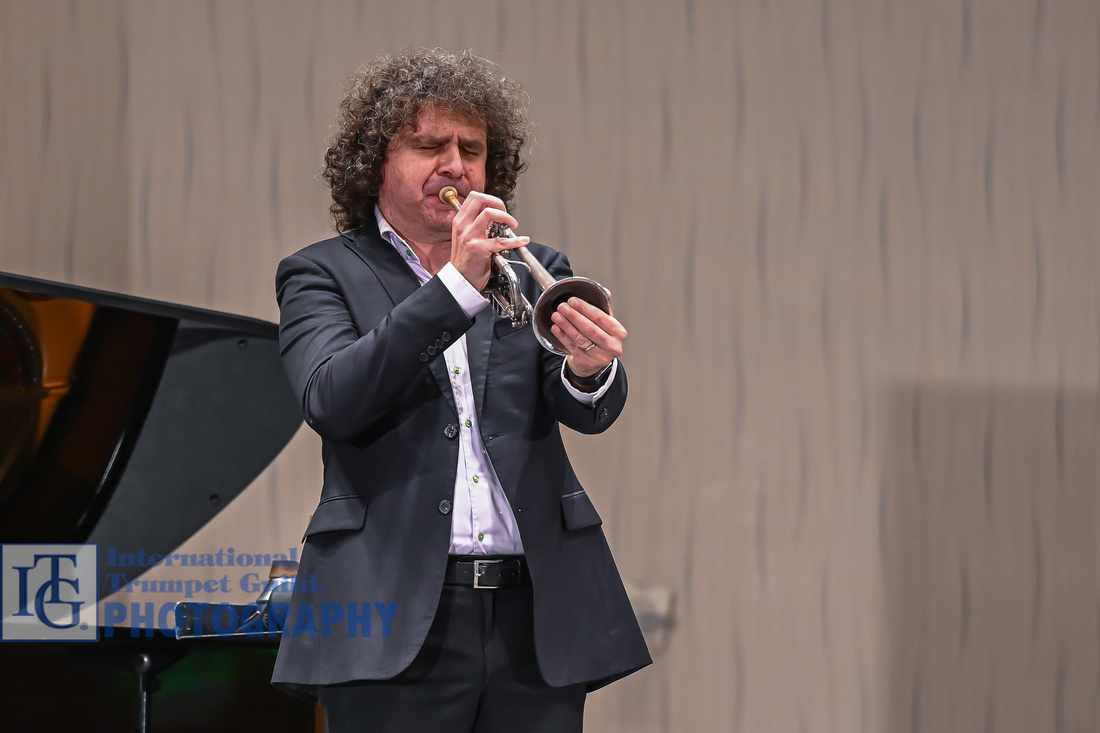
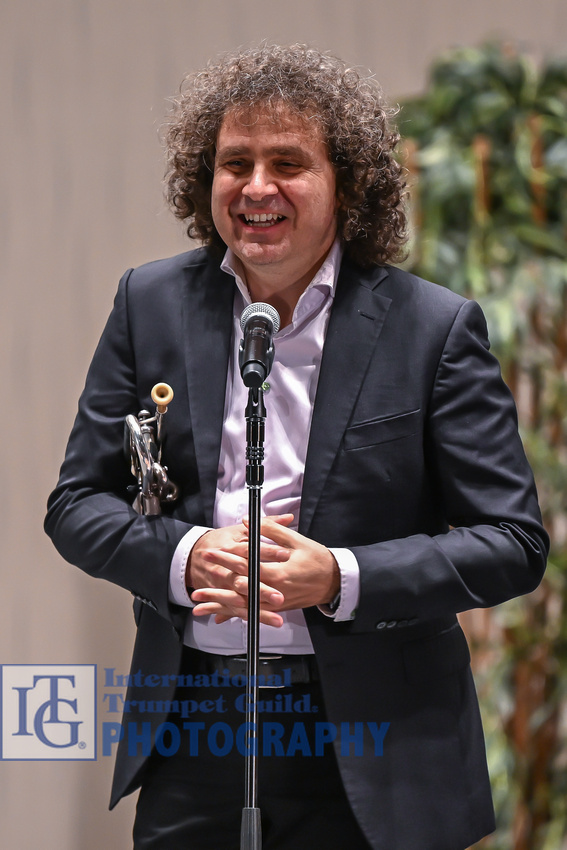
Youth Session with Imani Duhe
Atlanta native and current Los Angeles resident Imani Duhe presented a session as part of the Youth Extravaganza weekend. Her presentation was centered around developing good practice habits and making a career as a freelance artist. In addition to being an active performer, Duhe teaches for the Youth Orchestra of Los Angeles. With her experience in teaching younger performers, Duhe shared her idea of using vision boards to set short-term goals. Her vision-board model targets such areas as repertoire, technique, range, and personal goals and has a section dedicated to practicing for fun. She shared her intriguing journey to becoming a professional freelance artist. Duhe was an engaging and generous speaker and actively encouraged audience participation. (Madison Barton)
Brian Lynch - The Comprehensive Method for the Improvising Trumpeter
To open this session with Brian Lynch, the trumpet ensemble from Brigham Young University beautifully performed Erik Morales’s arrangement of “Amazing Grace.” In the session, Lynch, professor of studio music and jazz at the University of Miami Frost School of Music, described the method he uses with his students in Miami - a comprehensive approach for players who find that the standard technical studies, while helpful for trumpet technique, may not address all facets of their playing, especially improvisation. At its foundation is the Barry Harris method: thinking about melodies using specific eight-note scales (diminished/half-diminished). Lynch demonstrated ways to use these patterns, which incorporate lip bends, in developing flexibility, articulation, and high- and low-range development. His method should be available on his website (http://hollisticmusicworks.com) this fall. Aspiring improvisers will find many benefits to their playing as they apply these concepts. (Joseph Nibley)
David Wharton and Shawn Williams - Jazz Improv for Classical Players
Professors David Wharton and Shawn Williams held an active session about jazz improvisation for classical players. With Wharton’s classical background and William’s jazz background, they discussed the various ways that trumpeters can work on fundamentals while simultaneously incorporating foundational elements of jazz improvisation. They had the audience work on long tones by first singing the roots of the chord progression and then playing them, with the goal of getting the ears working while also focusing on sound production. In a similar fashion, attendees played a series of lip slurs over chord changes in various keys. Wharton would beautifully demonstrate the exercises for the audience while Williams expertly comped on the piano as well as excellently demonstrating on the trumpet. They also touched on flow studies (over a ii-V7-I progression and triads), range exercises over various chords, jazz articulations, and scales. (Randy Lee)
Anne McNamara - The History and Shared Experiences of Women and Non-Binary Trumpet Professors
Dr. Anne McNamara’s presentation began with a prelude performance by the University of Redlands trumpet ensemble, in which they played a David Hickman arrangement of Carlo Gesualdo’s madrigal “Moro lasso al mio duolo” and Erik Morales’s “Celestial Dance.” McNamara’s presentation was split into two portions: a history of women and non-binary trumpet professors and a summary of results from her qualitative survey of women and non-binary trumpet professors. This history highlighted achievements of women in trumpet teaching roles, such as Mabel Keith Leick, the first known woman trumpet professor, and Fay Hanson, the first full-time woman trumpet professor. In her survey, McNamara found an important statistic, showing that while there has been an increase in women and non-binary people as full collegiate professors, there has not been a significant difference in the challenges faced by current women and non-binary trumpet professors compared to retired professors. McNamara’s full findings can be found in recent volumes of the ITG Journal. (Flint Angeroth Franks)
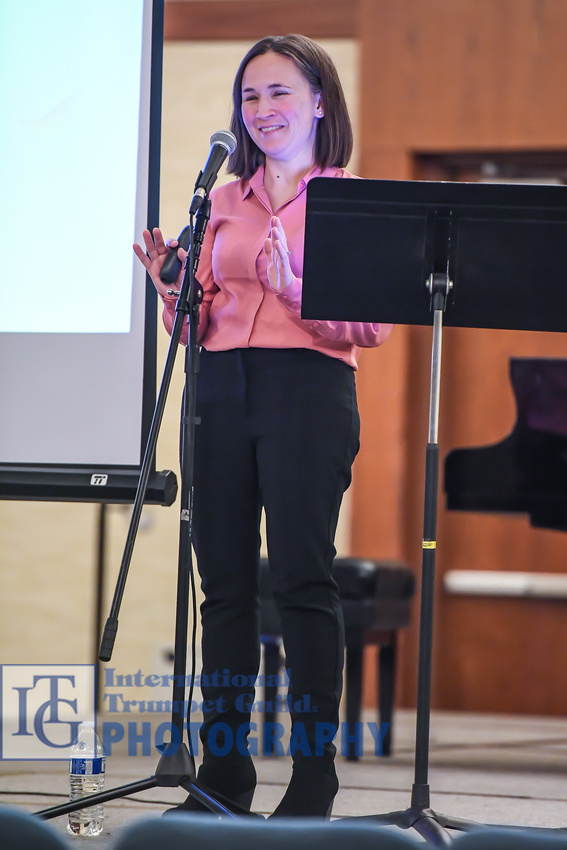
Solo Competition Finals
With a lively audience, a distinguished panel of judges, and three impeccably refined young trumpet players, there was never a dull moment during the final round of the solo division of The Ryan Anthony Memorial Trumpet Competition. Solo Competition Chair Andre Bonnici introduced each competitor, starting with Dylan Johnson from California State University. Johnson’s interpretation of Bozza’s “Rustiques” instantly established his exceptional musical maturity for conquering such a sophisticated piece of music. Attendees were captivated by his shimmering sound and in awe of his various facilities matched with beautiful vibrato.
Jiawei Chen from the Central Conservatory of China set the room ablaze with his bold and powerful take on the first movement of Tamberg’s Concerto op.42, utilizing a crisp tongue and flashy tone with highly contrasting dynamics. Chen’s brilliant sound was on full display on the concluding piece, “Song without Words” by Joel Collier, where Chen was fully immersed in the music and displayed a variety of color and character throughout.
Raphaël Horrach, from the Lyon Superior Conservatory in France, opened his portion of the competition with J. Hertel’s Concerto No. 1 in E-flat Major, consisting of a most delicate, yet commanding, tone. Filled with mesmerizing ornamentation and impressive moments of effortless extreme register, Horrach used the piccolo trumpet as an extension to represent his extraordinary musical abilities. He transitioned very well to C trumpet for the “Sarabande et Finale” by Gallois-Montbrun, elegantly moving through the work’s difficult passages. Accompanist Gail Novak showcased phenomenal musicianship, virtuosity, and excellent collaboration with all three of these fine players. This reporter was highly impressed that all candidates came sharply dressed and held great poise during each of their performances. (Peter Nionakis)
Evening concert: Håkan Hardenberger and Roland Pontinen
To characterize the Friday night concert as “much anticipated” would be a gross understatement. The legendary Håkan Hardenberger rarely gives recitals these days, and his visits to the US are rarer still. This concert was, for most of us, a once-in-a-lifetime event! The prelude ensemble was no less impressive. The trumpet ensemble from the Conservatoire National Superieur de Lyon opened with a treacherous arrangement of the well-known Toccata from Widor’s Fifth Organ Symphony, which they handled with ease, particularly the abundant piccolo parts. The next selection was a clever and quite challenging mashup of 22 melodies or motifs from Maurice André’s more famous recordings. Quotes from Hummel, Chaynes, Tomasi, and several Baroque works were heard. As one would expect from the Lyon Conservatory, the ensemble was absolutely on point.
Following the prelude, awards for two competitions were announced. ITG Youth Competition Chair Erika Izaguirre announced the winners of the Youth Senior Division of The Ryan Anthony Memorial Trumpet Competition. The third-place finisher was Stefan Gjorgiev. Second place was awarded to Yinglu Liu. The first prize was awarded to Yuntong Li. André Bonnici, the chair of the Solo Division of The Ryan Anthony Memorial Trumpet Competition, announced the winners of that competition. Third prize was awarded to Dylan Johnson. Second prize was awarded to Raphaël Horrach. The first-prize winner was Jiawei Chen.


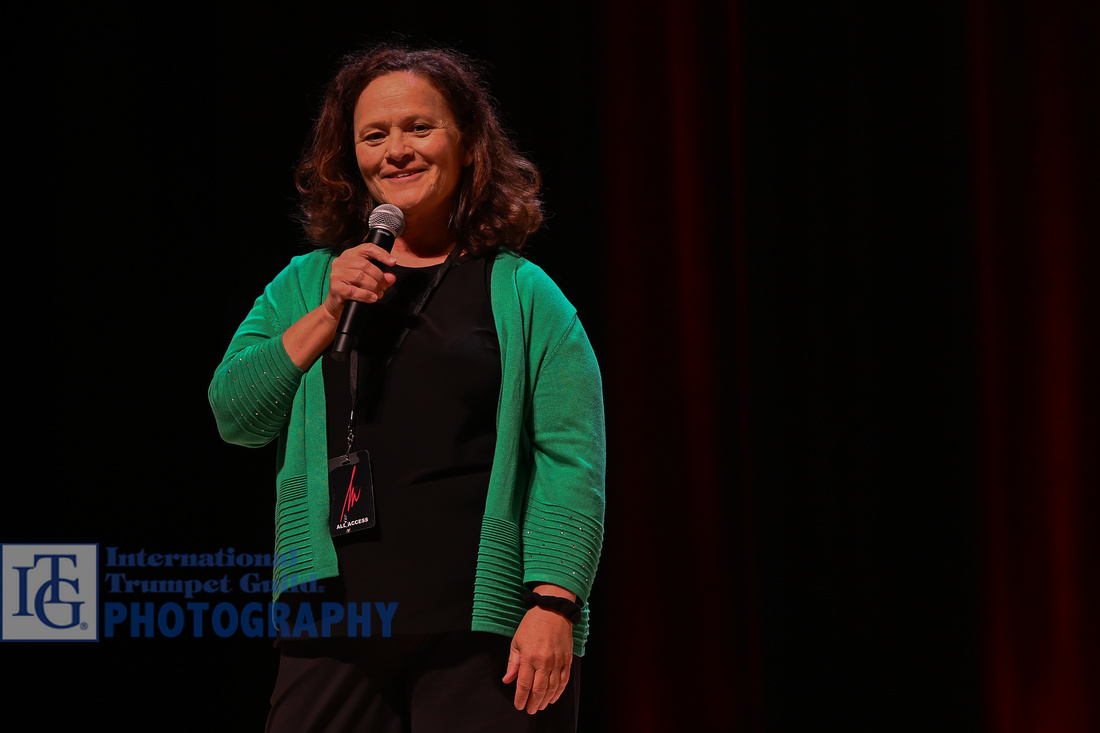
Håkan Hardenberger and his long-time collaborator, Roland Pontinen, took the stage, opening with Enescu’s “Legende.” The performance was seamless, Hardenberger’s dynamic control and intonation was impeccable. This was followed by Staffan Storm’s formidable “Three Autumns.” Clocking in at nearly twenty minutes, the three-movement work featured delicate muted passages, acrobatic leaps matching the piano writing perfectly, and moments of placid, relaxed moods punctuated by dramatic writing for both performers. In numerous moments that seemed absent of pulse, the coordination between Hardenberger and Pontinen appeared organic; lines that seemed unrelated would coalesce momentarily - suddenly - and then part ways again. The relatively slow and placid middle movement was a study in endurance, which Hardenberger somehow made sound easy.
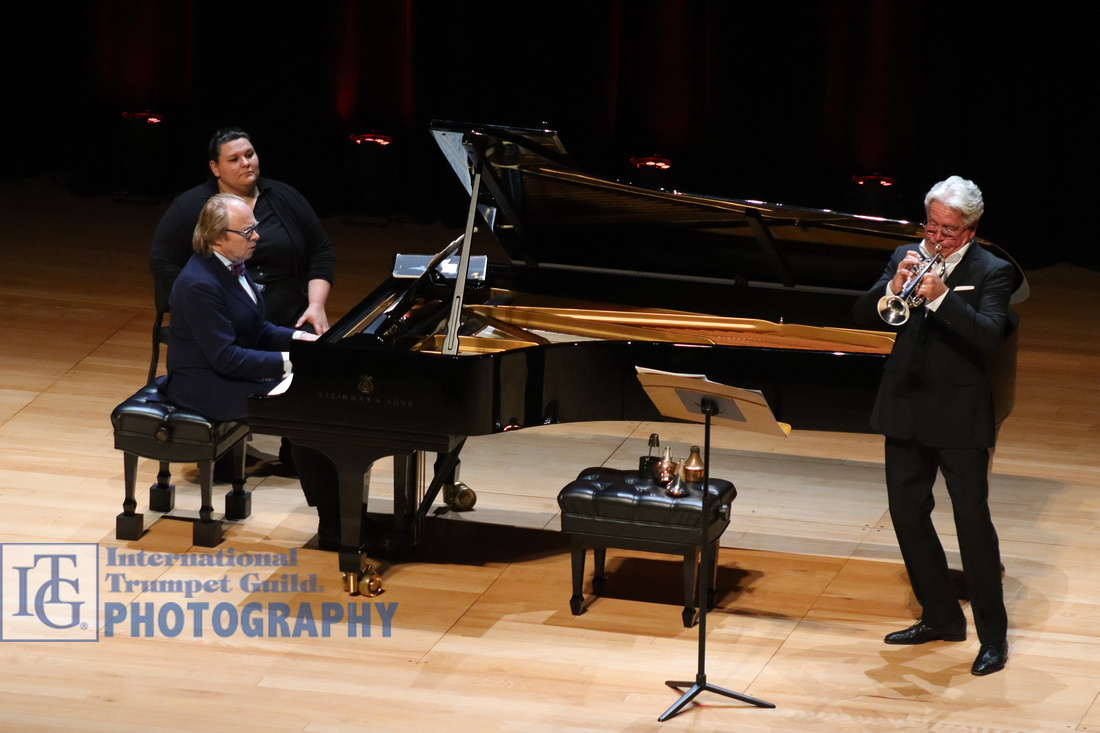
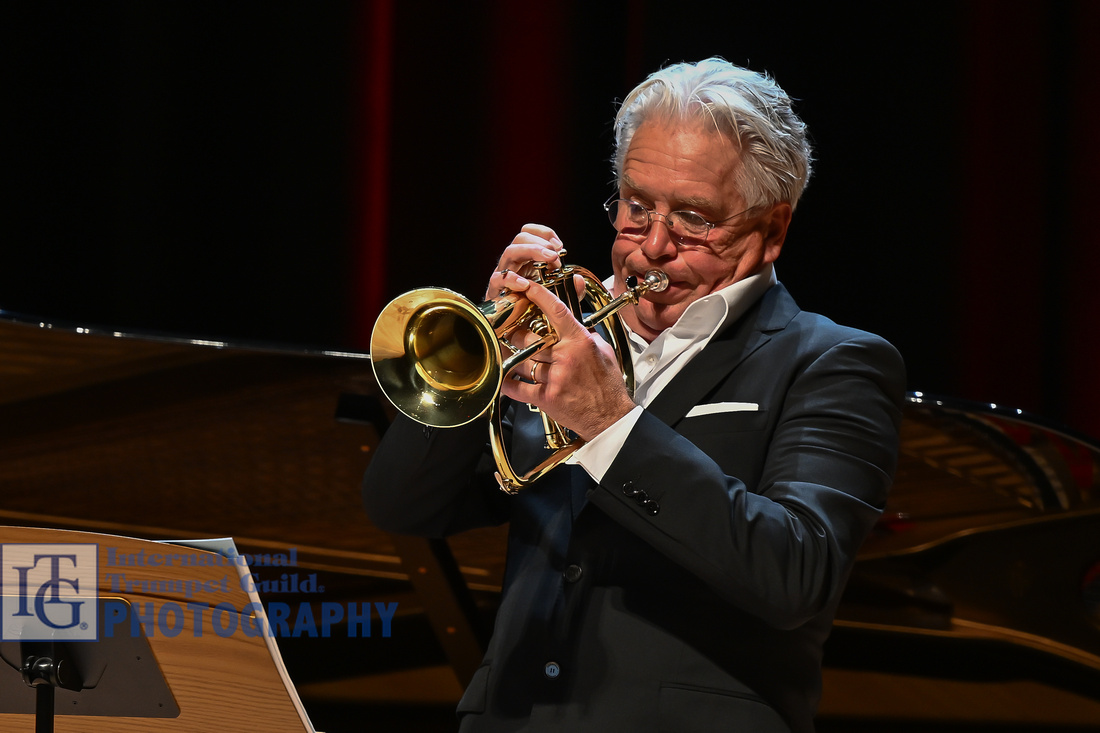
The second half of the program consisted of shorter works, starting with Heinz Karl Gruber’s charming “Bossa Nova” and followed by the world premiere of Mark-Anthony Turnage’s “Autumn Aubade.” While the Gruber had the easy feel of a late-night jazz set, the Turnage would have served nicely as the “last call” tune in a smoky club in the 1950s. Performed on flugelhorn, the piece had a mysterious, weary quality with thin accompaniment and jazz ballad-style rubato and solo fills. This was followed by the second world premiere of the evening - Roland Pontinen’s “Bluebird Dream.” Pontinen’s scoring of Harmon mute above sparse, light piano motives had the impressionistic flavor of Claude Debussy. Though no program notes were offered, the sounds of raindrops, chirping birds, and gently flowing water were easy to catch. A brisk “Rondo for Lifey” lightened the mood before Pontinen took the stage for a solo set of two Preludes of Frederic Chopin, followed by his own “Prelude d’automne,” all of which he performed with fluidity, nuance, and considerable grace.

Hardenberger returned to the stage for the final work on the program, Florent Schmitt’s Suite for Trumpet and Piano. Hardenberger handled the angular, energetic, and highly technical outer movements with ease while the pensive middle movement once again highlighted his remarkable control and apparently limitless endurance. Since he seemed to have much more in “the tank,” the duo returned for two encores, the first a rendition of “Nature Boy” in a placid, understated style, reminiscent of Chet Baker. The second encore was Pontinen’s “Girl from Brazil,” also in the jazz ballad vein and performed on request from Conference Director Rebecca Wilt. Due to the generous support of the Puente de Maravillas Foundation, the Conference attendees were treated to a truly astounding concert! (Daniel Kelly)
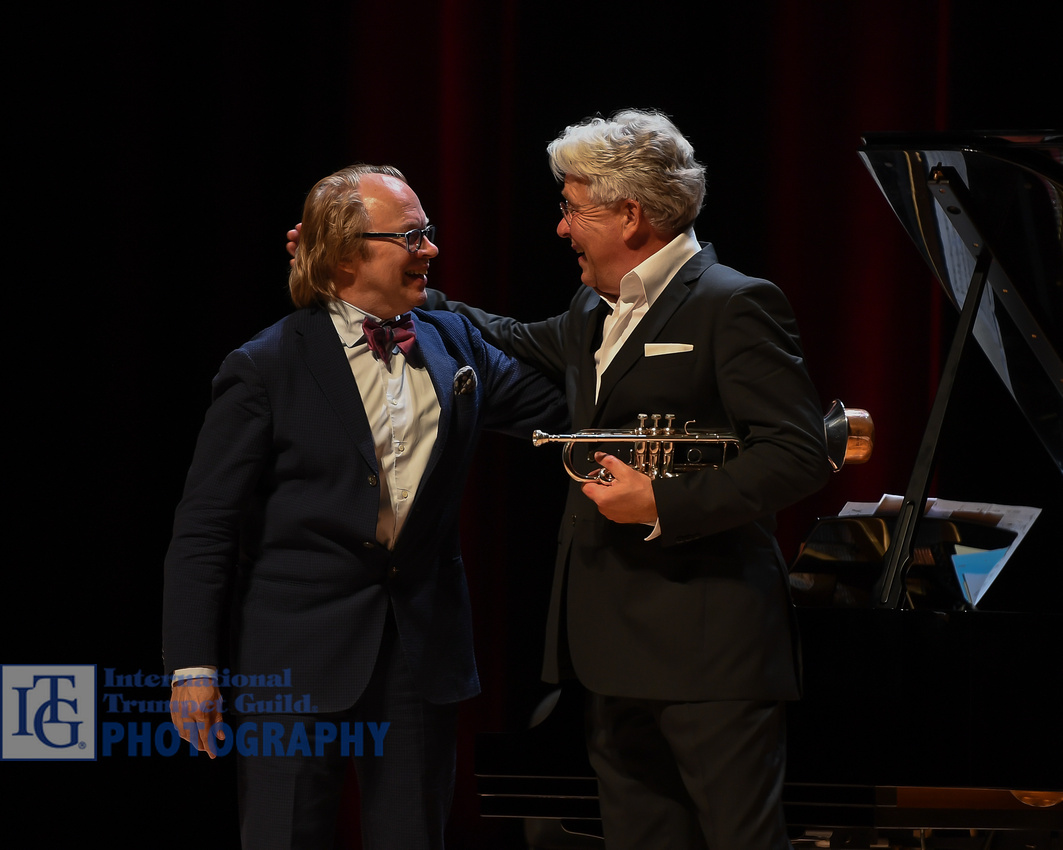
Jam Session with Bria Skonberg
To conclude the fourth day of the 2024 ITG Conference, Bria Skonberg hosted the late-night jam session. The combo for this evening’s session consisted of Joel Taylor on drums, Quinn Johnson on piano, and Kevin Axt on bass. Groups of two to four trumpet players would take the stage to play a piece of their choice, which showcased their individual musical abilities. Each selection allowed all instruments to solo over the combo, sharing their beautiful and complex musical ideas. To conclude each piece, the trumpet sections all joined together and improvised over each other. Some of the pieces that were selected for the evening consisted of Benny Golson’s “Stablemates,” Hoagy Carmichael’s “Rockin Chair,” Billy Reid’s “I’ll Close My Eyes,” and Johnny Mercer’s “I Thought About You.” The uplifting and inspiring jam session drew the evening to a successful close. (Maryna Pohlman)
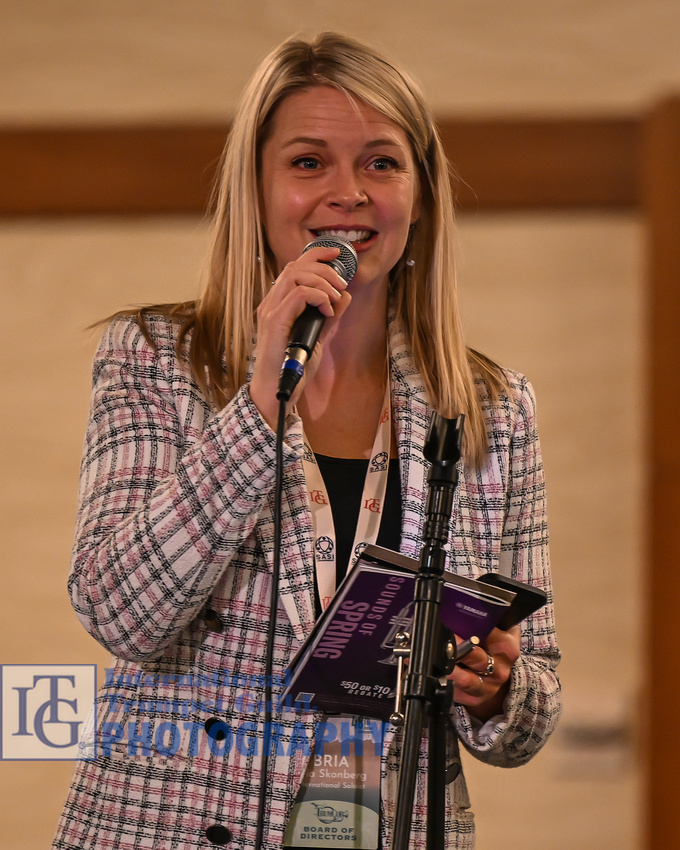
Click here for more photos from the ITG Conference
]]>
Special Daily Report • Compiled by Peter Wood
Photos by Michael Anderson, Jason Harrelson, Daniel Kelly, and Steve Stricker
Thursday, May 30, 2024
Click here for more photos from the ITG Conference
Warm-Up Session with Noa Miller
Dr. Noa Miller delivered an exceptional warm-up session before a room filled with eager trumpeters seeking to enrich their morning routines and explore fresh ideas. The session was thoughtfully structured into two segments, focusing first on mental preparations—guiding participants on what to cover and how to approach material—and then on practical implementation through playing. Key highlights of the class included insights into Miller’s experience with different age groups, strategies for crafting a systematic morning routine, and engaging class discussions that illuminated the finer points of her presentation. Her innovative approach to adapting methods to suit various playing styles infused the room with energy, leaving each attendee with newfound perspectives and ideas to share with others. (Benjamin Dubbert)
Scott Hagarty Warm-Up Session - Breaking the Cycle of Boredom: Introducing Creativity into Your Warm-Up Routine
Scott Hagarty made no delay in helping attendees start their day by suggesting the inclusion of various elements and fundamentals into their personal warm-up routines. Beginning with mouthpiece buzzing, Hagarty emphasized the importance of finding the core of the buzz sound, which he demonstrated by playing some sirens in a call-and-response style with the crowd. Following was a progression of low, slow long tones on the trumpet, along with controlled flexibility exercises, Clarke’s chromatic studies, and articulated scale studies. Although each of these fundamentals are important, Hagarty encouraged the audience to incorporate diversity into their warmups because every day is different. Volunteers were asked to choose from a random list of notes to compose a flexibility exercise, which created a difficult intervallic challenge. Finally, Hagarty brought up five participants to improvise, demonstrating that we can construct a fun, innovative, and refreshing warm-up routine. (Peter Nionakis)
Stanley Curtis and Robert Apple - Keyed Trumpet: Beyond the Concertos of Haydn and Hummel
The Colorado State University Baroque Trumpet Ensemble, led by Stanley Curtis and in their first year of existence, opened the presentation with the performance of a collection of four fanfares. The lecture recital that followed was a joint effort by performers Stanley Curtis on keyed trumpet and Tim Burns on piano, along with trumpeter/researcher Robert Apple. They provided useful information about lesser-known works composed specifically for the keyed trumpet. The works composed by Josef Fiala, Trenkivitz, Agostino Belloli, Josef Kail, Joseph Hoffner, and Guiseppe Verdi were mostly in the Classical style and written for keyed trumpet pitched in D. The most difficult piece on the program was Joseph Hoffner’s Introduction et Polonaise, and it was the only work on the program to have been published before the twentieth century. All the works on the program are available in a newly-published modern edition. (Scott Hagarty)
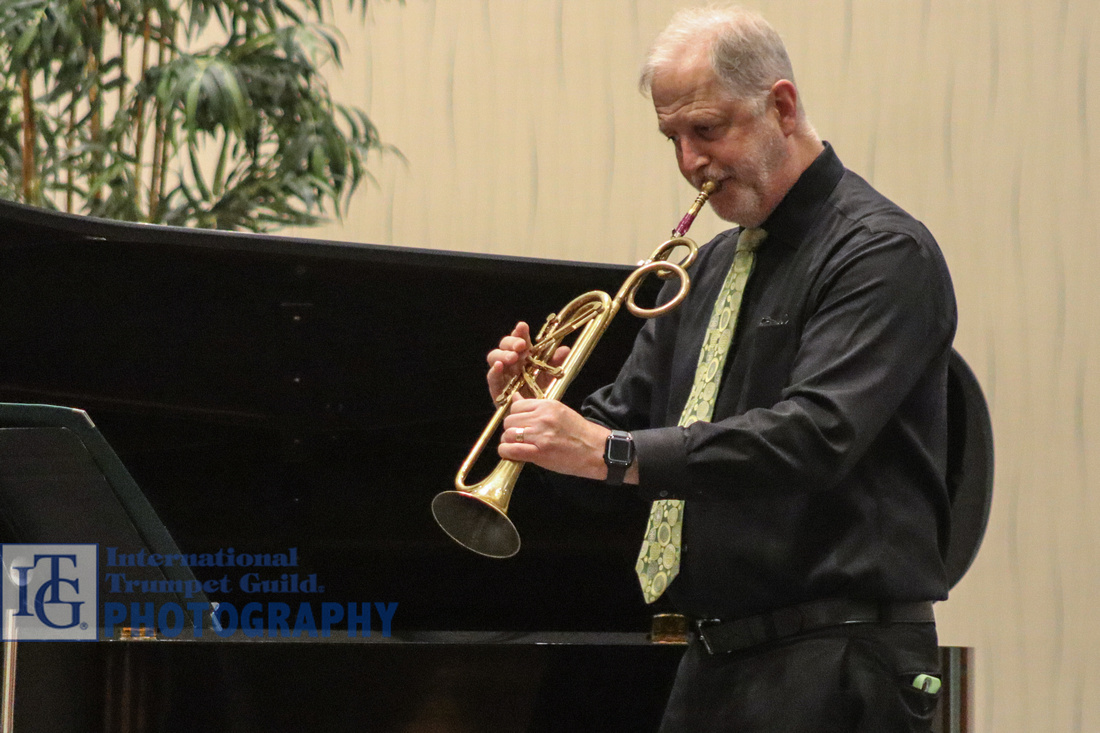
Flint Angeroth Franks - The Serbian Classical Trumpet Tradition
This session began with a vibrant performance by the Southern Arkansas University Trumpet Ensemble of “Let Life be Joyful” by Serbian composer Aleksandar S. Vujic. Dr. Franks then outlined the importance of the Serbian trumpet tradition by discussing its history, solo repertoire, and pedagogy from these skilled performers and teachers. The historical overview began with explaining the vocal tradition of the Orthodox Church and ended with addressing two of the principal trumpet teachers of the 21st century - Mladen Djordjević and Nenad Marković. Franks then covered a handful of composers ranging from the well-known (Dr. Dragan S. Jovanović) to the more obscure (Dorde Tošić). Finally, Franks traced the history of trumpet pedagogy in Serbia, naming two of the more influential teachers from the twentieth century. This extremely thorough research presentation holds promising applications for increasing diversity and new pedagogical tools in the greater trumpet community. (Spencer Brand)
Non-Pro Reading Session with Julia Bell
The ITG Non-Pro Player Committee was excited to offer a new session this year, treating musicians with an opportunity to read trumpet ensemble music just for fun. Led by Dr. Julia Bell, attendees sight read music including Erik Morales’s “Within Sacred Walls,” Eric Ewazen’s “Prelude and Fugue,” Chidester’s arrangement of “Flintstones Chorale and Fugue,” Malcolm Arnold’s “A Hoffnung Fanfare,” and everyone’s favorite, Leroy Anderson’s “Bugler’s Holiday.” With a completely filled Conference room, this session is sure to be a “must attend” event at next year’s conference. (Sarah Stoneback)
San Diego Symphony Trumpet Section
The San Diego Symphony trumpet section, consisting of Chris Smith, Jonah Levy, Ray Nowak, and Tim Seager, provided a unique and entertaining session as they explained and demonstrated to the audience their take on section sound. The quartet performed not only such movie excerpts as such as “Star Wars,” “Somewhere Over the Rainbow,” “Apollo 13,” “Indiana Jones,” and “All that Jazz,” but also standard orchestral repertoire like Bartok’s Concerto for Orchestra and Shostakovich’s Fifth Symphony while changing instruments and mutes to hear how the section sound changes. The audience was very engaged throughout this process, offering many questions and much input. (Jacinda Ripley)
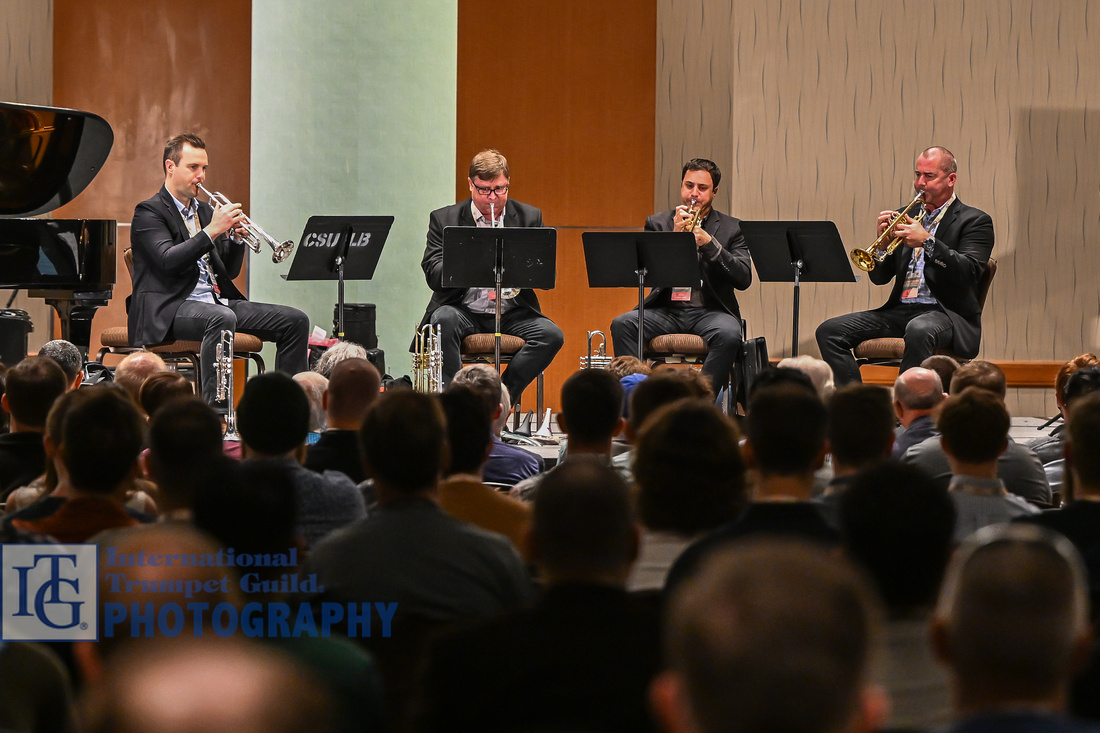
Kana Madarame recital
Performing in her first ITG Conference, Kana Madarame displayed a clear and smooth sound while conveying a truly musical performance. The opening piece by Masamicz Amano consisted of musical characters that were brought to life by her playing and collaboration with Hickman. Madarame established a kind and inviting rapport with the audience, creating a peaceful setting for a beautiful display of music. Fukushima’s Interlude began with a meditative character and showed a velvety side of her sound. Nishizawa’s Sonata is cast in three movements with interjection of ornamentation in the first and last movements. The second movement is a contrasting lyrical passage that continued to highlight Madarame’s musical expression. A return of celebration and playfulness came with the segue into the third movement. “The Garden of Mtio,” a world premier, is a reflective piece inspired by the city of Mito, which is Anaheim’s sister city in Japan. (Will Koehler )
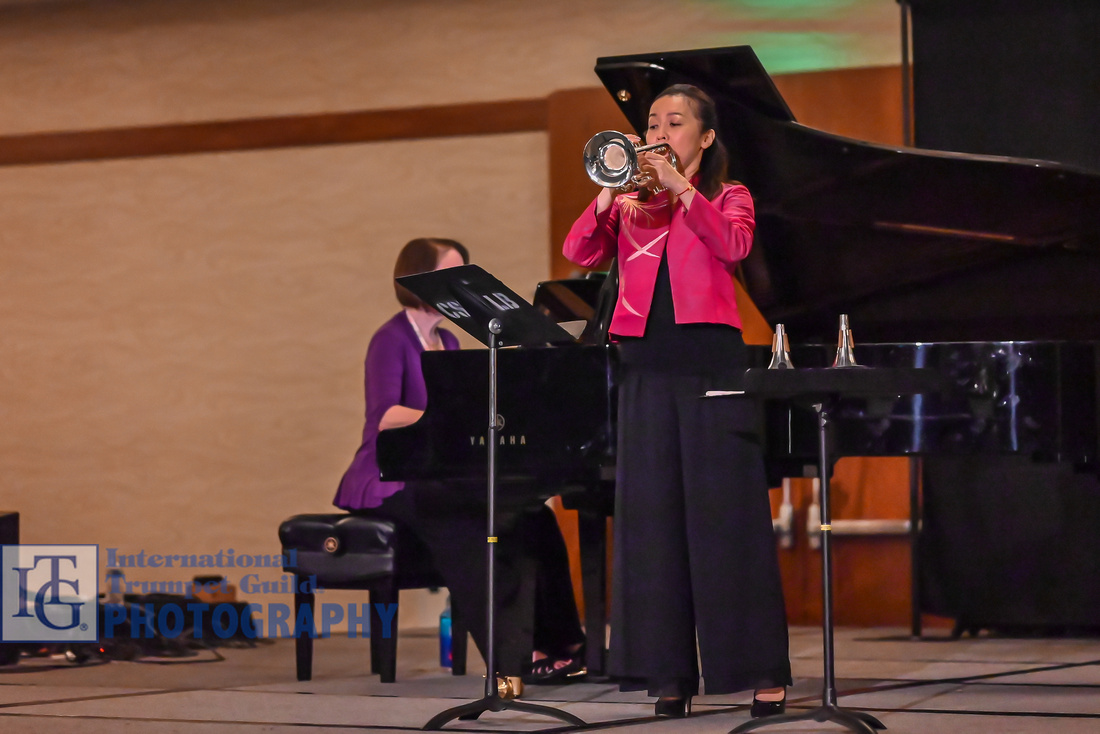
Research Room Presentations
The Research Room Presentations unveiled new and exciting research to the trumpet community. The series kicked off with Allison McSwain’s in-depth exploration of Robert Starer’s solo trumpet compositions, providing attendees with a comprehensive overview of his three works for trumpet. Juan Luis de la Torre Moral delivered a cutting-edge presentation on the influence of the mouthpiece “gap,” offering fresh insights into its effects on the instrument's sound production. Rebecca Wertenberger shifted the focus to the orchestral realm with her presentation, “Re-Examining the Relevance of Orchestral Trumpet Excerpts,” advocating for the inclusion of contemporary literature in audition repertoire. The session concluded with Marcos Jose Ferreira Rodrigues’s study, which centered on studies for trumpet derived from Dobrados. This research will result in a method book tailored to student musicians, highlighting Brazilian march tunes. For more information from the session, please visit the Research Room website (http://trumpetguild.org/resources/research-room). (Benjamin Dubbert)
2023 Carmine Caruso Winner Concert - Noah Halpern
Kicking off this recital was the Loyola University Trumpet Ensemble from New Orleans, Louisiana, who delivered a lively and electrifying performance of two highly involved compositions by Erik Morales, “Cityscapes” and “Divertimento in Blue.”
The Divertimento created a seamless transition into the musical journey through the music of Noah Halpern, the winner of the 2023 Carmine Caruso Jazz Competition. Approaching the stage with swagger and ease, Halpern instantly had the attention of the many trumpet enthusiasts in attendance. His compositions covered a wide range of styles, each with their own unique backstory and inspiration. From intricate lines and driving rhythms to dazzling ornamentation and lush vibrato, Halpern had the audience wrapped around his finger. The burning rhythm section heightened the experience even further, taking Halpern’s compositions to another level. Exhibiting a heart full of gratitude and thanksgiving, Halpern could not be more deserving of this prestigious title. (Peter Nionakis)
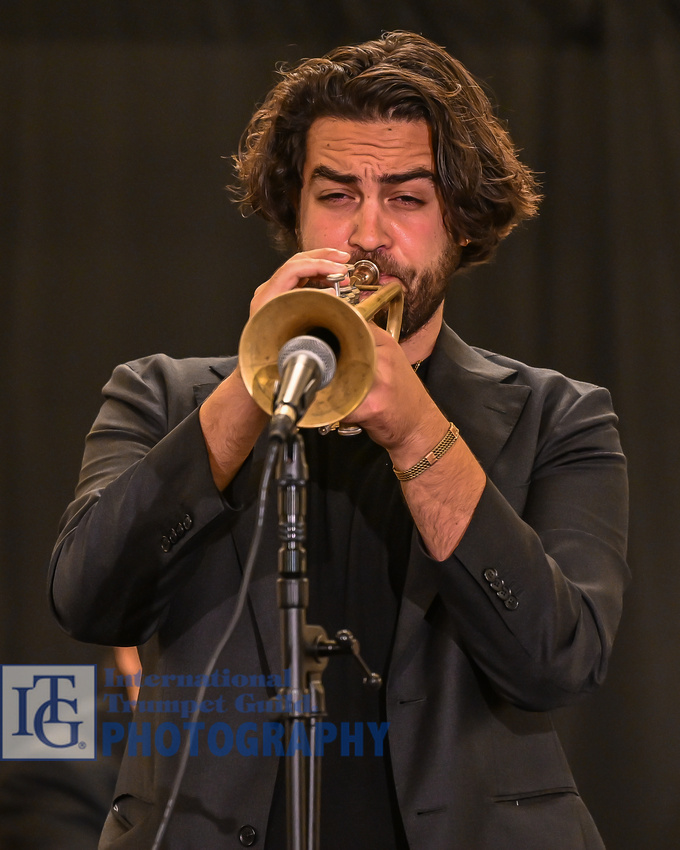
Chamber Competition Finals
Thursday afternoon began with the final round of the Chamber Music division of The Ryan Anthony Memorial Trumpet Competition. The first contestants, the Fresno State Trumpet Ensemble, opened with a great performance of Kevin McKee’s “Into the Blue,” showcasing the highly technical and musical elements of the piece. The second finalists were the Baylor Gold Trumpet Ensemble, performing an arrangement of the music of Ernest Williams with wonderful balance, blend, character, and joy. The final contestants were the North Atlantic Brass, a brass quintet from the Royal Danish Academy of Music. They performed works by Anthony Plog and Vagn Holmboe, highlighting their strengths both as strong individual soloists and as a cohesive ensemble in both technical and lyrical settings. All the finalists set a high bar for great chamber music performance and artistry. (Flint Angeroth Franks)
Tribute to Tom Stevens
With Edward Carroll, Hakan Hardenberger, Anthony Plog, Mario Guarneri, Tom Dambly, Dan Rosenboom, Aaron Smith, Steph Richards, Bob Malone, and Clement Saunier
The panel agreed that Tom Stevens hated the idea of a tribute, but the purpose of the session was to inform younger generations of his legacy. Each panelist began by reminiscing about how they first met Tom. These stories showed several sides of Stevens, including his generosity and the approach of ears over eyes. His fondness for jazz was also emphasized, which was capped by a beautiful rendition of “My Funny Valentine” by Hakan Hardenberger at the end of the presentation. Stevens had a clear ability to see in other people things that they had not yet realized. “Tom had a way of taking you to the top of the mountain to places you didn’t know you could reach.” The session continued with two musical tributes: a breathtaking performance of “Sequenza X” by Berio, performed by Clément Saunier, and a sparkling performance of “Triangles One.” (Will Koehler )
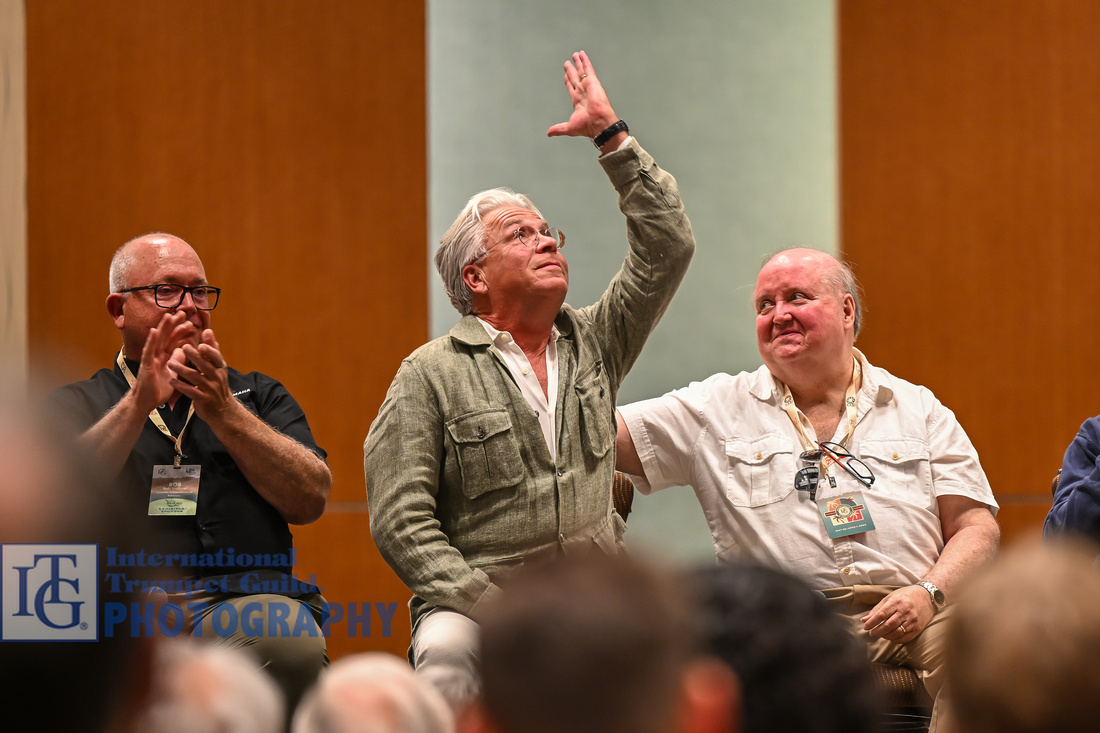
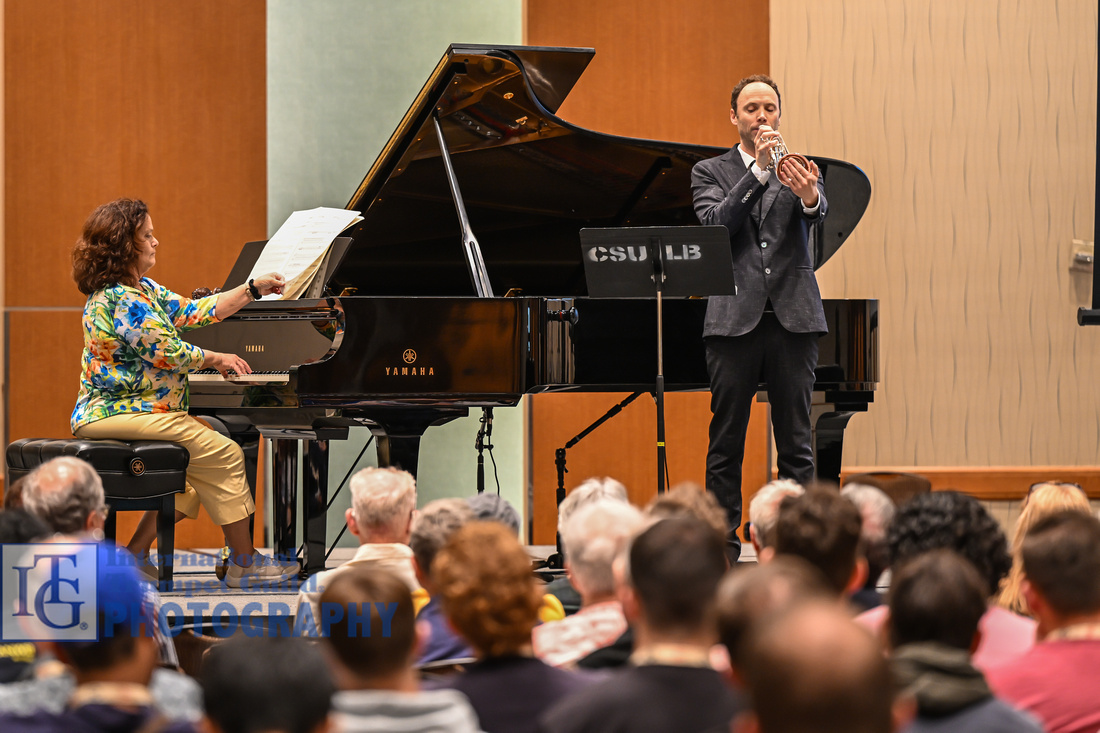
Jazz Improvisation Competition Finals
The final round of this year’s Jazz Improvisation division of The Ryan Anthony Memorial Trumpet Competition was riveting from start to finish. The competition was coordinated by Dr. George Carpten IV, and the judging panel included Bria Skonberg, Noah Halpern, and Vince DiMartino. The first competitor was Aaron Ouellette, who began his set on flugelhorn, playing tuneful solos on “Like Someone in Love.” He then performed “Dolphin Dance” and ended his set with a short, yet flashy, cadenza that led into “We See.” The second competitor was Kellin Hanas, who began her set with “Dolphin Dance” and then contrasted that tune with the incredibly bluesy “When It’s Sleepy Time Down South.” Her set ended with an original tune, “Here I Am,” which featured intricate rhythmic interplay with the rhythm section. The final competitor was Kyle Pogline, who began his set unaccompanied before moving into the head of “Star Eyes.” He used a cadenza at the end of the first tune to transition seamlessly into “Dolphin Dance” and then ended his set with “I’ll Remember April.” All the finalists demonstrated a very high level of creativity and musicality in all aspects of playing throughout their sets. (Spencer Brand)
Allen Vizzutti Recital
The trumpet ensemble from Duquesne University played an exciting rendition of Erik Morales’s “Conquest” to open the afternoon recital in a ballroom with a standing-room-only crowd. Although Vizzutti’s recital included blazing tempos, enormous intervals, rapid multiple tonguing, and other advanced techniques, the true highlight was Vizzutti’s artistry and compositional prowess. Collaborating with pianist Laura Vizzutti (his wife) and violinist Gabriella Vizzutti (his daughter), he gave the audience a thoughtfully curated recital of all original compositions. “Brum Zoom,” a piece composed for Fabio Brum, incorporated sweeping melodies and extended harmonies and ended with a climactic cadenza. “Aurora Borealis” was composed of quartal harmonies depicting the colors of the vast night sky, including percussion and twinkling in the piano’s upper register. “Luciernaga,” the Spanish word for “firefly,” was an exciting bolero. Sonata IV, a three-movement work, showed the sound of a playful, sensitive American master composer. “Love and Tears for Ukraine” is a gorgeous and moving tribute that Vizzutti premiered with the Dallas Symphony. “Stars Drifting By” is a fun piece for trumpet and electronics featuring a sonic time-warp, traversing from psychedelic to funky-groovy. Throughout the recital, Vizzutti honored his wife, Laura, of 37 years, as well as his daughter, Gabriella, who played percussion and violin on various works. On the final composition, a minor blues entitled “Laura’s Blues,” they were joined by Vincent DiMartino, and their long friendship and mutual admiration were an inspiration to all in attendance. (Nick Volz)
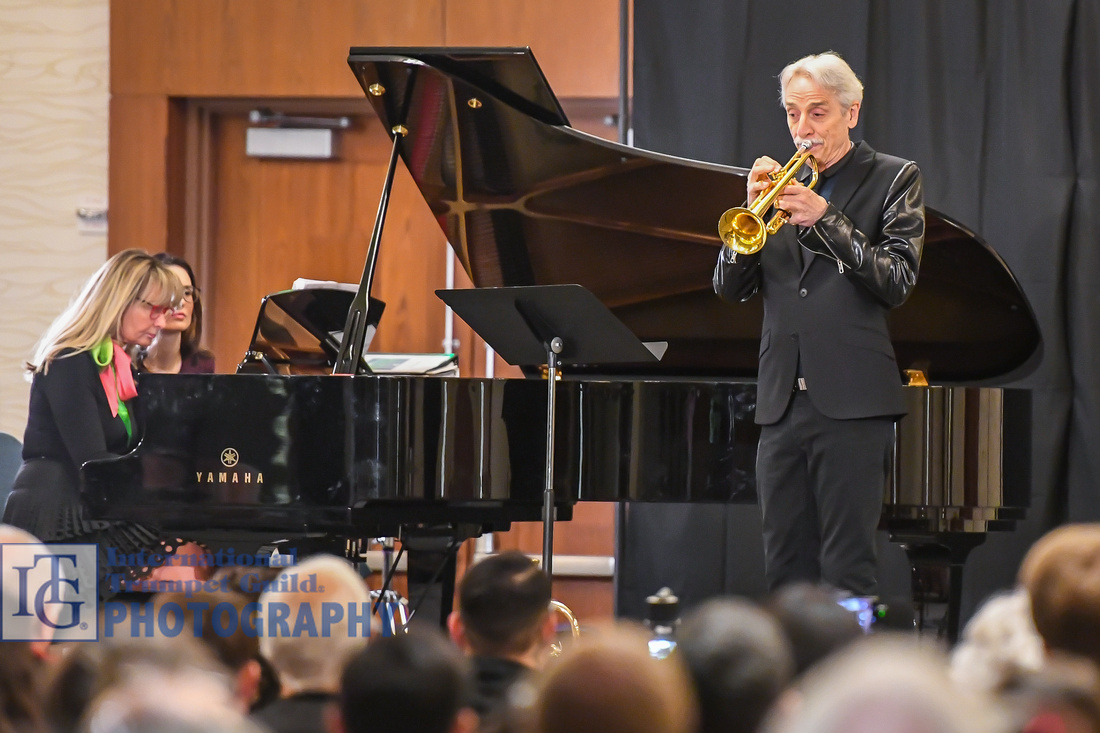
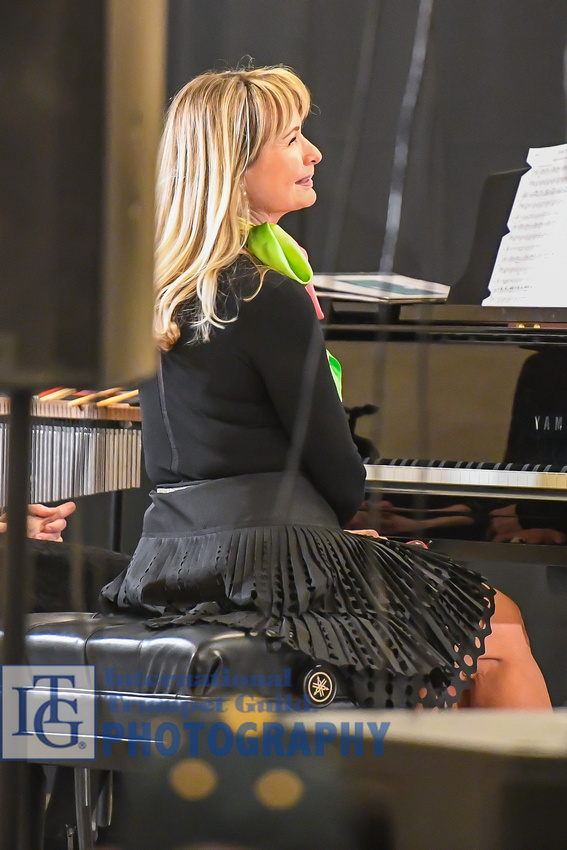

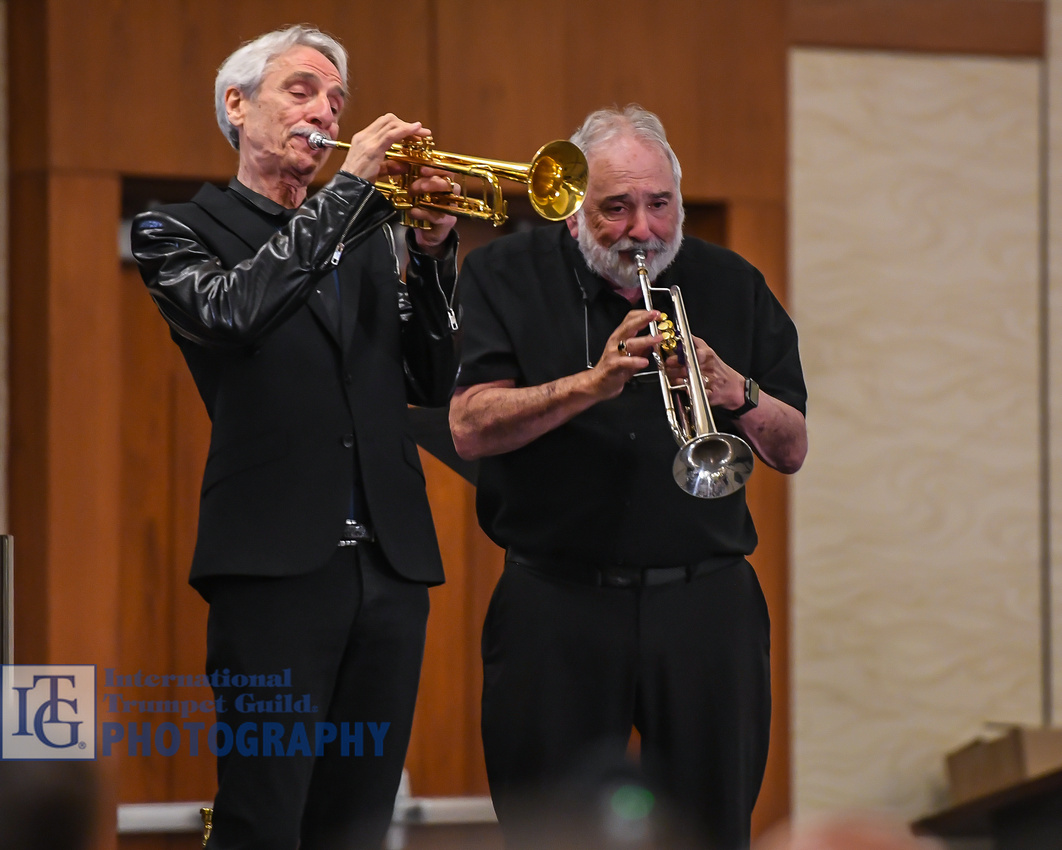
Evening Concert - Chief Xian aTunde Adjuah
The trumpet ensemble from Arkansas State University opened Thursday evening’s headliner concert with Eric Morales’s “X1.” The five trumpet players filled the hall with brilliant sounds, warming up the audience well for the excitement to follow.
The evening then proceeded with the announcements of the winners of two divisions of The 2024 ITG Ryan Anthony Memorial Trumpet Competition. George Carpten, IV, announced the winners of the Jazz Improvisation division. Third-place honors were awarded to Aaron Ouellette; Kyle Pogline placed second; and Kellin Hanas won the first prize. Marc Reed then announced the winners of the Chamber Music division. Second place was awarded to the Fresno State Trumpet Ensemble, and the North Atlantic Brass Quintet and the Baylor Gold Trumpet Ensemble tied for first place.


ITG President Ryan Gardner then announced the featured artist for the evening concert - Chief Xian aTunde Adjuah. The ensemble opened the concert with a powerful rock fusion song entitled “Bark Out Thunder Roar Out Lightening.” This piece featured Chief Adjuah on vocals and his self-developed double-sided electric harp, called the “Adjuah Bow.” The second piece, “Adrenaline,” also featured Chief on vocals and the Adjuah Bow with a hip-hop-funk-fusion feel, accompanied by a three-piece combo consisting of Ele Howell on drums, Cecil Alexander on electric guitar, and Ryoma Takenaga on electric bass.
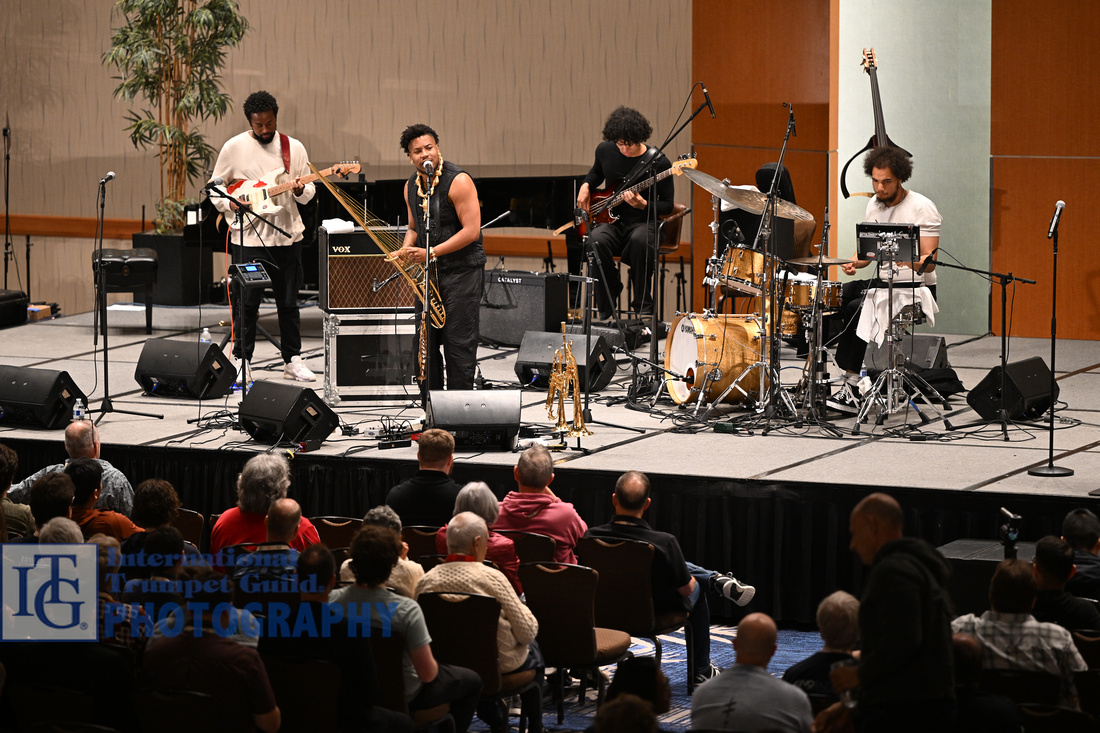

The ensemble proceeded with “I Own the Night,” with a rock-fusion feel. The multi-instrumentalist was then featured on his uniquely designed trumpet, an inverted flugelhorn with shepherd’s crooks, and flute player, Elena Pinderhughes. The ensemble took turns soloing - first a drum solo, followed by Chief on the trumpet, and, lastly, a solo on the electric guitar.

The ensemble changed the pace with a laid-back, soulful groove tune, “Song She Never Heard,” which began with a lyrical duet with Chief on trumpet and Elena Pinderhughes on flute. That was followed by “The Coronation of X. Adjuah,” which began with a hard-rock beat with an urban, raw vibe from the combo. Solos were passed around, with the various members sharing vivid and complex musical ideas. The next piece, “Sunrise in Beijing,” began with a gorgeous solo guitar line, followed by a solo section.
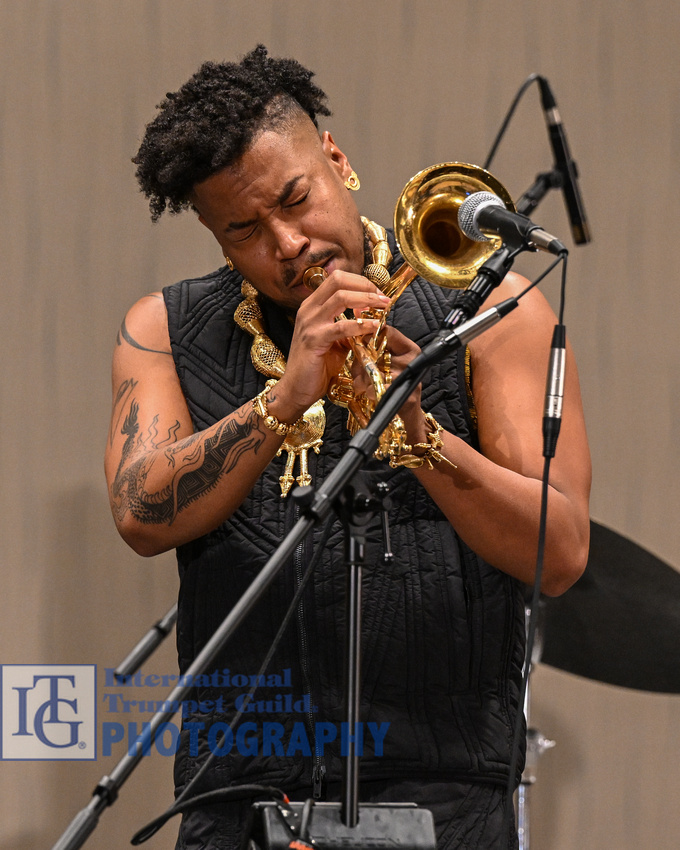
The ensemble concluded the performance with “The Last Chiefdom,” which paid tribute to Chief’s grandfather, Big Chief Donald Harrison Sr., and uncle, Big Chief Donald Harrison Jr. This tune continued the brilliant duet between trumpet and flute, highlighted throughout the night. The song entered with an open solo section, where the members took turns improvising over the rhythm section, and then fell into a half-time groove. Chief successfully showcased his ability to transform the traditional sound and usage of the trumpet with his luscious tone, incorporation of other instruments, and usage of an effects pedal over innovative, passionate melodies of rhythmic and harmonic complexity. (Maryna Pohlman)
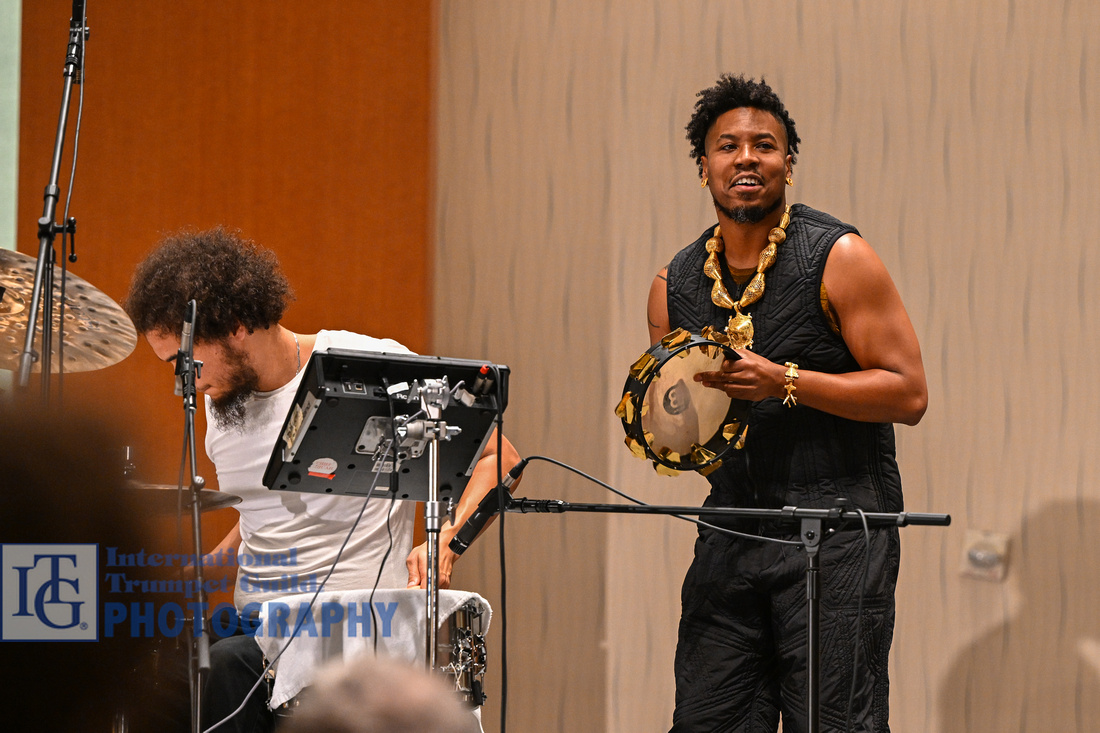
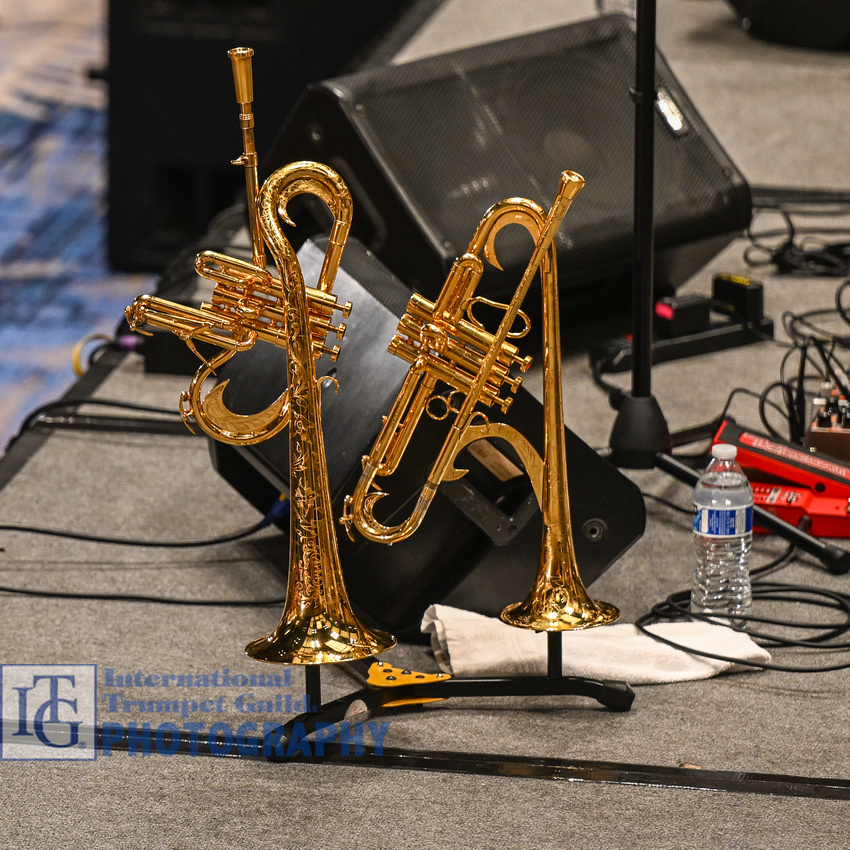 Jam Session with Shawn Williams
Jam Session with Shawn Williams
Thursday night’s jam session, hosted by Shawn Williams, was a great night of sweet sounds and impressive improvisation. Everyone had a chance to play as both youth and professionals alike traded tunes. The event provided a unique opportunity for musicians to connect and share their passion for music. The last tune served as a last call to the performers to leave it all on the table. The vibrant attendees fostered an atmosphere of creativity and collaboration, and the rhythm section deserves a shout-out for their ideas, time, and musicianship throughout this over-two-hour set. (Jacinda Ripley)
Click here for more photos from the ITG Conference
]]>
Spencer Brand is artist/assistant professor of trumpet at McNeese State University. He performs as a member of the Lake Charles Symphony and the Vive Ensemble, a trumpet/clarinet duo.
Joseph Cooper has served various roles for ITG since 2017. He is the trumpet professor at Oklahoma State University.
Stanley Curtis serves as professor of trumpet at Colorado State University in Fort Collins.
Benjamin Dubbert is a doctoral student at Florida State University. He is a freelance musician who also sustains a private studio in the Florida panhandle region.
Flint Angeroth Franks is assistant professor of music (Trumpet and Director of Jazz Ensembles) at Simpson College in Indianola, Iowa.
Scott Hagarty is associate professor of trumpet at Tennessee Tech. He is also principal trumpet of the Bryan Symphony Orchestra and a member of the Brass Arts Quintet.
Daniel Kelly is the Media Reviews column editor for the ITG Journal. He serves as professor of trumpet at Texas A&M University-Commerce.
Angela King is active as a performer and pedagogue and serves on faculty at Texas A&M University - Kingsville. She recently completed the Doctor of Music degree at Florida State University.
Will Koehler is adjunct professor of trumpet at Lone Star College Montgomery and is a founding member of Ionic Brass in Houston, Texas. An active performer, clinician, and writer, he is an advocate for new music and released his premier solo CD, “Mocking Midnight,” in 2018.
Randy Lee is associate professor of trumpet at Brigham Young University and is musical missionary in the Orchestra at Temple Square with the Tabernacle Choir.
Eric Millard is assistant professor of trumpet at UNC Charlotte and plays principal trumpet with the South Carolina Philharmonic. He also serves as Book Reviews column editor for the ITG Journal and the rules coordinator for the National Trumpet Competition.
Joe Nibley is assistant professor of music at Fort Lewis College in Durango, Colorado. He also performs with the San Juan Symphony and enjoys spending time with his wife and dogs.
Peter Nionakis is instructor of trumpet, music theory, and jazz studies at William Carey University in Hattiesburg, Mississippi.
Maryna Pohlman is the news editor, social media coordinator, and on-site exhibits coordinator for the International Trumpet Guild. She is currently working on her doctorate at Indiana University.
Jacy Ripley serves on the trumpet faculty at Saginaw Valley State University and Alma College.
J. Peyden Shelton is associate professor of trumpet and associate director of the School of Music at the University of Utah. He is a Yamaha Performing Artist and Clinician.
Sarah Stoneback is a member of the ITG Board of Directors and chair of the Scholarships competition. She serves as associate professor of trumpet at Montana State University in Bozeman, Montana, and is principal trumpet of the Bozeman Symphony Orchestra.
Nick Volz is associate professor of trumpet and coordinator of instrumental music at Loyola University New Orleans.
Jodi Graham Wood (editorial assistant) is lecturer of music at the University of South Alabama and serves ITG as assistant editor and advertising manager.
Conference Photography Staff
Michael Anderson, head conference photographer and ITG Website director, is professor of trumpet at Oklahoma City University and a member of the Oklahoma City Philharmonic.
Jason Harrelson is a trumpet designer, builder, performer, and clinician living in Denver, Colorado. He enjoys hiking, skiing, and traveling with his wife, Jolene.
Daniel Kelly is the Media Reviews column editor for the ITG Journal. He serves as professor of trumpet at Texas A&M University-Commerce.
Steve Stricker is a semi-professional brass player in the northern Kentucky/Cincinnati area. When not playing music or taking photos, he leads a research and development program of investigational drugs for multiple myeloma.
]]>Special Daily Report • Compiled by Peter Wood
Photos by Daniel Kelly and Michael Anderson
Wednesday, May 29, 2024
Click here for more photos from the ITG Conference
Jonathan Bhatia Warm-Up Session - Rise and Shine with Efficiency
Jonathan Bhatia greeted a room full of early risers to an engaging warm-up session, titled “Rise and Shine with Efficiency.” As Bhatia described his approach to developing a warmup, he stressed the importance of refining the physical efficiencies of playing the trumpet through effective use of the airstream. Noting the significance of the air in all aspects of playing the trumpet, Bhatia led the group through exercises of long tones, breath attacks, flow and flexibility studies, wind patterns, and more. Encouraging participants to focus on the momentum of their airstream, Bhatia moved through more exercises of articulation, technique, and range building to provide a comprehensive routine. Bhatia’s session was a fantastic start to the morning, and his clear descriptions and demonstrations were a valuable tool for everyone involved. (Eric Millard)
Kayla Solomon - Tuning-Up Your Performance Utilizing Strength Exercises
Dr. Kayla Solomon delivered an in-depth and engaging presentation focused on body and mind wellness. Solomon’s positive and inclusive approach drew a nearly packed early-morning session with everyone on their feet participating in stretches and other body relaxation movements. During the session, Solomon was able to resonate with all levels of musicians - specifically the “comeback” players - who did not hesitate to ask questions about Solomon’s findings. Some of the highlights came from audience participation that led to clarification of stretches, movements, and positive mental approaches to playing the trumpet. The fresh perspective on body and mind wellness that Solomon brought to her presentation left the attendees feeling relaxed and eager to implement these ideas in their own practice. (Benjamin Dubbert)
Karl Sievers - The Teachings of William Adam
Karl Sievers, principal trumpet of the Oklahoma City Philharmonic, studied with William Adam for eight years. Sievers’ presentation on Adam’s teaching focused on the power of the mind to control kinesthetic response. Adam’s teaching was sound-centric and allowed players to find freedom. “THE sound” comes from energized breath, freely delivered, with follow-through and musical imagination, allowing the player to be in phase with the trumpet. This results in rejuvenated chops, effortlessness, and great sound, allowing the player to find a state of elevated energy. William Adam worked on the whole individual: personal character and performer. Adam was dedicated to modeling, up to seventy hours a week, focusing on “THE sound” and not on peripheral distractions or the physical and technical parameters of trumpet playing. Sievers recommends carving out your best time of day for practicing and dedicating your freshest mental energies to improvement and aural development. (Joe Cooper)
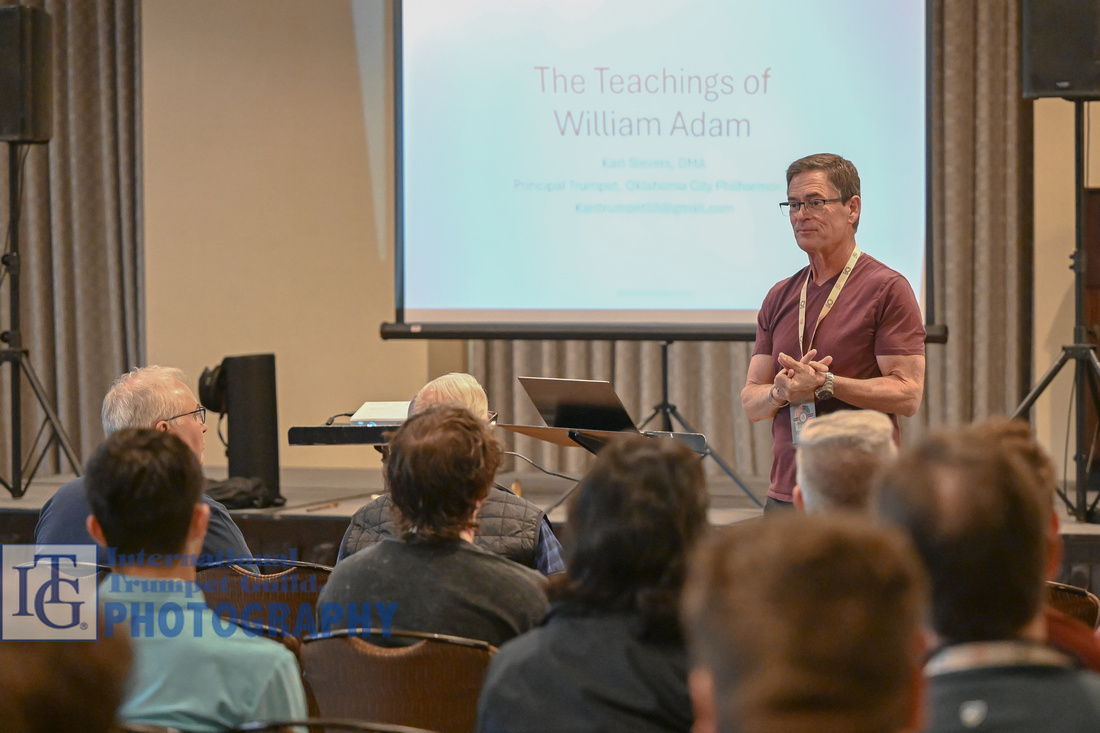
Bruce Whisler - Pharmaceutical Causes for Embouchure Weakness
Dr. Bruce Whisler, music professor at Clemson University, explored some common medicines and foods that might cause embouchure weakness. Basing his talk on his own experience, he relayed his embouchure struggle that affected his trumpet playing and led to his suspicion that cholesterol-lowering statins and aspartame were the culprits. After he stopped using both of these substances, his embouchure began to regain muscle tone and strength, so he recommended more research into how these substances may negatively affect brass players. After his talk, he shared his bibliography of research and took questions from the audience. (Stanley Curtis)
Nancy Taylor - Healthy Chops: The Science Behind Why Our Chops Behave as They Do and Evidence-Based Practices for Chop Management
Trumpeters attending Nancy Taylor’s session received valuable, applicable information on how to gain endurance, foster longevity in one’s career, and have a more reliable experience on the trumpet by exploring the balanced embouchure. Backed by a degree in occupational therapy, Taylor provided participants with exercises and information to help tackle one of the more challenging aspects of playing the trumpet – inflammation due to, for example, excessive pressure and hormonal fluctuation. She shared that we need the inflammation that occurs, which was a clear discovery moment for the trumpeters present. Advil, as it turns out, interrupts the swelling process, which is not good for muscle tissue recovery. So, what can we do to assist in the process of tissue swelling recovery? Long tones! Participants left with a newfound freedom of what they might do to assist in achieving healthier chops. (Sarah Stoneback)
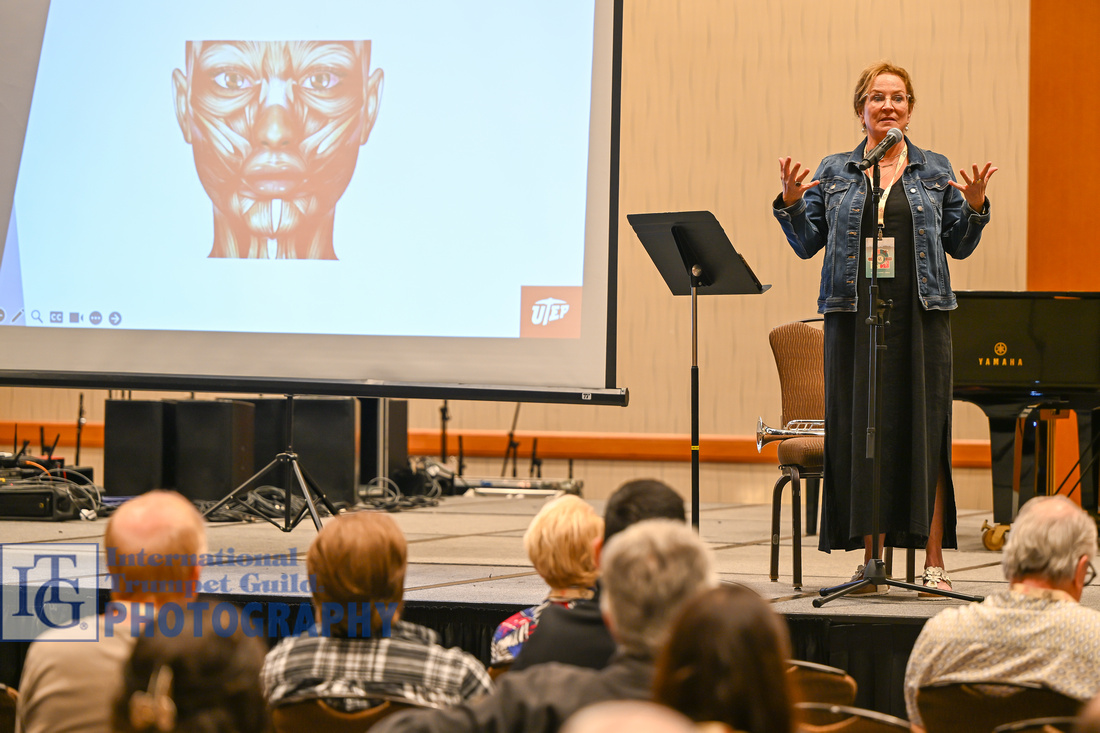
Adán Delgado Recital
Showcasing Spanish music for trumpet and piano, Adán Delgado and Miriam Hickman created a beautiful and thoughtfully well-crafted program with a variety of composers and styles that allowed him to fully display his singing sound. Ricardo Mollá’s “Metamorphosis” opened the program with an ethereal, misty texture that segued to full musical landscapes highlighting both performers. Javier Martínez’s “Go for it” was full of dance-like motifs and lyrical melodies that were traded between performers and continued to showcase the musical sensitivity of the duo. Written for the great Maurice André, Salvador Chulia’s Adagio was a gorgeous display of lyricism. The remainder of the recital consisted of a variety of compositions from film music by Juan Zapata to familiar melodies by Manuel de Falla. Delgado was joined by José Sibaja for Astor Piazzola’s “Milonga del Ángel,” in addition to Neeme Ots for Rafael Méndez’s arrangement of the trio “The Brave Matador,” the recital ended with an exciting flair and celebration of Spanish music. The entire recital featured a wide variety of tone colors from Delgado, all with the same golden, resonant core. (Will Koehler)

Jeff Bunnell - Trumpet Arranging Unleashed: The Secrets behind the LA Trumpet Ensemble CD Homage
This presentation, hosted by Jeff Bunnell, was an energetic and educational session that featured the Los Angeles Trumpet Ensemble’s CD, “Homage.” As attendees listened and followed along with the scores displayed on the screen, Bunnell provided narrations to cover the tools used to bring his arrangements to life. The magic of this class unfolded when questions started to fly after each recording was played, which turned into a miniature discussion each time. The music covered included some familiar film music such as the theme from “Superman” and “Silverado,” along with such refreshed jazz standards as “Joy Spring” and “Give It One.” Bunnell left his attendees with a new palette of ideas and tools, along with endless possibilities, with which to experiment. (Benjamin Dubbert)
Wind Band Excerpts Competition Finals
The Terrace Ballroom was filled with a supportive audience for the final round of the Wind Band Excerpts division of The Ryan Anthony Memorial Trumpet Competition. The demanding repertoire list was a true test of technique, endurance, and musical expression. The three exceptional finalists were Mason Stokes from Baylor University, Nathan Coffman from Duquesne University, and Johniel Najera from Baylor University. The list included standard excerpts like Gershwin’s “American in Paris” and John Williams’s “Summon the Heroes,” as well as band staples like Sousa’s “Hands Across the Sea” and Persichetti’s “Divertimento for Band.” Each performer delivered their own interpretation of Taps and were able to showcase their virtuosity on Herbert L. Clarke’s “The Debutante.” All three finalists played with great poise, conviction, and musicality. (Nick Volz)
New Works Recital #1
The first New Works Recital of the Conference featured ten works. The recital opened with Jack Ballard’s “Cannon Father” for three trumpets (wonderfully played by Joey Tartell, Brian Walker, and Chloe Swindler). The imitative three movements were inspired by fatherhood. Daniel Kelly (trumpet) and Libby Vanatta (piano) performed Alan Theisen’s “Streets of Scarlet and Shadow.” This dramatic work, inspired by film noir soundtracks, was underpinned by Kelly’s graceful and brilliant playing.
Anne McNamara performed with great panache Logan Larson’s “Electric Thunder Dunk” for solo trumpet accompanied by an upbeat, electronic, fixed-media recording. The fourth piece on the program, Catherine McMichael’s “Maravillas de la Patagonia,” was sensitively performed by the Sapphire Brass (John Kilgore, trumpet; Eric Millard, bass trumpet; Katey Halbert, horn; and the composer on piano). This three-movement piece, inspired by the landscape of Patagonia, featured strong melodies with frequent counterpoint and piano figuration (as well as a brief recitation in the last movement by John Kilgore).
ITG board member Nadje Noordhuis performed Stephen Montalvo’s “Innovations 2,” a piece for solo trumpet and electronic effects. Noordhuis adeptly handled the demanding effects controls with her left hand while playing wonderfully, holding the trumpet with only her right hand. Vincent Reed wrote “Voyage of Gold” for trumpet ensemble (the first movement of a larger work called “Salt of the Sea”). Reed performed his work with Ellie Lundy, Kate Marcino, and Bentley Lankford (all students from Lipscomb University).
Trumpeter Amanda Ross played Remi Inari’s twelve-tone “Did you see the Dragon?” This piece starts with just a few notes, slowly adding additional tones as it progresses. Based on a Japanese short story, this unaccompanied work at times requires the performer to play multiphonics and use half-valve techniques to imitate the sound of a dragon. Matthew Howell’s “(un?)Fairly Ambiguous,” performed by Joseph Cooper on trumpet and John Salinas on alto saxophone, starts with slow drones and then progresses to various types of interruptions.
Trumpeter Sidney Shuler and his wife, clarinetist Pamela Shuler, commissioned the next piece, “Concoction,” for the 2023 ClarinetFest. Composer Franklin Piland found inspiration for this work from different types of black coffee. Pianist Kayla Liechty joined them in playing the first, third, and fifth movements (“black,” “espresso,” and “americano,” respectively). The last work on this recital, Evan Zegiel’s “Omen” for trumpet and fixed-media, was thrillingly played by trumpeter David Hall, who deftly handled the significant range, articulation, and technical demands of the piece, all the material of which was characteristic of heavy metal music. (Stanley Curtis)
Javier Gonzalez and K.O. Skinsnes - Connecting Extreme Range Through Modern Equipment and Innovative Techniques
Following the Eastern Michigan University Trumpet Ensemble’s incredible performance of Erik Morales’s “X1,” Javier Gonzalez and K.O. Skinsnes presented a detailed presentation on how to improve playing efficiency through studying acoustics and incorporating innovative practice routines. Skinsnes first addressed how the science of “relative intonation” and the use of “appropriate damping” can improve a player’s efficiency on their equipment. He further explained that modifying the trumpet/mouthpiece design and adjusting the damping creates a fuller sound that is more consistent, in tune, and efficient. Then, Gonzalez talked about his experience at Cal Arts, studying world music styles, and explained how it revolutionized his approach to leadpipe buzzing. His approach shifted to “muscle activation” and using the oral cavity to manipulate the pitch on the leadpipe, creating a fluid sound from pedal C to triple high C. This session was both enlightening and inspiring to all in attendance to explore new ways of improving their range on the trumpet. (Spencer Brand)
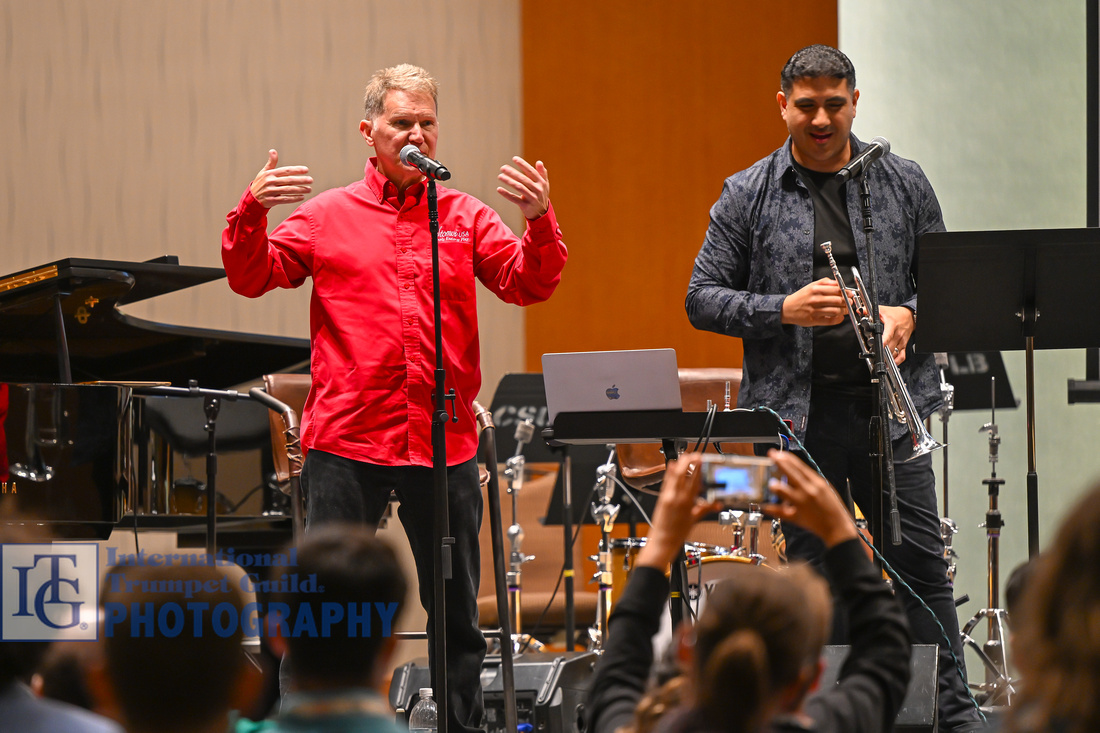
Niki Anthony, Wayne Bergeron, Vince DiMartino, Brian Walker, and Rebecca Wilt - Unstoppable You: Navigating Adversity with Grit
Following a joyous rendition of Joseph Price’s “Westward Ho!” by the Southern Utah University trumpet ensemble, Rebecca Wilt gave a brief introduction while adding some comedic relief to help with the transition. She then introduced the panel of speakers, including Vince DiMartino, Brian Walker, Wayne Bergeron, and Niki Anthony, to discuss the many challenges of dealing with major illness. Rebecca, Vince, Brian, and Wayne took turns sharing their own experiences while battling cancer and how it impacted their way of life and shifted their perspective to live in the present. Niki Anthony shared her outlook and advice as a caretaker and spouse to Ryan when he was battling multiple myeloma - lean into your inner stubbornness; denial can be your friend; be a good person; and set your path and have your desires because life will always have its changes, so be willing to start over. (Peter Nionakis)
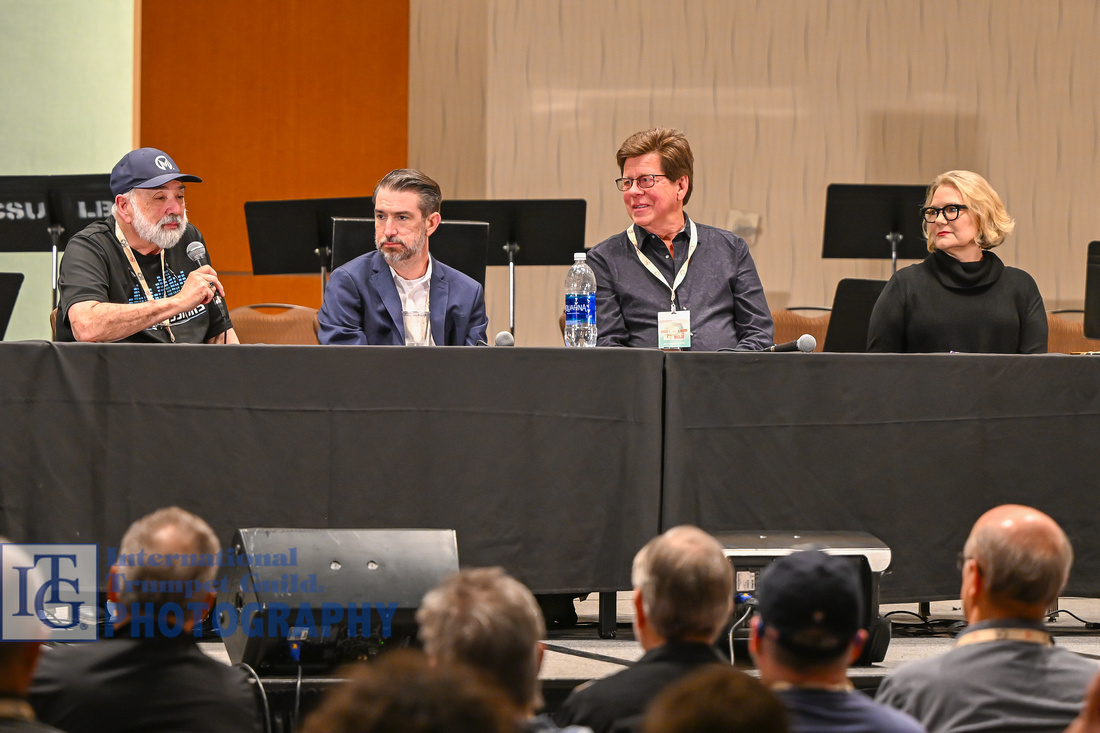
Orchestral Excerpts Competition Finals
The Orchestral Excerpts division of The Ryan Anthony Memorial Trumpet Competition was a display of great musicianship and preparation by finalists Chase Domke, Adam Warnke, and Xunji Yang. The three trumpeters performed seven excerpts from a list that contained Williams’s “Summon the Heroes,” Ravel’s Piano Concerto, Schumann’s Symphony No. 2, Bizet’s “Carmen,” Rimsky-Korsakov’s “Scheherazade,” Hailstork’s “An American Fanfare,” and Bartok’s Concerto for Orchestra. Xunji Yang was the first competitor and performed the list with great sound and vibrancy in every register and at every dynamic. Chase Domke showcased his beautiful tone and clear articulation. Adam Warnke was the last performer and demonstrated a gorgeous sound and ease of playing through both technical and lyrical passages. Afterwards, the judging panel held a short masterclass on the challenges of taking orchestra auditions and gave each competitor feedback on their performance. The jury was composed of Christopher Smith of the San Diego Symphony; Adán Delgado of the National Orchestra of Spain; and Merrie Klazek, former principal trumpet of the Thunder Bay Symphony. (Flint Angeroth Franks)
Huw Morgan Recital
An enthusiastic audience was on hand for the recital presented by Huw Morgan and Rebecca Wilt. The performance opened with a spirited performance of Verne Reynolds’ “Suite for Five Trumpets” by the University of Southern Mississippi Trumpet Ensemble. Morgan and Wilt then took the stage for a program of works by American composers and composers with strong ties to American music. The “American-born” selections included Rouse’s “The Avatar” and Alexius’s “Sonatina,” while the bulk of the program featured Ibert’s Impromptu, “Marietta’s Lied” from Korngold’s opera “Die Tote Stadt,” and Nadia Boulanger’s “Cantique.” Morgan took a moment to talk about each selection and its tie to American music. The program concluded with a collection of what Morgan called “only the popular numbers” from Stravinsky’s “Pulcinella,” followed by an encore, Sondheim’s “Send in the Clowns.” Morgan’s silky sound, beautiful phrasing, and impeccable intonation were on full display on flugelhorn and piccolo, C, B-flat, and E-flat trumpets. (Daniel Kelly)
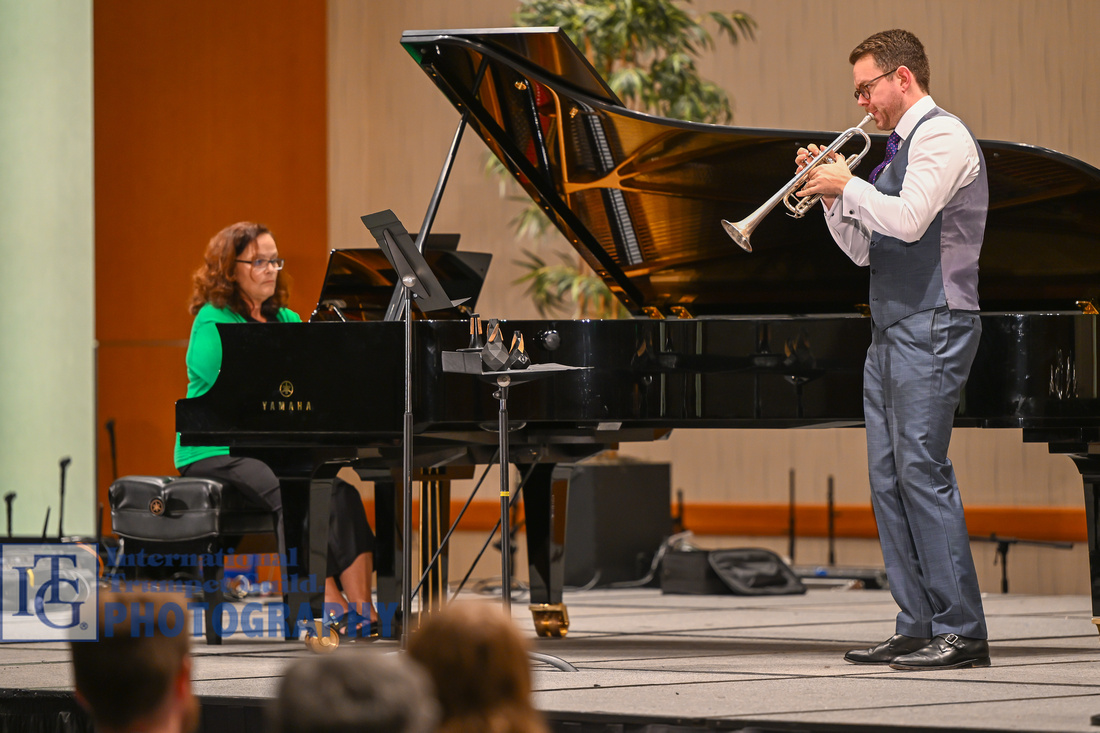
Evening Concert - Los Angeles Brass
With Jens Lindemann, Vincent DiMartino, Bria Skonberg, Rex Richardson, Steve Cunningham, and Jose Sibaja
The second evening concert of the Conference was a brass bonanza, starting with the North Atlantic Brass from Denmark's Royal Academy of Music. The quintet performed movements of Anthony Plog’s “Four Sketches,” Tielman Susato’s “Dance Suite,” and Thorvald Hansen’s Quintet with impressive technique and style.
In his characteristically “understated” style, Jens Lindemann took the stage to introduce the Los Angeles Brass, a sixteen-piece brass ensemble and rhythm section composed of top players from the LA area. The opening number, from Michael Kamen’s score to “Robin Hood,” set the tone for the evening, though it turned out to be the most classically oriented chart of the concert.
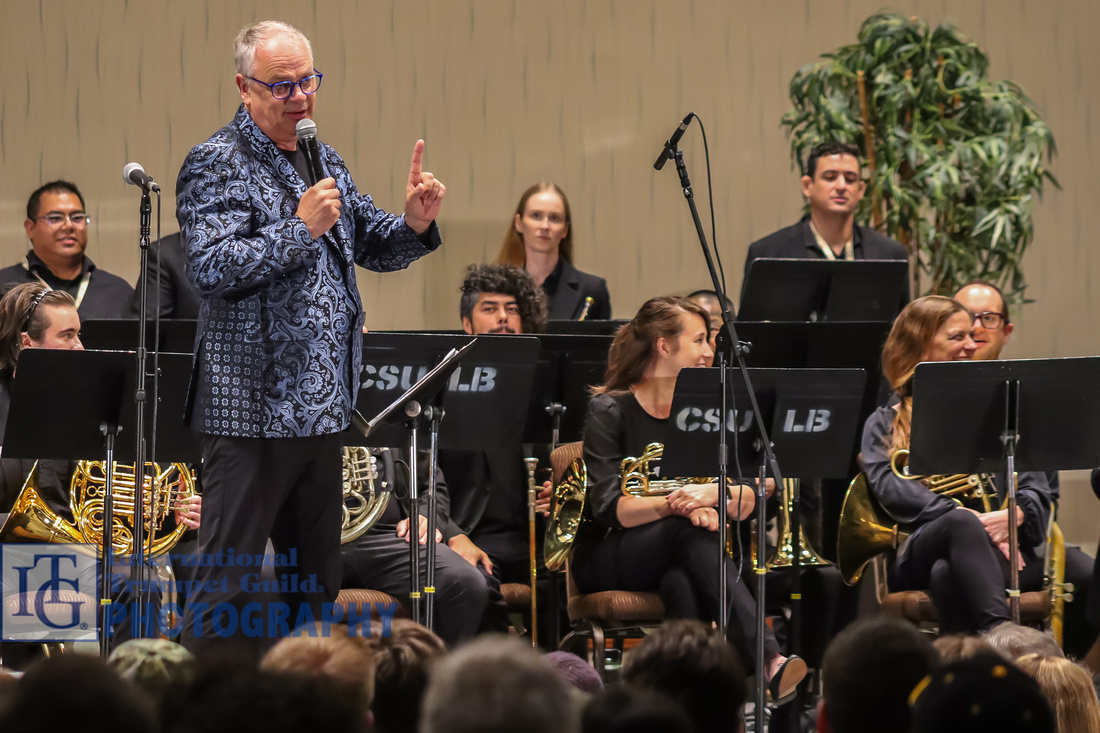

The ensemble was joined by Vince DiMartino, who took solo honors on Doc Severinson’s version of “Georgia on My Mind,” on which DiMartino’s sound, improvisational skills, and range were on full display. Bria Skonberg joined the group for an original ballad on which she played and took on the vocals with an abundance of cool style. The front line grew when Skonberg was joined by DiMartino, Rex Richardson, and Steven Cunningham for Skonberg’s take on a New Orleans second-line-style tune on which everyone took solo space, traded fours, and generally dressed to impress.
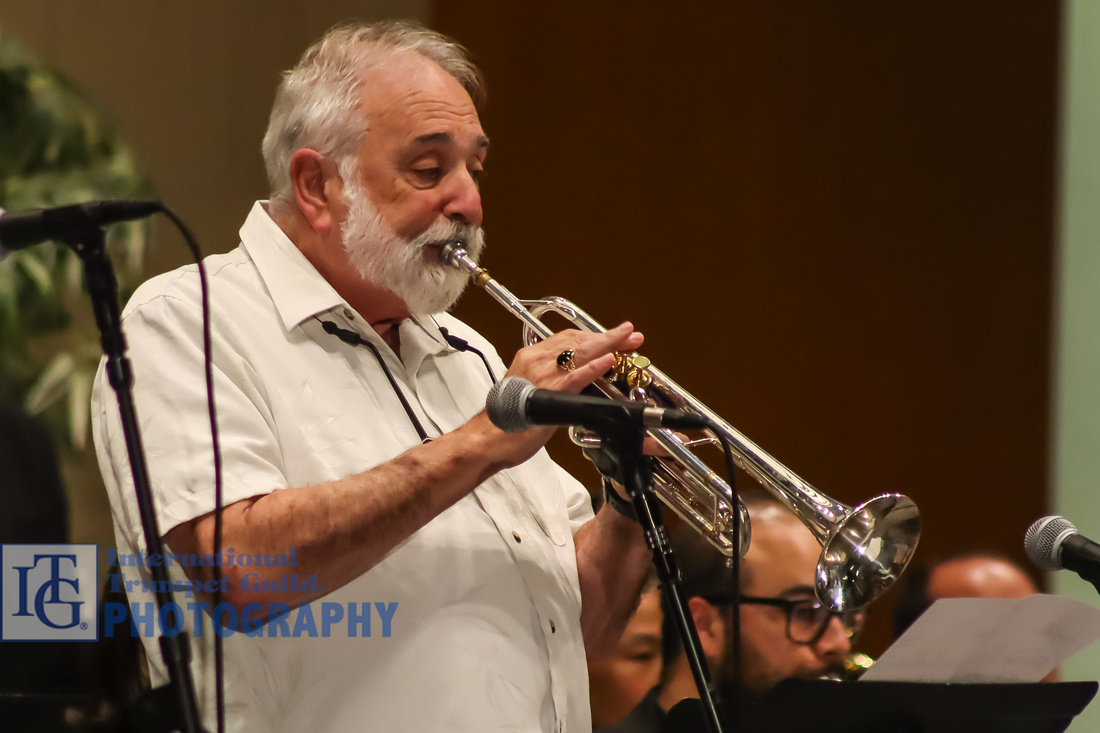
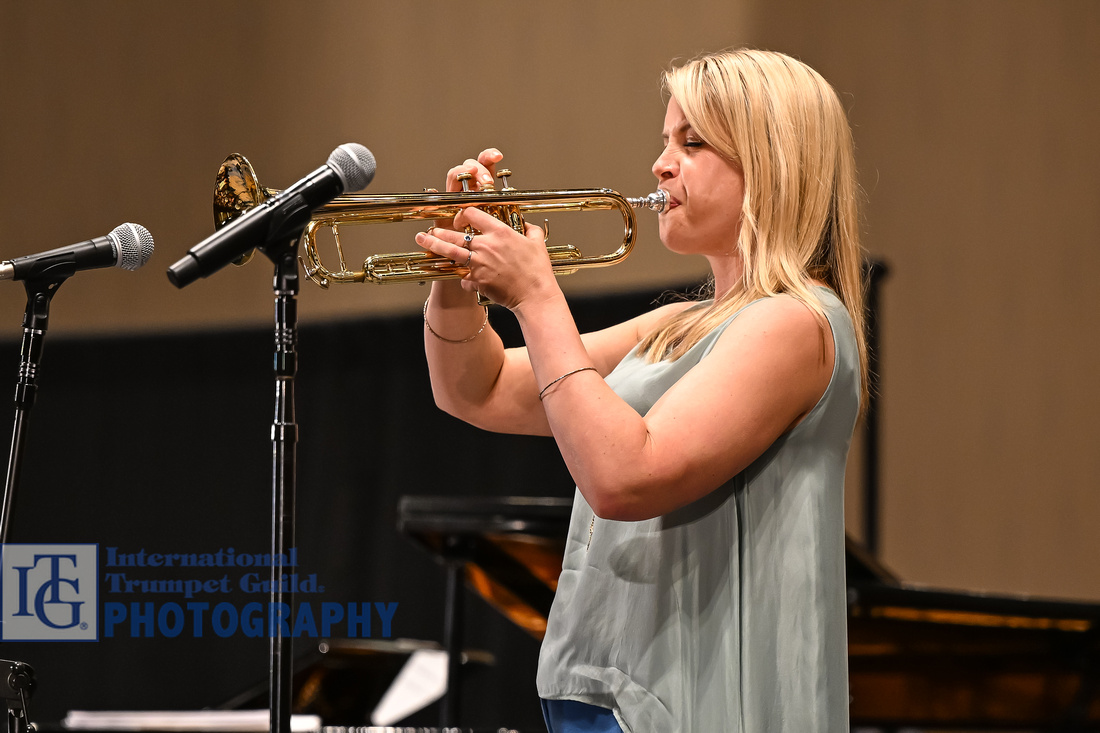
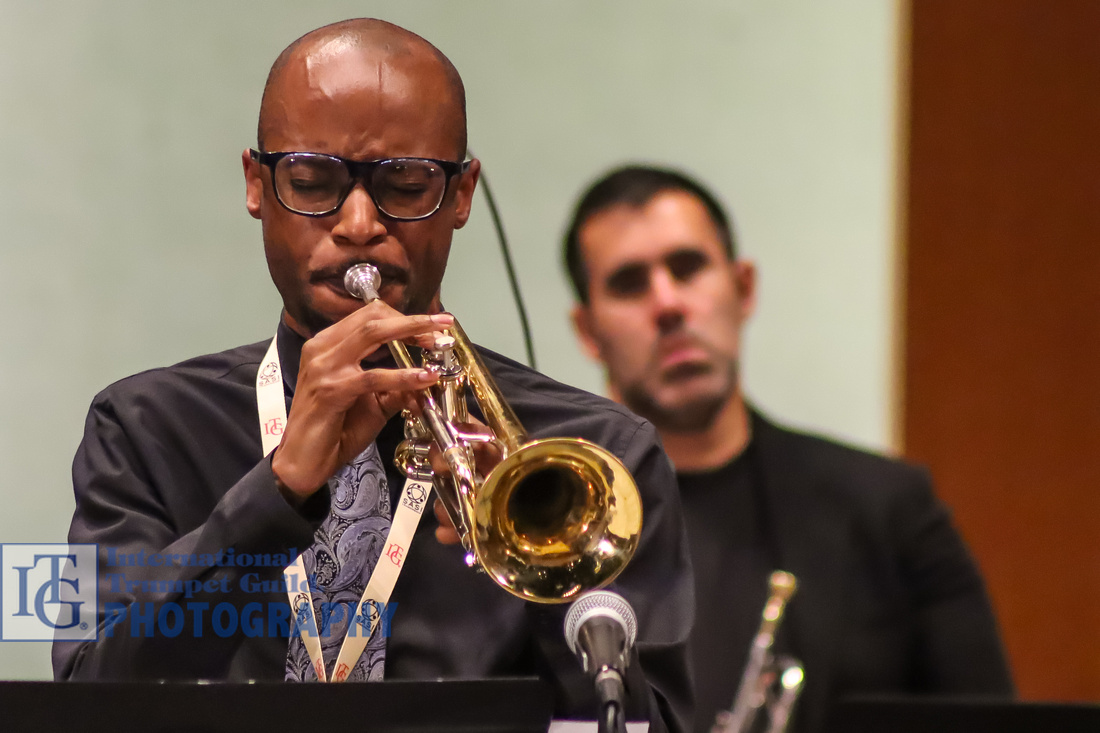
Lindemann traded his conducting duties for the solo spotlight on two movements of Allan Gilliland’s "Dreaming of the Masters III," a tribute to the trumpet’s contributions to pop, jazz, and Latin music. Lindemann explained that he premiered the piece with the Edmonton Symphony in 2010 and that it is also available for wind ensemble, big band, and brass ensemble. This brass ensemble version – and Lindemann’s performance – was certainly impressive and very well received.

Jose Sibaja and Rex Richardson performed "Caravan," a signature tune of the Boston Brass, because, as Lindemann joked, Jose was “too lazy to learn something new.” The duo ripped the room, for sure. Skonberg, Cunningham, and DiMartino joined Richardson to keep the Ellington vibe going with Don’t Mean a Thing, with Skonberg also tackling vocals, leading the audience participation scat singing, and showing her vocal chops on what appeared to be an unrehearsed vocal cadenza of high notes – always a crowd favorite. Lindemann and Sibaja joined the quartet for the final number, Peter Meechan’s "Song for Hope," to honor the life and legacy of the beloved Ryan Anthony. The Los Angeles Brass were fantastic in all styles, of course, and the concert was an exciting, non-stop celebration of brass attitude. (Daniel Kelly)
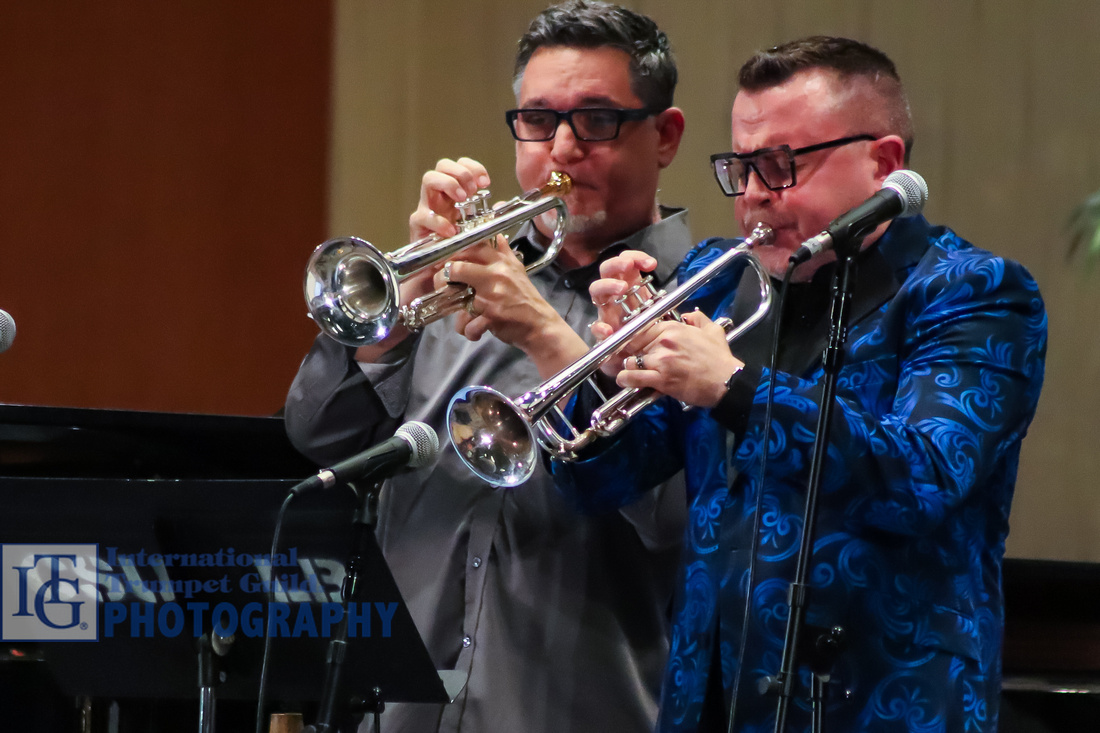
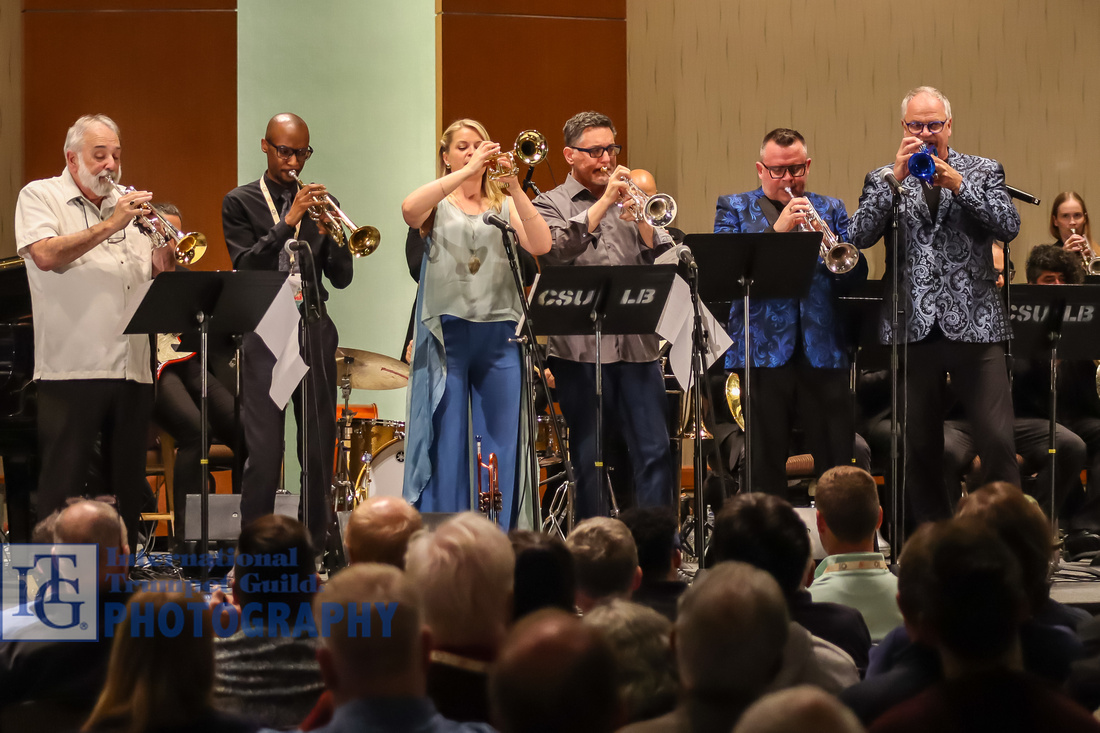
Jam session with Brad Goode
Brad Goode, associate professor of jazz studies at University of Colorado Boulder, hosted Thursday evening’s jam session. Creating a work-class experience, participants had the pleasure of collaborating with the conference jazz trio, who had just completed the preceding concert. The jam sessions provide an opportunity for participants to share their playing with other attendees, and this particular session allowed participants to play along with conference artist Brian Lynch. Goode emphasized creating a healthy environment for all participants, insisting that each soloist play only two choruses to accommodate everyone who wanted to play. Requested first was “Foot Prints,” a Wayne Shorter standard. Other requests included “Up Jumped Spring,” “I’ll Remember April,” “Black Orpheus,” and “Birks’ Works.” One of the most interesting and unique aspects of these sessions is being able to see the wide range of players - from high school students to active-duty military and seasoned professionals - joining together to celebrate the music they love. (Will Koehler )
“Song For Hope” Documentary Screening
Wednesday night’s screening of the film “Song for Hope” served as a powerful tribute to Ryan Anthony, an amazing man whose life was dedicated to his family and the art of music. The documentary immersed viewers in Ryan’s journey, showcasing his numerous triumphs and setbacks, from his profound connections with loved ones to the global community he fostered through music. Some of the highlights of the film were the touching depictions of his dedication to his family, the deep friendships he cultivated, the healing ability of laughter, and the transformative power of music in his life. This captivating documentary is available for streaming on Tubi, Apple TV, YouTube, Sling, and Amazon Prime. For further details, please visit the CancerBlows website (http://cancerblows.com). (Benjamin Dubbert)
Click here for more photos from the ITG Conference
]]>
Special Daily Report • Compiled by Peter Wood
Photos by Michael Anderson
Tuesday, May 28, 2024
Welcome to the online blog for the 48th annual ITG Conference! As ITG publications editor, I am thrilled to officially kick off this year's conference reporting. We have a fantastic team of writers who are happy to serve, and I hope you enjoy the coverage. The energy and excitement buzzing around as participants arrive in this beautiful location are truly palpable. From seasoned professionals to enthusiastic students, everyone is eager to delve into the world of trumpet playing and learning.
Click here for more photos from the ITG Conference
Harmonizing Diversity: A DEI Panel with Professional Trumpet Players Erika Izaguirre, Chloe Swindler, Luke Spence, Bria Skonberg
This panel on diversity, equity, and inclusion, moderated by Bria Skonberg and including Erika Izaguirre, Chloe Swindler, and Luke Spence, was enlightening and empowering. Hearing the stories of these three professionals and special guests from the International Trumpet Guild board of directors, created a positive start to the conference. The comradery of the panel and the members attending created a safe and engaging environment. Topics included boundaries, inclusion, and the acceptance and support of diversity. There clearly is a bright light in the future of trumpet, and it is hoped that this event will become a staple at ITG Conferences with even more people in attendance. (Jacinda Ripley)
Opening Fanfare with Vincent DiMartino
Veteran ITG featured artist Vincent DiMartino led a rehearsal in the Hyatt Regency hotel with approximately 300 trumpeters, playing Allen Vizzutti’s “Eureka Fanfare,” an elegant fanfare written especially for this event, with strong melodies, counterpoint, and motor rhythms in compound meters. DiMartino shared stories and helpful tips with the enthusiastic group of all ages. Following the rehearsal, the group went outside and gave a thrilling performance of this beautiful piece in the hotel’s Fountain Terrace. (Stanley Curtis)
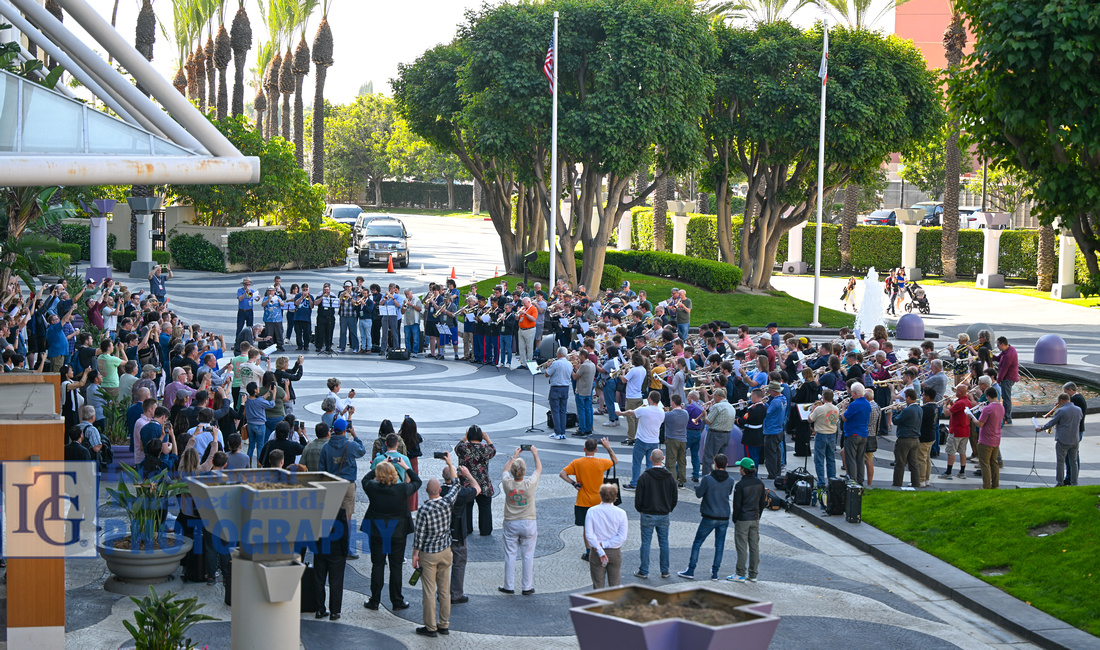
Opening Concert: Boston Brass
The first official event of the 2024 ITG Conference began with a thrilling performance by the Westminster College Trumpet Ensemble of Alfred Reed’s “El Camino Real” (arranged by one of the members of their group). The piece brought a lively, festive flair to the conference’s official start. After a short introduction and welcome from Rebecca Wilt and ITG President Ryan Gardner, ITG honored Vincent DiMartino with a well-deserved ITG Honorary Award.
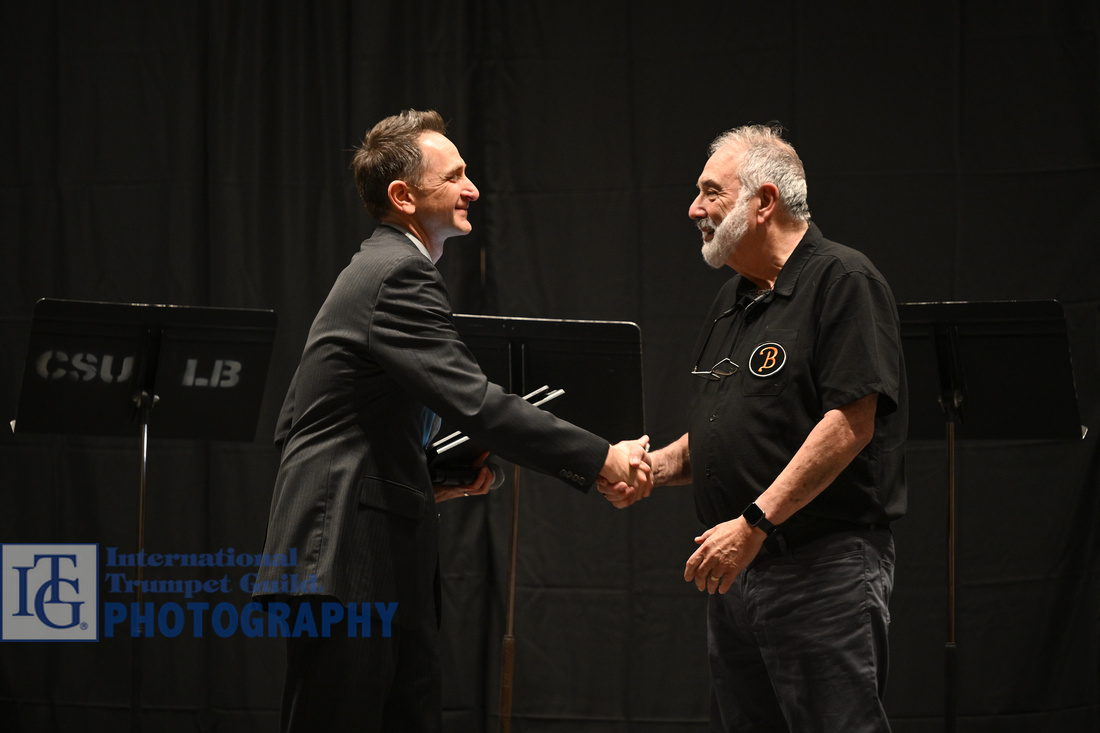
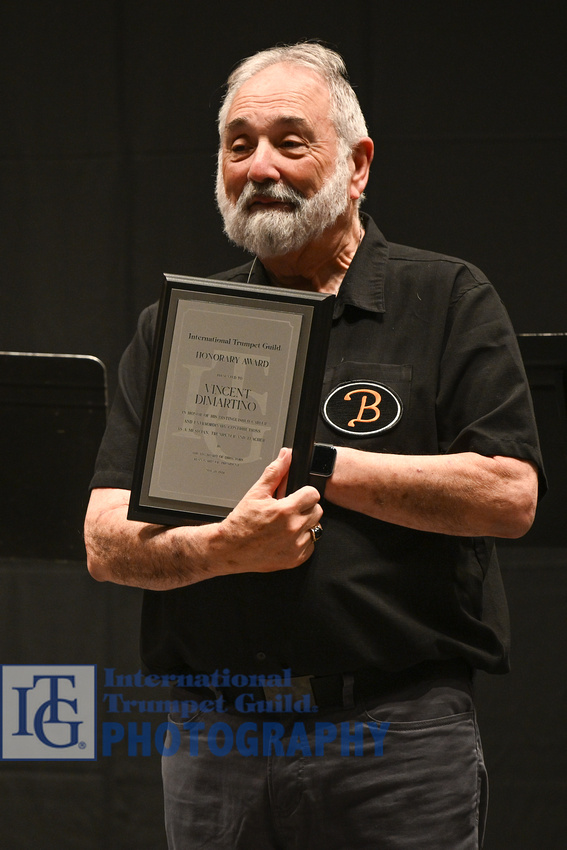
After a heartfelt speech from DiMartino, the Boston Brass quickly took the stage with a riveting arrangement of Dimitri Shostakovich’s “Gallop.” The piece’s fiery tempo gave way to a quick shift in mood as Jose Sibaja was featured on a beautiful arrangement of J.S. Bach’s Cantata 140 – “Wachet Auf.” Jose’s lyrical flugelhorn sound took center stage and danced against the other brass sonorities. The next piece featured their trombone player, Domingo Pagliuca, on a playful theme-and-variations arrangement of Arthur Pryor’s “The Blue Bells of Scotland.” DiMartino quickly retook the stage to join the quintet for their next piece that featured three trumpets. This Spanish-flared work, Celso Guscan’s “The Brave Matador,” allowed the trumpet trio to exist both in the majestic bravado and romantic lyricism that only a work from Latin America could provide. They closed the first half of their recital with Astor Piazzola’s “Verano Porteno,” arranged by José Sibaja. The piece showcased the technical proficiency of each player through its varying themes and lines that seemed to press and grind its way from instrument to instrument all the way to the climactic finish.
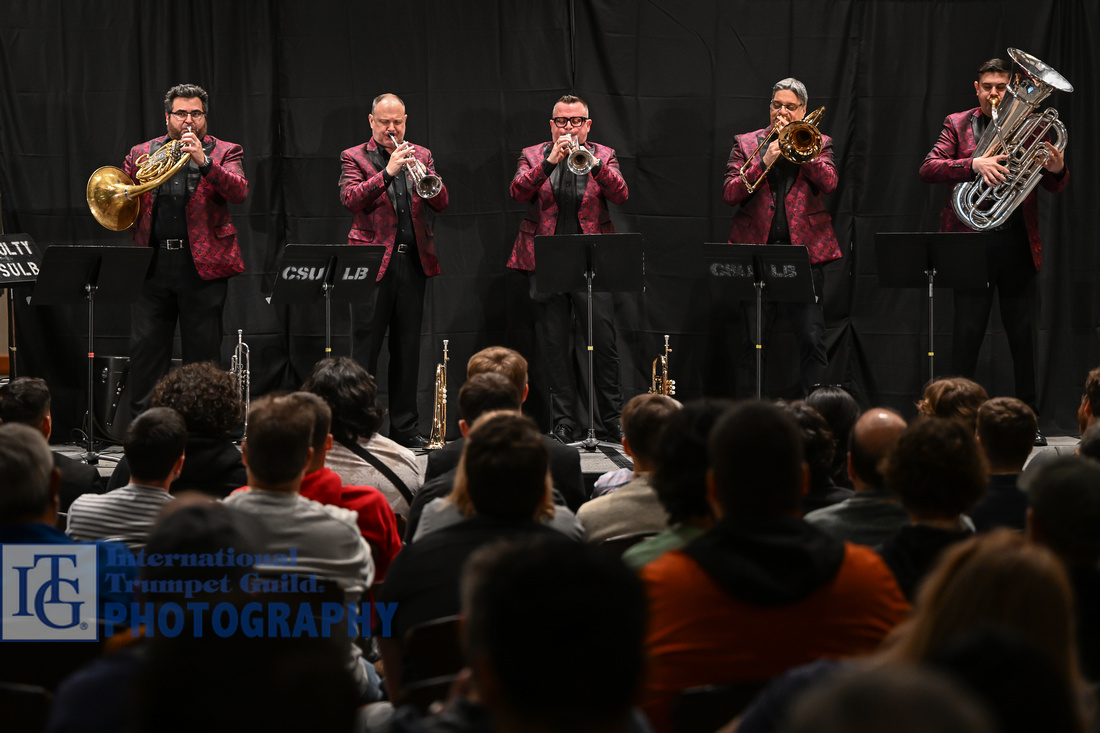
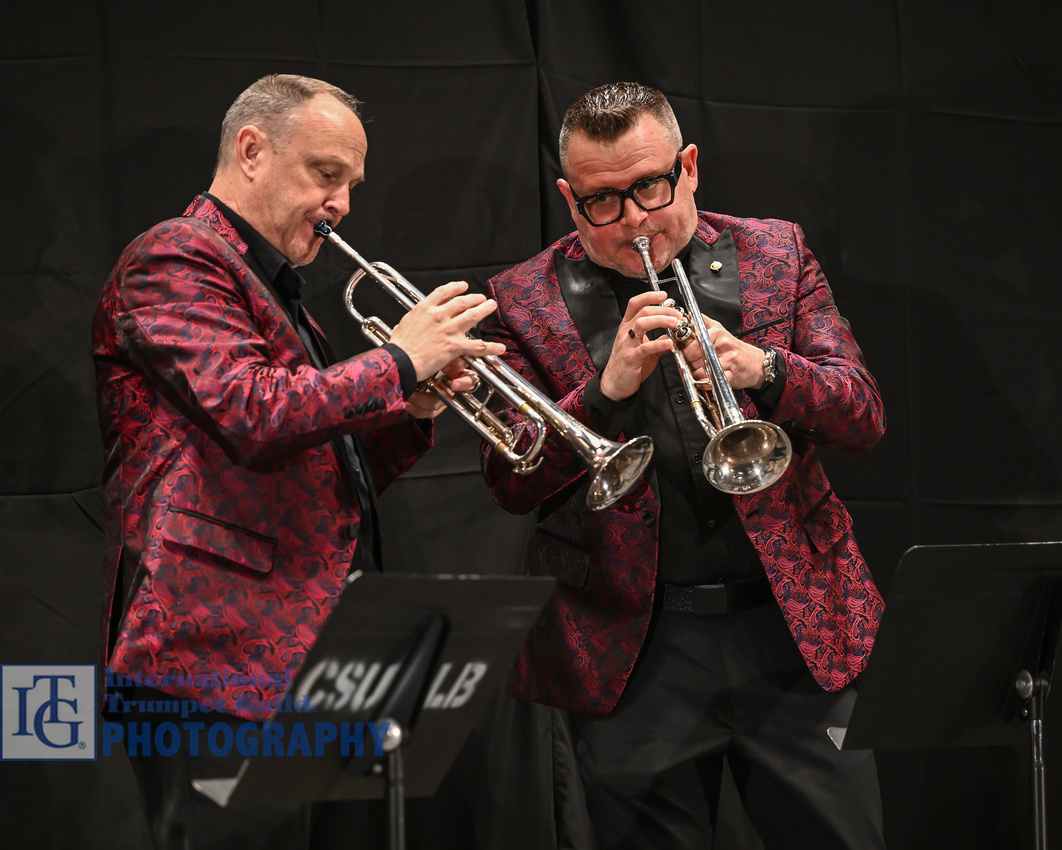
After a short five-minute intermission/chop break and a startling blast from the ensemble, the Boston Brass returned to the stage with a stunning arrangement of “Flight of the Green Hornet” by Billy May. Horn player Chris Castellanos was featured on “Sway” by Pablo Beltran Ruiz, arranged by the group’s legendary tubist Sam Pilafian. Castellanos’s powerful sound filled the hall as his musical lines danced around and over the rest of the supporting quintet. Jeff Connor, one of the founding members of Boston Brass, was featured on Benny Golson’s “I Remember Clifford,” which showcased Connor’s beautiful lyricism on flugelhorn. DiMartino rejoined the group for another trumpet trio, this time for Rafael Hernandez’s “El Cumbanchero.” This piece, arranged by José Sibaja, showcased the trumpets’ expressive upper register as both José and Vince traded short sections of improvisation, which kept the musical fires blazing! The Boston Brass continued the concert with Stanton Moore’s “Blues for Ben.” The piece opened with an impressive solo tuba feature and quickly showcased the impressive improvisational skills of each member of the ensemble. Boston Brass closed their exciting program with their famous arrangement of Duke Ellington’s “Caravan.” This was a terrific start to the conference! (James Peyden Shelton)
Concert: California State University - Long Beach Big Band with Wayne Bergeron and Vince DiMartino
The late concert on the first night of the conference began with the Baylor Gold trumpet ensemble performing two prelude pieces. The first was fully improvised and the other co-written by one of the students and their professor, Wiff Rudd. The ensemble performed both works with sensitivity, poise, and intention.
The California State University-Long Beach Big Band, under the direction of Jeff Jarvis, opened their set with a few charts before the headlining soloists took the stage. The band featured several standout student soloists, who each improvised thoughtfully, developing their solos from colorful threads into beautiful tapestries that also gave a glimpse into their souls.
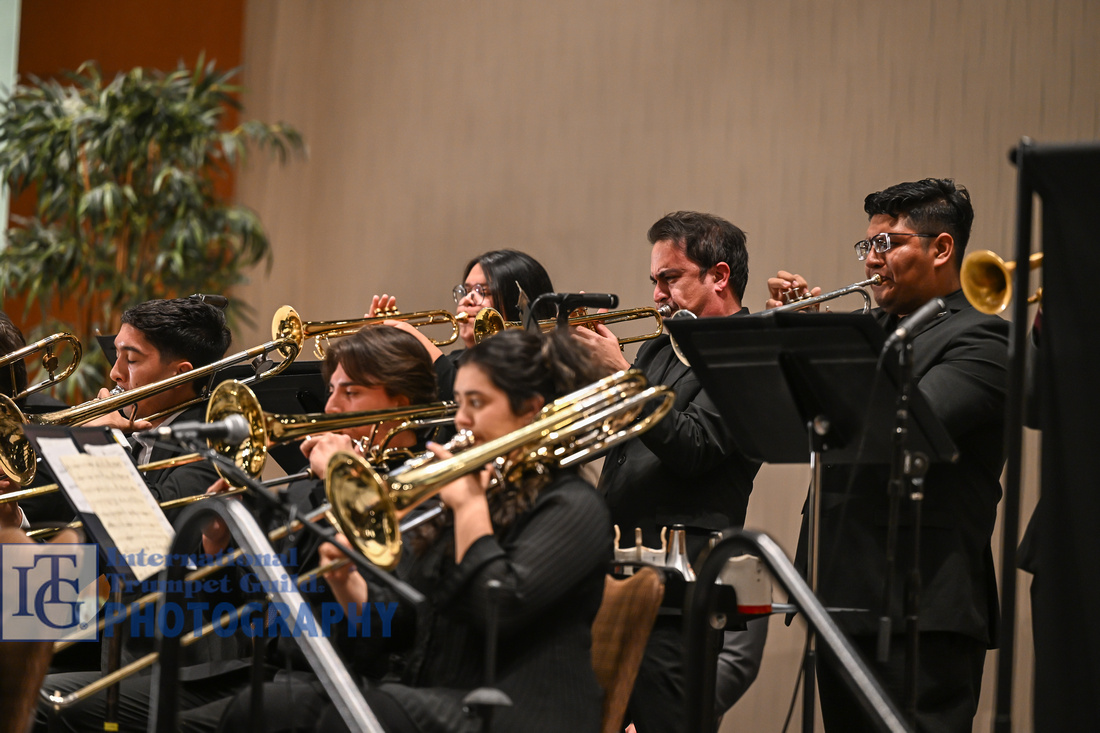
Fittingly, because of both the conference’s location and his career trajectory, Wayne Bergeron’s first solo with the band was an arrangement of “Friend Like Me,” from Disney’s “Aladdin.” His comfort on the stage was remarkable; he not only wowed us with his trumpet playing, but also seemed just as comfortable talking and cracking jokes.
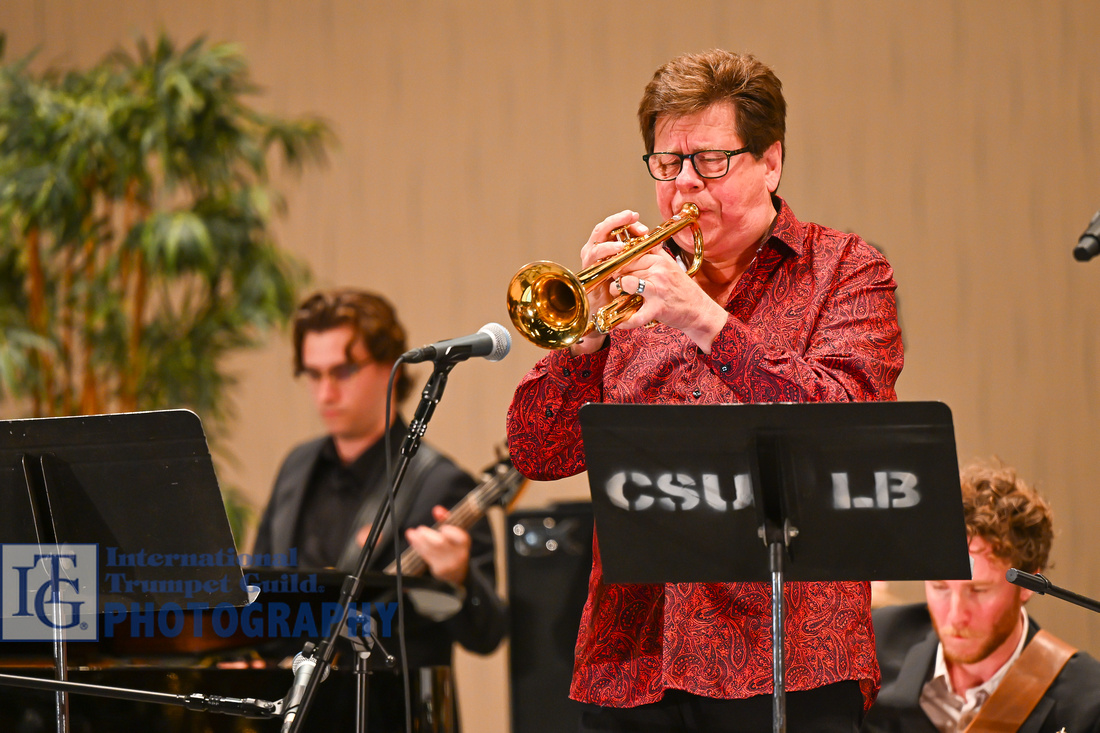
When he brought out his “hero,” Vince DiMartino, for a duet on “When You Wish Upon a Star,” the mood went from lighthearted to emotional, as Bergeron shared how much DiMartino has influenced Bergeron’s career and been a truly good friend.
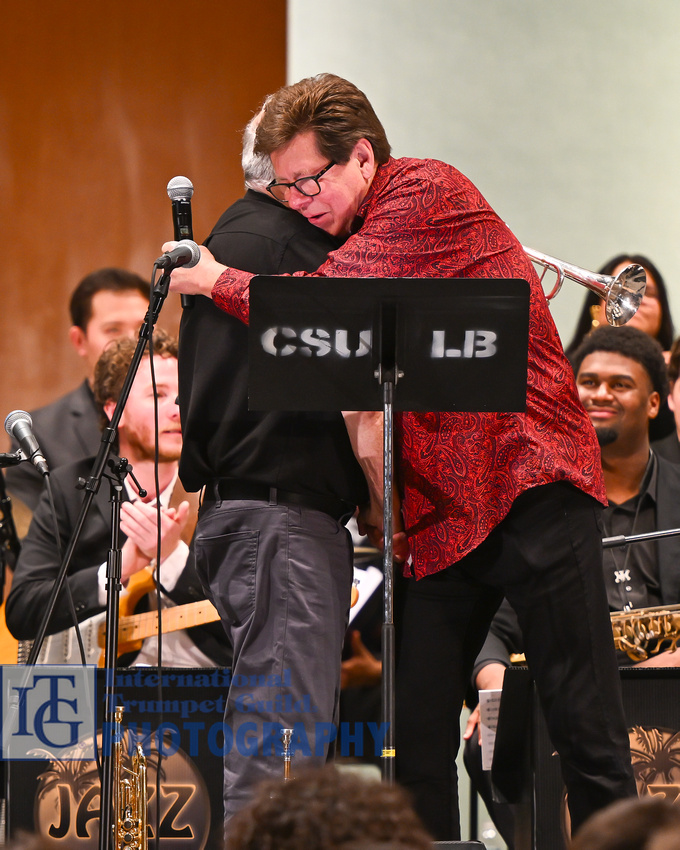
The two of them closed the concert with “High Clouds and a Chance of Wayne,” showcasing their mastery of the trumpet in the jazz idiom. DiMartino began his solo thoughtfully, letting himself be led by the musical line as it unfolded like a wise orator who chooses their words carefully. Bergeron, also thoughtful, used a little more variance in his rhythmic language, all building to the ending – on a literal high note! (Joseph Nibley)
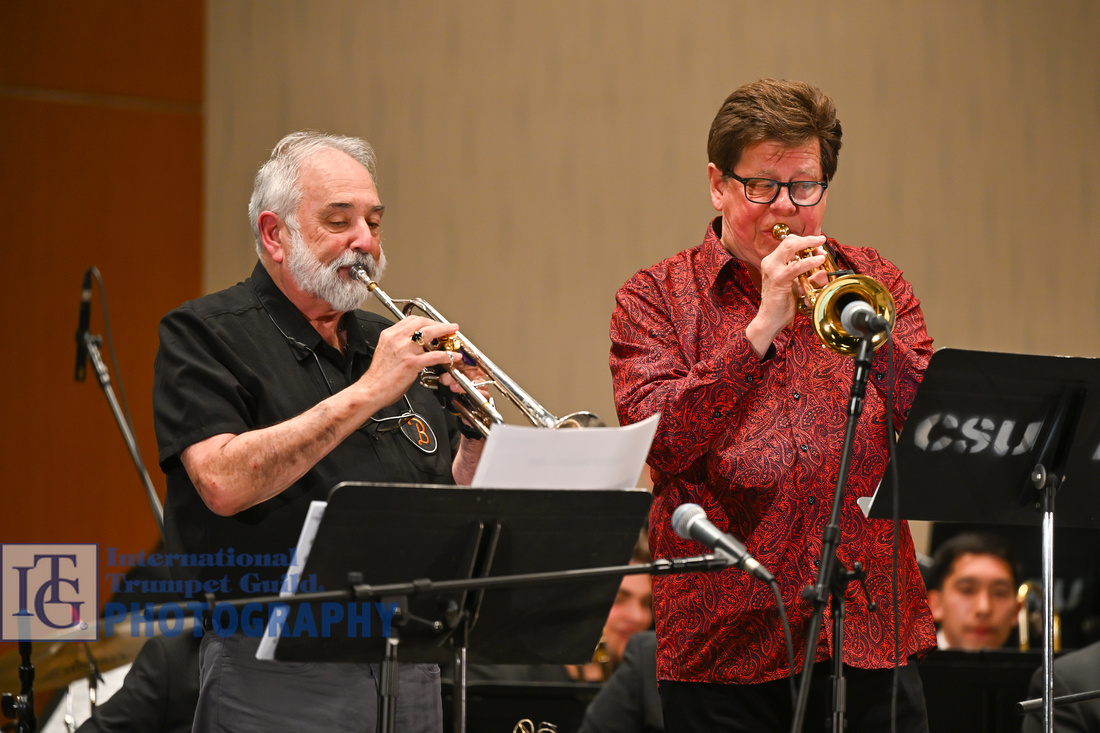
Jam session with Oscar Passley
Dr. Oscar Passley led the conference’s first nightly jam session with Quinn Johnson on piano, Kevin Axt on bass, and Joel Taylor on drums. Passley and the trio opened with a tune called “Emily” and then moved into tunes on which anyone could solo, including “Autumn Leaves” and “St. Thomas.” Throughout the evening, Passley welcomed anyone who wanted the opportunity to play, no matter how long. By the end of the night, around fifteen trumpeters blew solos on Miles Davis’s “Solar,” providing an exclamation point to the first day of the ITG Conference. (Spencer Brand)
Click here for more photos from the ITG Conference
]]>
2023 Results
Competitions Coordinator: Jason Dovel
Chamber Division
Chair: Christopher Scanlon
First place: ESMAE Trumpet Ensemble (Escola Superior de Musica e Artes do Espetaculo, coached by Kevin Wauldron)
Second place: Lux Brass (Baylor University, coached by Wiff Rudd)
Third place: UCLA Trumpet Ensemble (University of California, Los Angeles, coached by Jens Lindemann)
Finalist: MSU Trumpet Ensemble (Michigan State University, coached by Justin Emerich)
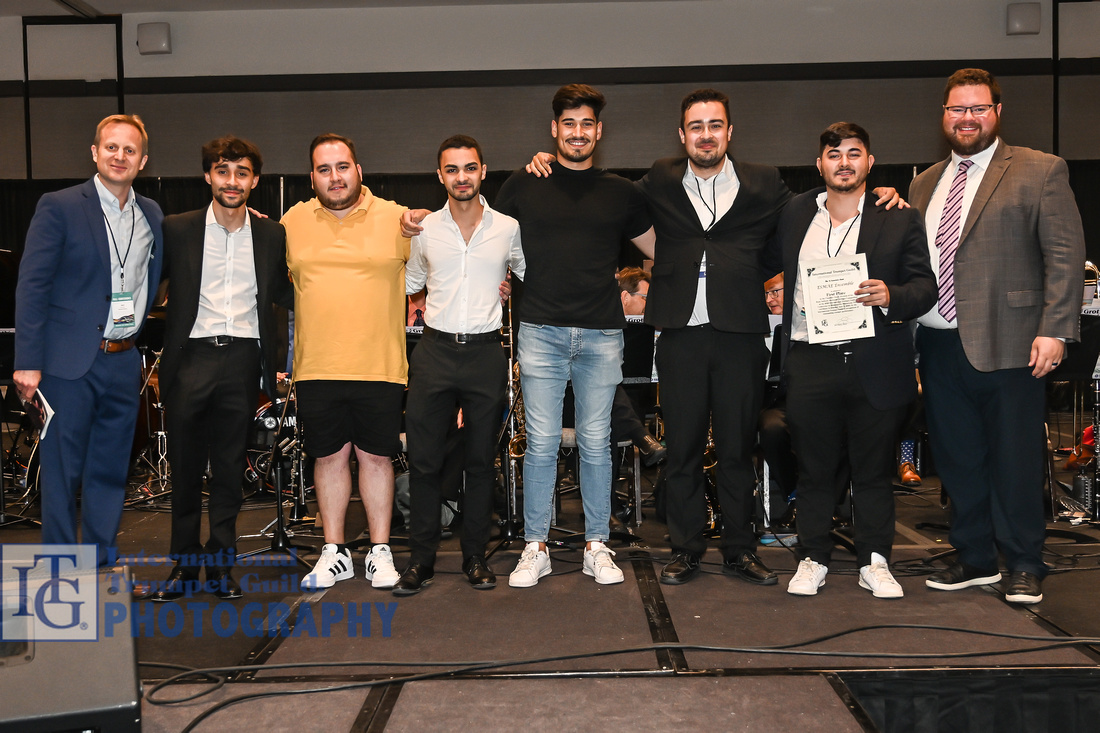

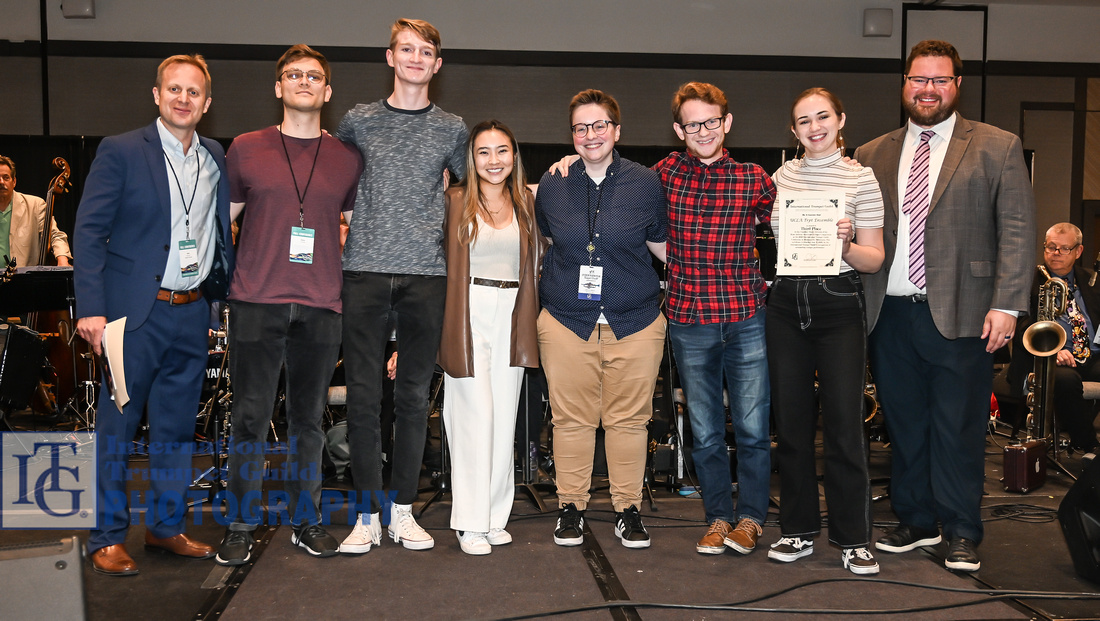
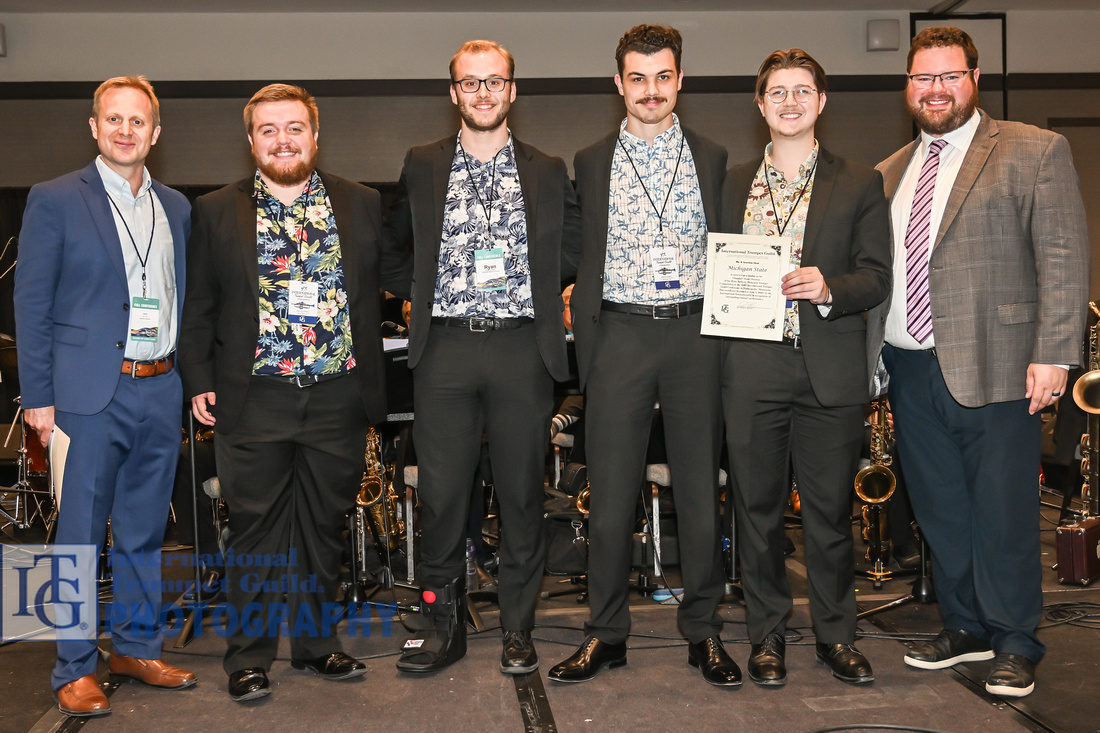
Jazz Improvisation Division
Chair: Oscar Passley
First place: Sam Butler (Indiana University, student of John Raymond)
Second place: Carter Eng (San Francisco Conservatory, student of Mike Rodriguez)
Third place: Luca Stine (University of Miami, student of Brian Lynch)

Orchestral Excerpts Division
Chair: Christopher Wilson
First place: Alison Marseglia (Baylor University, student of Wiff Rudd and Mark Schubert)
Second place: Morgan Hare (Grand Valley State University, student of Alexander Wilson)
Third place: Brandon Hebert (Louisiana State University, student of Matthew and Jena Vangjel)
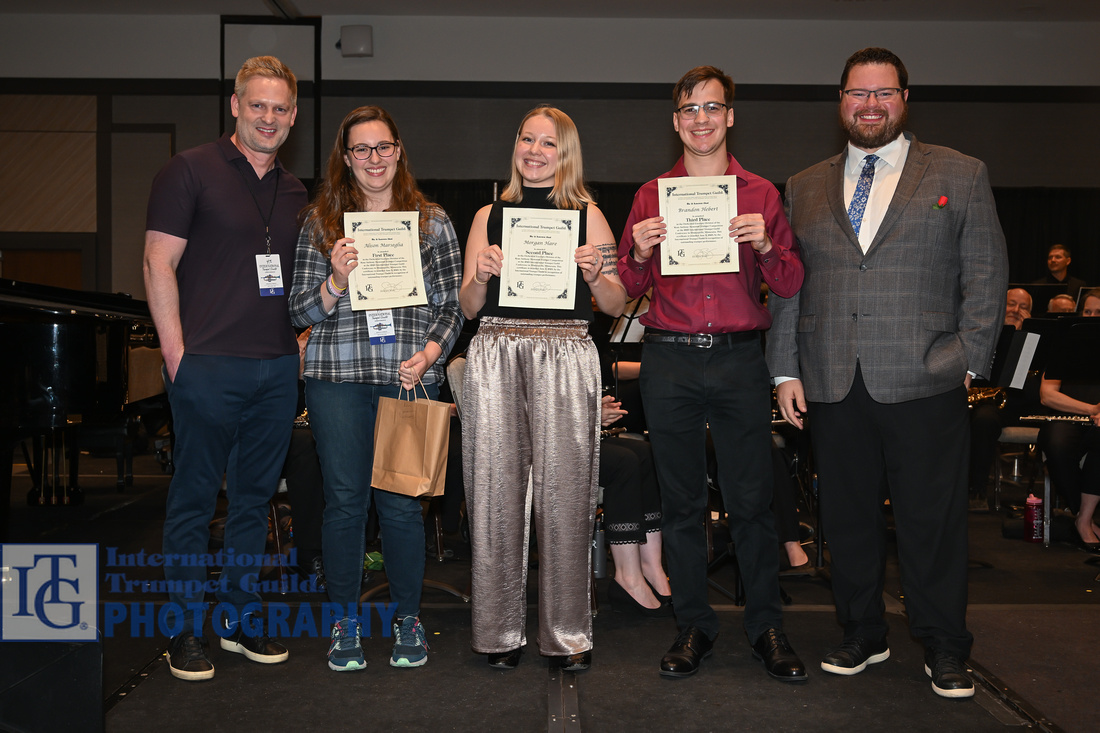
Solo Performance Division
Chair: André Bonnici
First place: Grace O'Connell (Middle Tennessee State University, student of Michael Arndt)
Second place: Jade Park (St. Andrew's Cathedral School, Sydney, Australia, student of Paul Terracini)
Third place: Michael Brotherton (University of Colorado Boulder, student of Ryan Gardner)

Wind Band Excerpts Division
Chair: Susan Rider
First place: Anthony Salabarria (University of Delaware, student of Mark Clodfelter)
Second place: Noah Solomon (University of Colorado-Boulder, student of Ryan Gardner)
Third place: Madison Sinan (University of Colorado-Boulder, student of Ryan Gardner)
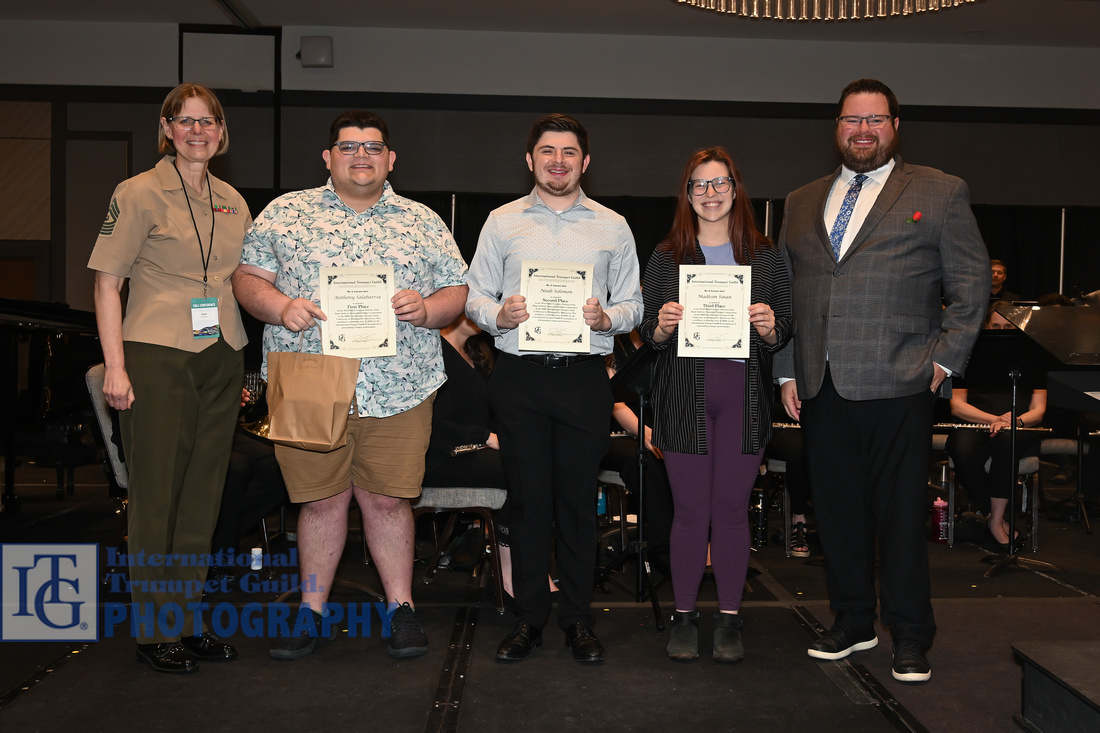
Youth Competition (Senior Division)
Chair: Jenna Veverka
First place: Jade Park (Newington, Australia; student of Paul Terracini)
Second place: Ian Lee (Haverford, Pennsylvania, USA; student of Alexander Serio)
Third place: Amelia Kowalewska (Plock, Poland; student of Grzegorz Debski)
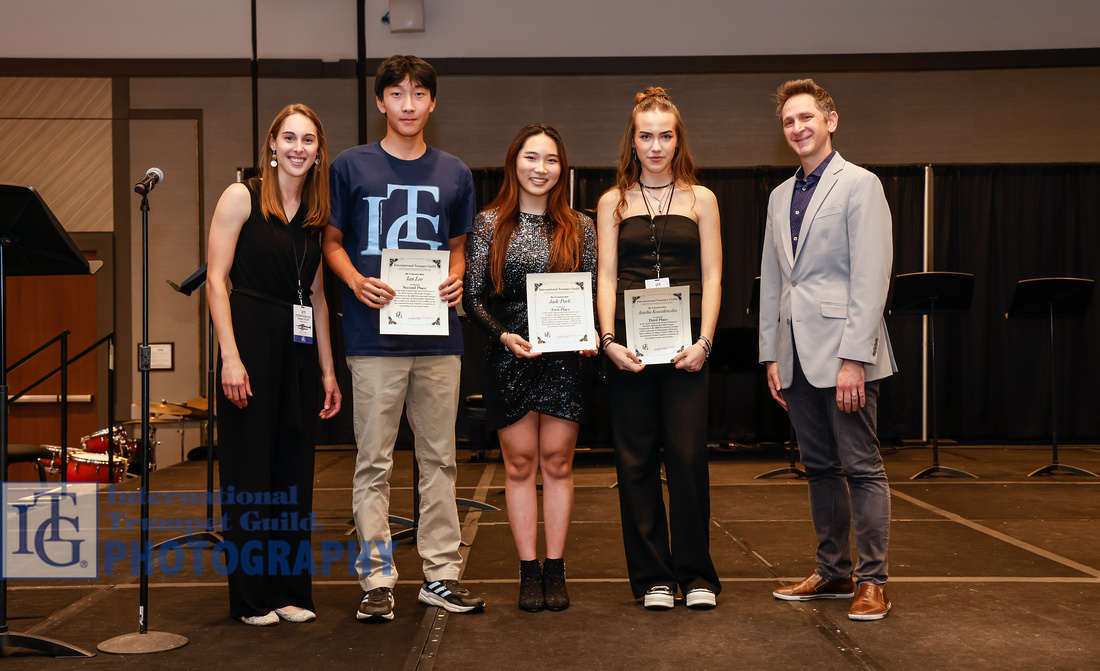
Youth Competition (Junior Division)
Chair: Jenna Veverka
First place: Christian Garner (Minnetonka, Minnesota, USA; student of Robert Dorer)
Second place: Issac Jooun Won (Potomac, Maryland, USA; student of Ohtae Kwon)
Third place: Jiu Shi (Beijing, China; student of Rui Li)
Honorable Mention: Maxwell Janes (Mercer Island, Washington, USA; student of Jared Hall)
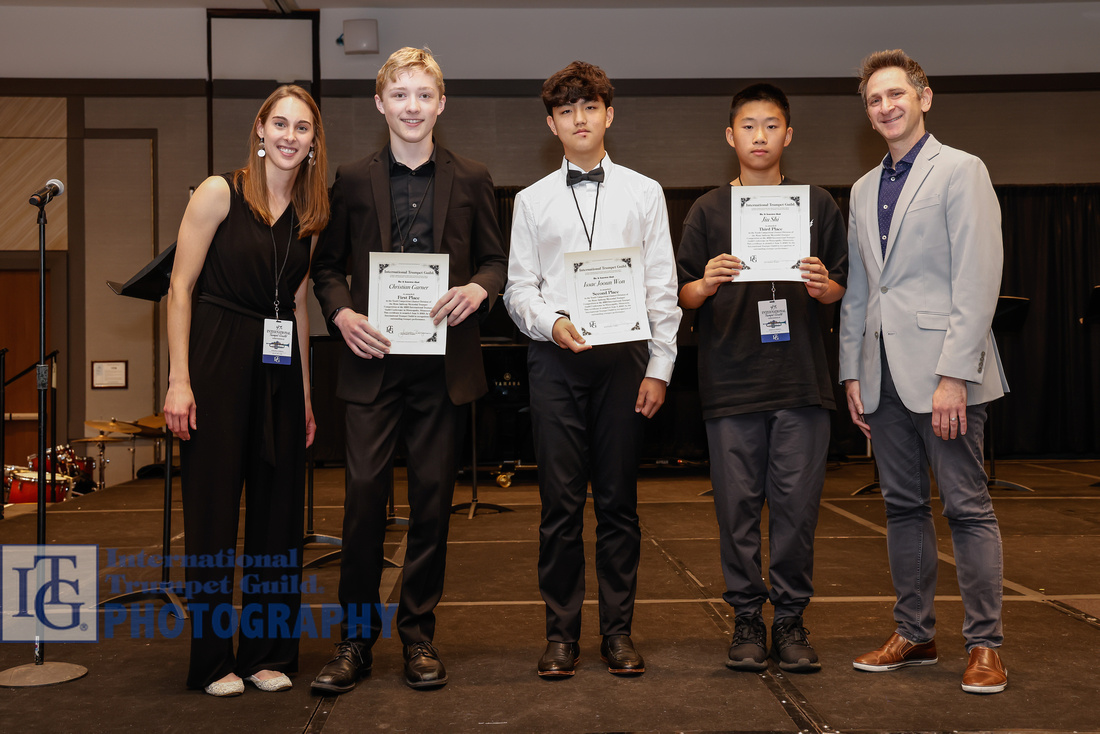
ITG Conference Scholarships for Students
Scholarship Chair: Sarah Stoneback
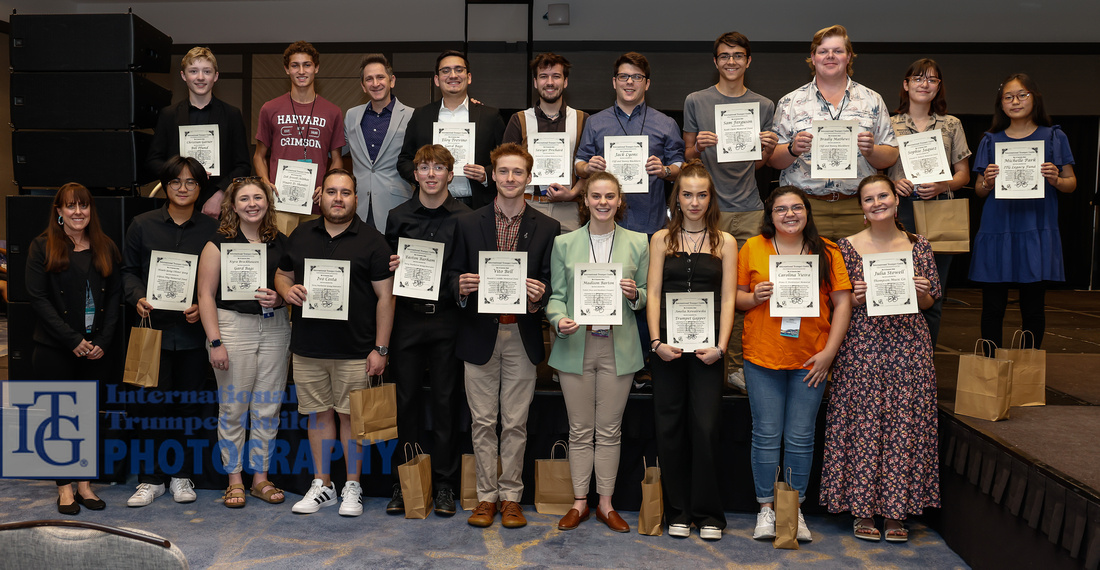
ITG Legacy Fund Scholarship
Michelle Park (Palo Alto High School, student of Mark Nemoyten)
Franz X. Streitwieser Memorial Scholarship
Donor: Katharine Streitwieser
Carolina Vieira (Escola Superior de Musica e Artes do Espetaculo, student of Kevin Wauldron)
Bryan & Nancy Goff Scholarship
Donor: Bryan & Nancy Goff
Joaquim Simoes (Universidade Federal do Estado do Rio de Janeiro, student of Maico Lopes)
Cliff and Bunny Blackburn Scholarship
Donor: Cliff and Bunny Blackburn
Jack Lyons (Florida State University, student of Christopher Moore)
Bradley Matthews (University of Arkansas, student of Richard Rulli)
Donald P. Bullock Memorial Fund Scholarship
Sophie Jaquez (University of Arkansas, student of Richard Rulli)
Richard B. Lehman Memorial Fund Scholarship
Sawyer Prichard (Florida State University, student of Christopher Moore)
Keith Clark Memorial Fund Scholarship
Sam Ferguson (Fort Richmond Collegiate, student of Darryl Ferguson)
Dino Tofanelli Memorial Scholarship
Donor: Andrea Tofanelli
Christine Ziadeh (University of Massachusetts Amherst, student of Eric Berlin)
Gard Bags Scholarship
Donor: Talwar Brothers Ltd
Eloy Trevino (Baylor University, student of Wiff Rudd)
Kyra Brockhausen (University of Arkansas, student of Richard Rulli)
Thompson Music Co. Scholarship
Donor: Thompson Music Co.
Julia Stowell (University of Illinois at Urbana-Champaign, student of Amy Gilreath)
Terry Warburton Young Innovator Scholarship
Donor: Warburton Music Products
Ivo Costa (Escola Superior de Musica e Artes do Espetaculo, student of Kevin Wauldron)
Easton Barham (Florida State University, student of Christopher Moore)
Bill Pfund Scholarship
Donor: Bill Pfund Trumpets
Cris Fagundes (University of Massachusetts Amherst, student of Eric Berlin)
Christian Garner (Minnetonka Middle School West, student of Robert Dorer)
Clifton Plog Memorial Fund Scholarship
Hsueh-Yang (Shine) Yang (Trinity School of Midland, student of John Irish)
Stuart D. Shanler Scholarship
Donor: Stuart Shanler
Zeb Jewell-Alibhai (Durham Academy Upper School, student of Jim Ketch)
Pickett Brass and Blackburn Trumpets Scholarship
Donor: Pickett Brass
Robert Kerr (Florida State University, student of Christopher Moore)
Madison Barton (Florida State University, student of Christopher Moore)
Renold O. Schilke Memorial Fund Scholarship
Vito Bell (Florida State University, student of Christopher Moore)
Trumpet Gapper Scholarship
Donor: Trumpet Prof Enterprises
Amelia Kowalewska (Plock, Poland; student of Grzegorz Debski)
]]>
Compiled by Peter Wood
Conference Prelude Performances
Groups are listed alphabetically.
Arkansas State University - Fantasia Trumpet Ensemble
Dr. Nairam Simoes, director
Audrey Alpha, Cody Daughertee, Brody King, Carlos Mejia, Rebecca Wertenberger, trumpets
Fantasia Brasileira by Jose Ursicino da Silva "Duda"
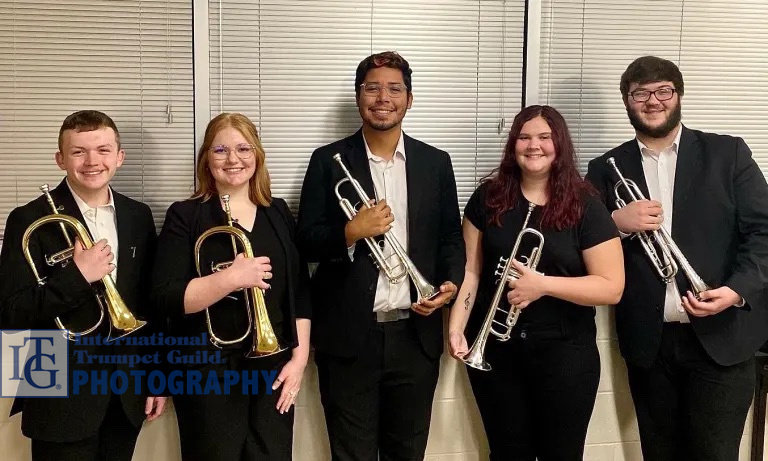
Ball State University - Wrecking Crew Trumpet Ensemble
Dr. Stephen C. Campbell, director
Clarissa Austin, Eli deWeerdt, Jeff Doll, Noah Holtsclaw, Chris Pinto, Kyle Rogers, Alec Shilling, Ryan Vachon, trumpets
La Forza del Destino - Sinfonio by Giuseppe Verdi arr. Stephen C. Campbell
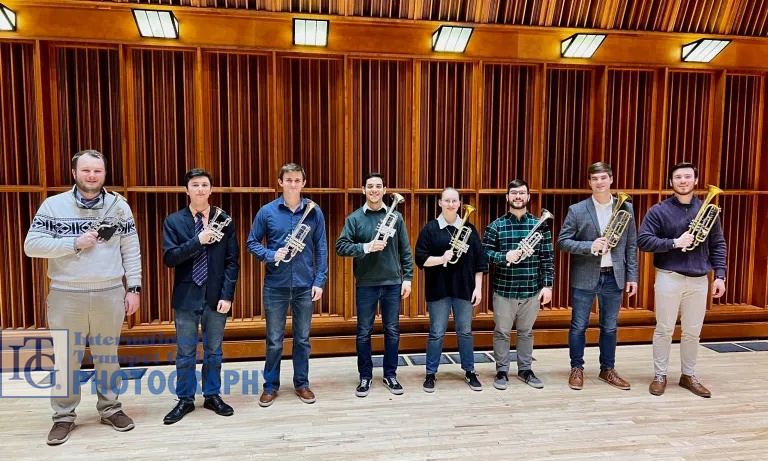
Berklee College of Music - Eight Angels
Prof. Angel Subero, director
Yibran Aponte Cotto, Michael Arizmendi, Dhruv Banerji, Lisa Chiodo, Akihiro Kokufukata, Miguel Ortiz Rivera, Adam Vidal, Shota Yamaguchi, trumpets
There's A Great Day Coming by Will Thompson (Arr. Terry Everson)
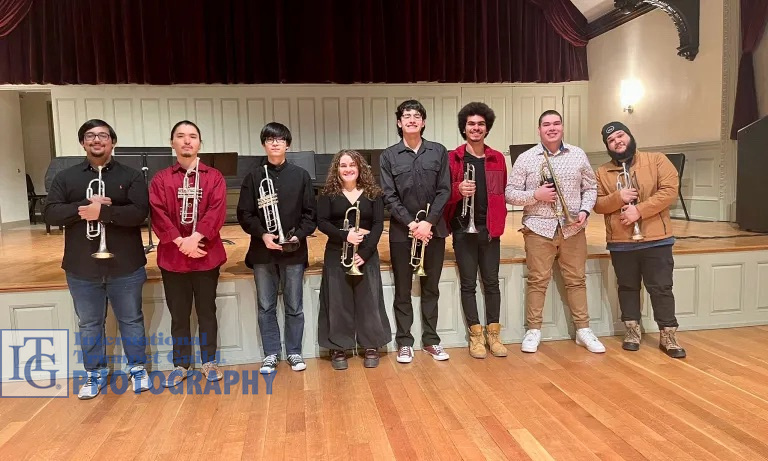
Boston University Trumpet Ensemble
Prof. Terry Everson, director
Dan Casso, Aysel DeBakey, Xan Denker, Terry Everson, Chloe Francis, Dan Hein, Kyra Hulligan, Joel Kayser, Brendan Mathieson, Cassandra McDonald, trumpets
A Carmen Fantasy by Georges Bizet, arr. by Terry R Everson
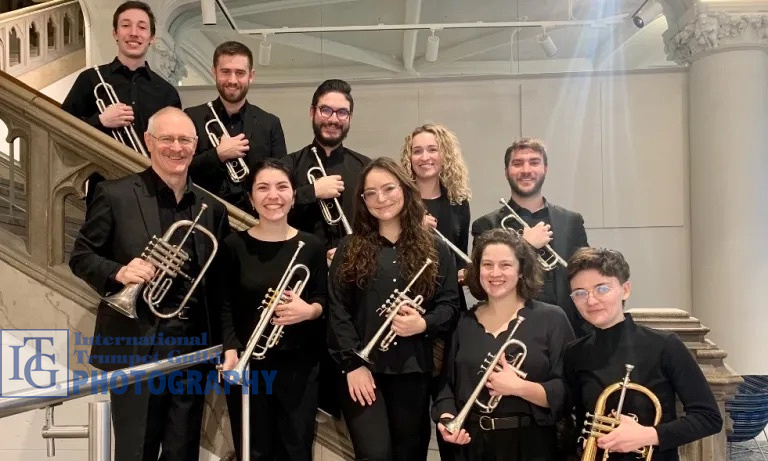
Brighton High School - The Brighton Area Trumpet Ensemble
Sharon Long, director
Eliza J Grimes, Nicholas E Hardy, Jack A Milton, Luke C Newcomb, Jason T Robinson, trumpets
Tico Tico by Zequinha De Abreu, Arr by Valter Valerio
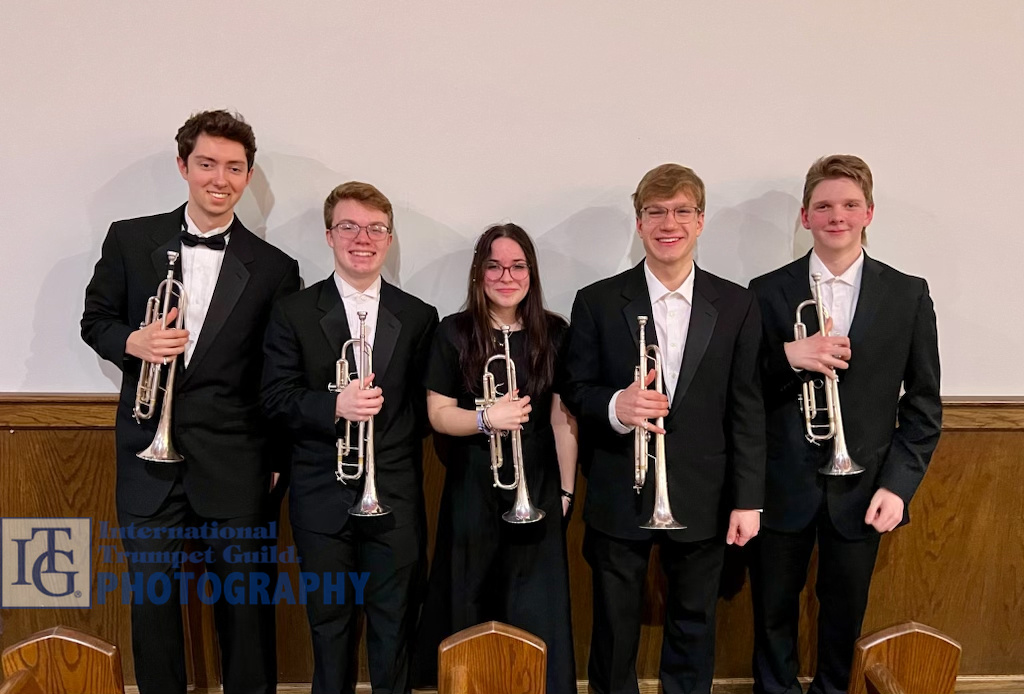
Colorado State University Trumpet Ensemble
Dr. Stanley Curtis, director
Stanley Curtis, John Pirillo, Enzo Barrett, Trevor Woodcock, Liv Caskey, Hunter Leudtke, trumpets
An Olcott Overture! by Eric Ewazen
Danny Boy arr. by James Olcott
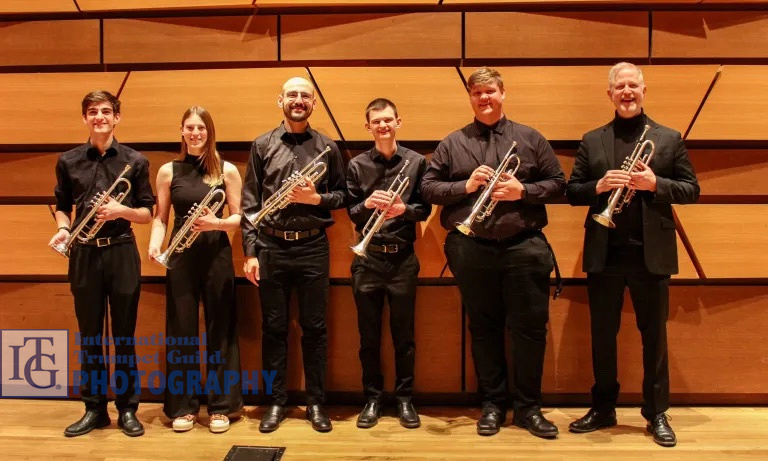
Crane School of Music - Crane Trumpet Ensemble
Dr. Luke Spence, director
Molly Collins, Olivia Montagno, Frankie Pietraniello, Jacob Rushlow, trumpets
Prelude in G Minor by Sergei Rachmaninoff
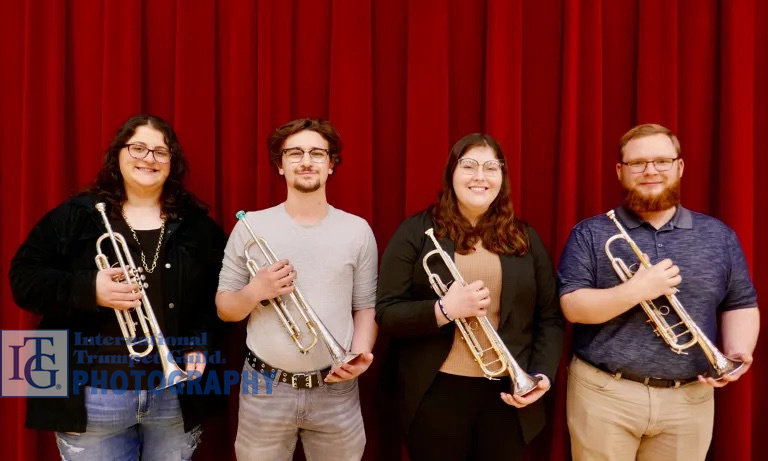
Duquesne University - Duquesne Trumpet Ensemble
Dr. Chris Wilson, director
Ty Lewis, Jon Runion, Matt Simpson, Chris Cox, Caleb Drayer, trumpets
Contrasts for Five Trumpets by Tony Plog
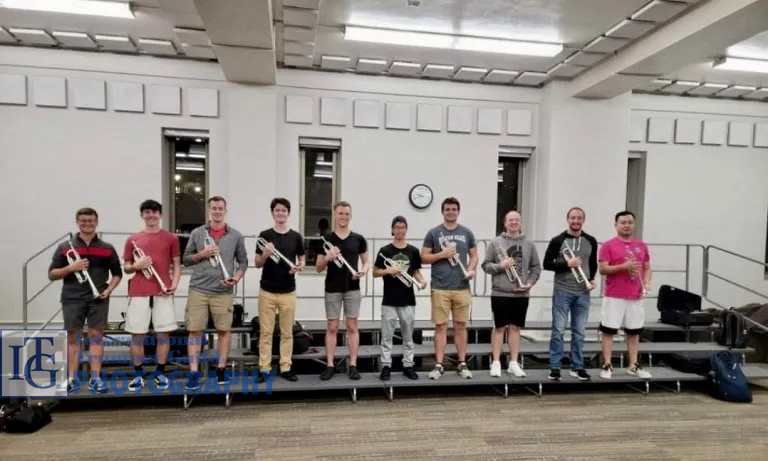
Eastlake High School - Eastlake Trumpet Quartet
Caleb Tullius, director
Diego Desantiago, Carlos Garcia, Enrico Galano, David Guerrero, trumpets
Dos Tiempos by Cordona, Beatriz
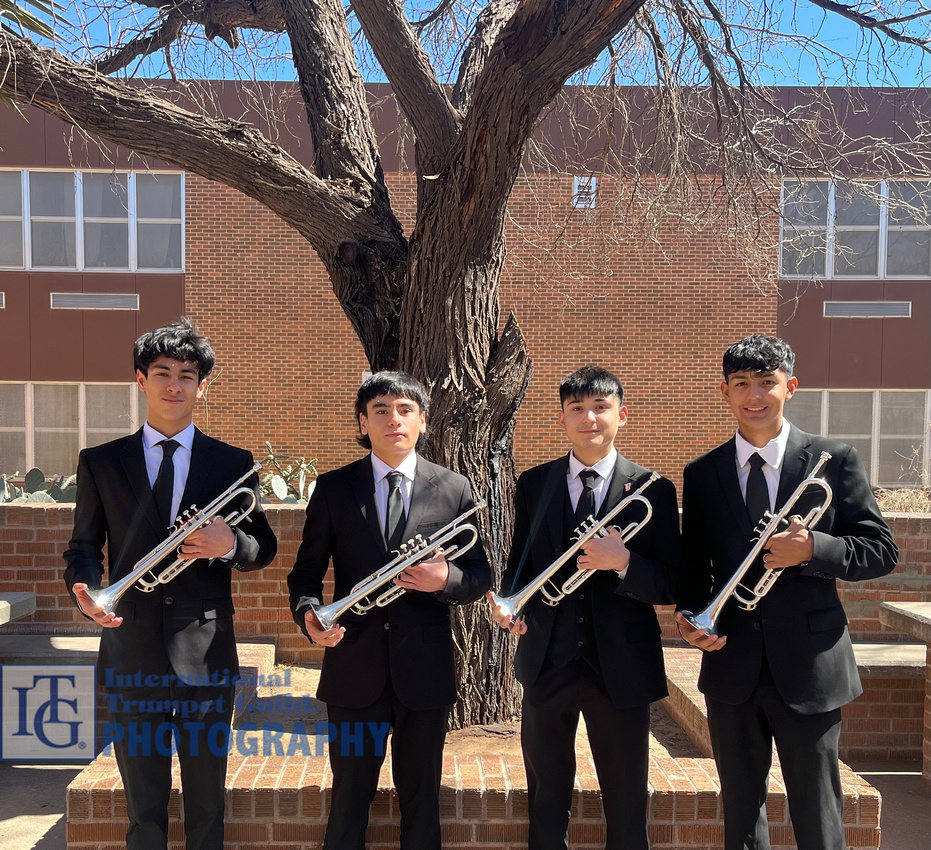
Emporia State University Trumpet Ensemble
Dr. Gary Ziek, director
Wyatt Campbell, Hunter Fesenmeyer, Libby Franks, Adrian Greenfield, Katelyn Hess, Koby McCarty, David Medrano, Ben Orstadt, Madison Smith, Tristan Stevens, RJ Stovall, Zach Younie, trumpets
Indefatigable by Gary D. Ziek
William Tell Overture by Gioacchino Rossini, arr. Gary D. Ziek
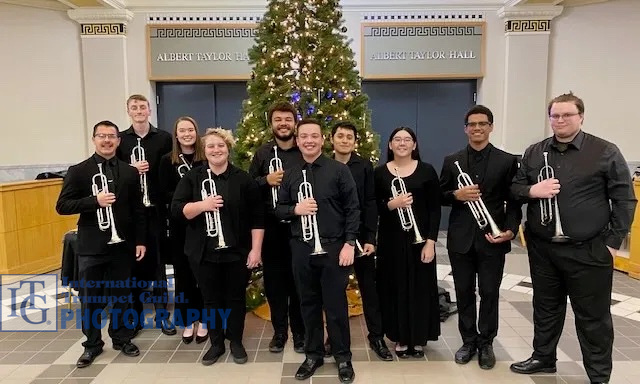
Escola Superior de Música e Artes do Espetáculo - Ensemble de Trompetes da ESMAE
Professor Kevin Wauldron, director
João Almeida, Rui Almeida, Ivo Costa, Pedro Costa, Francisco Machado, Rafael Pinto, Bruno Rodrigues, Carolina Vieira, trumpets
Toccata and Fuge in d minor by Johann Sebastien Bach arr. Edward Tarr and Wolfgang G. Haas
Povo Que Lavas No Rio by Joaquim Campos, arr. Hélder Bettencourt
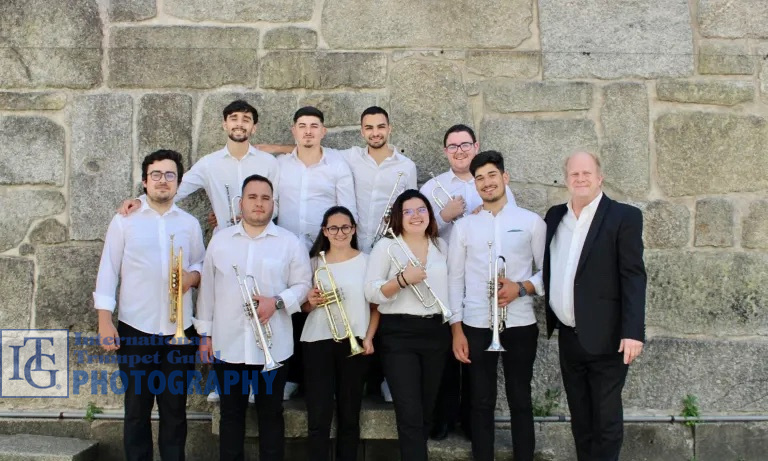
Glendale Community College Trumpet Ensemble
Dr. Spencer Brand, director
David Alvarado, Cynthia Christopher, Chloe Colbert, Javier Ramirez , Chris Scrivens, Nathan Lievre, Elias Villa, trumpets
Conquest by Erik Morales
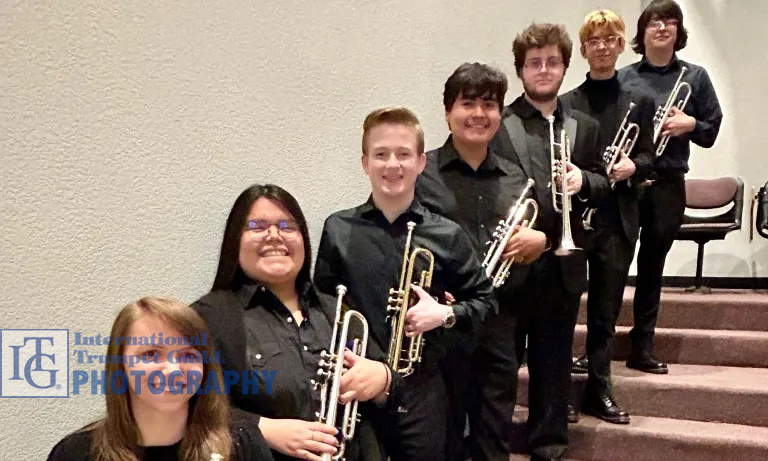
Luther College Trumpet Ensemble
Dr. John T. Cord, director
Hannah Wren, Matthew Boardman, Austin Efflandt, Carly Witucki, Carter Sommerness, Karson Trujillo, Emma Lee, Andon Storey, Callie Pierce, Kristian Stordalen, Sam Wilson, trumpets
The Spirit of the Lord is Upon Me by Dr. Brian Luckner
Vociferation by Dr. Jack Stamp
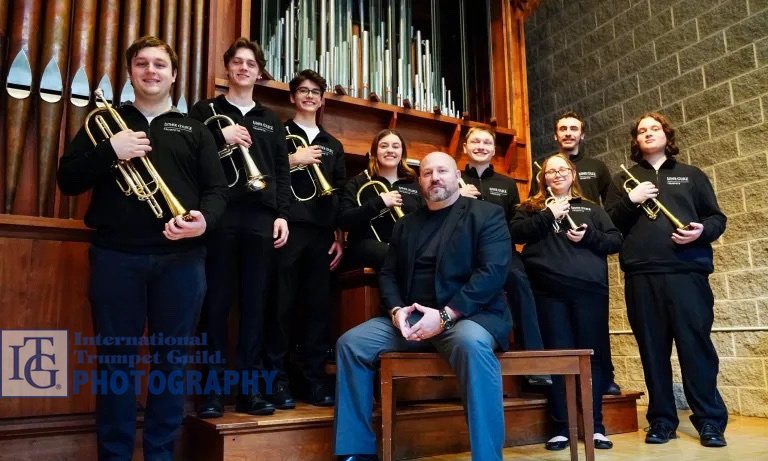
Mahidol University Trumpet Ensemble
Joseph Bowman, director
Nintiphum Bamrungbanthum, Joseph Bowman, Pheeraphat Buaninchareun, Alongkorn Laosaichuaea, Yunjian Liang, Suchol Nintawong, Radit Towong, Weisheng Xu, trumpets
Khaen-dle for 7 Trumpets by Viskamol Chaiwanichsiri
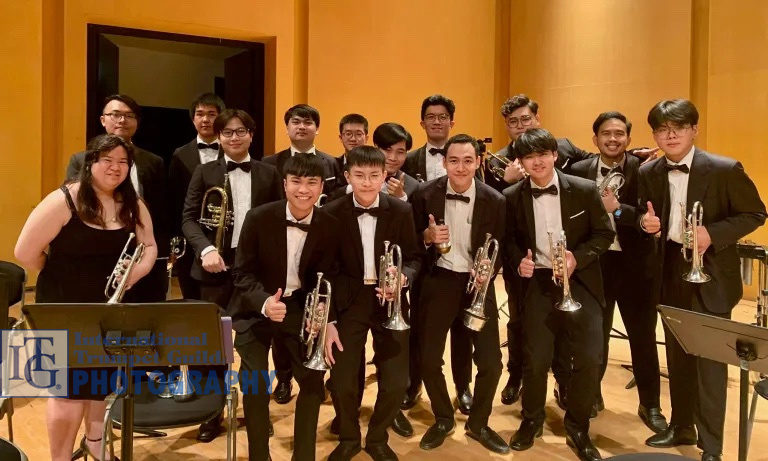
Montana State University School of Music - MSU Gallatin Trumpet Ensemble
Dr. Sarah Stoneback, director
Carrie Babcock, Sienna Chandler, Sydney Eastwood, Dani Espíritu, Sophia Hahner, Madison Lujan, Cole Orelup, Dr. Sarah Stoneback, Director, trumpets
Fanfare and Allegro by Toby Roth
Sometimes I Feel Like a Motherless Child by Traditional Spiritual Arranged by David Marlatt
Billy Goat Stomp by Jelly Roll Morton Arranged by Ken Shifrin
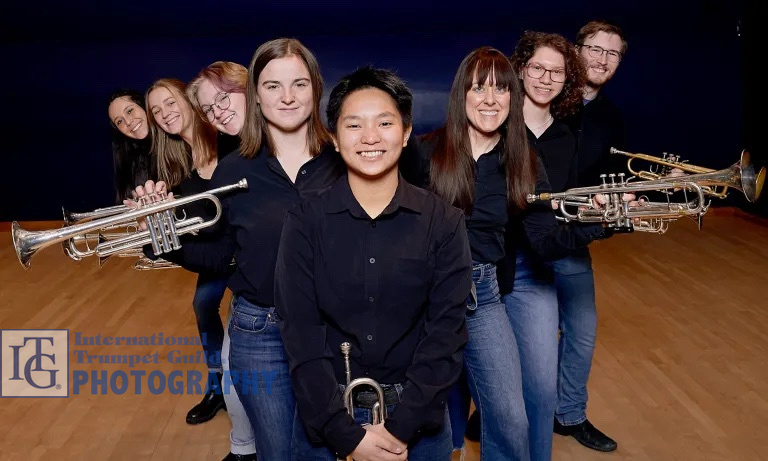
North Dakota State University Trumpet Ensemble
Dr. Jeremy Brekke, director
Robert Balek, Hannah Baum, Eric Bender, Zach Breidenbach, Zack Carlson, Isaac Homuth, Josh Maki, Maddie Ripka, Jaden Rohrich, Toby Steimer, trumpets
Infinite Ascent by Erik Morales
America the Beautiful by Jim Olcott
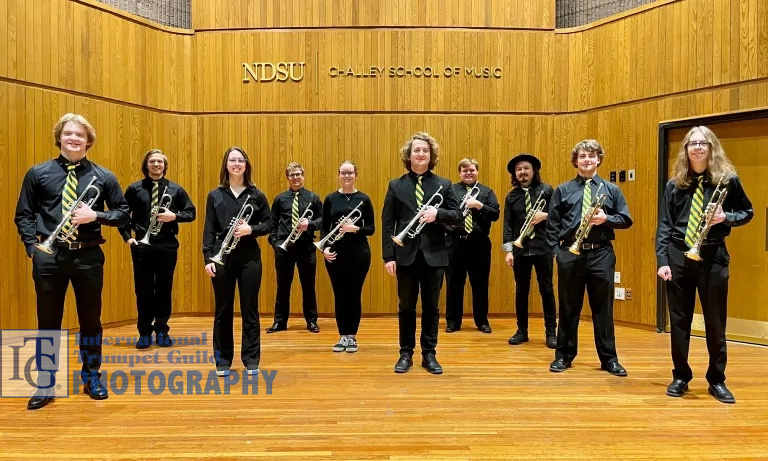
North Dakota's 188th Army National Guard Band - 188th Army Band Trumpet Ensemble
Chief Warrant Officer Three James Landman, director
SPC Andrew Bergan and SSG Samuel Kroll - piccolo trumpets; CW3 James Landman - piccolo trumpet and flugelhorn; SPC Jaden Rohrich, SGT Augustus Tandberg, and SPC Jaden Yeager - trumpets
Fanfare - Celebration of Spring by David Marlatt
Hodie Christus Natus Est arr. Marlatt
Festival of Lights by David Marlatt
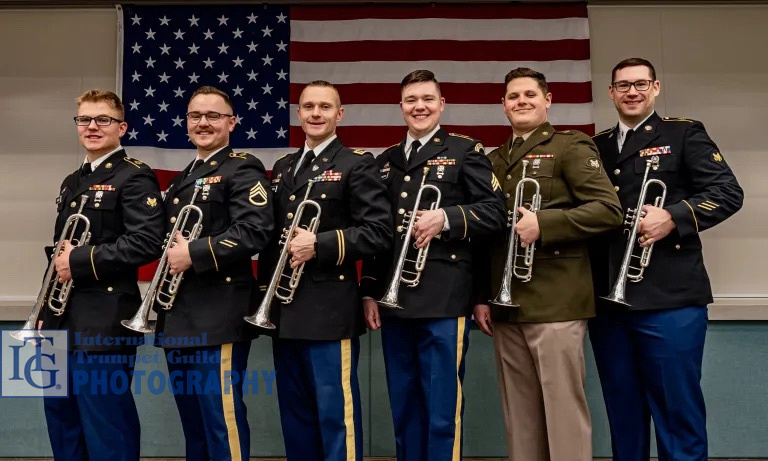
Royal Irish Academy of Music Trumpet Ensemble
Prof. David Collins, director
Erick Castillo, Aoife Garry, Nathan McDonnell, Grace Taite, trumpets
Country Picture by Vassily Brandt
12 Stücke (No.1) by Diabelli
12 Stücke (No.4) by Diabelli
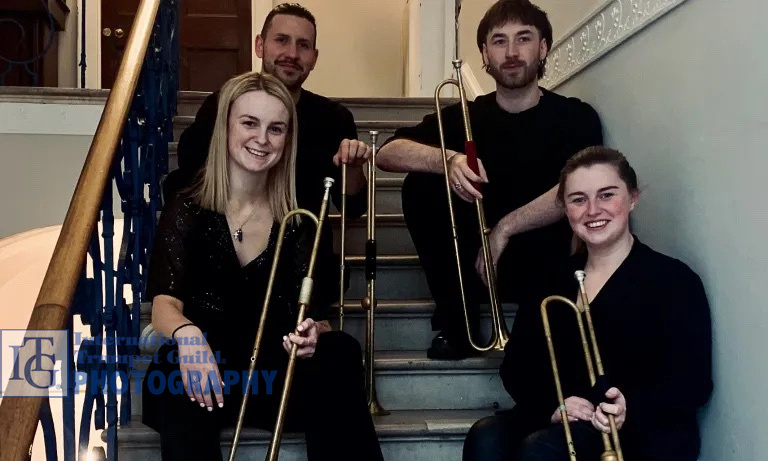
Southern Utah University Trumpet Ensemble
Prof. David D. Torres, director
Landon Fowles, Kail Limb, Daisy Sarvello, Seth Seegmiller , Ruth Zeller, trumpets
Suite for Five Trumpets by Ronald Lo Presti
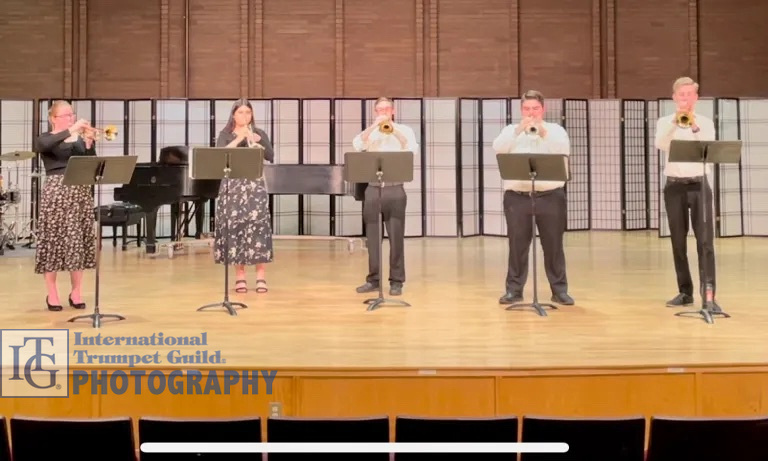
Southwestern Oklahoma State University Trumpet Ensemble
Dr. Richard Tirk, director
Amanda Bacon, Dylan Burrows, Jeremiah Cross, Jordan Duff, Wayne Hoover, Nate Jackson, Nathan Logan, Karson Sanderson, Jessica Stein, Cydney Stotts, trumpets
Canzon Septimi toni a 8 No. 1 by Giovanni Gabrieli, Arr. Brown
Celestial by Eric Fregoso

The Peabody Institute of the Johns Hopkins University - Peabody Graduate Trumpet Ensemble
Dillon Parker, director
Evan Kirshen, Luis Ozoria, Dillon Parker, Yuval Tessman-Bar-On, Weifeng Zhao, trumpets
Fantasia Brasileira by José Ursicino da Silva "Duda"
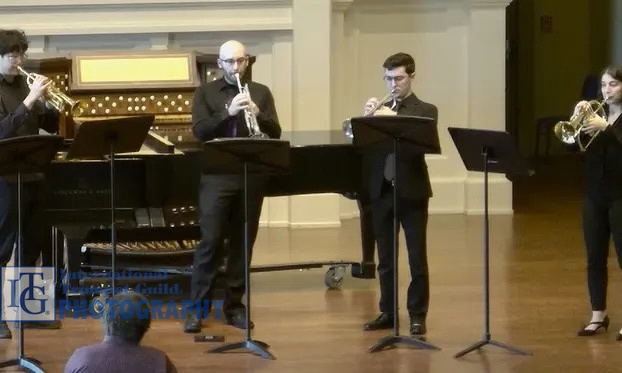
University of Dayton Flyer Trumpet Ensemble
Eric Knorr, director
Collin Eaton, Patrick Linegang, Aaron Moen, Jacob Slomko, Abagail Southworth, Rebecca Sutton, trumpets
Festfanfare by Ernst A. Friese
Concerto for Two Trumpets by Antonio Vivaldi, arr. David Marlatt
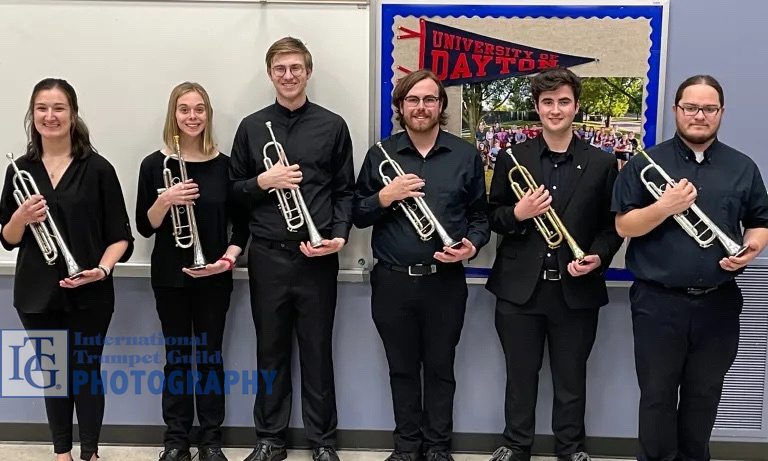
Universidad de Costa Rica, sede Caribe - UCR Caribe Trumpet Ensamble
Prof. Alexis Morales, director
Daniel Espinoza Fonseca, Johan Delgado Medina, Kevin González Collado, Pedro Magallón Pérez, Alexis Morales Barrientos, trumpets
Fantasía Caribe by Various
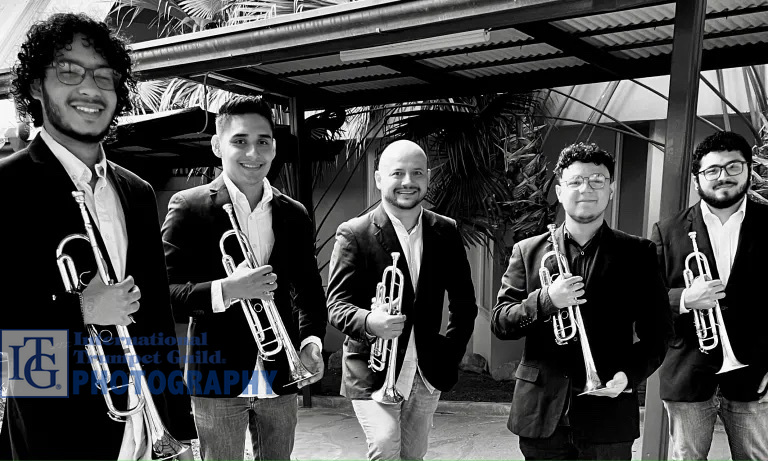
University of Missouri - Mizzou Trumpet Ensemble
Dr. Iskander Akhmadullin, director
Calvin Banks, Layden Dukes, Emily Gilley, Ava Lairmore, Emily Rahn, trumpets
Darn That Dream by Jimmy Van Heusen/Eddie Delang arr. James Olcott
Variations in Flamenco Style by Vladimir Vasilevsky
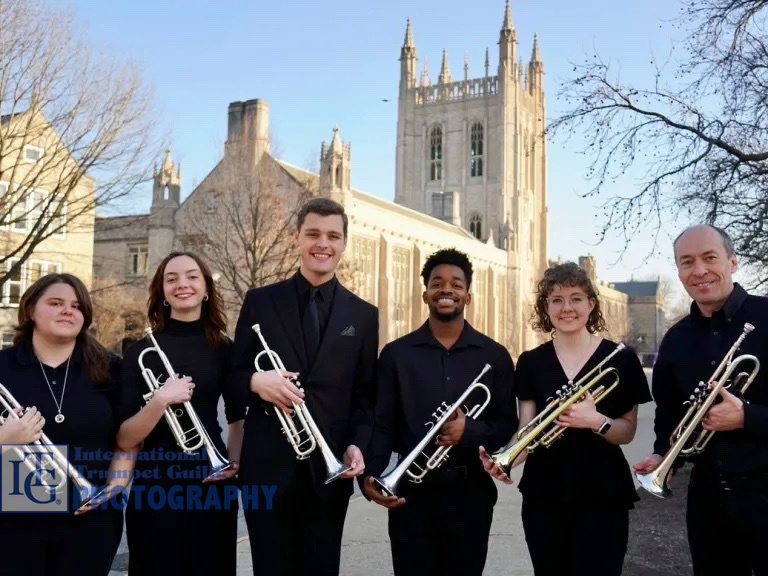
University of New Mexico - Albuquerque Trumpet Quartet
Ms. Dasa Silhova, director
Addison Bosch, Dasa Silhova, Drew Duncan, Jeremy Murphy, trumpets
Dos Tiempos by Beatriz Cordona
Little Fugue in G Minor by Johann Sebastian Bach
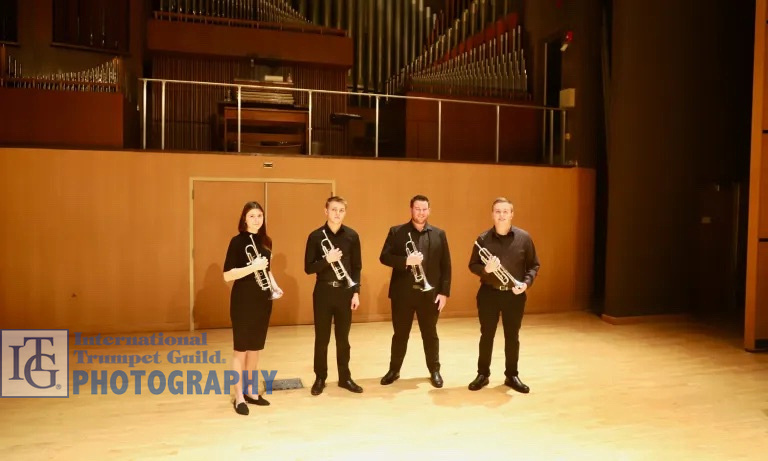
University of North Alabama - University of North Alabama Turmpet Ensemble
Dr. Joseph Gray, director
Sarah Browning, Marcus Hardy, Austin Shelton, Della Smithson, Michael Vinson, trumpets
Cityscapes by Erik Morales
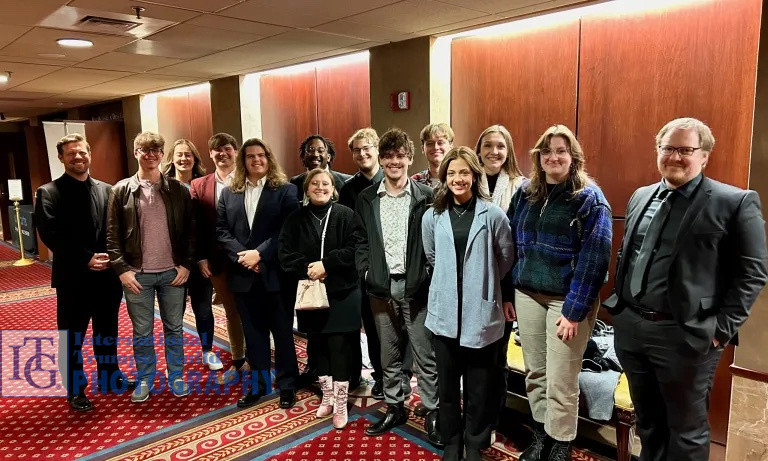
University of North Carolina - Charlotte Trumpet Ensemble
Dr. Eric Millard, director
Patrick Nguyen, Jacob Sims, J'aimee Tatum, William Wiand, trumpets
Three Miniatures by Clint Needham
Variations on a Theme of Paganini by Joseph Horovitz
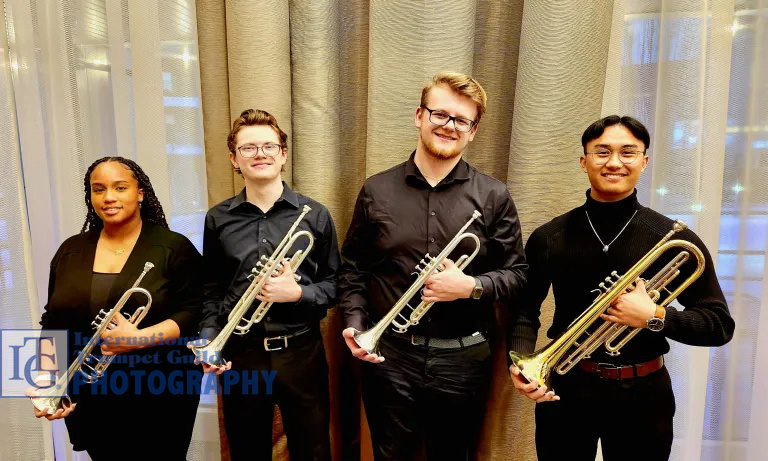
University of North Dakota Trumpet Ensemble
Dr. Cory Driscoll, director
Christopher HarriSon, Kaden Knabe, Spencer Koltes, Daniel Musselman, Hannah Thorlakson, Jaden Yeager, trumpets
Concert Fanfare by Eric Ewazen
The Barber of Seville: Overture by G, by Rossini, arr. Erik Morales

University of Oklahoma - Boomer Trumpet Ensemble
Mr. Chris Dudley, director
Kayla Adams, Christopher Dudley, Ben Egan, Drew O'Dell, Samuel Philpot, Dylan Wilson, trumpets
There's a Great Day Coming by Terry Everson
Fanfare for an Angel by James Stephenson
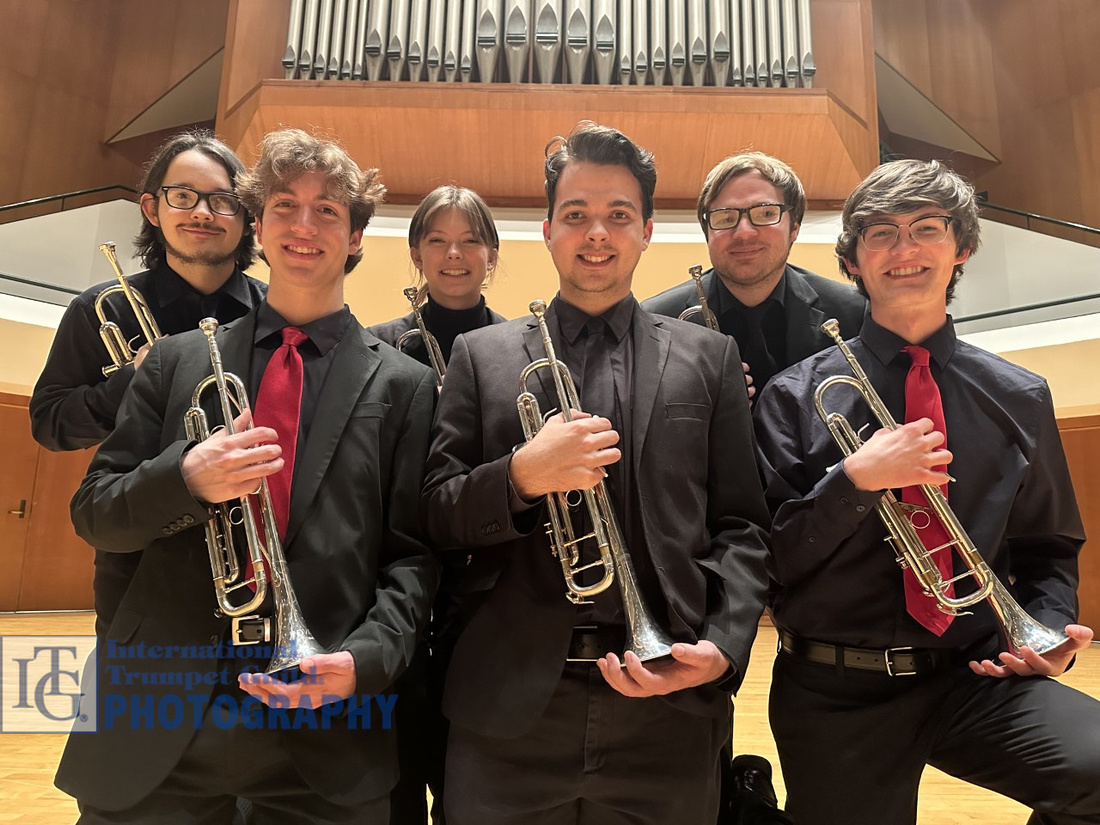
University of Oklahoma - Sooner Trumpet Ensemble
Mr. Chris Dudley (Student), director
Colby Darnell, Caleb Edney, Ian Gonzales, Myles Helm, trumpets
Something's Gonna Happen by Eddie Lewis
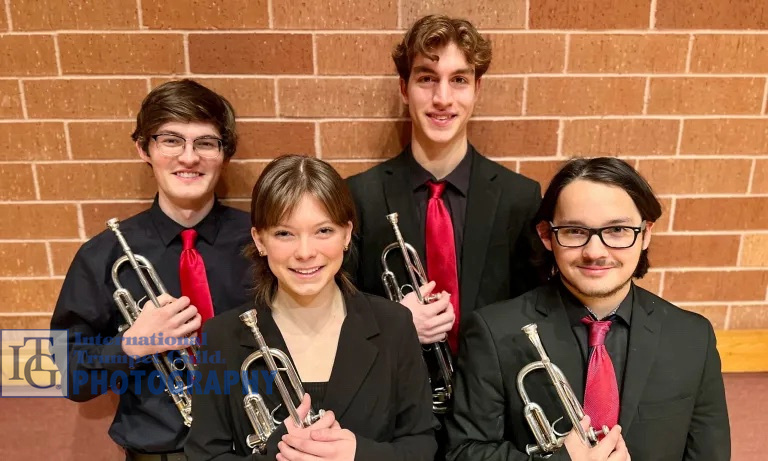
University of Wisconsin - Madison Trumpet Ensemble
Jean Laurenz, director
White Rose Elegy by Caleb Hudson

University of Wisconsin - Platteville Trumpet Ensemble
Dr. David Cooper, director
Ky Kruel, James Levan, Kyra Liske, Kilian Poquette, Madalyn Scott, Jason Slaybough, Chris Thomas, trumpets
Path of Discovery by Erik Morales
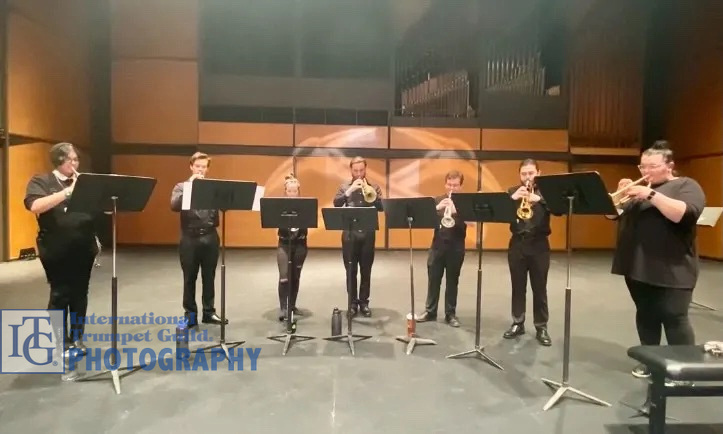
University of Wyoming Trumpet Ensemble
Dr. David Wharton, director
Tim Hosler, Darik Johnson, Sam Jones, Micah Miller, Jordan Swayze, Gerrit Worthington, trumpets
Durrenhorn Passage by Kevin McKee
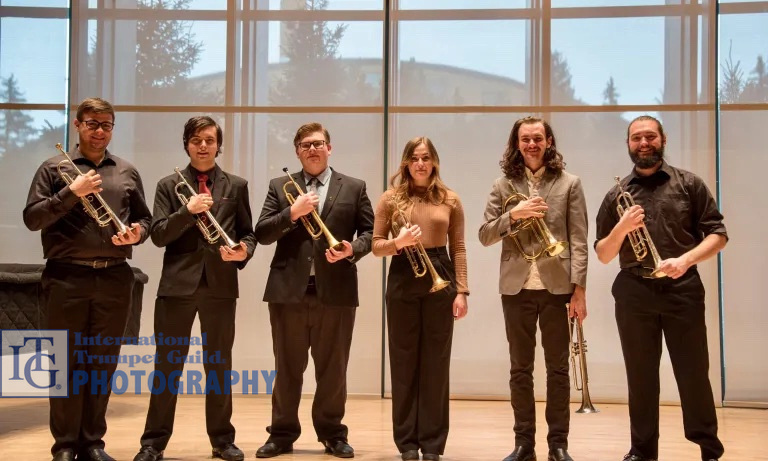
West Chester University - Wells School of Music Trumpet Ensemble
JC Dobrzelewski, director
Cacey Baker, Brendan Hartner, Colton Hibbard, Sean Jones, James Lobb, Ashley Mariani, Christian McClay, Charlotte McMillen, Dakota Palumbo, Jacie Savage, Zachary Walter, trumpets
Poet and Peasant Overture by Franz von Suppé, arranged by Marlatt
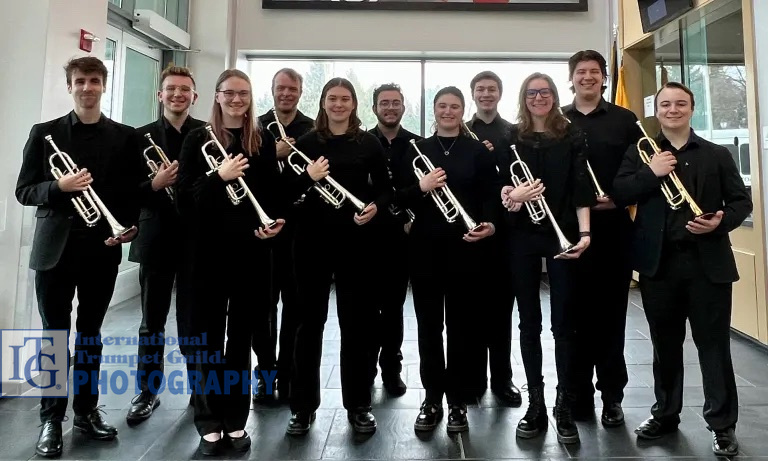
William Carey University Trumpet Ensemble
Mr. Peter Nionakis, director
Gracee Albritton, Tyler Broadway, Fernando Duron, Jade Flint, Ryan Sawyer, Trey Smith, trumpets
Trumpet Fanfare by Wes Cameron
Swarm! by Nathan Ost
Fanfare for an Angel by James M. Stephenson
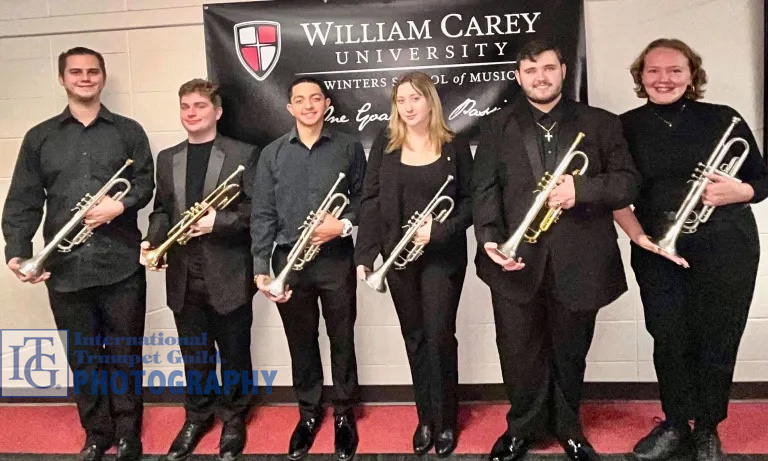
Madison Barton is currently a doctoral student and teaching assistant at Florida State University.
Julia Bell is a performer and educator located in Mobile, Alabama. She serves as the editor of the Student Corner Column in the ITG Journal and is co-coordinator of ITG New Works.
Javian Brabham serves as assistant professor of trumpet at Valdosta State University in Valdosta, Georgia, and is principal trumpet of the Valdosta and Albany (GA) Symphony Orchestras.
Spencer Brand serves as adjunct professor of trumpet and music theory at Glendale Community College of Arizona. He is also a member of the Phoenix Brass Collective and MusicaNova Orchestra.
George Carpten, IV, is the editor of the ITG Profile column for the ITG Journal and serves as assistant professor of trumpet at Ohio University.
Joseph Cooper is the trumpet professor at Oklahoma State University and has served ITG since 2017.
Stanley Curtis writes in his blog, Trumpet Journey, and serves as assistant professor of trumpet at Colorado State University.
Luis Engelke is principal trumpet with the Baltimore Chamber Orchestra and the Lancaster, Kennett, and Mid Atlantic Symphony Orchestras. He is professor of music at Towson University and Music Reviews column editor for the ITG Journal.
John Hutchinson is a freelance trumpeter, teaching at schools and universities in the United Kingdom. He is also the creator of MouthpieceOnline.com with a monthly readership of nearly 100,000 trumpeters.
Paige Kerrigan is a freelance teacher and performer in the Philadelphia and New Jersey areas and serves ITG as editor of the Product and App Reviews column in the ITG Journal.
Angela King (reporter and editorial assistant) resides in Tallahassee, Florida, where she teaches privately and performs regularly with the Tallahassee Symphony Orchestra and the Capital City Brass Quintet. She is a doctoral candidate in trumpet at Florida State University and is the educational director for the 501(c)(3) nonprofit HERo.
Will Koehler is an active teacher, clinician, and freelancer in Houston, Texas. He has worked with some of the strongest programs in Texas, and his students have found success in the National Trumpet Competition, Region Band, Region Orchestra, All-State Band, UIL, BOA, and DCI.
Christopher Luebke-Brown is a recent doctoral graduate from the University of Colorado at Boulder. He is an active educator and performer in the Northern Colorado area.
Kyle McLean is a DMA trumpet performance student at the University of Utah. He is a teaching assistant for the marching band and freelances in the Salt Lake City area.
Nathalie Mejia is a New York-based educator and trumpeter. She holds degrees from Ithaca College and the Crane School of Music at SUNY Potsdam.
Eric Millard is assistant professor of trumpet at UNC Charlotte. He also serves as the rules coordinator for the National Trumpet Competition and Book Reviews column editor for the ITG Journal.
Jeremy Perkins is a doctoral teaching assistant at Florida State University. He has a thriving private studio, where he teaches piano and trumpet.
Grant Peters is the ITG past president and professor of trumpet at Missouri State University.
Lacey Phelps has performed and recorded throughout the world. She is interim professor of trumpet at The University of Oklahoma, music recruiter at Southern Nazarene University, and director of DFW Brass.
Cindy Scaruffi-Klispie received a BM from Illinois State University and an MM from Northwestern University. She has served as principal trumpet at the Rome Opera, as well as with other orchestras in Italy and currently in Florida.
Steven Siegel is assistant professor of music at the University of Wisconsin-Superior and serves as a media reviewer for the ITG Journal.
Andrew Smith is a freelance trumpet player based out of Oklahoma City and is currently a graduate teaching assistant at the University of Oklahoma.
Richard Tirk is professor of trumpet and jazz at Southwestern Oklahoma State University. He and his wife, Suzanne, perform works for trumpet and clarinet as Duo Iona.
Spencer Wallin performs with the Orchestra at Temple Square and the American Festival Orchestra. He previously taught as an adjunct professor of trumpet in Texas.
Jodi Graham Wood (proofreader) is lecturer of music at the University of South Alabama and serves ITG as assistant editor and ad manager.
]]>Special Daily Report • Compiled by Peter Wood
Photos by Steven Garcia, Benjamin Lowe, Josh Rzepka, and Michael Anderson
Saturday, June 3, 2023
Click here for more photos from the ITG Conference
Sarah Stoneback Youth Day warm-up session - Creating Your Flexible Warmup
In Dr. Sarah Stoneback’s wonderful warm-up session for approximately 25 participants, she invited the class to brainstorm what works for our own warm-up routines in teams of three or four. After she realized her need to move beyond a set warm-up routine of fifteen years, she shared her journey to try new things. Eventually she settled on five key principles that guided a flexible approach to warming up: 1) low before high, 2) soft before loud, 3) down before up, 4) slow before fast, and 5) slur before tongue. She invited the room to try some of her own original exercises that were based on Schlossberg and the like. These exercises often incorporated a note-bending style that helped find the center of the tone and connected notes of the harmonic series. Stoneback, as always, inspired everyone to think about how we get to the next level. (Stanley Curtis)
Brianne Borden warm-up session - Mindfulness Practice for Performance Anxiety
In Brianne Borden’s early-morning warm-up session, she began with a discussion on why our bodies experience performance anxiety and the common symptoms that can accompany it. This was followed by a brief explanation on the science behind mindfulness and how it counteracts the effects performance anxiety has on our nervous system. Brianne then offered a few mindfulness practices in which the audience participated, including breathing and meditation exercises. The session continued with group leadpipe buzzing, followed by long tones that incorporated mindfulness breathing. Brianne ended the warmup by having the audience wander around the room with awareness and then connected this relaxed walking to flexibility exercises. (Kyle McLean)
Marcos García Vaquero warm-up session - Daily Routine: Focus and Organization with Marcos García Vaquero
Marcos García Vaquero’s early morning session had a few dozen eager trumpeters of all ages in attendance. With some of the slides in Spanish and the presentation in English, this was a truly international warm-up session that was informative and enlightening. Five primary points served as the foundation for the presentation–posture, breath, sound production, movement of sound, and character of articulation. Exercises by Louis Davidson, Vincent Cichowicz, Pacho Flores, and Luis González were used in the session. Singing and flutter tonguing were incorporated through the various exercises that took players through every key as well as from well below the staff to three or four ledger lines above the staff with ease and beauty. Vaquero’s teaching style and personality made for an inspiring session for all in attendance. (Lacey Phelps)
Judit Martín González session - Music and Early Childhood: Music, More than a Game (Part II): Trumpet Technique as a Game
Judit Martín González presented a fantastic interactive lecture on how to incorporate games while teaching young musicians. From beginning to end, she had the room dancing, singing, and moving as she discussed several methods that encourage students to play musically from the moment they begin learning. González used several backing tracks that she composed and recorded to teach about tone production, sound, rhythm, articulation, and harmony. By using games, González showed how students learn faster and retain more than the traditional method of working through a method book. She also showed how by using small toys like a party whistle students can see if their air is flowing while tonguing or slurring through partials. González also had volunteers help demonstrate how she uses the third Clarke study to teach harmony and chordal progressions in music. Everyone in the room benefited from the information and methods that she provided in her very enjoyable lecture. (Spencer Wallin)

Dave Wondra youth session - Expand Your Ability Through Practice That Works
Dave Wondra led an informative session on facilitating learning in non-traditional ways. He talked about how some people incorrectly believe that all they need to do is get the information and that their results will then change. He referred to this as a belief in automatic and somewhat magical (or “automagic”) change. Wondra’s message was that that method does not work well, and he went on to discuss what does work. Effective change happens through a cycle of acting, reflecting, and refining. By repeating this cycle in practice, we can move ourselves forward in ability. Wondra emphasized that improving does not mean we will not experience plateaus in our progress. To move past these plateaus, however, we must experiment with different approaches. He reminded the audience that a detrimental hindrance to effective practicing is a lack of focus, which research suggests has been caused by the digital age, and he advocated for meditation and mindfulness as a great way to train focus and attention. Finally, Wondra emphasized the importance of believing in oneself and trusting the process. (Christopher Luebke-Brown)
Joe Montelione session - Daily Routines for the Active Community Musician
Joe Montelione’s session, “Daily Routines for the Active Community Musician,” focused on how someone with a nine-to-five job outside of music can create an effective practice routine on trumpet. The importance of goal setting to plan an appropriate routine was emphasized. Montelione discussed his four areas of emphasis on trumpet–sound production, motion, valve coordination, and articulation–and how to develop a routine that addresses each area, even if for a short duration. Montelione detailed the benefits of addressing all the fundamentals of trumpet, even in a fifteen-minute practice session, and encouraged audience members to take advantage of any available time to get in a practice session. (Julia Bell)
Dani de Baza session - The Spanish Cornet
Dani de Baza engaged attendees in the history, tradition, and playing style of the Spanish cornet in this illuminating session. de Baza demonstrated the performance style on the instrument and displayed the construction of the instrument and its unique rotating valve, which changes the instrument from C to D-flat. His presentation guided the audience through a history of the instrument and its use for religious and military purposes—particularly during Holy Week, when entire bands of Spanish cornets and percussion often play for entire twelve-hour processions. With the internet, public knowledge of these bands have increased immensely. de Baza described the inspirational beginnings of his solo career, which started with a demonstration for an instrument maker and led to several international tours and recording of two albums. The session ended with de Baza sharing his new single, which features the style and music of the Spanish cornet. (Spencer Brand)
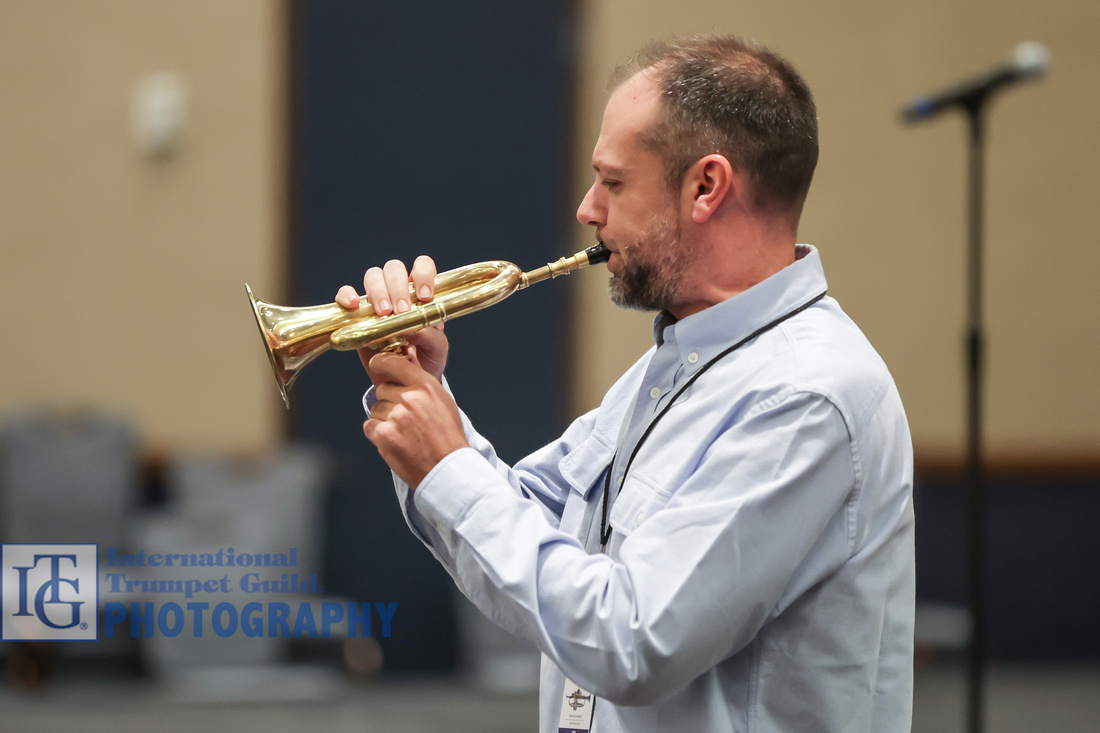
Ryan Anthony Memorial Trumpet Competition - Youth Competition: Junior Division
The Junior Division of the Youth Competition consisted of eight performers, each presenting etudes from Charlier, Brandt, and Arban. The first competitor was Ruichen Wu, who performed Arban’s Characteristic Study #5. He delivered a strong interpretation of this piece, showcasing his technical proficiency. Jiu Shi followed with Charlier’s Etude #6. Highlighted by a sweet, lush tone, he gave a passionate rendition of this work. Bryce Ogden took the stage and executed Brandt’s intervallic Etude #14 with crisp articulation. The next performer was Christian Garner, who delivered a beautiful depiction of Charlier’s Etude #4, showcasing extreme dynamic contrasts and a rich sound in all registers. Maxwell Janes followed with Brandt’s Etude #1, navigating the piece with strength and energy. Issac Jooun Won displayed his artistry with his rendition of Charlier’s Etude #6. Utilizing a tasteful vibrato and dark tone, his use of rubato resulted in a captivating performance. The next piece was Arban’s Characteristic Study #4, performed by Michelle Park, and she demonstrated fabulous finger dexterity. The final competitor was Leon Ye, performing Charlier’s Etude #6. He gracefully navigated the lyrical and technical demands of this work. Congratulations to all the accomplished young musicians; the judges definitely have their work cut out for them! (Steven Siegel)
Ryan Anthony Memorial Trumpet Competition - Youth Competition: Senior Division
The Senior Division of the Youth Competition consisted of select works from Theo Charlier’s Trente-Six Etudes Transcendantes pour Trompette. The first competitor was Amelia Kowalewska from Poland, who performed Number 2, “Du Style,” which showcased her fluidity and flexibility across the range of the trumpet. The second competitor was David Zhao, who performed Number 4, “Du Style.” Zhao demonstrated excellent dynamic contrast, along with fantastic technique and musicality. Sam Ferguson, from Canada, performed Number 10, “Du Rhythm,” which highlighted his impressive combination of lyrical and technical abilities. Ian Lee performed Number 6, “Du Style,” which showcased his warm sound throughout the range. Next, Hsueh-Yang Yang performed Number 23, “L’arpège.” Yang navigated difficult intervals and awkward fingerings with grace and agility. Genesis Ruiz performed Number 2, “Du Style,” boasting a huge, warm sound and beautiful vibrato. Finally, Jade Park performed Number 10, “Du Rhythm” from memory. This selection was performed with extreme precision throughout the lyrical and technical sections and allowed her to exhibit her virtuosic skills. (Kyle McLean)
ITG General Business Meeting
The Saturday morning ITG General Business meeting was quite an informative hour. President Jason Bergman summarized the events of Monday afternoon’s board meeting, sharing what is to come for ITG. Board member David Collins shared a new collaboration among European conservatories to send representatives to future ITG Conferences to build and support the organization’s international presence. Another initiative to boost international relations with trumpeters abroad is a move towards offering smaller regional ITG Conferences, focusing on a specific community of trumpet players in different countries. ITG Publications Editor Peter Wood announced that the ITG Journal will be moving to a full-color format beginning in October, and Website Director Michael Anderson plans to take a step back from his position to allow for someone more specialized in this area to begin updating the current ITG website for an updated and streamlined interface. (Jeremy Perkins)
Slawomir Cichor recital - Slavic Soul
Following the Luther College Trumpet Ensemble’s excellent prelude performance of Luckner’s The Spirit of the Lord is Upon Me and Jack Stamp’s Vociferation, Slawomir Cichor’s remarkable trumpet recital featured solo works by all Slavic composers. This recital showcased Cichor’s exceptional talent and artistry. From the moment he took the stage, his command over the trumpet was evident, as he effortlessly maneuvered through the diverse musical selections with precision and grace. He performed works by Grzeszczak, Lutoslawski, Fortuna, and Collins. In addition, the inclusion of Cichor’s own compositions added a personal touch to the recital and demonstrated his skill as both a performer and a composer. Slawmir Cichor’s recital was a testament to his exceptional musicianship and deep understanding of Slavic solo works for trumpet, and it also exposed the audience to a great collection of musical works that are not often performed. This was a truly memorable performance that left the audience in awe and longing for more. (Javian Brabham)

Afternoon Open Jam Session - Joey Tartell
Tartell opened the set on bass trumpet with Have You Met Miss Jones and then gave a brief, helpful welcome to participants, which included jam session etiquette. He then welcomed various performers to the stage and guided the brief talk-throughs with the soloists and rhythm section. Joey’s personality and demeanor as a teacher is perfect in this setting. He actually walked around the room and spoke with individual players, encouraging them to play. In the context of jazz education, Tartell’s approach to the jam session should be held up as a model for others to follow. This was an inclusive, welcoming environment–with an exceptional rhythm section and a gifted educator and host–which benefited everyone in attendance. (Madison Barton)
Tom Hooten session - Building a Strong Foundation: Fundamentals of Trumpet Embouchure
After a splendid prelude performance by the North Carolina – Charlotte Trumpet Ensemble, Tom Hooten presented an engaging discussion about methods to help develop your embouchure. He discussed the need to be able to talk about the mechanics and form behind healthy trumpet playing and how we need to feel comfortable discussing and trying new things. He strongly emphasized that form matters and used several non-trumpet examples of how important to continual improvement and success proper form is. Hooten shared several rules that he believes are essential for playing with good form, and conveyed how he has spent twenty years asking questions, considering context, and then searching for ways to implement changes in his playing. He ended with the advice not to accept shortcuts, but, instead, give time to your efforts and be willing to try new things even if they may feel uncomfortable. His presentation was greatly enjoyed by all in attendance. (Spencer Wallin)
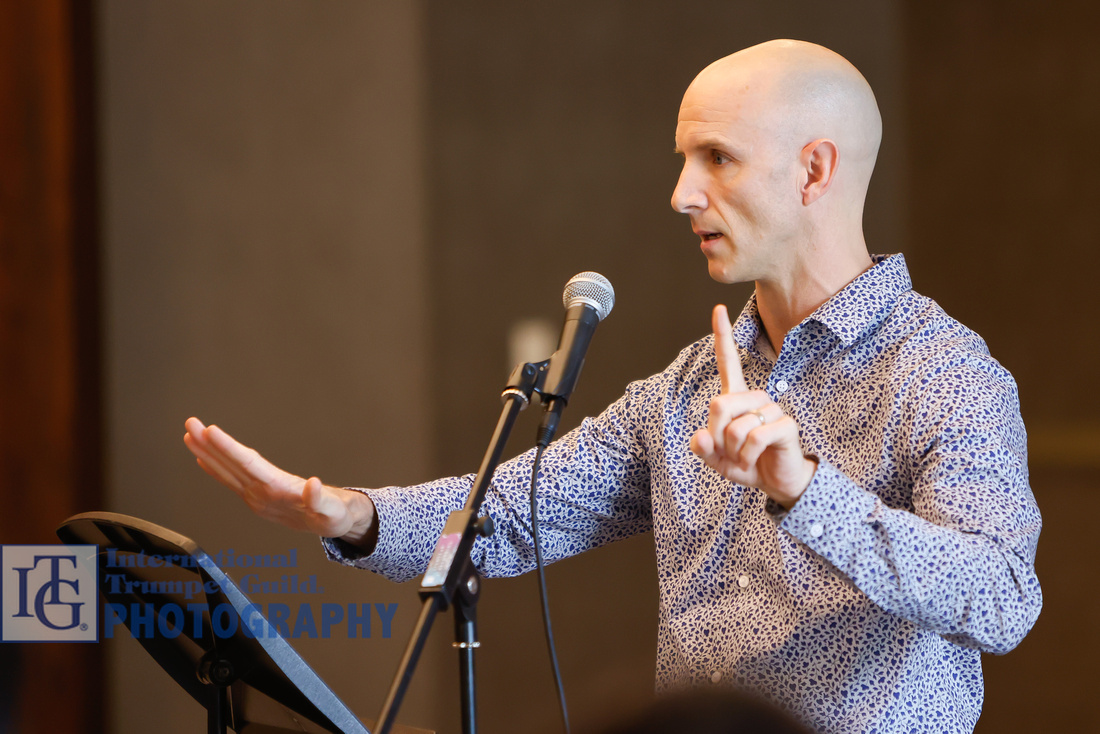
Stacy Simpson session - Making a Living as a 21st-Century Musician
In Stacy Simpson’s highly informative session, she gave the audience a brief breakdown of such careers as a university professor, orchestral performer, military performer, and a theater performer. She also weighed the advantages and disadvantages of these jobs and how their job security can vary. Simpson delved into the lifestyle of a freelance musician and how to piece together a living while hunting for a full-time “career” job. She discussed how to find available jobs, how to choose a location in which to freelance, how to secure more jobs, what kinds of performances or educational opportunities one can land, and what types of things not to do on the job. She closed her educational session with a brief layout of the financial planning required to make freelancing feasible, along with the expected tax burden that goes along with this lifestyle. (Kyle McLean)
Youth Session - Panel Discussion: Finding Success in College Audition Preparation
After an energetic performance of Jose Ursicino da Silva’s Fantasia Brasileira by the Arkansas State Fantasia Trumpet Ensemble, a room of students participated in an educational discussion on preparing for college auditions. Hosted by ITG President Jason Bergman and President-Elect Ryan Gardner, the discussion was led by a panel of successful collegiate professors, which included Brianne Bordon, Christopher Moore, Nancy Taylor, and Oswaldo Zapata. A constant thread throughout this session was the emphasis on the importance that students seek programs that align with their values and goals. The panel urged students to select schools not by their reputation, but by whether they meet those criteria. A student can successfully find a program that aligns with their values and goals by developing a positive relationship with the faculty prior to the audition, auditioning with repertoire that speaks to their strengths, and being transparent about their interests and needs. (Christopher Luebke-Brown)
Matilda Lloyd recital - Casta Diva
Ensemble de Trompetes da ESMAE filled the Westminster Sanctuary with finesse and artistry as they performed J.S. Bach’s Toccata and Fugue in D Minor (arranged by Edward Tarr and Wolfgang G. Haas) to open Matilda Lloyd’s recital. Inspired by her debut album, Casta Diva, and accompanied by pianist Maria Rutkowska, the recital featured a range of repertoire from nineteenth-century Italian opera arias to virtuosic variations on pieces that were originally composed for piano. Lloyd played with great finesse as she played various styles throughout the afternoon, showcasing her ability to change character quickly and keeping the audience engaged with the witty charm of each piece. A nice change of pace during the intermission allowed pianist Maria Rutkowska to play Artur Żuchowski’s solo Cantabile. The audience cheered in excitement as Lloyd played, and enthusiasm swept the room during each piece. (Angela King)
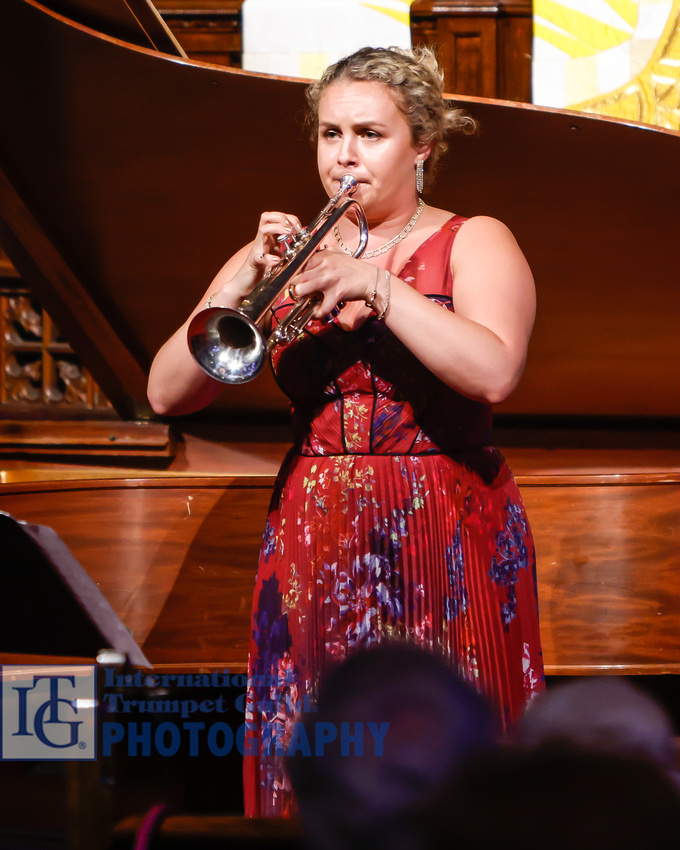
Festival of Trumpets
The Festival of Trumpets was well attended and full of varied, exciting repertoire for trumpet ensemble. The program opened with two selections performed by the Pre-Professional Ensemble, Joe Price’s Intrada Dramatica and Giovanni Gabrieli’s Canzon Primi Toni a 8. Each piece demonstrated its own distinct style, and the intensity of Intrada Dramatica created a welcome contrast to the Gabrieli. The often-deceiving difficulty of playing a Gabrieli canzona in tune and with great blend was imperceptible in the group’s performance, which was received with enthusiastic applause. The Enescu Ensemble performed “Au Soir” Nocturne by George Enescu. Featuring beautiful harmonies and lyrical passages, Enescu’s work provided a welcome slower-paced piece that showcased the beauty and lyricism that the trumpet can play. Next on the program, the Brazilian & Guests Ensemble performed two greatly contrasting selections, starting with José Ursicino da Silva’s active and exciting Fantasia Pernambucana—a true “toe-tapper.” Rogério Borges’ multi-movement No Forró do Zé Doidiça featured a lyrical opening movement, an active second movement that showcased the group’s effective dynamic contrast and ability to play in a variety of styles, and a tuneful third movement. Next on the program, the Non-Pro Player Ensemble performed David Baldwin’s Old American Songs, conducted by Baldwin. Featuring many familiar folk tunes from the traditional American canon, the ensemble performed with great energy. At this point in the program, ITG Competition Award Winners were presented with their certificates, and then the Mass Trumpet Ensemble performed Modest Mussorgsky’s “Great Gate of Kiev” from Pictures at an Exhibition as the grand finale. Featuring 38 trumpeters and conducted by Manny Laureano, this classic selection provided an exciting closer to the program. Ultimately, the Festival of Trumpets showcased the power of ITG to bring together people from many different places to make an impactful musical statement. (Julia Bell)
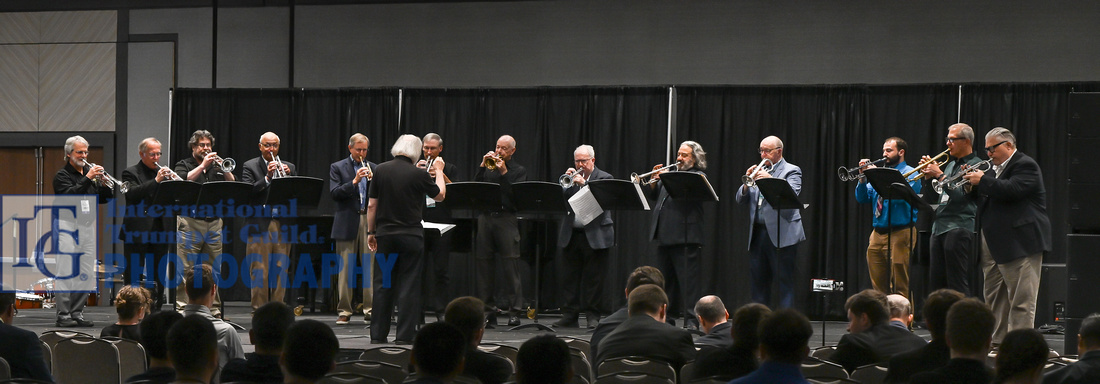
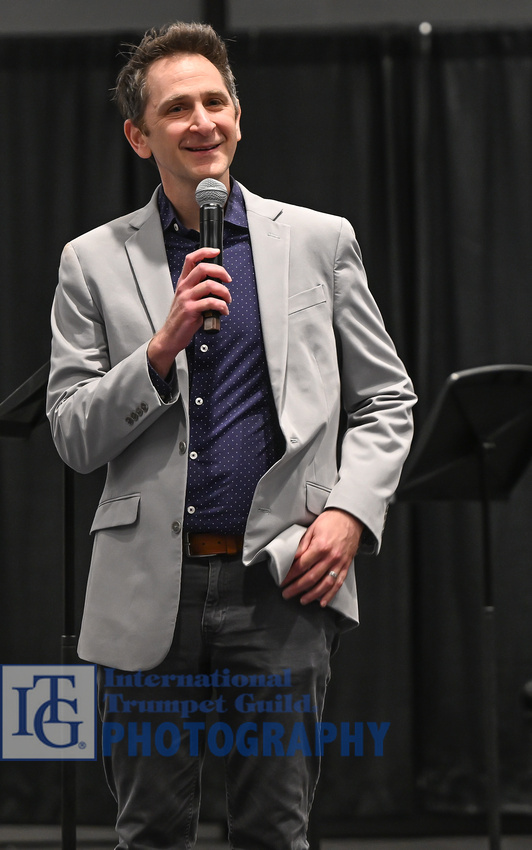
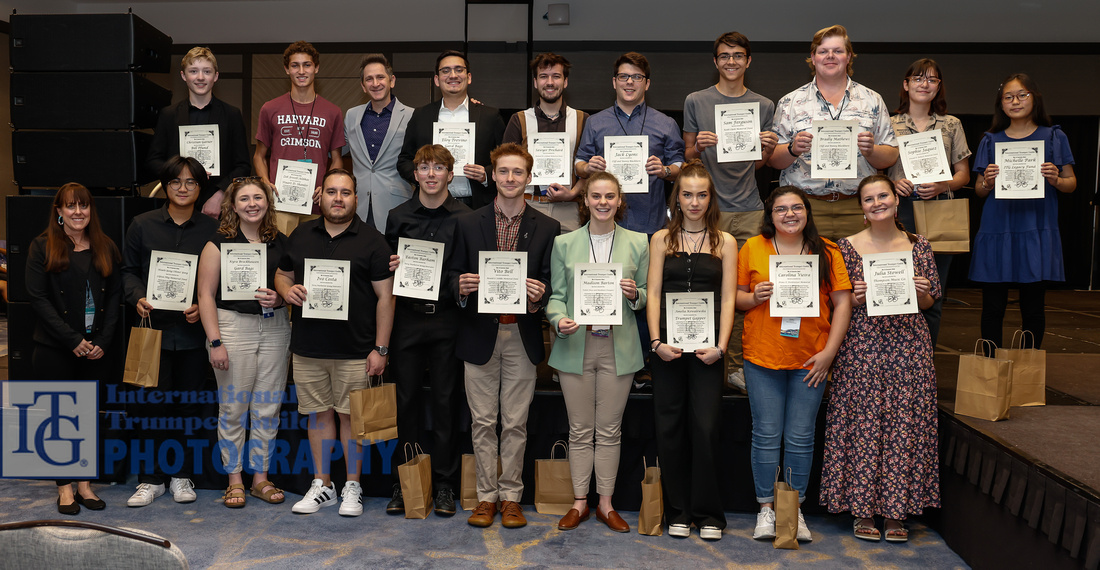
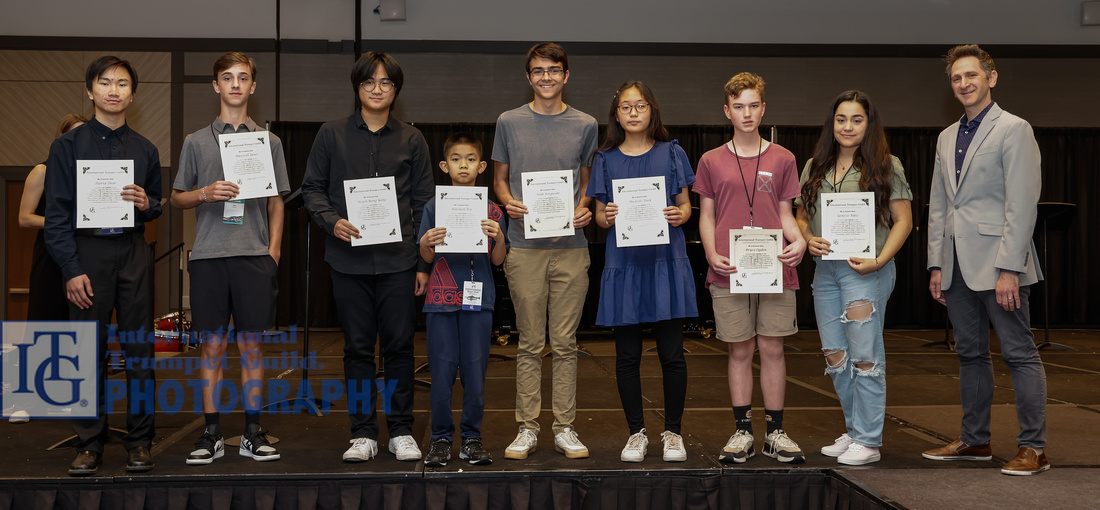
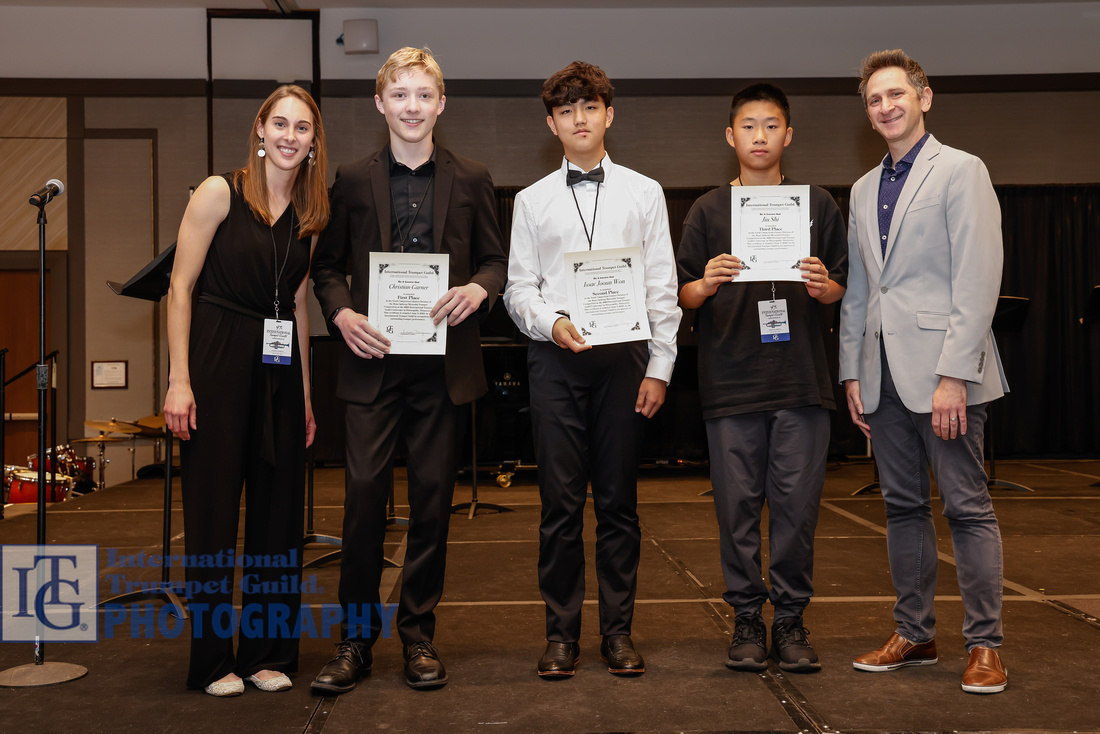

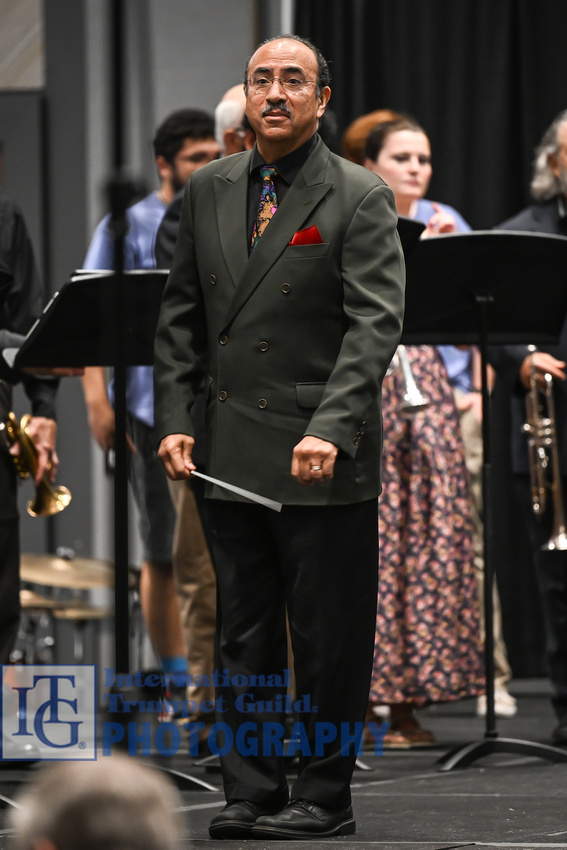
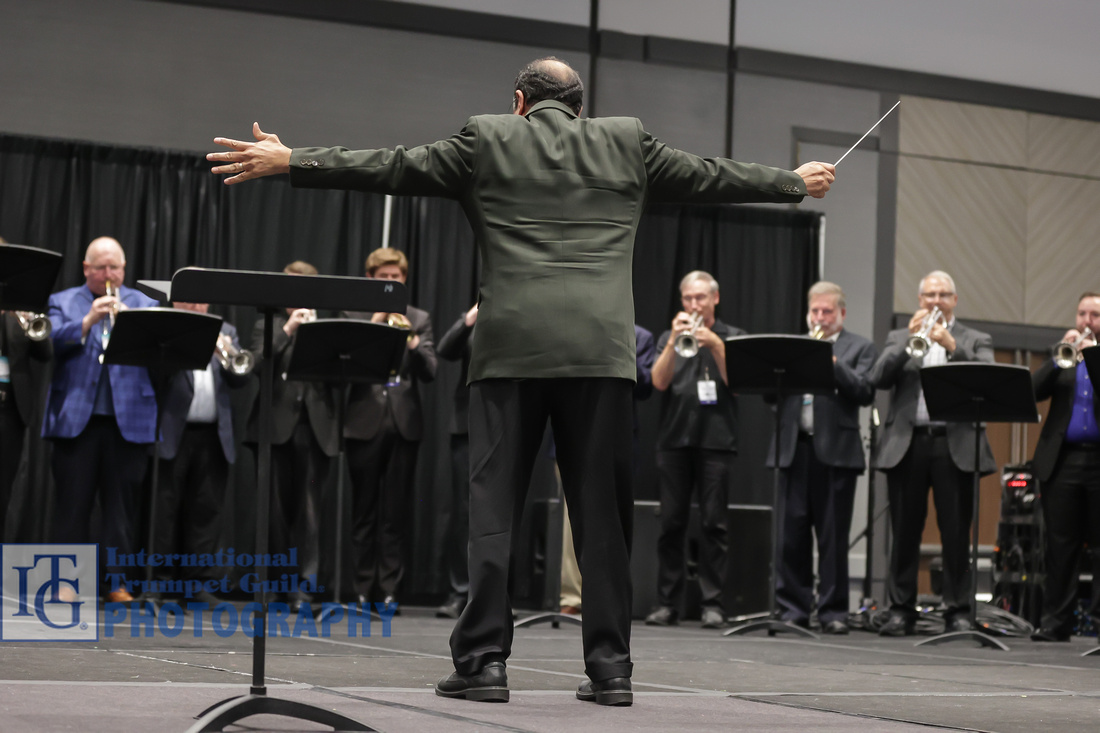
Evening Concert - Charles Lazarus and the Minnesota Orchestra: A Night in the Tropics
Just one block away from the ITG Conference hotel, Charles Lazarus and the Minnesota Orchestra gave a fabulous program in Symphony Hall. The audience in the Roberta Mann Grand Foyer was entertained before the program by the Tromba Mundi trumpet ensemble with Bryan Appleby-Wineberg, Scott Belk, Jean-Christophe Dobrzelewski, John Marchiando, William Stowman, and Joey Tartell.
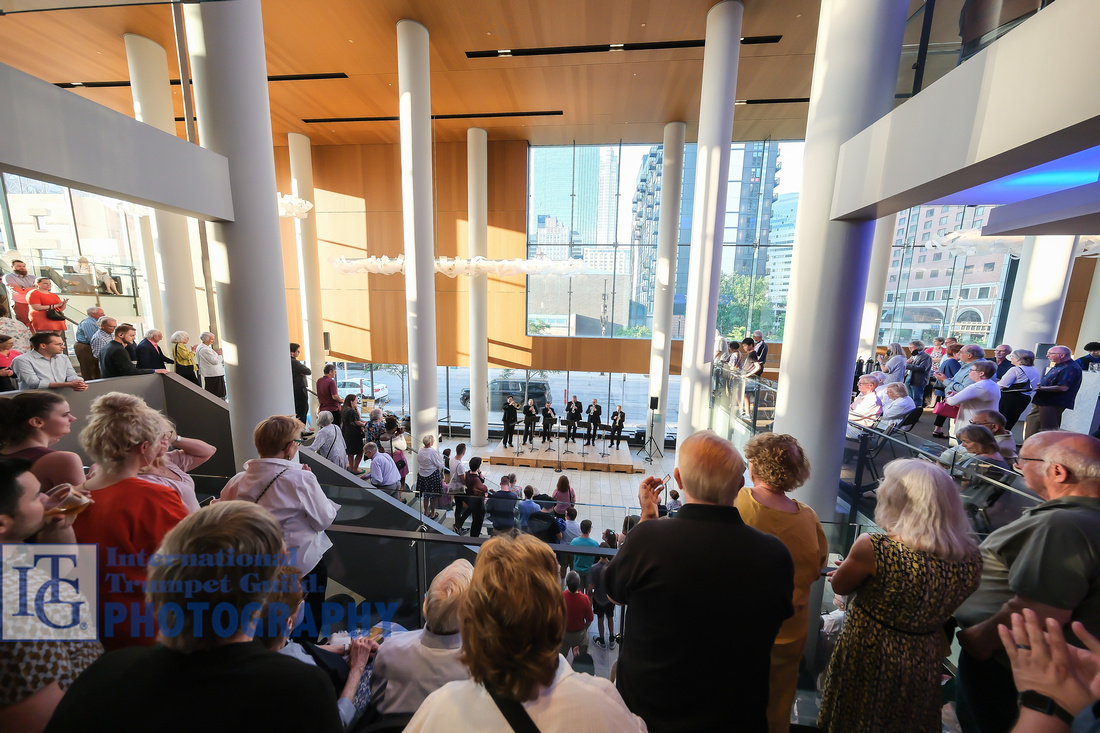
Trumpeter Charles Lazarus is a performer, composer, producer, and band leader who has played with the Dallas Brass, Meridian Arts Ensemble, and Canadian Brass. He is currently fourth trumpet of the Minnesota Orchestra, having created and produced several orchestral pops shows and made a live recording of Steve Heitzeg’s American Nomad Concerto. Lazarus has appeared as a soloist with numerous orchestras around the US and Canada; performed with the Empire Brass, New York Philharmonic Principal Brass, London Brass, and Barry White; and opened for Tony Bennett. Lazarus has performed and taught masterclasses throughout North America, Asia, and Europe.
After the orchestra, conducted by conductor Sarah Hicks, started the program with Arturo Márquez’s Danzon No. 2, Lazarus came onstage to perform his own composition, Kilauea Fountains, with his rhythm section (including Tommy Barbarella on piano, Jeff Bailey on bass, David Schmalenberger on drums, and Daryl Bourdreaux on Latin percussion) and full orchestra. Lazarus was fantastic throughout the program as both an entertainer and trumpeter.
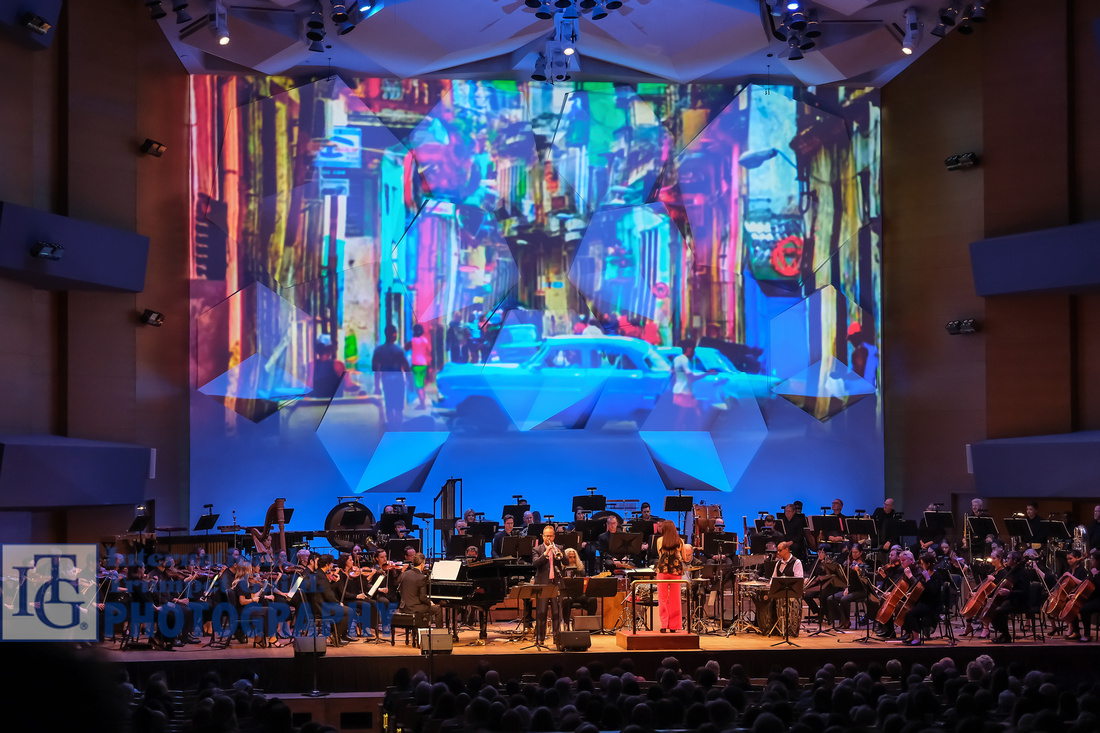
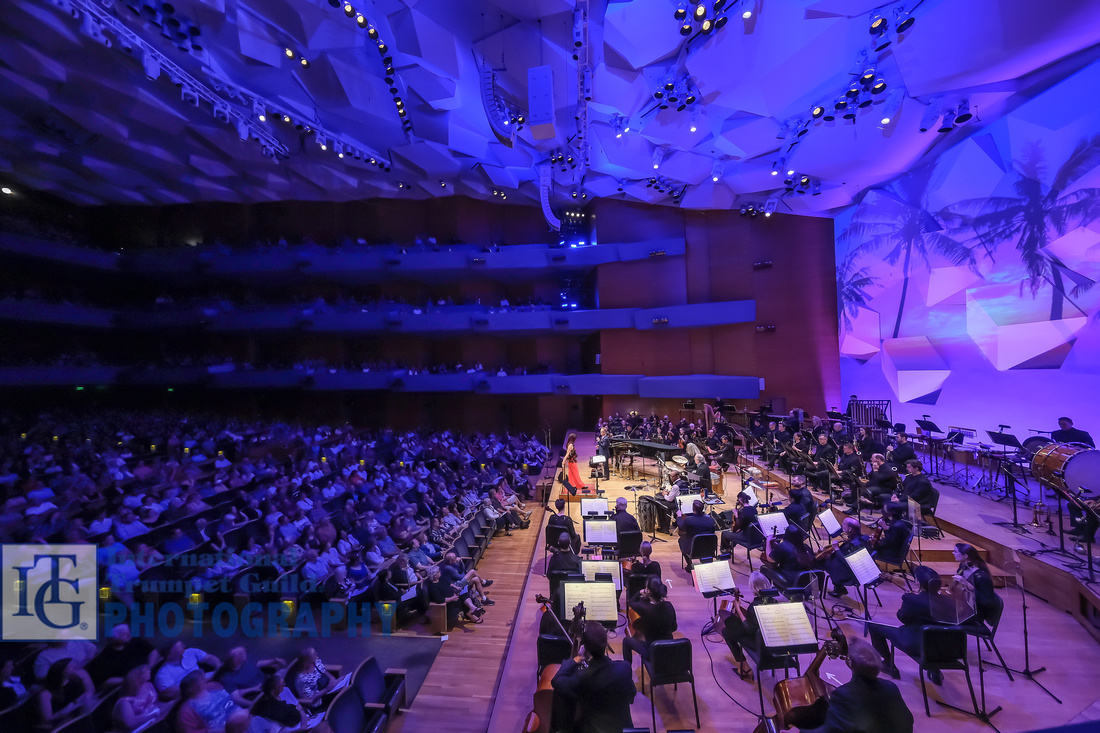
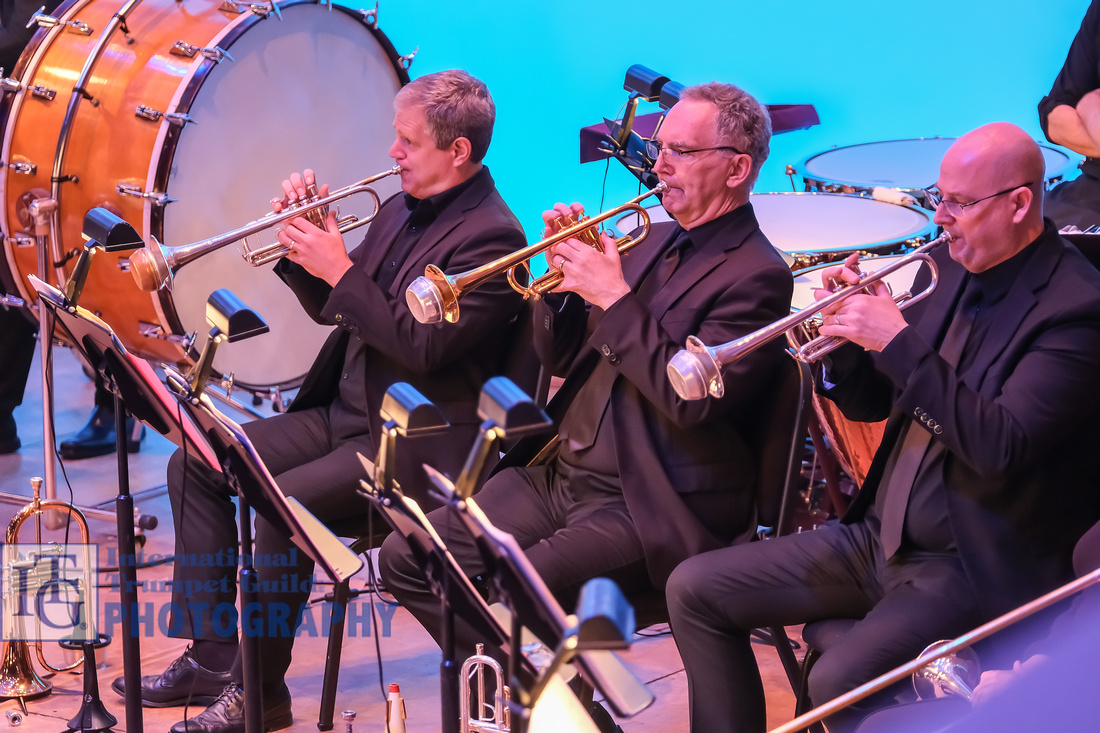
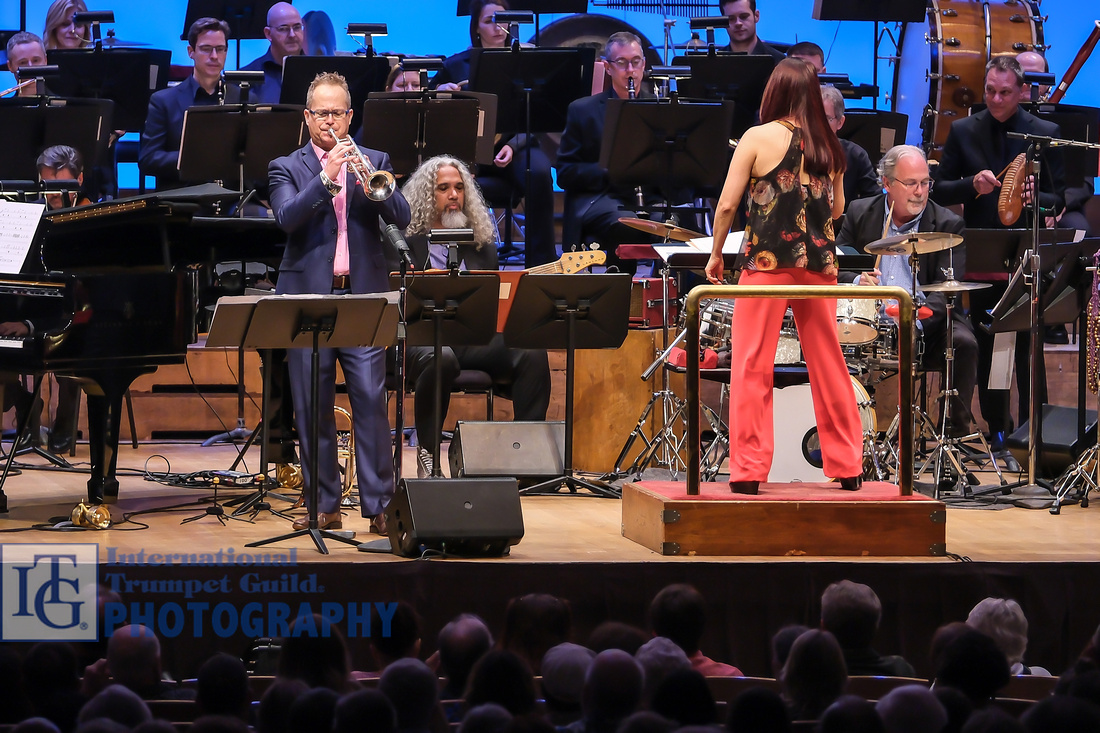
Other pieces on the program included Lazarus’s Dance Honu, Waves, Juan Tizol and Duke Ellington’s Caravan, Consuelo Velázquez’s Besame Mucho (Lazarus with associate concertmaster Alan Snow), and Dean Martin’s Sway. On Zorba the Greek, by Mikis Theodorakis and made popular by Herb Albert, Minnesota Orchestra trumpeters Douglas Carlsen, Robert Dorer, Marissa Benedict, and Martin Hodel came out front to play with Lazarus in the style of The Tijuana Brass.
After the intermission, Lazarus brought out Rex Richardson, David Cooper, and Scott Belck to trade burning solos on Tito Puente’s Ran Kan Kan, which Lazarus humorously explained meant “nothing at all in any language.” A big thrill for the Minnesota Symphony regulars was when conductor laureate Osmo Vänskä came onstage to play clarinet with Lazarus on Romani Dances, a duet written by Lazarus in a Klezmer style. Lazarus demonstrated his love of Latin jazz from the 1950s with his beautiful version of Isolina Carillo’s Dos Gardenias. After the closing tribute to Antônio Carlos Jobim, the audience was on its feet in appreciation of Lazarus’s spectacular, beautiful, and effortless playing on trumpet, flugelhorn, and piccolo trumpet all night long. He obliged the full house by playing Conrad Gozzo and Billy May’s Gopher Mambo as an encore, thrilling everyone one more time with his plunger technique and piccolo playing on this 1954 song originally written for “The Inca Princess,” Yma Sumac. Sumac had been noted for her enormous vocal range, and ITG members now know Charles Lazarus for his enormous trumpet range! (Stanley Curtis)
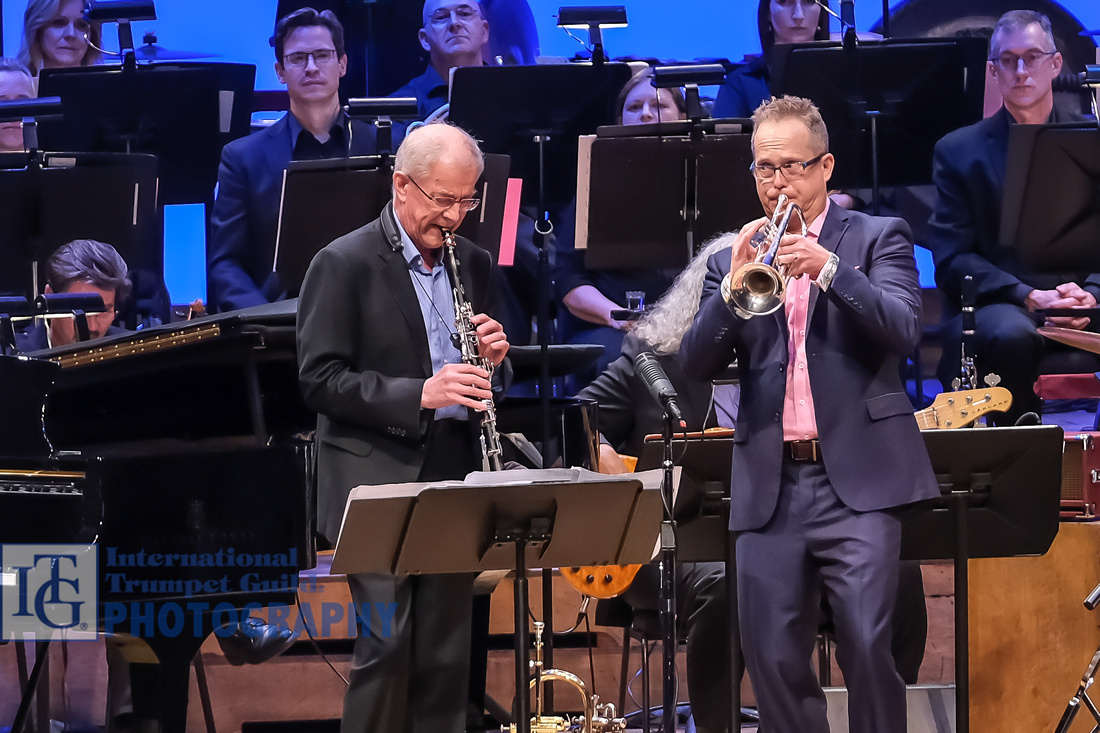
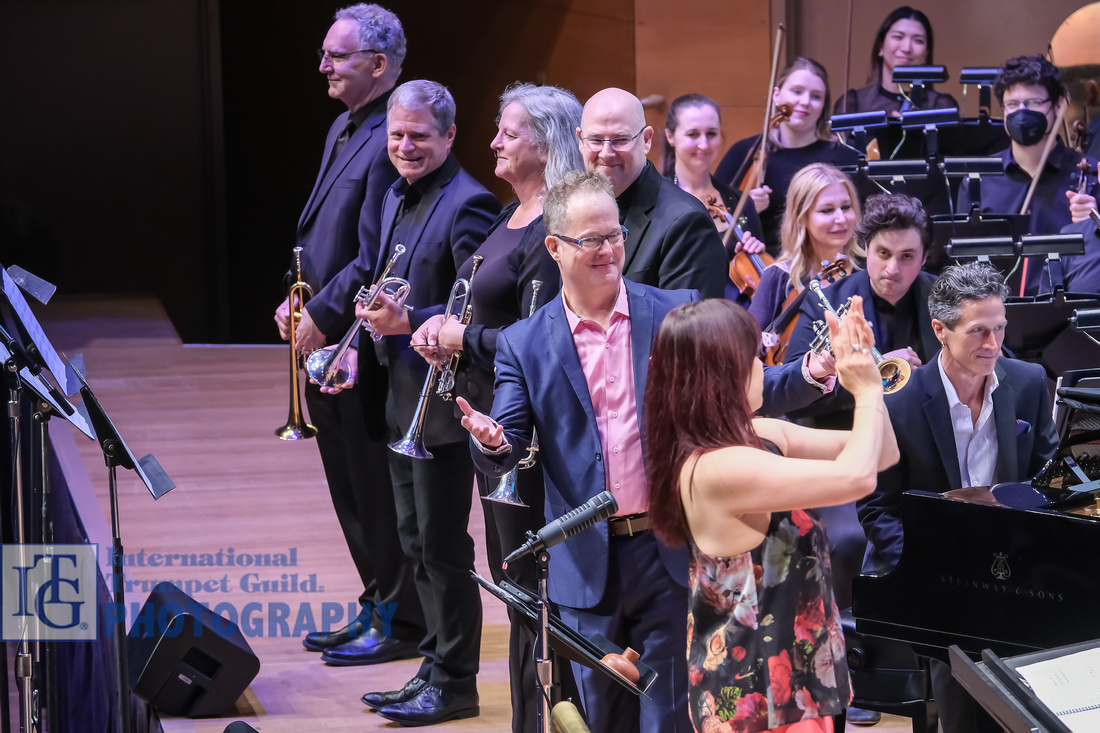
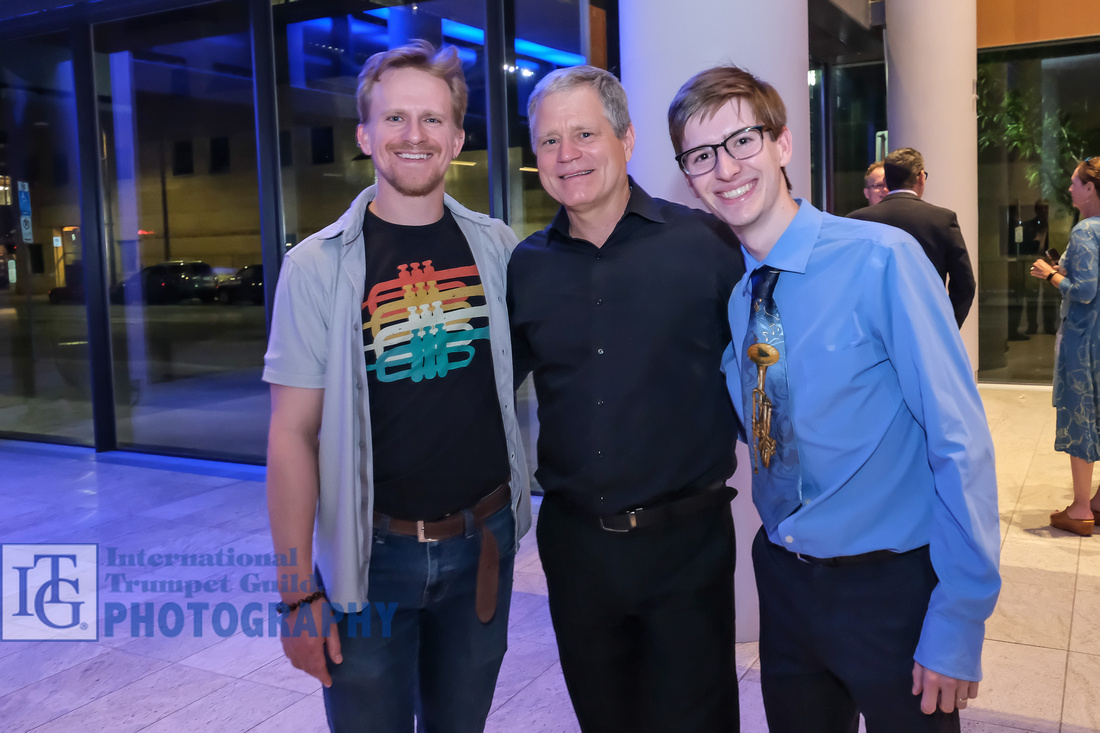
David Pastor Jazz Quartet concert: Cool Mads
After a slight delay, the final concert of the conference, featuring the David Pastor Quartet, took off like a shot. Before the group took the stage, the Escola Superior de Música e Artes do Espetáculo Trumpet Ensemble gave a stunning performance of an arranged Joaquim Campos piece. The quartet opened with a rambunctious Charles Tolliver chart, and the energy coursed through the evening from one tune to the next. The second tune in the set was the first of several Pastor originals, Visions. His sparkling solos, technique, and artistry were on full display, much to the delight of the crowd all night. Deftly backing Pastor was the Conference Trio. The mix of Pastor originals and select tunes canvassing a rich variety of styles made for a sublime close to another great ITG Conference. (Richard Tirk)
Click here for more photos from the ITG Conference
]]>
Special Daily Report • Compiled by Peter Wood
Photos by Steven Garcia, Benjamin Lowe, Josh Rzepka, and Michael Anderson
Friday, June 2, 2023
Click here for more photos from the ITG Conference
Non-Pro Players warm-up session - Christopher Moore
Friday morning saw a noteworthy start with Dr. Christopher Moore’s Non-Pro Players warm-up session. Beginning with the two solid rules of “don’t play loud” and “strive for ease,” Moore led the room through his preferred warmup, demonstrating how he approaches his “big six:” tone, technique, flexibility, articulation, range, and dynamics. Moore emphasized that each person should tailor a warmup for their specific needs and encouraged individuals to adjust each day as needed. Incorporating tone bending and glissandos between partials, the warmup focused on developing beauty in the sound and always playing with ease. He displayed finesse and refinement in his playing while also reminding all to not play loudly. He included modified Clarke studies, Irons flexibilities, Cichowicz flow studies, and more throughout the morning, concluding with extra time to answer individual questions. Christopher Moore’s session was highly beneficial for all. (Spencer Wallin)
Scott Belck youth warm-up session - The Flexibility Warm-Up Hack that THEY don’t want YOU to know about!
As a highly regarded performer, educator, and author, Scott Belck’s morning warm-up session featured exercises from his books Modern Lip Flexibilities and Progressive Lip Flexibilities, as well as slotting exercises. Belck stressed the importance of feeling when playing. With regard to warming up and practicing, Belck mentions that “The better your chops feel, the more you need to make sure you’re taking rest.” Belck stressed the importance of using a timer within a practice session to aid with endurance. His detailed approach to pedagogy, combined with the creativity of the lip slur patterns in his books culminate in an excellent pathway for students to develop more consistent flexibility and a stronger embouchure. (Madison Barton)
Warm-up session - Stanley Curtis: Being Creative with Your Warmup
Stanley Curtis, trumpet professor at Colorado State University, led a challenging and thorough warm-up class by incorporating variety and creativity into the daily routine. Guided by the idea of adaptive resistance, the overarching concept was to “keep the basics and change the material.” Curtis outlined different sources of inspiration for creative routines, including chorales/vocalises, jazz standards, scales/arpeggios, excerpts/etudes, free composition, and non-musical ideas such as art/poetry/dance. As an example, he built a warmup based around Gustav Mahler’s “Songs of a Wayfarer” with attention to embouchure stability, tone, continuity of air, finger technique, slurs, articulation, and change of registers and dynamics. The idea of using “real music” during the warmup was beneficial in that it can cover all aspects of trumpet playing and help the musician relate their fundamentals to a piece of music they may perform. Curtis’s innovative approach left attendees motivated and inspired. (Steven Siegel)
Youth Session - Jennifer Oliverio: Expanding Your Musicianship Dashboard
Jen Oliverio’s morning session focused on the importance of maintaining a sense of versatility within varying styles and approaches that we use in our respective performance mediums. Principal cornetist with the Fountain City Brass Band, Oliverio demonstrated use of fundamentals in a streamlined and accessible manner with both cornet and trumpet. Throughout, differences in tone color and vibrato were noted with similar passages. Examples of exercises focusing on tone quality, flexibilities, and range were all addressed as a means of creating a consistent and effective fundamental routine. Along with providing insight in creating an attainable routine, Oliverio touched on the realities of having strong and weak traits in one’s playing. Maintaining a sense of awareness of what works and what doesn’t is important as musicians continue to refine their craft in areas that may need continued focus. (Jeremy Perkins)
Manny Laureano masterclass - Applying Musical Rules to Orchestral Playing
The University of Dayton Trumpet Ensemble opened this event with a blazing fanfare followed by a splendid performance of the Vivaldi Concerto for Two Trumpets. Manny Laureano’s masterclass session began with a reminder of how important it is to be constantly listening to great artists. To emphasize this point, he referred to a statement in the back of the Arban book encouraging all to “seek out the most illustrious models.” Laureano briefly discussed his time as a student and how sometimes, as students, we aren’t ready for the information taught. He then described one of his most recent endeavors, a recording project entitled Section Orchestral Excerpts for Trumpet. Laureano encouraged all seeking a career in an orchestra to abide by certain rules in music and to make sure one has command of their instrument, especially when it comes to intonation. He then played some examples from this resource while sharing insightful suggestions and inspiring stories from throughout his magnificent career. (Richard Tirk)
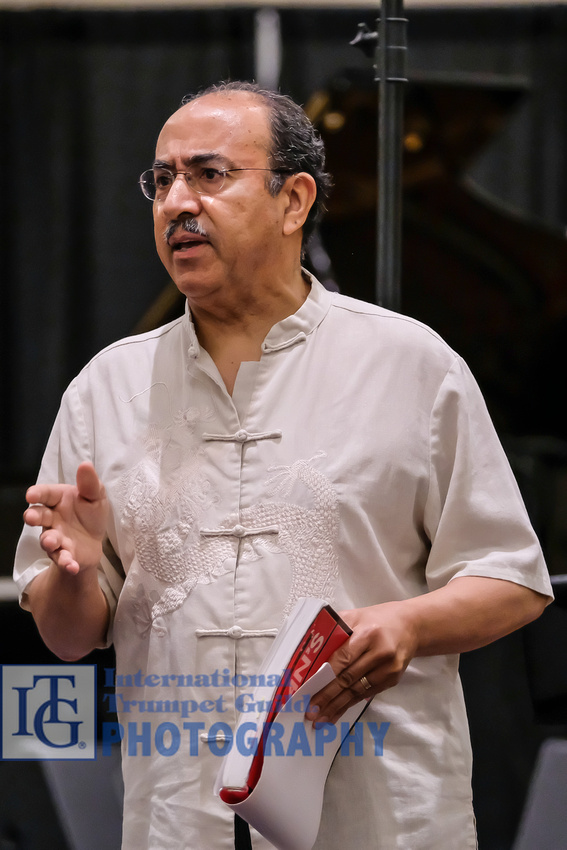
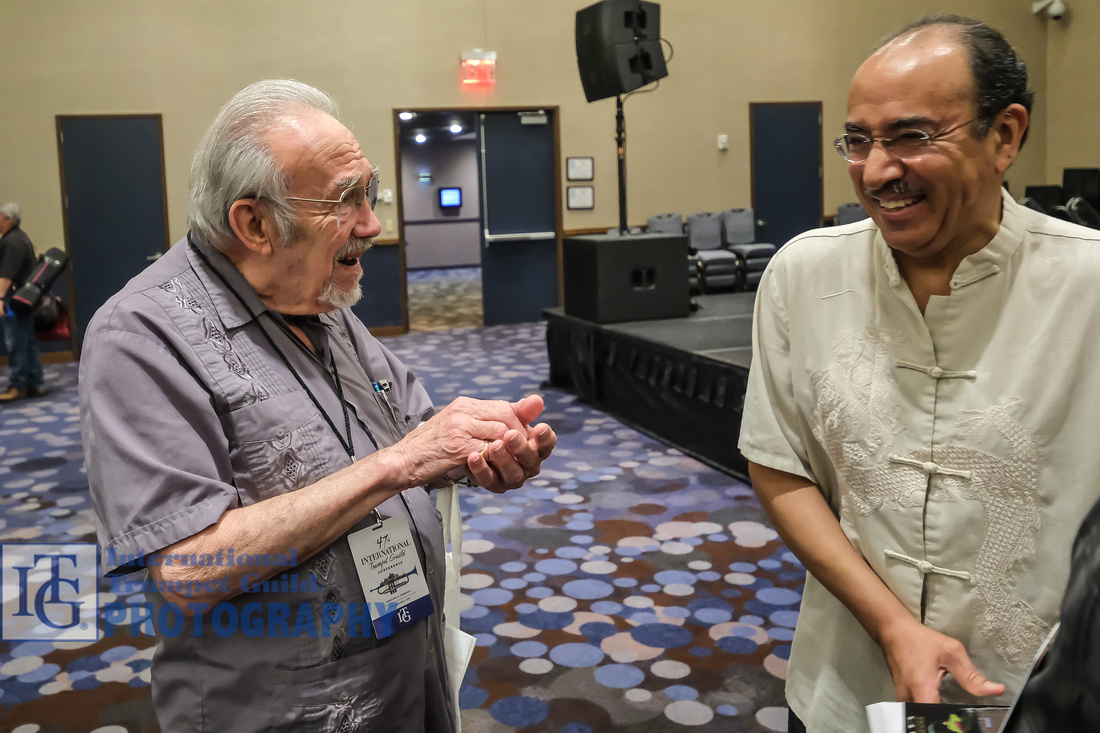
David Pastor session - The Three Fundamental Pillars of Trumpet Study
David Pastor’s presentation was both insightful and enlightening. He highlighted these pillars as crucial aspects on which every trumpet player should focus to enhance their skills. The first pillar is the importance of positioning the sound with ease. Pastor emphasized the significance of finding the right embouchure and mouthpiece placement to produce a clear and resonant sound. The second pillar, flexibility, highlights the need to develop the ability to navigate smoothly through various registers and articulations. Lastly, Pastor stressed the significance of finger mobility in all registers. By working on finger dexterity, trumpet players can enhance their technical abilities and achieve greater precision in executing fast and intricate passages. Overall, David Pastor’s presentation was highly enlightening and shed light on these key areas of focus for trumpet players aspiring to excel in their craft. (Javian Brabham)
John Cord session - College Studio Recruiting 101: How To Effectively Recruit the Modern High School Trumpeter
After Eastlake High School Trumpet Ensemble’s energetic prelude performance of Dos Tiempos, Dr. John Cord launched into a thorough presentation of his strategies for recruiting for his college studio. Starting with an overview of building studio visibility, Cord discussed effective methods for branding and developing digital and print marketing materials. He detailed ways to utilize a variety of social media and web-based platforms to disseminate a studio’s brand. He shared several of his promotional videos and discussed strategies for creating engaging media. Beyond digital recruiting, Cord addressed in-person strategies such as recruiting and performance tours and inviting prospective students to perform or participate in side-by-side experiences with current students, including hosting on-campus events. He also discussed methods for gathering contact information and communicating with prospective students and their parents. He even discussed places to find funding for recruiting initiatives. Cord’s presentation was a valuable guide to expanding and improving recruiting tactics for any applied faculty member. (Eric Millard)
Ryan Anthony Memorial Trumpet Competition: Solo Performance Division Finals
The final round of the Solo Performance Competition was a superb addition to the events on Friday morning. The three finalists, Matthew Brotherton, Grace O’Connell, and Jade Park each performed extremely well, demonstrating great musicianship and talent. The panel of judges consisted of Cynda Fleming, David Hickman, and Manny Loureano, and the finalists were introduced by the solo competition division chair, André Bonnici. Each contestant was required to perform the fourth movement (“Whale/Thunderbird”) of Catherine McMichael’s Totem Voices, as well as one of three unaccompanied pieces and a selection of their choice. Brotherton performed first and played with clean musical maturity. He had a strong beginning, contrasted with sweet, lyrical melodies throughout. He played the first movement of the Tamberg Concerto, in which he navigated the incredible technical challenges with ease and showed a clear understanding of the music. Grace O’Connell performed next and played the second and third movement of the Planel Trumpet Concerto for her selected piece. She played with a rich, full sound, displaying excellent lyrical playing with compelling musical expression, and ended with playful and articulate technique that was intertwined with beautiful melodies. Jade Park was the last to perform and played all of her music from memory. She had a lovely sound that filled the room at times and made difficult passages sound easy. She performed the Arutiunian Trumpet Concerto for her selected work, and her fast and exciting tempo was a good contrast to the graceful lyrical sections. The audience thoroughly enjoyed the solo performance finals. (Spencer Wallin)
Oscar Fernando Trujillo Gómez recital - A Musical Journey through the Country of 1000 Rhythms
The Royal Irish Academy of Music Trumpet Ensemble opened the recital with terrific performances of Vassily Brandt’s Country Picture and Nos. 1 and 4 from Anton Diabelli’s Twelve Stücke. Oscar Fernando Trujillo Gómez proceeded to dazzle the audience with his sensational tone and musicality on a program of Colombian music, highlighting some of the nation’s 1000-plus traditional folk rhythms. The program featured a variety of repertoire, including several of Gómez’s own compositions (Suite pa’Juan, Concierto for Trumpet, Tres Aires del Pacifico, and Bambuco Fandanduiao). Other works on the program included Rubén Dario Gómez Prada’s Concertino for Trumpet, Ferney Lucero Calvachi’s Yolanda, and El Duende and Batero by Daniel Alberto Moreno Vergara. Gómez paused to describe the tradition and use of the folk rhythms incorporated into each work, helping the audience immerse themselves into Colombian culture. Gómez’s brilliant playing captivated the audience, beautifully highlighting Colombia’s rich musical traditions. (Eric Millard)
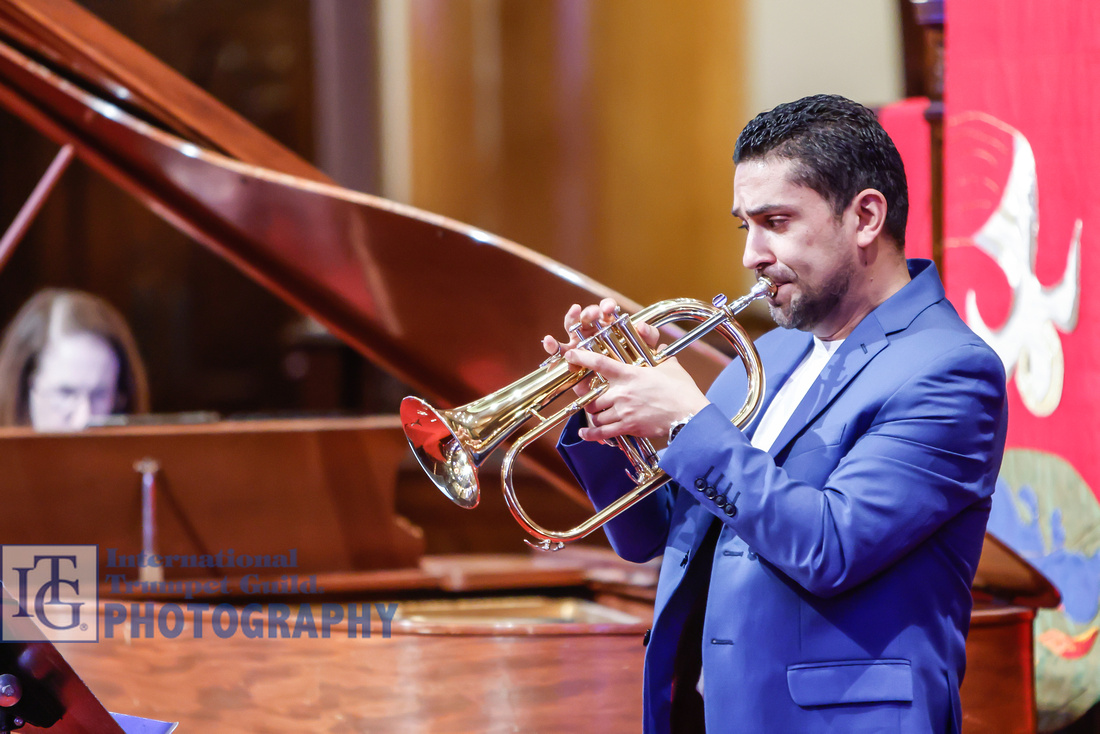
Youth Session - Matilda Lloyd: How to Perform the Best Solo of Your Life
In Matilda Lloyd’s educational presentation, she offered three main ideas to help enhance a player’s ability to perform solos. Her first and main concept was to be confident. She offered strategies to help with confidence, including using affirmations, performing a superhero pose prior to the performance, and walking onto stage with strong posture and pressure. She followed with a breakdown of her approach to involved music preparation and the method she uses to encourage confidence. Based upon symptoms she has personally handled, she then offered strategies to counteract performance anxiety. Examples included dressing comfortably, running or jumping prior to the performance to expel excess energy, and seeking more performance opportunities. Matilda recommends sticking to your strategies once you find what works for you and to make them a part of your performance-day routine. She concluded her presentation with a Q&A session. (Kyle McLean)
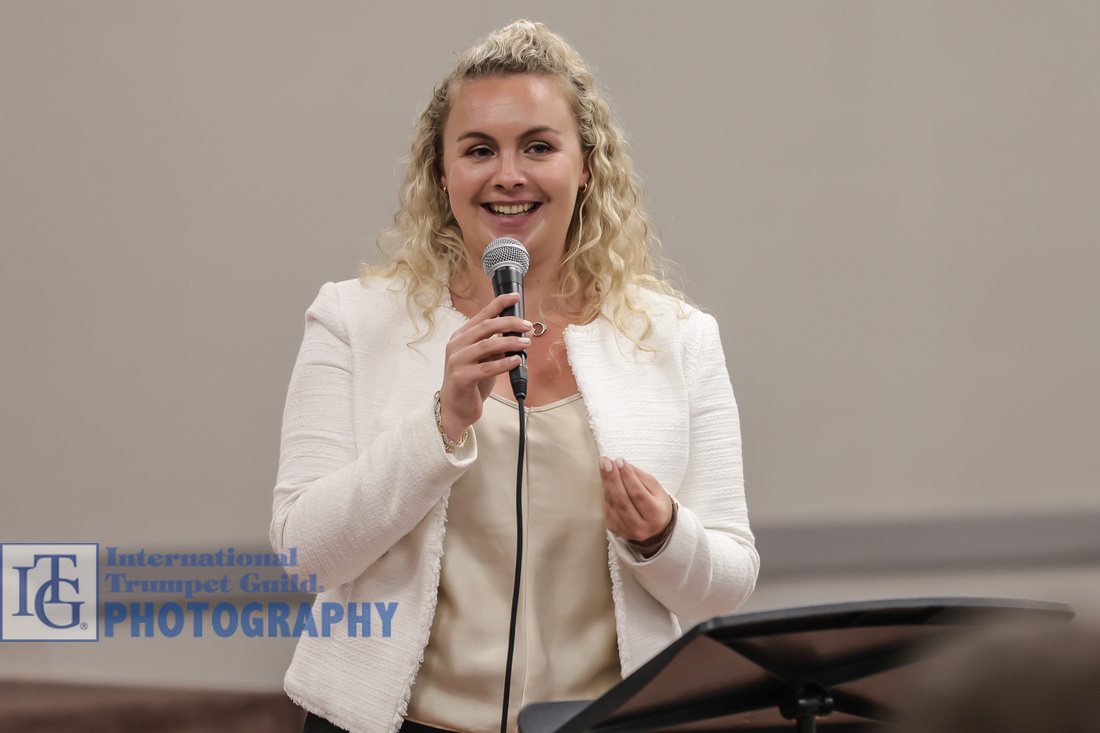
Axiom Brass lecture recital - Reexamining the Brass Quintet Experience through Diverse Programming and Interdisciplinary Collaborations
The lecture recital given by the Axiom Brass focused on reexamining and redefining the brass quintet repertoire through diverse and interdisciplinary programming initiatives. The group focused the session on madrigals written by women and other underrepresented populations, highlighting works that have never before been transcribed for the brass quintet medium. Axiom’s current album project, “Limitless,” intends to feature works from this genre and hopes to normalize their use in performance settings such as weddings, funerals, special events, etc. The ensemble also utilized visual mediums of varying sound waves in conjunction with recently commissioned works creating a multifaceted and engaging performance. Among the pieces used in this context was music from George Walker’s Music for Brass, which was notably effective among attendees. The ensemble intends to continue pushing the boundaries of brass quintet repertoire whether it be through diversity in programming or exploring relationships between visual and aural expression. (Jeremy Perkins)
Oswaldo Zapata lecture recital - Bridging Borders: New Latin American Music for Trumpet and Piano
Following a lush performance of Jimmy Van Heusen’s Darn That Dream and Vladimir Vasilevsky’s Variations in Flamenco Style by the Mizzou Trumpet Ensemble from the University of Missouri, Dr. Oswaldo Zapata took the stage for his fantastic lecture recital on New Latin American Music for Trumpet and Piano. Zapata began by introducing the influences from African, Indigenous, and European music on Latin American music of today, including video and audio samples of these types of music. Between each piece, Zapata demonstrated the rhythmic elements from specific Latin styles (including Huayno, Maraçatú naçao, Baião, and many more) that the composers used in each of their works. Before playing his own gorgeous arrangement of Libertango with Garrett Klein at the end of the recital, Zapata exhibited many popular Latin artists who have bridged the cultural divide, influencing American music and culture. (Spencer Brand)
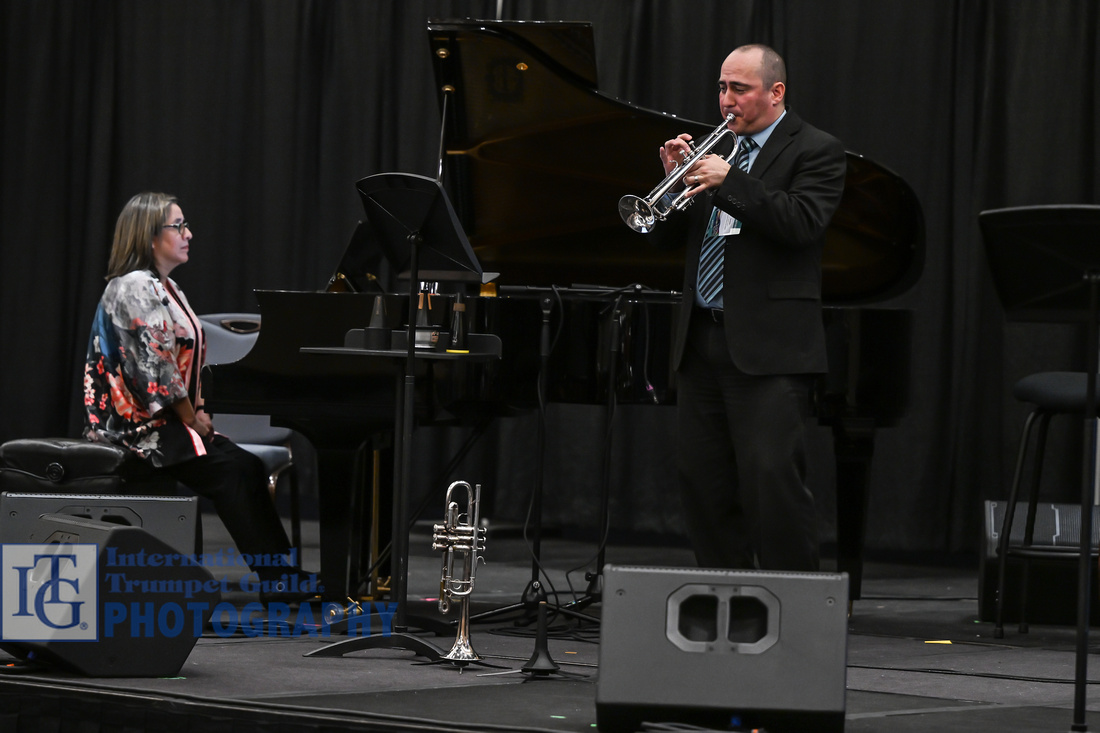
New Works Recital III
The third and final New Works Recital of the conference opened with the Southwestern Oklahoma State University trumpet ensemble performing Giovanni Gabrieli’s Canzon Septimi toni à 8 No. 1 and Eric Fregoso’s Celestial. The ensemble navigated the intricate works with gusto and confidence.
Benjamin Horne’s Buzz Buzz is a playful work for trumpet, flute, and piano. The chromatic theme, partnered with trills, was reminiscent of Flight of the Bumblebee. Performers Michael Brown and Lorin Green balanced each other perfectly, matching dynamics, style, and articulation. The humorous middle section, intended to be a “state of inebriation,” provided an enjoyable contrast to the energetic conclusion of this work.
Juan Carlos Valencia Ramos’s Parallel was performed brilliantly by John Kilgore and Rebecca Wilt. Traversing between Western European and Latin American elements, the performers provided an emotional and heartfelt rendition of this work. Scoops, pitch bends, and flutter-tonguing enhanced Kilgore’s musical statements, but he surprised the audience with foot stomps and even screaming. Overall, the rhythmic intricacies and dance-like melodies created a wonderful, enjoyable piece for the trumpet repertoire.
Hope Salmonson’s Salutation Over Fractal Ground is a programmatic work depicting how light reflects off a snowy landscape: first the moonlight, causing a crystalline glimmer, and then the sunrise, glowing warmly and painting the snow with beautiful pastels. Christopher Keach portrayed the meditative opening brilliantly with a soothing tone, creating seamless timbre transitions between the trumpet and piano. The upbeat second section was displayed eloquently, depicting the imagery intended by the composer.
Francis Snyder’s Sharps, Flats, & Orange Cats depicted the personality and various moods of a rotund cat. The four short movements “Ham Time,” “Sunspot,” “Through the Window,” and “Zoomies” created an enjoyable and light-hearted work. The usage of different mutes to create timbre changes and the ever-changing tonalities of the third movement were intriguing. Angela King presented a convincing performance as she navigated through various styles and the pointillistic melody of the final movement.
Trenton Rhodes’ Solitude showcases the “Tristan chord” to signify a dreamy ignorance and represent questions going through the composer’s mind, such as “What is going on?” “Why is this happening?” and “Will it ever be ok again?” Ross Alhorn’s sweet tone accompanied by the lush harmonies of the piano portrayed this atmosphere. The middle section of this piece transported the listener through a plethora of emotions from jealousy to joy. Alhorn’s crisp articulations and impressive power helped drive toward the climax before the piece concluded in a similar fashion to the start.
Linas Rupšlaukis performed his own composition, The Gambler, which won the Lithuanian Composers Union competition in 2017. As Rupšlaukis stated in the program notes, “Every time you perform, you gamble a little for a higher quality, a more powerful expression, or a deeper content.” Rupšlaukis flawlessly negotiated the intervallic melodies and made some of the most technically demanding passages sound easy. His artistry was on full display, and his musical risk-taking paid off in this performance.
Kenley Kristofferson’s The Stars of November is another programmatic piece that portrays the myriad of emotions felt by the parents of a baby who was diagnosed with Potter’s Syndrome while still in the womb and came into the world stillborn. The solemn introduction foreshadows the sorrow to come, but there are moments of excitement and joy intended to portray the hope of welcoming a new life into the world. Kayla Solomon and Danielle Guina delivered a powerful performance with great passion and fortitude.
The recital concluded with Jesse Cook performing the second and third movements of Imagined Conversations by Zack Stanton. Based on the idea that forms of communication and how people build relationships are rapidly changing, especially with social media, each movement is loosely based on the idea of human communication/relationships with the overall trajectory being one of hope. Feelings of unsettledness are created in the second movement by the conflicting rhythms between the flugelhorn and piano performing simultaneously. Cook captured the audience’s attention by displaying his rapid finger dexterity and strength leading to an exciting conclusion on piccolo trumpet. (Steven Siegel)
Merrie Klazek session - Trumpet Around the Sun
The trumpet quartet from the Crane School of Music kicked off this session with a stylish and accomplished prelude performance. Merrie Klazek’s “Trumpet Around the Sun” project brings together musicians from across the globe and presents listeners with the opportunity to hear the trumpet in settings that perhaps we would not expect at first. Several years in the making and involving 25 musicians from 14 different countries, the music spans 400 years, 15 countries, and 6 continents. This spectacular endeavor takes listeners on a musical journey with incredible lyricism. The theme of “Music as a Global Connector” becomes particularly poignant as we hear about Merrie’s work and processes to bring this wide-ranging project together. An important message is the unity across international borders to create wonderful storytelling through music. (John Hutchinson)
Peter Pickett session - So You Want to Go into Business?
“The Game of Life for Musicians” was a joyous, funny, and informative presentation by Peter Pickett, the owner of Pickett Brass. The session began with the selection of four volunteers who were each assigned a role for the “Game of Life,” which included a professional player, business owner, job/regular employee, and trumpet professor. Pickett emphasized that though we may have specific plans, things often change and, of course, “life happens.” Illustrations of life choices, jobs, finances, luck, job loss, taxes, medical issues, unexpected changes, cars, housing, and family were presented, and the session ended with an insightful and delightful question-and-answer session. Attendees were encouraged to plan for change and to develop the ability to adapt to “life happening” in order to be successful and ultimately leave a legacy greater than ourselves. (Lacey Phelps)
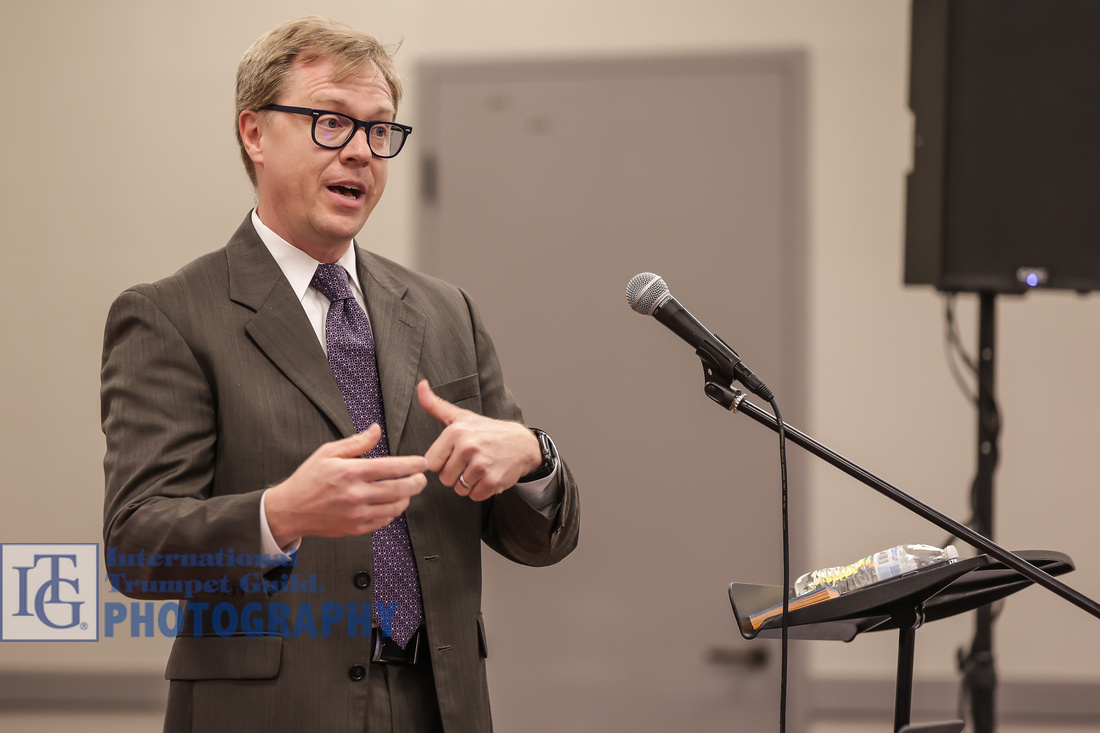
Ryan Anthony Memorial Trumpet Competition: Chamber Music Division Finals
Among the sixteen groups that applied to the thirteen semifinalists, the final round consisted of four ensembles that all performed at an exceptionally high level. Each ensemble was allotted ten minutes to perform whatever musical selections they wanted, and this resulted in a beautifully contrasting program. First to compete was a trumpet sextet from Escola Superior de Musica a Artes do and they performed Jorge Salgueiero’s Fanfare Festivo. This colorful and expressive work showcased a homogeneous sound across the ensemble. Their second selection, Erik Morales’s Conquest, demonstrated the commanding and exciting character of the ensemble. Lux Brass from Baylor University prepared three selections for their portion of the competition. From the exciting and pristine opening of the Malcom Arnold Quintet, to the tenderness of “Somewhere” from West Side Story, and ending with the intense and intricate Mini Overture by Lutoslawski, Lux Brass showcased a wide range of musical maturity. The Michigan State University Trumpet Ensemble brought new life to well-known and demanding French etudes in their performance of Bitsch’s Brew by Connor Johnson. The familiar melodies were executed at a high level and were interwoven with original material that complemented the source material. The final competitor was the UCLA Trumpet Ensemble, performing Dimitri Shostakovich’s String Quartet No. 8, arranged for six trumpets. The eerie, yet beautiful, character of the opening was complemented by the fiery passion of the latter half of the quartet. (Will Koehler)
Clément Saunier recital - French and Contemporary Trumpet Repertoire
Following the well balanced, highly energetic, and very exciting prelude performance by the Duquesne Trumpet Ensemble, under the direction of Dr. Chris Wilson, of Tony Plog’s Contrast for Five Trumpets, French trumpeter Clément Saunier presented a robust program of French and contemporary musical works for trumpet. The pieces included on Saunier’s recital are considered some of the most challenging in the trumpet solo repertoire–those by Jolivet, Tomasi, Gaubert, Berio, Henze, and Erikson. Throughout the recital, Saunier and his collaborative pianist, Maria Rutkowska, displayed an incredibly impressive level of musicianship and virtuosity. Saunier’s sound was clear and resonated throughout the Westminster Church sanctuary. The audience was enthralled by the performance and showed their appreciation by giving an extended standing ovation. (Javian Brabham)
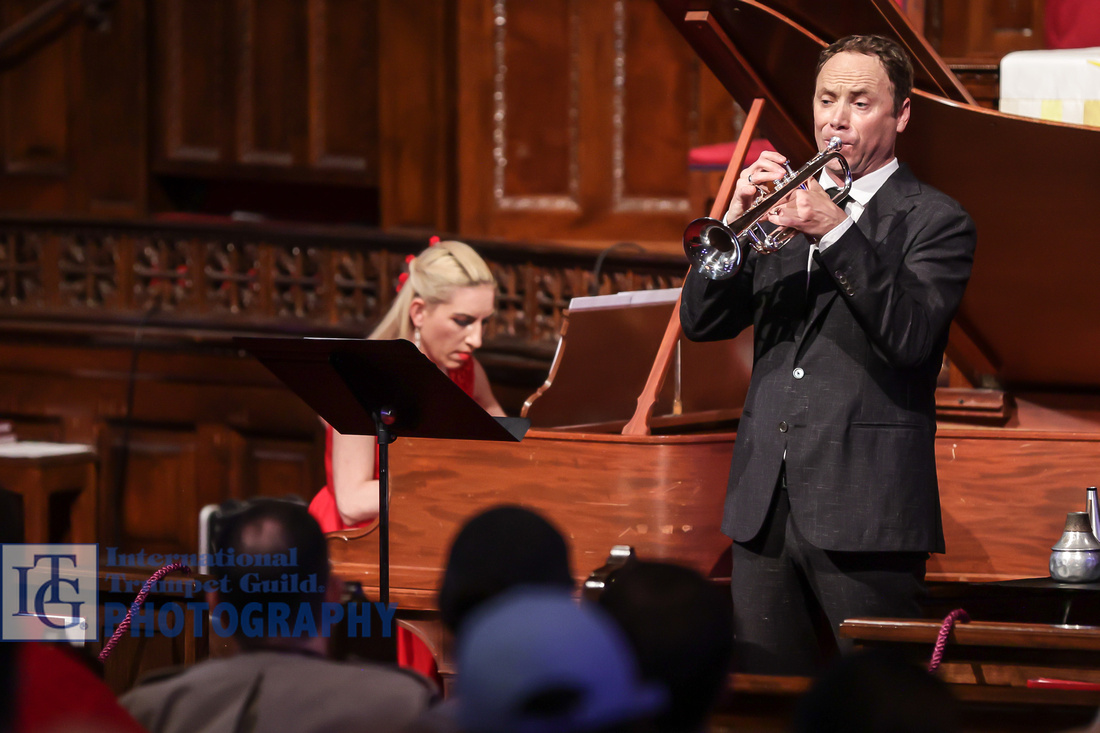
Jean Laurenz session - DESCENDED: A Multidisciplinary Exploration of Music, Film, and Narrative
In this session, Jean Laurenz presented her film Descended and answered questions regarding the creative process of the making of the work. The film is an abstract ghost story based on the life and work of Lafcadio Hearn, a nineteenth-century writer and cultural preservationist. In the film, the trumpet represents the spirit of the next stage of the main character’s life, and the voice is representative of the female presences in Hearn’s life. There are many calls to symbols in Hearn's writing and Japanese texts throughout the film, such as the use of mirrors, eyes, water, and shadows. This striking work has won numerous film festival awards and showcases Laurenz’s multifaceted artistic endeavors. (Nathalie Crissela Mejia)
Michael Sachs session - Preparation and Performance of Standard Orchestral Repertoire
The Albuquerque Trumpet Quartet from the University of New Mexico played an exciting arrangement of Johann Sebastian Bach’s Little Fugue in G Minor and Beatrix Cordona’s beautiful Dos Tiempos to open the session. Michael Sachs, who has held the principal trumpet position with the Cleveland Orchestra for 35 years, then discussed his thoughts on excerpts and the various ways that he approaches trumpet playing in an orchestra through excerpts from Pictures at an Exhibition, Petrouchka, Concerto for Orchestra, and Leonore Overture No. 2. In Pictures, Sachs finds the intervallic relationships between all the notes. His goal is to match the shape of each note from beginning to end. When practicing Petrouchka, Sachs creates sequences resolving the downbeats of each beat to find consistency in sound and style within a simple outline of the excerpt. Within the Bartok, Sachs stays true to the articulations and dynamics, stating that the muted section needs to have a “nasal sound” to truly capture the style of the piece.
Some of Sachs’s most important suggestions were the following:
- Sound is the most important element in winning an audition.
- Make a plan!
- Find recordings of great players and begin to learn the dynamic and rhythmic contrasts.
- Understand your role within the piece, the intonation tendencies within the orchestra, the style of the piece, the articulation that is right for the acoustical environment, and the color used within the piece in order to truly understand it.
(Angela King)
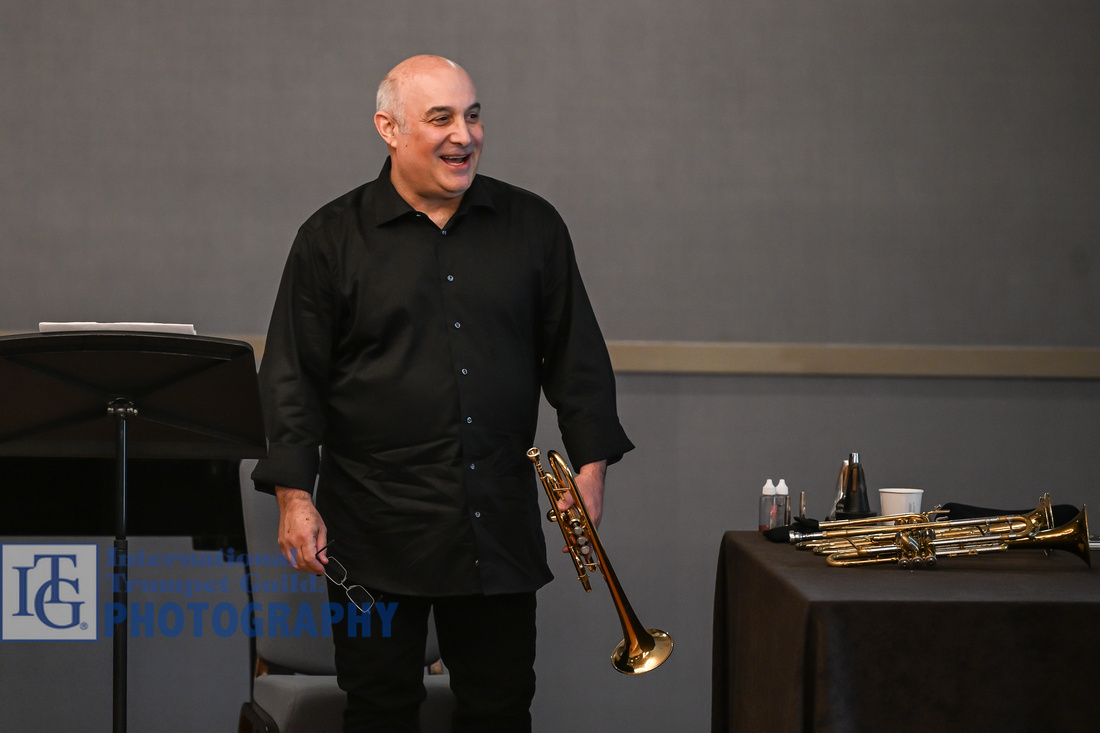
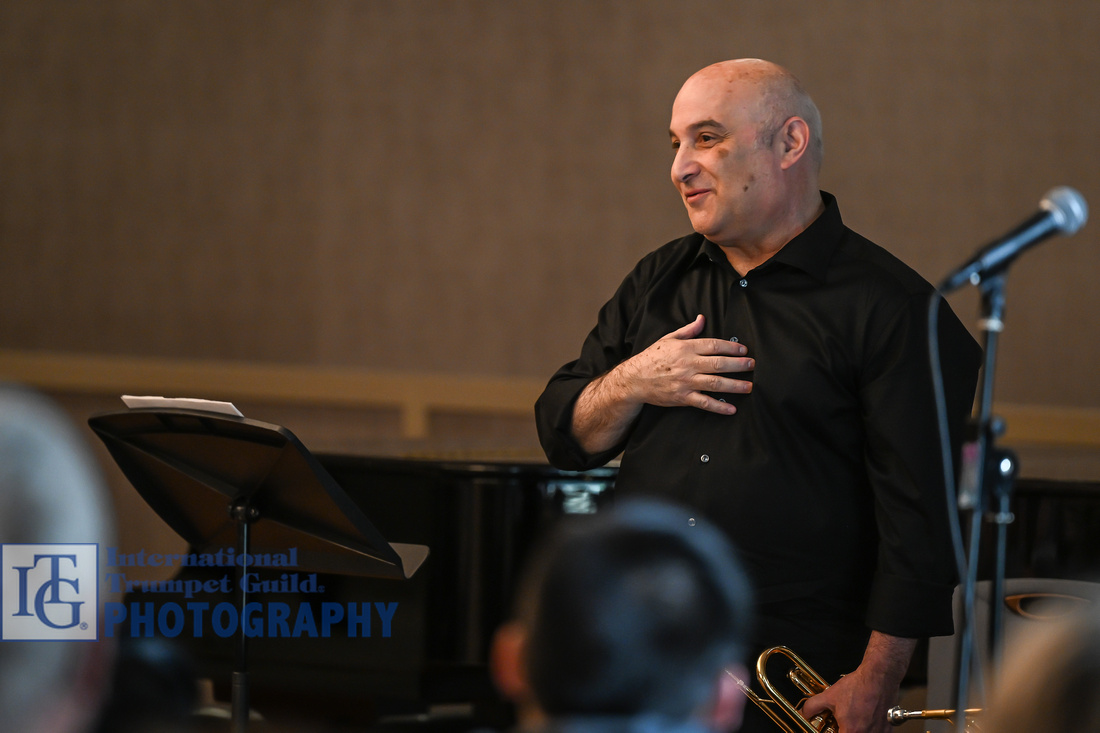
Evening Concert - The Steve Wright Big Band with David Pastor, Micah Bell, Nadje Noordhuis, and Bijon Watson
This highly anticipated concert by the Steve Wright Big Band and a stellar lineup of guest soloists was preceded by a prelude by the Colorado State University Trumpet Ensemble, performed with immense skill and flair. The show openers came at the hands of the splendid Spaniard David Pastor, with vibrancy and energy by the bucket load, as well as some emotional lyricism. Micah Bell was up next with his incredible intensity of tone across soaring melodies, followed by Nadje Noordhuis leading the band in a more contemplative mood on both trumpet and flugelhorn. Her deeply reflective and soulful style transformed the room to create an electric atmosphere. The powerhouse that is Bijon Watson completed this superstar roster with scintillating sound and high energy, contrasted by some sultry and intense flugelhorn playing. This was an incredible night for the ITG crowd! (John Hutchinson)
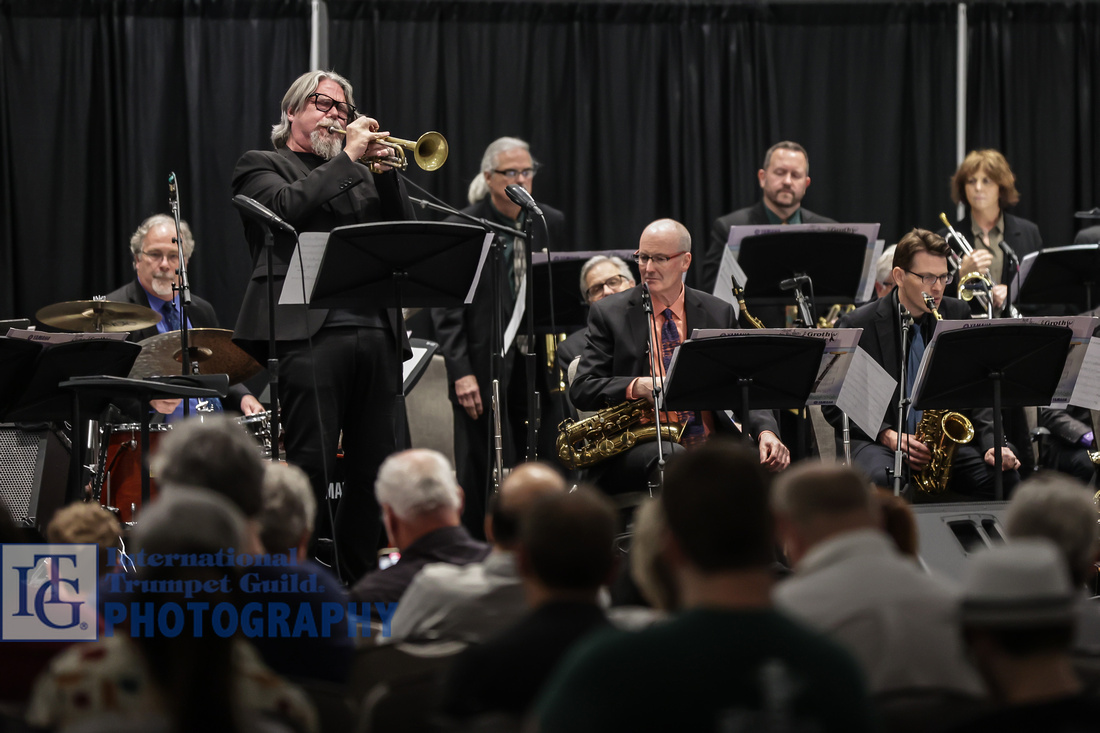
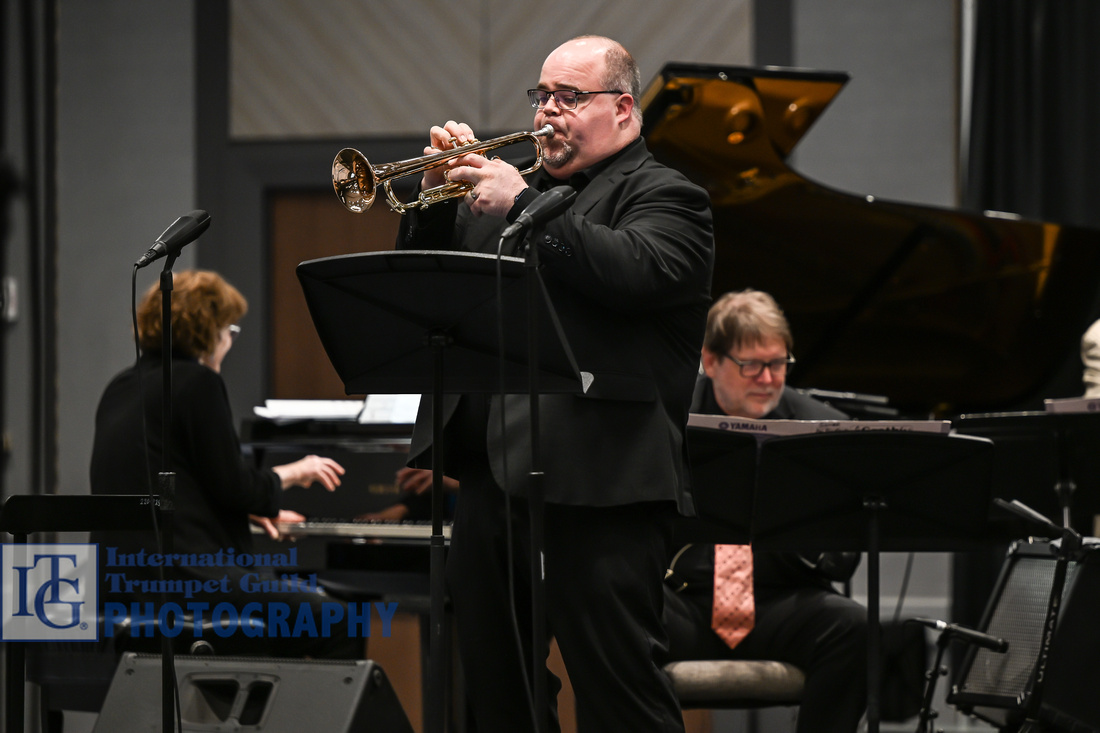
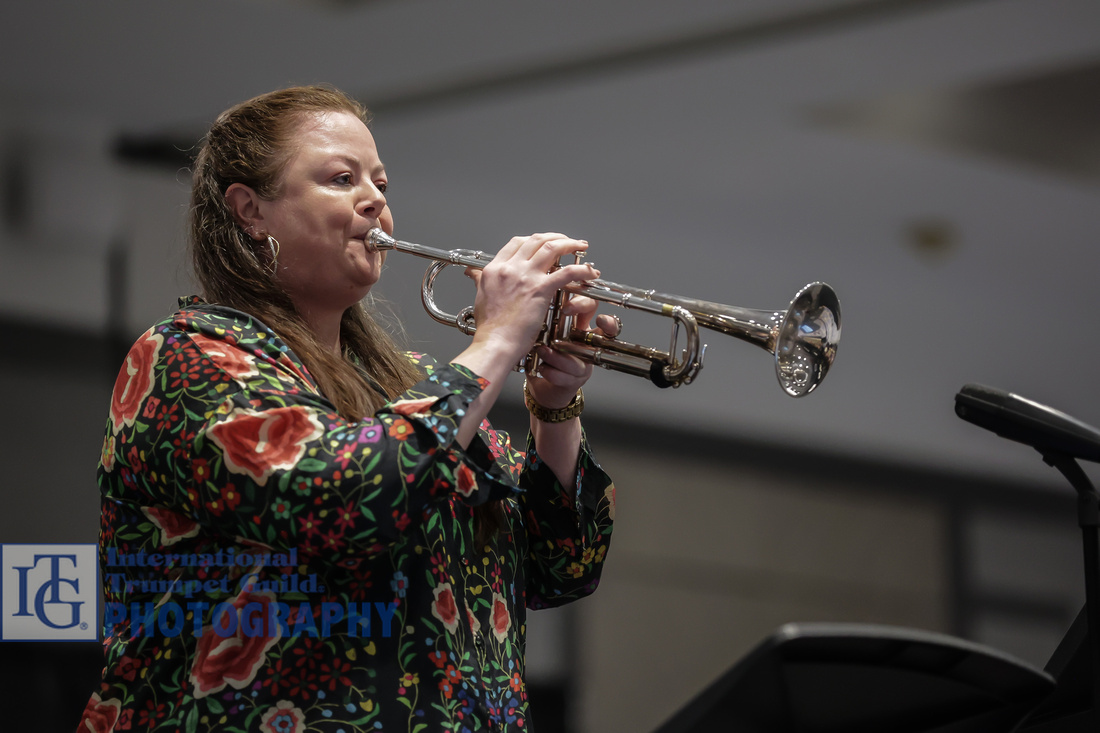
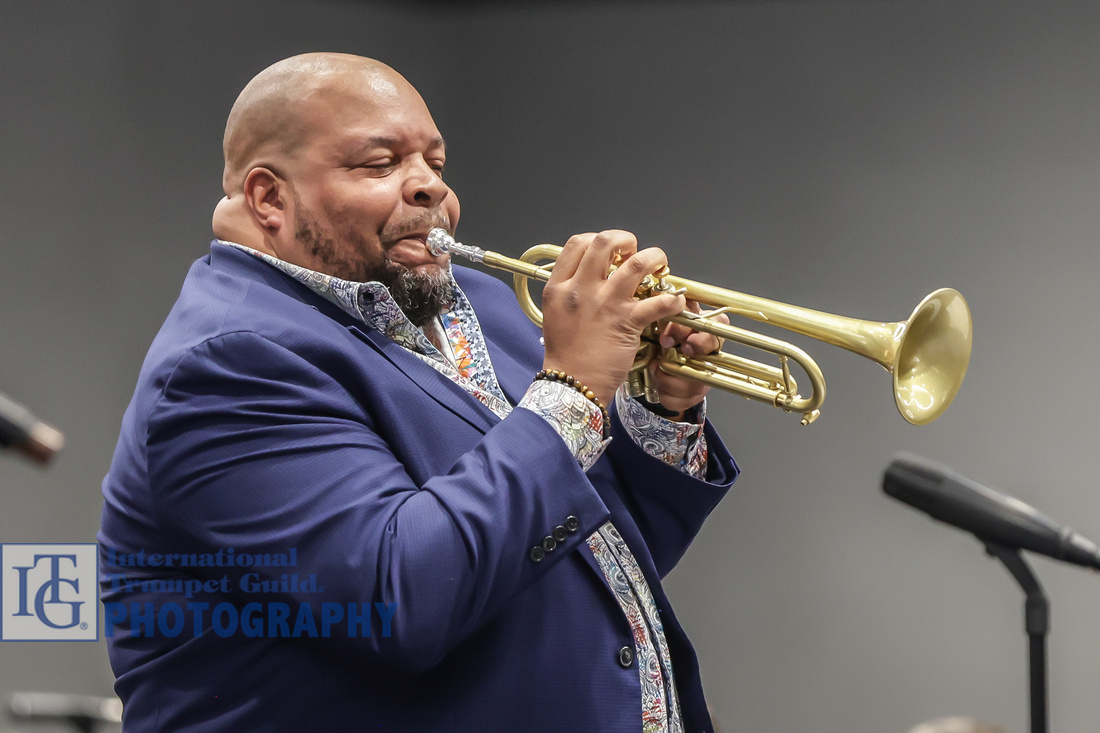
Concert - John Swana and Jean Laurenz
A delightful rendition of Poet and Peasant was presented by The Wells School of Music Trumpet Ensemble to open the evening concert. The Conference Jazz Trio was then joined by Philadelphia-based trumpeter John Swana and the trumpet professor from the University of Wisconsin-Madison, Jean Laurenz, to present a concert with an eclectic mix of styles with tunes by Kenny Dorham, Kenny Wheeler, Miles Davis, Jean Laurenz, Thad Jones, Frederic Chopin, and Clifford Brown. Unique was Laurenz’s highly attractive mash-up of music by Ravel and Radiohead, which involved both singing and Laurenz’s lush flugelhorn playing. Swana also played the EWI (Electronic Wind Instrument), which he has incorporated into his performing and composing throughout his career. He used the EWI with a synthesizer and pedals, allowing him to access a multitude of colors and effects. From jazz standards to original compositions, both artists conveyed brilliant ideas that the audience enjoyed thoroughly. (Will Koehler)
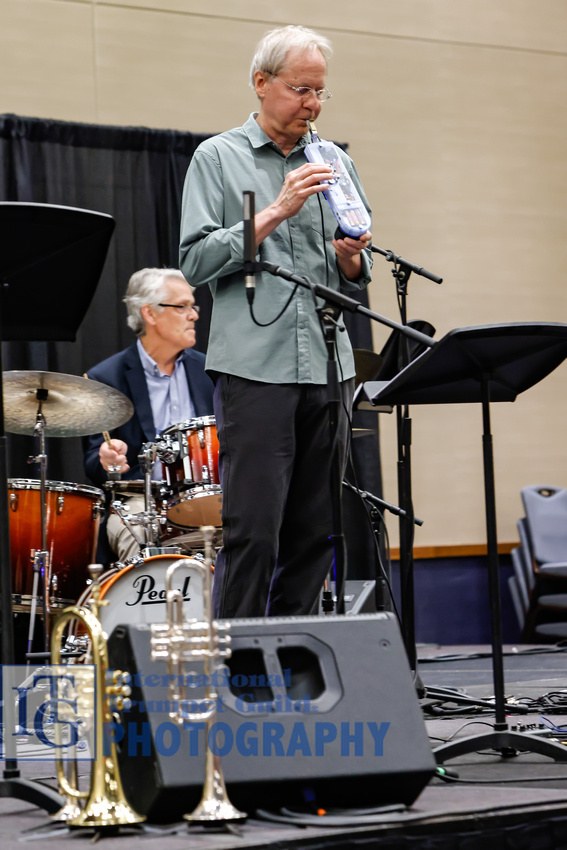
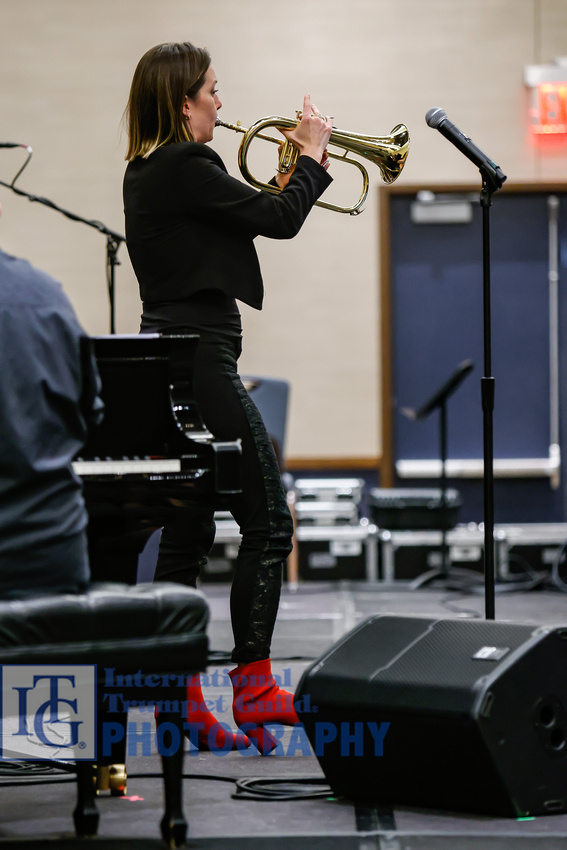
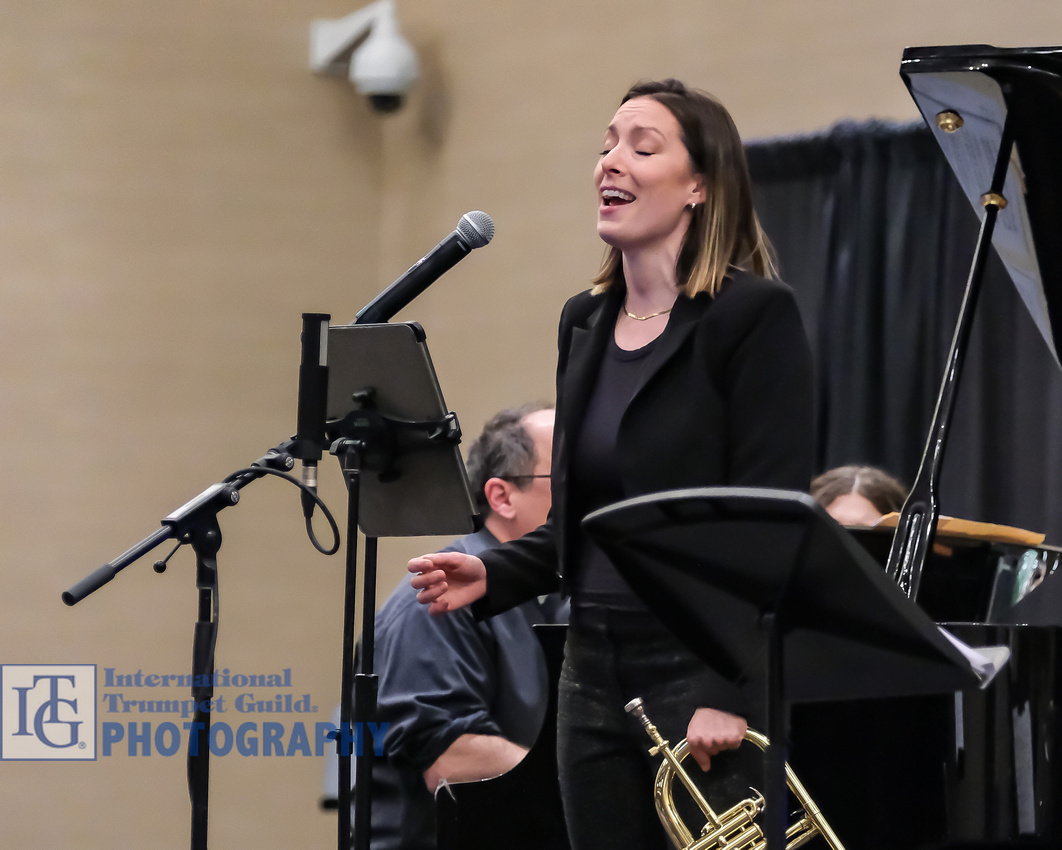
Open Jam Session - John Raymond
John Raymond led a fantastic jam session with well over fifty people in attendance late Friday night. The opening tune, I Hear a Rhapsody, highlighted Raymond’s versatility and individual style alongside the guest artists performing in the combo. After a brief, kind, and informal introduction, Raymond invited players up to join him on stage for what he called a mini-jam session, which started with You Stepped Out of a Dream. Other tunes included It Could Happen to You, On The Sunny Side of the Street, and Birdlike. Each soloist demonstrated a respectful and a professional demeanor on stage as they took turns playing with the combo throughout the session. Raymond interjected marvelous instruction and coaching in between tunes to aid in perfecting the attendees’ craft. The overall groove of the session created an ideal and relaxed ending to the day. (Lacey Phelps)
Click here for more photos from the ITG Conference
]]>
Special Daily Report • Compiled by Peter Wood
Photos by Steven Garcia, Benjamin Lowe, Josh Rzepka, and Michael Anderson
Thursday, June 1, 2023
Click here for more photos from the ITG Conference
Brianne Borden - Body & Mind Session: Yoga for Musicians
Attendees of this session enjoyed a calming, mindful start to their day, thanks to this session led by Dr. Brianne Borden. Participants were guided through a series of stretches focused on the wrist, forearms, neck, and shoulders. These exercises aimed to prevent injuries commonly experienced by musicians. The session concluded with sun salutations and an open question-and-answer portion. (Nathalie Crissela Mejia)
Bijon Watson warm-up session - Dynamic Warmup: Sound, Flexibility, Endurance for Success
Watson opened the session by explaining that the nature of his early training was classical, but that as he transitioned to more commercial work, he had to adapt his warmup to allow him to fire faster and sustain a certain level of playing throughout the day. To accomplish this, Watson creates a dynamic warmup, which emulates what he will be doing throughout the day. He breaks this down into four main categories: sound production–Stamp exercises with air attacks and a focus on projection and a resonant projective sound; airflow–lip trills for flexibility to slowly find the slot, starting with air attacks; flexibility–two-octave arpeggios; and embouchure stability–descending lip slurs to check that you’re loose. Watson emphasized that the warmup is not a practice session–it should just emulate what you have already practiced–and that a warmup should have intention and not be passive. The session concluded with a brief question and answer with the attendees. (Will Koehler)
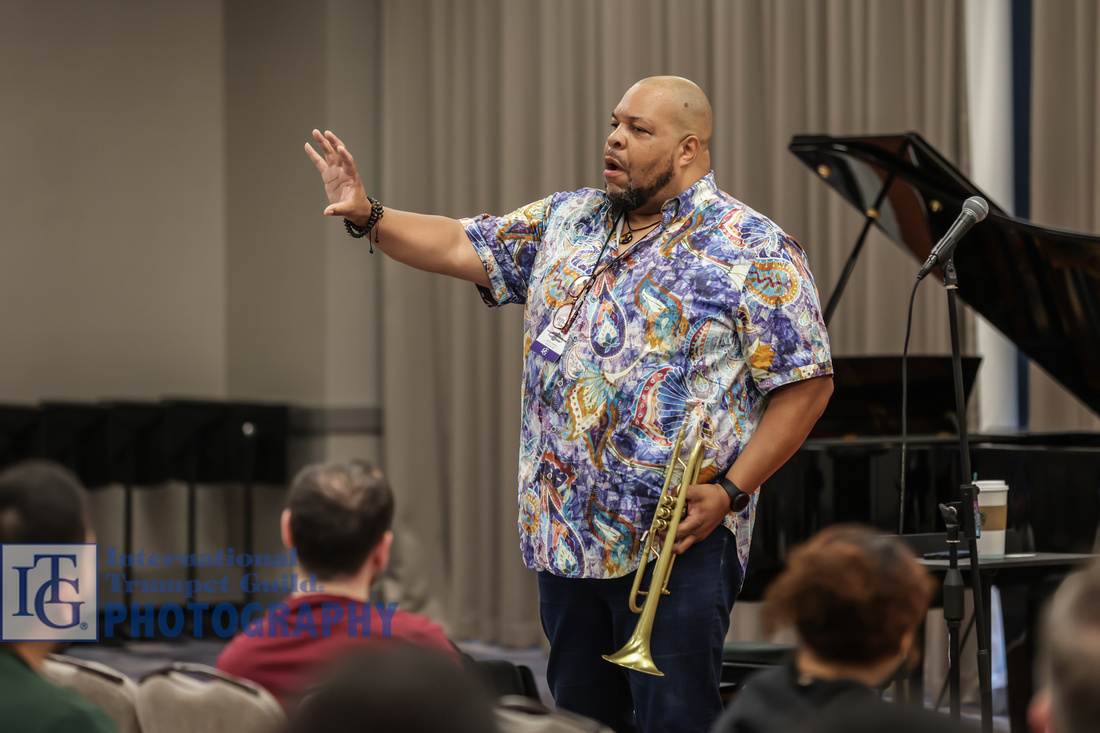
Grant Manhart session - Teaching Using NLP
Dr. Grant Manhart’s presentation on using neuro-linguistic programming (NLP) to teach trumpet students was a fascinating departure from traditional “component” trumpet teaching that relies on analysis. NLP is a wholistic approach that involves four principles: that students already know how to play deep down; that feedback helps; that NLP allows all to access their natural gifts; and that one’s imagination, identity, conscious, and subconscious realities can be manipulated to achieve our goals. Manhart demonstrated with his own children a call-and-response type of teaching that resulted in remarkable improvement and results. Noticeable in this approach was an emphasis on goals, a lack of talking from teacher to student, an encouragement of childlike fascination, an awareness of our senses, an attitude of optimism, and an acknowledgment that hard work often does not lead to success. (Stanley Curtis)
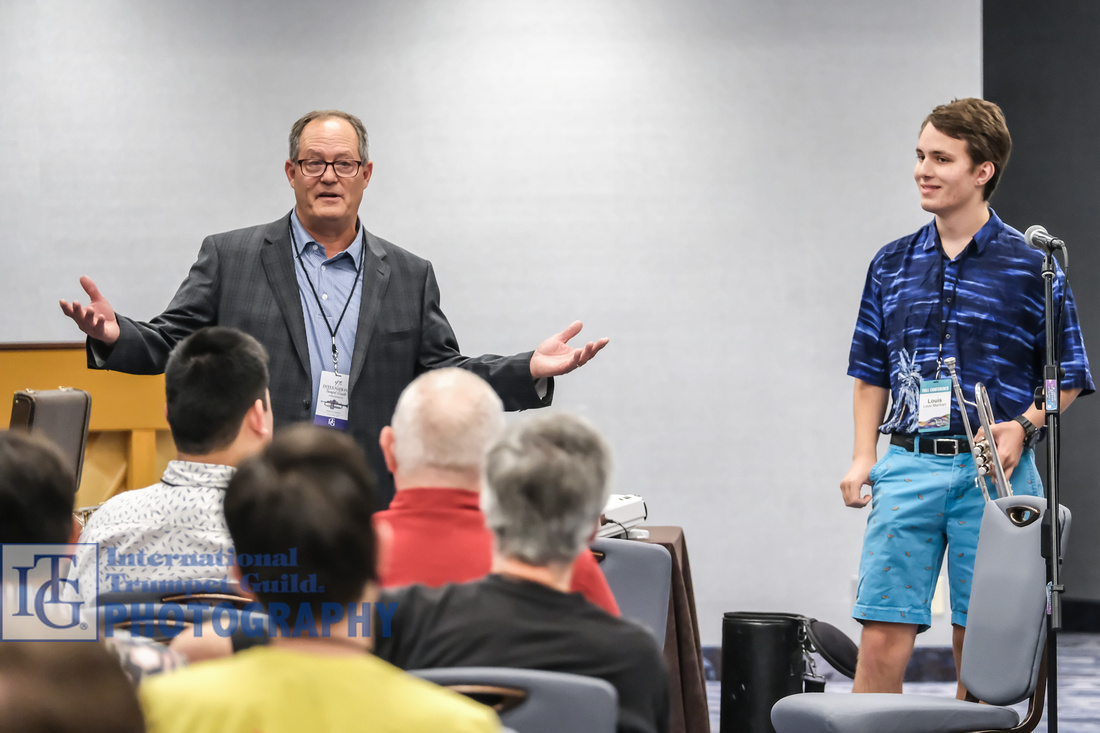
Judit Martín González session - Music & Early Childhood: Music, More Than a Game (Part I) Childhood and the Trumpet
Can learning the trumpet be an enjoyable process for young players? In this session on early childhood education, Judit Martín González immediately and effortlessly created an exciting atmosphere for attendees, playing games that enhance a young trumpet player’s learning experience. González’s musical games place a fundamental emphasis on the centering of sound, maintaining clear articulation and steady pulse, training the ear, and listening in order to prepare the student for making music. She demonstrated this process by actively engaging the audience in a series of games that she developed for her personal teaching. These consisted of different combinations of marching, singing, and call-and-response techniques that provide an educational and entertaining environment. The goal of this process is for students to learn to effortlessly express their emotions through music. This combination of technique and gameplay creates a positive and relaxed learning environment in which young students can thrive on the trumpet. (Spencer Brand)
Christopher Moore session - Ease of Playing... Beauty in Sound
Following an exhilarating prelude performance by the Berklee College of Music Trumpet Ensemble, Dr. Christopher Moore gave an insightful masterclass to the members of the Non-Pro and Comeback Players group. Each performer was given new ideas and concepts to incorporate into their own fundamental routines. These concepts are centered toward each performer’s ability on their instrument. They focus on addressing issues related to ease in performance and capturing greater efficiency while focusing on creating a beautiful sound and instilling these concepts into their everyday playing. Each performer developed their ease of sound through buzzing the mouthpiece, doing note bends, and developing great breath control. (Angela King)
Michael Sachs session - The Teaching of James Stamp
A rousing musical prelude was provided by the trumpet ensemble from the University of North Dakota, setting the stage well for one of the world’s great trumpet players, Michael Sachs. As a former student of James Stamp, Sachs offered a rapt audience not only many invaluable insights into the teaching philosophies of his former mentor, but also his own interpretations of how to both practice and teach using Stamp’s methods. A core message at the heart of this presentation is independent thinking on the part of the player, the courage to trust their own needs, and take the core fundamental philosophies and adapt them to those needs. (John Hutchinson)
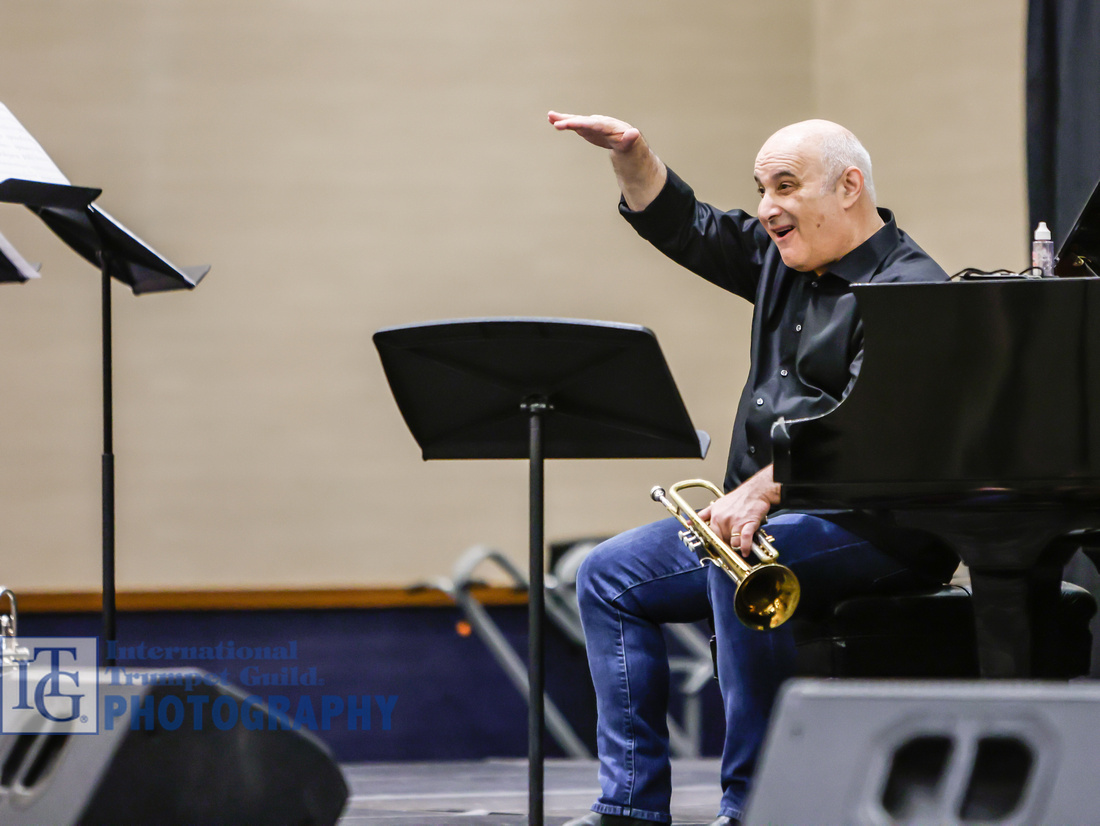
Ryan Anthony Memorial Trumpet Competition: Jazz Improvisation Division Finals
Three talented trumpeters were selected to perform for the final round of the jazz division competition. Each competitor was required to perform Freddie Hubbard’s Dear John, along with two selections of their own choosing. The first performer, Sam Butler (Indiana University), chose Along Came Betty and Kinfolk. Butler’s beautiful sound, phrasing, and interplay with the rhythm section was well received by the audience. Carter Eng (San Francisco Conservatory) performed next, choosing Invitation and I Remember Clifford as his two selections. Displaying a well-collected and poised approach, Eng performed with floating lyricism and blazing technique. The last performer of the day was Luca Stein (University of Miami), who chose to perform You Don’t Know What Love Is and Solar. Throughout his set, Stein displayed nice melodic development and a wonderful sound. Adjudicators for the competition were Nadje Noordhuis, John Swana, and Scott Belck. Special thanks to the Conference Rhythm Section (pianist Mike Frank, bassist Peter Paulsen, and drummer Christopher Hanning) for their spectacular playing. (George Carpten, IV)
Ryan Anthony Memorial Trumpet Competition: Wind Band Excerpts Division Finals
Competitors Madison Sinan, Noah Solomon, Anthony Salabarria each played a list of seven excerpts of varying difficulty to challenge their musical expression, endurance, range, flexibility, and articulation. All three contestants played beautifully and were well prepared. Comradery filled the room as the finalist’s teachers and friends were in attendance, creating a friendly and welcoming environment. Each performance showcased the student’s work and musical journey. (Angela King)
Recital: Marcos García Vaquero
The Universidad de Costa Rica, Sede Caribe Trumpet Ensemble opened the recital, performing with fiery passion and foreshadowing the excitement to follow. Marcos Garcia Vaquero then took the stage, showcasing a collection of works from Andalusia, the performer’s homeland. Klezmeralda captivated the audience as Vaquero’s lush tone was on full display, highlighted by beautiful, flowing melodies. Contrasting sections required virtuosic techniques such as lightning-fast finger dexterity, rapidly traversing large intervals, and multiple tonguing– all of which he navigated with ease. These ideas became recurring themes in the following works. In an unexpected, but pleasant, surprise, Vaquero entertained the audience by utilizing multiple instruments, including guitar and a tin whistle he played while stomping his foot to provide a percussive accompaniment. He also incorporated his own singing as part of the performance. Throughout the recital, Vaquero displayed his ability to perform passionately with extreme dynamics, lyricism, and power, resulting in thunderous applause and a well-deserved standing ovation. (Steven Siegel)
New Works Recital II
The second New Works Recital began with an emotional performance of Caleb Hudson’s White Rose Elegy by the University of Wisconsin-Madison Trumpet Ensemble. Following that prelude, Stephen Campbell performed Drew Tomasik’s The Exit Strat for solo trumpet and fixed media. With the recent release of The Super Mario Bros. Movie, it is appropriate that this work pays homage to the music of classic 8-bit games such as Pac-Man, Contra, and Hogan’s Alley. Tomasik’s work is energetic and lively with pop and funk influences. Campbell’s sound is notable for its purity, and he is capable of conveying a message within the warmth of his sound alone. Jared Wallis followed with his own work, We Are Still Here. This piece programmatically explores the complicated relationship between indigenous cultures and colonization. While the fixed media begins with the calming sound of bird calls and running water, the trumpet part begins declarative, dissolving into introspective melodic material. In the fixed media, the mixture of plainchant and indigenous percussion creates a jarring juxtaposition. Wallis’s playing was potent with an emotional weight, spinning each phrase with conviction.

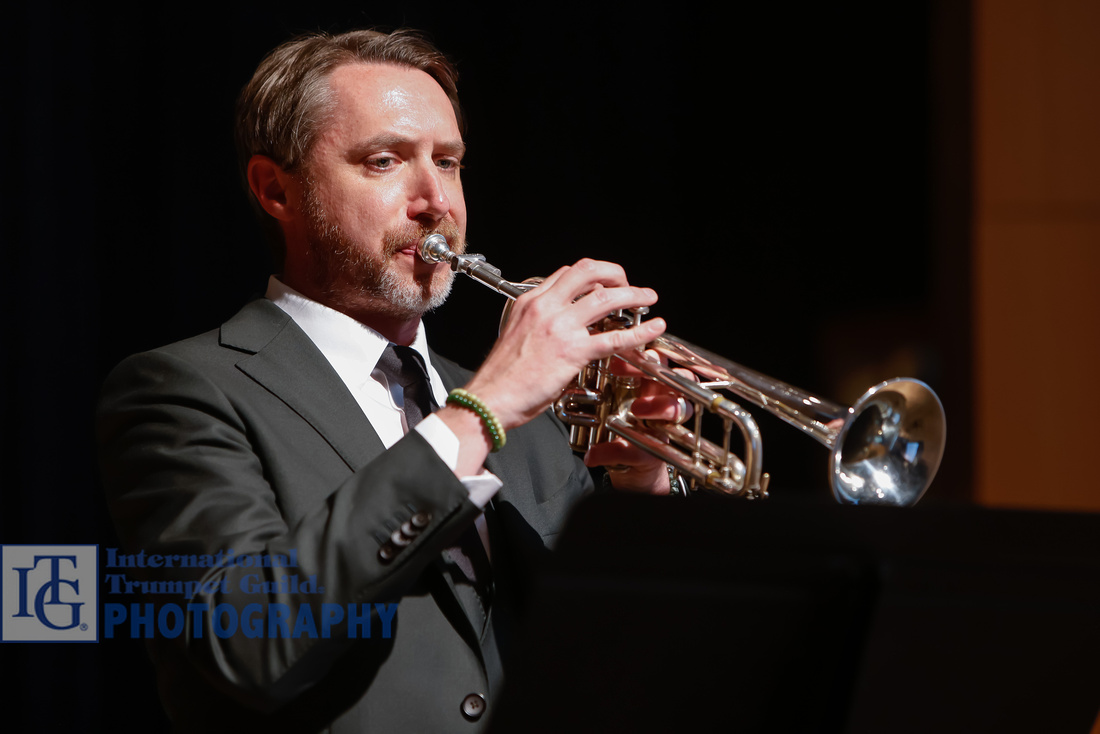

As opposed to the previous two works in which the performer responds to the fixed media, the following work by Mark Volker, Hymn to a Vanishing Land, utilizes a computer program that instead responds to the performer. The work, written in two continuous movements, begins with a raucous fanfare. While the first movement is outspoken with many loud moments, the second movement is more intimate. Robert White demonstrated impressive efficiency on the trumpet, as the piece is long with a wide dynamic range, but his sound was never forced, pushed, or distorted in any way.
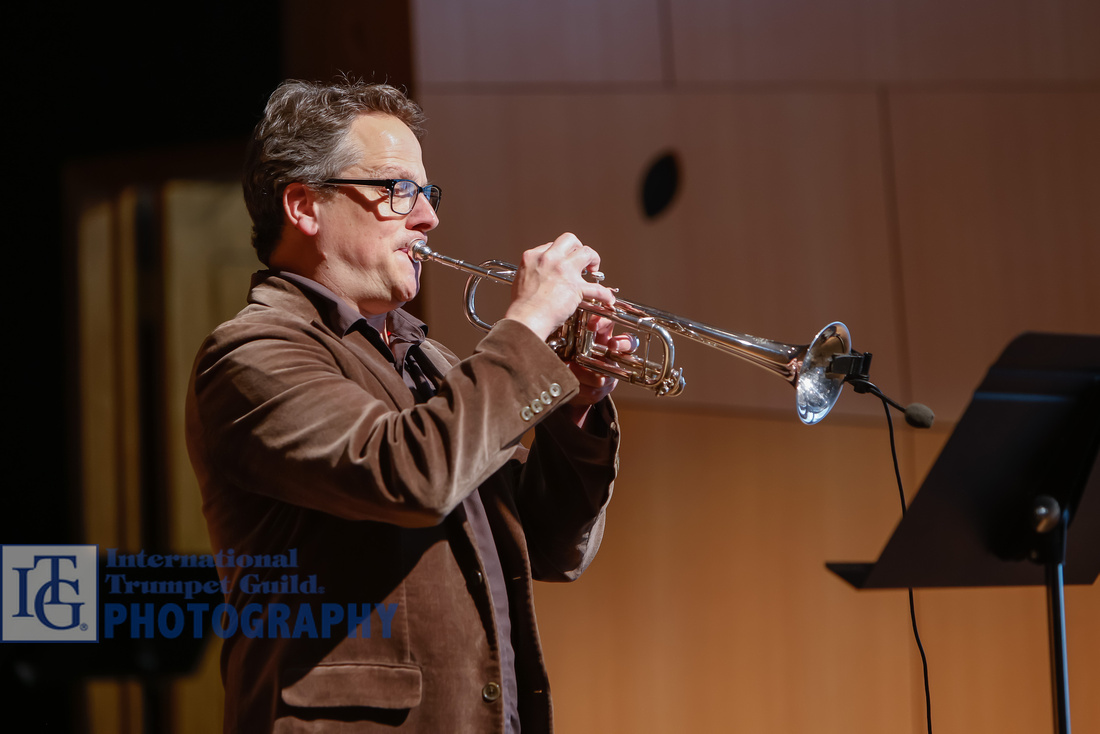
Alexandre Lunsqui’s Solis and Two Patches, performed by trumpeter Andy Kozar and soprano Corrine Byrne, is reminiscent of the sequenzas of Luciano Berio. The first movement of the work is defined by lyrical expression punctuated by intervallic acrobatics, and the second movement uses the Harmon mute to complement the changing vowel shapes of the soprano part. Kozar and Byrne blended especially well; there is a vocal quality to Kozar’s sound, and Byrne sings with remarkable brilliance.
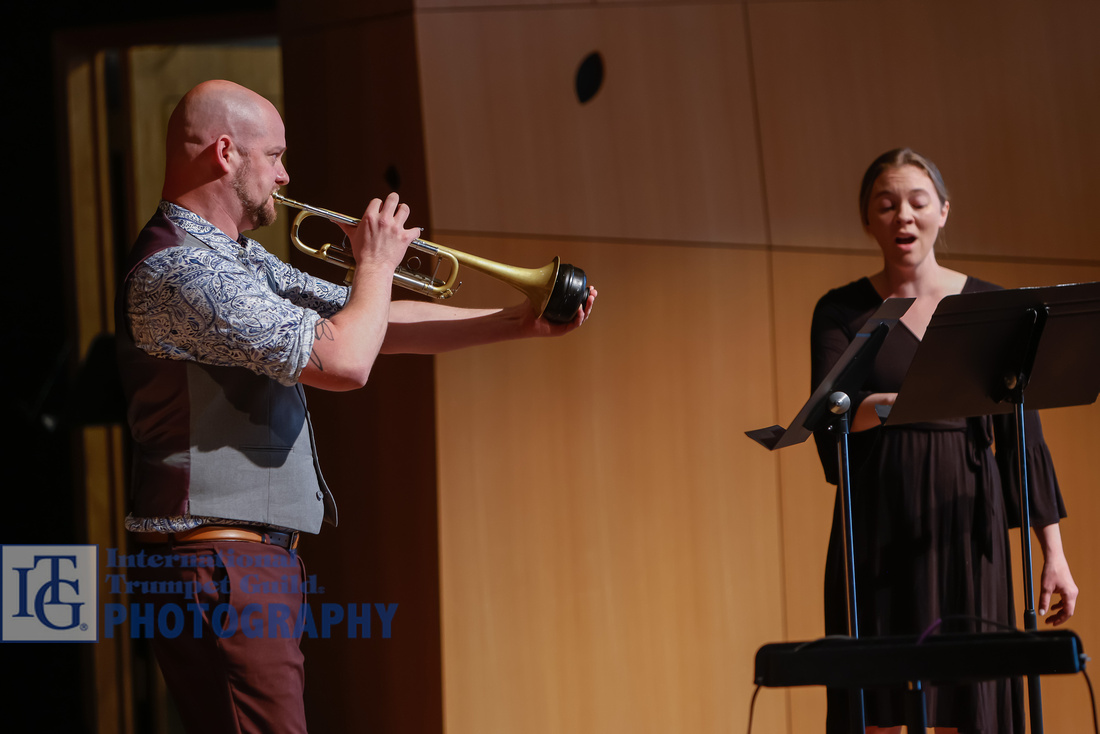
As with the Wallis, Eris DeJarnett’s go to the garden (specified by the composer to always be uncapitalized) is very introspective. Performed by John Marchiando, this work for trumpet and fixed media uses a recorded narration to tell the story of a garden, which represents internal peace. While the narrator spends time planting this beautiful garden, a disturbance leads it to decay and rot. Throughout the performance, Marchiando’s sound shone with a radiance that allowed the listener to relax. He performed with a warm, inviting sound without ever letting a moment become dull.
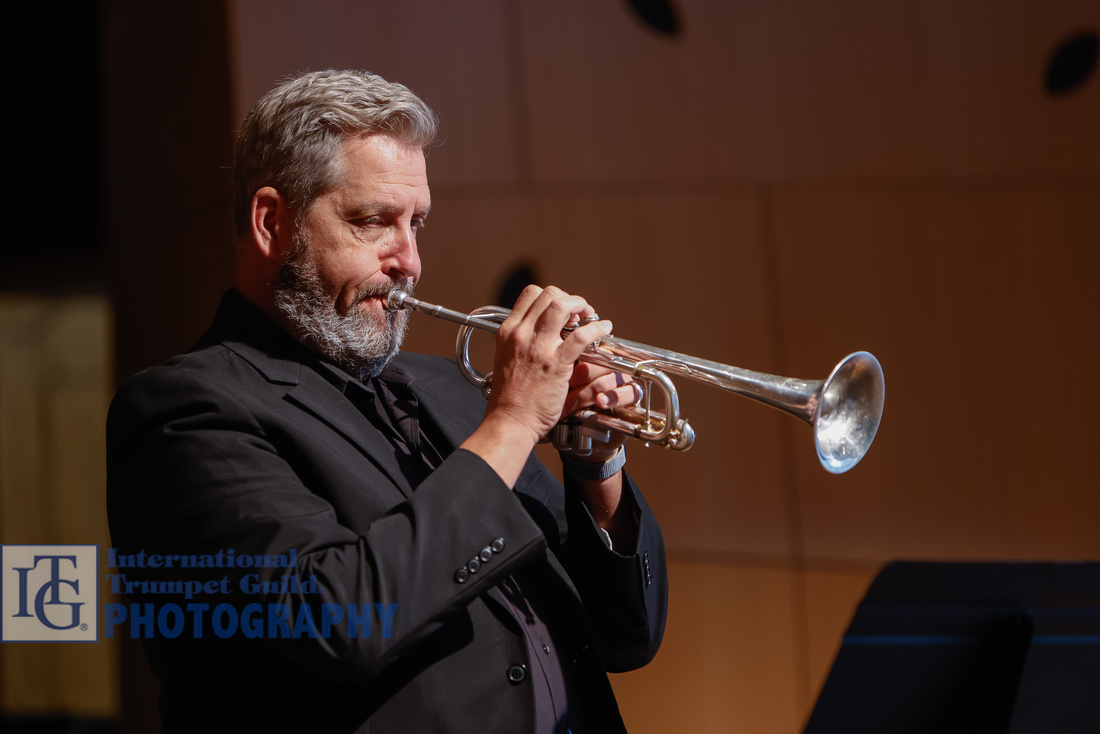
The recital concluded with a performance of Cameron Nielson’s Sketches in a Trumpet Wasteland by the ITG New Works Trumpet Ensemble. More than anything else on the program, this work demonstrates jazz influence while drawing on trumpet ensemble works such as those by McKee or Morales. The work is energetic, fun, and lively, and the ensemble performed with a balance across all parts. Especially notable was Nicole Gillotti’s brilliant sound in the upper register. (Christopher Luebke-Brown)
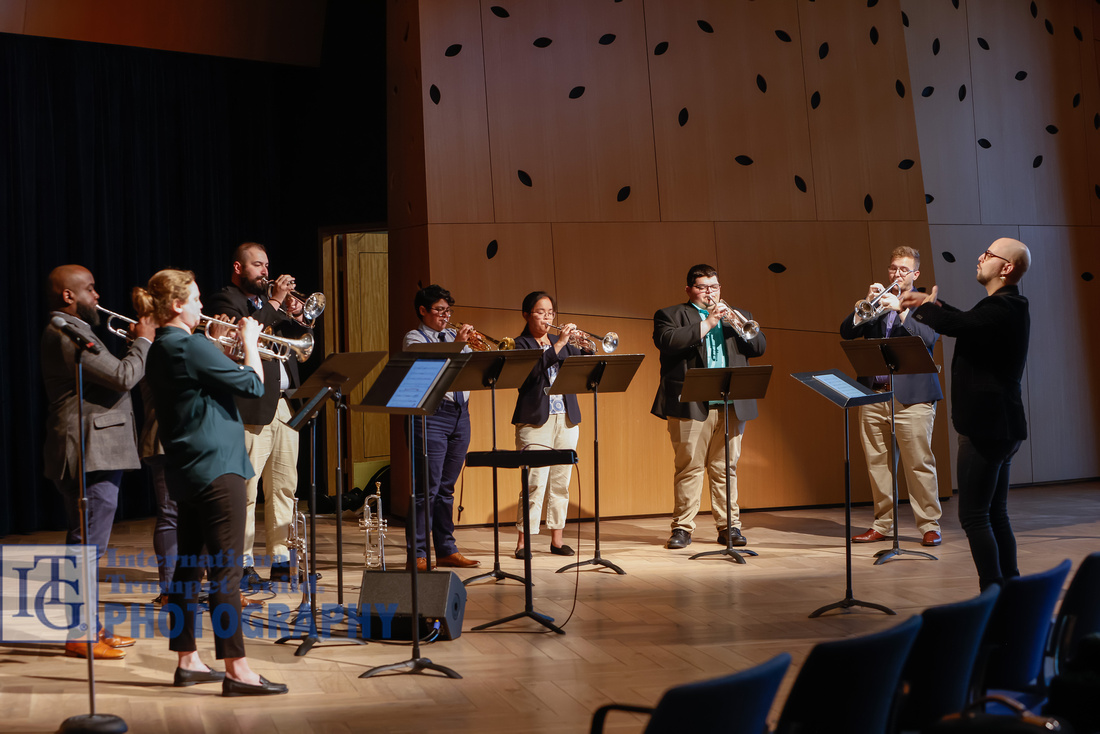
Special Event - Trumpet at Twins
The Twins Experience started with an afternoon rehearsal of Steve Wright’s five-part arrangement of The Star Spangled Banner at the Hyatt Regency, conducted by Bijon Watson. After a successful rehearsal, our 110-member trumpet ensemble later regrouped in the hotel lobby and walked over to Target Field. Once there, we were led under the stadium and waited a few minutes in a holding area, where we lined up in five rows. The wide doorway opened, and we briskly walked, still in our rows, directly onto the field to the cheering of the crowd. The excitement was palpable. Our pregame well-performed version of the National Anthem was well received, and we exited back under the stadium and went to our seats to watch the game. The Minnesota Twins played the Cleveland Guardians. The Twins’ playing was an excellent example of perseverance that could be easily transferred to the musical world. Down 6-3 in the bottom of the ninth inning, the Twins steadfastly pursued their goal, and their bats came alive. The winning run was scored with a bases-loaded sacrifice fly. It was an exciting, memorable, and inspirational moment! Go Twins! (Cindy Scaruffi-Klispie)
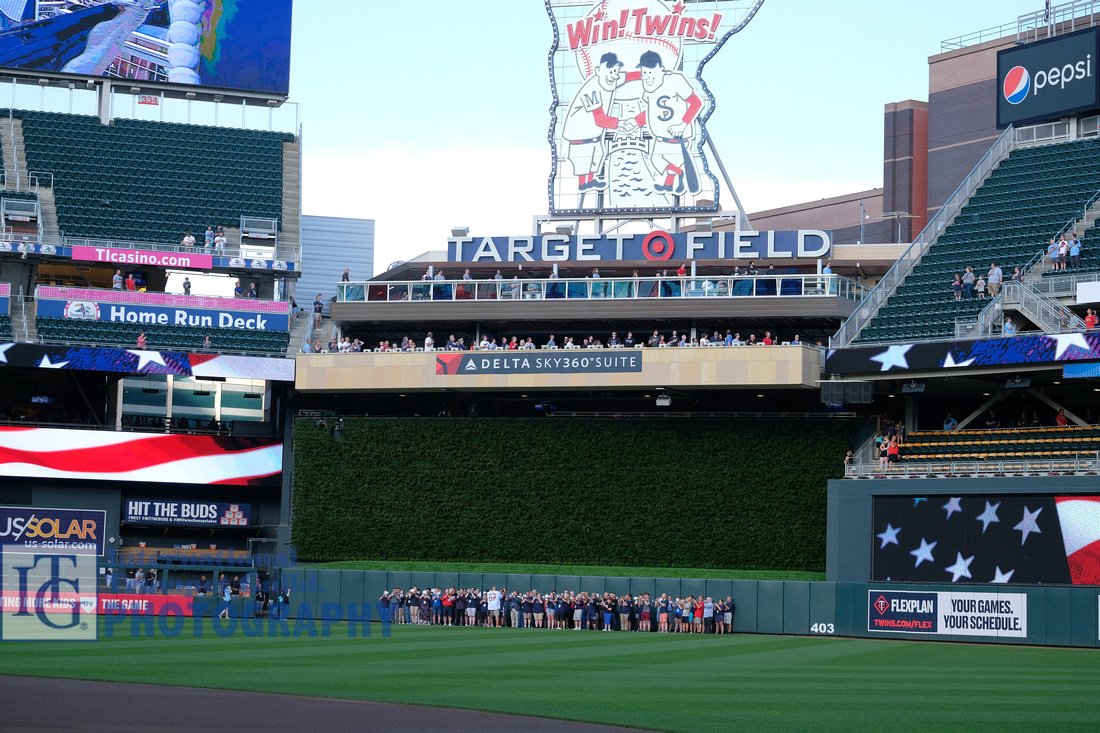
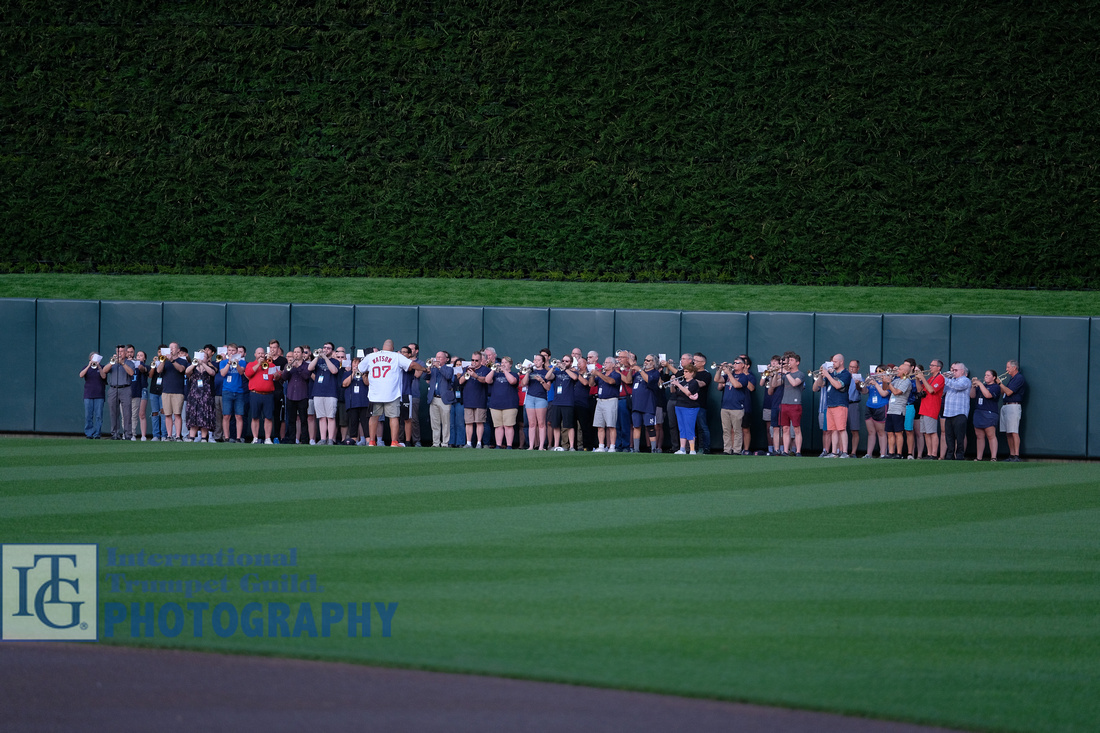
Donny Albrecht session - Lead Trumpet Style
Following a dynamic performance from the University of North Alabama trumpet ensemble, Donny Albrecht presented to a packed room. Albrecht shared his journey as a lead trumpet player, highlighting the importance of mentors and influences. He provided eleven key points for playing stylistically accurately in a big band, emphasizing critical listening and the understanding of the history of performance practice. Suggestions for deliberate listening included focus on time, sound, phrasing, articulations, glissandi, falls, bends, and scoops. Albrecht also discussed the role of a lead player and offered advice on working with colleagues, developing endurance, recovering, and learning the role of a freelance artist. (Joe Cooper)
Luis Engelke lecture recital - The 21st-Century Trumpet Recital: Enhancing Your Performance and Engaging Audiences with Multimedia
The Emporia State University Trumpet Ensemble opened this session with two brilliant pieces by ESU trumpet professor Dr. Gary Ziek. The first, Indefatigable, was a stately march that included parts for euphonium and tuba, and the ensemble concluded with a rousing arrangement by Ziek of Rossini’s William Tell Overture. Luis Engelke’s session began with one of his own stirring compositions, Revelation. This piece, along with all the others on this recital, utilized some kind of electronic accompaniment and video. Engelke encouraged performers to experiment with this genre of music for many reasons, including the flexibility it provides for rehearsing, exposure for students to electronics, and opportunities to perform music by diverse composers. Included in the lecture were helpful hints, including his favorite microphone, image websites for creating videos, recommended software, and suggested composers. Beautifully performed, Engelke presented six stellar compositions of unique style and flair. (Richard Tirk)
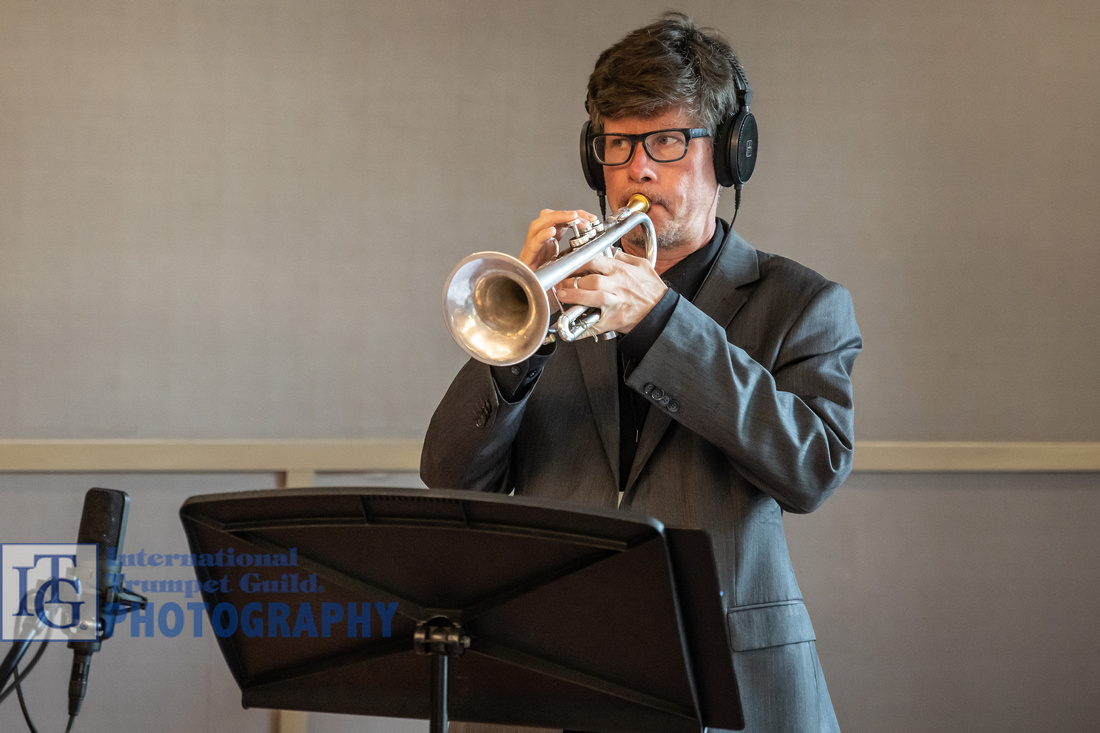
Ryan Anthony Memorial Trumpet Competition: Orchestral Excerpts Division Finals
With nearly eighty observers in attendance, the final round of the Orchestral Excerpts competition featured three finalists who were selected from among fourteen players in the semi-final round that was held earlier in the week. The excerpts performed were from Stravinsky’s Petrouchka, Mahler’s Fifth Symphony, Schumann’s Second Symphony, Mussorgsky’s Pictures at an Exhibition, Esmail’s Black Iris, Williams’s Star Wars Suite, and Dvorak’s Eighth Symphony. Alison Marseglia, from Baylor University, was the first to perform and set a high standard with her clarity of articulation and ability to adjust style and color throughout her performance. Her stylistic changes on Petrouchka were spot-on and her muted playing on Black Iris especially magical. Morgan Hare, from Grand Valley State University, demonstrated fantastic technique and a thorough knowledge of various styles. Her lyrical playing on Mahler 2 sounded effortless, and her performance of the opening of Star Wars showed off her commanding, resonant tone and excellent range. Brandon Hebert, from Louisiana State University, ended the competition with a fantastic exhibition. His performance of “Goldenberg and Schmuyle” displayed a well-rounded approach to style and showed off his wide dynamic range on the piccolo while his presentation of the opening to Dvorak’s Eighth Symphony was commanding and majestic. There is no doubt that the judges needed substantial time to deliberate the winner of this competition on which an immense level of talent was on clear display. (Lacey Phelps)
Recital - Paul Archibald and Mahidol University Trumpet Ensemble - Sounds of Siam
This was a wonderful recital of both trumpet solo (with piano) and ensemble works. Collaborating with Paul Archibald on his solo selections by Busser and McDowell was Miriam Hickman, and both performed brilliantly. This solo portion was followed by the Mahidol University Trumpet Ensemble, under the direction of Joe Bowman. Varis Sirisook’s Orient Overture has two main themes; the first incorporates bounce to convey joy, and the second is a combination of singing melodies passed around the ensemble. Bowman gave a brief explanation of the history of Bangkok before the ensemble performed Prateep Supehanrojin’s Bugle Parade Variations. Fanfare from All Sides is a short but brilliant work by British composer Mark Anthony Turnage. The piece consisted of three small ensembles, reminiscent of Benjamin Britten’s Fanfare for St. Edmundsbury. Written originally for the inaugural concert of the Thailand Philharmonic at the 2005 ITG Conference in Bangkok, Eric Ewazen’s Emerald Rhapsody was a perfect vehicle to highlight the brilliance of the trumpet with its fanfare style and lyricism. (Will Koehler)

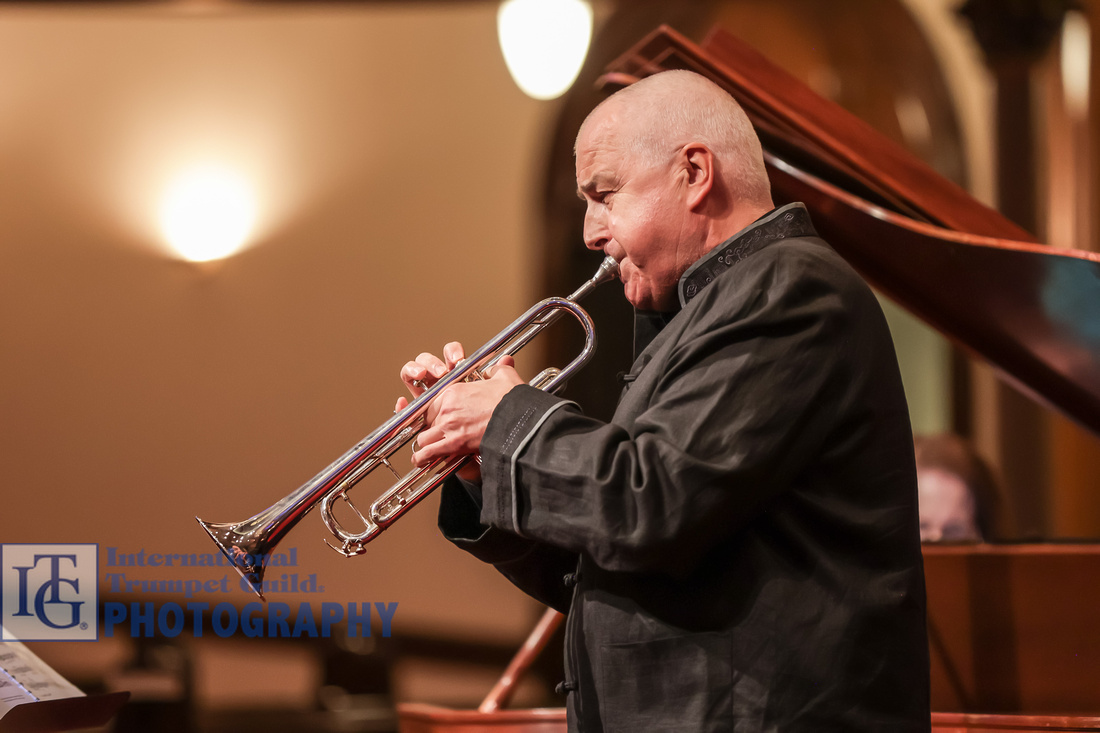
Twin Cities Trumpet Ensemble recital - Trumpet Signatures
The Twin Cities Trumpet Ensemble’s performance celebrated iconic works heralded as unique “Trumpet Signatures.” Under the direction of James Olcott, this 24-trumpet ensemble performed popular works such as Bugler’s Holiday, Procession of the Nobles, and Light Cavalry Overture, among others. This performance was distinct as ITG Honorary Award recipient Ronald Romm and Warburton performing artist Aaron Romm were featured as soloists on Eric Ewazen’s Clarion Calls for two trumpets and trumpet choir (2022). Bugler’s Holiday featured the father/son duo alongside Olcott. The ensemble consisted of a plethora of trumpets of all kinds. Throughout the performance, B-flat, C, E-flat, and B-flat piccolo instruments were primary, but several rotary and bass trumpets pitched in various keys were also utilized. The finale featured the soloists and trumpet ensemble performing John Philip Sousa’s Stars and Stripes Forever, closing the recital in a celebratory way. (Jeremy Perkins)
Fifth Bridge lecture recital - Electro-Acoustic Music for Trumpet Ensemble: People, Process, Performance
The professional trumpet ensemble Fifth Bridge presented a unique collection of new works for trumpet ensemble and electronics, along with an informative discussion regarding their creative process and the future of electro-acoustic music within the trumpet ensemble medium. Each composition featured the use of either fixed or static media, along with interactive electronics. The compositions allowed the audio media to enhance what the ensemble performed acoustically, including John Hollenbeck’s Colossal Sun, which also featured a synchronized video of the sun's solar flares corresponding to the antiphonal style of the acoustic arrangement. Some pieces utilized guitar and vocal effects pedals, such as Nadje Noorhuis’s Struck by Stars, as well as Nilofar Nourbakhah’s MaxMSP-like Space-Time Magnifying Glass. The level of individual performance in the group was outstanding and truly allowed the listener to take in the full experience that the composers intended. (Andrew Smith)
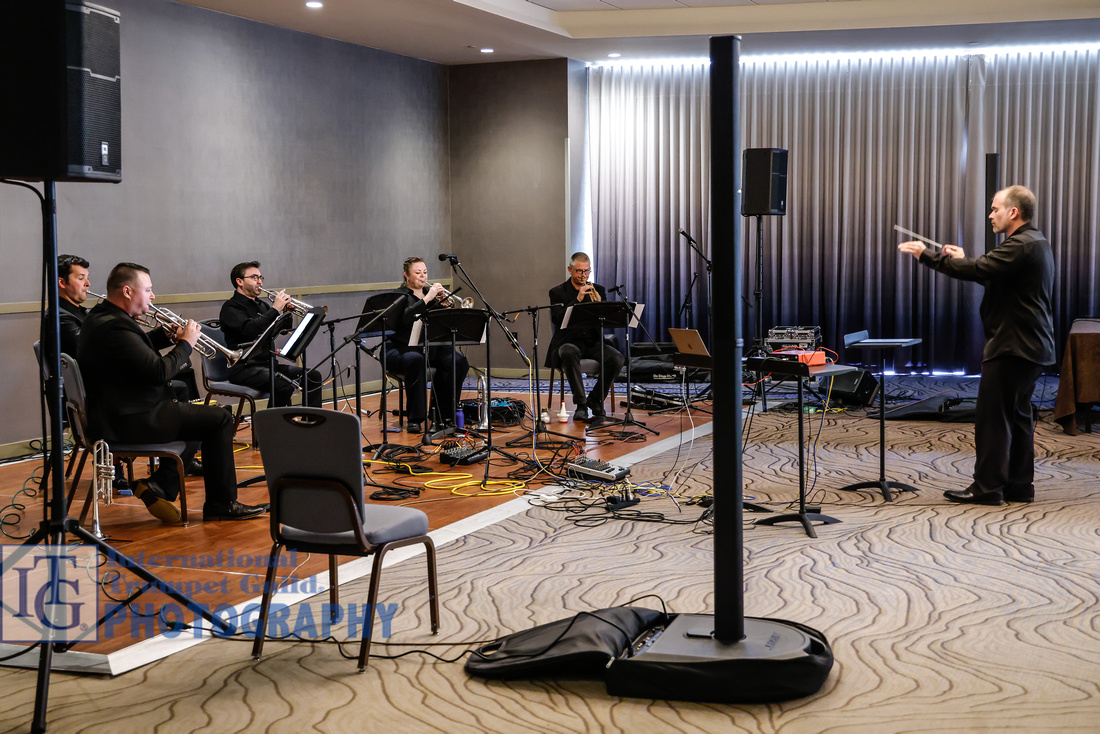
Evening Concert - Encore Wind Ensemble: A Night with the Stars
“A Night with the Stars” opened with a beautiful, energetic, and engaging prelude performance of Terry Everson’s arrangement of Bizet’s A Carmen Fantasy, played by the Boston University Trumpet Ensemble. Following the prelude, ITG competition winners were announced by the competition chairs, and Jason Bergman presented Michael Sachs with the ITG Honorary Award. Sachs gave a heartfelt speech thanking his many mentors, colleagues, friends, and family.
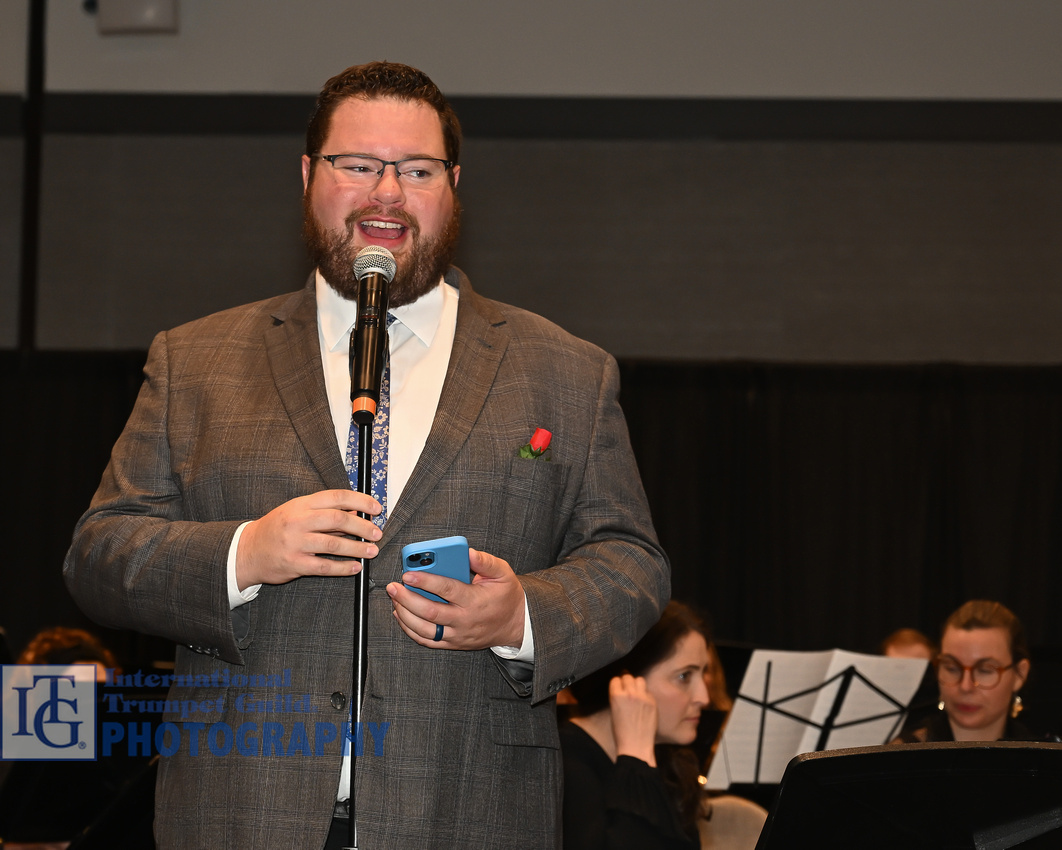
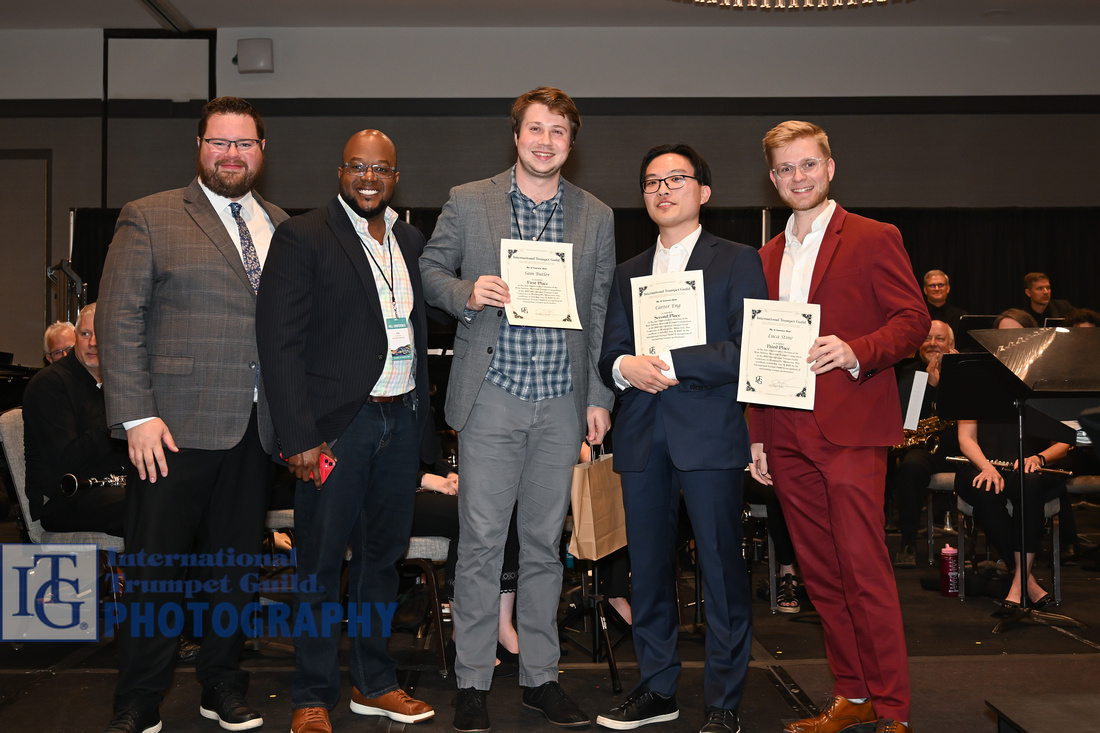
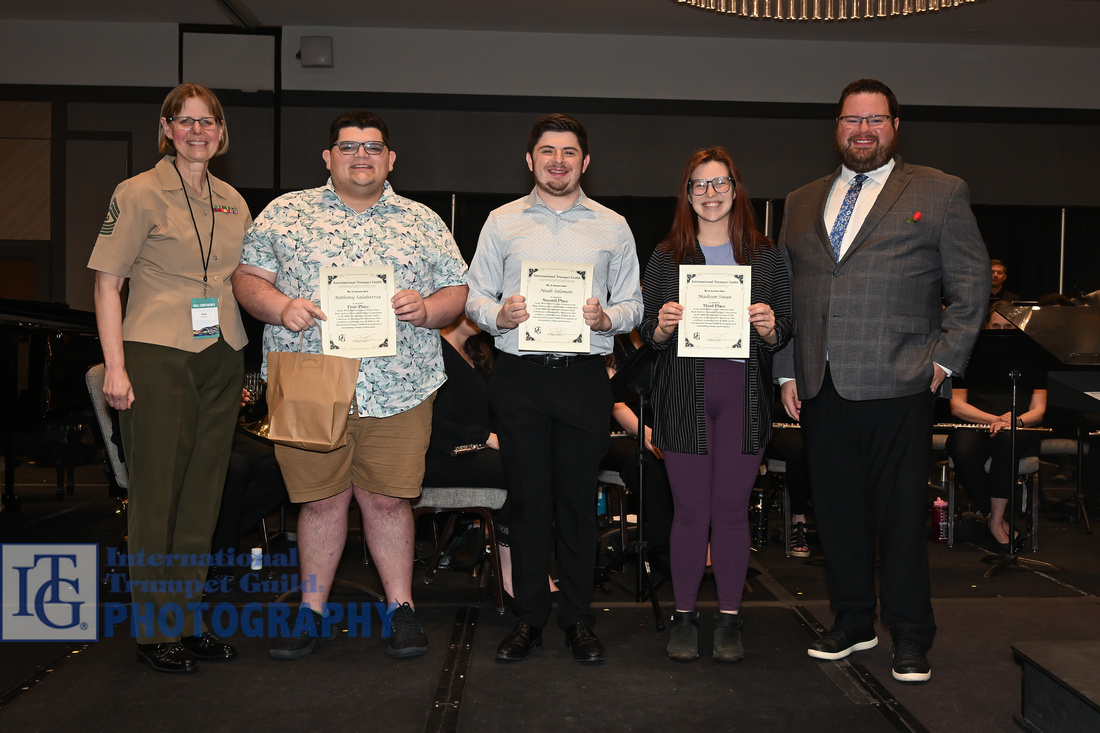
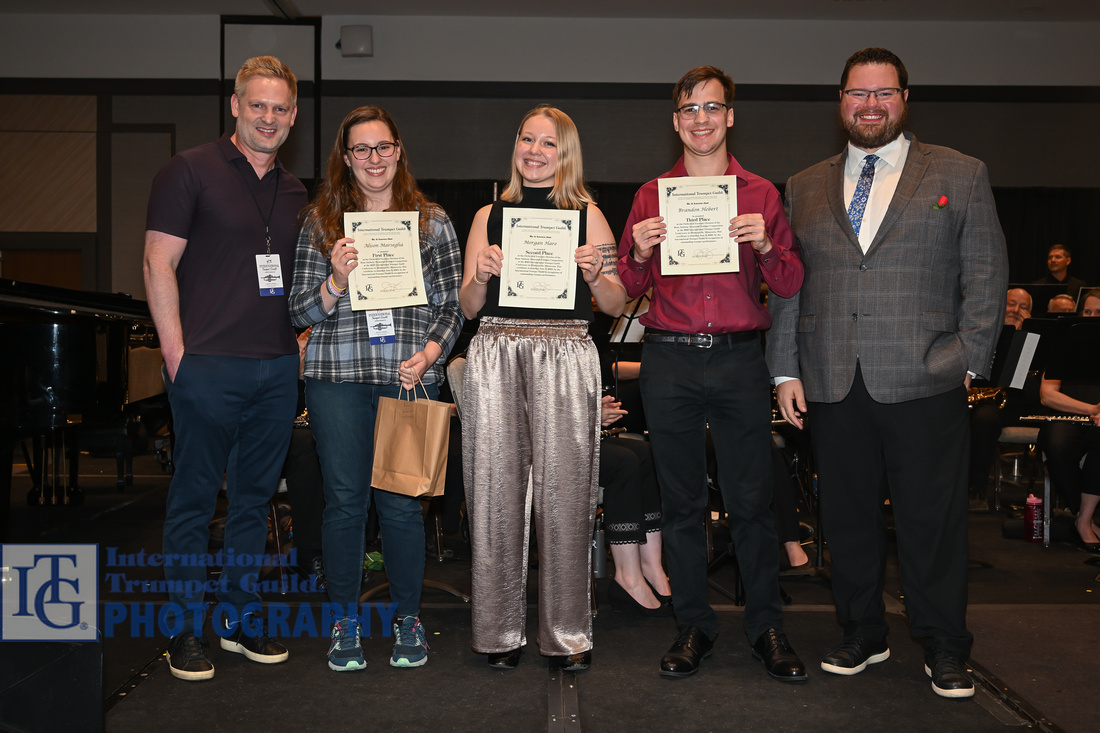
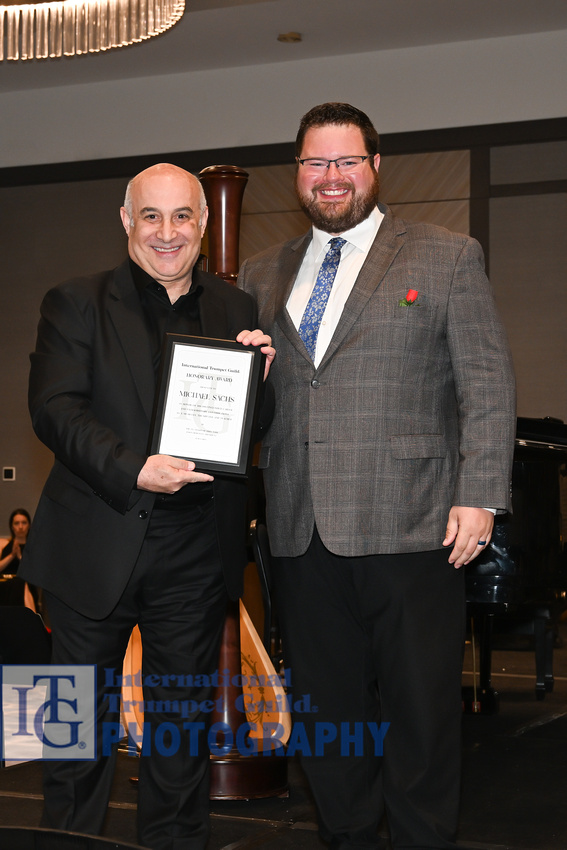
Following the awards presentation, the Encore Winds, conducted by Jack Stamp, began their program with a dynamic performance of William Schuman’s Chester. Second on the program was Arban’s well-known Fantaisie Brillante, performed virtuosically by Jean Laurenz and featuring an unexpected added element of a narration by Joey Tartell. The narration recounted the story of Marlon Bundo, the bunny rabbit, with an uplifting message supporting marriage equality and acceptance. Laurenz’s performance was technically flawless and musically inspiring. This piece, guest conducted by William Stowman, was particularly well-received by the audience, prompting thunderous applause.
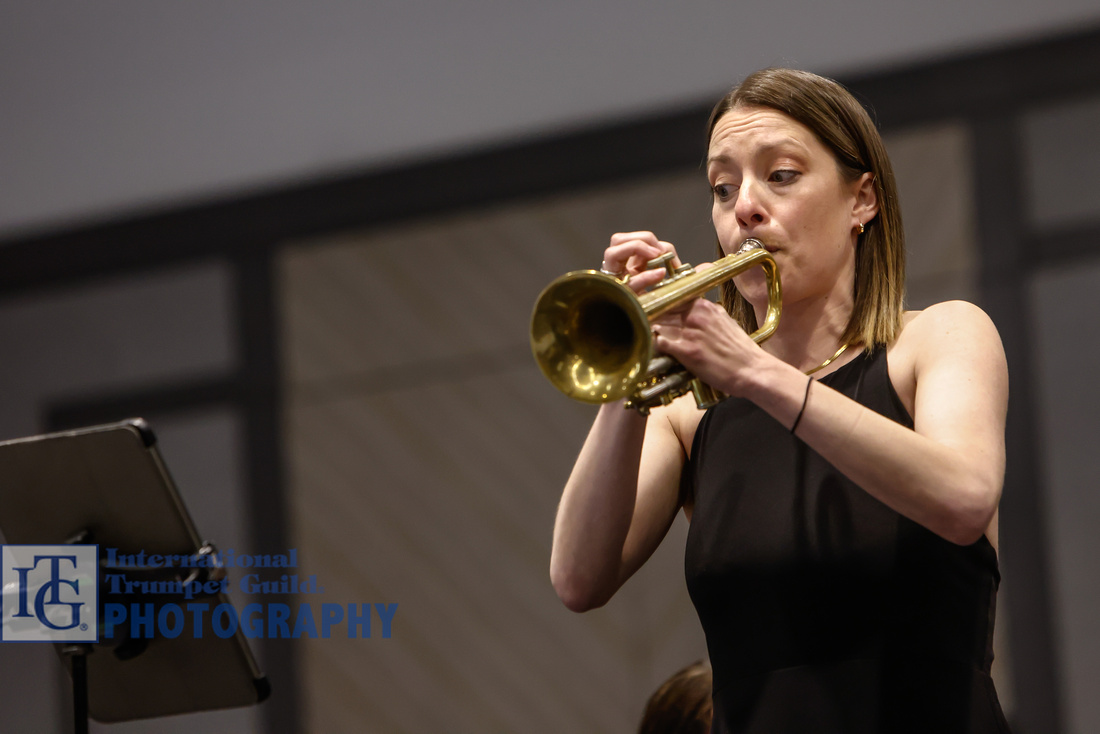
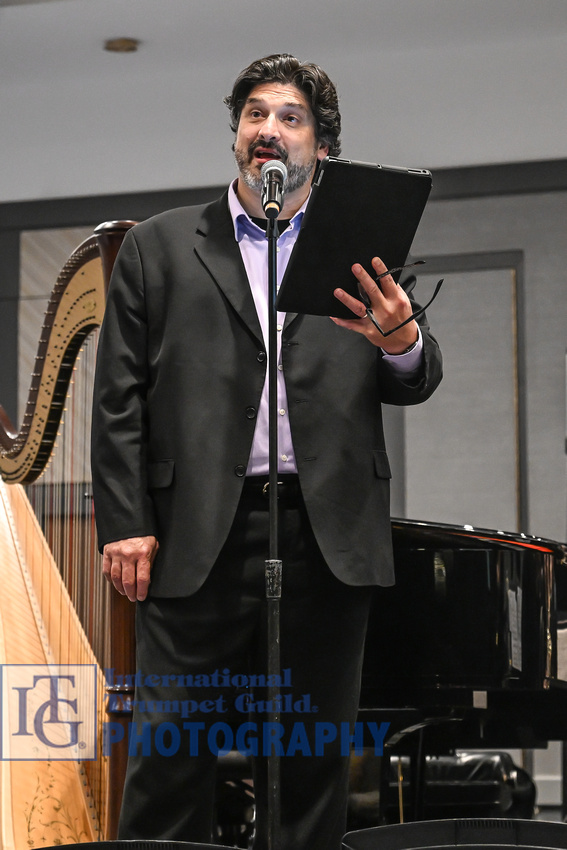
Following the Arban, Dani DeBaza soloed on Agustín Castro Rodríguez’s El Legado de un Maestro. DeBaza’s crystal-clear sound and incredible musical expression prompted applause–even during the piece. David R. Gillingham’s When Speaks the Signal – Trumpet Tonel, featuring soloist Clément Saunier, was next on the program. Saunier’s warm sound and crisp fanfare passages wowed the audience, and the interaction between the wind ensemble accompaniment and the solo lines was seamless and musically effective, with both parties demonstrating a wide dynamic palette. Saunier showcased truly effortless playing and great virtuosity with his performance, featuring a section on piccolo trumpet and culminating in an energetic and exciting finale section that prompted a standing ovation from the audience.
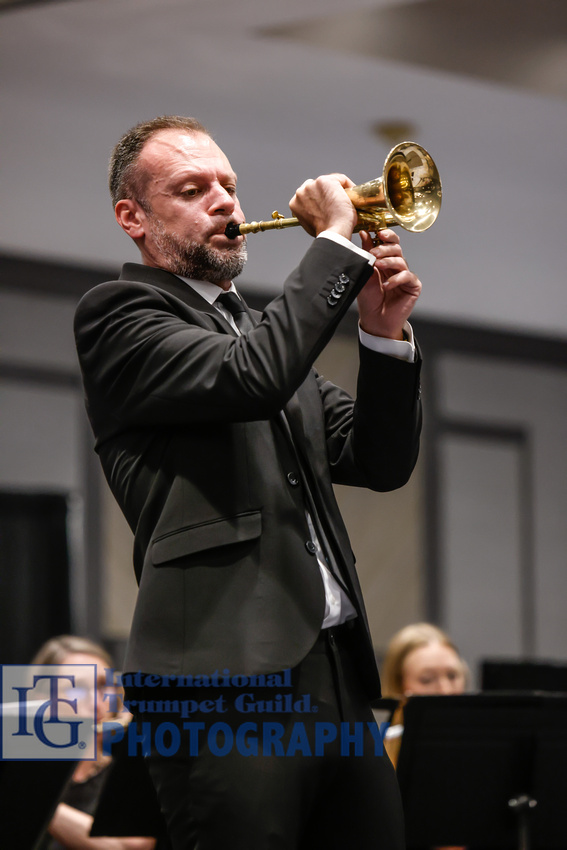
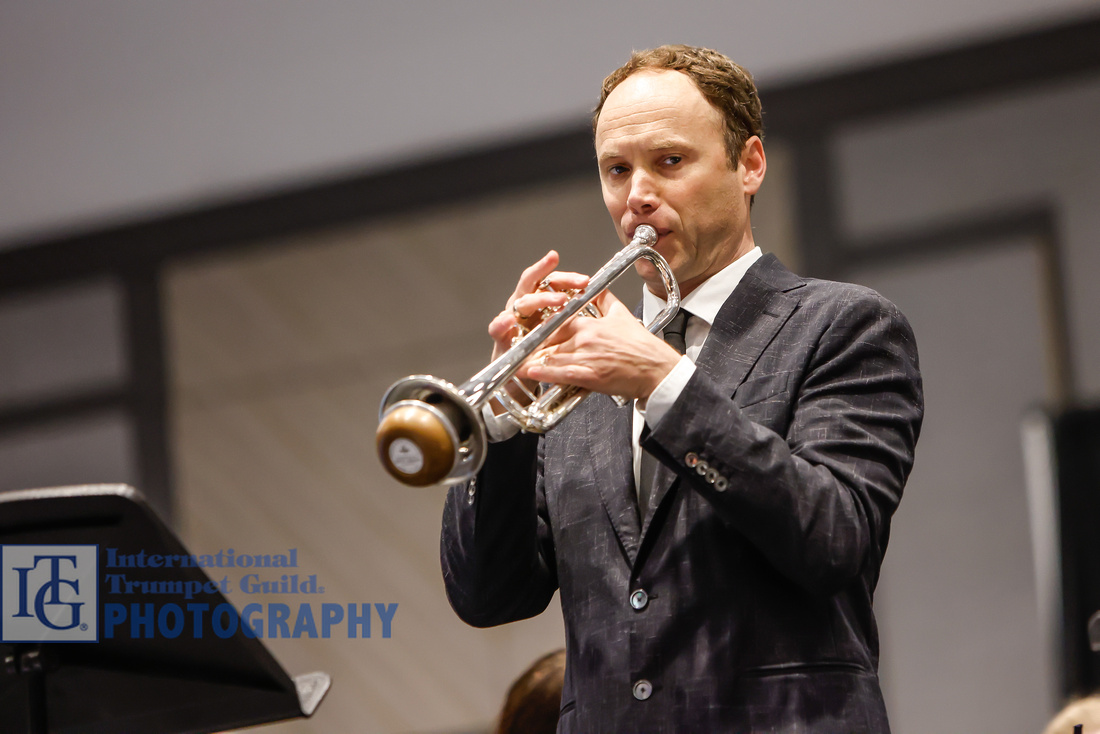
Dani DeBaza then returned to the stage to solo on Agustín Castro Rodríguez’s Liberty. DeBaza’s second performance was just as impactful as his first, showcasing many dynamic peaks and valleys and soaring lines in the upper register, as well as a captivating and artistic vibrato. The next selection featured Thomas Hooten performing Frank Ticheli’s Concerto for Trumpet. Hooten’s performance showcased true virtuosity and finesse in every respect. Flawless technique and impressive musicianship contributed to making this performance captivating and truly stunning. Ticheli’s work contains a wide array of styles, from smooth, lyrical sections to quick, active, and rapidly articulated sections, and each part was met with effectively exaggerated phrasing from both Hooten and the Encore Winds, who performed a musically engaging and impactful accompaniment. Hooten’s pure, warm sound contributed to making this performance memorable, and the audience did not hesitate to meet the final notes of this piece with a highly enthusiastic standing ovation. Following Hooten’s performance, Dani DeBaza again returned to the stage to perform Joan Manuel Serrat’s La Saeta, wowing the audience one more time with his ease and finesse, especially in the upper register. The closing work of the program was William Stowman’s Treaty of Alliance, featuring both Les Trompettes de Lyon and Tromba Mundi. Both groups performed with impressive technical virtuosity and group blend. The finale was engaging and full of energy, prompting thunderous applause from the audience and bringing this program to an exciting conclusion. (Julia Bell)

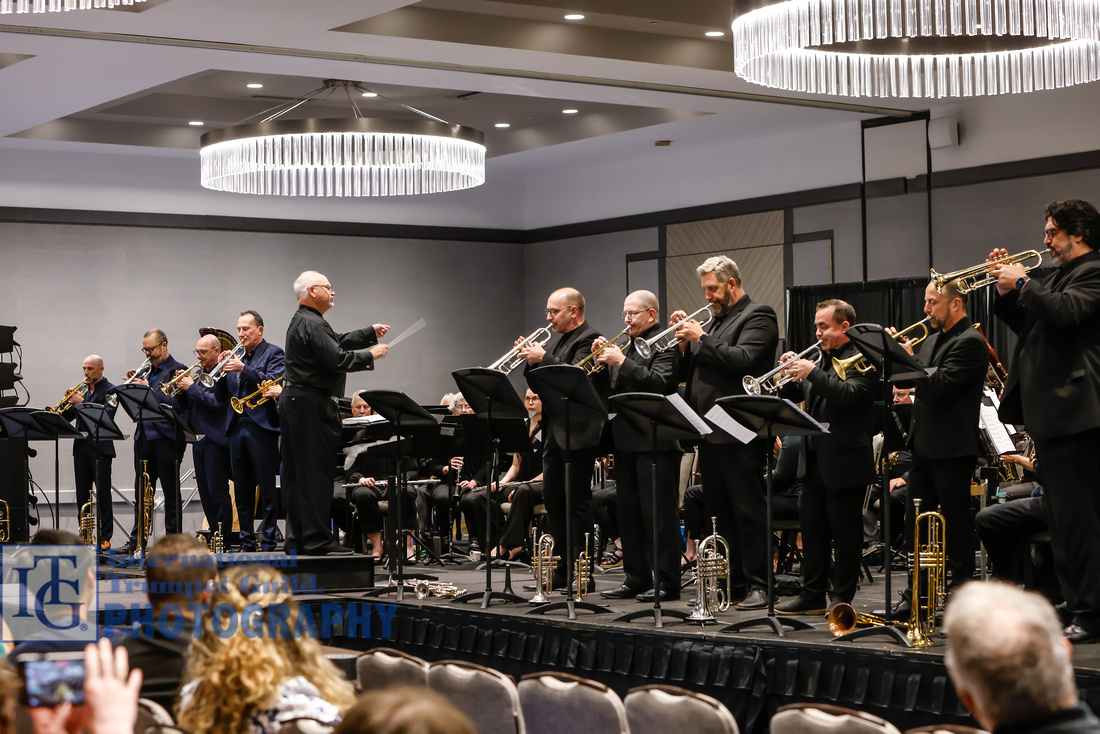
2021 Carmine Caruso Winner Concert - The Beauty of Space with David Sneider
Following a rousing prelude performance by the University of Oklahoma’s Boomer Trumpet Ensemble of Terry Everson’s arrangement of There’s a Great Day Coming and James Stephenson’s Fanfare for an Angel, the concert featured David Sneider, the winner of the 2021 Carmine Caruso International Jazz Trumpet Solo Competition. Starting with a bang, Sneider began with an extended cadenza based on John Coltrane’s Countdown, which led into one of Sneider’s original tunes, Take Space. Sneider led the band into Wes Montgomery’s Road Song and then into the beautiful ballad It’s Magic by Jule Styne and Sammy Cahn. In the theme of the beauty of space, Sneider transitioned into another original tune, It Catches Up. The final tune, Hop, from Sneider’s upcoming album, is a contrafact of “Take the A Train.” Sneider and the rhythm section delivered marvelous solos at every turn on this exquisite program. (Spencer Brand)
Open Jam Session - Scott Belck
In an engaging late-night event, Scott Belck led a dynamic jam session, bringing together the artistry of Mike Frank on piano, Peter Paulsen on bass, and the rhythmic precision of Christopher Hanning on drums. Each musician delivered virtuosic solos, interpreting the tunes with a personalized flair that heightened the experience. Further, an eclectic group of about ten to fifteen trumpet players across diverse age groups joined the rhythm section to perform their chosen jazz standards. The night evolved into an immersive, joyous exploration of jazz music, offering a rich and memorable experience for all. (Andrew Smith)
Click here for more photos from the ITG Conference
]]>
Special Daily Report • Compiled by Peter Wood
Photos by Steven Garcia, Benjamin Lowe, Josh Rzepka, and Michael Anderson
Wednesday, May 31, 2023
Click here for more photos from the ITG Conference
David Collins warm-up session - Physical and Mental Warmup for Positive Performance
This morning’s session with David Collins examined the preparation players can take within the first thirty minutes of their session to facilitate ease of playing. Participants were led through a series of stretches and breathing, leadpipe, and articulation exercises. Collins focused on connecting these exercises to the physical act of playing with the aim of creating one’s easiest tone. (Nathalie Crissela Mejia)
Alongkorn Laosaichuea warm-up session - Get Ready!
Alongkorn Laosaichuea, trumpet professor at Mahidol University in Bangkok, Thailand, led a few dozen attendees in a morning warm-up session. His solid routine, almost instantly memorizable, was great because of its basic approach. Laosaichuea led the group through long tones, lip flexibilities, single-tongue articulations, and most of Herbert L. Clarke’s second study in a call-and-response format that helped everyone model his sound production. Most of his exercises started very simple but gradually developed additional complexities and expanded in range. Laosaichuea mentioned that he was writing a new book and that these wonderful exercises would be included in this first published method for trumpet written in the Thai language. One attendee commented that he felt he was ready to play the Bach Brandenburg Concerto after the warmup! (Stanley Curtis)
Evan Taylor session - Patient Practice
Evan Taylor presented a simple, yet effective, masterclass. Beginning with a spectacular performance of Miles Davis’s Donna Lee, featuring Sam Butler, Evan had five volunteers come forward to play an exercise involving playing the circle of fourths in half notes. The presentation continued with the direct connection vs. diminished connection conflict with which players often struggle. The direct connection is created by slow deliberate practice, while the diminished connection is created by taking things too quickly and reinforcing mistakes. Finally, Taylor showed his four-step process to practice. Slow down before starting to practice to prepare the brain, check your equipment and ensure its functionality, execute your practice, and always rest as much as you play. Evan ended his exceptional masterclass with three ideas to guide practice sessions–figure out your tendencies, confront your deficiencies one at a time, and replace the word “difficult” with “unfamiliar.” (Kyle McLean)
Cynda Fleming session - Kickstart Your Routine with Tech!
Opening with a spirited performance by the Brighton High School Trumpet Ensemble, Cynda Fleming’s presentation focused on incorporating technology into a player’s daily warm-up routine, helping make the warmup more interesting, engaging, and “meditative.” Fleming demonstrated how she uses iPad and tablet apps by involving the group in some flow and articulation exercises based on the works of Vincent Cichowicz and Tony Plog. Some of the apps included were drones like the Cello Drone app, the iTablaPro app (which is traditionally used for practicing Indian tabla and tanpura music), drum machine apps (Groovebox, Launchpad, Drumjam, and Drumbeats+), and the Amazing Slow Downer. (Flint Angeroth Franks)
Non-Pro/Comeback Players Session - Robert Sears - Vibrato Usage
Robert Sears delivered an enthusiastic and engaging presentation on the utilization of “shimmer.” He discussed the distinctions between commercial, jazz, and symphonic styles, and categorized vibrato into three types: hand, jaw, and breath. The reasons for employing different types of vibrato included drawing attention to the musical line, creating a soaring effect, or using it as an ornamentation. Sears encouraged the audience to listen critically to the variations in speed, width, and intensity used by notable artists including, but not limited to, Louis Armstrong, Alison Balsom, Mark Bennett, Roy Eldridge, Laurie Frink, Roy Hargrove, Tine Thing Helseth, Adolph “Bud” Herseth, Matthias Höfs, Freddie Hubbard, Mark Inouye, Wynton Marsalis, Chris Martin, Ronald Romm, Phil Smith, and Snooky Young. (Joe Cooper)
Megan Bailey session - Hearing Aids for Musicians: A Guide to the Process
Dr. Megan Bailey gave an extensive presentation on all topics related to auditory health and deterioration. Bailey highlighted the concerns and potential risks for trumpet players when performing in large ensembles or small spaces where sound output can sometimes reach unsafe decibel levels. After detailing the basic ear anatomy, the discussion turned to common hearing injuries and causes. Bailey addressed preventive measures, recommending different styles and brands of ear plugs to help musicians maximize protection while still offering the ability to hear across an ensemble. Bailey detailed different styles of hearing aids, as well as the process of working with an audiologist to get the best product for your performance needs. Bailey’s candid telling of her own experiences using hearing aids helped attendees understand the complex needs to consider as a musician and offered helpful advice for those needing hearing assistance. (Eric Millard)
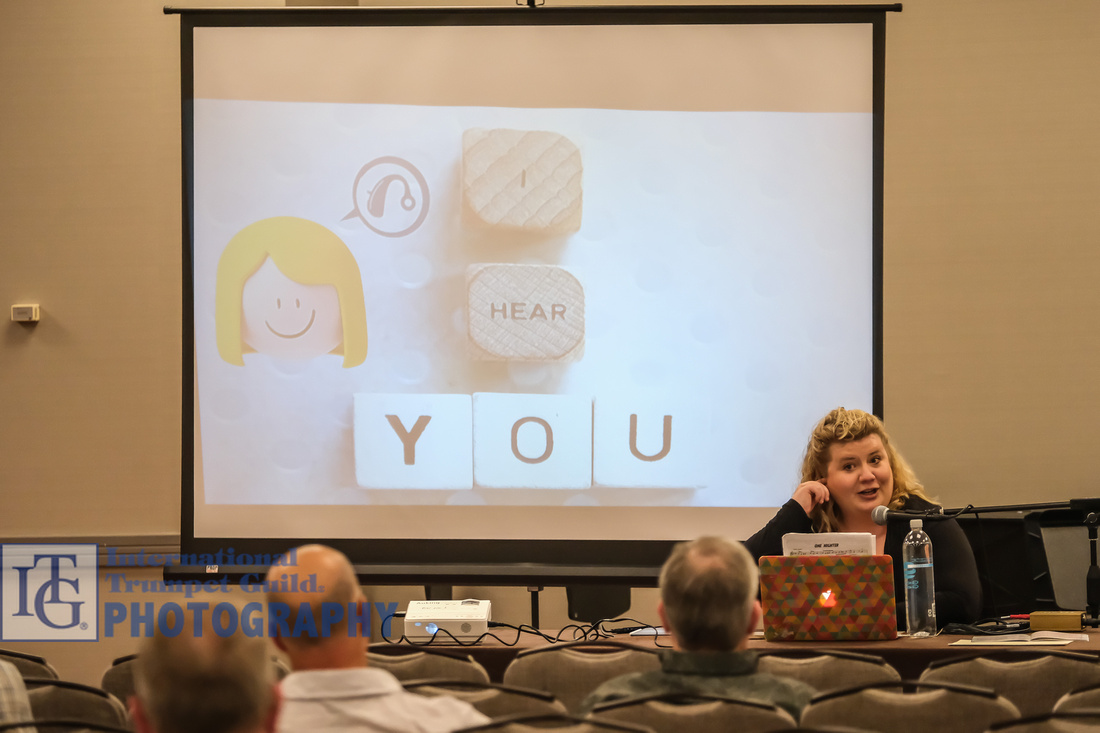
New Works Recital I
The first of three New Works Recitals opened with Sam Gustavson performing Chris Evan Hass’s Sonata for Tomorrow with collaborative pianist Miriam Hickman. Light, upper-tessitura playing with commercial-sounding harmonies in the piano set the tone of the opening work. Playful ideas with muted trumpet and syncopated piano, interspersed with more lyrical sections in a half-time feel, highlighted Gustavson’s inspired performance, as well as a brilliant closing with piccolo trumpet.
James Stephenson’s Variations on a Theme by Haydn was composed over a decade ago; however, this was a welcome addition to the New Works Recital as trumpet soloists continue to gain appreciation for Stephenson’s growing catalog of music for trumpet. There could be no better theme for this than the second movement from Haydn’s famous concerto. The theme and six increasingly complex cornet-style variations were beautifully rendered by soloist Josh Ganger and pianist Hickman.
Jess Turner’s Mocking Midnight opened with quick, effective mood changes. Various colors and textures, including Harmon mute with and without stem–at times with flutter tongue and swift dynamic changes–highlight the work. Will Koehler, with pianist Hickman, presented a particularly convincing and well-blended performance of this extensive, intense, and demanding work.
Kevin Day’s Enigma brought a fine change of color with Jen Oliverio playing cornet and flugelhorn and Hickman once again accompanying. A fast-driving section with virtuosic excursions flawlessly sounded by Oliverio and contrasting lyrical diversions made for a dramatic performance. Trumpeters seeking great new music and more diverse and inclusive repertoire should rush to seek out this work by the award-winning composer.
Brazilian music has been taking a stronger foothold within the trumpet repertoire, and this new work performed by Nailson Simões, one of Brazil’s leading proponents of music for trumpet and brass, was a welcome addition to the recital. The Four Last Seasons by Gilson Santos provided a melancholy departure from the previous music with Simões using an abundance of soaring portamentos, a singing sound, and a bel canto vibrato to convey vivid emotions with pianist Hickman. Due to time constraints, only two of the four movements were performed–Verão (Summer) and Outono (Autumn).
Concluding the recital was Kevin McKee’s Fantango, performed by James Johnson on trumpet, Kiirsi Manula-Johnson on horn, and Amanda Arrington on piano. As one might expect, a Latin flair was immediately present from the onset. The title originates from the words “fantasia” and, of course, “tango” and can be performed with trumpet and flugelhorn if preferred. Commissioned by the trumpet and horn duo and performed superbly, this was a perfect conclusion to an outstanding New Works Recital. (Luis Engelke)
Brian Evans lecture recital - The trumpet is(as) a voice…the voice is(as) an instrument
Introduced by the Glendale Community College Trumpet Ensemble, Brian Evans led a captivating lecture recital that was focused on using the human voice as inspiration for trumpet playing. Performing two world premieres (Gregory Pascuzzi’s In Flanders Fields and Robert J. Bradshaw’s Dive for Dreams) and a USA premier (Alan Holley’s Sorrel), Evans beautifully captured the inflections and nuance of the voice and of spoken text through his performance with pianist Rebecca Wilt. The performance also included some alternation of vocalizing and trumpet playing by Evans in both Dive for Dreams and In Flanders Fields. Between pieces, Evans discussed his inspirations and talked about which chakras host the voice and breath. He also explained how playing in the Australian Opera helped him use the voice as a model for his trumpet playing. The lecture additionally covered how Evans relates these concepts to articulation, phrasing, and airflow. (Flint Angeroth Franks)
Elijah Denecke lecture recital - Reexamining the Repertoire: French Women Composers of Solo Trumpet Music at the Paris Conservatory
Dr. Elijah Denecke presented a phenomenal lecture recital in which he discussed such composers as Yvonne Desportes (1907-1993), Jeanine Rueff (1922-1999), Claude Arrieu (1903 - 1990), and Betsy Jolas (b.1969). Denecke asked the audience, “Why do we play the music we do, and how can we update the trumpet repertoire?” Denecke encourages diversity in programming and aims to further deconstruct stereotypes in the brass world. The pieces performed encompass the morceaux de concours (contest pieces) written by women for trumpet and cornet at the Paris Conservatory during the twentieth century, as they were not performed as much as those by their male colleagues. He discussed how and why certain works have been excluded from the standard solo repertoire. Denecke provided a reference of pieces, played for juries, recitals, bands, and symphony orchestras, composed by women within the Paris Conservatory. Denecke’s playing embodies artistry and enjoyment, truly captivating the audience with his finesse in both sound and technique. (Angela King)
Micah Killion session - Making the Undoable Doable: The Core of Expert Music Practice
Micah Killion has spent much of his research studying how expert musicians transform habits through high-quality practice, and he explained his findings in an informative session. Killion reminded the audience that improving performance requires refining movement triggered by motor commands. Three words–intent, prediction, and feedback–were dominant throughout Killion’s presentation. Intent is the first necessity in expert practice. When an expert begins a practice session, they know how they want the music to sound in detail. The musician then predicts what action leads to the desired results. Once the action is completed, they assess whether the feedback was a match or mismatch to the prediction. According to Killion, mismatches are more valuable in expert practice as improvement is dependent on reducing discrepancy between prediction and feedback. As a result, experts can predict the outcomes of an action with greater accuracy. (Christopher Luebke-Brown)
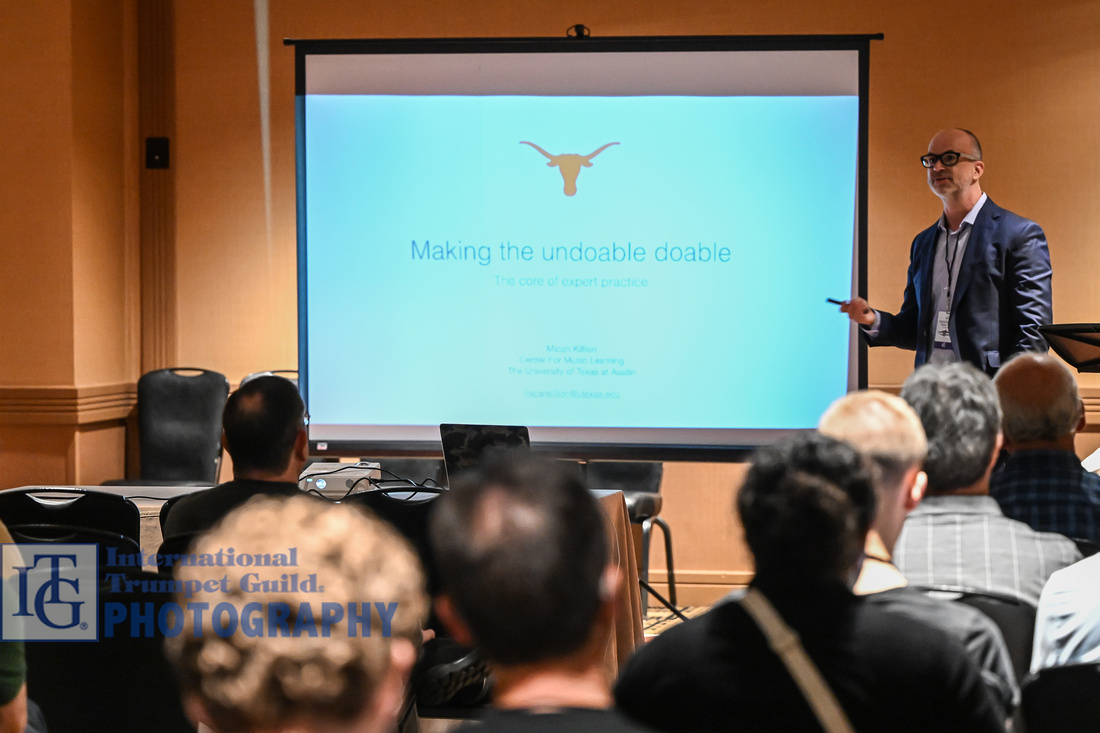
R. Dale Olson session - The Mythical Trumpet Mouthpiece
This session explored the history of the mouthpiece and the misconceptions about mouthpiece design. Olson called this “the most discussed, but least understood, element of brass performance.” Although he retired in 1990, Olson has been studying mouthpiece design since he was sixteen. He discussed mouthpiece designs dating back to 1500 BC, with information on measurements and sizes. Olson announced his plans to publish two new books in the future, the first entitled Chronology of Innovation: Trumpet Patents, in which Olson reviews past trumpet patents that now total over 1,000. The second book, A Longitudinal, Quantitative Assessment of Brass Musical Instrument Mouthpieces provides quantitative data on trumpet mouthpieces and their uses. This session provided invaluable insight on lesser-known information about mouthpieces and trumpet history. (Madison Barton)
James Olcott - Trumpet Ensemble Reading Session for All
A recurring favorite of ITG Conferences has been the trumpet ensemble reading session led by James Olcott, arranger and publisher of trumpet ensemble music (found on his Triplo Press website). This year was no different with an amazing hour-long reading session. Some of the highlights included an unpublished arrangement of Richard Strauss’s Vienna Fanfare for sixteen trumpets. The 35 trumpeters in attendance read through an Amadeus publication of the Charamela Real No. 54, one of the many anonymous Portuguese trumpet fanfares from the eighteenth century. Olcott’s arrangement of JS Bach’s “Ehre sei dir, Gott” (Triplo Press), the opening chorus of part five of the Christmas Oratorio, was a challenging musical treat for everyone. The favorite piece of many participants was the unpublished arrangement (by Olcott) of Wesley Nance’s A Brief Adventure for 23 trumpets. Nance’s original work had motor rhythmic sections contrasting with a slow section and was reminiscent, perhaps, of some of Danny Elfman’s movie scores. Next, the group played a difficult unpublished arrangement of Wagner’s Elsa’s Procession to the Cathedral for twelve trumpets. Malcolm Arnold’s amazing A Hoffnung Fanfare (Triplo Press), is available for 12 or the original 36 trumpets, and the reading group played nearly every part of the 36-part version. The session ended with Carmen Dragon’s arrangement of America the Beautiful, rearranged by James Olcott and available on Triplo Press. This popular staple of patriotic music is sure to be a crowd-pleaser. (Stanley Curtis)
Armida Rivera-Reyes session - Hompak: The Mayan Trumpet - Rediscovering the Trumpet from the Land of the Jaguar
This session, led by Dr. Armida Rivera-Reyes, opened with a lively performance by the William Carey University trumpet ensemble, featuring works by Cameron, Ost, and Stephenson. Rivera-Reyes presented her research surrounding the “Hompak,” or trumpet used by the Mesoamerican Mayan civilization. Though many instruments were destroyed by Spanish conquistadors during their invasion, Rivera-Reyes brought to light information passed down through generations of indigenous peoples. The presentation covered topics such as its use in rituals and festivals and delved into the process of making the instrument out of carefully selected parts of the agave plant. Rivera-Reyes is continuing her research with the crafting of many Hompaks to explore the sound of the ancient trumpet ensemble that Mayans would have heard in their time. (Nathalie Crissela Mejia)
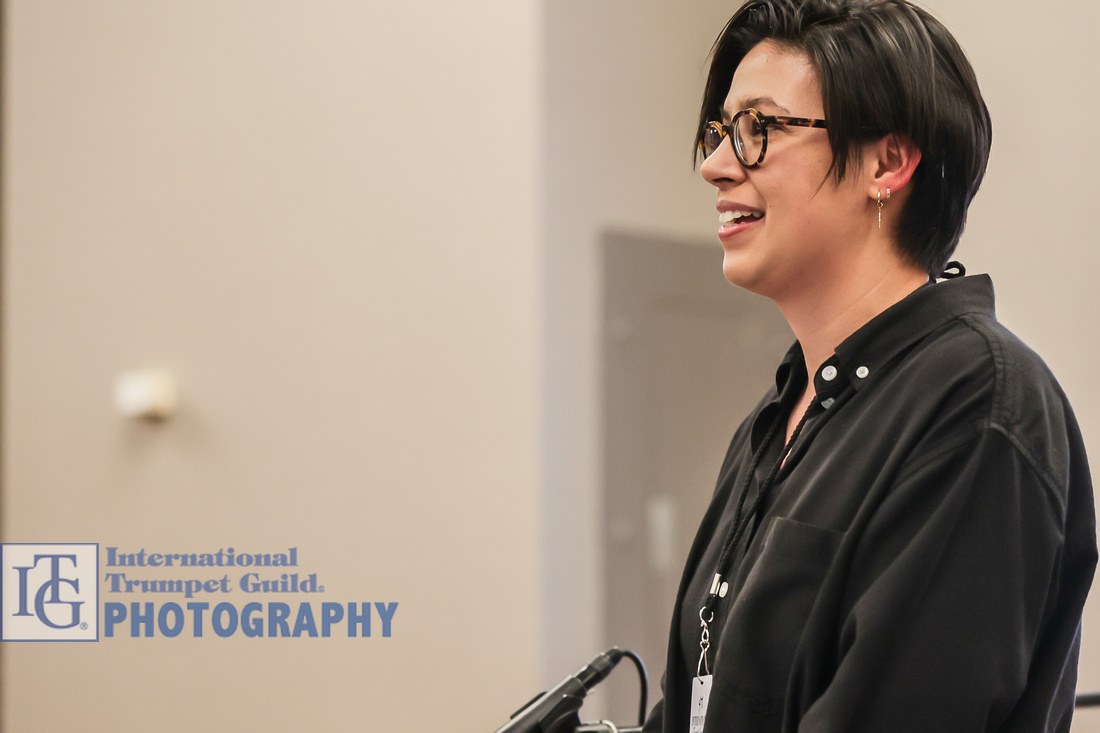
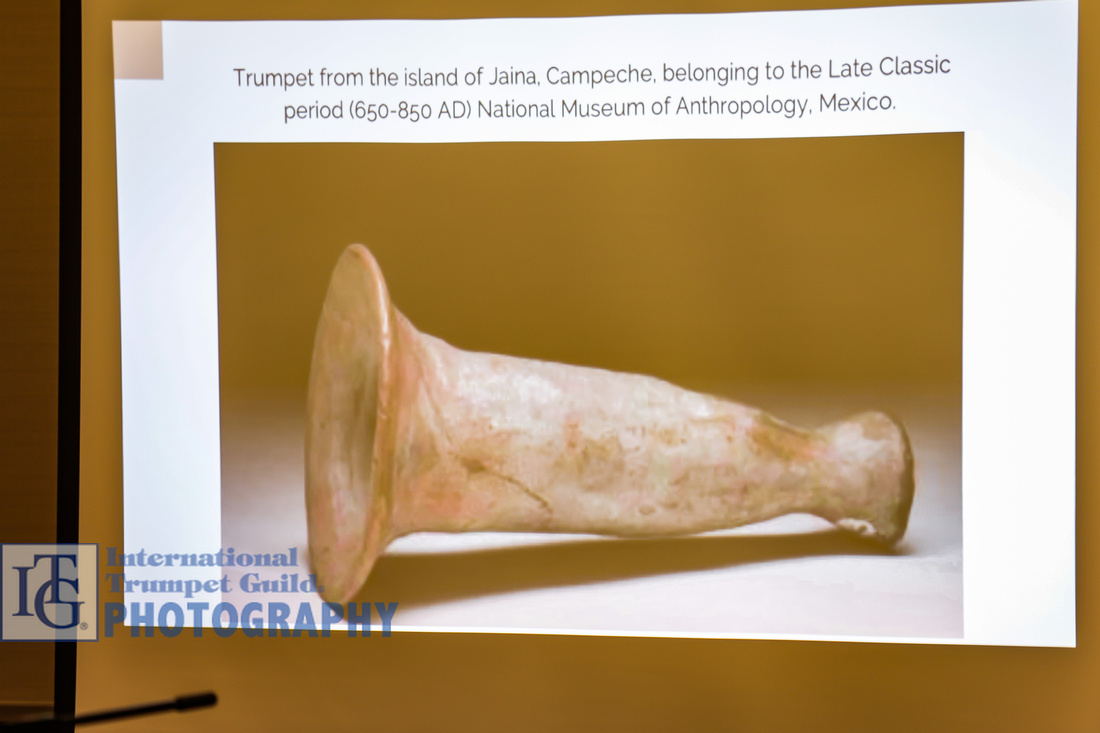
Research Room - Paper Presentations
This year’s ITG Research Room featured four presentations that explored deeper insights into how we use new and existing repertoire. Julia Bell analyzed eight solo trumpet pieces composed by women, arguing their importance in the collegiate trumpet curriculum. Flint Angeroth Franks addressed discrepancies in difficulty evaluation systems in music and developed the Difficulty Assessment Rubric for Trumpet Solos (DARTS). This tool rates 14 technical aspects of a piece, aiding educators and performers in selection and assessment. Brian Reichenbach found a connection between the etudes of nineteenth-century violinist Heinrich Kayser and cornetist Herbert L. Clarke. The comparison between the etudes provided insights into the adaptations made by Clarke to enhance cornet technique and develop musicality. To conclude the session, Spencer Brand presented his research on Czech trumpet music from the Communist era, aiming to broaden the awareness of Czech solo trumpet pieces from this period. (Andrew Smith)
Nitiphum Bamrungbanthum Recital: Awaken The Giant Dream
The Peabody Graduate Trumpet Ensemble, under the direction of Dillon Parker, provided a lively and spirited performance of José Ursicino da Silva’s popular four-movement Fantasia Brasileira as the prelude to this afternoon’s recital by Nitiphum Bamrungbanthum. His program included four works accompanied by outstanding collaborative pianist Maria Rutkowska. Opening with Haydn’s Trumpet Concerto, Bamrungbanthum’s lyricism and evenness of sound throughout all registers was immediately evident–qualities that must have captured the attention of the audition committee that selected him as principal trumpet of the Hong Kong Philharmonic Orchestra in 2021. A flowing second movement with a feeling of two and perhaps brisker than many performances was a genuine highlight. Alexander Arutiunian’s Trumpet Concerto served as the perfect vehicle for Bamrungbanthum to display his diversity in providing musical interest through a completely different style and nuance–specifically far more dramatic phrasing, rubato, and vibrato. James M. Stephenson’s Concerto No. 1 and Reflections served to further showcase Bamrungbanthum’s dazzling musicianship and technique. Hearing such excellent performances from players around the world must have been a highlight for many in attendance. This was a wonderful recital that was immediately acknowledged with an enthusiastic standing ovation. (Luis Engelke)
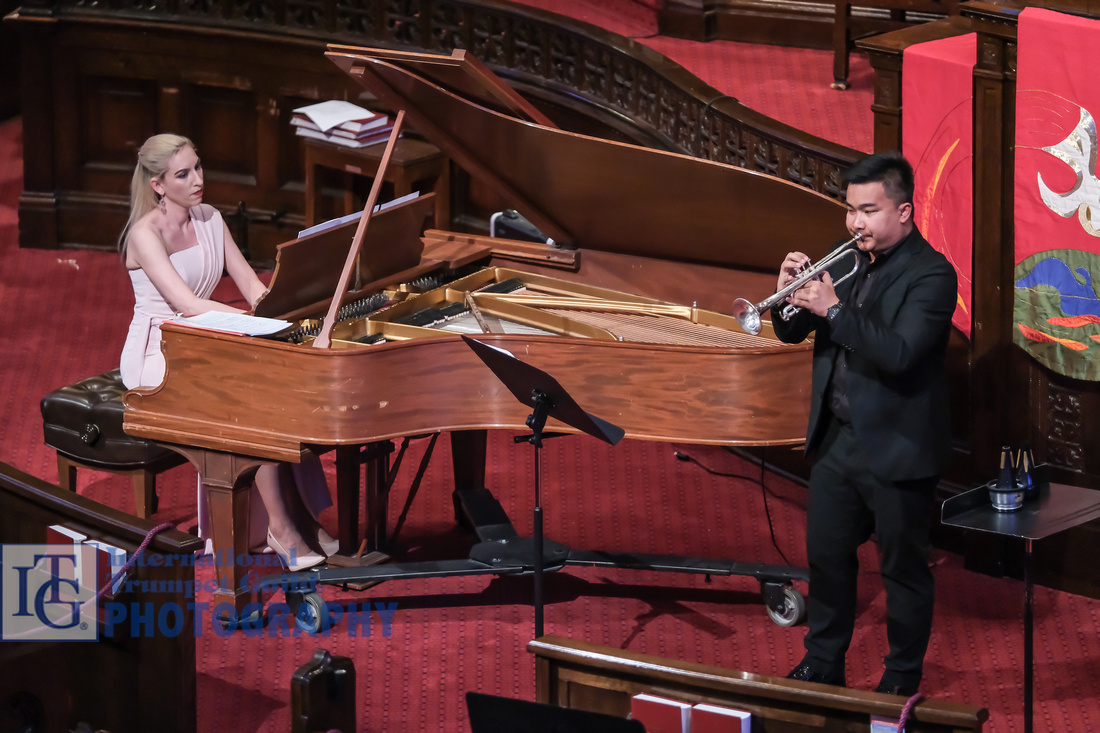
Meet and Greet - Non-Pro Player Meet & Greet Gathering
The Non-Pro Player reception at Brit’s Pub was an opportunity to reunite with old friends and make new ones. Led by Dan Hallock, the meeting included a summary of the 2023 Conference’s Non-Pro Player events and plenty of time for mingling. Dozens of members of the non-pro player community socialized with each other and with several representatives from the ITG board of directors, as well as ITG President Jason Bergman. The group was also joined by two past ITG presidents and several of this year’s Non-Pro event guest artists, including Robert Sears and Chris Moore. Attendees included not only local trumpeters, but also those who traveled from all over the globe. (Julia Bell)
Meet and Greet - Pre-Professional Social
This reception was the first meeting for the newly established group Students and Pre-Professionals of ITG. With over 150 members in attendance, they enjoyed games, prizes, and a Q&A session with Matilda Lloyd. Additionally, each semi-final competitor was recognized and awarded a certificate. This event gave pre-professional members a chance to connect and communicate with members of the board and with each other. Members were placed randomly at each table and were encouraged to come up with one question to ask Matilda in the Q&A. With over $3,000 in sponsored prizes, attendees participated in a raffle and competed for prizes with trumpet trivia. Food for the event was sponsored by Dr. Grant Manhart and Jesse and Mindy Craig. (Madison Barton)
Evening Concert - Etienne Charles: Creole Soul
The prelude ensemble for this highly anticipated concert was the Gallatin Trumpet Ensemble from Montana State University. They demonstrated sonorous ensemble playing, beautiful solo moments, and lots of energy across their three pieces.
Christopher Moore’s performance of the 2021 ITG Commission from the Native American composer R. Carlos Nakai. This work, which traces a personal history and connection between disparate cultures, is a blend of lyrical, live solo trumpet with recorded Native American instruments. The composer himself, a former trumpet player, has eleven Grammy nominations for his recordings of Native American flute. The fluid interplay between trumpet and the recorded media was powerful to experience.
Etienne Charles with his band, Creole Soul (Louis Godwin, Axel Laugart, Harvel Nakundi, Brandon Rose, and Alex Wintz), then took to the stage, demonstrating supreme artistry from the outset. The opening number was one of Charles’s own compositions, Dame Lorraine. The building energy of this Latin-flavored hard-bop fusion set the stage for a high-energy set. It was quickly followed by a beautiful version of the Lionel Belasco classic Juliana, an Antillean waltz with playful and joyous piccolo trumpet playing.

From the Charles’s recent album Carnaval came two movements from his Black Echo Suite, “Bamboo” and “Iron.” The suite takes the listener on a journey through the evolution of percussion on his home island of Trinidad. Linking the powerful images and sound from the videos on screen to the live and often powerfully frenetic energy of the band was emotive and effective, conveying a deep love and respect for the music of his heritage.
Dans Mon Ile brought a calmness to the room with truly incredible lyrical and flowing music making. This is a Bossa tune by Henri Salvador, often credited as being the biggest influence on Antonio Carlos Jobim’s becoming a Bossa composer.
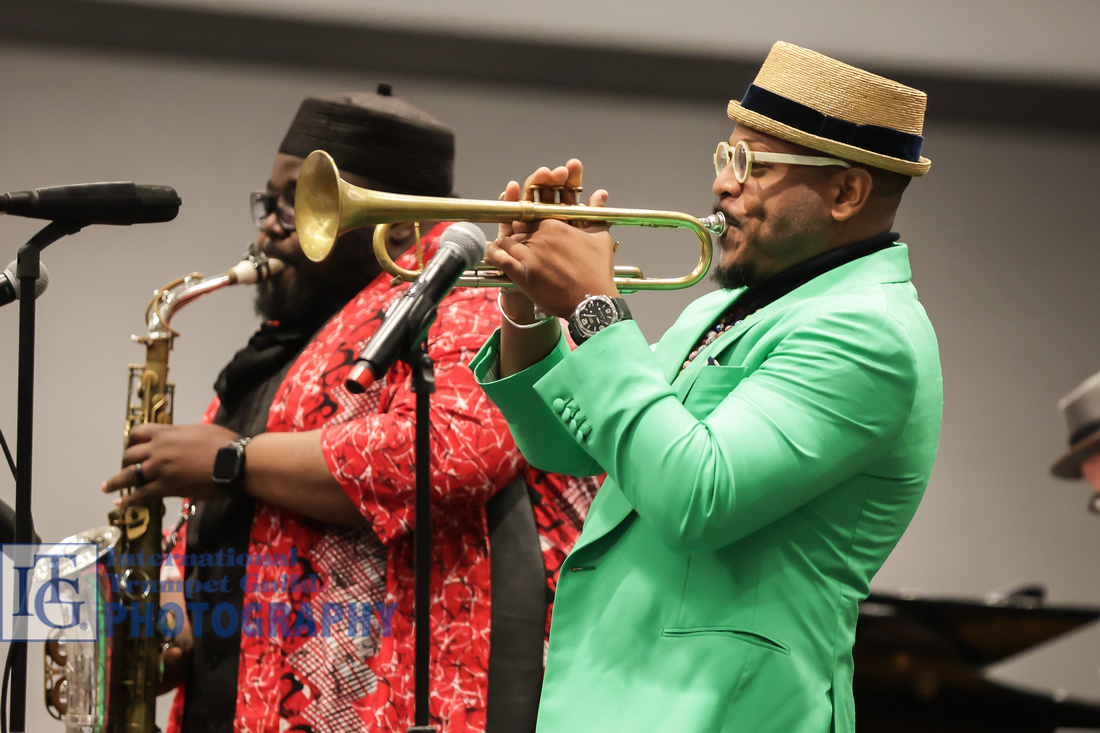
The energy then shifted back up a gear with another track from the Carnaval album, Jab Molassie, representing an old ritual including paint, fire, rhythm, singing, and improvisation. This powerful tune combines the spectacular video images on screen (and accompanying screaming), with immense power from Etienne and Creole Soul.
Santimanite is an old favorite of the band from their Folklore album, bringing a magical reverence to the room for its opening trumpet soliloquy. Incredible solos across the band (with a roof-lifting piano solo), combined with driving calypso rhythms, brought the audience to its feet to acknowledge these spectacular artists.
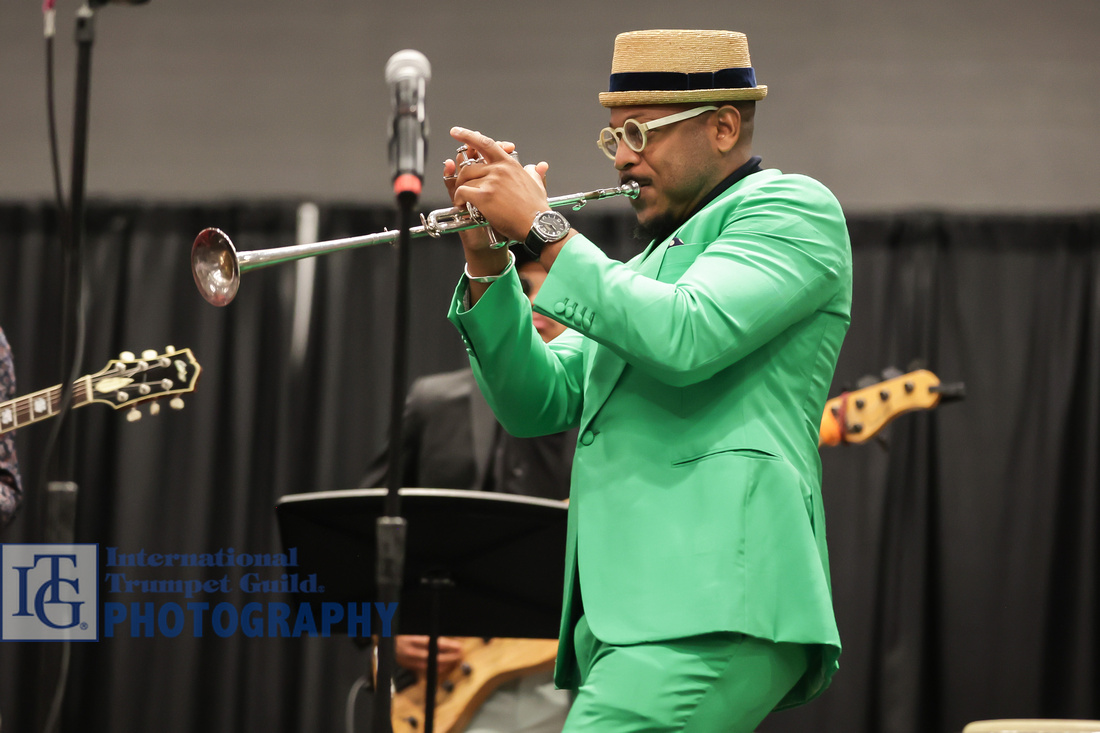
It was also wonderful to hear Etienne give warm acknowledgement to his former teachers in the audience and to the ITG for the influence that his first conference in Fort Worth in 2003 had on him. (John Hutchinson)
Concert - Nadje Noordhuis and John Raymond
The 188th Army National Guard Trumpet Ensemble delivered a fantastic opening concert, showcasing their talent and versatility. They performed a brilliant fanfare, a delicate antiphonal choir piece, and an exciting composition that featured quotes from several renowned composers. The group’s outstanding balance and command of various styles was captivating and well received by all.
Nadje Noordhuis opened the main concert with her original composition, Full Circle. From her very first note, her beautiful and full sound immediately filled the hall. She played a fantastic solo that contained very expressive and vocal lines, showcasing a full command of the instrument. Her next tune was the tango The Little Town of Le Hameau Omi. Again, her lush tone was on display, along with impeccable phrasing and smooth, silky lines. For her third tune, Entwine, she switched to flugelhorn, on which her delicate and sensitive approach was greatly appreciated by the audience. Of particular note was the quality of her low register. Everything was played with intention and a singing quality. To close her set, she performed Northern Star, featuring looped trumpet, which added a gorgeous, ambient quality to the ensemble.
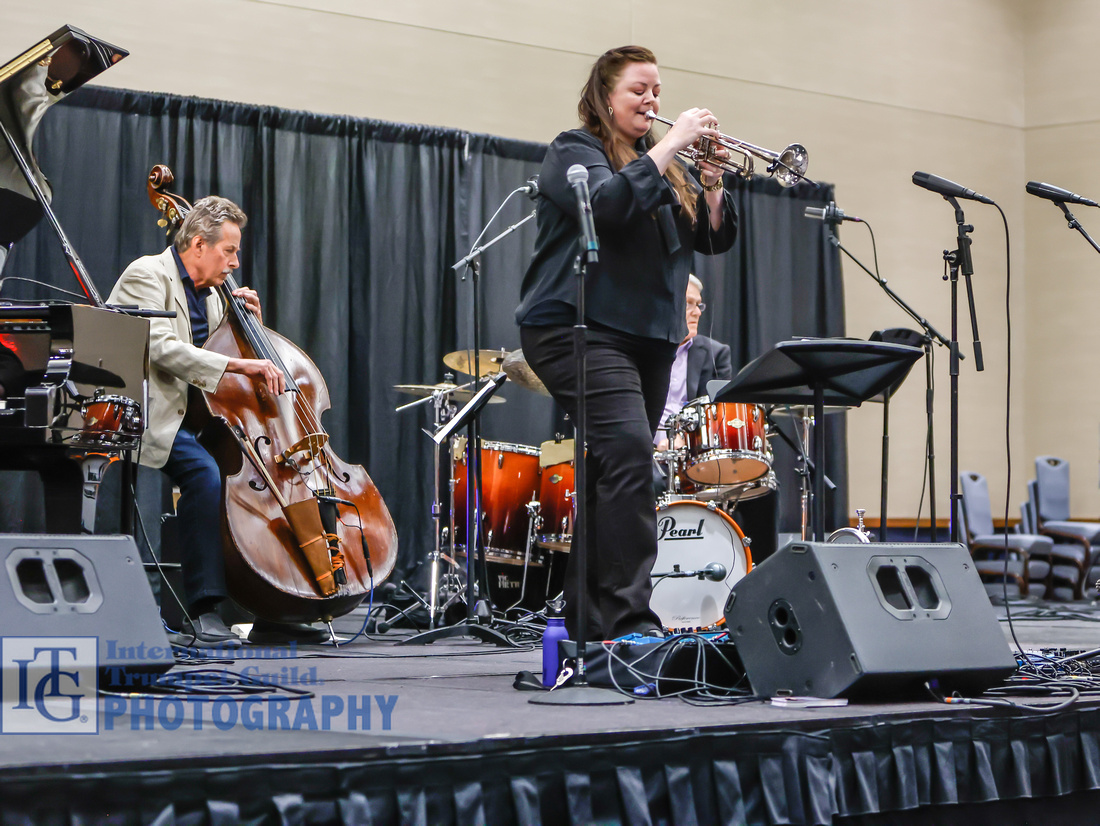
John Raymond started his set with an original composition of his own, Driftless, displaying a burnished and full sound. Also utilizing the entire range of his instrument, his lines throughout the solo were expressive and soulful. The next tune he chose was a cover of the Bon Iver tune Minnesota, WI, which employed amplified trumpet. A highlight of this tune was Raymond’s fluid, agile lines combined with harmonic sophistication. His third tune, Transient, came from his soon-to-be-released album, Shadowlands. Raymond switched to flugelhorn for this composition, revealing a more haunting, brooding sound that provided a beautiful color change for the audience. Throughout the tune, he began to loop different lines that created an incredible sonic experience. He closed his portion of the program with an original composition entitled North. Mike Frank opened the tune with a great piano solo, and then Raymond soared with impassioned lines, playing with a fiery, bold sound. The rhythm section responded beautifully to his motivic development throughout the entire set.
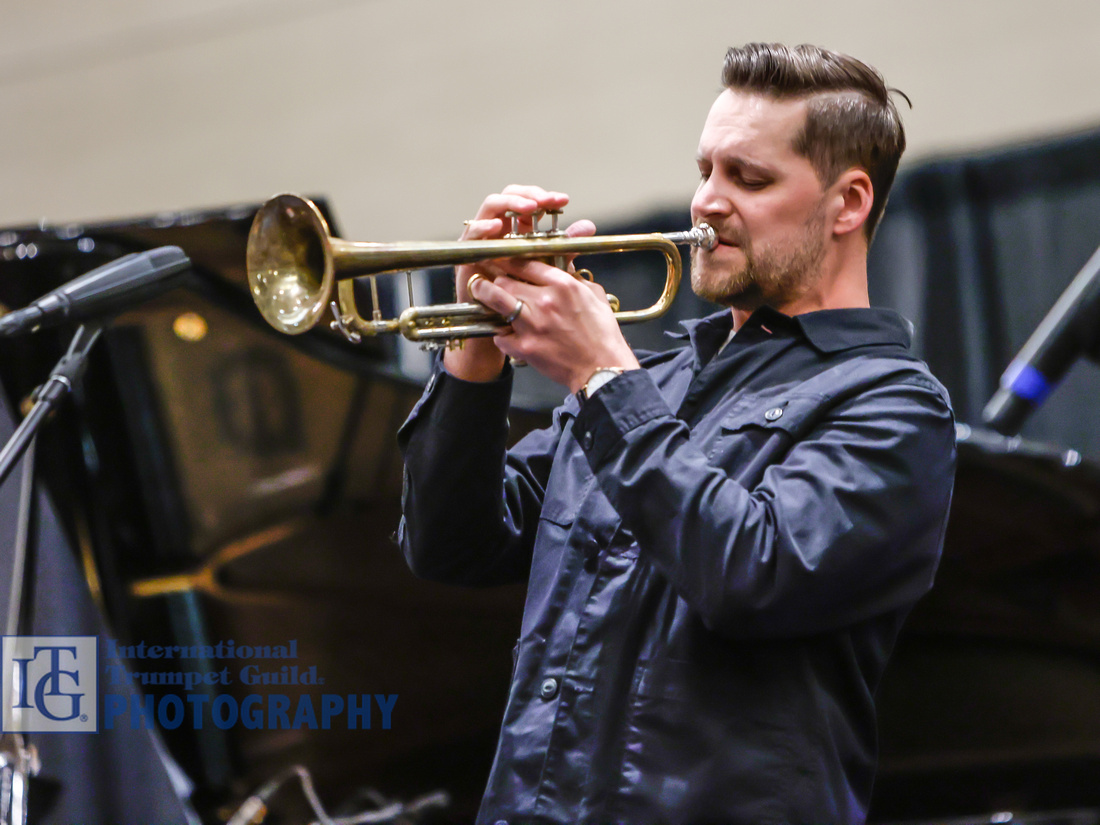
To close, Noordhuis and Raymond joined forces on Kenny Wheeler’s Kindfolk. Both playing flugelhorn, their sounds melded beautifully together while still retaining their distinct, original voices. Each played fantastic solos and had some exciting moments while trading bars in the final chorus. Special thanks to the Conference Jazz Trio–Mike Frank, Peter Paulsen, and Christopher Hanning–for their impeccable playing throughout the night. (George Carpten IV)
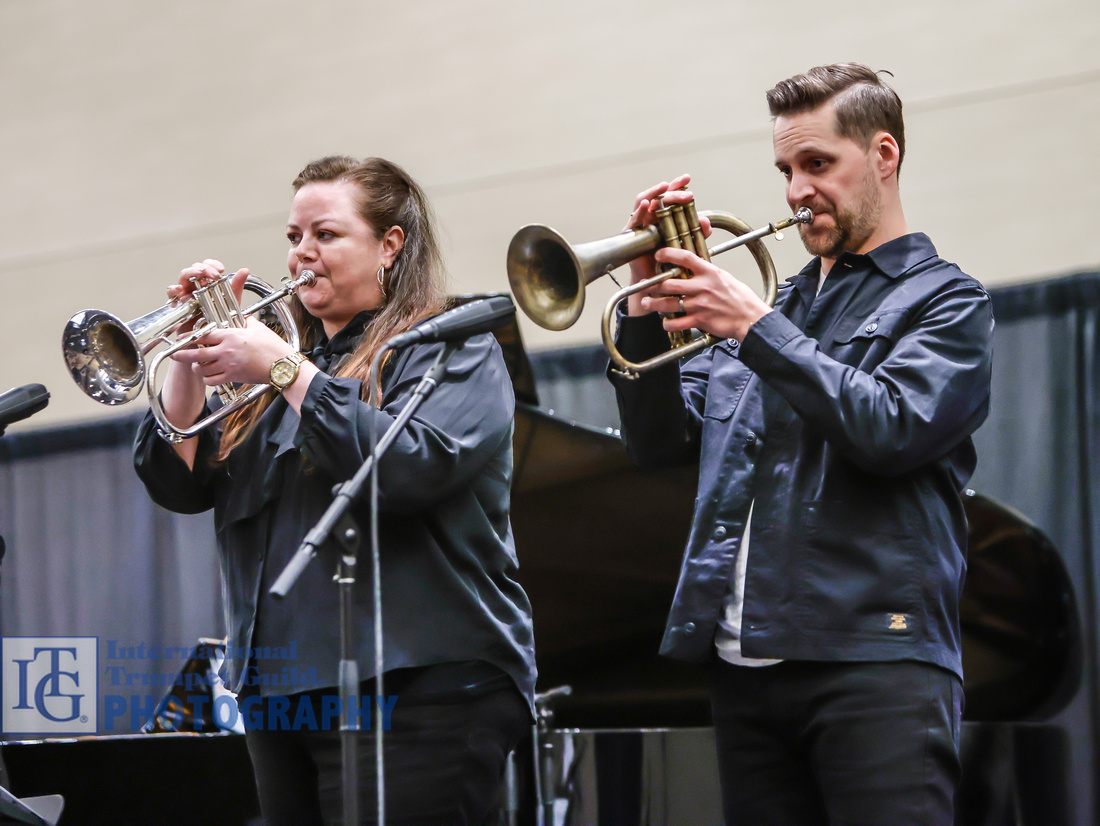
Open Jam Session - Oscar Passley
Oscar Passley grabbed his flugelhorn as he welcomed attendees to the late-evening jam. Kicking off the session with Recorda Me, Passley and companions established an enjoyable and inclusive ambiance. The relaxed and electric atmosphere motivated several attendees to join them on stage for A Night in Tunisia, followed by Solar, and concluding with F Blues. The participants found themselves in excellent company with Mike Frank on the piano, Peter Paulsen on the bass, and Christopher Hanning on the drums, all performing with elegance and attentiveness to each soloist, thus creating the perfect setting to unwind at the conclusion of day two. (Joe Cooper)
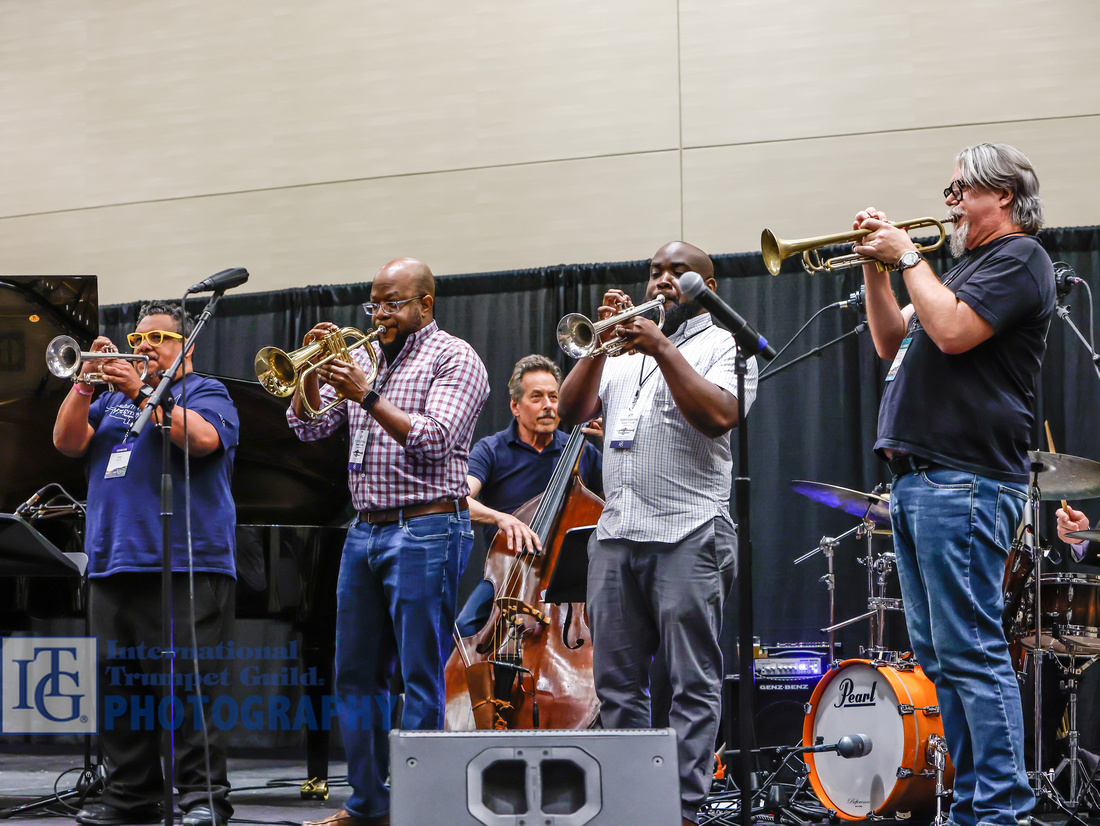
Click here for more photos from the ITG Conference
]]>
Special Daily Report • Compiled by Peter Wood
Photos by Steven Garcia, Benjamin Lowe, Josh Rzepka, and Michael Anderson
Tuesday, May 30, 2023
The vibrant city of Minneapolis is abuzz with anticipation as we open the doors to the 47th annual International Trumpet Guild Conference. Trumpet players and friends from around the world are arriving throughout the day, and the air is filled with smiles, handshakes, hugs, and laughter in a warm, reunion-like atmosphere. For the next four days and five nights, they will immerse themselves in a week of trumpet-related events that promise to entertain, educate, and inspire. Located in the heart of downtown Minneapolis, the Hyatt Regency hotel hosts an incredible array of state-of-the-art facilities that are sure to meet and exceed the extensive needs of this annual gathering. Just steps away, the Nicollet Mall area also has a lively atmosphere and an array of attractive restaurants of all sorts. As the trumpet enthusiasts pour in, expectations are high for yet another memorable conference, filled with music, camaraderie, and a shared love for this magnificent instrument.
Click here for more photos from the ITG Conference
ITG Golf Scramble
Overnight storms cleared for a beautiful day on which to hold the second annual ITG Golf Scramble at Theodore Wirth Golf Club. Three teams squared off on the hilly, picturesque course to raise money for ITG Conference Scholarships. The day began with a putting contest (won by Jason Crafton, Virginia Tech) before proceeding with eighteen holes in the “best ball” format. The winning team at six under par included Spencer Barham (Louisville, Kentucky), Austin Efflandt (Luther College), Michael Le, and Steve Leisring (University of Kansas). Special thanks to ITG board member Brian Walker for organizing the event. Look for details about the next scramble in Anaheim next year. It is fun and for a great cause! (Grant Peters)
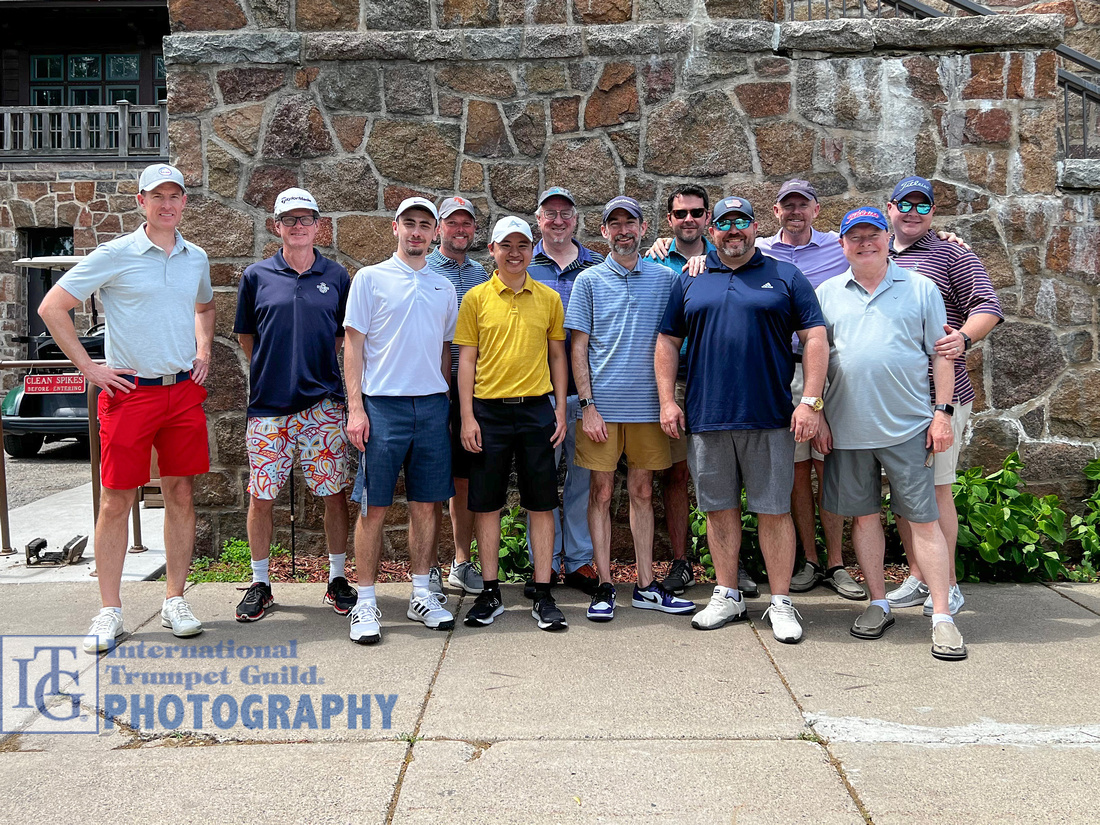
Bria Skonberg - Female & Non-Binary Trumpet Players Summit
Bria Skonberg led a thoughtful, open discussion regarding the cross-generational experiences and challenges faced by female and non-binary trumpet players. Through community-building exercises, attendees explored resources and ideas that can be used to support and uplift this group of trumpet players. The group looks forward to the continuation and expansion of these summits at future Conferences. (Nathalie Crissela Mejia)
Opening Mass Trumpet Fanfare with David Hickman
The Great Lakes Ballroom was filled with an eclectic trumpet ensemble consisting of hundreds of conference attendees. Leading this impressive gathering was renowned artist and teacher David Hickman. Hickman admitted that the chosen repertoire this year was more complex than other iterations of the opening fanfare, but he encouraged the performers to embrace the “adventure.” During rehearsal, Hickman called on audience attendee Charlie Schlueter, former principal trumpet of the Boston Symphony Orchestra, to give guidance on quick timbre changes. Schlueter advised that the ensemble should “use [their] imagination.” Exploring a short program of varied pacing, sentiments, and styles, Douglas Hedwig’s Brooklyn Fanfare, Jemetris Brown’s The Sound of Colors, and Jennifer Fletcher’s Fanfare of the Bells delivered a captivating and evocative start to the 47th ITG Conference. (Joe Cooper)
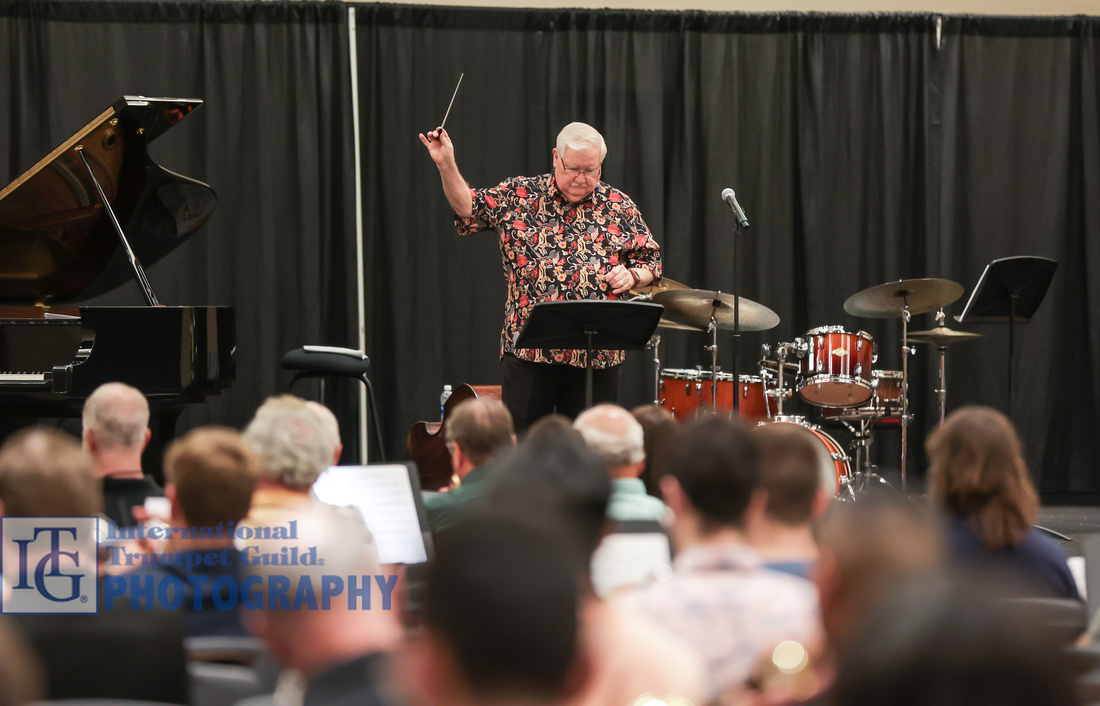
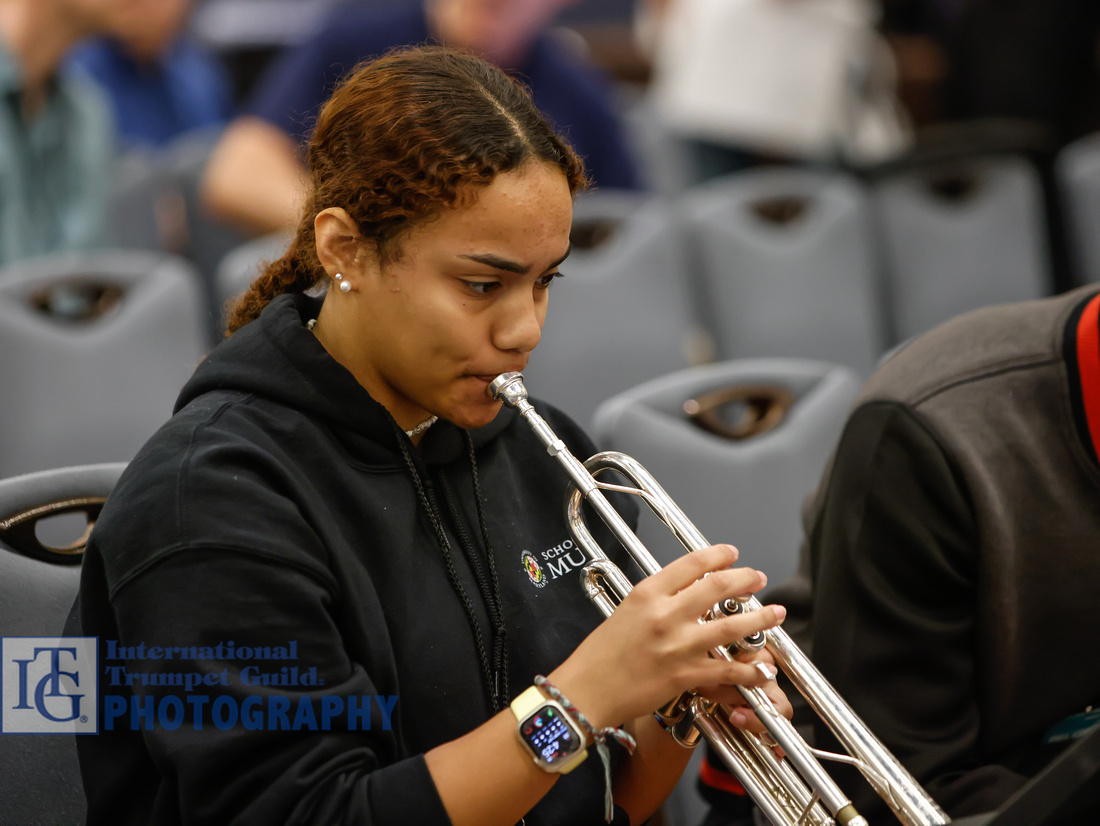
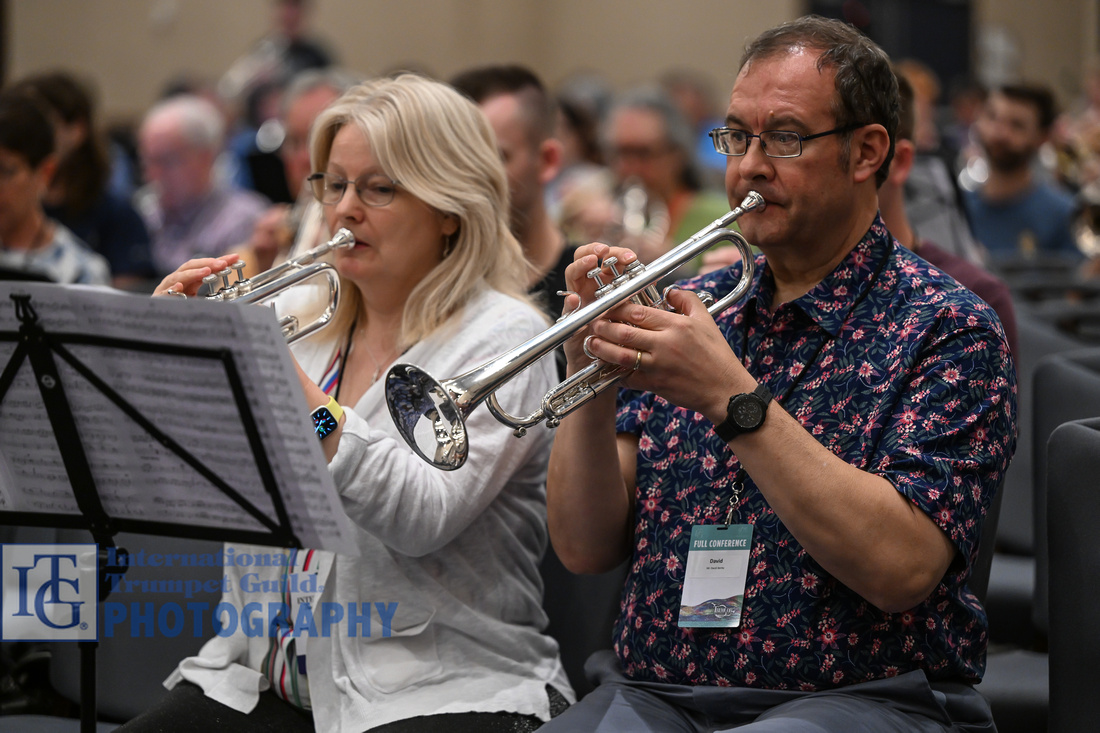
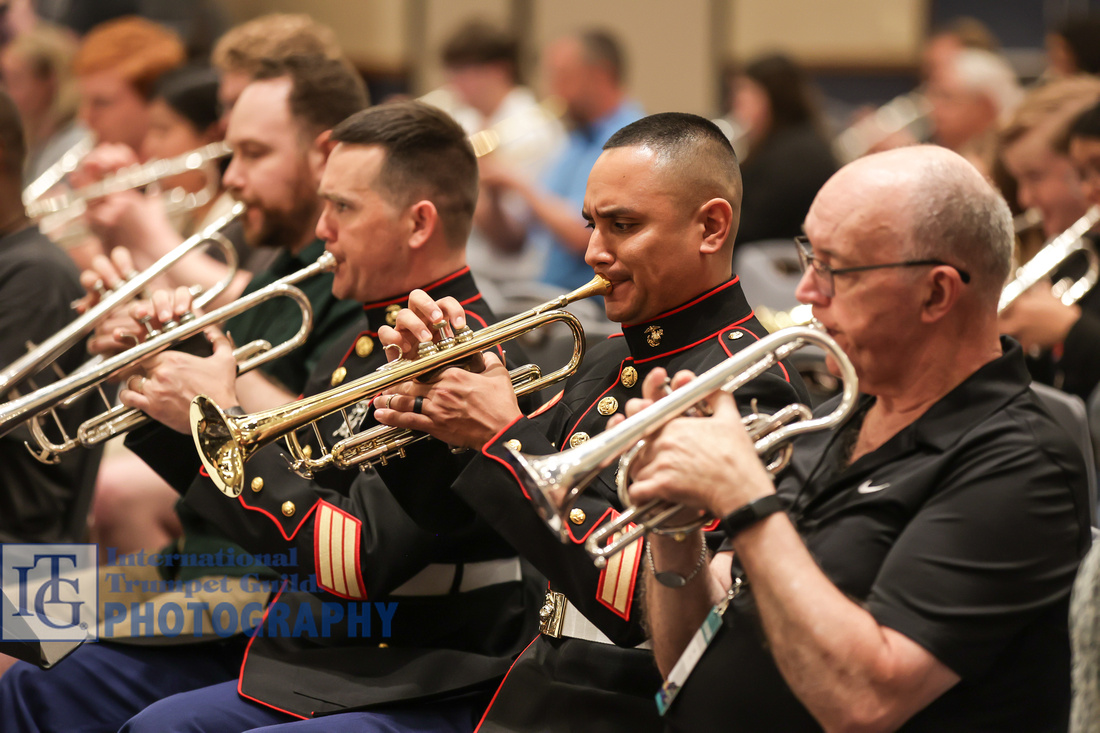
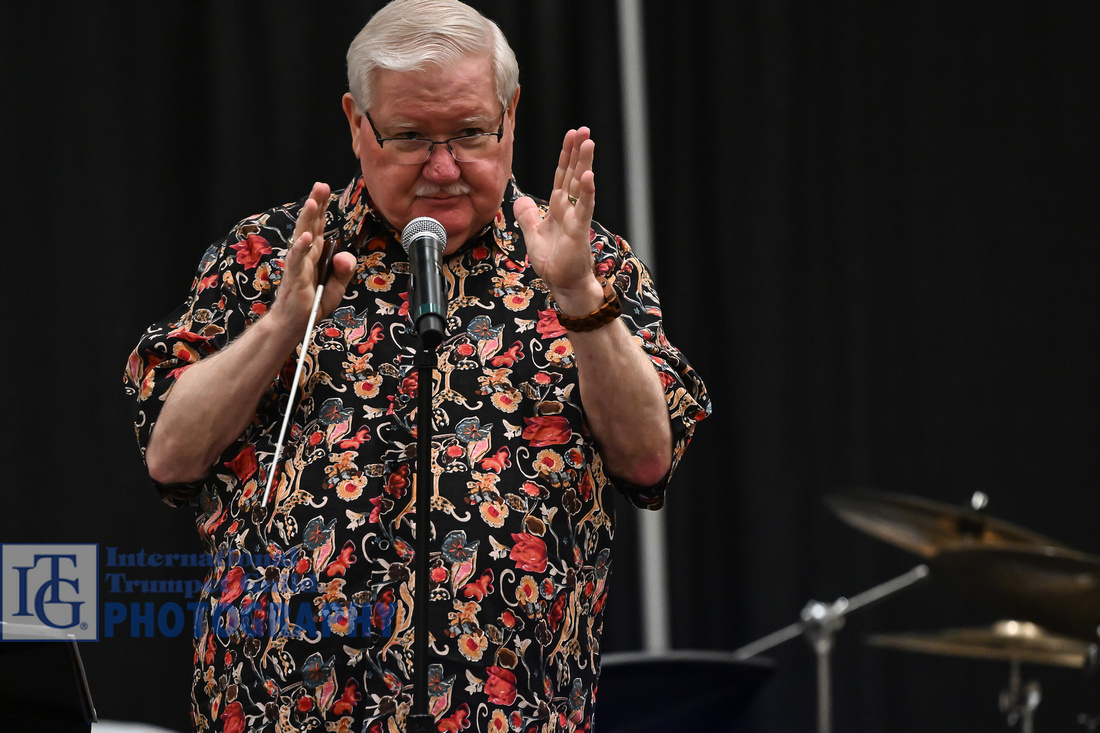
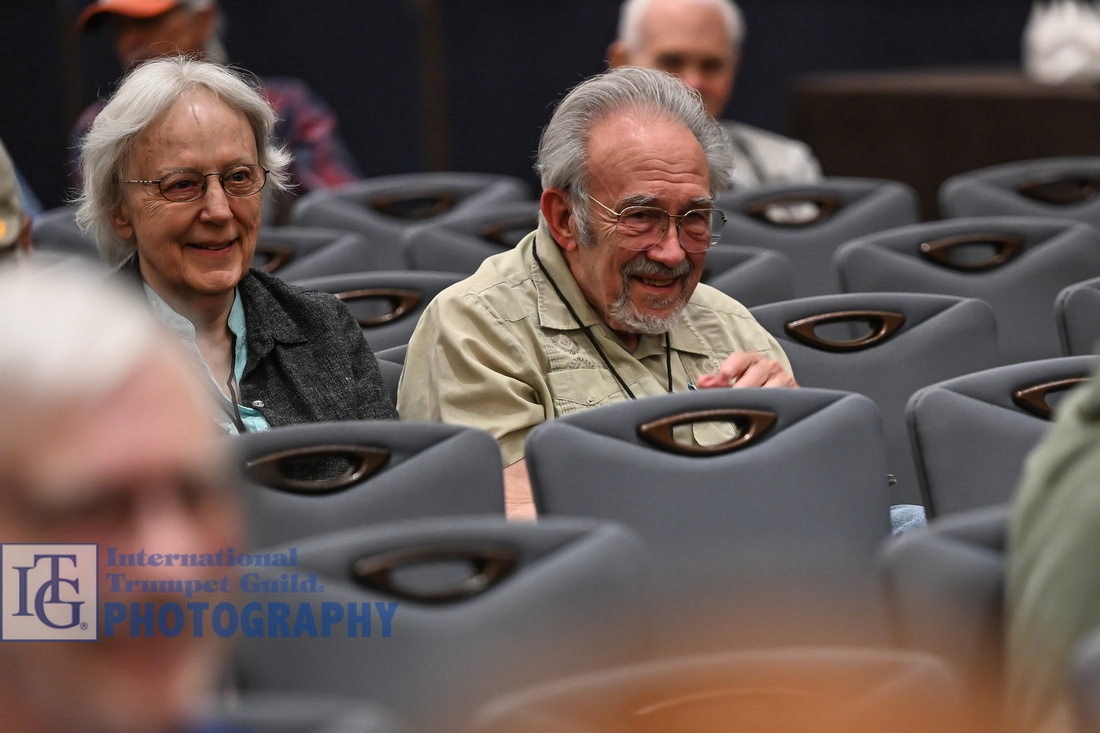
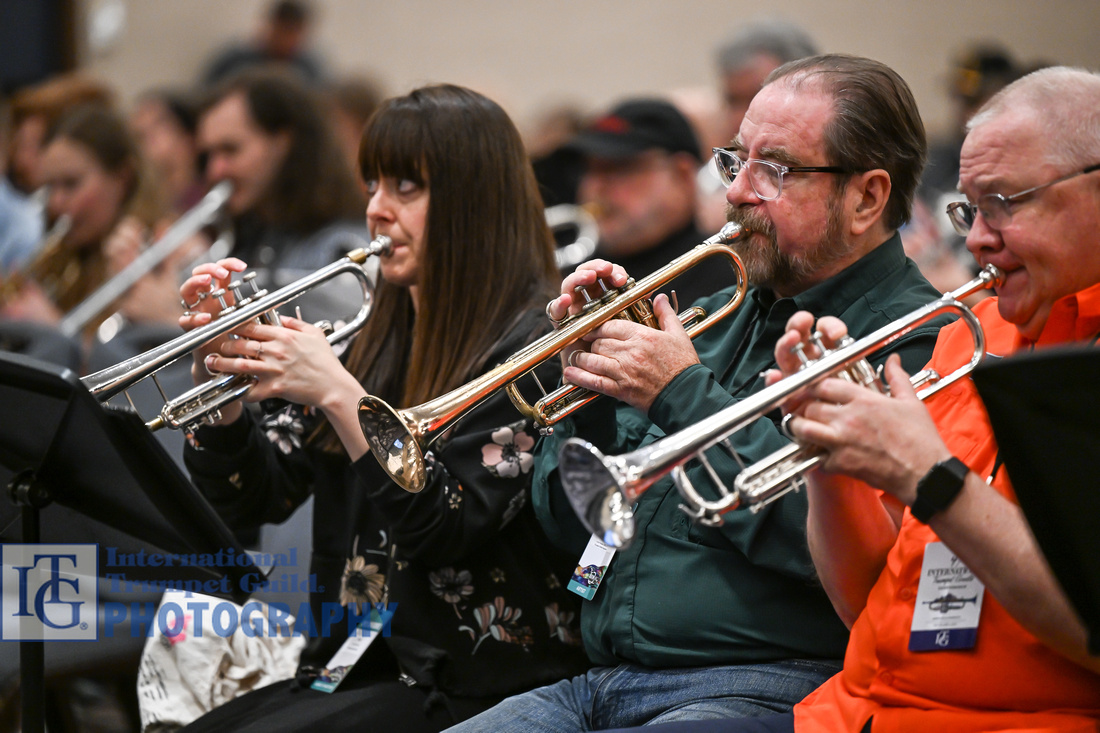
Opening Concert - The 30 Years Show with Les Trompettes de Lyon
Opening for the featured Les Trompettes de Lyon was The Wrecking Crew Trumpet Ensemble from Ball State University. Under the direction of Dr. Stephen Campbell, they performed La Forza del Destino with conviction and energy while showcasing a wide range of instruments. Following this strong introduction was the presentation of the 2023 ITG Award of Merit to former ITG President Brian Evans. After an emotional “thank you” speech from Evans, the lights dimmed, and Les Trompettes de Lyon took the stage. They began the concert with JS Bach’s Toccata and Fugue. The quintet incorporated a plethora of instruments that included piccolo trumpet, B-flat trumpets, flugelhorns, and bass trumpet, captivating the audience with their brilliant tone and wide timbre palette. This particular arrangement began with a virtuosic interpretation of the toccata, but it took a surprising turn as it was followed with a jazzy rendition of the fugue. The unexpected style change foreshadowed the humorous nature of the concert. Les Trompettes de Lyon enjoy combining their love for music and theater, which was evident in works such as Sylvia. This piece displayed their humor when one of the members put his trumpet down in order to perform an interpretive dance accompanied by the other four musicians. Once he picked up his horn and rejoined the group, all members collaborated in dancing together while simultaneously performing. Some works, such as Albeatles, elicited moments of roaring laughter from the audience as the players navigated back and forth from lush, beautiful ballads directly into upbeat pop songs. The eclectic repertoire with modern twists engaged all in attendance.
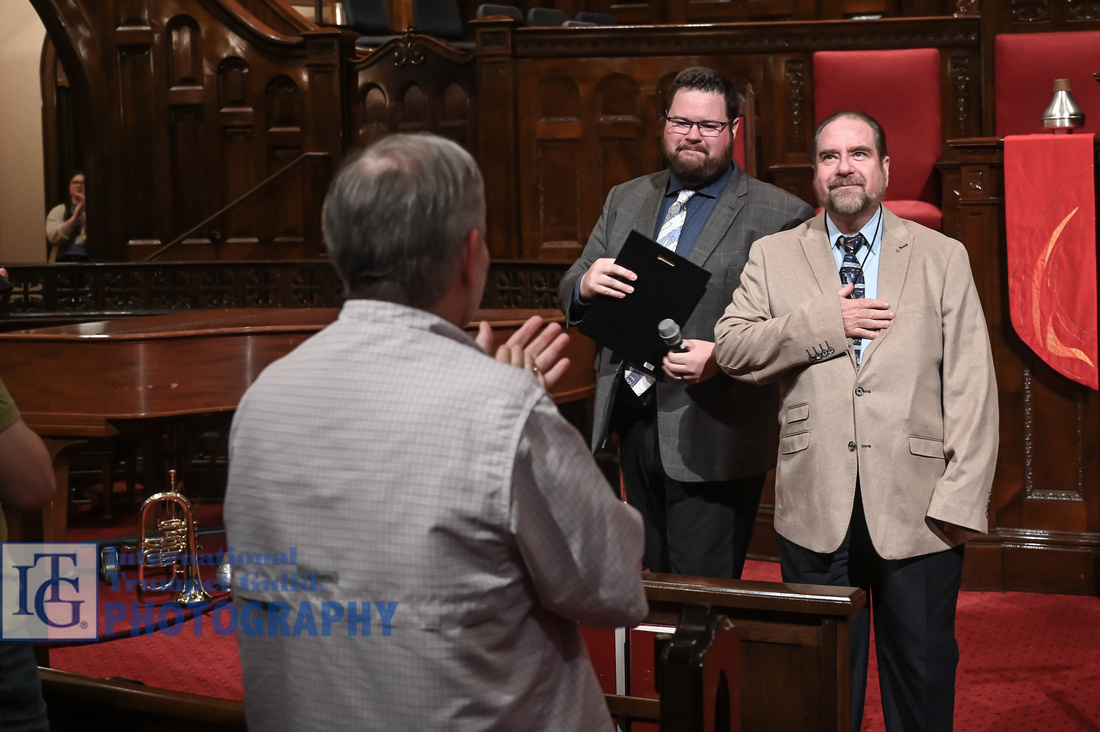
Other notable moments included the use of extended techniques such as the cymbal crashes in Stars and Stripes Forever by hitting their trumpet with a mouthpiece and performing the infamous percussion part to Bolero by unscrewing the valve caps to allow the clicking to imitate the snare drum. Bolero was a crowd favorite as the wide array of instruments and mutes created a lush beginning and allowed for distinct timbre changes to intrigue the listener until the powerful ending. Dancing and nonsensical theatrics added to the entertainment as they stood on chairs, pointed their bells at each other, and galloped around the stage. Additionally, they did a wonderful job imitating the minimalistic approach to this work by creating a gradual crescendo from the first note to the last. Les Trompettes de Lyon transitioned seamlessly from classical works to pop tunes, marches, and more, always adding their own flair along the way. They even sang several times in French, changing the lyrics of such well-known tunes as What a Wonderful World and Colonel Bogey to be about their ensemble! Entertaining on-stage antics partnered with brilliant musicianship created a memorable performance to kick-off the ITG Conference. Bravo to Les Trompettes de Lyon! (Steven Siegel)
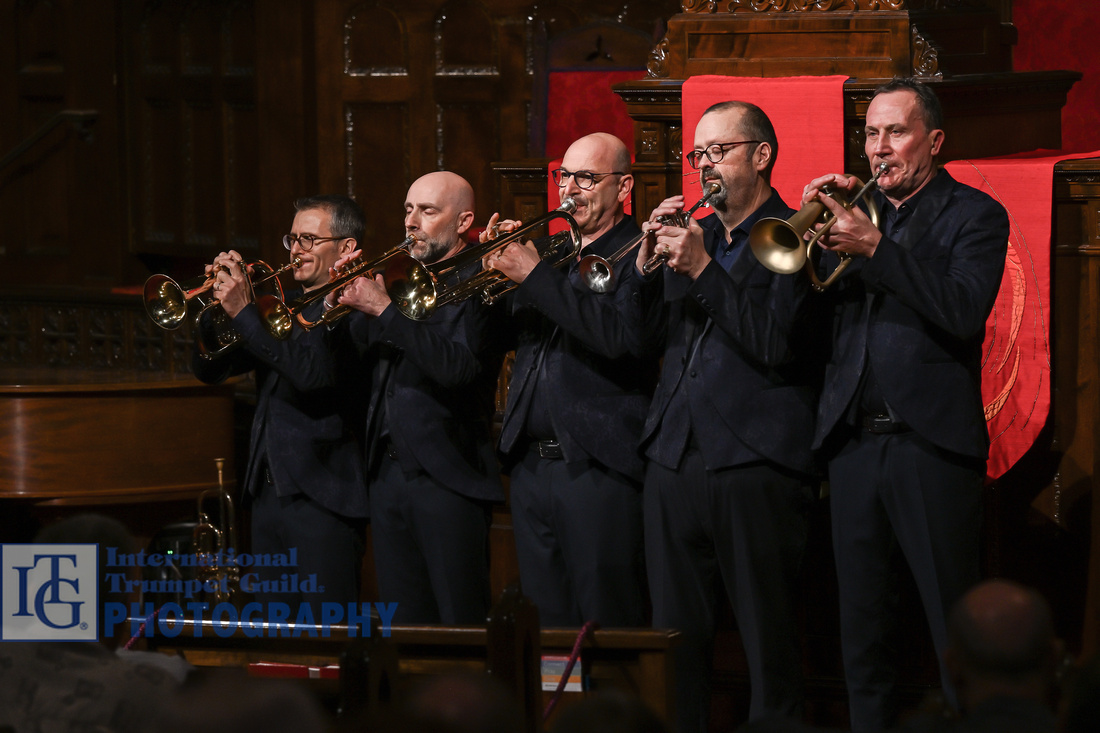
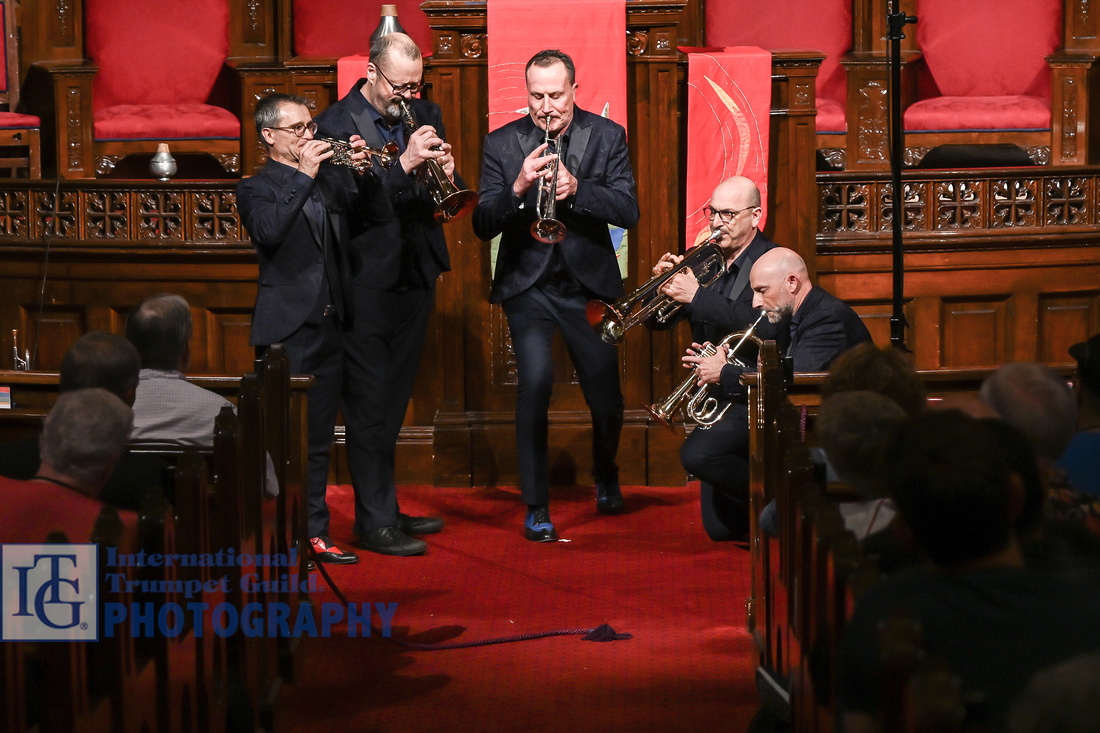
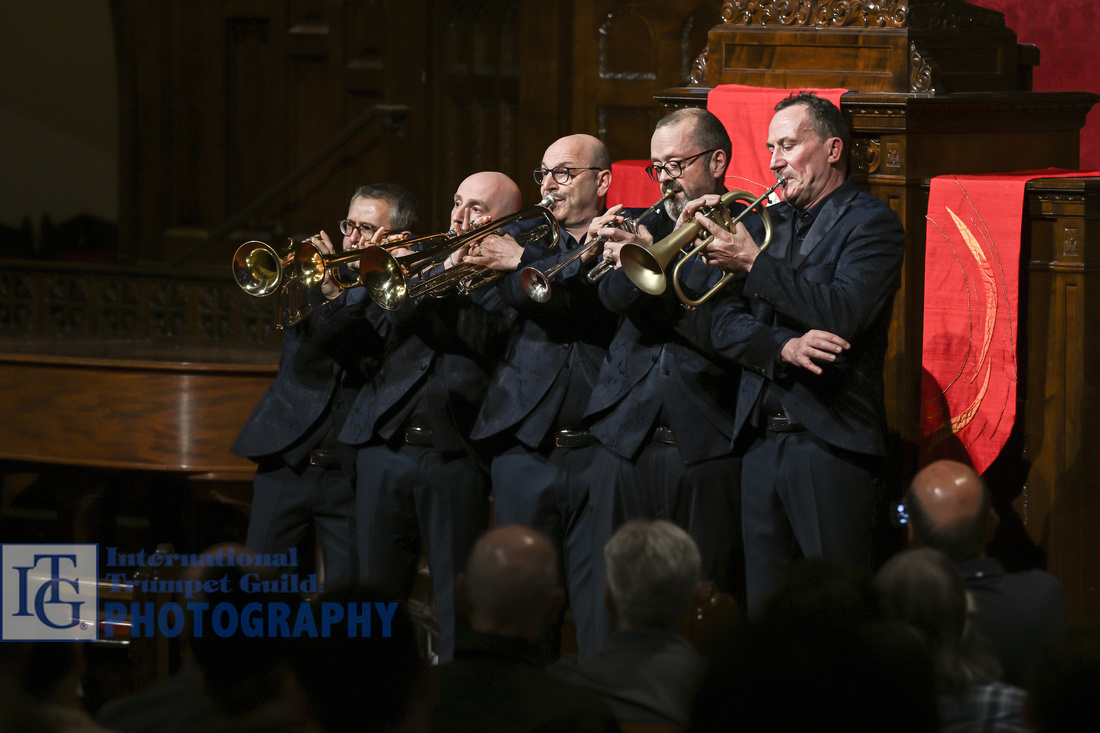
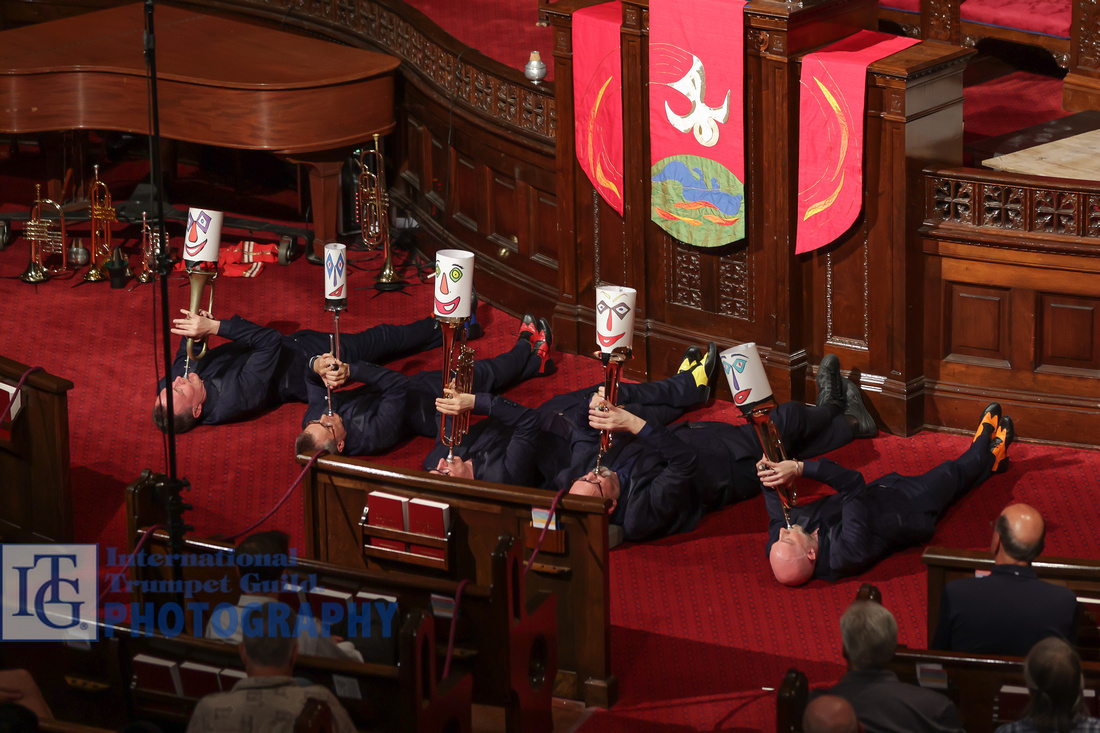
Open Jam Session - Bria Skonberg
Bria Skonberg led a great jam session to cap off the opening day of the conference. Joined by Mike Frank (piano), Peter Paulson (bass) and Christopher Hanning (drums), the group kicked off the session with the Cole Porter classic “What is This Thing Called Love.” Skonberg quickly began to involve the crowd in the session, inviting two to three trumpeters at a time to play on other standards like “It Could Happen to You,” “Besamé Mucho,” “How High the Moon,” and “In Walked Love.” Throughout the evening, both Skonberg and the trio encouraged players to “learn by doing,” asking them to play tunes with which they might not be as familiar or to play standards in different keys from what they might be accustomed. This approach created a fun environment that culminated in great solos and performances by the participating trumpeters. (Flint Angeroth Franks)
Click here for more photos from the ITG Conference
]]>
Compiled by Peter Wood
Conference Prelude Performances
* Indicates premiere performances.
Groups are listed alphabetically.
Angelo State University - ASU Trumpet Ensemble
Dr. John Irish, director
Nicholas Alvarado, Manuel Garcia, Adolfo Gaucin, Shaun Hawkins, CJ Lemke, Ben Martin, Nickolas Martinez, Gabriel Muñoz, Sergey West, and William Tipton, trumpets
Exultation by Richard Byrd
The Legend of Pandora by Jason Dovel
The Angelo State University trumpet ensemble, under the direction of Dr. John Irish, certainly did not disappoint. The works performed made excellent use of standard trumpet ensemble writing techniques while also remaining unique and entertaining. This was a captivating performance by the ASU trumpet ensemble. (Nathan Shadix)
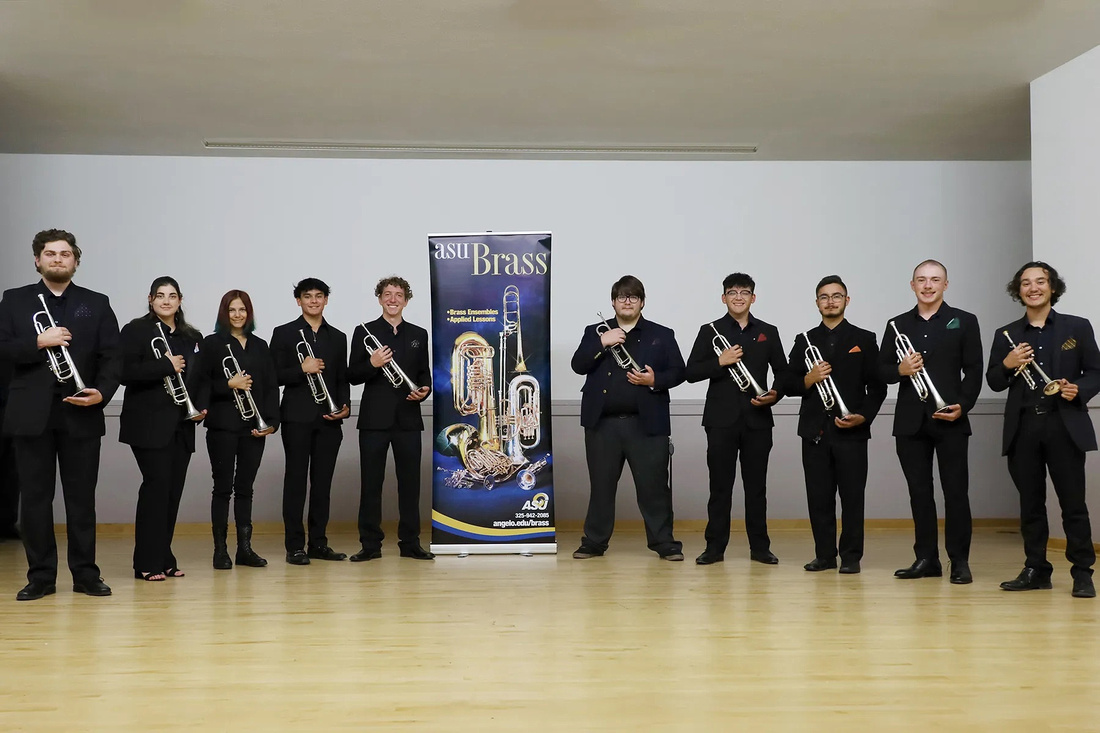
Arkansas State University Trumpet Ensemble
Dr. Nairam Simoes, director
Audrey Alpha, Chase Bowman, Cody Daughertee, Jonathan Dunlap, Grady Fields, Brody King, Carlos Mejia, Jodie Seaborn, Becca Wertenberger, Blake White, and Ethan Williamson, trumpets
Giza Necropolis by Jason Dovel
Overture to Die Fledermaus by Johann Strauss, arr. Zachary Shearer
The Arkansas State University Trumpet Ensemble performed two works for their prelude. On Jason Dovel’s Giza Necropolis, the highly polished performance by the large ensemble featured exceptionally played technical passages and authoritatively played lyrical solos from many members of the ensemble. On the Overture to Die Fledermaus, a much smaller ensemble performed the piece from memory and with some light choreography. Their outstanding rendition of this popular orchestral work was rewarded with a hearty round of applause from an appreciative audience. (Benjamin Hay)
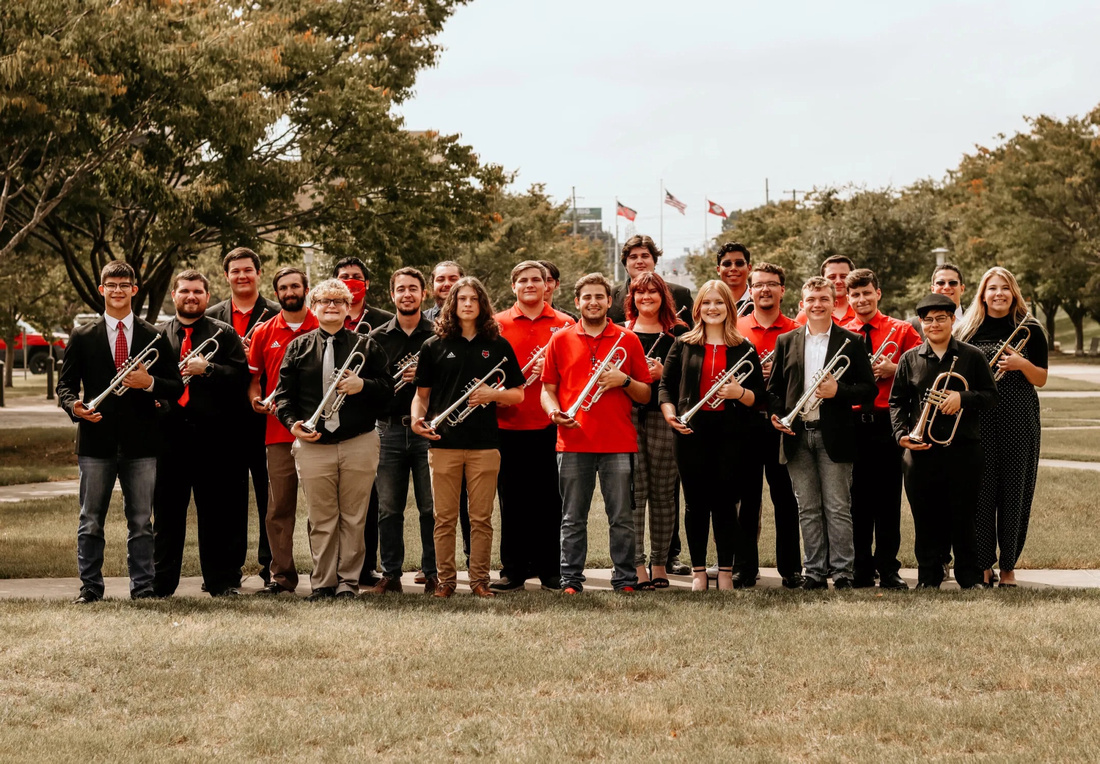
Boston University Trumpet Ensemble
Terry Everson, director
Dominic Amico, Dan Casso, Aysel DeBakey, Paige Dyer, Chloe Francis, Kyra Hulligan, Brendan Mathieson, Caleb Menkhus, and Di Yue, trumpets
Polovetsian Dances by Alexander Borodin, arr. Dan Casso
The Boston University Trumpet Ensemble, joined by their professor Terry Everson, performed Borodin’s Polovetsian Dances completely from memory. The ensemble played well both as individuals and as an ensemble. The two piccolo players had particularly impressive performances of incredibly challenging parts in this very well-received work. (Matthew Vangjel)
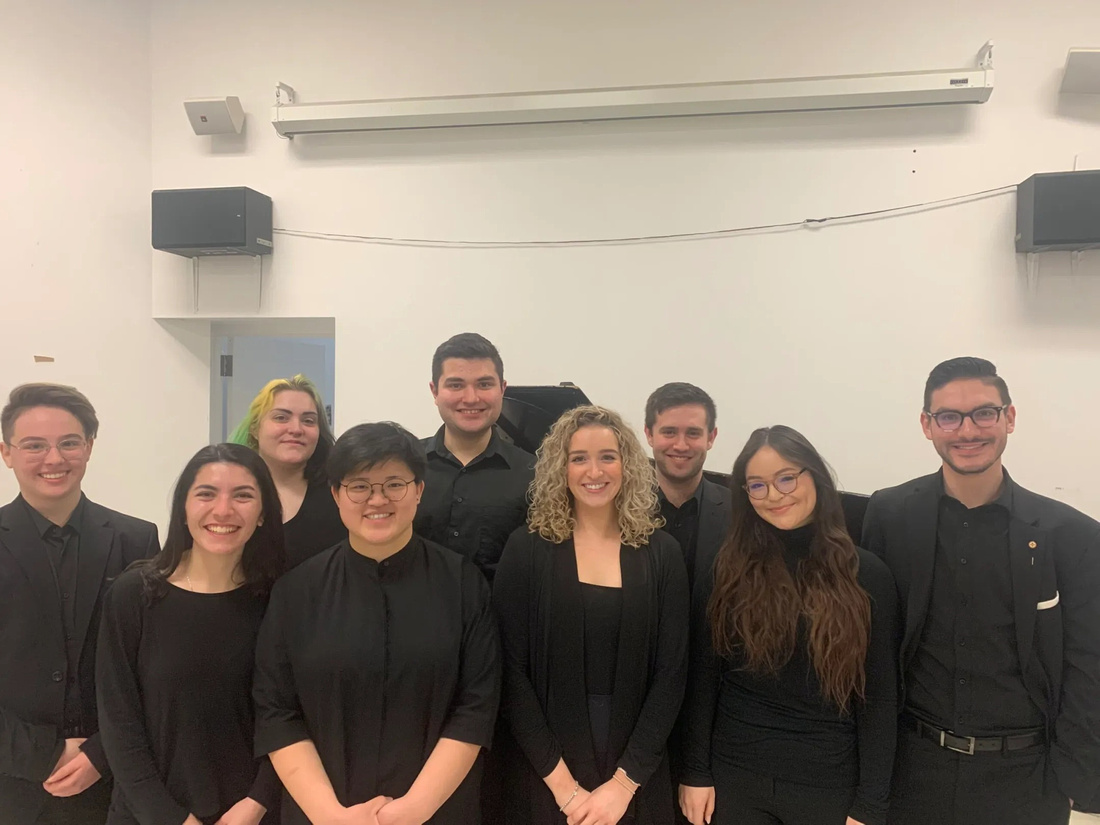
Brighton High School Trumpet Sextet
Sharon Long, director
Owen Blush, Nicolas Hardy, Benjamin Mulligan, Luke Newcomb, Jason Robinson, and Vance Straub, trumpets
Dürrenhorn Passage by Kevin McKee
The Brighton High School Trumpet Ensemble provided amazing power and precision throughout their jaw-dropping performance, which was done entirely from memory with the ease of ensembles twice their age. Their dynamic performance showcased tremendous diversity in their musical timbre and artistry. Their performance was truly beautiful and powerful. (James Peyden Shelton)

Brownsville Veterans Memorial Early College High School - Charger Trumpet Quintet
Jaime Ochoa Jr., director
Michael Arizmendi, Hector Montoya, Cesar Paez, Luis Paz, and Orlando Perez, trumpets
Suite for 5 Trumpets by Ronald Lo Presti
The Charger Trumpet Quintet, high school students from Brownsville Veterans Memorial Early College High School in Brownsville, Texas, under the direction of Jaime Ochoa, Jr., performed in impressive fashion. Each member of the ensemble performed with musical sensitivity and chamber music skills rarely found in ensembles of that age. It was a rousing performance, capped by these young performers’ confidence in performing on an international stage. (Joe Nibley)
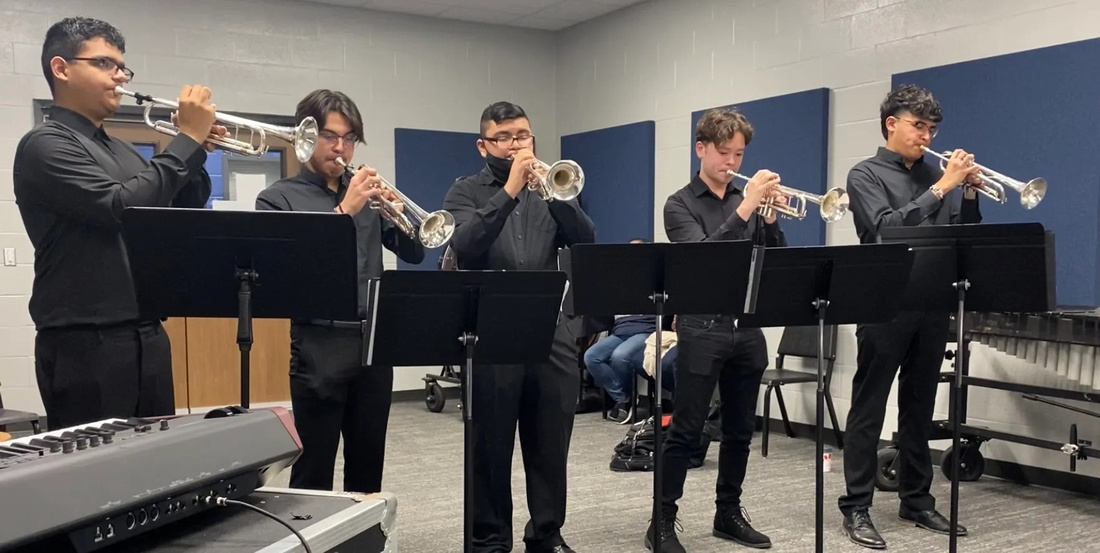
Duquesne University Trumpet Ensemble
Chad Winkler, director
Christopher Cox, Noah Kilgus, Julia Lawrence, Ty Lewis, Matt Piato, and Jon Runion, trumpets
Ruslan and Ludmila Overture, Mikhail Glinka, arr. Erik Morales
In the Duquesne Trumpet Ensemble’s prelude performance, the ensemble was highly polished and featured remarkable virtuosity from all members. The technical demands of this arrangement were formidable, especially for the piccolo trumpets, and these challenges were met brilliantly. The performance received an animated applause and provided an outstanding preamble to the performance that followed. (Benjamin Hay)
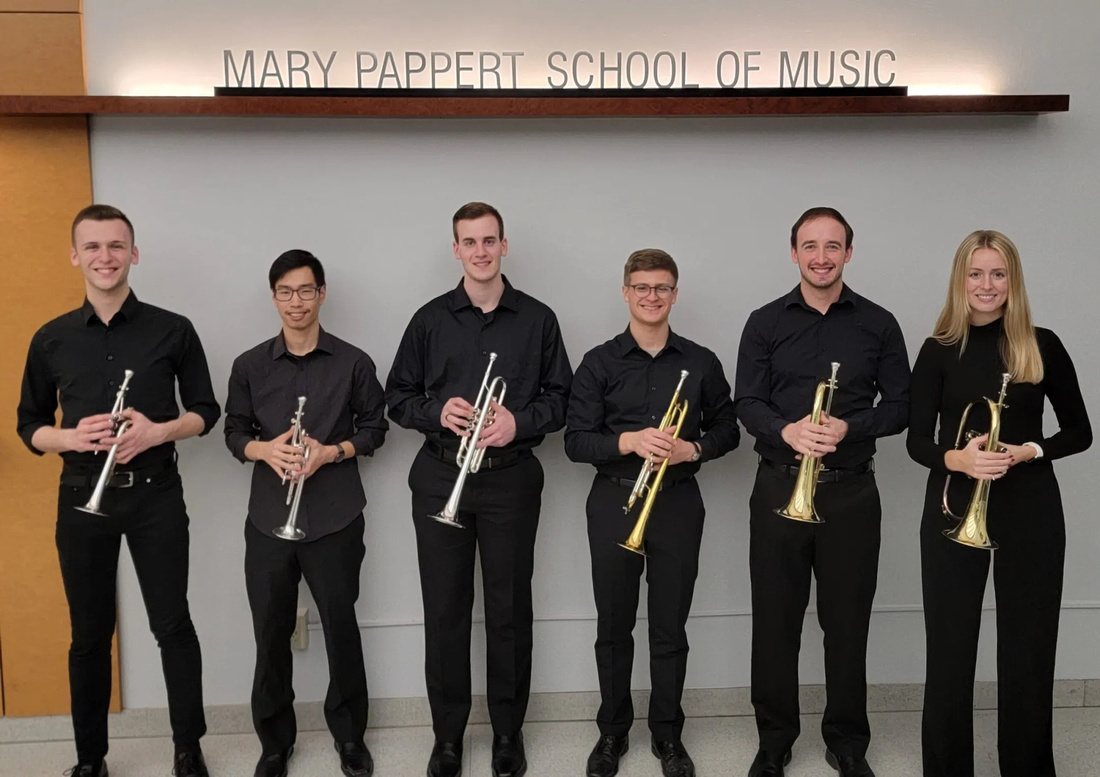
Eastlake High School Trumpet Ensemble
Caleb Tullius, director
Enrico Galiano, Carlos Garcia, David Guerrero, Diego Desantiago, Omar Marilla, and Eric Huff, trumpets
Concert Fanfare by Eric Ewazen
The Eastlake Trumpet Ensemble performed Eric Ewazen’s Concert Fanfare to welcome attendees to Phil Snedecor’s Thursday afternoon session. The group gave an exciting performance to an enthusiastic audience. They exemplified great chamber playing, connecting in a musical and captivating way not just with each other, but with the audience as well. It was clear that they were enjoying themselves, which made for a great prelude performance. (Brianne Borden)

Emporia State University Trumpet Ensemble
Dr. Gary Ziek, director
Wyatt Campbell, Adrienne Dinger, Libby Franks, Katelyn Hess, David Medrano, Caleb Mollett, Ben Ortstadt, Tristan Stevens, RJ Stovall, and Ben Ziek, trumpets
Flourish for Ten Trumpets by Carl Maria von Weber, arr. Charles Decker
Eine Kleine Nachtmusik by Wolfgang Amadeus Mozart, arr. Gary Ziek
Burnin’ by Gary D. Ziek
The Emporia State University Trumpet Ensemble gave the audience a performance full of energy and musicality. Their opening piece, Flourish for Ten Trumpets, perfectly highlighted the ensemble’s crisp articulations and power. The addition of a euphonium for this piece provided a wonderful depth of sound to the group. The second piece was an arrangement of Mozart’s famous Eine Kleine Nachtmusik. The ensemble completely switched gears from the brilliant and bold opening piece to a more delicate approach. Of particular note was the ensemble’s attention to dynamics and overall gorgeous phrasing when handing off various lines of the melody. The performance was well received by all. Dr. Ziek and the Emporia State Trumpet Ensemble should be commended for their excellent performance! (George Carpten, IV)

Ensemble de Trompetes da Escola Superior de Música e Artes do Espetáculo
Dr. Kevin G. Wauldron, director
Rui Almeida, Ivo Costa, Pedro Costa, Elisabete Gorrão, Francisco Machado, Rafael Pinto, Bruno Rodrigo, Carlos Sampaio, João Silva, and Carolina Vieira, trumpets
Fanfare for an Angel by James Stephenson
Dürrenhorn Passage by Kevin McKee
Fantasia Brasileira by José Ursicino da Silva
The homogeneous power of this trumpet ensemble from Portugal had the audience on the edge of their seats as the group showcased their amazing precision in articulation. Kevin McKee’s Dürrenhorn Passage truly highlighted the ensemble’s amazing diversity in timbre and the virtuosity of each performer. José Ursicino da Silva’s lively Fantasia Brasileira showcased every aspect of the ensemble’s strengths through four short movements that tested their dynamics, range, precision, and rhythmic clarity. This was a truly amazing prelude performance. (James Peyden Shelton)
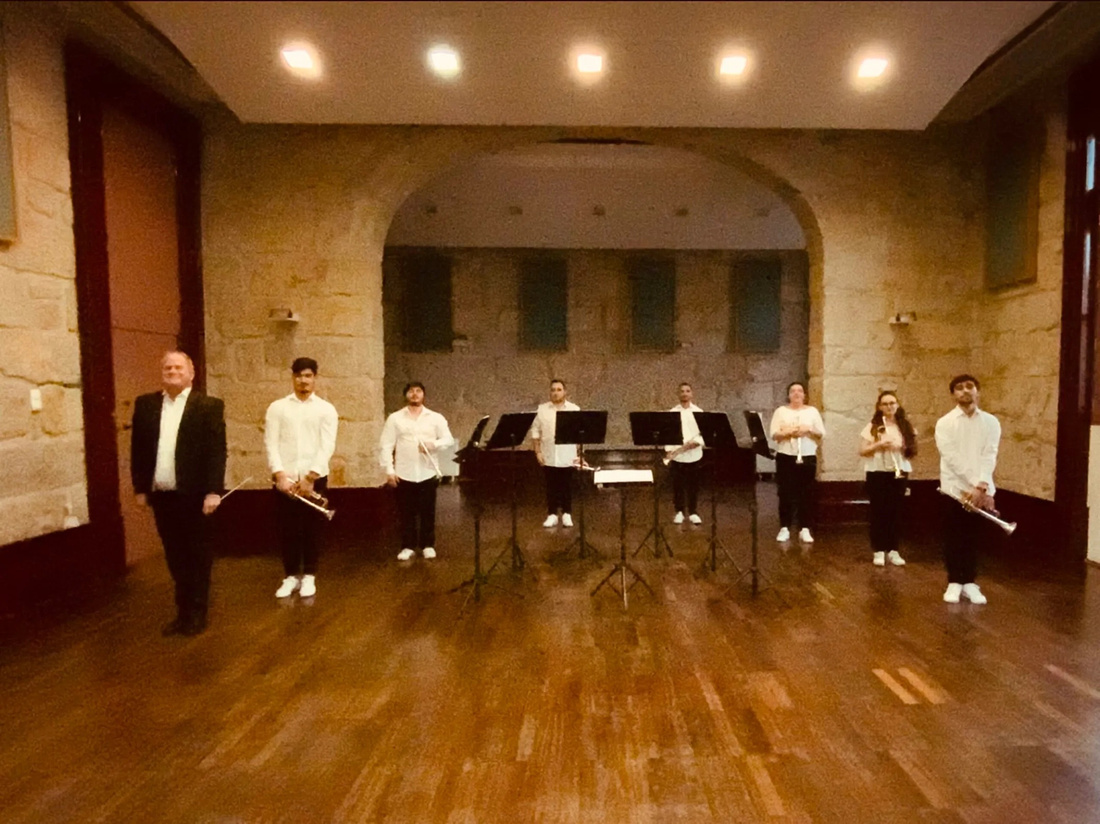
Glendale Community College Trumpet Ensemble
Dr. Spencer Brand, director
Chloe Colbert, Norris Flores, Nathan Lievre, and Chris Scrivens, trumpets
Three for Four by James Olcott
The sounds of the four musicians in this ensemble blended beautifully, and the delicacy of James Olcott’s Three for Four was very well executed. The performance was a promising beginning to an innovative concert of very stylistically different repertoire. (Christopher Luebke-Brown)
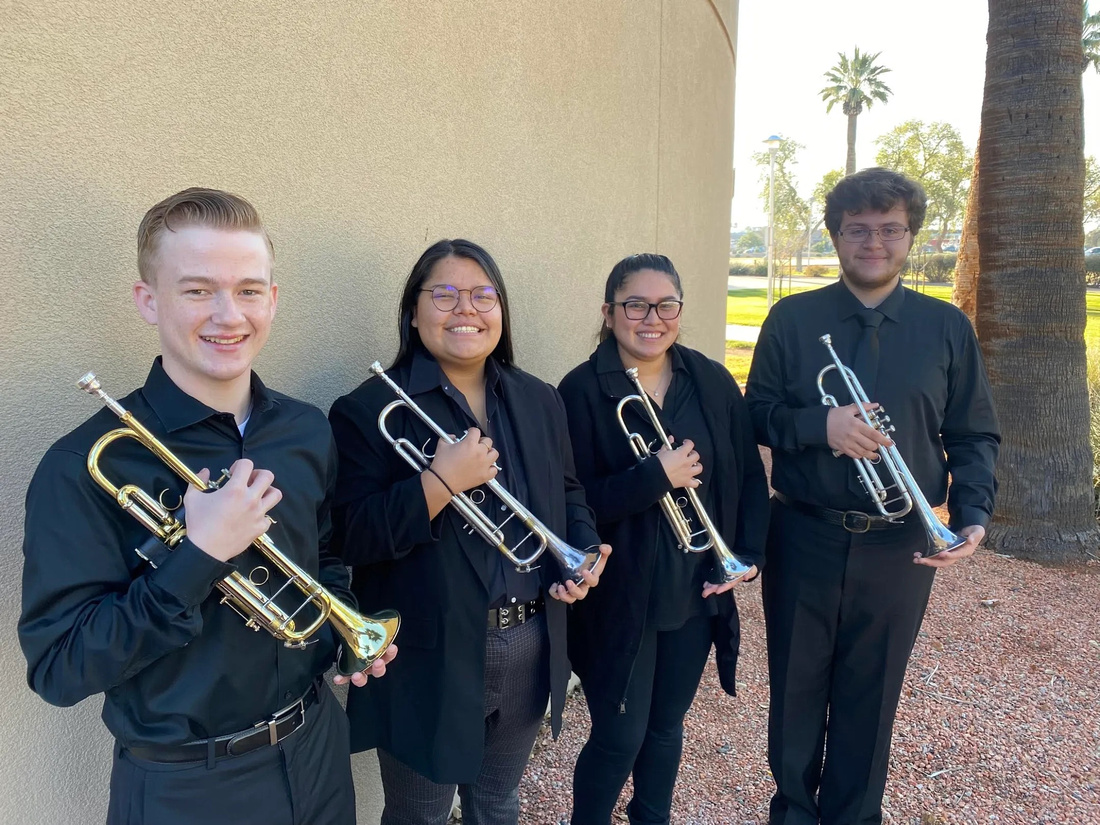
Indiana University of Pennsylvania - IUP Alumni Trumpet Ensemble}
Dr. Kevin E. Eisensmith, director
Justin Bianconi, Sarah Cisney, Nicole Gillotti, Kenken Gorder, Joshua Hilliard, James Johnson, William Stowman, Michael Wertz, Austin Widmann, Timothy Winfield, David Wygonik, and Marisa Youngs, trumpets
* Fanfare for the Oak Grove by William Stowman
Three Fourteen by Jeremy Leidhecker
The IUP Alumni Trumpet Ensemble came together to honor the retirement of their teacher, Dr. Kevin Eisensmith. The premiere performance of William Stowman’s Fanfare for the Oak Grove was a wonderful way to kick off the evening with its beautiful chords, brilliant ensemble, and heroic sounds. Jeremy Leidhecker’s Three Fourteen, referencing Dr. Eisensmith’s studio number, is meant to represent the full variety of music possible to come from his teaching and allowed the ensemble to run the gamut of musical possibilities. (Kyle Millsap)
[No photo available]
Indiana University of Pennsylvania - IUP Trumpet Ensemble
Dr. Kevin E. Eisensmith, director
Justin Bianconi, Sarah Cisney, Austin Fontenoy, Kevin Morrison, Alexander Robbins, and Austin Widmann, trumpets
Kayee Fanfare by Jack Stamp
The IUP Trumpet Ensemble provided an energetic and declamatory opening fanfare. Led by Dr. Kevin E. Eisensmith, the group gave a strong performance of Jack Stamp’s Kayee Fanfare. Featuring equal parts technical and lyrical playing, the group demonstrated great contrast and musicality in this exciting performance. (Julia Bell)

Lone Star State Trumpet Guild
Dr. John Irish, director
David Amlung, Ben Fairfield, Leigh Anne Hunsaker, John Irish, John Kennedy, Jay Lester, Andy Patterson, Shuler Shuler, and Bernie Scherr, trumpets
Fanfare from La Peri by Paul Dukas, arr. C. Fortner
“Arabian Dance” from Peer Gynt by Edvard Grieg, arr. John Irish
Forever Rising by Bernie Scherr
The Lone Star State Trumpet Guild, under the direction of John Irish, played an exhilarating two-piece set, opening with the brilliant La Peri by Paul Dukas, arranged by C. Fortner, who was present in the audience. The expressive sounds of these professional musicians were well showcased through this marvelous arrangement. The second selection was the comical crowd-pleaser Spamalot and the Holy Grail by John Du Prez and Eric Idle, arranged by A. Patterson. This piece had the audience laughing with sections of horse hoof clicks, a horse whinny, and a chant sung by all musicians while hitting their books on their foreheads. A selection like this shows the strong and wide-ranging abilities of this wonderful group. (Maryna Pohlman)
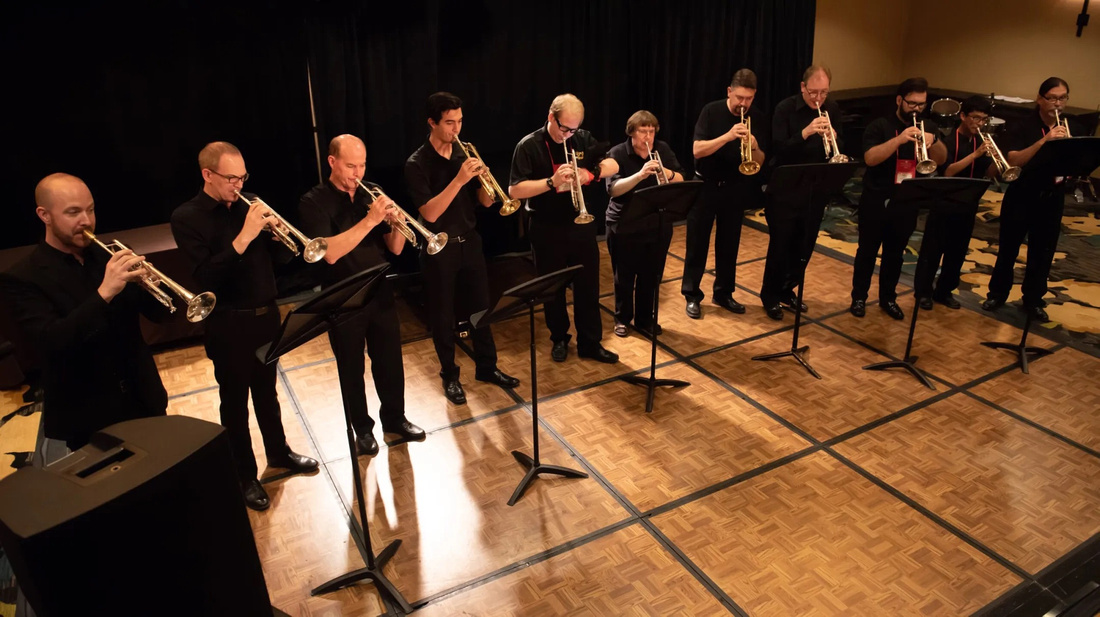
Louisiana State University - LSU Trumpet Ensemble
Dr. Matthew Vangjel, director
Francisco Ballestas-Sayas, Alex Ellender, Aidan Giroir, Brandon Hebert, Coleman Scott, Thomas Stratton, Madison Williams, and Brandon Wood, trumpets
Sinfonia and Caprice, Op. 56, by Itaru Sakai
Under the direction of Dr. Matthew Vangjel, the Louisiana State University Trumpet Ensemble performed a beautiful and relatively unknown work for trumpet ensemble. In the technical sections, the students maintained a light crispness in their articulation, which kept the piece moving almost like a stream bubbling its way down the mountainside and gave the performance musical drive and direction. In the lyrical sections, they maintained an impressive attention to intonation, blend, and ensemble that gave the audience a sense of weightlessness and floating. These students have very bright futures and their teacher, Dr. Vangjel, is doing impressive work at LSU. (Joe Nibley)
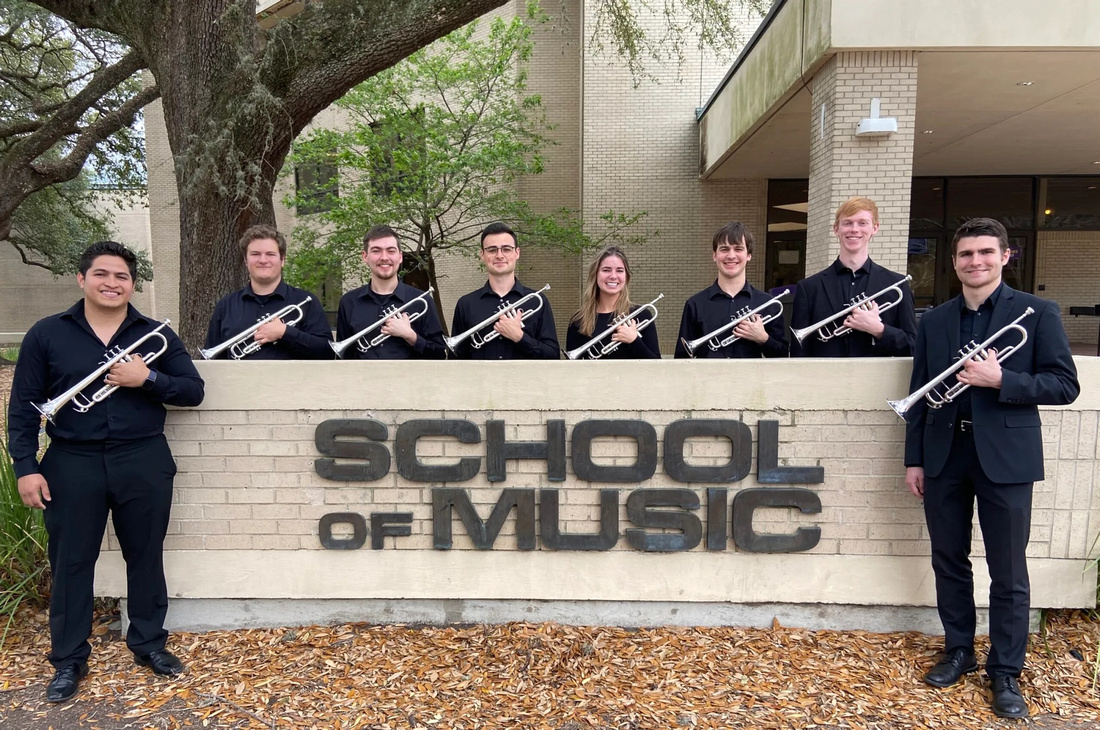
North Dakota State University - NDSU Trumpet Ensemble
Dr. Jeremy Brekke, director
Robert Black, Jonas Biles, Zack Carlson, Cadence DeCoteau, Travis Elliason, Isaac Homuth, Josh Maki, Maddie Ripka, Jaden Rohrich, and Byron Ward, trumpets
Into the Blue by Kevin McKee
In the NDSU Trumpet Ensemble’s passionate performance of Erik Morales’s Into the Blue, tangible excitement filled the air. The group’s grasp of dynamics made for a captivating performance that noticeably elevated the energy in the room. It was also a nice contrast to the recital that followed, which featured mostly lyrical works. (Eli Denecke)

Southern Arkansas University - BLUE Trumpet Ensemble
David D. Torres, director
Kobi Brittenham, Caleb Castle, Josh Green, Jackson Heflin, and Logan Jacobs, trumpets
Fanfare from La Peri by Paul Dukas, arr. Marie Speziale
Directed by David D. Torres, the Southern Arkansas University “BLUE” Trumpet Ensemble performed Marie Speziale’s arrangement of Fanfare from La Peri for four trumpets and three flugelhorns. The group kicked off with a bombastic opening chord and excellent group sound. The three flugelhorns covered the parts traditionally played by the horns and low brass, which added the necessary depth to the ensemble. The group was well balanced and easily filled the room in the upper dynamics. (Marisa Youngs)

Southwestern Oklahoma State University Trumpet Ensemble
Dr. Richard Tirk, director
Dustin Gorny, Gary Hoover, Donna Hyde, Nathan Logan, John Sharp, and Cydney Stotts, trumpets
New Century 2000 AD by David Uber
Prelude and Fugue for Trumpet Choir by Eric Ewazen
The Southwestern Oklahoma State University Trumpet Ensemble opened Saturday evening’s final concert with a spirited and dynamic performance of David Uber’s New Century 2000 AD and Eric Ewazen’s Prelude and Fugue for Trumpet Choir. The formidable, angular lines in the Uber were contrasted well by the declamatory fanfare figures in the Ewazen. The group’s vibrant sounds resonated throughout the ballroom for a captivating performance from this well-balanced ensemble. (Peter Wood)
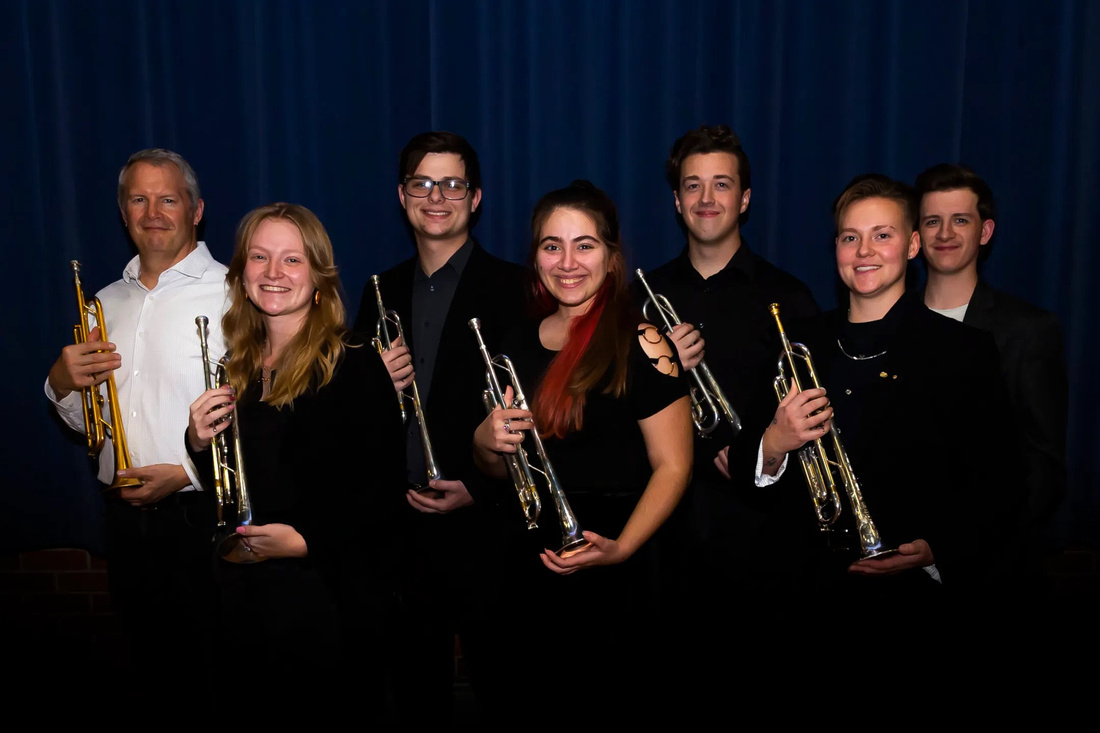
Tarleton State University Trumpet Ensemble
Dr. Brian Walker, director
Milton Alvarez, Brandon Arriola, William Brown, Marco Hernandez-Leal, Jersey Kronk, Brendan Lorenz, Robby Need, Gabby Nguyen, and Hunter Steele, trumpets
Fantasia for Seven Trumpets by Eric Ewazen
In the Tarleton State Trumpet Ensemble’s prelude performance, the leadership of each individual was apparent in the various solo lines throughout the piece. This highly skilled group played with a uniform sound that resonated well throughout the Travis Park Church sanctuary. (Eli Denecke)
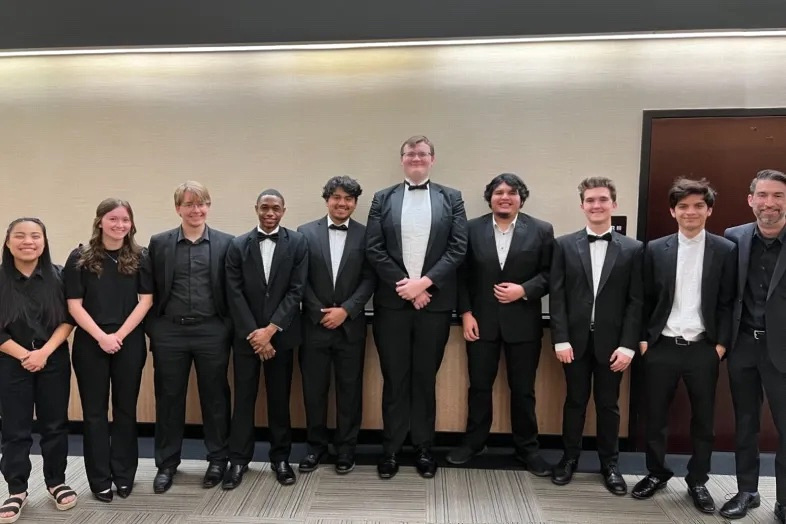
Texas A&M International University - TAMIU Trumpet Guild
Dr. Nicole Gillotti, director
Mario Valle, Alexis Pina, Gerardo Garcia, and Darian Ponce, trumpets
Fanfare for an Angel by James Stephenson
The TAMIU Trumpet Ensemble, directed by Dr. Nicole Gillotti, performed Jim Stephenson’s Fanfare for an Angel as an opening prelude for the second New Works Recital. This exciting rendition was defined by their soloistic musicianship while still maintaining a balanced and unified ensemble sound. Each of the performers was given time to shine, and their artistry was inspiring. (Christopher Luebke-Brown)
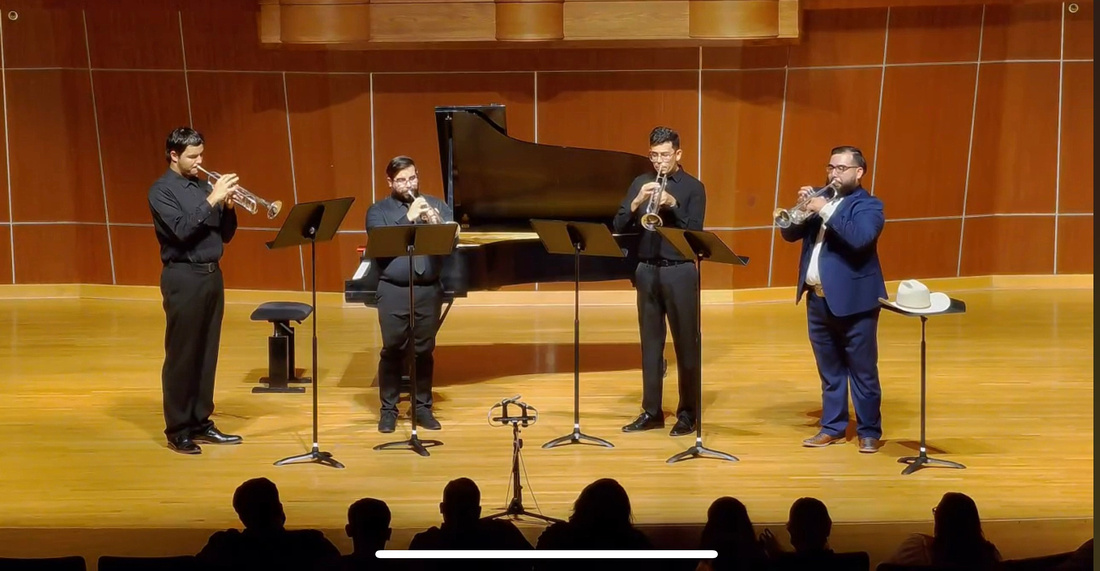
Texas A&M University-Corpus Christi - TAMUCC Trumpet Ensemble
Dr. Mary Thornton, director
Melinda Dunagan, Gavin East, Dustin Hernandez, Luis Rodriguez, James Tomerlin, Juan Vargas III, and Mary Silva, trumpets
Concert Fanfare by Eric Ewazen
In the TAMUCC Trumpet Ensemble’s performance of Eric Ewazen’s Concert Fanfare, their sound exploded into the hall from the very first note and held the audience's attention to the very last note. Their crisp articulation and contrasting color within the ensemble was a true pleasure to experience. It was the perfect opening fanfare for the wonderful concert that followed. (James Peyden Shelton)
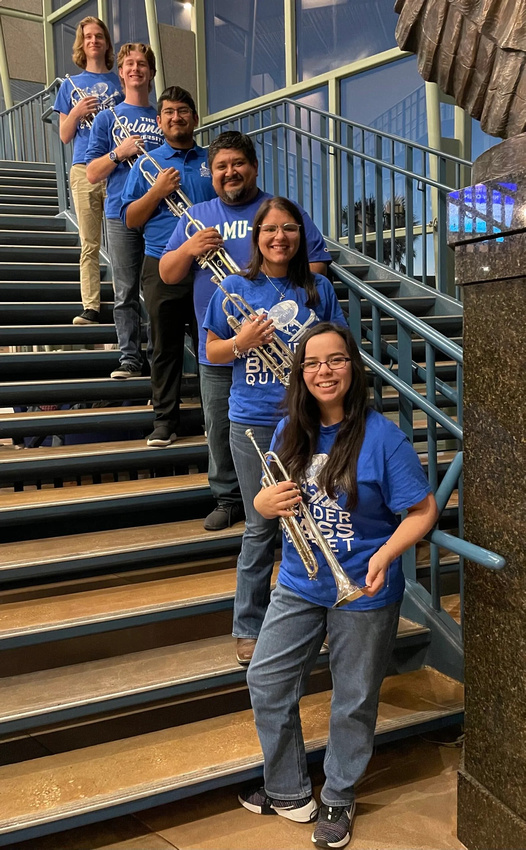
Texas A&M University-Commerce - TrumpetSix
Dr. Daniel Kelly, director
Kourtney Cimino, Frederick Davis, Christian Griffin, Matthew Johnson, Michaela Schwyhart, Corbin Sullivan, trumpets
Neon Fanfare by Elaine M. Ross
TrumpetSix performed a dynamic prelude filled with vibrant colors and great technicality. The music was full of contrasting ideas and great lyrical melodies pitted against striking dissonances. The audience enjoyed their exciting performance and very impressive display of top-level musicianship. (Spencer Wallin)
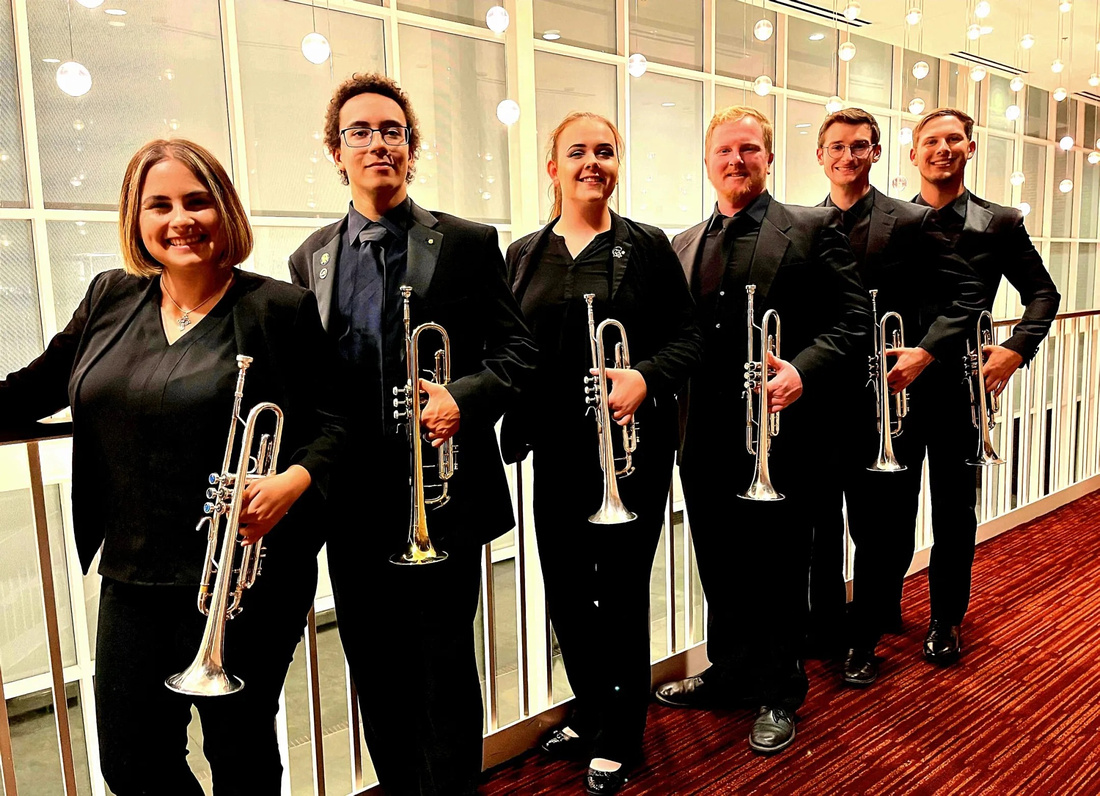
Texas A&M University- Kingsville - Jalisco Trumpet Ensemble
Dr. Kyle Millsap, director
Carolina De La Rosa, David De La Rosa, Jesus Espinoza, Severin Manley, Brandon O’Donohue, and Lacey Peschel, trumpets
Metallic Fury by Erik Morales
The Summer Knows by Michel Legrand, arr. Scott Belck
The members of the Jalisco Trumpet Ensemble from Texas A&M University- Kingsville played a wonderful opening prelude for the late-night concert in the Regency Ballroom. Morales’s Metallic Fury featured the group’s exciting playing and unified articulations. Belck’s colorful arrangement of The Summer Knows featured several members of the group, but it was a special opportunity to spotlight their exceptional lead trumpet player. The group had a strong sense of tone and poise as they delivered a terrific performance. (Nick Volz)
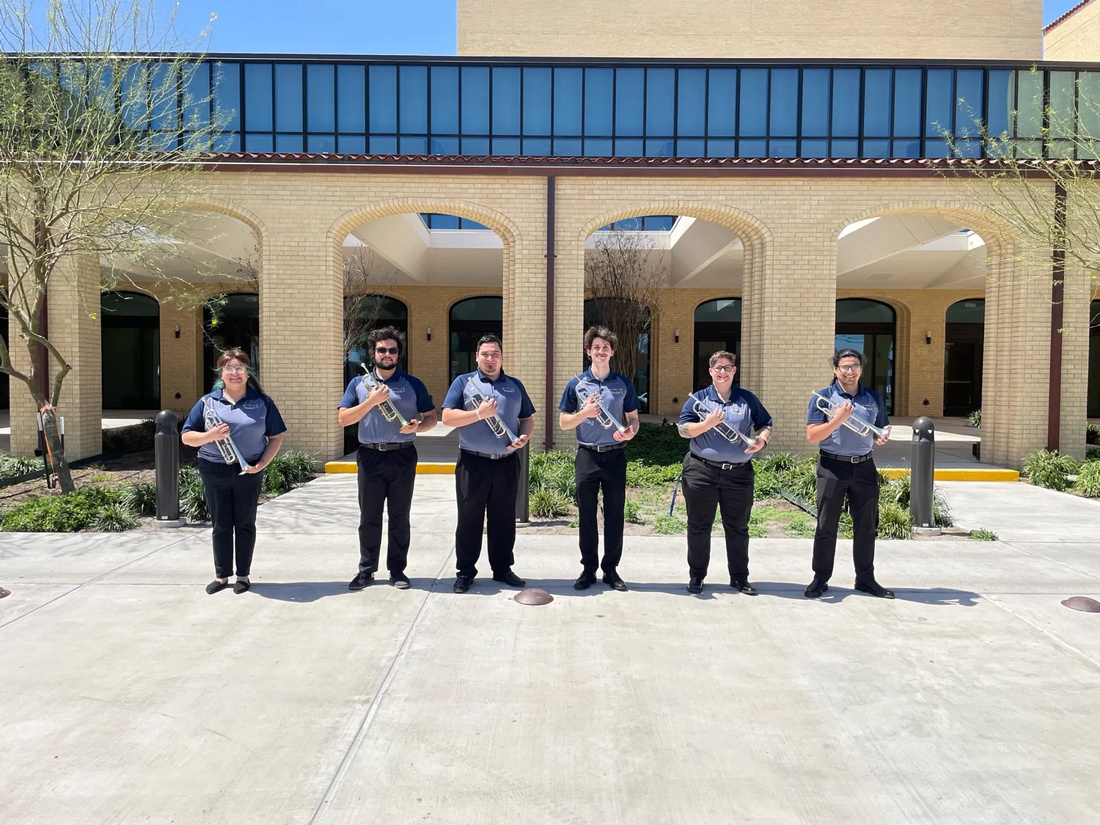
Texas A&M University-Kingsville - Javelina Trumpet Ensemble
Dr. Kyle Millsap, director
Carolina De La Rosa, David De La Rosa, Yamila De La Rosa, Evàn Garza, Anthony Hernandez, Nicolas Hernandez, and Jessenia Reyna, trumpets
Giza Necropolis by Jason Dovel
TAMUK’s Javelina Trumpet Ensemble performed Jason Dovel’s Giza Necropolis. This epic and exciting work featured a great deal of fast tonguing and fingering passages, sweeping Romantic-era harmonic progressions, and a contrasting, lyrical middle section. The ensemble displayed excellent communication skills among the members and presented a high-energy performance that was well received. (Scott Hagarty)
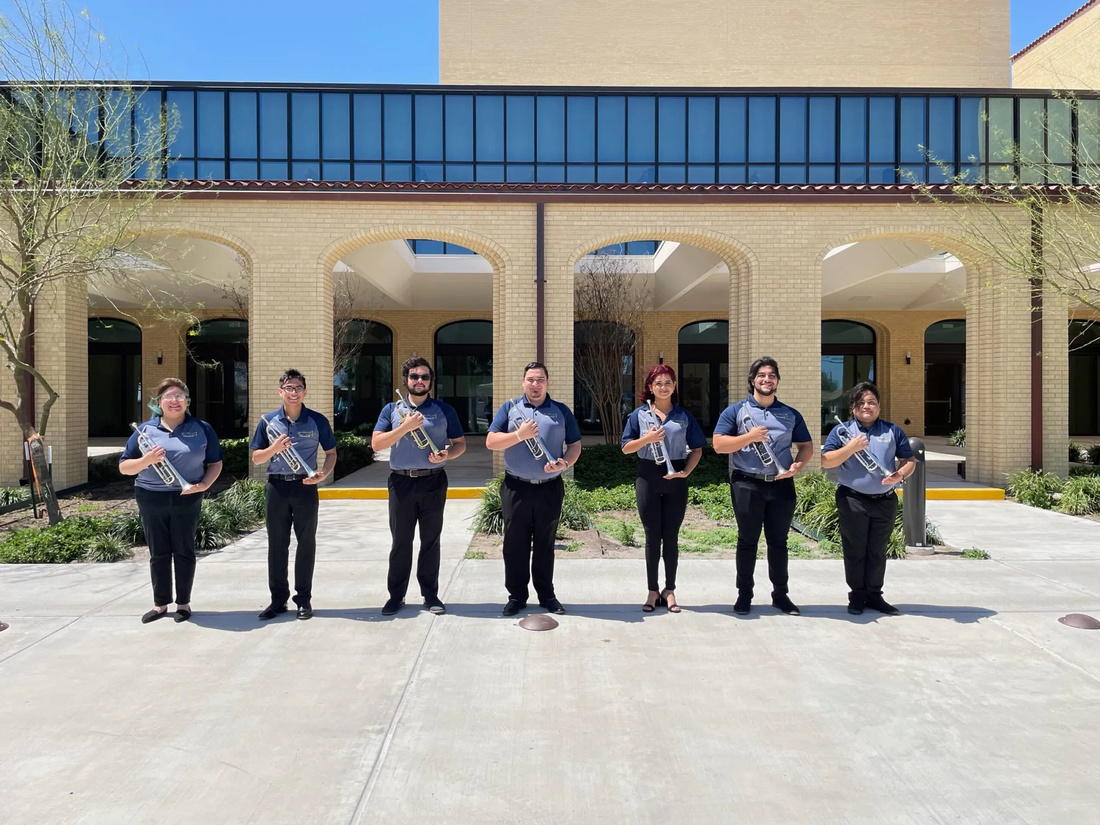
Texas Christian University - TCU Trumpet Ensemble
Dr. Jon Burgess, director
Elisabeth Adkins, Manny Arellano, Hannah Baer, Karson Beer, Emily Dear, Ford Harris, Jonathan Hunda, Trey Isenberg, Sebastian Marin, Lucas Maynard, Eithan Moreno, Nathan Musso, Hayden Nicholson, Hayden Simms, Brandon Slate, Michael Strobel, and Andy Taylor, trumpets
A Trumpet Fanfare by Patrick Vu
Hubsongs arr. Micah Bell
The TCU trumpet ensemble performed a crisp, well-balanced rendition of Patrick Vu’s A Trumpet Fanfare, featuring flugelhorn soloist Johnathan Hunda. Their second selection was Micah Bell’s arrangement of Hubsongs, which included sections of funk, swing, jazz waltz, and blues and featured soloists Hayden Simms and Sebastian Marin. (Daniel Kelly)
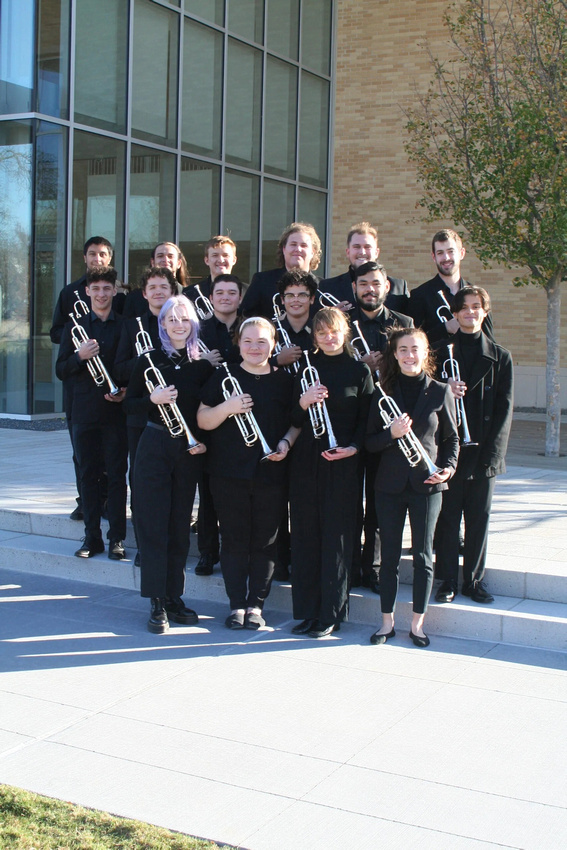
University of Colorado Boulder Trumpets
Dr. Ryan Gardner, director
Chris Boulais, Christopher Luebke-Brown, Noah Mennenga, Rebecca Ortiz, and Michael Winkler, trumpets
Capriccio Espagnol by Nikolai Rimsky-Korsakov, arr. Ryan Gardner
The University of Colorado Boulder Trumpets performed an arrangement by Dr. Ryan Gardner of Rimsky-Korsakov’s Capriccio Espagnol. This arrangement was done in a very smart way, mixing the instrumentation between duos, trios, and quartets and only involving all five parts in limited large and loud moments. This piece earned the ensemble a first-place finish at the National Trumpet Competition just a few months prior. Particularly effective was the unique use of tin foil sheets as mutes over the bell to create the effect of a snare drum. The ensemble performed the selection memorized and used unique stage positioning and bell direction to enhance musical effects. Theyand performed in a well-polished way with excellent communication, intonation, phrasing, and balance across the ensemble. (Scott Hagarty)
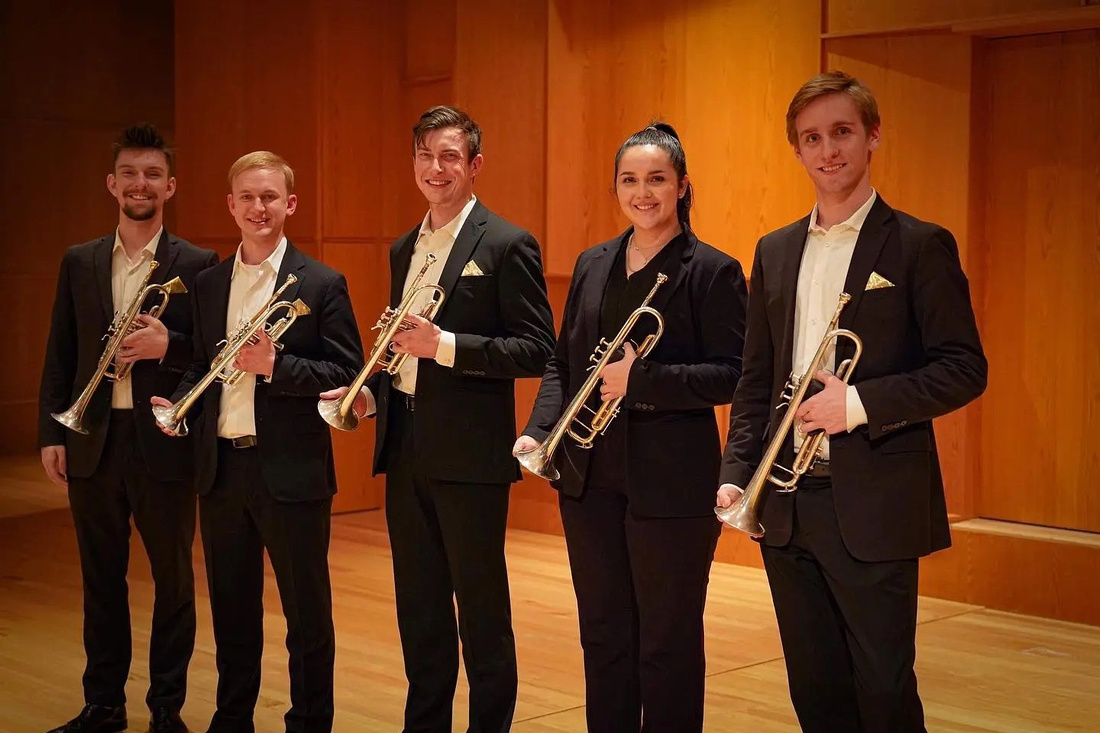
University of Nevada, Las Vegas - UNLV Trumpet Studio
Dr. Barbara Hull, director
Miguel Dominguez, Chris Massa, Allison McSwain, Alex Reyes, Kurt Tumbagahan, and Jacob Zell, trumpets
FUNfare! by Jorge Machain
X1 by Erik Morales
The UNLV Trumpet Studio opened with a composition by one of their alumni, Jorge Machain. The ensemble did a great job matching styles and blending their sound to make the harmonies in the piece really pop. They continued their performance with Erik Morales’s X1, in which the ensemble’s attention to rhythmic detail was obvious right from the start. It featured confident solos from ensemble members and a great array of tonal colors through all sections of the piece. (Kyle Millsap)
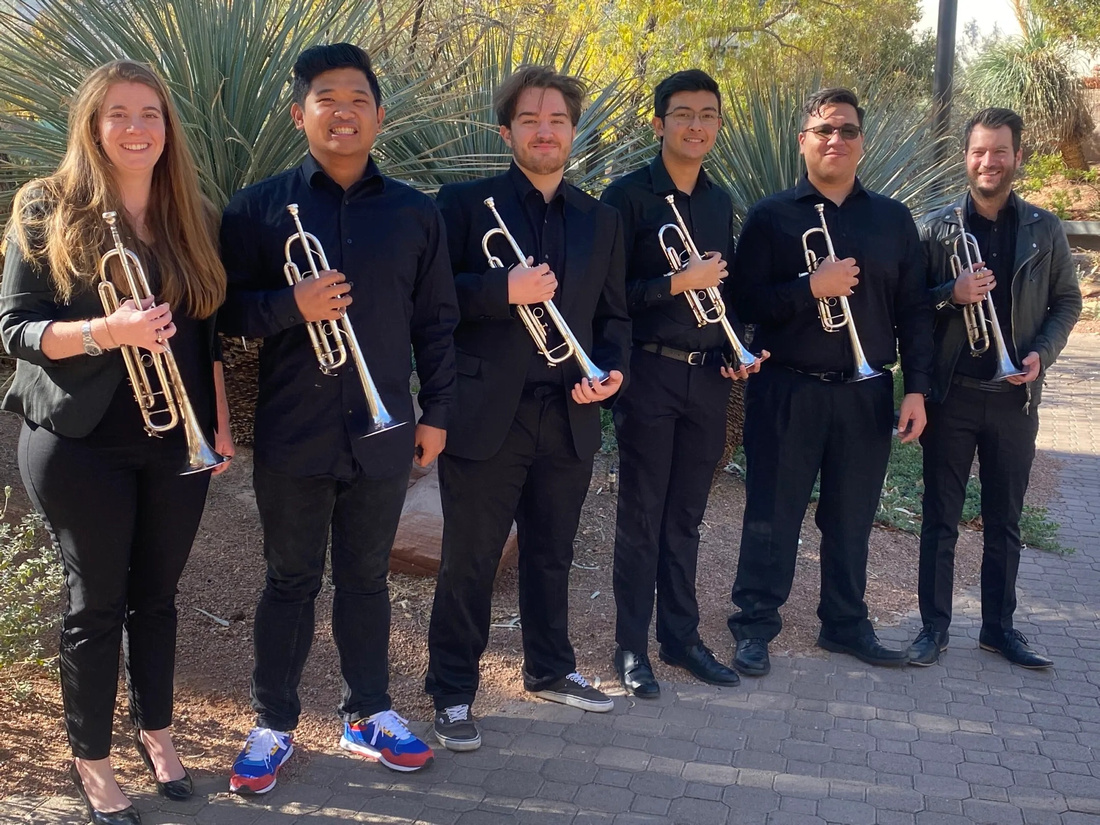
University of North Florida - UNF Trumpet Ensemble
Dr. Randy Tinnin, director
John Aliaga, Isaac Amaya, Jose Aviles, Tyler Heintzen, Leah Hughes, Tyler Kapinos, Bella Mitrione, David O’Toole, Gavin Rapelye, Megan Robichaud, and Luke Savage, trumpets
Intrada Dramatica by Joseph Price
Holler by Gary Smart
“Fanfarra” from Fantasia Brasileira by Jose Ursicino da Silva “Duda”
The University of North Florida Trumpet Ensemble opened their prelude with a rousing performance of Joseph Price’s Intrada Dramatica, which was full of excitement. Their second piece, Gary Smart’s Holler, was equally excellent, showcasing a range of styles. The final piece, the first movement from Fantasia Brasileira, was a great way to conclude the program with lots of energy, marking a perfect introduction to the evening’s concert. (Kyle Millsap)

University of South Alabama - USA Trumpet Ensemble
Dr. Peter Wood, director
Austin Allen, Samuel Collins, Desmond Foster, Jaleel Hughes, Tanner Madden, Dakota Mellick, Jacobe Ramsey, Cameron Sansing, Nathan Shadix, and Ethan Walsh, trumpets
Crescent Moon Dance by Akito Matsuda, arr. Marcus Grant
Through Space and Time by Erik Morales
The USA Trumpet Ensemble performed Marcus Grant’s virtuosic arrangement of Crescent Moon Dance, a composition from the animé show entitled Hibike! Euphonium. The group combined B-flat trumpets and flugelhorn with fine piccolo playing in a display of the group’s precision. They also performed Erik Morales’s technically demanding Through Space and Time with a uniform tone concept and energetic approach that made them a pleasure to hear. (Nick Volz)
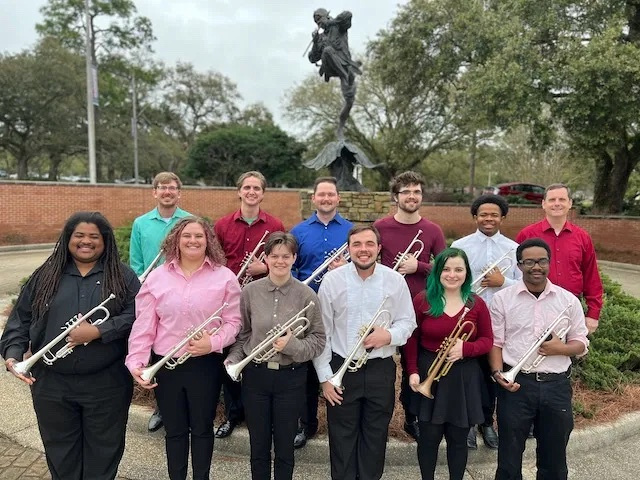
University of Victoria (Canada) - UVic Trumpet Ensemble
Merrie Klazek, director
Mark Barr, Kyle Bates, Ekaterina Della Vedova, Alicia Ellis, Heidi Goetz, Marc Micu, Benjamin Parker, Abha Marie Parmar, Elena Surridge, Luke Thomas, Koshi Thompson, and Brendan Wong, trumpets
Awakening by Merrie Klazek
Fanfare for a Special Occasion by Scott MacInnes
* Listen to Learn by Scott MacInnes
The prelude to the Festival of Trumpets concert featured three pieces performed by the University of Victoria Trumpet Ensemble, under the direction of Merrie Klazek. The first piece, Klazek’s own Awakening, was an exciting opening, featuring flourishes and regal fanfare-like lines. Scott MacInnes’s Listen to Learn was commissioned for the UVic Trumpet Ensemble and premiered in this performance. Featuring a haunting flugelhorn duet and several trios, as well as allusions to well-known orchestral repertoire, the ensemble gave a captivating performance of MacInnes’s piece. (Julia Bell)
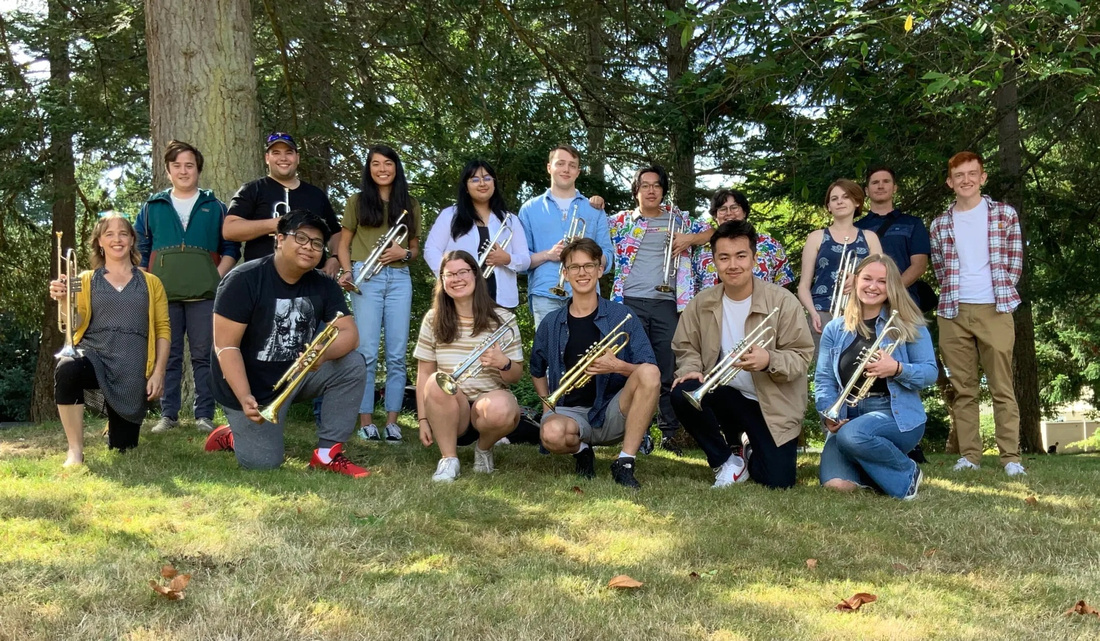
West Chester University - WCU Trumpet Ensemble
Dr. Jean-Christophe Dobrzelwski and Robert Skoniczin, directors
Trent Detweiler, Julianna Johnson, Tommy Kuhns, James Lobb, Charlotte McMillen, and Madison Smith, trumpets
Infinite Ascent by Erik Morales
West Chester University’s Trumpet Ensemble gave a highly musical performance of the Erik Morales staple Infinite Ascent. Featuring not only members of the studio, but also trumpet professors, the ensemble’s fluid approach set up the energetic climax of the work very dramatically. (Nick Volz)

Westminster College Trumpet Ensemble
Dr. Timothy Winfield, director
Isabella Dienes, Hunter Hoag, Charles Lisella, Madison Mueller-Howell, Cameron Stahl, and Dalton Stoops, trumpets
Conquest by Erik Morales
The Westminster College Trumpet Ensemble presented an energetic rendition of Erik Morales’s Conquest. The group put on an excellent display of musicality and balance throughout this challenging work. The performance was well received by the audience and served as a great introduction to the clinic that followed. (Javian Brabham)
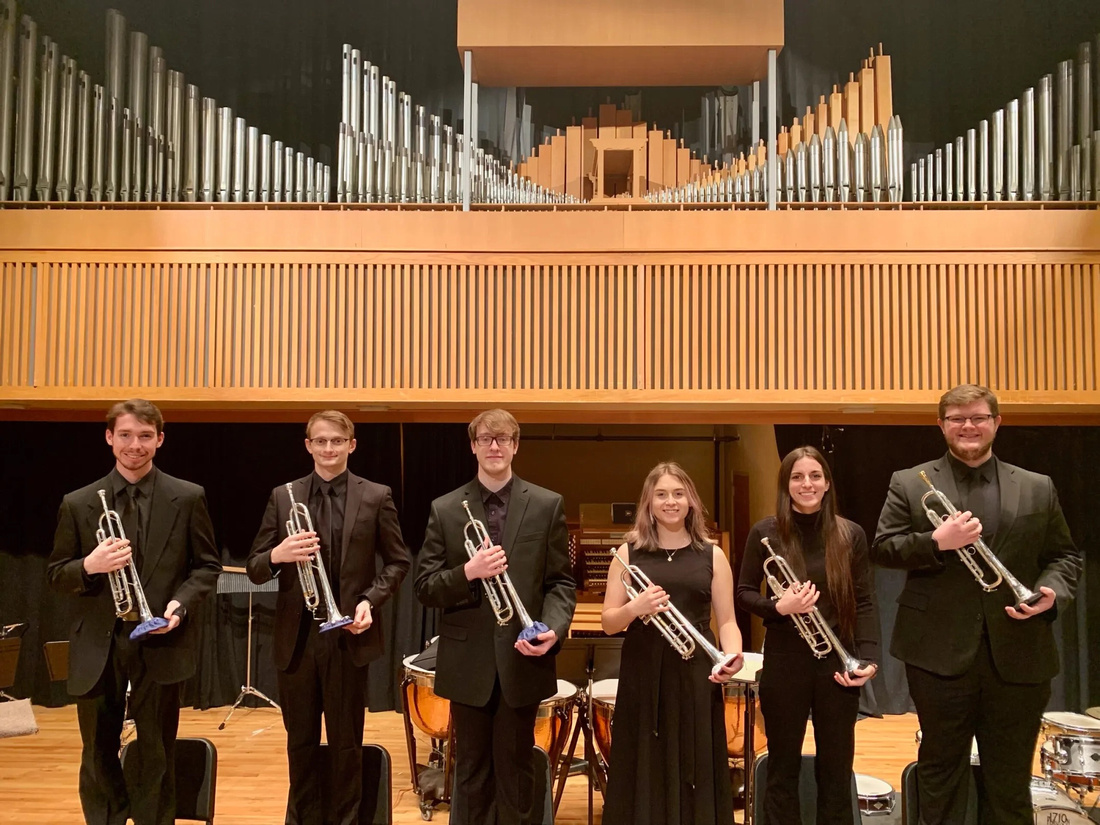
2022 Results
Competitions Coordinator: Jason Dovel
Orchestral Excerpts Competition
Chair: Christopher Wilson
First place: (Victor Pires, Georgia State University, student of Alexander Freund)
Second place: Noah Mennenga (University of Colorado at Boulder, student of Ryan Gardner)
Third place: Michael Winkler (University of Colorado at Boulder, student of Ryan Gardner)
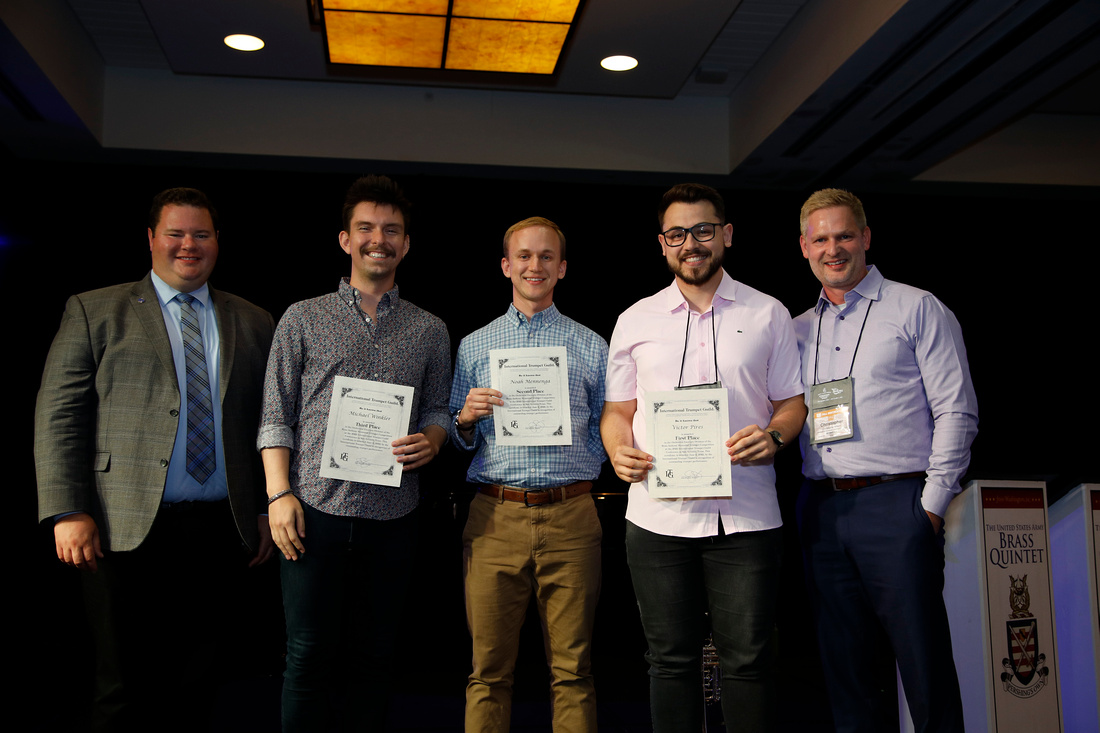
Wind Band Excerpts Competition
Chair: Susan Rider
First place: Julia Gill (Florida State University, student of Christopher Moore)
Second place: Christopher Keach (McGill University, student of Richard Stoelzel)
Third place: Anna Kallinikos (University of Colorado at Boulder, student of Ryan Gardner)
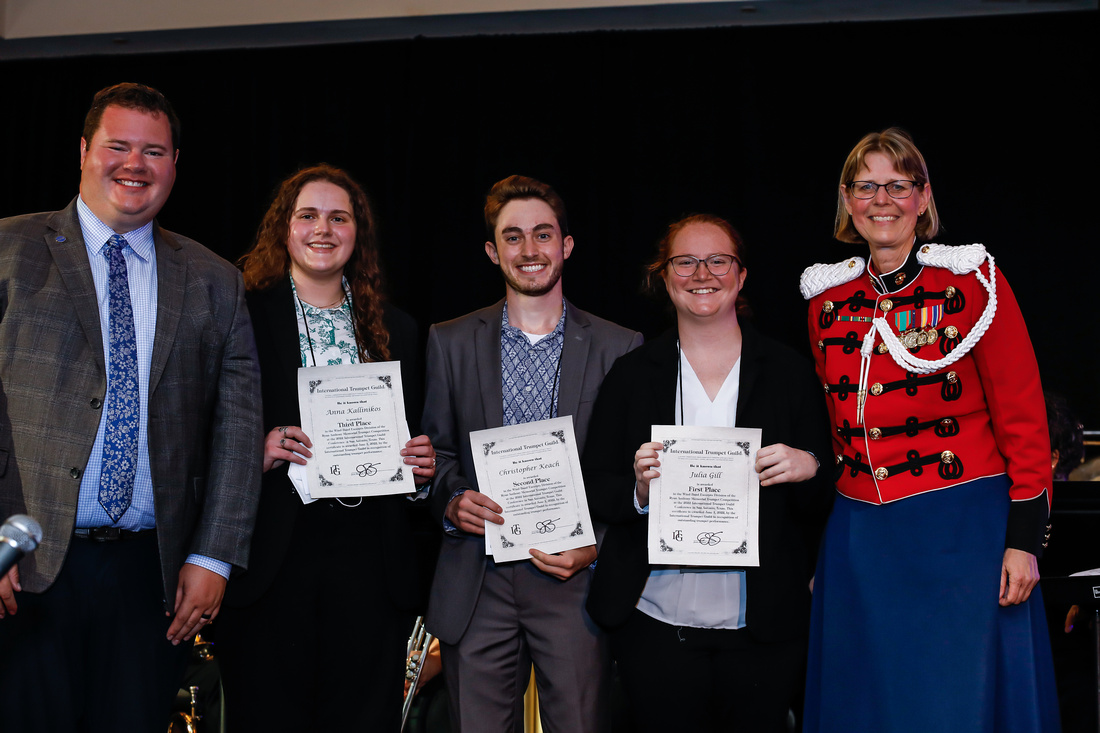 Solo Competition
Solo Competition
Chair: Jean Laurenz
First place: Rui Almeida (Escola Superior de Música e Artes do Espetáculo, student of Kevin Wauldron)
Second place: DoYoung Baek (Busan High School of the Arts, student of Dmitry Lokalenkov)
Third place: Diogo Costa (Universidade de Aveiro, student of Luis Granjo)
 Jazz Improvisation Competition
Jazz Improvisation Competition
Chair: Oscar Passley
First place: Summer Camargo (The Juilliard School, student of Joe Magnarelli)
Second place: Camilo Molina (University of Miami, student of Brian Lynch)
Third place: Emerson Borg (University of North Carolina Greensboro, student of Thomas Heflin)
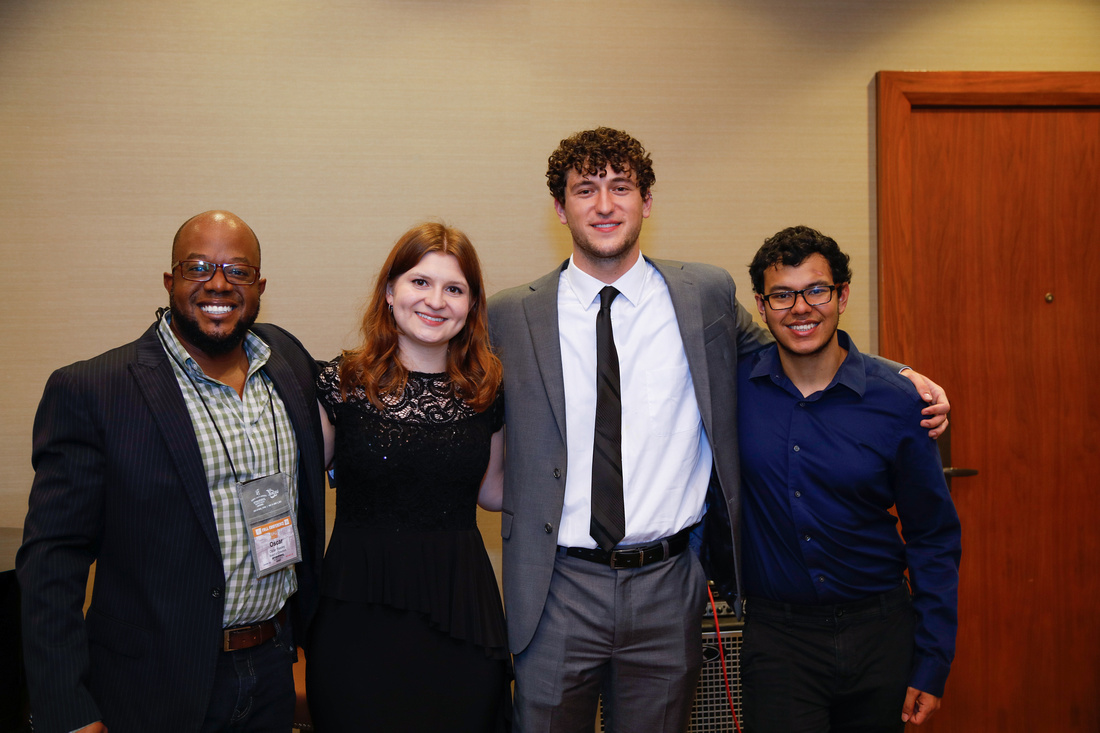
Youth Competition (Senior Division)
Chair: Nairam Simoes
First place: Jack Bricklemyer (Tampa, Florida, USA, student of Robert Murray)
Second place: Ian Lee (Haverford, PA, USA, student of Alexander Serio)
Third place: Hsueh-Yang Yang (Midland, TX, USA, student of Jordan Holmes)
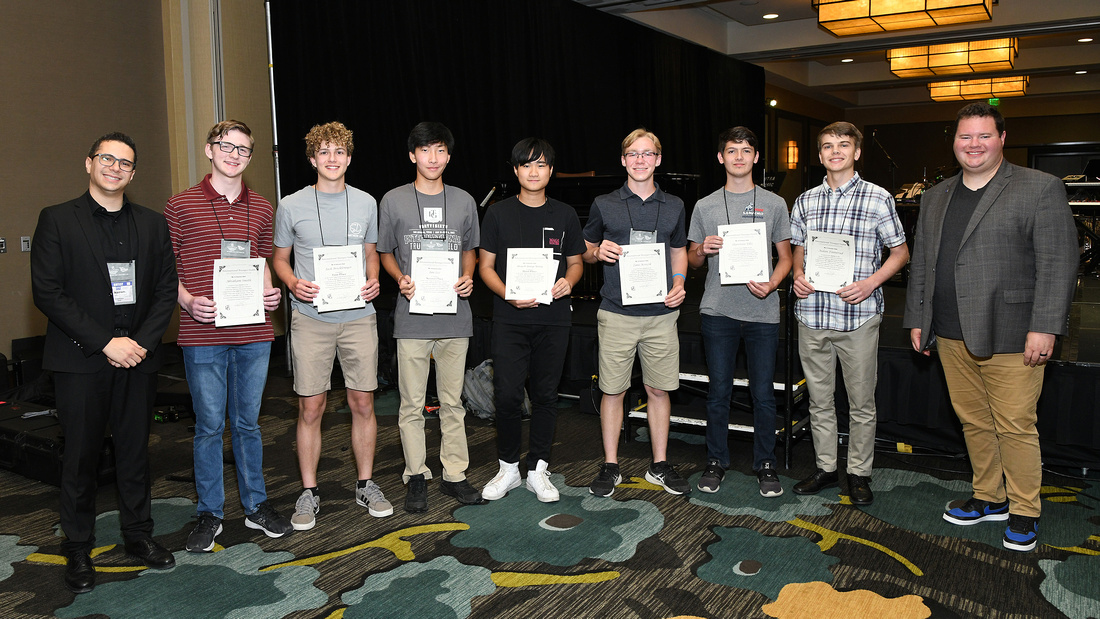 Youth Competition (Junior Division)
Youth Competition (Junior Division)
Chair: Nairam Simoes
First place: Jade Park (Newington, NSW, Australia, student of Paul Terracini)
Second place: Alejandro Martinez (Rockwall, TX, USA, student of Cris Roman)
Third place: Jason Zgonc (Decatur, GA, USA, student of Stuart Stephenson)
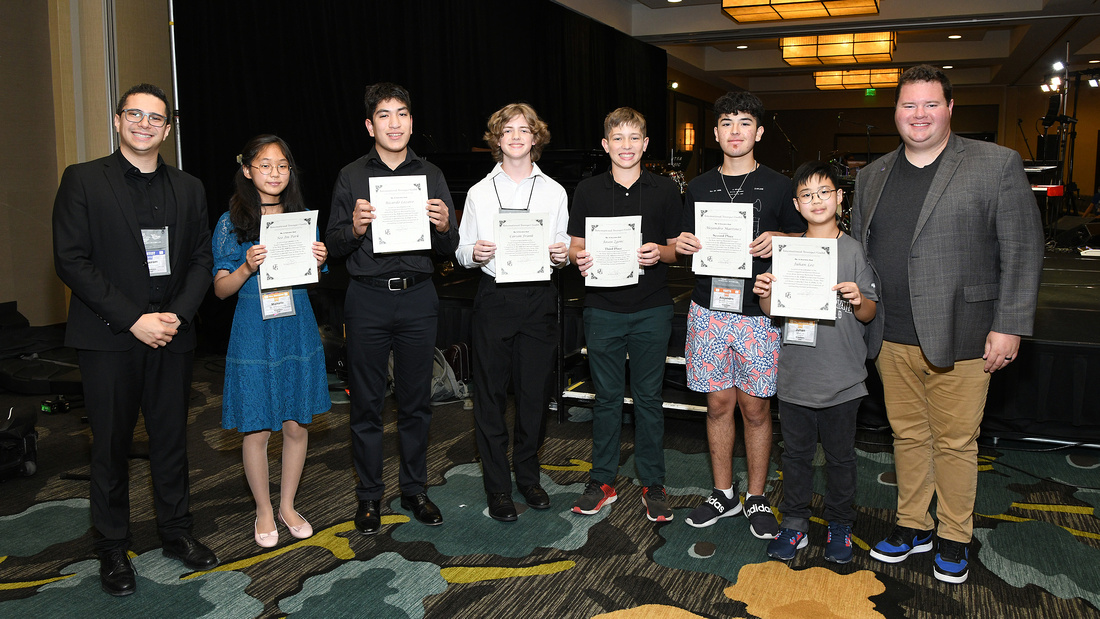
ITG Conference Scholarships for Students
Scholarship Chair: Sarah Stoneback
ITG Legacy Fund Scholarship
Jeremy Perkins (Florida State University, student of Christopher Moore)
Franz X. Streitwieser Memorial Scholarship
Themba Pieterse (Manhattan School of Music, student of Ethan Bensdorf)
Noah Solomon (University of Colorado Boulder, student of Ryan Gardner)
Austin Widmann (Indiana University of Pennsylvania, student of Kevin Eisensmith)
Seo Jin (Michelle) Park (Ellen Fletcher Middle School, student of Mark Nemoyten)
Jason Zgonc (Renfroe Middle School, student of Stuart Stephenson)
Jade Park (St. Andrew's Cathedral School, student of Paul Terracini)
Bryan & Nancy Goff Scholarship
Megan Park (University of Arkansas, student of Richard Rulli)
Cliff and Bunny Blackburn Scholarship
Vance Garven (Florida State University, student of Christopher Moore)
Addison Bosch (University of New Mexico, student of John Marchiando)
Donald P. Bullock Memorial Fund Scholarship
William Reynolds (South Dakota State University, student of David Reynolds)
Richard B. Lehman Memorial Fund Scholarship
Brandon Hebert (Louisiana State University, student of Matthew Vangjel)
Gard Bags Scholarship
Jack Lyons (Florida State University, student of Christopher Moore)
Thum Rangsiyawaranon (Florida State University, student of Christopher Moore)
Thompson Music Co. Scholarship
James Popper (Florida State University, student of Christopher Moore)
Terry Warburton Young Innovator Scholarship
Max Stephenson (Ithaca College, student of Aaron Witek)
David Hall (Michigan State University, student of Justin Emerich)
Bill Pfund Scholarship
Zane Kenzik (Arkansas State University, student of Nairam Simoes)
Yang Hseuh-Yang (Trinity School of Midland, student of Jordan Holmes)
Clifton Plog Memorial Fund Scholarship
Bridgette Thomas (Lebanon Trail High School, student of Richard Adams)
Stuart D. Shanler Scholarship
Thana Rangsiyawaranon (Florida State University, student of Christopher Moore)
Sandy Sandberg Memorial Fund Scholarship
Colin Terk (University of Colorado Boulder, student of Ryan Gardner)
Eckroth Music Scholarship
Nathan Adams (Manhattan Christian High School, student of Sarah Stoneback)
Pickett Brass and Blackburn Trumpets Scholarship
Tyler Helms (University of Memphis, student of David Spencer)
Renold O. Schilke Memorial Fund Scholarship
Connor Johnson (Michigan State University, student of Justin Emerich)
]]>
Julia Bell is a musician and educator based in Tallahassee, Florida. She is a member of the Tallahassee Symphony Orchestra and is a doctoral graduate teaching assistant at Florida State University.
Javian Brabham serves as assistant professor of trumpet and brass area chair at Valdosta State University. He serves as principal trumpet of the Valdosta and Albany (GA) Symphony Orchestras.
Spencer Brand serves as adjunct faculty of trumpet and ear-training at Glendale Community College (Arizona). He also performs and arranges for the Phoenix Brass Collective and coordinates their annual Young Artist Competition.
George Carpten, IV, is the ITG Profile column editor for the ITG Journal and serves as assistant professor of trumpet at Northern Kentucky University.
Sarah Cisney is a junior music education student at Indiana University of Pennsylvania, where she studies trumpet with Kevin Eisensmith.
Eli Denecke is a recent doctoral graduate of Florida State University. He is now a freelance trumpeter and educator in the Greater New York area.
Flint Angeroth Franks is a freelance trumpeter and band clinician across the United States. Currently, he is pursuing his doctorate in trumpet performance at Florida State University.
Scott Hagarty serves as a media reviewer for the ITG Journal and is assistant professor of trumpet at Tennessee Tech University. He is principal trumpet of the Bryan Symphony Orchestra and a member of the Brass Arts Quintet.
Benjamin Hay serves as assistant professor of trumpet at Northeastern State University in Tahlequah, Oklahoma. He performs as principal trumpet of the Signature Symphony (Tulsa, OK), Bartlesville Symphony Orchestra, and Tulsa’s Starlight Concert Band.
Daniel Kelly is professor of trumpet at Texas A&M University-Commerce and Media Reviews editor for the ITG Journal.
Christopher Luebke-Brown is a doctoral student at the University of Colorado at Boulder. His primary teachers include Ryan Gardner, Ryan Anthony, and Ray Sasaki. He enjoys teaching privately and conducting pedagogical research.
Angela King, editorial assistant, is a trumpet player residing in Tallahassee, Florida. She is a Doctor of Music degree candidate at Florida State University.
Kyle Millsap is associate professor of trumpet and jazz at Texas A&M University-Kingsville. He is a member of the Corpus Christi and Victoria Symphony Orchestras and the Kingsville Brass Quintet.
Joseph Nibley serves as assistant professor of brass studies at Fort Lewis College in Durango, Colorado, where he maintains an active teaching and performing schedule.
Maryna Pohlman received her master’s degree in trumpet performance at the University of Utah and her Bachelor of Arts degree in trumpet performance at Fort Lewis College.
Nathan Shadix is a graduate trumpet student at the University of South Alabama, where he studies with Dr. Peter Wood.
J. Peyden Shelton is assistant professor of trumpet at the University of Utah and a member of Fifth Bridge and the Mirari Brass Quintet. He is a Yamaha performing artist.
Richard Tirk is professor of trumpet and jazz at Southwestern Oklahoma State University. He and his wife, Suzanne, perform works for trumpet and clarinet as Duo Iona.
Jena Vangjel is instructor of trumpet at Louisiana State University. In addition, she is an active freelancer and is the founder/director of Community of Note.
Matthew Vangjel is associate professor of trumpet at Louisiana State University and also holds positions with the Mirari Brass Quintet, Fountain City Brass Band, and Mobile Symphony Orchestra.
Nick Volz is associate professor of trumpet and jazz studies at Loyola University New Orleans.
Spencer Wallin lives in Utah, where he works as a freelance musician, performing regularly with the Orchestra at Temple Square. He formally taught trumpet part-time at Texas A&M University-Kingsville and Navarro College.
Marisa Youngs is adjunct professor of trumpet and music theory at Winthrop University in Rock Hill, South Carolina. She serves as chair of the ITG New Works committee and was previously the on-site coordinator.
]]>Special Daily Report • Compiled by Peter Wood
Photos by Denny Schreffler, Josh Rzepka, Benjamin Lowe, Ryan Berndt, Jeff Grass, and Michael Anderson
Saturday, June 4, 2022
Click here for more photos from the ITG Conference
Doug Lindsey warm-up session - Fundamentals of an Effortless Sound: Breath, Shape, and Freedom
Dr. Douglas Lindsey’s warm-up session began with the question, “What makes your sound special?” Lindsey focused his presentation on attention to free and easy sound production. After addressing some of the common breathing issues he has often seen in his teaching, he led the participants in a series of breathing exercises directed towards experimenting with shape and continuity. Moving to the horn, Lindsey had each person play G in the staff and G above the staff to reinforce this concept. Lip slurs were next, where he discussed the dangers of jaw and hand tension. Lindsey used the Cichowicz flow studies exercises as an example of a melodic line that one can use to focus on such fundamentals as breathing and sound. To work on articulation, he led the group through air patterns, asking for constant spinning and energetic air, and then followed that with similar patterns with the trumpet. To finish his session, Lindsey shared his ideas about the choices we can make to become more courageous performers. (Rich Tirk)
Juan Avendaño warm-up session - Keep it Simple: Keep Your Mind and Body Aligned with Your Playing
Juan Avendaño is the current principal trumpet of the National Symphony Orchestra of Colombia, professor at the Universidad Nacional de Colombia and an international trumpet soloist. His warm-up session emphasized the importance of playing with a focused mind and relaxed embouchure in congruence with proper air support. He led the participants through a natural exercise progression, beginning with breath work, mouthpiece buzzing, leadpipe buzzing, and then full-horn playing. He concluded the session with tongue placement exercises to manipulate timbre for finding the center of the pitch and aiding in relaxed upper-register playing. This was an exceptional final warm-up session at the Conference. (Maryna Pohlman)
Sycil Mathai warm-up session - Revisiting James Stamp’s Warmups
Sycil Mathai’s warm-up session was a refreshing take on the well-loved flow studies of James Stamp. Mathai prefaced the clinic by saying that he was going to present his personal version of James Stamp’s materials, informed by years of study with notable Stamp pedagogues and the journey of his impressively multifaceted playing career. Using a call-and-response approach, Mathai encouraged those in attendance to set up in a circle in order to hear individual sounds more clearly. The emphasis throughout the session was on centered, resonant sounds without forced wind. Mathai also encouraged proper posture through his “overhead stretch with the trumpet,” which was invigorating and helpful. After taking the group through the entire range of the instrument and a few slurs that incorporated light articulation, Mathai ended the session by listening to willing individuals perform Stamp’s exercises and then offering insightful feedback. (Benjamin Hay)
Youth Competition: Senior Division
The Senior Division of this year’s Youth Competition had many talented, inspiring young trumpet players. With Nairam Simoes as the competition chair, Kyle Millsap, Jen Oliverio, and Chloe Swindler served as judges. To start, Aiden Finnerud performed Charlier’s second etude with beauty and musical character. Harrison Ellis followed, also performing Charlier no. 2 with a strong sound and warm vibrato from the outset. Abraham Smith’s wonderful finger technique shined on Charlier’s twentieth etude. Zane Keznik gave a mature performance of Charlier’s fourth etude. Nathan Adams performed Charlier 2 with a lovely sound and phrasing. Bridgette Thompson’s Charlier 2 had sensitive phrasing with crystal-clear sound throughout. Jack Bricklemyer performed with a lovely, fluid sound, handling the arpeggios of Böhme’s 24th melodic etude with ease. Hsueh-Yang Yang phrased Charlier’s thirtieth etude brilliantly with fantastic contrast in the articulations. To finish the competition, Ian Lee elegantly performed Charlier 4 with an incredibly leggiero double tongue. After their performances, each student participating in the competition received the opportunity to work with either Buddy Deshler, Chase Hawkins, or Robert Sears. This year’s competition certainly included impressive performances from students with bright futures. (Spencer Brand)
 Youth Competition: Junior Division
Youth Competition: Junior Division
The ITG Youth Day held the Junior Division competition the morning of June 4, 2022, a competition composed of a highly talented group of seven students from Australia, China, and the United States. The first competitor was Carson Frank, who performed Arban’s Characteristic Study No. 12. This piece showcased Frank’s flexibility with wide interval leaps and control over the full range of the instrument. The second competitor was Seo Jin (Michelle) Park, performing Etude No. 2 from Bousquet’s 36 Celebrated Studies for the Cornet. This piece wonderfully showcased Park’s technical ability with her strict precision in very quick passages. Juhan Lee performed Etude No. 2, “Du Style,” from Charlier’s Trente-Six Etudes Transcendantes pour Trompette. Lee displayed wonderful musicality and lyrical expression, along with a rich sound throughout his low register. Subsequently, Jade Park had an outstanding fully memorized performance of Charlier’s No. 23, “L’Arpège.” This selection wonderfully showcased her effortless and brilliant sound throughout each exhilarating passage. Ricardo Lazaro, a self-taught trumpet player, played Alexander Goedicke’s Concert Etude. He chose a fantastic piece that allowed him to explore his powerful sound within both technical and lyrical styles. Alejandro Martinez performed Charlier’s Etude No. 8, “Intervalles.” Martinez’s warm, inviting sound was highlighted by the luscious lyrical phrases and leaping intervals of this piece. Concluding the competition, Bousquet’s Etude No. 7 was performed by Jason Zgonc. Zgonc’s clear articulation and fine control through leaping intervals perfectly complements the integrity of this piece. (Maryna Pohlman)
 Jeremy Stanek clinic - How To Avoid Career-Ending Injury as a Trumpet Player… There’s More than Focal Dystonia
Jeremy Stanek clinic - How To Avoid Career-Ending Injury as a Trumpet Player… There’s More than Focal Dystonia
Dr. Jeremy Stanek gave an informative presentation on the numerous ways that performing artists can have their careers cut short by injuries. Stanek is a clinical assistant professor in sports medicine and founder of Stanford University’s Performing Arts Medicine Program. His research shows that 76% of orchestral musicians have had injuries that affected their ability to perform, and a more recent study among college students and faculty (ITG Journal, Jan19/37) show similar results. Stanek presented the data by instrument and type/frequency of pain before focusing his remarks on trumpet players, of which 36% reported career- or practice-limiting pain. Common causes include excessive practice/performing time, insufficient warmup, a sudden increase in playing time or difficulty, and other factors that align with those in sports medicine. Stanek’s professional trumpet career itself was cut short by focal dystonia, prompting his second career as a medical doctor and his research interests. He hopes to return next year to present entirely on focal dystonia. More information can be found on Stanek’s website (https://pmr.stanford.edu/patients/performing-arts-orthopaedic-health.html) or by emailing him ([email protected]). (Daniel Kelly)
Carolyn Sanders lecture - Female and Black in a Biased World: The Remarkable Career of Ernestine “Tiny” Davis
Carolyn Sanders’ lecture provided a detailed overview of Tiny’s life and career. A contemporary of Louis Armstrong and a remarkable player, she was a member of the International Sweethearts of Rhythm and later her own group, the Hell Divers. She faced many barriers throughout her career, but her virtuosic playing and vibrant personality were very apparent from the clips that Sanders shared of Davis’s performing and speaking. Sanders’ presentation brought Davis’s story to life and enriched the trumpet players who can now carry on the memory of Ernestine “Tiny” Davis. (Julia Bell)
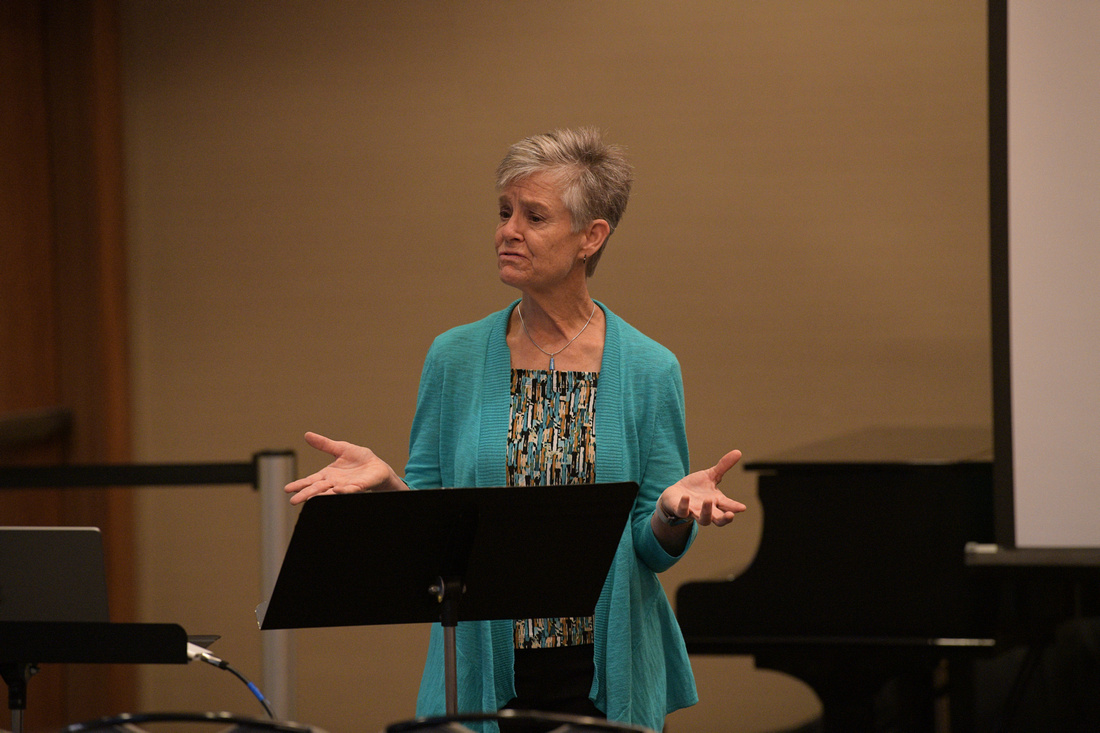 Navy Commodores Trumpet Section clinic - The Devil is in the Details: Considerations for a Lead Trumpet Player
Navy Commodores Trumpet Section clinic - The Devil is in the Details: Considerations for a Lead Trumpet Player
On the last day of the conference, the US Navy Commodores trumpet section hosted a clinic aimed at explaining the nuanced job of lead trumpet playing. Chief Musician Jonathan Barnes, Musician 1st Class Alex Albrecht, and Musician 1st Class Andrew Bezik were joined by Professor Joey Tartell. This section of high-caliber commercial players performed a handful of big band excerpts as prompts for a discussion on stylistic decisions that a lead player must make. Bezik finds what he calls his “internal interpretation” when receiving a new chart. He sings through his part to discover where he naturally wants to place the emphasis and to determine how to execute such ornamentations as bends, shakes, and smears. The audience also learned about the delicate precision it takes for the rest of the section to follow the lead player. The phenomenal playing and sagacious wisdom made for an incredible learning experience for all in attendance. (Christopher Luebke-Brown)
 James Zingara clinic: From Zero to Performance: Creating New Chamber Repertoire for Non-Traditional Ensembles
James Zingara clinic: From Zero to Performance: Creating New Chamber Repertoire for Non-Traditional Ensembles
James Zingara and the University of Alabama at Birmingham (UAB) Chamber Trio, including Denise Gainey on clarinet and Chris Steele on piano, performed and presented strategies to create new works for non-traditional chamber ensembles. Zingara discussed effective approaches to commissioning works, such as using “Call for Score” via composersite.com. To display the versatility of these compositions written for the UAB Chamber Trio, they performed excerpts from larger works written for them, including the second movement from Walter Hartley’s Two Dances, William Price’s I Don’t Want to Dance, the third movement (“Zoom”) from Valention Bogdan’s City Scenes, and a world premier of Czech composer Katerina Horka’s Trio con Brio. The UAB Chamber Trio performed beautifully throughout the presentation and very capably displayed the musical capabilities of such an ensemble. (Javian Brabham)
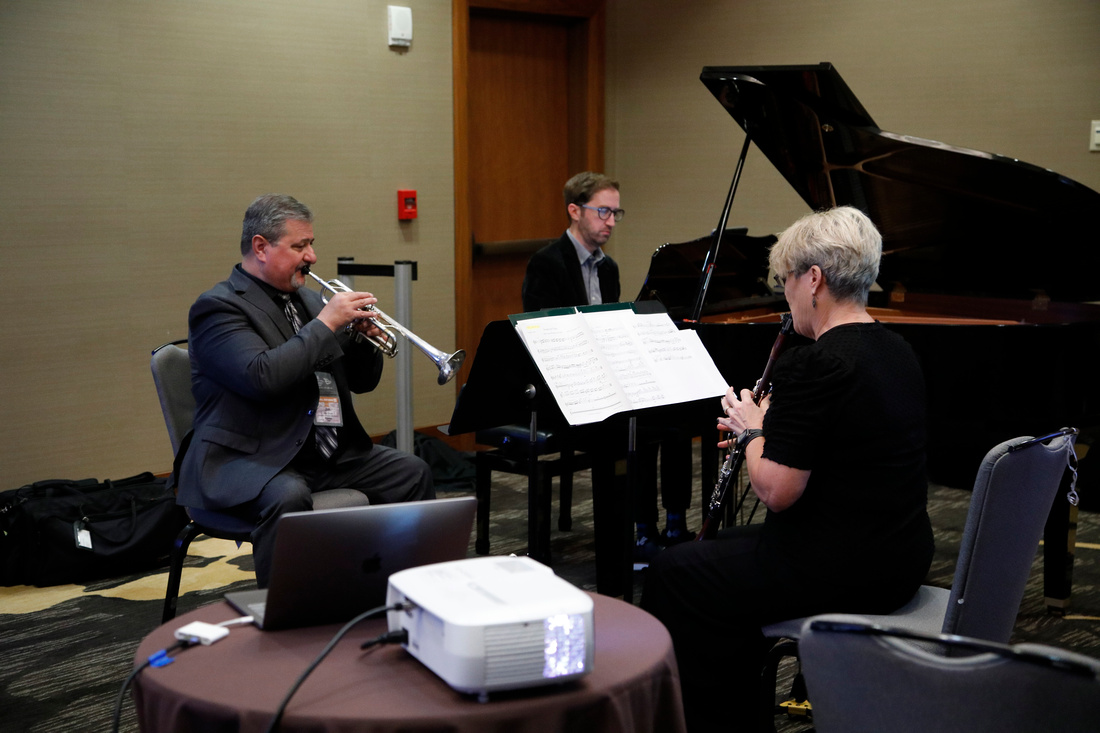 Dario Savino Doronzo flugelhorn recital - Reimagining Opera
Dario Savino Doronzo flugelhorn recital - Reimagining Opera
Saturday morning's recital in the Regency Ballroom was presented by Italian trumpeter Dario Savino Doronzo and accompanist Pietro Gallo. The audience enjoyed the varied and exciting sounds of a number of opera arias reharmonized as jazz standards. Doronzo breathed new life into the familiar melodies, drawing from his background in jazz to create personal and authentic interpretations. He also demonstrated his superb command of timbre, angling his horn in different directions and stepping forward to center stage to color his sound in surprising ways. Gallo delighted listeners with a soulful rendition of Puccini's “Nessun dorma” before the last handful of arrangements. Overall, the pair successfully brought together two disparate styles, essentially creating a new and inspiring assemblage of jazz standards. (Eli Denecke)
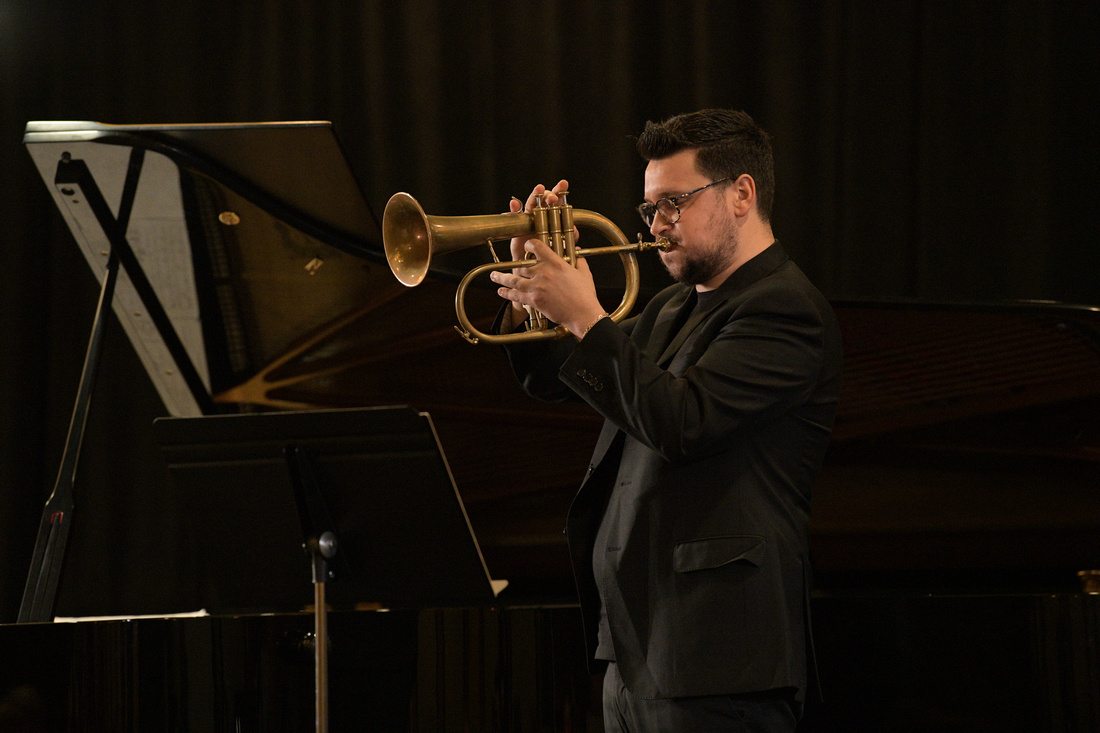
Paul Merkelo recital - A Tribute to Timofei Dokshizer (100th Anniversary)
To commemorate the 100th anniversary of the birth of Timofei Dokshitzer, virtuosos Paul Merkelo and Rebecca Wilt (piano) performed four works that either were inspired by Dokshizer’s and Merkelo’s shared Ukrainian heritage or that inspired Merkelo through Dokshizer’s iconic recordings of those works. The palette of musical colors and the subtleties with which Merkelo performed - crystalline, floating high notes and powerful, jazz-influenced runs - showcased a truly impressive range of not only technical prowess, but also musical sensitivity and artistry. Opening with Rebecca Wilt’s powerful arrangement of Pictures at an Exhibition for solo trumpet and piano, Merkelo then showed off a delicate sweetness on Gliere’s “Andante” from Concerto for Coloratura Soprano. He then performed Arutiunian’s Concerto with nuance and imagination, yet also with great reverence and respect for Dokshizer’s original interpretation. Merkelo closed his program with Gershwin’s Rhapsody in Blue (arr. Dokshizer), taking the audience on an incredible musical journey. (Joe Nibley)
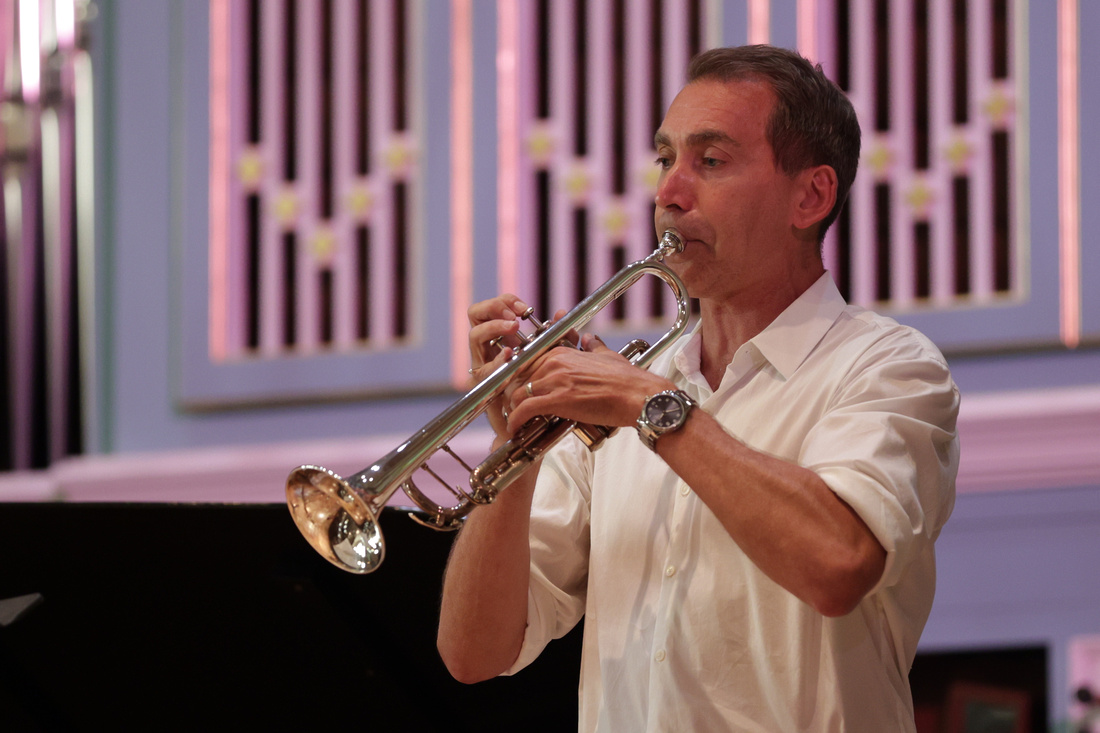
Mariachi Performance Masterclass
Agustín Sandoval, one of the world’s leading mariachi trumpet players, gave a masterclass in which he worked with two ensembles. The first to perform for Sandoval was Mariachi de la Isla from Texas A&M University-Corpus Christi, under the direction of Dr. Rai Morales. They enlivened the audience with several exuberant selections: Popurri de Sones arranged by S. M. Carrillo, Hablando Claro, arranged by Jose Hernandez, and Mariachi sol de Mexico and Besame Mucho Consuelo Valazquez, arranged by Pepe Martinez. Sandoval then worked with the South Side Junior High School Mariachi Band as they performed La Reina Es El Rey and Hermoso Carino. Sandoval spent quality time encouraging such minor changes such as articulation, vibrato, and appearance that helped enhance both ensembles’ performances. The masterclass concluded with a combined performance of La Enorme Distancia. (Maryna Pohlman)
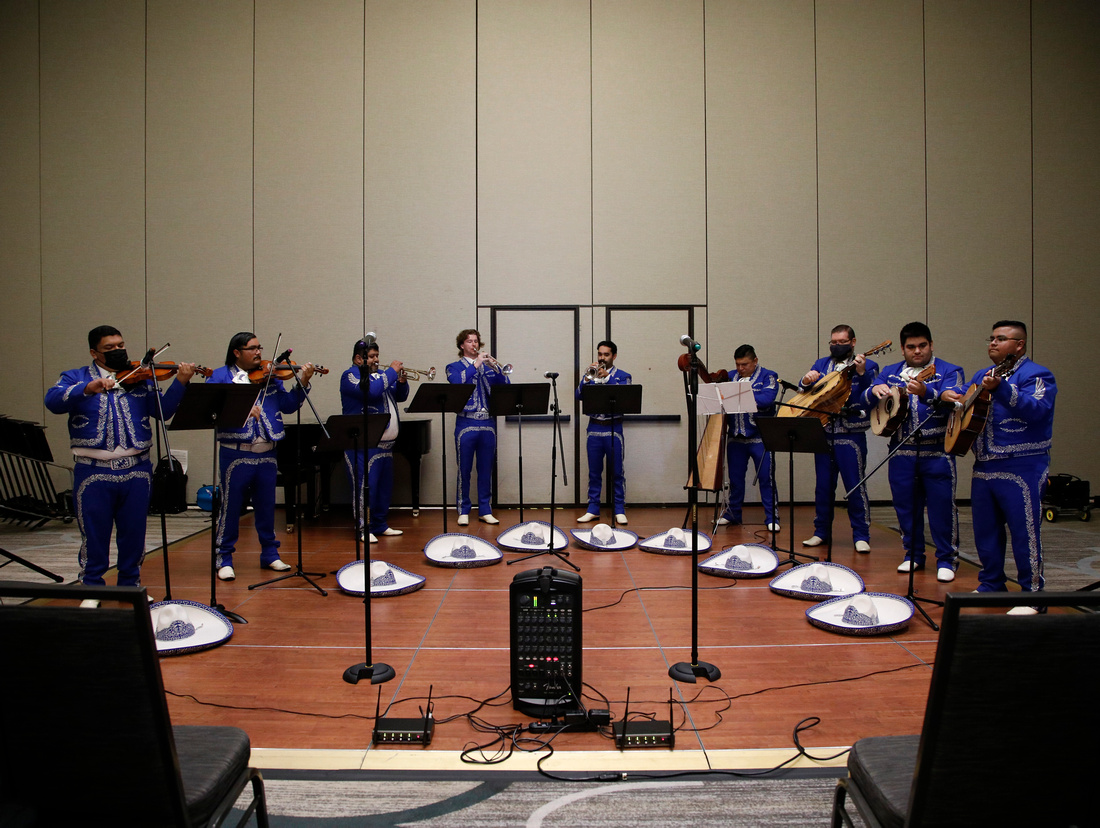
Trumpet in Trio Settings
The CPT Trio (Mary Thornton, trumpet; Carrie Pierce, cello; and Shao-Shan Chen, piano) performed Eric Ewazen’s Trio for Trumpet, Violoncello, and Piano, which was written in 2007 for Croatian trumpet player Tomislav Spoljar. The piece is in three movements and has many familiar Ewazen-esque motives, harmonic progressions, and musical forms, and the group performed it with superb tone, balance, and musical phrasing. The Balaton Chamber Brass (Amy Cherry, trumpet; Don Cherry, trombone; and Rebecca Wilt, piano) performed four movements from Elizabeth Raum’s Bushwakker Brewpub, originally written in 2002, but reworked for trumpet, trombone, and piano in 2012. Each movement depicts a different flavor of beer from the composer’s favorite Canadian brewpub. The work includes several folk-song inspired melodies with quasi-Romantic-style harmonic progressions and quirky modern chromaticism. The trio performed with tremendous balance and blend, as well as a notable musical flair. (Scott Hagarty)
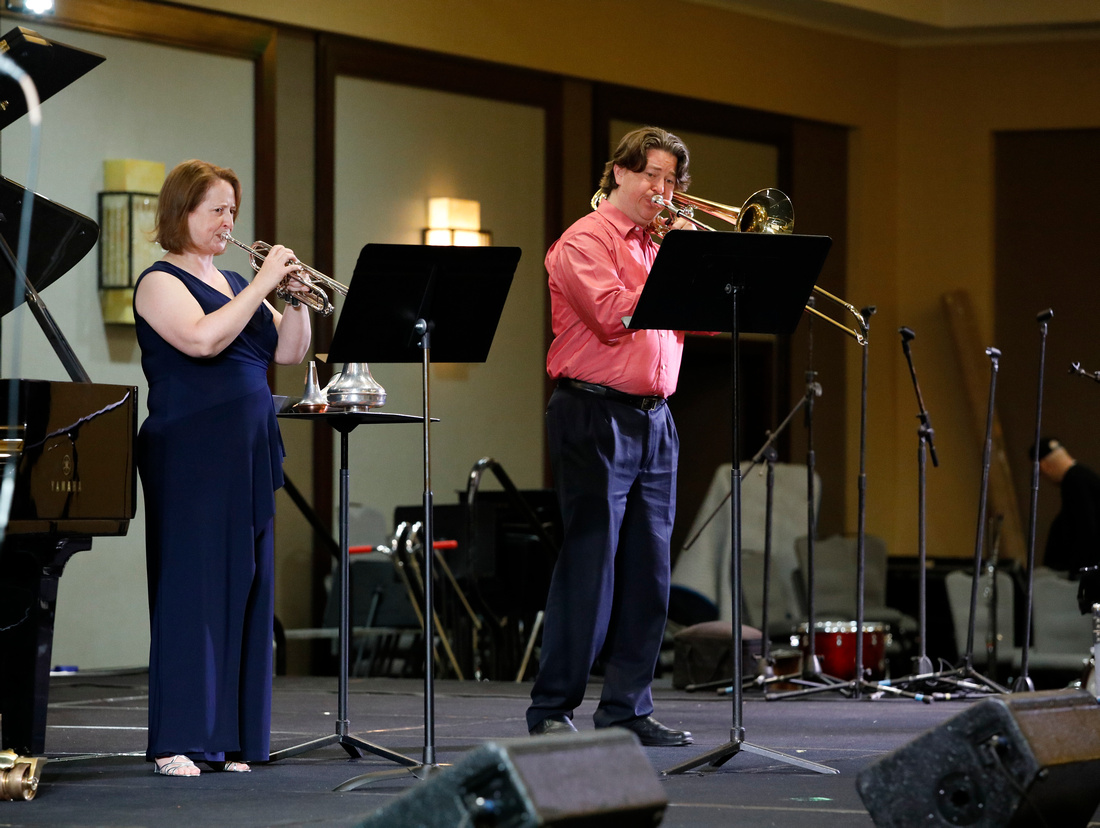
Mike Huff and Chip Crotts clinic - Overcoming Adversity Through Positivity: A Journey Through Bell’s Palsy
Drs. Huff and Crotts have both experienced diagnoses of Bell’s Palsy, a treatable neurological disorder that causes paralysis on one side of the face, which makes trumpet playing difficult. Through their presentation, the audience learned about potential causes of Bell’s Palsy and what the road to recovery looks like. Many in attendance had been affected personally by Bell’s Palsy, which led to an interesting discussion and conclusion that most people’s journeys with this disorder are quite similar. While much is still unknown at this time about the root causes of Bell’s Palsy, research shows that damage to the seventh cranial nerve (causing paralysis) is most likely caused by a virus. As such, treatment for Bell’s Palsy often includes a regimen of steroids to reduce swelling, antivirals to fight the virus, and a slow, methodical approach to rebuilding the embouchure muscle groups. Both Huff and Crotts had similar roads to recovery after consulting with their primary care physicians and neurological specialists, taking the prescribed medications, and utilizing exercises to retrain the embouchure. This helped them not only “get back” to what they could once do, but also continue to improve. Huff reassured those in attendance that as daunting as it may seem to take that time off from playing, he was able to reestablish healthy playing habits, reduce external stress (often a precursor to viral infections like this), and rebuild the confidence he had as a player and teacher before his injury. (Joe Nibley)
John Schlabach clinic - Practical Applications and Benefits for Transference of Singing Quality into Trumpet Playing
John Schlabach and Katherine Rohrer’s well attended presentation gave the audience an inside look into how singing can enhance our physical and musical abilities on the trumpet. Schlabach, professor of trumpet at Ohio University, took the audience through a series of singing patterns that he developed for his students to illustrate how to improve the connection between the ear and the trumpet. These patterns have proved to serve as a key pathway to developing efficiency and accuracy on the trumpet. Rohrer, associate professor of voice at The Ohio State University, shared insights on how the brain processes sound and what areas of the brain directly affect our music-making ability. She also discussed several ways in which singing can inform trumpet playing. Special attention was given to the quality of our singing when working on musical passages. Rohrer and Schlabach also challenged the audience to prioritize vulnerability by taking away the visual score. They both agreed that moving the stand out of the way can help to provide quicker access to music making. Lastly, Schlabach used J.L. Small’s Etude No. 1 to show how he applies his singing patterns approach to help his students improve the connection between their ears and the trumpet. By the conclusion of the session, it was clear that everyone understood the benefits of how singing with intention can lead to healthy and musical trumpet playing. (George Carpten)
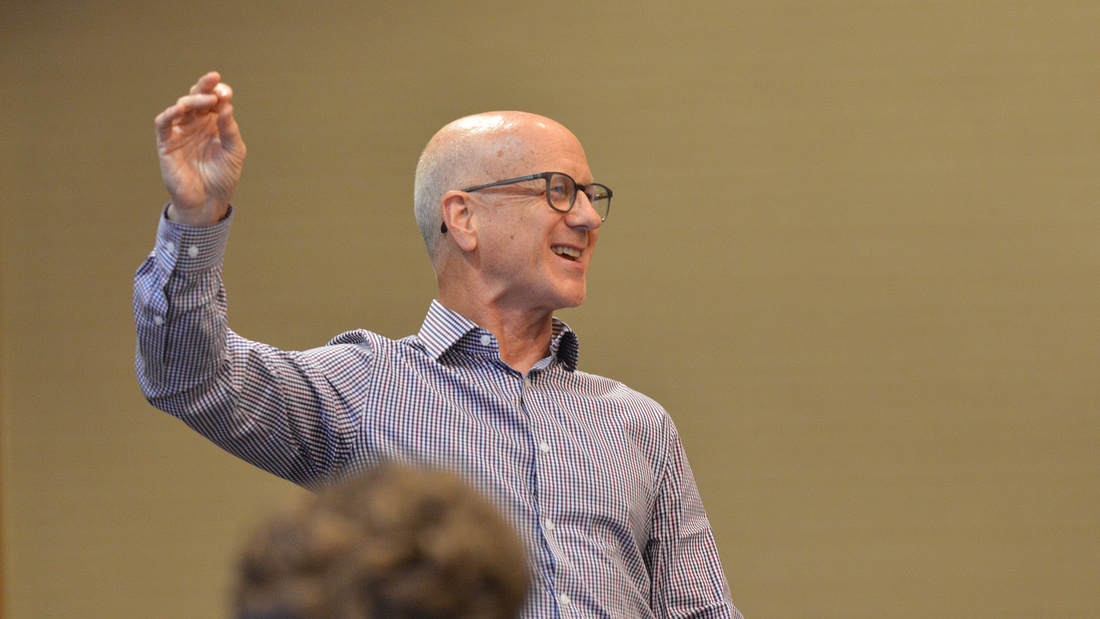
Dominique Bodart recital - Old/New, Romantic/Dramatic!
Belgian trumpeter Dominique Bodart and pianist Miriam Hickman delivered a formidable recital of standards, both old and new. Bodart employed tasteful embellishments and contrasting characters in earlier music by Handel and Mozart and was the definition of strength and poise in his performances of contemporary works. Bodart’s ability to capture appropriate characters while maintaining his voice was inspiring. Equally impressive were his dynamic extremes; both his loudest and quietest moments were equally captivating and glorious. There is a sensitivity and thoughtfulness to his playing that is rare and a joy to behold. As an encore to this already heavy program, Bodart offered up Joy Webb’s Share My Yoke on the cornet and brought the afternoon to a stunning close. (Matthew Vangjel)
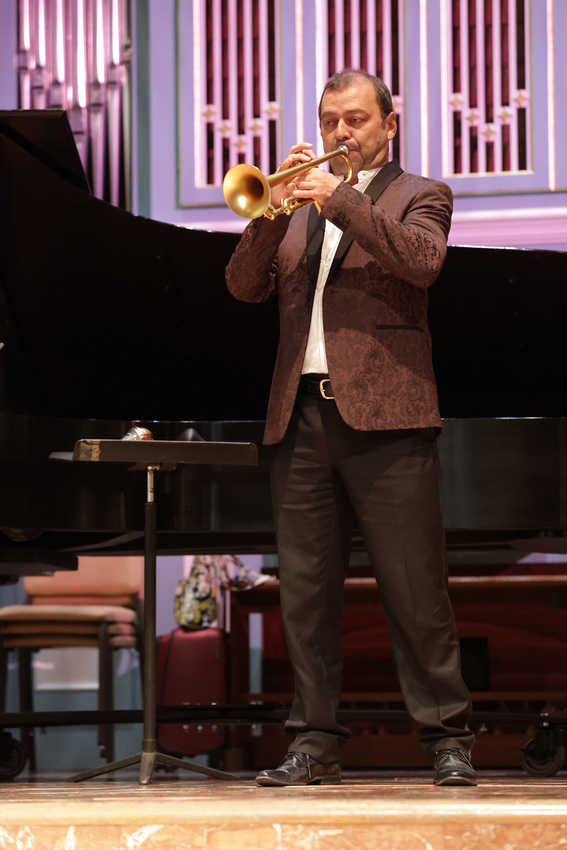
Festival of Trumpets
The opening piece of the annual Festival of Trumpets concert, Stan Pethel’s Antiphon for Trumpets was directed by Anthony Kirkland and featured energetic articulated passages. The group blended seamlessly and gave an animated performance. William Price’s Pieces of Eight was conducted by Ben Rochford and showcased great stylistic contrast. The delicate, lyrical passages allowed the group to showcase beautiful phrasing and musicianship. The rich chords were played with great finesse, followed by a more technical section featuring the brilliant sounds of individual players and energized intensity in the performance. Conducted by Charles Conrad, movements III and IV of Fantasia Brasileira,, brought a lively performance of catchy, inspired, and light-hearted melodies. The next piece, Struttin’ With Some Barbecue, featured fantastic jazz playing and wonderful solos from group members. The group gave an energized performance with the uniform style, sound, and articulation of an ensemble that performs together regularly. Jennifer Fletcher’s Fanfare of the Bells, conducted by Charles Conrad, truly resembled the sound of bells as the group passed around bell tones to begin the piece. The group showcased a wide dynamic range and beautiful musicianship on this lively piece. (Julia Bell)
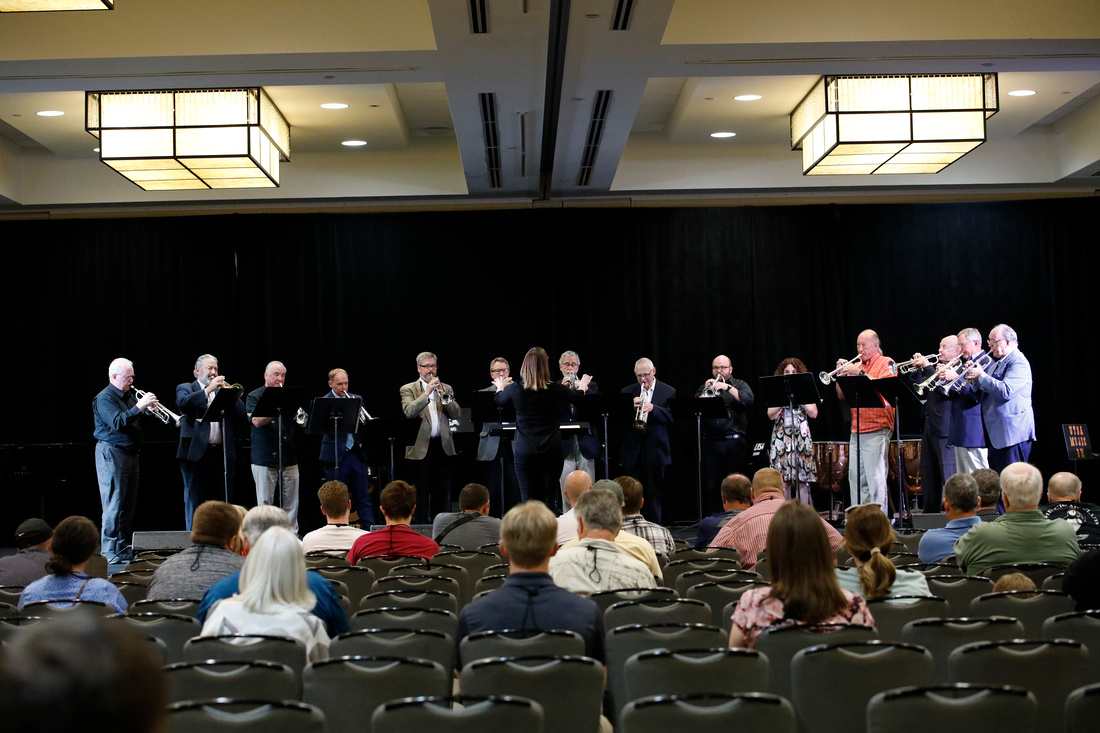
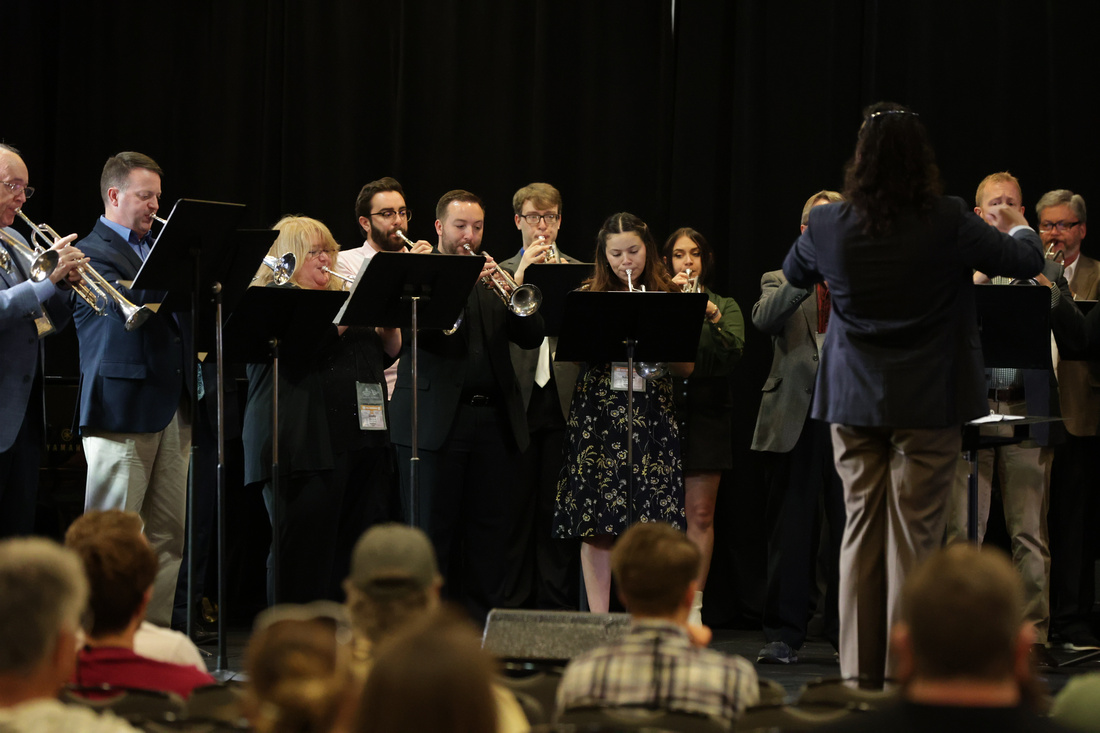
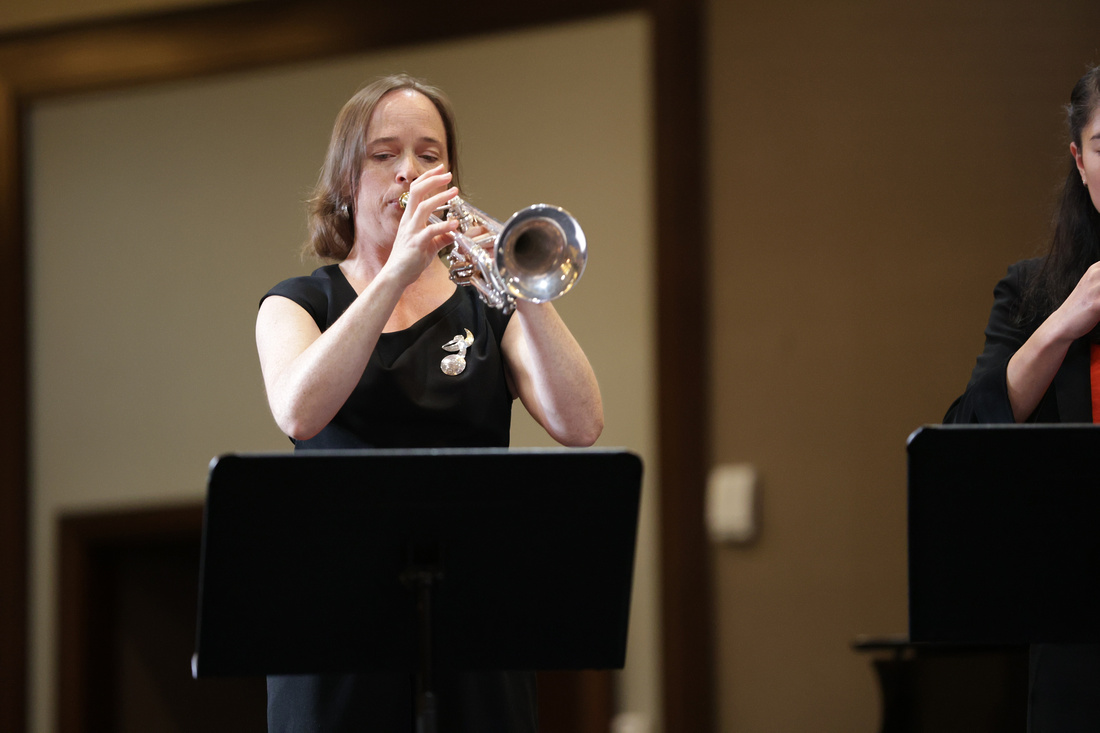
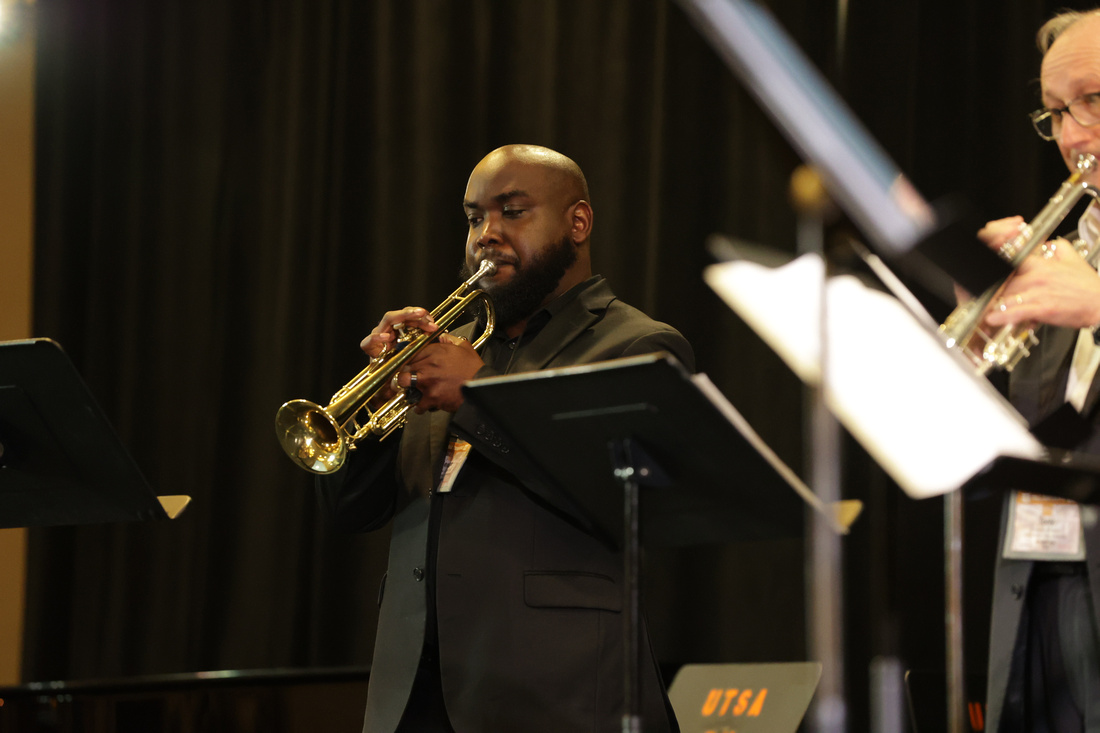

The youngest group to perform in the Festival of Trumpets concert deftly played their way through Stephen Lias’s Ebulliance, a lighter trumpet ensemble work with mixed-meter sections throughout. The ensemble, conducted by Dr. Aaron Witek, the Festival of Trumpets coordinator, superbly represented the future of the Guild. Next, James Olcott conducted one of his own transcriptions of J.S. Bach’s Sonata from Cantata 31. Accompanied by timpani, this piece was reminiscent of Altenburg’s Concerto for Seven Trumpets or Handel’s Water Music. The group that followed, made up of all CCM graduates, performed two world premieres by Martin Hebel. Led by Skye van Duuren, the ensemble filled the Ballroom with their brilliant sound in tribute to the legacy of their recently retired professor, Alan Siebert. The non-pro and comeback players ensemble who performed after them chose an intriguing piece entitled Undercurrents. This premiere, conducted by Seretta Hart, was played by a total of 17 players. The finale for the afternoon’s concert, an exciting arrangement of Richard Wagner’s Opening to Act III of Lohengrin, showcased the talents of the combined trumpet ensembles on stage simultaneously. This mass trumpet ensemble was a perfect conclusion to this traditional Festival of Trumpets concert, leaving all in attendance with a great sense of energy and excitement. (Eli Denecke)

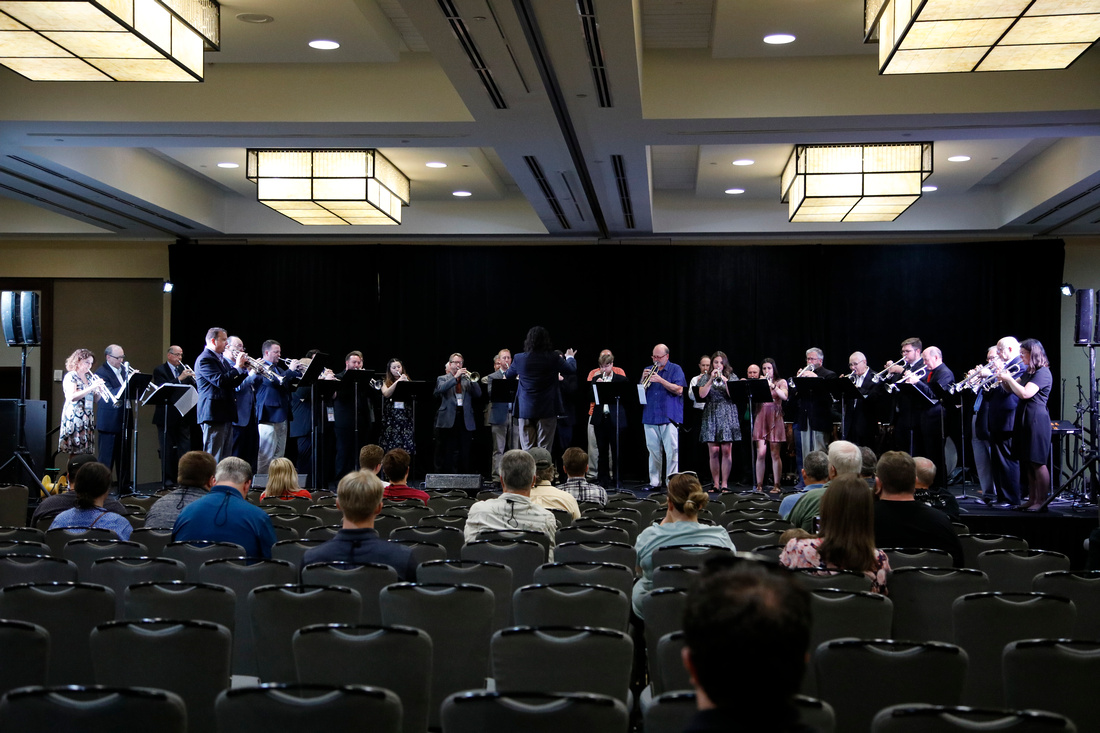
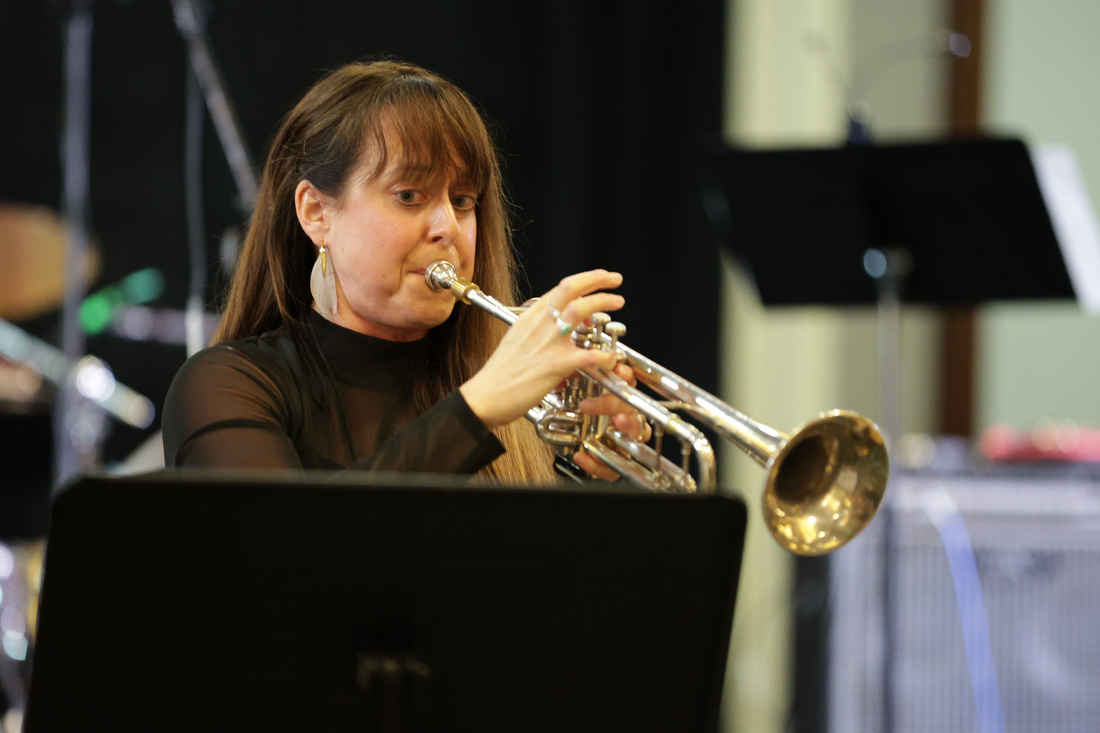
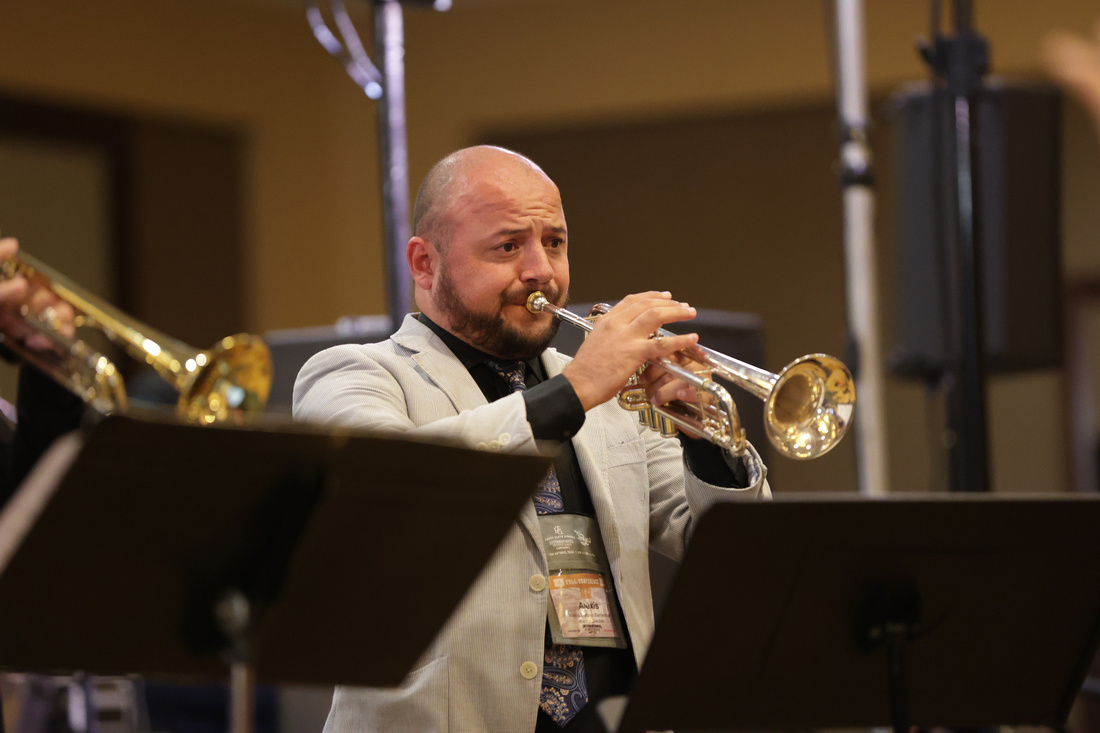 Student Meet and Greet reception
Student Meet and Greet reception
In one of the final events of the conference, students from all over the world enjoyed a reception sponsored by Grant Manhart and Monster Oil. There was an excellent turnout of students of all ages who enjoyed pizza and nachos as they met members of the ITG board, musical artists, and other students. Accomplished soloist Paul Merkelo shared advice with the group regarding the importance of reaching out for help and taking breaks when necessary. Sponsors including Gapper, S-Mute, Gilded Music, Brass for Beginners, Asper Trumpet Products, and more provided several exciting prizes that were awarded to the winners of the student raffle. This event encouraged future generations of trumpet players to build connections with one another and expand the ever-growing ITG family. (Sarah Cisney)

Closing concert: Ole Edvard Antonsen and Jens Lindemann
The closing concert began with the world premiere of ITG’s recent commission for trumpet ensemble, Gwyneth Walker’s three-movement When the Trumpets Sound, performed by Alexis Morales Barrientos, Jennifer Dearden, George Carpten, Christopher Moore, Oscar Passley, Sarah Stoneback, Mary Thornton, and Brian Walker, with Susan Slaughter conducting. The opening movement is in a rhythmic fanfare style. The middle movement uses undulating plunger mute techniques to support the melodic lines that featured Sarah Stoneback and Brian Walker on flugelhorn. In the unique and very catchy final movement, the ensemble was divided into two choirs with a fair amount of call-and-response in a swing style.
ITG Past President Grant Peters presented Treasurer Dixie Burress with a plaque, recognizing her many years of exemplary service to ITG. Dixie is retiring this summer, and she will certainly be missed by all!
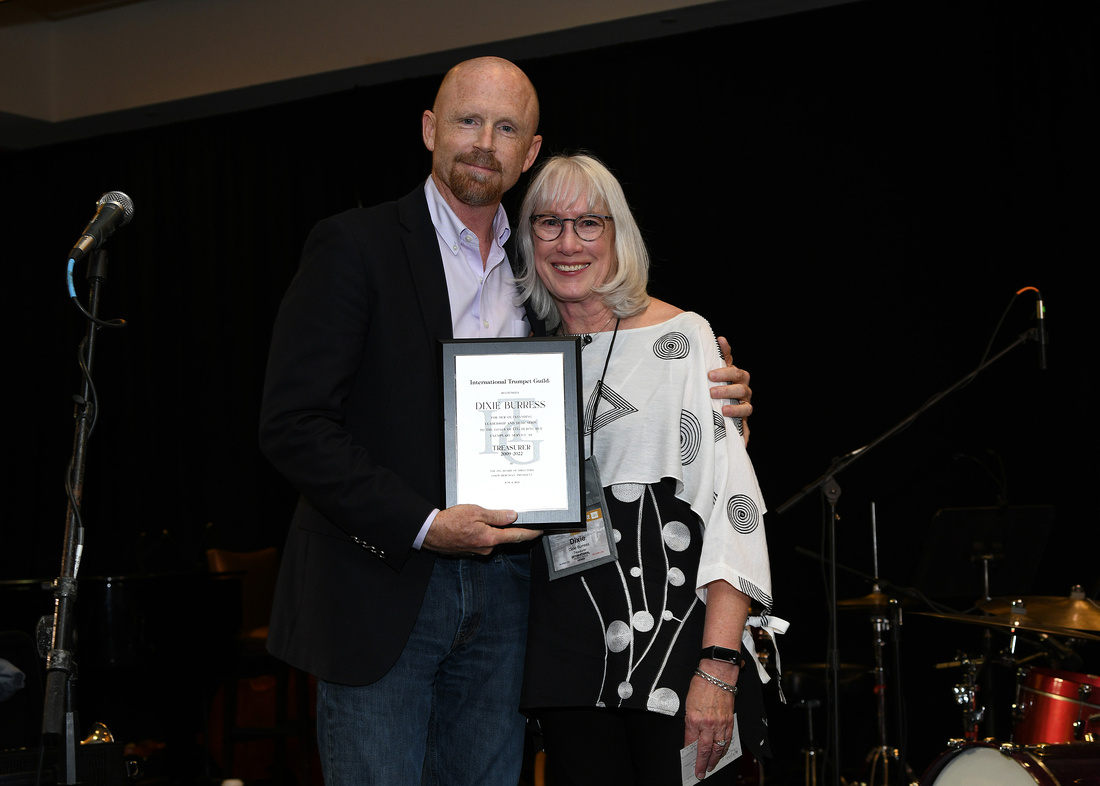 Those who expected Ole Edvard Antonsen to pull from his extensive catalog of classical repertoire were in for a surprise. Antonsen and his band of keyboardist, bassist, and drummer programmed pieces from his Landscapes album, along with works from a new project, Aurora, some of which had yet to be titled. The works ranged from what is commonly termed “ambient/mood” music, to rock and funk, pop ballad, and even a touch of Celtic jig and Caribbean funk. Antonsen and his keyboardist employed a variety of processing and effects to weave together fascinating textures. Antonsen’s impeccable playing and charming stage deportment were enthusiastically received by the audience at every turn.
Those who expected Ole Edvard Antonsen to pull from his extensive catalog of classical repertoire were in for a surprise. Antonsen and his band of keyboardist, bassist, and drummer programmed pieces from his Landscapes album, along with works from a new project, Aurora, some of which had yet to be titled. The works ranged from what is commonly termed “ambient/mood” music, to rock and funk, pop ballad, and even a touch of Celtic jig and Caribbean funk. Antonsen and his keyboardist employed a variety of processing and effects to weave together fascinating textures. Antonsen’s impeccable playing and charming stage deportment were enthusiastically received by the audience at every turn.
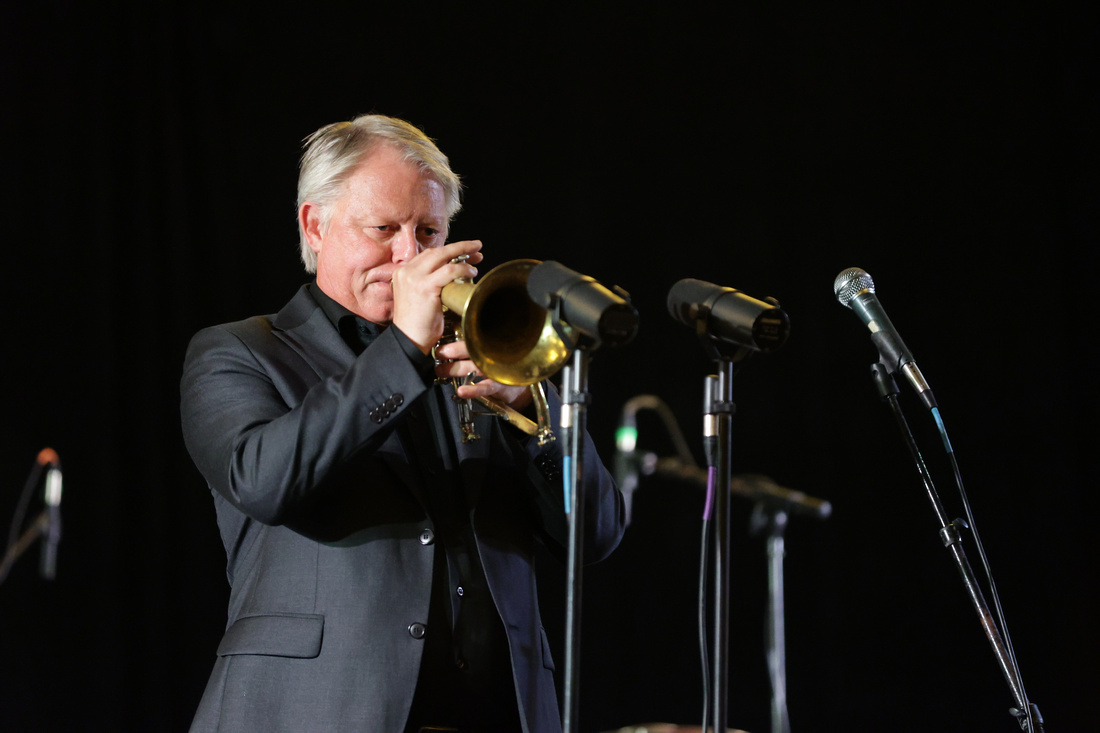
The second half of the concert featured Jens Lindemann and the ITG All-Star Big Band, opening with Well, Git It and a brief but exciting battle between Lindemann and Joey Tartell on lead. Mark Gould joined Lindemann in a duo rendition of The Nearness of You. Lindemann informed the audience that since Tanya Darby was unable to attend, they were left “with sixteen minutes to fill.” He filled the slot in high style with a recently completed big band version of Rhapsody in Blue, featuring pianist Mark Alexander. This version is in the tradition of the Paul Whiteman arrangement, but “updated for modern sensibilities” and putting Lindemann and his trusty piccolo trumpet in the hot seat from the opening glissando to the final shout.
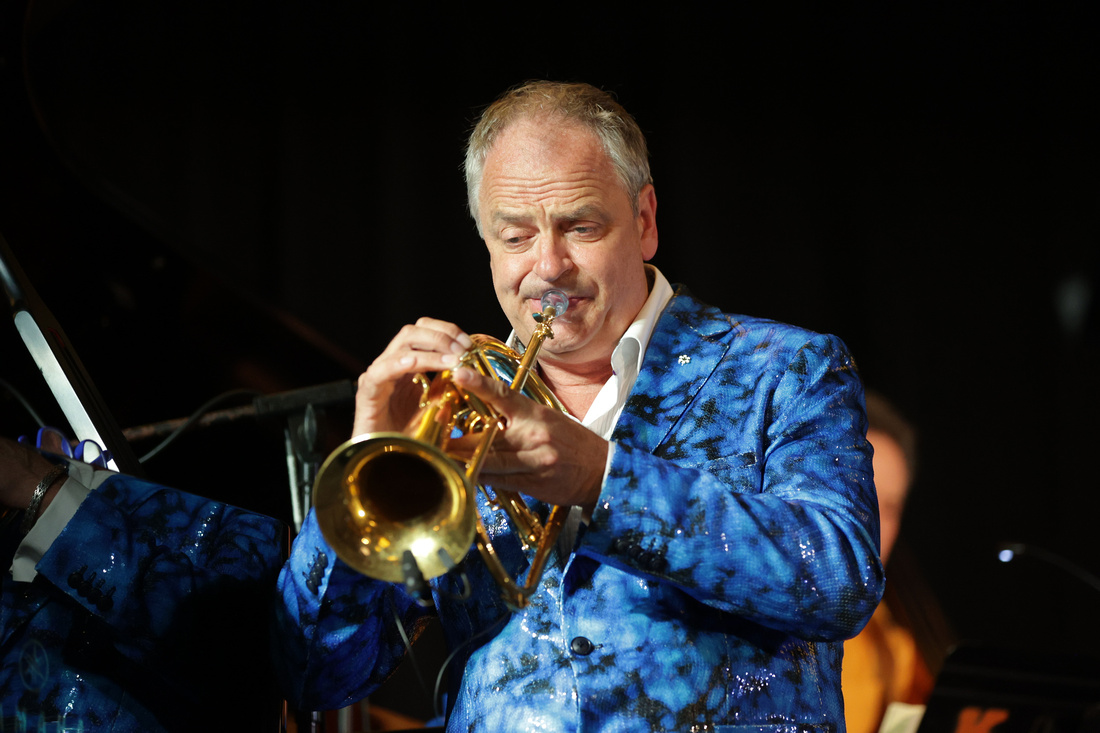
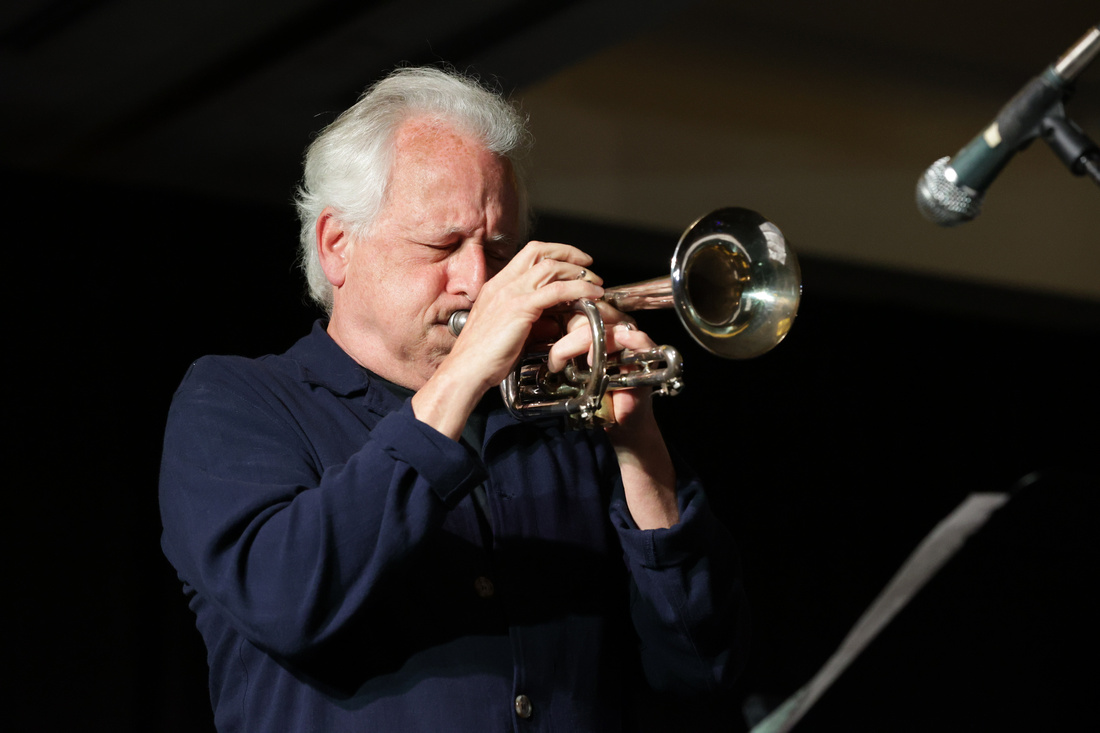 Mark Alexander and the ensemble may have put this piece together on “barely a rehearsal,” but it was a true show-stopper. Lindemann joined the section of Tartell, Oscar Passley, and Greg Powell for a trumpet battle royale in A Night in Tunisia before closing with Oscar Peterson’s Hymn to Freedom, dedicated to Ryan Anthony. The driving groove of this gospel shuffle arrangement and pyrotechnics from Lindemann and Tartell were the perfect conclusion to another great ITG Conference! (Daniel Kelly)
Mark Alexander and the ensemble may have put this piece together on “barely a rehearsal,” but it was a true show-stopper. Lindemann joined the section of Tartell, Oscar Passley, and Greg Powell for a trumpet battle royale in A Night in Tunisia before closing with Oscar Peterson’s Hymn to Freedom, dedicated to Ryan Anthony. The driving groove of this gospel shuffle arrangement and pyrotechnics from Lindemann and Tartell were the perfect conclusion to another great ITG Conference! (Daniel Kelly)
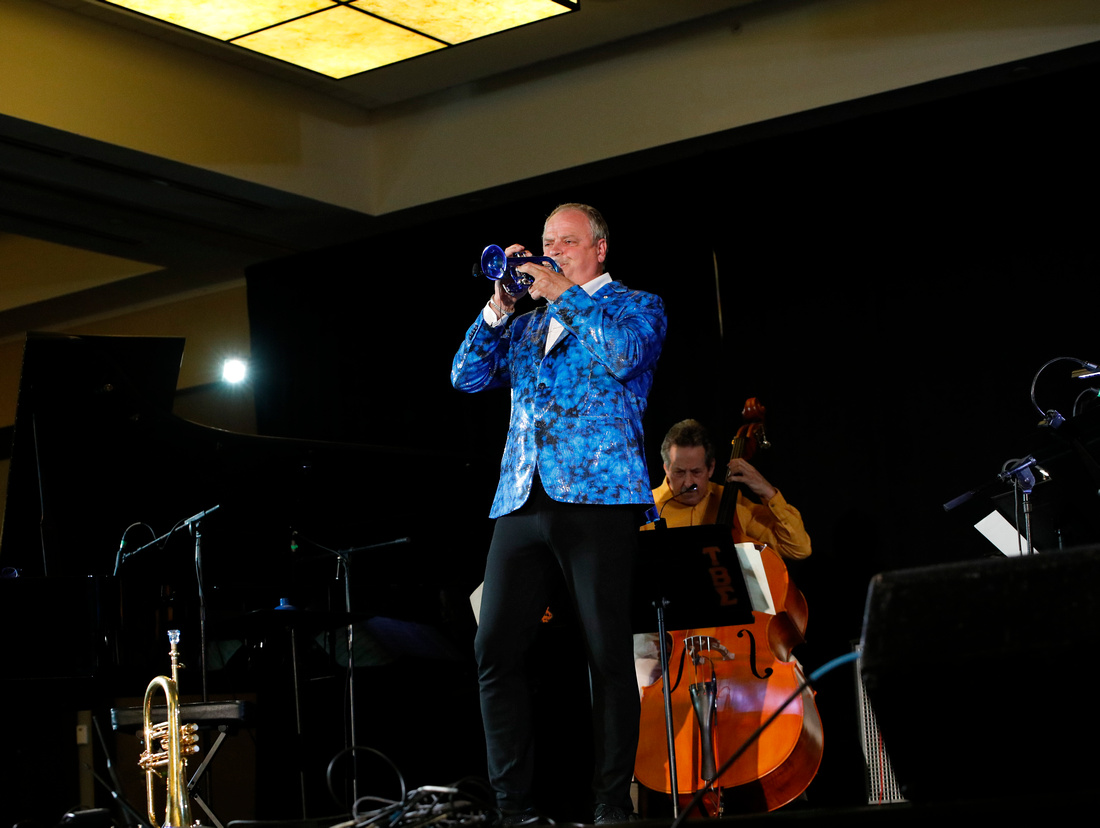
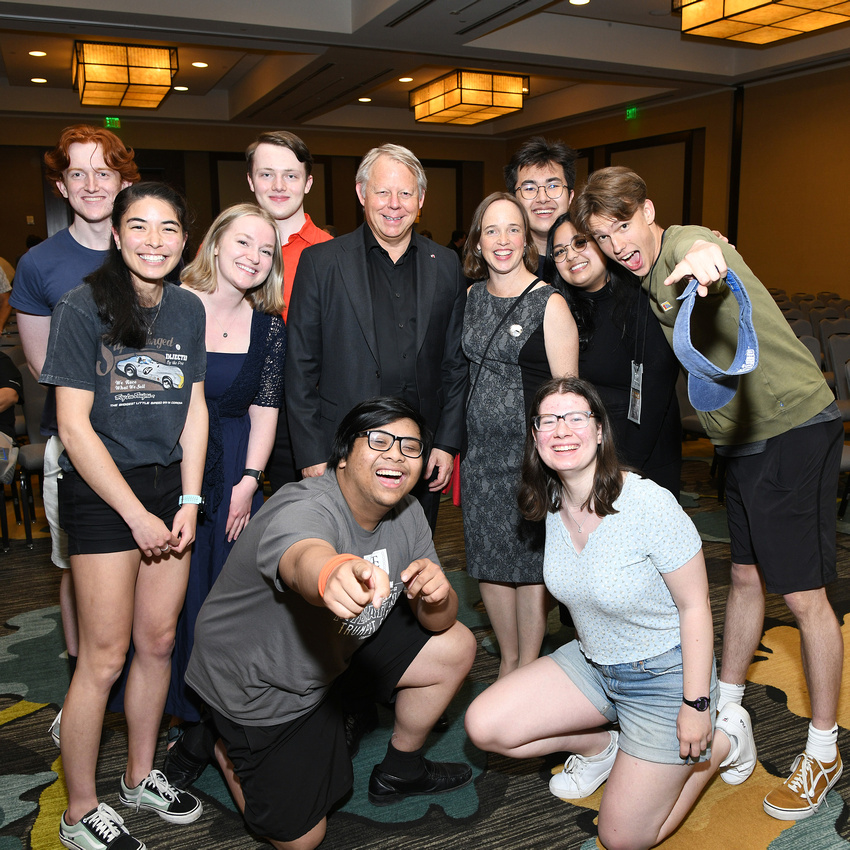
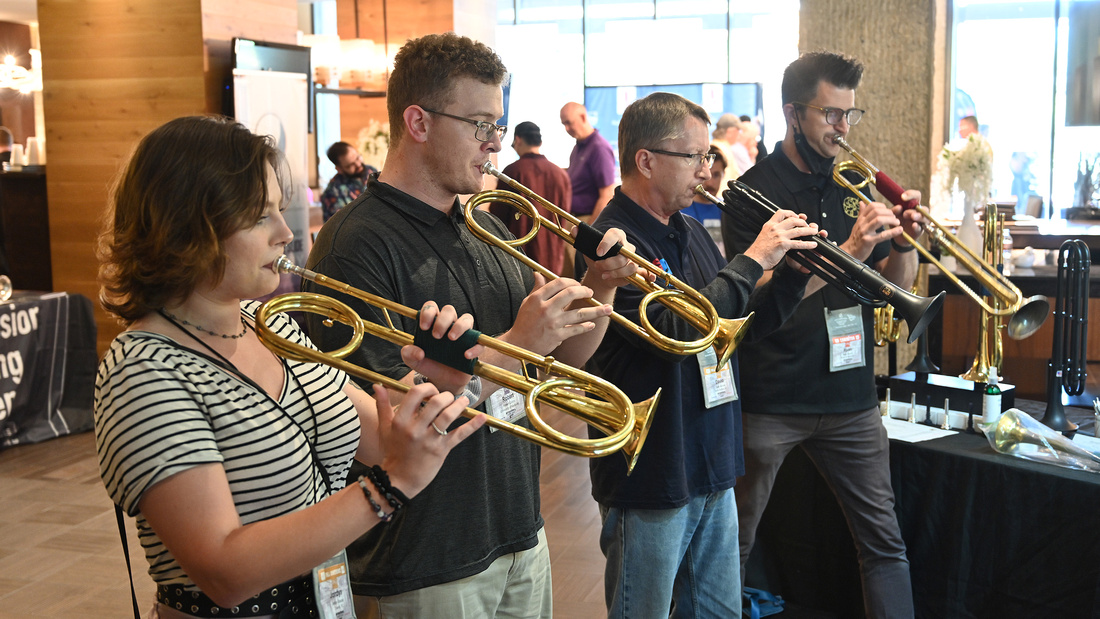
Click here for more photos from the ITG Conference
]]>
Special Daily Report • Compiled by Peter Wood
Photos by Denny Schreffler, Josh Rzepka, Benjamin Lowe, Ryan Berndt, Jeff Grass, and Michael Anderson
Friday, June 3, 2022
Click here for more photos from the ITG Conference
Alexis Morales warm-up session - Body, Air, Mind, and Trumpet
Costa Rican soloist Alexis Morales opened his session by stressing the importance of a daily warmup. He has studied and tried many different types and has developed his own routine that addresses preparing the mind, air, and body for his trumpet needs. Morales got the participants on their feet and led them through a series of fun stretches before transitioning to some breath exercises. To calm the mind, he led the group through a meditation practice in which the participants were to breathe in fresh air throughout the body. Morales feels one of the best ways to start your day is by clearing your mind so you are better focused on music making. Next, he showed the participants a buzzing exercise he learned from Reinhold Friedrich. Soft arpeggios that transitioned into the Stamp pattern on the horn were next with the group singing along with Morales’s demonstration. He explained that he then does some flexibility and articulation exercises, using examples from Arban. At the conclusion of the session, Morales stressed the importance of having fun while playing and that we need to realize how lucky we are to be musicians. (Rich Tirk)
Oswaldo Zapata student warm-up session - Creating Your Own Warm-up Routine
Dr. Oswaldo Zapata presented Friday morning's warm-up session with a friendly, inviting demeanor and shared great ideas and principles for creating one’s own warm-up routine. He discussed how a warmup should be something you can do well and prepares you for playing. Together with the audience, he demonstrated his pre-warmup of simple movements and stretches to get the body moving and the blood flowing. As he talked about different aspects of a warmup, he suggested not focusing on too many things at one time and said that he tries to think about an open sound and air that flows freely. When talking about articulation exercises, he recommended including various styles, especially those one may be using in performance (like mariachi or different jazz articulations, for example). The audience was attentive and engaged, and he demonstrated good, healthy principles in approaching fundamentals and excellent teaching. (Spencer Wallin)
Houston Symphony Trumpet Section clinic
In their early-morning Regency Ballroom performance, the Houston Symphony Orchestra trumpet section gave those in attendance a lesson in maintaining a healthy relationship dynamic within a trumpet section. The mutual respect among colleagues was evident in the group interaction as they joked with each other throughout their presentation. Mark Hughes, principal; John Parker, associate principal; Robert Walp, assistant principal; and Rich Harris, second trumpet more closely resembled a chamber ensemble than a traditional orchestra section, demonstrating excellent intonation, style, and balance. Although the group performed a few orchestral passages, they primarily played trumpet ensemble chamber pieces, including Mark Hughes’s four-trumpet arrangement of the first movement of the Altenburg Concerto. The program ranged from the sixteenth-century composer Costanzo Antegnati’s Canzona to Besáme Mucho, featuring John Parker, who performed with virtuosic distinction and a soloistic flare. Hughes took the opportunity to showcase his new line of practice mutes on the soft muted passages from Debussy’s Fêtes and Stravinsky’s Rite of Spring. For four players who typically perform seated in the back of the orchestra, they were incredibly comfortable standing on the front of the stage. In fact, they even performed a mariachi feature, complete with foot stomps. Moreover, the players conveyed a sense of comradery, being supportive, and helping each other to be healthy and happy - like a family. (Nick Volz)
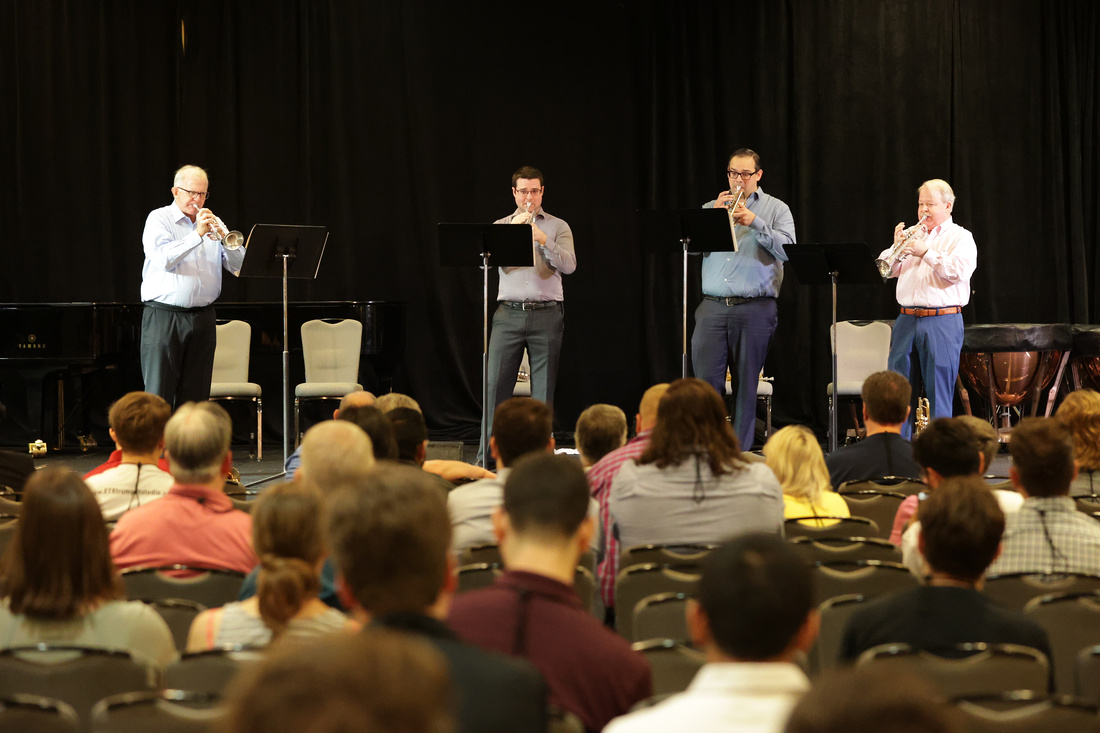
Stephen Wadsack clinic - College Audition Do’s and Don’ts: Finding Your Dream School and Making Sure You Get In!
Stephen Wadsack’s session provided helpful information about the college audition process, offering information for high school students, undergraduates, private teachers, and college professors. Wadsack discussed creating a short list of schools and listing the pros and cons of each, specific to the needs of each student. He also outlined the initial application process and how to contact potential trumpet professors. Wadsack emphasized the importance of staying organized throughout the preliminary steps to reduce stress later. He also discussed the nuts and bolts of selecting repertoire, preparing pieces, and performing a solid audition. Overall, the session was especially helpful for young students and parents and provided great reminders for current college students and professors. (Marisa Youngs)
Jennifer Oliverio clinic - British Brass Band Cornet Playing for the American Trumpeter
Jennifer Oliverio presented an informative session that explored the differences between playing cornet in the British brass band style and American trumpet playing. The presentation began with a brief introduction about the makeup and purposes of the brass band. Then, Oliverio showed both technical and lyrical brass band examples to compare and contrast qualities of cornet playing with American trumpet playing. The most notable differences identified between these two styles were the use and speed of vibrato, the variety in weight of articulations, and the color of the sound. Many resources, such as exercises to develop a characteristic sound and recommended brands for cornets were provided to participants. The session both educated and inspired trumpeters who wish to expand their skills into the world of cornet playing in the British brass band style. (Sarah Cisney)
Recital - New Romantic Recital Works for Trumpet
Stanley Friedman is well known for composing works using extended techniques. However, he has recently published outstanding works to fill the void of Romantic-style pieces in the trumpet repertoire. The first piece on the recital was Friedman’s Sonata in F Minor with Kyle Millsap on trumpet and Shane Anderson on piano. The three-movement work showcased the composer’s skill in writing lyrical and bold themes, and Millsap and Anderson navigated this tricky piece expertly. Next on the program were two of Friedman’s arrangements of the Charlier etudes. Performing numbers 2 and 12 were Phil Snedecor on trumpet and Carolyn True on piano. Musically fulfilling and well scored, Friedman’s arrangements bring something new and exciting to these favorites. Snedecor and True handily performed the etudes with excellent musicality and style. The final work on the program was Friedman’s Sonata in B Minor for Trumpet, Cello, and Piano, which was performed by Matthew Swihart, trumpet; Carrie Pierce, cello; and Shane Anderson, piano. This work, also in three movements, provides moments for all instruments to shine. Friedman’s dramatic music, full of glorious, lyrical melodies, was beautifully performed by Swihart and the ensemble. (Rich Tirk)

Ryan Nielsen and John McNeil clinic - Creative Jazz Improvisation: Returning Choice to the Practice Room
Dr. Ryan Nielsen and John McNeil presented a lecture on creative jazz improvisation. They shared a glimpse of a project they have been working on together for the last twelve years, with McNeil presenting virtually and Nielsen leading the lecture in person for a truly post-pandemic hybrid session. Nielsen opened the session by sharing the idea from McNeil that everyone learns in the same way - through repetition and exposure - and that you can keep students engaged by teaching them how to constantly make decisions while practicing. He had several different improvisational lines that the audience would sing with him and then play, and both Nielsen and McNeil shared great ideas on how to improvise. They will be publishing a book later this year. McNeil ended with the request that we all reconsider how we define a “lick” and that we strive to encourage musicians to find and share their own voice through creative improvisation. (Spencer Wallin)
Javian Brabham youth clinic - Building Confidence: Tools for Teachers and Students
Dr. Javian Brabham’s youth day clinic was inspiring for all in attendance, as his professional performing and teaching experience allows him to think outside the box to help students overcome negative self-perceptions in their playing. Among the ideas that Brabham discussed for teachers to help students gain confidence were the following: build their trust; give positive feedback; build on concepts the student already does well; set challenging, yet attainable, goals and help the student feel invested and accountable in their own process; be a mentor; have fun; celebrate the wins. In a particularly interesting segment of the presentation, Brabham showed a chart comparing the concepts of confidence and insecurity. To oversimplify, those with insecurities tend to focus inward, or on what the perception of themselves is to others, and often make comparisons to their peers. On the other hand, confident people tend to focus on the process of making music, are able to celebrate others’ successes, and can laugh at themselves or admit when they make mistakes. To close, Brabham encouraged teachers to maintain an active dialogue with their students to monitor their self-doubt and work on changing the narrative from negative to positive. He encouraged students to take control of their confidence by working to ignore negative self-talk, build on the things they do well, and believe that good things can happen. (Joe Nibley)

Navy Commodores Trumpet Section clinic - The Inside Workings of a Big Band Trumpet Section
The Navy Commodores Trumpet Section presented a thorough and informative session about playing in a big band trumpet section. After brief introductions, the section took the audience through various excerpts that represented a broad overview of the general styles they cover in their work. The excerpts they chose came from Duke Ellington’s Jack the Bear, Count Basie’s Kansas City Shout, Thad Jones’s Three in One, Stan Kenton’s Peanut Vendor, Hank Levy’s Decoupage, and Maria Schneider’s arrangement of The Days of Wine and Roses. Between the excerpts, they each took time to answer questions from the audience and also discussed common pitfalls to avoid when playing in a big band section. Special attention was given to mute choices, the importance of listening to recordings for style, balance regarding inner parts, and overall section decorum. By the end of the session, it was clear that all benefited from the expertise of this fantastic trumpet section. (George Carpten)
ITG Affiliate Chapters Recital
The Affiliate Chapters Showcase recital featured trumpet ensembles representing ITG affiliate chapters from all over the country. The Alabama Trumpet Guild performed Wilson’s The City Under the Sea with impressive dynamic extremes, blending in the soft dynamics with ease. Their piece prominently featured each group member and allowed them to make a strong musical statement. The Lone Star State Trumpet Guild’s performance of “Arabian Dance” from Peer Gynt Suite featured trumpet ensemble with percussion, including tambourine and triangle. The variety of trumpets used, from piccolo to flugelhorn, contributed to a rich texture and seamlessly blended group sound. The Louisiana State University Trumpet Guild’s beautiful rendition of It is Well showcased their delicate and musical lyrical playing. The Oklahoma State University Trumpet Guild performed an arrangement from Berlioz’s Symphonie Fantastique and truly gave an energetic and engaging performance with exciting dynamic contrasts. The Texas A&M International University Trumpet Guild’s performance of Stephenson’s Fanfare for an Angel featured just four performers, but the conviction and energy with which they performed made them sound like a much larger group. The Texas A&M University-Commerce Trumpet Guild performed Mike D’Ambrosio’s Ice Town, featuring beautiful solo lines and great contrast in timbres, using mutes and stands to create a variety of tone colors throughout the engaging performance. The Texas A&M University-Kingsville Trumpet Guild’s performance of Nutcracker Jazz Suite was full of energy and excitement, featuring jazz and lead playing. The program concluded with the Utah Trumpet Guild’s performance of a well-known pop song, Symphony by Clean Bandit. Their beautiful group sound, strong arrangement, and tonal variations through mutes made for a captivating performance. (Julia Bell)
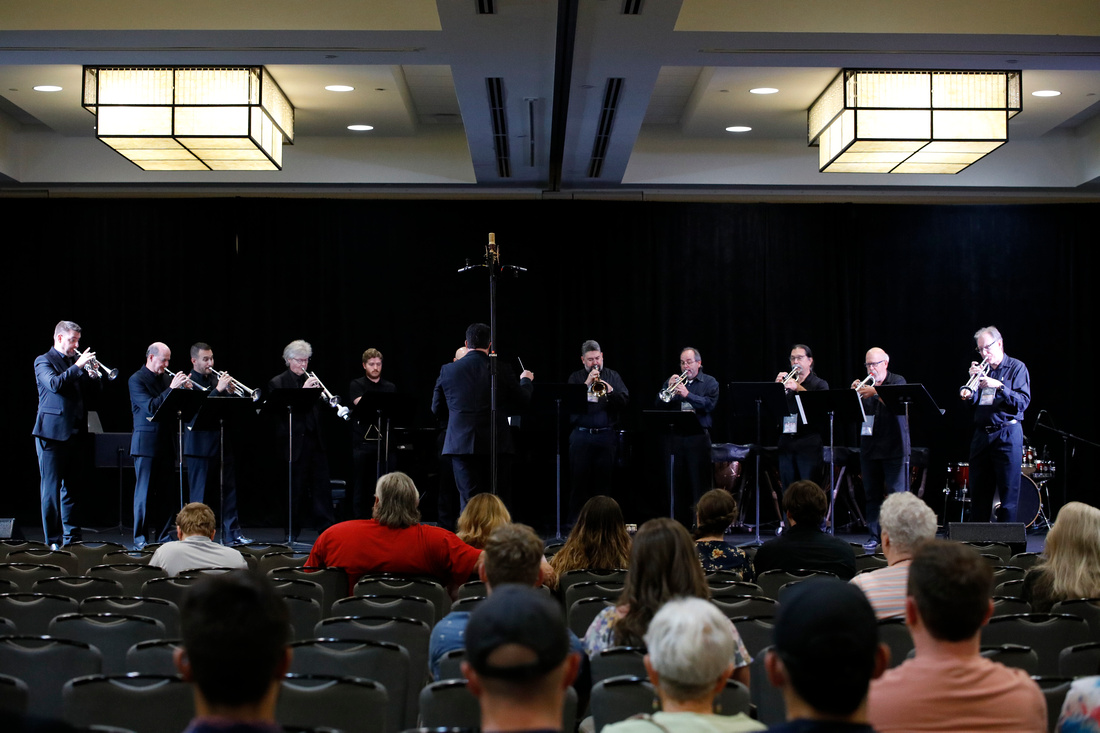

Adam Hayes youth clinic - Developing an Independent Professional Music Career
Adam Hayes presented a thoughtful session on developing an independent professional music career. He discussed potential scenarios that young freelancing musicians will likely encounter and shared many personal anecdotes from his own experience. Hayes warned against several common pitfalls, especially regarding professional behavior and career planning. He offered suggestions in a variety of areas, including reasons for contractors and teachers to form an LLC (limited liability company), as well as to partner with a church or school to find a regular practice space when living somewhere you are unable to practice. He gave long lists of things to do and don’t do on a gig with the intention of helping young musicians become more sensitive to some of the situational subtleties of our unique workplace. Although the presentation was geared toward college students and performers seeking to launch their careers, it also shared practical advice that is relevant for every working musician. (Nick Volz)
Edward Carroll clinic - Demystifying International Competitions
Edward Carroll hosted a clinic that set out to deconstruct the nature of international competitions. Joining him was a panel of players involved in such competitions, including Jason Bergman, Dominique Bodart, Stephen Burns, David Collins, and Aleksander Kobus. Each of the panel members have either hosted, judged, or won international solo competitions. Together, they provided the audience with an understanding of these high-prestige competitions from the perspective of both competitor and jury. The overarching point presented by Carroll was that “Competitions are ridiculous.” This argument was supported by the testimony of the panel, who emphasized that the lessons learned in preparation for and the connections made at the competition are just as important, if not more, than the results. Kobus walked the audience through his routine preparing for the most recent Ellsworth Smith International Trumpet Competition, in which he won the first prize, and Carroll and Bodart explained the scoring system. (Christopher Luebke-Brown)
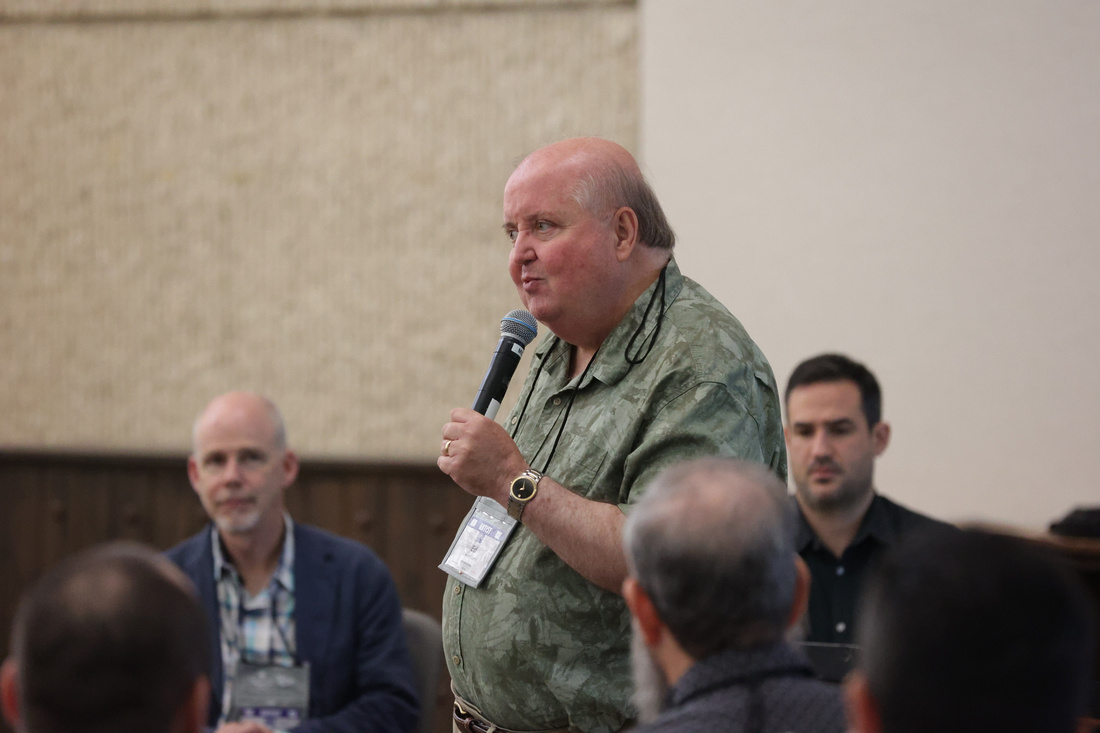
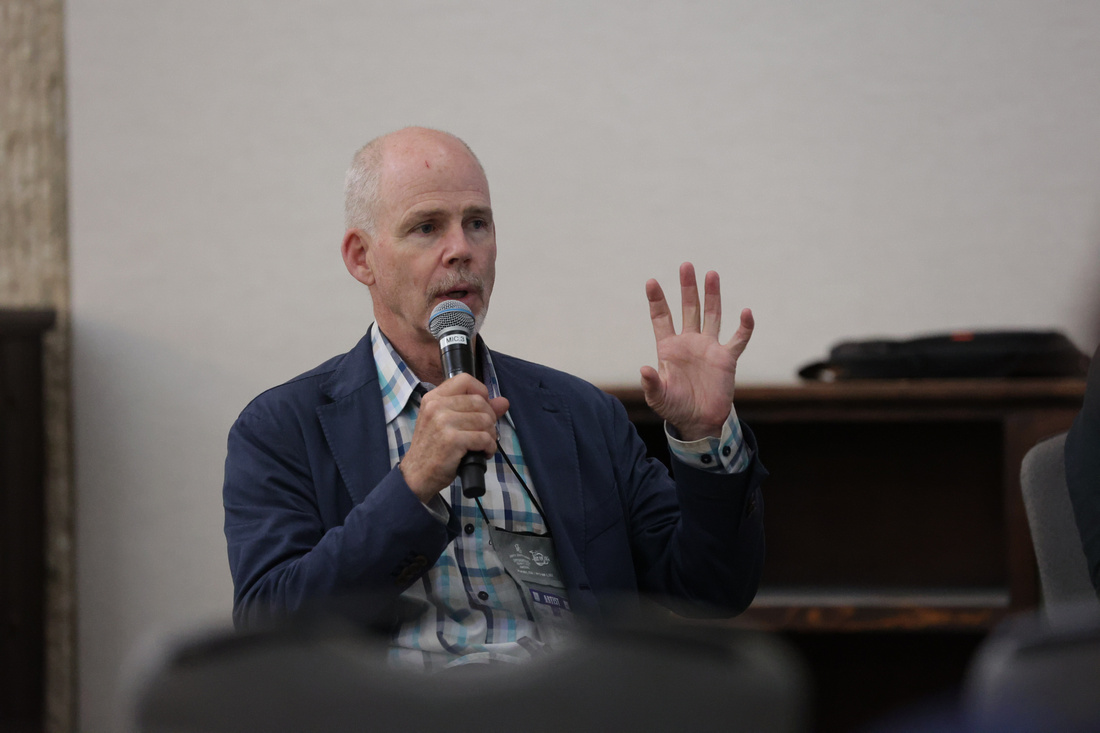
Matthew Vangjel recital - Still and Quiet Places
Matthew Vangjel opened his recital with an intriguing work for trumpet and electronics. The piece, Under Oceans, Outer Space, Across the Geothermal Pools, and Plains by Samara Rice, set the tone for the rest of the performance - somber, reflective, and introspective. Next, a moving arrangement of Gustav Mahler’s Kindertotenlieder hit home when Dr. Vangjel reflected on the recent, tragic school shooting in nearby Uvalde, Texas. His ringing tone and sensitivity to blend with pianist Siying He proved to be a touching experience for all in attendance. The recital concluded with two pieces accompanied by Joshua Knight on marimba and vibraphone. Overall, this performance crackled with emotional charge from Vangjel’s diverse and poignant program. (Eli Denecke)
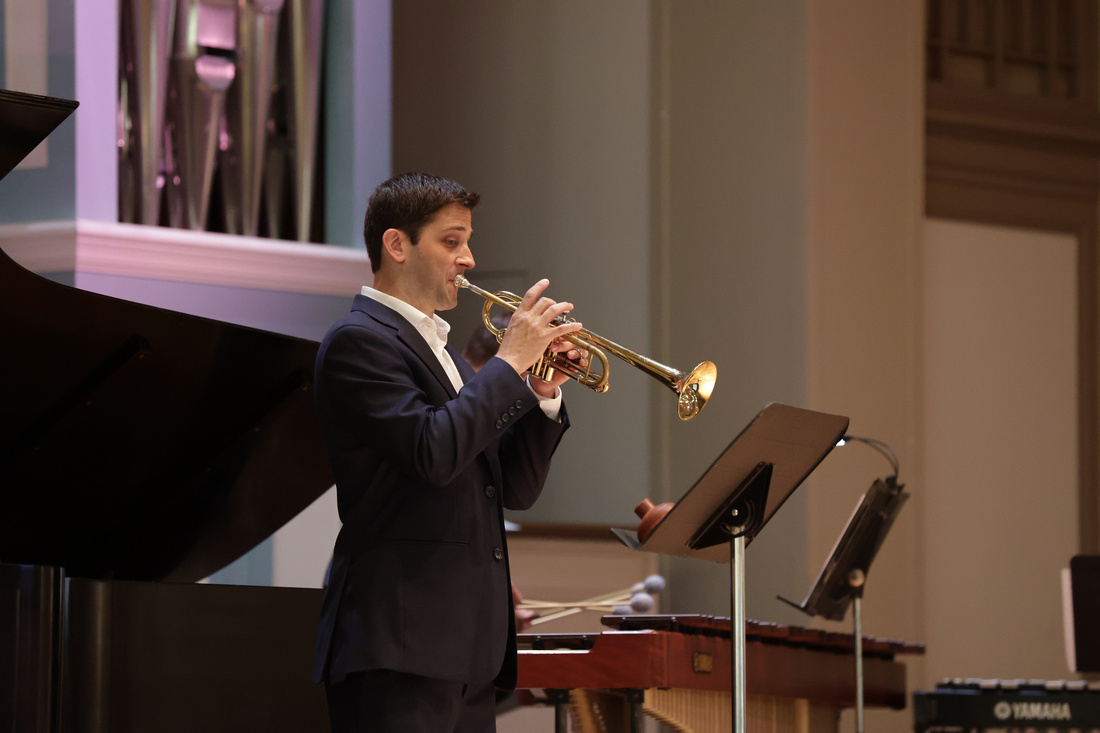
Friedemann Immer and Kentucky Baroque Trumpets recital
Friedemann Immer and the Kentucky Baroque Trumpets presented a varied and virtuosic recital of music for Baroque trumpet at Travis Park Church. Joined by Bryan Anderson on the organ and Paul Millette on timpani, Immer and the Kentucky Baroque Trumpets performed with the full spectrum of colors for the instrument. The entire church sanctuary was used for this event, with performers strategically placed throughout the room and in the balcony for several works. The spirit of collaboration was strong throughout the performance, and the members of the Kentucky Baroque Trumpets rotated in their roles as soloist or supporting ensemble member. The majority of the program consisted of Baroque-era works, but the last two pieces were more contemporary. Benjamin Britten’s Fanfare for St. Edmundsbury included Immer assuming the role of conductor for the final climactic portion, and the audience enjoyed the light-hearted and charming Rag Rog by Klaus Hanes Osterloh. (Benjamin Hay)

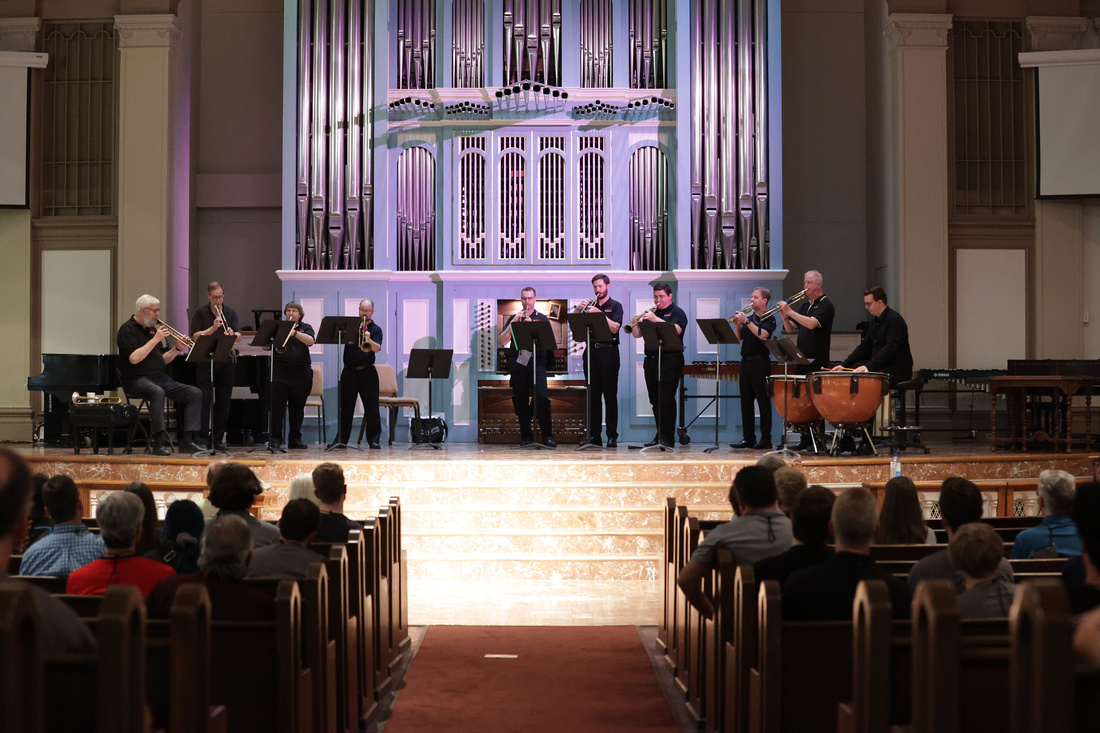
Carole Dawn Reinhart and Wendy Matthews clinic - “I met a girl”
This live interview began with a lovely showcase video consisting of videos and pictures of Carole Dawn Reinhart throughout her career. The interviewer, Wendy Matthews, proceeded to ask Reinhart about her education and many great accomplishments. The session included multiple ear-catching recordings of Reinhart’s virtuosic performances. The audience left full of inspiration, thanks to Reinhart’s pure talent and the strong influence she has made as an exceptional female trumpet player. (Maryna Pohlman)
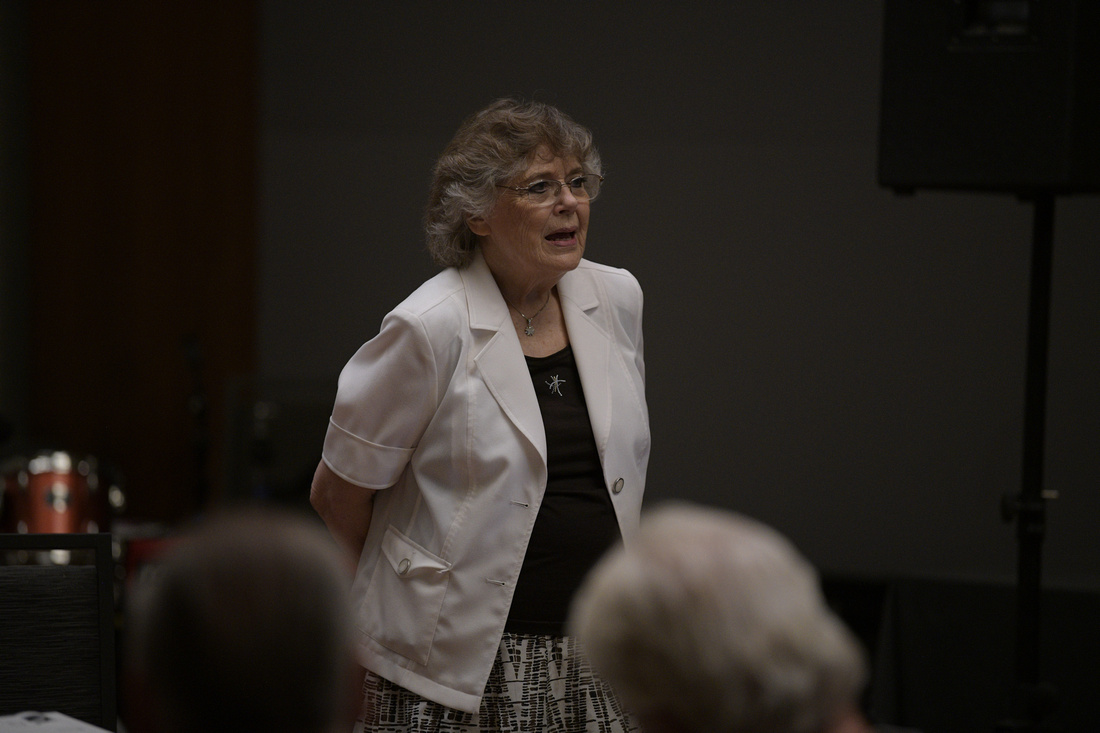
ITG Legacy Fund Reception
The Legacy Fund Reception was an event for ITG members to meet and mingle with ITG board members, past presidents, and other members. Free drinks and light appetizers were served, and members learned more about the importance of the ITG Legacy Fund, which is currently a $100,000 endowment that will continue to support the guild’s initiatives, projects, and programs. Many of the ITG past presidents spoke about how important the ITG was to them personally and professionally, and they encouraged members to donate to the Legacy Fund to continue to grow the organization for the future. The following presidents all spoke - Alan Siebert, Bill Pfund, Marsha Whitaker (spouse of the late Don Whitaker), David Hickman, Kim Dunnick, Jeff Piper, Jim Olcott, Vince DiMartino, Brian Evans, Leonard Candelaria, Kevin Eisensmith, Grant Peters, and Jason Bergman. (Scott Hagarty)
Evening concert - US Navy Band Commodores featuring Philip Dizack and Rachel Therrien
The Friday evening concert began with ITG Vice President Ryan Gardner honoring Wiff Rudd, professor of trumpet at Baylor University, with the ITG Award of Merit for his relentless dedication to teaching and fostering trumpet education. After the presentation, the United States Navy Commodores took the stage with a pleasantly varied program. They opened with Kenny Garrett’s For Openers, featuring burning solos by MUC Jonathan Barnes and MUC Andrew Francisco.

The next few tunes showed off the band’s trumpet section. Frank Foster’s Discommotion highlighted the trumpets in a swinging soli, while the rhythm section worked to capture the essence of the Basie groove. MU1 Benjamin Ford also wowed the crowd with his dexterous upper-register work on his trombone solo. Going a little more modern, the next tune was an arrangement of Wayne Shorter’s Hammerhead, led by the rhythm section’s hard swing feel. The performance featured many solos, including a battle between MU1 Allie Albrecht and Barnes. Albrecht showed off her incrdibly strong bebop chops while Barnes supplied the pyrotechnics.
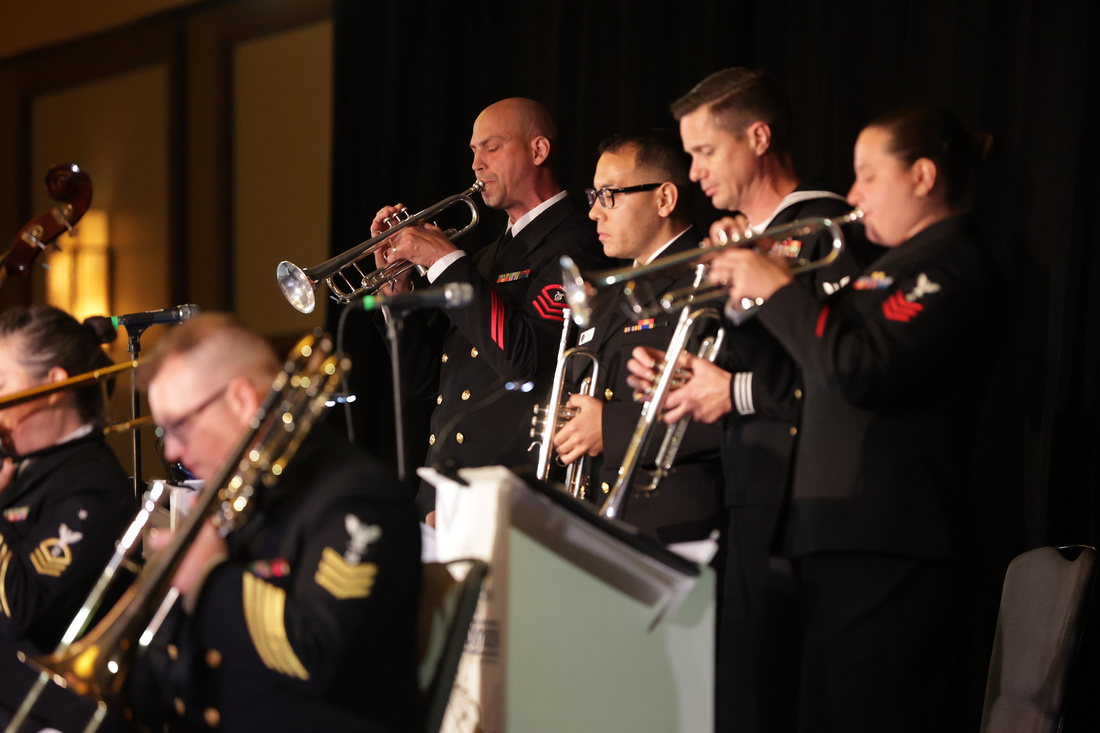
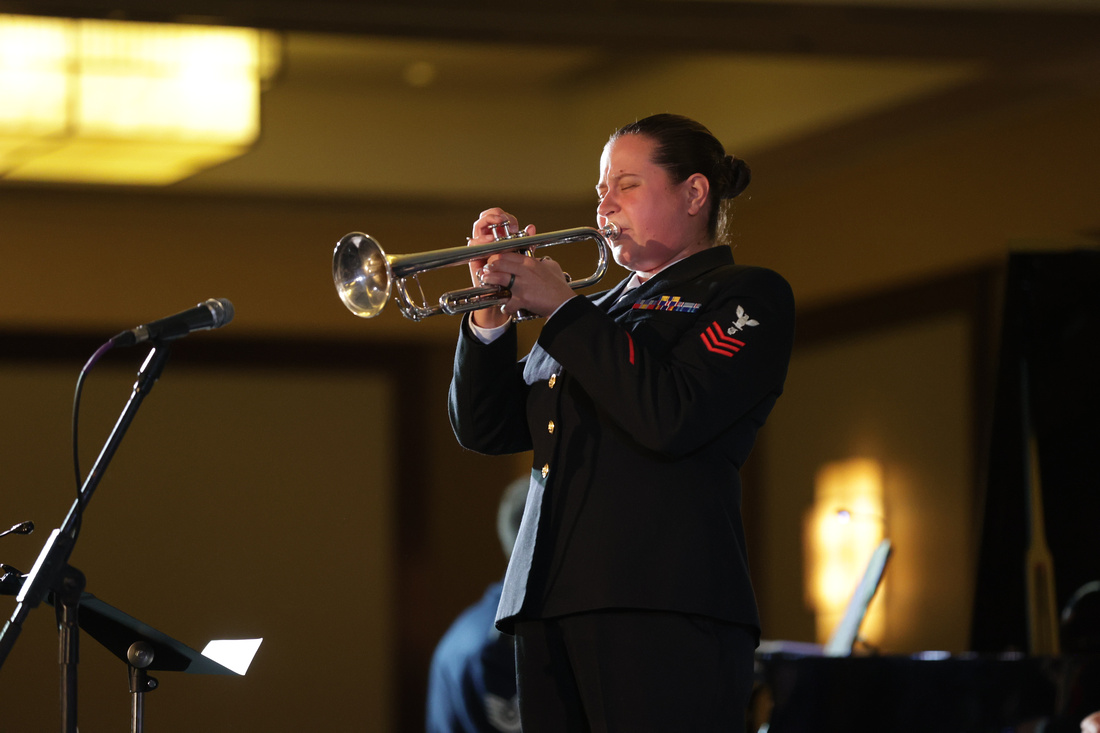
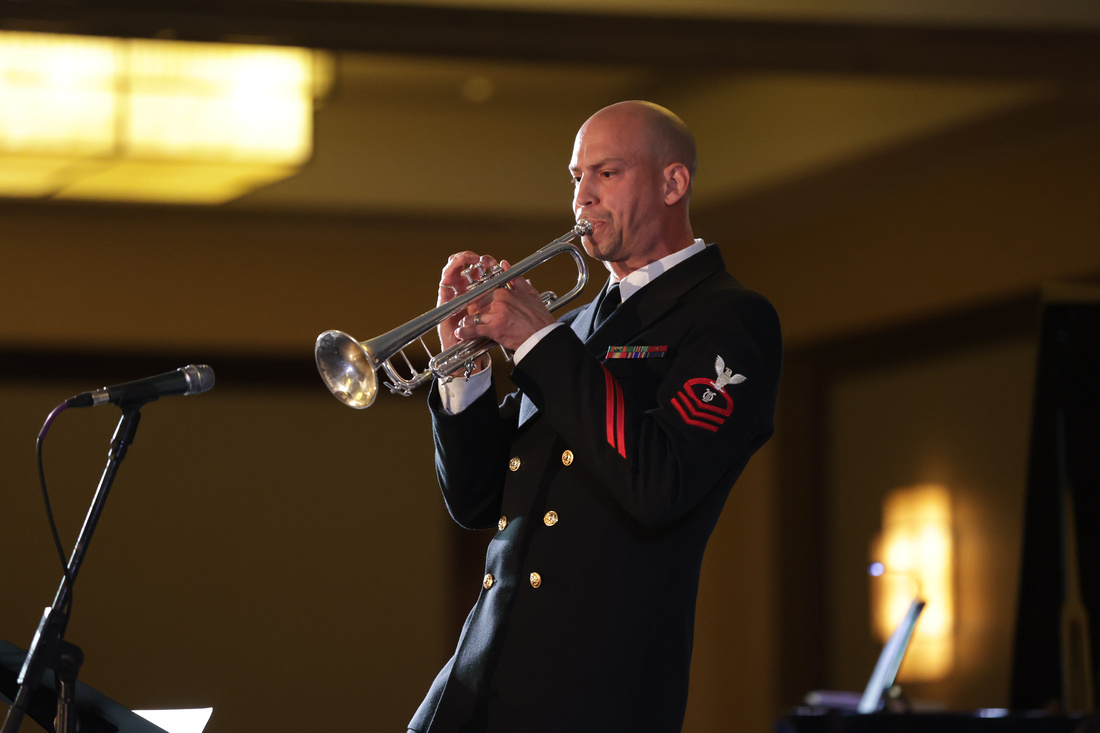 The Commodores’ vocalist, MU1 Kristine Hsia, joined the band for the next two numbers, Everyday I Have the Blues and The Song is You. Hsia had a great sense of styling, and the whole band really found the groove, digging into the swing. The band closed their portion of the concert with the Oliver Nelson standard Miss Fine. They had a great feel for the tune and really showed off extreme dynamics.
The Commodores’ vocalist, MU1 Kristine Hsia, joined the band for the next two numbers, Everyday I Have the Blues and The Song is You. Hsia had a great sense of styling, and the whole band really found the groove, digging into the swing. The band closed their portion of the concert with the Oliver Nelson standard Miss Fine. They had a great feel for the tune and really showed off extreme dynamics.
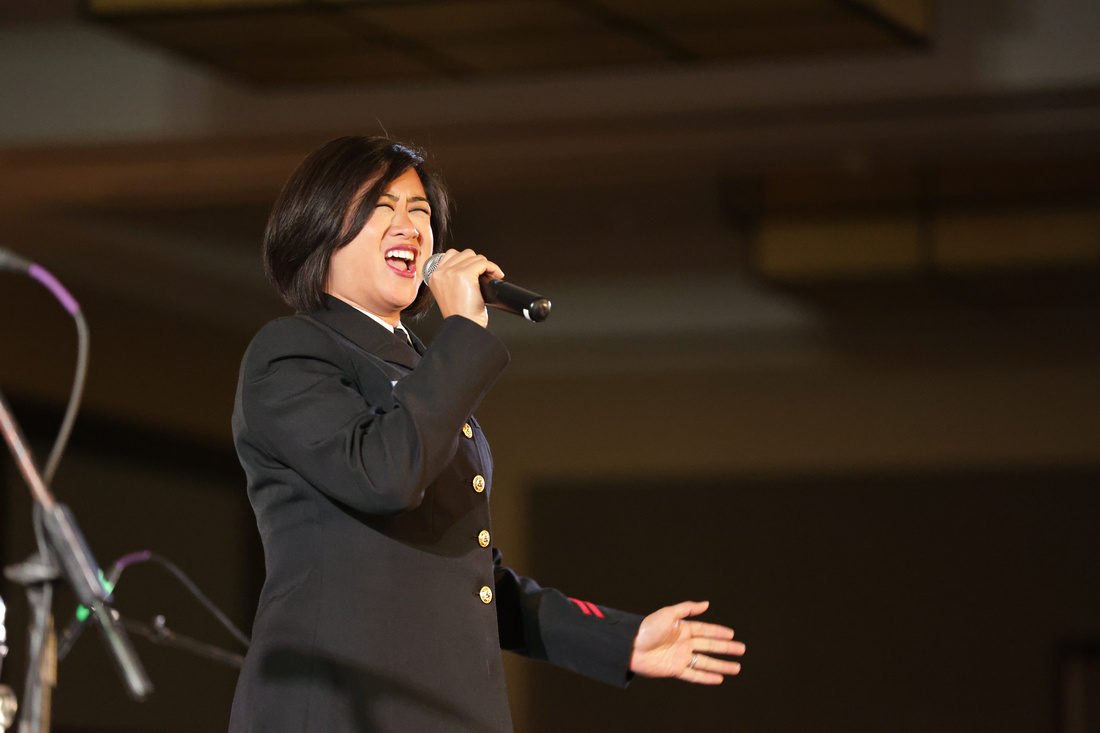
While the Commodores’ set was largely traditional jazz tunes, that changed when guest artists Philip Dizack and Rachel Therrien came out. Along with his touring and recording schedule, Dizack is assistant professor of trumpet at the University of North Texas. He played one of his original compositions, Box Office, with the band. Dizack’s soloing style was extremely melodic and fluid, with an ease that really drew in the audience. His use of quarter tones and dense harmonies brought a modernness to the night that stood in contrast to the first part of the concert.
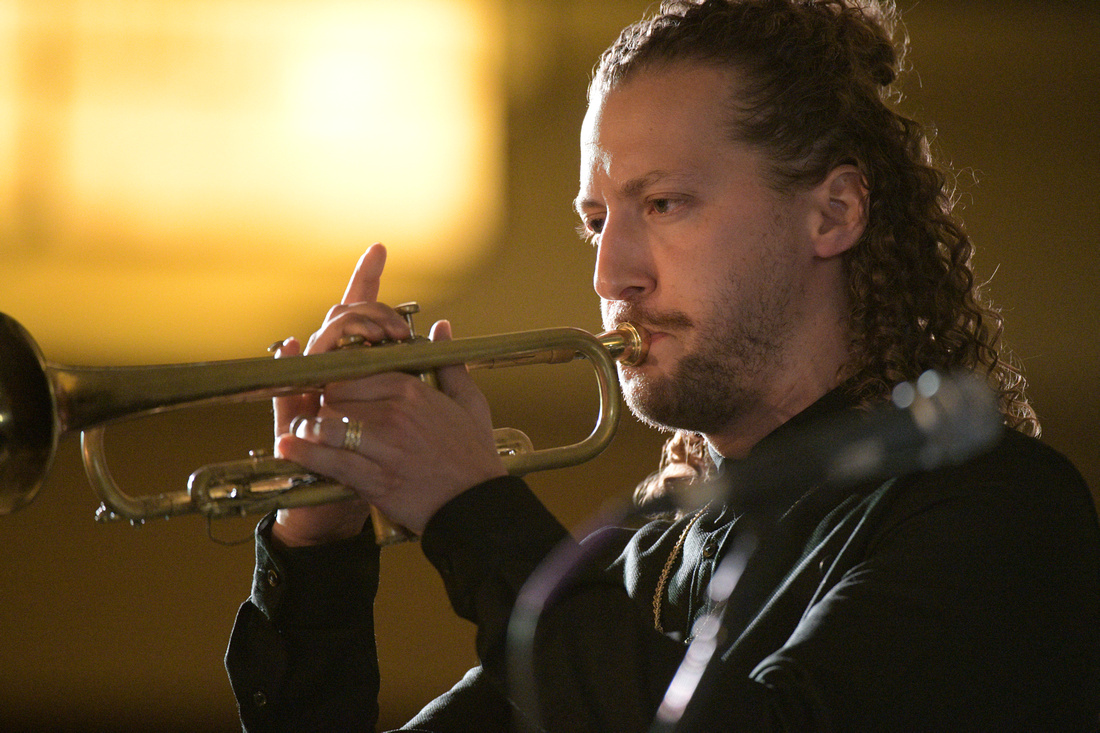
Therrien then brought the energy back up with her version of Chico O’Farrill’s Trumpet Fantasy. Therrien, recognized as one of the top performers and bandleaders on the Canadian jazz scene, brought out a fire that showed her passion for Afro-Cuban jazz. Her solos had great leading that left the audience wanting more.
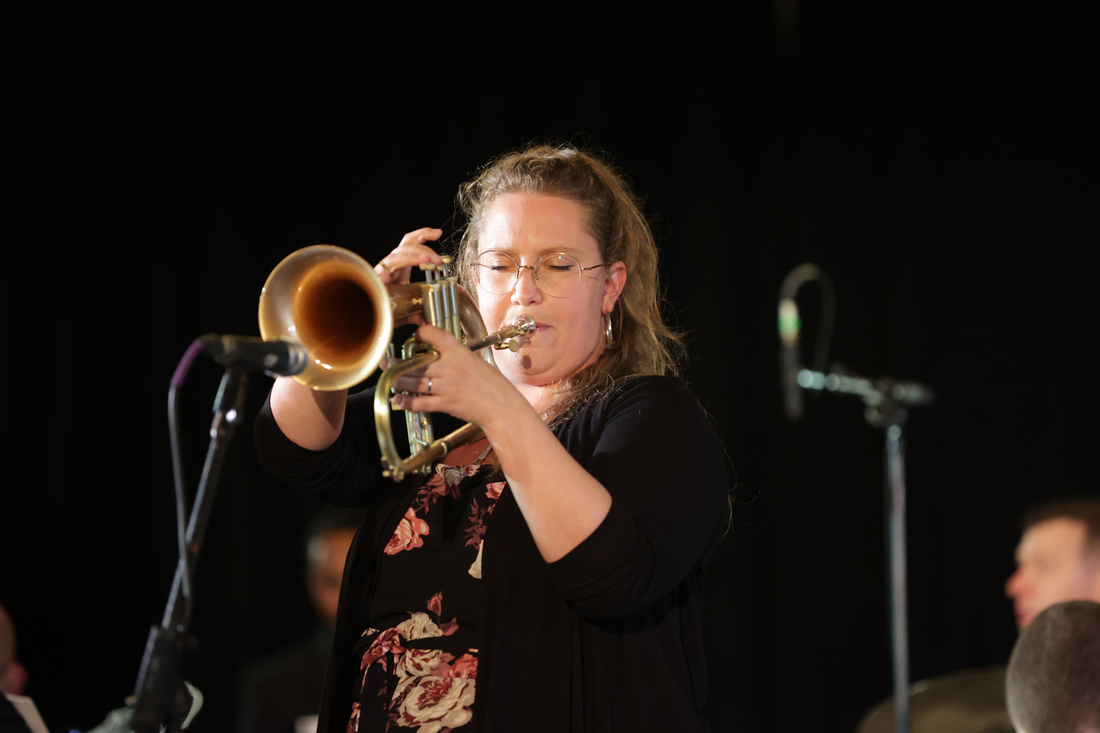 Therrien and Dizack paired up for the last two numbers. The first was a beautiful Tom Harrell ballad, Roman Nights, with the second, Herbie Hancock’s One Finger Snap, closing the concert. With each having their own solo language, their performing together made for a wonderful contrast. On both tunes, they traded choruses until they were eventually both blowing and weaving their lines between the other’s.
Therrien and Dizack paired up for the last two numbers. The first was a beautiful Tom Harrell ballad, Roman Nights, with the second, Herbie Hancock’s One Finger Snap, closing the concert. With each having their own solo language, their performing together made for a wonderful contrast. On both tunes, they traded choruses until they were eventually both blowing and weaving their lines between the other’s.
Throughout the night, the audience showed their enthusiastic appreciation to all the soloists and performers, which kept a great vibe in the room and made for a first-rate concert. (Kyle Millsap)
Concert: Wallace Stelzer Three featuring Carol Morgan
Carol Morgan’s New York City-based acoustic jazz trio provided a welcome moment of repose during a week of extreme volumes. In collaboration with bassist Wallace Stelzer and tenor saxophonist Evan Burrus, trumpeter Carol Morgan played an eclectic mix of standards. By not using a chordal instrument, the two horns provided a lovely contrapuntal interplay throughout, giving the group a playful sound that was reminiscent of recordings by Chet Baker and Gerry Mulligan or Tom Harrell and Joe Lovano. The communication between group members allowed them to traverse a host of different tunes in an organic and musical way. Morgan’s wispy and mellow trumpet tone more closely resembled a jazz singer from another era. Her charming sense of humor kept the late-night audience entertained, even interrupting herself mid-solo to celebrate a low F! This trio brought the atmosphere of an intimate New York jazz club to a spacious ballroom in San Antonio. (Nick Volz)

Click here for more photos from the ITG Conference
]]>
Special Daily Report • Compiled by Peter Wood
Photos by Denny Schreffler, Josh Rzepka, Benjamin Lowe, Ryan Berndt, Jeff Grass, and Michael Anderson
Thursday, June 2, 2022
Click here for more photos from the ITG Conference
Allison McSwain warm-up session - Reconsidering the Warmup for Efficiency and Self-Awareness
Allison McSwain presented a wonderful and highly interactive morning warm-up class. She began by explaining the overarching goals of mindfulness and deliberate practicing through various mental and physical approaches to help create a greater sense of ease in playing. Her mental approach begins before every session with developing a clear purpose, expectation, and understanding of what defines a warmup. For her physical approach, McSwain uses the standard warm-up repertoire with unique additions, alterations, and expansions to better suit her specific needs for that day. She guided the class through chromatic expansions, scale patterns, articulation and lip-flexibility exercises that showcased her concepts. McSwain left the audience inspired to implement the concepts and tools that this class had to offer into their practice routine. (Maryna Pohlman)
Joe Cooper warm-up session - Your Warmup is Talking… Are You Listening?
Joe Cooper’s warm-up session was an excellent interactive clinic that included such important concepts as breathing, long tones, tonguing, flexibility, and air flow. The session began with everyone forming a large circle around the outer edge of the room, making sure everyone could see and hear each other and Dr. Cooper. He structured the session in a call-and-response style, encouraging students to follow his modeling while putting their ear to their own sound and response. Cooper used effective breathing exercises designed to maximize efficiency and then moved on to long tones, instructing everyone to achieve good response at a soft dynamic. His “active rest” exercises included having the group try silent finger practice, working through commonly difficult finger patterns. He offered some weighted tonguing ideas and “tongue twister” multiple-tonguing patterns in an effort to better train the tongue muscle. Overall, Joe Cooper provided everyone with an engaging and thoughtful warm-up session. (Scott Hagarty)
Ryan Gardner non-pro warm-up session - Breathe, Sing, Sound
Ryan Gardner’s morning warm-up session with the non-pro player community was well attended and brought a fresh perspective to fundamentals. Participants were introduced to stretches and breathing exercises at the beginning of the session, as well as mouthpiece and slurring exercises from the teachings of Boyde Hood. Attendees were guided towards finding their easiest, most beautiful tone, and the collective trumpet sound was impressive as the session progressed. The warmup also introduced improvisation as a part of a daily fundamental routine and provided new ideas on how to make fundamentals transferable to other areas of playing. (Julia Bell)
Brianne Borden - Morning Yoga for Musicians
Dr. Brianne Borden’s presentation provided the participants an excellent introduction to yoga and offered practical exercises for use in the future. She began by addressing posture, both sitting and standing, before going into some basic movement exercises. Improved posture, or foundational alignment, is one area she feels all musicians would find beneficial. She then led the group through stretches for the areas most injured by musicians - wrist, shoulders, and neck. Due to the repetitive nature of instrumental performance, musicians have one of the highest rates of injury of any profession. She guided the participants through a series of breathing exercises to aid in performance anxiety, including one called “Box (or Square) Breathing.” The session ended with a meditation exercise entitled “Body, Brain, and Heart.” Borden fielded questions from the participants and encouraged finding more information about yoga and musicians at her website (www.yogaforallmusicians.com). (Rich Tirk)
Ryan Gardner non-pro and comeback players masterclass - Enjoy and Improve
With a warm, welcoming approach, Dr. Ryan Gardner invited attendees of his morning masterclass to play for him. He offered that it could be a scale, warmup, etude, or anything they wanted to play. With each of the volunteers, he exemplified the qualities that we know make him an impactful teacher. In his teaching, he led with questions and curiosity with an emphasis on embracing the positives. Within that positive framework, he still caught on to opportunities for improvement and addressed them immediately. Each of the players demonstrated significant improvement in just a short time in working with Gardner. He engaged not only the learners, but also the entire audience so that each person was able to walk away feeling inspired and empowered. (Brianne Borden)

John Kilgore lecture - From New Jersey to Cincinnati: The Life and Career of Classical Trumpeter Philip Collins
John Kilgore shared an informative presentation on trumpeter Philip Collins, including biographical and professional information from the musician’s life and career. Because Kilgore chose to research a living legend, the session was chock-full of details and first-hand memories from Collins himself. In addition to biographical information, the presentation included many recording examples, showcasing the range and depth of the 100+ albums of which Collins was a part. The research that led to this enlightening session is an important project that will preserve the life and memory of an incredibly talented, prolific, and influential musician. (Jena Vangjel)
Betty Scott clinic - Emotional Freedom Techniques (EFT) for Brass Players
Brass players are often subjected to physical and mental traumas. Dr. Betty Scott presented Emotional Freedom Techniques (EFT) as an avenue to ease those traumas and improve performance. EFT addresses negative emotions that can cause a disruption to the body’s energy system. Scott stated that people typically have around 80,000 thoughts throughout each day, 30,000 of which are negative. EFT begins by first addressing a negative trauma (mental or physical) and feeling the emotion associated with it. A sequence of tapping specific points of the face and body, along with positive self-talk, accepting yourself and the trauma, help remove some of the anxiety associated with that trauma. EFT may be a solution for musicians to cope with negative or anxious thoughts and even help with physical ailments due to playing brass instruments. (Spencer Brand)
Benjamin Hay and Andrew Cheetham clinic - Pedagogy Behind Duets: Improving Practice and Performance Together
Drs. Benjamin Hay and Andrew Cheetham gave an insightful presentation on how to utilize duets to address pedagogical topics and encourage student engagement. They detailed how duets can help students improve teamwork; match sounds, styles, and articulation; and become adaptable as ensemble players. The audience was kept engaged through duet demonstrations in a variety of styles: classical, orchestral, and jazz. The players performed the duets first with common pitfalls, such as intonation, balance, and releases. Those in attendance were asked to identify areas of concern. Hay then gave solutions for teachers to help students improve and performed again. Cheetham concluded the presentation with a discussion of how assigning duets to students can help jumpstart their musical development through learning peer professionalism, mentorship, and motivation through studio performances. (Kyle Millsap)
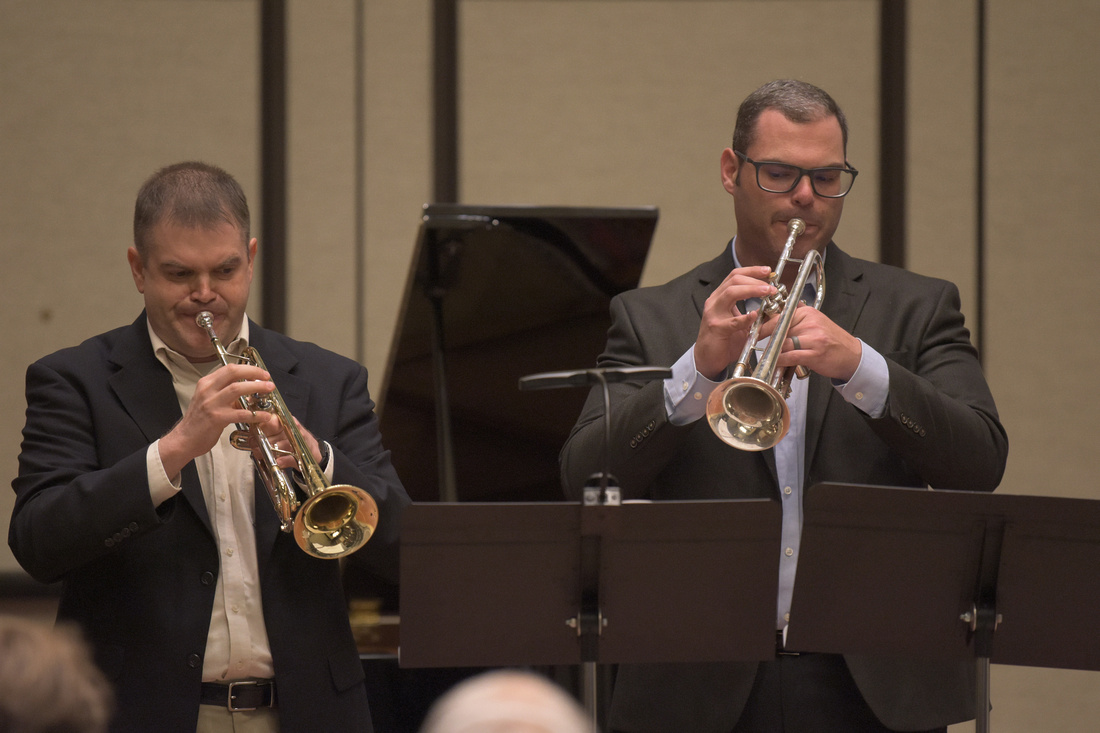
Solo Competition Finals
In front of a full room and a prestigious panel of judges, three young trumpet players put on a true tour de force for the final round of ITG’s solo competition. Introduced by Solo Competition Chair Jean Laurenz, DoYoung Baek, from South Korea, played first. At just fifteen years old, he possesses a sound and technique that brought a sense of wonderment over the audience. During his performance, there were consistently audible reactions to the most difficult passages, especially as he performed Desenclos’ Incantation, Threné, et Danse. Leaving the audience wondering how anyone could follow such a performance, Rui Almeida from Portugal entered the stage. Well put together and smooth mannered, Almeida continued providing the sense of awe the audience had been experiencing thus far. On William Perry’s Trumpet Concerto, he displayed beautiful lyricism and mature musicianship. Capping off three showcases of incredibly capable and skilled trumpet players, Diogo Costa’s particularly unassuming body language was contrasted by an absolutely electrifying performance of Stan Friedman’s Solus. With these young performers pushing the boundaries of what can be accomplished, this was one performance that was not to be missed. (Nathan Shadix)
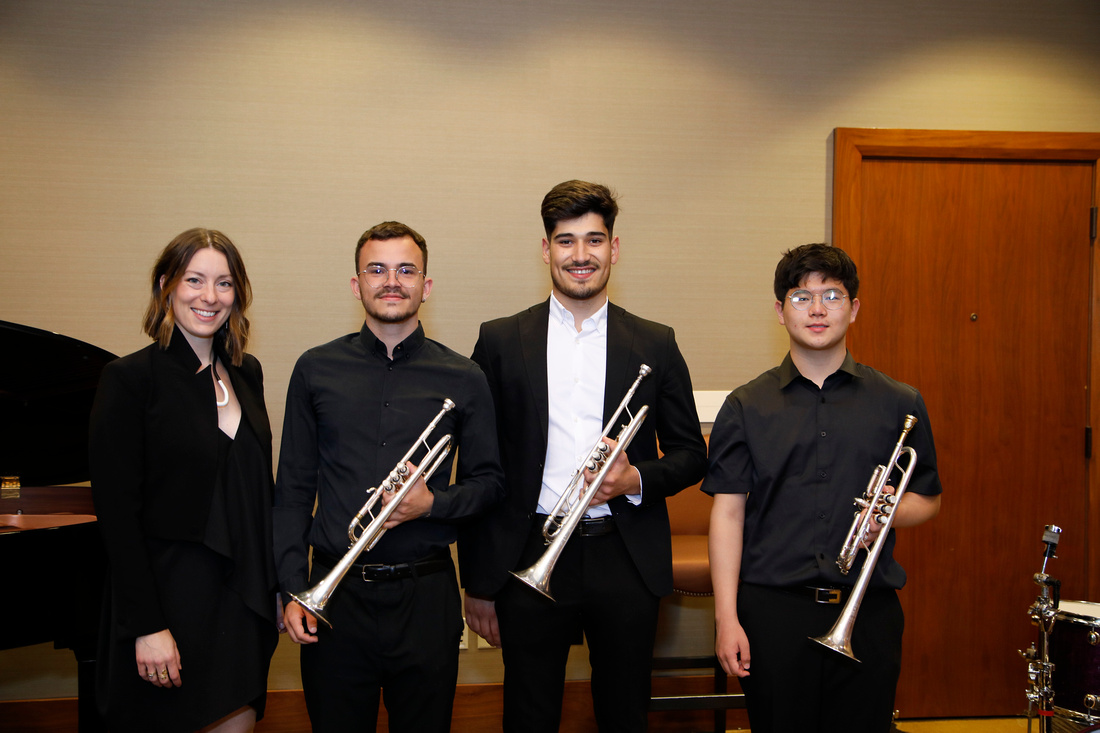 New Works Recital II
New Works Recital II
Chloe Swindler is an up-and-coming young artist, leading the way for her generation of trumpet players, and her performance of the first movement of Cooper Wood’s Sonata for Trumpet and Piano was an extraordinary example of her musical leadership. While one might expect newer repertoire to sound post-tonal or experimental, the work was easily accessible to all members of the audience. Miriam Hickman’s lively performance at the piano made the piece an enjoyable and relaxing listening experience. Swindler performed with a brilliance to her sound and made a technically challenging work sound truly effortless.
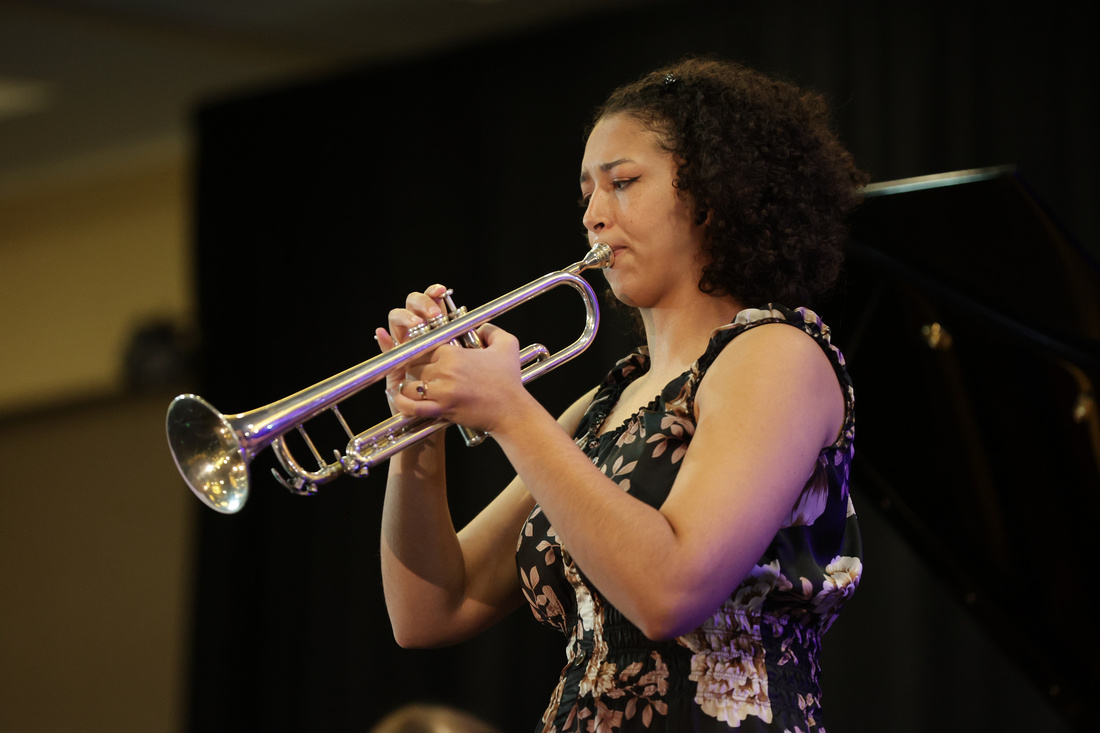
The first movement of Stanley Curtis’s Epiphany Window: Night Passages, promises to evoke scenes of a sunset giving way to night as the moon and stars come out, and the composer’s own performance of the piece held up to that promise. Curtis’s lyrical lines and rich upper register on flugelhorn gave the piece an air of solemnity and contemplation. The performance was a beautiful display of the sonic capabilities of the flugelhorn.
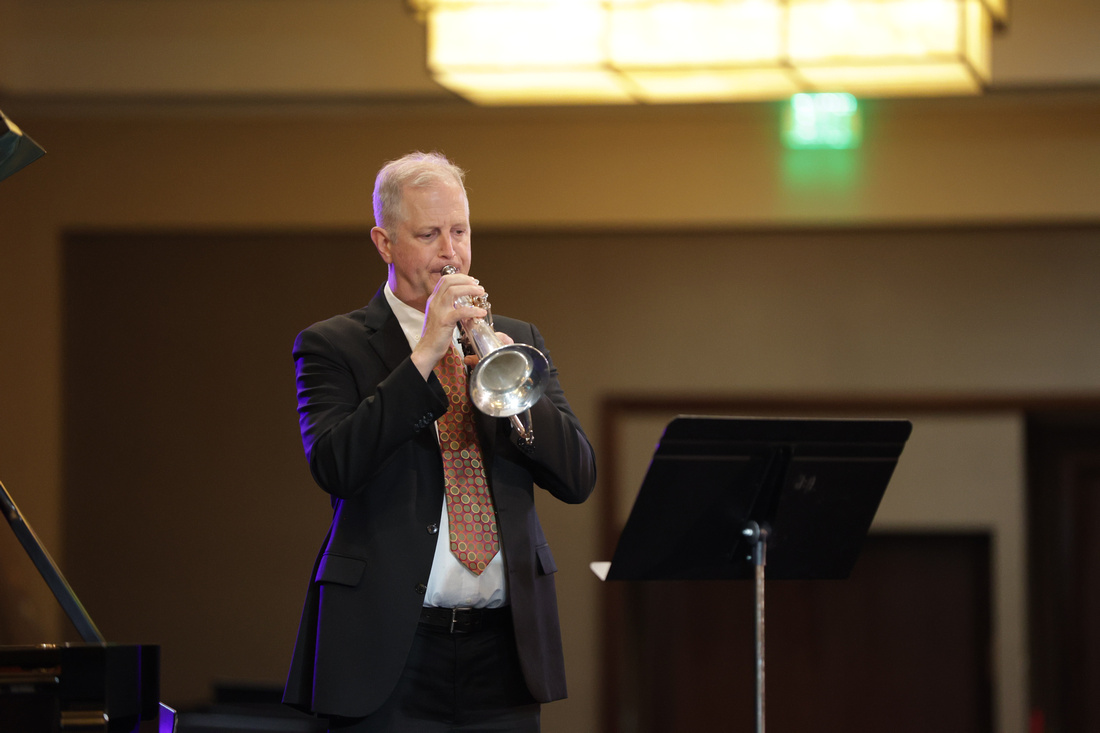
One might assume a work titled Andante & Scherzo to be from the European tradition, but Juan Carlos Valencia Ramos’s composition of that title showcases a Columbian interpretation of the form, and Columbian trumpeter Juan Avendaño’s performance demonstrated that interpretation beautifully. Avendaño was able to achieve incredible dynamic control while exploring different articulation styles that gave an exciting texture to the musical lines. The most incredible aspect of Avendaño’s performance was his ability to execute demanding technical passages while managing to avoid overtaking the sweeping piano lines.
Cody Ortz’s programmatic work titled …And Streetlights Will Fade tells the story of a man slipping into madness, and Timothy Winfield’s performance of the work placed the listeners right into that musical story. The angularity of the line, the short phrases in the middle lyrical section, and the clear pop to Winfield’s articulation painted a complex tonal picture for the audience. The use of different mutes for character changes was extremely effective in portraying the different sides of the story’s main character.
As soon as Brandon Dicks walked on stage, the audience knew they were in for a treat. The performer exuded confidence and conviction before he even brought the trumpet to his face. Dicks’s performance of Dalian Bryan’s …Another Tango showcased his technical capabilities, and the Latin flair he achieved in his sound highlighted the composer’s experience with the titular dance style. While the style of the work stays in touch with its roots, the rhythmic elements are innovative and progressive - a fabulous way to end a program of contemporary repertoire. (Christopher Luebke-Brown)
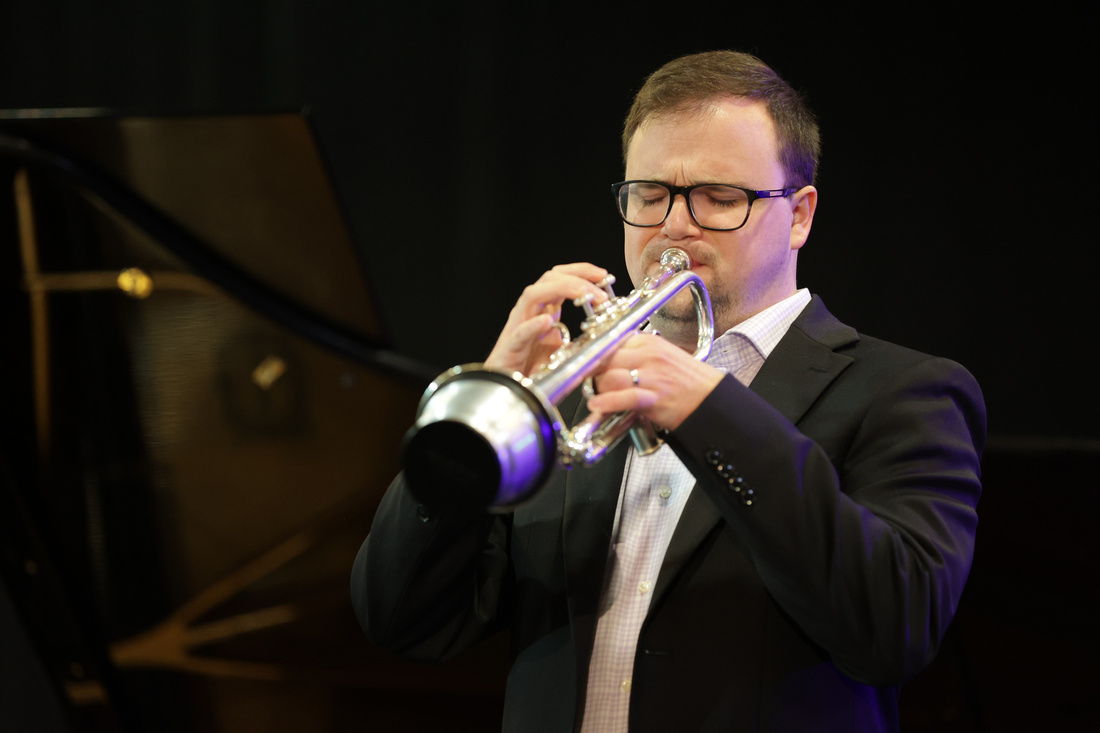
Larry Powell and Fred Sienkiewicz clinic - Suzuki Trumpet is Here!
Larry Powell and Fred Sienkiewicz opened their presentation with an important maxim from Shinichi Suzuki’s famous pedagogy - “Every child can.” This was their inspiration for becoming some of the early pioneers of the Suzuki method for trumpet. Testimonial videos of children learning to play from a very young age peppered the session and helped to make a serious case for using this method. The presenters maintained an open dialogue with the audience throughout, fielding questions about which types of trumpets to start students on, how to incorporate the method with older students, and the viability of implementing the method alongside traditional music education in the schools. Overall, Powell and Sienkiewicz made a compelling case for the Suzuki method and its benefits to trumpeters. (Eli Denecke)
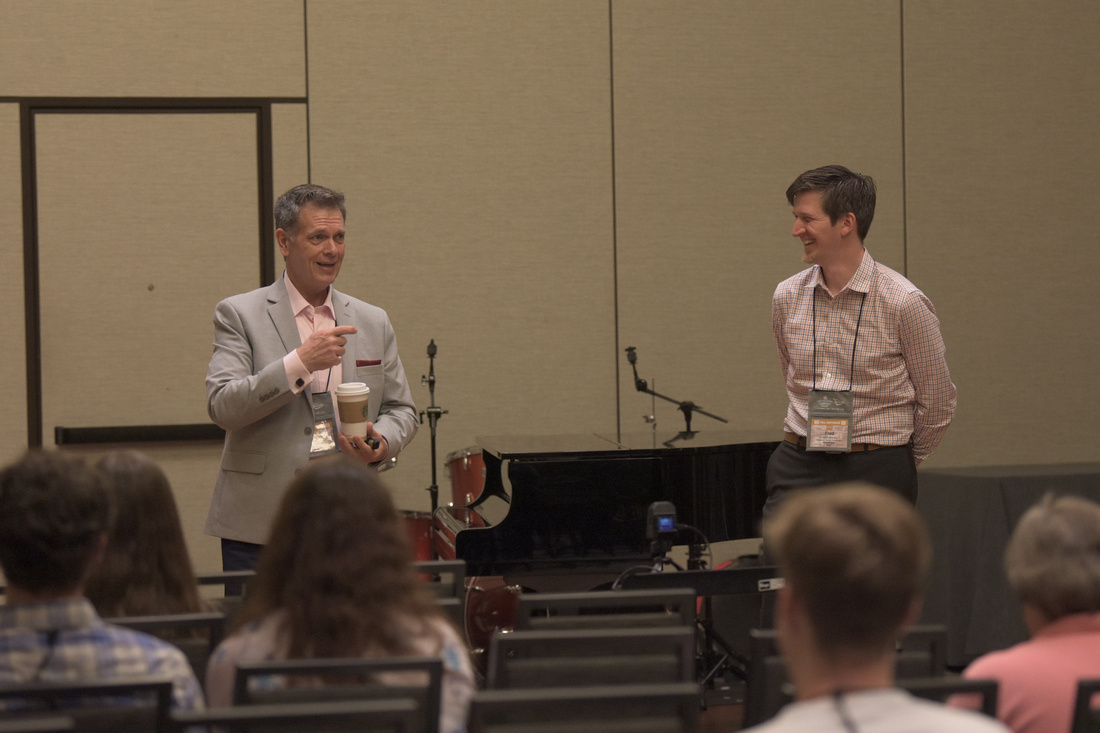
Phil Snedecor clinic - Breaking the Mystique of “Wind & Song”
Beginning with a brilliant performance of his own composition on piccolo trumpet, Phil Snedecor wowed the attendees of his afternoon masterclass with his seamless transitions between impressive playing and impactful teaching. In his teaching, he exemplified authenticity and vulnerability in sharing his (at times tumultuous) journey to his success today. He attributed some of this success to working with Arnold Jacobs, however he was very clear to differentiate between the differences of Jacobs’s pedagogy on tuba versus how it could apply to the trumpet. This hour of teaching interspersed with playing kept the attendees engaged, excited, and ready to try new approaches to air, singing, and applying these concepts to the trumpet. (Brianne Borden)
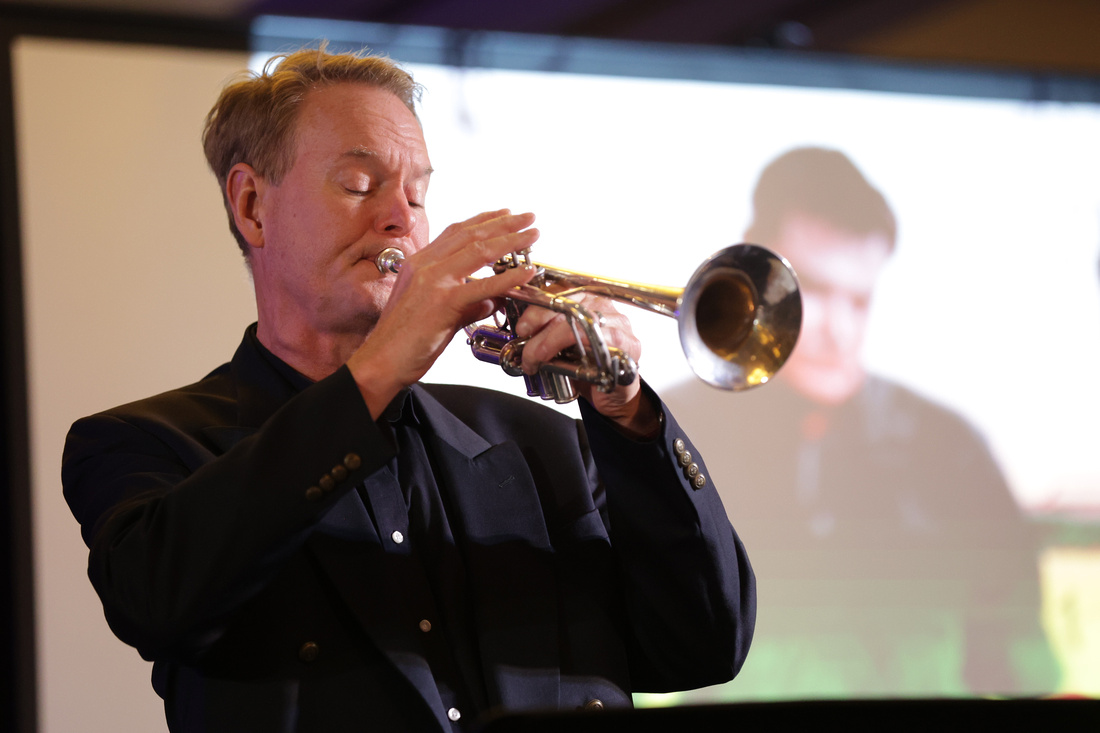
Friedemann Immer and Robert Apple lecture recital - News About the Keyed Trumpet and New Music for the Keyed Trumpet
Friedemann Immer and Robert Apple presented a lecture on the history and music written for the keyed trumpet. Immer discussed the history of the keyed trumpet, the tuning mechanism, and the distinction between the many keyed trumpets. Immer displayed two keyed trumpets by demonstrating the difficulties in the tuning and fingering system. Apple’s portion of the lecture focused primarily on the repertoire written for the keyed trumpet. Contrary to popular belief, Apple’s research displayed a large volume of works written for the keyed trumpet. He talked about method books, chamber works, and solo works that have been newly rediscovered. Overall, Friedemann Immer and Robert Apple’s session was an informative overview of the keyed trumpet and how it functions, as well as the music written for it. This lecture recognized the importance of the keyed trumpet as a significant component in music history. (Javian Brabham)
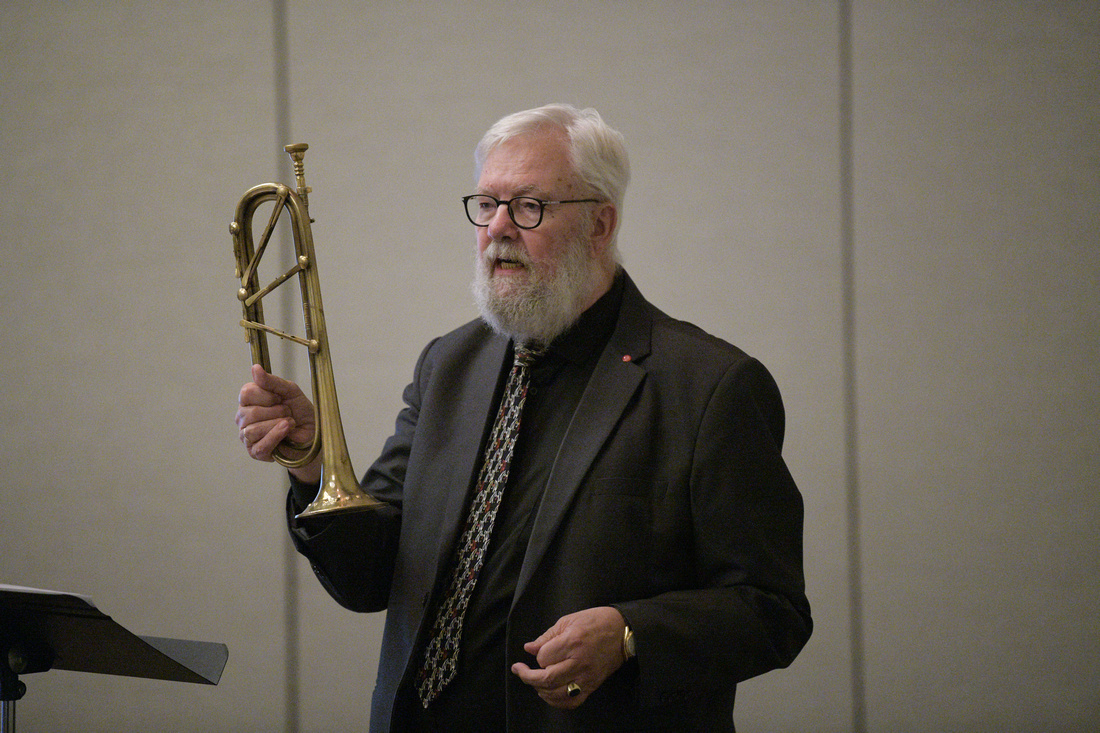
Ellsworth Smith Competition winner’s recital - Aleksander Kobus
Aleksander Kobus presented a spectacular recital featuring the works of both known and less-played pieces for trumpet and piano. Kobus opened with a wonderfully acrobatic performance of Joseph Turrin’s Caprice. Kobus showed amazing artistry through the lyrical and technical passages throughout the work. Kobus continued with Halsey Stevens’s Sonata for Trumpet and Piano. His diverse color and depth of sound was a treat for listeners. Kobus then dazzled the audience with his intervallic precision in Krzysztof Penderecki’s Concerto for Trumpet. He presented Miroslaw Gąsieniec’s beautiful Elegy for Trumpet and Piano. This work showcased Kobus’s flugelhorn artistry through beautiful sweeping lines that soared over the driving piano melody. Kobus closed his recital with Fryderyk Chopin’s Waltz Op. 34, No. 2, arranged for trumpet and piano. He mesmerized the audience with his warm and effortless flugelhorn playing, and his artistry was a true gift to listeners. (James Peyden Shelton)
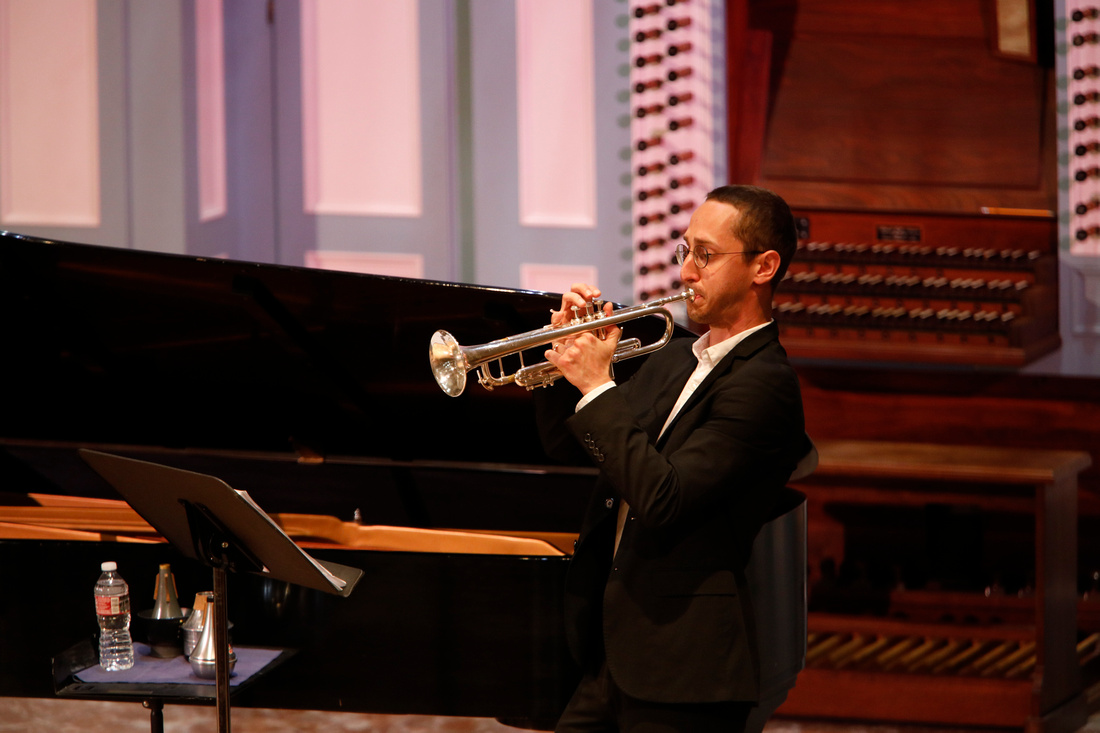 Caruso Competition winner’s recital: David Adewumi
Caruso Competition winner’s recital: David Adewumi
David Adewumi was the winner of the 2019 ITG Carmine Caruso competition - and for good reason, despite his questioning whether music is even a competitive arena. While this is a healthy debate, one can obviously see why he would be awarded for his achievements. As Adewumi walked onto the stage, the members of the rhythm section - Mike Frank on piano, Peter Paulsen on bass, and Larry Marshall on drums - also walked onto the stage and sat at their respective instruments. The atmosphere was electric, and the cool licks and harmonies gripped the audience’s attention. With very tasteful and interesting solos from all parties involved, some of Adewumi’s compositions were featured, ranging from quiet, ethereal sounds in Dolphin Dance to a ballad called Old Folks with a blues sound, as well as some very engaging melodies in Ventilation, which he attributed to beauty in the mundane and beauty in the ugly. (Nathan Shadix)
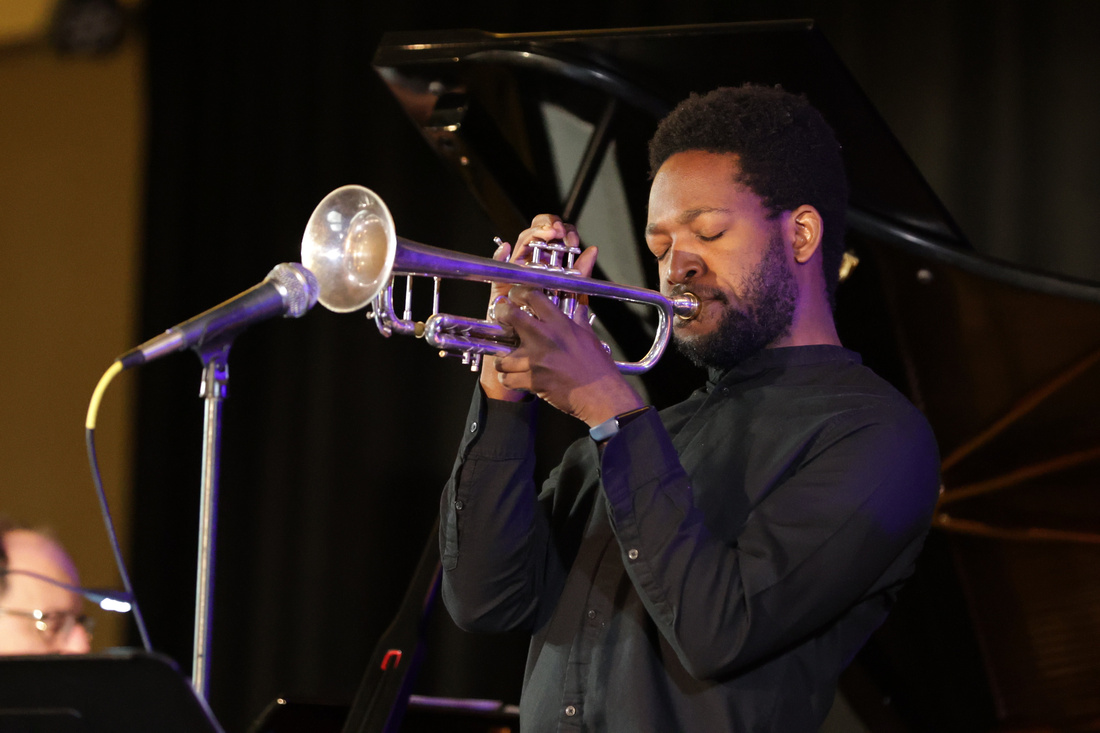 Stephen Burns recital - The French Connection: A Celebration of Our Lineage
Stephen Burns recital - The French Connection: A Celebration of Our Lineage
Stephen Burns and Rebecca Wilt captivated their audience with a true display of artistry in this highly engaging performance. Burns opened by leading the audience through a mindfulness activity that encouraged them to reflect on their own lineage. Mentioning that all modern trumpeters can trace their lineage back through Arban and Dauverné was an excellent segue into his opener, Jolivet’s Concertino. Each work in the concert was performed as a reflection of some of his most influential mentors. They performed with true virtuosity and elegance on staples from the French repertoire like Enesco and Ibert, showing the strong influence of Pierre Thibaud and Roger Voisin. Elegy for Mundy, a piece that Burns commissioned in memory of his teacher, Armando Ghitalla, was a wonderful addition to the program, as was Close Fight for trumpet, electronics, and video. Burns closed with his own exciting adaptation of “A Julia de Burgos” from Bernstein’s song cycle. The level of mastery and subtle nuance displayed throughout the performance made it evident that he is a strong contributor to our trumpet lineage. (Nick Volz)
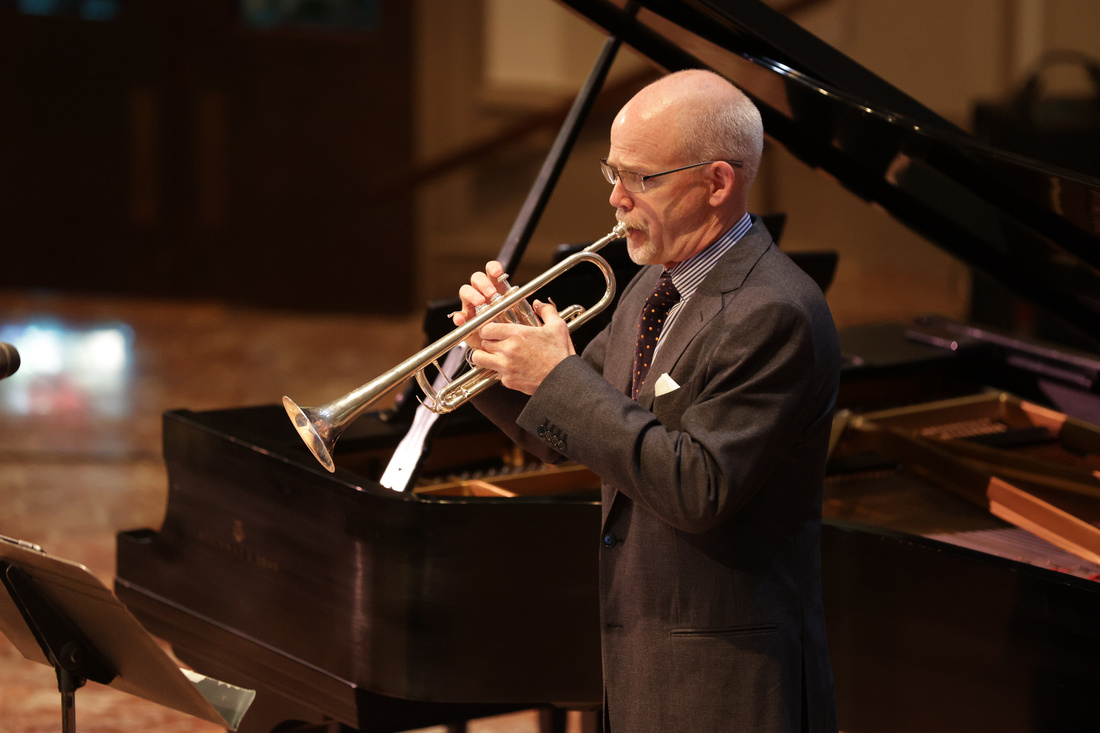
Trumpet Ensemble Reading Session
Conference participants had the opportunity to read through trumpet ensemble music, which was graciously provided by Triplo Press. The mass trumpet ensemble, led by Aaron Witek and James Olcott, played arrangements for ensembles as small as 8 players to as large as 24 players. They played pieces of various styles, ranging from J.S. Bach to Gustav Holst. The ensemble closed out the enjoyable session with a rousing rendition of John Williams’s Star Wars. (Nathalie Mejia)
Jonathan Barnes clinic - Advanced Melodic and Rhythmic Concepts for Improvisors
US Navy Band Commodores trumpeter Jonathan Barnes’s clinic focused on using upper-level theoretical concepts in a musical way. Barnes advocated beginning by learning all major and melodic minor modes and then playing scale degrees 1-3-4-5-1 in each key. He then demonstrated creating upper structure triads from different pitches in the major scale. To think musically, he related this to voice leading between chords and demonstrated connecting outlined chords to create a cohesive melodic line. To add rhythmic complexity to solos, Barnes played examples of melodic patterns with five, six, or seven notes. When playing in 4/4 time, these patterns shift the metric pulse and surprise the audience. Throughout the presentation, Barnes continuously stressed the importance of trusting your own ear and using trial and error when experimenting with new sonorities. (Marisa Youngs)
Juan Avendaño recital - Colombian Music by Colombian Composers
Recognizing the relative dearth of music for trumpet by Colombian composers, Juan Avendaño set out to commission and record new music from his homeland. Where only twenty years ago there was barely a handful of published works, we now have over fifty in circulation, half of which Avendaño has performed or premiered. Avendaño released his first CD in 2015, with plans to record a second in the near future. The eight selections on this concert presented a variety of styles and technical challenges, all adeptly handled by Avendaño and pianist Miriam Hickman. Of particular note was Jorge Humberto Pinzón’s Evocation, an episodic work that refused to settle into a style or harmonic language for very long, but was highly engaging. Marcos Galindo’s Pieza de Concurso Colombiana was selected for the final round of the Philharmonic Orchestra of Bogata’s XIV National Competition of Musical Interpretation in 2012. In the tradition of the European contest solos, it includes significant lyrical and technical requirements wrapped in nationalistic styles - in this case, elements from Bambuco, Pasillo, and Fandango. (Daniel Kelly)
Orchestral Excerpts Competition Finals
The ITG Orchestral Excerpts competition was a highlight of Thursday afternoon. Contestants Michael Winkler (University of Colorado-Boulder), Noah Mennega (University of Colorado-Boulder), and Victor Pires (Georgia State University) each played skillfully, showing considerable understanding of the orchestral works that were represented. All three played Mussorgsky’s Pictures at an Exhibition, Rimsky Korsakov’s Scheherazade, Shostakovich’s Piano Concerto, Stravinsky’s Petrushka, Gershwin’s American in Paris, and Bruckner’s Symphony No. 7. Winkler was the first to perform and began with a strong, bold opening in Pictures, and a great double tongue in Scheherazade. He did a good job of conveying different styles and musical ideas in the Gershwin and Shostakovich and finished with a beautiful and brilliant high note on the Bruckner excerpt. Noah Mennega was next and played with a clean, pure sound, demonstrating excellent rhythm and pitch. In the Gershwin, he had a beautiful vibrato that tastefully matched the style of the excerpt and again showed a good contrast between the different excerpts. Victor Pires was the last of the three contestants and played with a powerful sound that filled the room. He also made nice adjustments in tone and color between the various excerpts and demonstrated a thorough understanding of each orchestral work. He displayed fantastic dynamic contrast when he played Petrushka's Ballerina Dance, and his interpretation of Bruckner was spot on. All three played extremely well, and the audience thoroughly enjoyed the competition. (Spencer Wallin)
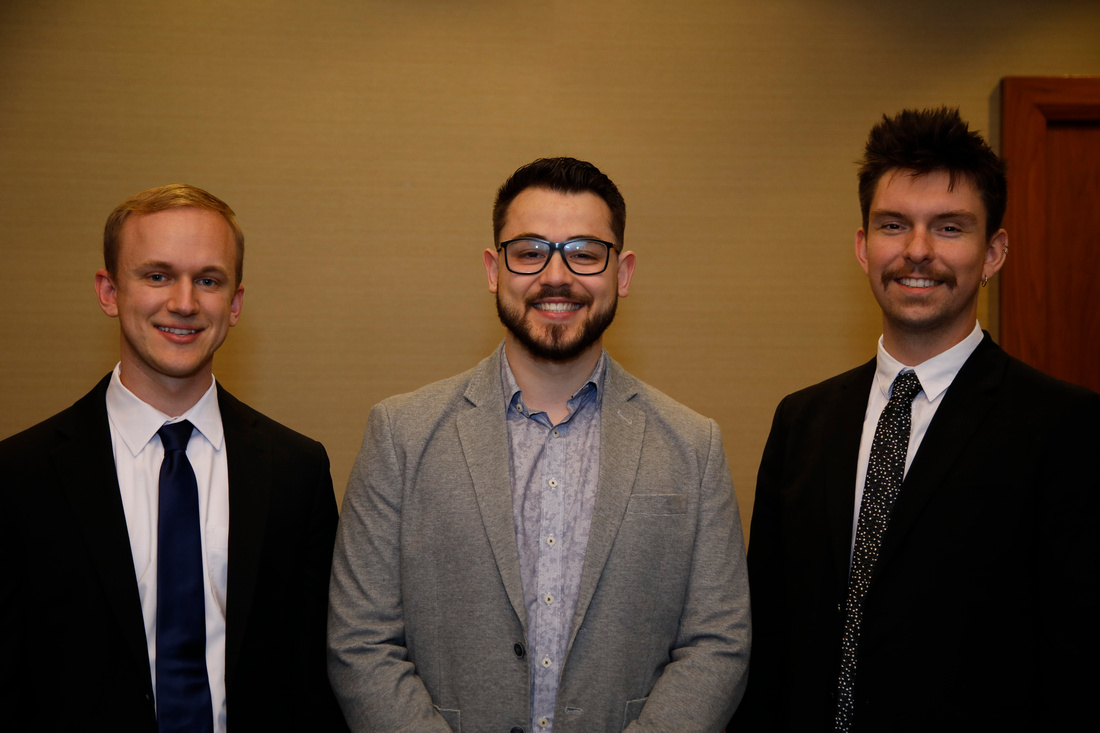
ITG General Members Meeting
With roughly 30 members in attendance, the ITG General Meeting focused on the future of ITG. President Jason Bergman outlined items from the recent board meeting. Vice President Ryan Gardner discussed student engagement, specifically bringing more students to ITG Conferences. One significant development includes Conference competitions, which will now each include a live semi-final round of fifteen students in each competition. Future Conferences will also host a new chamber music competition with broad guidelines to help bring in more students. The organization also wants to focus efforts internationally and plans to create two new smaller regional conferences each year - one abroad and one in another region of the United States. Dixie Burress, ITG Treasurer, gave a brief overview of the organization’s finances and membership. Conference Coordinator JC Dobrzelewski offered information about future Conferences, and the board fielded questions from members about the organization. (Marisa Youngs)
Evening Concert: US Army Brass Quintet
The United States Army Band “Pershing’s Own” Brass Quintet presented a truly magical performance that gave the audience a sampling of nearly every genre of music. The concert opened with a world-premiere fanfare by Phil Snedecor that literally had the audience’s heads turning. They then presented a beautiful arrangement of the Overture and Allegro from Handel’s Music for the Royal Fireworks, arranged by MSG C.J. Seipp. They quickly transitioned into an virtuosic rendition of Vivaldi’s L’estro Armonico that showcased SFC Kevin Gebo on piccolo trumpet while inviting renowned soloist Jens Lindemann to join the ensemble to complete the accompanying quintet while Gebo performed his sparkling acrobatic solo feature. Highlighting the unit’s primary mission of providing honor services for fallen soldiers and veterans at Arlington Cemetery, the quintet performed a beautiful and solemn rendition of Amazing Grace and Bridge Over Troubled Water that was paired with touching video footage of many of the ceremonial services that “Pershing’s Own” is tasked to provide. Trombonist SSG Greg Hammond then took center stage to perform Eric Cook’s Bolivar. This Latin-inspired work allowed the trombone to shine through dazzling solo lines with Spanish flair. The ensemble then shifted genres once again as they performed a piece that was arranged specifically for the funeral of former United States Secretary of State Colin Powell, which happened to be Abba’s famous song “Dancing Queen.” Trumpeter José Sibaja joined the ensemble to provide support with his beautiful shaker skills.
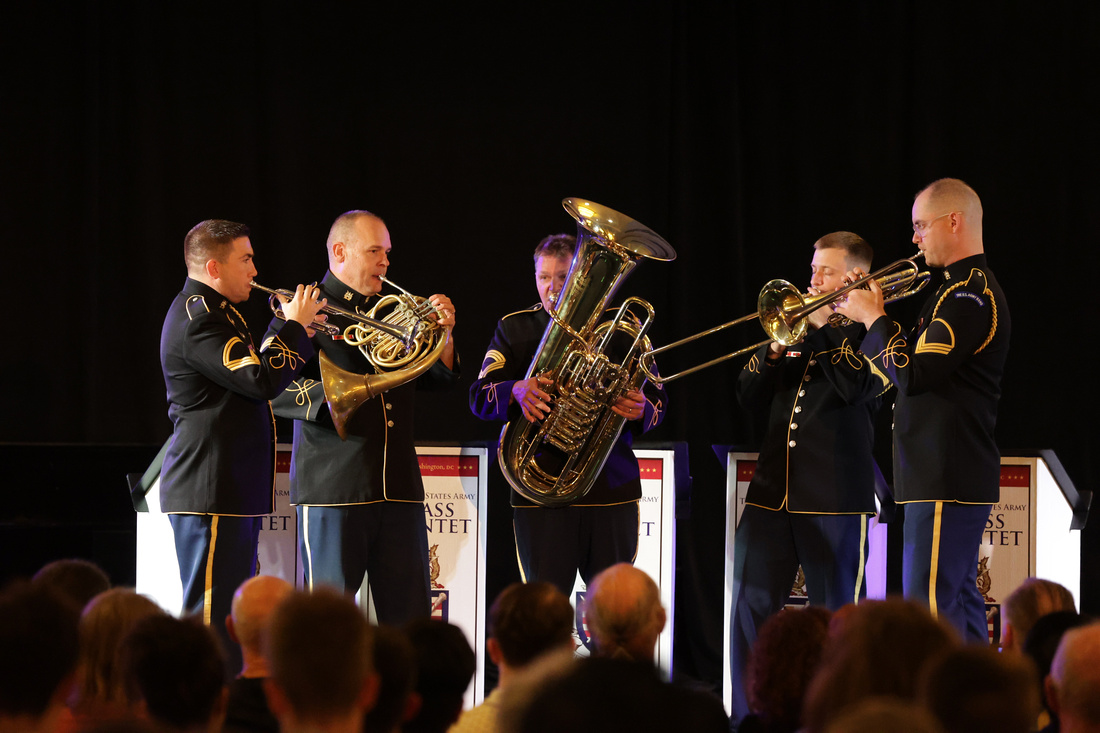
After a short ceremony in which the winners of the solo and orchestral excerpt competition were announced, as well as a presentation of a plaque to Grant Peters in honor of his work as ITG president for the last two years during the COVID crisis, the concert continued with the fifth movement of Enrique Crespo’s Suite Americana. The group’s powerful sound quickly pulled the audience back into the concert with their thrilling flourishes and fiery articulated figures. Providing yet another Classical staple to the plethora of works on the concert, the “Pershing’s Own” Brass Quintet transitioned into a spectacular performance of Mozart’s Marriage of Figaro. This arrangement showcased the technical precision and virtuosity of nearly every member of the ensemble through quick scalar passages and layered rhythmic complexity. They then honored those serving in the US Armed Forces both at home and abroad with a touching arrangement of America the Beautiful and then closed the concert with a piece by Peter Meechan’s Song of Hope, which featured a jaw-dropping list of trumpet legends including Peter Bond, Phil Snedecor, Tom Rolfs, Mark Gould, and José Sibaja - all under the direction of Dr. Jerry Junkin (director of bands at the University of Texas – Austin). The final piece served as a beautiful memorial to Ryan Anthony and his tremendous work of lifting spirits through his music and his tireless dedication to helping others in their battles with cancer through his organization, Cancer Blows. This is truly a concert that this reporter will never forget. (James Peyden Shelton)

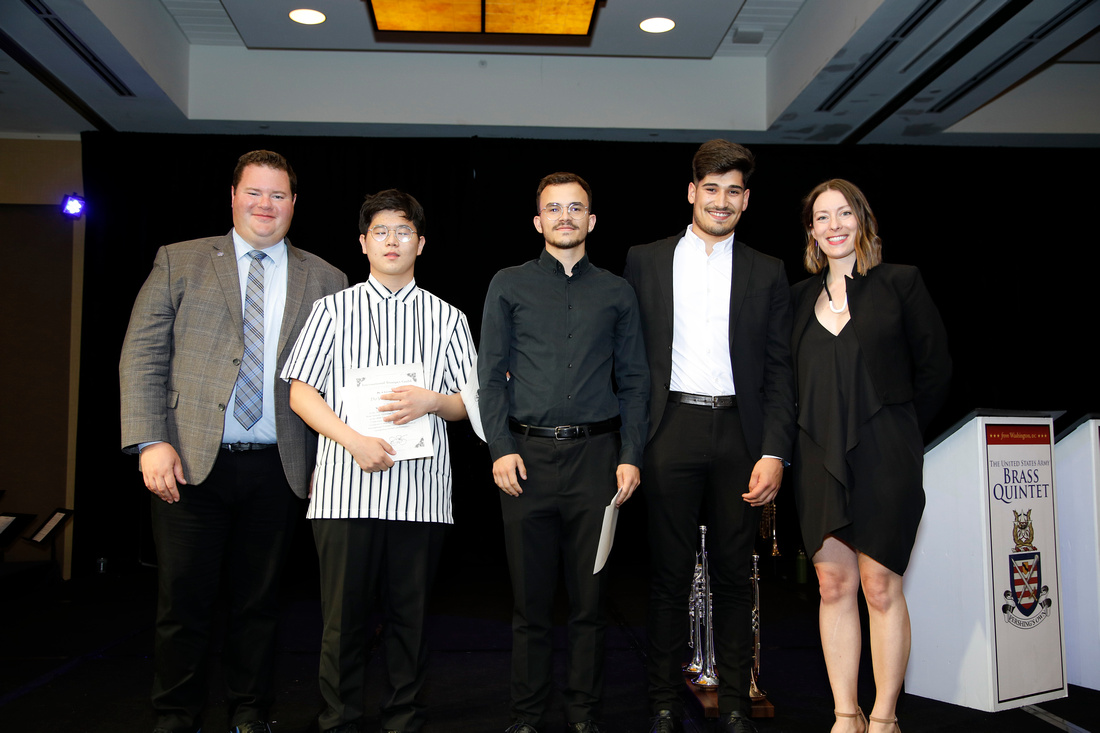

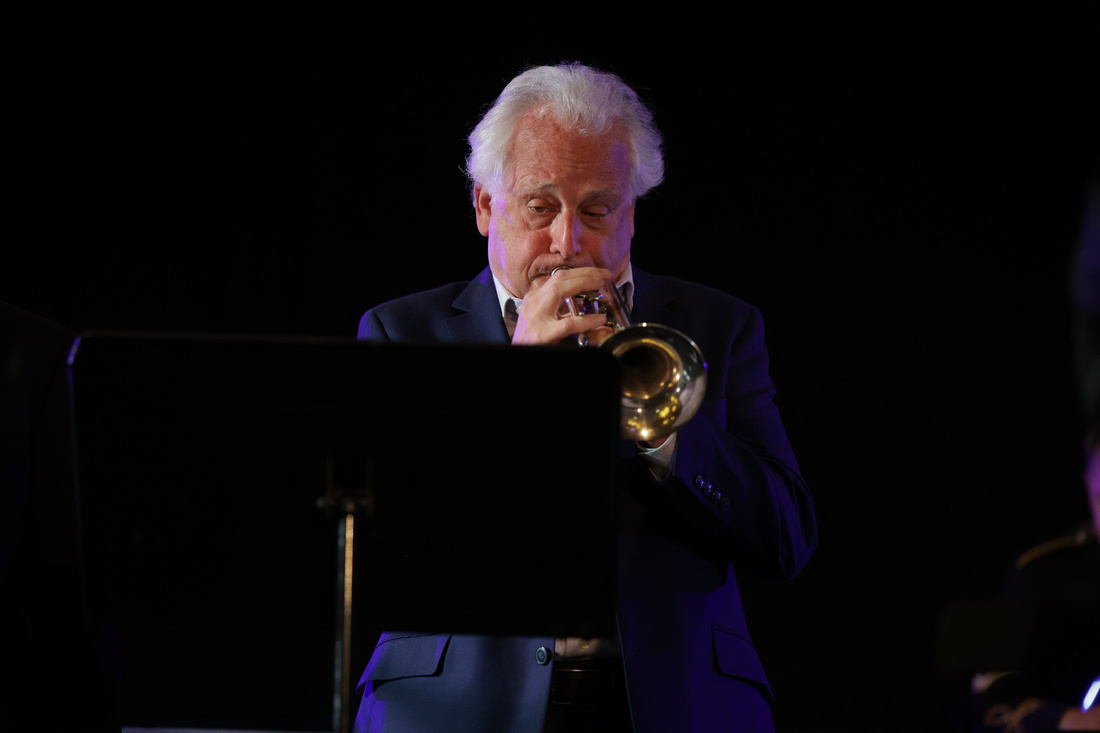
Open jam session - Eric Siereveld
Dr. Eric Siereveld led this second late-night jam session that included Mike Frank on piano, Peter Paulson on bass, and Larry Marshall on drums and included over twenty other attendees and guest artists. The trio opened with a tune featuring Siereveld. While they were playing, attendees signed up to play a tune on which they wanted to solo. Throughout the night, Siereveld invited two to five of the attendees to play at a time, and by midnight they had played a number tunes that included Stella by Starlight, A Night in Tunisia, Watermelon Man, It Could Happen to You, and What is this Thing Called Love. The session ended with a bang as seven of the attendees and guest artists played Sandu. (Spencer Brand)
Click here for more photos from the ITG Conference
]]>
Special Daily Report • Compiled by Peter Wood
Photos by Denny Schreffler, Josh Rzepka, Benjamin Lowe, Ryan Berndt, Jeff Grass, and Michael Anderson
Wednesday, June 1, 2022
Click here for more photos from the ITG Conference
Andy Kozar warm-up session - Response: A Guide to An Easier Way of Trumpet Playing
From New York City and Boston, Andy Kozar brought a refreshing approach to the classical trumpeter’s daily warm-up routine. This routine consisted of the standard method repertoire from Vincent Cichowicz, Bai Lin, James Thompson, and Herbert L. Clarke, but with additions on each exercise. These are minor alterations that better serve the approach of playing with a balanced lip tension and air flow throughout all registers. He coached the class through six exercises that covered breath, buzzing, flow studies, and scales. Kozar will be releasing this warm-up approach in his new book, Response: A Guide to an Easier Way of Trumpet Playing, which will be released on September 1, 2022. (Maryna Pohlman)
Christopher Scanlon warm-up session - The 3 Cs: Covering Your Bases with an Integrated Routine of Caruso, Cichowicz, and Clarke
Dr. Christopher Scanlon gave practical insight into his preferred warm-up method by discussing the three Cs: Caruso, Cichowicz, and Clarke. Each of these methods play a key role in filling what he calls “buckets.” The first bucket is filled by finding a beautiful sound. This includes preliminary stretches, breathing exercises, and mouthpiece buzzing, followed by Caruso’s “Six Notes” exercise. While Scanlon does not refute the isometric value of Caruso, he factors it into his warmup as a long-tone exercise. The second bucket is that of moving throughout the entirety of the player’s range. This is where Cichowicz’s flow studies become beneficial. The final bucket consists of warming up the player’s technical facilities, in which Scanlon advocates for variations on Clarke’s Technical Studies. If done correctly, the three Cs fill these buckets, leaving the player ready for practice or performance. (Christopher Luebke-Brown)
Nairam Simoes warm-up session - Going on a Trumpet S.A.F.A.R.E.: A Warmup for Developing Efficient Practice Habits
Dr. Nairam Simoes’ warm-up session focused on the acronym S.A.F.A.R.E. (Sound, Articulation, Flexibility, Agility, Range, Endurance) as a guide for daily warmup. He used exercises familiar to trumpet players - long tones, lip slurs, and scales. To spice things up, however, rhythms from his native Brazil were utilized as a sort of metronome while playing standard exercises by Cichowicz, Clarke, Plog, and others. Some rhythms included baião, frevo, and samba. Each exercise had a different rhythm to accompany it, and Simoes gave a little history of the origin and significance of each rhythm. Simoes also discussed ways to adapt his warmup to address areas of concern, time constraints, and individual skill levels. It was a very informative and engaging session. (Kyle Millsap)
Brianne Borden session - Morning Yoga for Musicians
Participants were able to start their day with mindfulness exercises through Dr. Brianne Borden’s morning yoga session. The class focused on movement, breath work, and meditation. Participants were led through various movement sequences and stretches and then discussed how these tools can be used in the practice room for focus and injury prevention. Borden also gave insight on how to implement these practices to ease performance anxiety. The event concluded with a guided meditation that tied together Borden’s core philosophy: emphasis on the body, brain, and heart. (Nathalie Mejia)
Wiff Rudd lecture - Side by Side: How Teachers and Their Students Can Build and Sustain an Effective Studio
Wiff Rudd, who received the ITG Award of Merit this year, presented an inviting and encouraging lecture about how students and teachers can build a positive, encouraging, and productive culture in any studio. Rudd provided wonderful insights on the basic needs of each person and why it is important to do more than just teach music. He shared about how he uses simple writing assignments on non-musical topics, books, and such question prompts as “How do you want to feel in May?” has provided ways for his students to be more open and honest about their goals and hopes. This has led to a better learning environment for all. He also spoke of the importance for musicians to understand why they are dedicating time to the arts and shared how positive catchphrases and traditions can help any studio grow and prosper. (Spencer Wallin)
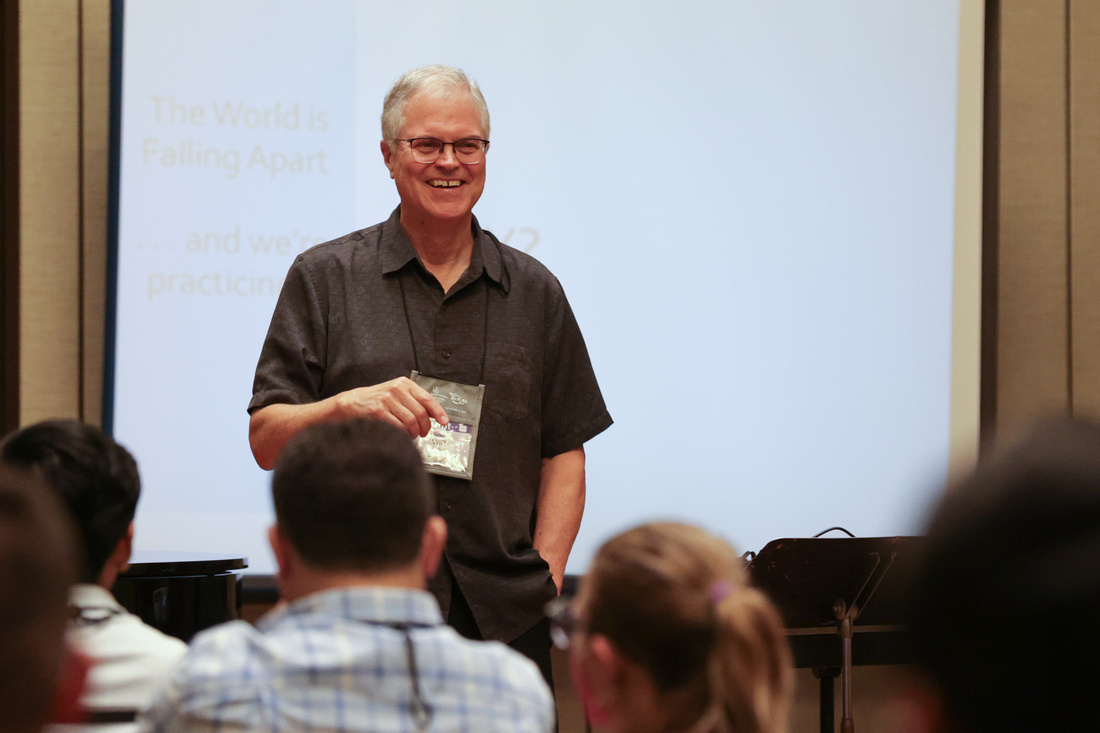
Jens Lindemann non-pro clinic - Expanding Range and Flexibility
Jens Lindemann began his clinic for non-professional/comeback players with a dazzling and energetic piccolo trumpet fanfare, aptly setting the tone for the remainder of this well-attended event. As Lindemann recanted some of his most influential and formative experiences with the trumpet, he also discussed many of the foundational ways in which he approaches the instrument. He discussed such topics as his personal practice routine, efficient tone production, approaches to articulation, connection to the instrument without added muscle tension, and many more. Throughout his discussion of pedagogy, Lindemann emphasized a philosophical message of intelligent practice, positivity, and perpetual curiosity. The audience was thoroughly engaged for the duration of the clinic and were encouraged to ask questions toward the end of the session. The resulting lively dialogue was enjoyed by all. Lindemann took a poignant moment to acknowledge the legacy of Ryan Anthony in his closing remarks. (Benjamin Hay)
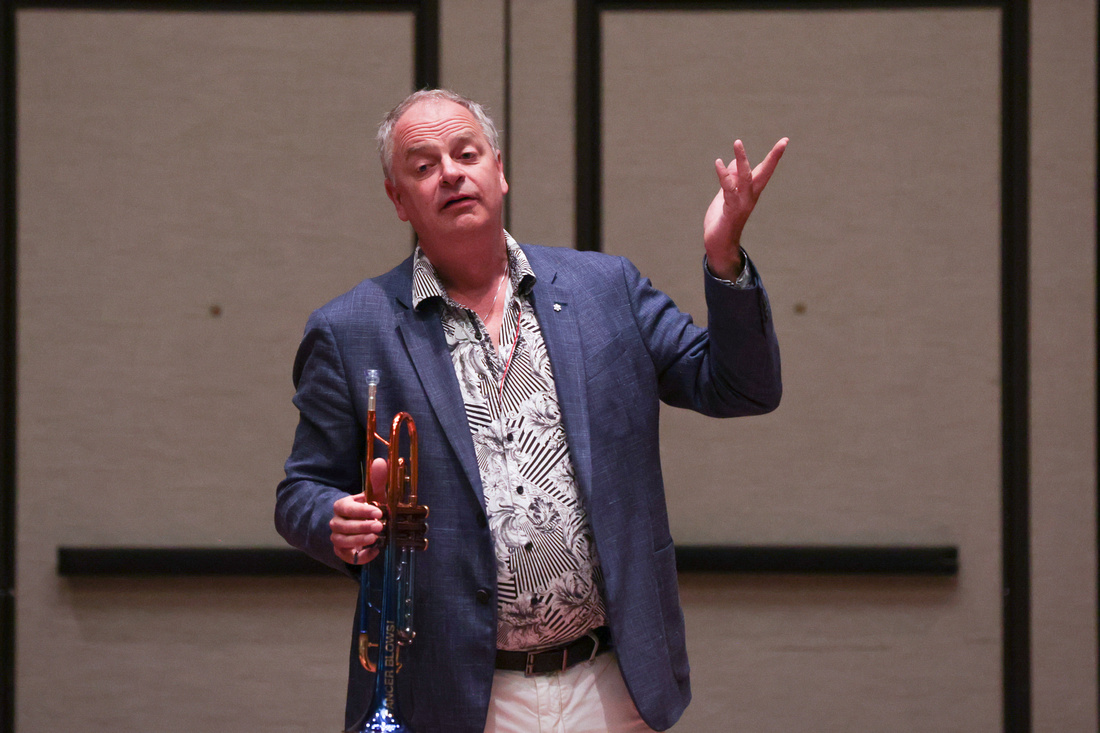
Wind Band Excerpts Competition Finals
In the Chula Vista Room, Susan Rider briefly introduced the Wind Band Excerpt competition finalists: Julia Gill, Christopher Keach, and Anna Kallinikos. The room had a welcoming aura, and there was a hearty round of applause for each finalist. Each competitor played a list of seven excerpts of varying difficulty, which tested their endurance, range, articulation, and interpretation. All three finalists handled the environment very well and, as expected, were extremely well prepared. The finalists’ teachers and friends were in attendance, and there was a great deal of socializing as everyone exited the room. (Nathan Shadix)
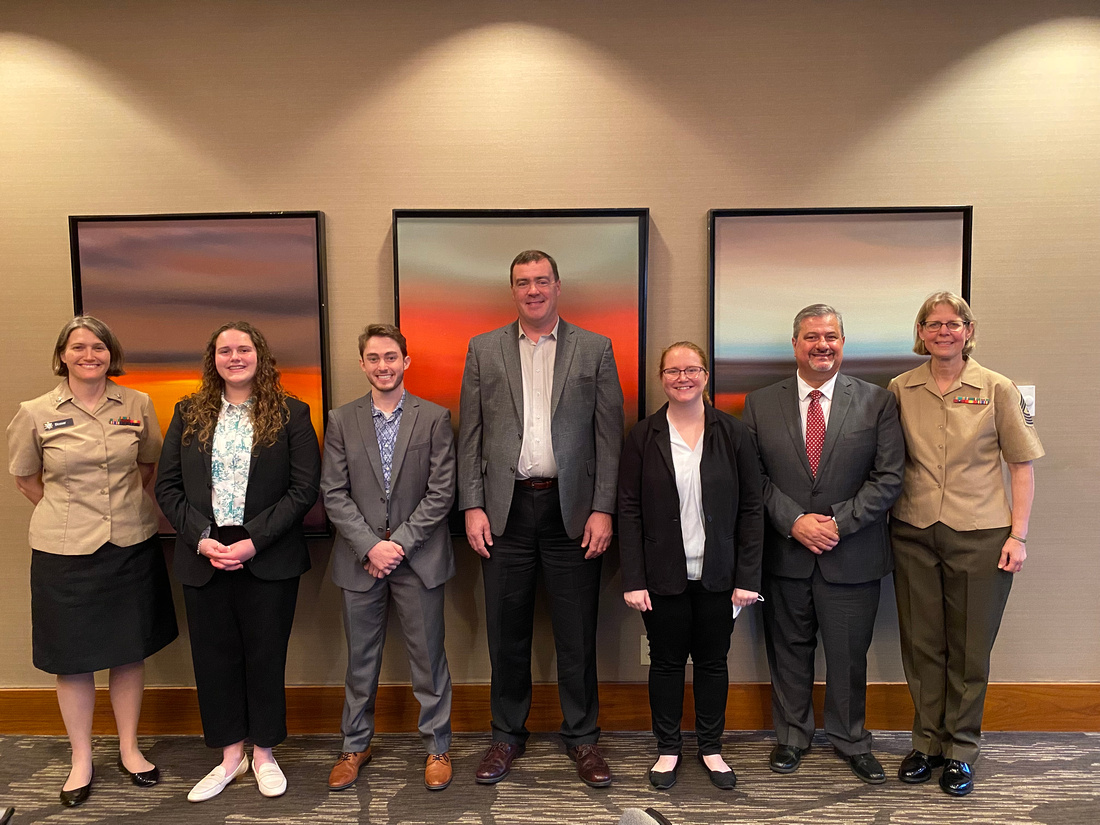
Elliot and Alejandra Johnston and Agustin Sandoval clinic - Introduction to Mariachi Trumpet Pedagogy and Style
With help from wonderful local mariachi musicians and willing ITG participants, the Johnstons, alongside Agustin Sandoval, gave a wonderful overview of mariachi pedagogy and style. This clinic involved helpful exercises for both students and professors wanting to learn more about the style. Using both Spanish and English to communicate to the attendees, they eloquently articulated the difference in use of vibrato and articulation between classical and mariachi styles. In a masterclass style, the team of leaders were able to display this extraordinarily effective teaching in the moment. Attendees were able to take home very helpful color-coordinated handouts to use in their own teaching and learning. Each attendee, whether a teacher, player, or lover of mariachi music, was sure to leave with something useful. (Brianne Borden)
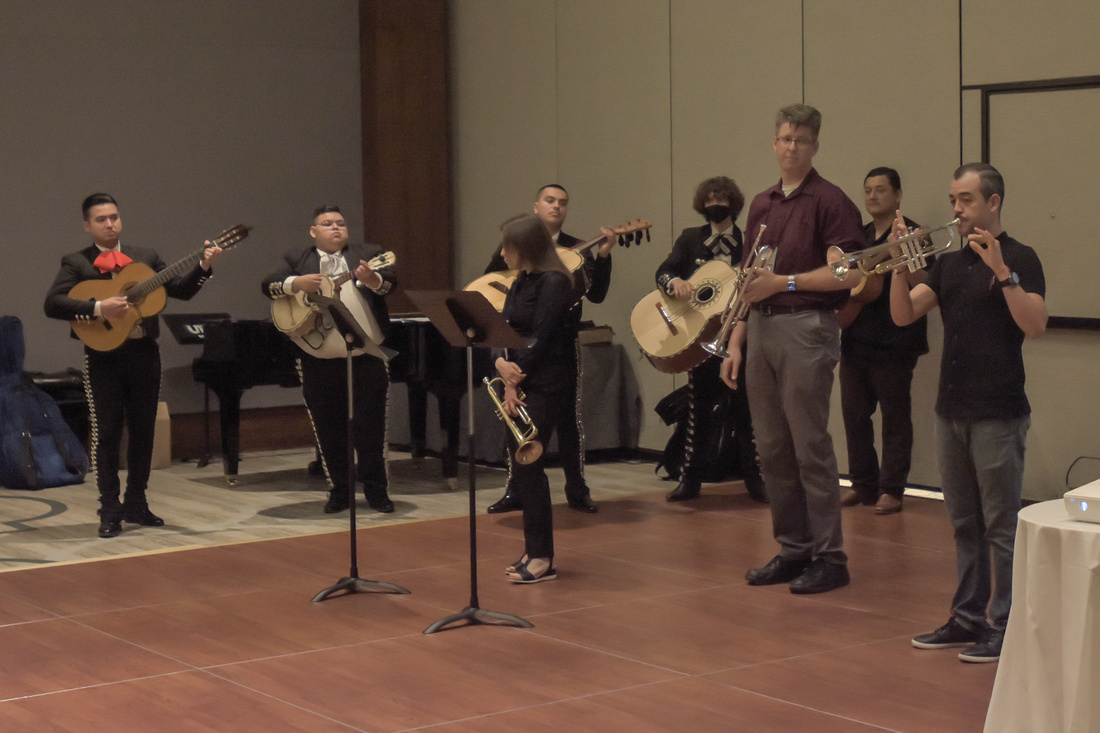
ITG Research Room
The ITG Research Room at this year’s Conference offered diverse presentations on three widely differing topics that represent unique focuses in scholarly research currently impacting the trumpet community. Dr. Nina Bausek and Angelica Aldarondo presented an in-depth presentation on the unique requirements of respiratory muscle training and its impact on a trumpet performer’s breath support and control. Dr. Elijah Denecke’s presentation highlighted many of the often-overlooked French works from the mid-twentieth century by women composers. His research highlighted three French female composers and key works within their corpus of repertoire that highlighted each of their unique compositional stylings. The final presentation examined the impact of the New York Brass Quintet’s influence on the development of chamber music during the mid- to late-twentieth century. Dr. James Sherry highlighted numerous significant chamber works and their historical impact that were premiered by this ensemble. (James Peyden Shelton)
New Works Recital I
The first of the New Works Recitals at this year’s Conference was composed entirely of works that were either unaccompanied or with accompaniment other than piano. The first work, Luis Engelke’s Voces Lucis et Tenebrae (Voices of Light and Darkness), was a prime example as it was written for trumpet and fixed media. The composer himself performed the work with projected visual scenes that evoked religious imagery and explored the contrasts between light and darkness in reference to the work’s title. Engelke performed with a shimmering, brilliant sound while still maintaining a relaxed resonance and consistent articulation. His character changes fit into the work’s exploration of musical chiaroscuro.
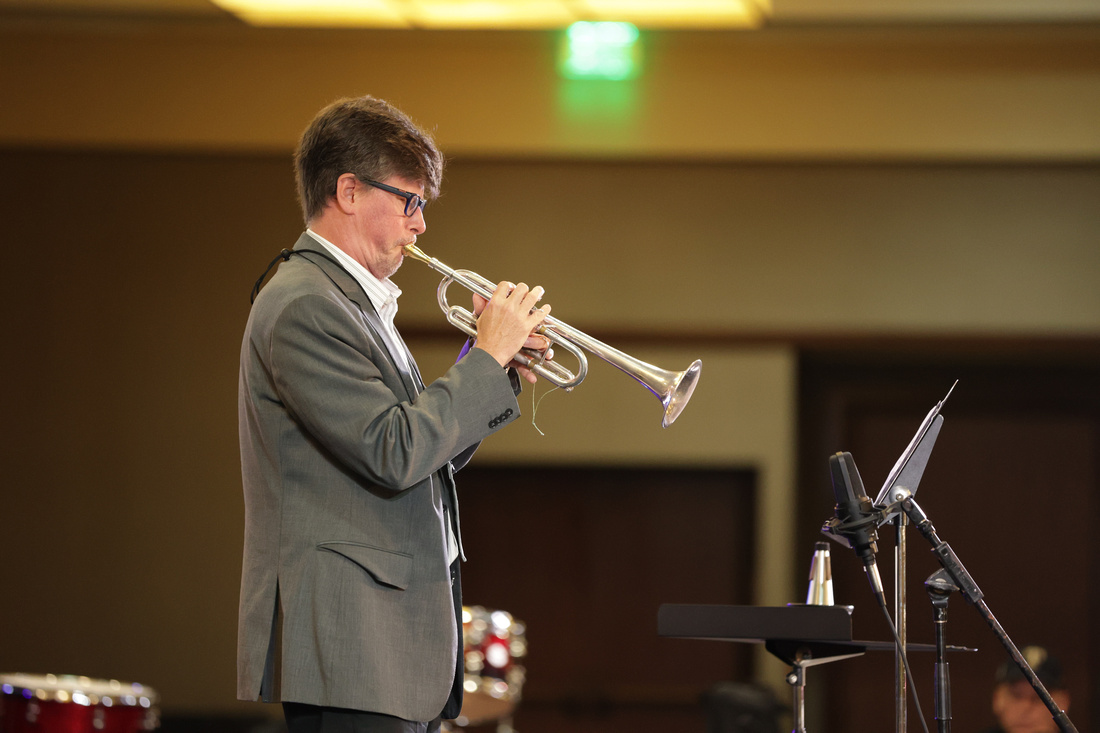
While the fixed-media accompaniment of Drew Tomasik’s Yearly Tech Review resembles the electronic music of public-access television in the late-twentieth century, trumpeter Stephen Campbell and hornist Gene Berger’s interpretation emphasized its newness and progressive use of electronic media in performance. Together, the performers were not simply accompanied by the media, but melded with it. The second movement, resembling LoFi music more than its neighboring movements, was especially notable as Berger stepped aside for Campbell’s radiant and pure tone to shine through.
TJ Perry’s performance of Now I am Become Death by Michael Cotton was incredibly moving. The work focuses on the emotional weight of nuclear warfare, with a ticking that resembles that of the doomsday clock. The media contains several recordings of powerful speeches, but most of it focuses on J. Robert Oppenheimer’s famous “Now I am become death” speech. While most of the trumpet part is angular amidst the spoken rhetoric of violence, the most prominent moment of lyrical expression is accompanied by John F. Kennedy’s Birmingham speech in which he stated, “We all breathe the same air, we all cherish our children’s future, and we are all mortal.” Perry’s performance enhanced the emotional weight of the source material, giving enough space for the media to come through without being overwhelmed by it. His pure tone soared through the room in a way that almost resembled Taps being played in the distance.
Jason Dovel’s rendition of his own unaccompanied work, Et Planetarum, was full of energy and excitement. While each movement is titled after a different planet, the work bears little resemblance to Holst’s similarly oriented orchestral suite. Dovel’s piccolo trumpet playing in the first movement, “Mercury,” was energetic and flashy while the second movement, “Venus,” was lyrical and reflective. By removing his second valve slide and using a Harmon mute, Dovel was able to achieve a playful effect in the third movement, “Mars.” Dovel’s performance explored the extremes of the instrument’s dynamic range, and the softer sections had the audience leaning closer to the stage.
Julia Bell’s performance of Jenna Veverka’s Solo Ascent demonstrated a level of conviction that was not only inspiring, but also educational for those who are afraid to approach unaccompanied repertoire. The work calls for wind effects at the beginning and middle of the performance. While this special effect can often sound contrived, Bell’s pacing left an air of mystique lingering through the hall. Every change of character came as a welcome surprise, and moments of pause were pregnant with anticipation. The fluidity throughout Bell’s entire range made a challenging piece sound effortless.
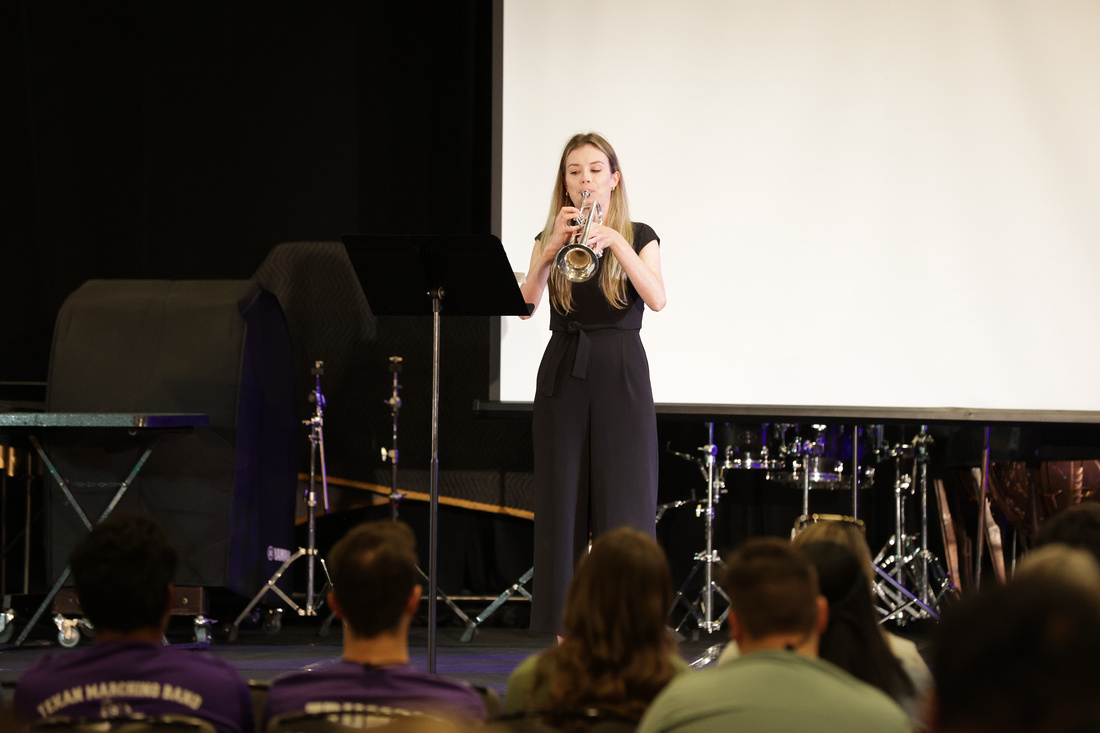
The three movements of Beth Wiemann’s It Floats Away from You, written for unaccompanied soprano and trumpet, are settings of three poems by Marianne Moore. Trumpeter Andrew Kozar and soprano Corrine Byrne provided a relaxing but engaging performance of the work. Kozar’s sound was rich and covered, allowing Byrne’s pure tone to dominate when necessary. While the phrases were shaped for an especially expressive interpretation of the work, the dynamic level remained relaxed throughout the entirety of the performance. (Christopher Luebke-Brown)
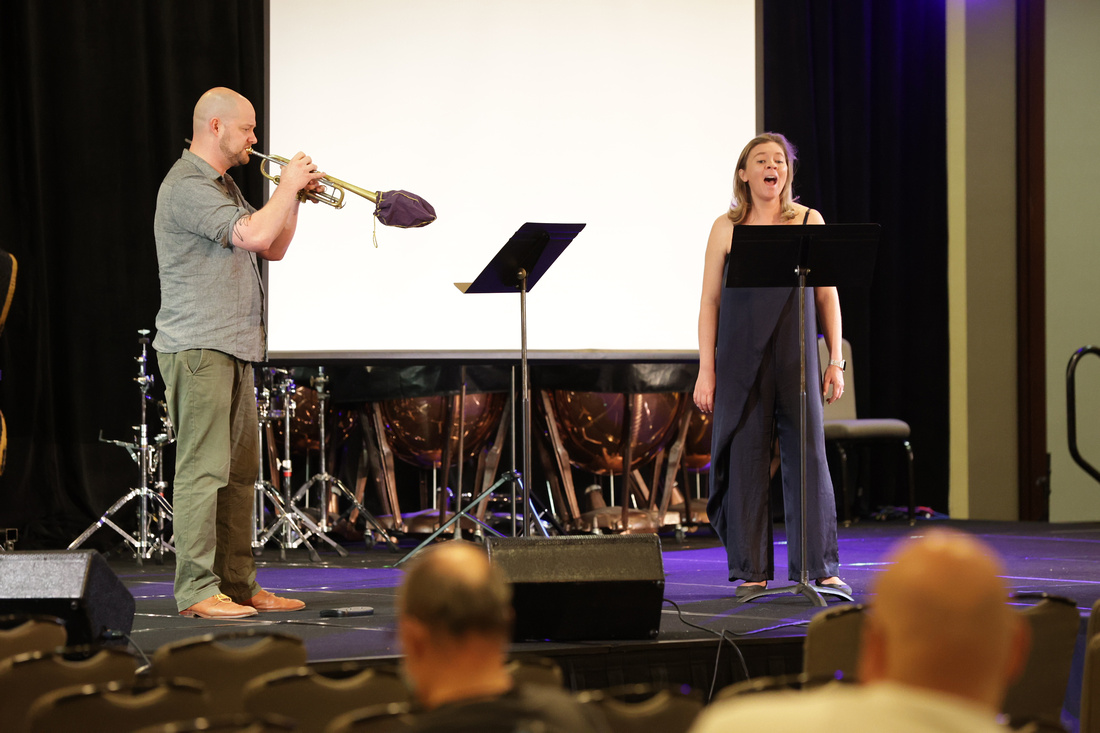
Michael Mergen clinic - A Guide to Cornet Articulation and “March Style”
Dr. Michael Mergen shared a detailed approach to performing in the march style with accurate cornet articulation. Many players are taught to play marches with a “light” and “short” articulation; however, as noted by Mergen, the overly short articulation can affect tone negatively. Additionally, performing a set of marches presents its own physical challenges. From revisiting Arban’s writing, studying different bowing techniques, and recalling his conversations with clarinetists (with whom the cornet typically doubles in marches), Mergen advocates for a longer articulation that mimics the movement of a violin bow. He specifically addresses each type of articulation and how it could be performed in context, resulting in improved style, phrase shape, ease of playing, and beauty of sound. Based on his years of experience performing in “The President’s Own” United States Marine Band, Mergen’s lecture provided new insight and information on performing in the march style on cornet. (Spencer Brand)

Joey Tartell recital - 7 Horns in 60 Minutes
Joey Tartell proved his widely acclaimed versatility, musicianship, and virtuosity with his “7 Horns in 60 Minutes” recital performance. Tartell transitioned between each instrument seamlessly, performing this ambitious and artfully conceived program with nuance and finesse. He began with Turrin’s Escapade on piccolo trumpet, followed by the beautiful, quirky, and challenging Sonata by George Antheil. The unquestionably masterful balance and musical dialogue between Rebecca Wilt’s piano and Tartell’s trumpet, which marked the entire performance, were on full display during Antheil’s Sonata. The next two lovely and relatively obscure pieces (Korngold’s Marietta’s Lied and Longinotti’s Badinerie) were performed on E-flat and C trumpet respectively. The world premiere of William Stowman’s Suite for B-flat Trumpet, Flugelhorn, and Bass Trumpet featured near-seamless transitions between each instrument and inspired writing throughout. Peaslee’s popular Nightsongs (flugelhorn and B-flat trumpet) and Philip Sparke’s Song and Dance (cornet) concluded the program. (Benjamin Hay)
Chloe Swindler lecture recital - Five Works for Trumpet by Black Female Composers
International award-winning soloist Chloe Swindler presented an enlightening session illuminated five works for trumpet by Black female composers. Swindler began by describing the aesthetic qualities of Black American music, such as contrasting timbre, improvisation, and several others. Accompanied by accomplished pianist Miriam Hickman, Swindler performed a program of works by Regina Harris Baiocchi, Mary Watkins, Alice Jones, and Florence Price in the second segment of the clinic. Swindler’s warm tone and highly-skilled playing resulted in stunning performances of these challenging works. In her final remarks, she discussed ways to contribute to a more inclusive and diverse world of trumpet repertoire - accessing Black female composer’s scores, creating recordings of the works, incorporating them into music curricula, and introducing them to new audiences. Swindler’s session provided insightful information regarding the available music by Black American female composers and its importance in trumpet repertoire. (Sarah Cisney)
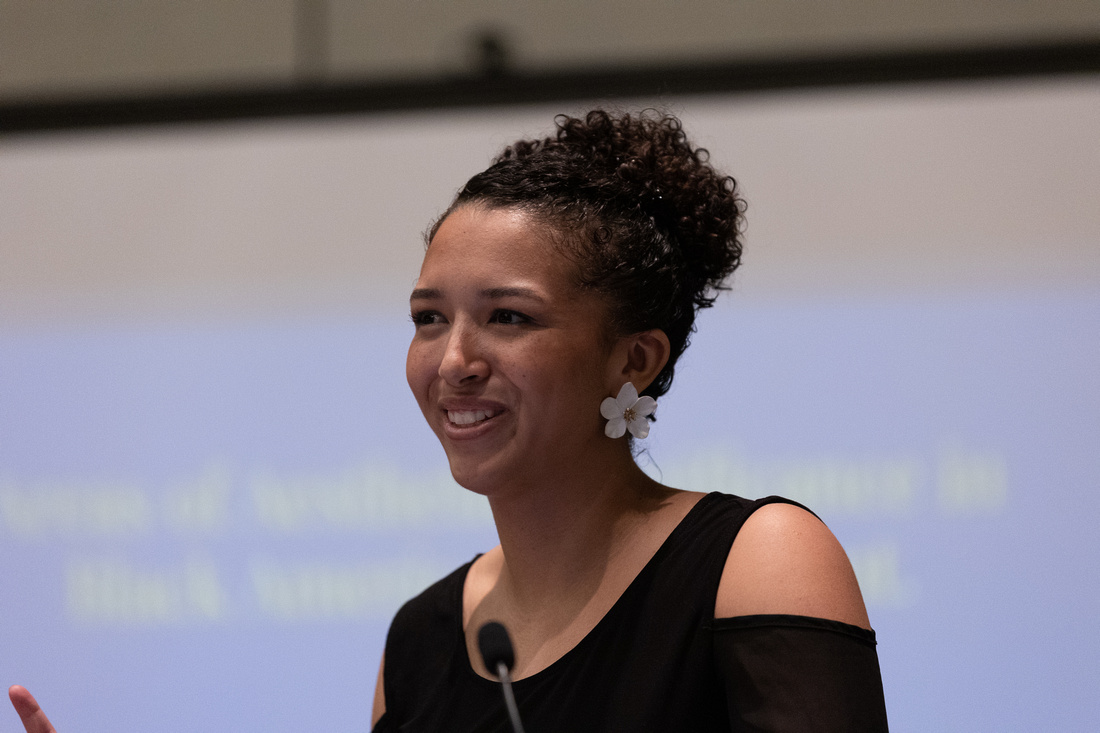
Sebastián Gil Armas recital - Works for Trumpet and Organ by Edward Tarr Series
This recital consisted of music that Sebastián Gil Armas prepared in honor of Edward Tarr. Accompanied by organist Bryan Anderson at the Travis Park Church, the pair performed exceptionally. The recital opened with three short sonatas by Girolamo Fantini, performed on natural trumpet. Armas’s tone oscillated between sweet and brilliant, and his attention to phrasing and color was evident in each piece of the program. Of particular note was Armas’s flugelhorn playing on several of the pieces; his sound blended seamlessly with the organ in a way that demonstrated his superb sensitivity to balance and timbre. This varied program was met with hearty applause from the audience and a renewed appreciation for Edward Tarr’s tireless commitment to the trumpet. (Eli Denecke)

David Bilger clinic - The Orchestra Job: Everything Except the High C
David Bilger began the session by discussing a few prepared remarks touching on some of the important nuts and bolts of the job of an orchestral trumpet player - like how The Philadelphia Orchestra handles part assignments and their process for recent sublist auditions - before moving on to field questions from the audience. He answered many questions on a variety of topics that included the tenure process in orchestras, audition preparation, current trends in trumpet teaching, and characteristics of the best section players. He mentioned more than once the importance of developing the basics of trumpet playing - tone, intonation, and rhythm - and also drove home the importance of staying dedicated to the craft of practicing and preparation. He mentioned that in order to continue growing and advancing as a trumpet player, developing a daily routine and enjoying the mundane aspects of trumpet fundamentals can help players avoid common pitfalls. (Scott Hagarty)
Carrie Blosser clinic - Successful Starts: A Guide to the First Six Months for Beginning Trumpet Players
Dr. Carrie Blosser’s clinic featured numerous tips and tricks to help young students thrive. Blosser offered tips for teaching such basics as breathing, buzzing, and holding the instrument. When teaching the first sounds on the mouthpiece and instrument, she discussed the importance of creating a positive environment. Blosser also had numerous tips for troubleshooting issues with embouchure, air flow, and articulation. One unique tactic she calls “kazoo trumpet,” in which the mouthpiece is held slightly out of the receiver while playing, helps center the sound. Blosser’s approach also included visual aids and relatable examples such as movies and video games the student might enjoy. Throughout the presentation, Blosser emphasized the importance of including and encouraging students from all backgrounds by showing them videos featuring diverse performers playing exciting repertoire. (Marisa Youngs)
Spencer Wallin clinic - Suona la Tromba: Exploring the Performance and Technique of the Baroque Trumpet Aria
Dr. Spencer Wallin’s lecture recital on performance techniques of the Baroque trumpet aria was a refreshing change of pace as he provided insights and tips on performing and teaching Baroque music. Many of Wallin’s suggestions were informed by his personal experience in performing and teaching this music. Collaborators Rachel Wallin (piano) and Margaret Wolfe (soprano) added additional insights into the collaborative process - how trumpet players can be more sensitive to collaborative vocalists and how we can approach this music with a sensitivity that allows the musical interpretation to come through? Additionally, Wallin recommended several early-Baroque trumpet arias (works by Pallavicino, Legrenzi, and Handel) to help young students approach the genre in a way that can lead to success. (Joe Nibley)
Jazz Improvisation Competition Finals
The final round of the jazz improvisation competition featured three outstanding soloists performing for an intimate, yet enthusiastic, audience. In addition to the required tune, Punjab, each contestant included two tunes in their set. Camilo Molina (University of Miami) performed a crisp Up Jumped Spring and Sound of Love; Emerson Borg (UNC Greensboro) performed Evidence and Shame is Pride’s Cloak; and Summer Camargo (The Juilliard School) performed When It’s Sleepy Time Down South and JP Shuffle - the latter an original that she wrote for her father who was in attendance. Adjudication duties were handled by Bria Skonberg, Philip Dizack, and Ansyn Banks. The soloists were backed by a very tight rhythm section of Mike Frank on piano, Peter Paulsen on bass, and Larry Marshall on drums. (Daniel Kelly)
 Female and Non-Binary Identifying Trumpet Summit
Female and Non-Binary Identifying Trumpet Summit
Renowned jazz trumpeter and passionate educator Bria Skonberg led an engaging and empowering summit for female and non-binary trumpet players. Through small- and full-group discussions, attendees shared musical memories of empowerment and discouragement and addressed challenges unique to female and non-binary trumpeters. International award-winning soloist Chloe Swindler voiced her experience as a Black woman in the trumpet community, which resulted in discussion about ways to create spaces in music for both female/non-binary people and people of color. The session closed with advice for young trumpeters from the older generation of female and non-binary players. Skonberg’s meeting was encouraging for all ages and skill levels and provided optimism for continued growth, opportunities, and representation for female and non-binary trumpeters. (Sarah Cisney)
Reception: Non-Pro and Comeback Players
The Non-Pro and Comeback Players meet-and-greet reception was well-attended with participants from all over the United States and Canada. Attendees were introduced to the Non-Pro Players Committee, ITG President Jason Bergman, and President-Elect Ryan Gardner, as well as several ITG past presidents and special guests Jens Lindemann and Ole Edvard Antonsen. For the first time in three years, members of the Non-Pro and Comeback Player community were able to reconnect in person, sharing stories of their travels and the most anticipated events on their ITG Conference itineraries. Attendees were able to discuss and coordinate their attendance at the remaining Non-Pro Player events. (Julia Bell)
Evening Concert - Monarch Brass
The Wednesday evening concert opened with a dramatic, angular fanfare by Kathryn Salfelder entitled Prospect Hill: Flourish for Brass, which showcased the intervallic virtuosity of the Monarch Brass Ensemble, under the direction of Maj. Michelle Rakers (USMC-retired). The fanfare segued into Daniel Drage’s arrangement of the beautiful Holberg Suite, originally composed by Edvard Grieg. This work provided moments for individual sections to be in the spotlight as each movement utilized a unique combination of color and style. The full ensemble then left the stage, giving way to a trumpet ensemble that performed Susan Slaughter’s arrangement of Amazing Grace with Slaughter conducting. Each phrase allowed for a new soloist to present their own beautiful timbre and grace through this traditional melody. The ensemble then rejoined the trumpeters on stage to present Samuel Barber’s Mutations from Bach. This piece once again highlighted the impeccable artistry that each performer and section harnessed. Barber’s work presented the unaltered melody in the opening and then allowed it to mutate and twist throughout the entire piece. The ensemble again quickly left the stage, leaving only a duo of one euphonium and tuba to perform Bach’s wonderful Two Part Invention No. 4, arranged by Chris Sharp. This uniquely fun and jazzy duet allowed the low brass to have an uplifting and joyful moment in the spotlight that helped cleanse the palette for the final pieces of the concert. Paola Prestini’s Wave began with haunting sounds of wind and muted low-brass drones that were counterpointed with hushed high-brass chord clusters. This dichotomy of sounds and motifs then began to layer and build upon one another, bringing a unique blend and balance of timbres was enhanced by the sheer power that only a full brass ensemble of this caliber can provide. The concert closed with an epic composition by film composer Bruce Broughton. His Fanfares, Marches, Hymns, & Finale truly showcased the virtuosic power and subtle diverse timbres of the mighty Monarch Brass. Each movement provided the audience with a new aural landscape that gave way to emerging soloists and section features that intertwined through acrobatic fanfares and powerful brass sonorities. Broughton’s composition truly allowed the ensemble to showcase their power, virtuosity, diversity in color, and ensemble precision that undoubtedly marks their position as one of the top brass ensembles in the world.
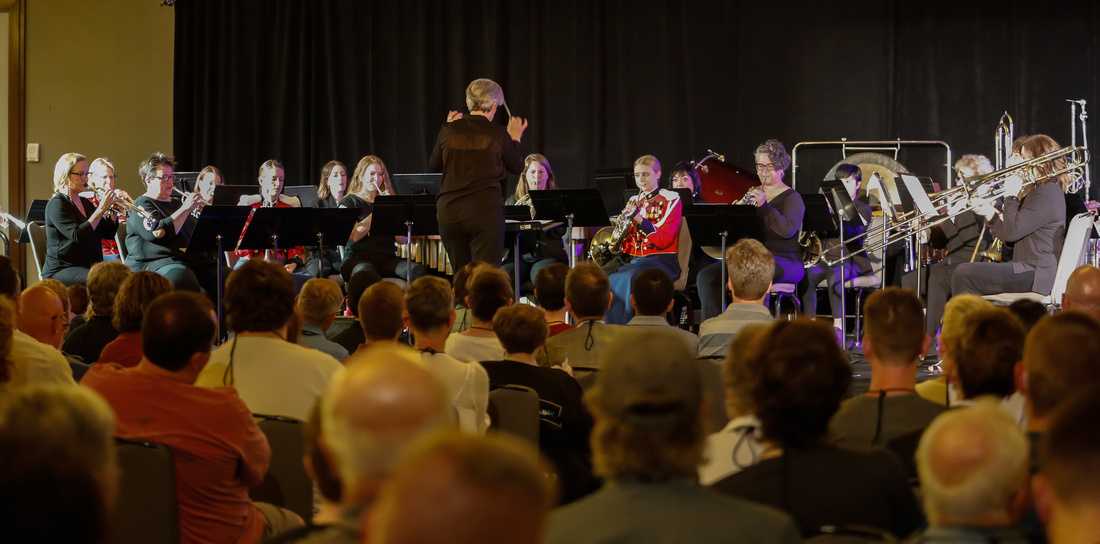
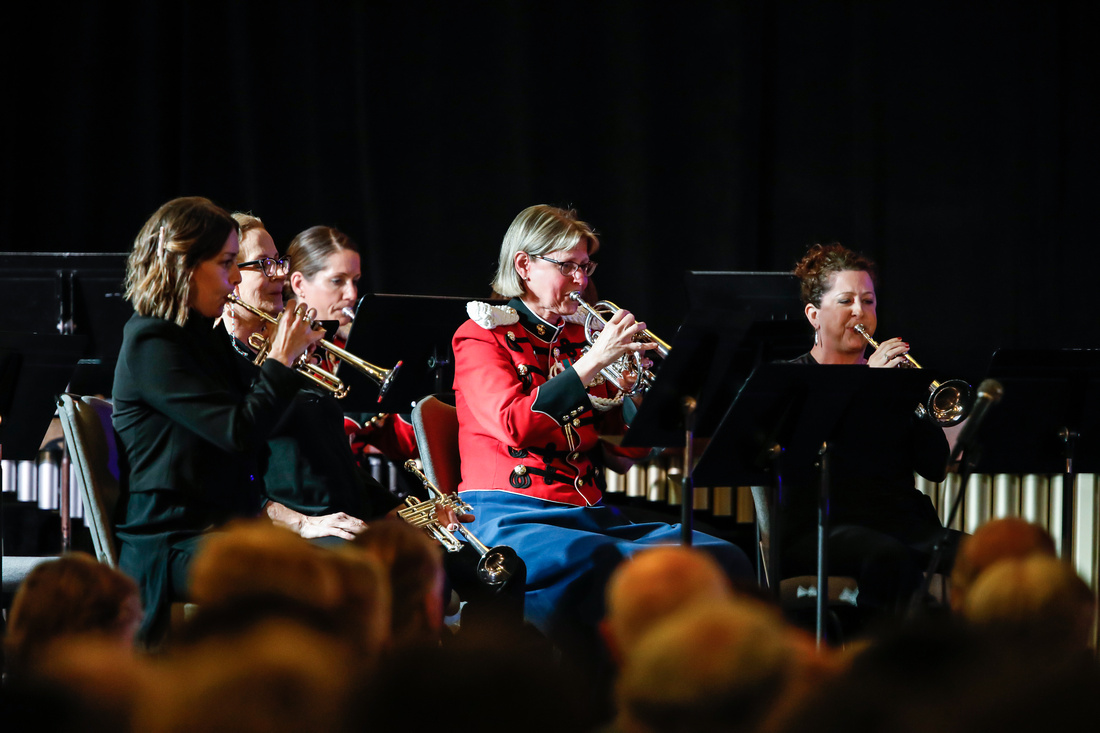
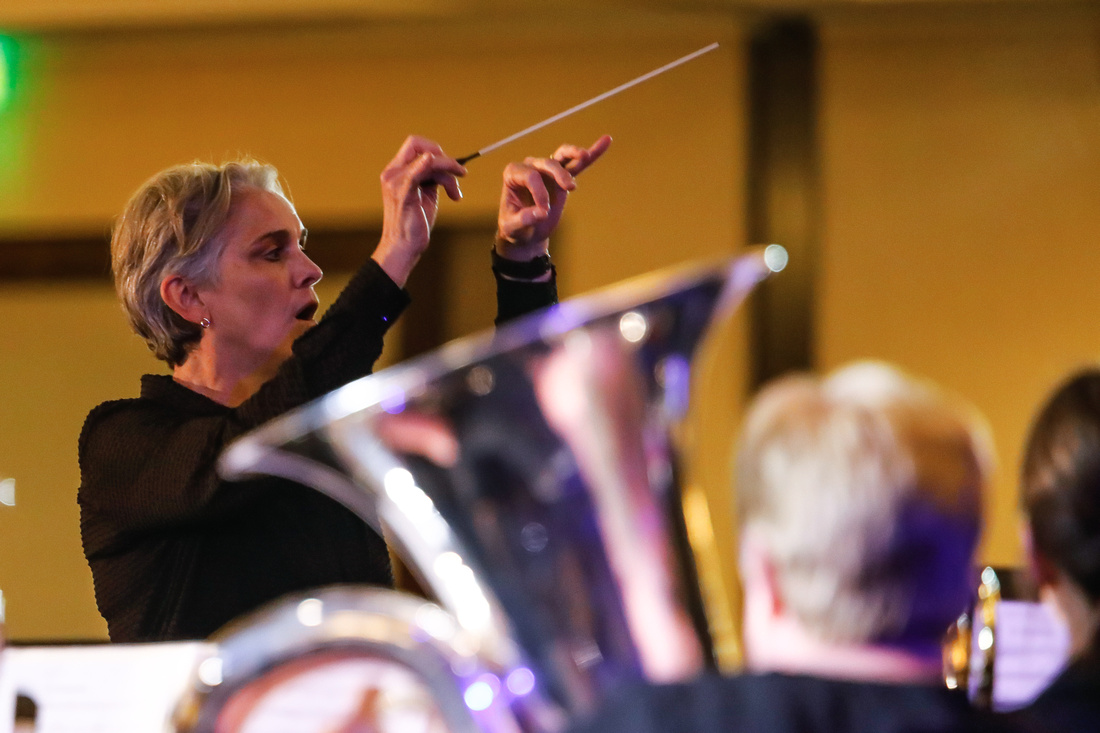
Also during this program, ITG President Jason Bergman presented Carole Dawn Reinhart with the ITG Honorary Award and presented the winners of the jazz improvisation and wind band excerpts competitions. (James Peyden Shelton)
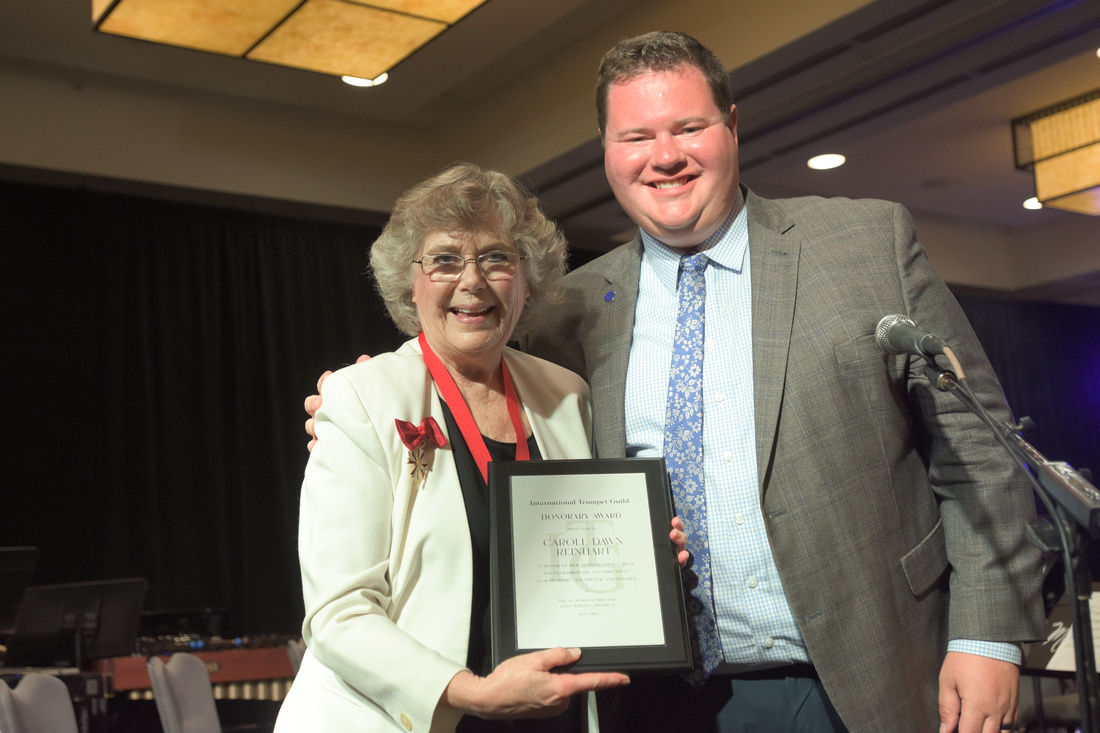
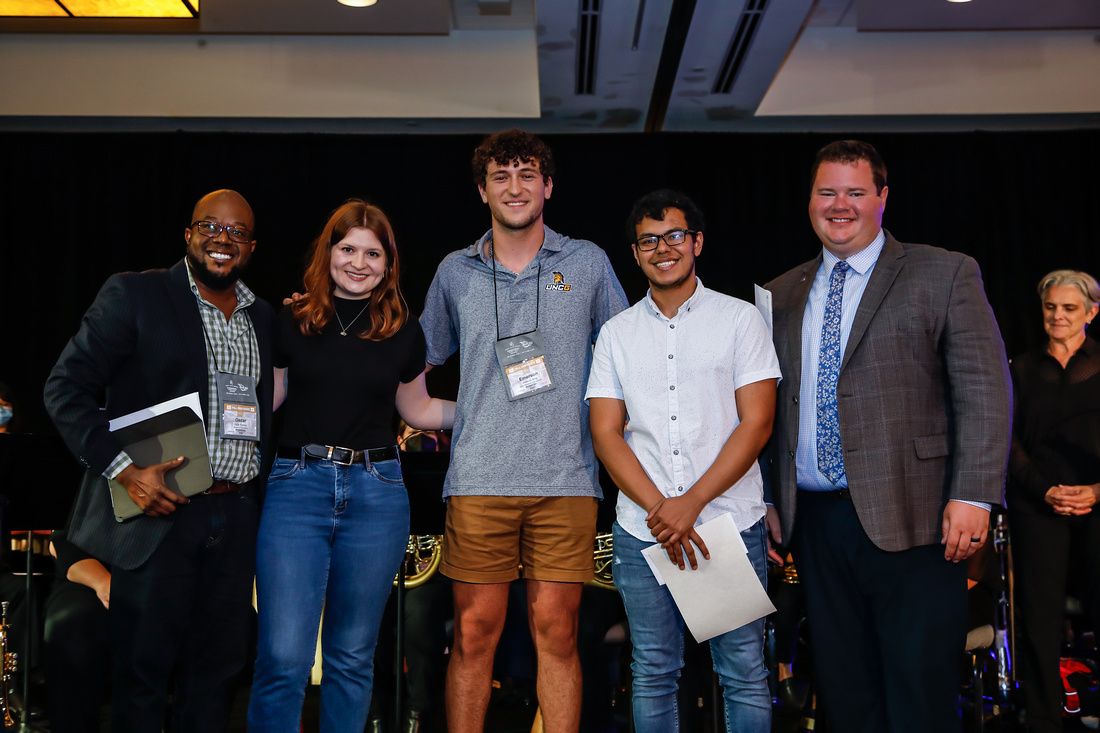

Jam Session - Eric Siereveld
Eric Siereveld hosted a late-night jazz jam session featuring Mike Frank on piano, Peter Paulsen on bass, and Larry Marshall on drums. Siereveld opened the session by performing a jazz tune to warm up the audience, featuring solos from each member of the rhythm section, who displayed their mastery of improvisation. Siereveld certainly displayed musical brilliance and beautiful sound in the opening tune. Following that, members of the audience signed up to perform a tune of choice with the rhythm section. There were trumpet players of all ages and experience levels playing various jazz standards, making the jam a unique experience. Throughout the night, each performer excelled, which made the session a great event not just for the performers, but for the audience as well. (Javian Brabham)
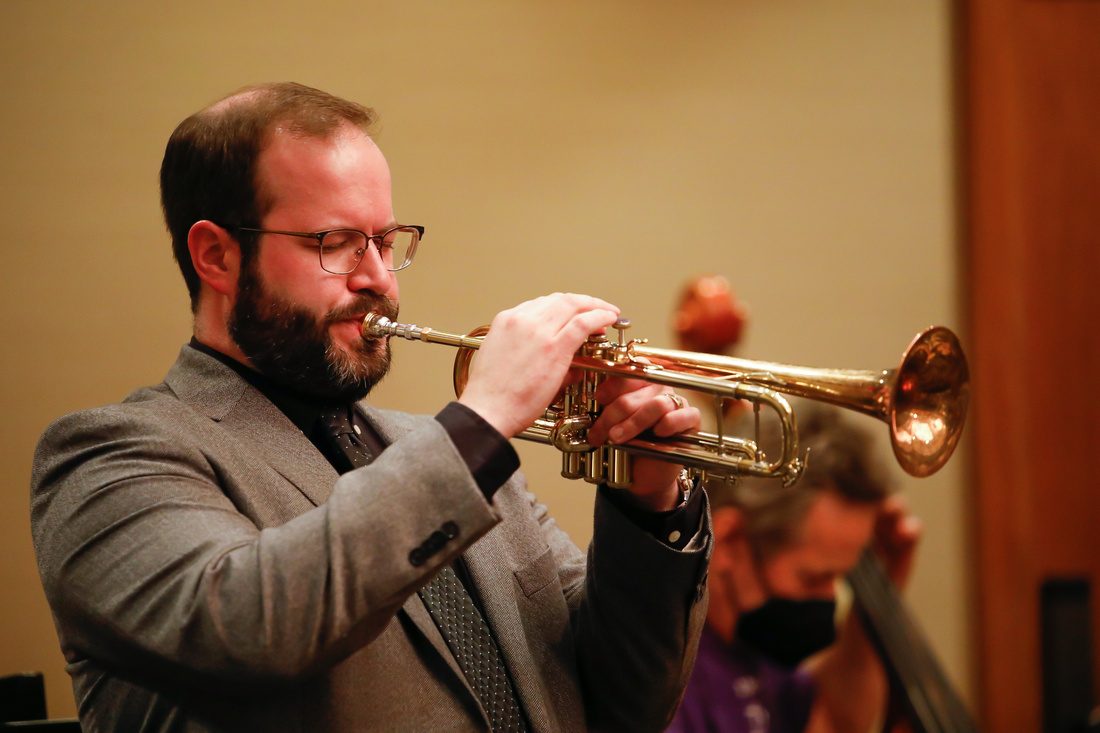
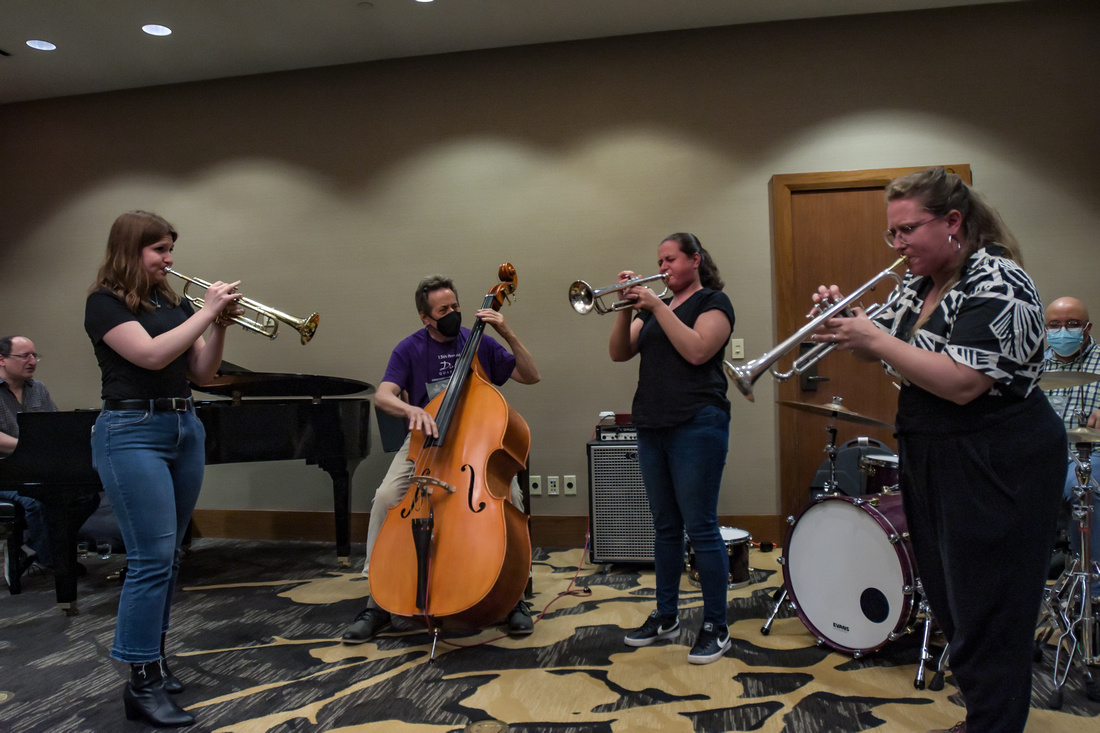
Click here for more photos from the ITG Conference
]]>
Special Daily Report • Compiled by Peter Wood
Photos by Denny Schreffler, Josh Rzepka, Benjamin Lowe, Ryan Berndt, Jeff Grass, and Michael Anderson
Tuesday, May 31, 2022
This opening evening of the 46th annual ITG Conference, our first in three years, was filled with the usual sense of eager anticipation of the wonderful trumpet-related events to come over the next four days and five nights. The Hyatt Regency River Walk in San Antonio is a warm, welcoming hotel with great restaurants and historical sights all around. As participants poured in throughout the afternoon, there were plenty of smiles, handshakes, hugs, and laughs to go around. After the opening mass trumpet ensemble fanfare, led by Marie Speziale, and the evening concert featuring Mariachi Nuevo Tecalitlán and the winners of the 2022 Mariachi Vargas Extravaganza competition, the socializing continued with an enjoyable late-night open jam session. Expectations are high for a another memorable conference!
Click here for more photos from the ITG Conference
Opening Fanfare: Mass Trumpet Ensemble
The 46th Annual International Trumpet Guild Conference opened with a mass trumpet ensemble performance led by renowned trumpeter/pedagogue Marie Speziale. In solidarity with our Ukrainian brothers and sisters, the performance opened with an arrangement of the Ukrainian National Anthem. The arrangement, by James Olcott, began with a warm, rich solo played by Brianne Borden. The performance concluded with a lively rendition of David Vess’s Cometsong. The percussive, quick-paced, and very attractive piece was a very appropriate start to an exciting, enriching conference. (Nathalie Mejia)
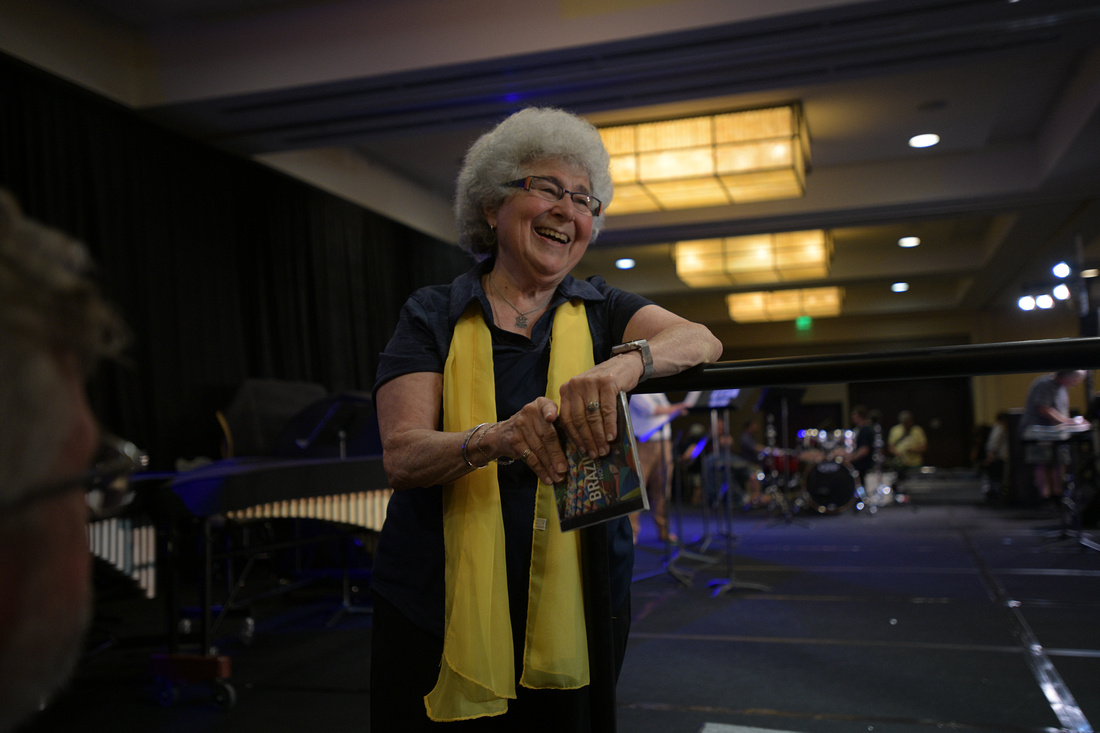
Opening Concert: Mariachi Nuevo Tecalitlán
The opening concert for the Conference will be remembered as not only the first mariachi concert ever to open an ITG Conference, but also as one of the liveliest. The energy from the performers on stage instantly connected with the audience to create an excitement that fueled the concert from start to finish.
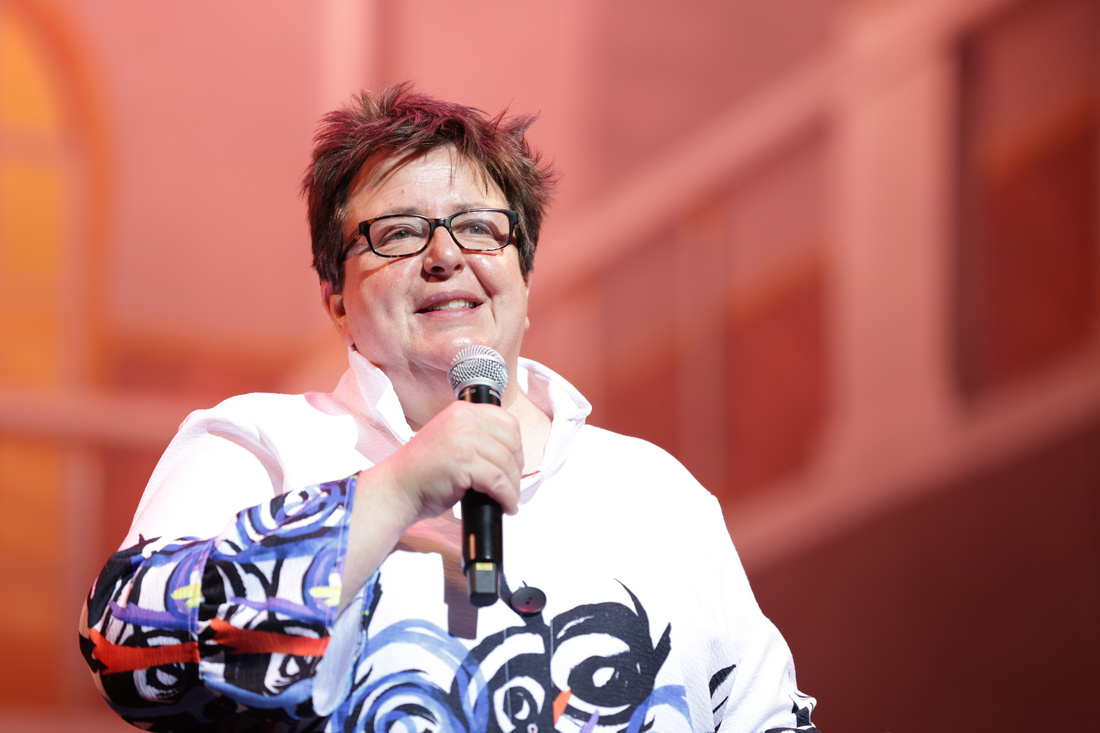
Before Mariachi Nuevo Tecalitlán, the evening’s headliners, took the stage, ITG President Jason Bergman welcomed everyone to our first in-person Conference since Miami in 2019 and presented the ITG Honorary Award to David Bilger, who has just retired after 27 years in his principal trumpet position in The Philadelphia Orchestra to become Professor of Trumpet at Northwestern University's Bienen School of Music.
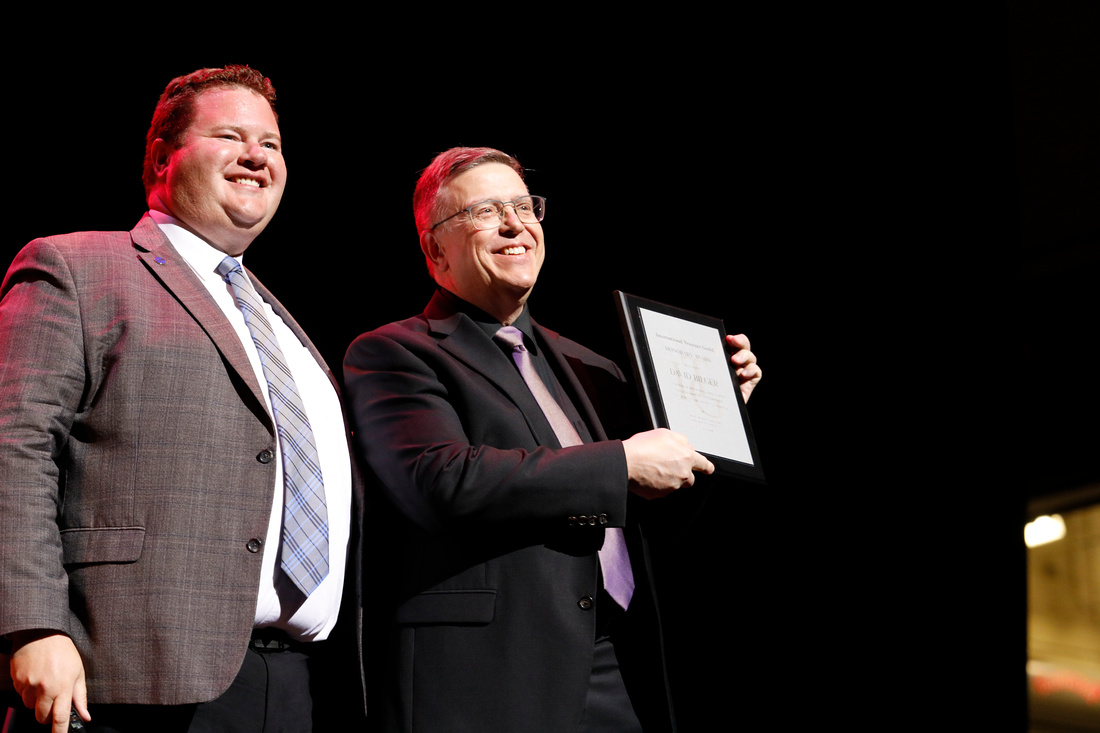
Following that presentation, the student winners of the 2022 Mariachi Vargas Extravaganza performed. The groups Mariachi Escandon from Roma Middle School, Mariachi Cascabel from Rio Grande City High School, and Mariachi Plata from the College of Southern Nevada performed. All of the student groups displayed a highly impressive level of musical maturity and artistry, delivering first-rate performances.
Mariachi Escandon’s opening tema was full of beautiful chords and high energy, showcasing their highly polished sound: beyond the expectation of a typical middle school ensemble. They then performed El Astillero with refined duets, featuring a commanding trumpet solo with the soloist performing like a seasoned veteran.
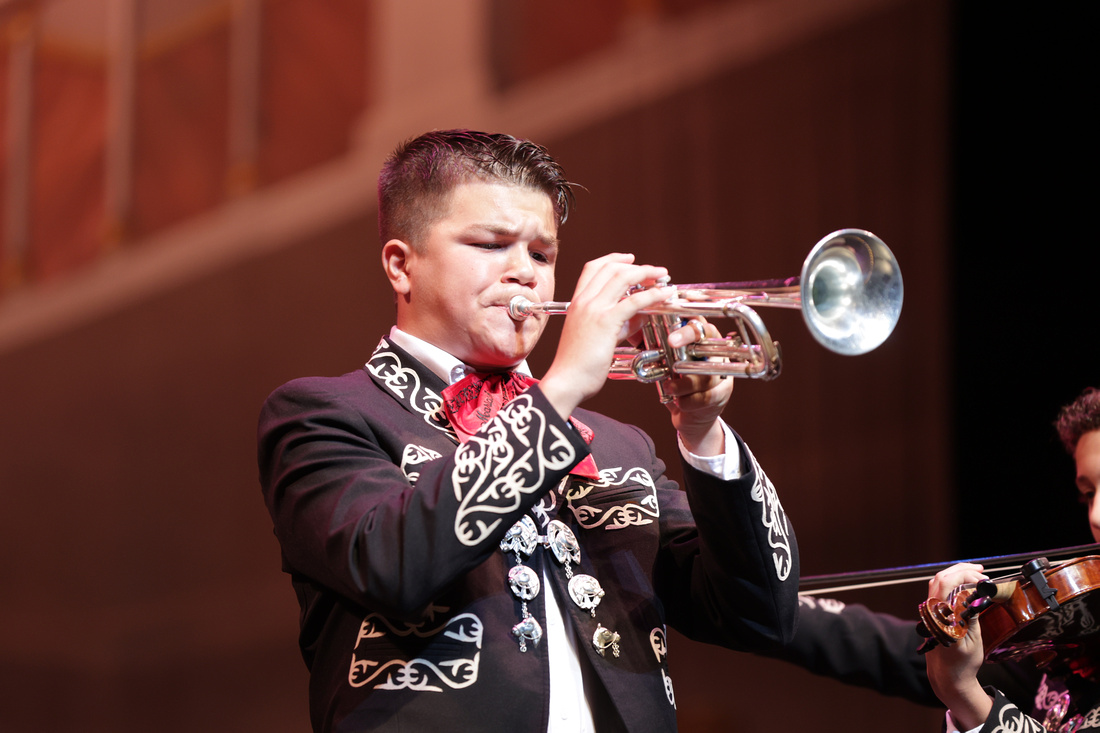
Mariachi Cascabel accompanied the winner of the Vargas high school vocal competition, Melanie Olivarez from La Joya High School. Olivarez came out with immense power, with her voice filling Lila Cockrell Auditorium with her opening of two pieces, Los Laureles. Mariachi Cascabel performed three more songs on their own that highlighted impeccable trumpet work, fantastic rhythmic groove, and great singing by the soloists and the ensemble.
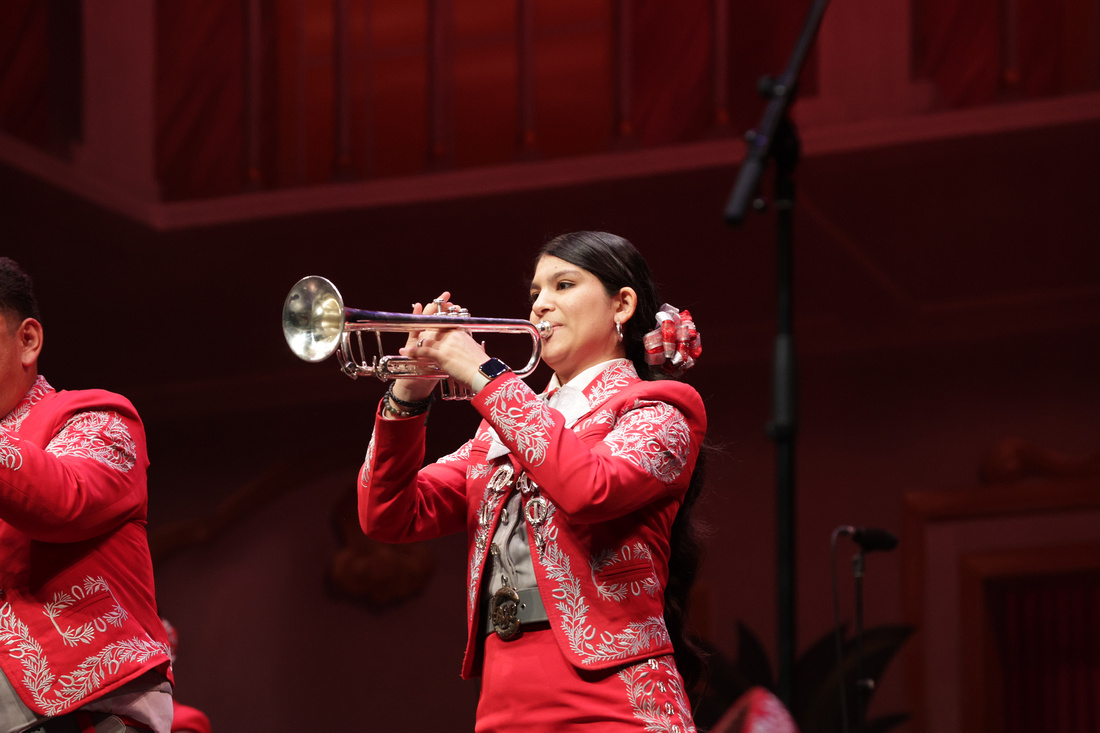
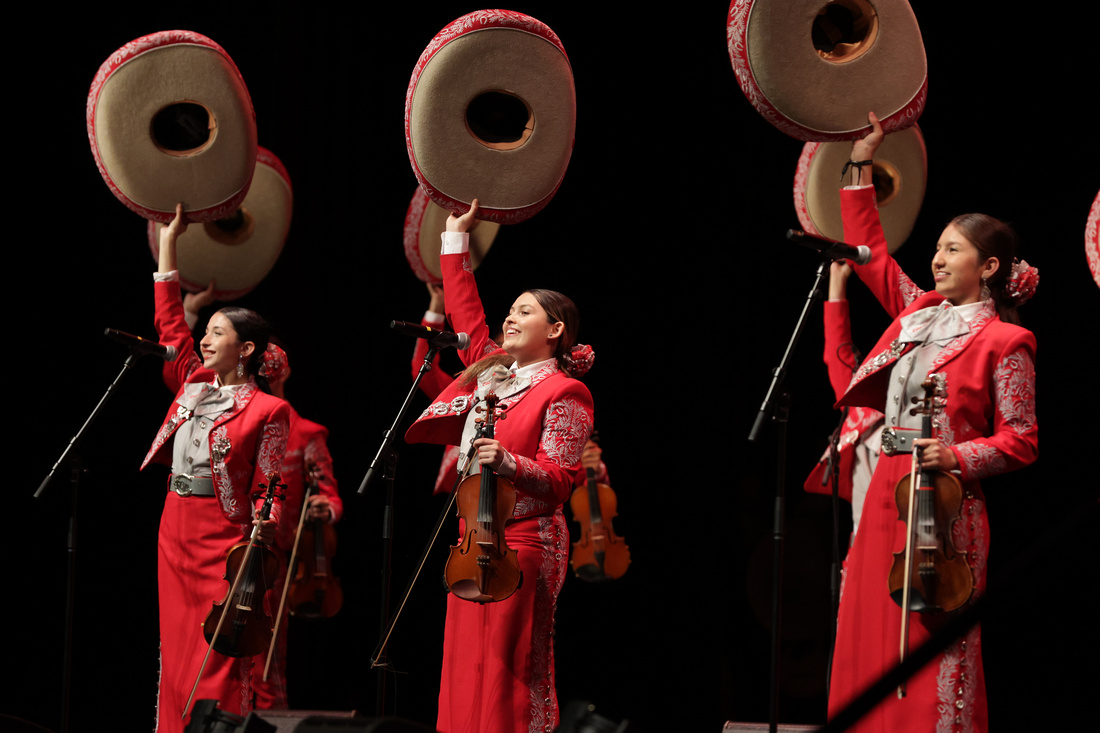
Mariachi Plata was the final student group. Their male soloists on Que Linda es Mexico drew the audience in with true mariachi charisma. Popurri de mi tierra gave the trumpets an opportunity to dazzle with their precision.
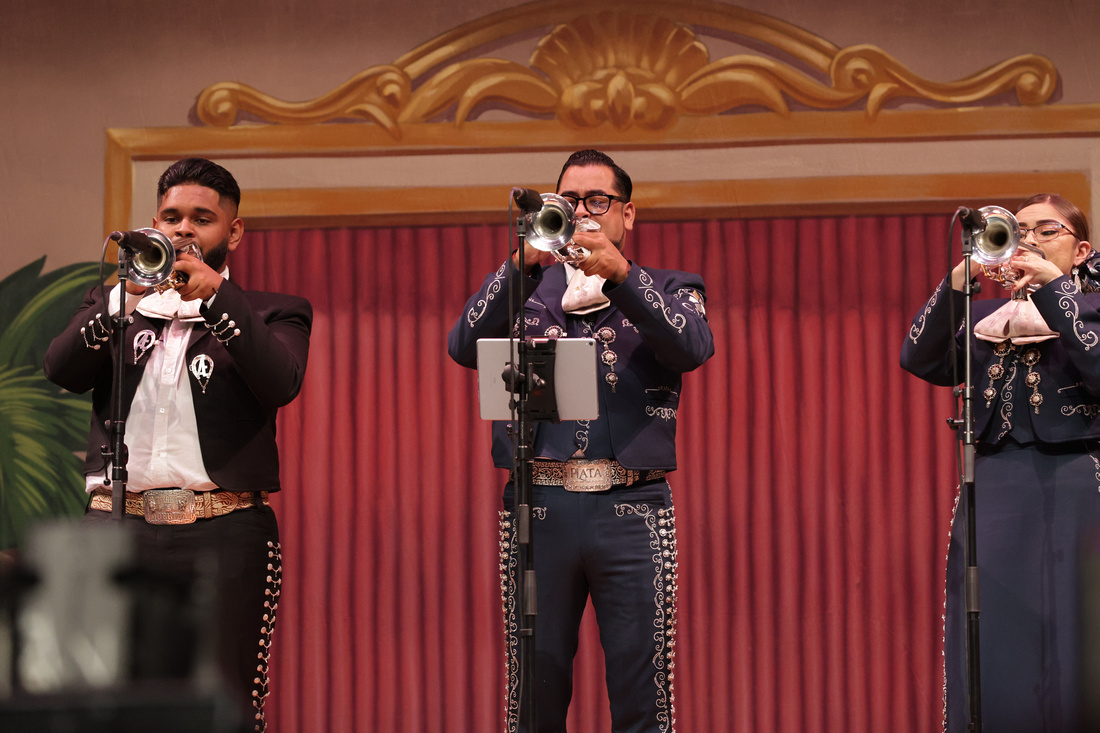
As polished as the Vargas-winning student ensembles were, Mariachi Nuevo Tecalitlán’s performance demonstrated why they are one of the top mariachis in the world. Their performance was specially crafted for the ITG crowd to be heavier on instrumentals - and especially la trompetistas. With a connection to current events, the first song after the tema was Amor Eterno, dedicated to those affected by the tragedy in Uvalde, only 80 miles from San Antonio. The audience all turned on the flashlights on their mobile phones to participate in the dedication. Mi Amor es una trompeta and Paso dobles were major features for the trumpet trio and drew in the audience with their treatment of melodies familiar to all trumpet players - even those who are not mariachi aficionados. One of the more fun songs of their set was El Niño Pedido, (The Mischievous Child). The trumpeters went to different sides of the auditorium to perform interludes while walking gradually back to the stage. Their performance closed with a showpiece that demonstrated the incredible virtuosic prowess of these musicians. The solos by the violins, arpa, and trumpets would have been inspiring to even the most staid of audiences. The crowd immediately leapt to their feet, demanding more.
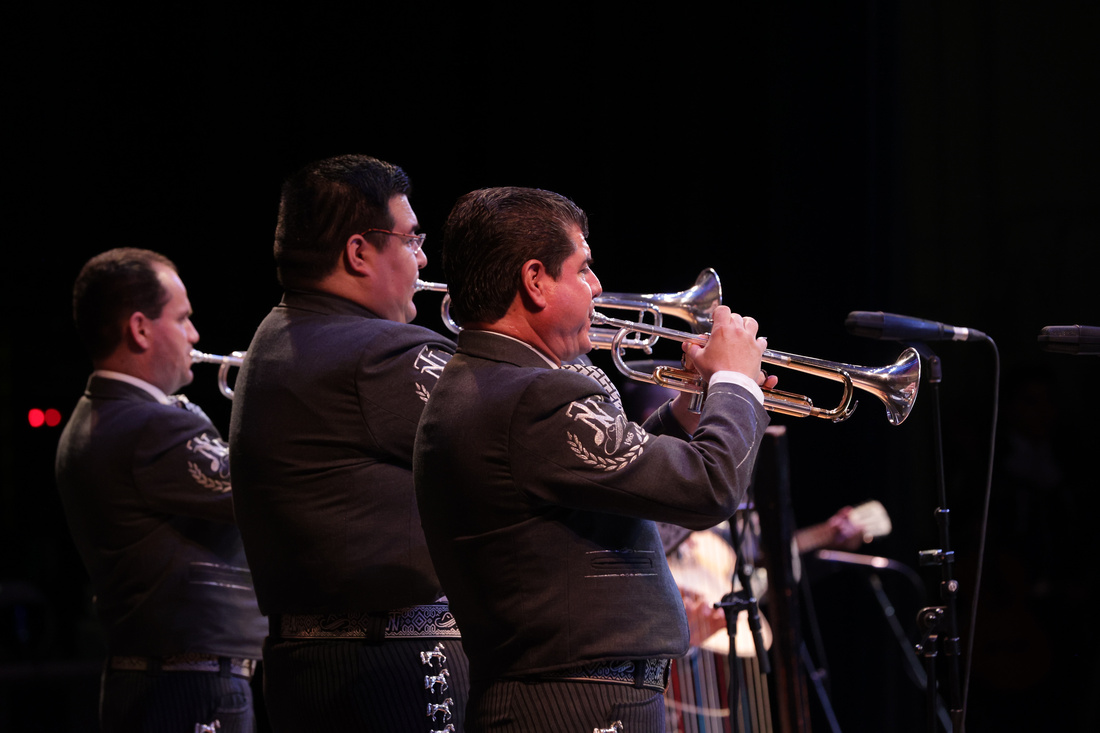
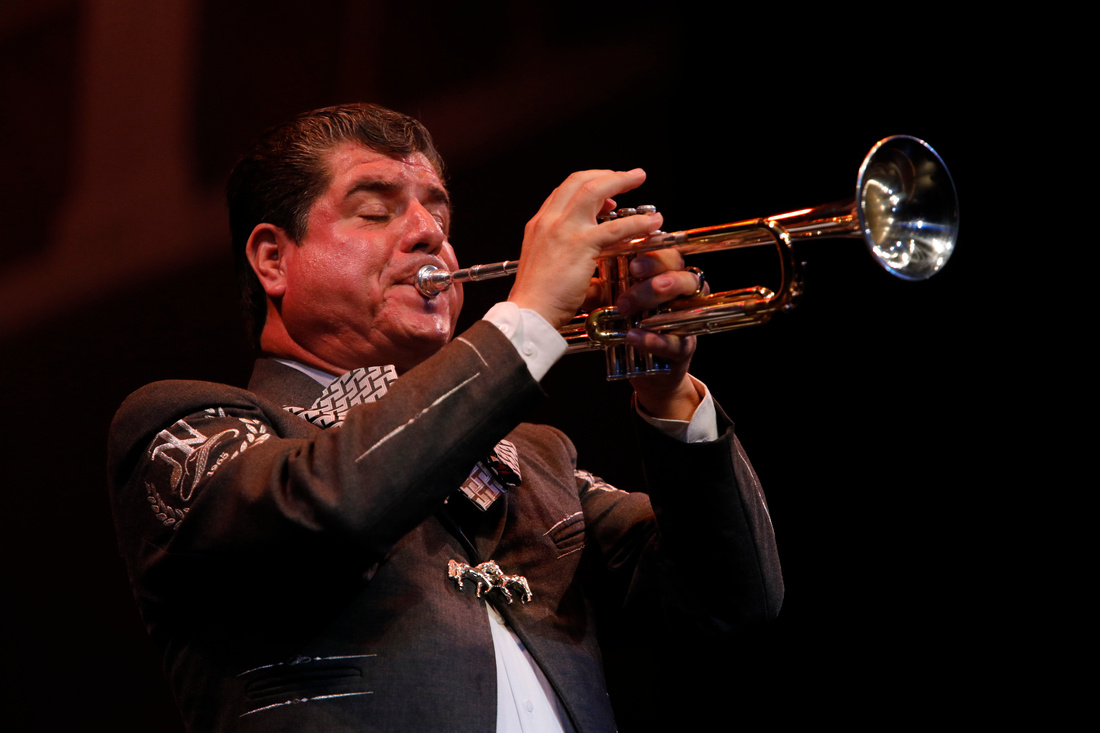
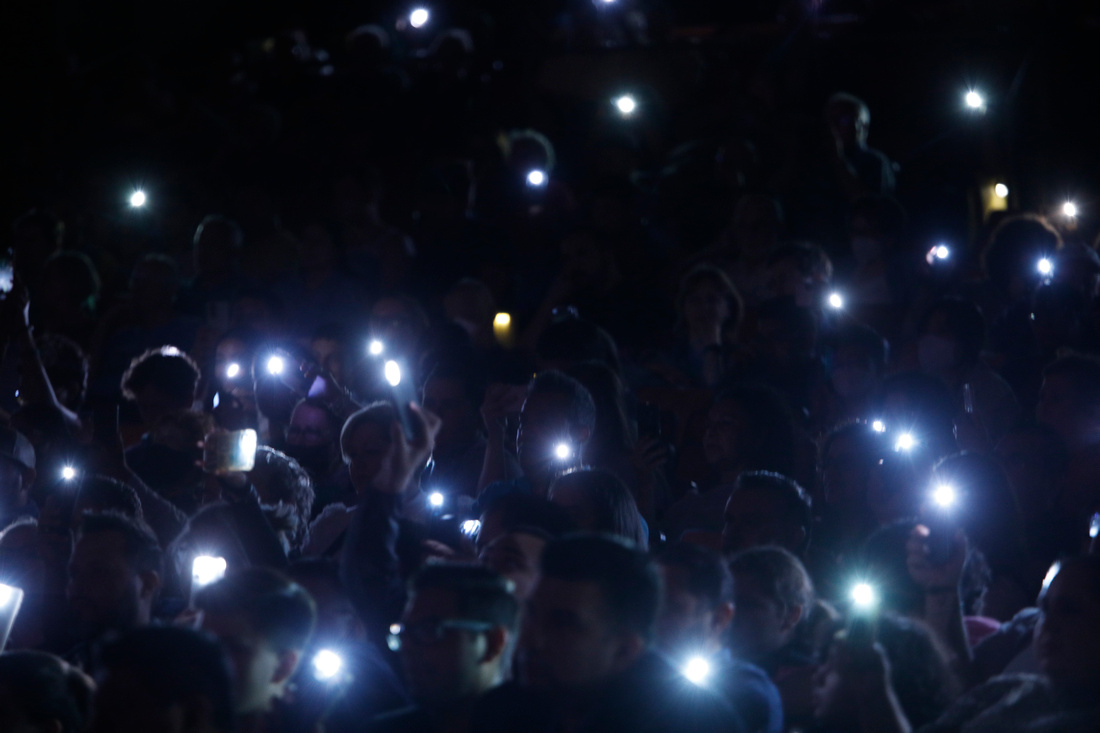
Given the top-level performances and enthusiastic engagement of the audience, concerts and experiences like these should continue to be cultivated by ITG. (Kyle Millsap)
Jam Session: Trent Austin
Trent Austin opened the first Conference late-night open jam session with a Dave Brubeck tune featuring Mike Frank on piano, Peter Paulsen on bass, and Larry Marshall on drums. With his jovial and energetic personality, Austin created a cool, relaxed, and welcoming atmosphere for the session. Philip Dizak and Rich Willey were up on the next tune to solo, followed by a strong showing from several college students and some older, more experienced players. Austin did a fine job getting people to play and have a good time, and it all turned out very well for a highly enjoyable first jam session of the Conference. (Nathan Shadix)

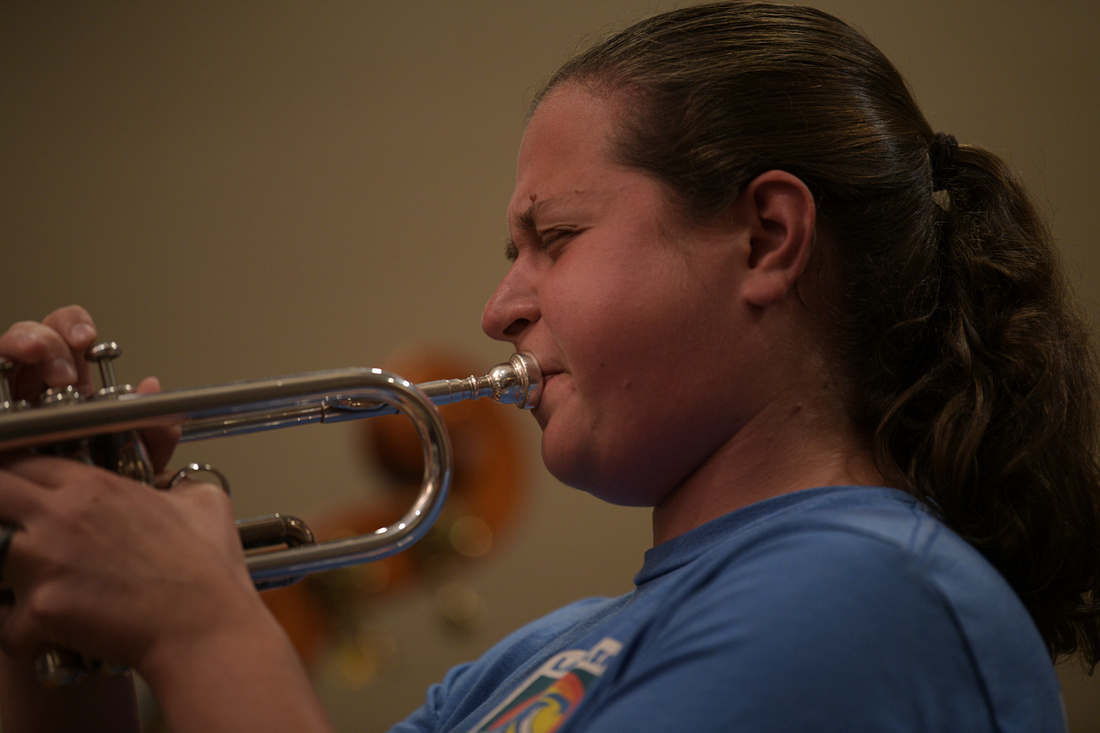
Click here for more photos from the ITG Conference
]]>
Special Daily Report • Compiled by Peter Wood
Photos by Michael Anderson, Norman Black, Benjamin Lowe, and Donald Sorah
Conference Prelude Performances
* Indicates premiere performances.
Groups are listed alphabetically.
Click here for more prelude ensemble photos
Ensamble de Trompetas de la Universidad de Costa Rica
Juan C. Meza Solano, director
Luis Araya, Juan Meza, Jairo Vega, Jesus Campos, Jose Loria, Fabian Mata, Kenny Casanova, Cristian Sarmientos, and Juan Vargas, trumpets
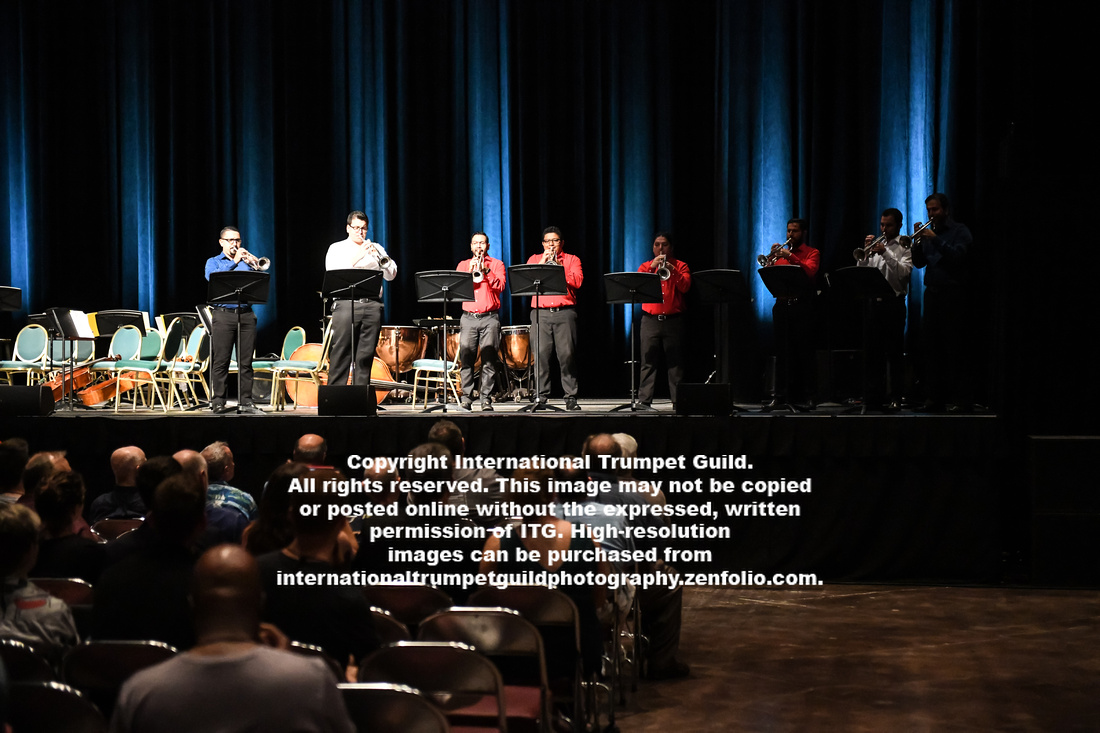
Intrada Dramatica by Joe Price
The Ensemble de Trompetas de la Universidad de Costa Rica took the stage and commanded the audience's attention with a burst of rhythmically propulsive declamations. Playing with impeccable precision, intonation, and balance, the group’s finely tuned chords were enhanced by their warm, burnished sound. (EK)
CF Trumpet Ensemble, College of Central Florida
Trey Moore, director
Jaysander Rodriguez, Christian Tomaszewski, Joe Pacifici. Lily D. Stidham, Reece Salmon, and Trey Moore, trumpets
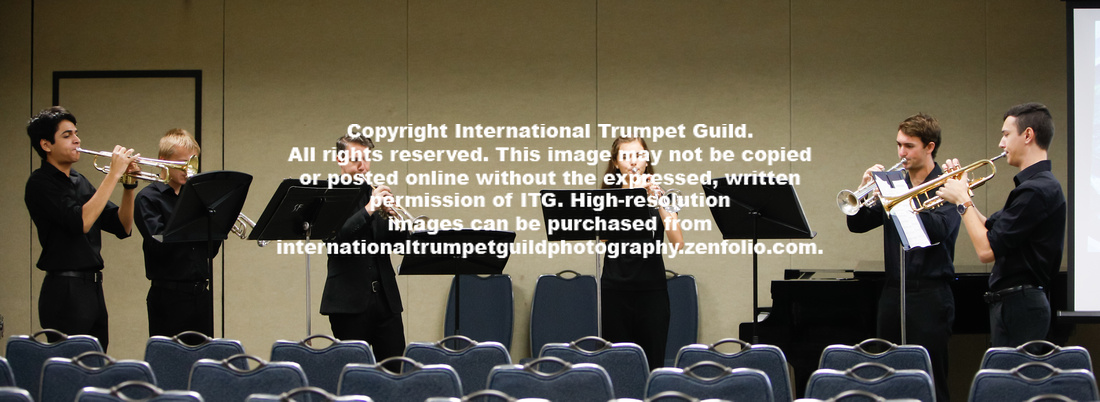
Dürrenhorn Passage by Kevin McKee
The College of Central Florida’s CF Trumpet Ensemble gave a superb rendition of Kevin McKee’s Dürrenhorn Passage. Their performance grabbed the audience’s attention immediately with a powerful and striking sound that was accented by tremendous precision from each performer. Their ability to change colors throughout each section of the work was fantastic and provided a unique musical journey for the listener. Their electrifying interpretation of their challenging piece gave a wonderful transition into the session’s presentation and left the audience on the edge of their seats. (JPS)
CNU Trumpet Ensemble, Christopher Newport University
Dr. Kelly Rossum, director
Sarah Kay Biser, Charles Smith, Daniel Berry, Tyler Brookhart, Margaret Metts, Thomas Flynn, Emily Grace Louis, Jacob Sheffield, and Hayden Cameron, trumpets
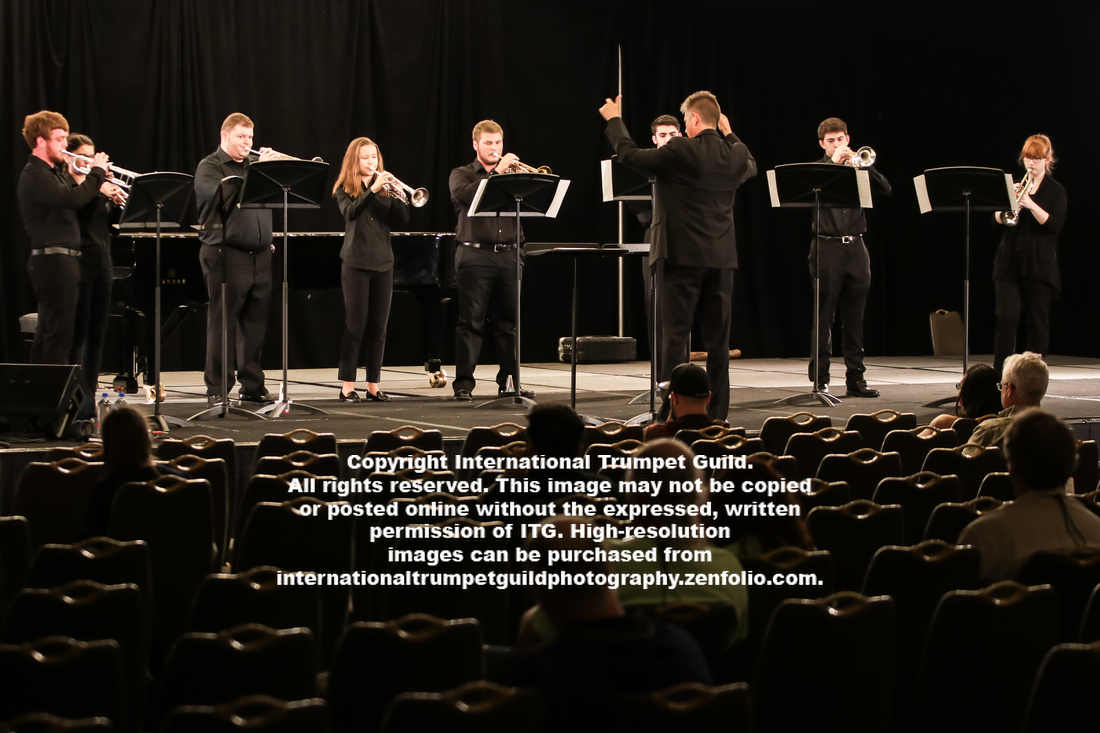
Legacy: Welcome to the Circle by Kelly Rossum
Dr. Kelly Rossum conducted his own composition honoring the “circle of fellowship and shared experiences that occurs at ITG conferences.” The piece featured colorful harmonies throughout that often morphed into ostinato moving lines, building momentum. His open fifths and suspended fourths created a pandiatonic effect as they rang like bells, and the layered double-tonguing passages built to a jarring climax. The ensemble should be commended for embracing such challenging harmonies and dissonances with confidence while delivering a musical performance with poise. (NV)
Duquesne University Trumpet Ensemble
Professor Chad Winkler, director
Joseph Beaver, Kevin Skinkis, Robert Jarsulic, Matthew Piato, Thomas Houghton III, Ryan Fulton, Mikayla Justen, Mikki Cersosimo, Amy Bertsch, Abigail Iksic, Matthew Eisenreich, Zach DeLuise, and Michael Zech, trumpets
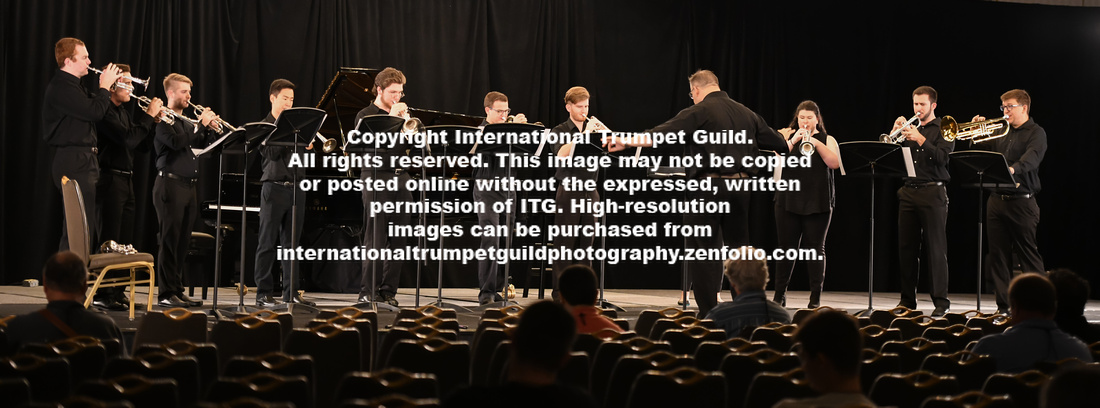
Finlandia by Jean Sibelius, arr. Brian Buerkle
The Duquesne University Trumpet Ensemble, under the direction of Chad Winkler, opened the program with Finlandia by Sibelius, arranged by Brian Buerkle for eleven trumpets, including flugelhorn and bass trumpet. A full, rich opening led to the gorgeous, popular melody that floated on top of the foundation established by the ensemble. The group beautifully executed this new setting of the beloved standard. (WK)
Schwob Trumpet Ensemble, Columbus State University
Dr. Robert Murray, director
Dylan Boyd, Stephen Burden, Douglas Escobar, Brandon Fortson, Patrick Lindsey, Nathan Moore, Rashaan Skrine, Harold Villa, Steven Vought, and Adam White, trumpets
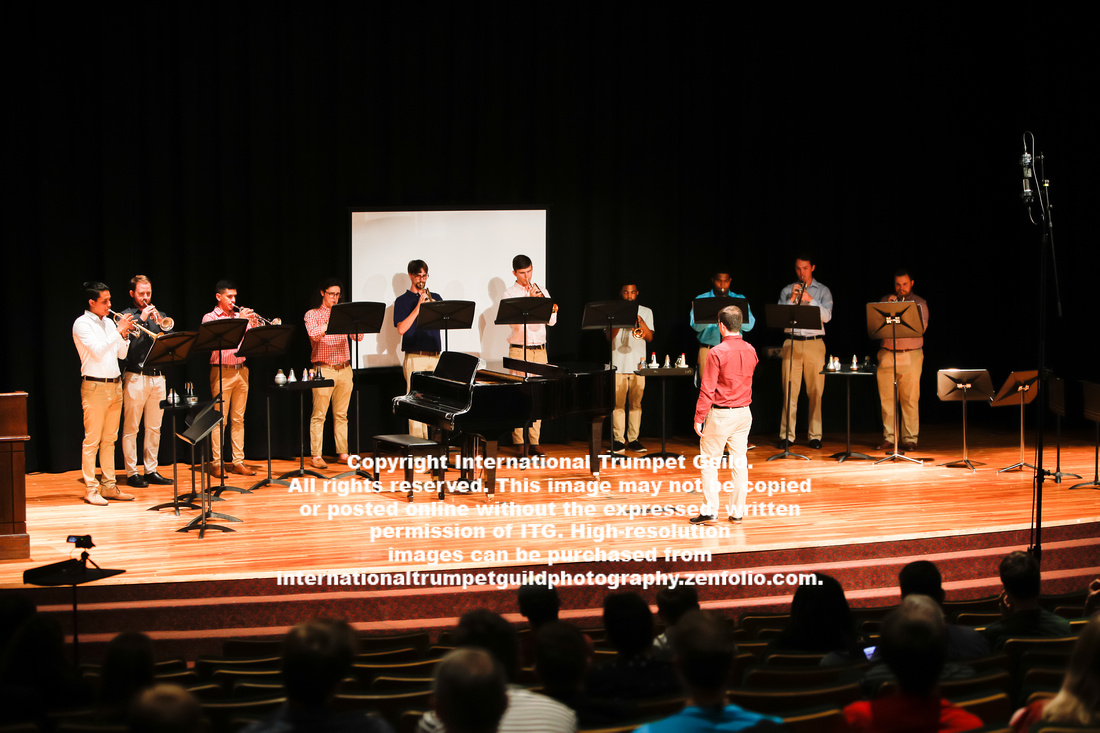
Subduction by Brandon Dicks
The ten-member trumpet ensemble from the Schwob School of Music at Columbus State University, under the direction of Dr. Rob Murray and conducted by Brandon Dicks, performed Dicks’s own Subduction. The subdued opening gave way to a dramatic crescendo, and the pairing of Harmon and cup mutes created a complex timbre. The piece showcased antiphonal choirs as well as solo and full-ensemble playing. (MM)
Emporia State University Trumpet Ensemble
Dr. Gary D. Ziek, director
Wyatt Campbell, Clayton Happy, Katelyn Hess, Ben Ortstadt, Bailey Poage, Joe Ruiter, Tristan Stevens, Lucy Steyer, and Robert Nance, trumpets; Hunter Poage, trombone; Annjela Abbey, bass trombone
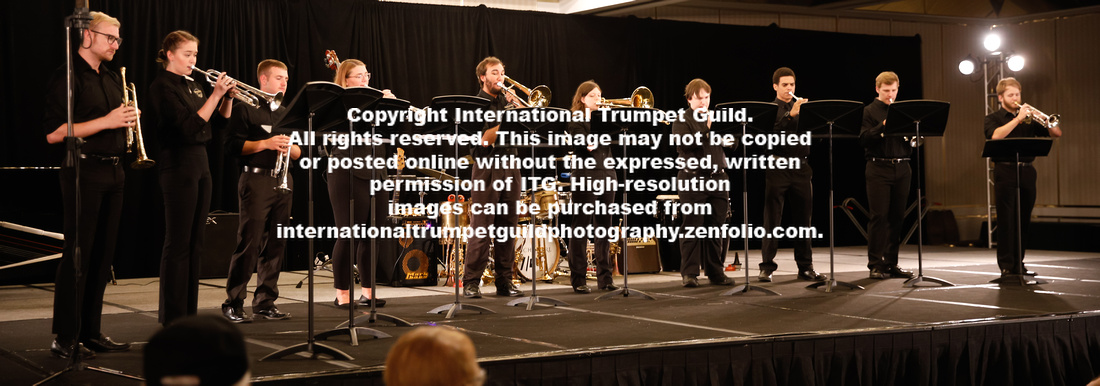
“Habanera” from Carmen by Georges Bizet, arr. Gary Ziek
Ceremony by Gary Ziek
The Emporia State University Trumpet Ensemble (plus two trombones) opened their performance with Dr. Gary Ziek’s arrangement of “Habanera” from Carmen. The arrangement featured great interplay among the ensemble and captured the spirit of the original. Their second piece was an original composition by Ziek, titled Ceremony. The group showcased their talents well with great excitement and energy, and their performance served as a great lead-in to the concert that followed. (KM)
University of Florida Trumpet Ensemble
Dr. Randy Lee, director
Ben Elgan, Eli Denecke, Adrienne Widener, Josh Drourr, Brendan Sweeney, and Jake Hardy, trumpets
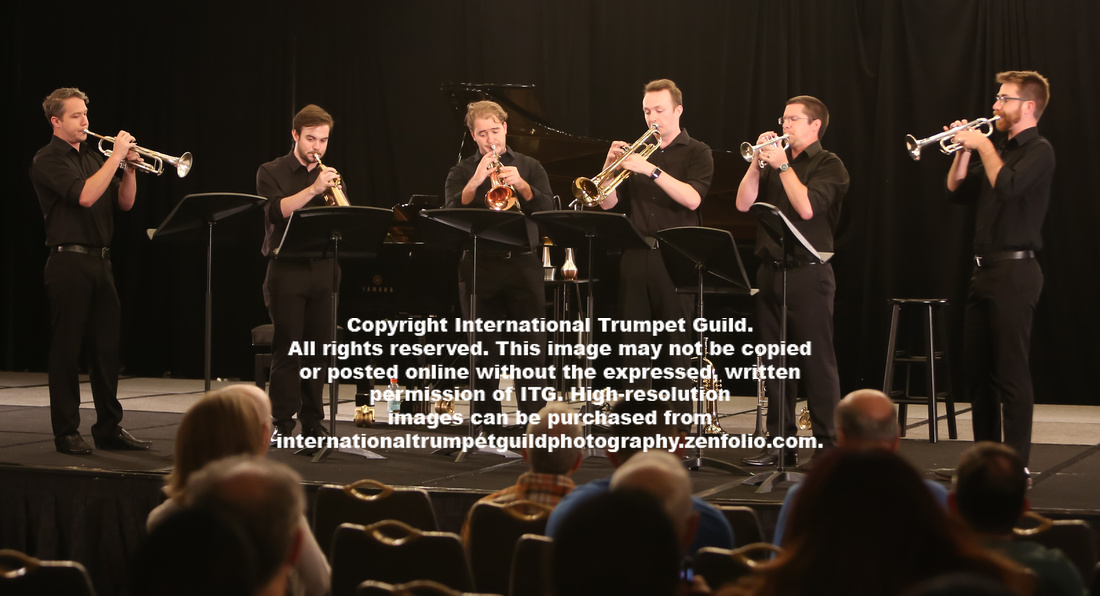
“Scherzo” from A Midsummer Night’s Dream by Felix Mendelssohn, arr. Ben Elgan
The University of Florida Trumpet Ensemble performed Mendelssohn’s “Scherzo” from A Midsummer Night’s Dream, arranged by the group’s own Ben Elgan, to open Jose Sibaja’s recital. The performance highlighted well the technical abilities of each player in the ensemble and was incredibly colorful due to every performer’s playing a different trumpet. The audience’s reception was enthusiastic and set the tone for the ensuing recital. (MV)
FSC Trumpet Ensemble, Florida Southern College
Dr. Don McLaurin, director
John Pirillo, Josh Rakes, Christopher Alegria, Amanda Cook, Leighton Smith, Haley Rodriguez, and Cati Ficquette, trumpets; Zoe Perkins and Tabitha Lutz, cello
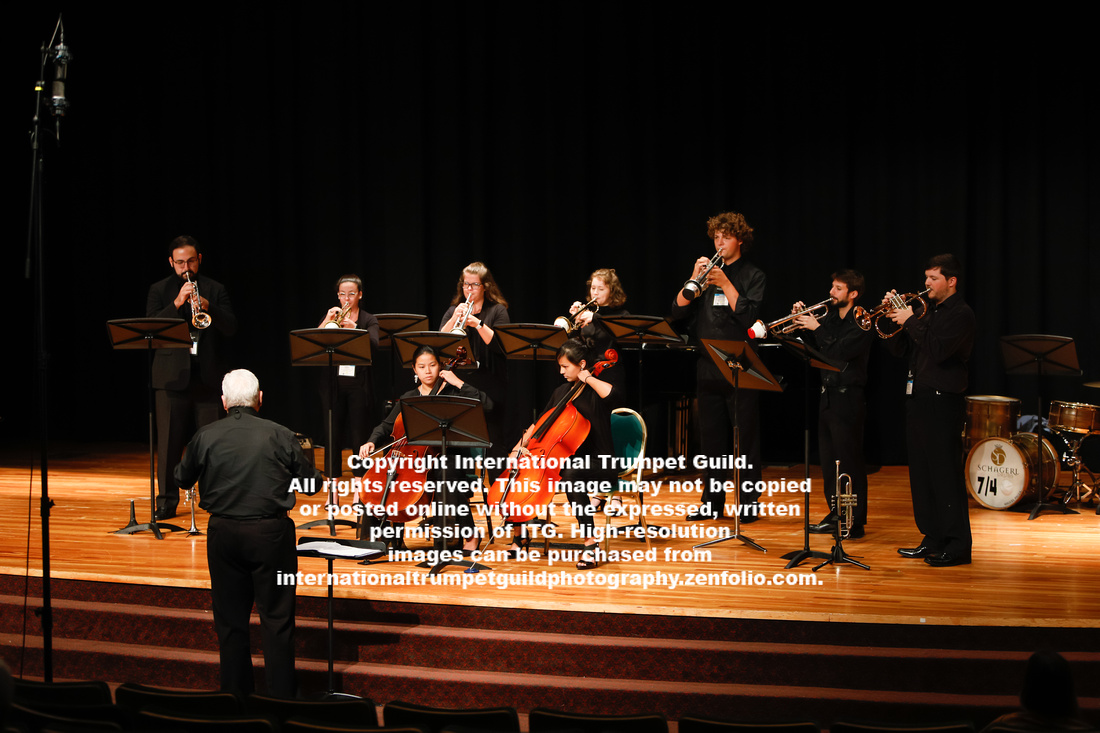
Canzon Cornetto by Samuel Scheidt
Someone Like You by Frank Wildhorn, arr. Jamey Ray and Don McLaurin
The Florida Southern College Trumpet Ensemble presented two prelude pieces under the direction of Dr. Don McLaurin. A trumpet quartet performed Samuel Scheidt’s Canzon Cornetto with beautiful ensemble blend and effortless trading of melodic lines. This was followed by an adaptation of Frank Wildhorn’s Someone Like You, arranged by Jamey Ray and adapted by Dr. McLaurin for nine trumpets and two cellos. The young ensemble’s sensitive playing shone through with cantabile flugelhorn lines filling out this romantic number. (MM)
FSW Trumpet Quartet, Florida Southwestern State College
Dr. Tom Smith, director
Shannon O’Neil, Kelly Quinn, Cicero McCarter, and Joyel Norton, trumpets

Jesus, My Soul’s Delight by J.S. Bach
Rouse Thyself, My Weak Spirit by J.S. Bach
The four members of the Florida Southwestern State College Trumpet Ensemble opened Jose Sibaja’s masterclass by performing pieces by J.S. Bach. Conducted by Dr. Tom Smith, they demonstrated great maturity and musicality in their performance. Because there were only four players, each was featured. They blended well together and obviously enjoyed playing this time-honored chorale genre. On Charles Decker’s arrangement of Fugue No. 11, from The Well Tempered Clavier, Book 1, they were well balanced and played with great energy and conviction. It was an especially great way to inspire the high school students who were present that morning to work with Jose Sibaja, and their performance was obviously appreciated by all in attendance. (PS)
Liantes sin piano, Global Institute for Music Research
Jordi Albert, director
Guillem Torro, Ivan Martí, Gabi Garcés, and Jordi Albert, trumpets

Prelude et Intrada by Howard Buss
The Global Institute for Music Research Trumpet Ensemble performed Prelude et Intrada by Howard Buss as the prelude to Rebecca Palmer’s youth lecture. The Prelude section began with a sonorous chord, and the following counterpoint highlighted each member’s beautiful sound. The Intrada brought a new brilliant color in a fanfare character to contrast with the opening section. Their performance was well received and prepared the audience well for the lecture that followed. (SB)
Trompetes do Cerrado, Universidade Federal de Goiás
Dr. Antonio Cardoso, director
Antonio Cardoso, Felipe Araújo, Guilherme Toledo, Kaellen Castro, Lourrainy Cabral, Marcelo Eterno, and Ricardo Dias, trumpets
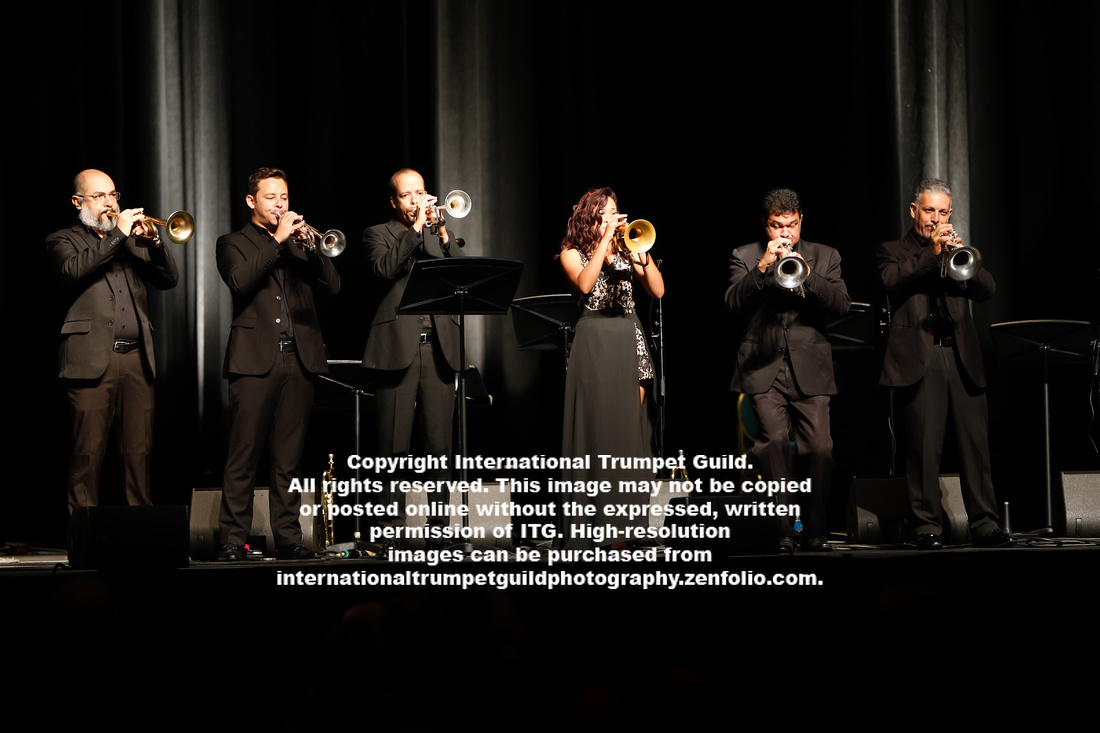
Fantasia Brasileira by Jose de Silva “Duda”
The Trompetes do Cerrado, led by Dr. Antonio Cardoso, performed Fantasia Brasileira by Jose de Silva “Duda.” The six-member ensemble from Brazil played the work with a great sense of style and enthusiasm. In four movements and based on Brazilian folk music, the piece is full of rhythmic complexity. Trompetes do Cerrado created a festive atmosphere with their performance. (KE)
UI Trumpet Ensemble, University of Illinois at Urbana-Champaign
Nicole Gillotti, director
Brian Galli, Chris Armstrong, Tory Greenwood, Andrew Magosky, Nick Jenz, Paris Baptiste, and Tyler Cornwall, trumpets
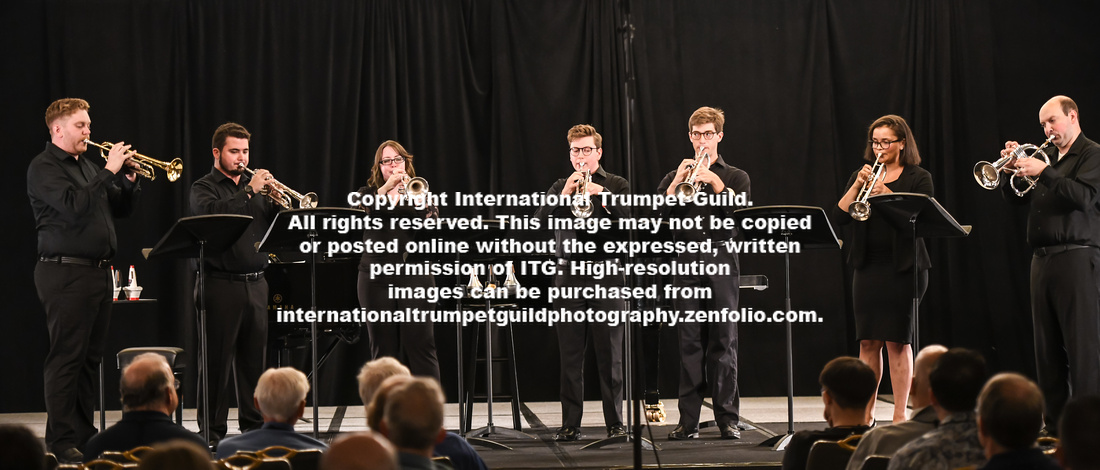
Lincolnshire Posy by Percy Grainger, arr. Brian Galli
This morning’s recital opened with a performance of three movements from Percy Grainger’s Lincolnshire Posy, as arranged by Brian Galli, one of the ensemble’s members. The trumpet septet executed the work beautifully. A variety of tonal colors across the ensemble provided for great musical intrigue throughout the piece, and the group’s ability to blend those sounds provided a pleasant homogeneity that allowed them to capture the spirit of the work. The ensemble’s hard work and commitment to the music really shone through, and the audience was clearly appreciative of their efforts. (TT)
Mahidol University Trumpet Ensemble
Dr. Joseph Bowman, director
Nitiphum Bamrungbanthum, Surasi Chanoksakul, Narongkit Chanthadilokporn, Nattamon Dusitsophon, Kueakool Jaisom, Termpong Jaieim, Alongkorn Laosaichua,Titinun Manonati, Panalee Naknaka, Suchol Nintawong, Sompop Puengpreeda, Patcharee Suwantada, Radit Towong, Patchara Vinitvorakul, Krisatri Weerawonwattana, and Kunyaporn Wirunpochit, trumpets
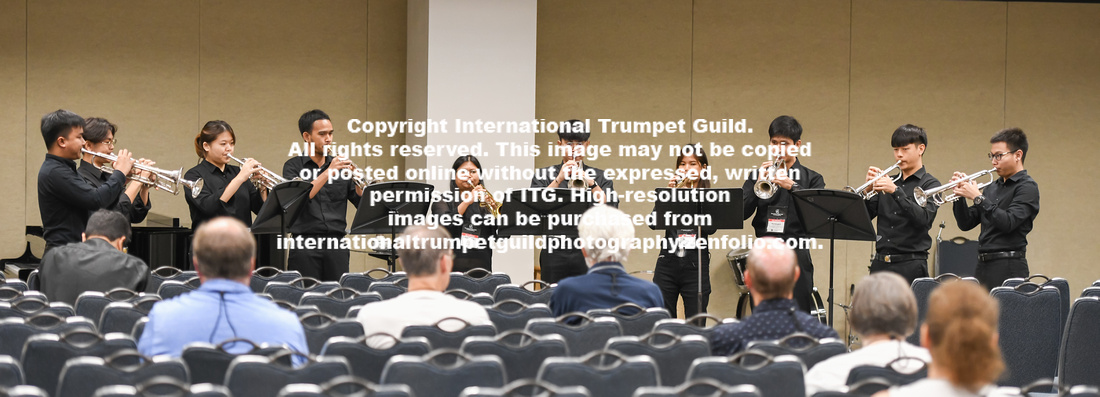
X1 by Erik Morales
The students of Mahidol University and Joseph Bowman should be commended for traveling such a long way from Thailand and giving a very polished, exciting performance. Erik Morales’s X1 was named after the first supersonic airplane and provided an excellent opportunity to showcase the students’ strong technique and consistent articulation. The ensemble doubled all five parts, but there was still fine solo playing by individuals and a good ensemble balance throughout. (NV)
SCCC Trumpet Ensemble, Schenectady County Community College School of Music
Dr. Allyson Keyser, director
Todd DuBrey, Ben L’Ecuyer, Matt McCann, Jake Morrissey, and Bryce Kelly, trumpets
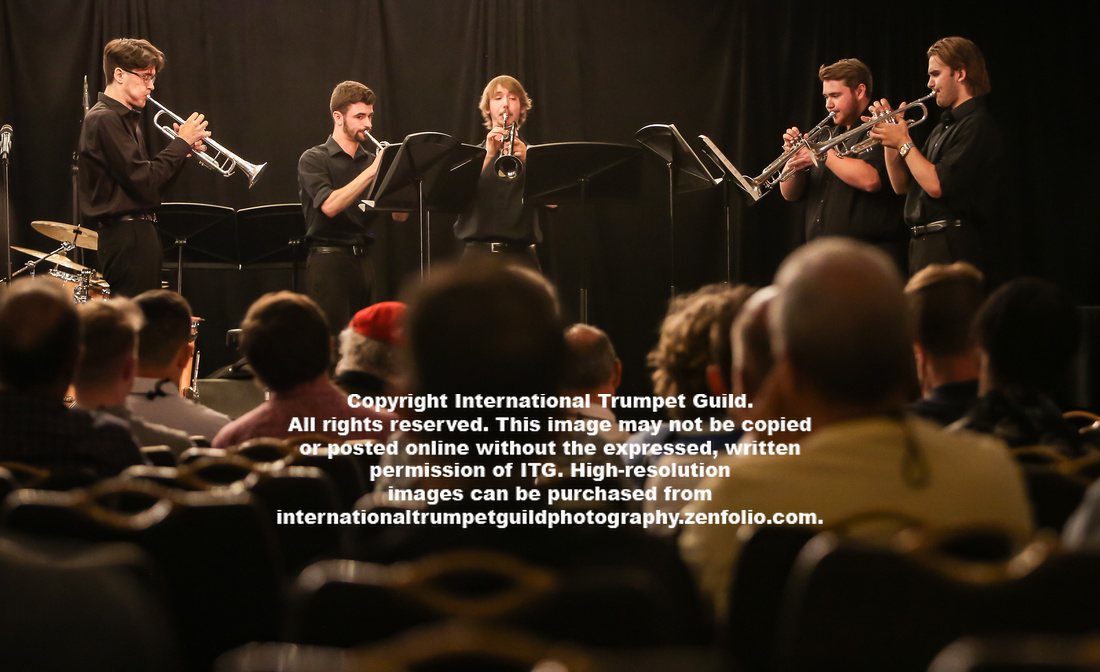
Cityscapes by Erik Morales
Amazing Grace, arr. M.S. Grant
* Reflections in Jazz and Blues by Dylan Canterbury
Schenectady Trumpet Ensemble’s performance was stylistically diverse. “Rush Hour” from Erik Morales’ Cityscapes, was a lively opener. Marcus Grant’s arrangement of Amazing Grace followed, with melodic lines in canon and electrifying suspensions. A world premiere of Reflections in Jazz and Blues by Dylan Canterbury closed, with moments that evoked spontaneous improvisation. (MM)
SWOSU Trumpet Ensemble, Southwestern Oklahoma State University
Dr. Richard Tirk, director
Alex Davis, Tommy Smith, Austin Hardman, Amanda Bacon, Jeremiah Cross, Dustin Gorny, Aaron Edge, Davison Nguyen, Miranda Giessel, Donna Hyde, Gary Hoover, Andy Cifuentes, Kayla Clay, and Andrew Howse, trumpets
[Photo unavailable]
An Overture and a Finale by Ronald LoPresti
Opening the evening’s feature jazz concert was the Southwestern Oklahoma State University Trumpet Ensemble performing Ronald LoPresti’s An Overture and a Finale. From the very opening, the group displayed great precision, blend, and unity of sound and articulation. The odd-meter sections so prevalent in LoPresti’s music were executed within a steady groove, with each member adhering to time with noticeable ease. The quality of the communication across the ensemble, from clearly marked cues to the eyes and ears necessary to absorb them, the players were constantly in sync with one another. (TT)
TrumpetSix, Texas A&M University-Commerce
Dr. Daniel Kelly, director
Madison Barton, McKenna Hill, Austin Loehr, Michaela Schwyhart, Isaiah Scott, and Rylan Taylor, trumpets
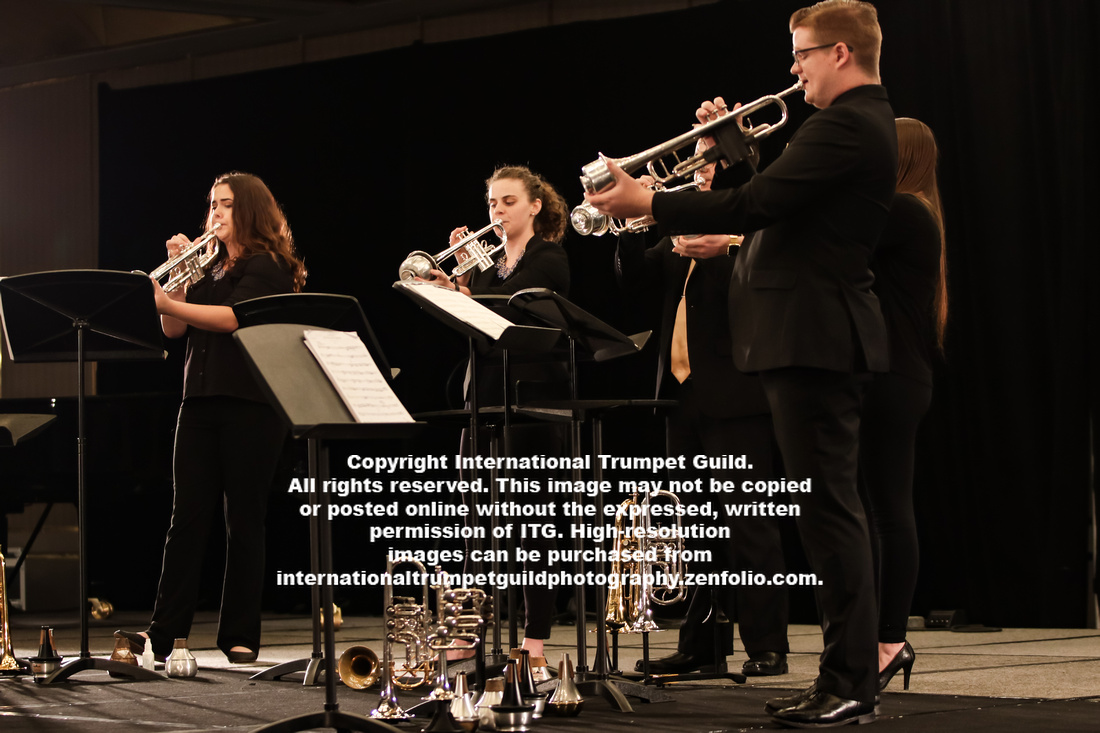
Milestone by Kent Boulton
The Texas A&M-Commerce Trumpet Ensemble did an enthusiastic performance of Kent Boulton’s Milestone. The prelude consisted of flourishes and exchanges of runs over several ostinatos. A few lyrical sections showcased the ensemble’s warmth of sound, and pyramids with Harmon mute provided additional contrast. This was an excellent performance with precision and energy throughout. (LE)
University of Texas at Tyler Trumpet Ensemble
Dr. Jeremy McBain, director
Paul Arriola, Kyle Bennett, Gavin Clarke, Ethan Day, Dylan McCann, and Peter Merts, trumpets
[Photo unavailable]
Congratulamini Mihi by Giovanni Pierluigi da Palestrina
Concert Fanfare by Eric Ewazen
The six-member ensemble from the University of Texas at Tyler infused the Renaissance polyphony of Palestrina’s Congratulamini Mihi with exquisite balance, fine intonation, and a warm sound. Their performance of Ewazen’s Concert Fanfare exhibited fine control of expressive dynamics and ensemble precision. (EK)
WCU Trumpet Ensemble, West Chester University of Pennsylvania
Dr. Jean-Christophe Dobrzelewski and Mr. Robert Skoniczin,
directors
Samuel Zatkow, Adrianna Korey, Alyssa Kenny, Julianna Johnson, Charlotte McMillen, Maeve Bartra, Chloe Francis, and Nicholas Bowser, trumpets
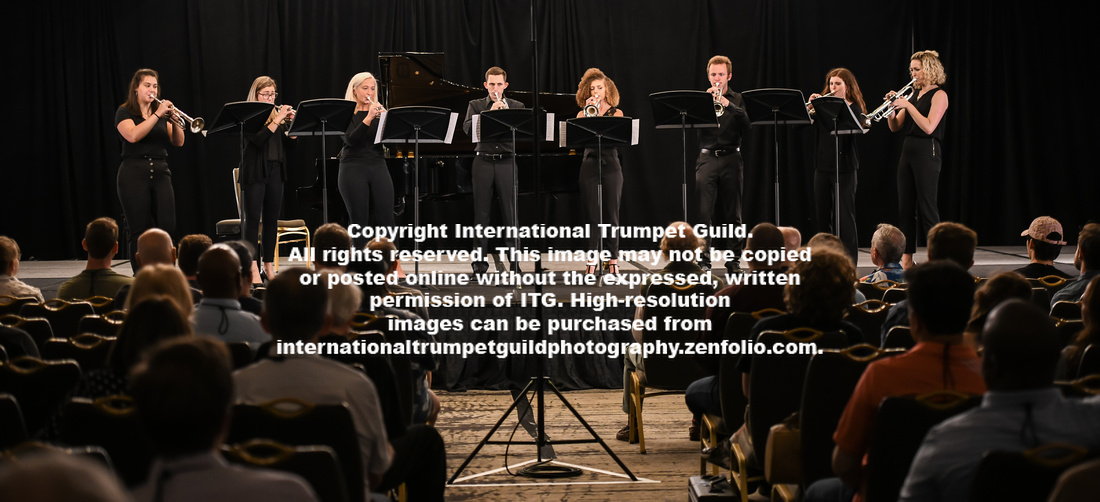
Conquest by Erik Morales
The West Chester University Trumpet Ensemble performed Erik Morales’s Conquest. They played with beautifully warm sounds, which worked well with the lush sonorities of the piece. The soloist projected brilliantly over the ensemble, and the overall performance delivered wonderful energy and excitement. (KM)
Badger Brass, University of Wisconsin-Madison
Ms. Jean Laurenz, director
Nick Hill, Matthew Kellen, Brighin Kane-Grade, Brendan Anderson, Joseph Rockman, and Kaitlyn Rian, trumpets
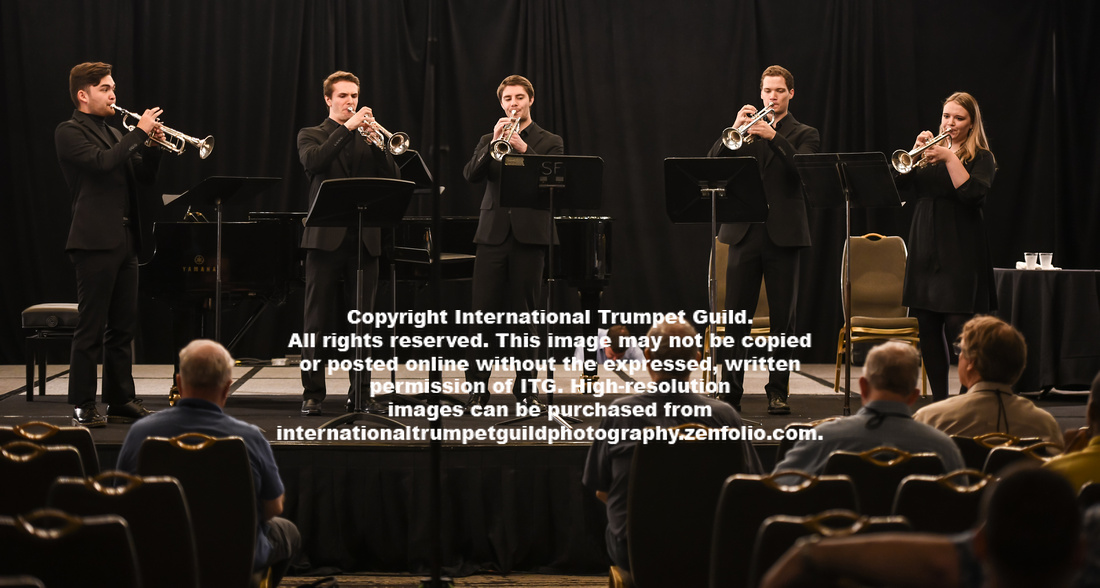
Suite for Five Trumpets by Ronald Lo Presti
The Badger Brass trumpet ensemble from the University of Wisconsin-Madison put on an exciting performance of Ronald Lo Presti’s Suite for Five Trumpets. The first and third movements featured their clear and pointed articulations, while they demonstrated beautiful lyricism in the second movement. The musicians showcased their talents in a passionate and expressive performance. (SS)
Westminster College Trumpet Ensemble
Dr. Tim Winfield, director
Vincent Buell, Sean Evanick, Nikalas Guadagnino, Courtney Labritz, Allison Savage, and Tim Hering, trumpets
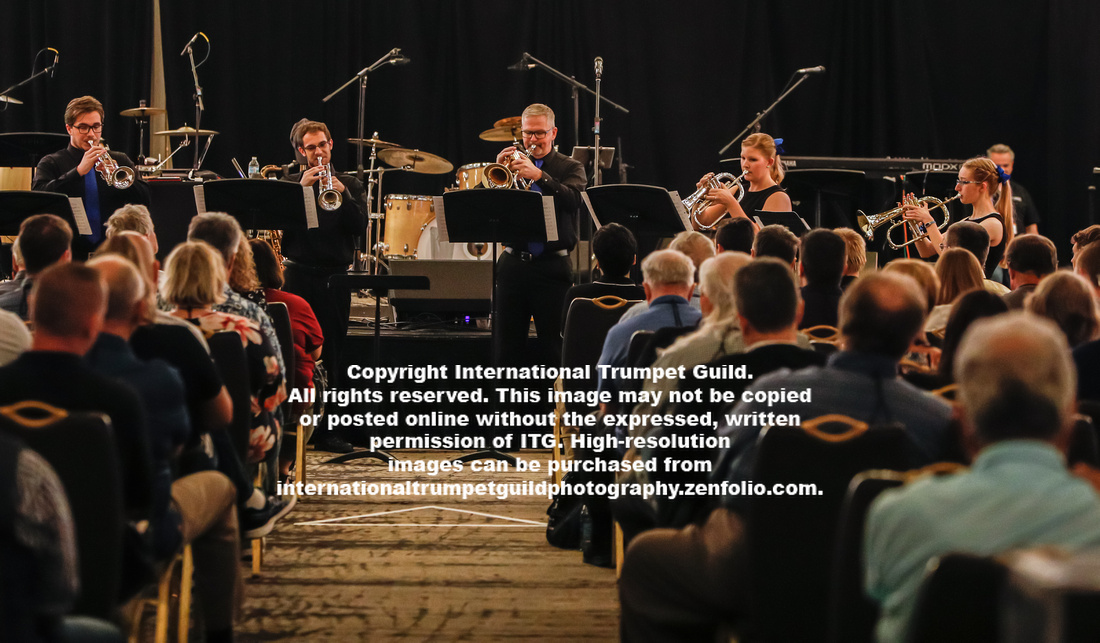
Barber of Seville Overture by Gioachino Rossini, arr. Erik Morales
The Westminster College Trumpet Ensemble, directed by Dr. Tim Winfield, performed Erik Morales’s arrangement of Gioachino Rossini’s Overture to The Barber of Seville. The work, scored for three trumpets and three flugelhorns, remains true to the original. There was an obvious sense of vitality and energy to the six-member ensemble’s performance. (KE)
Click here for more prelude ensemble photos
]]>
Special Daily Report • Compiled by Peter Wood
Photos by Michael Anderson, Norman Black, Benjamin Lowe, and Donald Sorah
Saturday, July 13 - Evening events
Click here for more photos from the ITG Conference
Student Meet & Greet Reception
A warm Miami sunset on the river provided the backdrop for the International Trumpet Guild's Student Reception early Saturday evening. Students from around the world gathered to meet, greet, and eat together after a busy weekend of musical activities. Students were encouraged to talk to new people and discuss their favorite parts of the conference. During the event, Grant Peters encouraged the students to talk with him should they have any suggestions for the bettering of next year's conference. By doing this, he invited them to continue to carry on the legacy of the organization by participating in various ways in the future. A raffle drawing seemed to be the highlight of the night as many students walked away with generous gifts from the conference exhibitors. Over 100 students attended this exciting gathering. (ED)
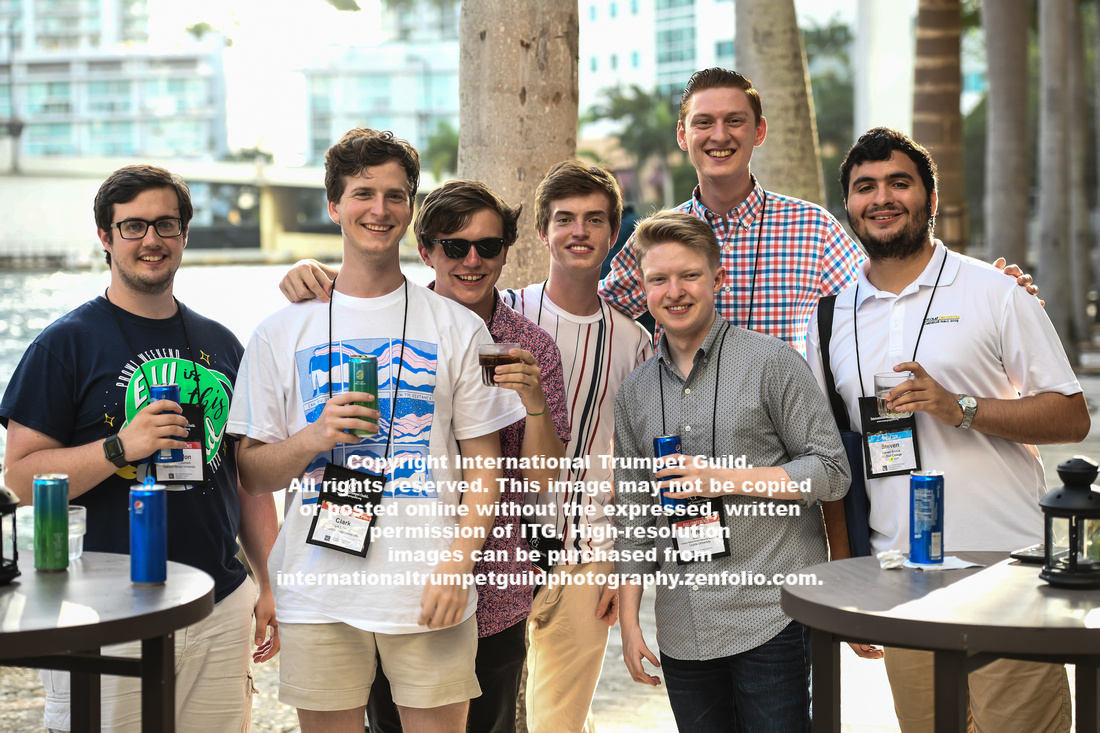
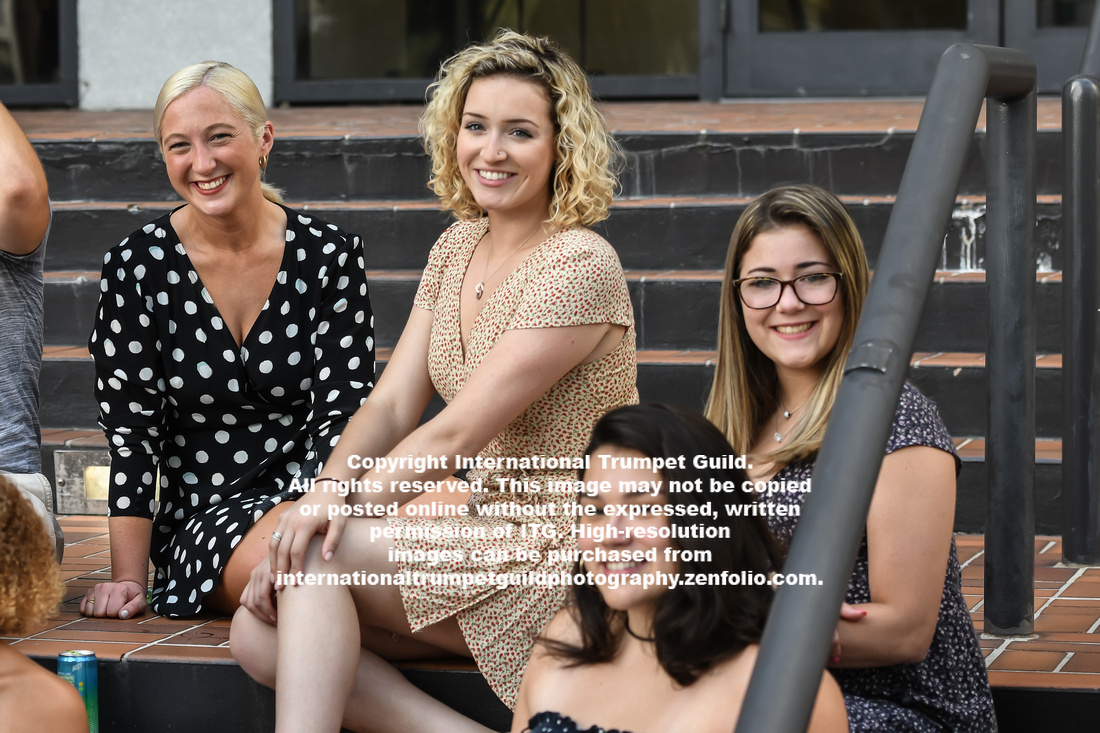

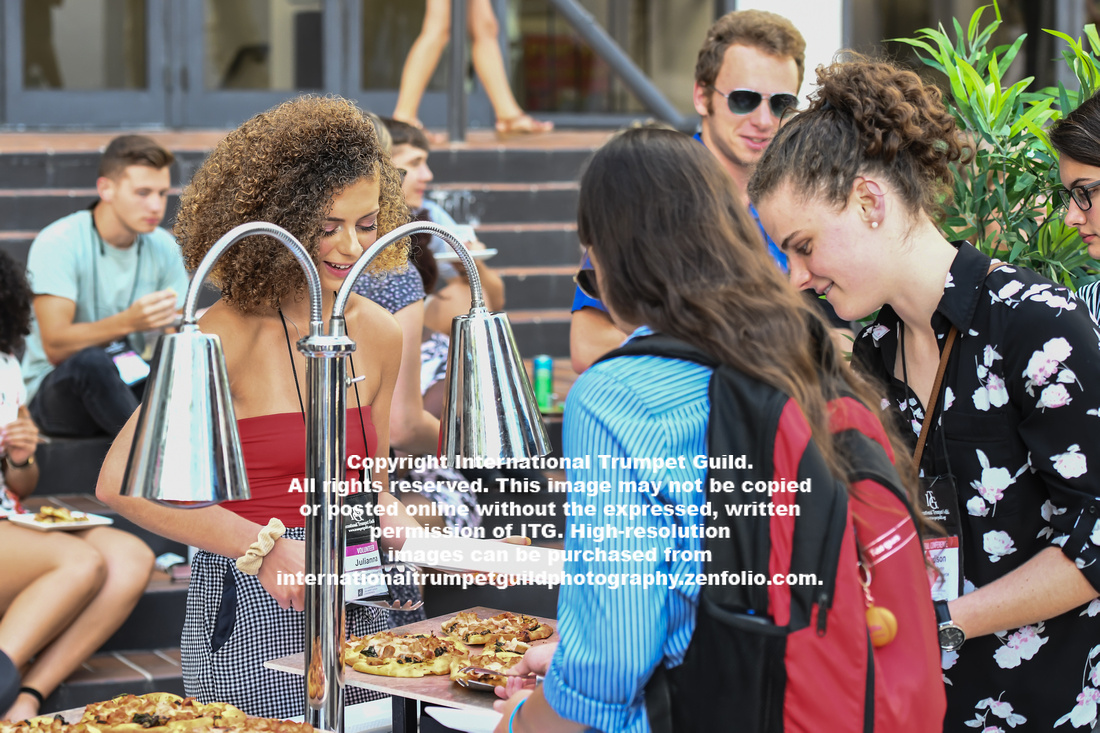
Salsa Night with Jose Sibaja, Carlos Oliva and Los Sobrinos del Juez
What better way could there be to close out an International Trumpet Guild Conference in Miami than with a night of sizzling salsa?! From the very outset of tonight’s event, the stage of the James L. Knight Center was on fire with the sounds of Carlos Oliva y Los Sobrinos del Juez (The Judge’s Nephews). Making up the band were Richard Bravo (drums), Charles Santiago (timbales/percussion), Manuel Torres (conga), Omar Hernandez (bass), Jackson King (keyboards/vocals), Javier Concepción (keyboards), Camilo Valencia (flute/EWI/saxophone), Teddy Mulet (trumpet/trombone), Jason Carter (trumpet), and the leader of the band for 52 years, Carlos Oliva. Joining them on stage as the host for the evening was Yamaha Performing Artist, Boston Brass member, and trumpet virtuoso, Jose Sibaja.
As the timbales sounded from a blacked-out stage, the energy began to build. Joined shortly by the congas, and soon by the remainder of the band, performing an original Los Sobrinos del Juez guaguanco, it was clear that the audience was in for a great time. Frontman Carlos Oliva’s electrifying energy, combined with a band that utterly defined “groove,” immediately sent audience members onto their feet, with most never returning to their seats. The eclectic set list, which combined both popular salsa tunes like Bomboleo and Kimbara with popular music from decades past, including The Ides of March’s Vehicle, Tina Turner’s Proud Mary, the Rolling Stones’ Satisfaction and The Isley Brothers’ Shout, was an exciting mix that never ceased to surprise the audience and kept the dancers moving until the final high notes of the night rang out.
A particular highlight of the evening, and a moment when the tenor of the party began an exponential rise, was a medley of tunes by K.C. and the Sunshine Band which saw the legendary Doc Severensen lead an army of dancers to the front of the hall and then pick up a trumpet to join the section on stage. Before long, the performance became an all-out jam session, with the trumpet section growing to include New Orleans-based trumpeter and Trumpet Mafia leader Ashlin Parker, the Royal Canadian Army’s Naden Band trumpeter Miguel Valdes de la Hoz, and Everton Bailey.
The band’s final tune, Yayabó, inspired nearly the entire audience to dance their way around the Knight Center in a traditional Cuban conga line. In the words of Jose Sibaja immediately after the concert, “it just turned into a big party.” And that, ladies and gentlemen, is the only way to end a gathering of trumpet players from around the world. (TT)
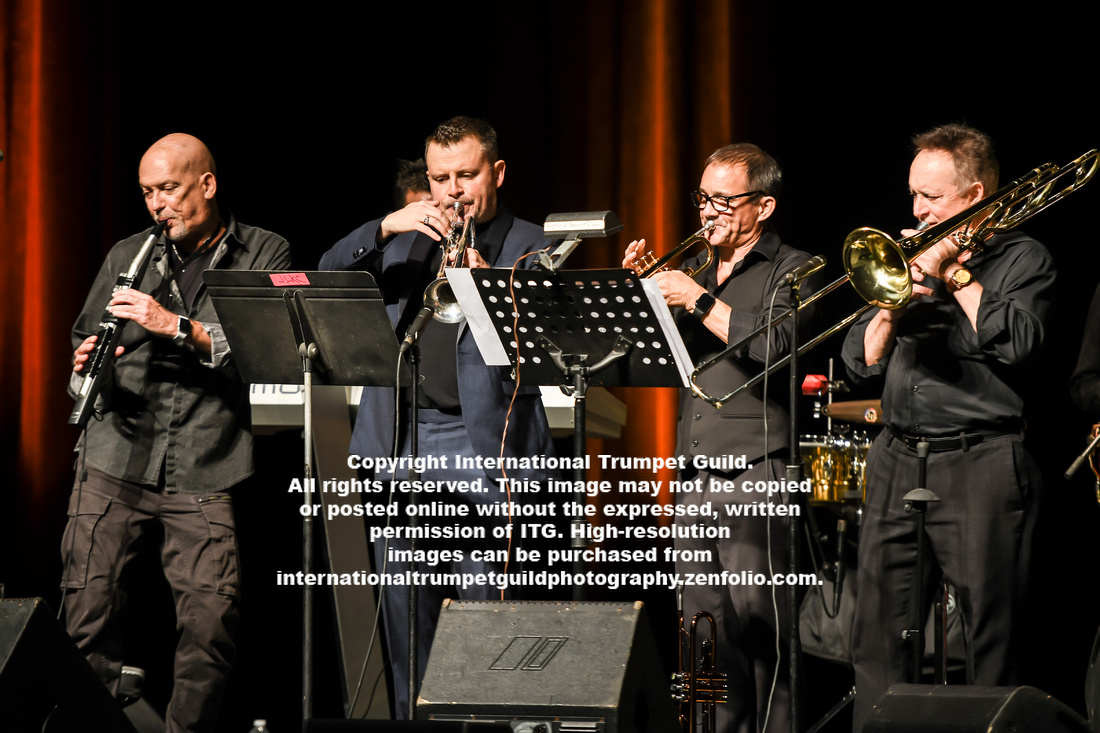
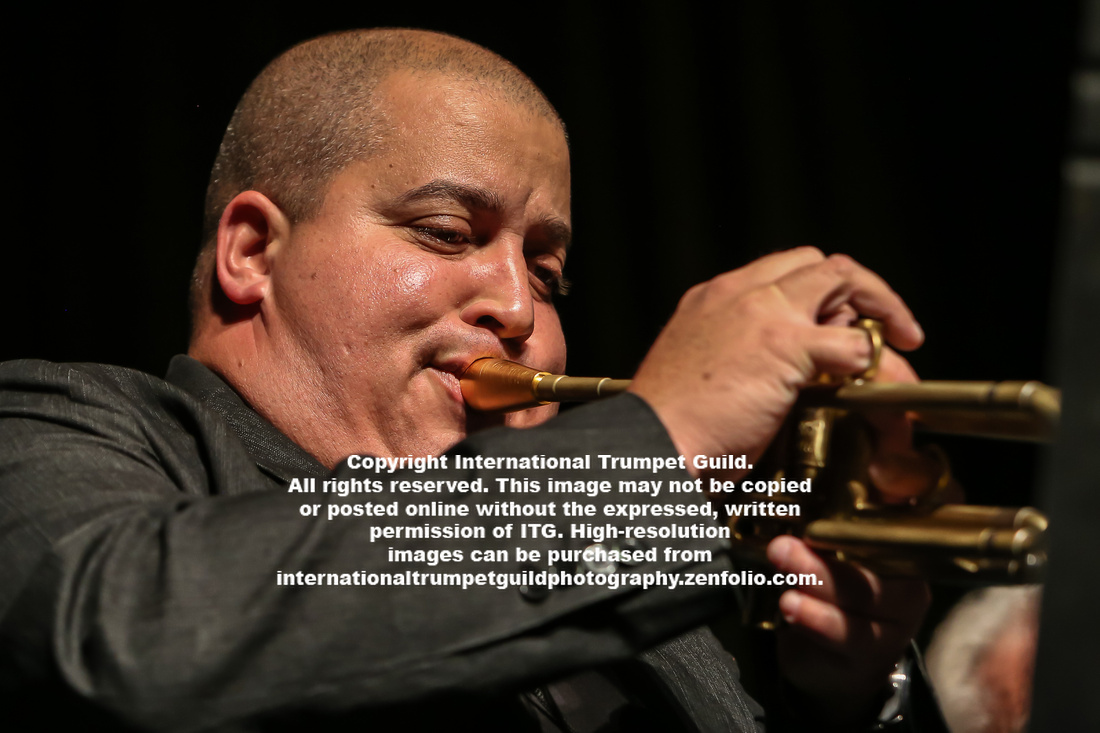
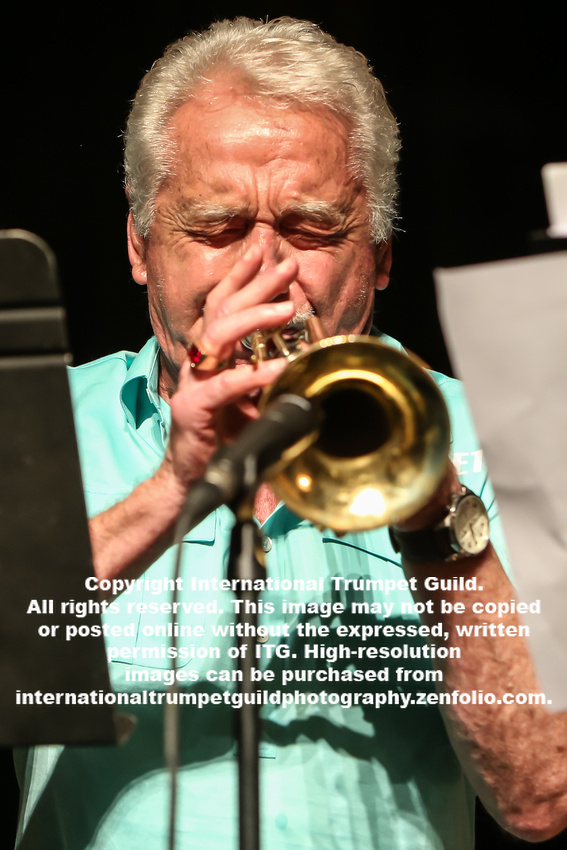
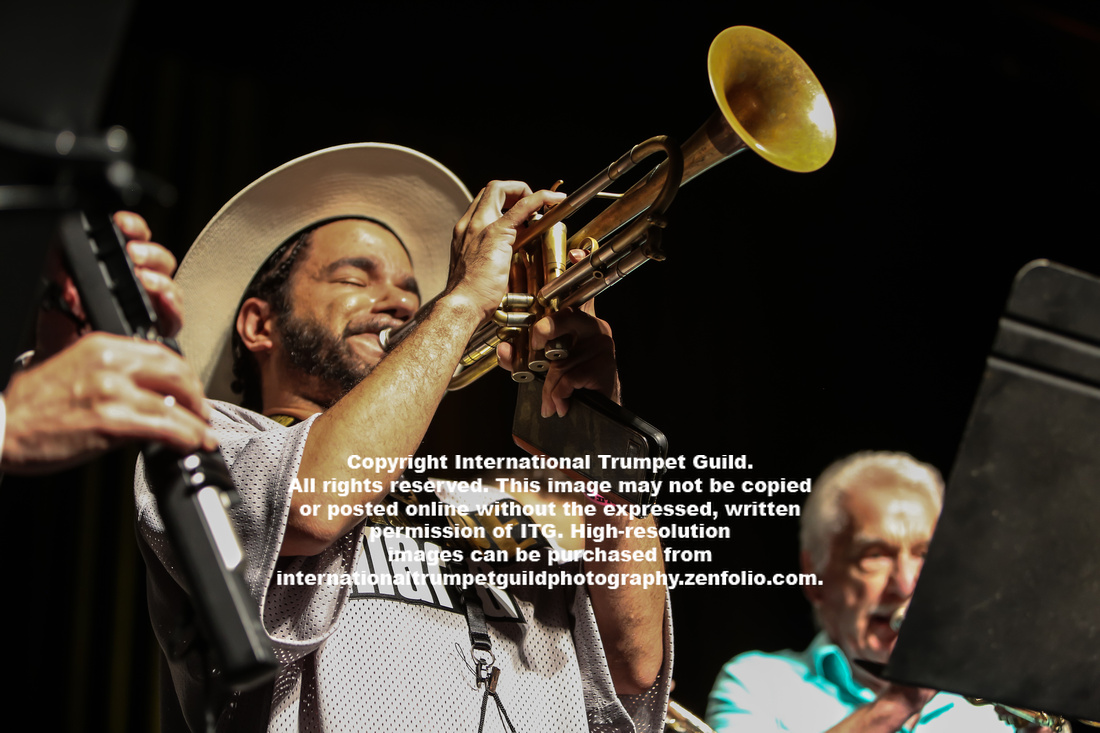
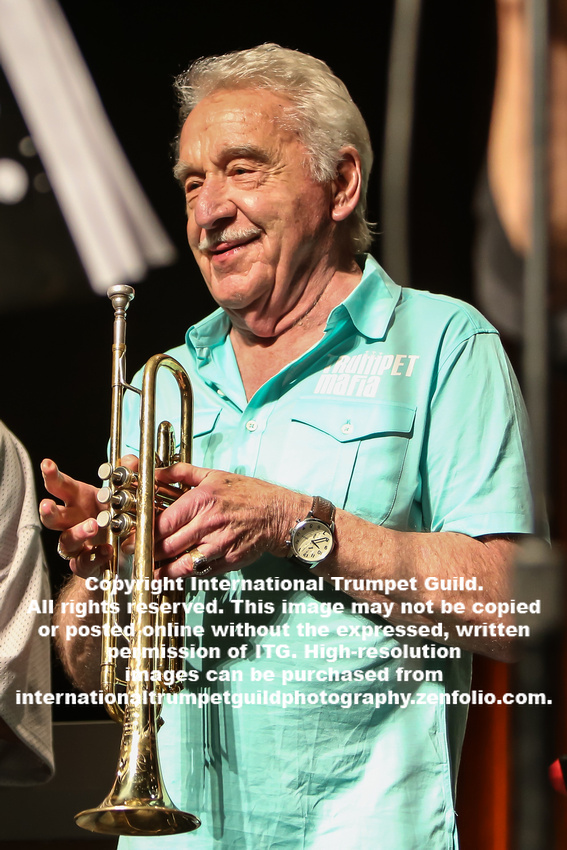

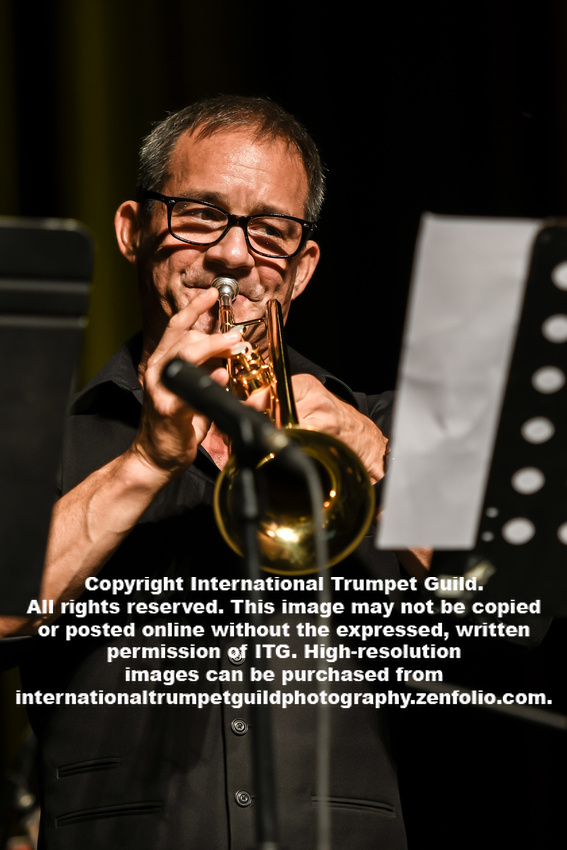
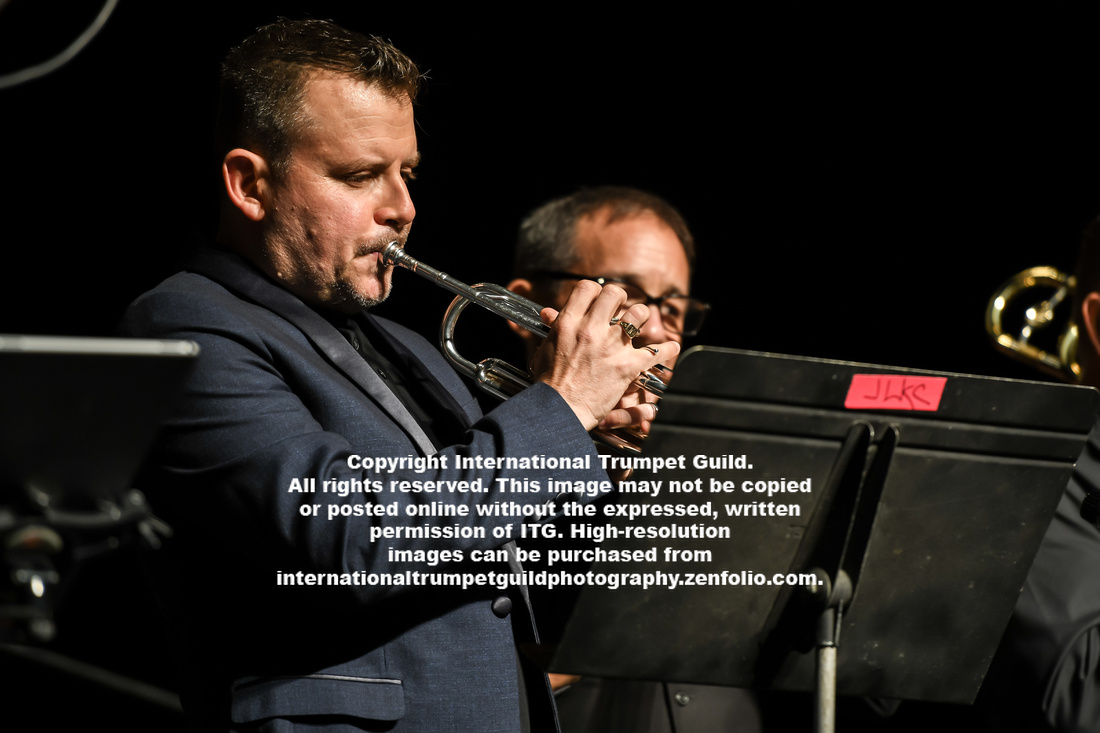
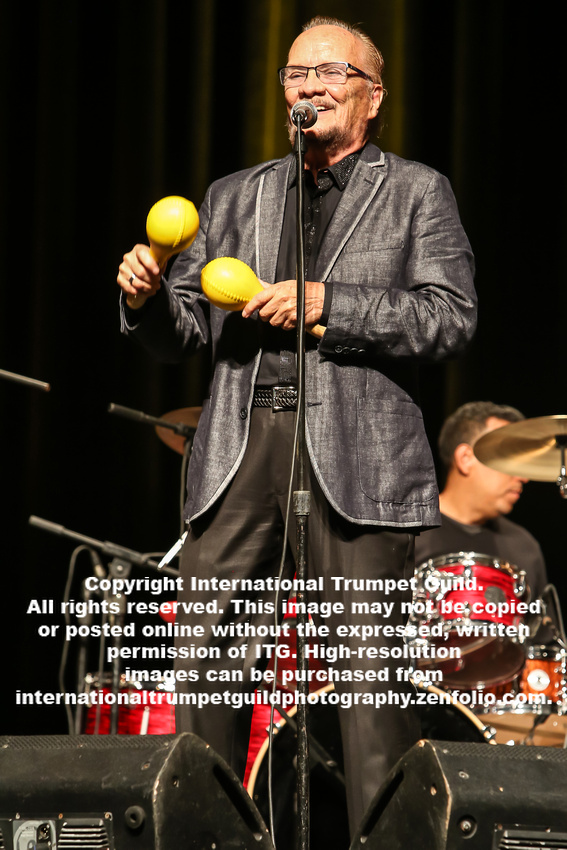

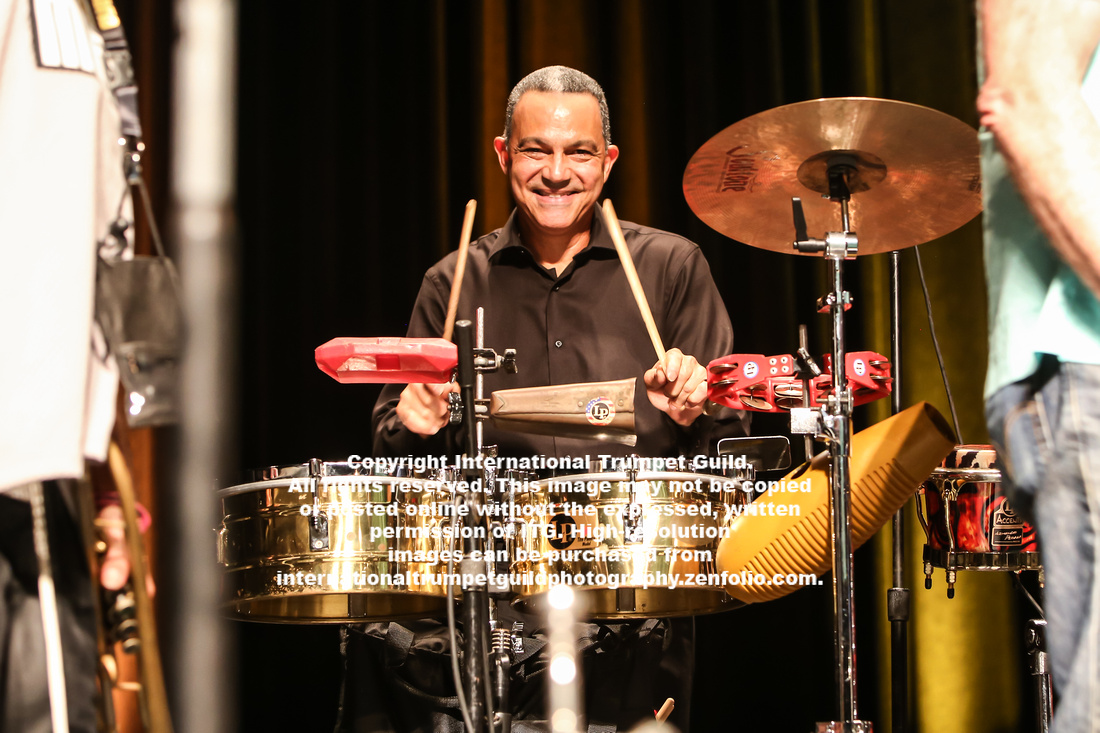
Click here for more photos from the ITG Conference
]]>
Special Daily Report • Compiled by Peter Wood
Photos by Michael Anderson, Norman Black, Benjamin Lowe, and Donald Sorah
Saturday, July 13 - Daytime events
Click here for more photos from the ITG Conference
Sarah Stoneback - Chop Balance: A Warmup for a Healthy and Balanced Experience on Trumpet
Dr. Sarah Stoneback’s morning warmup was well attended and expertly structured. She brought to bear her research on cognitive learning awareness via the four modes of learning: Cognitive Experience, Reflective Observation, Abstract Conceptualization, and Active Experimentation. Her overarching principle is to be flexible and embrace variety in order to stretch one’s learning threshold. Stoneback also presented the five principles of warming up, as observed in Braces and Brass by John Colson and Ron Stoneback. These include “Low before High,” “Soft before Loud,” “Down before Up,” “Slow before Fast,” and “Slur before Tongue.” The warmup session began with breath-attack long tones on a middle G and flowed into a few exercises inspired by James Thompson and Max Schlossberg. With excellent explanation between drills, she moved on to articulation drills and target practice with a final melody played as a group. (DG)
Sean Butterfield and Vern Sielert Youth Day Warmup: Building YOUR Routine
Sean Butterfield and Vern Sielert guided the students of Youth Day through a comprehensive warm-up routine designed to help reset the foundation of playing from the demands of the previous day. The presenters emphasized that everything you include in a warmup must be customized to your own needs and abilities. Butterfield and Sierlert used stretches and breathing exercises to prepare the participants’ bodies to play for the day and led the group through several mouthpiece and leadpipe exercises to focus on developing a pure sound. Through their routine, the presenters helped students simplify the fundamentals of trumpet playing to creating a good sound, changing pitches, and articulating. With these ideas, Butterfield and Sielert expressed the importance of always maintaining a musical focus, even in the most basic of exercises. The students learned how to develop successful habits of playing that they can incorporate into their own careers. (EM)
ITG Youth Competition, Junior Division
The Junior Division of the ITG Youth Competition consisted of students age 15 and under performing solos from the standard trumpet literature. Jade Park was the first to perform and played a wonderful rendition of the Arutiunian Concerto. Her powerful sound captivated the audience from the opening and was highlighted by her impressive technique and clear articulations. Benjamin Black gave a compelling performance of the first movement of the Hindemith Sonata. His rhythmic precision was notable in this demanding piece. Ruoshui Min followed with the Hansen Sonata. She displayed marvelous control of the instrument while performing at soft dynamic levels. Sam Ferguson’s rendition of Balay’s Petite Piece Concertante was expressive and passionate. Joshua Kucharski followed with Arban’s Fantasie Brilliante. This work highlighted his talents as a musician, namely his clear tone, precise technique and articulations, and ability to travel through all registers of the instrument. Paul Kwak continued the competition with the first movement of the Ewazen Sonata. Kwak’s lush tone and beautiful lyricism complemented the style of this work well. Yuntong Li also performed the Hansen Sonata. He displayed an impressive ability to transition seamlessly between legato and fanfare styles. Oliver Zhang was next, performing the second and third movements of the Hummel Concerto. His clear tone at soft dynamics created a wonderful atmosphere in the second movement. The third movement allowed Zhang to showcase dexterity through technically demanding sections. Oliver Robinson gave an inspiring performance of Höhne’s Slavische Fantasie. His ability to maintain a beautiful sound in all registers through various dynamic levels was truly impressive. The final performer of the competition was Jack Bricklemyer, playing Arban’s version of The Carnival of Venice. This work allowed Bricklemyer to display his wide range as he progressed through multiple variations. After hearing all ten performers, the judges truly have their work cut out for them. Congratulations to all of the finalists for their wonderful and inspiring performances! (SS)
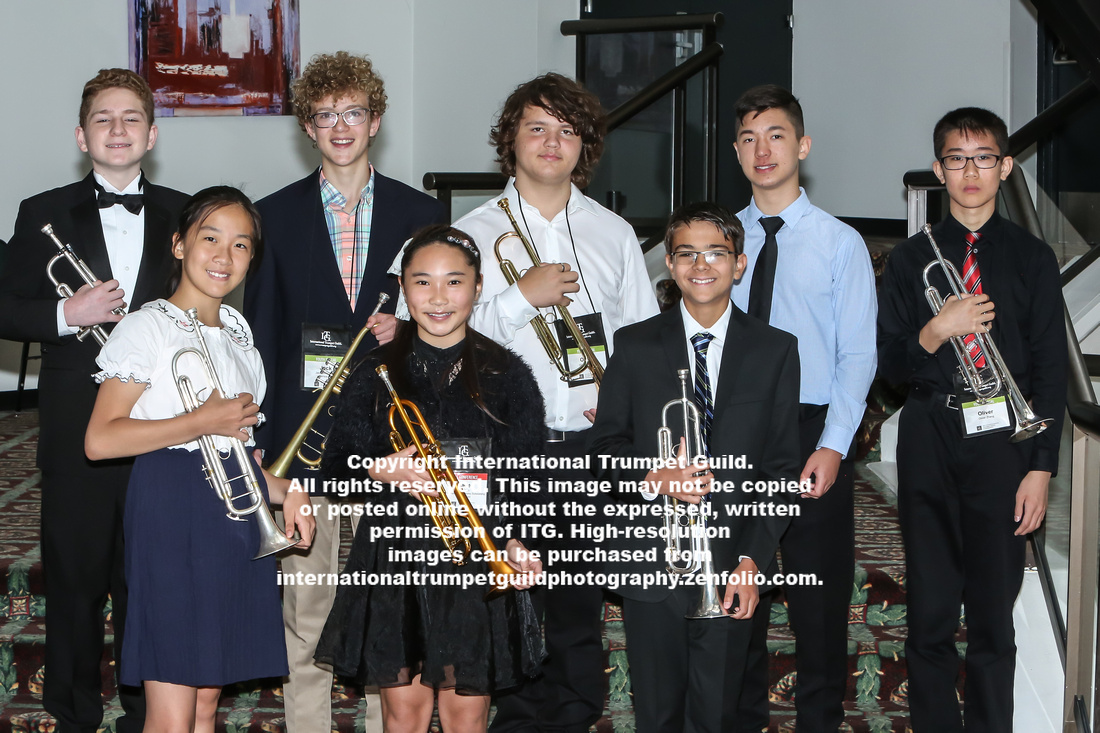
Peyden Shelton Lecture - From Big Weight Loss to Big Problems: Addressing the Negative Effects of Weight Loss on Trumpet Performance
Beginning with a charismatic welcome, Dr. Peyden Shelton presented a wonderful lecture that addressed the benefits and challenges in trumpet playing that can arise from weight loss. Identifying several common issues such as a loss of range, endurance, and clarity of articulation, Shelton shared his own personal experience and provided detailed plans and exercises to regain control and finesse on the trumpet. Taking time to demonstrate his approach to building range, endurance, and articulation, Shelton suggested that players always focus on sound and be patient with the process. Equally important is the ability to identify and assess progress while being willing to reach out to peers, mentors, teachers, or medical professionals for help along the journey. Monitoring positive progress with a daily practice journal was also encouraged, and as a last resort, changing equipment can also be beneficial. Everyone in attendance enjoyed the lecture and benefitted from Shelton's knowledge on the subject. (SW)
Jeremy Brekke Lecture - “Visualize” the Possibilities: Using a Mouthpiece Visualizer for Efficient Trumpet Playing
Dr. Jeremy Brekke’s demonstration and discussion about mouthpiece visualizers centered around the desire to play the trumpet more efficiently. He noted that some trumpeters work too hard to play the instrument and that visualizers can be used to make the minor adjustments necessary to increase ease of play. While some simply use this tool to observe the alignment of the aperture within the mouthpiece, Brekke focused more on using the visualizer to create a clear, pure buzz with as little effort as possible. Once the desired sound was achieved on the visualizer, he then began the process of transferring that sound concept to the trumpet. Benefits include greater endurance, added range, enhanced response, and improved consistency. It is important to remember that less is more in this case. Just a few minutes of daily use can yield significant results. (AD)
ITG Youth Competition, Senior Division
Few things at this year's conference proved as inspiring as listening to the Senior Division of this year’s ITG Youth Competition. Each competitor, regardless of award, performed with poise and maturity, and all were accompanied by the exceptional Rebecca Wilt on piano. Judges included Jesse Cook, Sarah Stoneback, and Richard Tirk. Ko-Te Chen, who earned third place in the contest, presented an expressive rendition of Enesco's Legend. A strong upper register and wide range of dynamics served the music well. Stefan Filip performed two movements from the Senee Concertino. His sweet tone and sparkling articulation earned him second place in this year’s event. With an impressive performance of Höhne's Slavische Fantasie, Sung Ho Wui was the competition winner. His warm tone, technical facility, and stylistic sensitivity impressed the judges and delighted audience members. This was a very impressive showing by some talented young artists with bright futures ahead. (ED)
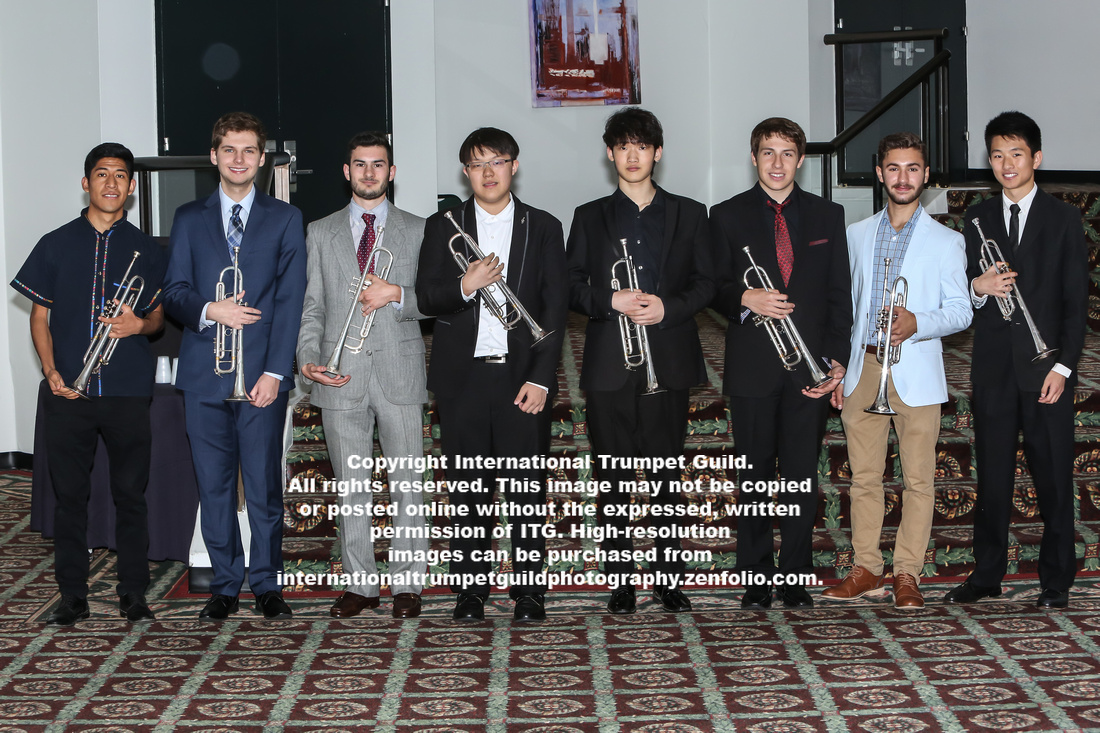
Grant Manhart Lecture - Born Lucky or a Learned Skill? William Adam’s Concepts of Trumpet Range
What’s the problem with range? Is it the trumpet or the mentality? Dr. Grant Manhart presented William Adam’s concepts as an approach to expanding range. Adam’s concepts are not a method; they are a mentality. Based on excerpts from an interview, Manhart began by explaining Adam’s approach to the science of trumpet playing. More importantly, he emphasized that there must be a strong mental picture of the sound we want. Manhart described Adam as the “eternal optimist” who believed that a positive mentality and sound concept is 90% of playing the trumpet. Playing straight down the horn with an amazing mental sound concept allows the player to ascend in register with ease. Manhart demonstrated William Adam’s concepts that can expand a player’s range and open a new sound palette through positive mental image of their sound. (SB)
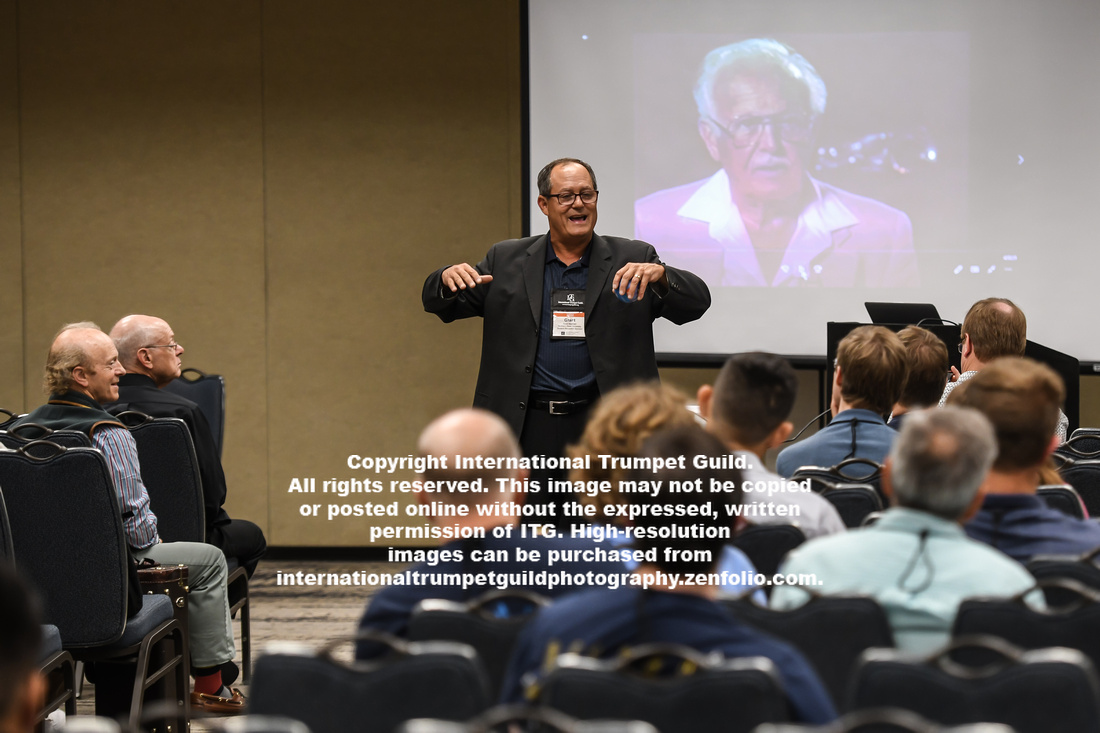
Fabio Brum Recital - EGREGORE+
Fabio Brum treated his afternoon audience to a truly spectacular recital, performing his entire program from memory. He opened with an exciting performance of Charlier’s Solo de Concours on his four-valve cornet and followed with two pieces that were composed for him. Efraín Oscher’s Latin Rhapsody for trumpet and orchestra will be on Brum’s upcoming album, and this was the world premiere of the version for trumpet and piano. The three-movement work was full of Latin character and various dance rhythms as the soloist moved between trumpet, flugelhorn, and piccolo cornet with great ease. The other work written for Brum was Febre Do Rato (Rat’s Fever) by ngelo Martins, an incredibly demanding unaccompanied work that portrays the migration of Brazilian populations from small towns into the largest cities. Pianist Kasia Wieczorek was an excellent collaborator as they closed the recital with Thorvald Hansen’s Sonata and Eugene Bozza’s Rustiques. It was a delight to hear such inspired and genuinely artistic interpretations of these standard works. (NV)
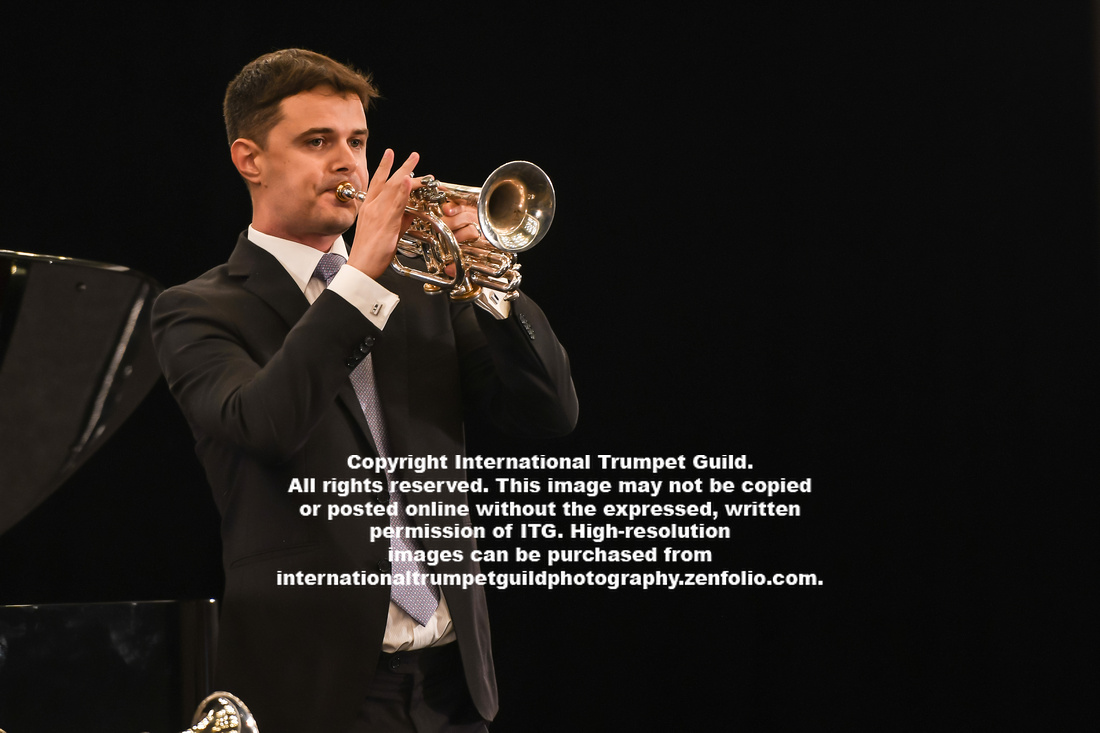
A Brass Odyssey: Using the Natural Trumpet and the History of Lip-Blown Instruments to Teach Beginners
Chris Hasselbring and Kirsty Montgomery gave a lively and informative session on their work with their educational initiative Brass for Beginners (BfB). Founded in 2013, BfB teaches the fundamentals of brass playing through an interdisciplinary curriculum using “child-friendly” plastic natural trumpets. Using these affordable (and indestructible) instruments, school-age children gain experience with natural trumpets, which can lead to further study of any brass instrument. Pitched in C (A=440 Hz), the BfB Natural Trumpet can fit into any general music classroom to play with recorders and Orff instruments. In addition, the BfB curriculum teaches history, brass instrumental development, and repertoire through the character of Ragnar, a caveman who travels through time. Hasselbring demonstrated typical classroom interactions with eight volunteers using BfB trumpets in activities like “The Practice Cave” and “Pharaoh’s Trumpeters.” The BfB website (http://www.brassforbeginners.com) also features videos from such contributing artists as John Wallace, Brian Shaw, and Terry Everson. (EK)
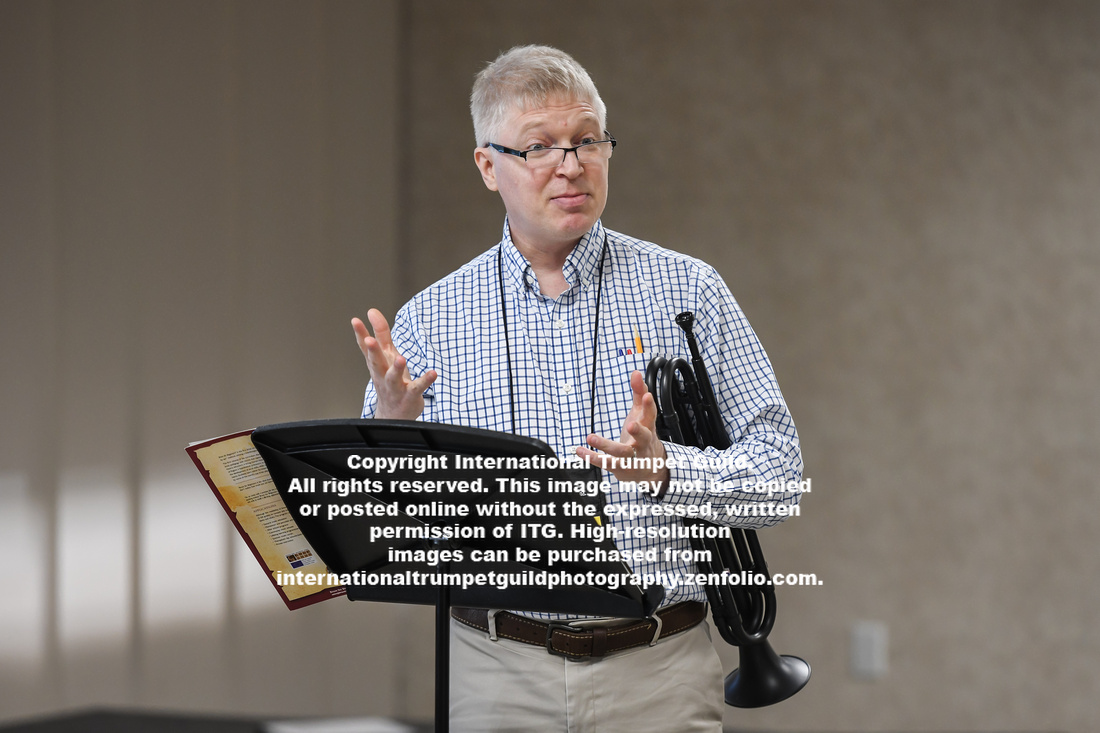
Seraph Brass Recital
The all-female Seraph Brass presented an outstanding recital, “The Music of Classical Masters and Contemporary Women.” The group alternated between works for brass quintet and sextet, with each ensemble member demonstrating beautiful lyricism and stunning technique. The trumpeters in the group––Mary Bowden, Raquel Samayoa, and Jean Laurenz––traded leadership roles throughout the recital, performing difficult exposed solos and lengthy technical passages on flugelhorn and B-flat, C, E-flat, and piccolo trumpets. The low-brass trio of Rachel Velvikis (horn), Hana Beloglavec (trombone), and Gretchen Renshaw James (tuba) performed with incredible dynamic and stylistic range, showcasing broad power and impressive delicacy. Champions of new music and female composers, Seraph performed three works in this category: Asteria by Catherine McMichael, Khirkiyaan (Windows): Three Transformations for Brass by Reena Esmail, and Copperwave by Joan Tower. Each work had unique technical and musical challenges, which the ensemble navigated with ease throughout the unique and entertaining program. (MY)
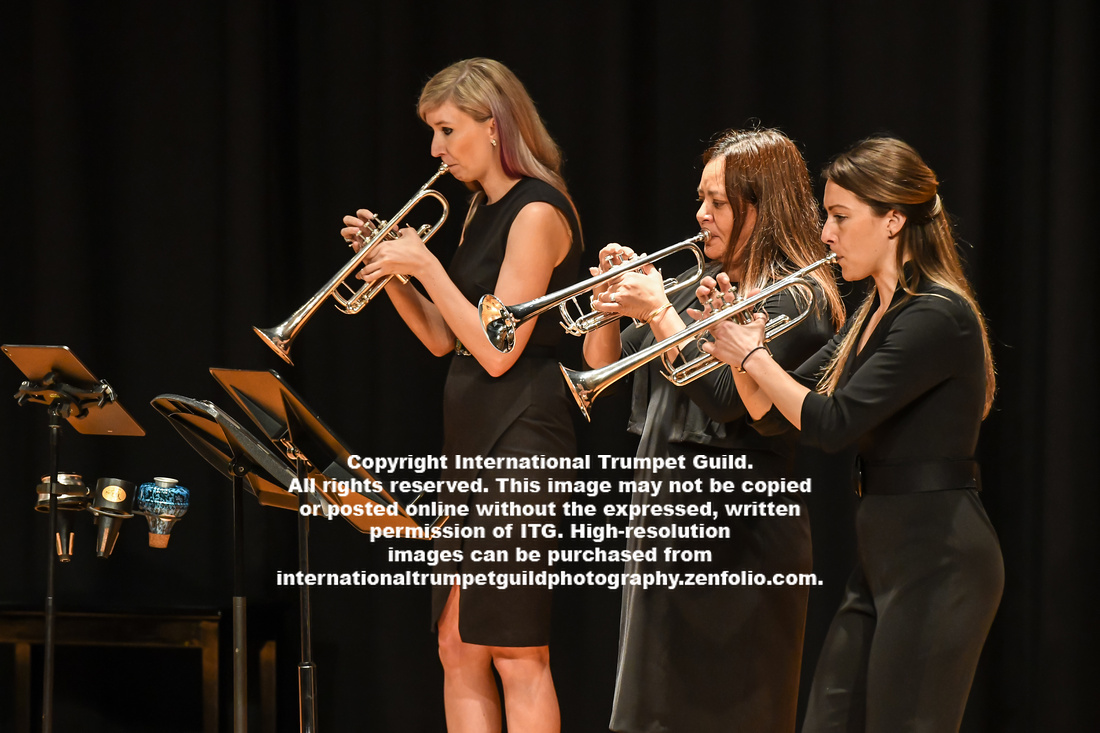
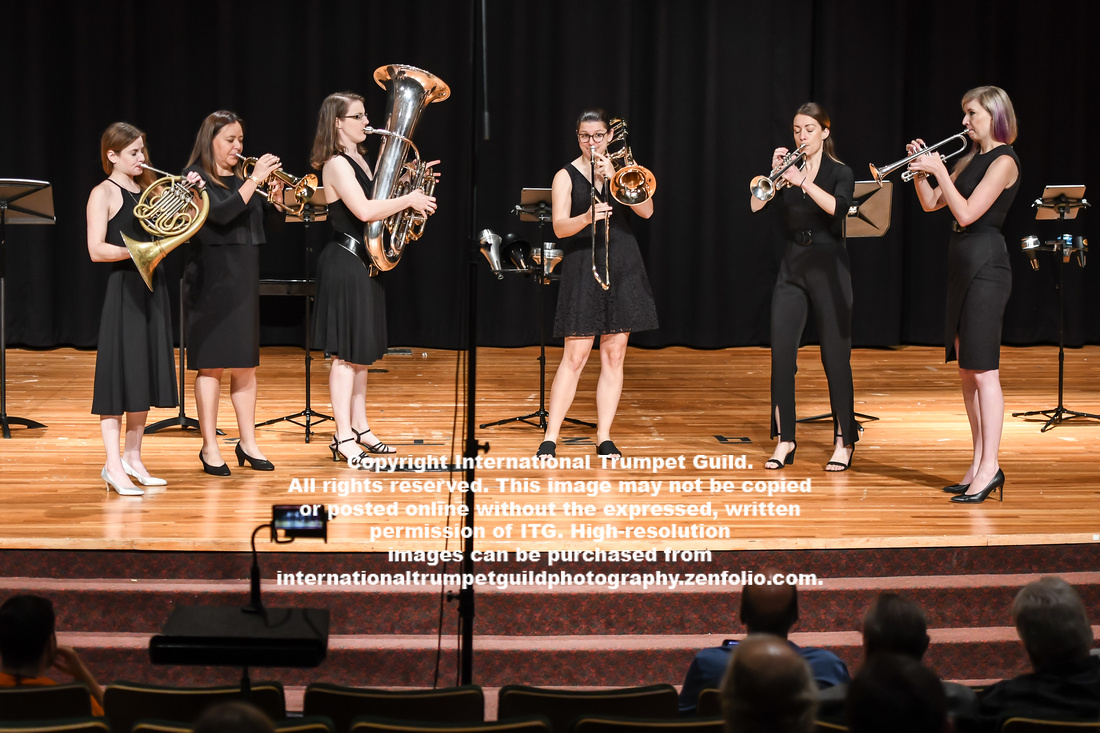
Sean Jones Recital
Trumpeter Sean Jones, along with Zach Bartholomew (piano), John Yarling (drums), and Chuck Bergeron (bass), formed a communicative and good-humored combo. Their set included Dizzy Gillespie’s Ow!, three original compositions by Sean Jones, Horace Silver’s Song for My Father, and Freddie Hubbard’s Dear John. In Jones’s personal and eclectic program, he displayed the sound concept of a soprano saxophone, interspersing space between impossibly rapid flourishes and the “dirtiest” blues riffs. He shined in unexpected places: a dead-tone sustain as pure as a sine wave, the ethereal sigh of a closely amplified harmon mute, and a humble but self-assured demeanor. From funeral dirge waltz to frenetic bop, Jones’s program stunned and delighted attendees. (MM)
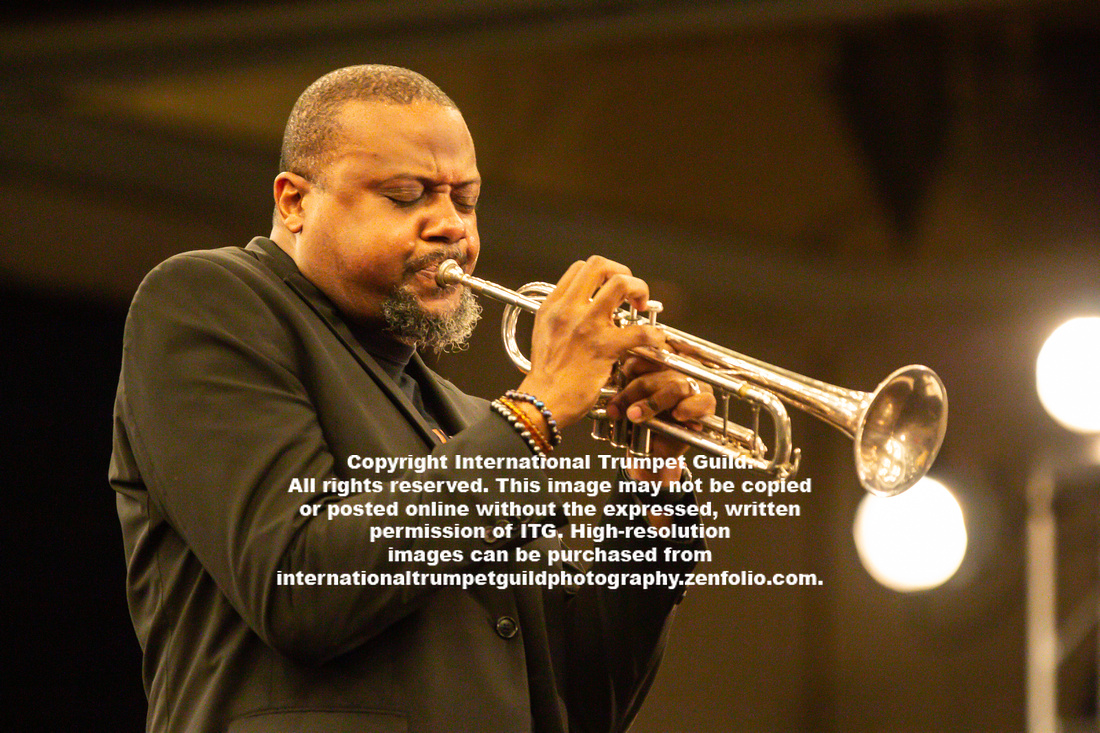
Festival of Trumpets
The Festival of Trumpets opened with an exciting world premiere of Jason Dovel’s Sonitus Fanfare for seven Baroque trumpets. The work highlights the pomp and pageantry that Baroque trumpets can bring to any modern composition. The work explored all areas of range and presented wonderful idiomatic motives that herald the Baroque trumpet’s historic past.
Joshua Hobbs’s Soar grabbed the audience right from its opening fanfare and held their attention to the last measure. Centered around a short, double-tongued motive, the work provided each performer a chance to share the spotlight in both technical and lyrical musical lines.
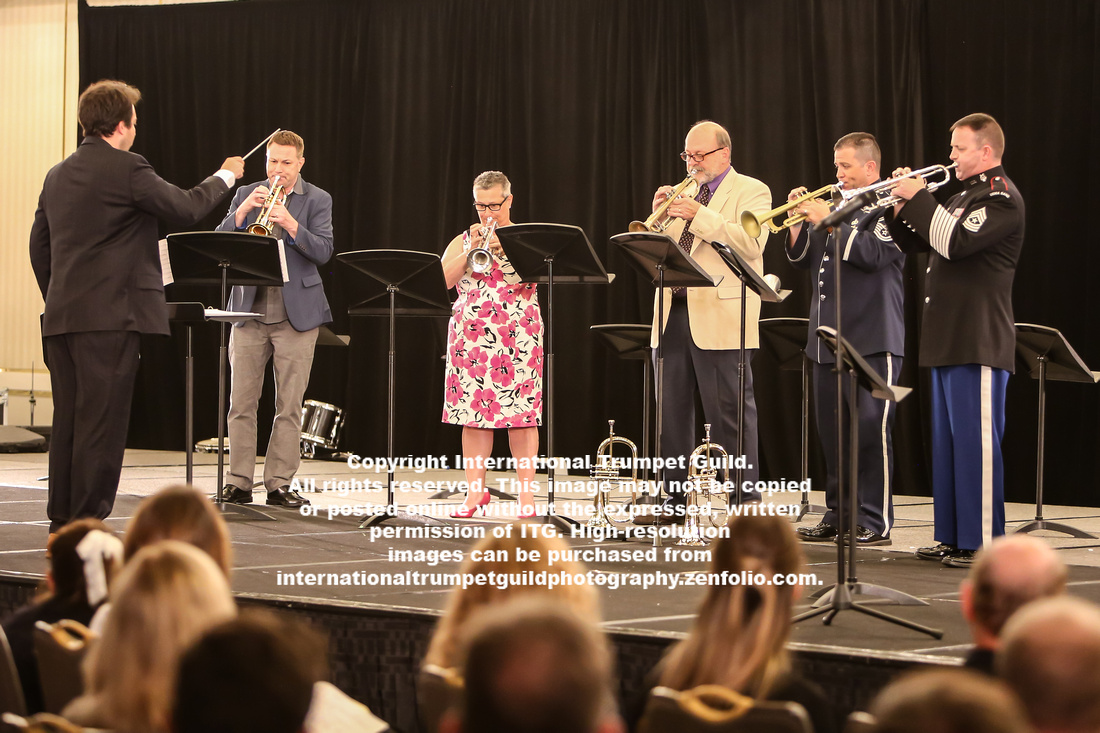
Aaron Hodgson’s arrangement for six trumpets of Media vita by Riho Esko Maimets opened with a lone solo trumpet melody presenting reveries of ancient times or distant lands. This melodic line was slowly shared and harmonized throughout the entire ensemble before reaching a climactic finish.
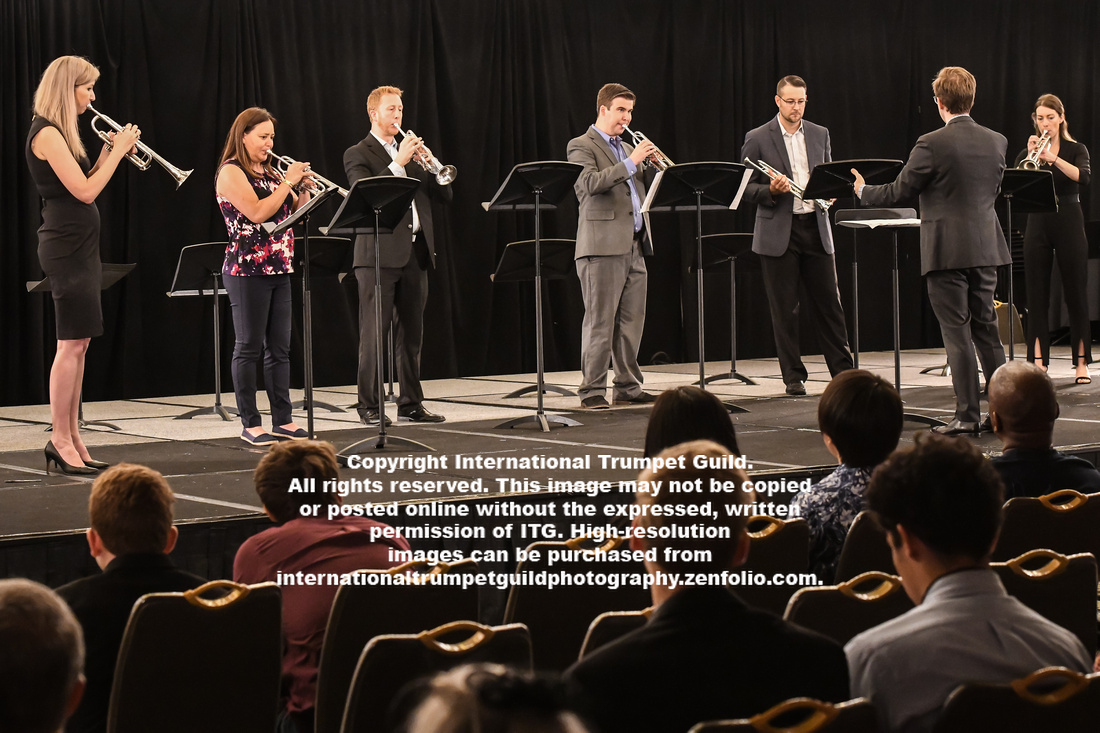
The Gaze by Richard Gillis brought a unique flair to the traditional trumpet ensemble repertoire. The work’s grooving ensemble sections and improvisatory solo moments allowed the ensemble members to flex their “jazzier” side.
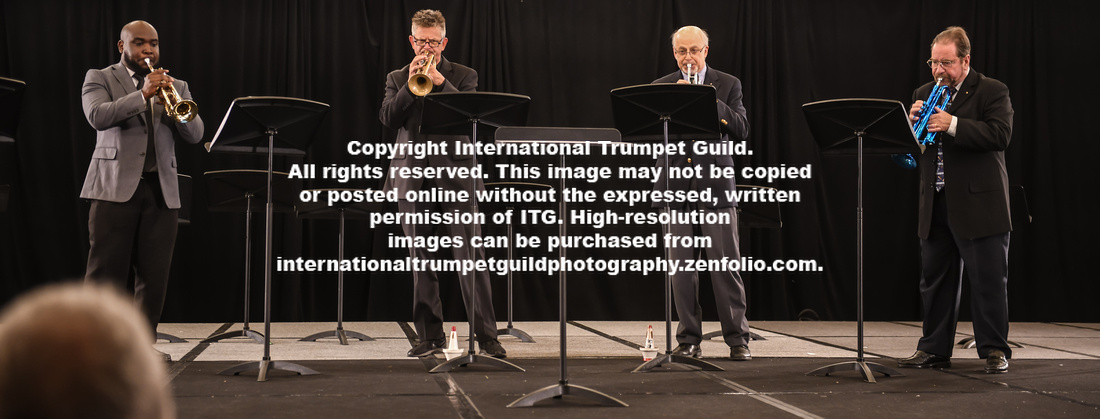
Rob Roy McGregor’s Essay opened with a hypnotic and dark melody that slithered its way through the ensemble using different colors and melodic alterations. The piece featured various mutes that gave the work a wonderfully eclectic palette of sound for the listener to enjoy. Erik Morales’s transcription of Glinka’s Ruslan and Ludmilla Overture hit the audience right off the bat with its triumphant opening. The fast scalar passages and passing ascending lines led the audience through each section as it built to its final climactic notes.
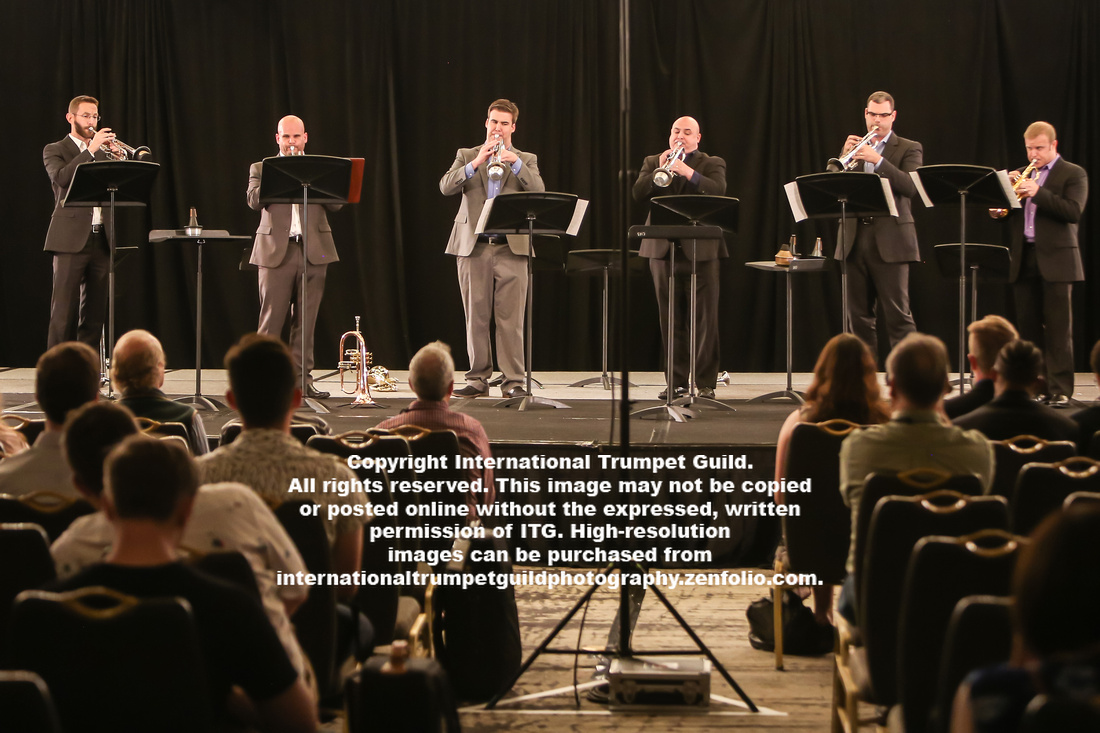
Daniel Gianola-Norris’s arrangement of Amy Beach’s Gavotte, Op. 36, No. 2 presented a wonderful showcase of this traditional work. The motives were beautifully harmonized and accentuated with rhythmic lines that highlighted the many idiomatic traits of the trumpet.
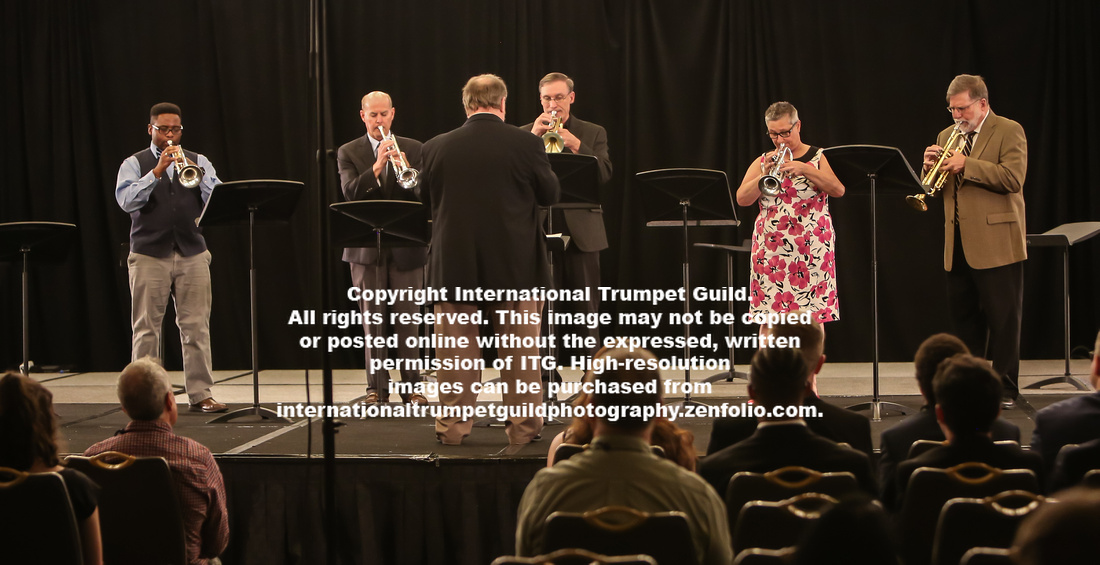
Joe Price’s Westward Ho! brought the thrill and adventure of the Wild West to the concert hall. The tight rhythmic figures driven by the beautiful lyrical lines presented a wonderful dichotomy within the piece. Each of the five performers added their own flair and color to the rip-roarin’ melody as it passed throughout the ensemble.
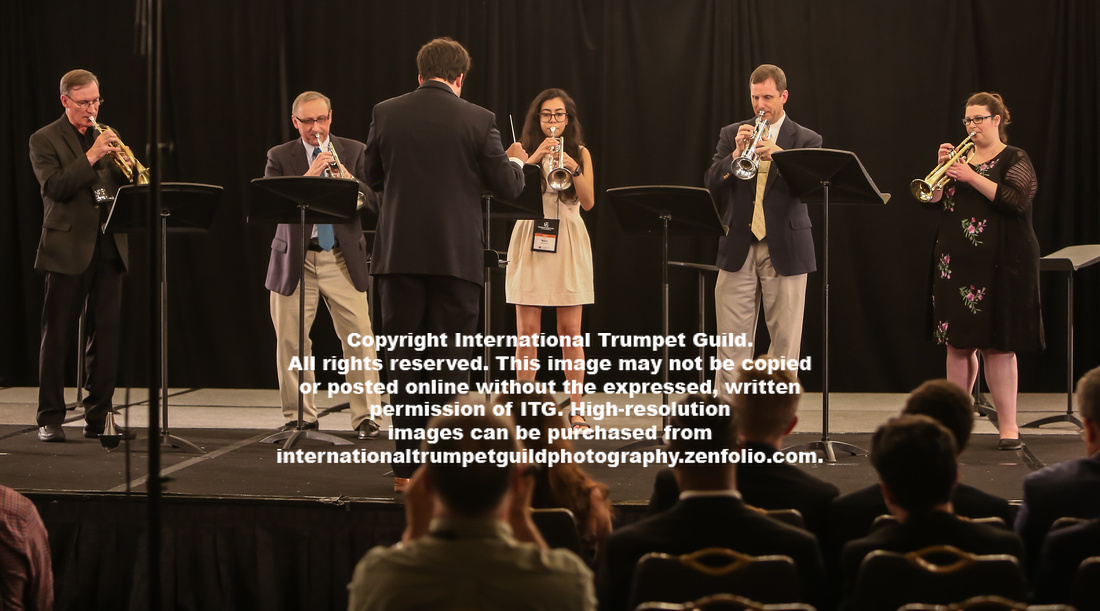
Adrian Kelly’s Inside The Gate: A Fanfare in Blue for jazz trumpet section opened with an ear-catching groove that gave way to more soloistic improvisatory moments for members of the ensemble. The group navigated the difficult shout sections with ease and added a wonderful depth of color to their melodic lines throughout the work.

Engelbert Humperdinck’s famous “Evening Prayer” from Hansel and Gretel, arranged by John Irish, provided a reflective tribute to those who had passed away since the last ITG Conference in 2018. The ensemble’s beautiful sound and color were highlighted by the many lyrical lines and rich harmonies in this famous work.
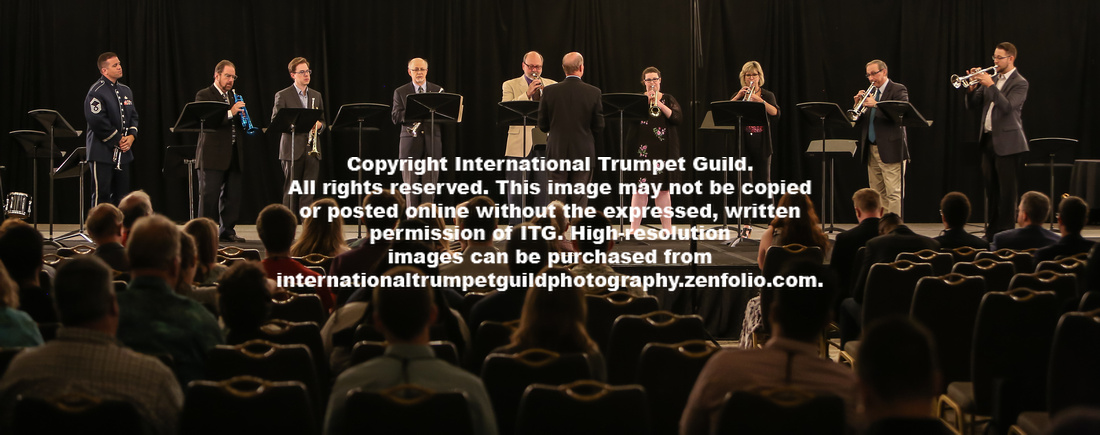
Erik Morales’s Within Sacred Walls provided the audience with yet another reflective composition with its slow-moving melodies and rich timbre. The ensemble presented a beautiful tone and soaring sound as they navigated the piece towards the climactic final notes. Leroy Anderson’s famous The Rakes of Mallow was a wonderful and light-hearted addition to the program. The traditional folk-like melodies were aided by the power of the festive accompaniment. The ensemble presented a fantastic performance that brought several listeners to their feet.
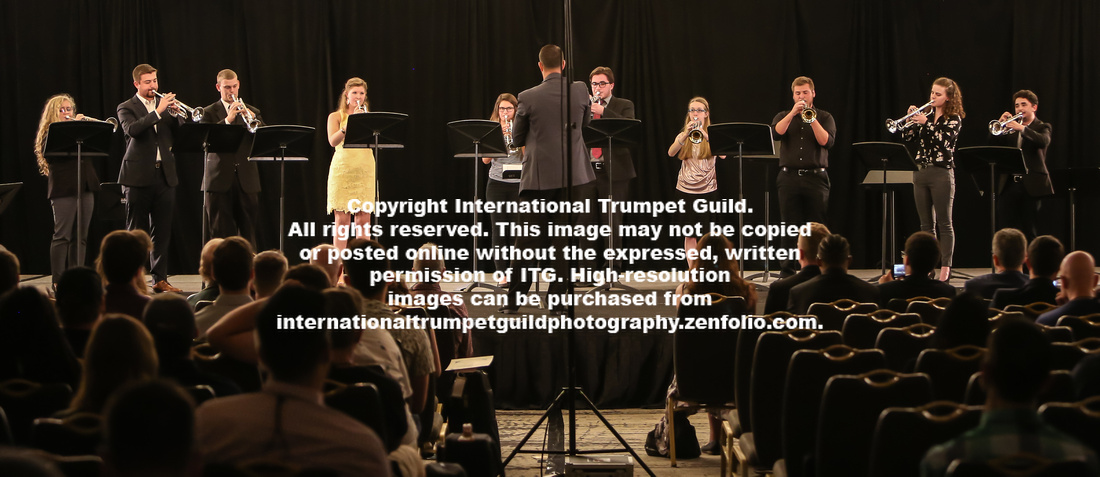
The world premiere of Jason Dovel’s The Legend of Pandora was presented by the Non-Pro Trumpet Ensemble. The work grabbed the audience right from the beginning with a huge punch of chords and swirling motivic lines. The piece presented rich soaring melodies that were separated by small chaotic episodes and ended with exciting fanfares.
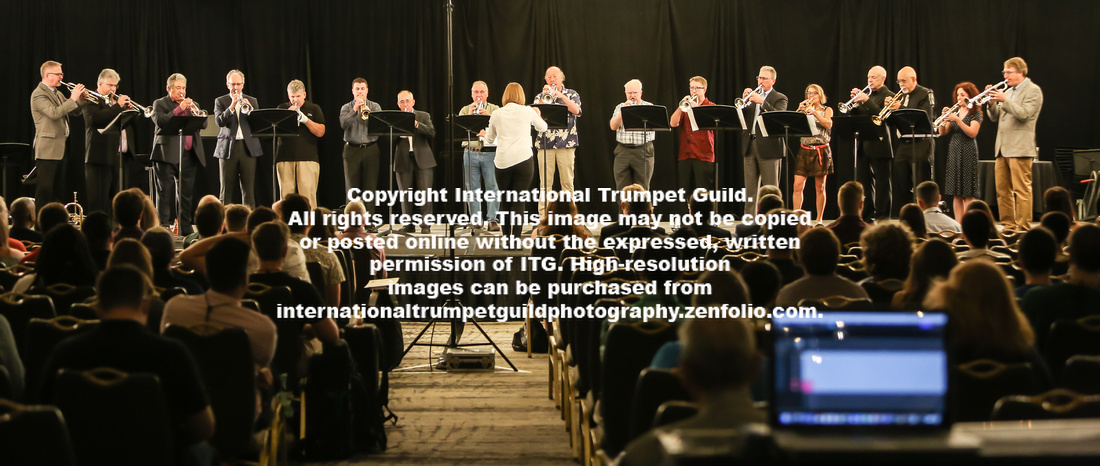
The final piece on the concert featured the largest gathering of performers. James Olcott conducted Michael Serber’s transcription of Poet and Peasant Overture by Franz von Suppe, taking the audience on a musical journey and highlighting the cast of characters from this famous work. The solo lines soared through the rich, beautiful textures of the accompaniment. The climactic moments gave the audience a wonderful and exciting thrill as the sheer size of the ensemble’s sound truly filled the hall. (JPS and PS)
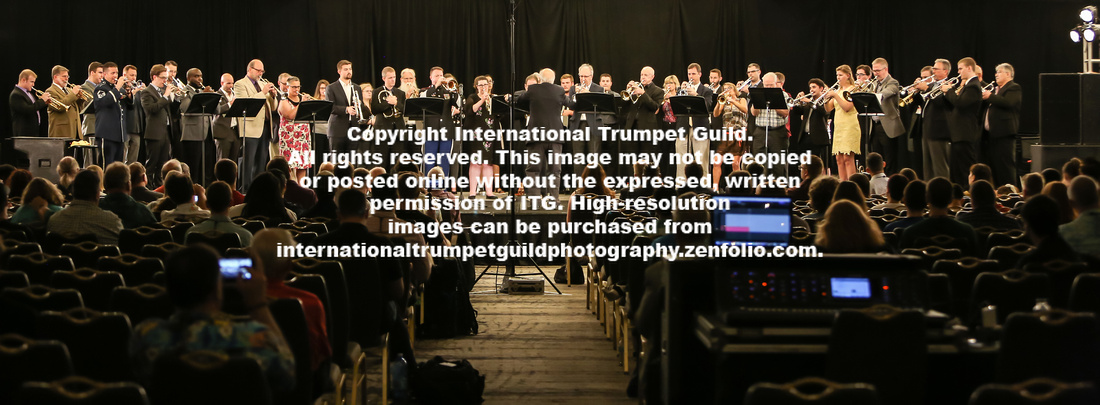
Click here for more photos from the ITG Conference
]]>
Special Daily Report • Compiled by Peter Wood
Photos by Michael Anderson, Norman Black, Benjamin Lowe, and Donald Sorah
Friday, July 12 - Evening events
Click here for more photos from the ITG Conference
ITG Legacy Reception
Alan Siebert welcomed all those in attendance at the annual Legacy Fund reception, which was open to all ITG members. He introduced Bill Pfund, who spoke about the history and purpose of the Fund, established to support projects that align with the mission of the Guild. Longtime member Paul Kurtz encouraged those in attendance to spread the word among members about opportunities for giving that not only support our projects, but also provide a third-level back-up plan to the operating budget and emergency fund. More information about the Legacy Fund can be found on the ITG Website (https://www.trumpetguild.org/give). (GP)
Summer Night at the Orchestra
Check out the ITG YouTube Channel for videos from the concert!
This evening’s program featured a stellar roster of international soloists accompanied by the ITG Festival Orchestra, under the baton of the Swiss conductor and trumpeter, Olivier Anthony Theurillat. First on the program was Vivaldi’s Concerto No. 9 in D Major, featuring Daniel Crespo, principal trumpet of the Philharmonic Orchestra of the Teatro Colon in Buenos Aires. Playing from memory on piccolo trumpet, Crespo’s refined elegance and effortless trills spun a golden web of sound in the large auditorium. His ability to float above the sensitive string accompaniment in both lyrical and virtuosic passages was incandescent.
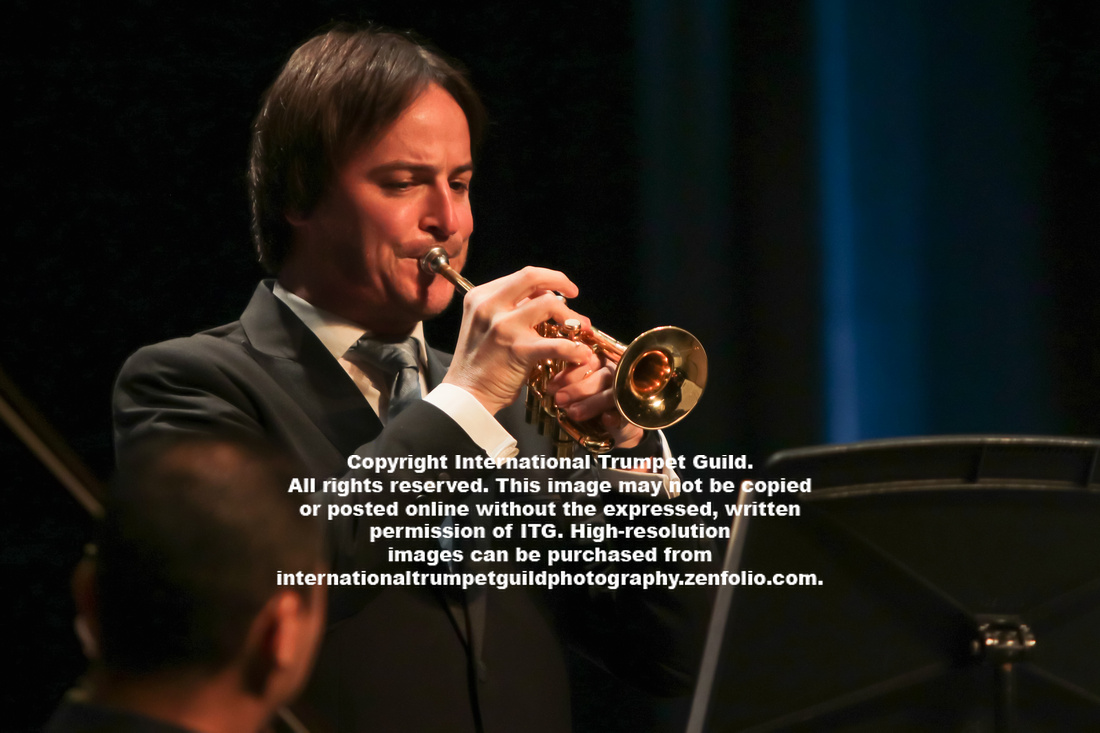
Amy McCabe of the United States Marine Band was next on the program, performing the second and third movements of Eric Ewazen’s Concerto for Trumpet and Orchestra. In the mournful second movement (Elegia), her crystal-clear tone was supported by rhapsodic string writing reminiscent of Vaughan Williams. The third movement, Allegro Agitato, featured angular interjections, propulsive rhythms, and an accompanied cadenza at the end.
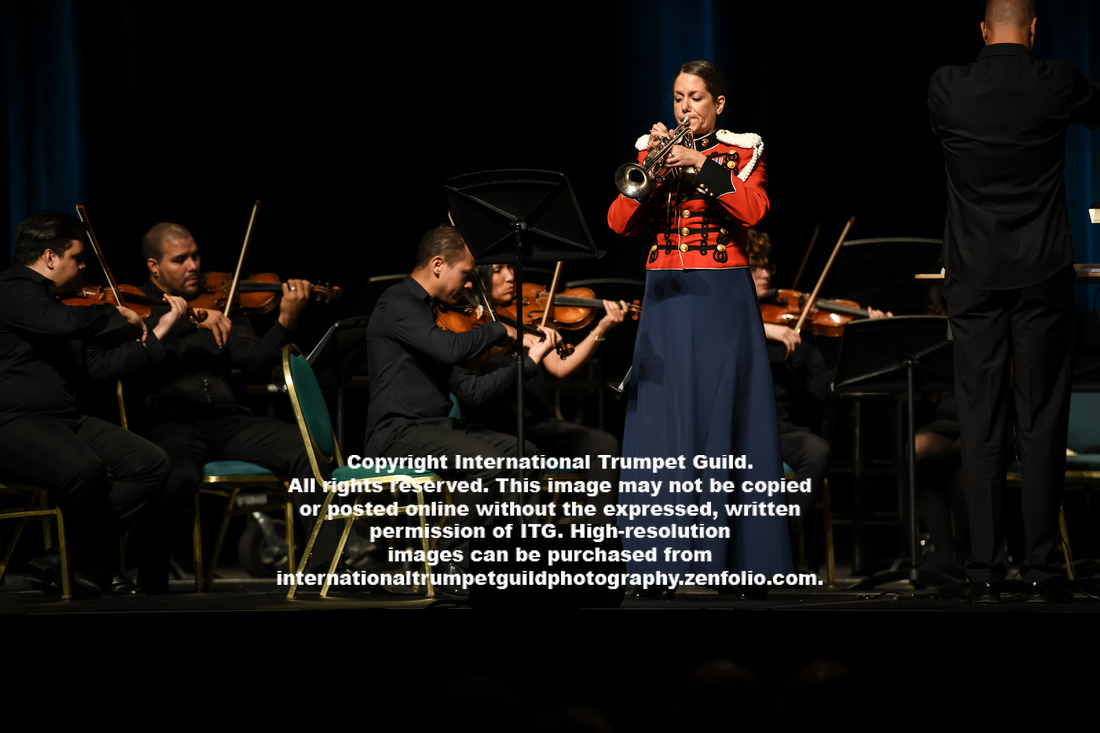
Following the Ewazen, ITG President Cathy Leach presented the ITG Honorary Award to Ryan Anthony. Because Ryan has been hospitalized for the past several weeks battling cancer, his children, Lilly and Rowan Anthony, accepted the award on his behalf while his wife, Nikki, live-streamed the ceremony on a smartphone so Ryan could watch from his hospital bed. It was an emotional moment when Lilly Anthony read an inspirational acceptance letter from her father followed by a prolonged standing ovation.
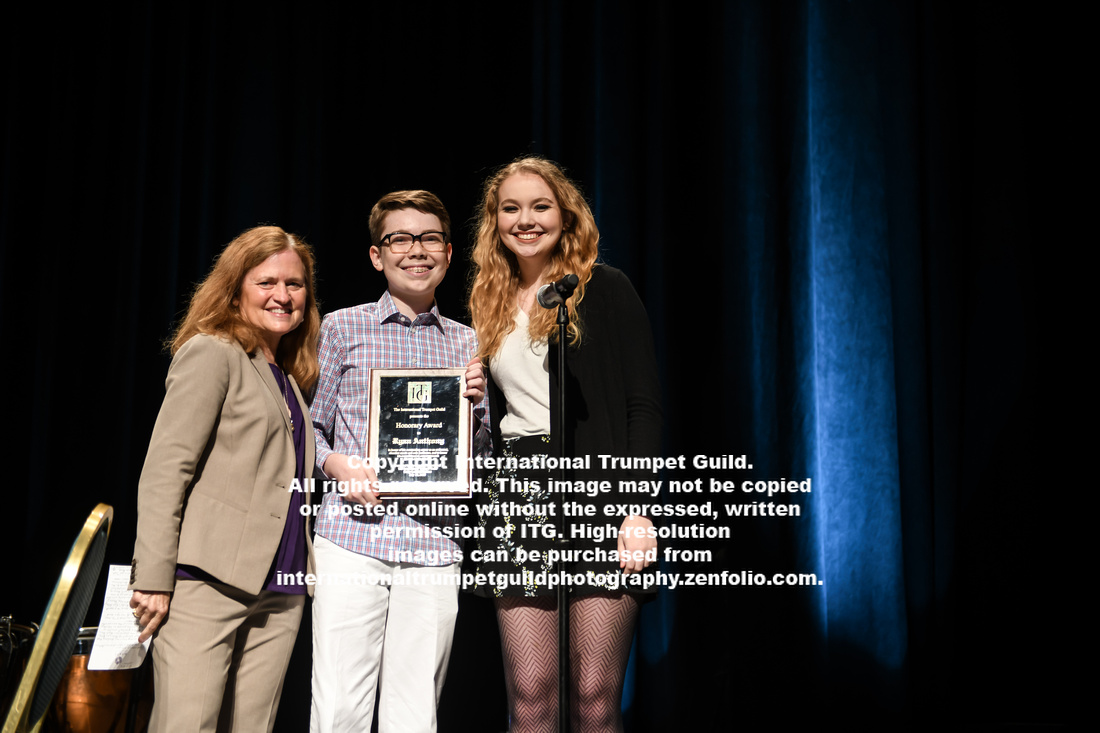

British trumpeter Matilda Lloyd was featured next in Ivan Jevtic’s Suite Concertante for Piccolo Trumpet and Strings, “Que le jour est beau!” The four-movement work, which was composed in 1985, highlighted Lloyd’s ringing tone, sparkling articulation, and rhythmic precision. Theurillat and the orchestra brought out all the expressive drama and poignancy of the challenging score.
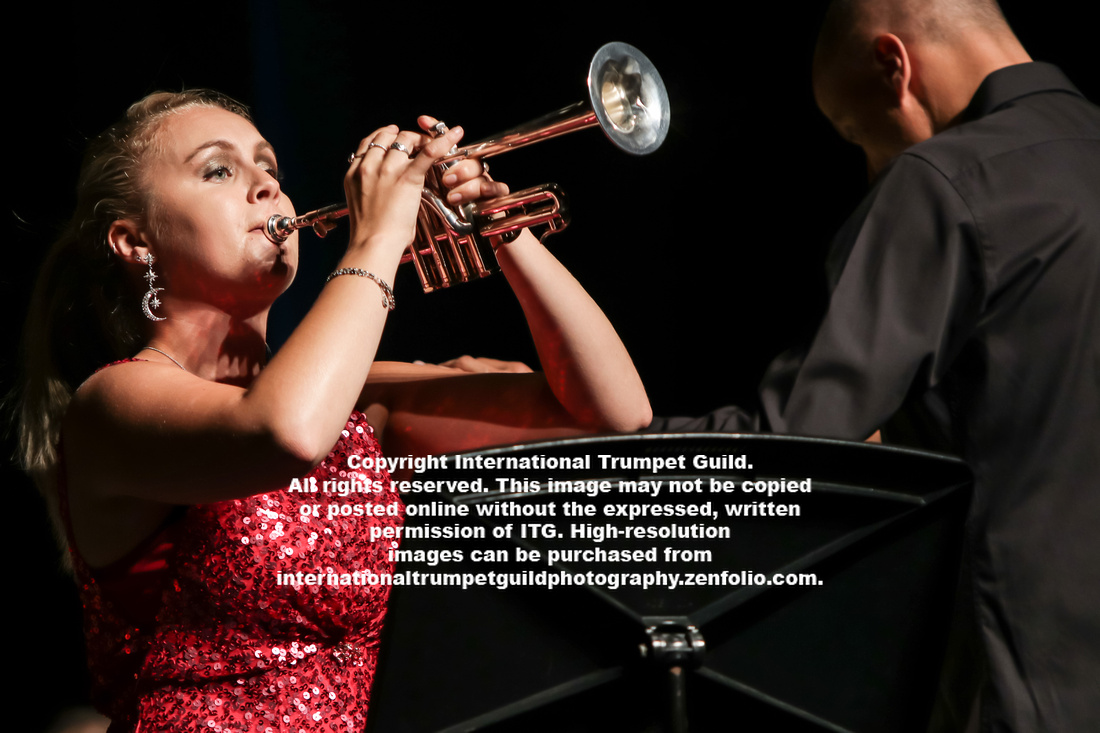
A sensitive performance of Copland’s Quiet City featured Jason Bergman on trumpet and Grant Peters playing the solo English horn part on flugelhorn. Both soloists displayed pinpoint accuracy and gorgeous lyrical playing.
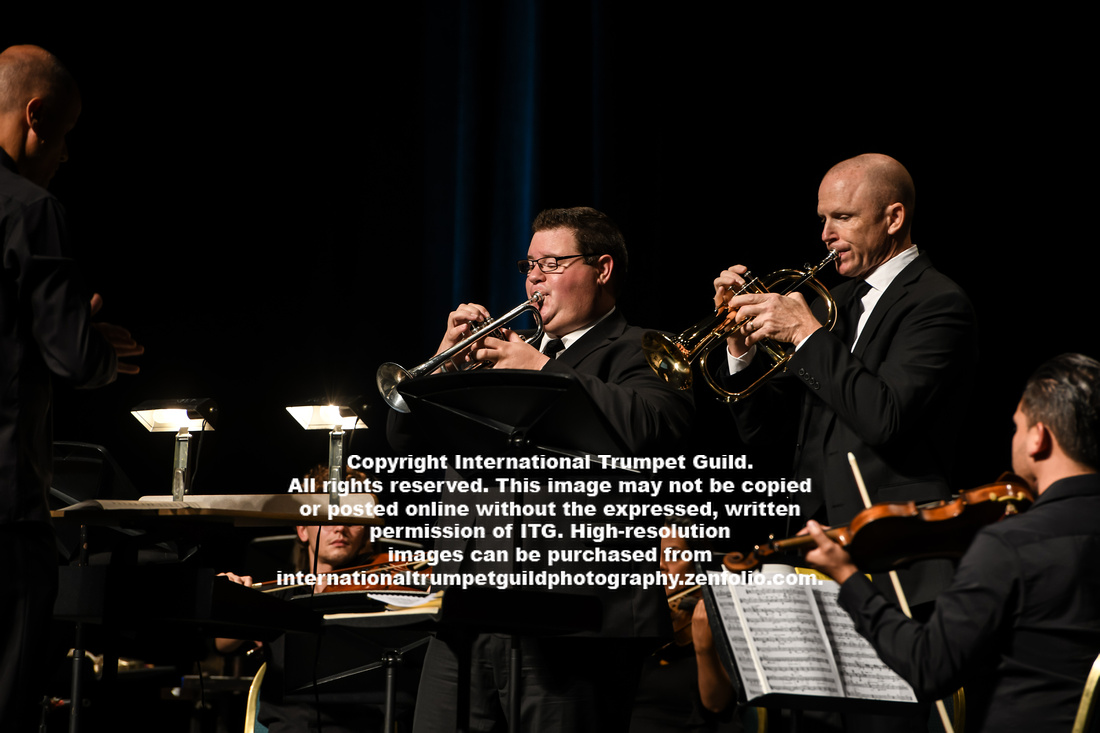
The final selection on the program, Jorg Widmann’s Concertpiece for Trumpet and Small Orchestra, “ad absurdum” (2002), was a tour de force written for Russian trumpeter Sergei Nakariakov. Performing on a B-flat trumpet while circular breathing, Nakariakov dazzled with a seemingly endless blizzard of double-tongued sixteenth notes in patterns of increasing range and complexity. What was truly “absurd” was how Nakariakov made it all seem so easy. The piece was a ferociously difficult perpetual motion that sustained an unbelievable amount of tension for fifteen minutes. According to the composer’s note in the score, “The trumpeter is a playmaker who gleefully displays maximum velocity right from the start, yet, revolving in his momentum strangely stolidly, he is ultimately imprisoned in his own virtuosity and suffocates.” If anyone felt like suffocating, it was the audience, waiting in breathless anticipation for Nakariakov’s supernaturally long phrases to end. At a few points, thundering timpani broke the tension until the piece ended with two low pedal tones and the orchestra fizzled to silence. The audience showered Nakariakov with a rousing ovation as all the soloists returned to the stage for a final bow. (EK)
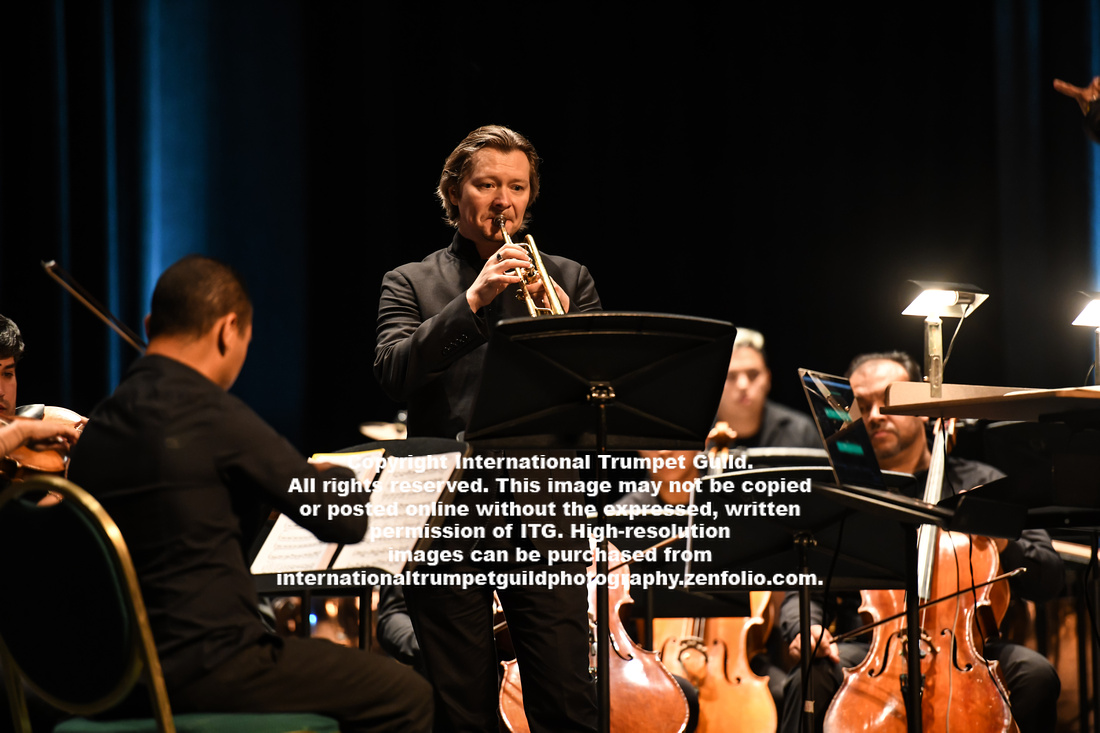

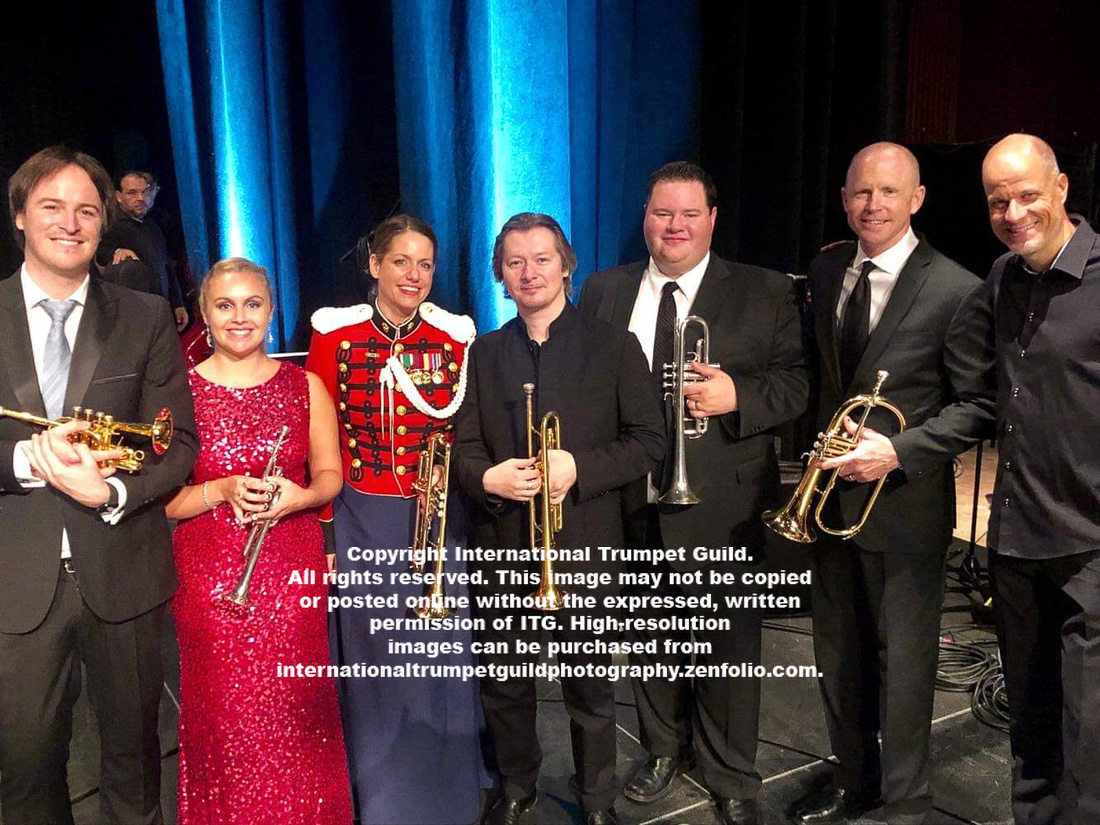
Check out the ITG YouTube Channel for videos from the concert!
Carl Fischer and T.Ë.T.I.: Tribute to Evolutionary Trumpet Icons
Carl Fischer presented an innovative and cleverly constructed concert, accompanied by a six-piece ensemble that included guitar, bass, drum set, and percussion, along with trumpeter Stephen Wright and the incredible tenor saxophonist Michael McArthur. Titled “Tribute to Evolutionary Trumpet Icons” (T.Ë.T.I.), the concert featured trumpet players who revolutionized music and trumpet playing, including Louis Armstrong, Dizzy Gillespie, Miles Davis, and Maynard Ferguson. Fischer interspersed videos of interviews of Dizzy, Miles, and Maynard while bringing his own unique spin to works made famous by each artist, including What a Wonderful World (Armstrong), A Night in Tunisia and Salt Peanuts (Gillespie), Someday My Prince Will Come and All Blues (Davis), and Chameleon and Birdland (Ferguson). Fischer, dazzling on the trumpet, also played valved trombone, soprano sax, and tenor sax.The evening was a concert and a course in jazz history rolled together, making for a thoroughly enjoyable performance. (KE)
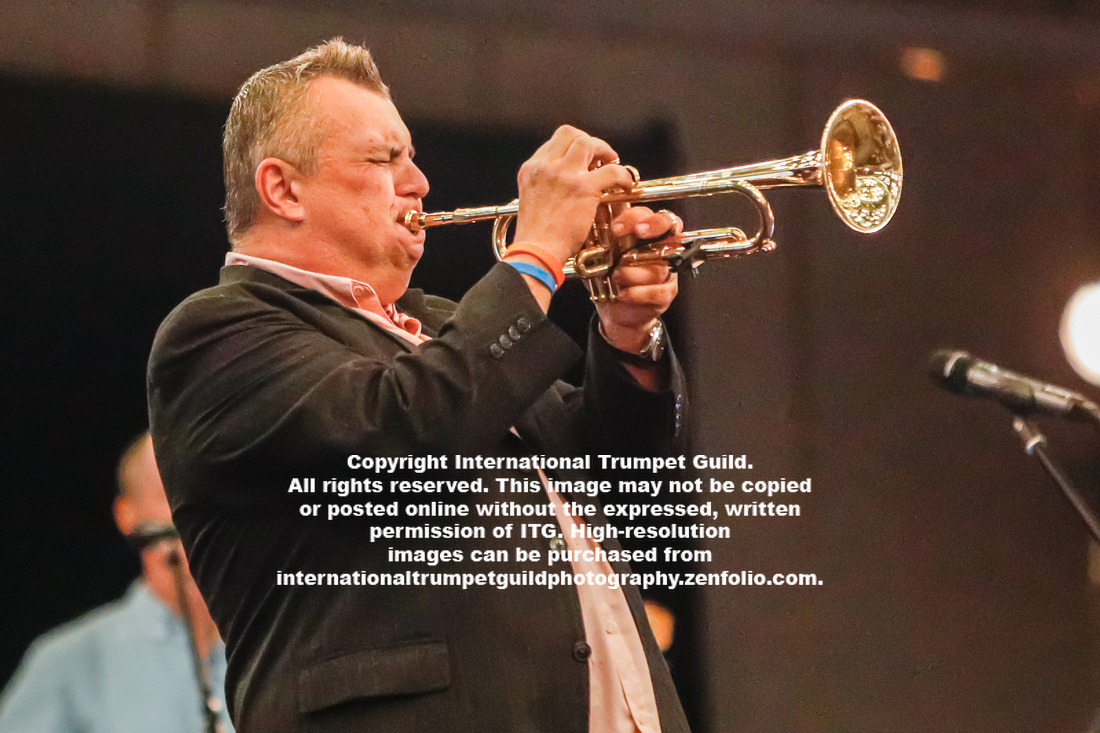
Click here for more photos from the ITG Conference
]]>
Coordinator: Jason Dovel
ITG ORCHESTRAL EXCERPTS COMPETITION
Chair: James Peyden Shelton
First Prize: Brent Proseus (Western Michigan University, student of Robert White)
Second Prize: Cordelia DeDecker (Baylor University, student of Wiff Rudd)
Third Prize: Nitiphum Bamrungbanthum (Mahidol University, student of Joseph Bowman)

ITG MILITARY BAND EXCERPTS COMPETITION
Chair: Amy McCabe
First Prize: Ross Mitchell (Baylor University, student of Wiff Rudd)
Second Prize (tie): Tyler Moore (Baylor University, student of Wiff Rudd)
Second Prize (tie): Stephen Spink (Baylor University, student of Wiff Rudd)
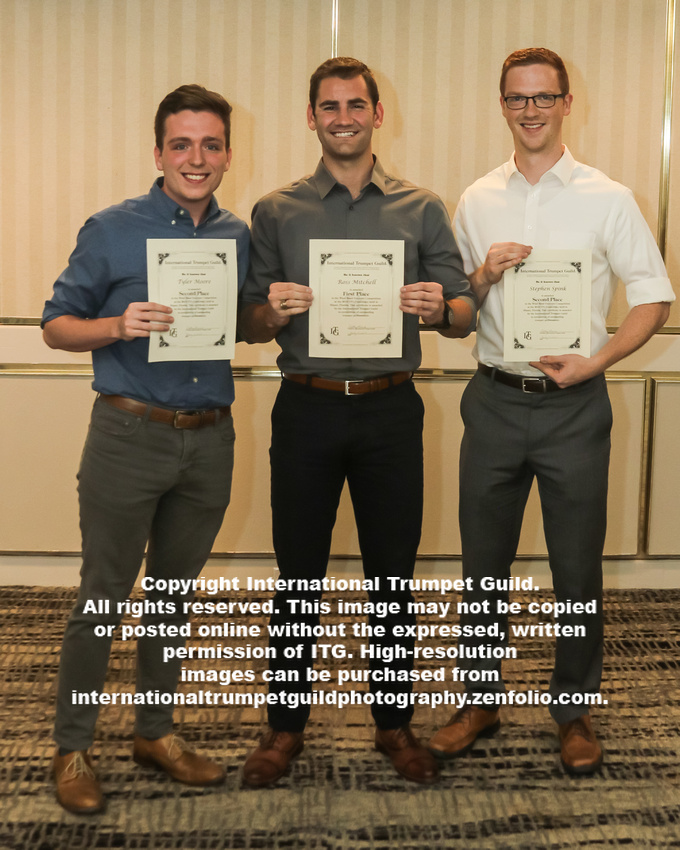
ITG SOLO COMPETITION
Chair: Nancy Taylor
First Prize: Seok Young Ahn (Los Angeles Brass Academy, student of Ohtae Kwon)
Second Prize: Chloe Swindler (Yale University, student of Allan Dean)
Third Prize: Tyler Moore (Baylor University, student of Wiff Rudd)
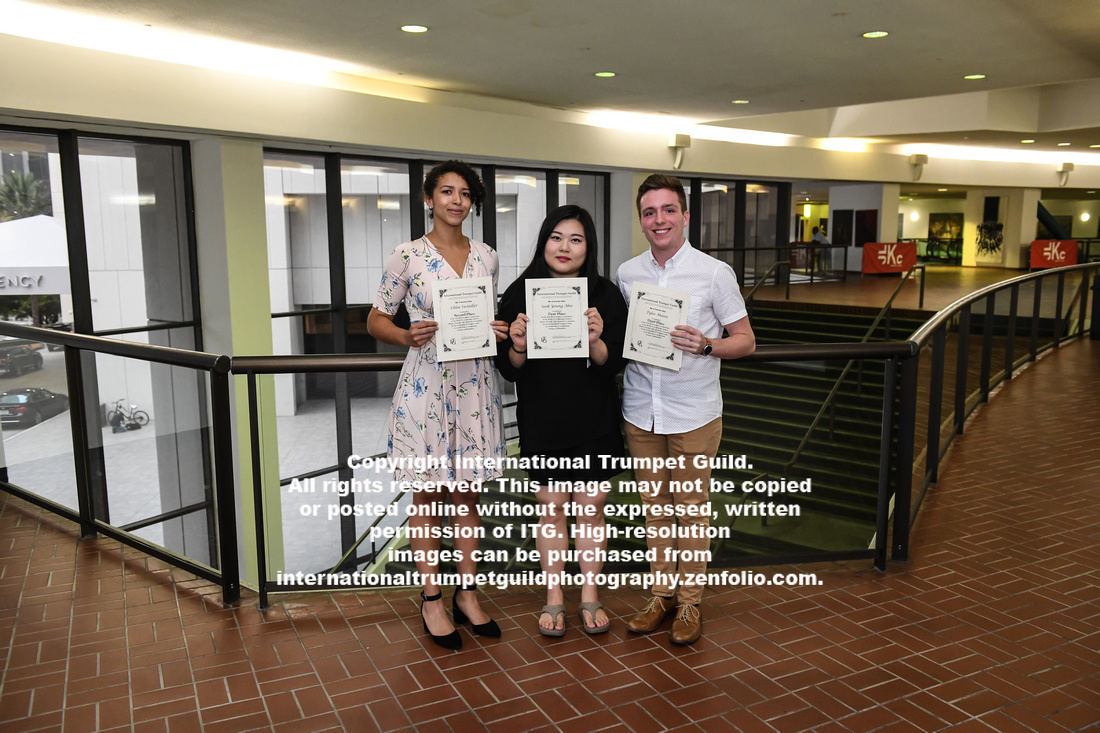
ITG JAZZ COMPETITION
Chair: Jason Carder
First Prize: Brandon Choi (Eastman School of Music, student of Clay Jenkins)
Second Prize: Ethan Avery (Home School OFL, student of Willie Murillo)
Third Prize: Alec Aldred (Manhattan School of Music, student of Scott Wendholt)
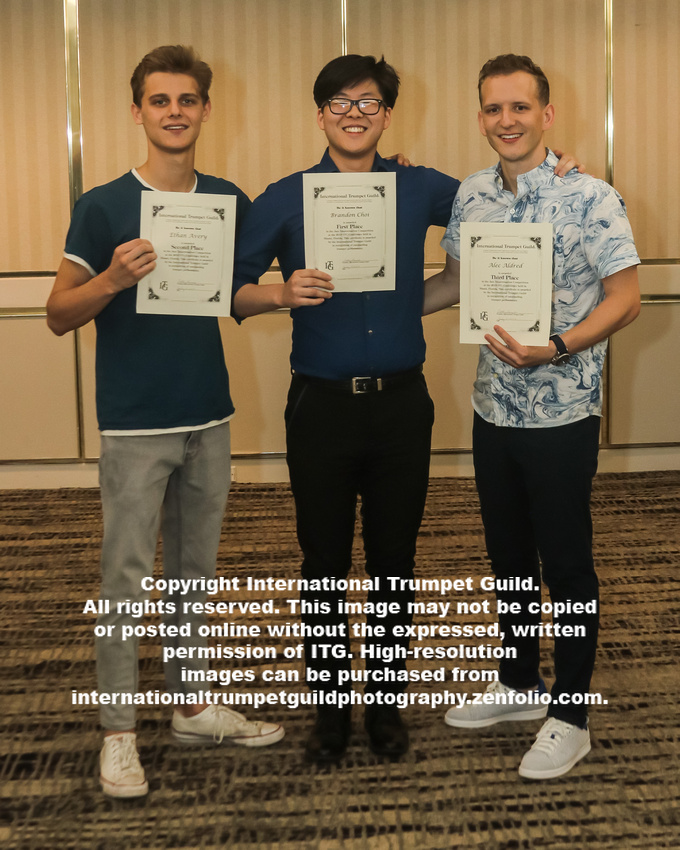
ITG YOUTH COMPETITION
Chair: Marc Reed
Junior Division
First Prize: Oliver Robinson (Jenks High School, student of Benjamin Hay)
Second Prize: Joshua Kucharski (DeMatha Catholic High School, student of James Roper)
Third Prize: Jade Park (MLC School, student of Robin Park)
Other Junior Division Finalists (in alphabetical order)
Benjamin Black
Jack Bricklemeyer
Sam Ferguson
Paul Kwak
Yuntong Li
Ruoshoi Min
Oliver Zhang
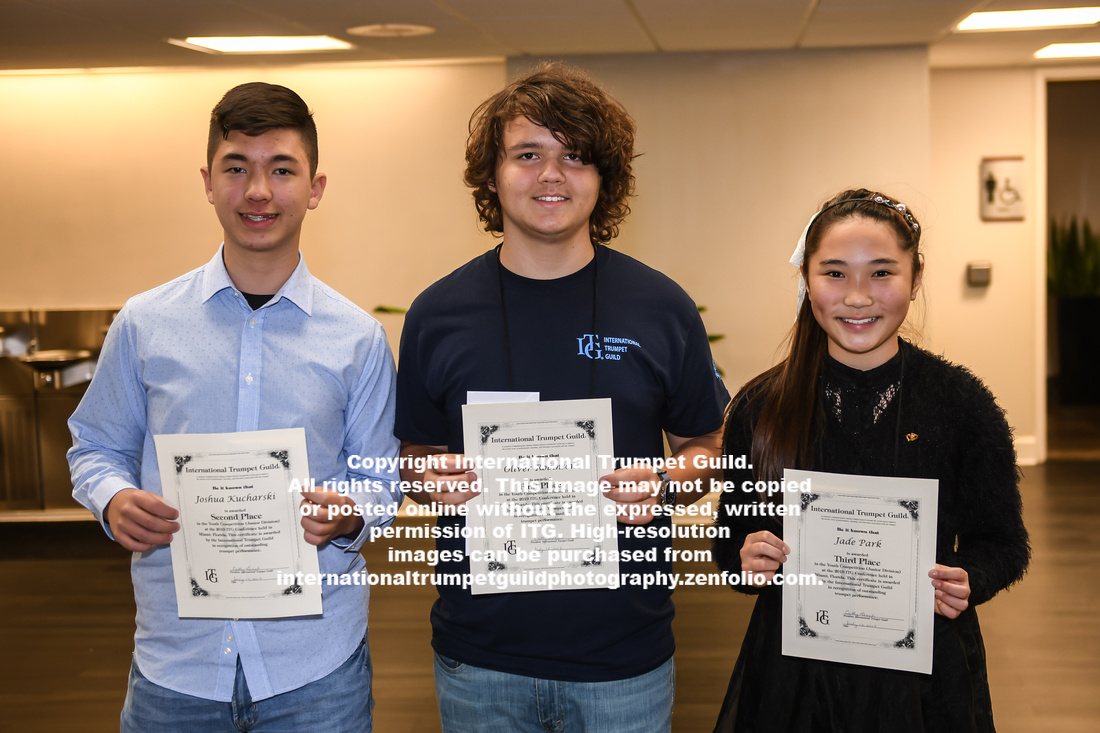
Senior Division
First Prize: Sung Ho Wui (Los Angeles Brass Academy, student of Ohtae Kwon)
Second Prize: Stefan Filip (Palatine High School, student of Matt Baker)
Third Prize: Ko-Te Chen (Senior Secondary Level Experimental Education, student of Jung Fu Hsu)
Other Senior Division Finalists (in alphabetical order)
Hector Robles Bastida
Gabriel Chalick
Adam Johnson
Nicholas Recktenwald
Jack Towse
Coleman Yanagisawa
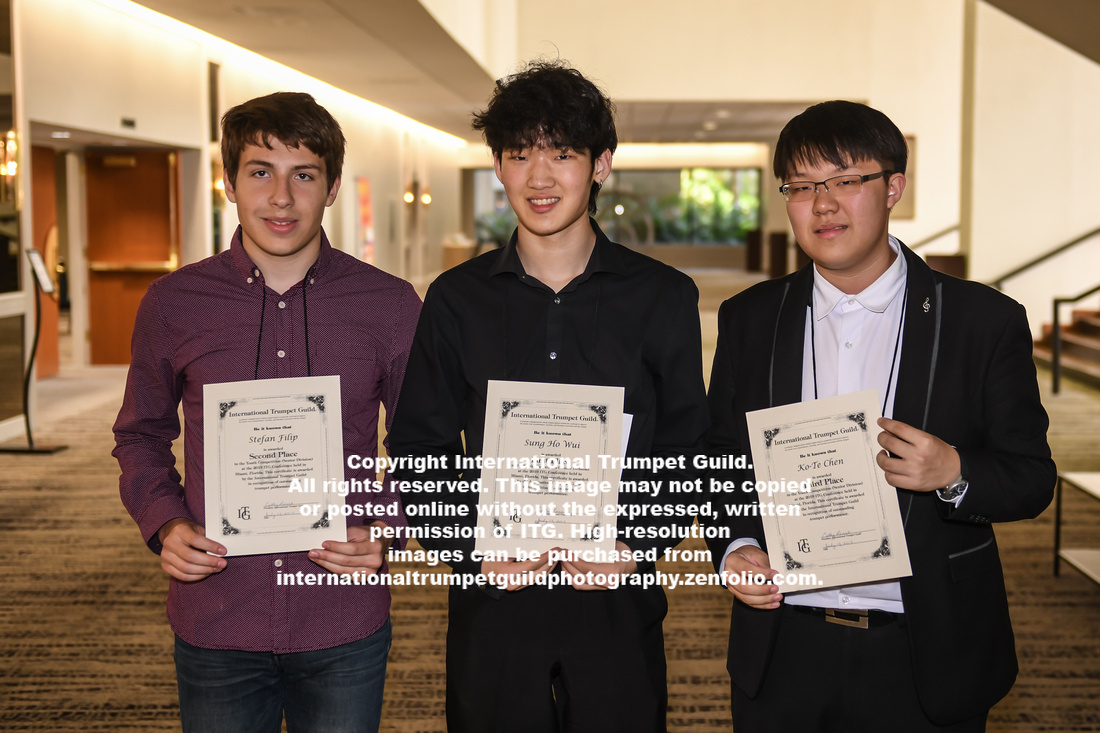
ITG CONFERENCE SCHOLARSHIPS FOR STUDENTS
Coordinator: Jennifer Dearden
Pre-High School/High School Division Judges
Kyle Millsap, Texas A&M University Kingsville
Blakely Rosengaft, The United States Air Force Band, Washington, DC
Bill Takacs, West Texas A&M University
College/Graduate Divisions Judges
Tina Erickson, University of Tennessee
Jason Bergman, Brigham Young University
Robert Murray, Columbus State University
Jazz Division Judges
Dave Coolidge, Phoenix, Arizona
Trent Austin, Austin Custom Brass
Chad McCullough, DePaul University
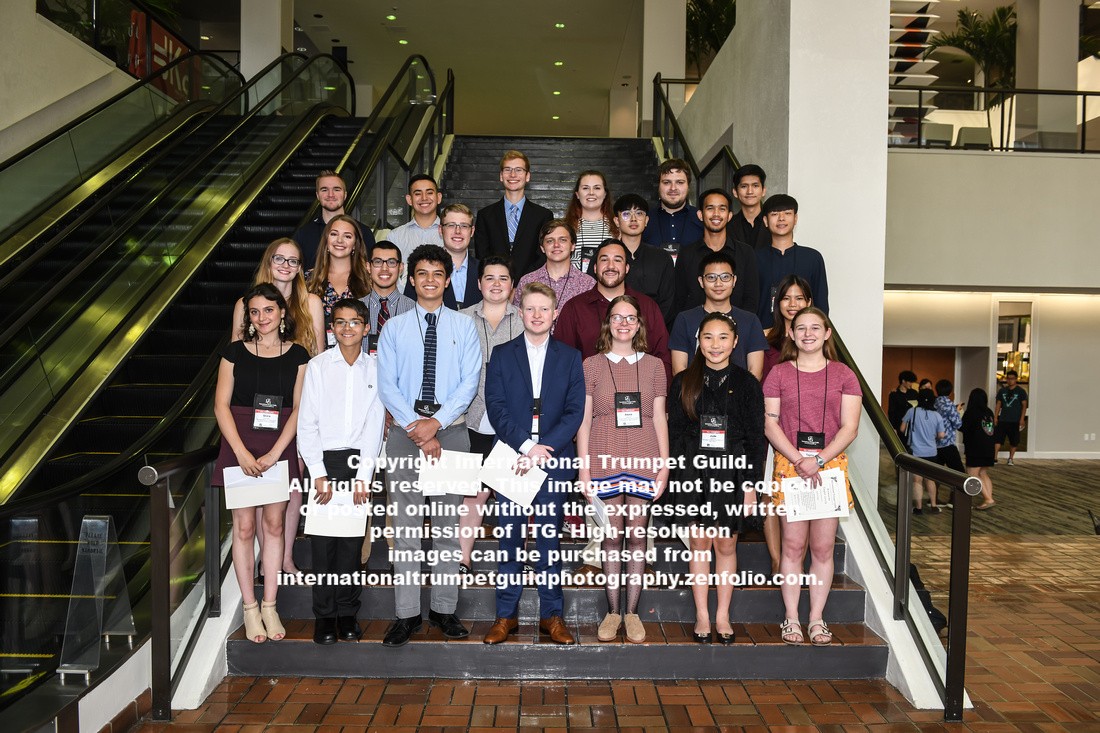
 Scholarship Winners
Scholarship Winners
DONALD P. BULLOCK MEMORIAL FUND SCHOLARSHIP
Donor: ITG Memorial Scholarships Fund
Matthew Naeger (University of Massachusetts, student of Eric Berlin)
KEITH CLARK MEMORIAL FUND SCHOLARSHIP
Donor: ITG Memorial Scholarships Fund
William Reynolds (South Dakota State University, student of David Reynolds)
EAST COAST TRUMPETS SCHOLARSHIP
Donor: East Coast Trumpets
Brian Maassen (Loyola University New Orleans, student of Nick Volz)
GARD BAGS SCHOLARSHIP
Donor: Talwar Bros. Ltd.
Termpong Jaiem (Mahidol University, student of Joseph Bowman)
Taylor Losey (Western Michigan University, student of Scott Thornburg)
BRYAN & NANCY GOFF SCHOLARSHIP
Donor: Bryan Goff
Megan George (James Madison University, student of Chris Carrillo)
KARL HAMMOND DESIGN SCHOLARSHIP
Donor: Karl Hammond Design
Nick Petrillo (University of Massachusetts, student of Eric Berlin)
ITG LEGACY FUND SCHOLARSHIP
Donor: ITG Legacy Fund
Austin Laurent (Oklahoma State University, student of Ryan Gardner)
KEN LARSEN’S BRASSWERKS SCHOLARSHIP
Donor: Ken Larsen’s BrassWerks
Jade Park (MLC School, student of Andrew Evans)
RICHARD B. LEHMAN MEMORIAL FUND SCHOLARSHIP
Donor: ITG Memorial Scholarships Fund
Trey Jeter (University of Arkansas, student of Richard Rulli)
BILL PFUND SCHOLARSHIP
Donor: Bill Pfund Trumpets
Elizabeth Pauli (South Dakota State University, student of David Reynolds)
PICKETT BRASS SCHOLARSHIP
Donor: Pickett Brass
Katharine Shindledecker (Winthrop University, student of Marisa Youngs)
CLIFTON PLOG MEMORIAL FUND SCHOLARSHIP
Donor: ITG Memorial Scholarships Fund
Landon Jordan (Clovis High School, student of Keith Sacane)
PUJE TRUMPETS SCHOLARSHIP
Donor: Puje Trumpets
Suchol Nintawong (Mahidol University, student of Joseph Bowman)
SANDY SANDBERG MEMORIAL SCHOLARSHIP FUND
Donor: ITG Memorial Scholarships Fund
Austin Alcancia (Perkiomen Valley High School, student of Rob Diener)
RENOLD O. SCHILKE MEMORIAL FUND
Donor: ITG Memorial Scholarships Fund
Pierce Elison (University of Massachusetts, student of Eric Berlin)
THE CHARLES SCHLUETER FOUNDATION SCHOLARSHIP
Donor: The Charles Schlueter Foundation, Inc.
Carlos Manuel Aceves (Interlochen Center for the Arts, student of Ken Larson)
Will Averill (University of Massachusetts, student of Eric Berlin)
Narongkit Chanthadilokporn (Mahidol University, student of Joseph Bowman)
Katelyn Frazier (University of Cincinnati College-Conservatory of Music, student of Alan Siebert)
ANATOLY SELIANIN SCHOLARSHIP
Donor: Stephen Chenette
Nitiphum Bamrungbanthum (Mahidol University, student of Joseph Bowman)
STUART D. SHANLER SCHOLARSHIP
Donor: Stuart Shanler
Brian Maassen (Loyola University New Orleans, student of Nick Volz)
THOMPSON MUSIC CO. SCHOLARSHIP
Donor: Thompson Music Co.
Shira Agam (University of British Columbia, student of Larry Knopp)
DINO TOFANELLI MEMORIAL SCHOLARSHIP
Donor: Andrea Tofanelli
Matthew Swerts (University of Arkansas, student of Richard Rulli)
MICHAEL TUNNELL MEMORIAL SCHOLARSHIP
Donors: Friends & Family of Michael Tunnell
Alexa York (Bowling Green State University, student of Charles Saenz)
WARBURTON MUSIC PRODUCTS SCHOLARSHIP
Donor: Warburton Music Products
Sam Ferguson (Acadia Junior High School, student of Darryl Ferguson)
Joseph McNulty (University of Virginia, student of Donald Sorah)
WASHINGTON MUSIC CENTER 60th ANNIVERSARY SCHOLARSHIPS
Donor: Washington Music Center
David Abbuhl (Bowling Green State University, student of Charles Saenz)
Jonathan Duranlea (Bowling Green State University, student of Charles Saenz)
Thanawat Munsilph (Mahidol University, student of Joseph Bowman)
WEIMANN ROTARY SCHOLARSHIP
Donor: Weimann Brass
Matthew Dao (University of Massachusetts, student of Eric Berlin)
CHARLES PATRICK WRISTEN MEMORIAL SCHOLARSHIPS
Donors: Christine Wristen, Paula Wristen, Marlene & Randy Linden
Brett Cole (Loyola University, student of Nick Volz)
Radit Towong (Mahidol University, student of Joseph Bowman)
]]>
Special Daily Report • Compiled by Peter Wood
Photos by Michael Anderson, Norman Black, Benjamin Lowe, and Donald Sorah
Friday, July 12 - Daytime events
Click here for more photos from the ITG Conference
Alan Klaus - Interleaved Warmup
In his morning warm-up session, Alan Klaus focused on explaining and demonstrating the benefits of interleaved practice. He began by alternating through a series of stretches, buzzing, lip bends, and gentle long tones. His one minute of meditation was a welcome inclusion to focus on the imagery of positive musical experiences and overall gratitude. A large part of the session was spent explaining the science behind the benefits of interleaved practice and how it can achieve long-term progress. Interleaved practice, which involves constantly mixing and rotating through different material, provides more of a challenge than traditional “block practicing,” or staying with the same type of material for longer sets until you gain comfort with it. The last portion alternated between mouthpiece buzzing, scales, and Bach chorales. Playing in four-part harmony was an excellent way to close the session––by making music together. (NV)
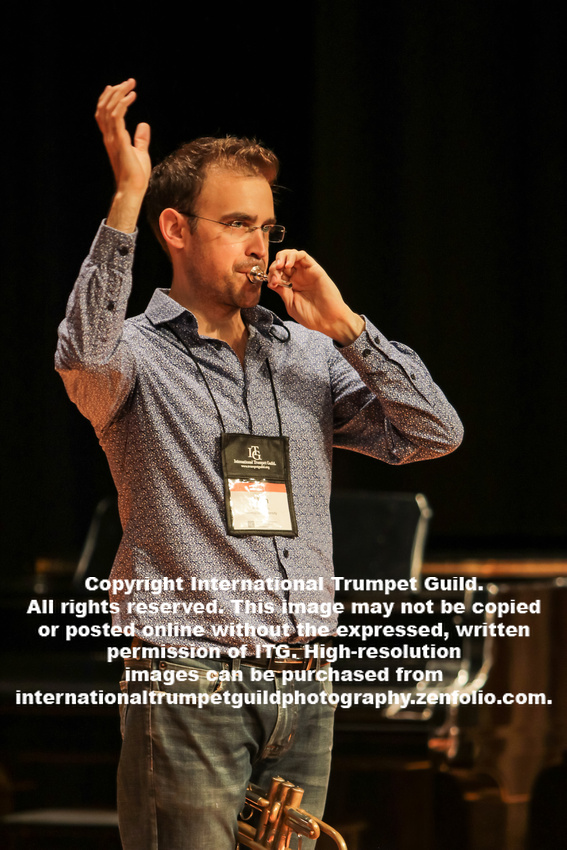
Marisa Youngs - Balance Under Pressure: Warm-Up Tactics for Audition and Performance Days
Dr. Marisa Youngs led an active warm-up session focused on establishing a routine that is careful to avoid adding tension/anxiety of any kind. Her notes on preparing for an audition or performance included valuable information, including consistency of material, physical health, and focus on the individualized nature of routines. Her recommendation for students is to try as many warmups as possible to see what works best and to warm up with all of the techniques needed in your audition or performance. Young’s metronome-guided group routine started with Breathing Gym exercises and then moving to “foo,” “hoo,” “poo,” and “too” attacks on the mouthpiece. She then moved on to some expansion exercises, flow studies, Clarke No. 1, Shiner flexibilities, major scales, and Stamp/Gekker-esque articulations. The remainder was focused on how to tailor the rest of one’s routine for two different audition scenarios and what to do after the warmup. (DG)
Kyle Millsap and Jonathan Cresci - The Art of the Audition Recording
During a busy morning of presentations, Kyle Millsap and Jonathan Cresci gave an informative session on the proper preparation, equipment, and practices for creating a professional-quality performance recording. Dr. Millsap began the lecture by outlining the performance aspects, with excellent suggestions regarding audition requirements, repertoire choices, and logistical elements. A particularly helpful piece of advice was to allow one hour of recording for every five minutes of music to be recorded in order to avoid time constraints. Cresci, a recording engineer, gave a succinct overview of appropriate equipment needed for a professional recording. He specifically advised recording at 24 or 16 bit and 48 khz and also discussed finding the appropriate “blend” in the room by moving the microphone back and forth first and then adjusting the height. The session ended with an impromptu demonstration of optimal microphone placement, with Millsap playing exercises and Cresci discussing blend. (MY)
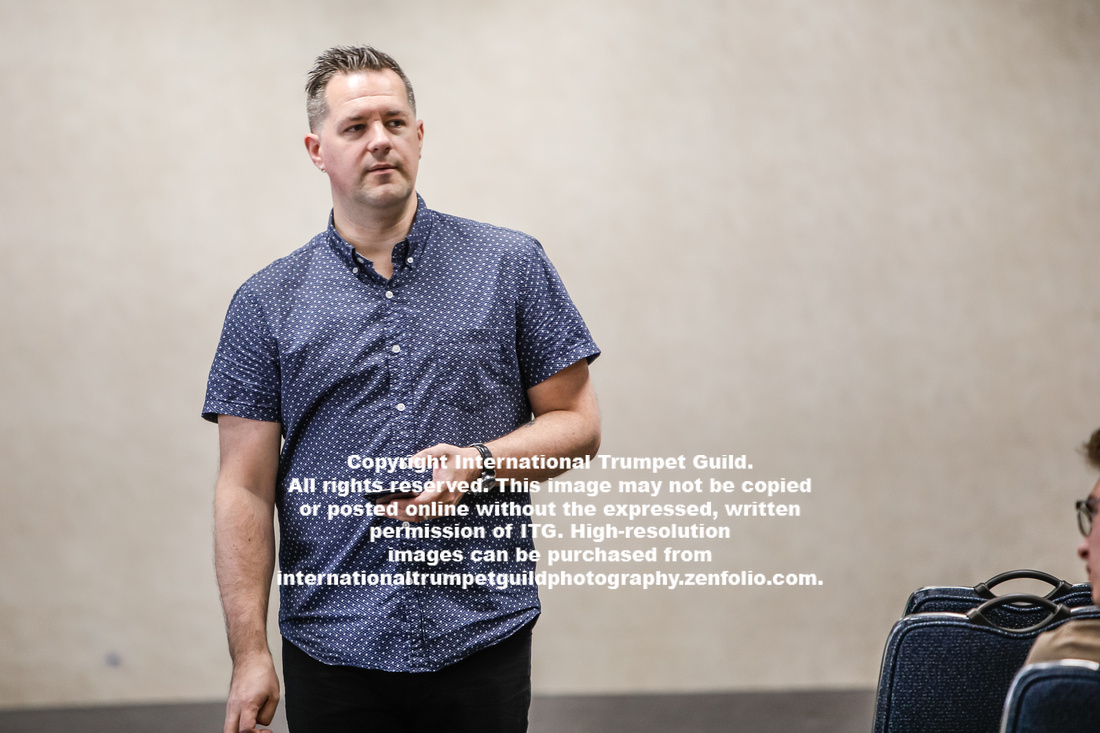
Fred Sienkiewicz Lecture Recital - The Trumpet Music and Armenian Heritage of Alexander Arutiunian
Fred Sienkiewicz presented an informative and entertaining lecture-recital on the music of Alexander Arutiunian (preferred spelling), packed with new research concerning the composer of one of our most popular trumpet concerti from the twentieth century. The fruit of more than five years of research, the session reviewed the composer’s six works for trumpet, his Armenian heritage, and related folk music influences. Sienkiewicz performed selections from the six works (from memory) with compelling expression and technique, accompanied by pianist Thomas Weaver. It was particularly interesting to hear audio examples of Armenian folk music and instruments juxtaposed with relevant passages from the Arutiunian concerto and his other works. A short video of the composer performing one of his piano works in 1962 was also shown. Sienkiewicz’s impressive command of languages (Armenian and Russian), history, and repertoire was evident, as was his fine playing. Links to the presentation slides and more information is available on Sienkiewicz’s website (http://www.alexanderarutiunian.info/wp/itg2019). (EK)
Christopher Moore - Let’s Get Back to Fundamentals!
Dr. Christopher Moore presented a fantastic lecture Friday morning for the non-pro/comeback players. He opened by performing a beautiful lyrical excerpt from a Bordogni etude and then led an informative discussion focused on six essential aspects of trumpet playing. Emphasizing tone production and musical expression, Moore shared that practicing and improving fundamentals is the key to developing the ability to tell your story through music. He provided detailed information on how to approach each aspect of the trumpet. Moore was also accompanied by special guest Bryan Goff, who shared from his personal experiences of returning to the trumpet after time away from the instrument. Professor Goff shared that spending adequate time to recover and always listening to your chops are helpful tools, and he also provided tips for maintaining skills while traveling. The lecture was engaging and helpful for all musicians in attendance and a great addition to the conference. (SW)
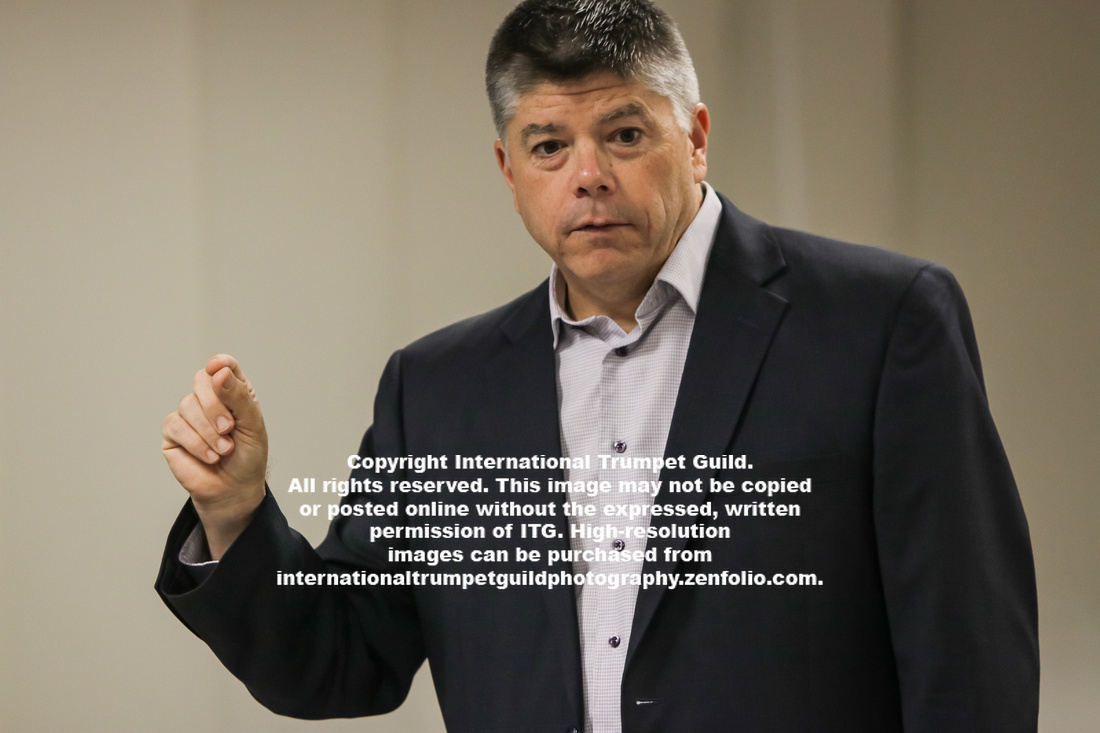

Panel Discussion - So You Think You Want to be a College Professor
For anyone wishing to pursue a career as a collegiate-level trumpet instructor, this panel discussion was a tremendous encouragement. Jason Bergman (Brigham Young University), Raquel Rodriquez Samayoa (University of North Texas), Jason Dovel (University of Kentucky), and Mattthew Vangjel (Louisiana State University) openly shared their journeys to professorship with humility and good humor. A wide variety of topics covered gave listeners a peek behind the curtain into the current task of earning a position and teaching at a university. A few noteworthy tips for the eager applicant: diversify your skill set to increase employability, create a “goal” CV that includes anything you would like to eventually add to your resume, continually expand your network of connections at conferences like ITG, prepare for an interview just as much as you would practice for an audition, and never lose sight of high performance standards for your trumpet playing! This session provided a wealth of good advice from some of the most successful and helpful university teachers in the United States. (ED)
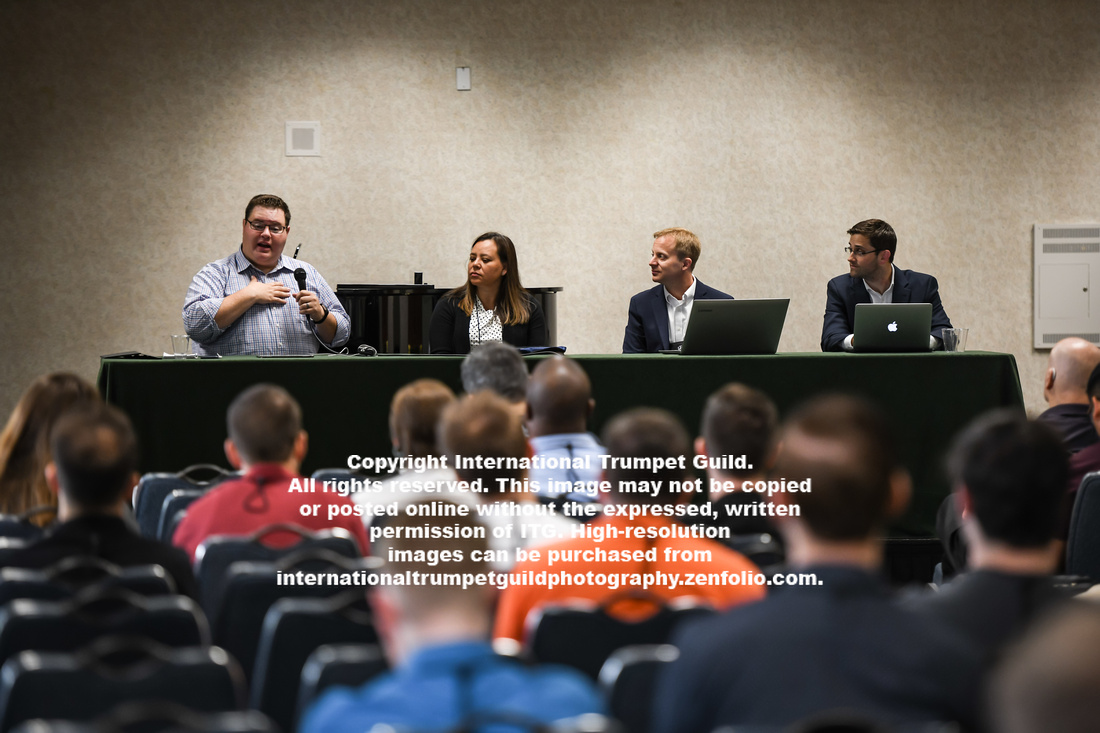
Kurt Depuis Recital
Kurt Depuis began his recital by describing his background and giving credit to his former teachers and inspirations. The theme of the recital was “Boston,” as Depuis’s musical connections have deep roots in the area. James Stephenson’s Kindred Sol was first on the program, and Depuis captivated the audience with his lush tone and sensitivity throughout the opening. As the piece progressed, his masterful technique shined through with precise articulations across wide intervals. The remainder of the program included With Malice Toward None by John Williams, Elegy for Mundy by James Stephenson, and A Trumpeter’s Lullaby by Leroy Anderson. Depuis introduced each piece by telling about a memory regarding why the piece is meaningful to him. James Stephenson was in the audience and discussed his inspiration to write his two performed compositions. Accompanied by Miriam Hickman on piano, Depuis delivered a beautiful and eloquent recital. (SS)

ITG Orchestral Excerpts Competition Finals
Audience members at the final round of the ITG Orchestral Excerpts Competition were treated to a dazzling display of musicality. Cordelia DeDecker, who studies with Wiff Rudd at Baylor University, performed with poise and control, demonstrating commitment to artistry and wonderful phrasing. Nitiphum Bamrungbanthum, a student of Joseph Bowman at Mahidol University in Bangkok, Thailand, graced the audience with a full, brilliant sound on the piccolo trumpet and showed off his command of the upper register with a vibrant, bold sound. Brent Proseus, under the tutelage of Robert White at Western Michigan University, presented an energetic sound concept with clarity, elegance, and versatility. His articulations were buoyant and wonderfully light when appropriate. The judging panel consisted of Chad Winkler, faculty at Duquesne University and a member of the Pittsburgh Symphony Orchestra; Mary Bowden, a member of the Richmond Symphony and faculty at Shenandoah University; and Terry Everson, trumpet professor at Boston University and member of the Boston Pops Esplanade Orchestra. The list of excerpts presented a wide variety of challenges, but these young, talented trumpeters seized the opportunity and performed extremely well. (AD)
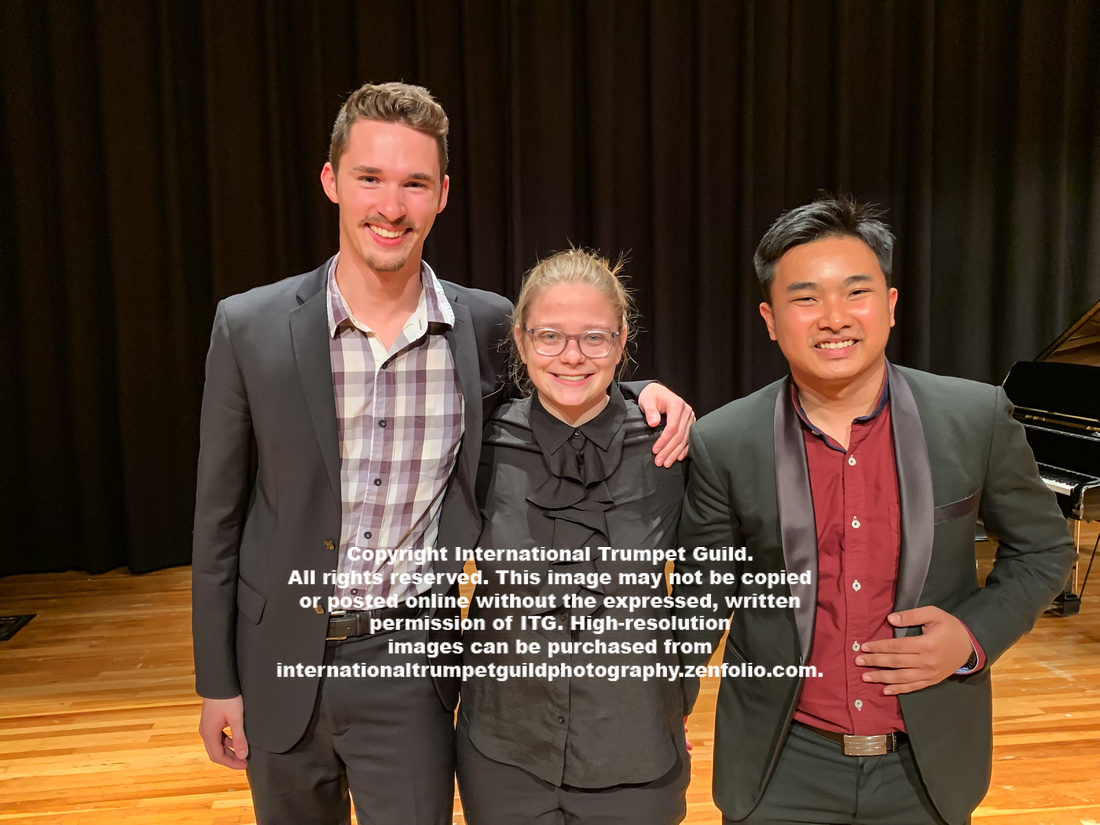
Youth Masterclass with Jose Sibaja
Jose Sibaja exemplified master teaching in his presentation and work with high school students. His presence alone elicited great respect, and his quiet, yet energetic, manner of engaging with the listeners and performers was warm, kind, calm, affirming, and inspiring. He emphasized fundamentals, such as doing stretching and breathing exercises prior to picking up the horn, and he was emphatic about the importance of always using a metronome when practicing. He demonstrated the difference between playing with stagnant air, as opposed to directed air, and offered several examples to clarify this concept. He brilliantly coached the student performers on how to gain their audience’s attention (and hold it) and offered practical advice to help with releasing tension in the body to enable the music to flow more freely. His relaxed confidence was inspiring, and any serious trumpeter would benefit from his expertise. (PS)

Marcus Printup Lecture - I’ve Got the Blues
After his spectacular performance the night before, it was no surprise to see a large and enthusiastic attendance at Marcus Printup’s afternoon masterclass, “I’ve Got the Blues.” He began by leading the group through a series of call and response on arpeggiations of the chords through several different blues progressions, beginning with the basic V-IV turnaround, and increasing in sophistication to Coltrane harmonies and Blues for Alice chord changes. All arpeggios were sung and played ascending and descending in an attempt to get everyone truly hearing the different harmonies. He took a similar approach to Gigi Gryce’s Minority and had volunteers improvise. As he discussed blues as a style, rather than as a form, Printup eloquently described and demonstrated how performers like Louis Armstrong and “Sweets” Edison used blues as an ever-present style in their playing. He closed by answering a variety of questions, including an excellent demonstration on how he mastered the plunger technique. His endearing personality and brilliant artistry were enjoyed by all in attendance. (NV)
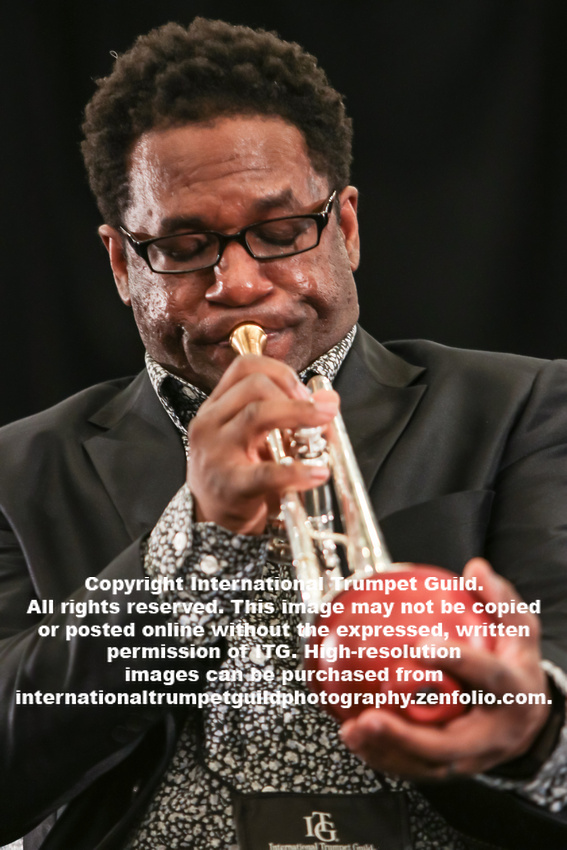
Thomas Madeja - Music for Social Change: A Culturally Sensitive Approach to Teaching in Underrepresented Communities
Thomas Madeja, Chicago-based trumpeter and social justice champion, delivered an important and inspiring talk on how to implement social change through music. The presentation was more of a dialogue with the attendees, discussing different challenges, why this work is important, appropriate vocabulary, and ways to overcome obstacles in the struggle to create meaningful change for students in underrepresented communities. Through his efforts with organizations like the Chicago Metamorphosis Orchestra Project (ChiMOP), Madeja has found a way to combine his passions and develop a broader understanding of the challenges facing a large portion of the world. Madeja urged the audience to get involved in organizations like his own or those like El Sistema. He also urged people who want to do this work to look at what is needed in their own communities and to always search for ways to view teaching and performance through the lens of social justice. (MV)

Rebecca Palmer Lecture - Paving the Way for Young Trumpeters: A Guide to Making them Sound Like Professionals
There is a need to address the proper way to teach beginning trumpet players with correct fundamentals from the first day on the instrument, and Rebecca Palmer’s presentation aimed to do just that. Palmer stressed that the professional trumpet sound should be the destination when a new student begins playing. Teachers should help students set goals for what they want to accomplish with the trumpet. From there, it is important to immediately detect each student’s challenges, address bad habits, apply those changes, and then enthusiastically celebrate the student’s progress. Palmer emphasized the importance of sparking the motivations in students and reflecting on the results of their hard work. She closed her presentation with the famous quotation “Practice does not make perfect; only perfect practice makes perfect,” encouraging the audience that the professional sound can begin on day one. (SB)
Trumpet Ensemble Reading Session
Dallas Brass trumpeter Buddy Deshler led this second trumpet ensemble reading session that involved more than 28 trumpet players. Four works were briefly read, rehearsed, and run in lightning rounds. The first work, Visions over the Horizon by Brandon Dicks, was a quick and flowing fanfare that developed into a triumphant ending theme. The second work was Marcus Grant’s arrangement of Bach’s Little Fugue in G Minor. This adaptation for six B-flat trumpets involved many challenging trill sections that were brought to a massive finish by very clear conducting from Deshler. Breathe is an early choral work by Brandon Dicks that incorporates many suspended harmonies and a strong dotted rhythm throughout. The finale for this reading session was none other than Modest Mussorgsky’s Great Gate of Kiev for thirteen trumpets. Adapted by P. Bradley Ulrich, this epic movement went just as one would expect––with fire and bravado. (DG)
Giuliano Sommerhalder Recital - Vladimir Peskin: Works for Trumpet and Piano
This recital by Giuliano Sommerhalder featured the music of Vladimir Peskin. Throughout the concert, Sommerhalder impressed the audience with his ability to extract the nuances from Peskin’s works. The first two pieces, Prelude and Poem No. 1, were perfect contrasts and beautifully performed. The former was haunting in its simplicity, while the latter filled the room with sound and virtuosic flashes. Sommerhalder deftly navigated the treacherous Scherzo. No Peskin recital would be complete without performances of his major staples: Concerto No. 1 and Concert Allegro, which were delivered masterfully by Sommerhalder. On both works, the audience was treated to sublime performances by pianist Kasia Wieczorek, further enhancing the experience of the recital. One of the real highlights was the diversity of difficulty in the selections performed, allowing trumpet players of all levels to hear works they could take to the practice room and prepare. (KM)

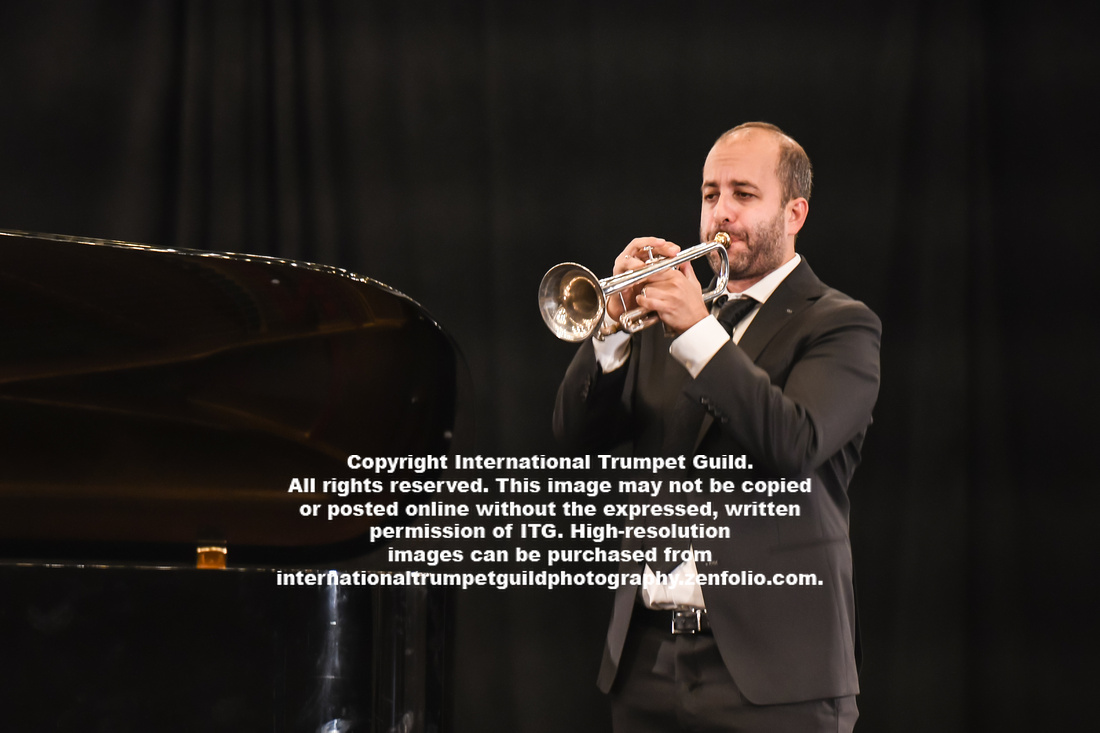
New Works Recital II
Brian Neal performed an arrangement of his own, Concertante No. 1, backed by the 7/4 Ensemble of El Sistema alumni. What begins as a bittersweet love song develops into an up-tempo waltz, highlighting Neal’s effortless piccolo trumpet playing on virtuosic runs that end with a spectacular flourish.

For the remainder of the program, pianist Miriam Hickman collaborated on all of the pieces. James Peyden Shelton presented Nicole Piunno’s Sonata. A declarative arpeggio in the trumpet commanded attention in the opening. The work is highly conversational between trumpet and piano, with moments that evoke classical cadenzas and herald trumpet calls. Shelton shimmered in the upper register and ended the piece triumphantly.
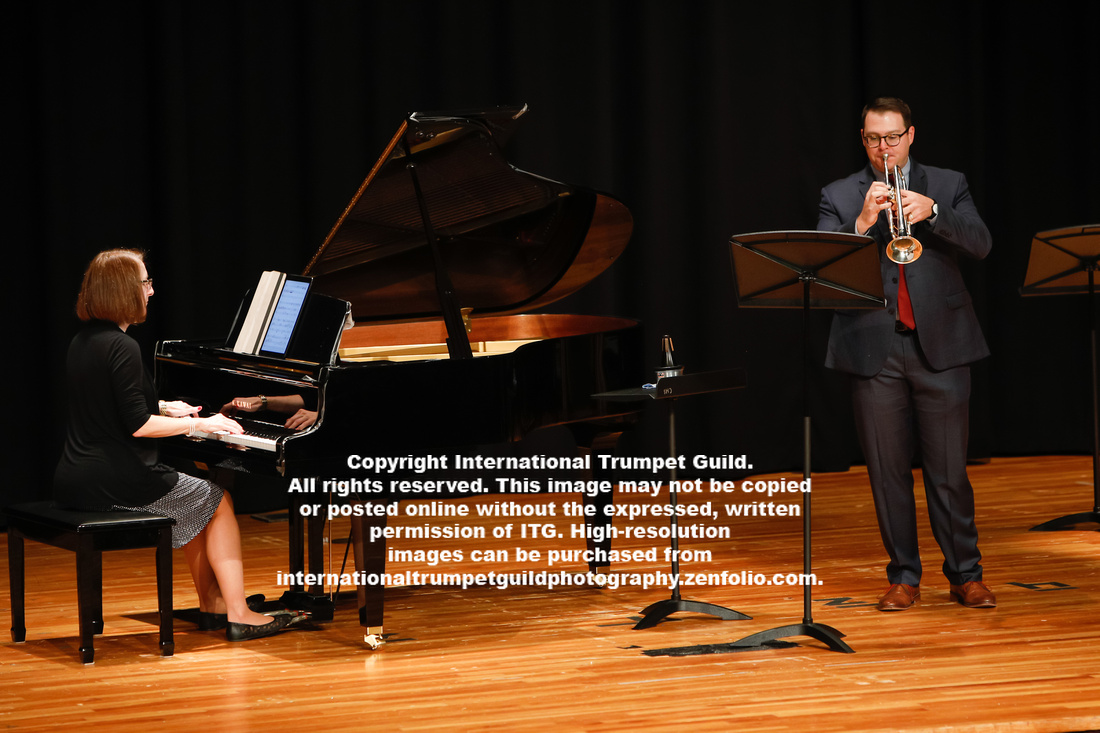
Will Koehler performed Brian Eads’s Elegy, a piece that draws influence from classical, pop, and jazz realms. Koehler displayed intuitive musicality in yearning, cinematic lines and jaunty motives influenced by musical theater.
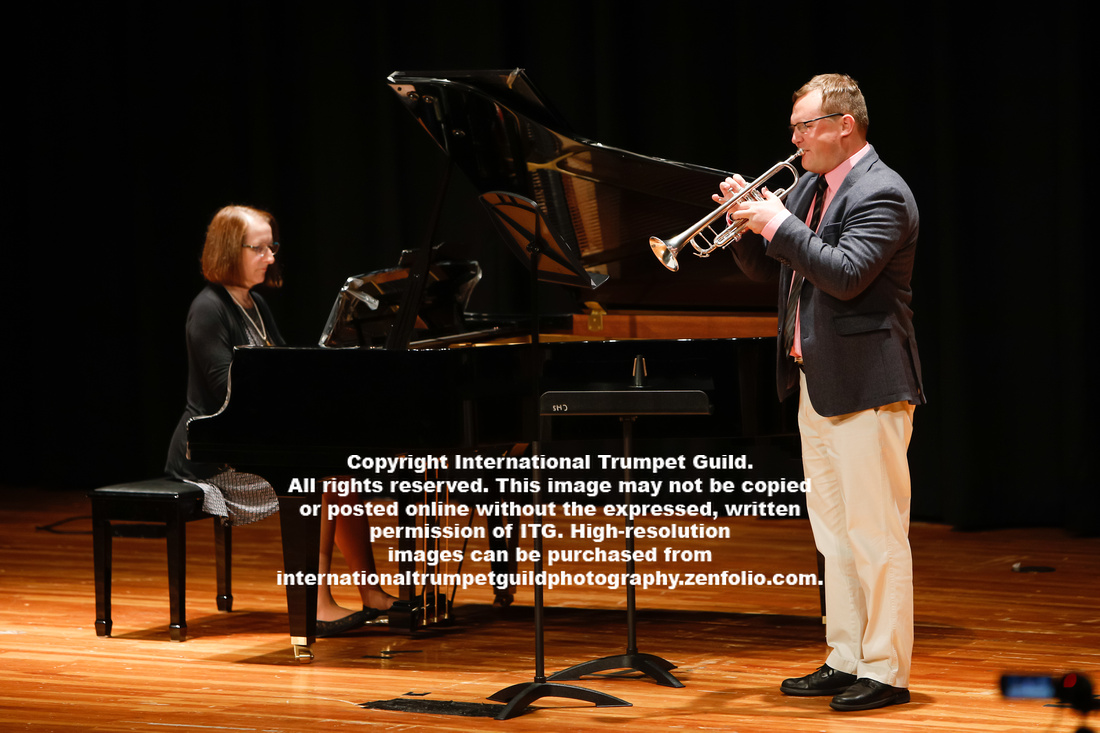
Richard Tirk presented two movements of The Bells, by Jackson Anderson. Tirk opened with “Golden Bells” on flugelhorn, fluently traversing key centers with a characteristic, sweet tone. A contrasting movement, “Brazen Bells” opens with what is effectively a perverse “ding-dong” effect in the piano. Snaking chromatic lines evoked Hindemith, and flutter tonguing added a contemporary flare.
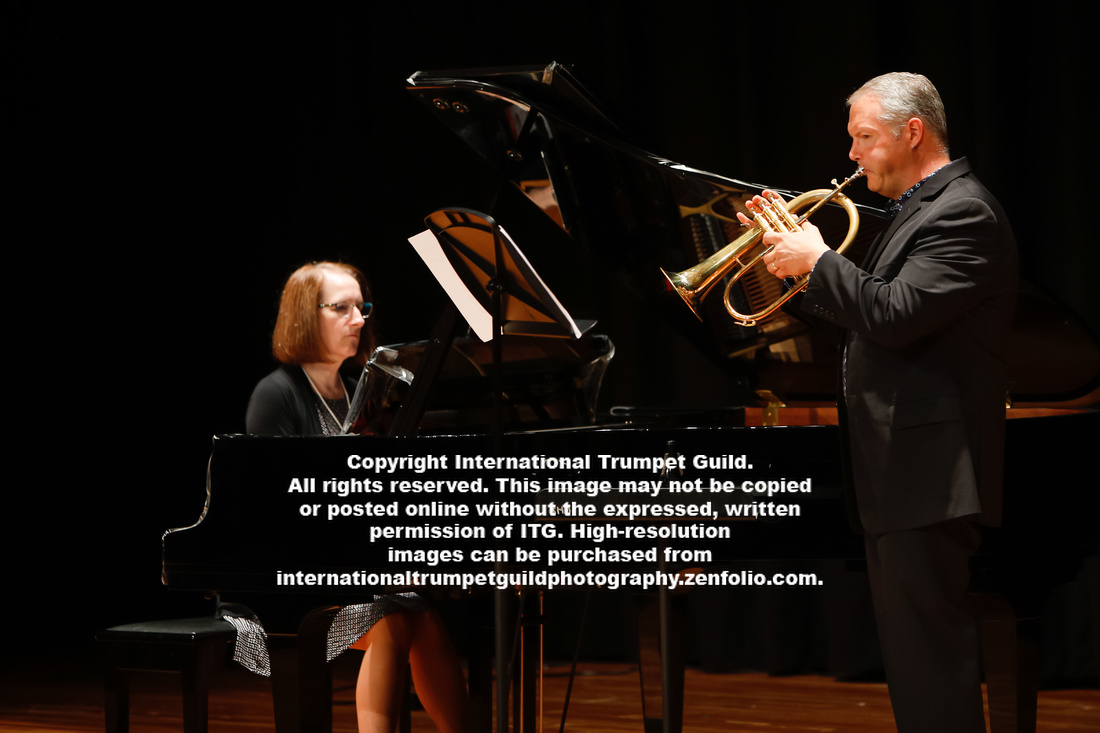
Alan Klaus presented Allan Gilliland’s First Light Brings New Beginning. The work employs a piano motive that sounds like a tolling bell while the trumpet explores the perfect-fifth interval in a subdued fanfare. Klaus offered delicate and hopeful moments with a distant, understated sound.

Steven Siegel convincingly presented Nicole Piunno’s Poem at Cantwell Cliffs. Muted trumpet presents a melodic idea that is echoed in the piano. The work was reflective and interpreted time freely, with repetitive motives like fragments of memory that won’t disperse. Siegel’s faint, blurry sound concept was well matched to the piece.
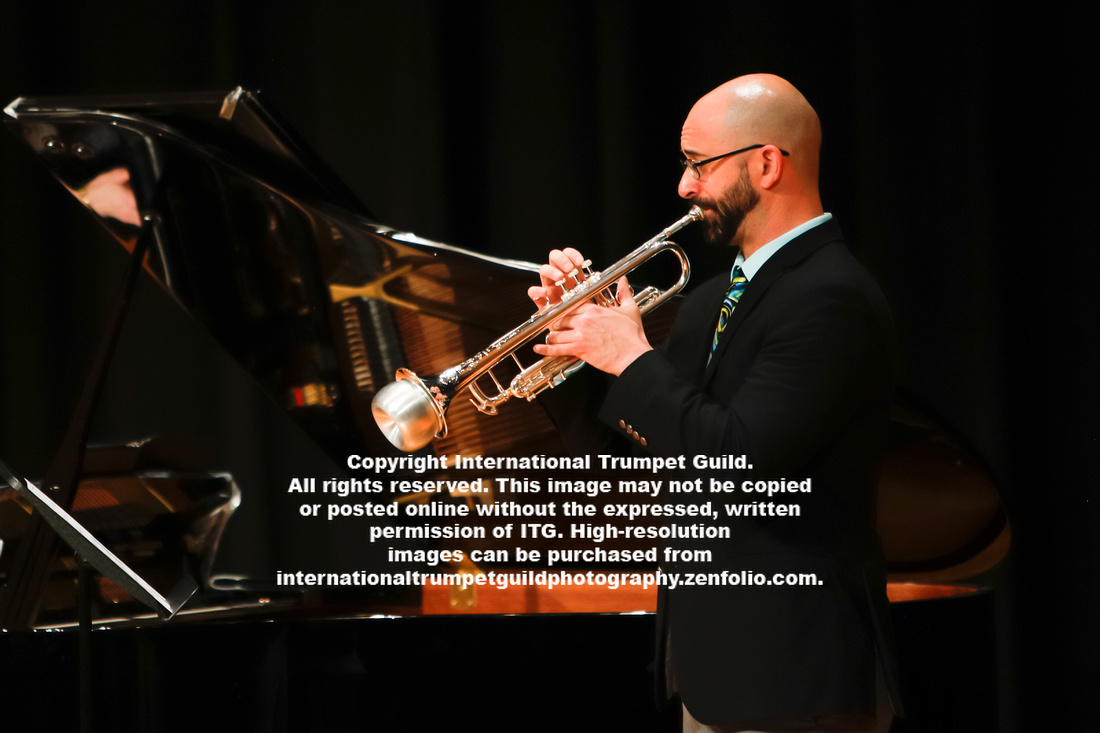
Jenna Veverka performed Marc Douyon’s Quiet Night on flugelhorn. Veverka presented the lyrical, scalar introduction with a resonant tone and tasteful vibrato. Her interpretation of the insistent, steady rhythm created a mesmerizing and introspective moment out of time.
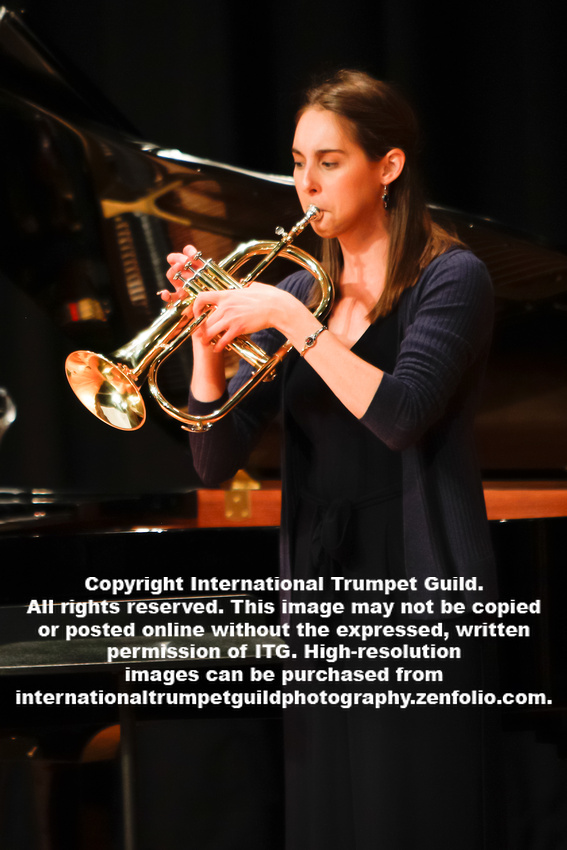
Taylor Gustad presented the first movement of David Sartor’s Sonata, “Declamatorio.” The piece opens with an eerie, probing melody that develops into heroically executed descending intervallic leaps in the trumpet. Gustad’s resounding upper register contrasted nicely with arhythmic rumbles in the extreme low register of the piano. (MM)
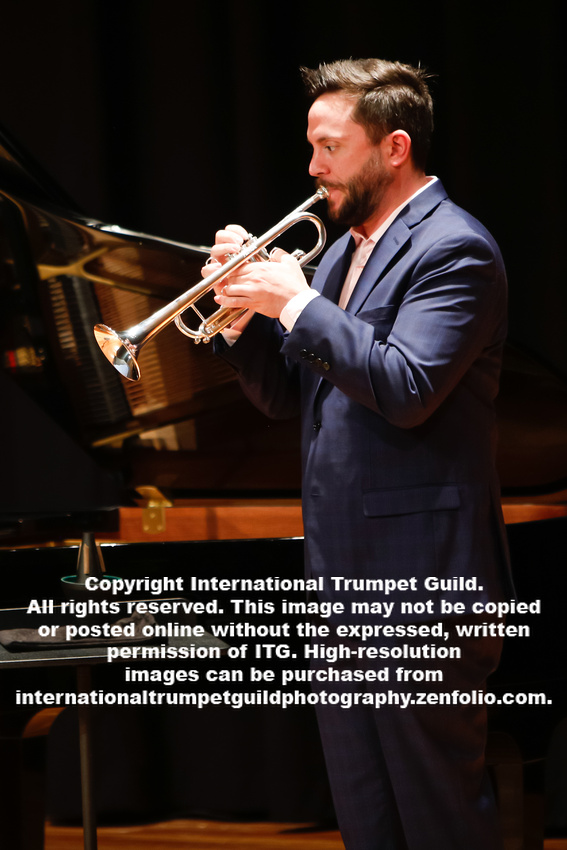
Click here for more photos from the ITG Conference
]]>
Special Daily Report • Compiled by Peter Wood
Photos by Michael Anderson, Norman Black, Benjamin Lowe, and Donald Sorah
Thursday, July 11 - Evening events
Click here for more photos from the ITG Conference
ITG General Membership Meeting
This annual meeting, open to all ITG members, began with introductions of each board member and provided those in attendance the opportunity to share their experiences and thoughts about this year’s and future ITG Conferences. Several points were raised about the overall cost of attendance, possible coordination of roommates, and the potential for international locations of future events. ITG president Cathy Leach shared news regarding several items from the board meetings that took place earlier in the week. ITG Secretary Kevin Eisensmith shared the numerous motions and action items that took place at those same meetings. ITG Treasurer Dixie Burress shared many of the financial points and changes regarding items from this past year, including ITG’s shift in status from an association to a corporation and the institution of a new auto-renew membership program. Many comments and suggestions were recognized from the attendees present regarding student membership development and their interaction with ITG via the various social media platforms. (JPS)
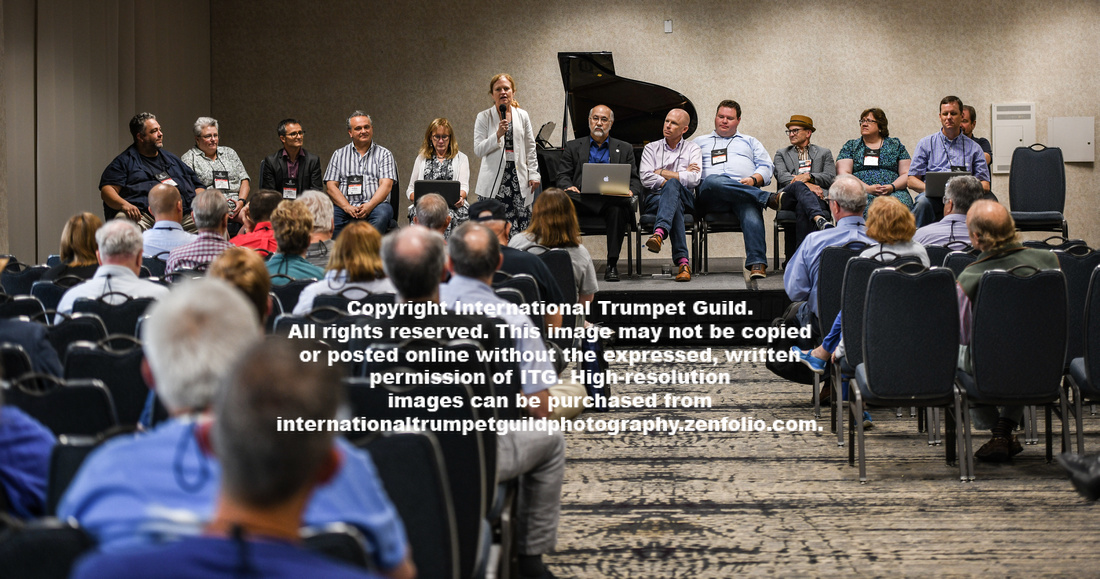
Simón Bolivar Trumpet Ensemble: Brilliant Music for the Noble Sound of Trumpet
The Venezuelan Simón Bolivar Trumpet Ensemble appropriately credits their outstanding artistry to El Sistema, and anyone who has never heard a live performance from such a group would immediately acknowledge their technical brilliance and musical artistry. The opening piece, Gordon Jacob’s Canterbury Flourish, was performed from memory and showcased a ridiculously homogenous sound. The second work, Itaru Sakai’s Sinfonia and Caprice, proved that this level of artistry was no fluke, but, rather, a consistent standard. Giovanni Gabrieli’s Canzon Septemi No. 2 matched the previous level with a wider sound spectrum through a variety of trumpets.
The camaraderie of the ensemble was evident as each member was introduced with impressive accolades and career accomplishments. An exciting performance of Eric Ewazen’s Sonoran Desert Harmonies followed, contrasting crisp and spritely articulations with soothing lyricism. The opening of Franz von Suppe’s Poet and Peasant Overture, arranged by Román Granda, was rendered with sweetness and tenderness and surely brought tears to a few audience members. A brilliant change of color introduced the Allegro, and the remaining section included fire and energy, playfulness, and brilliant virtuosity––all necessary to bring this orchestral masterpiece to realization by only eight trumpets; the effect was magnificent. Not many first halves of programs are acknowledged with a standing ovation, but this one was very special indeed.
After the intermission, the group performed an arrangement of Astor Piazzolla’s Olvidate del Tango, que Gardel Murió & Libertango, including a variety of mutes, glissandi, and foot stomps. A medley from Venezuela followed with a moving collection of melodies from the ensemble’s motherland. Finger snaps emulating castanets and other effects depicted several aspects of Venezuelan culture and landscapes through the ethnic sounds. The fellowship and sense of humor within the ensemble was evident through several introductions. Trumpeter Román Granda’s Bluestrumpets included dazzling jazz trumpet solos and American classics such as Sweet Georgia Brown, as well as a few gags including mouthpiece buzzing, uninhibited singing, and theatrics. Edith Piaf’s La Vie en Rose, arranged by Leafar Riobueno, concluded the program with the uncanny emulation of the great Louis Armstrong by one of the members. A bristling version of Flight of the Bumblebee served as a dazzling encore, capping off several more standing ovations.
After hearing this performance, one cannot help but consider how far the trumpet community has elevated its performance standards around the world over the past few decades. The Simón Bolivar Trumpet Ensemble has surely raised this level even further through impeccable artistic standards. (LE)
Check out these videos from the Simon Bolivar Trumpet Ensemble concert!
Simon Bolivar Trumpet Ensemble - La Vie En Rose
Simon Bolivar Trumpet Ensemble - Flight of the Bumblebee
Simon Bolivar Trumpet Ensemble - La Forza Del Destino
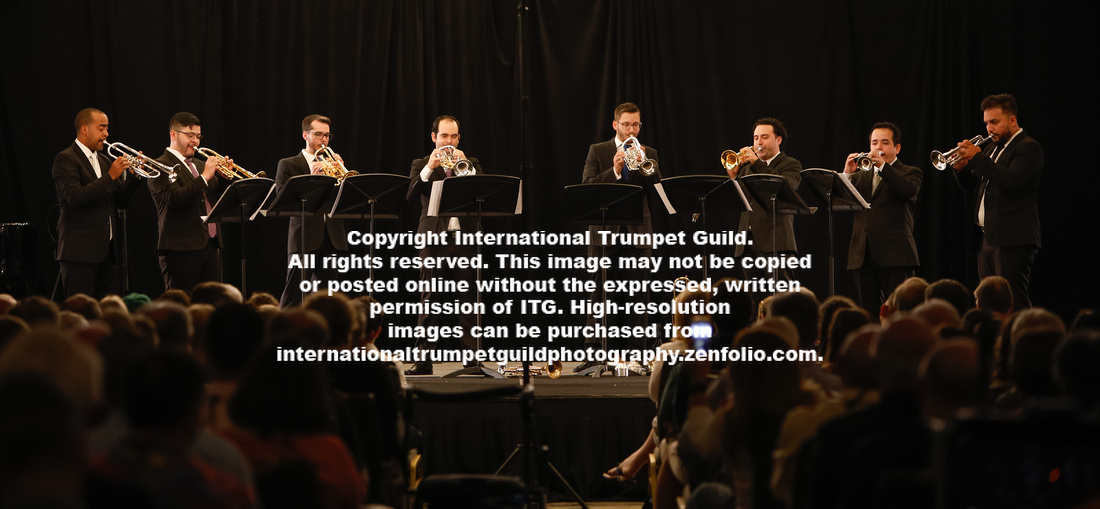
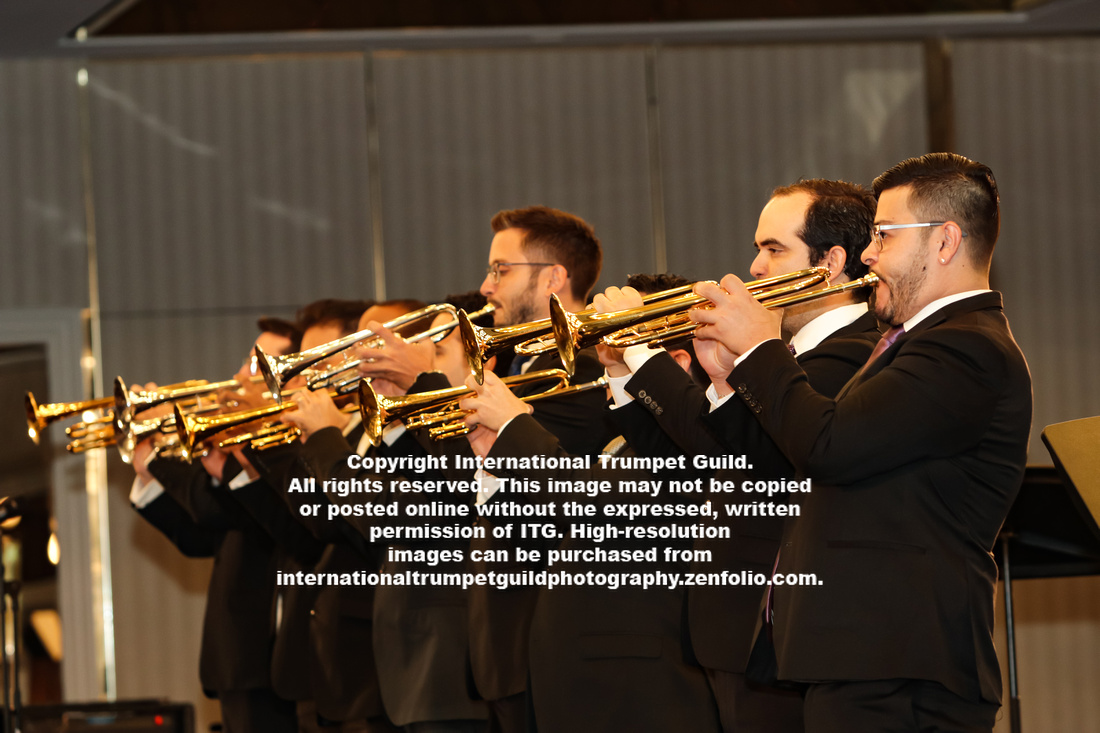
Marcus Printup Jazz Concert
This evening’s jazz concert, featuring Marcus Printup, a 26-year member of Jazz at Lincoln Center Orchestra, with the Ryan Chapman Jazz Orchestra, was on fire from the outset! Demonstrating both tremendous humility and stunning virtuosity, Printup delivered one of the most memorable performances of the conference so far. Highlights included Kenny Dorham’s Lotus Blossom (arranged by Printup), in which Printup delivered a flowing bebop solo that traversed the entire range of the instrument with tremendous ease; Rodgers and Hammerstein’s Happy Talk, showcasing the incredible Ella Fitzgerald-esque vocal stylings of Ashley Pezzotti; and Miles Davis’s Tutu (arranged by Printup), in which Printup joined the trumpet section for a heavy-swinging, acapella trumpet soli to open the tune and then returned to the front of the band to deliver a harmon-muted solo worthy of the tune’s composer. What a thrilling show! (TT)
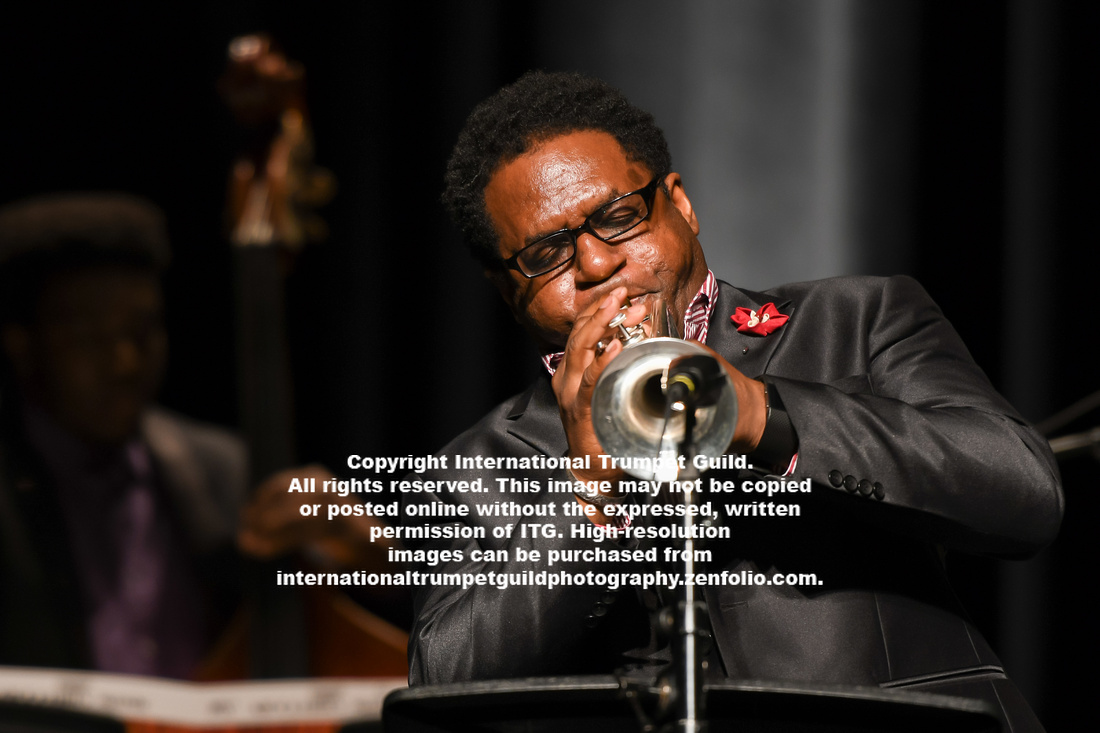
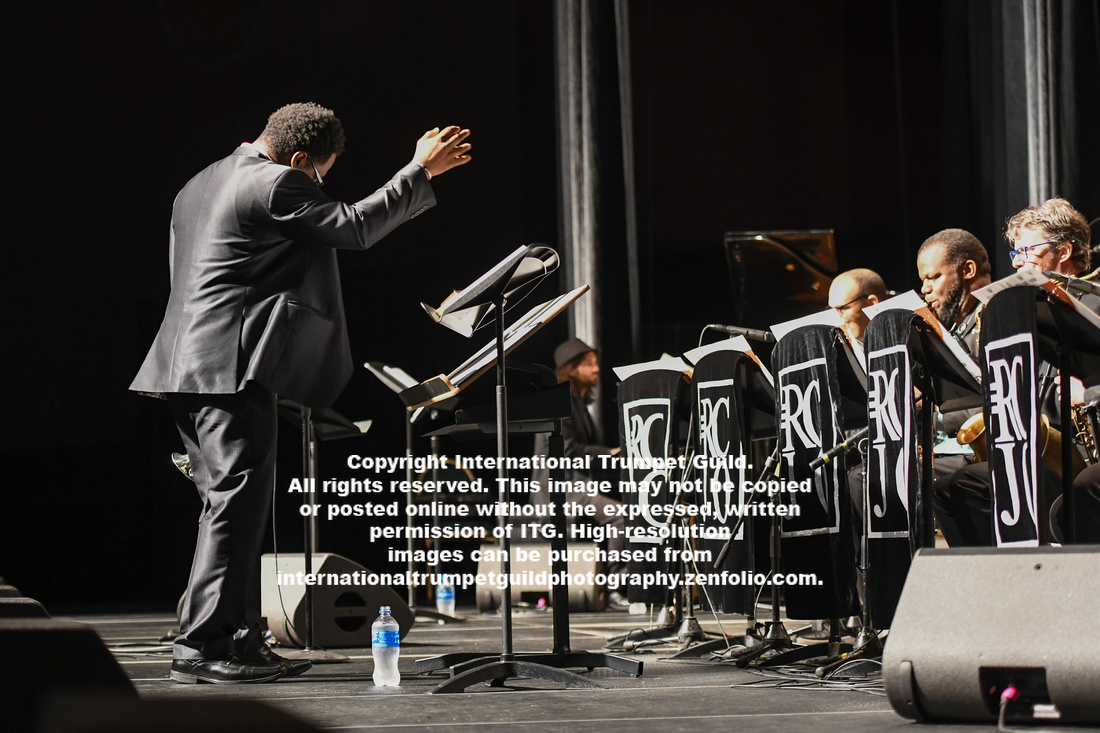

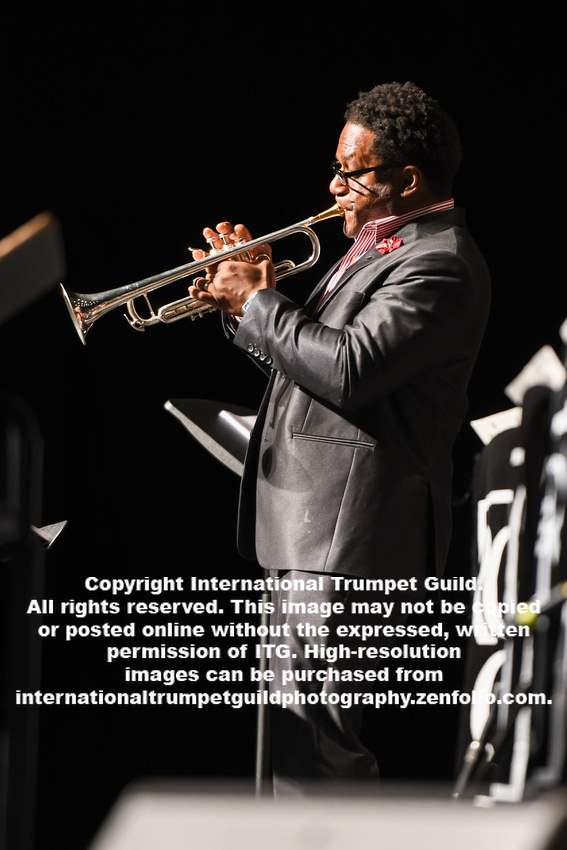
Click here for more photos from the ITG Conference
]]>
Special Daily Report • Compiled by Peter Wood
Photos by Michael Anderson, Norman Black, Benjamin Lowe, and Donald Sorah
Thursday, July 11 - Daytime events
Click here for more photos from the ITG Conference
Oswald Zapata - Optimizing Your Time for Efficient Warmup
Dr. Oswald Zapata led a clear and practical approach to warming up. His session began with a short lecture discussing the purpose of warming up from both physical and mental standpoints. Some of his talking points included lip health, injury prevention, and improving blood circulation. He involved the audience by guiding them through basic stretching exercises in order to engage the core, shoulders, hands, and neck. Following these exercises, he talked about “doing a little bit of everything” to prepare for all aspects of trumpet playing. His method included lip flapping, mouthpiece buzzing, lip bends, moving long tones, finger dexterity, lip slurs, single and multiple tonguing, and whisper tones. He kept the audience engaged as he guided them through his routine and discussed how and why to do each exercise. This class was accessible to trumpet players of all abilities and was very well received. (SS)
Brian Shaw - Non-Pro/Comeback Players Warmup
Brian Shaw led an eager crowd of comeback players through a well-rounded warm-up routine focused on ease and consistency of tone production across the range of the instrument. Shaw discussed and demonstrated the James Thompson Buzzing Basics routine, emphasizing the importance of keeping a stable embouchure when moving between pitches. The participants enjoyed playing through the exercises with play-along tracks as Shaw discussed ways to make each one effective. He explained the importance of adaptability in a warmup in order to facilitate the demands of a busy life and schedule while also covering the core fundamentals of sound, range, finger technique, flexibility, and articulation. His routine highlighted several ways to use both buzzing and lip bends to develop clarity and centering in tone. He also encouraged using a metronome and drones throughout the warmup to incorporate the skills needed to play with others, such as breathing, entering in time, and playing in tune. (EM)
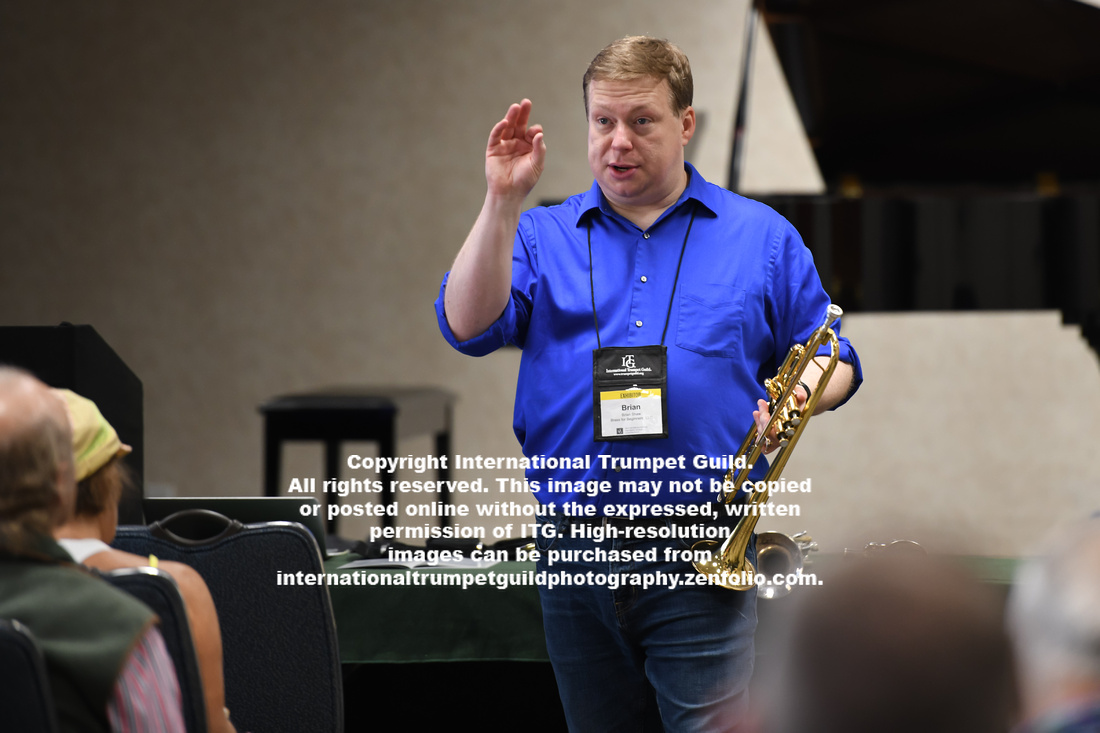
Brian Shaw - Non-Pro/Comeback Players Masterclass
Brian Shaw displayed great versatility as both a performer and educator during the masterclass for non-professionals and comeback players. Those in attendance received a wealth of excellent information and suggestions regarding ways to improve their technical and expressive capacities in music ranging from the Baroque and Classical eras to modern-day jazz and pop styles. We often make trumpet playing more difficult than it should be, and simplicity is key. Shaw stressed an awareness of the little things and focusing on the details to enhance each performance and truly capture the imagination of the audience. Other points of emphasis included utilizing technology to your advantage and creating new, unique exercises to help develop coordination and further refine performance skills. There is no reason for us not to record ourselves with all the convenient technologies available in this day and age. (AD)
ITG Affiliate Chapters Recital
The ITG Affiliate Chapters Showcase is truly what ITG is about––bringing together trumpeters from all over the world to share our love for the instrument. The concert started with Mike D’Ambrosio’s composition, Homage, performed by the ten-piece Texas A&M University-Commerce chapter. This piece pays tribute to the late Bud Herseth and sources several melodies from Mahler’s Symphony No. 5. The program continued with the Utah Trumpet Guild’s chapter performing an arrangement of Mozart’s Overture to The Marriage of Figaro. Their performance featured fine piccolo trumpet playing over a light, bouncing ensemble that would make Mozart smile. Continuing, the Louisiana State University chapter performed Erik Morales’s Cityscapes. This group played with great sound, style, and control, especially in the low register by the fifth trumpet. Next, a duo from Texas A&M-Kingsville performed Stanley Friedman’s duet Domestic Tranquillity. These two played with superb style, gorgeous sounds, and masterful intonation. The chapter from Thailand played a brilliant performance of Eric Morales’s X-1. This group’s fiery passion was matched with excellent intonation and a wide dynamic pallet offering one of the finest performances of this work this reviewer has ever heard. Exciting and precise, the group played brilliantly. Closing the recital was the Trompetes do Cerrado performing two Brazilian pieces. They played beautifully, causing most of the audience to tap their feet and fingers. This was a highly enjoyable morning of music making in the Jasmine Ballroom. (JB)
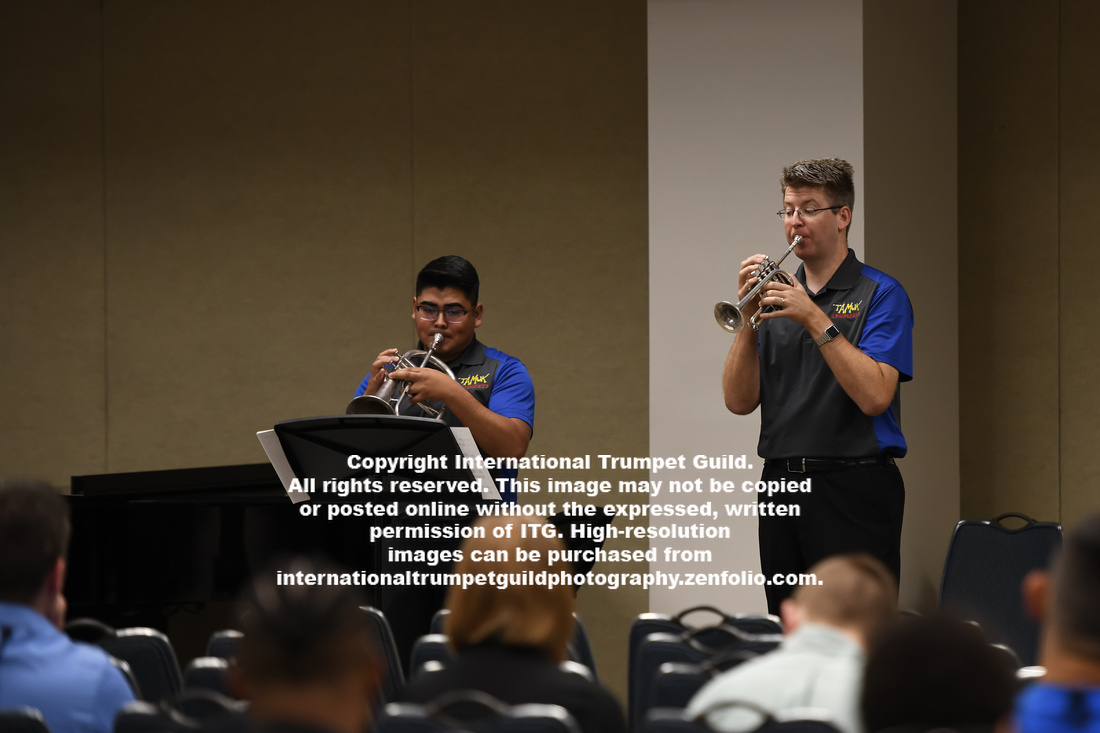
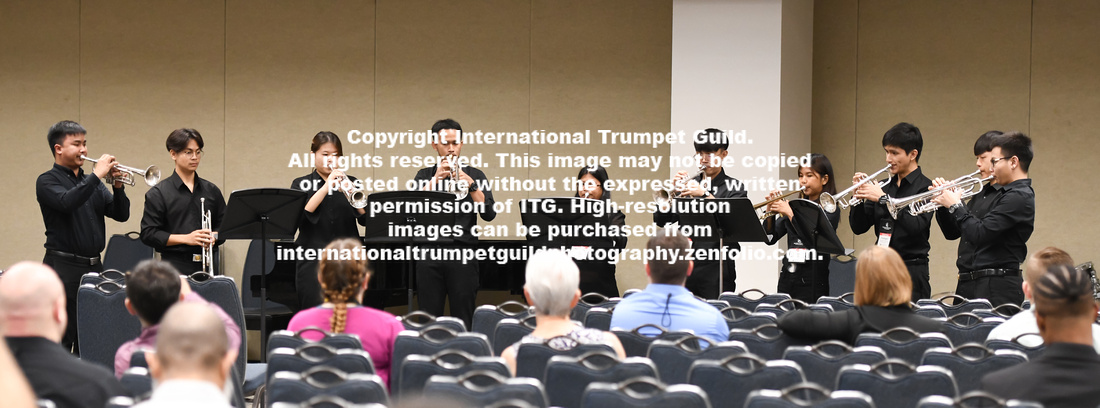
Anthony Kirkland - Win that Trumpet Audition: Know Your Band Excerpts!
In his presentation on wind band excerpts, Anthony Kirkland provided insight for those preparing to take professional auditions. Although the military bands are the largest employers of full-time performing musicians, private studio instruction has a long tradition of focusing primarily on orchestral repertoire. Kirkland referenced two excellent sources for band repertoire: Norman Smith’s March Music Melodies and his own recent publication, Wind Band Excerpts for Trumpet and Cornet. The presentation included excerpt performances by Ross Mitchell and Stephen Spink from Baylor University and Tyler Butler from the University of South Alabama. Drawing on his vast experience performing in the United States Air Force Ceremonial Band, Kirkland had many great recommendations for the performers to consider, including historical context, style, alternate fingerings, and specific recordings. Moreover, he continued to stress the importance of learning each work in its entirety and at a variety of tempos. Kirkland’s message was straightforward--be prepared. (NV)
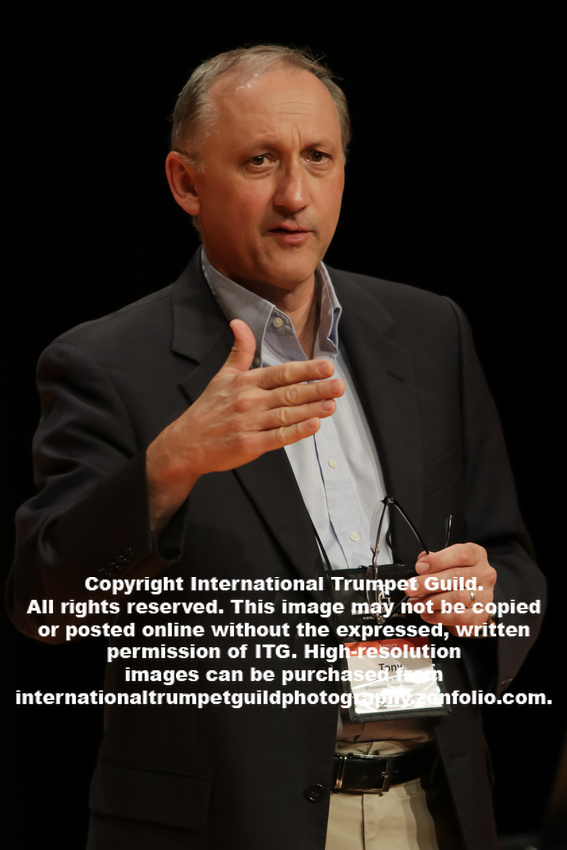
Adrian Kelly - Shedding Light on the Pit: Maximizing Performance in Musical Theater
Adrian Kelly’s lecture highlighted numerous custom etudes and strategies that provide supplementary approaches to enhancing a performer’s necessary abilities to navigate the challenges that exist within the musical theater repertoire. Using specific excerpts taken directly from this growing repertoire, each etude was presented with a wonderful pre-recorded example, performed by Adrian Kelly, highlighting the pedagogical focus of each etude. Kelly also highlighted his current research of documenting and archiving numerous details regarding repertoire idiosyncrasies, personal equipment choices for players in the field, and the copious performance expectations of trumpeters across the globe in this growing genre. (JPS)
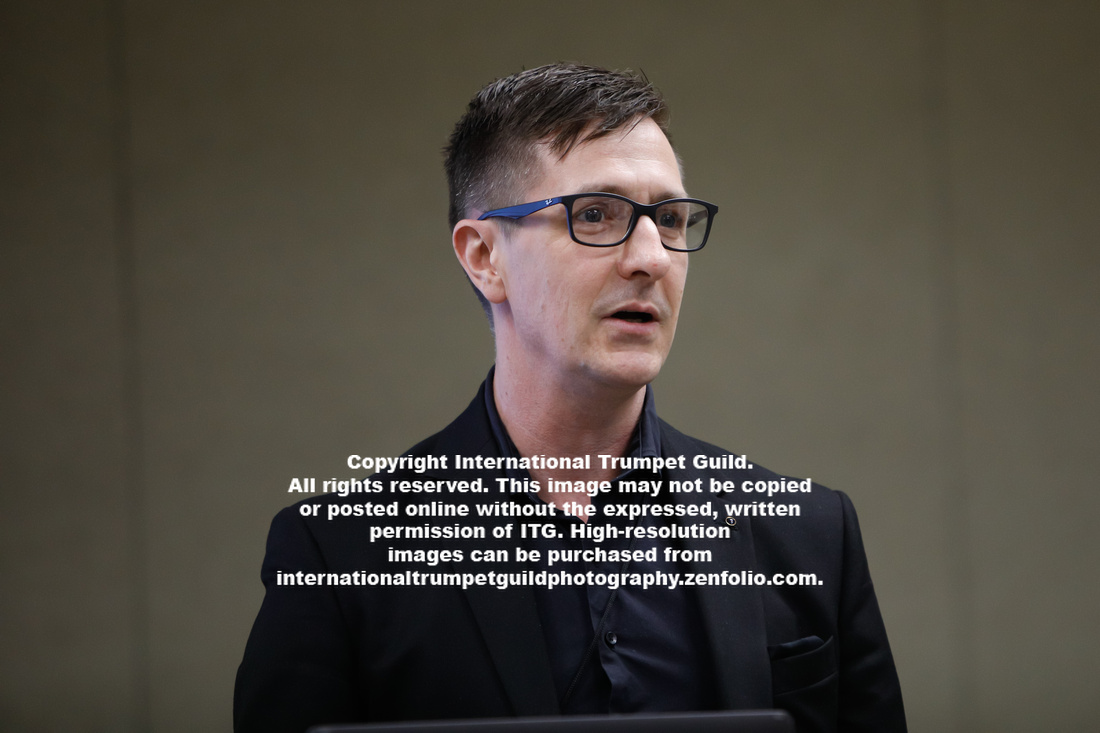
Daniel Crespo Recital: Camino a Jalisco
Latin trumpet soloist Daniel Crespo opened his recital with two beautiful pieces by Johann Sebastian Bach. The first was a beautiful piece entitled Siciliano, allowing Crespo to show off his beautiful sound and sensitive piccolo trumpet playing. Continuing with the wonderful Bach/Vivaldi concerto, Crespo demonstrated tasteful style and impressive musical acrobatics. Following was an attractive, substantial work written originally for trumpet and orchestra by the performer’s father, Enrique Crespo. The three-movement work, Camino a Jalisco, started with a beautiful and lively introduction by pianist Mariam Hickman. While inspired by Mexico, the piece maintained a distinct twentieth-century French style, drawing on standards by such composers as Bozza and Tomasi. Finishing with a Spanish flair, Crespo closed his recital with another piece by his father. Pasodoble y Ole was a lovely piece, full of traditional melodies and Spanish dances and showcasing Crespo’s flair for the music of his heritage. (WK)
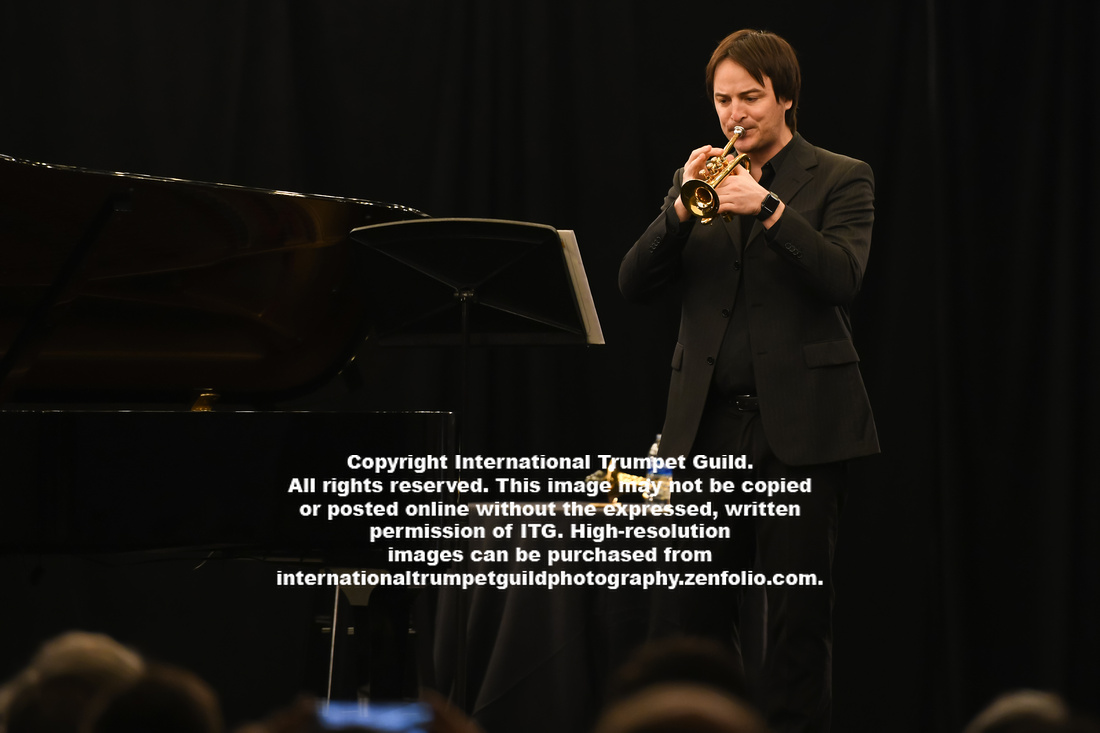
ITG Solo Competition Finals
The field of the ITG Solo Competition was narrowed to three finalists from across the globe. First to take the stage was Chloe Swindler, a recent graduate of Yale University, where she studied with Allan Dean. She started her strong and commanding performance with Tomasi’s Concerto. Swindler easily navigated the tricky passages with a sweet, singing sound. Her stage presence mirrored her playing: calm, confident, and controlled. Her performance of Gershwin’s Three Preludes displayed her abilities to truly sing through the instrument with a shimmering vibrato.
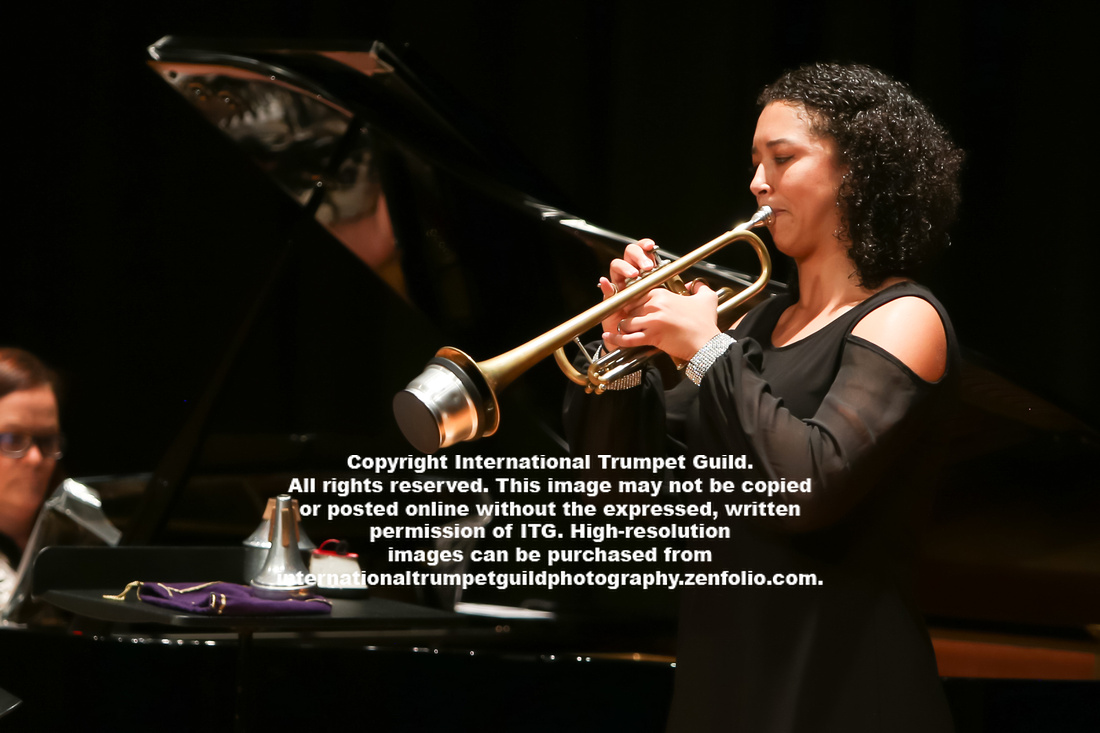
The next competitor was Tyler Moore, a student of Wiff Rudd at Baylor University. Moore came out of the gate swinging with his rendition of the Gershwin preludes. He added many stylized bends and glissandi to show his firm command of Gershwin’s jazz style. Moore’s concerto of choice was Eino Tamberg’s Concerto No. 1. His powerful sound and sweeping lyricism carried him through this difficult work with relative ease.
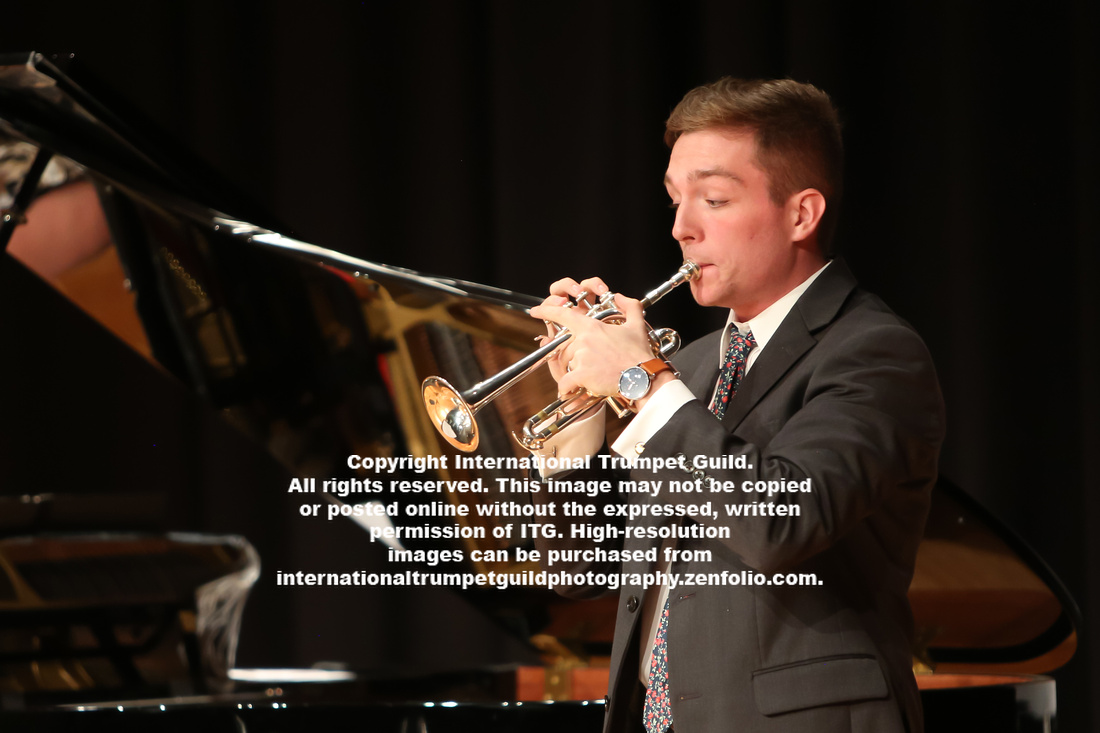
The final challenger of the day was Ahn Seok Young, a Korean native who studies at the Los Angeles Brass Academy with Onate Kwan. Young chose to begin her performance with the Gershwin preludes. From the opening notes, she captivated the audience with her big, bold, ringing sound. For her chosen piece, she gave a fearless and clean performance of Alfred Desenclos’s extremely difficult Incantation, Thrène, et Danse.
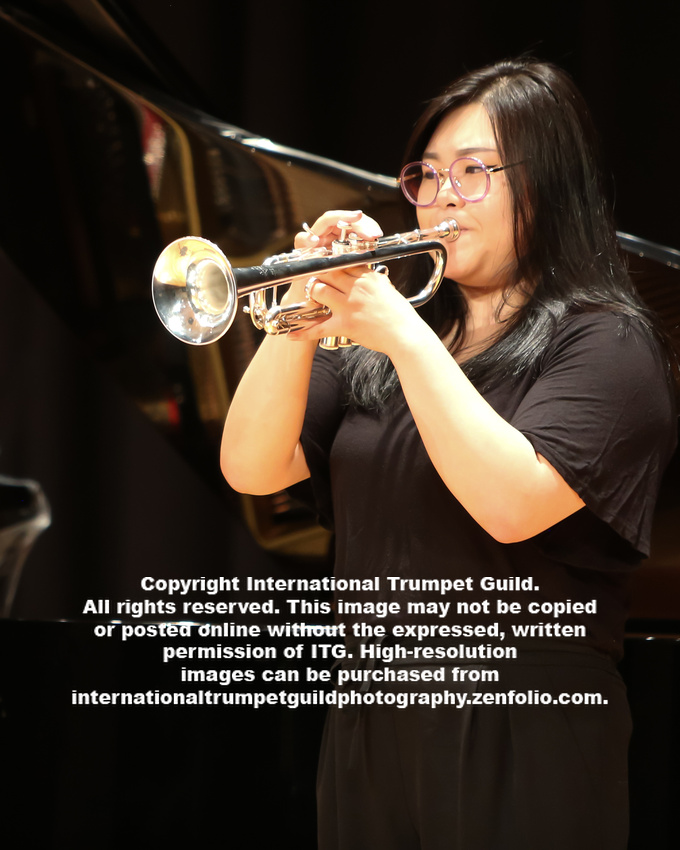
In addition to the fine trumpet playing at this competition, the collaborative artistry of Rebecca Wilt and Young’s accompanist (whose name was not listed in the program) was sublime. Whatever the outcome of this competition, it is clear that all three are fantastic trumpeters with bright futures ahead. (JB)
Chris Carrillo - Practicing Practice: Using Interval Training Apps to Improve Your Students’ Practice
Dr. Chris Carrillo, from James Madison University, presented an insightful lecture on applying the fitness concept of high-intensity interval training (HIIT) to one’s practice sessions. He stated, “Chops are precious; don’t waste them on mindless practice.” The four HIIT concepts that he uses include a warmup, repetitions, rest, and cool-down. The goal is to keep individuals highly focused in their practice by interspersing periods of rest within repetitions. Carrillo mentioned numerous HIIT smartphone apps, but recommended Seconds Pro due to its compatibility with iOS and Android devices, affordable price, customization capabilities, and ability to work in the background so that one may use other apps (metronomes/tuners) simultaneously. He went into great detail outlining how he uses the app and gave numerous examples of routines with varying practice timeframes. His doctoral student, John Nye, also offered input regarding how he finds the app useful and helped answer questions from the audience. (SS)
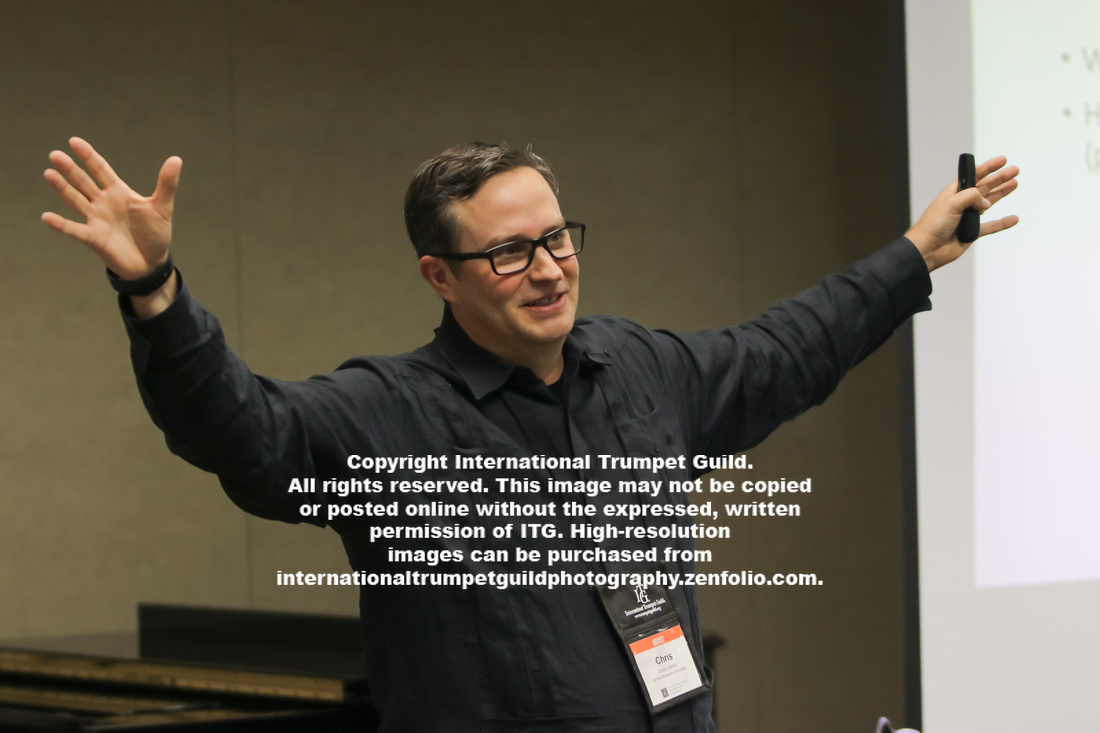
Brian Neal and Ensemble 7/4 Concert - Baroque, Joropo and Mambo
Brian Neal and Ensemble 7/4 delivered an exciting and eclectic program, showcasing their stylistic versatility, from Baroque to traditional Venezuelan folk music fused with elements of R&B. They set the tone from the start with Reiche’s Abblasen melded into a Latin number titled Latin Fanfare. Continuing in the Baroque vein, they followed with a wonderful arrangement of Albinoni’s Concerto “Saint Marc,” featuring Neal. As if to show that no style was beyond their capability, the group immediately transitioned to the Al Jolson hit Avalon. Two other pieces featured Neal’s beautiful piccolo sound––an arrangement of what was described as ancient music heard rising from a Venezuelan monastery and Morricone’s Gabriel’s Oboe. Throughout the program, the ensemble showcased their virtuosity and especially shined on their modern Latin jazz compositions. The group radiated musical intensity throughout the concert, drawing all those in attendance into their performance. (KM)
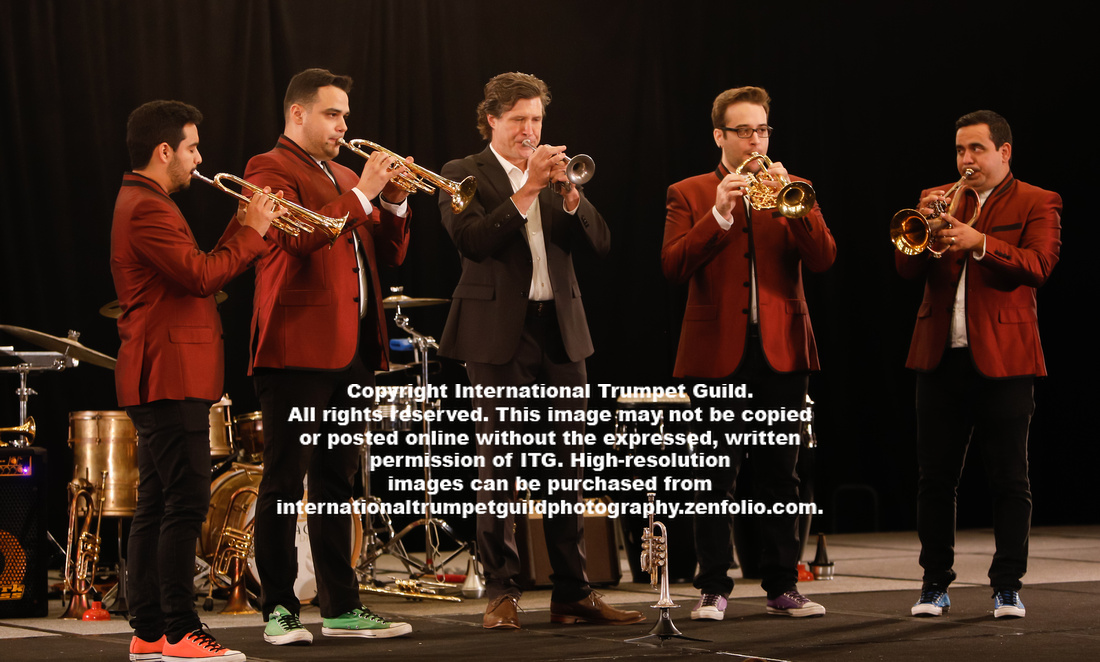
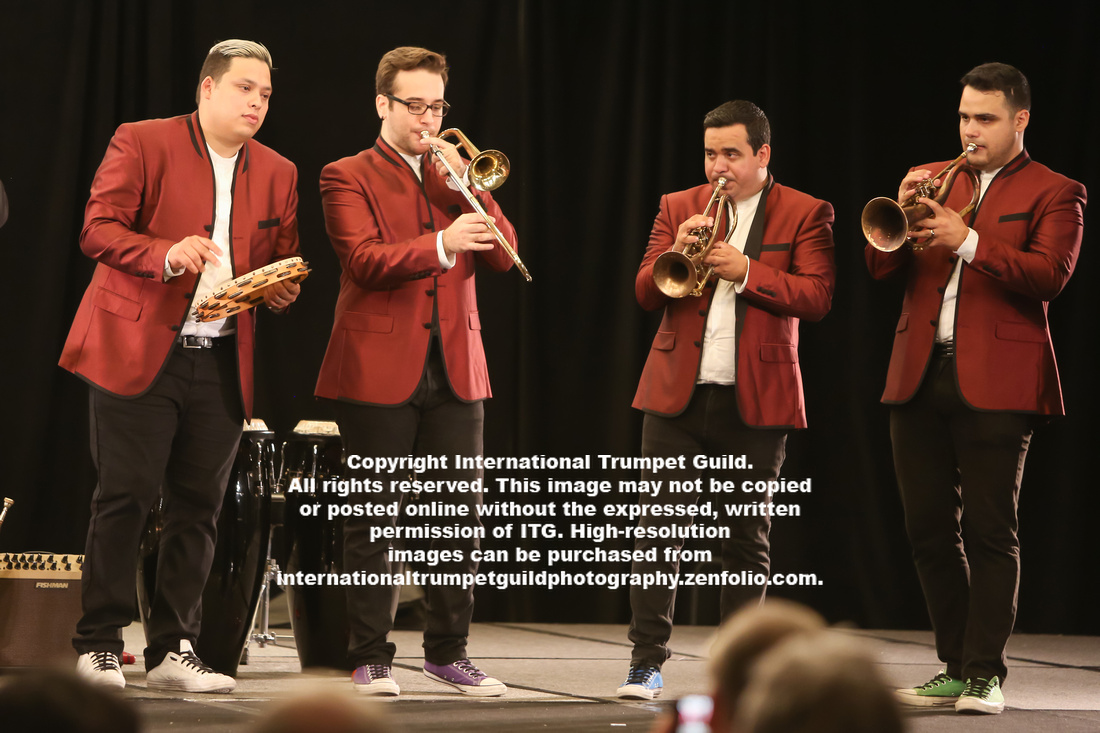
Richard Carson Steuart Masterclass
Notably one of the most formidable trumpeters in the world spanning the past five decades, Richard Carson Steuart graced his listeners with wisdom and perspective––not about playing the trumpet, but about making music between the notes. He spoke with profound sincerity about his belief that the trumpet “reveals to yourself the music that is already in your soul,” and insisted that “you need love in your heart to give the gift of your life to playing the trumpet.” He demonstrated the difference between playing the trumpet without evoking one’s intrinsic and seemingly intangible human soul to that of an artist performing music, via the trumpet, communicating knowledge, wisdom, and emotion with profound conviction. The difference was remarkable. He captivated the listeners from his first note, wordlessly inviting them to join him in that moment in a magical conversation in which he connected everyone, invoking through the trumpet his energy, emotion, passion, and conviction. He challenged all “to be here now in every moment, to live and die for the phrase––always making it your own story––and to embrace the reality of our combined souls.” (PS)
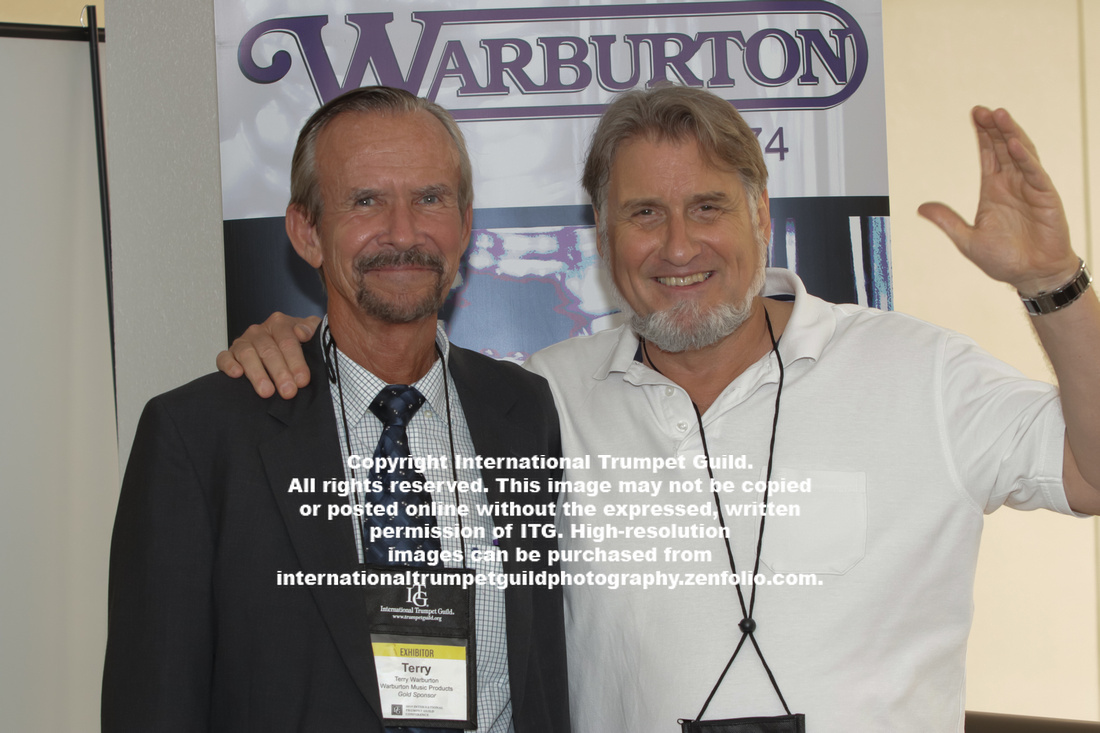
Jesse Cook - The Elephant in the Room: Discussing Music Performance Anxiety
Music Performance Anxiety (MPA) affects nearly every performer to some degree. Dr. Jesse Cook delivered a useful presentation on precisely how to address and defeat it. He began by defining MPA, the populations that it affects, and the roots from which it grows. He then addressed the symptoms of MPA that come in many shapes and forms. The majority of the lecture dealt with the different types of performance: Peak Performance, Optimal Performance, and Suboptimal Performance. Cook stated that Peak Performance does not mean perfection, but, rather, the best possible performance. Optimal Performance is an “acceptable” performance that is repeatable. Suboptimal Performance does not mean the performer was not qualified or prepared, but that something outside of their control happened. Cook closed by offering clear and tangible ways for teachers to help students improve how they handle Music Performance Anxiety. (SB)
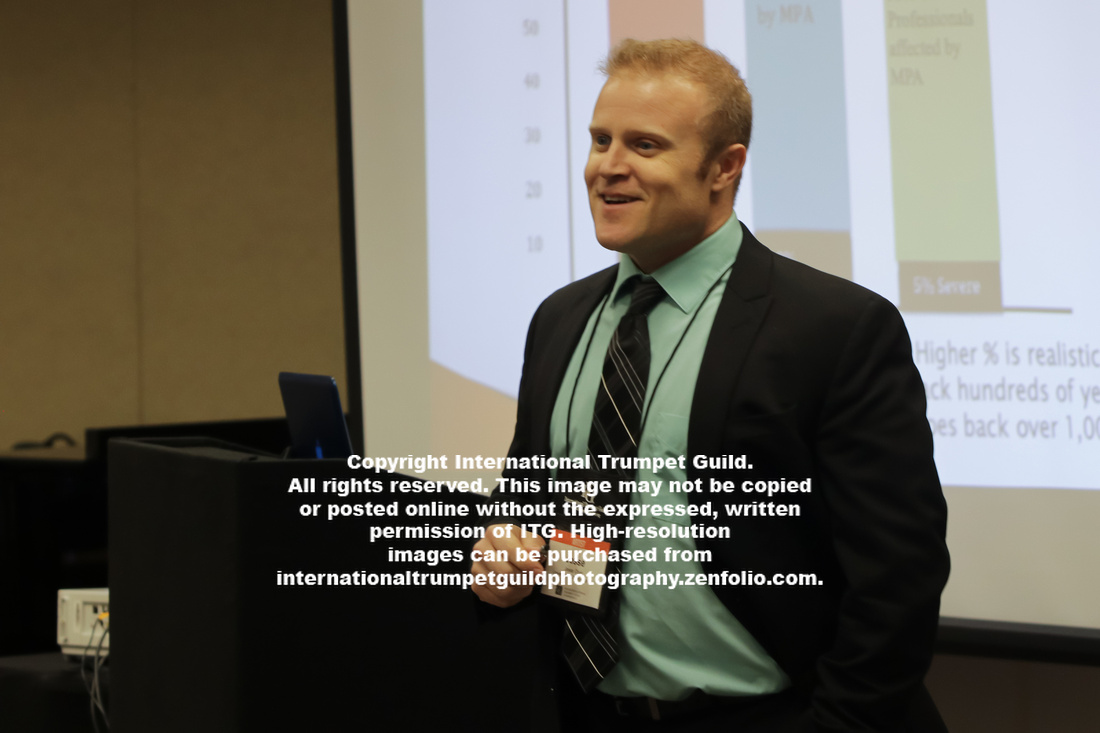
New Works Recital I
Maria Valencia opened the first of this year’s two New Works Recitals by performing Benjamin Thorn’s Croutons XIV for Natural Trumpet. She started with a crystal-clear first attack and directed the instrument’s bell in a sweeping gesture over the audience. She briefly sang through the horn, echoing a prior melody. The work was enhanced by ascending rips, fanfare figures, and the distinctive sound of a wooden mute.

The Northwest Passage Trumpet Trio, consisting of Jennifer Dearden, Andrew Erb, and Timothy Winfield, artfully performed Fernando Deddos’s Nuvens de Junho (June’s Clouds). An enchanting, closely voiced opening contrasted with moments of musical pointillism and lively dance. At other moments, trumpets moved together relentlessly at half-step intervals. Ensemble unison moments were effective, as was the rapidly tongued pyramid of sound that closed the piece.
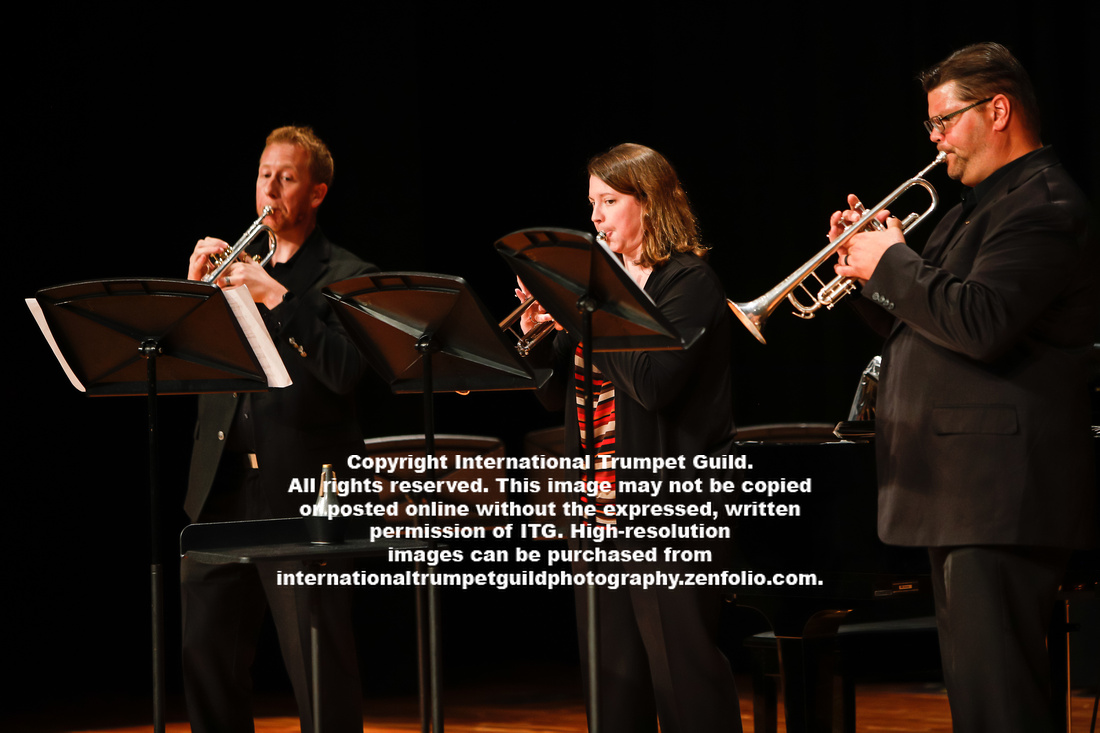
Philip Spaeth’s Epiclesis for trumpet (Phillip Chase Hawkins), trombone (Jessica Hawthorne), and harp (Kristina Finch) opened with thoughtful strumming and a dark rubato passage in the trumpet, which was soon joined subtly by trombone. The harp then set the tempo, presenting virtuosic, yet mournful, rhythmic interest while the trumpet and trombone exchanged a recurring motive. The brass traversed medieval-to-blues modes in sustained, consonant lines.
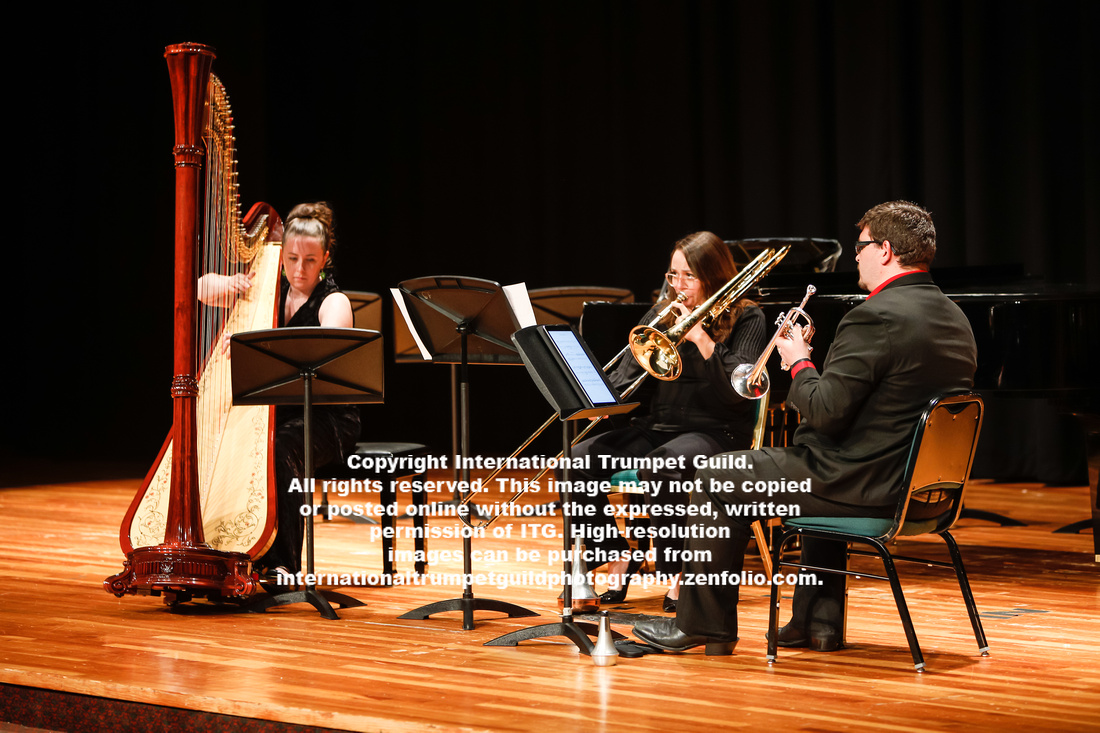
Dr. Robert Murray performed Brandon Dicks’s Peri Sketches for unaccompanied solo trumpet in B-flat, exploring the interval of the perfect fifth. This character snapshot of the trumpet contrasted open intervals with distinctive chromatic passages that spidered outwards into the instrument’s upper and lower ranges.

Zae Munn’s Trumpet Calls was written for twenty C trumpets in five separate groups. Under the direction of Eric Millard, the ITG New Works Ensemble of young professionals presented a fascinating melange of timbres and rhythms. A group with aluminum foil over their bells produced an unearthly, mechanical whine with the buzz of a snare drum. Another choir presented disjunct rhythms that became increasingly unified. The full ensemble climax created an unsettling, yet fascinating, soundscape.
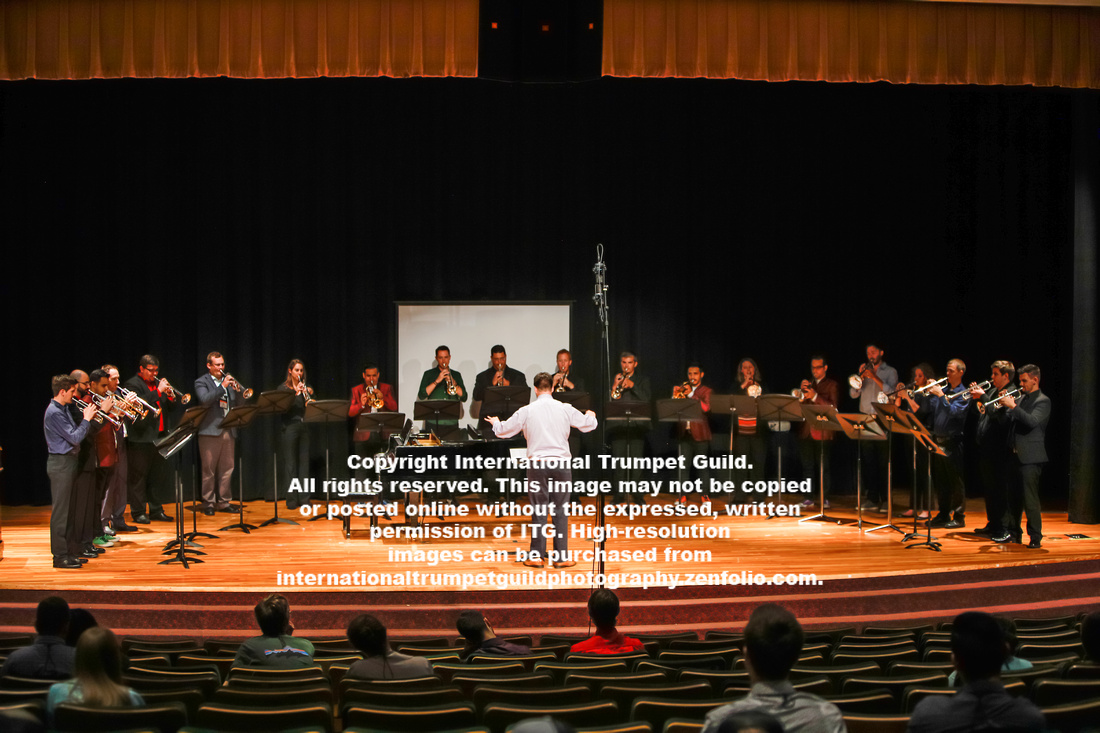 Trumpeter Jeremy McBain and pianist Miriam Hickman presented the second movement of Kyle Gullings’s JPL Sonata, “Titan (Ride the Tides through the Throat of the Kraken).” The piece opened jazzy and pensive, with the trumpet using harmon mute with the stem out. As the piece gathered momentum, the trumpet traversed large intervallic leaps and an expansive cadenza. Lush piano writing complemented the moody, solemn atmosphere.
Trumpeter Jeremy McBain and pianist Miriam Hickman presented the second movement of Kyle Gullings’s JPL Sonata, “Titan (Ride the Tides through the Throat of the Kraken).” The piece opened jazzy and pensive, with the trumpet using harmon mute with the stem out. As the piece gathered momentum, the trumpet traversed large intervallic leaps and an expansive cadenza. Lush piano writing complemented the moody, solemn atmosphere.
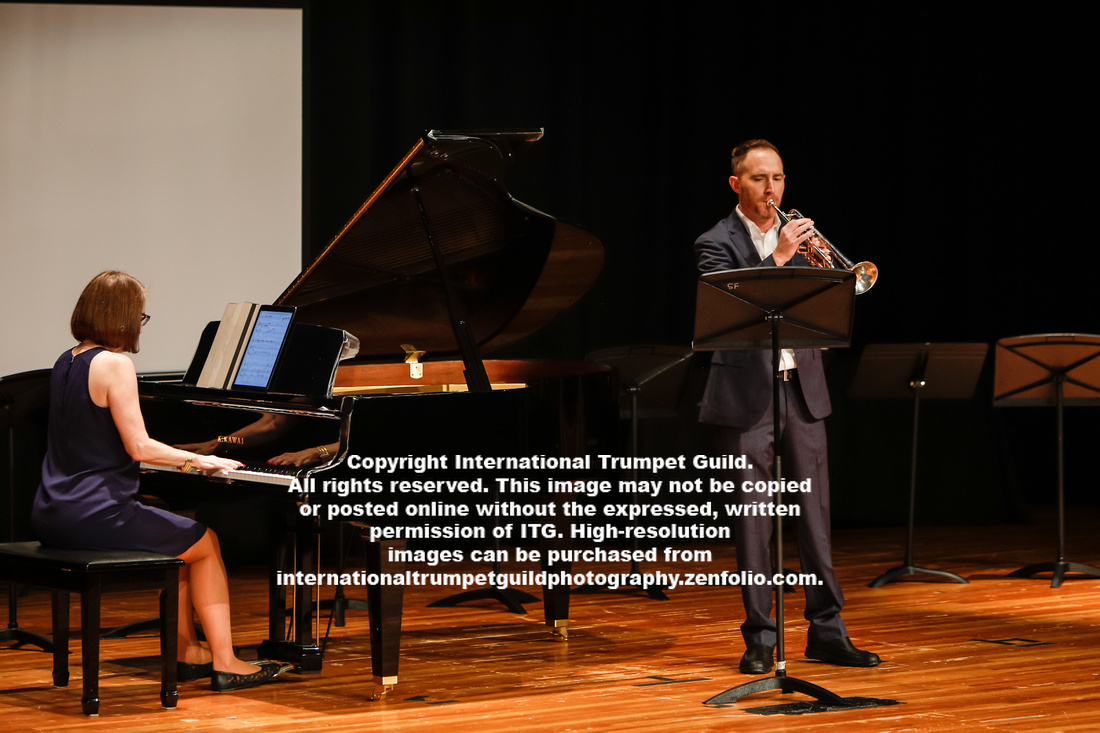
Martin Amlin wrote his Sonata for Trumpet and Piano for Terry Everson, who performed the work on E-flat trumpet with Miriam Hickman on piano. Everson was immediately virtuosic and engaging, making the perpetual motion of the first movement, “Invention,” seem effortless. The melodic lines were jagged, yet harmonically cohesive. Everson showed off his wide dynamic range, from piercing fortes to pianos of pure compacted energy. The principal melody line started on an upbeat, giving the whole piece a sense of leaning forward. The second movement, “Chaconne,” opened with understated, twinkling piano. Everson transformed the trumpet’s character without the aid of a mute, achieving an airy, distant sound punctuated by triple-tongued interjections. The third movement, “Moto Perpetuo,” contrasts Everson’s smooth articulation on a single pitch with an angular melody and ascending rips. The piece was joyfully presented, with Everson’s flexibility, musicality, and range on full display. (MM)
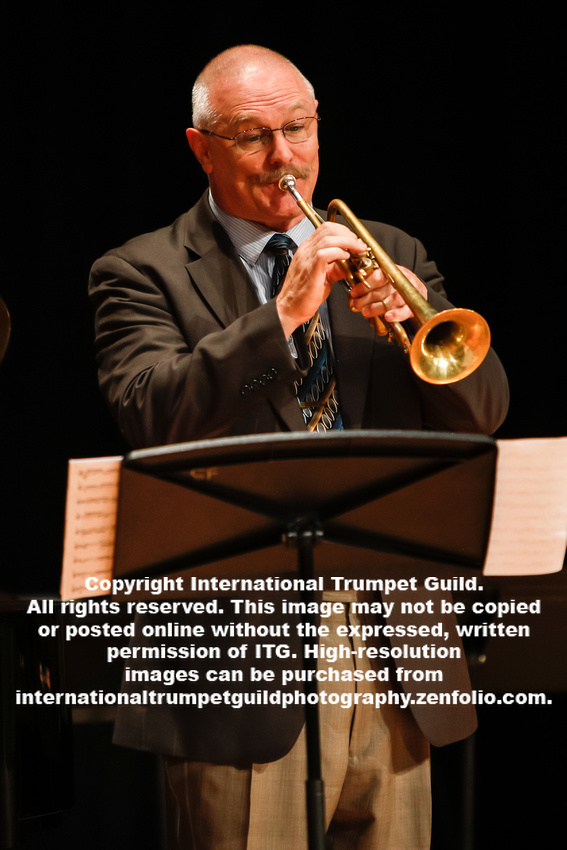
Jose Sibaja Recital - Latin Influences
Jose Sibaja presented a diverse program with enchanting, melodious works influenced or written by composers from South and Central America. With the help of pianist Rebecca Wilt, percussionist Robert Vilera, trombonist Domingo Pagliuca, and trumpeter Alexis Morales, there was a pleasantly shifting color palette for nearly every piece. The 2019 ITG commission, Pendulum provided a fascinating departure from more standard repertoire and will surely be in high demand. Clarice Assad’s ability as a composer was equally matched by her ability on the piano and as a vocalist. After a touching dedication to Sam Pilafian, renowned tubist and pedagogue, Sibaja closed his program with three traditional Costa Rican songs, aided by five fellow Costa Rican trumpeters. It was a wonderful way to conclude the program and stands as a testament to the importance of the ITG Conference, giving light to music and musicians from outside the United States. (MV)
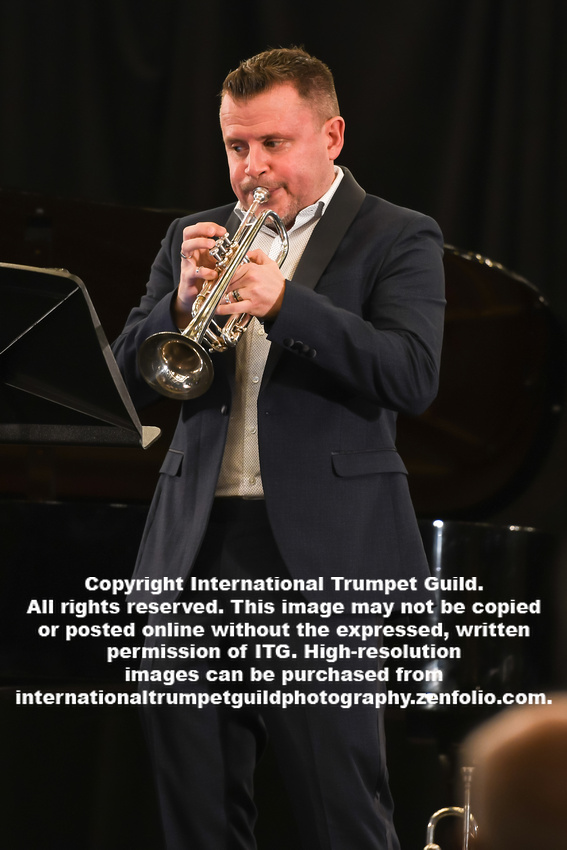
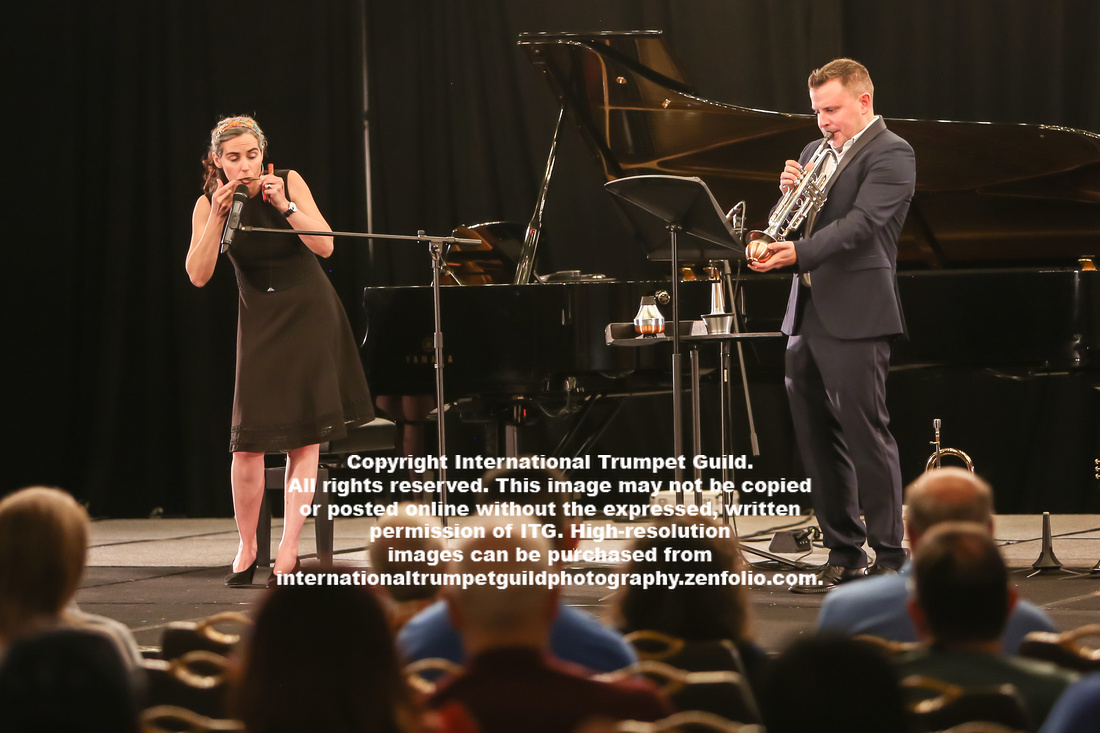
Click here for more photos from the ITG Conference
]]>
Special Daily Report • Compiled by Peter Wood
Photos by Michael Anderson, Norman Black, Benjamin Lowe, and Donald Sorah
Wednesday, July 10 - Evening events
Click here for more photos from the ITG Conference
Recital: Barbara Butler and Christopher Martin
A capacity crowd packed the Trinity Episcopal Cathedral for a brilliant recital by trumpeters Barbara Butler (Rice University) and Chris Martin (New York Philharmonic), along with organist Bryan Anderson. The program opened with a sparkling rendition of the Vivaldi Concerto for Two Trumpets in C, featuring Butler playing the first part with elegant ornamentation. Chris Martin performed Klemens Schnorr’s arrangement of J.S. Bach’s Concerto in D, BWV 972 (after Vivaldi). Martin’s silky-smooth cantabile in the central Larghetto was a notable highlight. Butler performed Petr Eben’s Okna (Windows). Her commanding tone and sensitive interpretation were matched by Anderson’s virtuosity on the organ. Martin then joined his former teacher in transcriptions by Barbara Harbach of two vocal duets from Bach cantatas. In Carson Cooman’s Solstice Sonata, Chris Martin’s gorgeous sound held the audience spellbound. Both trumpeters took the stage together again for the final selection, two movements from James Stephenson’s Awakenings, This exciting piece was a perfect close to the wonderful recital, sending the audience forth in high spirits. (EK)
Check out this video from the concert!
Martin/Butler Recital Video Excerpt
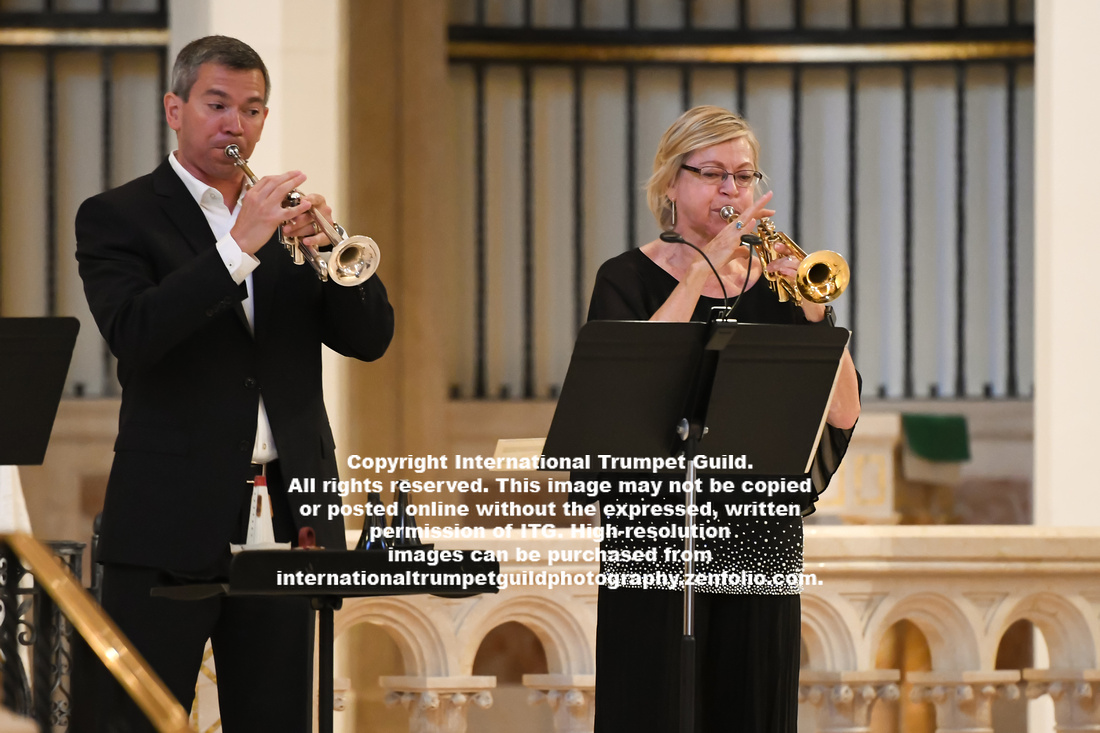
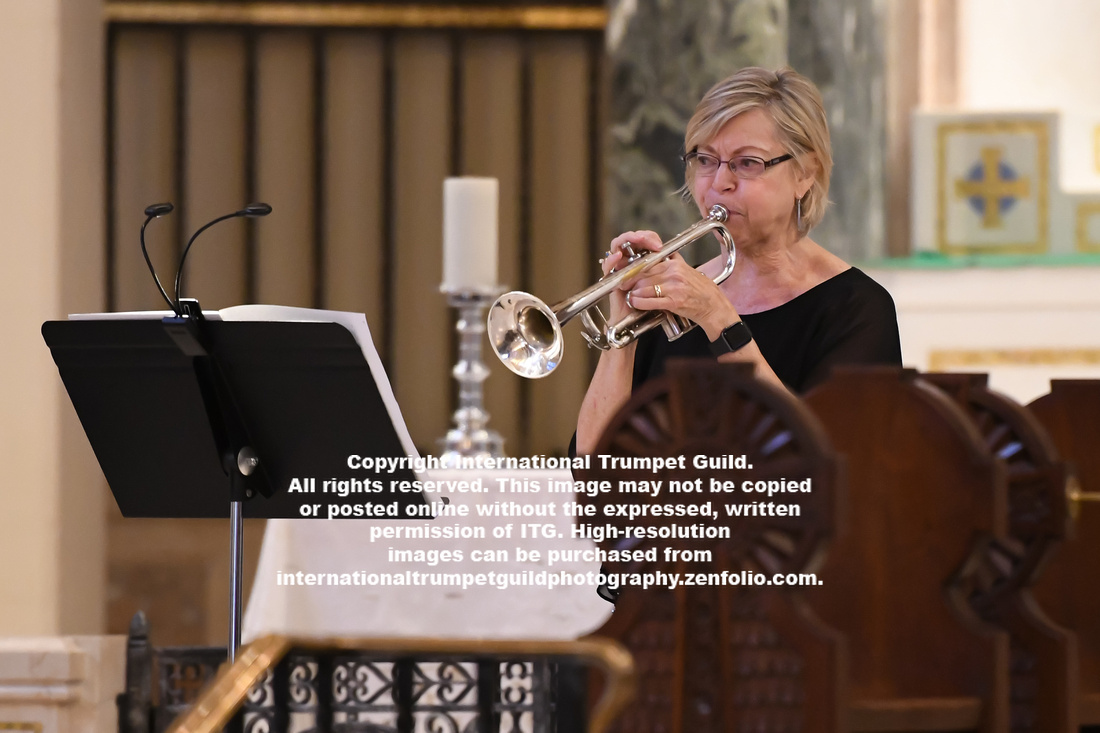
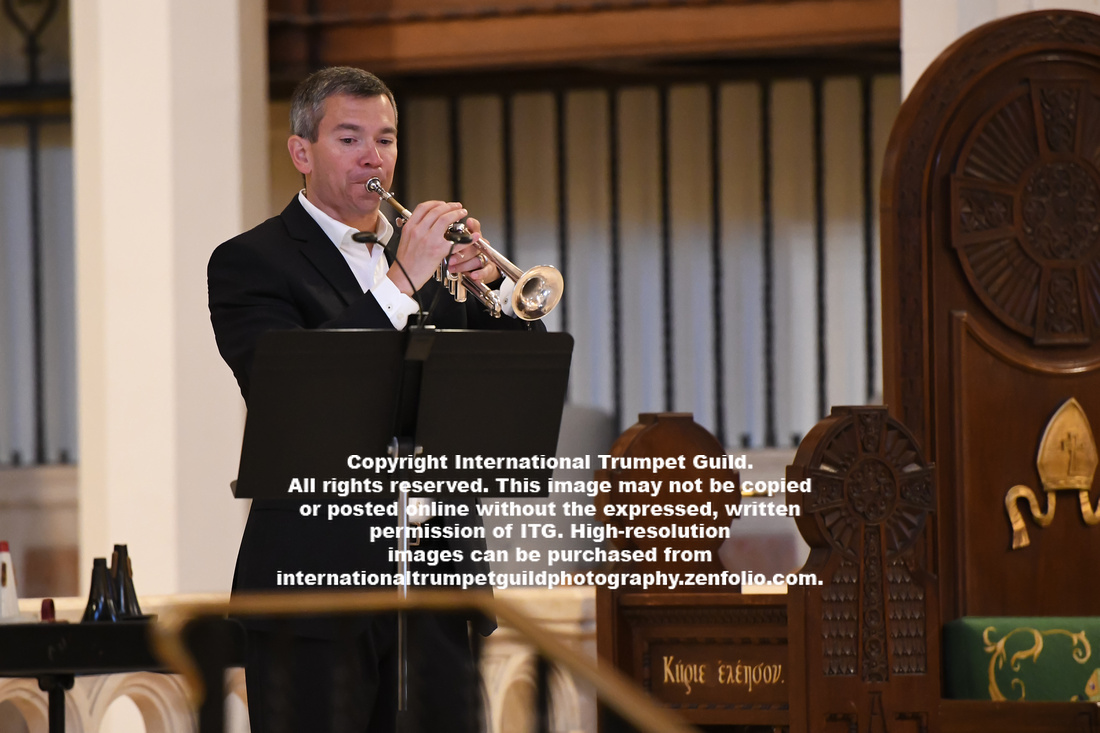
Yamaha European All-Stars
What do you get when you combine jazz trumpet players from Norway, Germany, Poland, Sweden, and Italy with a solid rhythm section and then add the music of Bill Chase? You get an exciting, screaming, enjoyable concert! Not since 2008 in Banff has an ITG Conference featured the music of Bill Chase. It was fun then, and it was fun tonight!
Frank Brodahl (Norway) has been accumulating the music of Chase, in some cases creating arrangements from live concert recordings, since 2015. He, along with Ingolf Burkhardt (Germany), Jacek Onuszkiewicz (Poland), Patrick Skogh (Sweden), and the always electrifying Andrea Tofanelli (Italy), brought the music of Chase back to life. Jim Szantor of DownBeat magazine once described this music as “complex cascading lines; a literal waterfall of trumpet timbre and technique.” (https://en.wikipedia.org/wiki/Bill_Chase) The rhythm section was strong, but especially noteworthy was pianist Tal Cohen, whose solos were almost as exciting as Tofa’s high notes!
The performance began with Open Up Wide, featuring the artistry of Andrea Tofanelli. Familiar works included Invitation to a River, Two Minds, Bochawa, Boys and Girls Together, Weird Song, and MacArthur Park. They also performed less familiar works from the Chase repertoire, such as Gary Fry’s arrangement of Tubular Bells. While “Bill Chase” and “ballads” rarely appear in the same sentence, Chase did perform some works at slower tempos. Ingolf Burkhardt played a beautiful flugelhorn solo in the ballad Twinkles, and Ode to a Jellyfish featured Patrick Skogh, also on flugelhorn.
Breaking from the theme of the concert, the quintet performed “The Star Spangled Banner” as arranged by Frank Brodahl as a tribute to the ITG Conference and the United States before concluding the concert with their rendition of Get It On, bringing the audience back to their feet. The friendship and camaraderie among the five were obvious, especially between Brodahl and Tofanelli, who kept calling Brodahl “a big Viking.”
Bill Chase played lead trumpet with the Maynard Ferguson, Stan Kenton, and Woody Herman bands before forming “Chase,” a jazz rock band that mixed pop, rock, blues, and four trumpets, in 1971. Chase was killed tragically in a plane crash in August 1974 at the age of 39, but he has had a lasting impact on trumpet playing. Thanks to the sponsorship of the Yamaha Corporation, the music of Chase was reborn for this evening’s standout concert. (KE)
Check out these videos from the European All-Stars concert!
European All-Stars Chase Video Excerpt
European All-Stars - Chase - Get It On!
European All-Stars - Star Spangled Banner
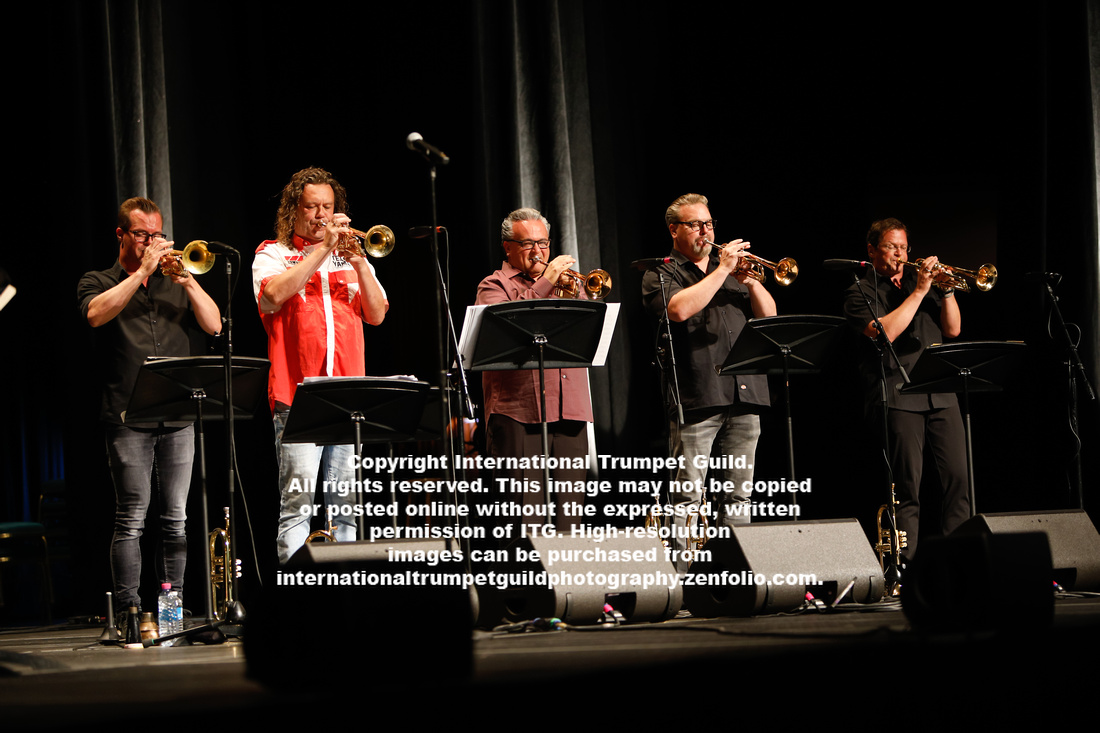
Non-Pro/Comeback Players Reception
The Non-Pro/Comeback Players Reception has become an annual event at ITG Conferences. This is an important constituency within the International Trumpet Guild, and ITG President Cathy Leach thanked the group for their continued involvement in the organization. Dan Hallock, chair of the Non-Pro/Comeback Players Committee, reminded those at the reception about events yet to be held during this week’s conference, including warm-up sessions, masterclasses, and the Festival of Trumpets concert. He explained to first-time Conference attendees that they are “part of the ITG family” and are valued members. Numerous ITG board members and several past presidents answered questions and discussed ideas for future events with the group. Thanks to Thompson Music and Stomvi Trumpets (K.O. Skinsnes) for sponsoring this reception. (KE)
Click here for more photos from the ITG Conference
]]>
Special Daily Report • Compiled by Peter Wood
Photos by Michael Anderson, Norman Black, Benjamin Lowe, and Donald Sorah
Wednesday, July 10 - Daytime events
Click here for more photos from the ITG Conference
Stamp: So Much More Than a Warm-up – Application of Concepts for Musical Performance
Richard Rulli had the early risers up on their feet and moving first thing in the morning to help participants get their bodies ready to play trumpet for the day. James Stamp’s viewpoint is that the trumpet is an athletic activity, and Rulli took the audience through the important concepts and exercises of the great pedagogue’s methodology. While discussing Stamp’s goals for each exercise, Rulli emphasized the importance of creating synergy in your own warmup and finding ways to adapt these studies to your own individual playing needs. He also stressed the importance of always playing with a musical approach and retitled the well-known Cichowicz flow studies as “vocalises” to help further that concept. Encouraging players to always focus on creating ease and pureness in their sounds, Rulli helped the trumpeters navigate a well-rounded and thorough routine to everyone’s great benefit. (EM)

Combining Different Warm-Ups: Thompson’s Buzzing Book, DiMartinos’s Leadpipe Exercises, and Cichowicz’s Long Tones
Dr. Luis Miguel Araya started off the second day of the conference with a group warm-up session, leading the participants through a series of exercises that focused primarily on buzzing and slurring. A good deal of energy was devoted to starting off on the “right foot.” He led the group through a thorough series of Buzzing Basics exercises and then continued into a set of Cichowicz flow studies. Much of the session involved call-and-response playing, as well as a generous amount of professional direction. Araya kept a good pace throughout the early-morning session with energy and humor. Participants surely benefited from a healthy warmup as they headed off to the exhibit hall. (ED)
The Aging Trumpeter
Considering that this lecture began with a photo of Roy Rogers’ iconic horse as a “Trigger” warning, saying “You’re all going to get old, and stuff is going to break down,” the content and presentation of this “doom and gloom” topic was informative, insightful, and entertaining. Donald Robertson explained typical physical effects from aging that one can expect on muscles, respiration, vision, and hearing, along with its general diminutive effect on cognition and our abilities to maintain attention. Kevin Eisensmith synthesized that data from a trumpeter’s perspective, having struggled with (and resolved) changes that affected his playing due to factors including weight loss, lip injury, and even an allergic reaction that resulted in “flabby lips syndrome.” Fortunately, there is good news along with that of our inevitable decline, and both men outlined practical ways for trumpeters to navigate the aging process, taking those variables into consideration. Applying a process of SOC (Selection - Optimization - Compensation) will be helpful to determine well-defined goals that fit one’s resources, approach one’s daily practice thoughtfully and deliberately, and creatively and artfully compensate for those aspects in our playing that are no longer as fluent. Ideally, we are still continually striving to improve and not merely “maintain.” Our ultimate goal can and should be to find enjoyment in performing the trumpet with less frustration and a thoughtful approach. It is important to know what is happening physically while not allowing it to rule us mentally or diminish our confidence. (PS)

Trumpet Archaeology and Digging for Treasure: Estonian Trumpet Music
Led by Dr. Susan Barber Kahro and Dr. Karen Gustafson, the morning was off to an intriguing start with a lecture-recital that exposed viewers not only to Estonian culture in the Soviet era, but also to several lesser-known gems in the repertoire for trumpet and piano by Estonian composers. Kahro explained the cultural, historical, and musical background of each piece, including a brief formal analysis, before it was then ably performed by Gustafson. Arguably the most well known of the works on today’s program, Eino Tamberg’s Trumpet Concerto, Op. 42, was brought to popularity by Timofei Dokshizer and Hakan Hardenberger. The program also included René Eespere’s Flatus 1, Harri Otsa’s Sonatine, and Veljo Tormis’s Kümme tegemist trompeti ja klaveriga. Kahro’s historical context and Gustafson’s passionate, expert playing brought each of these treasures to life and created a highly enjoyable experience for all in attendance. (WK)
Wind Band Excerpts Competition
This year’s Wind Band Excerpts Competition, a staple event of the ITG Conference, featured finalists Ross Mitchell, Stephen Spink, and Tyler Moore, all students of Wiff Rudd and Mark Schubert at Baylor University. The contestants performed the following excerpts, all in the following order: Charlier’s Etude No. 6, Rimsky-Korsakov’s Procession of the Nobles, Copland’s Outdoor Overture, Stravinksy’s Soldier’s Tale, Hindemith’s Symphony in B-flat, Grainger’s Lincolnshire Posy, Sousa’s Hail to the Spirit of Liberty, and Arban’s Variations on a Theme from “Norma” by V. Bellini. Moore performed first, displaying exceptional lyricism and expression in the Grainger. Spink followed and demonstrated outstanding technique and cornet style in the Arban variations. Mitchell was the final competitor and exhibited a rich and powerful orchestral tone in the Hindemith. The judges will certainly have their work cut out for them, determining a winner among these three fine players. (MY)
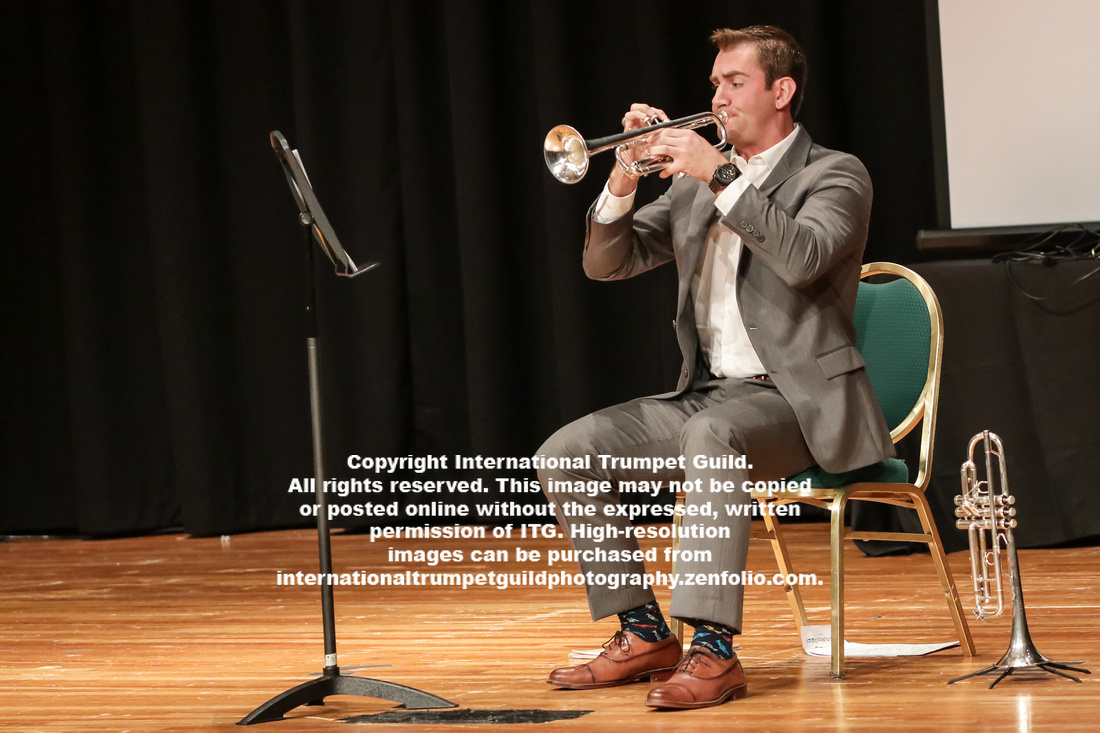
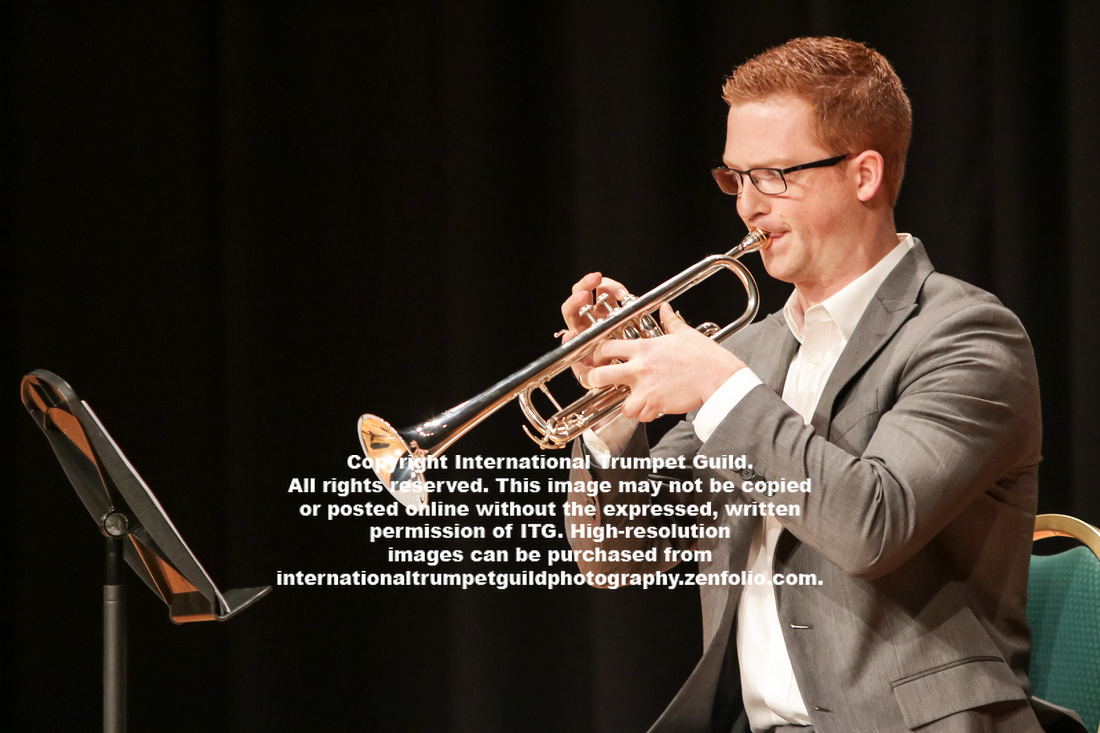
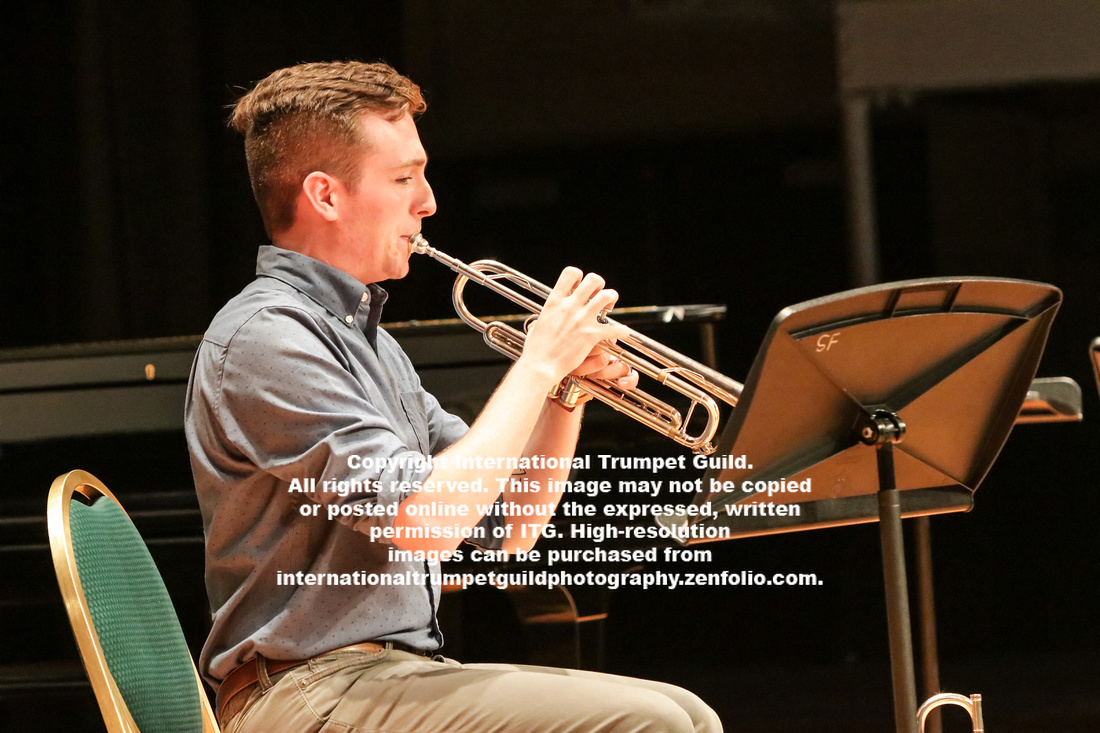
The Expatriate Trumpeter
Born, raised, and educated in the United States, Joseph Bowman has been the trumpet professor at Mahidol University in Bangkok and a member of the Thailand Philharmonic since 2003. Americans interested in working abroad often contact him as an expatriate, and this session addressed frequent questions concerning job opportunities teaching at all levels, performing in many genres, and consulting as an expert. Job websites like ITG, international music schools, College Music Society, Chronicle of Higher Education, HigherEdJobs.com, and Musical Chairs, as well as other standard resources offer some employment opportunities. Developing countries are not regularly included, however, and require personal connections and/or visits. Bowman’s firsthand accounts of cultural differences and resulting shifts in perspective were explored. He discussed the relative strengths that he has experienced in different parts of the world: pedagogy in the United States, artistry in Europe, and community in Asia. Working abroad offers opportunities for growth, interaction, and making a difference, and Joe Bowman shared his valuable insights with the rest of the trumpet community. (LE)

Romain Leleu Recital
The morning recital by Romain Leleu and Rebecca Wilt was simply stunning. Except for the opening piece (a lightning-fast performance of Alexander Goedicke’s Concert Etude), the program focused on French repertoire, from Théo Charlier’s Solo de Concours to Georges Enesco’s Legende and much more. To cap off this marvelous recital, Leleu delivered an effortless rendition of Jean Baptiste Arban’s Carnival of Venice. The ease with which Leleu navigated difficult passages and the rich, warm, pure sound emanating from his bell throughout the recital were simply breathtaking. Add the ever-engaging stylings of Rebecca Wilt on the piano, and the recipe for a memorable trumpet recital was complete. (TT)
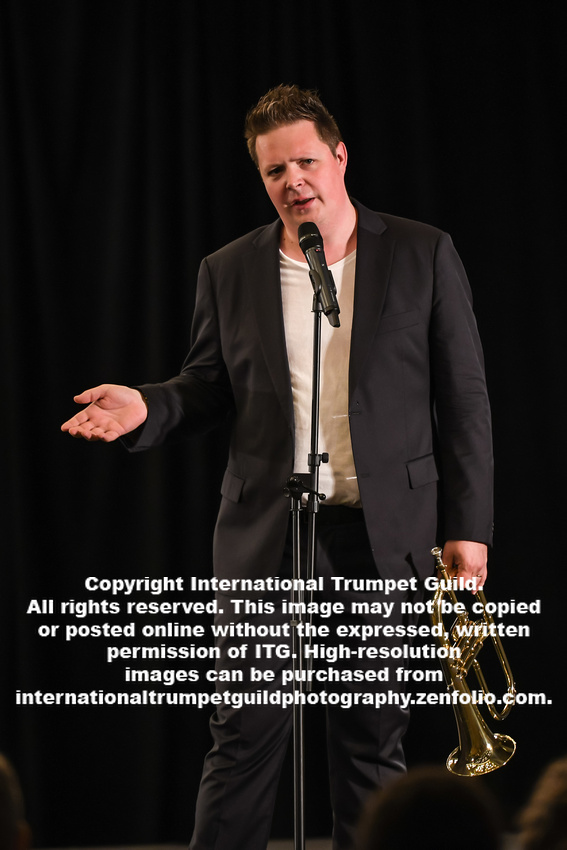
Working in Academia: What to do AFTER You Win Your First Job
Dr. James Johnson gave a detailed, well-researched, and very personal presentation on how to keep an academic post after first winning it. His presentation was divided into three parts. The Transition” addressed the crucial elements of how to leave one’s current position. In “Preparing for the New Job,” Johnson talked about how to navigate a new environment and build rapport with new colleagues and students. Finally, he opened “Doing the Job” by brainstorming all the responsibilities of being an applied teacher and discussed each in further detail (even the duties not included in the job description). With four years of teaching experience at Kansas State University, he has firsthand knowledge that led to an incredibly informative lecture on the challenges of moving into a new job and keeping it. (SB)
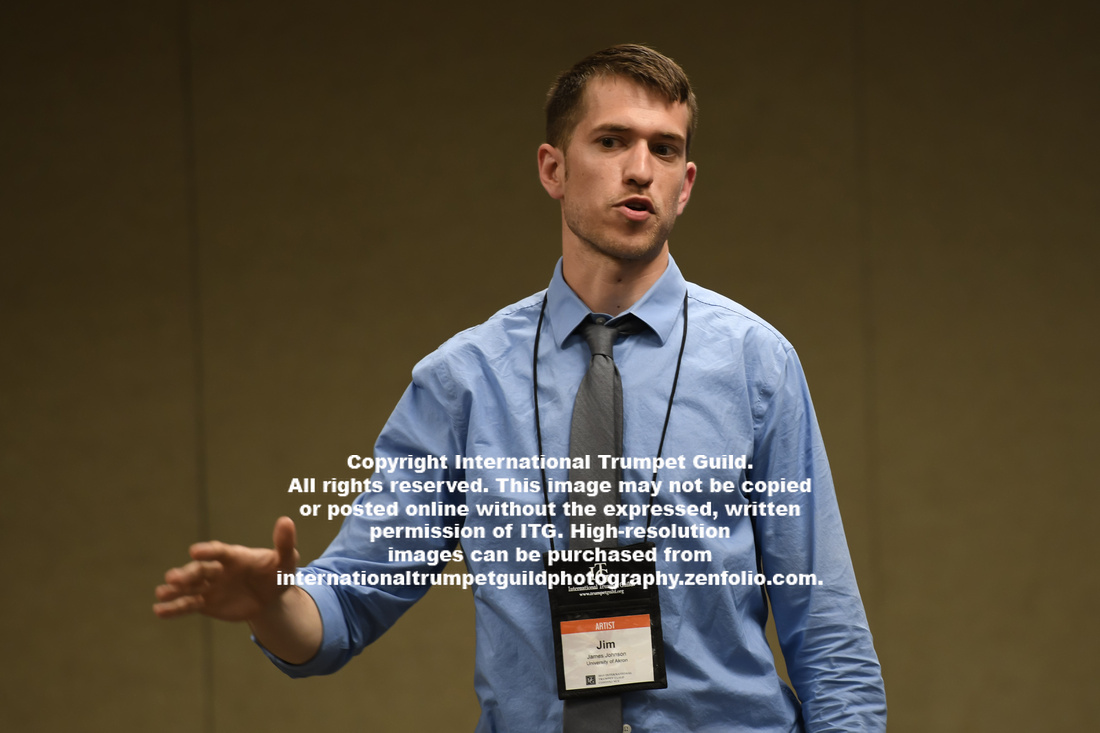
From Bach to Bernstein: Music for Trumpet and Piano
Richard Carson Steuart, founding member of the trio that would become German Brass, performed a beautiful and heartfelt recital. Opening with Variations on Acteon by Arban, he played with sweeping lyricism and dolce vibrato on an A cornet that he both designed and built. Several times during the recital, he mentioned that he was experiencing pain from a lip injury he sustained during his travel to Miami. In spite of this, he remained calm, cool, and musically exciting in his delivery of a diverse and demanding recital. He performed Enesco’s Légende on B-flat trumpet and uniquely used a solotone mute for the final passage. He also performed a movement of Vejvanowski’s Sonata in G minor on natural corno da caccia and was joined on stage by Daniel Crespo for a transcription of Stölzel’s Concerto for Violin and Oboe. The unique and inspiring program concluded with Dokshizer’s arrangement of Rhapsody in Blue. (JB)
Jazz Improvisation for the Classical Musician
Many classically trained musicians struggle with effectively communicating authentic-sounding and stylistically accurate musical ideas when asked to improvise in jazz and commercial musical contexts. The root of the problem, according to Joe Montelione, is a type of paralysis through analysis when confronted with the challenge of creating something from nothing in real time. Montelione presented a systematic approach for individuals to overcome these difficulties and develop comfort in contributing to a musical conversation as equal parts composer, performer, and listener. Points of emphasis in developing the ability to create without the aid of written music included genuinely studying the craft, stepping out of one’s comfort zone, realizing one’s artistic objective, establishing confidence, listening, collaborating, trusting, and practicing. Other important points that Montelione discussed included simplifying and just playing. The idea of staying in the moment and focusing on the fun cannot be stressed enough. (AD)

Jazz Improvisation Competition
After brief introductions by Chase Sanborn and Jason Carter, each of the three finalists in the ITG Jazz Improvisation Competition was allowed twenty minutes for two required tunes (Airegin and I Can’t Get Started) and one tune of the competitor’s choice.
First on stage was Ethan Avery, who was accompanied by the competition trio, the Chuck Bergeron Trio, consisting of Chuck Bergeron (drums), Zach Bartholomew (piano), and John Yarling (bass). Avery started his set with Airegin, showcasing his technique and efficiency and creating a brisk start to the competition. He continued to show all sides of his playing and musical sensitivity through a beautiful rendition of I Can’t Get Started, and his third piece was an original composition, Hopefully I’ll Know. Avery said that the tune was about a month old, so he was excited to test it out at this competition.
Brandon Choi opened with his optional tune, Herbie Hancock’s Dolphin Dance, demonstrating Choi’s velvety tone, sensitive use of space, and creative ideas in the low register. He ended the tune with an unaccompanied solo that led seamlessly into I Can’t Get Started. The ballad seemed to lend itself well to Choi’s playing, which was relaxed and comfortable throughout. He took time to introduce members of the trio before jumping into his final tune, the bebop standard Airegin, bringing a lively end to Choi’s portion of the competition.
Alec Aldred made a bold statement when he kicked off his set with a Latin version of Airegin. Following with his lovely rendition of I Can’t Get Started, Aldred continued to demonstrate a solid sound, coupled with great style and creative ideas. Aldred considers himself a composer as much as a trumpet player, so he took the opportunity to show his writing skills by ending with an original composition entitled You Lose, You Snooze, making for a light-hearted end to the competition.
All three candidates gave a strong and musical presentation that resulted in an afternoon that felt more like a concert than a competition. (WK)
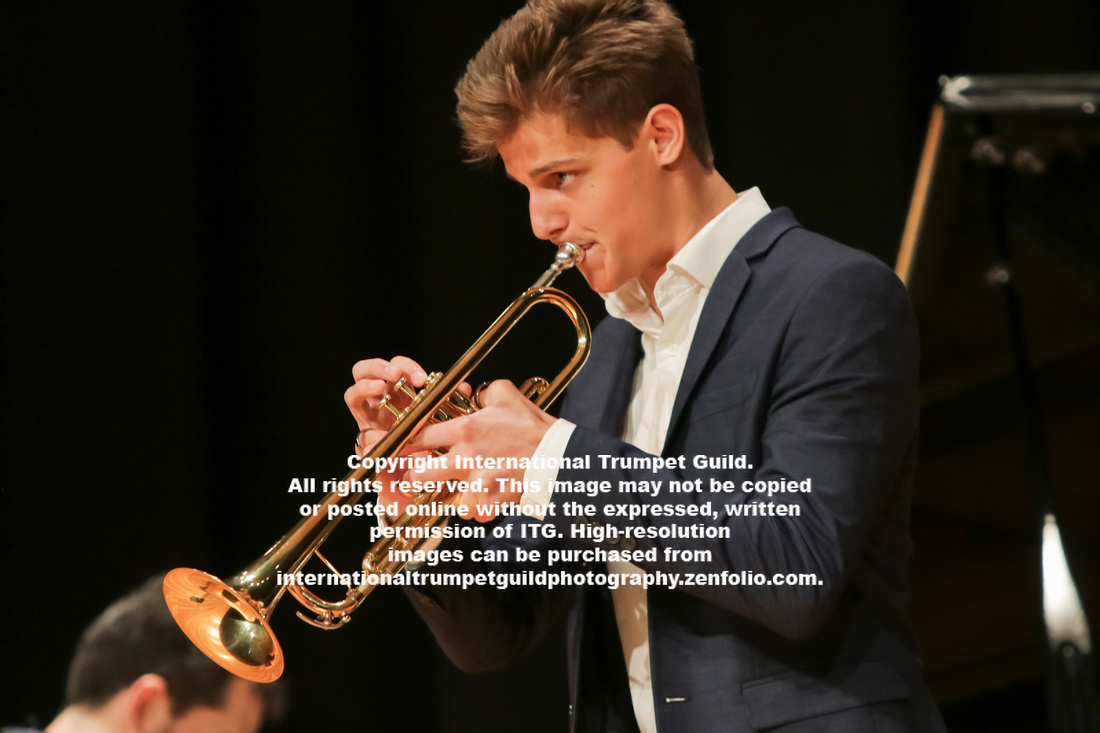
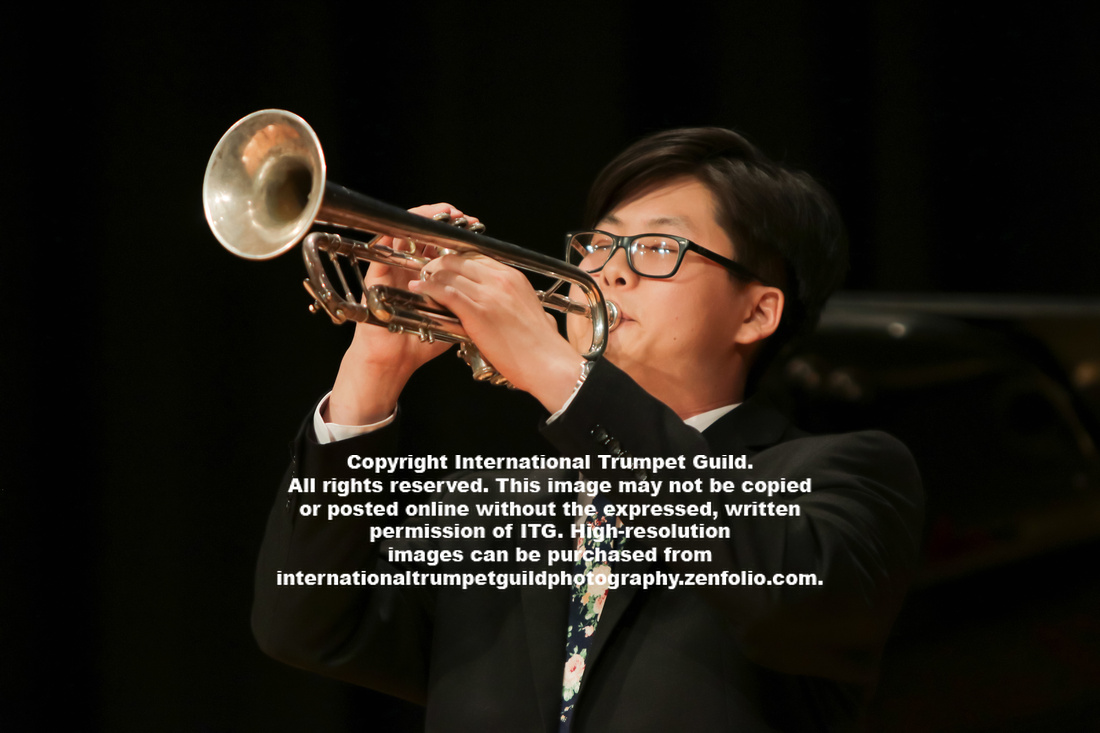
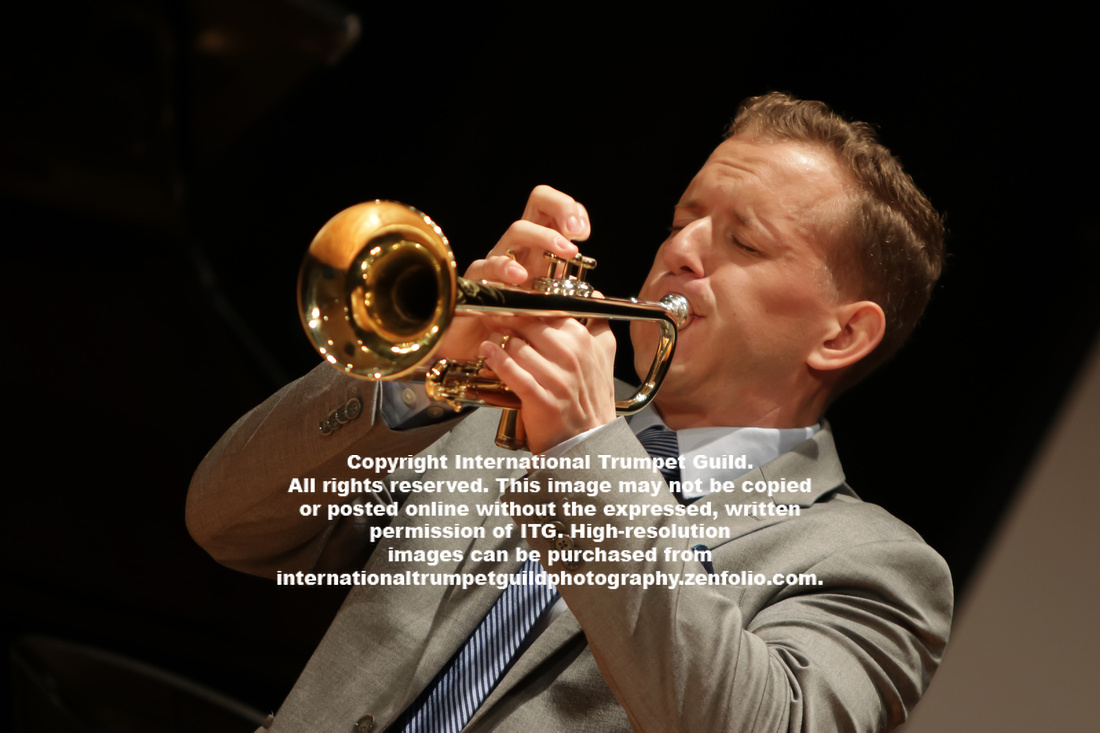
Perform from Memory? But I Play the Trumpet!
Brian Reichenbach and Terry Everson gave a wonderful lecture on the art of performing from memory. With an emphasis on how everyone has the ability to memorize, Reichenbach and Everson shared their personal experiences with memorization and how it has been beneficial not only in their own journey as musicians, but also as an integral part of their teaching. Everson made it clear that memorization should be more about focusing on playing the instrument and developing the ear. He also shared that doing formal musical analysis for any piece can aid in faster memorization and a better understanding of the work. Reichenbach and Everson talked about the legitimate reasons why many people choose not to memorize music, but they explained that whatever the reason, performing from memory has wonderful benefits like the freedom from playing off the page and the development of the ability to turn a performance into a conversation with the audience. (SW)
Click here for more photos from the ITG Conference
]]>
Spencer Brand (SB) is a doctoral student at Arizona State University, where he currently serves as a trumpet graduate teaching assistant. He received two MM degrees in trumpet performance and composition from Arizona State University.
John Bryant (JB) is a freelance player in Atlanta and currently serves as artist affiliate in trumpet at Reinhardt University.
Alexander Davis (AD) is a freelance writer and graduate student at the University of Kansas. He has performed with the Opera in the Ozarks Orchestra, Lubbock Symphony Orchestra, El Paso Wind Symphony, and the 1st Armored Division Band of the US Army.
Eli Denecke (ED) is a Florida State University DMA trumpet student. In Spring 2019 he graduated from the University of Florida with an MM in performance and a secondary concentration in historical musicology.
Kevin Eisensmith (KE) is a former president of the International Trumpet Guild and currently serves as secretary. He is professor of trumpet at Indiana University of Pennsylvania.
Luis Engelke (LE) is professor of music at Towson University and editor of the Music Reviews column in the ITG Journal. He is principal trumpet of several orchestras and has performed with more than fifty professional orchestras internationally.
Derek Ganong (DG) is assistant professor of trumpet and director of jazz at Boise State University. He also serves as trumpet faculty at the FredBrass Institute and is a founding member of the Vice City Brass.
Elisa Koehler (EK) is a member of the ITG Board of Directors and the author of Fanfares and Finesse (Indiana University Press). She will begin a new position this fall as professor of music and chair of the Music Department at Winthrop University.
Will Koehler (WK) is an active clinician and performer in the central US. A recent graduate of Indiana University, his teachers include Joey Tartell, Jeff Curnow, Al Hood, and Todd Hastings.
Marie Mencher (MM) is a master's student in trumpet performance and a graduate teaching assistant at Kansas State University.
Eric Millard (EM) is the assistant professor of trumpet at the University of North Carolina at Charlotte. He also serves ITG as the Conference Stage Manager and Book Reviews column editor.
Kyle Millsap (KM) is assistant professor of trumpet and jazz at Texas A&M University-Kingsville, where he oversees the trumpet program and directs the trumpet ensembles, jazz trumpet ensembles, and Jazz Band II. He also performs with the Kingsville Brass Quintet.
Paige Nelson, editorial assistant, is a freelance trumpeter and teacher in the Philadelphia area. She holds degrees from the University of Northern Colorado (MM) and the University of South Alabama (BM).
Grant Peters (GP) is ITG vice-president and will begin his service as president on October 1. He is in his 24th year as professor of music at Missouri State University, where he teaches trumpet and coordinates the brass area.
J. Peyden Shelton (JPS) is the assistant professor of trumpet at the University of Utah. He serves as the ITG Orchestral Excerpts Competition chair and is a Yamaha Performing Artist.
Steven Siegel (SS) is assistant professor of music at Western Colorado University and serves as a recordings reviewer for the International Trumpet Guild.
Pamela Smitter (PS) is principal trumpet in the West Michigan Symphony Orchestra, section trumpet in the Kalamazoo Symphony Orchestra, and a DMA candidate at Michigan State University.
T.J. Tesh (TT) is a Yamaha and Pickett Brass artist and serves as assistant professor of trumpet at The University of Southern Mississippi.
Matthew Vangjel (MV) teaches trumpet at Louisiana State University in Baton Rouge. He is also an active performer and holds positions with the Mirari Brass Quintet, Fountain City Brass Band, and Mobile Symphony Orchestra.
Nick Volz (NV) is associate professor of trumpet and jazz studies at Loyola University New Orleans.
Spencer Wallin (SW) is adjunct professor of high brass at Navarro College. He holds degrees from the University of North Texas (DMA), the University of Michigan (MM), and Brigham Young University (BM).
Marisa Youngs (MY) is the ITG New Works coordinator and is currently the adjunct professor of trumpet and music theory at Winthrop University in Rock Hill, South Carolina.
Photography Staff
Michael Anderson is the ITG Website director and head photographer for the conference. He serves as professor of trumpet at Oklahoma City University and is a member of the Oklahoma City Philharmonic.
Norman Black is a semi-retired IT professional and percussionist who resides in South Florida. A graduate of the US Naval School of Music and former member of the 76th US Army Band, he now enjoys his favorite pastime, photography. He is the house photographer at a local community theatre and enjoys doing nature and portrait photography.
Benjamin Lowe is a professor at Stillman Business School at Seton Hall University, as well as a managing partner of Lebeta Tech, LLC. He has played trumpet/cornet with a brass band in Dublin, Ireland, as well as with a Ukranian dance band in Maryland. He is an avid photographer and displays his work on https://500px.com/benjaminlowe.
Donald Sorah is associate professor of music and coordinator of the music division at the University of Virginia’s College at Wise. He regularly performs with the Symphony of the Mountains in Kingsport, Tennessee, and the Johnson City (TN) Symphony. He is also the founder and music director of the Winds of the Mountain Empire, a regional professional wind ensemble in Big Stone Gap, Virginia.
]]>Special Daily Report • Compiled by Peter Wood
Photos by Michael Anderson, Norman Black, Benjamin Lowe, and Donald Sorah
Tuesday, July 9
This opening evening of the 44th annual ITG Conference was filled with the usual sense of eager anticipation of the wonderful trumpet-related events to come over the next four days and five nights. The Hyatt Regency in downtown Miami is a warm, welcoming hotel with great ethnic restaurants all around. As participants poured in throughout the afternoon, there were plenty of smiles, handshakes, hugs, and laughs to go around. After the fanfare with Jens Lindemann and the opening concert featuring Ingrid Jensen and Alphonso Horne, the socializing continued with an exhibitors welcome reception and a trumpet ensemble reading session led by Buddy Deshler. Expectations are high for a another memorable conference!
Click here for more photos from the ITG Conference
Opening Fanfare with Jens Lindemann
With the Opening Fanfare torch having been officially passed from the inimitable Doc Severinsen to the incomparable Jens Lindemann, the International Trumpet Guild’s 2019 Conference opened with a near 200-member trumpet ensemble performing Malcolm Arnold’s A Hoffnung Fanfare, as transcribed by James Olcott. In typical Jens-ian fashion, the maestro brought an indelible sense of fun and excitement to the event, entertaining both the players and the audience in attendance. Doc delivered a touching meditative tribute to Ryan Anthony as an introduction to the emotionally rendered closing piece, David Haskins’ arrangement of Peter Meechan’s Song of Hope, featuring soloists Nancy Taylor, Jose Sibaja, and Jens himself. In the words of Doc Severinsen, “A man without hope is through.” (TT)
Check out these Opening Fanfare videos!
https://www.youtube.com/watch?v=_31pfos9Iho&feature=youtu.be
https://www.youtube.com/watch?v=jk5ZGWkhI98&feature=youtu.be
Rehearsal Video with Jens
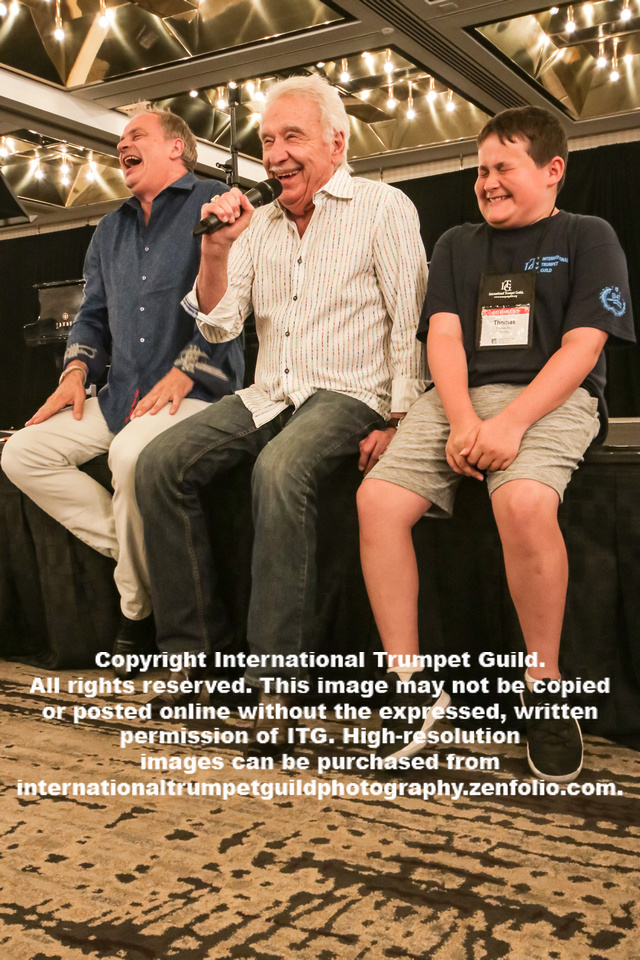

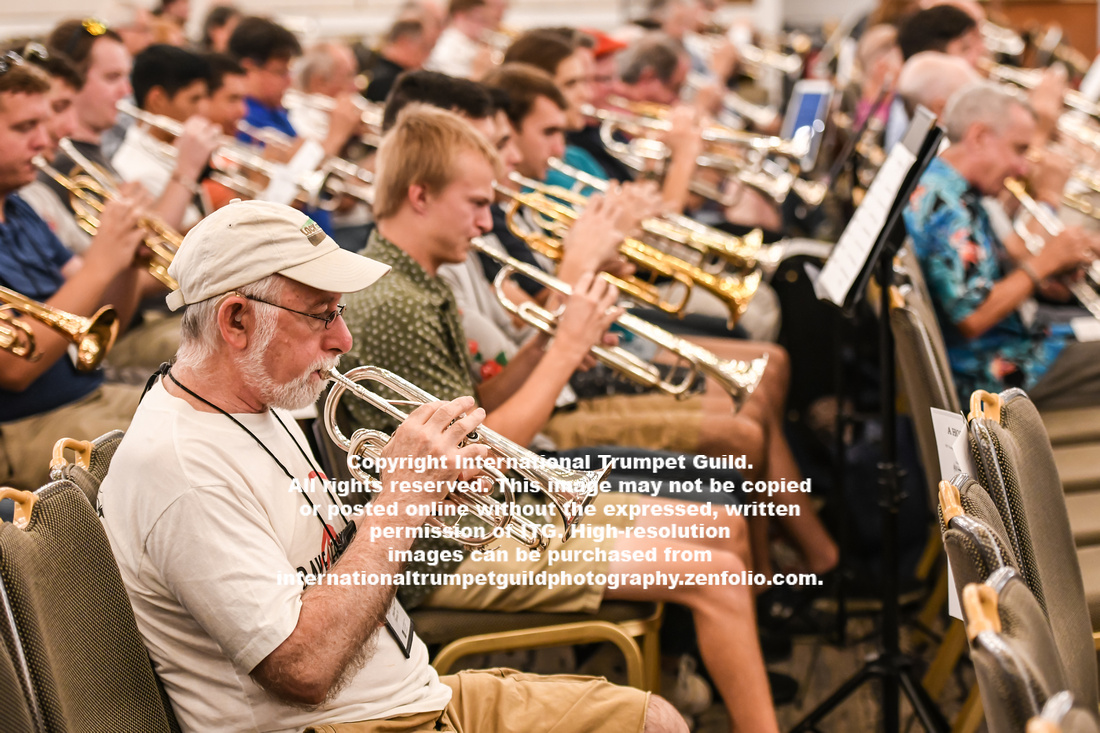
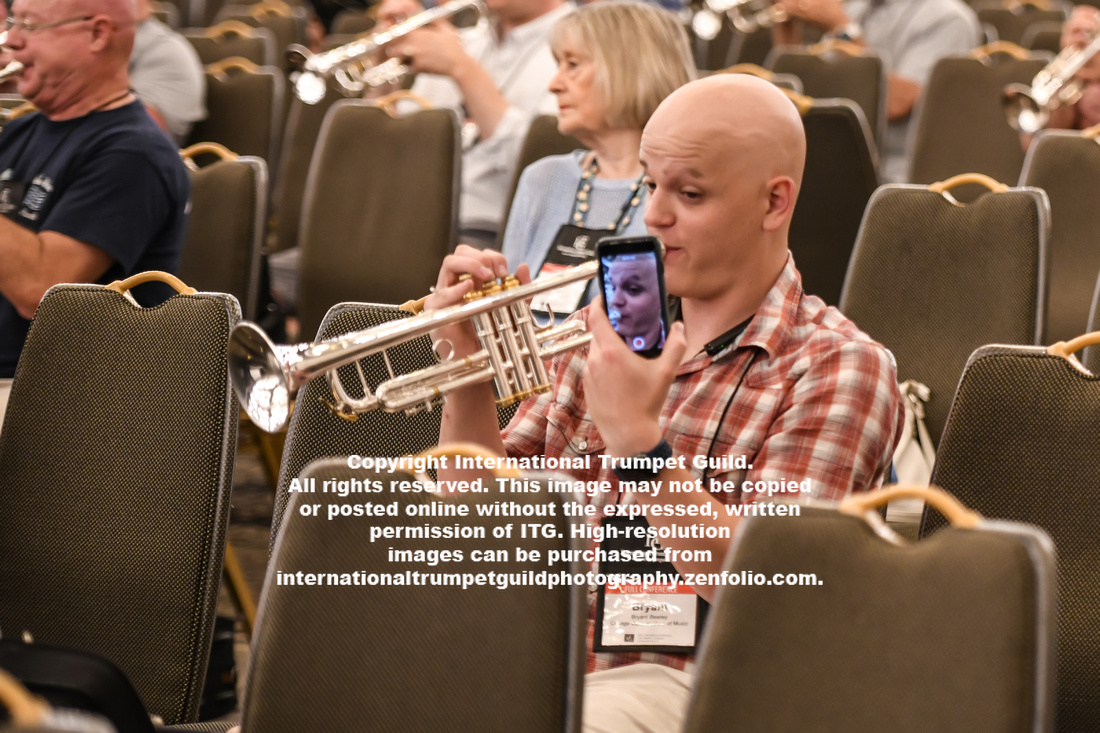
Opening Concert: Ingrid Jensen and Alphonso Horne
There is an energy and excitement that is part of every opening concert at an ITG Conference. This opening concert, featuring Ingrid Jensen, Alphonso Horne, and the Ryan Chapman Orchestra, was no exception. The somewhat small opening-night crowd fit easily into the James L. Knight Convention Center, an attractive space better suited for concerts than venues usually found in conference hotels.
The Ryan Chapman Jazz Orchestra, a newly formed seventeen-piece group, opened the event with Casting Shade, an original work by Chapman, who is a freelance trumpet player and educator living in Miami. The RCJO played with tight ensemble, an unforced quality, and a nicely balanced sound.
The applause had not ended for the first piece when both Ingrid Jensen and Alphonso Horne entered the stage, trading improvisational licks in a sort of conversation as they strolled from opposite wings to the front of the stage. What followed was the hippest version of Ferde Grofé’s On the Trail that this reviewer has ever heard. Who knew that Grofé could swing? “Laid back” was the theme for the night. This concert did not have the “can you top this?” vibe often associated with these types of performances. Great solos were played by both Jensen and Horne, with interesting interaction between each of them and the rhythm section.
Wasting no time, Jensen immediately led the band in an up-tempo arrangement of Serenade to a Bus Seat, written by Clark Terry and arranged by David Berger. Jensen has a smooth, easy approach to the trumpet, much like her mentors, including Terry.
Alphonso Horne returned to the stage to perform Portrait of Louis Armstrong and The Shepherd, both composed by Duke Ellington. In Portrait of Louis Armstrong, Horne began with an impressive imitation of Armstrong’s sound and technique and then, in an amazing tonal transition, morphed to his own sound and style. The Shepherd, one of Ellington’s sacred works, featured Horne’s remarkable ability with the plunger.
Jensen’s set included Kenny Wheeler’s Gentle Piece, which was, in fact, a very gentle and beautiful ballad. She moved directly into Song for Inga, a jazz waltz written by her sister, Christine.
Horne rejoined Jensen on stage for the final work of the night, Wink, also written by Christine Jensen and dedicated to Laurie Frink. Described by Ingrid as “sassy,” the piece opened up at the end, allowing each member of the RCJO to take a short solo before Jensen and Horne brought the piece to a rousing close. This was a satisfying opening concert--a superb pairing of two talented trumpeters with an exciting big band. (KE)

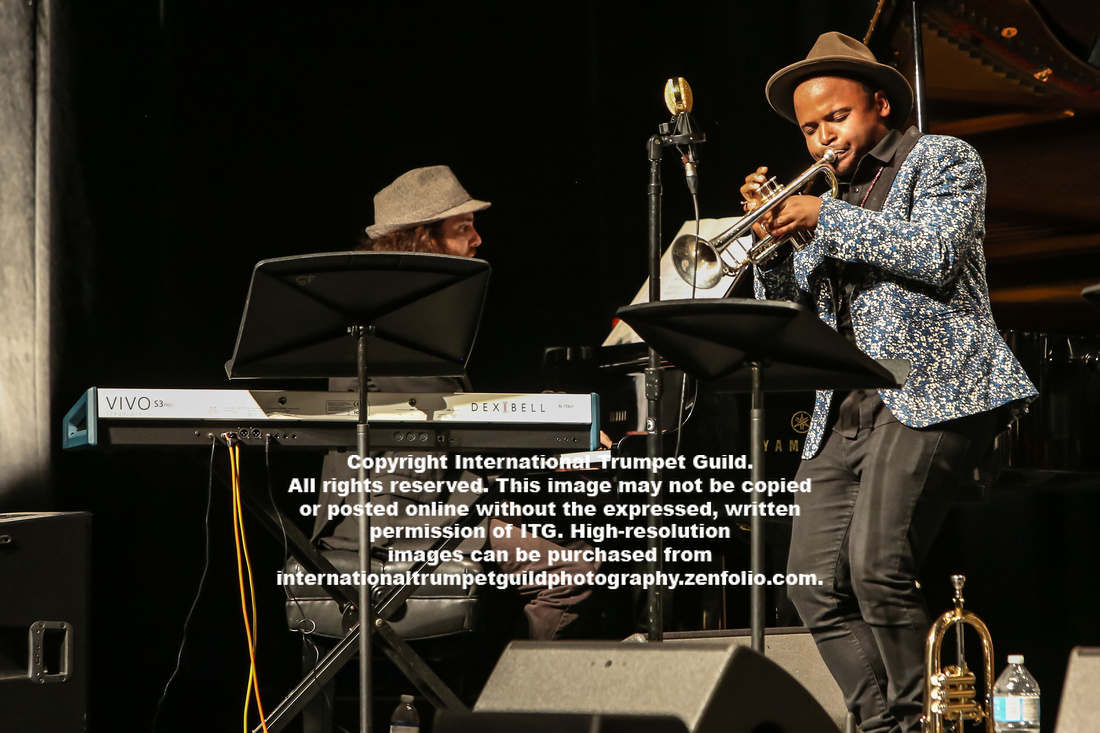
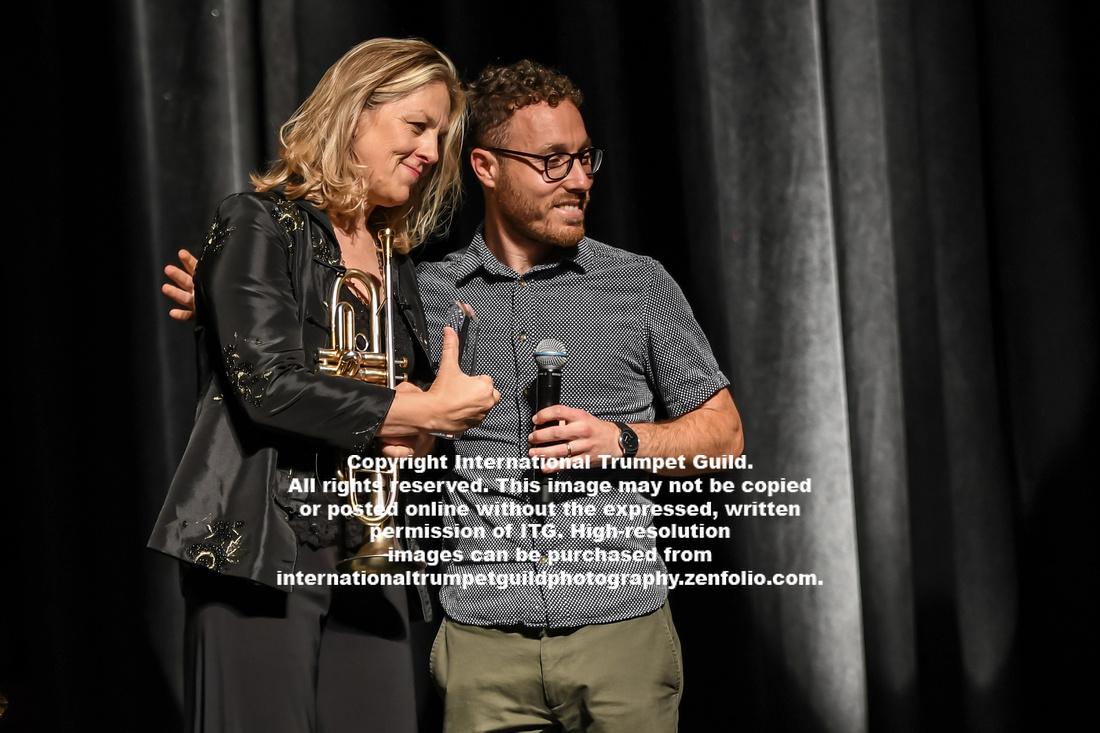
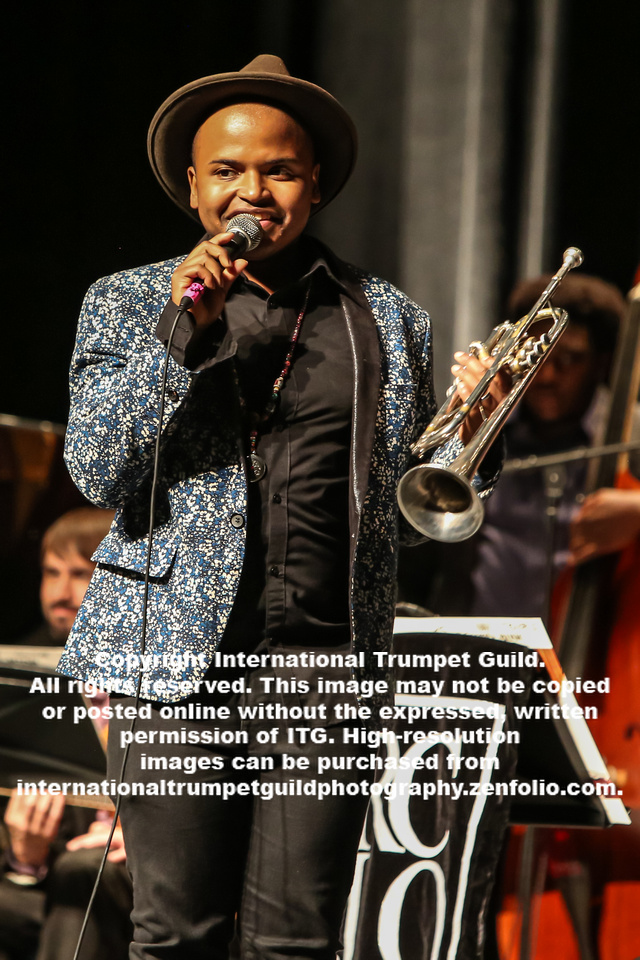
Trumpet Ensemble Reading Session #1
Trumpet ensemble reading sessions are a new, innovative part of the ITG Conference experience. These unique rehearsals are open to the public and are a wonderful opportunity for players of all abilities to learn and network together. Over forty participants of all ages attended the first reading session led by Buddy Deshler and Jim Olcott. The fast-paced rehearsal began with an arrangement of Canzona noni toni a 12 by Giovanni Gabrieli. The next piece was Lembrancas do Brasil (Memories of Brazil), an original work for five flugelhorns by Daniel Thrower. The final piece of the session was Go Forth to Serve by Daniel Thrower, a complex extended fanfare for twelve trumpets. The compositions featured in this reading session can be found on both Triplo Press and Gilded Music Press. (MY)
Click here for more photos from the ITG Conference
]]>
Special Report • Compiled by Peter Wood
Photos by Michael Anderson, Norman Bergstrom, Josh Rzepka, Denny Schreffler, and Brian Shook
Conference Prelude Performances
* Indicates premiere performances.
Groups are listed alphabetically.
Click here for more prelude ensemble photos
Abilene Christian, Hardin-Simmons, and McMurry Universities—Abilene Tri-Collegiate Trumpet Ensemble
David Amlung and Leigh Anne Hunsaker, directors
Cedric Dario, Gustavo Guerrero, Grayson Hancock, Jake Lathrop, Dawson Maxwell, Karissa Means, Leighanna Meek, Kenny Mostert, Nathan Olsen, Klarissa Shafer, Zach Shepard, Parker Shields, Julian Wiegand
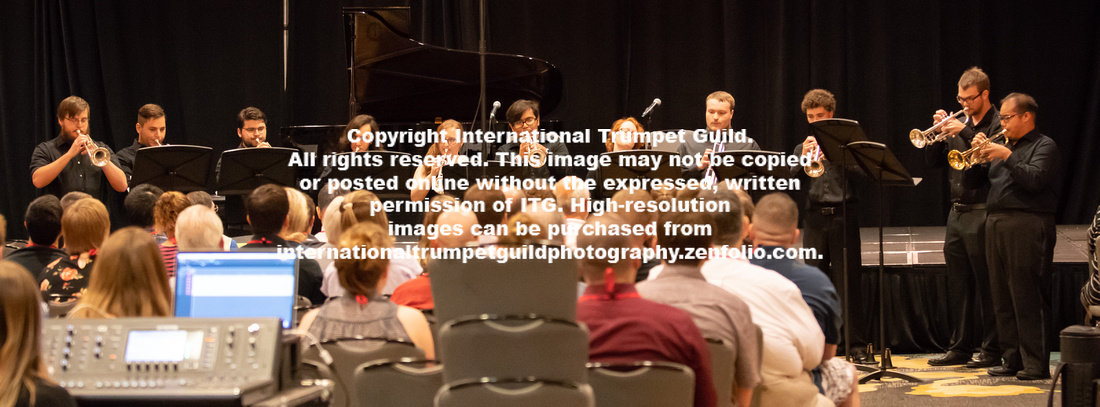 Abilene Tri-Collegiate Trumpet Ensemble
Abilene Tri-Collegiate Trumpet Ensemble
* Charlier Numero Dos by Theo Charlier, arr. Gary Slechta
The Abilene Tri-Collegiate Trumpet Ensemble, made up of students from Abilene Christian, Hardin-Simmons, and McMurry Universities, presented a fantastic rendition of Gary Slechta’s arrangement, Charlier Numero Dos. The ensemble showed fantastic control and dynamic shaping throughout this work that is based on Charlier’s famous etude. The ensemble provided a solid foundation for the solo lines that left the audience on the edge of their seats. Their precision and powerful presence was a wonderful introduction to the presentation that followed. (JPS)
Angelo State University Trumpet Ensemble
John Irish, director
Brandon Batten, William DeForest, Riley Jarabeck, and Joseph Torres
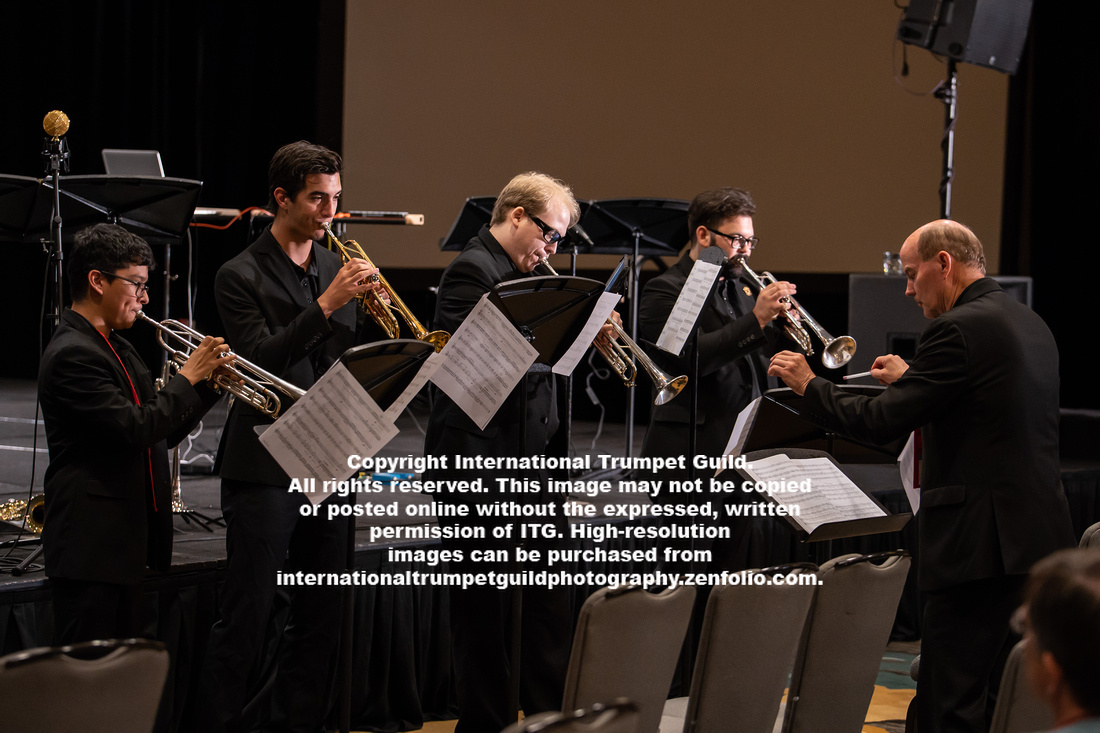 Angelo State University Trumpet Ensemble
Angelo State University Trumpet Ensemble
Ice Journey by Jason Basoco
The Angelo State University Trumpet Ensemble performed Jason Basoco’s Ice Journey as a prelude to Wim Van Hasselt’s recital. The quartet used energy and intensity to paint a picture of travels through a harsh, mystical, and unforgiving landscape. The crisp articulations, rhythmic drive, and tense but balanced harmonies came together well for an exciting and enjoyable performance. (AD)
Baylor University—Baylor Trumpets
Wiff Rudd and Mark Schubert, directors
Ryan Fitzgerald, Luke Hoeft, Jonah Kelly, Ryan McArthur, Brian Mendez, Ross Mitchell, Tyler Moore
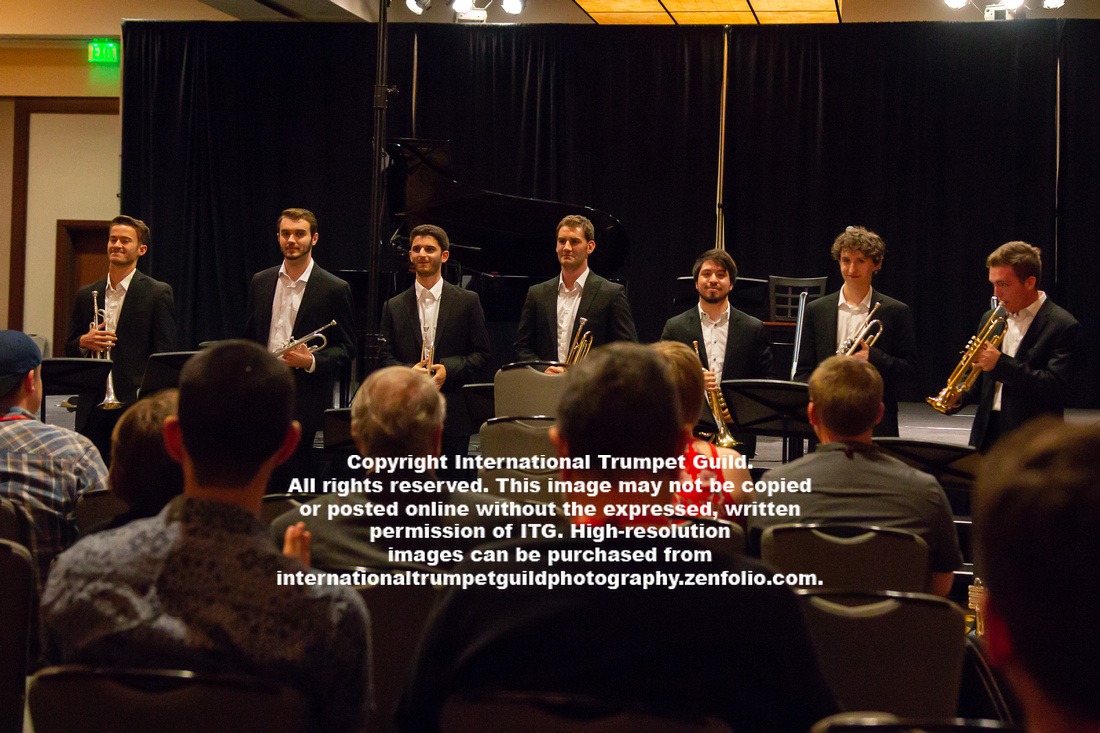 Baylor Trumpets
Baylor Trumpets
Prelude, Fugue, and Riffs by Leonard Bernstein, arr. Rudd and Parker
The ensemble launched into the three-part Bernstein piece with flair. Using an array of instruments ranging from bass trumpet to piccolo, they performed energetically and covered the highly animated, rhythmically varied, and occasionally jazzy composition brilliantly, resulting in sustained audience applause. (NM)
Baylor University—Green Trumpet Ensemble
Wiff Rudd and Mark Schubert, directors
Spencer Adams, Cordelia DeDecker, Jonah Kelly, Sig Stefansson
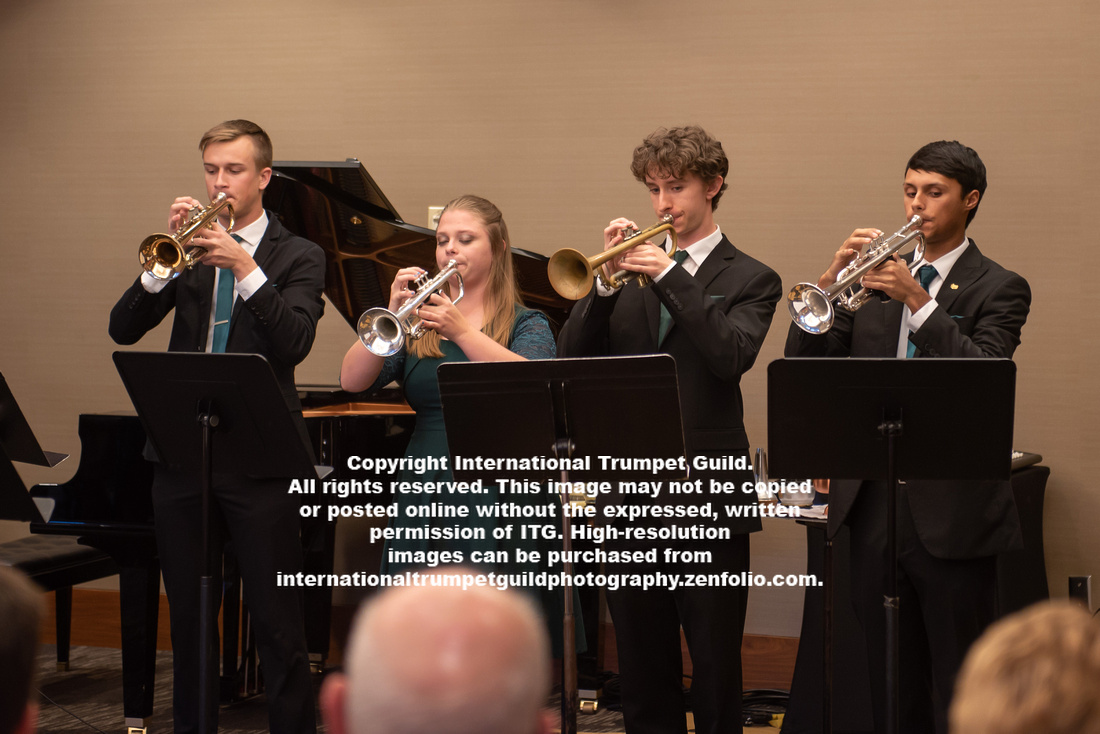 Baylor Green
Baylor Green
* Variants with Solo Cadenzas by William Schmidt
The Baylor Green Trumpet Ensemble opened Merrie Klazek’s clinic on Preparation and Performance with an attention-grabbing piece by William Schmidt. The four performers’ tone qualities, articulations, and phrasings were flawless as the moved throughout the various sections of the work. Each member of the ensemble was featured as soloist and brought their own unique style and flair to their solos. The power and refinement of the ensemble’s performance left the audience on the edge of their seats and provided a wonderful introduction to Klazek’s informative presentation. (JPS)
Baylor University—"Improv" Trumpet Ensemble
Wiff Rudd, director
Cordelia DeDecker, Luke Hoeft, Ryan McArthur, Brian Mendez, Ross Mitchell, Tyler Moore, Sig Stefansson
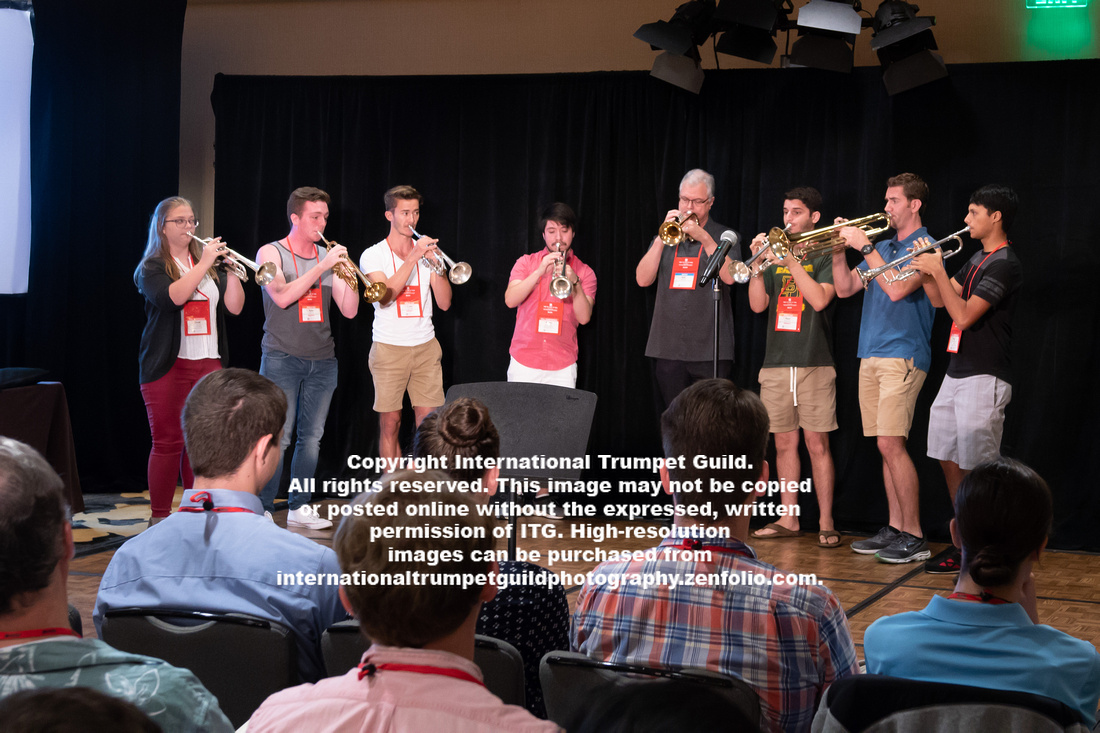 Baylor University "Improv" Trumpet Ensemble
Baylor University "Improv" Trumpet Ensemble
* Improvised prelude
The Baylor Improv Prelude Ensemble was a fantastic beginning to a wonderful presentation by Wiff Rudd. Because a member of the previously scheduled Baylor Gold trumpet ensemble was unable to attend the conference, Rudd asked for volunteers from his students in attendance to demonstrate how he teaches classical improvisation in his studio. The performance was splendid, and the audience thoroughly enjoyed the fully improvised trumpet prelude. (SW)
Brighton High School—Mixed Brass Ensemble
Sharon B. Long, director
Liam Driscoll, Grace Carney, Ethan Lee, Eli Pardington, Connor Young, Ryan Newcomb, Jarrett Mulligan, Rachel Auty, Grace Snider, Alex Hogue
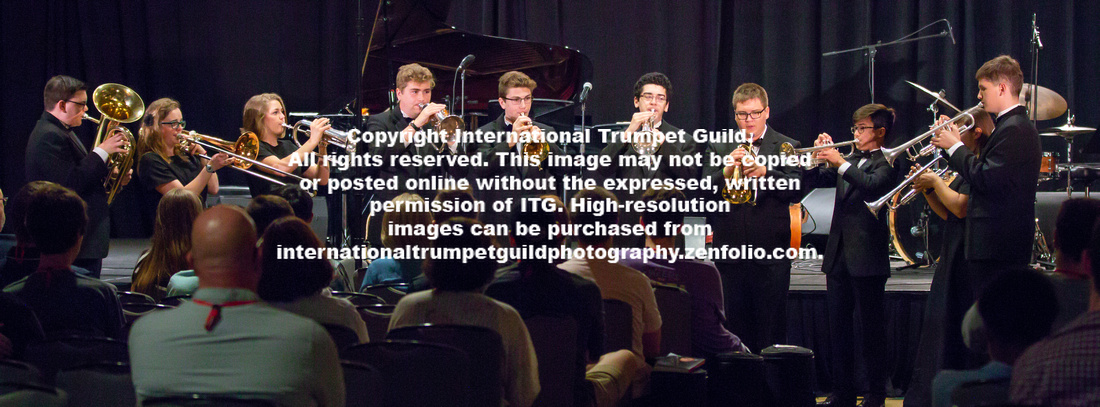 Brighton High School Mixed Brass Ensemble
Brighton High School Mixed Brass Ensemble
O Magnum Mysterium by Morten Lauridsen
Brighton High School’s Mixed Brass Ensemble performed Morten Lauridsen’s setting of O Magnum Mysterium with great poise and energy. A musically demanding piece, the performers showed a musical maturity and confidence not often found in musicians so young. The performers played with full, rich sounds, beautiful releases, and tremendous balance throughout a beautiful, emotionally charged performance. (AJ)
Campbellsville University Trumpet Ensemble
Anne McNamara, director
Cassidy Allgood, Justin Chowning, Olivia DeBolt, Tanner James, Cameron Johnson, Josh Neff, Jared Walker, Heaven Wells
 Campbellsville University Trumpet Ensemble
Campbellsville University Trumpet Ensemble
Fanfare for an Angel by James Stephenson
Catacomb by Jason Dovel
The Campbellsville University Trumpet Ensemble performed two short, exciting fanfares by James Stephenson and Jason Dovel before the Houston Symphony Trumpet Section presentation. The audience enjoyed hearing full chords played well in tune and with authority and power. (SH)
Columbus State University—Schwob Trumpet Ensemble
Robert Murray, director
Stephen Burden, Ricardo Chinchilla, Brandon Fortson, Patrick Lindsey, Steven Lukehart, Nathaniel Moore, Chase Pauley, Rashaan Skrine, Harold Villaltas, Trevor Webb, Adam White, Ryan Worley
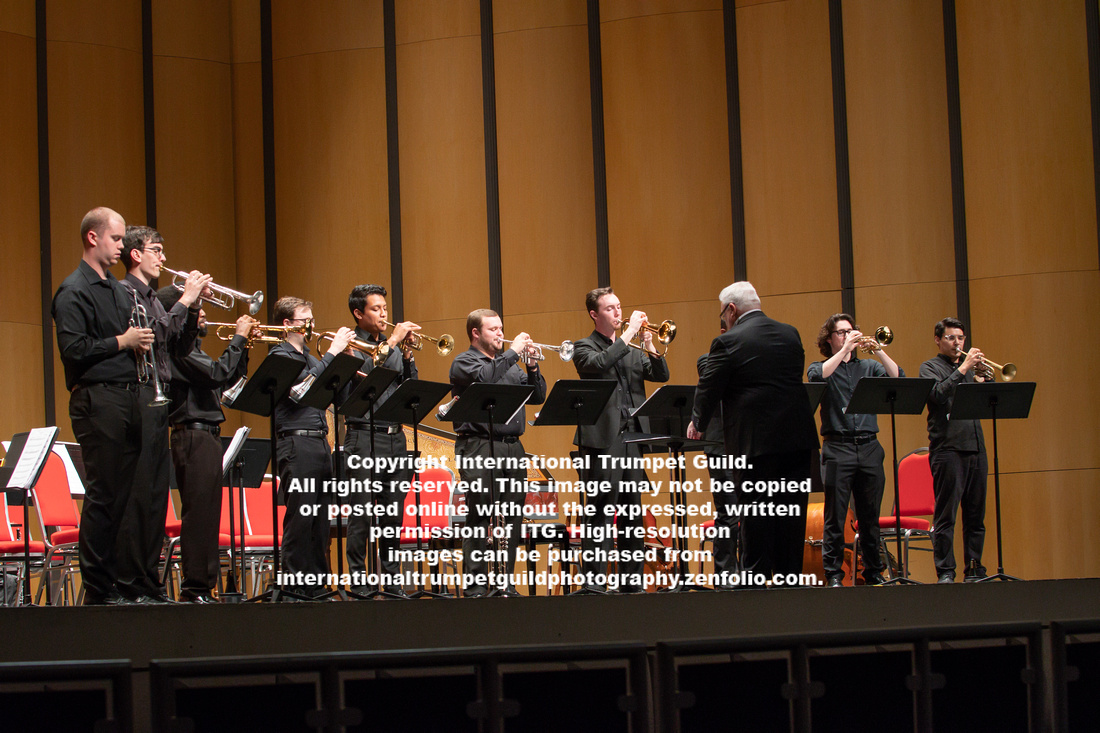 Columbus State University Trumpet Ensemble
Columbus State University Trumpet Ensemble
Fanfare – Homage to Witold Lutoslawski by Nathan Hudson
Vision over the Horizon by Brandon Dicks
The Schwob Trumpet Ensemble from Columbus State University, under the direction of Robert Murray, performed two selections. Nathan Hudson’s Fanfare – Homage to Witold Lutoslawski opened with bracing polychords and dramatic gestures that the ensemble played with impeccable precision and balance. Brandon Dicks’ Vision over the Horizon displayed the group’s finely tuned ensemble playing, wide dynamic range, and rich, unforced sound from top to bottom. (EK)
Del Mar College Trumpet Ensemble
Scott Hagarty, director
Seth Barrios, Tlaloc Perales, Brittany Richardson, Carlos Salinas, Mary Silva
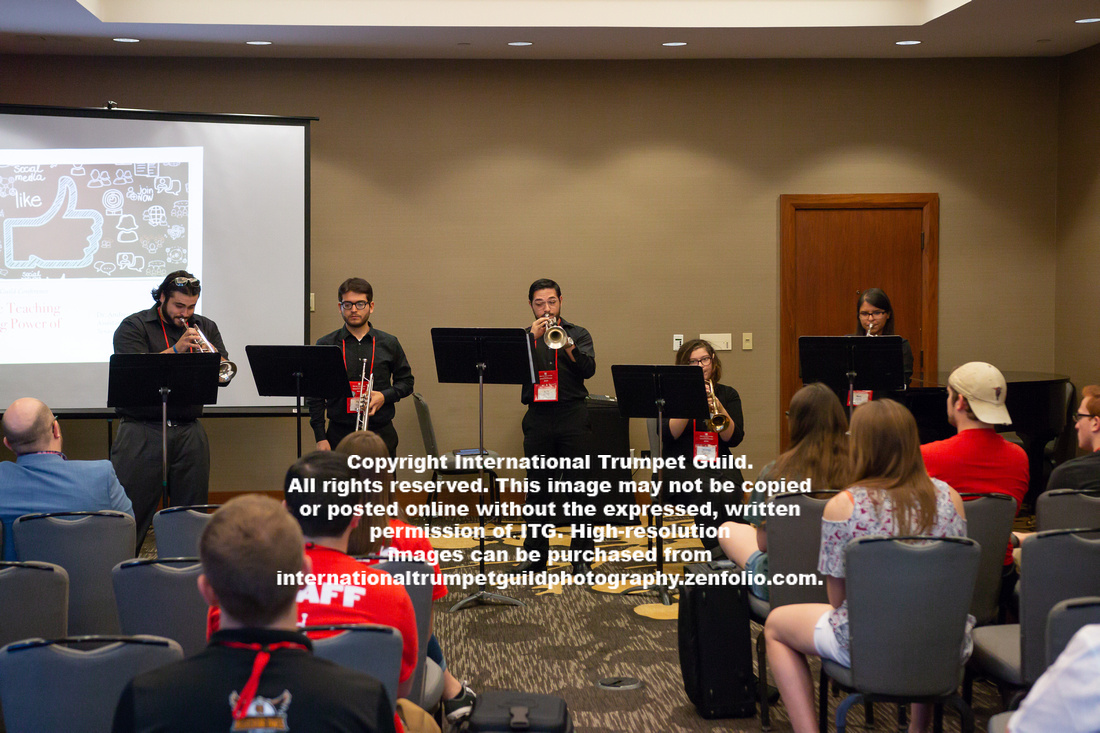 Del Mar College Trumpet Ensemble
Del Mar College Trumpet Ensemble
Cityscapes by Erik Morales
Under the direction of Dr. Scott Hagarty, the Del Mar College Trumpet Ensemble performed the first two movements of Erik Morales’s Cityscapes with great sensitivity and contrast. The first movement featured wonderful descending passages passed around the ensemble with great intonation, clarity, and resonance. The ensemble expertly juxtaposed an articulated character with Morales’s brilliant, flowing lyricism and captured the playful nature of the second movement perfectly. (AJ)
Duquesne University Trumpet Ensemble
Chad Winkler, director
Joseph Beaver, Amy Bertsch, Zach DeLuise, Robert Jarsulic, Mikayla Justen, Alyssa Lloyd, Mason Shay, Kevin Skinkis
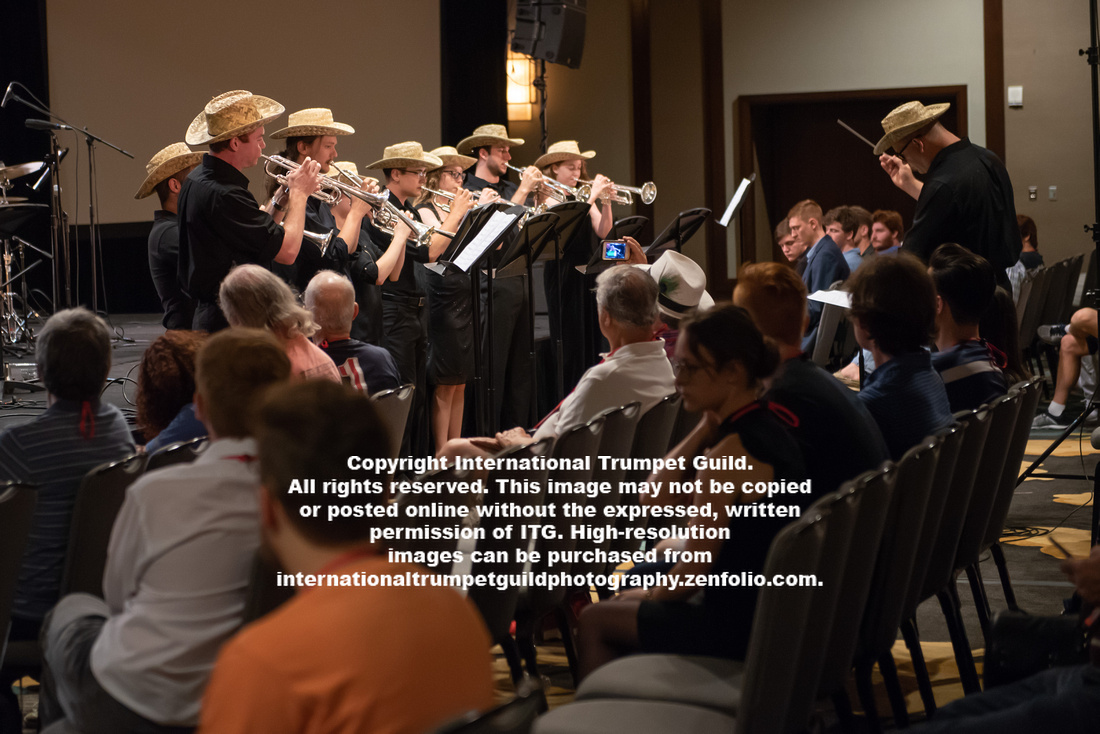 Duquesne University Trumpet Ensemble
Duquesne University Trumpet Ensemble
The Cowboys Overture by John Williams
Launching into it with verve, the ensemble played Williams’s musical panorama of the Old West with flair and brilliance. They performed the varied rhythms, textures, and motifs with superb grace and energy and concluded the piece to rousing applause. A fine performance! (NM)
Florida State University Alumni Trumpet Ensemble
Christopher Moore, director
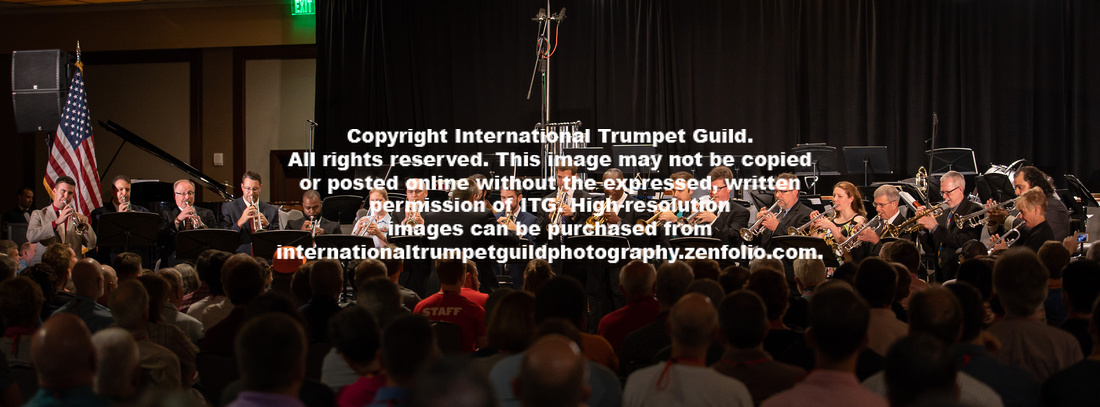 Florida State University Alumni Trumpet Ensemble
Florida State University Alumni Trumpet Ensemble
Labyrinths by Joseph Turrin
The legacy created by Bryan Goff and continued by Chris Moore was in full evidence when the Florida State University Alumni Trumpet Ensemble performed Joseph Turrin’s Labyrinths. Nineteen FSU alums performed this highly dramatic and impressive piece, commissioned by the 2011 FSU Trumpet Ensemble for the 2012 ITG Conference. (KE)
Kennesaw State University Trumpet Ensemble
Douglas Lindsey, director
Miles Bonaker, Michael Brown, Riley Carson, Kameron Clarke, Jacob Greifinger, Jon Klausman, Ra Sheed Lemon, II, Jordyn Mader, Andrew Olsen, Jeremy Perkins, Cierra Weldin, Zach Went
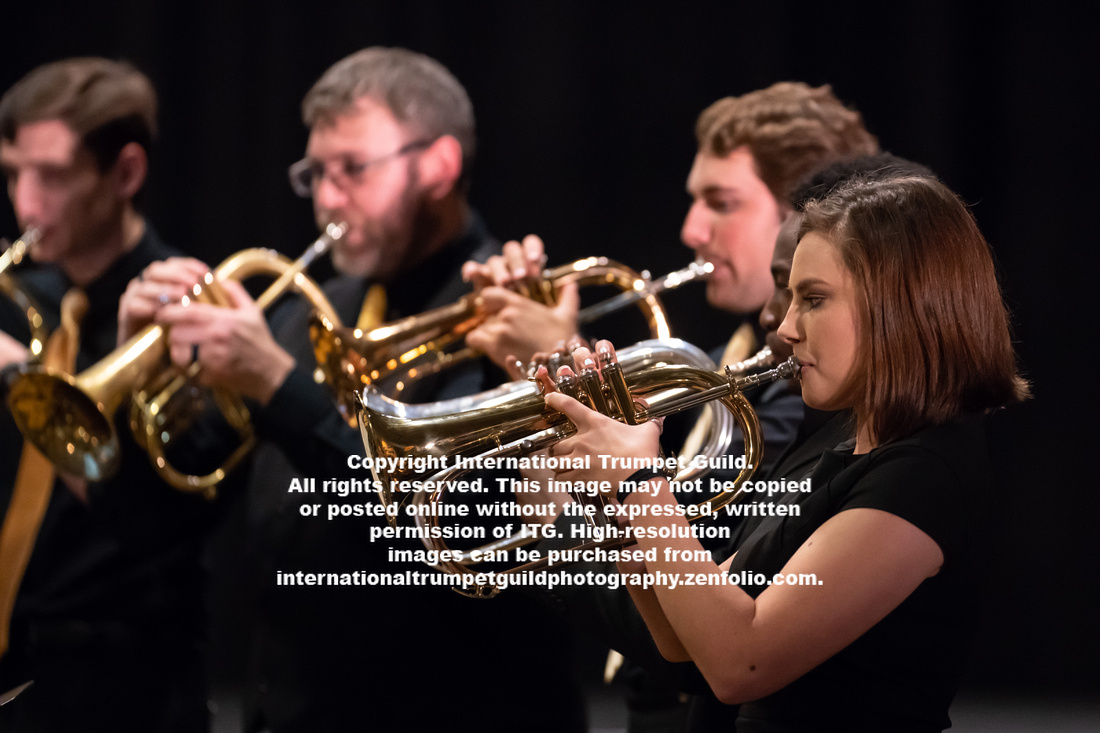 Kennesaw State University Trumpet Ensemble
Kennesaw State University Trumpet Ensemble
Ruslan and Ludmilla Overture by Mikhail Glinka
The Kennesaw State University Trumpet Ensemble performed an arrangement of Mikhail Glinka’s Ruslan und Ludmilla Overture as a prelude to Jose Cháfer Mompó’s recital. The twelve-member ensemble performed with a joyous energy, filling the room with rich sonorities and flowing melodic lines. The dazzling technical passages associated with this thrilling work came off well. What a fun and pleasant way to begin the afternoon’s performance! (AD)
Kunitachi College of Music—Kunion Trio
Taishin Nakaoka, director
Mayu Daijo, Yuya Matsuura, Taishin Nakaoka
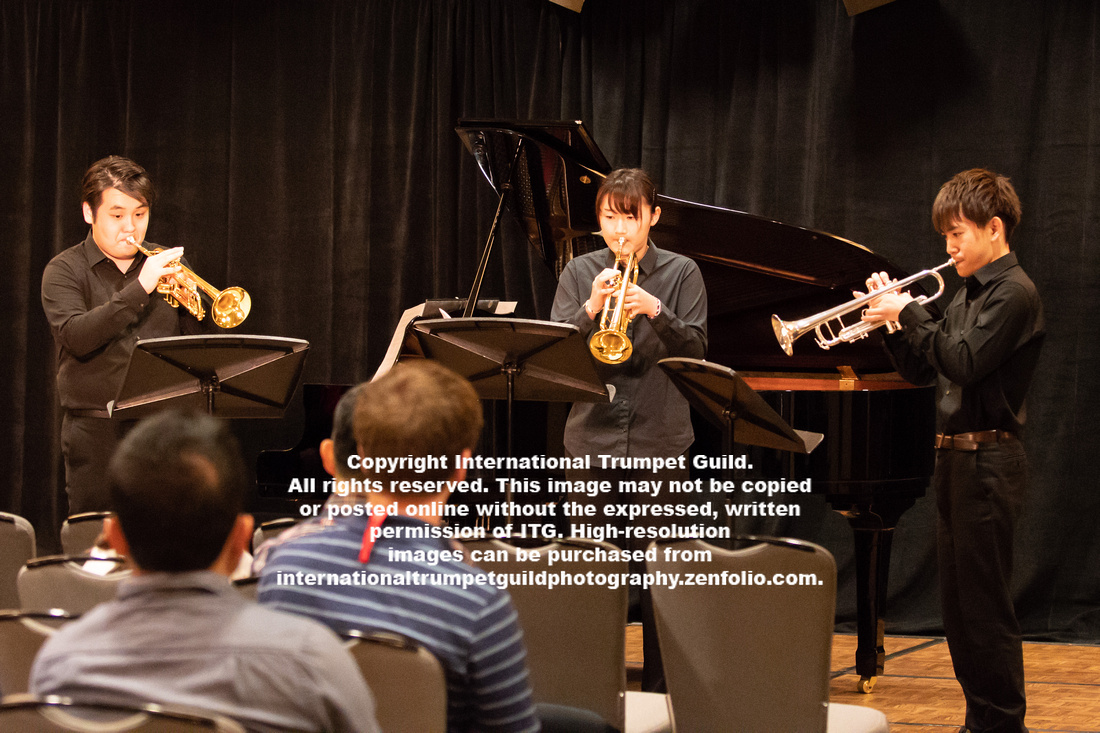 Kunion Trio
Kunion Trio
Gershwin Medley by George Gershwin
The Kunion Trio from Tokyo, Japan, performed before the New Works Recital I in the Rio Grande Ballroom. The medley arrangement of Gershwin favorites included some of his most famous works such as, I Got Rhythm, Summertime, and Rhapsody in Blue, among others. The trumpet trio displayed excellent intonation and tone quality. (SH)
Lamar University Trumpet Ensemble
John Bhatia, director
Hunter Allen, Ty Bodin, Anthony Brown, Dennis Dorion, Nicholas Hernandez, Ricardo Padron, Hannah Sartain, Robert Smith
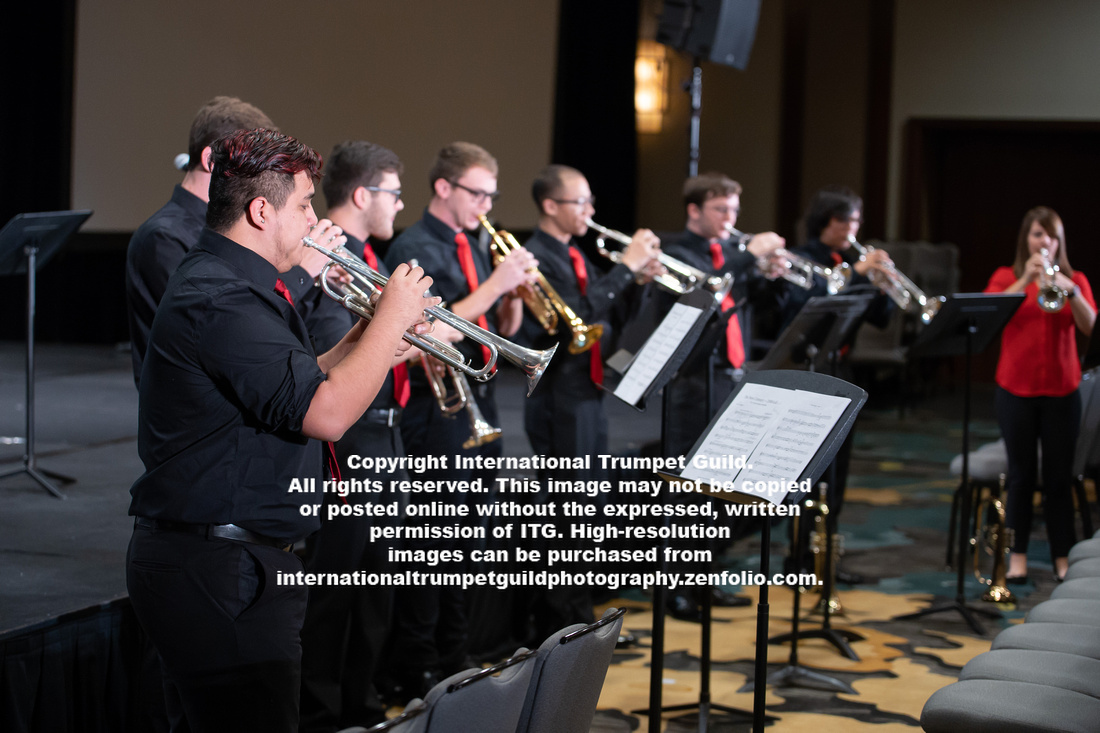 Lamar University Trumpet Ensemble
Lamar University Trumpet Ensemble
Dürrenhorn Passage by Kevin McKee
The New Century - 2000 A.D. by David Uber
The Lamar University Trumpet Ensemble performed two selections before Chris Gekker’s Saturday clinic. David Uber’s The New Century – 2000 A.D. immediately grabbed the audience’s attention with its colorful melodies and rhythmic intensity, and the group handled the many challenging meter changes with ease. Kevin McKee’s Dürrenhorn Passage highlighted the ensemble’s wonderful group sound. Several soloists were featured throughout the performance, highlighting their individual strengths. The audience was transported to another realm through this group’s fine portrayal of McKee’s colorful musical imagery. (BC)
Loyola University Trumpet Ensemble
Nick Volz, director
Michael Bauer, Chris Drennan, Brian Maasen, Peter Nionakis, Jack Wright
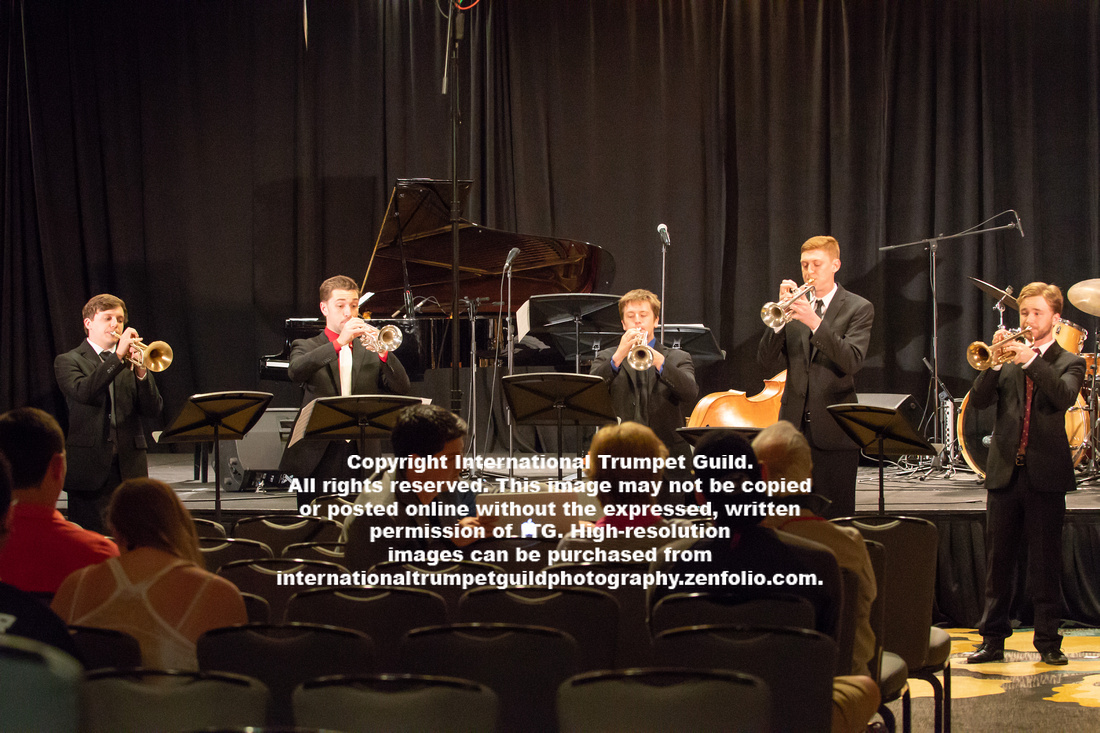 Loyola University of New Orleans Trumpet Ensemble
Loyola University of New Orleans Trumpet Ensemble
Cityscapes by Erik Morales
The Loyola University Trumpet Ensemble, from New Orleans, performed all three movements of Erik Morales’s Cityscapes as a prelude to Jon-Erik Kello’s jazz concert in the Regency Grand Ballroom. The first movement was played with authority, and the group displayed excellent rhythmic precision on the mouthpiece percussion in the third movement. Overall, the performance exhibited tremendous enthusiasm, power, and excitement throughout. (SH)
McMurry University Trumpet Ensemble
David Amlung, director
Jake Lathrop, Karissa Means, Leighanna Meek, Kenny Mostert, Nathan Olsen, Parker Shields, Julian Weigand
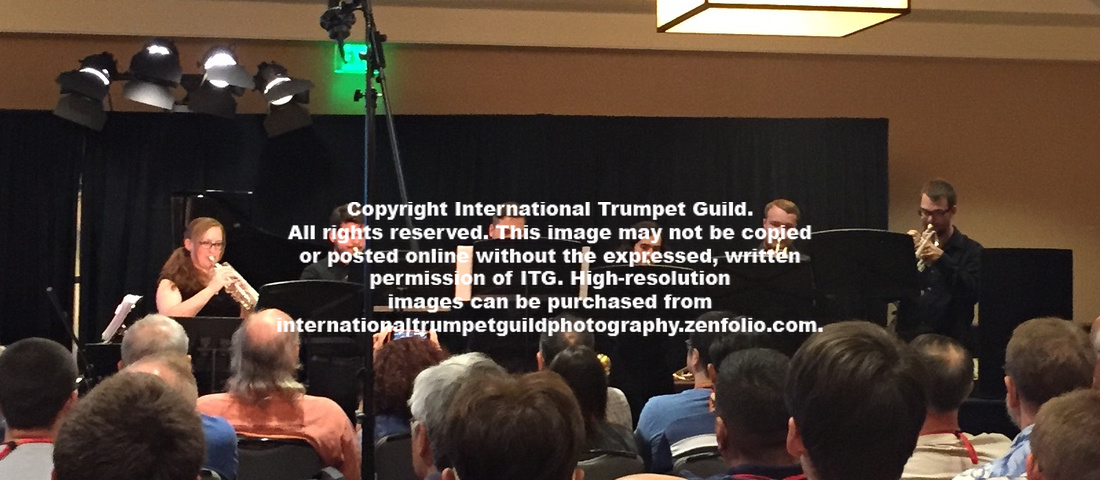 McMurry University Trumpet Ensemble
McMurry University Trumpet Ensemble
Dürrenhorn Passage by Kevin McKee
The McMurry University Trumpet Ensemble, under the direction of David Amlung, performed a brilliant and nuanced version of Kevin McKee’s popular Dürrennhorn Passage. The group displayed excellent dynamic control and ensemble cohesion throughout this technically excellent and musically satisfying performance. (BH)
North Dakota State University Trumpet Ensemble
Jeremy Brekke, director
Isaac Hicks, Maddie Huffman, German Rojas, Anthony Sanders, Brody Terry, Elise Ware
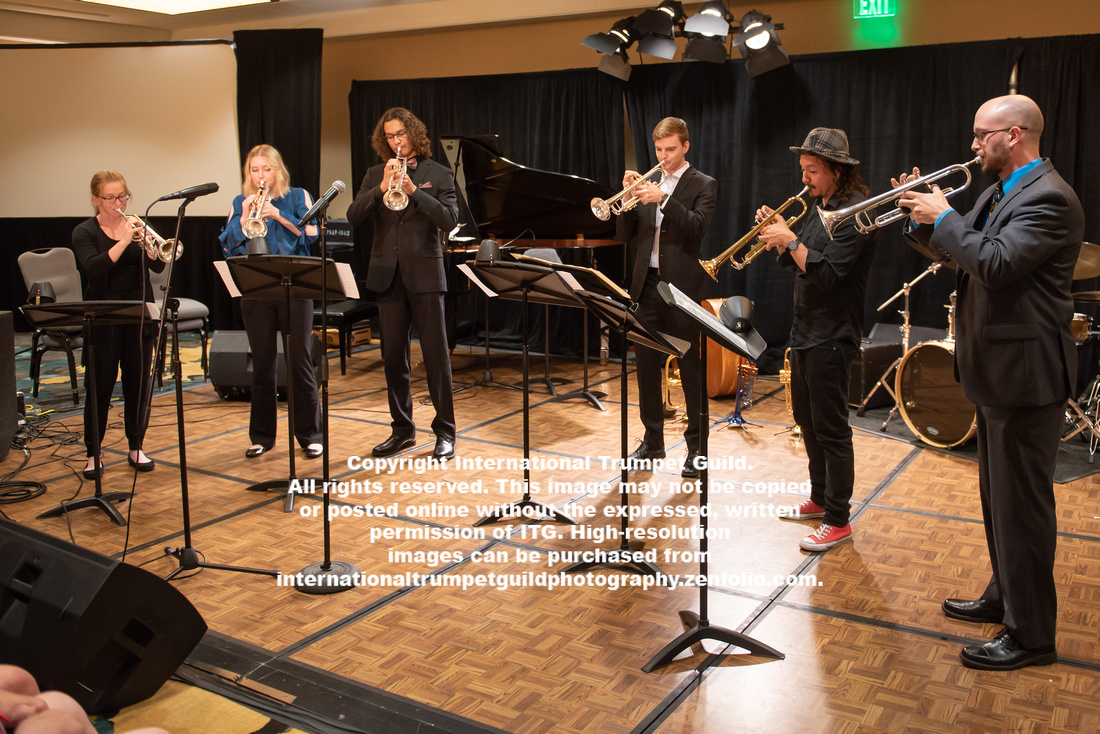 North Dakota State University Trumpet Ensemble
North Dakota State University Trumpet Ensemble
Metallic Fury by Erik Morales
The North Dakota State University Trumpet Ensemble gave an exciting and energetic performance of Erik Morales’s Metallic Fury. The group easily handled the technical demands of the rapid outer sections and played with sensitivity during the muted middle portion of the work. The first trumpet was a highlight of the performance, and the rest of the ensemble responded with ample support and bravado. (BH)
Northern Arizona University Trumpet Ensemble
Stephen Dunn, director
Heaven Bataille, Holley Biringer, Willem Blakely, Phillip George, Darian Harmon, Micah Laird, Hunter Prather, Chandler Zimmerman, Cheyanne Read, Hank Stevens
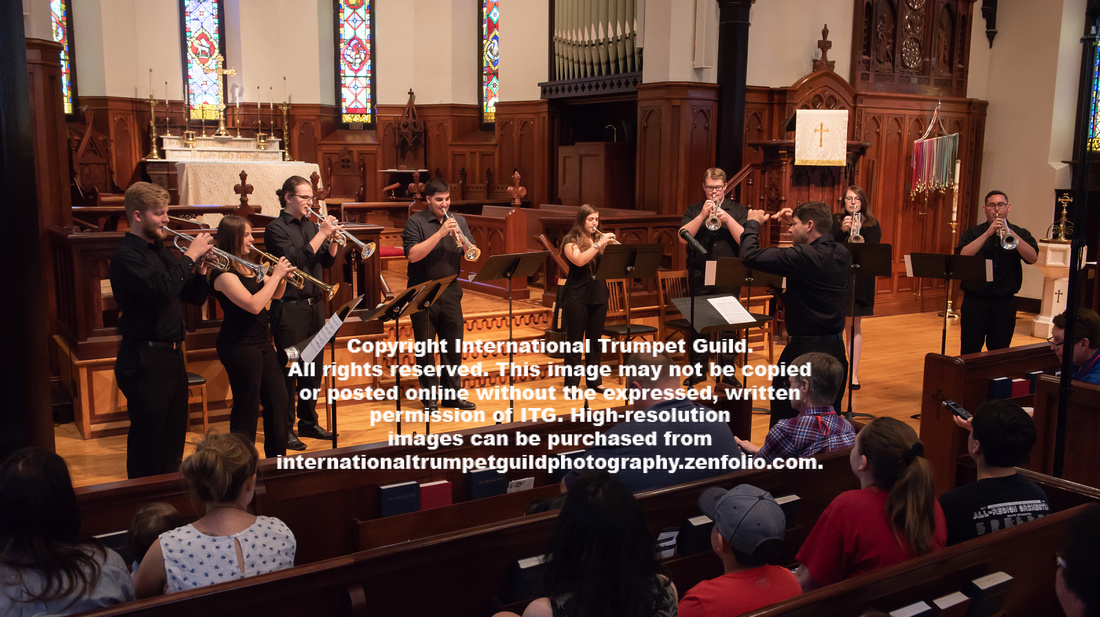 Northern Arizona University Trumpet Ensemble
Northern Arizona University Trumpet Ensemble
Suspended in Flight by Stephen Dunn
The Northern Arizona University Trumpet Ensemble, under the direction of Stephen Dunn, performed an original composition by their director, entitled Suspended in Flight. The performance space served this piece well, allowing chords and musical passages to overlap and melt together throughout the performance. Suspended in Flight featured the ensemble’s technique and enjoyable sound and served as a great example of ensemble blend and intonation. (WK)
Oklahoma City University Trumpet Ensemble
Michael Anderson, director
Josh Dolney, Nathan Hasterlik, Austin Hogue, Sam Key, Kristen Layne, Sierra Stan, Daniel Vittum
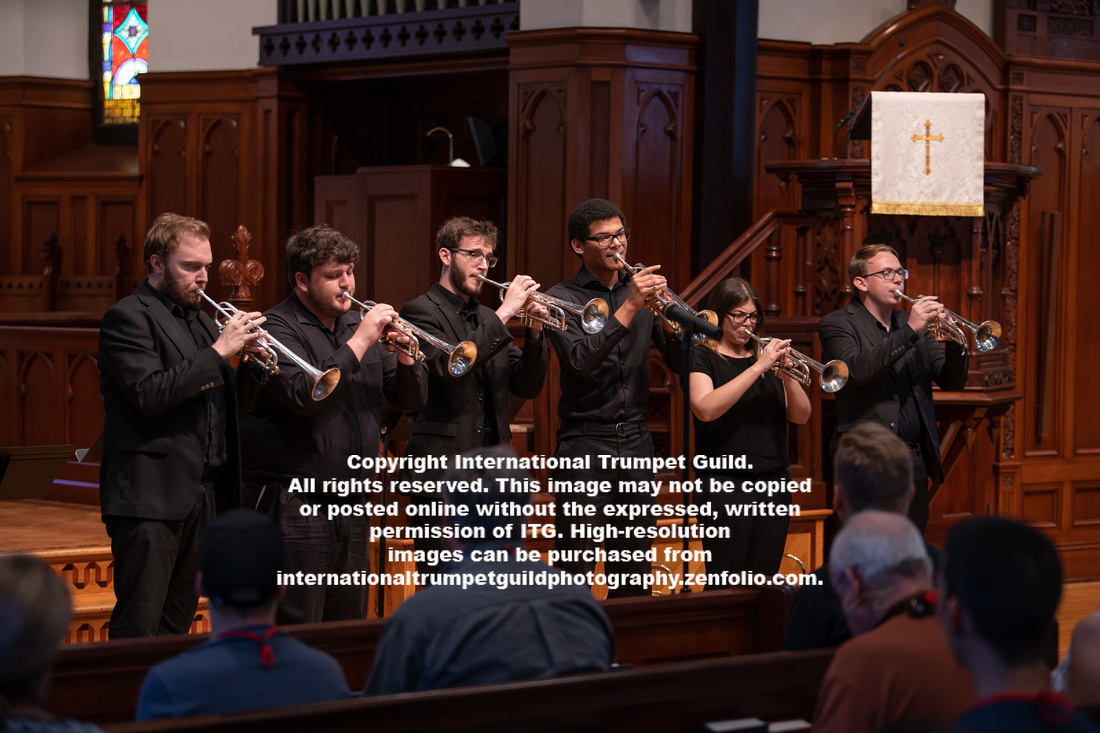 Oklahoma City University Trumpet Ensemble
Oklahoma City University Trumpet Ensemble
Cityscapes by Erik Morales
Under the direction of Michael Anderson, the trumpet ensemble from Oklahoma City University performed Erik Morales’s Cityscapes, which has become a staple in the modern trumpet ensemble repertoire. The ensemble showcased their tonal and musical blend throughout the exciting and facile performance, making this a wonderful introduction to Tromba Mundi’s concert. (WK)
Oklahoma State University—Black Trumpet Ensemble
Ryan Gardner, director
Clayton Chai, Caleb Dixon, Gabe Mejia, Brenden Noblitt, Christian Thorp, Zach Morris
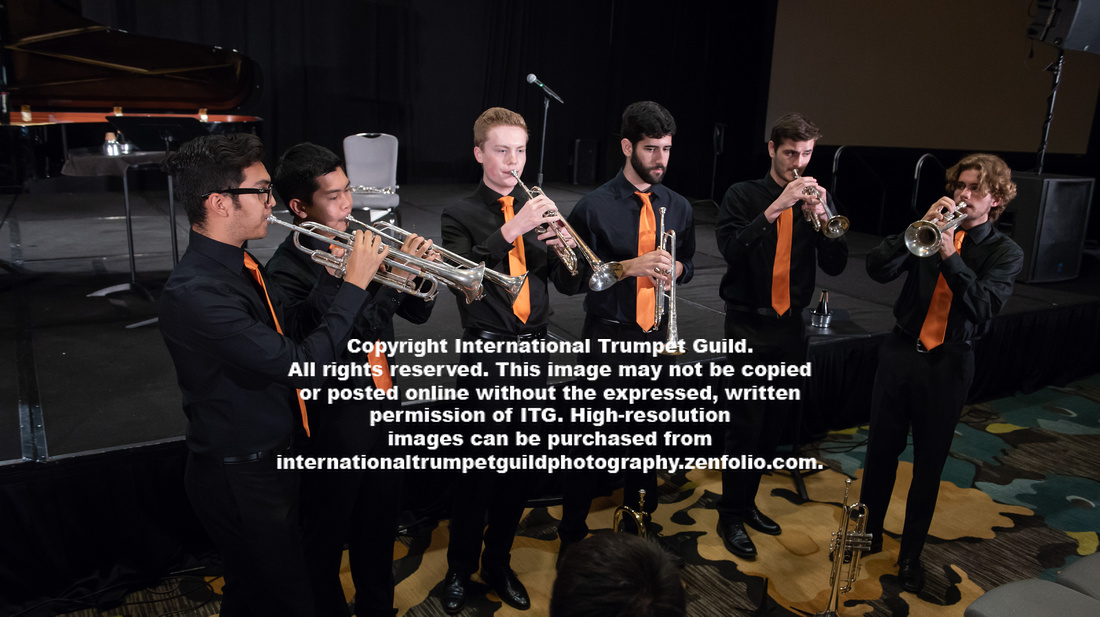 Oklahoma State University Black Trumpet Ensemble
Oklahoma State University Black Trumpet Ensemble
Carmen Suite by Georges Bizet, arr. Ben Miles
A sextet from Oklahoma State University opened Saturday morning’s recital with an arrangement of popular themes from Bizet’s much-beloved opera, Carmen. The ensemble gave quite the communicative and musical performance, infusing charm and personality into an already lively piece of music. Performing with direction, expression, imagination, and poise, the young trumpeters created an engaging and intimate atmosphere for audience members to enjoy these familiar themes. (AD)
Oklahoma State University—Orange Trumpet Ensemble
Ryan Gardner, director
Matt Daigle, Caden Homes, Kevin Kamau, Noah Mennenga, Daniel Montalvo, Ian Mertes, Nick Nusser, Steffi Tetzloff
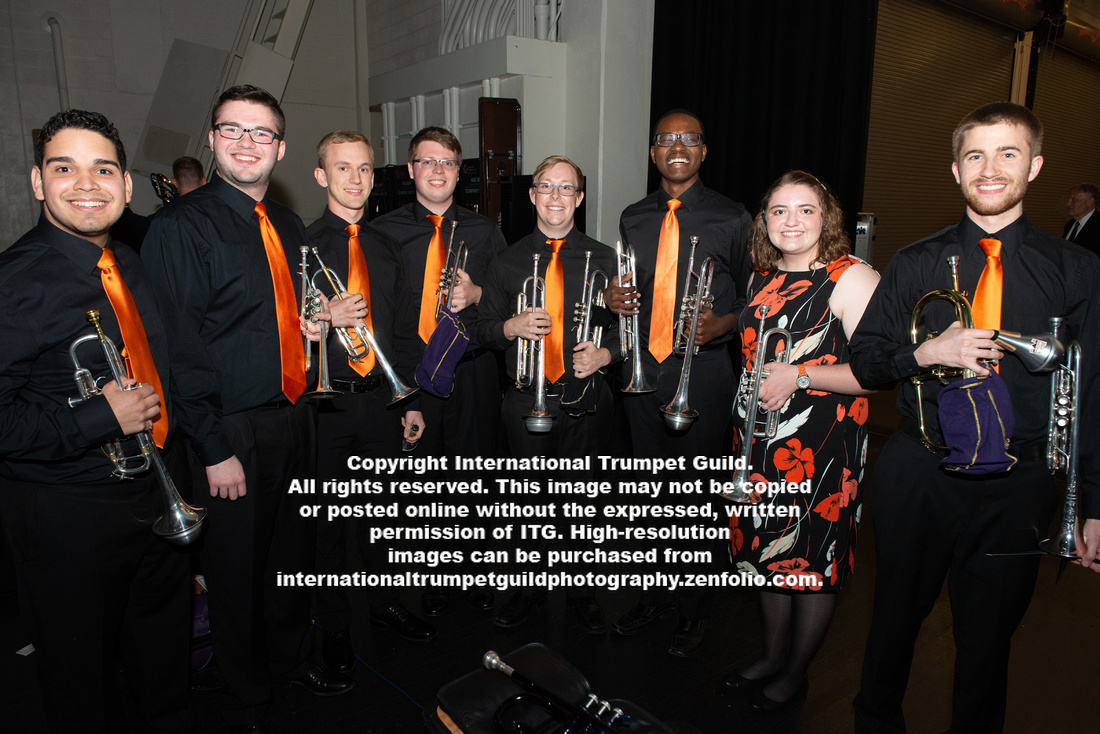 Oklahoma State University—Orange Trumpet Ensemble
Oklahoma State University—Orange Trumpet Ensemble
Rite of Spring by Igor Stravinsky, arr. Ryan Gardner
The Oklahoma State University Orange Trumpet Ensemble performed Ryan Gardner’s masterful arrangement of highlights from Igor Stravinsky’s ballet The Rite of Spring. Playing from memory without a conductor, the eight trumpeters performed with passion and precision. Gardner’s arrangement, scored for trumpets in B-flat and C, as well as flugelhorn and piccolo trumpet, captured the essence of the full orchestral version with remarkable flair. (EK)
Portland State University Trumpet Ensemble
David W. Bamonte and Steven C. Conrow, directors
Katie Craighead, Erick Escobaar, Danny Fineman, Evan MacWilliams, Jeremy Morrison, Dean Oaks, Bailey Paugh, Alex Schmidt, Collin Stegner
 Portland State University Trumpet Ensemble
Portland State University Trumpet Ensemble
* Convergence by Sean O’Loughin
Cocktail by Jerome Naulais
Los Angeles-based composer Sean O’Loughin’s Convergence showcased the ensemble’s brilliant sound and flawless balance throughout all parts. This work was specifically commissioned for the PSU Trumpet Ensemble’s ITG performance. Next, a smaller quintet from the ensemble presented Jerome Naulais’s Cocktail. The three-movement work showcased the individual players with effective short solos interspersed through the ensemble with quick flourishes in the final movement. (LE)
Stephen F. Austin State University—Empyrean Trumpet Ensemble
Jacob Walburn, director
Arjang Abrarpour, Daniel Casso, Max Mucino, Adiel Najera, Bethany Terral, Travis Wattigney
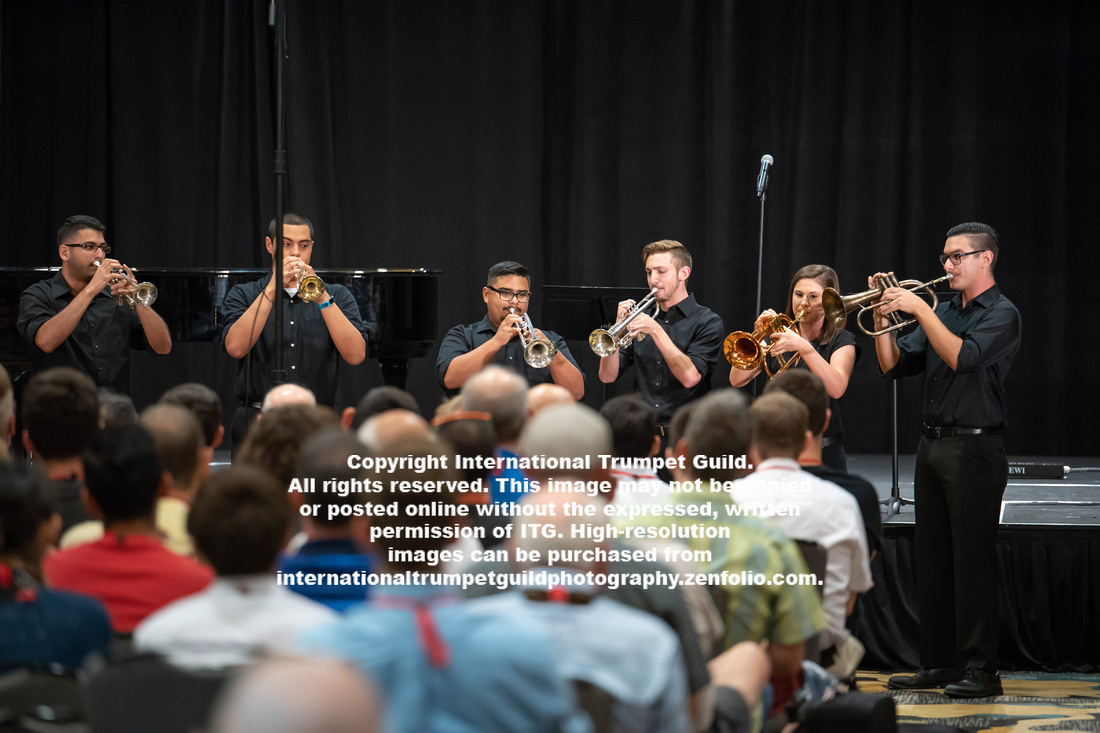 Stephen F. Austin University Empyrean Trumpet Ensemble
Stephen F. Austin University Empyrean Trumpet Ensemble
Overture from Ruslan and Ludmilla by Mikhail Glinka, arr. Erik Morales
The Empyrean Trumpet Ensemble from Stephen F. Austin State University performed an exciting rendition of Mikhail Glinka’s Overture from Ruslan and Ludmilla, arranged by Erik Morales. The group played the entire arrangement from memory, matching shared lyrical lines and trading difficult technical passages between piccolo trumpets, B-flat trumpets, and flugelhorns. The ensemble’s expressive performance wowed the audience, who gave the group several rounds of applause. (MY)
Tarleton State University Trumpet Ensemble
Brian Walker, director
Matt Edwards, David Flores, Tember Lowe, Danny Norton, Akira Okamoto, Jenna Parrish, Kenny Reid, Audrey Smith, Taylor Welch, Tim Wilson
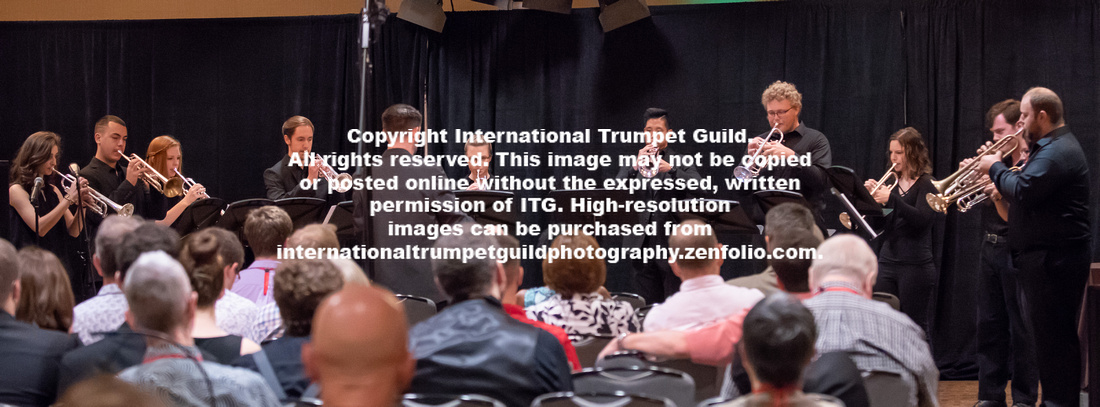 Tarleton State University Trumpet Ensemble
Tarleton State University Trumpet Ensemble
Infinite Ascent
by Erik Morales
The Tarleton State University Trumpet Ensemble, under the direction of Brian Walker, played an impressive rendition of Erik Morales’s Infinite Ascent. The ensemble deftly navigated the numerous flourishes for which Morales’s writing is known while maintaining a sense of ensemble continuity. The attention to dynamic detail helped carry the performance and serve as an elevating opener for the New Works Recital. (KM)
Texas A&M University-Corpus Christi Trumpet Ensemble
Mary Thornton, director
Clayton Capello, Madison Gotcher, Dustin Hernandez, Joe Holland, James Tomerlin, Juan Vargas, III
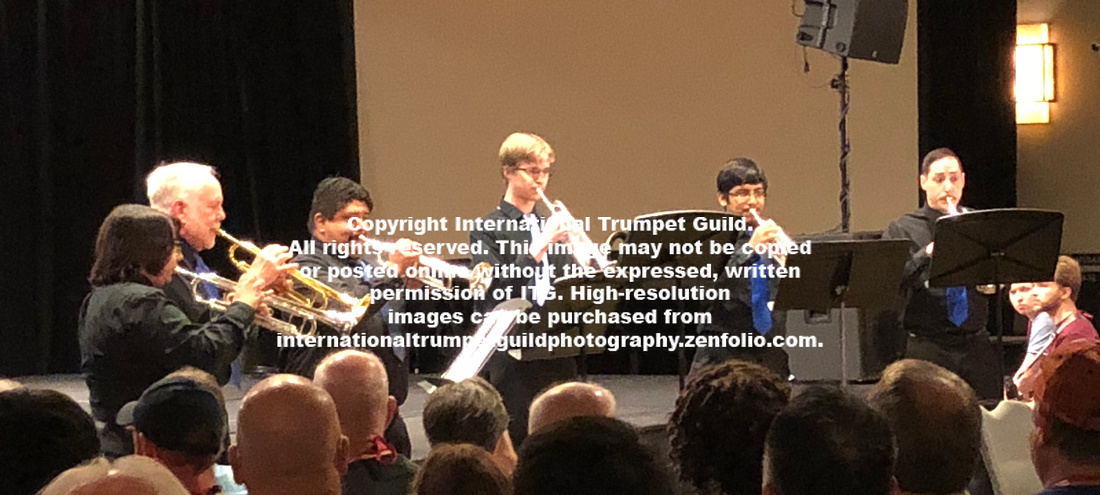 Texas A&M University-Corpus Christi Trumpet Ensemble
Texas A&M University-Corpus Christi Trumpet Ensemble
An Olcott Overture! by Eric Ewazen
Cityscapes by Erik Morales
The TAMUCC Trumpet Ensemble set a festive tone for the Spanish Brass concert with a fine performance of An Olcott Overture! by Eric Ewazen and Cityscapes by Erik Morales. Their performance of the Ewazen was marked by bracing rhythms and dramatic phrasing, while the Morales showcased sensitive lyrical phrasing, a warm sound, and secure technique. (EK)
Texas A&M University-Kingsville Trumpet Ensemble
Kyle Millsap, director
Christian Chavez, Carolina De La Rosa, Jesus Espinoza, Ramon Garcia, Isaac Garza, Kat Garza, Javier Salinas, Seth Saucedo, Lance Woody, Ariana Gomez
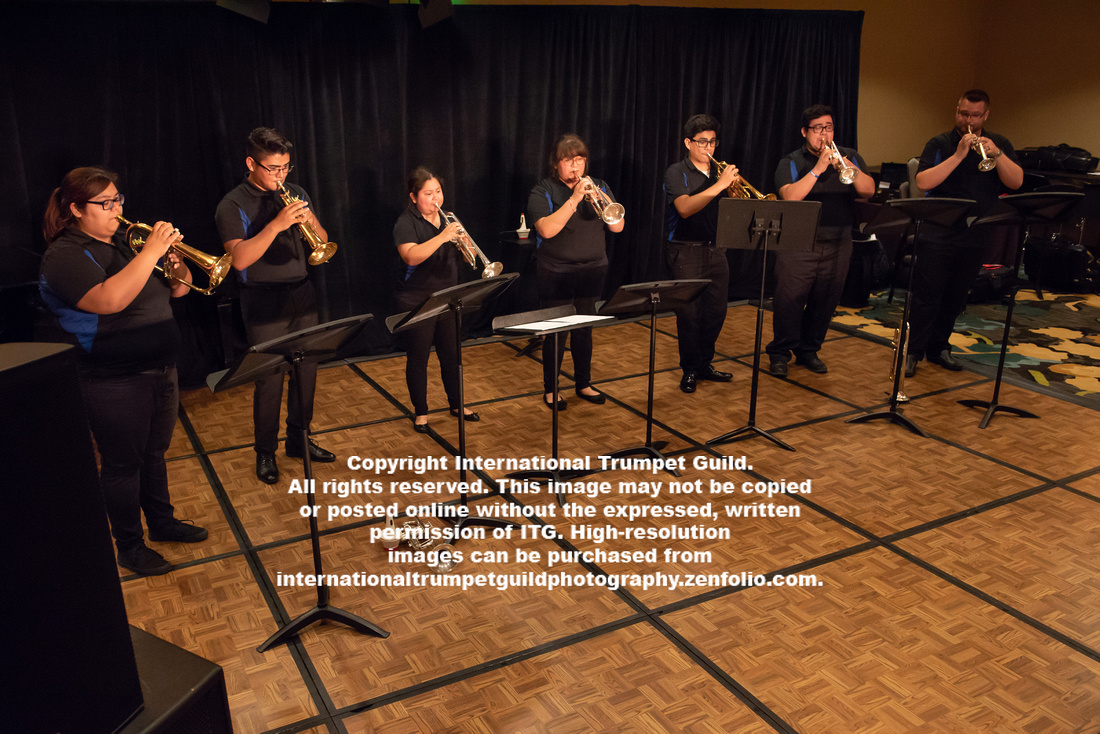 Texas A&M University-Kingsville Trumpet Ensemble
Texas A&M University-Kingsville Trumpet Ensemble
“Le Chocolat” from The Nutcracker by Pyotr Ilyich Tchaikovsky, arr. Kyle Millsap
Divertimento in Blue by Erik Morales
The Texas A&M University-Kingsville Trumpet Ensemble displayed a high level of musical maturity with their combination of improvised solos and balanced ensemble playing. The group presented an entertaining performance while providing an excellent introduction for the program that followed. (JBr)
Texas Christian University Trumpet Ensemble
Jesse Rajabi, director
Sebastian Alvarez, Andrea Aviles, Luis Pulido, Alex Dumas, Johnathan Hunda, Trey Isenberg, Katie Kelly, Zack Lewis, Joseph McGee, Ethan Moreno, Issac Ortiz, Pedro Peraza
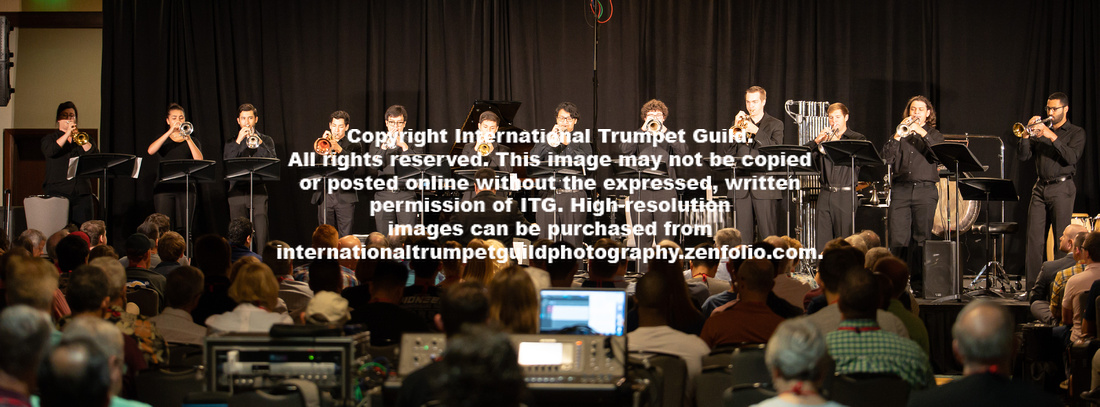 Texas Christian University Trumpet Ensemble
Texas Christian University Trumpet Ensemble
Pasodoble by Gerald Gable
A pasodoble is a Spanish dance imitating a bullfight, and this piece effectively depicts that exciting scene with idiomatic gestures and flourishes. The energy ebbs and flows throughout with contrast in textures and colors (including flugelhorns and mutes). The TCU Trumpet Ensemble produced a rich tone, especially in the forte sections, and displayed great poise in performing for such a large audience. (AK)
Texas Tech University—Studio 105
Andrew Stetson, director
Samuel Acosta, Jessica Calvit, Shania Cordoba, Jacob Diewald, Pierce Ellison, Mylon Johnson, Will Miller, Nate Moe, Austin Spencer, Marc Sutton
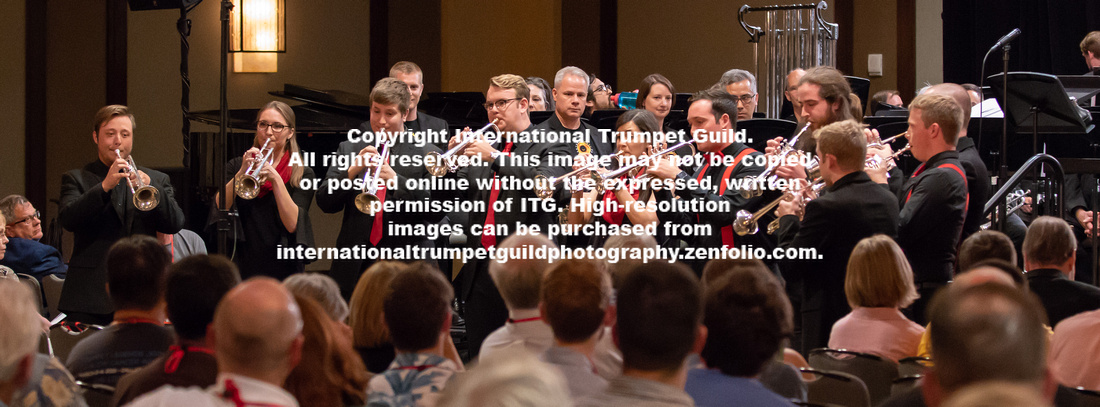 Texas Tech Studio 105
Texas Tech Studio 105
“Jupiter” from The Planets by Gustav Holst, arr. Andrew Stetson
The Texas Tech University “Studio 105” Trumpet Ensemble, directed by Andrew Stetson, performed Stetson’s arrangement of “Jupiter” from The Planets. The ten-member ensemble played with great enthusiasm the arrangement that featured instrumentation from piccolo trumpet to flugelhorn and effectively utilized an array of mutes. (KE)
Texas Tech University Trumpet Ensemble
Andrew J. Stetson and Robert Luther, directors
Brock Alsaffar, Aaron Amaya, Jonathan Fortson, Clark Preston, Rachel Perkins, Nicholas Tharp, Blake Wells
 Texas Tech University Trumpet Ensemble
Texas Tech University Trumpet Ensemble
Quickening by Robert Luther
Opening with running sixteenth notes, Robert Luther’s Quickening quickly adds a second texture: angular eighth notes with a melody superimposed. Eventually, this develops to several chorale and other sections. Following are several sections, including one with Latin inspiration, both in the accompanimental rhythms and occasional sizzling melodic lines. The Texas Tech University Trumpet Ensemble delivered a superb and very memorable performance of this excellent new work. (LE)
Timber Creek High School Trumpet Septet
Danny Brock, director
Austin Bell, Brendan Chucci, Brendan Lorenz, Tanner Price, Gage Reynolds, Nathan Smith, Jacob Thomas
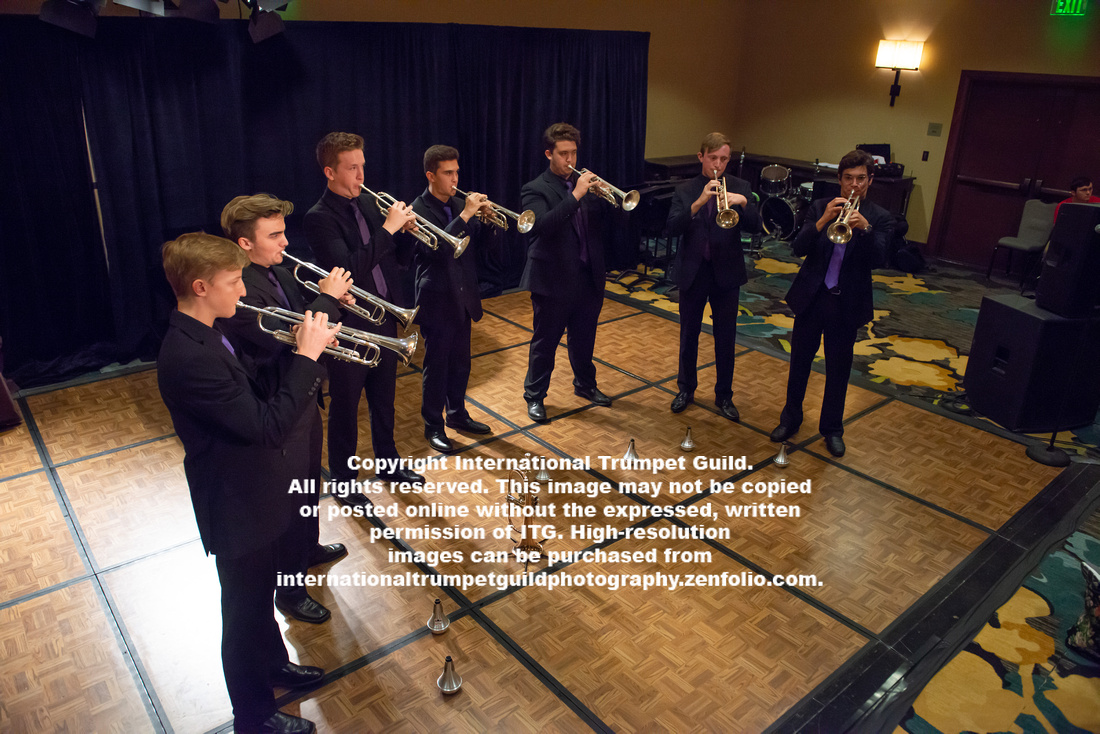 Timber Creek High School Trumpet Septet
Timber Creek High School Trumpet Septet
Seven Tapas by David Gillingham
The Timber Creek Trumpet Septet’s prelude performance was a perfect introduction to the ITG Affiliate Chapters Recital. The ensemble’s playing was exceptional as they executed David Gillingham’s work, Seven Tapas, with an exciting musical energy and a strong, full sound while showing off impressive technical abilities. (SW)
Triumvirate Brass Trio
Vernon Richter, trumpet; Megan DeRubeis, horn; Amanda Kana, trombone
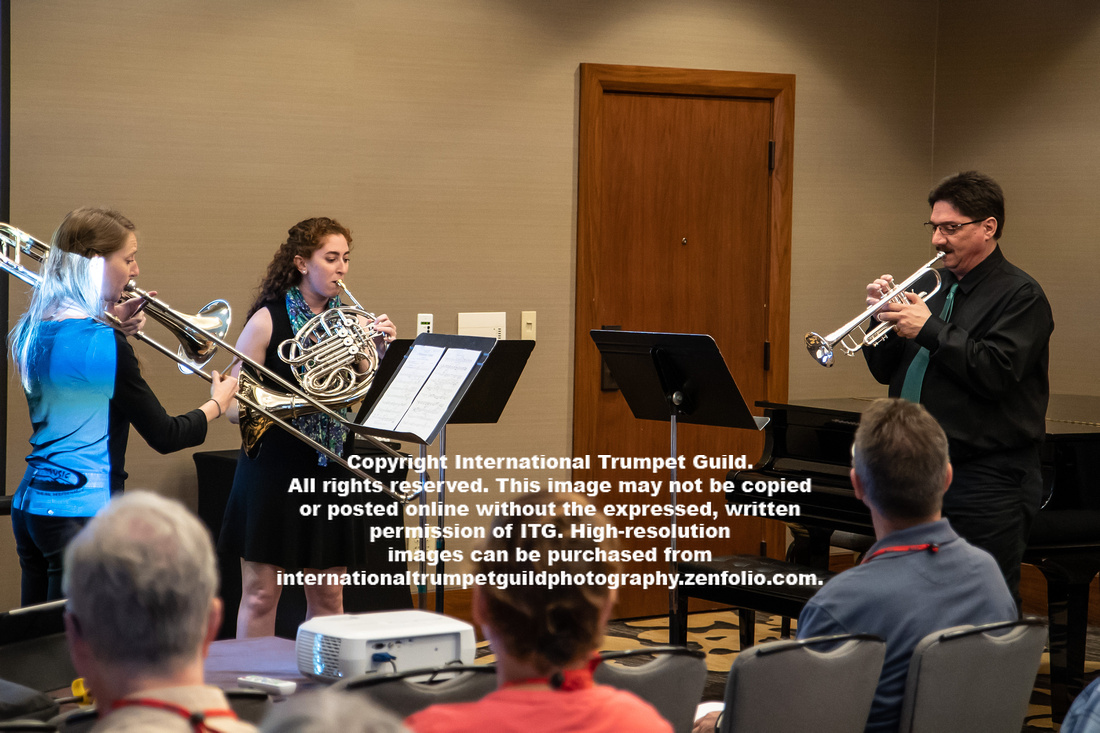 Triumvirate Brass Trio
Triumvirate Brass Trio
A Philharmonic Fanfare by Eric Ewazen
The Triumverate Brass Trio performed A Philharmonic Fanfare by Eric Ewazen, a work that featured all three players on flowing fanfare figures. The piece gave each of the players ample opportunity to show off their flexibility and musicality in juxtaposition with syncopated figures, and the trio did not disappoint, navigating these phrases with great ease while exhibiting expert balance and musical subtlety. (AJ)
University of British Columbia Trumpet Ensemble
Larry Knopp, director
Shira Agam, Erica Binder, Matheus Moraes, Dasa Silhova, Willy Wang
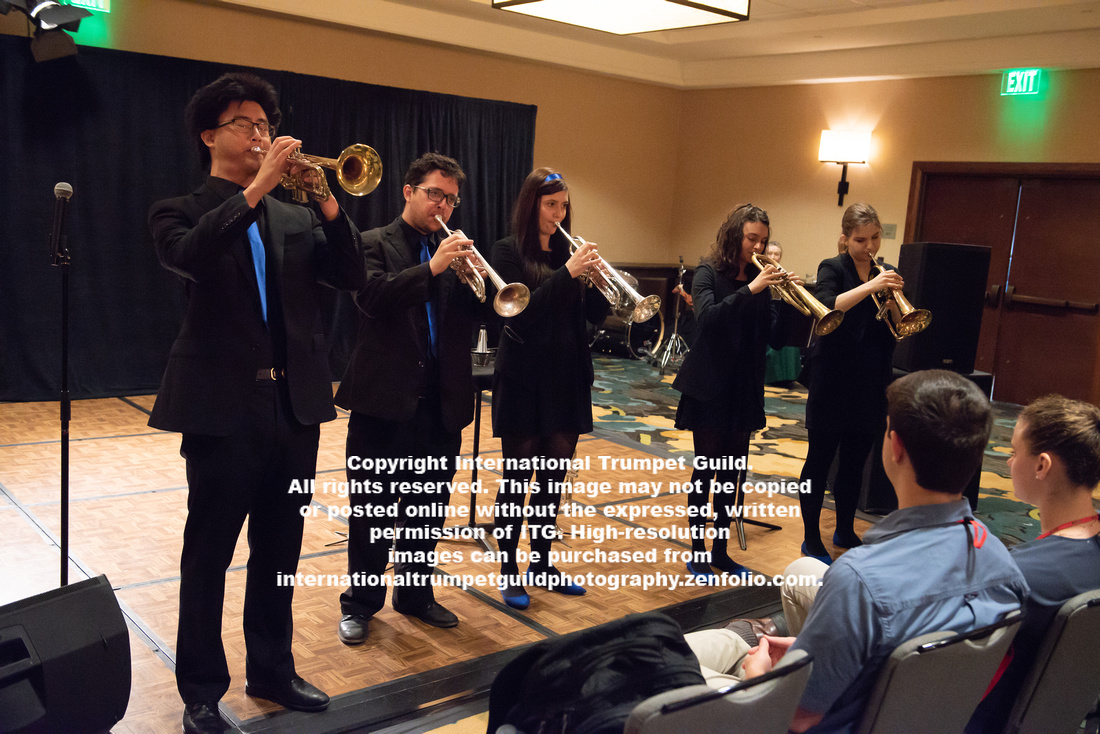 University of British Columbia Trumpet Ensemble
University of British Columbia Trumpet Ensemble
Suo Gan: A Welsh Lullaby, arr. Josh Sung
Overture to William Tell by Rossini, arr. David Marlatt
The University of British Columbia Trumpet Ensemble performed two pieces for their prelude. They played Josh Sung’s beautiful arrangement of Suo Gan with two flugelhorns and three trumpets in a beautiful, warm blend. Rossini’s Overture to William Tell began with the traditional English horn solo performed on a rotary-valve flugelhorn before a brilliant C trumpet sounded the familiar call, leading to the galloping finale. The group played with excellent intonation and fine phrasing throughout. (EK)
University of Idaho Trumpet Ensemble
Sean Butterfield, director
Darrick Blood, Jared Crider, Jose Cruz, Mitch Gibbs, Garrett Romero, Zach Sherlock, Keanna Stokes
 University of Idaho Trumpet Ensemble
University of Idaho Trumpet Ensemble
Canterbury Flourish by Gordon Jacob
Three Miniatures by Clint Needham
The University of Idaho Trumpet Ensemble, directed by Sean Butterfield, performed two selections before Philippe Litzler’s recital. The first, Gordon Jacob’s Canterbury Flourish, highlighted the group’s ensemble sound. The second piece, Clint Needham’s Three Miniatures, had the audience delighted as they performed in a multitude of styles, including a lovely and sonorous second movement. (BC)
University of Iowa Trumpet Ensemble
Amy Schendel, director
Joseph Arch, Evan Fowler, Kenken Gorder, Joey Schnoebelen, Kamal Talukder
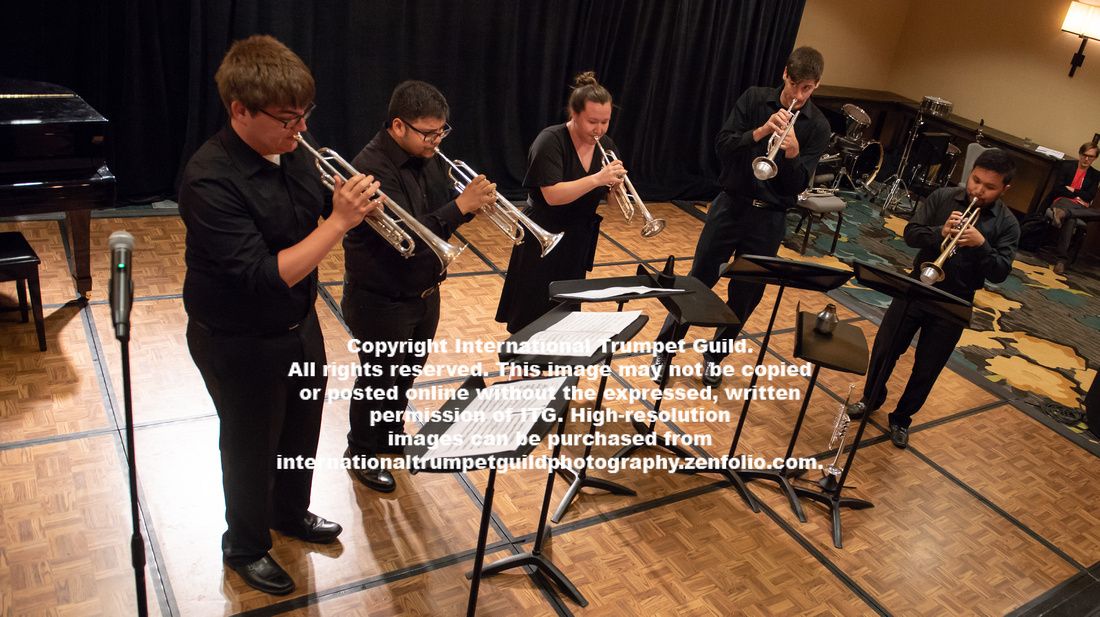 University of Iowa Trumpet Ensemble
University of Iowa Trumpet Ensemble
Idea Number Twenty-Four by Terry Everson
Everson’s fun piece is based on Paganini’s Caprice in A Minor, Op. 1, No. 24. The University of Iowa Trumpet Ensemble handled the variety of styles and challenges extremely well with beautiful blend and impressive technique. There was strong piccolo playing and confident solos throughout the ensemble. (AK)
University of Lethbridge Trumpet Ensemble
Josh Davies, director
Sam Broadbent, Jill Burke, Laura Ferguson, Max Gunther, Eileen Humble, Claire McMahon, Rex Mulder, Aaron Ryan
 University of Lethbridge Trumpet Ensemble
University of Lethbridge Trumpet Ensemble
Poet and Peasant Overture by Franz von Suppé
The U of L Trumpet Ensemble, directed by Josh Davies, performed an arrangement of Poet and Peasant Overture by Franz von Suppé before the M5 Mexican Brass Quintet Youth Day Concert. Their arrangement delighted the audience with its flashy style and rich harmonic colors. The audience was also treated to several wonderfully performed solos that highlighted the many contrasting styles of the piece. (BC)
University of Redlands Trumpet Ensemble
David L. Scott, director
Jorge Araujo-Felix, Jake Ferntheil, Matthew Ingelson, Andrew Priester, Francisco Razo, Katrina Smith
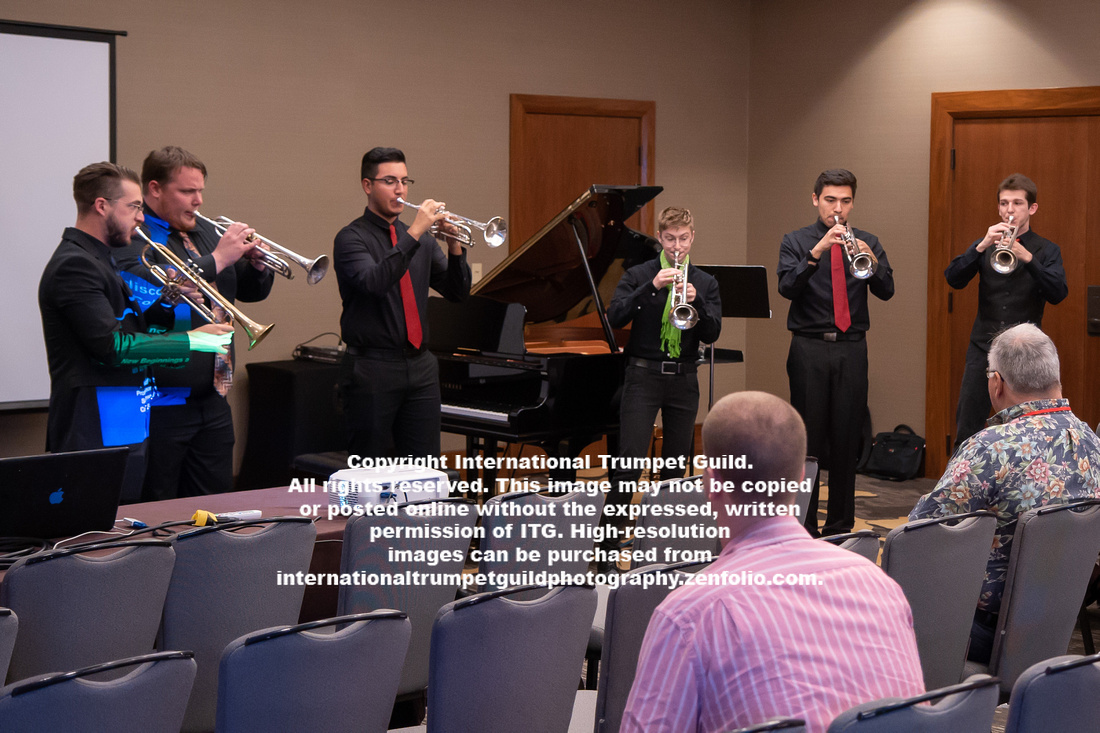 University of Redlands Trumpet Ensemble
University of Redlands Trumpet Ensemble
Dürrenhorn Passage by Kevin McKee
The University of Redlands Trumpet Ensemble presented a thrilling rendition of Kevin McKee’s Dürrenhorn Passage. From the opening statement to the final notes, the ensemble presented fantastic control and versatility. A true highlight came from the ensemble’s ability to show extreme musicality and variations of timbre throughout the work. The ensemble showed great maturity of expression in the passing of musical lines and dramatic timbral changes throughout the piece. Their command of the stage provided a wonderful highlight and introduction to the event. (JPS)
University of Texas at El Paso—UTEP Blue
Nancy Taylor, director
Annie Aguilar, Robert Campos, Arturo Olivo, Alejandro Perez, Gabby Tellez, Caleb Tullius
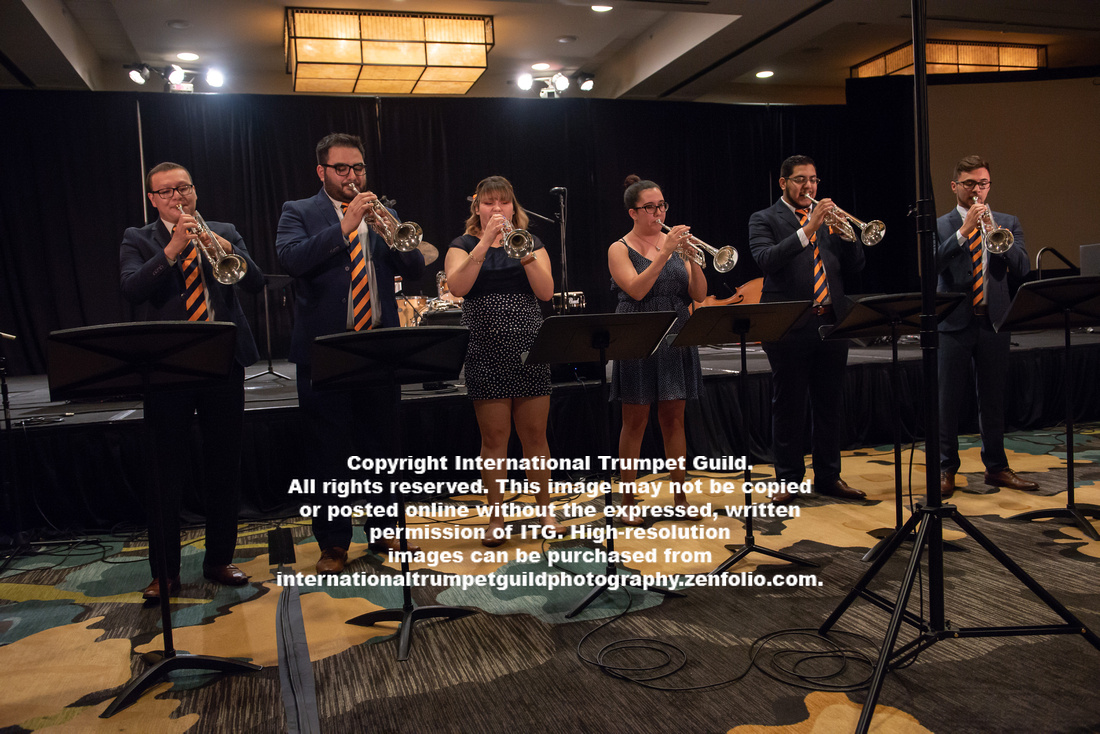 UTEP Blue
UTEP Blue
Suite for Six Trumpets by Dennis L. Horton
The ensemble began this piece with a rousing antiphonal fanfare that they executed with vigor and precision. The piece offered many varied dynamic shadings and textures, of which the performers took advantage superbly. A rousing climax ended the outstanding and energized performance. (NM)
University of Texas at El Paso—UTEP Prophets
Nancy Taylor, director
Jacob Aun, Elijah Ontiveros, Juan Pablo Palacios, Isaac Ponce, Paul Reid
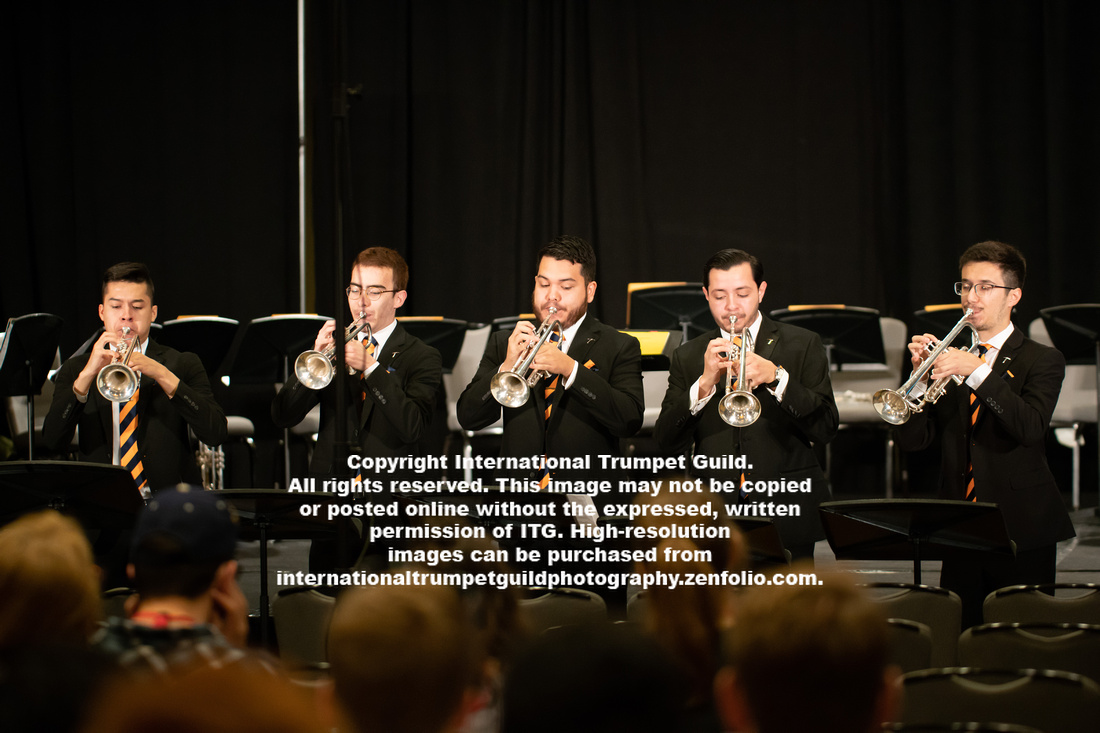 UTEP Prophets
UTEP Prophets
Voice of the Prophets by Eddie Lewis
The five members of the UTEP Prophets from the University of Texas at El Paso gave an energetic and compelling performance of Eddie Lewis’s Voice of the Prophets. Featuring propulsive rhythmic ostinatos, punctuated by percussive accents, the work also showcased the group’s tight ensemble playing and warm sound. (EK)
Utah State University Trumpet Ensemble
Max Matzen, director
Amy Abel, Jose Ayala, Bridger Bush, Sam Dickson, Stephanie England, Marci Johnson
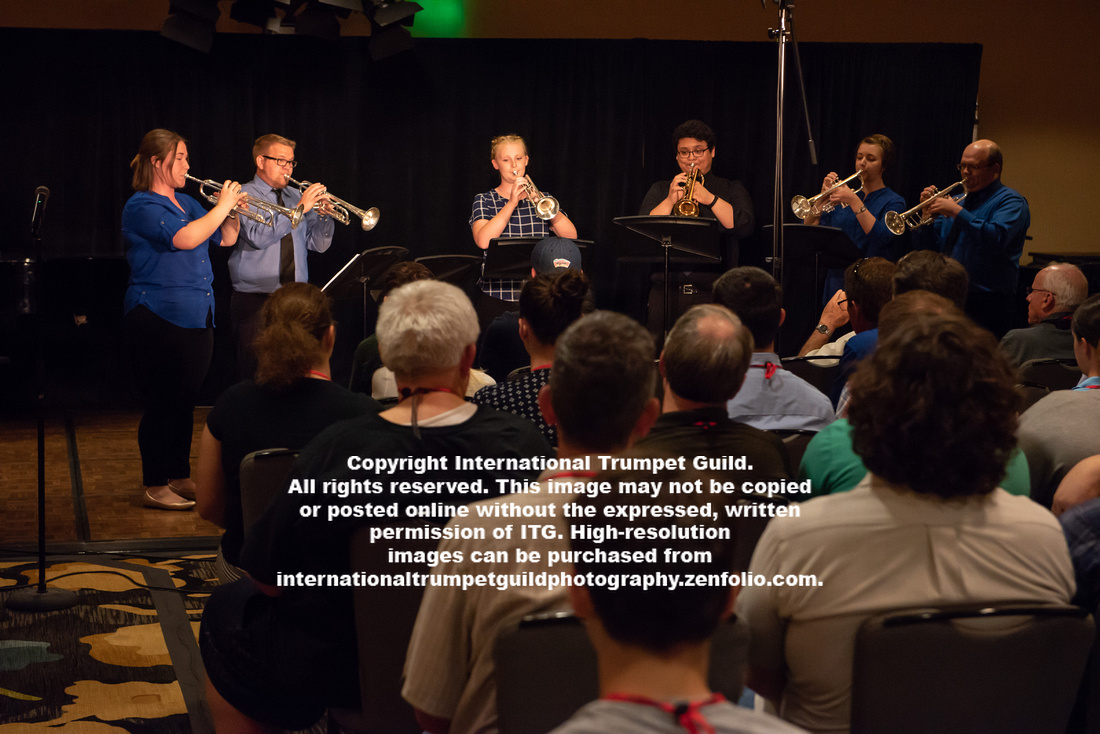 Utah State University Trumpet Ensemble
Utah State University Trumpet Ensemble
Music for Five Trumpets by Wesley Nance
The Utah State University Trumpet Ensemble presented an energetic performance of the first and third movements of Wesley Nance’s Music for Five Trumpets in the Rio Grande Ballroom. The ensemble presented an excellent display of musicality and balance throughout the work. The performance was well received by the audience and served as the perfect introduction to the program that followed. (JBr)
West Texas A&M University Trumpet Ensemble
William Takacs, director
Alex Collins, Marcos Garcia, Austin Nakamoto, Aaron Olson, Jacob Sexton, Joaquin Sotelo, Ashton Young
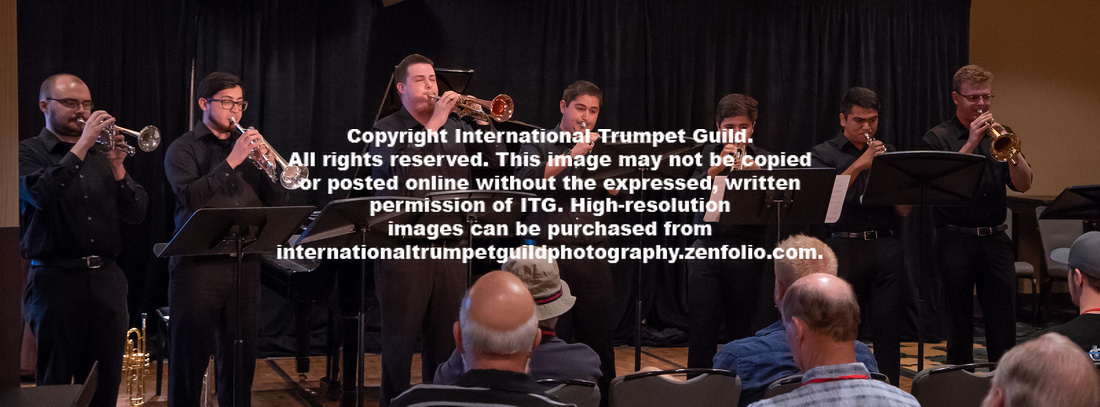 West Texas A&M University Trumpet Ensemble
West Texas A&M University Trumpet Ensemble
The Wild Atlantic Way by Benjamin Brooks
The West Texas A&M University Trumpet Ensemble gave an impressive performance of The Wild Atlantic Way by Benjamin Brooks. Trumpeters handled the many changes of timbre and style confidently, from beautiful, lyrical flugelhorn lines to ringing piccolo trumpet figures. Tight rhythmic motives were tossed back and forth with precision, contrasting nicely with melodic sections and showcasing well the skills of the ensemble. (LAH)
Click here for more prelude ensemble photos
]]>
Coordinator: Jennifer Dearden
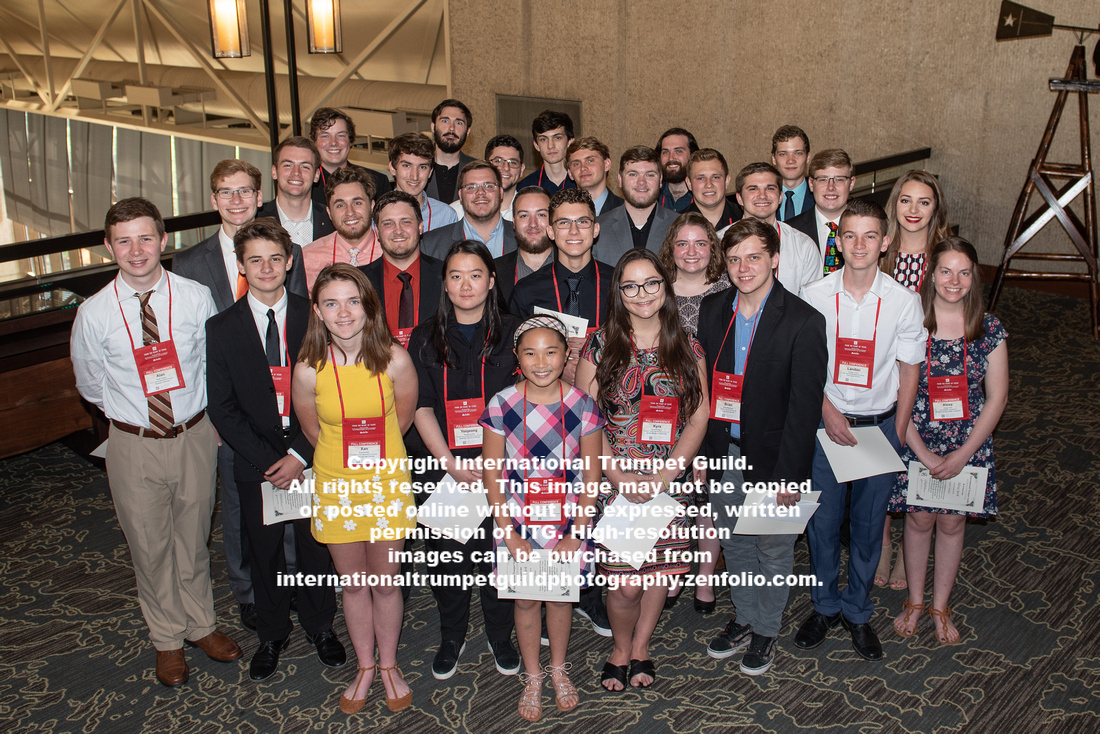 Conference Scholarship winners
Conference Scholarship winners
Under-16 Division
The Charles Schlueter Foundation Scholarship
Jeremy Bryant, University High School
Teacher: Betsy Bright Morgan
Donor: The Charles Schlueter Foundation, Inc.
Bryan and Nancy Goff Scholarship
James McAffrey, Home School
Teacher: Lauren Fletcher
Donor: Bryan Goff
Bill Pfund Scholarship
Jade Park, Meriden: An Anglican School for Girls
Teacher: Robin Park
Donor: Bill Pfund Trumpets
16-19 Division
Michael Tunnell Memorial Scholarship
Xan Denker, Twinsburg High School
Teacher: Michael Miller
Donor: Friends and Family of Michael Tunnell
Ken Larsen's BrassWerks Scholarship
Landon Jordan, Clovis High School
Teacher: Keith Sacane
Donor: Ken Larsen's BrassWerks
Chuck Levins Memorial Scholarship
Joseph Mysza, Clovis High School
Teacher: Keith Sacane
Donor: Washington Music Center
Dino Tofanelli Memorial Scholarship
William Reynolds, Brookings High School
Teacher: David Reynolds
Donor: Tony and Julie Johnson
Clifton Plog Memorial Fund Scholarship
Brendan Wilhelmsen, Novato High School
Teacher: Jonathan Knight
Donor: ITG Memorial Scholarship Fund
20-22 Division
Puje Trumpets Scholarship
David Abbuhl, Bowling Green State University
Teacher: Charles Saenz
Donor: Puje Trumpets
Gard Bags Scholarship
Ethan Berkebile, University of North Texas
Teacher: Jason Bergman
Donor: Talwar Bros. Ltd.
ITG Legacy Fund Scholarship
Michael Brown, Kennesaw State University
Teacher: Douglas Lindsey
Donor: ITG Legacy Fund
The Charles Schlueter Foundation Scholarship
Benjamin Dubbert, Bowling Green State University
Teacher: Charles Saenz
Donor: The Charles Schlueter Foundation, Inc.
Donald P. Bullock Memorial Scholarship Fund
Kyra Hulligan, James Madison University
Teacher: Chris Carillo
Donor: ITG Memorial Scholarship Fund
Richard B. Lehman Memorial Fund
John P. Johnson, Boston University
Teacher: Terry Everson
Donor: ITG Memorial Scholarship Fund
Warburton Music Products Scholarship
Tristan Keaton, James Madison University
Teacher: Chris Carillo
Donor: Warburton Music Products
Charles Patrick Wristen Memorial Scholarship
Yoojeong Kim, Eastman
Teacher: James Thompson
Donor: Paula Wristen
Dino Tofanelli Memorial Scholarship
Konnor Masell, Bowling Green State University
Teacher: Charles Saenz
Donor: Tony and Julie Johnson
Thompson Music Co. Scholarship
Payton McCartney, University of Arkansas
Teacher: Richard Rulli
Donor: Thompson Music Co.
Dino Tofanelli Memorial Scholarship
Devin Daniel, Harding University
Teacher: Cynthia Carrell
Donor: American Fidelity Foundation
The Charles Schlueter Foundation Scholarship
Liz Pauli, South Dakota State University
Teacher: David Reynolds
Donor: The Charles Schlueter Foundation, Inc.
Dino Tofanelli Memorial Scholarship
Joseph Rockman, University of Wisconsin-Madison
Teacher: Alex Noppe
Donor: American Fidelity Foundation
Keith Clark Memorial Fund Scholarship
Steffi Tetzloff, Oklahoma State University
Teacher: Ryan Gardner
Donor: ITG Memorial Scholarship Fund
Chuck Levins Memorial Scholarship
Alan Tolbert, Temple University
Teacher: David Bilger
Donor: Washington Music Center
Smith/Watkins Scholarship
Alexa York, Bowling Green State University
Teacher: Charles Saenz
Donor: Smith Watkins/DF Music
23-25 Division
The Charles Schlueter Foundation Scholarship
Emery Hicks, CCM
Teacher: Alan Siebert
Donor: The Charles Schlueter Foundation, Inc.
Renold O. Schilke Memorial Fund
John Nye, James Madison University
Teacher: Chris Carillo
Donor: ITG Memorial Scholarship Fund
Picket Brass Scholarship
Ryan Stransky, Temple University
Teacher: Anthony Prisk
Donor: Picket Brass and Blackburn Trumpets
Jazz 20-25 Division
Charles Patrick Wristen Memorial Scholarship
Andrew Carson, Temple University
Teacher: Joe Magnarelli
Donor: Christine Wristen
Stuart D. Shanler Scholarship
Brian Maassen, Loyola University
Teacher: Nick Volz
Donor: Stuart Shanler
Sandy Sandberg Memorial Scholarship Fund
Will Mallard, Berklee
Teacher: Tiger Okoshi
Donor: ITG Memorial Scholarship Fund
Sandra Rapa Memorial Scholarship
Stephen Wadsack, CCM
Teacher: Alan Siebert and Scott Belck
Donor: LOTUS Trumpets
Competition Winners
ITG Orchestral Excerpts Competition
Chair: Robert White
Ian Mertes (first prize)
Oklahoma State University
Teacher: Ryan Gardner
Maximillian McNutt (second place)
Western Michigan University
Teacher: Scott Thornburg
Nick Nusser (third place)
Oklahoma State University
Teacher: Ryan Gardner
 Orchestral Excerpts Competition-First Prize
Orchestral Excerpts Competition-First Prize
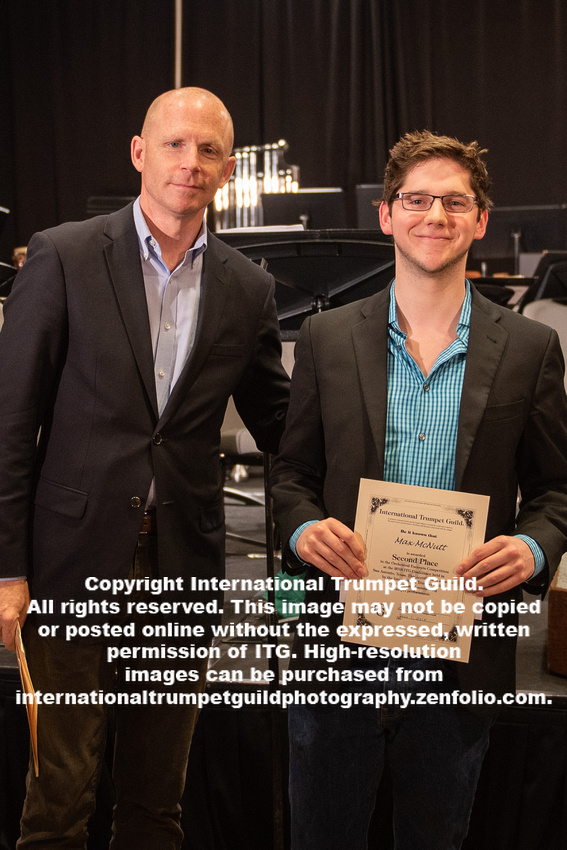 Orchestral Excerpts Competition-Second Place
Orchestral Excerpts Competition-Second Place
 Orchestral Excerpts Competition-Third Place
Orchestral Excerpts Competition-Third Place
ITG Solo Competition
Chair: Jason Dovel
Noah Mennenga (first prize)
Oklahoma State University (United States)
Teacher: Ryan Gardner
Darcy O'Malley (second prize)
University of Tasmania Conservatory of Music (Australia)
Teacher: Yoram Levy
Robin Park (third prize)
Sydney Conservatorium of Music (Australia)
Teacher: Bruce Hellmers
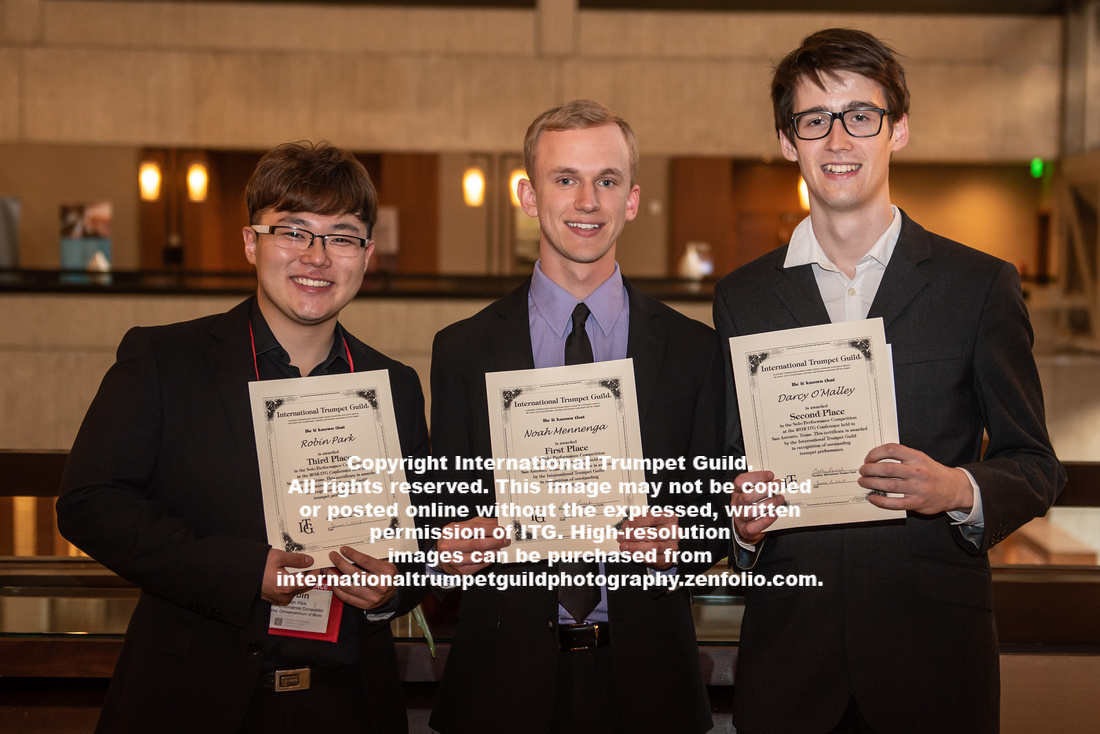 ITG Solo Competition winners
ITG Solo Competition winners
ITG Youth Competition
Chair: Marc Reed
Junior Division
Dayoung Kim (first prize)
Yewon School
Teacher: Young Min Kim
Jack Towse (second prize)
Friends Academy
Teacher: Nick Mondello
Jaemin Park (third prize)
Korea National University of Arts
Teacher: Kwan Mo Nam
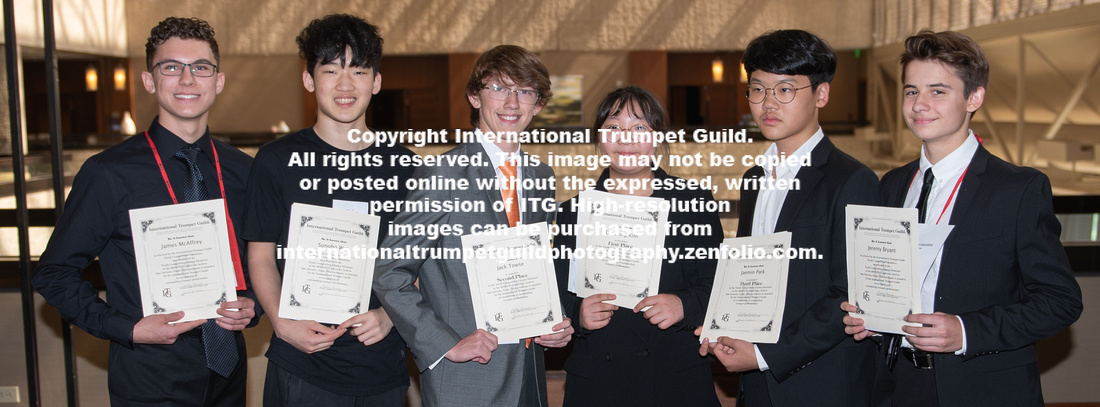 ITG Youth Competition - Junior Division
ITG Youth Competition - Junior Division
Senior Division
Alexander Tung (first prize)
Lexington High School
Teacher: Steve Emery
Michael Peery (second prize)
Private Studio
Teacher: Paul Randall
Stefan Filip (third prize)
Palatine High School
Teachers: Robert Sullivan and Matt Baker
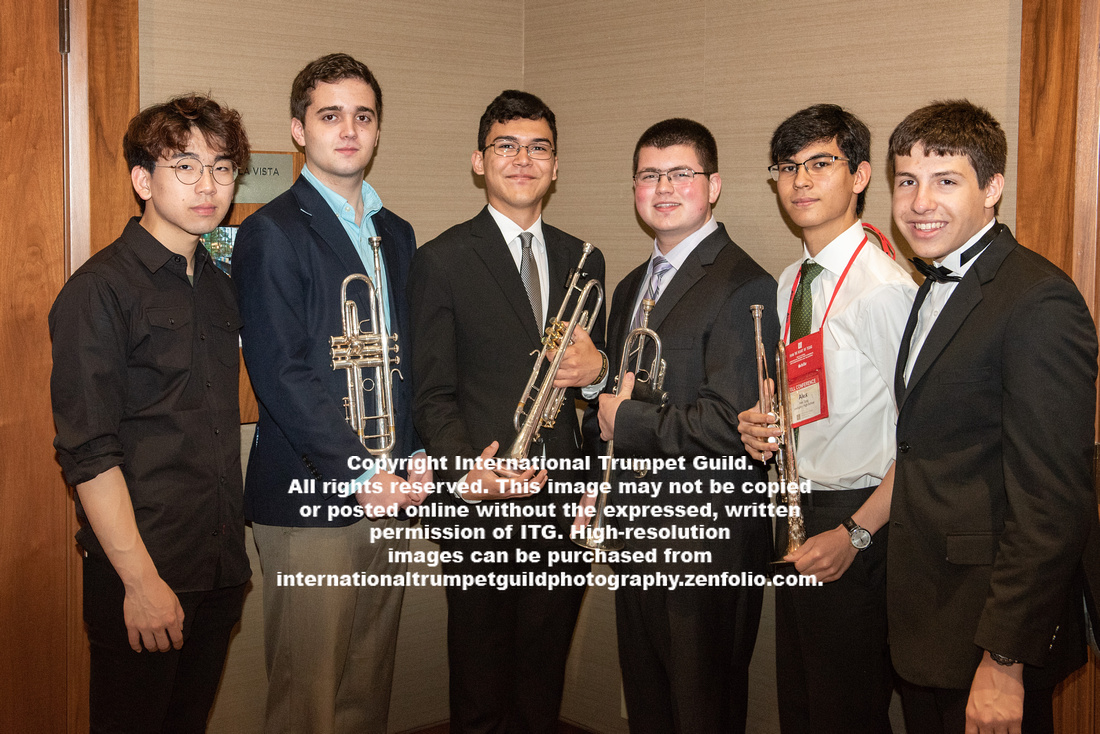 ITG Youth Competition - Senior Division
ITG Youth Competition - Senior Division
]]>
Special Daily Report • Compiled by Peter Wood
Photos by Michael Anderson, Norman Bergstrom, Josh Rzepka, Denny Schreffler, and Brian Shook
Saturday, June 2, 2018 - Evening events
Click here for more photos from the ITG Conference
Evening Concert—Pacho Flores and the ITG Festival Orchestra
Before the concert began, ITG President Cathy Leach presented the Guild’s most prestigious award, the ITG Honorary Award, to Marie Speziale, who accepted the honor with a gracious speech. Conference Director Jean-Christophe Dobrzelewski then introduced Pacho Flores and explained that the program was structured to progress from the Baroque era to the present and that Flores would be using a wide variety of Stomvi instruments displayed on a table on the left side of the stage.
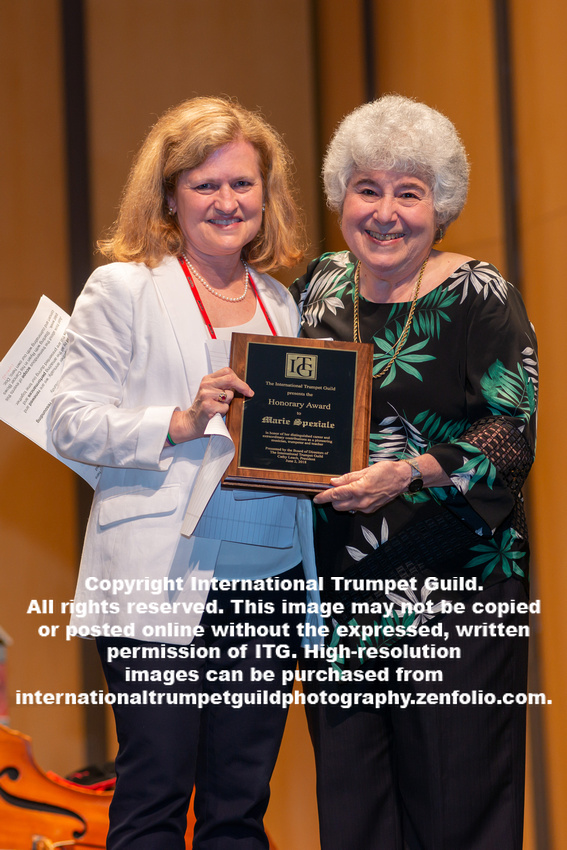 (L-R): ITG President Cathy Leach and Marie Speziale
(L-R): ITG President Cathy Leach and Marie Speziale
Accompanied by the ITG Festival Orchestra, Flores conducted while performing, standing in the center of the strings. When he wasn’t playing, he turned around to face the orchestra and conduct in the usual manner. Most of the time, however, he led as a chamber musician, nodding and dancing to the beat while facing the audience, often directing with his right hand while continuing to play the trumpet. And did he ever play! Flores possesses a rare ability to perform absolutely anything in any style and on any horn (piccolo through flugelhorn and corno da caccia)—from memory, while conducting—with effortless mastery and peerless artistry. Pacho Flores embodies a level of virtuosity that borders on the supernatural.
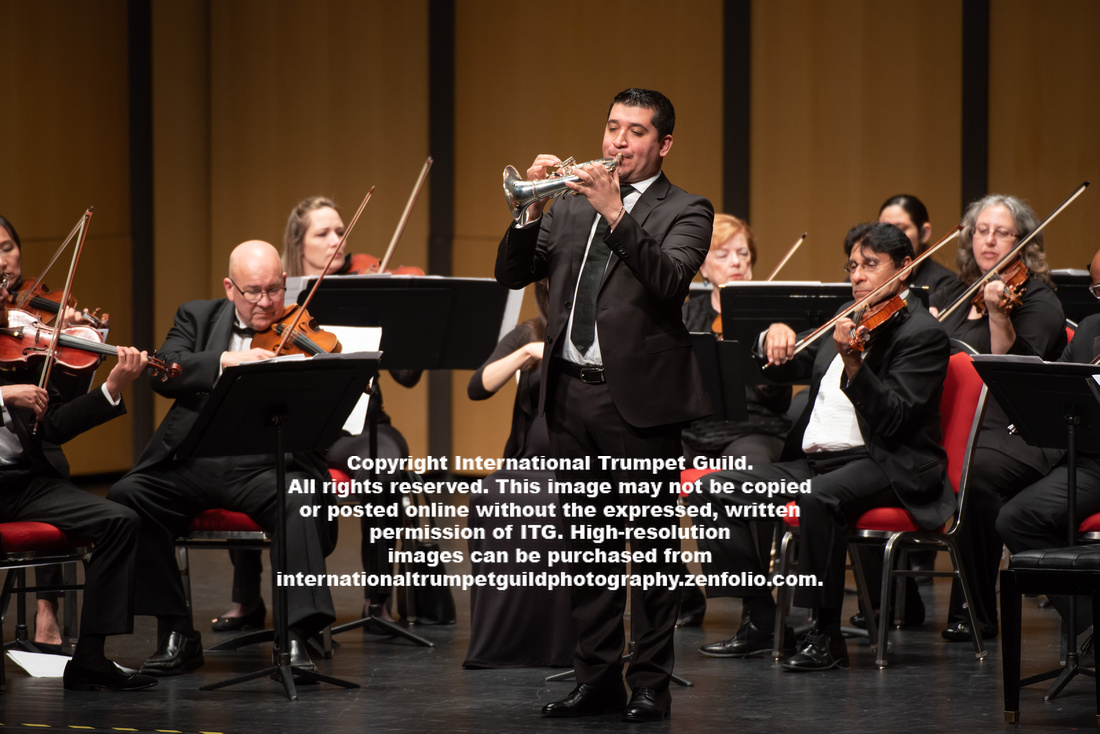 Pacho Flores playing the corno da caccia
Pacho Flores playing the corno da caccia
The program began with Efrain Oscher’s arrangement of Daquin’s Le Coucou with Flores dazzling the audience on piccolo trumpet through a flurry of spinning sixteenth notes tossed off with impeccable élan. Switching to a corno da caccia (similar to a valved posthorn), he gave an unforgettable performance of the Neruda concerto. Replete with understated elegance, inventive cadenzas, and tasteful ornamentation, Flores entranced the audience with the seductive dark sound of the instrument.
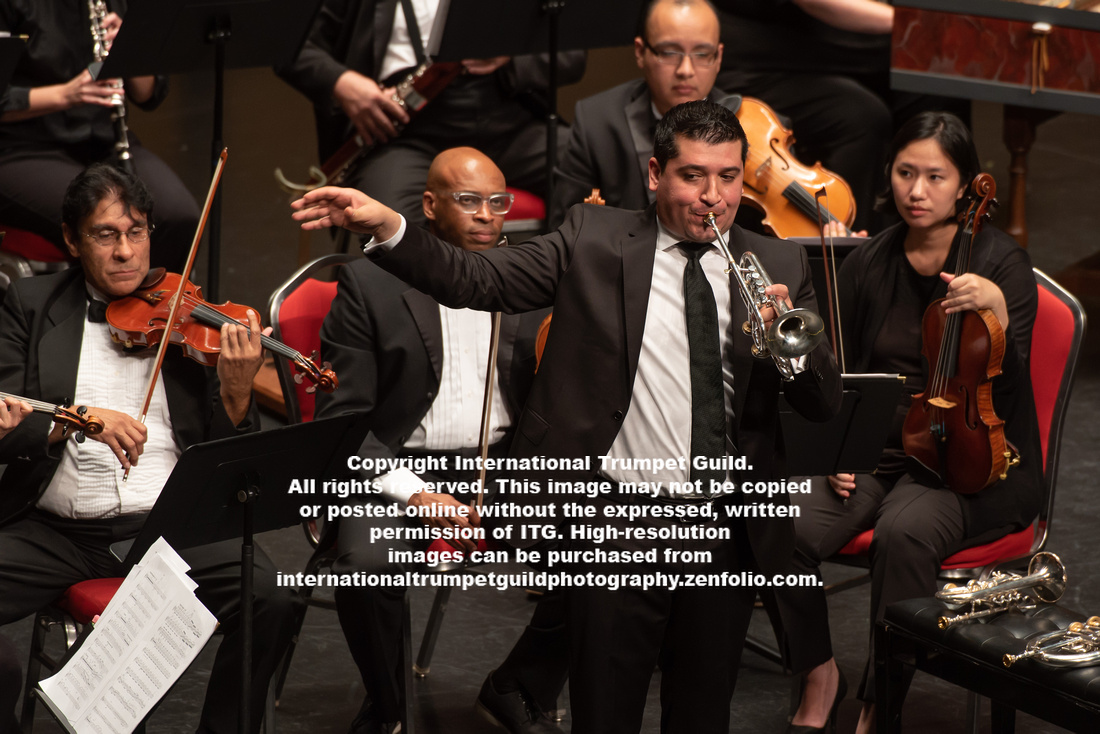 Pacho Flores conducting while playing
Pacho Flores conducting while playing
Flores introduced the next piece, Oscher’s Barroqueana Venezolana 2, by referring to his “little arsenal by Stomvi” as he moved three of the instruments to a padded piano bench next to him by the cello section. Written for Flores and designed to “combine Baroque music with Venezuelan elements,” the three movements featured playful piccolo pyrotechnics, a seductive serenade showcasing the low register of the four-valve Stomvi Titan flugelhorn, and a mixed-meter dance reminiscent of neoclassical Stravinsky. Flores returned to piccolo trumpet for an arrangement of the Aria from Villa-Lobos’ Bachiana Brasilena No. 5, which featured a soulful cantabile line over restless pizzicato strings. The Latin American set continued with arrangements of two Piazzolla pieces, Escualo and Invierno Porteno (a jazzy flugelhorn showcase), and two pieces composed by Flores—Morocota and Labios Vermelhos (a delightful samba). The final selection on the program was Oscher’s Soledad, which began with a poignant solo for the English horn, followed by increasingly elaborate variations from Flores, culminating in a blizzard of figuration leading to a final climax. The audience leapt to their feet in an immediate ovation, bringing Flores back for multiple bows until he agreed to play an encore, a tender ballad that he dedicated to ITG Honorary Award Winner Marie Speziale. When it was all over, he got down on one knee, blew her a kiss, and bowed like a gallant Knight of the Realm. (EK)
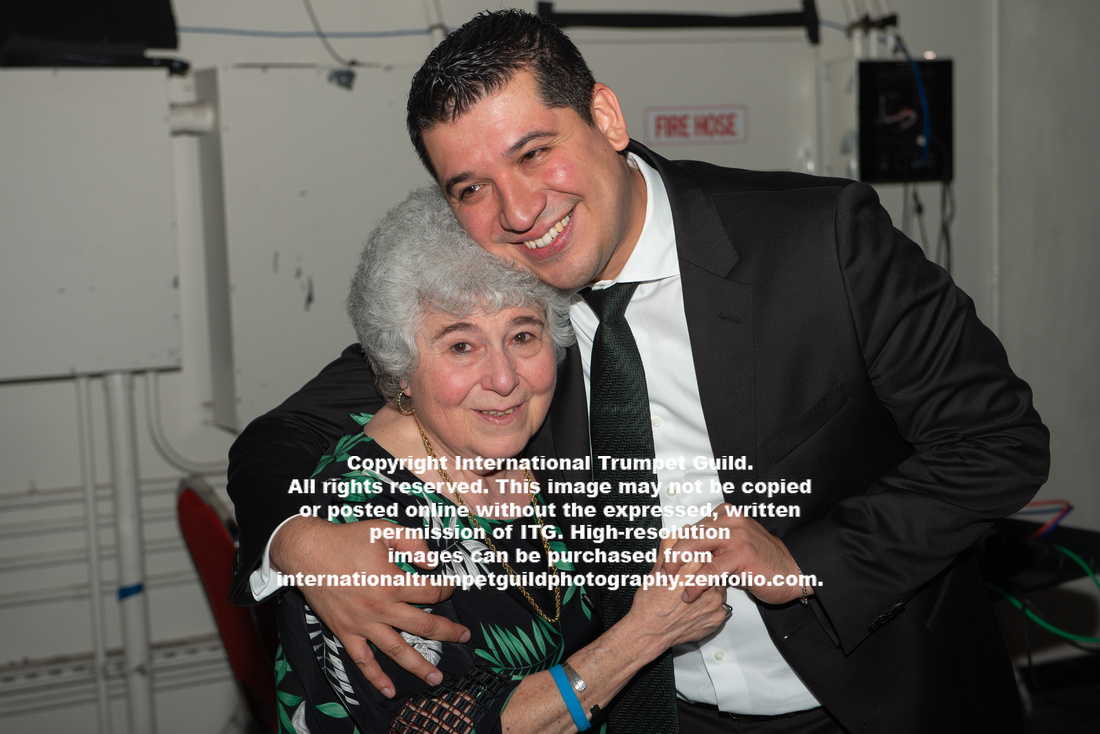 Marie Speziale and Pacho Flores
Marie Speziale and Pacho Flores
Closing Concert—Doc Severinsen, Jim Cullum Big Band, the Biohazard Brass Band, and the San Antonio Jazz Orchestra
Jazz in its many forms was represented in the final concert of the 2018 ITG Conference. The first ensemble to perform was not listed in the conference program. The Biohazard Brass Band of the 323rd Army Band from Fort Sam Houston took the stage to the surprise of the audience. The nine-piece band (three trumpets, trombone, baritone, sousaphone, tenor saxophone, baritone saxophone, and drums) provided a high-energy, non-stop fifteen-minute set that established the mood for the evening.
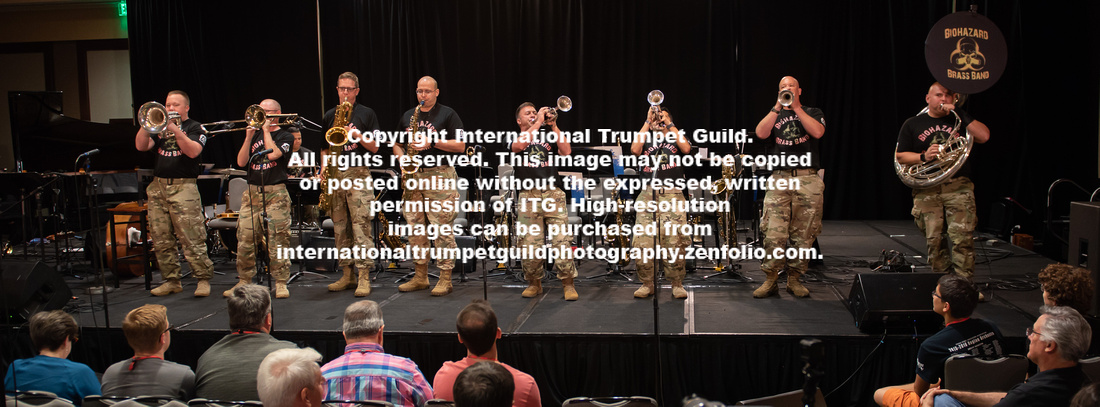 Biohazard Brass Band
Biohazard Brass Band
The Jim Cullum Jazz Band is a classic New Orleans-style jazz band performing music of the early twentieth century. And they swing! The band is comprised of cornet (Jim Cullum), clarinet, trombone, piano, bass, and drums. Their opening set included Louis Armstrong’s Mandy, Make Up Your Mind (1924) and Original Jelly Roll Blues (1905) by Jelly Roll Morton. When brought to the stage to join the band, Doc Severinsen told the audience that we all need to hear more of this kind of music, and that it is “salve for soul.”
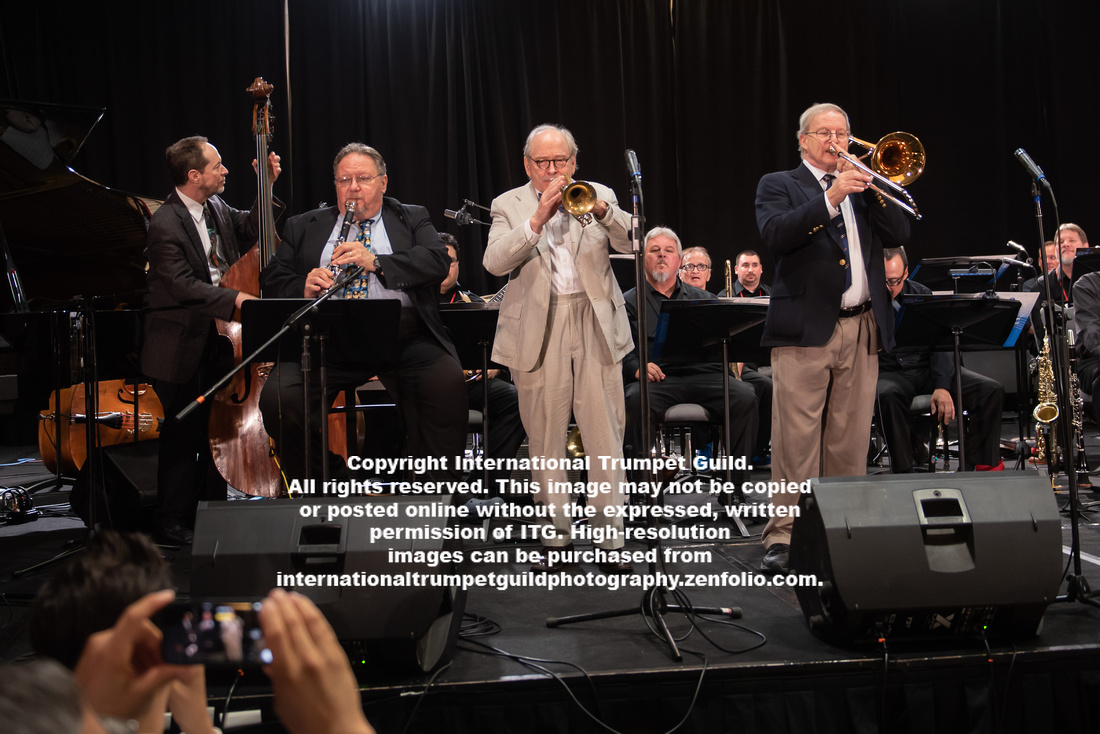 Jim Cullum Jazz Band
Jim Cullum Jazz Band
Doc then performed Louis Armstrong’s West End Blues (1928) and What’s New? (1939) with the Jim Cullum Jazz Band and used South Rampart Street Parade (1937) as a transition to the appearance of the San Antonio Jazz Orchestra. Organized in the late 1980s, the San Antonio Jazz Orchestra is made up of San Antonio area band directors, elementary music teachers, private instructors, and current and retired military bandsmen. The group is a regular performer at area jazz festivals, Texas Bandmasters conventions, and Fiesta events.
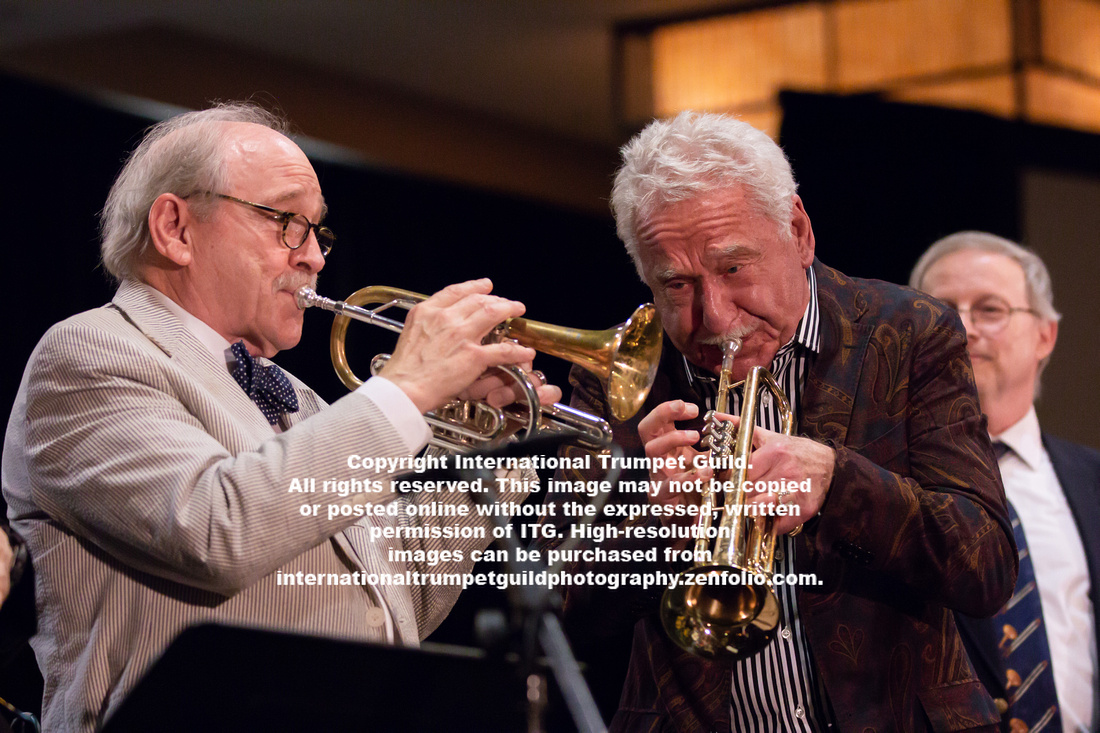 (L-R): Jim Cullum and Doc Severinsen
(L-R): Jim Cullum and Doc Severinsen
Doc played September Song, which he described as a “sad song, so I had it arranged as a soft shoe.” Doc Severinsen is a musical icon and an American treasure. His sound is unmistakable, even at his age of 90 years young. The audience showed their love for him through numerous standing ovations throughout the evening.
Jens Lindemann and Ryan Anthony joined Doc on stage for a beautiful rendition of Georgia On My Mind, and Scott Belck dazzled the audience on A Night in Tunisia. The evening concluded with all of the evening’s soloists performing 12 O’Clock Jump (at almost exactly midnight). This concert was a fitting conclusion to an exciting and memorable conference. (KE)
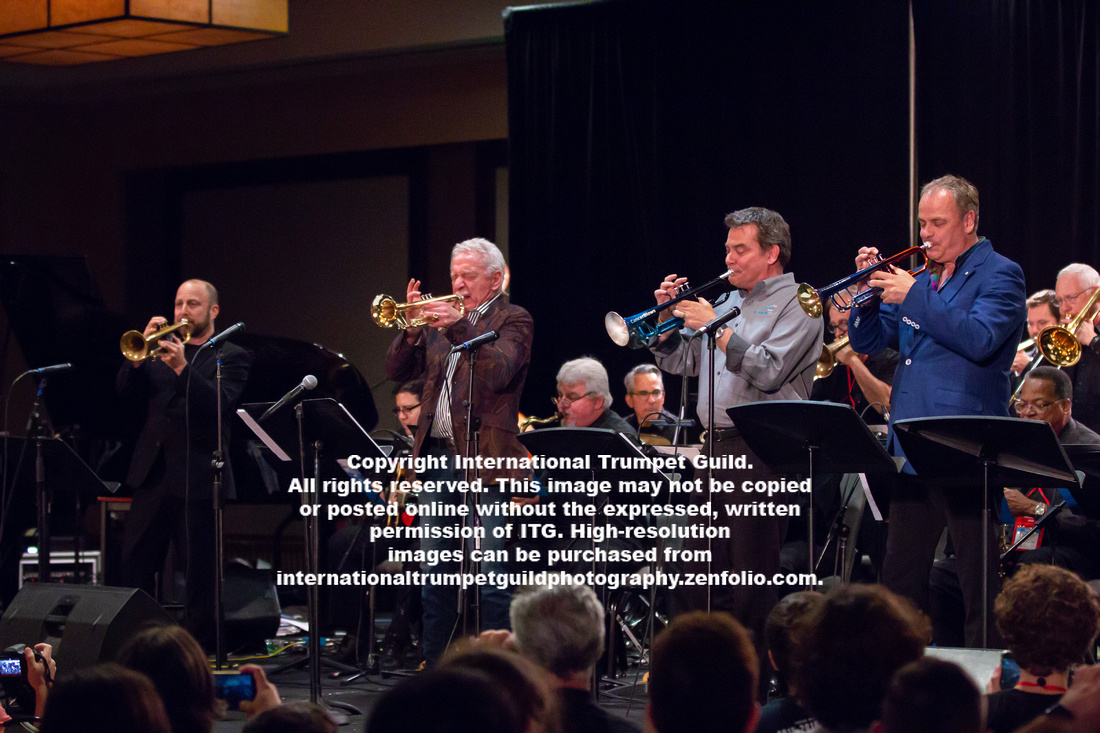 (L-R): Scott Belck, Doc Severinsen, Ryan Anthony, Jens Lindemann
(L-R): Scott Belck, Doc Severinsen, Ryan Anthony, Jens Lindemann
Click here for more photos from the ITG Conference
]]>
Special Daily Report • Compiled by Peter Wood
Photos by Michael Anderson, Norman Bergstrom, Josh Rzepka, Denny Schreffler, and Brian Shook
Saturday, June 2, 2018 - Daytime events
Click here for more photos from the ITG Conference
Scott Hagarty Warm-up Session—Trumpet Fundamentals: Going Beyond Arban, Clarke, and Schlossberg
Scott Hagarty began the session talking about the physical and mental reasons for warming up, stating that the primary purposes are to warm up the muscles of the face and focus the mind. A thorough handout was provided, covering the basic fundamentals of playing. The warm-up exercises consisted of long tones, finger exercises, slurring and flexibility studies, range-expanding exercises, and articulation patterns. Many of these exercises were extracted from different method books by Nagel, Plog, Bai Lin, and Vizzutti. Hagarty made a clear distinction between warmup and routine. While his warmup generally takes about ten minutes, his practice continues directly into his daily routine. He talked about how important it is to organize your practice session and provided examples of how to be efficient. This brought about many excellent questions from the audience. (JBu)
Mary Thornton—Youth Day Warm-up Session: Eat Your Wheaties
The student participants started their morning with an engaging Youth Day warm-up session led by Mary Thornton. Naming the session “Eat your Wheaties,” Thornton compared trumpet playing to the intense training and dedication of Olympic athletes. In the same analogy, she emphasized the importance of using a warmup to do simple things very well and reminded the class that every bit of playing one does determines the player they will be. Before even playing a note, Thornton challenged the students to engage their minds and describe their mental concepts of a great trumpet sound. Thornton then took the students through some exercises to focus on developing their fundamentals. She demonstrated parts of the James Stamp method and several Herbert L. Clarke studies. Flexibility with regard to warmups was stressed by Thornton as she noted the importance of finding a warmup that works and is adaptable for each individual. (EM)
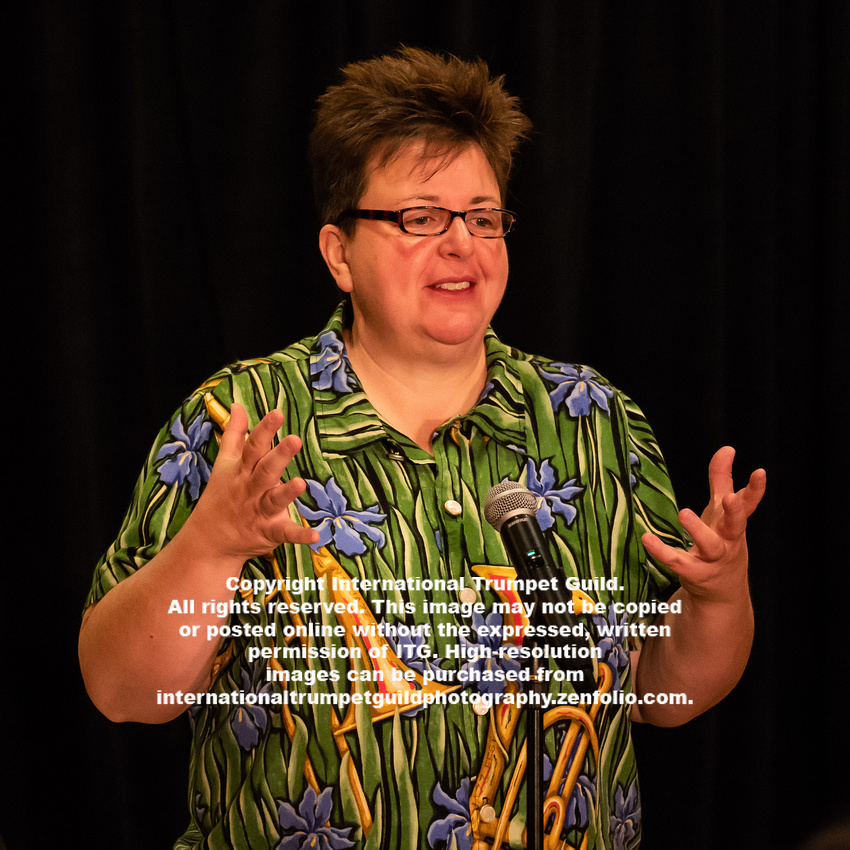 Mary Thornton
Mary Thornton
ITG Youth Competition: Junior Division
The Junior Division of the ITG Youth Competition began early Saturday morning with Jeremy Bryant’s performance of Arban’s Fantasie Brillante. Playing with a strong, resonant sound, Bryant navigated the technical and musical aspects of the cornet solo very well on his B-flat trumpet. Dayoung Kim performed Bellstedt’s Napoli and captured the charming nature of the piece exquisitely on the B-flat cornet. Kim’s technique was very impressive, and she executed each variation with precision. James McCaffrey was the third competitor and performed Ropartz’s Andante and Allegro with a robust sound and a clear understanding of the music. McCaffrey played musically, nicely contrasting the slow, lyrical moments of the piece with the fanfares found in the Allegro. Jaemin Park performed the Arutunian Concerto magnificently. Park’s playing was precise and clean throughout the entire piece. His sound was gorgeous as he played the slow, lyrical melodies, and his cadenza was flawless. Jack Towse gave a very strong performance of the first movement of the Peskin Concerto No. 1. Towse did well to convey engaging musical ideas and demonstrated impressive technique. Songho Wui was the final competitor of this Junior Division and performed the first movement of the Hummel Trumpet Concerto. Wui played with vigor and demonstrated a clear understanding of the music. Sheri Samtorelli also played beautifully on the piano, performing with four of the six competitors. The Junior Division of the ITG Youth Competition was a hit, and it was exciting for the audience to witness the outstanding playing of all the young competitors. (SW)
Presentation—Chris Gekker
Chris Gekker began his clinic talking about articulation. Referencing his own books on this topic, Gekker began by providing further clarification beyond what is printed in them. Gekker shared the value of legato tonguing, referencing many different pieces where it would be suitable to use this technique. Throughout the clinic, audience members were encouraged to ask questions, one of which was about the many different kinds of articulation markings that occur in music. Gekker provided the audience with a greater understanding of what certain articulations mean from one composer to another. Gekker went on to discuss how he still considers himself a student of the trumpet and talked about jazz musician Rick Willey and his pedagogical books and how they have influenced Gekker’s teaching. He concluded the clinic with a discussion of the professional world of trumpet playing. (BC)
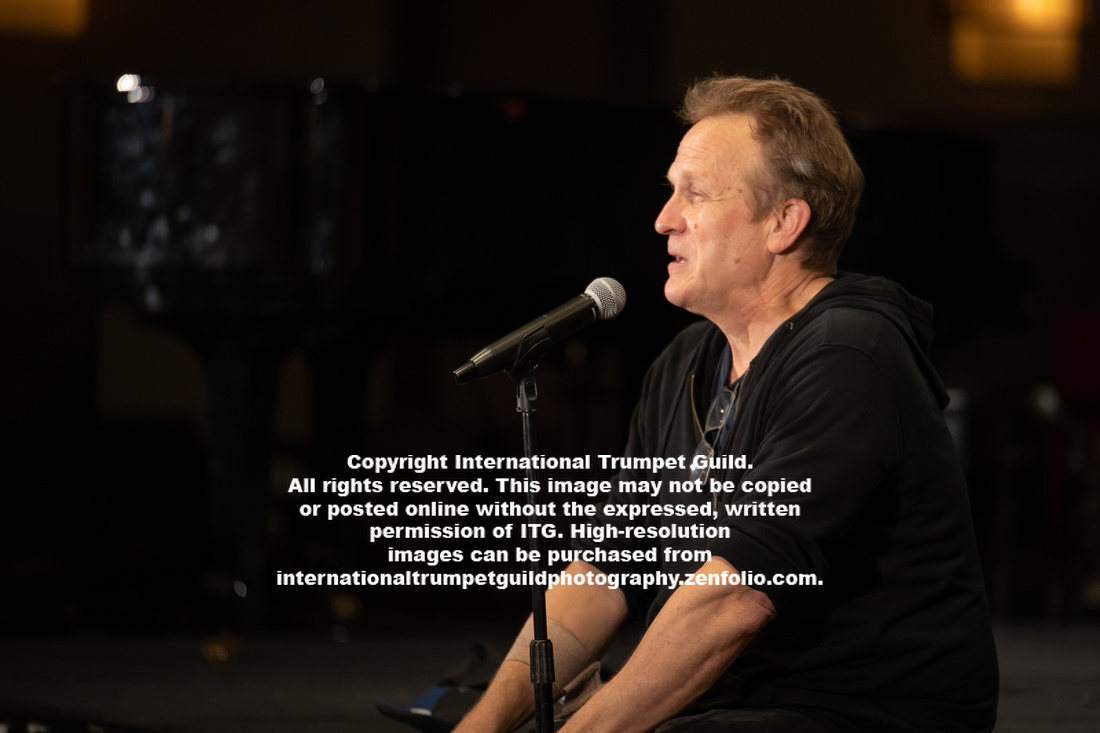 Chris Gekker
Chris Gekker
Steve Leisring Youth Day Presentation—Air Bags, Tubes, Visualizers, and More: Unconventional Approaches to Using Teaching Tools to Find Efficiency
Steve Leisring’s clinic served as a practical demonstration of various breathing and buzzing tools. He displayed a table full of gadgets, stating that many students often believe these will only teach them to inhale properly. However, he demonstrated with several volunteers that these tools can help maintain a relaxed and natural exhalation, especially when reacting to the resistance of the trumpet. With a “less is more” approach when it comes to physical processes, Leisring utilized various devices to create a desired product, including a homemade resistance buzzing device fashioned from a Coke bottle and PVC pipe. After using each device for only a few seconds, his volunteers visibly relaxed and improved everything from simple scales to the “Ballerina’s Dance” from Petrouchka. Part of the Youth Day activities, this creative presentation was an excellent resource for teachers and students alike. (MY)
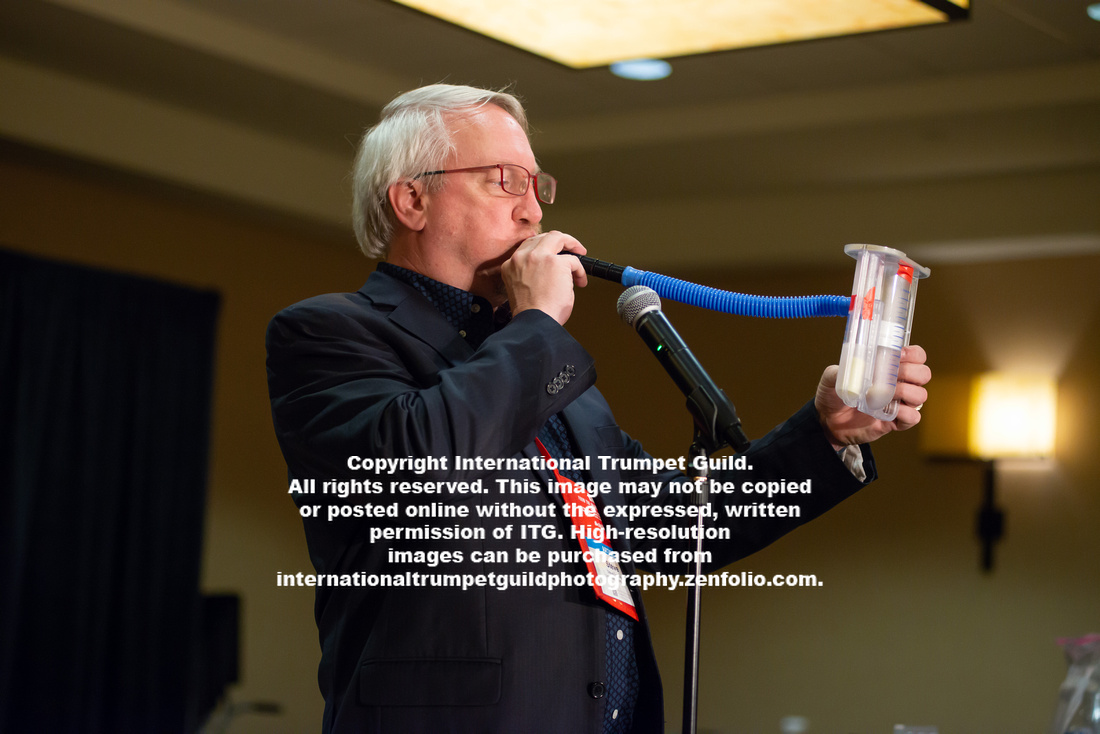 Steve Leisring
Steve Leisring
ITG Youth Competition: Senior Division
The Senior Division of the ITG Youth Competition featured six finalists who performed a solo work of their choice. Emanuel Acevedo’s performance of Goedicke’s Concert Etude featured a mature sound and exceptional display of multiple tonguing throughout. Stefan Filip displayed a superb sound with an elegant style in the first movement of Hummel’s Trumpet Concerto. Ryan Lee, who performed the first movement of Peskin’s Trumpet Concerto, gave a powerful performance, filling the ballroom with sound. Michael Peery’s beautiful rendition of the Ketting Intrada featured a high level of sophistication and finesse throughout. William Rich performed Enesco’s Legend with outstanding musicality and tonal brilliance. The final performer was Alexander Tung, who gave a captivating and poised performance of the Hummel Trumpet Concerto. (JBr)
Recital—Lucy Humphris
Lucy Humphris’s recital contained an intriguing mixture of the antique and modern. Accompanied by pianist Rebecca Wilt, Humphris opened with a rich, pure piccolo trumpet sound, and her take on Respighi’s orchestration of “Balletto” from Ancient Airs and Dances, Suite No. 1 was captivating. Humphris continued with a world premiere that used the much-maligned “double buzz” to simulate the experience of a hot desert wind roaming a barren landscape. Her arrangement of Janacek’s piano composition In the Mists displayed some soothing lyrical playing. Originally written for cello, Max Bruch’s Canzone needed a few tasteful tweaks to become accessible for the three-valve flugelhorn; however, Humphris’s inventiveness knows no bounds. Takemitsu’s Paths for unaccompanied trumpet portrayed a conversation between two close friends. The recital ended with an energetic and exciting performance of the Harry James Concerto. Style and sophistication to behold. (AD)
 Lucy Humphris
Lucy Humphris
Youth Day Presentation—Jens Lindemann
Taking the stage with his characteristic charisma and energy, Jens Lindemann introduced fellow Canadian Brass alumnus Ryan Anthony and the Spanish Brass for a unique impromptu duo version of the ubiquitous Arutunian Concerto. In fact, Lindemann had asked Ryan to perform only earlier that morning! The large audience was rapt by the brilliant and humorous performance in which the Spanish Brass accompanied Lindemann and Ryan. Next, Lindemann was joined by the Conference Jazz Trio (Andrew Bergmann, Brandon Guerra, and Aaron Prado) for a stunning rendition of Piazzolla’s Oblivion and the thrilling jazz tour de force Dreaming of the Masters by Allan Gilliland. The event concluded with a breathtaking improvised duet of "What a Wonderful World" by Lindemann and Anthony. Throughout the morning, a spirit of childlike joy and spontaneity was on full display, and was inescapably infectious to all the attendees. (BH)
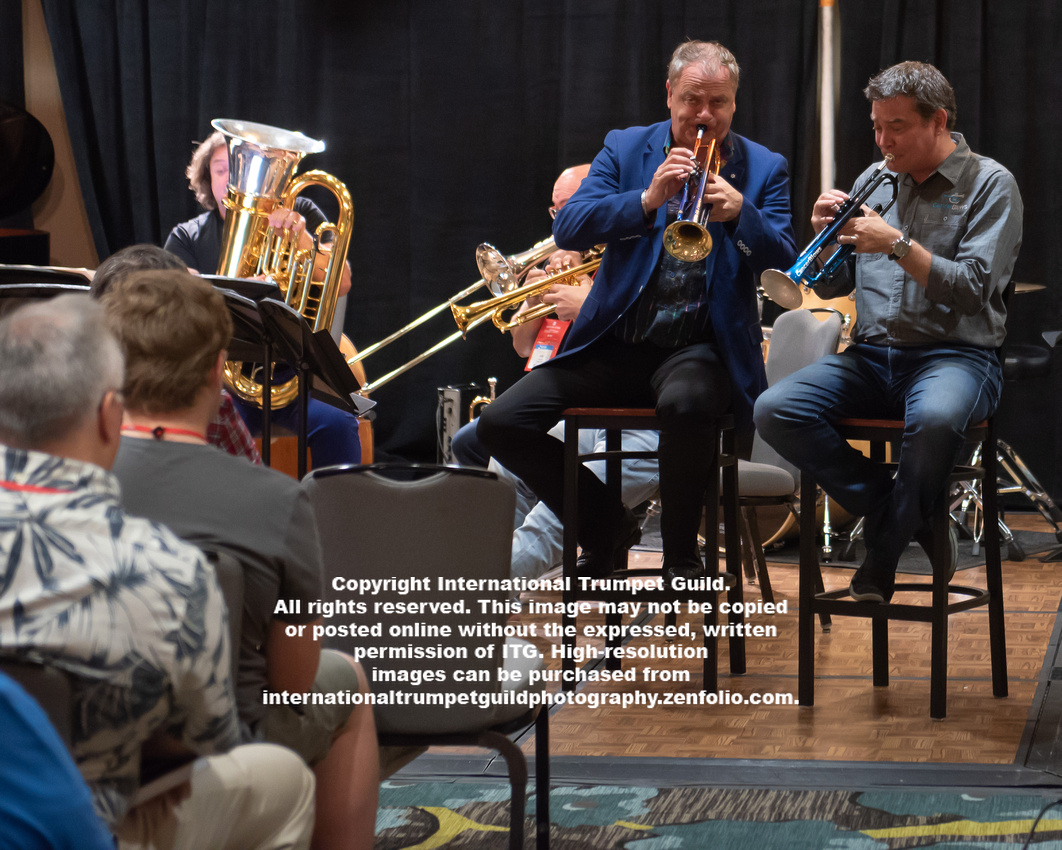 Jens Lindemann (L) with Ryan Anthony (R) and Spanish Brass
Jens Lindemann (L) with Ryan Anthony (R) and Spanish Brass
Youth Day Concert—M5 Mexican Brass Quintet: Brasscinación
The M5 Quintet began their performance with an inventive performance of Kevin McKee’s Vuelta del Fuego, adding engaging choreography to an already masterful performance. The program consisted of arrangements by Bach, Chopin, and Humperdinck, each in a completely unique and modern style. Their most inventive of these arrangements was a theme and variations on Der Alte Peter in the styles of Bach, Mozart, Wagner, Strauss, Orff, and Mariachi. Several of the pieces featured various members of the group, allowing them to show off their virtuosic talent. One particularly beautiful arrangement featured the quintet playing "Michelle" by The Beatles while spaced throughout the audience. By the end of the concert, the audience was so enraptured by their performance that they were treated to two encores. (BC)
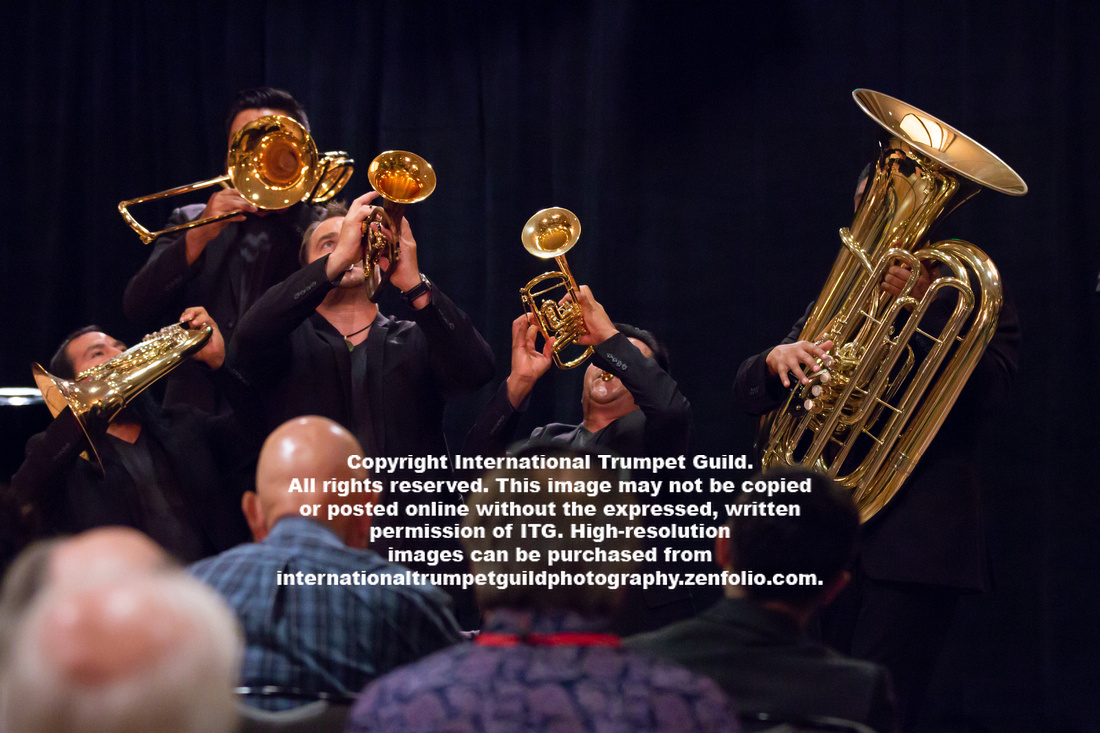 M5 Mexican Brass Quintet
M5 Mexican Brass Quintet
Festival of Trumpets
With an alternation of mixed-meter, flashy technical runs and smooth, song-like passages, Jason Dovel’s Giza Necropolis was the perfect opener for the 2018 Festival of Trumpets. The ensemble, conducted by Bradley Hogarth, executed the piece at an extremely high level, matching throughout and achieving great musicality. (WK)
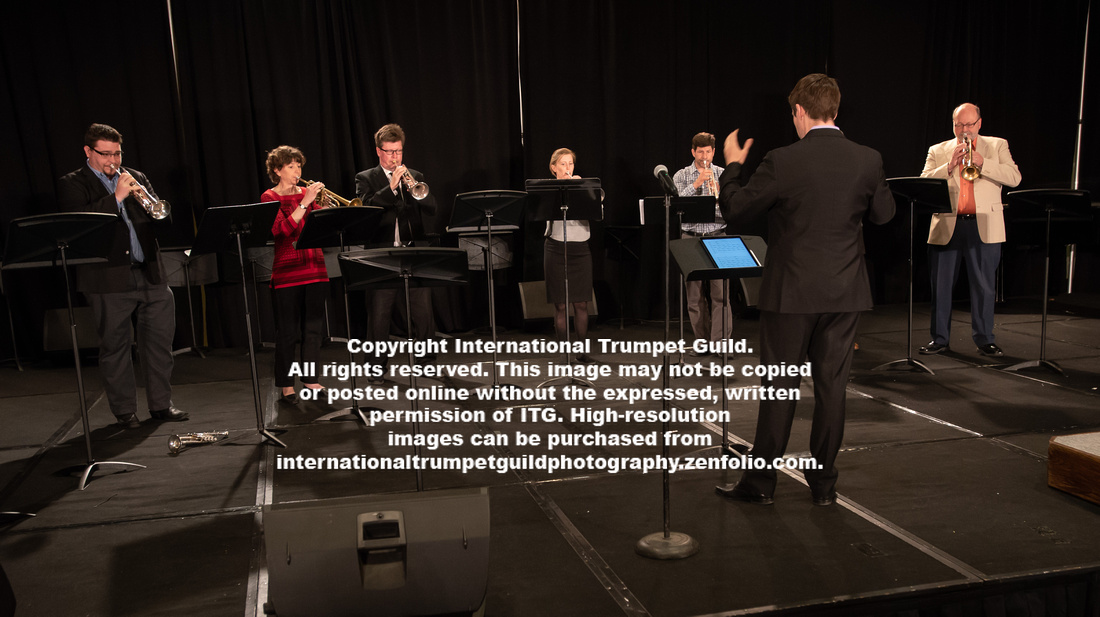 Giza Necropolis
Giza Necropolis
Second on the program was a twist on an old favorite, Charlier’s Etude No. 2. Theo’s Tango gave new life to the standard etude, mixing Charlier’s themes with original material in the style of a tango. The entertaining piece was arranged and conducted by Greg McLean and was a great piece to keep the program light and loose. (WK)
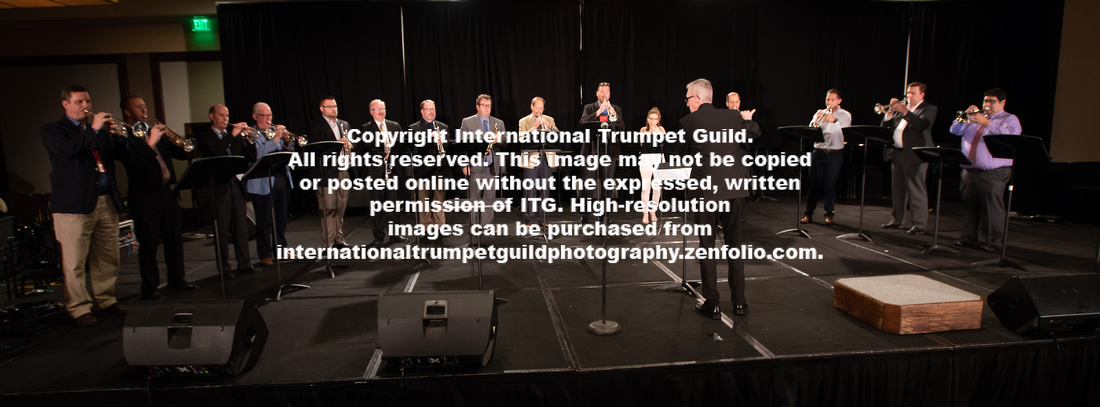 Theo's Tango
Theo's Tango
In a break from the program, ITG Youth Competition Director Marc Reed came to the stage to announce the winners and distribute the awards for the junior- and senior-level competitions that took place during the conference. (EK)
John Elkjer’s version of "Amazing Grace," conducted by David Scott, was a lovely addition to the program, exploring how much someone can manipulate a given melody to create new musical ideas. From the standard hymn to more contemporary interpretations, this new take on a classic hymn tune was a delight to hear. (WK)
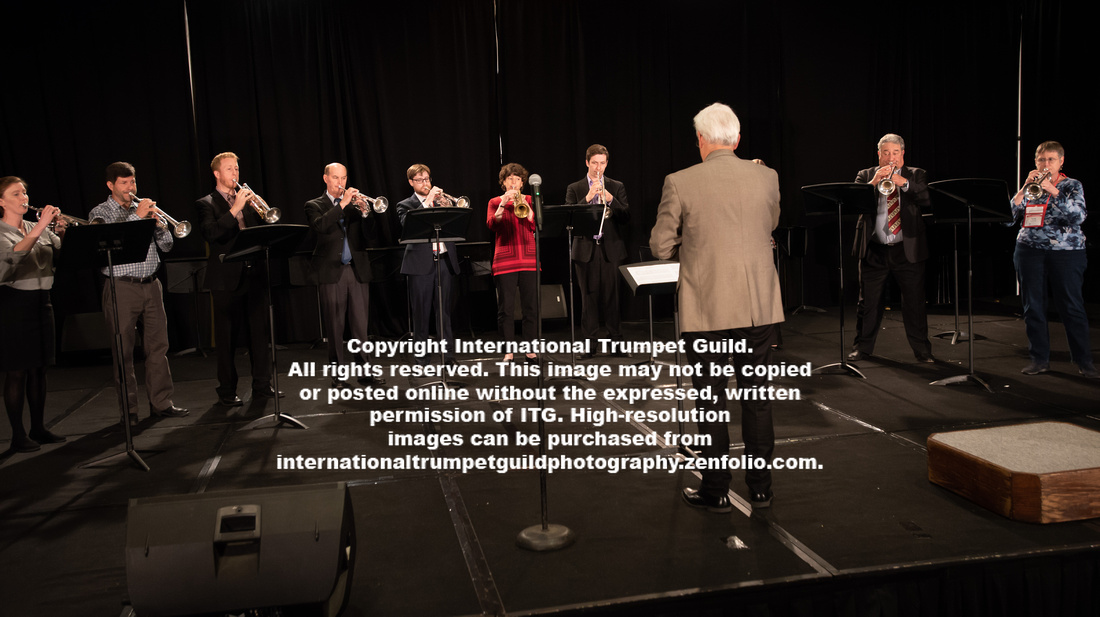 Amazing Grace
Amazing Grace
Paying homage to legendary cornet soloist Herbert L. Clarke and pulling musical material from his solos, etudes, and exercises, Kody J. Euteneier’s Prelude and Fugue on a Theme by Herbert L. Clarke was a wonderful way for the Non-Pro/Comeback Players ensemble to celebrate one of the greatest players in our history. (WK)
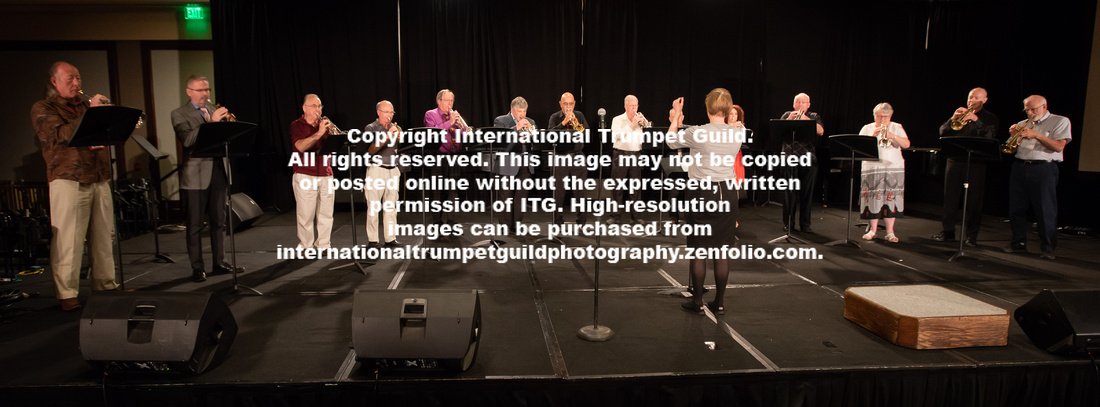 Non-Pro/Comeback Players Ensemble
Non-Pro/Comeback Players Ensemble
To honor the memory of ITG Past President Stephen Jones, who passed away just a few weeks before the conference, Judith Saxton, Alan Siebert, and Brian Evans performed Saxton’s moving tribute, Steve Jones, Remembered. The piece began with Saxton reading six words that captured the character and integrity of Jones. Each trumpeter then played a lyrical passage alone, and the three ended the piece with an emotional unison passage. (EK)
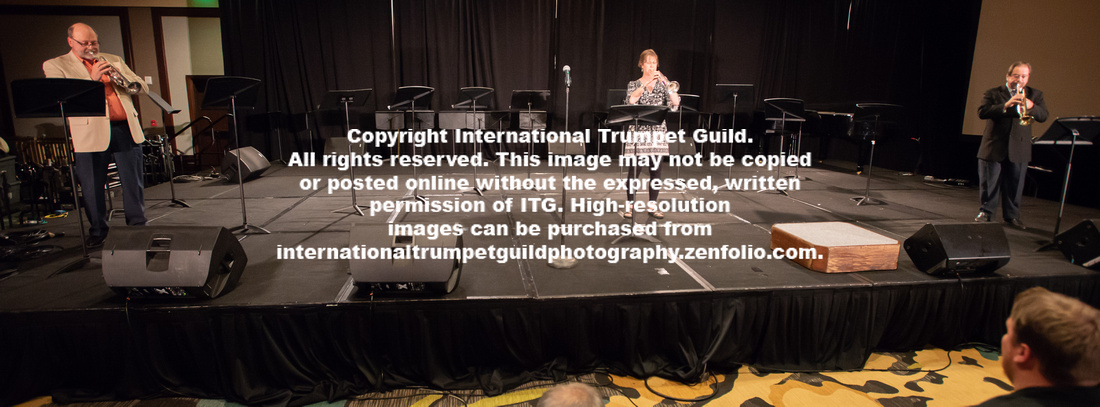 (L-R): Alan Siebert, Judith Saxton, Brian Evans
(L-R): Alan Siebert, Judith Saxton, Brian Evans
Another memorial followed as ITG Past President Brian Evans read the names of prominent trumpeters who had died since the previous year’s conference (an ITG tradition that began three years ago). Festival of Trumpets Director David Turnbull directed his own arrangement of “Nimrod” from Elgar’s Enigma Variations, scored for thirteen trumpets, which was a beautiful tribute to our lost friends. (EK)
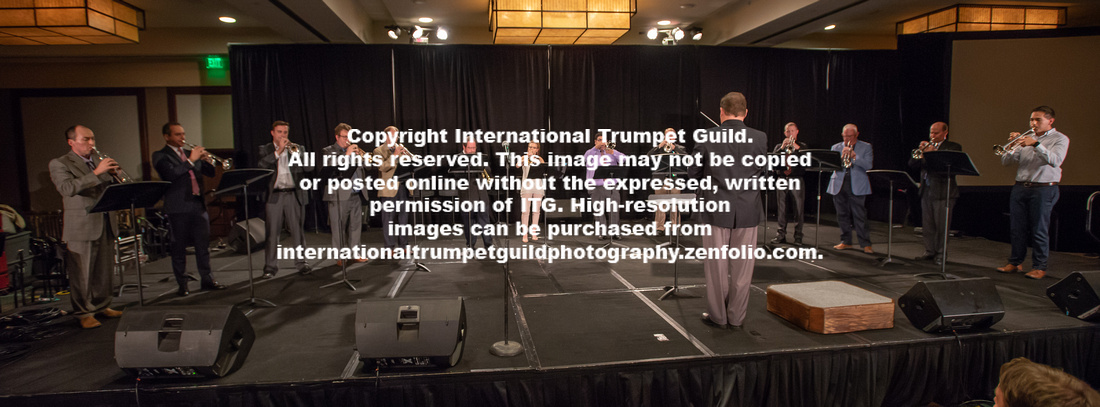 Enigma Variations
Enigma Variations
The festive mood returned with a lively performance of Sammy Nestico’s Portrait of a Trumpet, arranged and conducted by James Olcott. Featuring a fantastic solo by Scott Belck, the ensemble masterfully simulated the sound of a big band with Olcott’s colorful scoring for two piccolo trumpets down to flugelhorns and a bass trumpet. (EK)
After ITG Scholarship Director Jennifer Dearden took the stage to award certificates to the Conference Scholarship recipients, Kenyon Wilson’s Möbius was given a fine performance by an ensemble of eight trumpeters, conducted by Luis Engelke. The piece began in a poignant minor mode and alternated between agitated fugato sections and lyrical episodes, punctuated by fragments of the fugato theme. (EK)
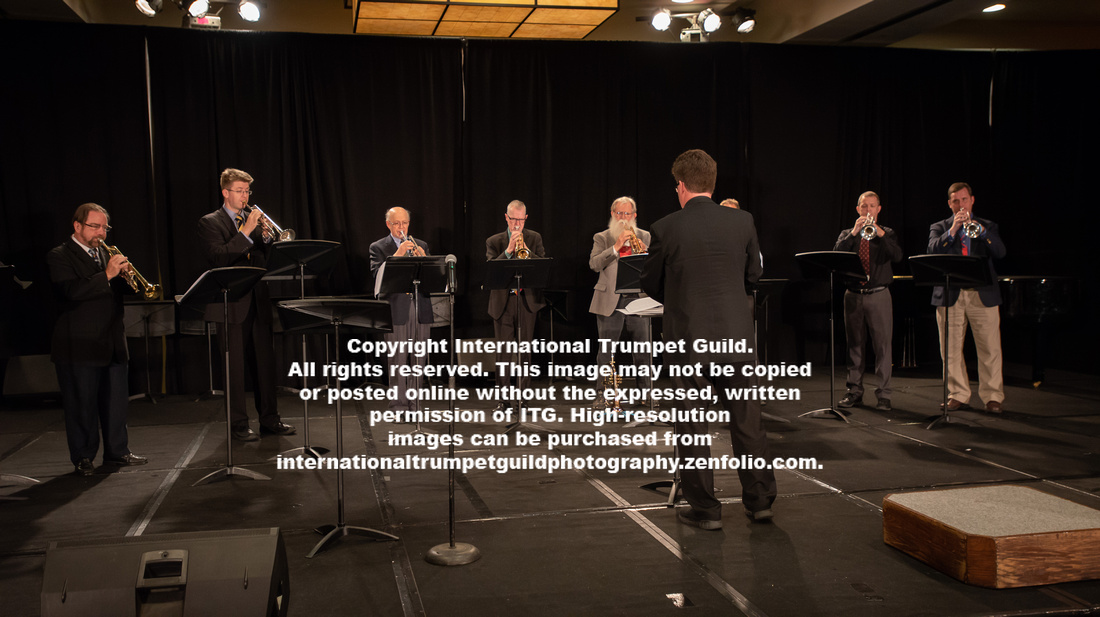 Möbius
Möbius
A crowd of trumpeters took the stage for the final selection, Grieg’s Huldigungsmarsch (Triumphal March), arranged and conducted by John Irish. Featuring powerful tutti statements in unison octaves, Wagnerian harmonies, and heroic grandeur, the performance was a fittingly festive conclusion to the concert. (EK)
 Huldigungsmarsch (Triumphal March)
Huldigungsmarsch (Triumphal March)
Click here for more photos from the ITG Conference
]]>
Special Daily Report • Compiled by Peter Wood
Photos by Michael Anderson, Norman Bergstrom, Josh Rzepka, Denny Schreffler, and Brian Shook
Friday, June 1, 2018 - Evening events
Click here for more photos from the ITG Conference
Reception: Student Meet and Greet
After a full day of performances and masterclasses, students from across the world enjoyed a wonderful reception sponsored by Grant Manhart and Fred Powell. In the largest attended reception since its inception four years ago, students were able to mingle with other students, vendors, and members of the ITG board. While the students were sharing stories and eating, numerous door prizes such as cases, mutes, and mouthpieces were given away. The reception was capped off by ITG President Cathy Leach speaking to the attendees, offering an optimistic view of the future of the organization and an open invitation to next year’s reception by the sea in beautiful Miami. (JW)
Evening Concert: A Night with the Stars
The evening concert began with the US Air Force Band of the West, led by Major David Alpar, performing a rousing transcription of Leonard Bernstein’s Overture to Candide. As with their performance for the opening concert on Tuesday night, this reviewer was struck by the ensemble’s precision and enthusiastic playing.
The first soloist of the evening, Philippe Litzler, performed Alexander Arutunian’s Concerto for Trumpet. Litzler’s rendition was light and graceful, containing none of the force and heaviness often associated with this work.
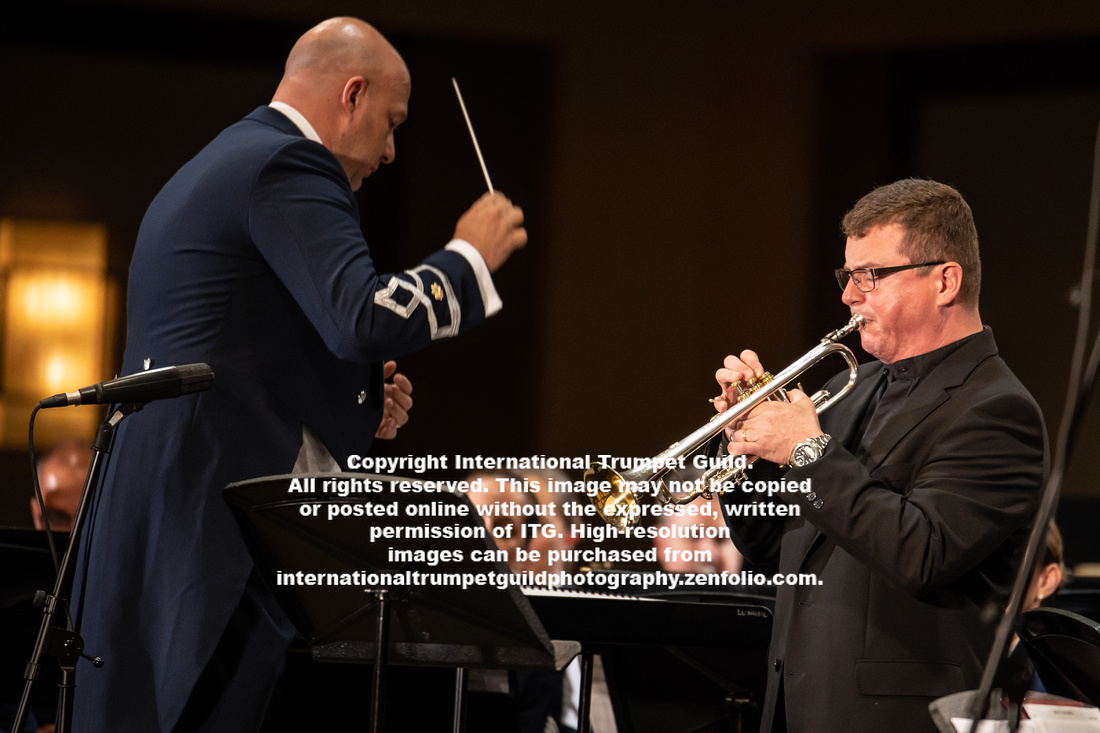 Philippe Litzler
Philippe Litzler
Unlike other concerts at ITG Conferences, which often feature a seemingly never-ending stream of trumpet soloists (not that there's anything wrong with that!), the US Air Force Band of the West included a number of stand-alone works for band in their program. They next performed Alte Kamerade (Old Comrades) by Carl Teike. As Major Alpar stated, “When you come to a military band concert, you expect to hear a march.” The inclusion of this German warhorse was a refreshing change of pace.
James Stephenson introduced his work, Road Home, by saying that it metaphorically represents returning home and all of the emotions associated with that return. He stated that his use of leaps of sevenths throughout the piece represents the soloist being “almost there.” Chris Gekker, the featured soloist, was seated for the piece due to a recent severe illness. This did nothing to diminish his performance, however, as he provided a powerful, dynamic rendering of this work in its world premiere.
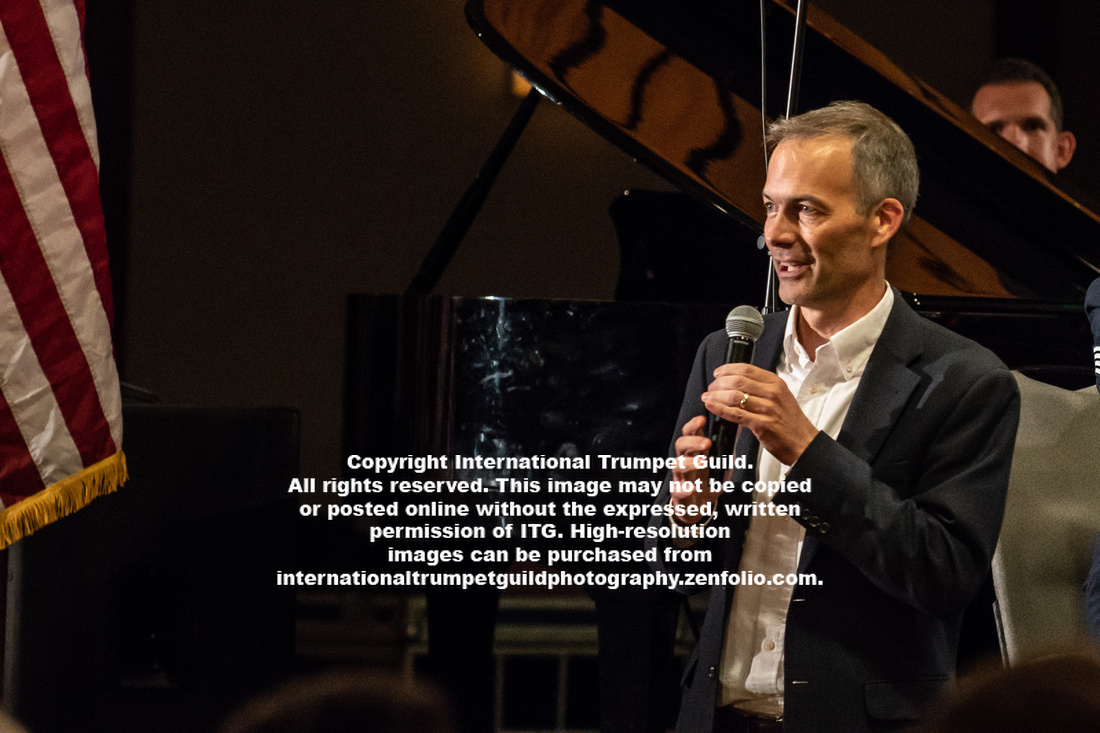 James Stephenson
James Stephenson
 Chris Gekker
Chris Gekker
The next “trumpet break” featured the band playing Steven Bryant’s Ecstatic Fanfare. From the opening chords by the brass, the woodwind flourishes, and the high horn obbligato, this piece was reminiscent of works by John Williams. Premiered in 2012, it was disappointing when the piece concluded; this writer wishes it had lasted longer!
The final trumpet soloist of the evening, José Cháfer Mompó, presented another world premiere, Spices, by Saul Gomez Soler. Spices was organized into various sections, each representing a different facet of the “taste universe,” and included “fresh mint (a breath of fresh air for our palate and ear); sugar and cinnamon (that sweet moment that defines good times); chili pepper (an adventure to an explosive sensory experience, do you dare to try it?) and peppermint, the freshness of fresh grass, which floods us again with its enveloping and herbal aroma” (http://www.saulgomez.es). Beautifully played by Cháfer and the band, this work should appear on many concerts in the coming years. It was extremely enjoyable to hear and appeared fun to perform as well.
 José Cháfer Mompó
José Cháfer Mompó
The US Air Force Band of the West concluded the formal part of the concert with Blue Shades by Frank Ticheli. Described by one reviewer as “many ‘shades of blue,’ from bright and dark to dirty and hot,” it was the perfect showcase for this exceptional ensemble.
The band closed with Salute to the Armed Services and the ever-popular Stars and Stripes Forever, with Major Alpar leading the rhythmic clapping for each piece. Titled “A Night with the Stars,” this concert featured four of them: Philippe Litzler, Chris Gekker, José Cháfer Mompó, AND the US Air Force Band of the West. (KE)
Trumpet Ensemble Reading Session II
This was the second of two scheduled trumpet ensemble reading sessions, hosted by Buddy Deshler. With over thirty participants, it was a terrific sight to see a mixture of trumpet players from a variety of backgrounds joining to read through the evening’s selections. For most pieces, all trumpeters present were on stage to participate in the reading, creating a rousing sound. The session featured two original compositions—Cannonball Jubilee for trumpet quartet by Daniel Thrower and Levi and Petra for trumpet quintet by Ryne Siesky—and two arrangements. The first of these featured Garrett Klein of the Dallas Brass on the second movement of Marcus Grant’s arrangement of the Haydn Trumpet Concerto, scored for soloist plus trumpet septet; and Barry Ford’s arrangement of Handel’s Hallelujah Chorus for ten B-flat trumpets. The evening’s event seemed to spark a good deal of camaraderie amongst the participants with its good-natured and lighthearted setting. (KM)
Evening Jazz Concert—Jorge Giraldo
The music of South America, especially Jorge Giraldo’s native Columbia, permeated the concert hall as the artist and his stellar ensemble played seven unique and highly involved pieces. Using trumpet, flugelhorn, and cornet, Giraldo’s gorgeous sound and utter command of his instrument was evident throughout. The Latin passion was evident in the opening tune, Al Despertar, and continued through the Tango-like Balada Prara Un Amor Imposible. The piano-less ensemble (consisting of guitar, bass, and percussion) offered brilliant support as the various pieces moved in rhythmic segments, a unique aspect of almost every song performed. A highlight of the performance was Caribe, in which polyrhythms floated among the talented quartet. Concluding with a standing ovation, this concert was a memorable evening of unique Latin sounds performed by an outstanding ensemble and soloist. (NM)
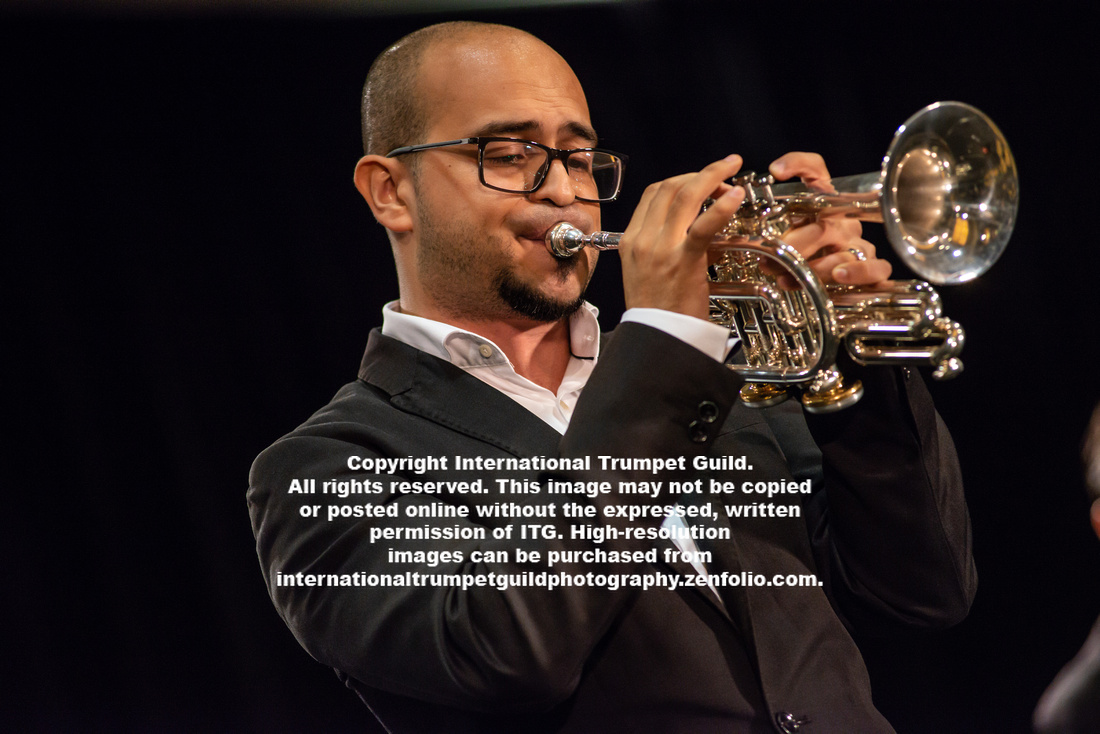 Jorge Giraldo
Jorge Giraldo
Click here for more photos from the ITG Conference
]]>
Special Daily Report • Compiled by Peter Wood
Photos by Michael Anderson, Norman Bergstrom, Josh Rzepka, Denny Schreffler, and Brian Shook
Friday, June 1, 2018 - Daytime events
Click here for more photos from the ITG Conference
Aaron Witek—Warm-up Session: Cross-Training Approach to Daily Fundamentals
Dr. Aaron Witek’s cross-training approach is to work on several fundamentals at one time to get the most out of his warm-up session. The session began with several breathing exercises and some leadpipe buzzing. The goal is that the player makes sure that the air leads the way with everything played on the trumpet. A handout was provided with several exercises that Witek developed that incorporate these cross-training fundamentals. For example, the first study combines tone and articulation, and the second combines tone, fingers, and flexibility. Many of the exercises use lip bends to help develop correct air speed when playing. Witek took participants through all ten exercises of his warmup, always providing excellent pedagogical information about the goal of each exercise. (JBu)
Kyle Millsap—Warm-up Session
Dr. Kyle Millsap opened the session by explaining why we warm up. He stated that it is a way for trumpet players to do a “system check” and normalize the day-to-day factors that can affect one’s playing. He emphasized the importance of developing an efficient warm-up routine that does not take too long or wear out the chops; Millsap’s warmup can be done in about fifteen minutes. One crucial part of his routine is establishing a relaxed breath that has constant motion through the inhalation and into the exhalation. Millsap demonstrated several simple breathing exercises that he enjoys doing along with his favorite pop songs on his stereo, rather than a metronome click. Millsap encouraged utilizing the Tonal Energy app, which provides a variety of drone sounds to develop pitch and tone centering. (EM)
ITG General Membership Meeting
Despite the early hour, the ITG General Membership Meeting was nearly “standing room only.” The meeting began with comments regarding the conference by Conference Director Jean-Christophe Dobrzelewski, followed by comments and critiques of the 2018 conference by the members in attendance. This was followed by ITG Secretary Kevin Eisensmith reading an abridged version of the minutes from the Board of Directors meeting earlier in the week. Eisensmith’s notes outlined the direction the Board intends to take in the coming year and were transparent and informative. Next, ITG Treasurer Dixie Burress gave her report on the state of the organization’s finances, and Publications Editor Peter Wood reported on the state of the ITG Journal. The morning concluded with a vigorous discussion period. The board was very open to the many thoughtful questions and comments offered by the membership. ITG President Cathy Leach and the Board of Directors made themselves available for discussion throughout and after the productive meeting. (BH)
Barry Bauguess: Dance, Rhetoric, and Text in the Art of the Baroque Trumpet
Baroque trumpeter Barry Bauguess and his wife, Paige Whitley-Bauguess, a noted expert in Baroque dance, presented a clinic titled “Dance, Rhetoric, and Text in the Art of the Baroque Trumpet.” They were assisted by Baroque trumpeter Melissa Rogers and accompanied by Rebecca Wilt on a Roland C-30 digital harpsichord. Bauguess and Rogers opened the session by performing Fantini’s Riposta detta del Savati on four-hole vented Baroque trumpets. Bauguess then introduced the concepts of historic pitch standards, temperaments (sixth comma meantone is recommended for Baroque trumpets), tone, articulation, and rhetoric (the art of good communication: logos, ethos, and pathos). Paige Whitley-Bauguess demonstrated such Baroque dances as the bourée, minuet, and gavotte and explained how choreography was notated and combined with musical patterns (see http://www.baroquedance.com for more information). Putting it all together, she danced to selections by Jeremiah Clarke, Heinrich Schmelzer, and Bach—all performed by Barry Bauguess, Rogers, and Wilt to demonstrate with grace and artistry the concepts discussed. (EK)
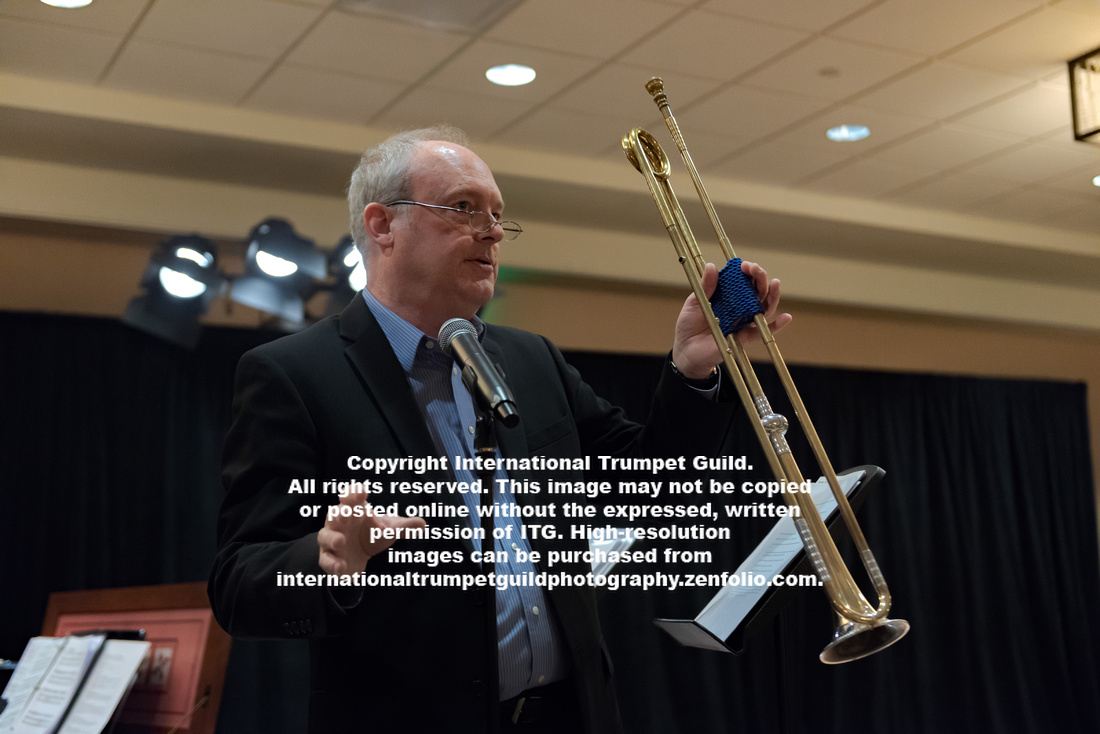 Barry Bauguess
Barry Bauguess
Joe Burgstaller and Friends Play Great Music Together
Joe Burgstaller’s morning recital was a transcendent display of connection, musicianship, and virtuosity. The repertoire repeatedly combined diverse styles in mini-sets including such composers as JS Bach, George Gershwin, Chick Corea, and Billy Joel. Burgstaller’s addition of a soulful extended improvisatory section between verses of De Falla’s Nana was stunning. Guests included Ryan Anthony, David Hickman, members of the Dallas Brass, and percussionist Michael Mixtacki. The final piece was an engaging world premiere of an ITG commission, Trumpet Voyage for trumpet (C and flugel), percussion, and piano by Subramaniam. An extended ovation led to a brilliant encore. Before the second set, Burgstaller discussed the question “What is our place in this world?” and explained that, for him, it is not to impress but, rather, to share and make the world more beautiful. This performance was a huge success in meeting those goals. (AK)
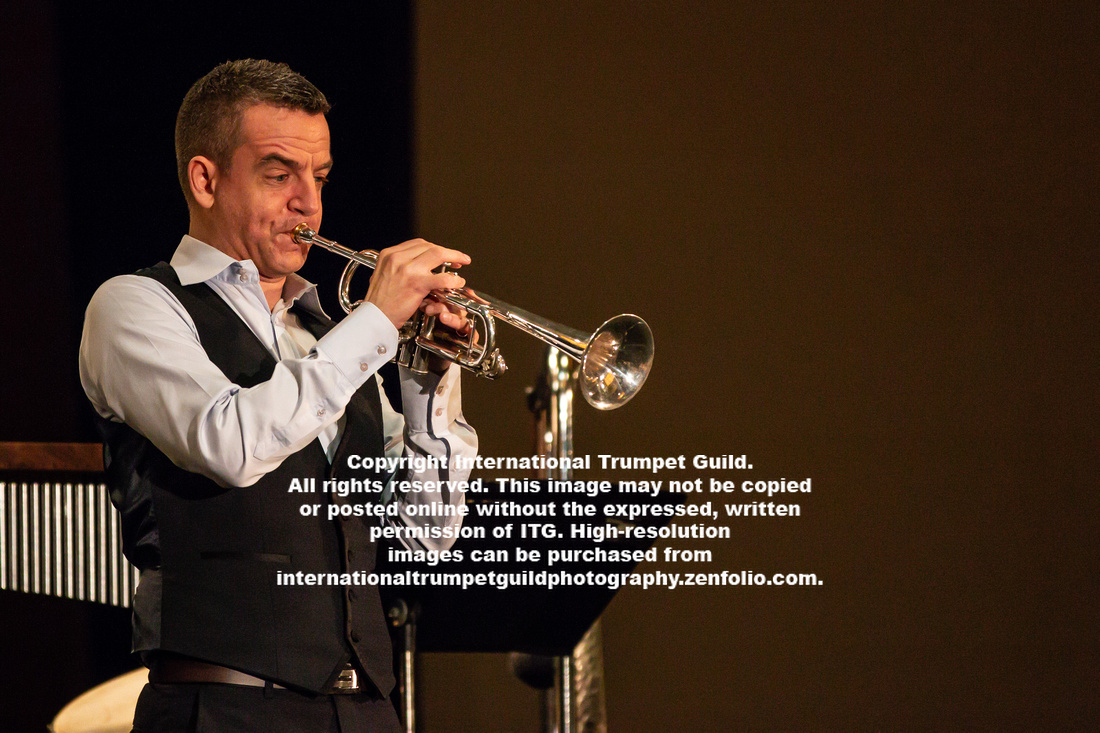 Joe Burgstaller
Joe Burgstaller
Presentation—San Antonio Symphony Trumpet Section
A large audience warmly received the local San Antonio Symphony trumpet section for their presentation in which each member gave an individual talk and took questions. The session began with the newest member, Daniel (Danny) Taubenheim, associate principal. Taubenheim won this position in 2016 after studies at Juilliard and Rice. He offered a variety of tips about preparing for auditions, including performance anxiety and how to succeed once you win a job. Lauren Eberhart has played with the San Antonio Symphony for 22 years. She discussed the role of the second trumpet player and gave more tips on taking auditions. John Carroll, long-time principal trumpet, concluded the session by offering advice about dealing with performance anxiety and giving some intriguing pedagogical suggestions. He focused on tone production and the use of air and then covered tips for technical development and the significance of even small amounts of improvement. (AK)
 San Antonio Symphony Orchestra Trumpet Section
San Antonio Symphony Orchestra Trumpet Section
Concert: Tromba Mundi
Celebrating ten years as a professional trumpet ensemble, Tromba Mundi opened their program with William Stowman’s Fanfare Tromba Mundi. Written specifically for this ITG performance, the ensemble continued with Joyous Noise, by Erik Morales. Continuing with another Stowman original, The Non-Articulation Agreement showcased the wonderful lead playing of Scott Belck. Slowing things down a bit, the group continued with Aranjuez, Mon Amour, highlighting the beautiful flugelhorn playing of J.C. Dobrzelewski. Joey Tartell’s arrangement of Good Bait showed his command of the entire range of B-flat and bass trumpet and gave him and Belck opportunities to improvise. Bryan Appleby-Wineberg’s gorgeous cornet playing was featured on Stowman’s arrangement of A Fond Kiss. The concert was full of great music and laughter and concluded with Appleby-Wineberg’s explosive arrangement of the theme from Green Hornet. (WK)
 Tromba Mundi
Tromba Mundi
Tony Glausi—Jazz Recital: Original Works for Modern Jazz Quartet
Alongside the Conference Jazz Trio (Andrew Bergmann, Brandon Guerra, and Aaron Prado),Tony Glausi, the winner of the 2017 Carmine Caruso International Jazz Solo Competition, gave an excellent jazz recital that showed why he is considered one of the great young talents in the jazz community. A highlight was the standard On Green Dolphin Street that showed the same breathtaking creativity and effortless fluidity on the flugelhorn that Glausi had already displayed on the trumpet. I Can’t Seem to Get Enough of You, one of Glausi’s original works, had such a classic sound and beauty that it evoked thoughts of the Great American Songbook. Glausi performed with a great combination of beautifully flowing, simple phrases and wonderfully complex tonal language, all while exhibiting exceptional control and stunning articulations at softer dynamics. An electrifying upper register combined with a timeless sound to match his technique and energy, Glausi left the audience wanting more. (AJ)
 Tony Glausi
Tony Glausi
Jon-Erik Kellso—Jazz Concert
Traditional jazz took the spotlight during Jon-Erik Kellso’s afternoon jazz concert featuring the music made famous by Louis Armstrong, Bix Biederbecke, and Roy Eldridge, among others. Kellso performed most of the concert on a Puje trumpet, a cornet/trumpet hybrid that allowed him seamlessly to shift style and sound from the early-jazz cornet sounds of the 1910s and 1920s to the jazz trumpet sound of the 1930s and 1940s. The program took a quasi-chronological approach through traditional jazz, and Kellso weaved in plenty of historical commentary to shed light on this excellent historical jazz repertoire. He started with a trio of Louis Armstrong tunes: Cornet Chop Suey, Black and Blue, and Mahogany Hall Stomp. After a Bix Biederbecke ballad, Kellso performed a trio of Duke Ellington tunes written for famous trumpet soloists of the Ellington band—Bubber Miley and Cootie Williams. The program ended with a pair of Roy Eldridge tunes: After You’ve Gone and Rockin’ Chair, before closing with one last Louis Armstrong tune, You’re Driving Me Crazy, a precursor to the famous Basie standard Moten Swing. Jon-Erik Kellso’s sound and style was impeccable, and listeners were transported back in time to an earlier era of jazz in which trumpet technique featured fast vibrato, growls, scoops, and half-valve glisses. His pixie mute-plunger mute work was of the highest quality, and it was almost as if Cootie Williams himself were on stage. (SH)
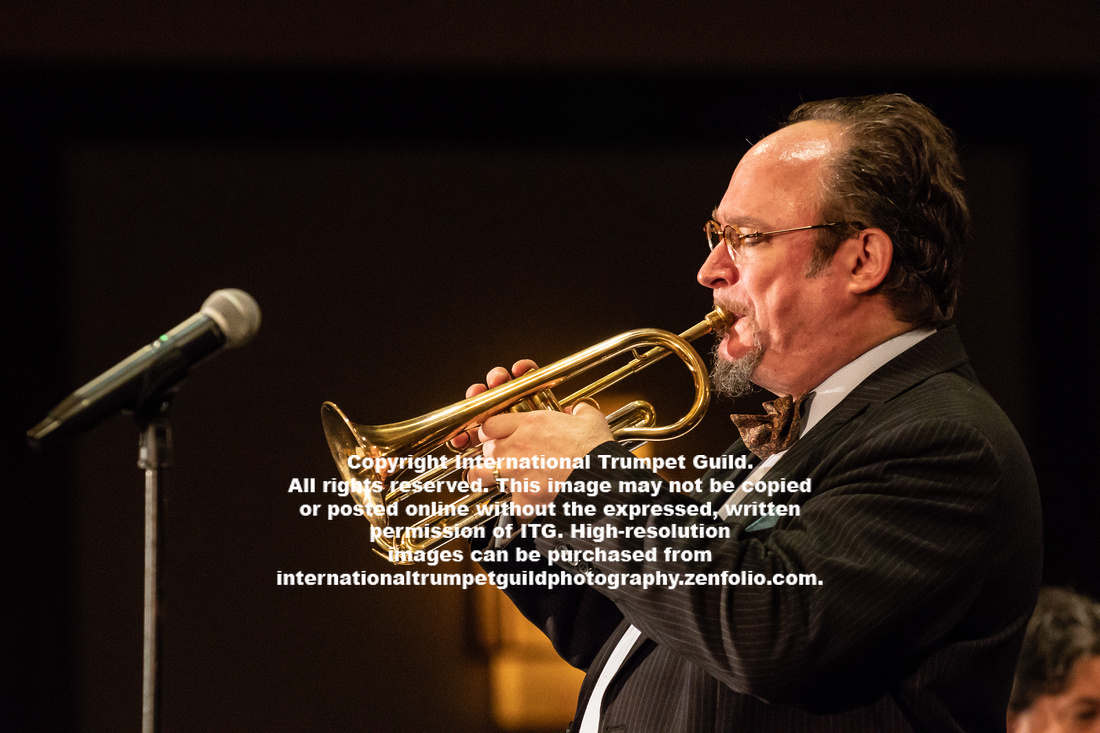 Jon-Erik Kellso
Jon-Erik Kellso
Recital—Peter Bond with Miriam Hickman: Bell Canto [sic]
Opening with Malcom Arnold’s Fantasy for Solo Trumpet, Peter Bond’s exciting performance immediately demonstrated his flexibility and control of the instrument. He provided a brief discussion explaining the concept of the recital and the title “Bell Canto” [sic]. While none of the works were written for voice, Bond uses singing to prepare musically for all passages. He performed his own transcription of J.S. Bach’s entire Suite No. 3 for Solo Cello in the challenging key of concert E major on B-flat trumpet and explored the entire range of the instrument. The boisterous applause demonstrated the audience’s appreciation for the herculean effort required. Miriam Hickman joined Bond in a fine performance of Gabriel Fauré’s Sicilienne. The final selection of the concert was Arban’s Fantasie Brilliante appropriately performed on cornet with a dark and velvety sound. Even the various introduction sections included significant changes in tempo and style. This work was a fitting conclusion to a highly entertaining recital. (LE)
 Peter Bond
Peter Bond
Merrie Klazek Presentation—Preparation and Performance
Merrie Klazek’s session, subtitled “Tips and Tools for Trumpet Players of All Levels and Musical Styles to Feel Confident and In Control on Stage and in Rehearsal,” provided a very informative approach to dealing with the many pressures of live performance. Klazek’s session highlighted the knowledge gained from her personal experiences, teachers, and mentors, which are used to identify and navigate the various issues that often accompany stage fright. She addressed a number of techniques that performers can use to examine their playing so that when they are placed into high-stress situations they can be as successful as possible. Professor Klazek also provided the audience with a brief handout that highlighted her key points and provided several guiding quotations from her mentors. (JPS)
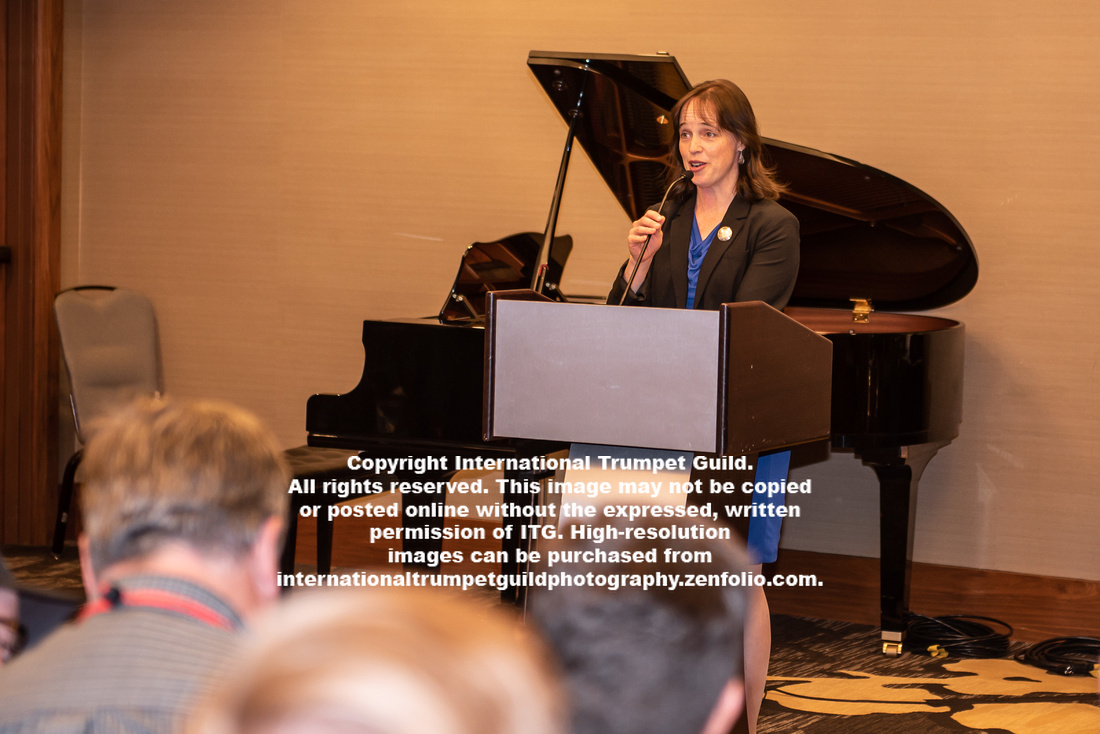 Merrie Klazek
Merrie Klazek
Mike Vax Presentation—Successful Lead and Section Playing: Plus Some of the Basics
Mike Vax spoke to a crowded room in the Rio Grande Ballroom about lead playing, section playing, and the basics of jazz trumpet pedagogy. He touched on many pedagogical topics throughout the session and interweaved many stories of his time as lead trumpet in the Stan Kenton band. The first topic he discussed was the “percentage formula” for trumpet playing, which he breaks down as 90% air, 9% brain, and 1% chops. He spent a lot of time talking about the 9% brain, recommending several books to read about positive thinking and mindfulness in performance: Science of Breath, Psycho-Cybernetics and The Inner Game of Music. In discussing the role of the lead player in a jazz band, he emphasized the point that “The lead trumpet player should be the least creative person in the band.” In other words, the lead player should play it the same every night, because the rest of the band is counting on him or her to be consistent in leading the band. The next big topic that Vax covered was how to improve the upper register, and he specifically mentioned lip flexibilities like those on page 44 (#22) in the Arban book and those in the Charles Colin book. He stressed that building better endurance sets the foundation for improving the upper register and that increasing range is something that happens slowly over many months and years. He finished the clinic session with a discussion of how to approach learning improvisation. His recommendation was to spend time listening and learning tunes by memory. Then, approach soloing based on the melody and start soloing by ear. Music theory should come later. Vax included several handouts that discussed these topics in greater detail. (SH)
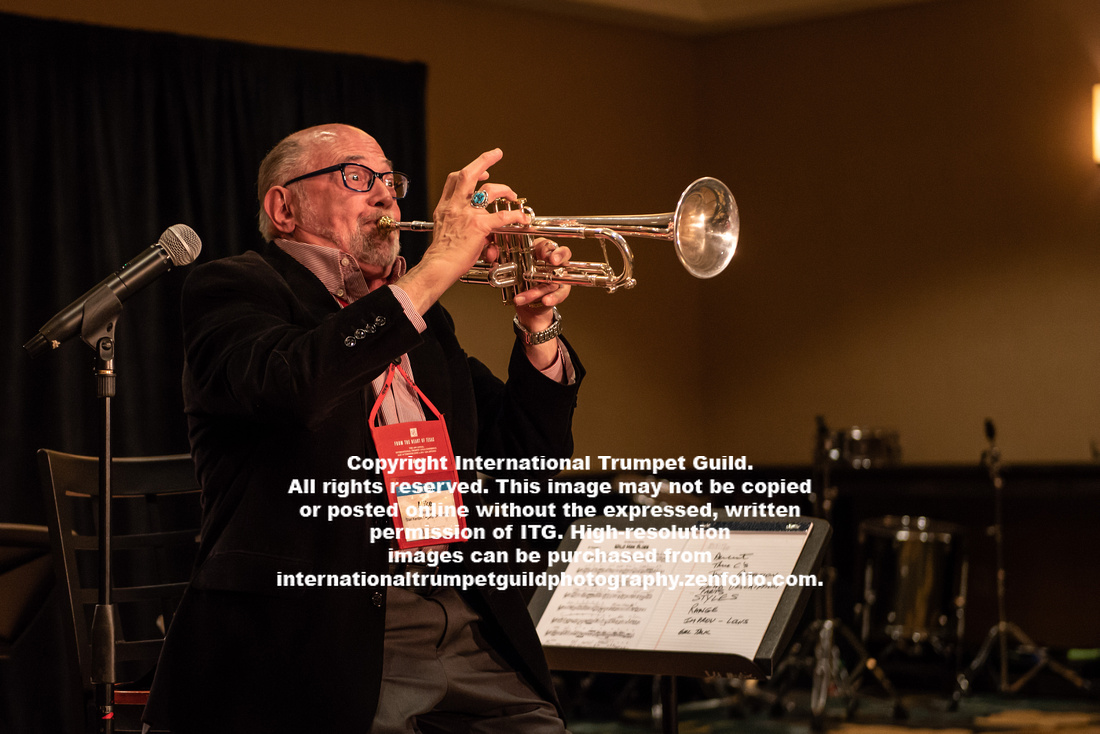 Mike Vax
Mike Vax
Click here for more photos from the ITG Conference
]]>
Special Daily Report • Compiled by Peter Wood
Photos by Michael Anderson, Norman Bergstrom, Josh Rzepka, Denny Schreffler, and Brian Shook
Thursday, May 31, 2018 - Evening events
Click here for more photos from the ITG Conference
Evening Concert—Spanish Brass
The Spanish Brass began the concert with a delightful French Baroque selection that was not listed on the program. Playing from memory while standing in a semicircle, the quintet performed with astonishing artistry and precision. Each member of the group—trumpeters Carlos Beneto and Juanjo Serna, hornist Manalo Perez, trombonist Indalecio Bonet, and tubist Sergio Finca—was featured in fleeting solo passages. Trumpeter Carlos Beneto served as an emcee and provided humorous and informative commentary throughout the concert.
An arrangement of Bach’s Prelude and Fugue in C minor, BWV 549 showcased the amazing technique of tubist Sergio Finca, along with Carlos Beneto’s beautiful flugelhorn playing in the high register. Each member of the quintet was given a chance to shine in Beneto’s arrangement of Verdi’s Overture to La forza del destino. A set of Spanish pieces followed, including Albéniz’s Seguidillas, which featured a gorgeous solo from trombonist Indalecio Bonet and some exquisite soft playing. A particular highlight was the Intermedio from Las Boda de Luis Alonso, which showcased the quintet’s effortless virtuosity, especially the facile flourishes of running triplets.
In a departure from the printed program, the Spanish Brass next performed a medley of songs made famous by the French vocalist Edith Piaf, including “La vie un rose.” A set of three tangos from Argentina followed, including Lluvia de estrellas, which provided a veritable clinic in ensemble technique as members of the quintet traded sinewy streams of sixteenth notes with effortless élan. Beneto’s sultry flugelhorn solos and Serna’s quicksilver piccolo trumpet playing were notable highlights.
Jens Lindemann joined the Spanish Brass for two sextet pieces: an arrangement of Bernstein’s A Quiet Place and the up-tempo Dixieland classic High Society. To introduce the pieces, Lindemann praised the impressive work ethic of the Spanish Brass, saying, “They get their business done,” rehearse on a daily basis, and “become an organism.” He also introduced a new iPad sheet music reading app, Blackbinder (http://www.blackbinder.net), which advances pages automatically without the need for a Bluetooth pedal. The sextet selections highlighted two contrasting styles. In the Bernstein, all of the trumpeters played flugelhorn, and the ensemble’s burnished sound soothed the audience like a warm bath. Jens Lindemann’s sparkling piccolo trumpet was an added attraction in High Society, as all the members of Spanish Brass took a turn in the spotlight.
Ramon Cardo’s jazz-flavored work, Pentabrass, displayed the quintet’s impeccable ensemble precision, while an arrangement of Lee Morgan’s jazz classic, The Sidewinder, closed the official part of the program with some incredible tuba virtuosity from Sergio Finca. A sustained standing ovation followed, after which the Spanish Brass performed two encores. First was a Flamenco-flavored piece that began with Juanjo Serna drumming on the inside of the bell of Finca’s tuba while with the other members clapped rhythmically. The second encore was a blues number that ended with the audience clapping in time as the members of Spanish Brass walked down the center aisle of the ballroom and waved goodbye at the end. (EK)
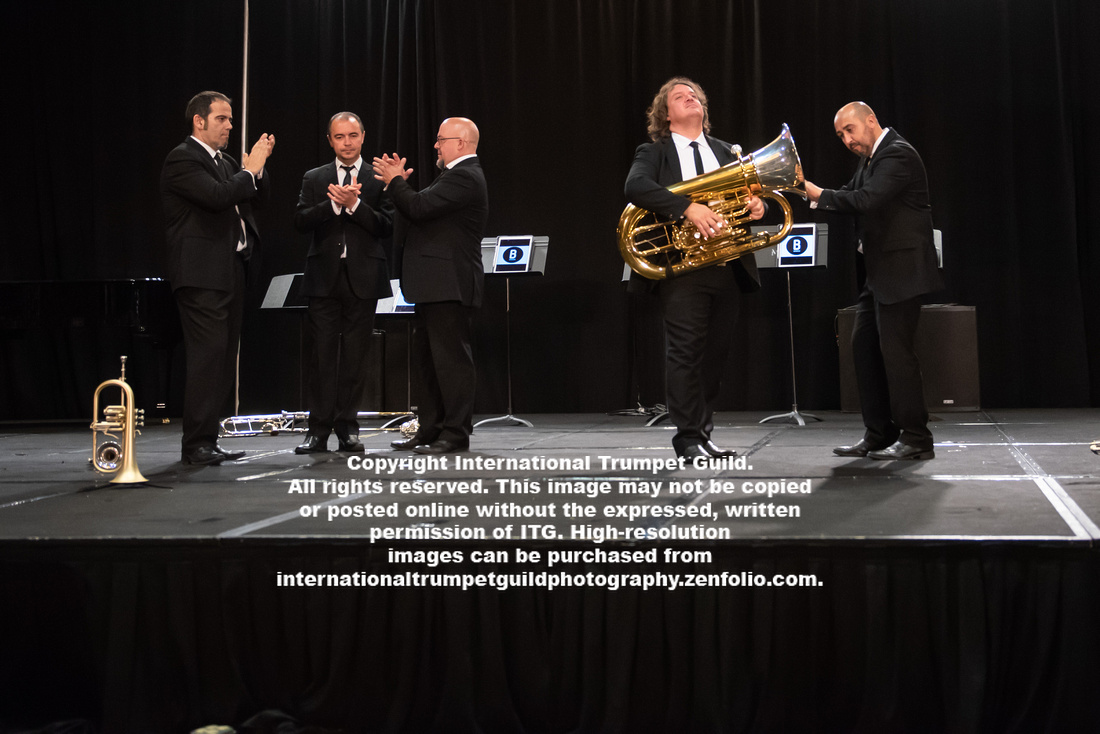
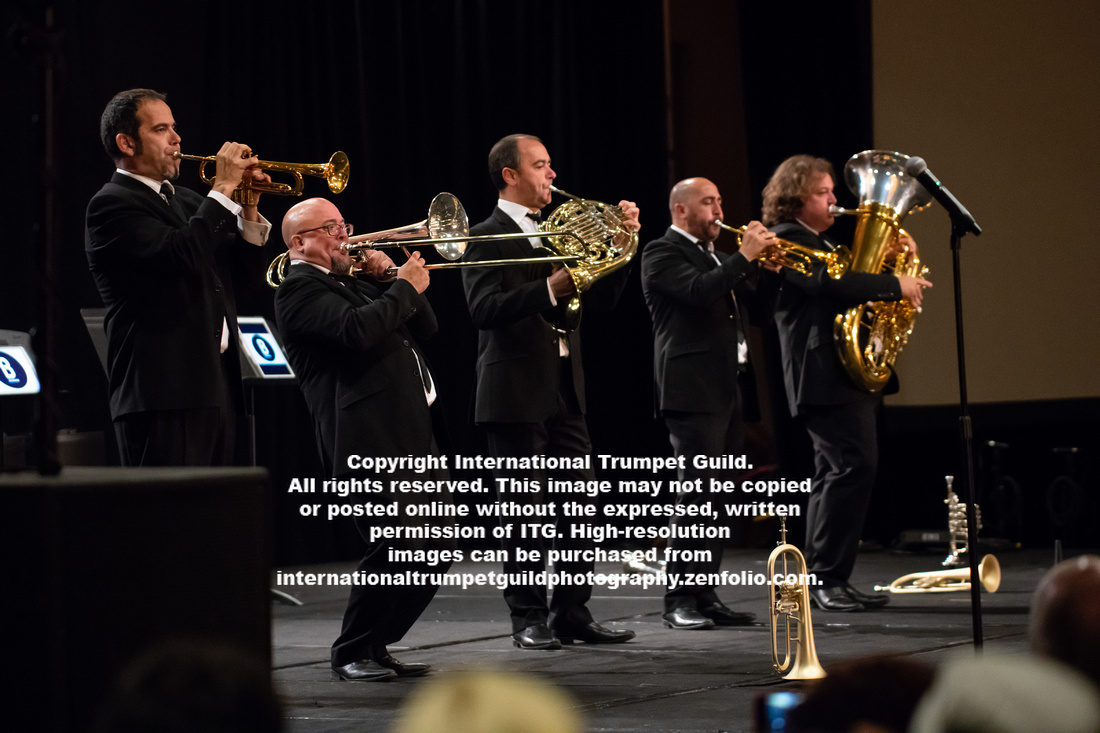
Trumpet Ensemble Reading Session I
Reading sessions are not a regularly occurring event at ITG Conferences; the last one that this author can remember was held during the 2007 ITG Conference at UMass-Amherst. As a result, it was a pleasant surprise when over sixty trumpet players, ranging in age from fourteen to senior citizens, showed up for the first of two scheduled trumpet ensemble reading sessions. Hosted by Buddy Deshler, those present read through and briefly rehearsed four works: Brandon Cave’s Sonder, Jason Aylward’s Voyage, Brandon Dicks’s Clockwork, and Marcus Grant’s arrangement of the Hummel Trumpet Concerto, featuring Garrett Klein of the Dallas Brass as soloist. The “mega ensemble” read at a high level, following each conductor’s instructions. These were challenging works for a reading session! Afterward, players remained for several minutes, interacting and making new friends. A second reading session is planned for Friday night, and it is hoped that this event becomes a yearly event. (KE)
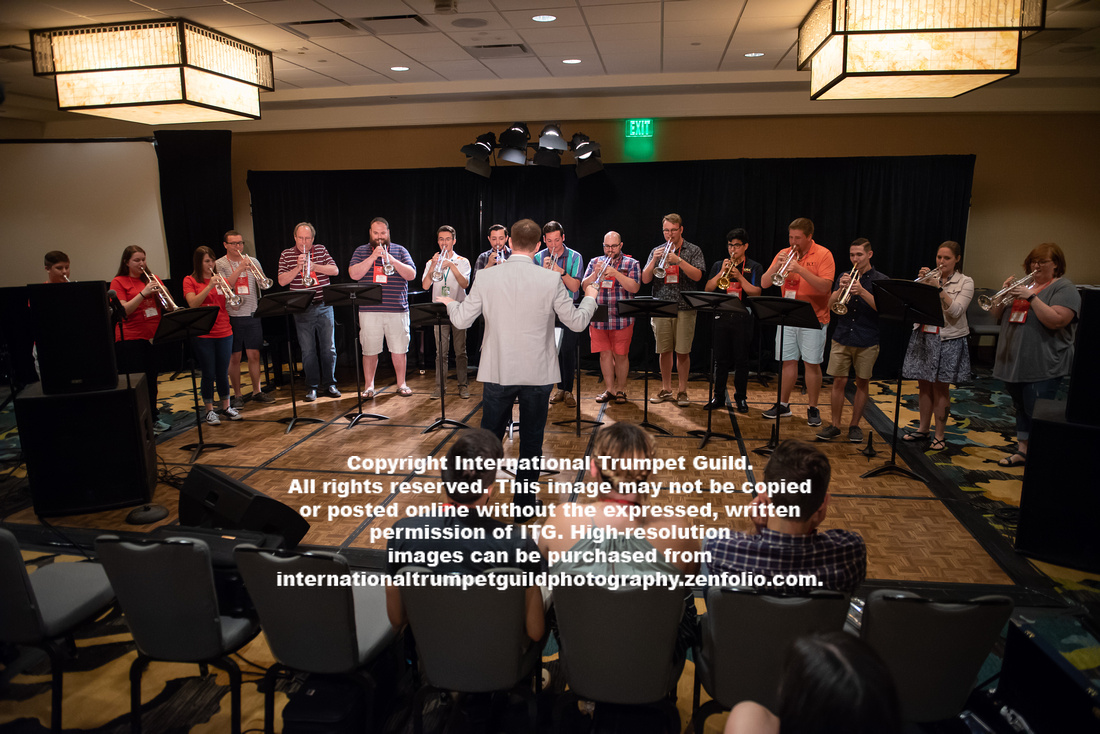
Gordon Au—Evening Jazz Concert: A Century of Jazz Trumpet
Trumpeter Gordon Au provided a fascinating performance as he and the swinging Conference Jazz Trio (pianist Aaron Prado, drummer Kyle Thompson, and bassist Andrew Bergmann) saluted the great jazz trumpet stylists of the last century. Songs associated with those trumpeters were included (i.e., Dippermouth Blues, Concerto for Cootie, and the lesser-known Duke Ellington piece Azalea). Au preceded the playing of each selection with a brief lecture about the trumpeter with a description of that performer’s stylistic approach to jazz (articulation, phrasing, rhythmic approach). In addition to legends King Oliver and Louis Armstrong, Au performed selections in styles of other trumpeters, including “Cootie” Williams, Bobby Hackett, and Dick Cathcart. The ensemble performed the selections in the appropriate musical styles quite accurately. Au was brilliantly able to play each trumpeter’s style and neatly incorporated his own improvisations in each selection. The overall performance highlighted Au’s very fine trumpet playing, performing the styles of all the historical artists in a swinging, reverential, and informative way. (NM)
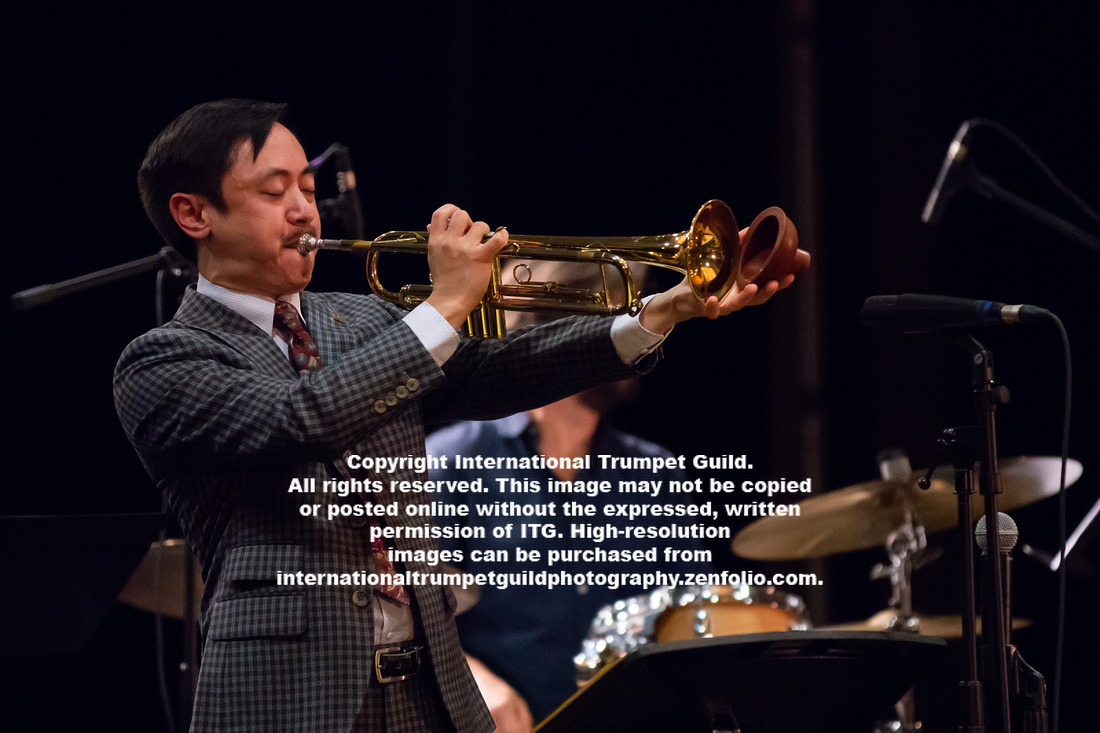 Gordon Au
Gordon Au
Click here for more photos from the ITG Conference
]]>
Special Daily Report • Compiled by Peter Wood
Photos by Michael Anderson, Norman Bergstrom, Josh Rzepka, Denny Schreffler, and Brian Shook
Thursday, May 31, 2018 - Daytime events
Click here for more photos from the ITG Conference
Wayne Bennett—Warm-Up Session: The Five-Points Warm-up & Technical Routine: Building Consistency on a Time Budget
Dr. Wayne Bennett began his warm-up session explaining his Five-Points Technical Routine, which is built on “specific technical points of tone, flow, range, flexibility, and articulation.” Bennett provided a handout of specific exercises within each category. He emphasized that the routine is very adaptable to the amount of practice time available and can include exercises from personal preferred methods. The warmup began with singing a short scale study and then buzzing it on the mouthpiece. Exercises to work on tone and flow included a modified Schlossberg #9 exercise and a modified Cichowicz Flow Study, which he encouraged playing with a drone. Range exercises included scale and arpeggio passages with the emphasis on fluidity and playing easily from low to high. With the remaining points, the player should still be concentrating on tone and flow. The session finished up with a flexibility study from the Bai Lin book and articulation studies that included single, double, and triple tonguing. (JB)
Nancy Taylor—Warm-Up Session
Comparing a warmup to a buffet, Nancy Taylor emphasized that each individual should choose methodologies that work best for them and that address their needs as a player. One important component of this early-morning smorgasbord that can benefit any player’s warmup is face isometrics. Taylor demonstrated several exercises to engage the muscles that form the embouchure that can be done in the car, at work, or anywhere else and can help maintain strength in the corners while spending time away from the horn. In discussing the physical components of playing, Taylor stressed the importance of tongue position for both articulation and playing in all registers with ease and efficiency. She provided several studies that helped the crowd of early risers quickly prepare their chops for a day of playing. Taylor’s variety of approaches provided a well-rounded selection of ideas to incorporate into any warm-up routine. (EM)
Bryan Appleby-Wineberg and Tom Hutchinson Presentation—Cornet Tricks and Quick Answers
Cornet Tricks and Quick Answers was a highly insightful presentation by Bryan Appleby-Wineberg (Rowan University) and Tom Hutchinson (Royal Welsh College of Music and Drama), focused on how to approach one’s development on the cornet. The presentation highlighted numerous aspects of cornet and brass band performance, including sound, vibrato, equipment, and showed how outsiders of this community can begin to understand the idiosyncrasies of this genre. Both Appleby-Wineberg and Hutchinson shared personal stories about their experiences performing in brass bands and competitions and talked about how they each approach finding their own sounds on the cornet. (JPS)

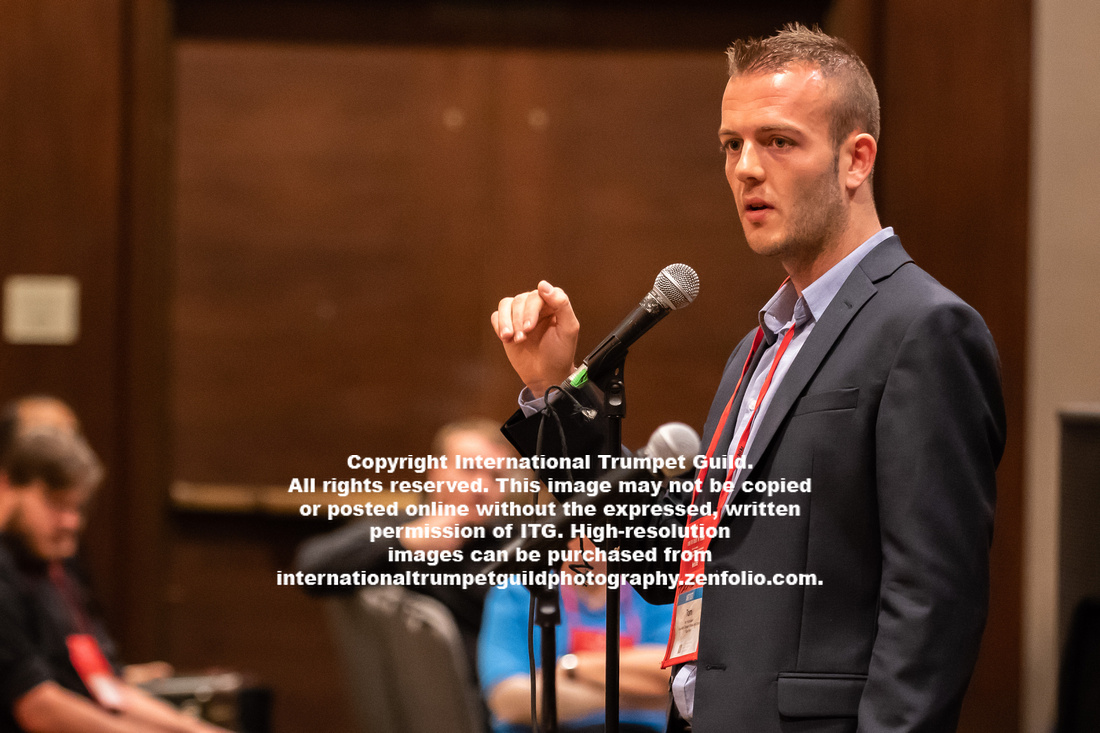
David Vining—Non-Pro/Comeback Player Presentation: Using Body Mapping to Prevent Injury and Become More Efficient
David Vining, professor of trombone at Northern Arizona University, brought his engaging pedagogy and expertise on body mapping, or learning the truth of how our bodies are constructed and how we are intended to move, to promote more efficient and healthier brass playing. By focusing on replacing compromised breathing with efficient, relaxed breathing, brass players can eliminate tension in their playing while developing a quality sound and ease of playing. Vining discussed how body mapping empowers the individual to refine his/her own movements based upon personal exploration. Vining focused on the self-exploration and self-awareness needed to determine how a player’s fluid, personal balance differs from the stagnant exterior look of good posture. Vining discussed his personal journey with focal dystonia and how his knowledge of and journey through body mapping discovery helped him overcome his struggles and led to his teaching the technique as a mechanism for injury prevention. (AJ)
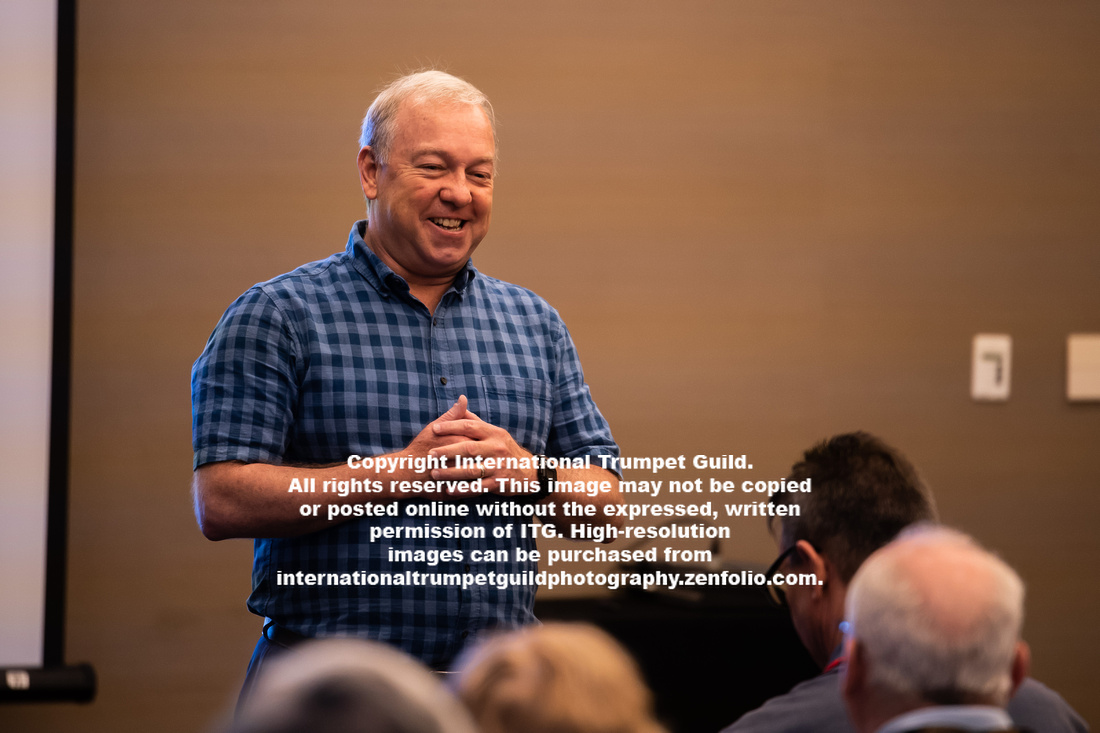
ITG Orchestral Excerpts Competition Finals
The final round of the ITG Orchestral Excerpts Competition was a superb presentation of trumpet playing as each competitor performed a diverse and challenging list of standard excerpts. The first finalist to perform was Nick Nusser (student of Ryan Gardner at Oklahoma State University), who demonstrated excellent musical style. He performed Donizetti’s Don Pasquale with a beautiful sound that was filled with musical expression. Maximillian McNutt (student of Scott Thornburg at Western Michigan University), the second finalist to perform, exhibited exceptional power and beauty throughout each excerpt, particularly in his captivating performance of the opening solo from Mahler’s Symphony No. 5. Ian Mertes (student of Ryan Gardner of Oklahoma State University) was the third and final competitor to perform. He displayed a brilliant sound with great musicality on each excerpt. He presented Bach’s Magnificat with great finesse and beauty on the piccolo trumpet. The judges for this final round of the competition were John Carroll, principal trumpet of the San Antonio Symphony; Philip Smith, professor of trumpet at the University of Georgia and former principal trumpet of the New York Philharmonic; and Marie Speziale, former associate principal trumpet of the Cincinnati Symphony Orchestra. (JBr)
New Works Recital II
Mervin Tay’s Timeless for trumpet and piano includes a lively opening inspired by Alexander Goedicke’s Concert Etude but then deeply explores the lyrical capabilities of the trumpet with lush harmonies. David Amlung presented a beautiful performance that also included a few very lontano Harmon-muted notes that almost sounded as if they were in a different room. This very accessible new work in terms of technical demands and harmonic palate has considerable appeal. (LE)
Performed by Doug Lindsey on E-flat trumpet, Brett Miller’s Running from the Rain evokes a reflective and pensive mood, inspired by the composer’s being caught in a storm while on a bike ride. Miller used that musical imagery to represent times when people are running from things in their own lives. Lindsey and pianist Miriam Hickman’s playing artfully captured the essence with the nimbleness of the melody, creating a light and nervous texture, all while conveying the depth of the subject to the listeners. (KM)
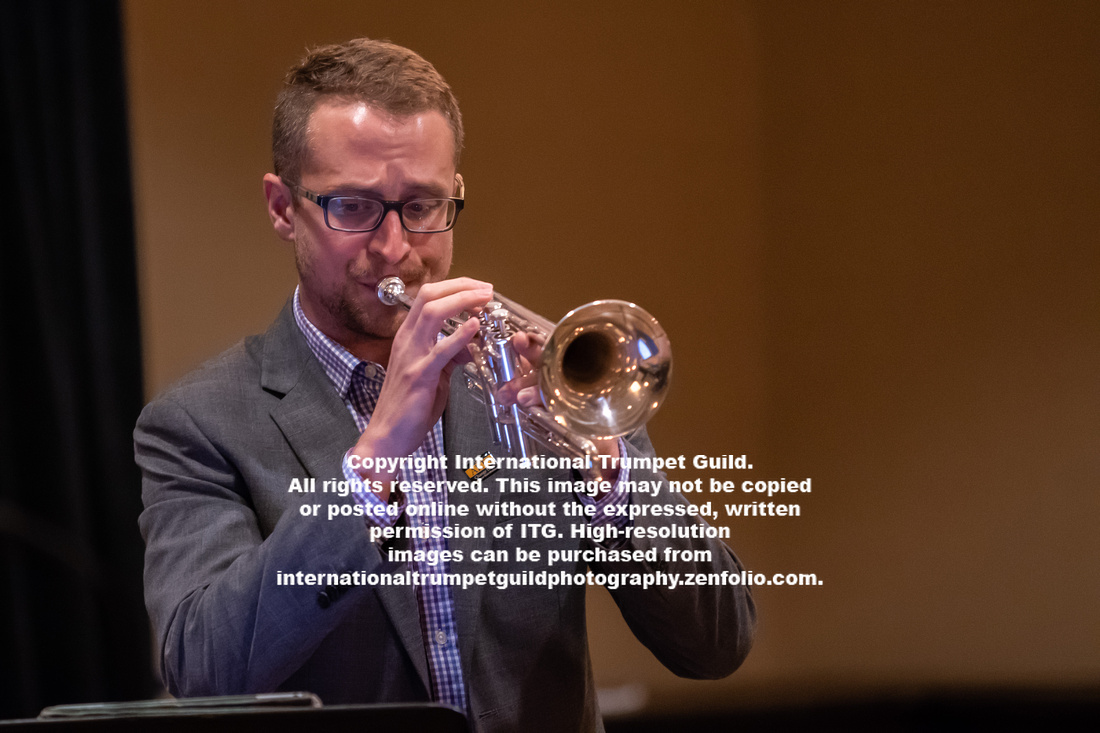
In five short movements, Michael Cotten’s Song Cycle for Trumpet Unaccompanied provides great diversity of style between the movements. These include a bold opening with “A Tale Begins,” flowing technical sections in “Butterflies in the Redwoods,” folk-like melodies in “Flowering Song,” a cheeky excursion with “A Waltz Remembered,” and a dramatic conclusion with “The Tale Ends.” With a well-paced performance, Marisa Youngs enhanced the stylistic differences in each part of the story. (LE)
Beginning with a simple quarter-note pattern, Justin Rito’s Circadian Rhythm, performed by Josh Ganger on flugelhorn and Miriam Hickman on piano, seemed unassuming. As it developed, it cycled through a variety of moods and rhythmic foundations that were communicated effectively by the performers. Throughout the middle, there was a sense of rushed expression with Ganger moving with the melody through wild lines in the flugelhorn’s upper register and Hickman’s quarter-note rhythm turning to incomplete triplets. To complete the cycle, the work calms back down, ending similarly to how it began. (KM)
Soloist and composer Stanley Curtis has been composing works based on stained glass windows at his church for several years, and his Advent for soprano, trumpet, and piano follows this trajectory. The lyrics are taken from “Advent” from The Back Chamber by Donald Hall, and the music included many cantabile melodies for the trumpet and interesting textures as Curtis and pianist Benjamin Keseley often joined forces to accompany soprano Tia Wortham. This mature work was presented with an exceedingly polished performance. (LE)
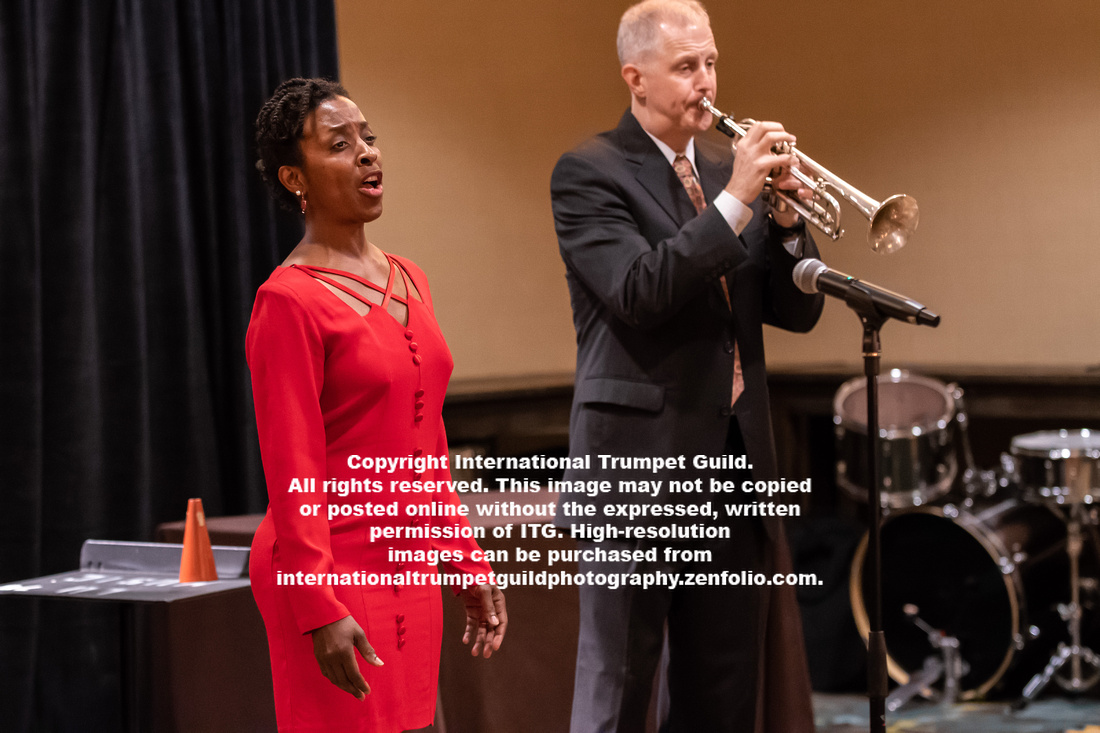
The final piece of the recital was Brendan Collins’s Sonata for Trumpet and Piano, performed by Garrett Klein on trumpet and flugelhorn and Miriam Hickman on piano. Klein chose to perform the third movement on flugelhorn, an option suggested by Collins. The first movement focuses harmonically around the perfect fifth, highlighted in the opening chorale before moving into the rest of the movement. Rhythmically, the first two movements allowed Klein and Hickman room to showcase the interplay expected in a sonata, with lots of vitality in the melodic motives. The second movement is significantly shorter than the outer two and has a fun character. The third movement is the most different, with its tender character, and is very well suited to performance on the flugelhorn. (KM)
Recital: Philippe Litzler
Rebecca Wilt joined Philippe Litzler, solo trumpeter for the Zurich Tonhalle Orchestra, in a beautiful recital. He began his performance with Joseph Haydn’s Trumpet Concerto in E-flat, which included a dazzling third movement that highlighted Litzler’s technical prowess and musicianship. Next came Guy Ropartz’s Andante and Allegro, a standard from the French conservatoire repertoire, which Litzler handled with ease. Litzler concluded his recital with sonatas by Karl Pilss and Jean Hubeau. Both challenging in their own right, Litzler performed them with grace and agility. The audience was even treated to a surprise encore of Thorvald Hansen’s Romance. (BC)

Recital: José Cháfer Mompó—Musical Connections
José Cháfer Mompó’s Thursday afternoon recital featured two world premieres. Accompanied by pianist Rebecca Wilt, the opening concerto by Brendan Collins was a tasteful demonstration of Chafer’s superb musicality and command of the instrument. The first of the premieres was also composed by Collins. Entitled José Suite, in honor of Cháfer, the piece consists of six brief movements in which the artists effortlessly transition between unrelated characters, scenes, and moods. Ramon Garcia Soler’s Lyric Outline was specifically written for this year’s conference and featured Cháfer gracefully navigating the upper tessitura during several expertly crafted moments with his pure, resonant sound imbuing each corner of the room with tenderness and longing. Technical prowess and mastery of the flutter tongue were on full display during Artaza. Brian Evans joined Cháfer on stage to close this performance with a lovely duet that was composed originally for cello, clarinet, and piano. (AD)
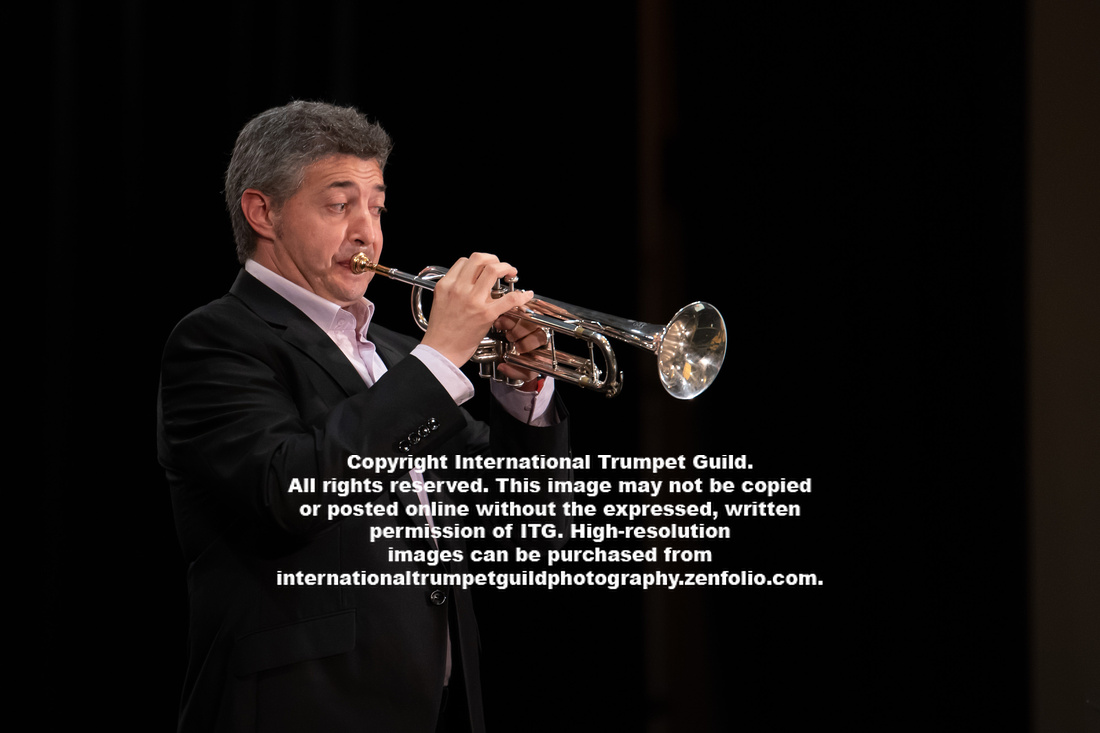
Bert Truax Presentation—Sometimes The Magic Works! And Sometimes It Doesn't…
Bert Truax opened his session with a colorful rendition of Phil Snedecor’s Lyrical Etude no. 1, illustrating the concepts and techniques he has learned over the years to keep his playing on track and survive as a professional trumpet player. Truax was a student of both Bill Adam and James Stamp and talked about those two schools of thought, stressing that it is the result that is important. Truax shared his ideas for playing and teaching a sound that is pure, focused, and vibrant and invited players to come up and try some of these techniques. He advised students to “Find people you admire and get that sound in your head. An ITG conference is the perfect place to do that.” Truax looked back over his long career with the Dallas Symphony Orchestra and as a freelance trumpeter and said, “We all have things that happen in our lives. I’ve had wonderful successes and magnificent failures.” The audience was given a quick but thorough look at how to practice fundamentals to develop and maintain a high level of performance. The session was lively and fun, with t-shirts being tossed to audience members who correctly answered questions during the talk. The presentatIon was subtitled “A thoughtful discussion with Bert Truax,” and he left us with some meaningful reflections. “We are all trumpet geeks, but at the end of the day, it’s all about the music. We all have a gift from God to raise people up with music. Even in ‘Nowhere, Texas,’ we can play from the heart. It’s all joy; it’s all about the music.” (LAH)
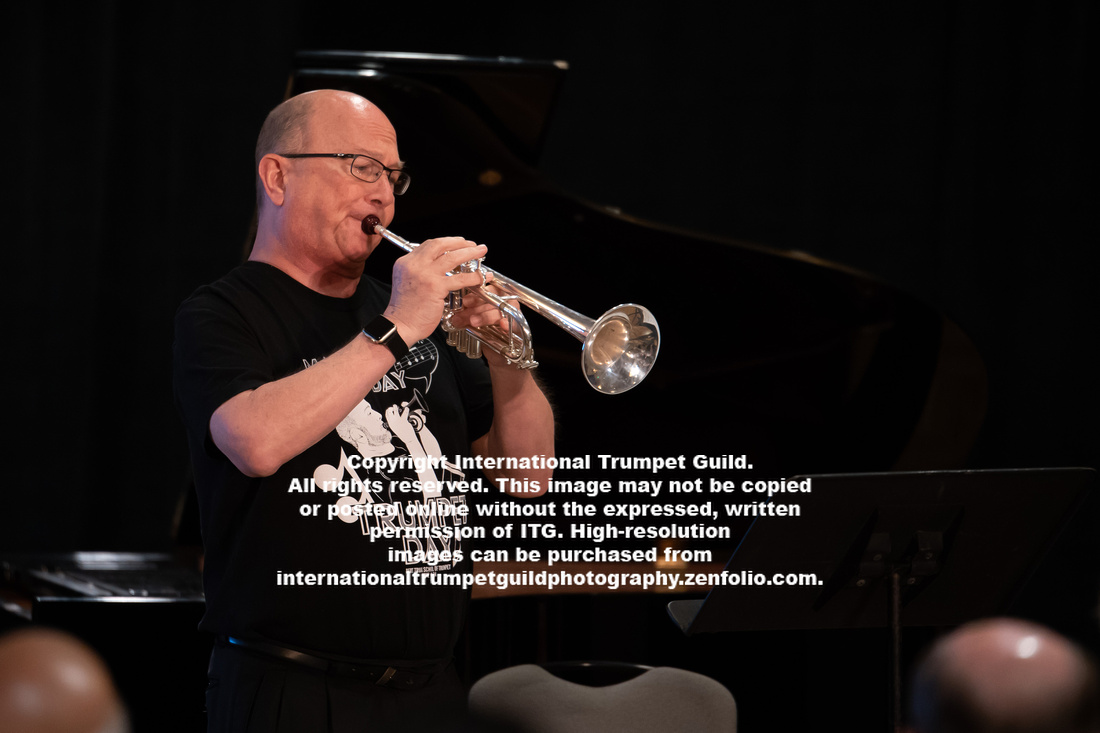
Masterclass: Philip Smith
In typical fashion, Phil Smith captivated the ITG audience with his magnificent sound and engaging personality. This particular masterclass featured the three finalists from the ITG Orchestral Excerpts Competition (Ian Mertes, Nick Nusser, and Maximillian McNutt). Each finalist chose several excerpts to perform, and Smith coached various aspects of technique and musicianship. In some instances, he gave intense technical instructions and dissected an excerpt down to a single note. Other times, he simply instructed the participant to evoke detailed mental imagery and to sing the passage in a lyrical fashion. A master teacher, Smith gave constructive criticism to these talented performers and also encouraged questions from the audience, answering with sincerity and his hallmark dry sense of humor. He concluded the session by stating that the most important aspects of performance are imagination and sound--a concept we can all take to heart. (MY)

Recital: ITG Affiliate Chapters
The ITG Affiliate Chapters Recital was a fantastic part of the conference’s Thursday activities. The music performed during the recital was diverse and engaging, ranging from duets from the Renaissance adapted and edited for two trumpets to an arrangement of Wagner’s Elsa’s Procession to the Cathedral for thirteen trumpets. There were also two world premieres, and many other charming works. Those in attendance enjoyed the variety of music that was heard, and the program was a delightful example of how the ITG Conference can contribute to the sharing of music and bringing musicians together.
Seretta Hart and Peyden Shelton performed three selections from the Six Fancies for Two Treble Instruments by Orlando Gibbons. Their exciting and enjoyable performance demonstrated exceptional technical facility and musicality as they navigated the intricate rhythms and polyphony of the newly edited and published Renaissance duets.
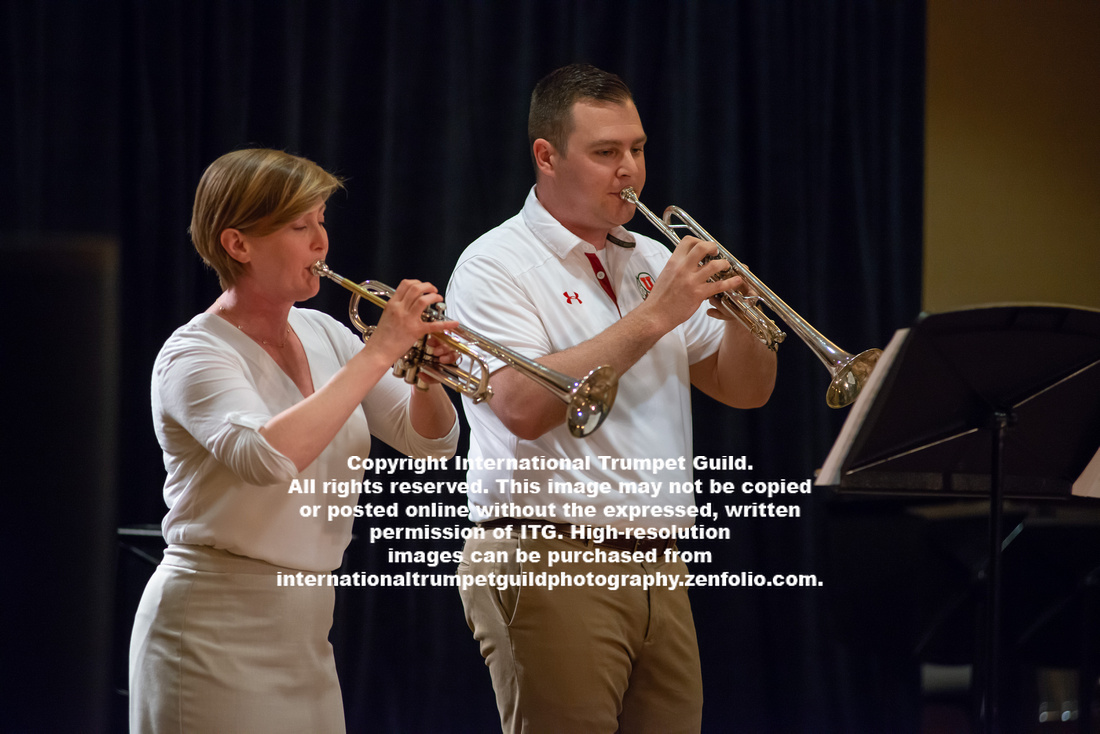
The Alabama Trumpet Guild performed the world premiere of Jeffrey Boehm’s Henrietta Park. This piece was written for six trumpets and has both jazz and classical styles intertwined throughout. The ensemble developed many different colors on this piece that contrasted solemn harmonies with brighter swing sections.
The Arkansas Trumpet Guild quartet put on a pleasing performance of Fisher Tull’s Canonical Trilogy. The group produced a well-blended sound and perfectly captured the playful aspect of the music.
The quartet from the Cincinnati Trumpet Guild played an exciting arrangement of Edvard Grieg’s Quartet in G Minor Op. 27. Each member of the ensemble demonstrated great technique.
The Lone Star State Trumpet Guild gave the world premiere of Bernard Scherr’s new work, Just Stand Up and Play. The work was performed by ten trumpeters, including the composer. The music consisted of brilliant fanfares and cascading musical lines juxtaposed across the ensemble and was a splendid contribution to the program.
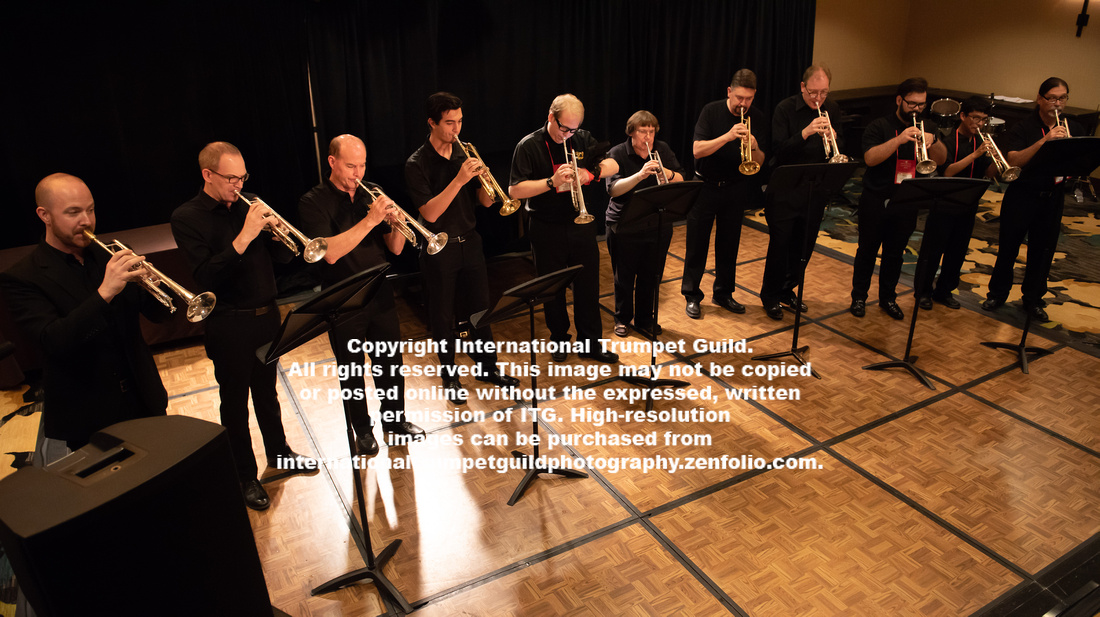 An Overture and a Finale by Ronald Lo Presti was performed by the Louisiana State University Trumpet Guild, which consisted not only of students, but also of alumni and family members. The blended sound of the ensemble was rich and full, and the music had a pleasant modern flair.
An Overture and a Finale by Ronald Lo Presti was performed by the Louisiana State University Trumpet Guild, which consisted not only of students, but also of alumni and family members. The blended sound of the ensemble was rich and full, and the music had a pleasant modern flair.
The recital finished with the Texas A&M University – Kingsville Trumpet Guild’s performance of Richard Wagner’s Elsa’s Procession to the Cathedral, arranged by Kyle Millsap. The playing of the thirteen-member ensemble was superb, as the piccolo trumpets soared over the rich sound of the trumpets and flugelhorns. The lyrical Wagnerian melodies filled the ballroom and was a terrific finish to the recital. (SW)
Andrew Stetson Presentation—Unlocking the Teaching and Recruiting Power of Social Media
Dr. Andrew Stetson discussed how his use of social media with his studio at Texas Tech University—particularly various group pages on Facebook—has helped build a sense of community that fosters positive feedback, helps students work on conquering performance anxiety, and increases students’ ability to comment critically. With approximately ninety percent of prospective students using Facebook multiple times throughout the day, Stetson has been able to influence a larger audience that has benefited not only his current students, but also his recruiting. Stetson also discussed how the use of Facebook Live video has been able to impact his recruiting and reach a larger audience that may not be able to visit campus. This ability has enabled him and his studio to gain extra feedback from people around the world. (AJ)
Lecture Recital: Markus Würsch—The Keyed Trumpet: From Anton Weidinger’s Lost Innovations to Modern Reproductions
Markus Würsch, assisted by Shari Santorelli on piano, gave a well-attended lecture-recital consisting of literature that was originally written for the keyed trumpet. Andrew Evans, from the University of Sydney, assisted in providing much of the lecture aspect of this fascinating event. Evans detailed the biography of Anton Weidinger, trumpet virtuoso and developer of the instrument, and provided historical context for the works for keyed trumpet. Würsch, from the University of the Arts in Bern, Switzerland, performed a movement of both Haydn’s and Hummel’s concertos, complete with edits attributed to Weidinger himself. Würsch was keen to discuss the natural trumpet’s design flaws that create nearly impossible tuning and accuracy challenges on certain notes, even for a world-class soloist like himself. He also performed several lesser-known works for the keyed trumpet, and the duo ended by allowing audience members to try modern reproductions of this curious instrument. (BH)

Click here for more photos from the ITG Conference
]]>
Special Daily Report • Compiled by Peter Wood
Photos by Michael Anderson, Norman Bergstrom, Josh Rzepka, Denny Schreffler, and Brian Shook
Wednesday, May 30, 2018 - Evening events
Click here for more photos from the ITG Conference
Non-Pro/Comeback Players Reception
The non-professional/comeback players make up an important subset of the International Trumpet Guild. I believe that they may look forward to our annual conferences more than any other group within the Guild. For years I hesitated to call them amateurs--especially since many of them perform more frequently than I do--until I was reminded that the word “amateur” comes from “amare,” which means “to love.” These folks LOVE the trumpet! And they love to spend time together, whether as a trumpet ensemble or at a reception at the Q Bar. Dan Hallock, chair of the Non-Pro/Comeback Players Committee, spoke enthusiastically at the reception about events yet to be held during this week’s conference and about events already planned for the 2019 conference in Miami, Florida. ITG President Cathy Leach thanked the group for their continuing involvement in ITG. (KE)
San Antonio Brass Band: World-Class Soloists--Concert
The concert began with the San Antonio Brass Band performing Paul Lovatt-Cooper’s Enter the Galaxies. The SABB, led by John Carroll, gave its inaugural performance on March 26, 2017, and a little more than a year later took first place in the Section 1 category of the 2018 NABBA Championship. The opening work and Philip Sparke’s The Year of the Dragon, performed later in the concert, left no doubt as to why. The band had a very impressive blend and balance.
The first of five “guests” to perform with the SABB was Wiff Rudd, trumpet professor at Baylor University. He performed Papa Joe Concerto by Scott McAllister, professor of composition at Baylor. Anyone familiar with Rudd’s Collaborative Practice Concepts book would recognize snippets from warm-up and practice exercises contained therein, now transformed into melodic motives for the three-movement work.
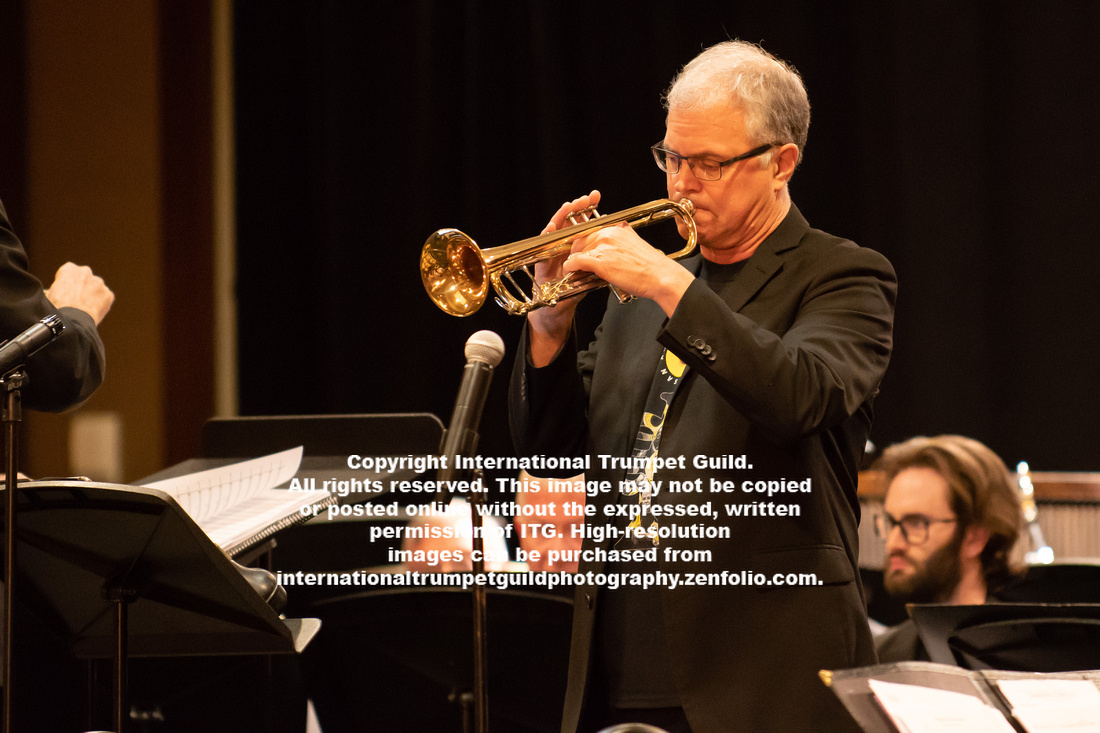
The two pieces performed by Bryan Appleby-Wineberg, professor of trumpet at Rowan University, showcased the most notable characteristics of the cornet. The joyful, florid passages of Peter Graham’s Glorious Ventures, followed by the beautiful tone and lyrical capabilities featured in Ivor Bosanko’s arrangement of Joy Webb’s Share My Yoke, provided ample opportunity for Appleby-Wineberg to demonstrate his remarkable prowess in this medium.
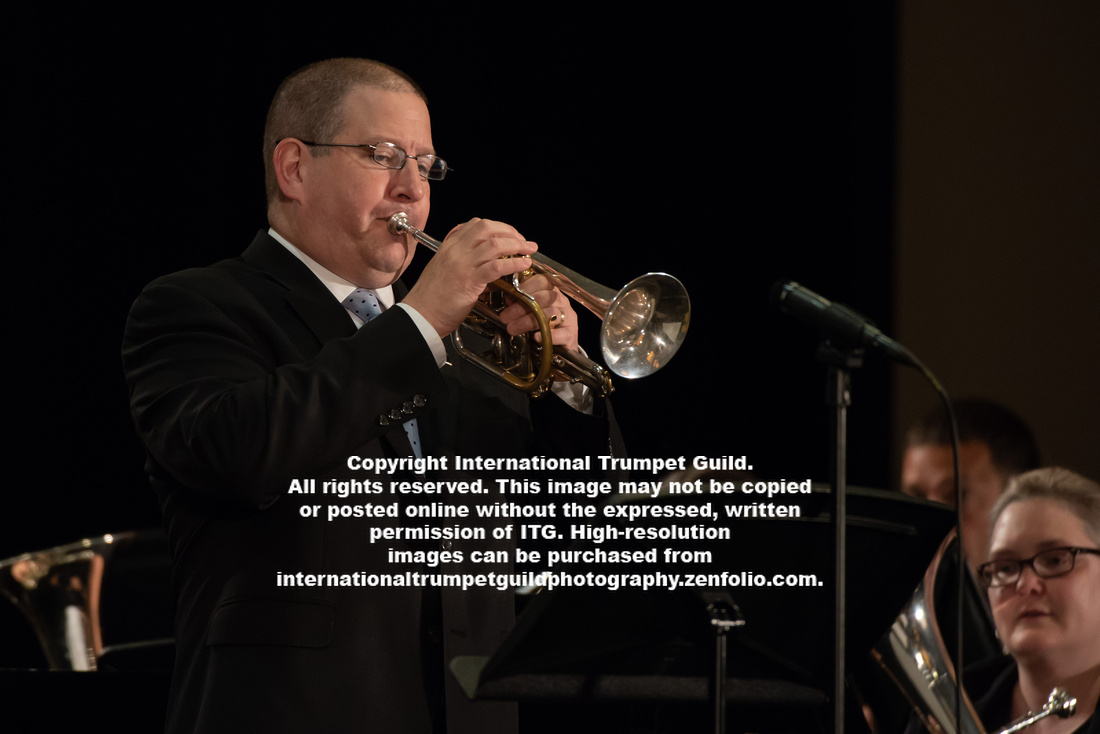
Rex Richardson never fails to dazzle his audiences, playing works that few would attempt. His performance of Allen Vizzutti’s Three World Winds proved the perfect vehicle for his considerable talents. Richardson is a member of Rhythm and Brass and the Brass Band of Battle Creek and has become a solo trumpet artist renowned for both his jazz and classical playing.
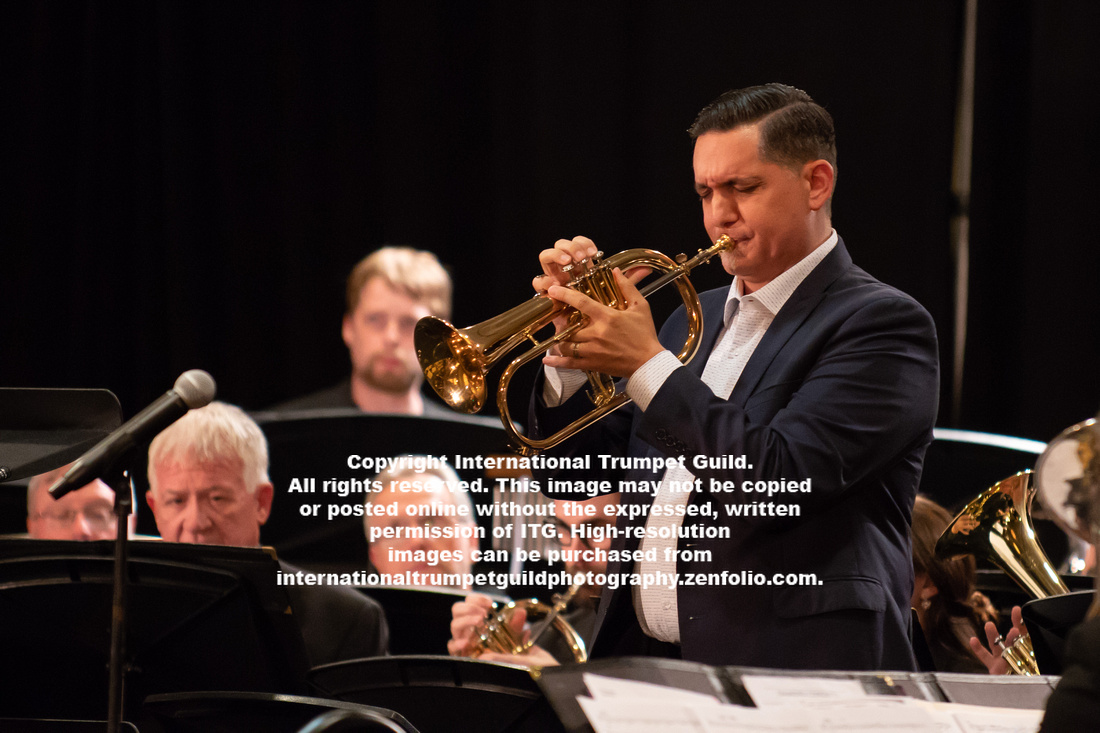
Up to this point in the program, the master of ceremonies read extensive bios to introduce each of the soloists. For the next soloist, however, he merely said, “Ladies and gentlemen, Phil Smith.” For members of ITG, Smith is someone who needs no introduction. The two works he performed were Robert Farnon’s Scherzando (arranged by Mark Freeh), followed by the now-famous arrangement by Joseph Turrin of George Gershwin’s Someone To Watch Over Me (brass band adaptation by Jeff Christmas). As the last note of the Gershwin faded, murmurs of appreciation could be heard from many of those present, followed by applause filled with the respect felt for this legendary performer.
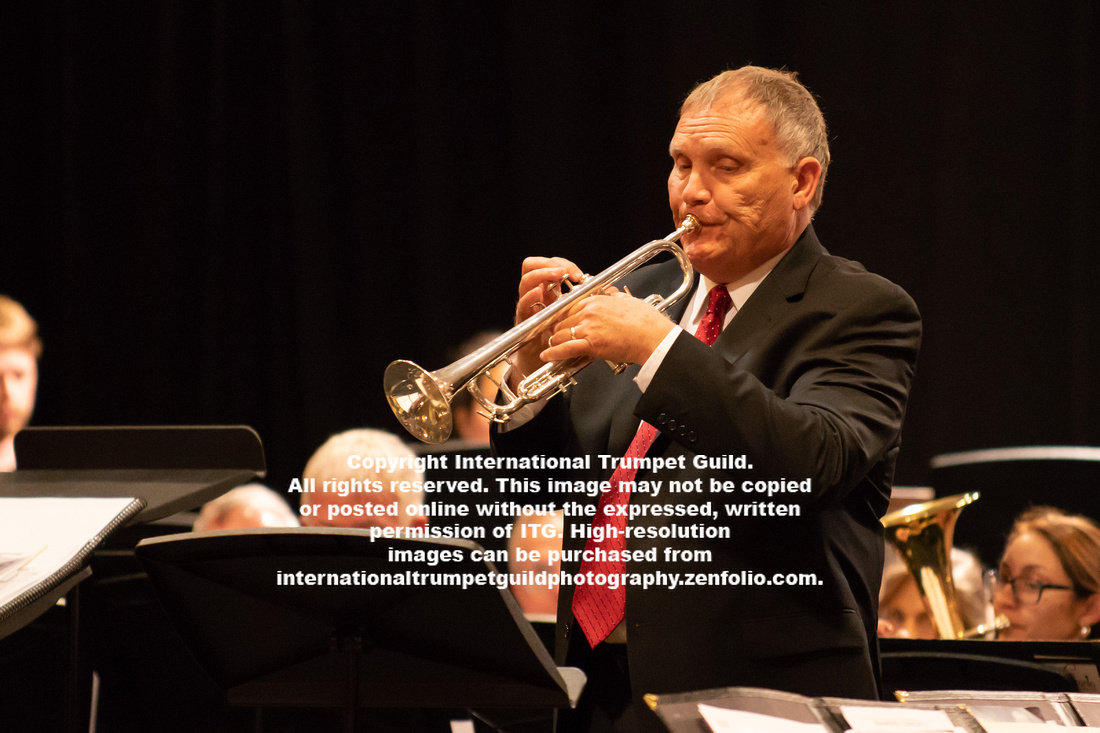
The highlight of the evening was the performance by the British Tom Hutchinson, principal cornetist with the Cory Band. He performed three works. From the first notes of Edward Sutton’s The Paragon, Hutchinson demonstrated his incredible sound and great facility, making this piece look and sound easy. The audience savored his rendition of Leonard Ballantine’s Don’t Doubt Him Now (arranged by Craig Woodland) by waiting several seconds after the final note before erupting into thunderous applause. Hutchinson ended his portion of the concert with the lively James Benedict/Harry James version of Carnival of Venice, arranged for brass band by Mark Freeh.
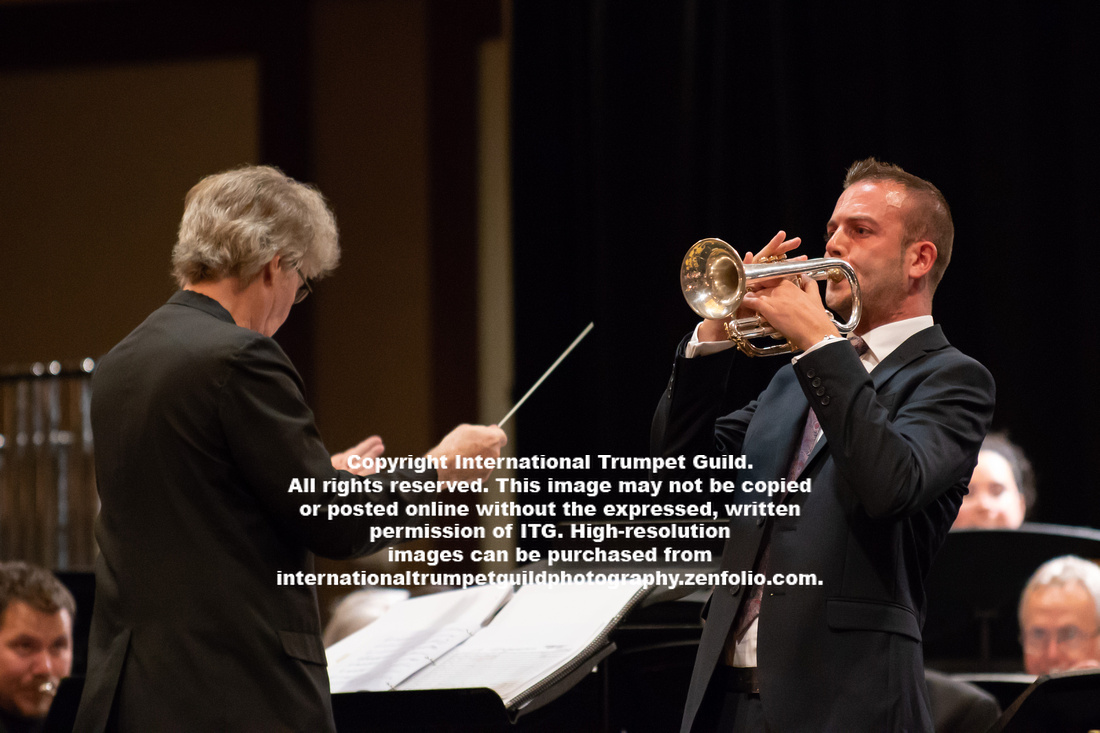
The final work brought all of the evening’s soloists back to the stage to perform the Rafael Méndez arrangement of Las Chiapanecas. As is often the case with these types of performances, the concert was a bit long at 2-½ hours, but I can’t think of a single piece that should have been sacrificed. (KE)
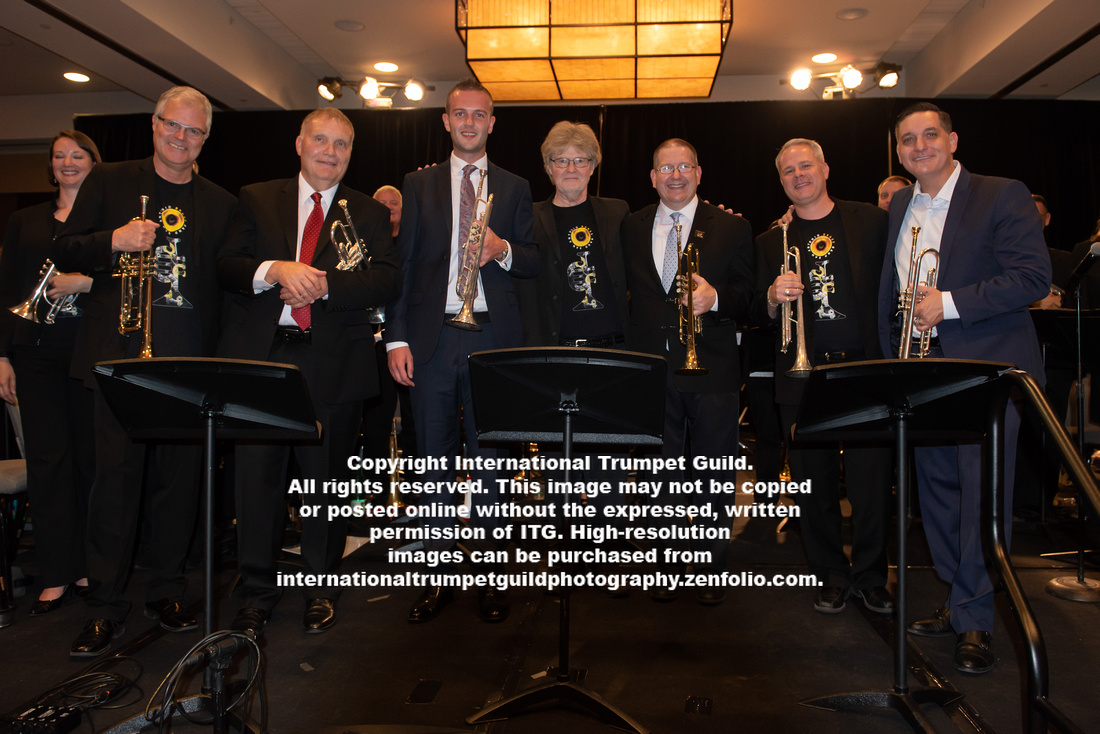
INSIDE OUT Duo: Markus Stockhausen and Florian Weber--Concert
The duo offered seven unique selections, each one a tone-poem of textures, rhythmic variety, and extended, brilliant free improvisation. Having performed together for a decade, these musicians were hand--in-glove throughout the entire stunning performance. The first piece, Zephir, set the tone for the evening. Using his lush flugelhorn, Stockhausen, who composed most of the evening’s selections and is more a minimalist, played lush long tones juxtaposed with rapid runs into the upper register, all while Weber accompanied with lush block chords and punctuated fills. Stockhausen’s command of the flugelhorn and trumpet was obvious through Weber’s gorgeous The Wise Magician, the joyous uptempo Liberation, and the hymn-like Our Father. Not in Vain, another of the textured poetic character, showed the artist’s Harmon-muted trumpet interplaying with Weber’s entrances and his own extended tacets. They concluded the performance with Jahoo, a faster effort which added piccolo trumpet. Their encore was Always Hope, a beautiful balladic piece which once again offered lushness, intensity, and innovative playing by the duo. (NM)
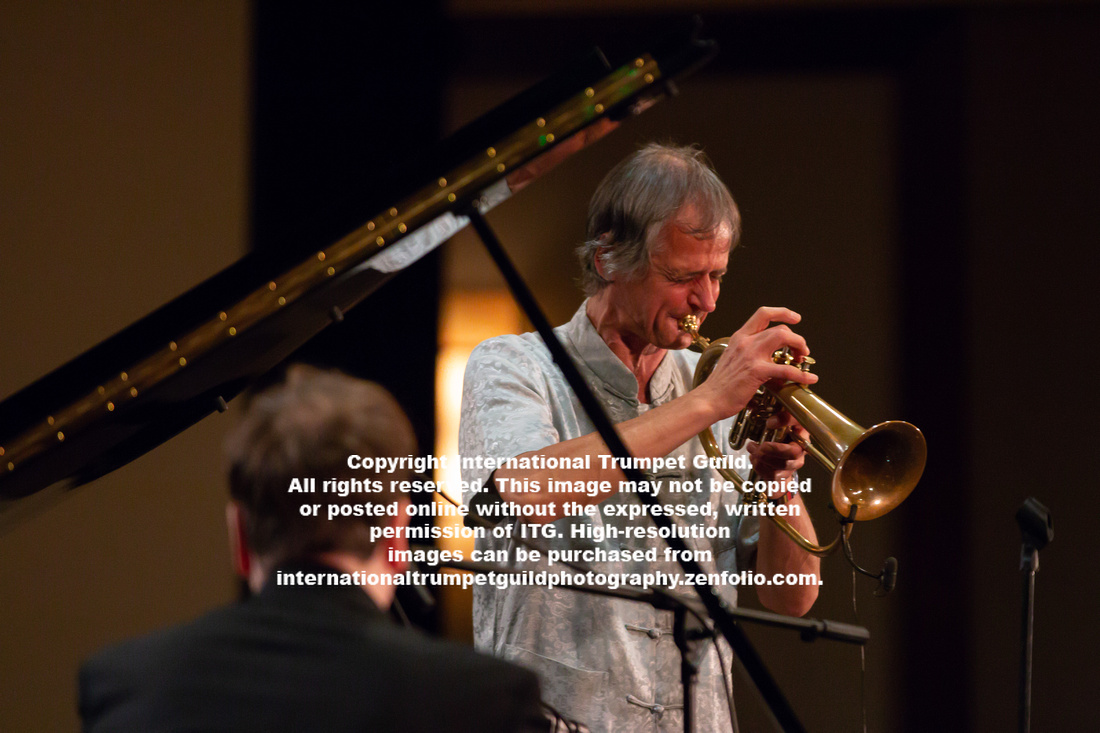
Click here for more photos from the ITG Conference
]]>
Special Daily Report • Compiled by Peter Wood
Photos by Michael Anderson, Norman Bergstrom, Josh Rzepka, Denny Schreffler, and Brian Shook
Wednesday, May 30, 2018 - Daytime events
Click here for more photos from the ITG Conference
John Irish—Non-Pro/Comeback Players Warm-up Session
Bright and early on the first morning of the conference, John Irish led an engaged audience of non-pro and comeback players through a warm-up session. Irish’s routine focused on the core fundamentals of playing in a streamlined progressive approach. The interactive presentation had the group on their feet with breathing and buzzing exercises to get the body and lips prepared to play for the day. Irish emphasized the importance of air flow, centering, and tone and demonstrated several exercises to help improve each of these areas. The handout provided offered clear explanations and straightforward drills to focus on the concepts he discussed. Irish also invited Bert Truax to share some thoughts, and both fielded numerous eager questions from the audience. Irish closed with a quotation by Aristotle reminding everyone that “We are what we repeatedly do. Excellence, then, is not an act, but a habit.” (EM)
Anne McNamara—Warm-up Session: Keeping Your Warmup Fresh with SAFARE
Dr. Anne McNamara (Campbellsville University) presented a well-organized and informative warm-up session. SAFARE is the mnemonic developed by David Bilger (principal trumpet of the Philadelphia Orchestra) for covering the many components of one’s playing, which should be covered every day--sound, articulation, flexibility, agility, range, and endurance. Exercises in each of these six areas were presented in a collaborative approach with McNamara demonstrating and the audience imitating. In “sound,” the concept of sing-buzz-play was emphasized. The use of such tools as drones and a metronome were encouraged to be used as part of a practice routine. The thorough handout and PowerPoint presentation made the session easy to follow, and the attendees were provided with excellent information and suggestions to incorporate into their daily routines. (JB)
John Irish—Non-Pro/Comeback Players Masterclass
John Irish’s masterclass served as a seamless continuation from his morning warm-up session, focusing on a centered sound, strong embouchure, and consistent airflow. Irish utilized a succinct and well-organized packet of exercises, intended to be a “home base” of practice goals and techniques for players of all levels. The majority of the masterclass featured “air flow connection” and articulation exercises, with the main goal being a strong, consistent airstream. Irish modeled these exercises and then led the audience in group performance and encouraged volunteers to play individually. One very helpful demonstration included two volunteers: one blowing into the trumpet with the other reaching over and striking the valves. In each instance, the performer’s sound noticeably improved and received instant applause from the audience. Irish effortlessly created a relaxed and encouraging atmosphere while outlining clear and practical performance objectives that surely benefited all in attendance. (MY)
ITG Honorary Award Presentation: Marie Speziale
Organized by Wendy Matthews and Ryan Gardner, this lively and informative session celebrated the career of 2018 ITG Honorary Award recipient Marie Speziale, who was the first woman to earn a trumpet position in a major symphony orchestra when she joined the Cincinnati Symphony in 1964. Wendy Matthews interviewed Speziale and presented a slideshow that included photos, audio clips, and video from her career. Speziale also conducted a large trumpet ensemble comprised of former students, colleagues, and friends in performances of Eric Ewazen’s Concert Fanfare and Arthur Gottschalk’s 220 S. Michigan Ave. Notable highlights included clips of Speziale performing Napoli as a teenager and Java on a TV show in 1965 and of her work with the Cincinnati Symphony. From her debut with her father’s dance band at the age of eleven to tributes from her accomplished students affectionately referring to her as “Mama Bear,” the audience was treated to an entertaining display of Speziale’s versatility, warm personality, and joyful musicianship. (EK)

New Works Recital I
The recital opened with two of four movements from Mark Hagerty’s None of the Above for trumpet and piano. This included extensive rhythmic interplay between trumpet and piano, opening effectively with unison pitches played alternately between the two instruments that increased in frequency and built to intensive climaxes as the parts departed in their own directions. Glissandi and a wide range of textures throughout the work were of interest as Andrew Stetson provided an excellent performance. (LE)
Christian Humke’s Ballade for Flugelhorn and Piano was a hauntingly beautiful, lyrical ballad with a soft, slow opening in B-flat minor. The contrasting middle section picked up the pace with a driving arpeggio in the piano and a floating, soaring melody in the flugelhorn before returning to the opening material to close. Shane Coughlin’s flugelhorn sound was warm and musical, and the piece was performed expertly. (SH)
The third movement from Ian Mitchell’s Sonata for Trumpet and Piano opened majestically with the trumpet supported by the extreme low register of the piano. In particular, a lively ending incorporating earlier themes concluded the work effectively with a brilliant performance by Fred Sienkiewicz. (LE)
Reverie for Cornet and Piano by Zach Gulaboff Davis is a beautiful, lyrical piece written specifically for the cornet and piano. The piece captures a dreamy atmosphere with a meandering melody in the cornet and sudden, unexpected harmonic shifts, while still grounded in tonality. The dark tone quality that Stephen James captured on the cornet fit the piece perfectly. (SH)
The first movement of David Colson’s Duo for Trumpet and Piano, “Dark and Wandering,” is angular, intense, and aggressive both in its melodic content and harmonic motion and features the full pitch and dynamic range of the trumpet. The third movement, “Expressive,” is a slow, lyrical movement in stark contrast to the first with the trumpet using a cup mute playing softly in a lower register and with traditional harmonic motion. Robert White performed the difficult piece with great finesse and navigated the extreme style shifts with relative ease. (SH)
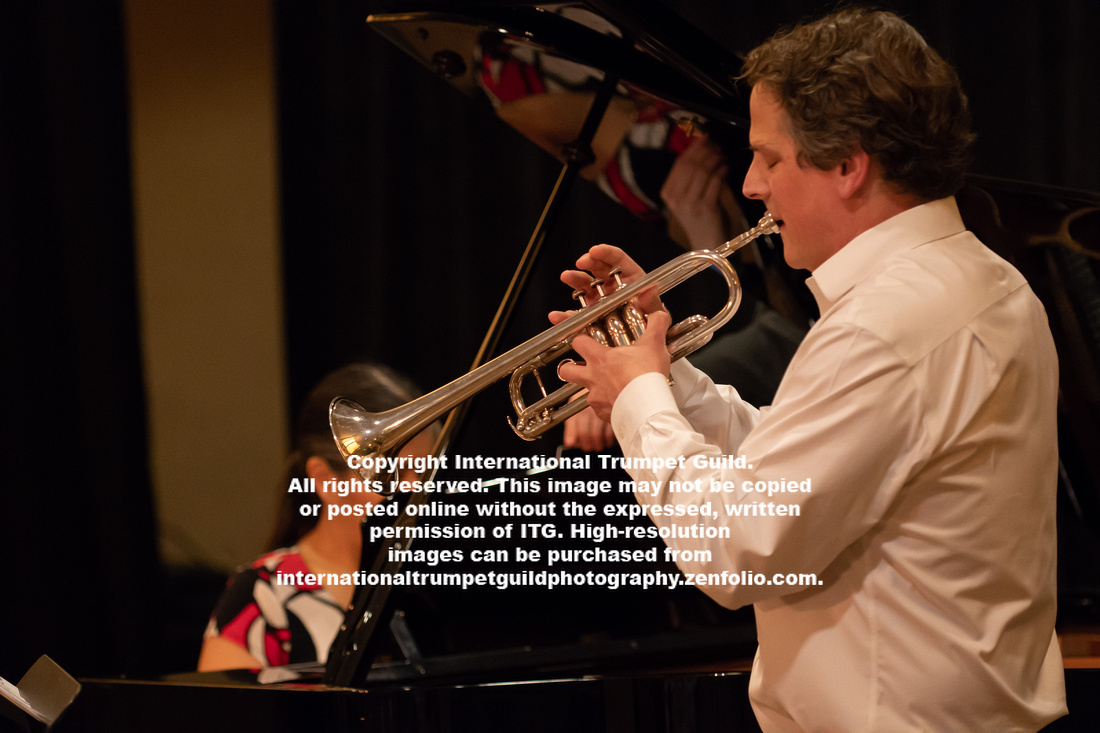
“Rolling Hills and Wilderness” is the first of two movements from Keystone Landscapes for Trumpet and Piano, a work focusing on the beauty of Pennsylvania. Open harmonies and extended trumpet melodies depict a surreal and endless wilderness as composer Joshua Hobbs suggests. Timothy Winfield, who commissioned and performed the work, delivered the necessary expansiveness throughout with ease and facility. (LE)
ITG Solo Competition Finals
The ITG Solo Competition featured three finalists--one from Oklahoma and two from Australia--illustrating the truly international scope of our organization as pointed out by competition organizer Jason Dovel. The required work was Cellier’s Chevauchée fantastique, and a second piece was chosen by each soloist.
First to perform was Darcy O’Malley, who opened with the Cellier. His performance was characterized by graceful lyrical playing and tasteful contrasts. His chosen piece was the Pakhmutova Concerto, in which he presented the muted sections beautifully. He also exhibited superb dynamic control and made a strong finish.
Next was Robin Park, who performed from memory, beginning with Höhne’s Slavonic Fantasy, a cornet solo with broad, romantic lines interspersed with technical flourishes, which he navigated easily. His Cellier was confidently executed for an impressive overall performance.
Noah Mennenga concluded the competition, also performing from memory. His rendition of Cellier featured a full, resonant sound, agile technique, and clear articulation. He concluded with his own arrangement of Gershwin’s Three Preludes, which will no doubt soon become very popular. He was much at home with this style, and it was an excellent showcase for his skills.
All three finalists and their teachers should be congratulated for their excellent work! (LH)
Wiff Rudd—Keystone Habits for the Trumpet Studio
Wiff Rudd’s presentation on Wednesday morning was a truly great clinic that focused on how to build a strong studio through focusing on principles and establishing a community that invites learning and growth for any studio. Rudd discussed the need to incorporate safety, vulnerability, and purpose in the studio and shared a variety of methods that he has found effective for his studio. He stressed that it is important to find a basic overriding principle that a studio might need—and not just do what others have found successful. Stressing the importance of always valuing the individual, Rudd shared how finding a principle that all members of the studio can get behind will help develop a rich culture in the studio. The audience was attentive and engaged as Rudd finished the presentation with a detailed discussion of how he teaches classical improvisation to help students develop sound and musicality. This session was a truly delightful and beneficial part of the conference. (SW)

Brazilian Trumpet Ensemble—Brazilian Music for Trumpet Ensemble
The Brazilian Trumpet Ensemble presented an exceptional concert of all Brazilian music for trumpet ensemble. Each work offered a wide variety of harmonic colors, rhythmic complexities, and musical flair. In addition, the members of the group displayed an extremely high level of artistry that was captivating to the audience. Aquiles Moraes, featured on José U. da Silva Duda’s Uma Fantasia Brasileira, displayed remarkable virtuosity as he was accompanied by the rest of the ensemble. At the conclusion, there was no doubt that they were well appreciated by the entire audience, who showed their enthusiasm with a standing ovation. (JB)
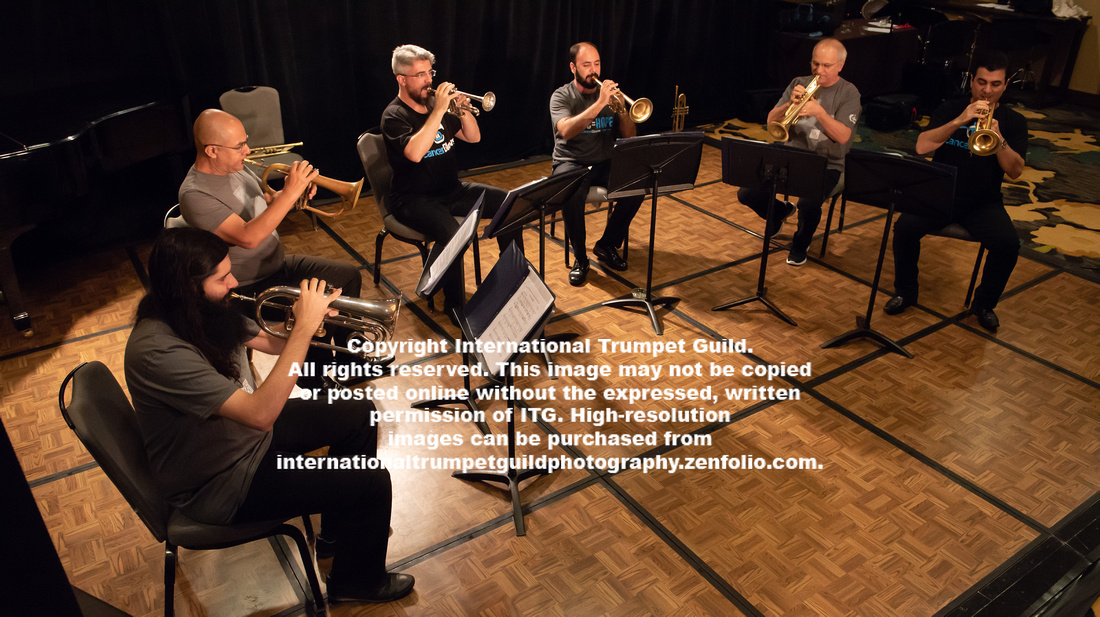
Wim Van Hasselt—Recital
Wim Van Hasselt’s Wednesday afternoon recital contained an eclectic mix of pieces demonstrating the versatility and artistry of a truly world-class performer. Accompanied by Rebecca Wilt at the piano, the opening selection, Jongen’s Concertino, op. 41, was a display of the elegance often associated with the French style. The pair continued in the same vein with a masterfully navigated and musical interpretation of Enescu’s Legend. Van Hasselt’s command of the instrument in all registers and at all dynamics was quite evident during the North American premiere of Florian Magnus Maier’s UNDA for trumpet & electronics. An emotional recitation of the ancient Jewish prayer sequence, Kaddish, followed, with the flugelhorn voicing feelings of loss and grief. The recital closed with a delightful cornet solo and Timofei Dokshizer’s arrangement of “Oh! Quand je dors.” (AD)
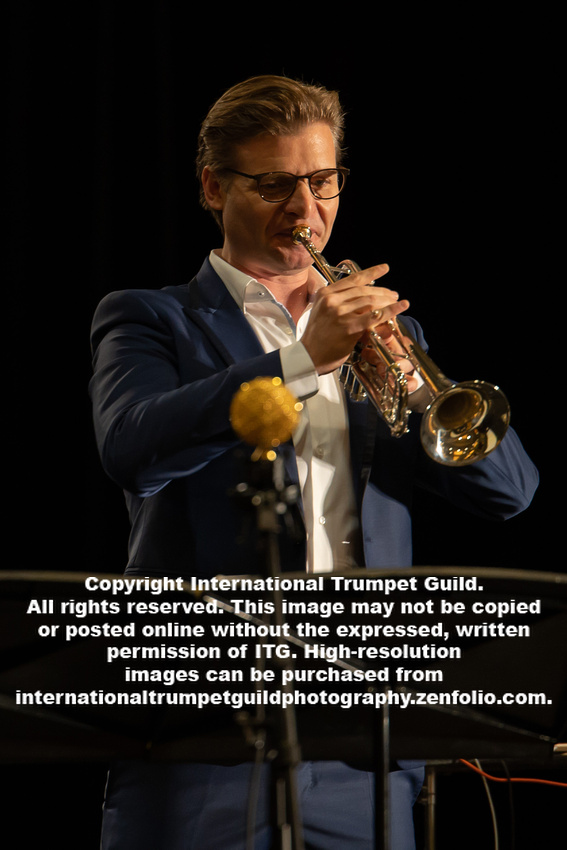
Houston Symphony Trumpet Section—Presentation
The Rio Grande Ballroom of the Hyatt Regency was filled nearly to capacity to listen to and learn from the Houston Symphony Orchestra trumpet section, which included Mark Hughes, principal; Robert Walp, assistant principal; John Parker, associate principal; and Rich Harris, second trumpet. They played a few orchestral excerpts, such as the fourth movement from Bruckner’s Fourth Symphony and the soft muted portion of Debussy’s Fêtes, but mostly they performed trumpet ensemble music. Their outstanding intonation, balance, and blend was on display during performances of Bach’s Little Fugue in G Minor, Bruckner’s Virga Jesse, a Canzon by Samuel Scheidt, and a contemporary French piece called Tryptique by Denise Roger, written for four trumpets. They answered questions from the audience and stressed the importance of active, goal-oriented listening to improve at matching style, articulation, balance, and blend within an orchestral section. (SH)
Lone Star Brass—Recital
St. Mark’s Episcopal Church serves as the venue for many of the chamber ensembles featured at this year's conference. Wednesday afternoon’s concert featured Lone Star Brass, a quintet consisting of members of the Midland Odessa Symphony and Chorale. Opening with Kerry Turner’s Ricochet, the ensemble made a bold and acrobatic statement to begin their exciting and eclectic program. Throughout the recital, the quintet ably presented original works written for the ensemble, as well as arrangements by ensemble members. One highlight was Marc Mir’s Suite Celtique, a three-movement work containing various folk tunes with embellishments and variations in the Celtic style. Steven Sacco’s Quintet showcased a wide range of musical expression and a variety of styles. Presenting a mixture of lyricism, a Mambo Fantasy, and every style in between, Sacco’s Quintet was the perfect vehicle to highlight this group’s seasoned virtuosity. (WK)
Jason Dovel and Miriam Hickman—Recital
Opening with Giuseppe Torelli’s Sonata in D (G. 3), Jason Dovel’s performance included both effective terrace dynamics and engaging ornamentation. The outer movements from Hummel’s Concerto in E-flat followed in a rendition emphasizing lightness and lyricism. Dovel’s own composition, A Stroll Through Kalavrita, captured the Greek town splendidly. Frederick Beck’s Vocalise for solo flugelhorn includes lyrical melodies interspersed with sometimes unexpected technical flourishes. Dovel’s unaccompanied Multiphonics Etude provided immediate contrast by effectively switching between multiphonics and open sounds with a definite musical purpose and excellent pacing. Two duos with piano concluded the recital. Anthony Plog’s Double Concerto (with Reese Land) was highlighted by lyrical playing in the second movement with two flugelhorns. Stephen Campbell joined Dovel for a delightful and entertaining performance of Fernand Andrieu’s Concertino for Two Cornets. This recital was a genuine tour de force demonstrating Dovel’s many talents and interests. (LE)
Young Professors of Texas/Oklahoma Trumpet Ensemble Concert
The Young Professors of Texas/Oklahoma Trumpet Ensemble presented a thrilling concert of standard and new works for trumpet ensemble. They performed original works by such composers as Kevin McKee and Erik Morales, as well as arrangements by members of the group. Brian Walker’s arrangement of Eric Whitacre’s Water Night enhanced the overall musical diversity of the program. In addition to standard works, the trumpet ensemble presented the world premiere of Micah Bell’s Homecoming. This wide collection of trumpet professors displayed their ability to perform as a cohesive unit with a high level of artistry. To close the program and bring awareness to the CancerBlows Foundation, the Young Professors of Texas/Oklahoma Trumpet Ensemble featured Ryan Anthony as a special guest member of the ensemble as they performed James Olcott’s arrangement of Wagner’s “March” from Lohengrin. (JB)
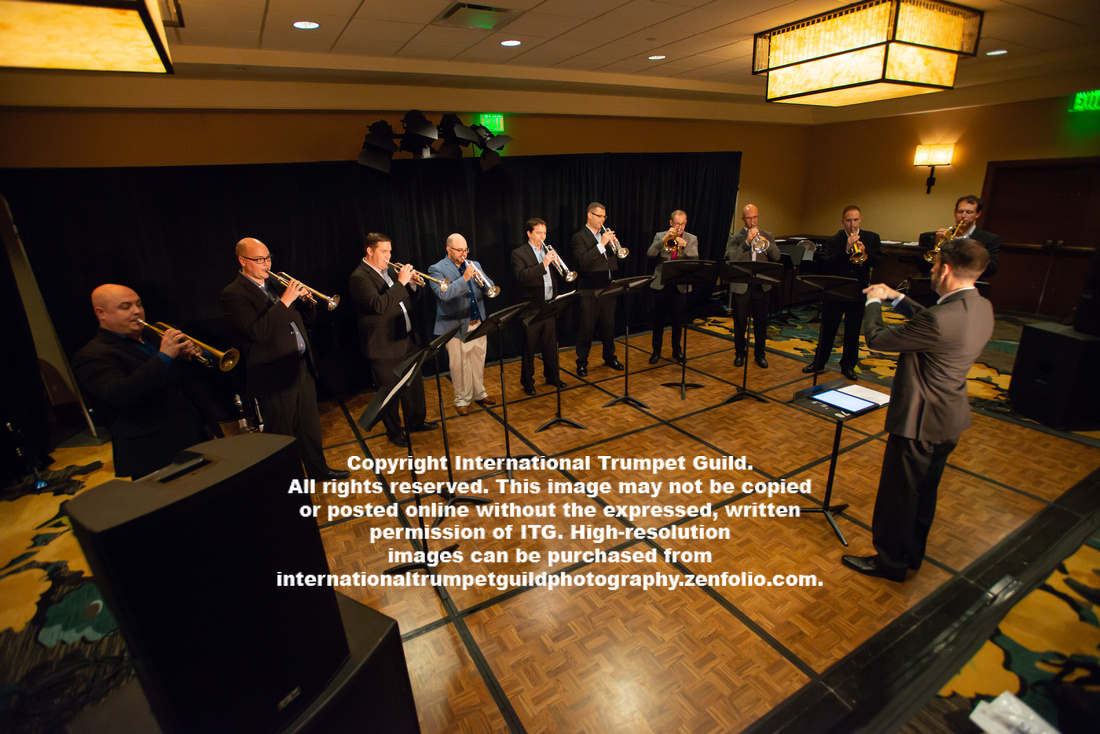
Robert Murray—New Beginnings and Rediscovered Gems: The Vincent Bach Collection in the ITG Archives
Dr. Robert Murray’s presentation showcased the history and accessibility of the International Trumpet Guild Archives, housed at Columbus State University. He showed plans for the future ITG Archive Library and discussed many of the items that are part of the collection. Murray focused on the printed works of Vincent Bach that exist within the Archives. The presentation was wonderfully peppered with live performances of many of the highlighted musical gems in the collection with Dr. Murray on trumpet and Shari Santorelli on piano. (JPS)
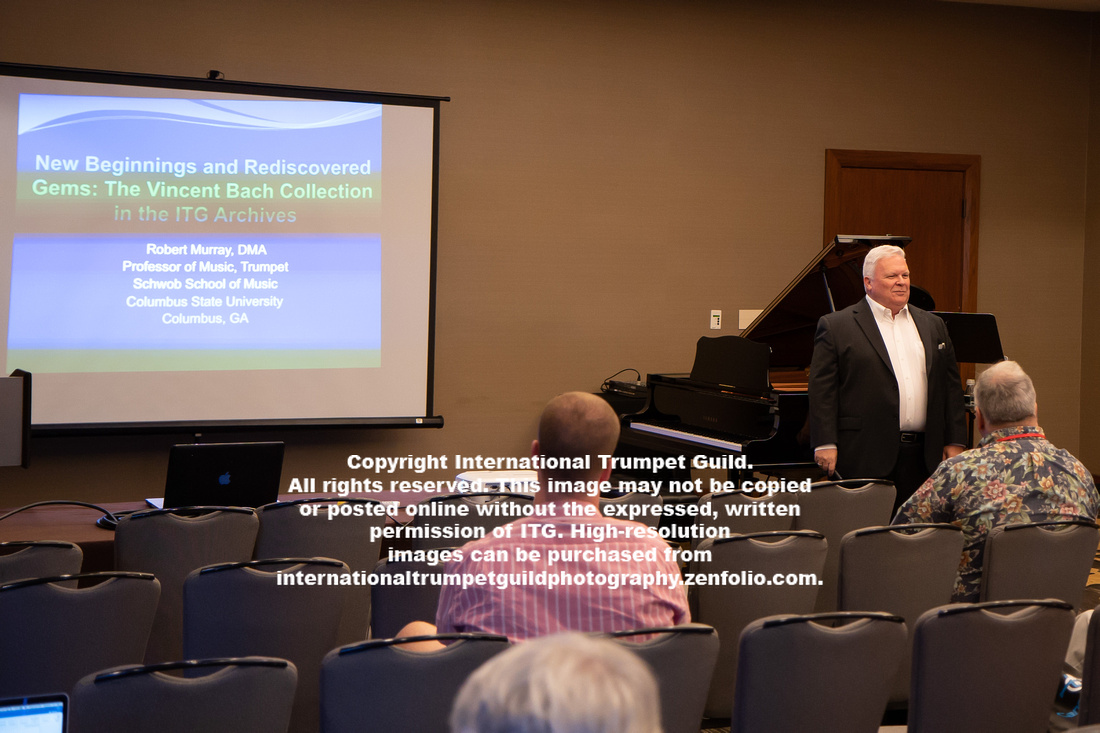
Click here for more photos from the ITG Conference
]]>
Javian Brabham (JBr) recently earned his DM degree at Florida State University. He completed the MM degree at the University of New Mexico and the BME degree at Florida State University. An NTC semifinalist and winner of the 2011 ITG Legacy Scholarship, he is an active freelancer and has performed with numerous orchestras.
Jon Burgess (JBu) has been a member of the music faculty at Texas Christian University in Fort Worth, Texas since 2000. He is the editor of the Pedagogical Topics column for the ITG Journal.
Brandon Cave (BC) is a trumpet performer and teacher based in the Baltimore/DC area. Brandon serves as Second Trumpet of the American Pops Orchestra and teaches trumpet at Maestro Musicians, Artist Music Center and Loyola Blakefield Jesuit School in Baltimore.
Alexander Davis (AD) is a freelance writer and graduate student at the University of Kansas. He has performed with the Opera in the Ozarks Orchestra, Lubbock Symphony Orchestra, El Paso Wind Symphony, and the 1st Armored Division Band of the US Army.
Kevin Eisensmith (KE) is professor of trumpet and assistant chair of the department of music at Indiana University of Pennsylvania. He served as ITG president from 2009 to 2011 and currently serves as secretary.
Luis Engelke (LE) is professor of music at Towson University. Editor of the ITG Journal Music Reviews column, he has authored over 250 publications in numerous journals. He is principal trumpet of several orchestras and has performed with more than 50 professional orchestras internationally.
Scott Hagarty (SH) is associate professor of trumpet and jazz at Del Mar College. He is also a member of the Corpus Christi and Victoria Symphony Orchestras, the Corpus Christi Brass Quintet, and the Del Mar College Faculty Brass Trio.
Benjamin (BH) Hay is instructor of music (trumpet/theory) at Northeastern State University in Tahlequah, Oklahoma.
Leigh Anne Hunsaker (LAH) is professor of trumpet at Hardin Simmons University in Abilene, Texas.
Aaron Jensen (AJ) is a DMA student at the University of North Texas.
Alan Klaus (AK) is assistant professor of trumpet at Memorial University of Newfoundland after appointments at Montana State University and Mount Allison University. He holds the Doctor of Music degree from Florida State University, where he studied with Christopher Moore.
Elisa Koehler (EK) is professor of music at Goucher College in Baltimore, Maryland. She is the author of Fanfares and Finesse: A Performer's Guide to Trumpet History and Literature (Indiana University Press) and is a new member of the ITG Board of Directors.
Will Koehler (WK) is an active performer, educator, and writer. He currently teaches at Bloomington High School North, Northview High School, and Tri-North Middle School and will graduate from the Indiana University Jacobs School of Music with a Doctor of Music degree in trumpet performance in 2018.
Marie Mencher (MM), editorial assistant, holds a BA in Latin American Studies from Wesleyan University and a BS in Music Education from Indiana University of Pennsylvania. She will begin a master’s program in trumpet performance this fall at Kansas State University.
Eric Millard (EM) is the visiting instructor of trumpet at the University of North Carolina-Charlotte and previously served as third/associate principal trumpet with the Tallahassee Symphony Orchestra. He received his doctoral and master’s degrees from Florida State University and his bachelor’s degree from the University of Kentucky.
Kyle Millsap (KM) is assistant professor of trumpet and jazz at Texas A&M University-Kingsville. He oversees the dynamic trumpet program and directs the trumpet ensembles, jazz trumpet ensembles, and Jazz Band 2.
Nick Mondello (NM) is a freelance trumpeter, composer/arranger, educator/clinician and writer. He attended the Berklee School of Music and holds BA, MS, MBA, and Prof. Diploma in Educational Administration from Long Island University. He resides in Locust Valley, New York.
Paige Nelson (PN), editorial assistant, is a master’s trumpet student at the University of Northern Colorado, where she studies with Philiip Hembree. She received her BM in music performance from the University of South Alabama while studying with Peter Wood.
J. Peyden Shelton (JPS) is the assistant professor of trumpet at the University of Utah School of Music. He is a Yamaha Performing Artist and member of the electro-acoustic trumpet ensemble Fifth Bridge.
Spencer Wallin (SW) is currently adjunct professor of high brass at Navarro College. He recently graduated from the University of North Texas (DMA), where he studied with Dr. Jason Bergman and also holds degrees from the University of Michigan (MM) and Brigham Young University (BM). He works as a freelance musician in the Dallas-Fort Worth area, frequently performing on modern and baroque trumpets.
Justin Way (JW) is entering his junior year as a trumpet performance major at Florida State University. He studies with Dr. Christopher Moore and freelances in the Tallahassee area.
Marisa Youngs (MY) is a performer, educator, and researcher based in Lexington, Kentucky. She recently completed her DMA in trumpet performance at the University of Kentucky and continues to teach and perform in a variety of styles and ensembles.
Photography Staff
Michael Anderson (MA) is the ITG Website director and head photographer for the conference. He serves as professor of trumpet at Oklahoma City University and is a member of the Oklahoma City Philharmonic.
Norman Bergstrom (NB) has been a member of the Blawenburg (New Jersey) Band trumpet section since 1962. He is also the photographer for the Nova Orchestra in West Windsor, New Jersey.
Josh Rzepka (JR) is a Chicago-based trumpeter and composer. A graduate of the Oberlin Conservatory (BM), and Boston University (MM), he has released three solo albums and tours with the retro rock sensation Under The Streetlamp.
Denny Schreffler (DS) has balanced careers in and out of music for almost fifty years. Since retiring from music (for a second time) in 2013, Denny has been an active concert and show photographer in southern Arizona.
Brian Shook (BS) is currently chair of the Mary Morgan Moore Department of Music at Lamar University. Prior to this appointment, he served as the trumpet professor at Lamar for seven years. In 2011, Shook published the biography of New York Philharmonic trumpet legend William Vacchiano, titled Last Stop, Carnegie Hall
]]>Special Daily Report • Compiled by Peter Wood
Photos by Michael Anderson and Denny Schreffler
Tuesday, May 29
This opening evening of the 43rd annual ITG Conference was filled with the usual sense of eager anticipation of the wonderful trumpet-related events to come over the next four days and five nights. The Hyatt Regency Riverwalk is a warm, welcoming hotel with great restaurants everywhere in a lively downtown environment. As participants poured in from all over the world throughout the afternoon, there were plenty of smiles, handshakes, hugs, and laughs to go around. After the fanfare with Doc Severinsen and the opening CancerBlows concert, the socializing continued with a welcome reception at which a festive local mariachi band serenaded attendees. Expectations are extremely high that this will be a conference to remember!
Click here for more photos from the ITG Conference
Mass Trumpet Ensemble with Doc Severinsen
The 2018 ITG Conference began with a collective cacophony of trumpet sounds, as hundreds of conference attendees filled the Rio Grande Ballroom to be a part of Doc Severinsen’s Mass Trumpet Ensemble. With the abundantly able help of Doc Severinsen and James Olcott, participants rehearsed Excerpts from Aida (Act II) by Verdi (arranged by Dennis L. Horton) and Trumpets Take Texas, a medley of Texas-themed tunes by James Olcott. After a brief but sufficient rehearsal for each work, the “ensemble” assembled across the street, directly in front of the famous Alamo. The Texas sun could not squash the genuine spirit of collegiality and good humor as participants of every background prepared to perform under Doc’s direction. Despite its storied history, the Alamo has never experienced the sound of Doc and several hundred trumpets playing simultaneously, and the experience will bring new meaning to “Remember the Alamo” for all the participants. (BH)
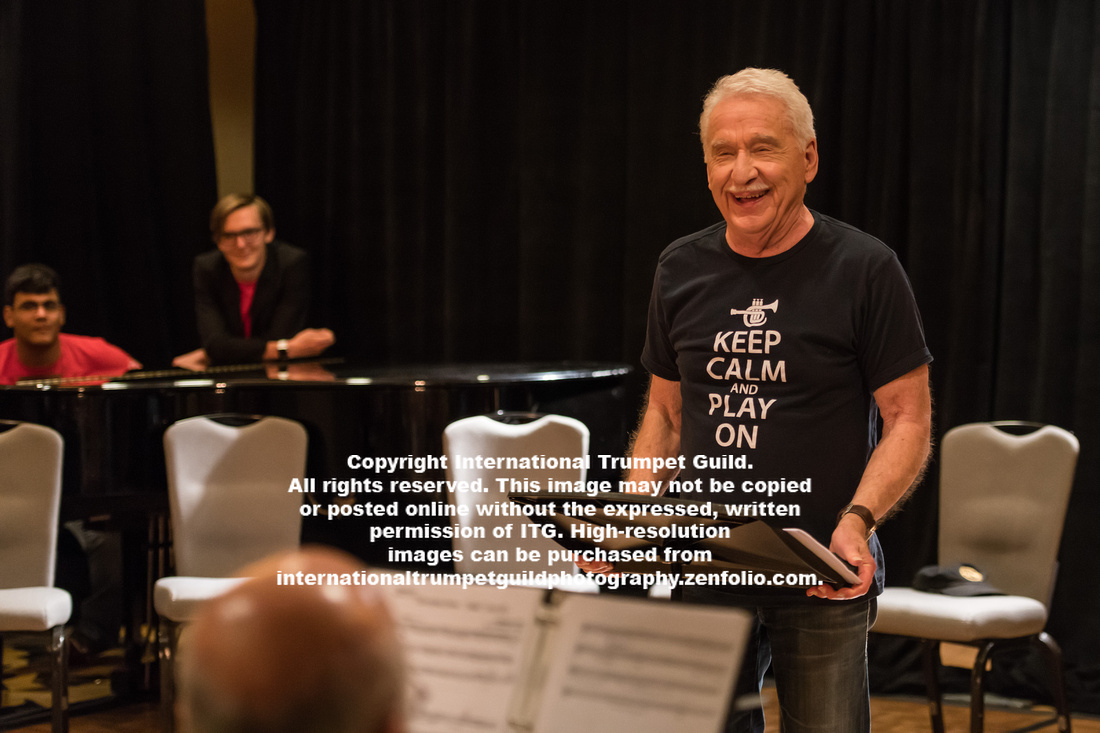
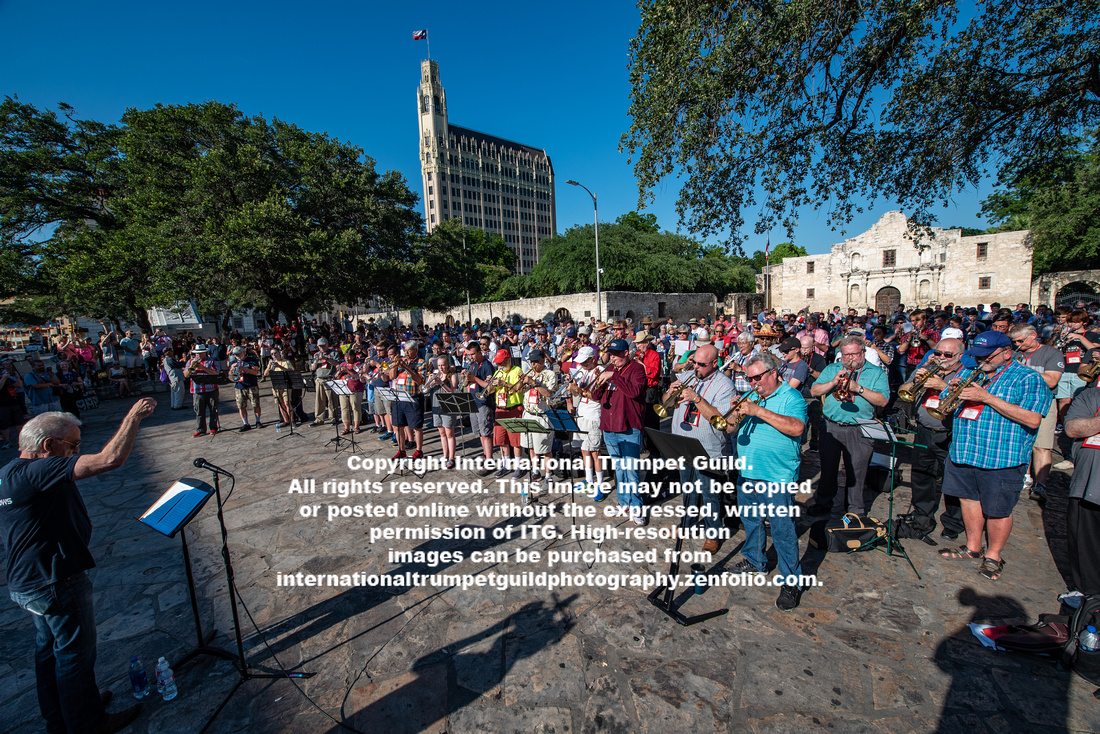

Opening Concert: CancerBlows
The first concert at any ITG conference is always a special event, but this particular one showcased far more than great trumpet playing. It was a celebration of life, the trumpet community, and the triumph of the human spirit. Ryan Anthony, principal trumpet of the Dallas Symphony and former member of the Canadian Brass, was diagnosed with a rare form of cancer in 2012 and later created a foundation and a series of benefit concerts called “CancerBlows,” which feature prominent trumpet soloists to raise funds for cancer research.
In addition to Ryan Anthony and Doc Severinsen, the stellar group of soloists included Joe Burgstaller, David Hickman, Richard Kelley, Jens Lindemann, Rex Richardson, Ronald Romm, Wiff Rudd, Jose Sibaja, Philip Smith, Mary Thornton, Bert Truax, Mike Vax, Brian Walker, and Tromba Mundi (a professional trumpet ensemble). The United States Air Force Band of the West provided outstanding accompaniment under the baton of Major David A. Alpar.
The first piece, Peter Meechan’s Remission, began in a darkened hall with a spotlight shining on a lone trumpet at the front of the stage. Trumpeters positioned around the perimeter of the auditorium took turns playing poignant melodies until the lights came up and the brass and percussion sections of the band were joined by Hickman, Sibaja, and Smith on stage. The music alternated between majestic hymnody and a harmonized version of Taps. An all-star trumpet ensemble of thirteen soloists were next, performing Burt Truax’s Legacies of Honor, under the direction of Marie Speziale. Raymond Burkhart’s Half Dome Fanfare (World Premiere) dazzled the audience with virtuoso acrobatics and sweeping melodic gestures.

ITG President Cathy Leach then introduced Ryan Anthony, who in turn introduced Doc Severinsen, thanking him for his friendship and support of the Cancer Blows project. With his trademark wit, Doc explained how his father used to play Fritz Kreisler’s Caprice Viennois on the violin to help Doc fall asleep when he was a child. Hickman, Vax, Romm, and Smith joined Doc on stage for Anthony DiLorenzo’s beautiful arrangement of the piece, after which Doc laid down on the stage, briefly, to remind the audience of his relationship with the tune as a lullaby.
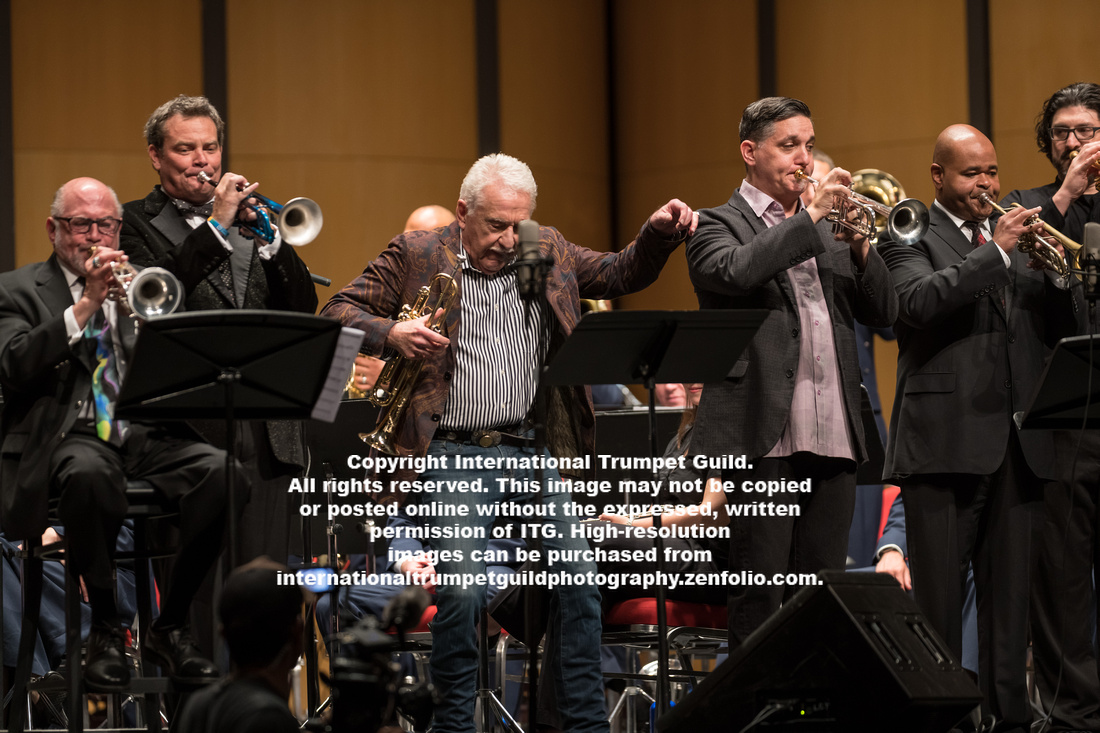
Rex Richardson and Joe Burgstaller performed the “High Noon” movement from Kevin McKee’s Under Western Skies, after which Ryan Anthony returned to perform Gabriel’s Oboe from Ennio Morricone’s film score for The Mission. Performing on piccolo trumpet from memory, Anthony’s effortless and soulful interpretation transported the audience to another realm. Jens Lindemann and Richard Kelley then joined Anthony for Peter Meecham’s Song of Hope, which was followed by Kelley’s fine performance of "What a Wonderful World," which showed off his beautiful singing voice, in addition to his trumpet playing.
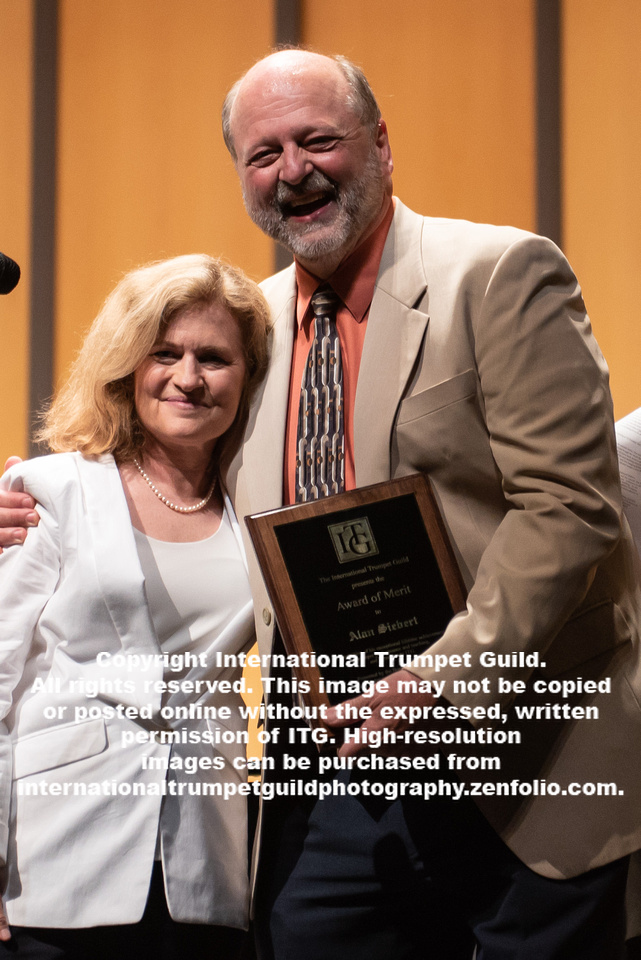
Cathy Leach returned to the stage to present the ITG Award of Merit to Alan Siebert, after which the Méndez trio, The Brave Matador, was performed by Hickman, Romm, and Vax. An arrangement of Ginastera’s “Danza Finale” from Estancia followed, after which four trumpeters who had all previously played with the Canadian Brass – Anthony, Romm, Lindemann, and Burgstaller - performed a rousing rendition of A New Carnival of Venice by Thomas Stevens. Tromba Mundi was next, performing Victory Fanfare by Ben Blasko, another cancer survivor. Finally, all of the evening’s soloists, along with the trumpet section of the Air Force Band of the West, lined the front of the stage for a spirited performance of Count Basie’s One O’Clock Jump, which brought this inspiring opening concert to a joyous, festive close. (EK)
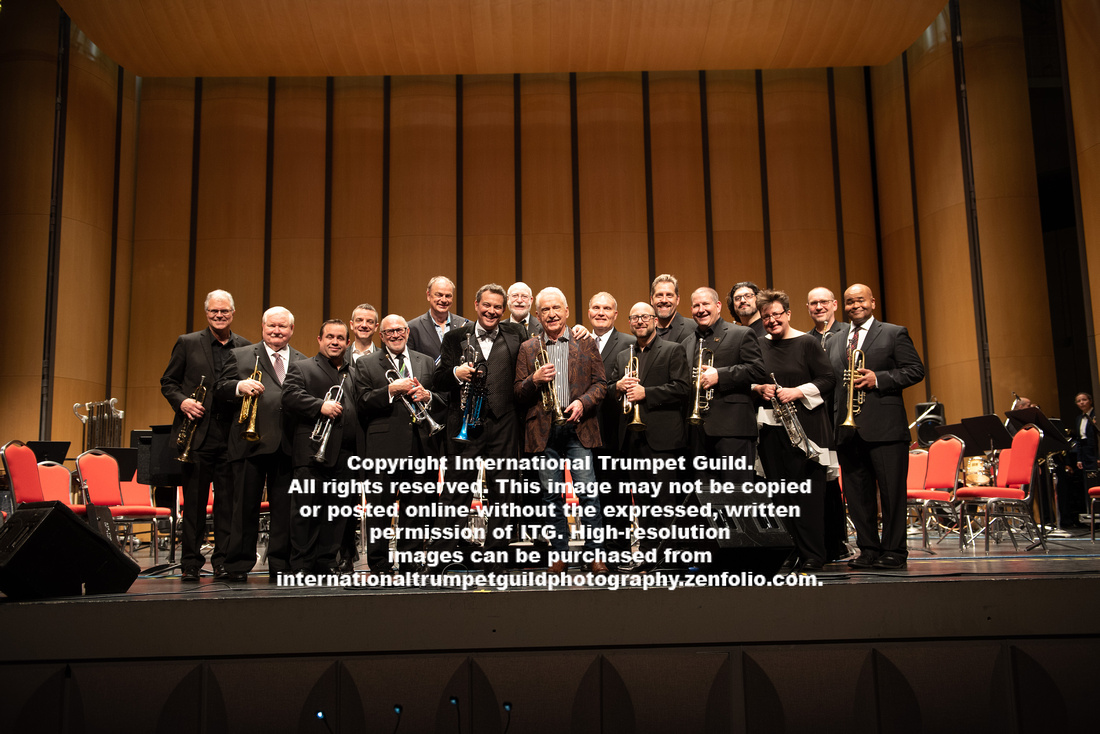
Click here for more photos from the ITG Conference
]]>
January 26-27, 2018
Special Report • Compiled by Peter Wood
The first-ever ITG Regional Conference was held on the last weekend in January on the campus of Oklahoma City University. Hosted by Michael Anderson, the event was highly successful and was given universally high praise. Attendance, naturally, was smaller than the annual ITG Conference, and the atmosphere was more close-knit and supportive. Trumpeters from throughout the central US came together to learn, perform, and be inspired, and they were not disappointed!
 Oklahoma City University Bass School of Music
Oklahoma City University Bass School of Music
Day 1: Friday, January 26
Opening Ceremony – Oklahoma City Philharmonic Brass
The ITG Regional Conference began on a high note with a rousing opening concert by the Oklahoma City Philharmonic Brass, conducted by Warren “Puffer” Jones. Following a riveting performance of John Wasson’s Clash of the Centurions, Michael Anderson (conference host), Mark Parker (dean of the Wanda L. Bass School of Music), and Cathy Leach (ITG president) all welcomed the audience to the conference. The conclusion of welcoming remarks led to the continuation of the OKC Philharmonic Brass’s performance, starting with a beautiful rendition of Raymond Premru’s Five Movements from Divertimento. Directly after this was Villa-Lobos’s Aria from Brasileiras No. 5 featuring Jay Wilkinson, who exhibited flair and convincing mastery of Brazilian musical style. The concert ended with Roger Harvey’s arrangement of Bizet’s Carmen. Concluding with the flying passages of “Dance Boheme,” this was an inspiring beginning to the conference. (JL)
 Michael Anderson
Michael Anderson
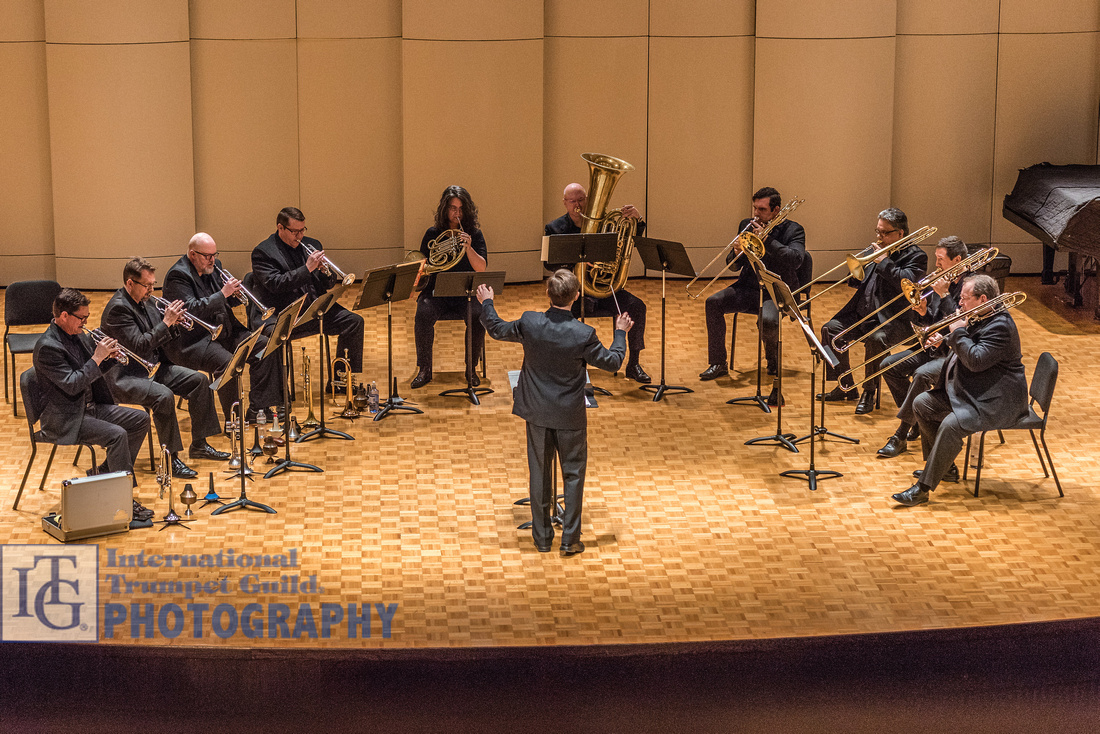 Oklahoma City Philharmonic Brass, Puffer Jones, Conductor
Oklahoma City Philharmonic Brass, Puffer Jones, Conductor
Jason Dovel – Trumpet Intonation: Facts, Myths, and Strategies for Playing in Tune
Jason Dovel presented an articulate and engaging presentation on the subject of trumpet intonation, which is no small feat, given the complexity and highly technical nature of the subject. Dovel began by utilizing electronically generated examples of differing intonation, and used numerous electronic examples throughout the presentation to great effect. Dovel asserted and convincingly demonstrated that the trumpet is perfectly in tune with itself and is naturally subject to the just intonation of the overtone series. Because of this, however, performing with equal-temperament instruments can be problematic. He then discussed instrument design and its effect on the trumpet and encouraged attendees to understand the use of valve slides to counteract many of these issues. Finally, Dovel offered several useful strategies for achieving better intonation. He recommended practicing with drones, learning proper use of the valve slides, learning the Baroque trumpet, and, above all else, developing flexibility and listening carefully. (BH)
Richard Rulli – Stamp: So Much More Than a Warmup
Dr.Richard Rulli possesses more than thirty years of experience studying and using James Stamp’s exercises in his own playing. He presented an insightful session that offered extremely helpful pedagogical suggestions designed to help one understand how to benefit from incorporating these exercises into their own playing. Additionally, Rulli clarified many common misconceptions about these exercises and how to approach them. The first portion of the session focused on how to correctly use the mouthpiece. Rulli concentrated on maintaining efficiency at all times and asked participants to experiment on their own mouthpieces in the session. He was clear to state that it is crucial to do the mouthpiece exercises with piano or a drone. He then discussed essential principles one needs to understand when performing Stamp’s iconic vocalise exercises on the trumpet. Using a call and response format, Rulli and the participants incorporated his suggestions while performing the exercises together. (JB)
Professors’ Recital #1
The first of two Professors’ Recitals at the conference took place in Petree Hall, opening with a rousing performance by Steve Leisring of Trumpet Call by Kenneth Downie. Leisring captured the audience’s attention immediately, executing the opening flourishes brilliantly. The performer displayed great energy and technical fluency in what proved to be an excellent opener for this concert. Rodion Shchedrin’s Im Stile von Albéniz was performed with great style and presence by Jason Bergman. From the opening notes, with Bergman’s warm, robust tone, the listener was aware that this was to be a memorable performance. Bergman clearly enjoys this piece, successfully taking the important musical chances throughout his inspiring performance. Brian Walker performed two movements from Centennial Horizon by Kevin McKee. Aspen Grove allowed Walker to demonstrate an impressive fluidity with his warm, even sound throughout the movement. Equally impressive was his technical prowess and ease of playing throughout the range of the instrument in Roaring Gunnison, easily capturing the emotion and unpredictability of the raging river. Rich Rulli provided a nice contrast with an unaccompanied work entitled Liquid Prelude by Dan Coleman. Rulli easily handled the significant technical demands of this contemporary angular work. The audience was treated by Richard Tirk to a world-premiere performance of Jackson Anderson’s The Bells. The three movements, “Silver,” “Golden,” and “Brazen,” are based on a poem of the same name by Edgar Alan Poe. Tirk showed off his beautiful sound and refined technique in this interesting work. Stephen Goforth’s delicate piccolo trumpet sound was perfect for the first movement of Giuseppe Martini’s Concerto before moving to a humorous rendition of Rafael Méndez’s Chiapenecas on a three-belled trumpet! A work recently discovered at the ITG archives in Columbus, Georgia, was the next selection, performed seamlessly by ITG President Cathy Leach. Moskwa: Russiches Lied fur Tromba Solo is a short lyric piece with great style, captured perfectly by Leach. Another Russian work, the better-known Concertpiece No. 2 by Vassily Brandt, was performed by Ben Hay. Contrasting his sensitive playing on the beautiful linear melodies, Hay easily maneuvered the scalar interludes and exciting ending. To close the full program, Ryan Gardner took the stage to perform five of the seven parts of Siete Canciones populares Españolas by Manuel de Falla. In his performance, Gardner clearly had all the requisite technique and style to bring these folkloric pieces to life masterfully. His easy approach to the instrument and lively, resonant sound were a perfect end to a long, but inspiring, afternoon of performances. (GP)
Steve Leisring – A Blueprint to Finding Efficiency on the Trumpet
Dr. Steve Leisring, professor of trumpet at the University of Kansas, presented a masterclass in which he began with a simple definition of the term “efficiency,” or playing with ease, and continued with descriptions of Leisring’s own journey to develop greater ease in his own playing. He did this through study with a myriad of teachers throughout his years as both an undergraduate and graduate student. His time with Vincent Penzarella yielded significant growth, focusing on the equalization of sound throughout the complete range of the trumpet and improving his listening skills by working simple exercises. The emphasis on ear training and mental focus cannot be overstated: “We must hear our product and trust the brain to create it.” (AD)
Jason Bergman – Applying for College Teaching Jobs
Jason Bergman presented a session on ideas and methods for musicians (not just trumpeters) who have an interest in applying for college-level teaching jobs. In this engaging session, Bergman discussed unique skills that musicians need to develop to find success in the interview process. Providing his personal accounts and experiences, he shared a tangible methodology to develop these skills. He discussed curriculum vitae and audio recording construction, and all in attendance certainly benefitted from this knowledge. Bergman encouraged input from current college professors in the audience and closed the session by expertly answering questions from the attendees. (BW)
Trumpet Ensemble Recital #1
The Trumpet Ensemble Recital #1 featured eight ensembles from universities throughout Oklahoma, Kansas, Texas, and Arkansas. It began with an energetic and enjoyable performance of Erik Morales’ Cityscapes by the hometown Oklahoma City University Trumpet Ensemble. The University of Central Oklahoma followed with James Klages’s arrangement of Franz von Suppe’s Poet and Peasant Overture. Kansas State University then took the stage in matching purple shirts and offered a well-balanced and rousing performance of Infinite Ascent by Erik Morales. The ten-member trumpet ensemble from the University of Arkansas performed a fine rendition of Fanfare of the Bells by Jennifer Fletcher. The Tarleton “Purple” ensemble brought a refreshing Brazilian-style infusion with their energetic performance of Maestro Duda’s Fantasia Brasileira. The Storm’s Path by Brian Balmages is an exciting and programmatic work that was performed very convincingly by the Southwest Oklahoma State University trumpet ensemble. Northeastern State University took their turn on stage with outstanding performances of Concert Fanfare by Eric Ewazen and Catacomb by Jason Dovel. The twenty-member trumpet ensemble from the University of Kansas, the largest group of the recital, gave exciting performances of Fanfare, “Stadt Wien” and the world premiere of Expedition by Chuck McKinnon. The final group to perform was the Baylor “Green” Ensemble, which gave a compelling and well calibrated performance of Variants with Solo Cadenzas by William Schmidt. This recital demonstrated clearly that the art of the trumpet ensemble is alive and well in this region. (JB)
 University of Kansas Trumpet Ensemble
University of Kansas Trumpet Ensemble
Brian Walker – Daily Fundamental Routines: Developing What Works for You
Dr. Brian Walker presented a fantastic clinic. He began by sharing his golden rules for developing a personal routine and stressed that each person should have a specific plan; try new ideas; and be flexible, self-aware, and willing to ask others for help. As Walker discussed the four major areas of his daily routine, the attendees enjoyed a pleasant hour, learning and discussing methods and studies to help with each aspect of playing. Walker talked about the importance of never saying that one way is right or wrong and emphasized being open to new ideas. He taught that everyone should just stay positive and work to get better. His presentation was specific and informative, and he closed by sharing examples of daily routines developed by himself, Max Schlossberg, Christopher Moore, and Barbra Butler. (SW)
Ryan Gardner – Preparing for Auditions and Competitions
In this terrific, fast-paced, fun session, jam-packed with audience participation, Ryan Gardner posed many questions to the audience. Early in the session, Gardner asked, “What is the first thing people hear when you play?” Attendees responded that sound, intonation, time, dynamics, articulation, flexibility, and musicianship are “first-heard” sound items, and Gardner then added details under each item. To be ready for auditions, Gardner suggested “HAVE A PLAN” (make a schedule, plan out practice, plan your days, plan your fun). Practicing should include playing, singing, listening, and resting, with a thirty-minute “performance” at the end. Gardner emphasized that no matter how you feel, judges are waiting for someone to come in and nail it. They are rooting for you, not against you. If you want to be inspired to practice and to improve your audition preparation, attend a Ryan Gardner clinic! (CL)
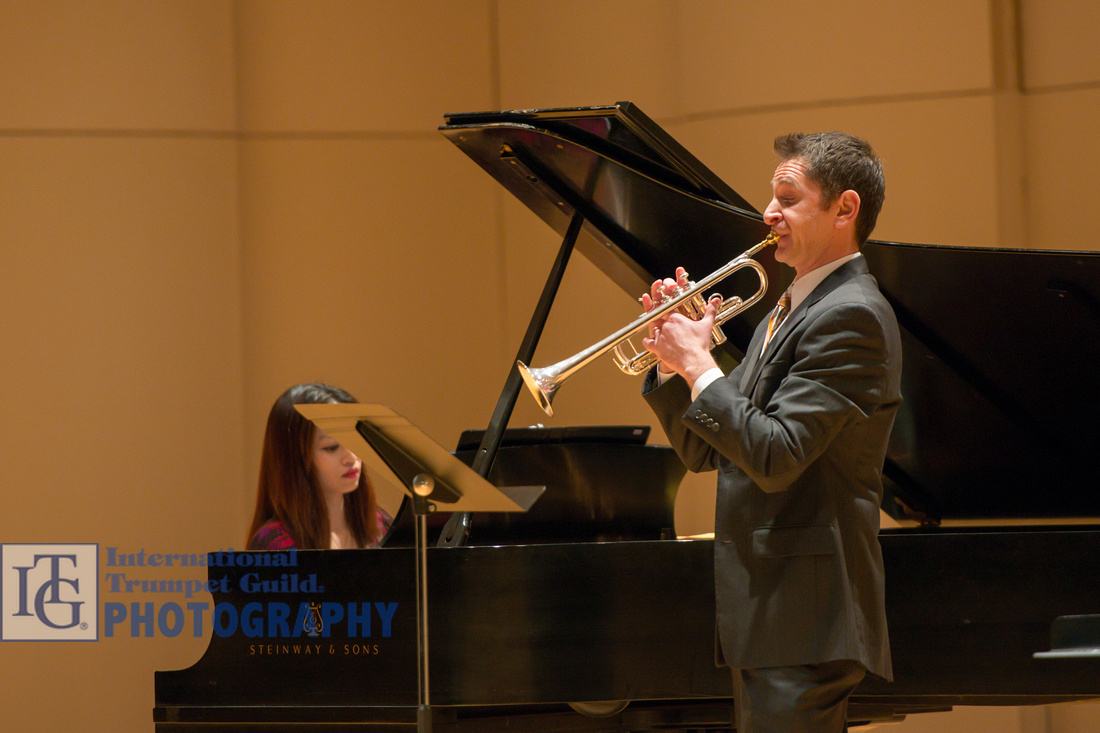 Paulina Leisring and Ryan Gardner
Paulina Leisring and Ryan Gardner
Oklahoma City Jazz Orchestra with Vince DiMartino, Ryan Sharp, and Lee Rucker
The Friday evening audience was in for a treat as Vince DiMartino shared the stage with the hometown trumpet heroes Lee Rucker, Ryan Sharp, and the Oklahoma City Jazz Orchestra. The show covered every type of trumpet fireworks from Ellington’s Concerto for Cootie to a rockin’ version of Green Onions. The band opened with three tunes: the Basie classic Every Tub, Candy, and Blackbird with Rucker showcasing his versatility and soulful licks. Ryan Sharp took his turn channeling the spirit of Maynard Ferguson on the Willie Maiden tune Where’s Teddy. Sharp’s hair-parting high notes on that tune were closely followed by his tasty plunger technique on Ellington’s Main Stem. The band closed out the first half with a burner, John Daversa’s Fast and Direct, with a blazing sax soli and again highlighting Lee Rucker’s nimble fingers and robust sound. Funky was on the menu to start the second half of the show with Clayton’s arrangement of The Jody Grind. Vince DiMartino electrified the audience with his terrific tones and a few fun tales along the way. His portion of the concert started with Sy Johnson’s excellent rendering of the great trumpeter Kenny Dorham’s tune Blue Bossa. DiMartino amazed and thrilled and then opened the solo section to feature many of the outstanding members of the band. Concerto for Cootie brought the audience back to the 1940s with Duke Ellington’s salute to Cootie Williams. DiMartino’s delicate mute playing was perfectly foiled by his growls and soaring sounds later in the piece. The mood softened as the band and DiMartino then went into Hoagy Carmichael’s timeless Georgia on My Mind. Before his closing piece, DiMartino took the time to talk about how important ITG has been to him, the many wonderful musicians he has met as a member, and how events such as this regional conference are so integral to advancing our craft. DiMartino’s closer was Bill Armstrong’s Aim for the Heart, originally written for Doc Severinsen. Once again, Vince DiMartino showed why he is one of the foremost trumpet artists of our time, demonstrating technical and musical mastery while swinging as hard as can be. The Oklahoma City Jazz Orchestra, under the direction of Brian Gorrell, closed out the night with Zaremba’s arrangement of the Booker T and MG’s tune Green Onions. The trumpet section really set the tone for the evening and gave the trumpeters in the audience a great show. (RT)
Wiff Rudd – Tag Team Practice Jam
In this highly informative session, Wiff Rudd discussed and exhibited some of the collaborative exercises and concepts he uses with his students at Baylor University that have helped his studio develop excellent musicality and ensemble sensitivity. Rudd broke the class into two teams of players and used call and response to work on the fundamental elements of trumpet playing with an emphasis on a resonant sound and response. One of the highlights of the class was students improvising inside the chord of Clarke’s second exercise while Rudd played the exercise in sections before they played it back to him. The majority of the class was done without music as Rudd believes that getting away from the page frees up the mind and opens up the ears to playing with others. The first class of its kind at ITG, it brought improvisation into practice for those not comfortable with the jazz idiom. (AJ)
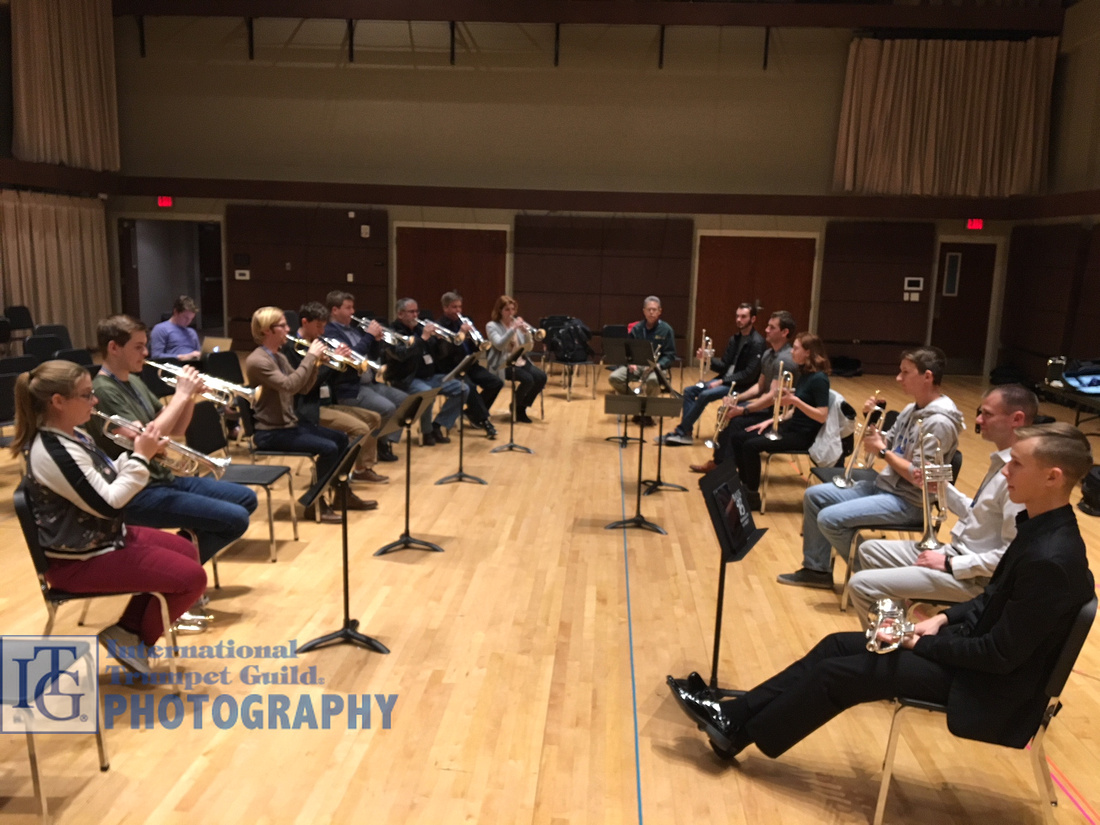 Wiff Rudd's Tag Team Practice Jam
Wiff Rudd's Tag Team Practice Jam
Day 2: Saturday, January 27
Karl Sievers – Warm-up session
Saturday morning got off to a great start with an informative and productive warm-up session led by Karl Sievers. Sievers began the session with a discussion of the importance of maintaining a quiet mind and an elevated energy level when playing the trumpet. The warmup consisted of a call and response, with Sievers leading the group without any music, to encourage each person to use their ears instead of their eyes. Using techniques from William Adam, Vincent Cichowicz, and Max Schlossberg, Sievers continually stressed that the focus should always be on the sound. The atmosphere of the session was positive and enjoyable, due to the friendly nature and attitude that Sievers encouraged. Periodically, Sievers would ask volunteers to play by themselves, thus allowing for everyone to see how to approach possible challenges and to understand the proper way to play each exercise. (SW)
Richard Tirk – The Aria Project
Dr. Richard Tirk (Southwestern Oklahoma State University) began his presentation with a certain air of mystery, using a wordless performance of the middle passage of Arban’s second Characteristic Study and the second movement of Kennan’s Sonata to introduce his “Aria Project.” Tirk used these examples to demonstrate the need for an understanding of lyrical artistry among performers and educators. To this end, he has devised a thoughtful and thorough system of introducing his students to vocal artistry. Over the course of a four-week project, each student examines a carefully selected aria and completes a comprehensive analysis of several interpretations of the work by different performers. During this process, the student also writes program notes and performs the selected aria for the trumpet studio class. Tirk ended with a masterfully crafted performance of the famous “Song to the Moon” from Dvorak’s Rusalka. (BH)
Grant Peters – Efficient Use of Time in the Teaching Studio Through Technology
Grant Peters, professor of trumpet at Missouri State University, presented a masterclass centered around the practical use of software created for desktops, laptops, tablets, and other mobile devices to make life easier for both teacher and student. He emphasized taking the time to learn the ins and outs of each program to maximize efficiency and organization. The technology loses its purpose if it does not make life easier. These apps are used to cover the following purposes: creating lesson plans that clearly and concisely provide information on each assignment, formulating tests and study tools, and organizing, managing, and analyzing practice sessions. Applications discussed include PDF Office, DD GigBook, gFlash+, Tonal Energy, and Seconds Pro. (AD)
Vince DiMartino Masterclass
Anyone who attends a Vince DiMartino session will have fun while acquiring mountains of information about trumpet playing. Vince immediately grabbed the audience’s attention by beginning an exquisite tone before he had even been fully introduced by Michael Anderson. He indicated that he might sound like a different person than he had sounded on jazz solos the night before – because he was – in the sense that he considers himself an actor. Other main points included the idea that the trumpet can do only three pairs of things: loud/soft, high/low, fast/slow. Vince recommended keeping your lips the same while playing, demonstrating this through a hilarious demonstration of a clarinet player setting up a reed, likening our lips to the reed. Throughout, he frequently reiterated a Timofei Dokshizer quotation: “You can’t practice music without technique, and you can’t practice technique without music.” (CL)
David Hunsicker Recital
David Hunsicker, professor of trumpet at Wichita State University, presented a spectacular display of trumpet mastery during his afternoon performance. He opened with Arthur Honegger’s Intrada, showcasing exemplary accuracy, musicality, and stamina, and then welcomed Shannon Thomas (violin) to the stage for a delightful performance of James Stephenson’s Storyteller. Following this, Hunsicker showed his versatility with the flugelhorn in Joseph Turrin’s Two Portraits and the piccolo trumpet in Johann Wilhelm Hertel’s Concerto No. 3 in D Major. He continued with Jennifer Higdon’s Trumpet Songs and then welcomed Steve Leisring to the stage to perform the first movement of Kevin McKee’s Under Western Skies to conclude this sensational recital. (JL)
Karl Sievers – Keeping the Mind in the Sound
This session focused on what “the sound” means and how to obtain a clear idea of it. Karl Sievers explained that “the sound” consisted of core, resonance, and brilliance. He asserted that sound should always be one’s first priority and unwavering goal every time the horn is placed on the lips. It is important to flood the mind with a vividly defined sound and to make this the primary goal of trumpet playing. A lively question-and-answer session allowed for a student to play flow studies with Sievers. This created an aural opportunity to hear the impact of a sound-centered mind. The student’s sound as she ascended improved in quality and consistency when she focused on the core of her sound during the second attempt. This class showed the importance of developing a sound centered-mind and was applicable to every level of player. (CG)
Trumpet Ensemble Recital #2
The West Texas State University Trumpet Ensemble, under the direction of William Takacs, opened the afternoon concert, which featured seven trumpet ensembles. The difficult, high-energy The Wild Atlantic Way by Benjamin Brooks was masterfully executed by this fine septet of players using trumpet and flugelhorn. These strong performers easily handled the piece’s significant physical challenge for a very exciting opener. The first of two Texas high school ensembles stepped up to deliver a convincing performance of Erik Morales’s Cityscapes. Clearly, these young players from Trophy Club High School, directed by Daniel Brock, are receiving excellent training, as was evident in the ease with which they executed each movement. Mature sounds, precise tuning, and overall musical awareness were significant in this fine performance. No trumpet ensemble concert is complete without a work by Giovanni Gabrieli, and the University of Central Missouri Trumpet Ensemble, directed by Alan Wenger, opened their program with the Canzona noni toni á 12, highlighting interesting dynamic contrasts throughout the intricate work. Their performance of España Cañi by Pascual Marquina Narro, arranged by David Hickman, showcased a number of folkloric melodies and included castanets. The five-member Tarleton State University “White” Trumpet Ensemble, directed by Brian Walker, performed admirably on Walker’s challenging arrangement of Jean Sibelius’s Finlandia. The group’s skilled playing, which included impressive work on piccolo and bass trumpet, captured the musical character of the work perfectly. The intense Ice Journey by Jason Basoco was performed by a quartet from Angelo State University, under the direction of John Irish. The well-rehearsed group played with great ensemble, moving masterfully from rhythmic accompaniment to solo figures. The second high school ensemble of the night was The Ft. Worth Trumpet Septet, also directed by Daniel Brock. Five movements of David Gillingham’s Seven Tapas revealed fine ensemble playing from some young, talented players. Driving rhythms, flugelhorn solos, high tessitura work, and soaring melodies contributed to this fine performance. Concluding the afternoon recital was the Baylor University Trumpet Ensemble, under the direction of Wiff Rudd. The septet performed a Wiff Rudd/Alex Parker arrangement of Leonard Bernstein’s Prelude, Fugue and Riffs. Bernstein’s unique sound was evident from the downbeat with rhythmic foot stomps and jazzy shakes. Every member of the ensemble clearly knew their musical role and executed effortlessly. This concert was a fantastic finish to an impressive afternoon lineup of ensembles! (GP)
Jay Wilkinson – Incorporating Jazz Improv into Your Daily Routine
Jay Wilkinson, coordinator of jazz studies at the University of Oklahoma, led an insightful class on how to incorporate jazz improvisation into one’s daily practice. He discussed transcribing solos, paraphrasing melodies, using fragments to create melodies, and employing guide tones to create solos with depth. He demonstrated how the use of Lee Konitz’s method has facilitated increased success in the jazz improvisation classes at the University of Oklahoma. Wilkinson related how simple concepts can be used from beginning improvisation to developing complex Clifford Brown lines, explaining that while the harmonic language and speed may be more advanced, the concepts remain the same. By utilizing composition as a teaching tool, Wilkinson was able to develop pre-constructed cells of music that could be rearranged to begin learning language while developing solos that focus on motive, space, and rhythm and affording the student a chance to have meaningful, logical development. (AJ)
Cathy Leach – How to Develop Your Super Powers with Etudes
Those in attendance at the session by ITG President Cathy Leach were treated to an outstanding discussion of the benefits of etude study on both the body and mind. One of the most exciting portions of the session was a discussion of the mental and physiological benefits from being a musician. Leach’s premise, simply stated, is that a focused, well thought-out approach to etudes can help improve a person’s “super powers” that develop naturally from music study. Publications covered were the Hering, Brandt, Charlier, Gallay, and Longinotti etude books. Leach offered many tools to help trumpeters break down the many layers in these studies. (BW)
Wiff Rudd – Performing with a Spirit of Improvisation
Wiff Rudd began his clinic with seven volunteers familiar with his studio. Rudd asked for a key and a style, and then the newly formed improvisation ensemble took off! The packed room was immediately engaged observing the ensemble members take turns improvising simple melodies and then joining their colleagues in duets, then quartets, and finally as a full group. Throughout the clinic, Rudd kept the audience involved with questions and suggestions, all while discussing the benefits of improvising as a musician. Rudd cited Kenny Werner’s book, Effortless Mastery, as a source of inspiration, as well as Rudd’s own belief that some of the best performances he has witnessed sounded like the performers were creating the music on the spot. Other benefits mentioned were improved pitch awareness, reduced tension, and sound development. (RT)
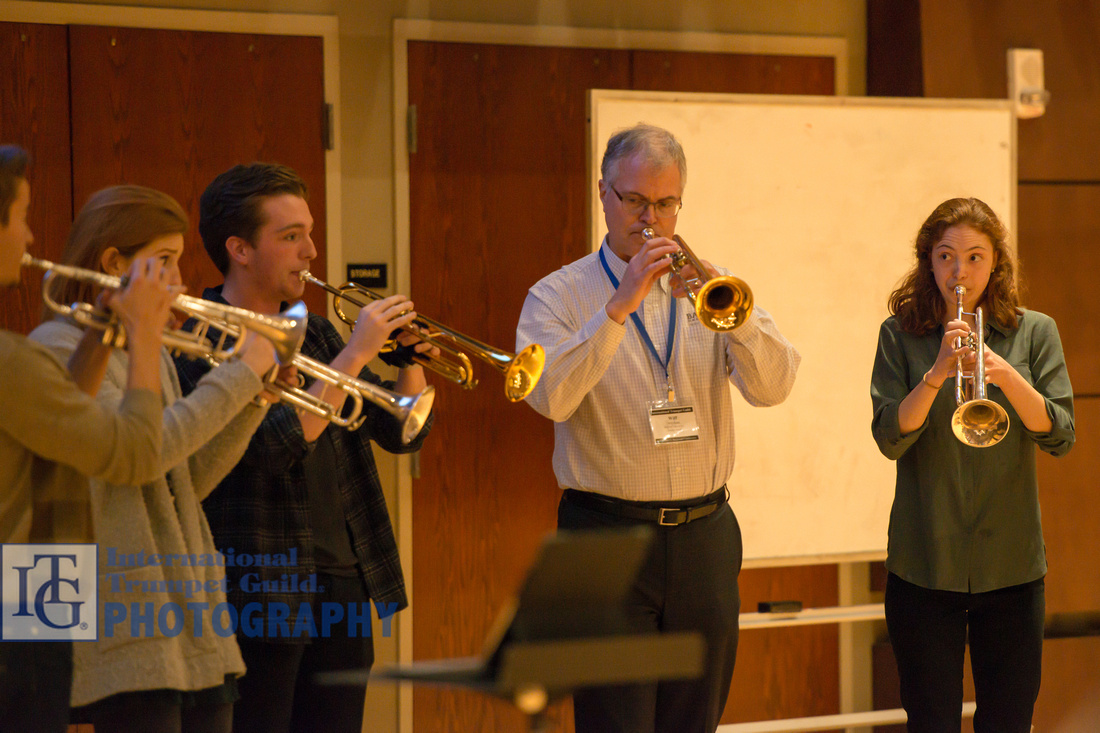 Wiff Rudd and student participants
Wiff Rudd and student participants
Professors Recital #2
The second professors recital opened with Karl Sievers and Lacey Hays performing Erik Morales’s Concerto for Two Trumpets. Both Sievers and Hays filled the hall with their ringing, forward tone qualities throughout the three difficult and energetic movements. ITG Vice-President/President-Elect Grant Peters provided the second performance on the program. Assisted expertly by Paulina Leisring on Eric Ewazen’s Prayer and Praise, Peters’s smooth, full sound was the highlight. Alan Wenger performed John Barnes Chance’s challenging Credo with remarkably fluid multiple tonguing and flexibility, and pianist Jacob Johnson deserves praise for his facile navigation of this difficult piano part. Daniel Kelly and Libby Vanatta closed the program with Arban’s La Cenerentola. Kelly chose to perform this on cornet and had a warm, light, and pleasant sound that sparkled throughout the well executed passages. Kelly and Vanatta’s performance was highlighted by wonderful communication in the rubatos and was a perfect close to a well-attended late-afternoon recital. (BW)
Frontier Brass Band with Vince DiMartino, Wiff Rudd, Michael Anderson, Ryan Sharp, and Anthony Barrington
The hallmark of the inaugural Oklahoma City Regional ITG conference was the showcasing of talent from the renowned artists in the region alongside trumpet legends, and the closing concert was no exception. Featuring the talent-rich Oklahoma City-based Frontier Brass Band, university professors from the region, and renowned performer and educator Vincent DiMartino, the sense of camaraderie and community that made the entire conference so special was on full display.
Made up of local university professors, free-lancers, and local students, the Frontier City Brass Band, under the direction of Don Linn, showcased the extraordinary regional talent by opening with a stunning performance of Where Eagles Sing by Paul Lovatt-Cooper, showcasing the band’s superb pitch, technical facility, and soaring solo cornet lines. Among the selections performed was also an emotionally charged and beautifully phrased setting of ‘Mid All the Traffic by Leonard Ballantine with DiMartino serving as guest conductor.
Frontier Brass Band Artistic Director and University of Central Oklahoma Associate Professor of Trumpet Ryan Sharp expertly navigated multiple-tongued passages while also playing beautifully phrased lines across all registers of the horn with a rich cornet sound on James Curnow’s Concertpiece for Cornet.
Continuing to showcase the area’s excellent trumpet playing, Regional Conference host and Oklahoma City University Professor Michael Anderson showed why he is one of the region’s most respected trumpet artists with a beautiful flugelhorn sound and warm vibrato while performing Gabriel’s Oboe.
The audience remained enthralled through Philip Sparke’s Song and Dance, performed by Baylor University Professor Wiff Rudd with a flowing technique, captivating lower register, and ease of tone that have made him such a sought-after performer and clinician.
Further showcasing young talent, Juilliard School of Music student and Oklahoma City native Anthony Barrington amazed the audience with a sensitive performance of Erik Leidzen’s Songs in the Heart.
Having played a bombastic jazz set the night before, passionate educator and performer Vincent DiMartino showed his trademark versatility and consistent sound by performing a William Remmer arrangement of Stephen Foster’s My Old Kentucky Home, featuring an enviable playful style and flawless technique. Prior to his performance, DiMartino complimented Anthony Barrington for exemplifying the height of the brass band cornet soloist tradition. DiMartino’s kind words were indicative of the uplifting and supportive pedagogical attitude of the entire conference. DiMartino received a standing ovation from an audience obviously appreciative of his greatness and musical authenticity.
The closing concert of the inaugural ITG Regional Conference held at Oklahoma City University was a great melding of local talent and nationally acclaimed performers and should leave great hope and serve as an outstanding model for future regional ITG conferences. (AJ)
Reporter Bios
Jason Bergman (JB) is editor of the Orchestra Section Profile in the ITG Journal and serves on the ITG Board of Directors. He is Assistant Professor of Trumpet at the University of North Texas.
Alexander Davis (AD) is a freelance writer and currently serves as a graduate teaching assistant
at Texas Tech University.
Casey Goldman (CG) is currently pursing a DMA at The University of North Texas.
Benjamin Hay (BH) is Instructor of Music (Trumpet/Theory) at Northeastern State University in Tahlequah, Oklahoma.
Aaron Jensen (AJ) is a DMA student at the University of North Texas.
Jacquelyn Lankford (JL) is currently a DMA student and teaching fellow at the University of North Texas, and previously received degrees from the Eastman School of Music and New Mexico State University. She also holds the position of second trumpet for the Monroe Symphony Orchestra in Monroe, Louisiana.
Cathy Leach (CL), ITG president, is professor of music and associate director at the University of Tennessee, as well as former principal trumpet with the Knoxville Symphony.
Grant Peters (GP) is professor of music at Missouri State University, where he teaches trumpet and coordinates the brass area. He is currently the ITG vice-president/president-elect.
Richard Tirk (RT) teaches trumpet, jazz, and coordinates the graduate program at Southwestern Oklahoma State University in Weatherford, Oklahoma.
Brian Walker (BW) is assistant professor of trumpet at Tarleton State University in Stephenville, Texas.
Spencer Wallin (SW) is the Adjunct Professor of High Brass at Navarro College. He is also finishing his DMA at the University of North Texas, where he studies with Dr. Jason Bergman.
]]>Special Report • Compiled by Peter Wood
Photos by Michael Anderson, Norman Bergstrom, Del Lyren, Brian Shook, and John Tamer
Conference Prelude Performances
* Indicates premiere performances.
Groups are listed alphabetically.
Click here for more prelude ensemble photos
ASU Trumpet Ensemble, Appalachian State University
Dr. James Stokes, director
Benjamin Sebastian, Brittney Self, Arias Fischer, Ariel Shores, Tim Hamilton
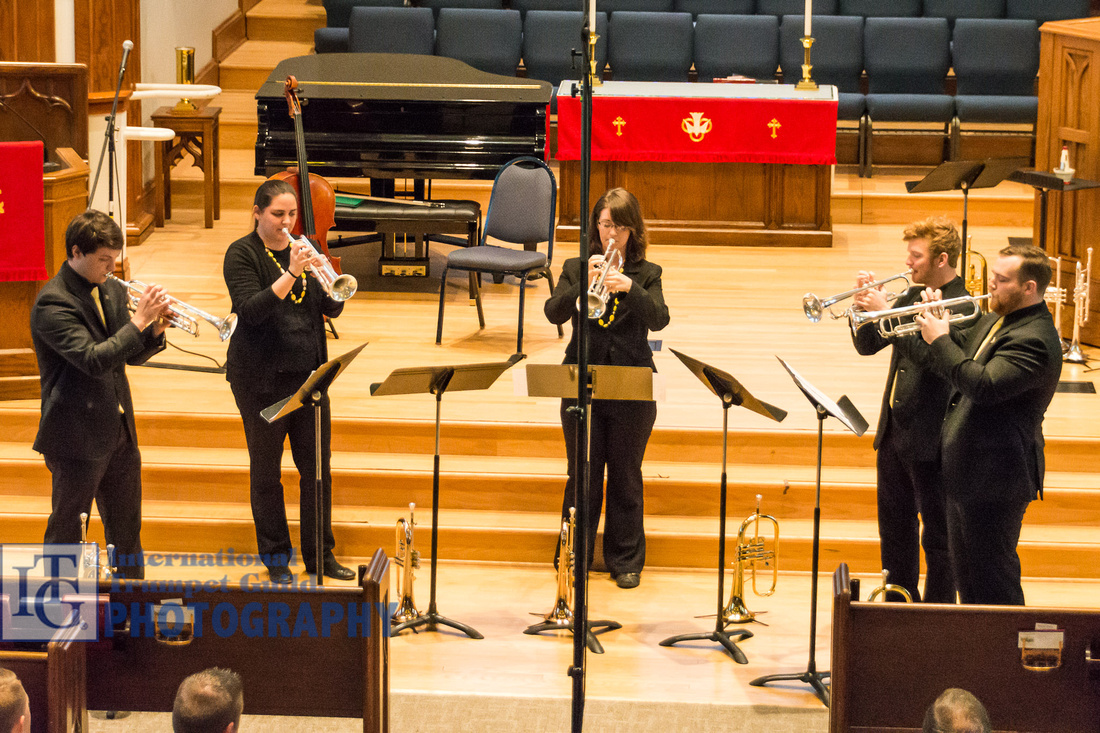 Appalachian State University Trumpet Ensemble
Appalachian State University Trumpet Ensemble
Metallic Fury by Erik Morales
Under the direction of Dr. James Stokes, the ASU Trumpet Ensemble played with dramatic dynamic contrast and full sound quality. In addition, their blending of tone colors and matching of articulation was commendable. The use of the flugelhorns in the middle section of the piece added a warm, velvety color and showcased well the lyrical side of the ensemble. Seamlessly switching back to trumpets for the exuberant, majestic ending, the ensemble maintained a brilliance that fit the character of this exciting piece perfectly. (WK)
Brighton High School Trumpet Ensemble
Sharon B Long, director
Lauren Arcuri, Adi Bowden, Alec Gillis, Lucus Hardy, Nick Quebbeman, Angelina Placido, Robert Powers, Shane Spangler
 Brighton High School Trumpet Ensemble
Brighton High School Trumpet Ensemble
Poet and Peasant Overture by Franz von Suppé
The Brighton High School Trumpet Ensemble blew the crowd away with this performance of von Suppé’s Poet and Peasant Overture. This group of eight high school students showcased extreme versatility with lyrical solos and impressive technique. The ensemble showed skill beyond their years with their chamber music sensitivity and individual talents. (BB)
Dickinson College Trumpet Ensemble
Jeffrey Wohlbach, director
Morgan Bates, Herman Makosky, Ian White, Caroline Snyder, Miranda Lape
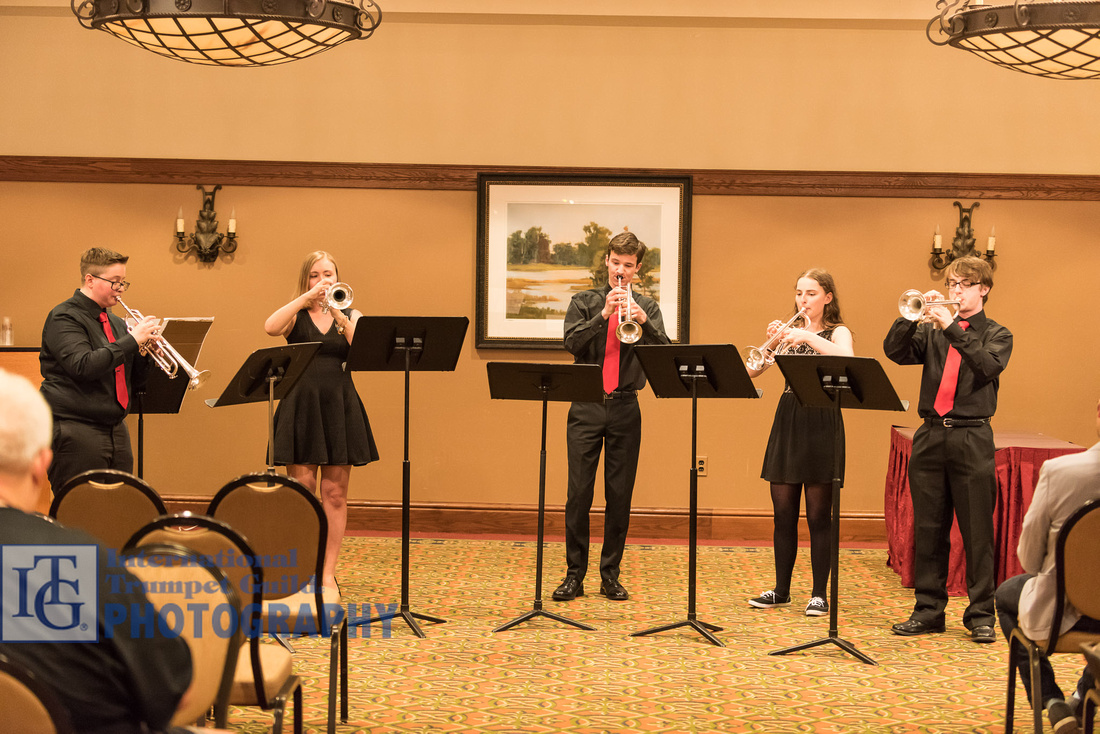 Dickinson College Trumpet Ensemble
Dickinson College Trumpet Ensemble
Revecy venir du printans by Claude Le Jeune, arranged by Jay Lichtmann
The Dickinson College Trumpet Ensemble, under the direction of Jeffrey Wohlbach, performed Jay Lichtmann's arrangement of Revecy venir du printans by Claude Le Jeune. The five-member group played with fine ensemble precision and expressive nuance. Their sweet sound, warm blend, and soft dynamic levels were notable highlights, along with the group’s tasteful command of Renaissance polyphonic style. (EK)
IUP Trumpet Ensemble, Indiana University of Pennsylvania
Dr. Kevin Eisensmith, director
Maria Baldoni, Holly Boyles, Victoria Cotter, Lukas Deist, Randy Devlin, Kayla Greer, Ryan Gross, Anastazia Hall, Michael Helwig, Matthew Huff, Marie Mencher, Roxanne Person, Matthew Prinkley, David Saylor
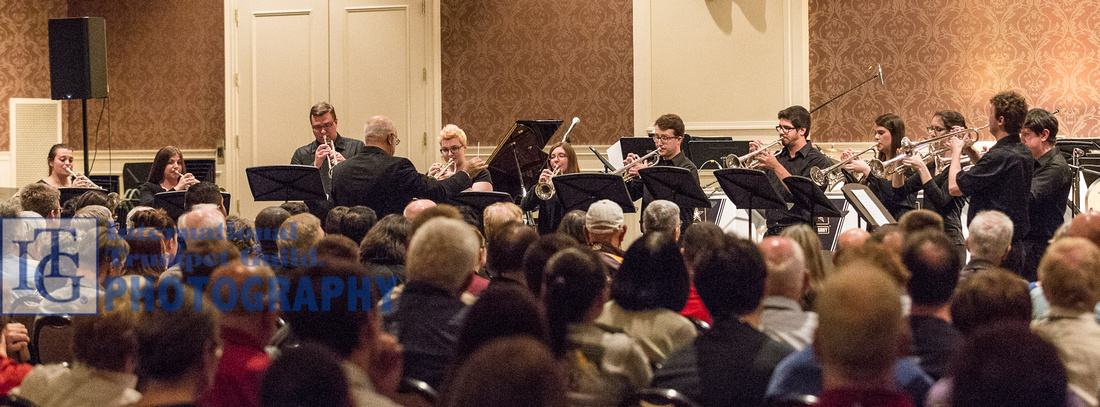 Indiana University of Pennsylvania Trumpet Ensemble
Indiana University of Pennsylvania Trumpet Ensemble
Even When He is Silent by Kim André Arnesen, arranged by James Olcott
A Joyful Noise by David Ferguson
The first selection from the IUP Trumpet Ensemble commenced with a beautifully played, broad-sounding chorale performed with great reverence. With built-in dynamics, the main theme returns over an ostinato and moving resolution. The second piece offered a four-note motif that echoed neatly around the ensemble. A well known hymn theme transitioned into a cascading rhythmic fanfare and climactic ending. This was a fine performance all-around. (NM)
Click here for more prelude ensemble photos
Mariachi Espuelas de Plata, North Side High School
Ramon Nino III, director
Trumpets: Fernando Flores, Raul Martinez, Diego Reyna
Violins: Nancy Mandujano, Sebastian Martinez, Joel Ramirez, Mariela Ramirez
Guitar: Andrea Richards
Vihuela: Donaldo Rubio
Guitarron: Jessica Salas
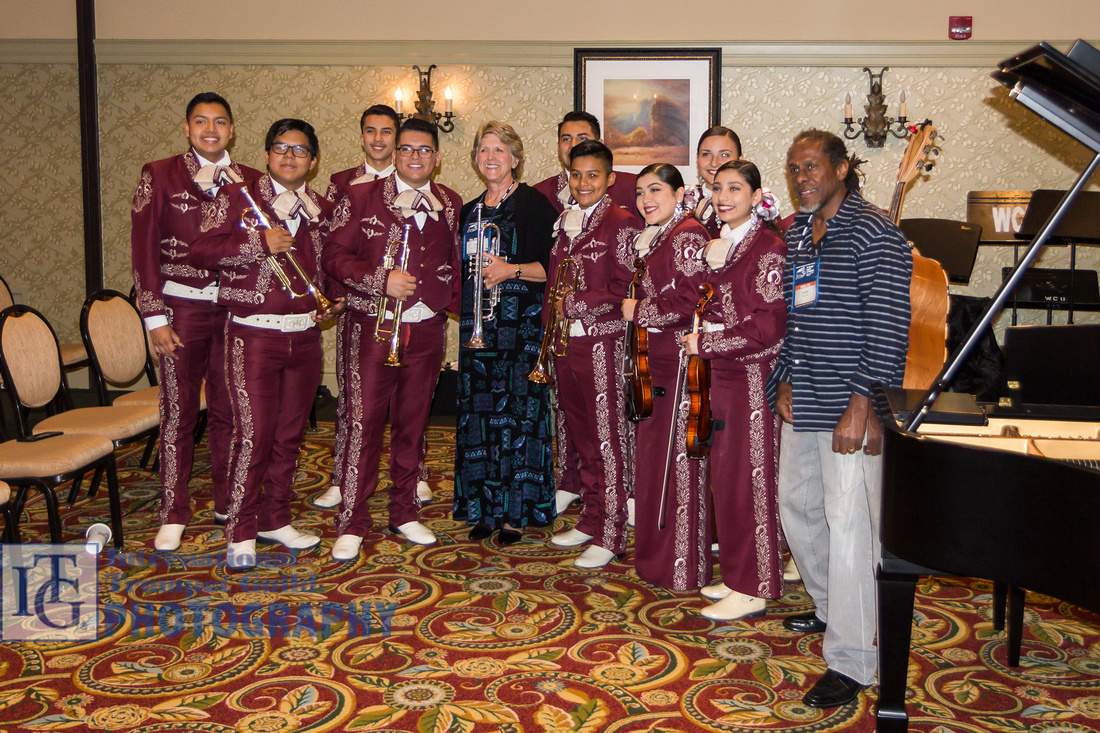 Mariachi Espuelas de Plata from North Side High School
Mariachi Espuelas de Plata from North Side High School
Homenaje A Miguel Martinez by José Hernandez
Camino Real de Colima by Rubén Fuentes-Gassón
Mariachi Espuelas de Plata, from North Side High School in Fort Worth, Texas, is a traditional mariachi ensemble. Both pieces that the group performed featured trumpet and vocals, in addition to violin, guitar, vihuela, and guitarron, The members of this terrific ensemble wore beautiful, colorful outfits, and their performance was greatly enjoyed by all. This was a refreshingly unique and culturally enriching opener for Ginger Turner’s session. (RW)
McGill University Trumpet Ensemble
Richard Stoelzel, director
Alexander Freund, Ben Hare, Francis LaPorte, Joey Moore, Morgan Mitteer
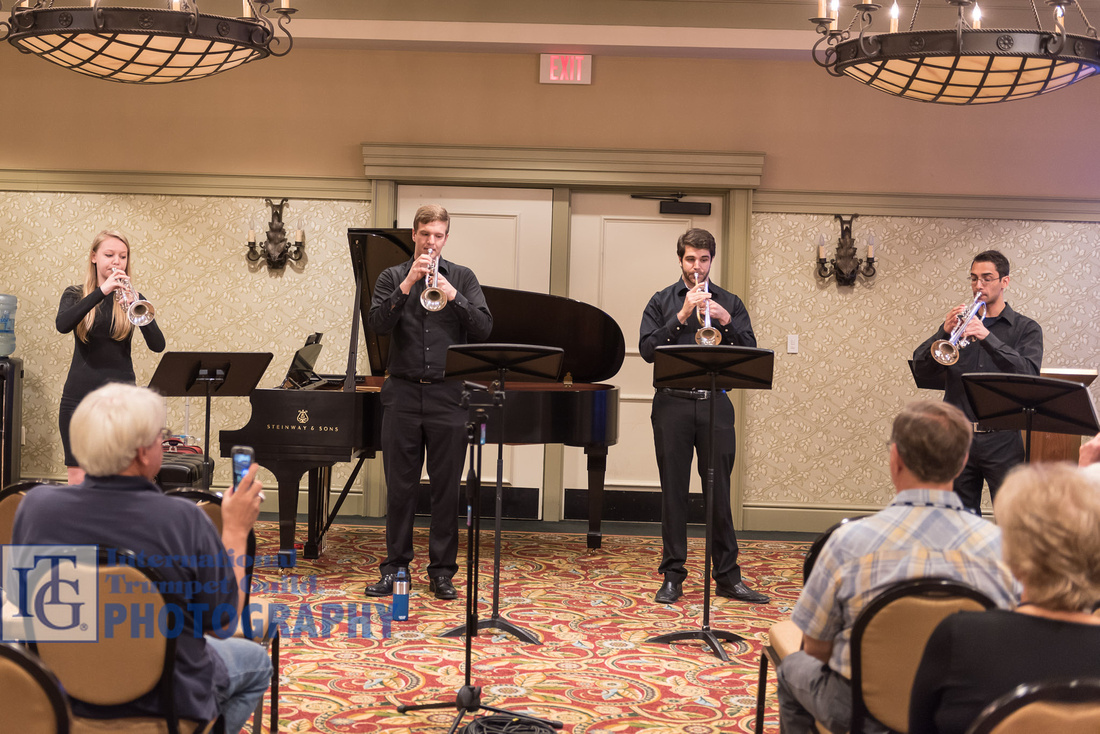 McGill University Trumpet Ensemble
McGill University Trumpet Ensemble
Fanfare for an Angel by James Stephenson
L’espirit de la Trompette by James Stephenson, arranged by Ben Hare
The quartet’s sprightly performance of James Stephenson’s Fanfare for an Angel served as the opener. From onset to finish, the ensemble’s excellent balance and homogeneous sound was consistently evident. A second and final work was ensemble member Ben Hare’s arrangement of Stephenson’s L’espirit de la Trompette. This was a brilliant showcase for Hare and his colleagues Morgan Mitteer, Joey Moore, and Francis LaPorte. Congratulations are in order to the McGill University Trumpet Ensemble for a top-notch performance. (LE)
Messiah College Trumpet Ensemble
Dr. William Stowman, director
William Landon, Matthew Ruwe, Hannah Leposa, Austin Funkhouser, Taylor Quinn, Mitch Weaver
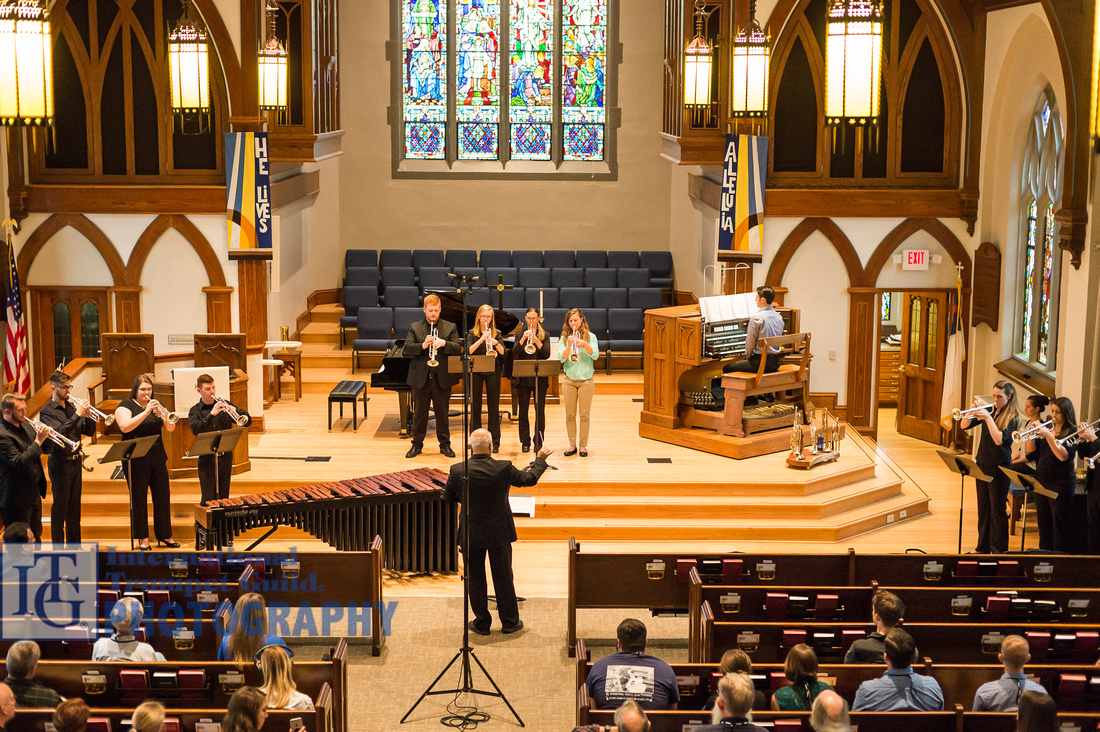 Messiah College Trumpet Ensemble
Messiah College Trumpet Ensemble
Birds of Paradise by Erik Morales
The Messiah College Trumpet Ensemble, performing as the prelude ensemble before William Stowman's recital, exhibited great blend and musicianship on their performance of Erik Morales’s Birds of Paradise. Highlights of the performance were certainly impressive low notes in the flugelhorns and the communication within the ensemble as a whole. The piece required strong ensemble playing and significant individual challenges, and this ensemble was certainly up to the challenge! (BB)
Messiah College Trumpet Ensemble
Dr. William Stowman, director
William Landon, Matthew Ruwe, Hannah Leposa, Austin Funkhouser, Taylor Quinn, Mitch Weaver
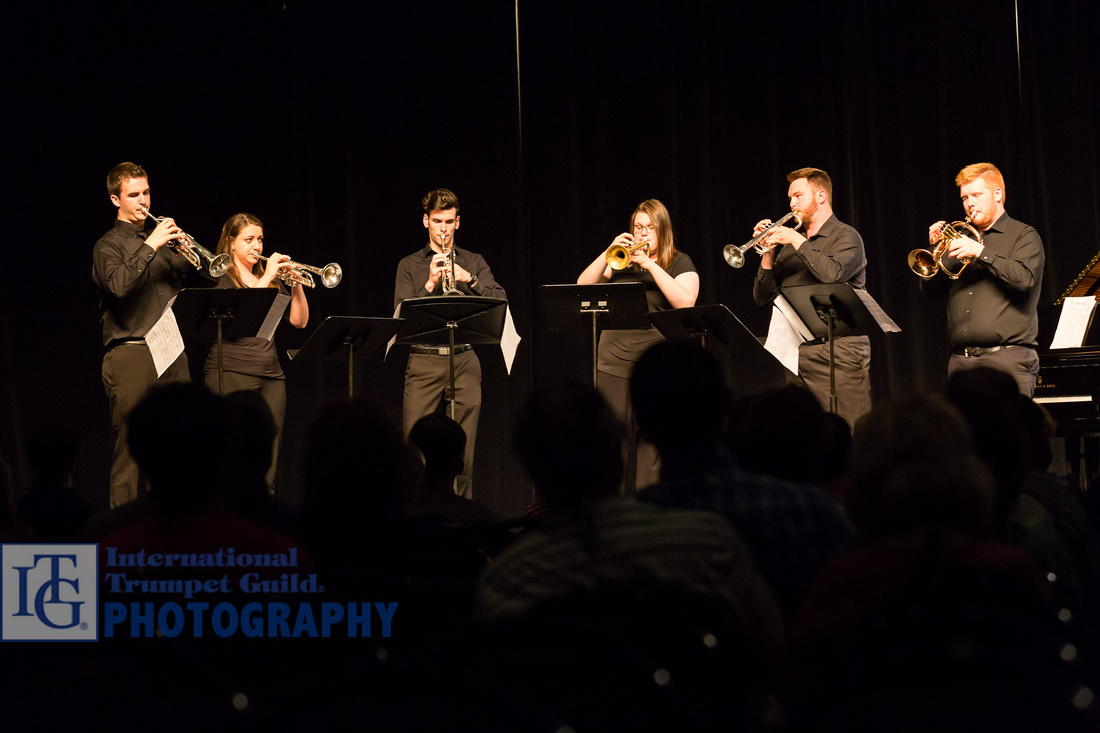 Messiah College Trumpet Ensemble
Messiah College Trumpet Ensemble
Birds of Paradise by Erik Morales
Australian trumpeter Nadje Noordhuis's recital opened with a prelude by the Messiah College Trumpet Ensemble performing Erik Morales's Birds of Paradise. The ensemble filled the hall with sound. They displayed great dynamic expressiveness and were locked in on the unison octave passages. (KM)
Click here for more prelude ensemble photos
Michigan State University Trumpet Ensemble
Justin Emerich, director
Eduardo Farias, Joon Park, Alessandro Bonita, Jonathan Chaif, Patrick Forgione, Marty Malfroid
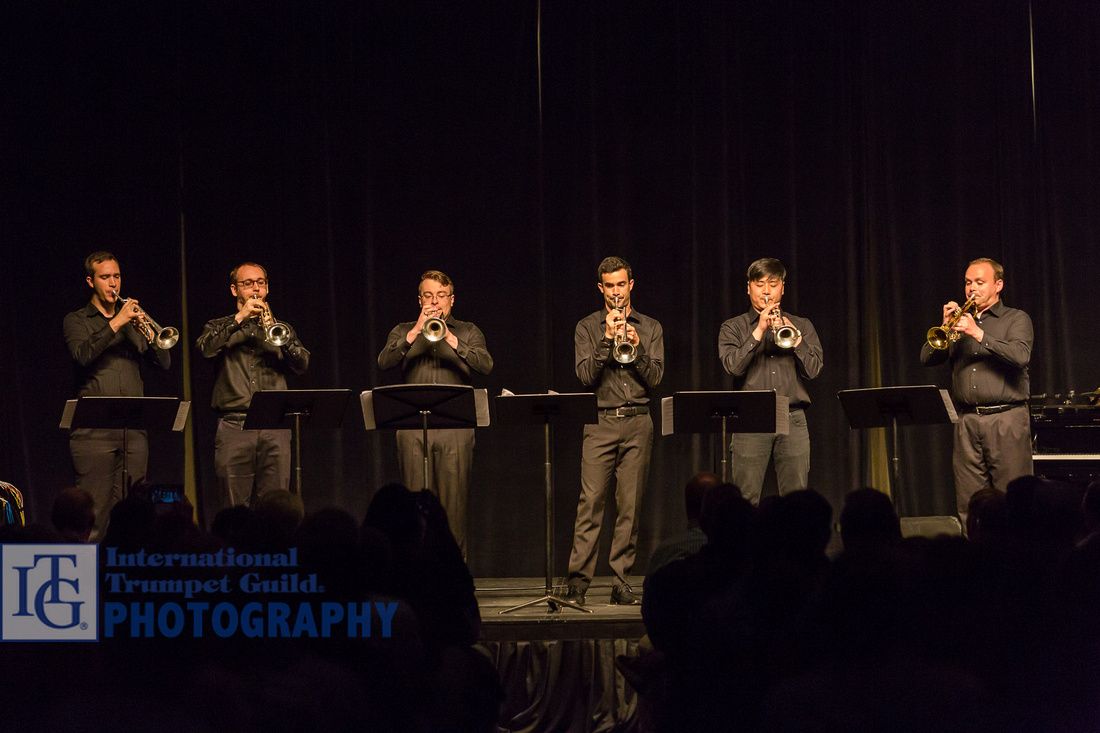 Michigan State University Trumpet Ensemble
Michigan State University Trumpet Ensemble
Dürrenhorn Passage by Kevin McKee
The ensemble launched into the selection with a martial round-like fanfare worthy of their Spartan nickname. The hymn-like chorale section that followed was played with great energy and was highly inspiring. An ominous build led to a climactic ending featuring the original melody. A superb performance all-around! (NM)
Missouri Southern State University Trumpet Ensemble
Frederick Green II, Director
Oliver Smith, Cayla Roanhorse, Josh Newburry, Tony Sfortunato, Austin Kinard, Tyler Jones
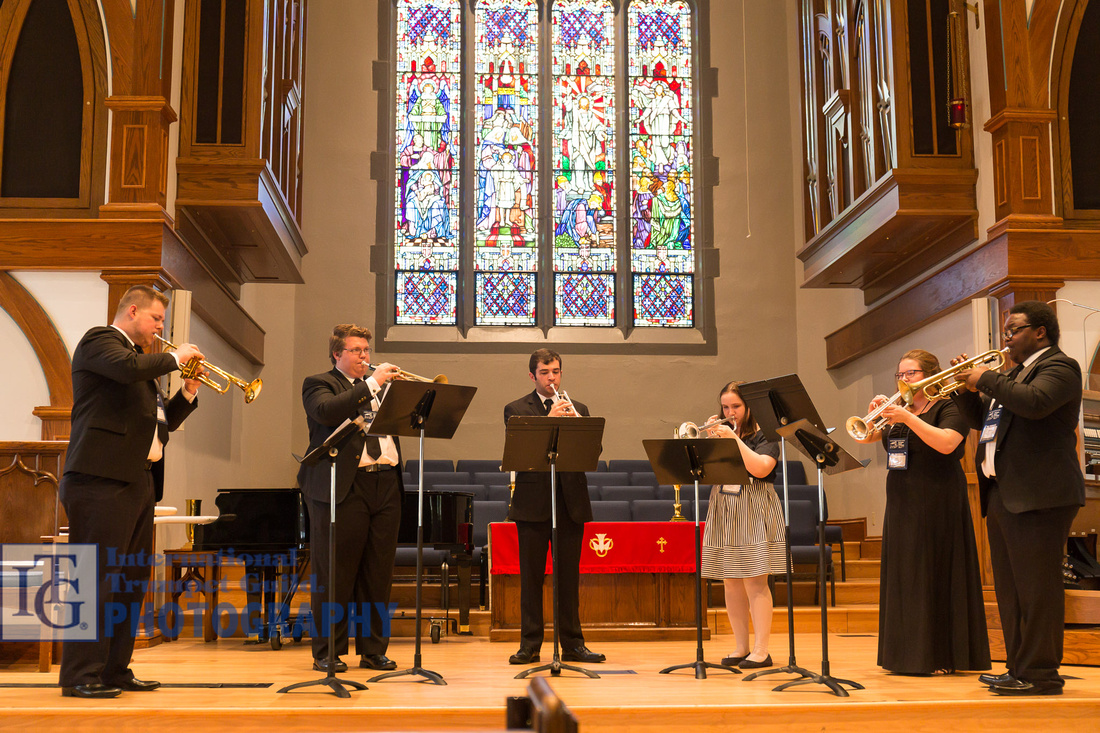 Missouri Southern State University
Missouri Southern State University
* Headed Home by Jemetris Brown
The Missouri Southern State University trumpet ensemble performed group member Jemetris Brown’s Headed Home for the prelude performance of the Affiliate Chapters Showcase Recital at the First United Methodist Church. The performance marked the premier of this work and featured all seven members of the ensemble playing smooth, flowing, melodic lines with full, rich chords. The group’s performance was well received by the audience and was an excellent introduction for the program that followed. (RW)
OU Graduate Trumpet Ensemble, University of Oklahoma
Larry Burroughs, director
Larry Burroughs, Josh Harney, Benjamin Hay, Lindsey Jessick, Ricky Spears
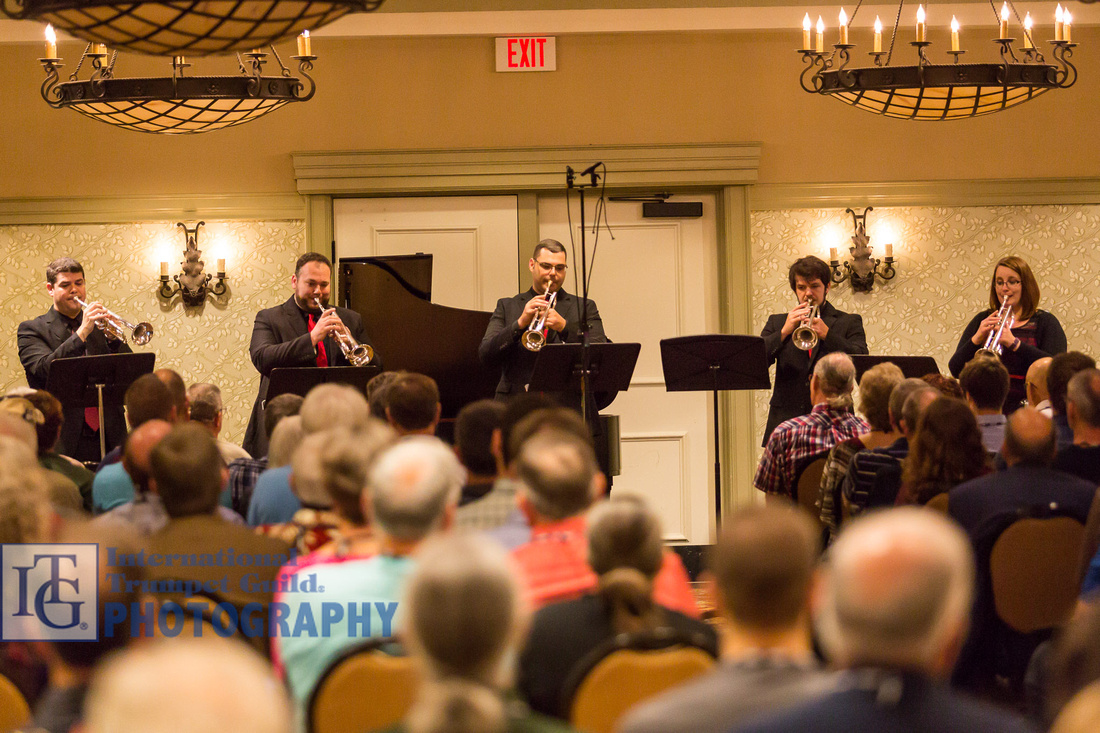 University of Oklahoma Graduate Trumpet Ensemble
University of Oklahoma Graduate Trumpet Ensemble
Centrifuge by Jason Dovel
The University of Oklahoma Graduate Trumpet Ensemble opened Bernardo Medel's recital with a thrilling rendition of Jason Dovel's Centrifuge Wednesday morning. From the interplay of the opening solo and Harmon-muted trumpet to the tight, fast passages, the ensemble performed brilliantly. Tonal blending and precisely matching articulations were impressive for this fine ensemble, led by Larry Burroughs. The dark, ominous playing of the flugelhorn led to the exciting finale, full of rhythmic intensity and excitement. This brilliant performance set the stage well for the Rafael Méndez Extravaganza that followed. (DD)
Shenandoah Trumpet Ensemble, Shenandoah Conservatory
Dr. Chuck Seipp and Dr. Scott Nelson, directors
Tony Barnwell, Jennifer Riddle, Mike Christie, Joshua Duran, Nick Serbu, Jonathan Wyatt, James Looney, Nathan Bradley, Kyle Vogan, Amanda Conkins
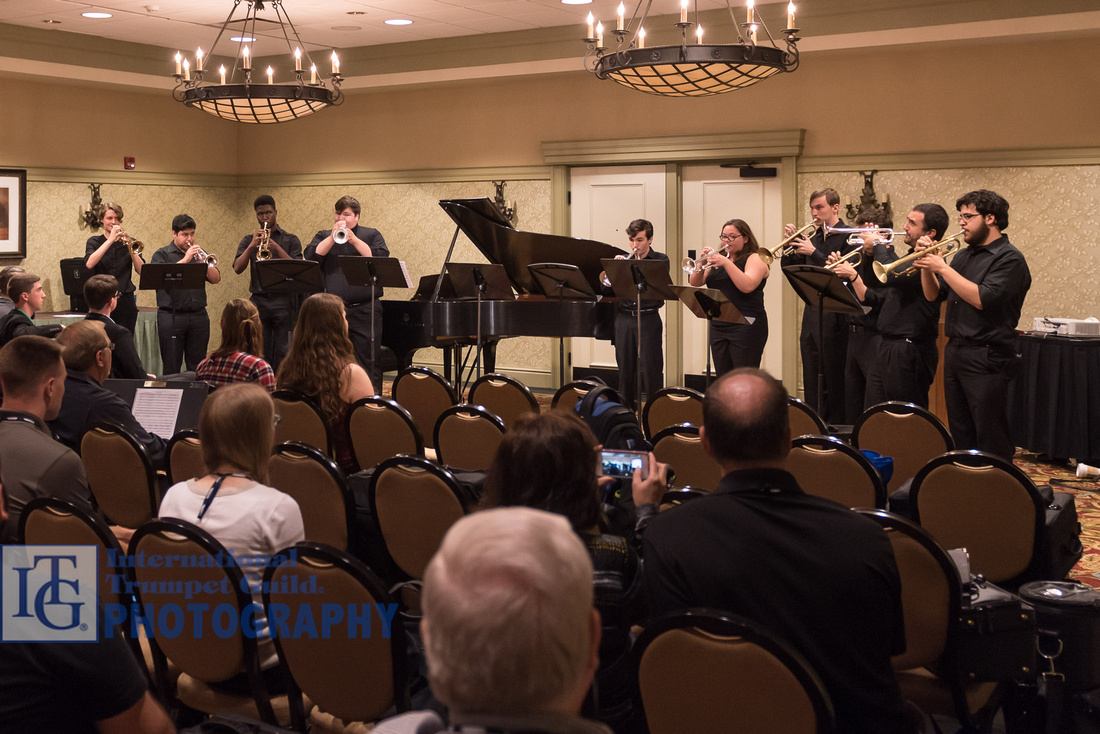 Shenandoah Conservatory Trumpet Ensemble
Shenandoah Conservatory Trumpet Ensemble
* Click by David Marlatt
* Spree by Jonathan Wyatt
The Shenandoah Conservatory opened boldly from the back of the ballroom with antiphonal Bach. The large ensemble followed with two premieres: Click by David Marlatt and Spree by Jonathan Wyatt, a member of the ensemble. The group exhibited machine-like precision and lyrical beauty, particularly in the flugel lines. (BB)
Click here for more prelude ensemble photos
Trompettes do Cerrado, Universidade Federal de Goiás
Dr. Antonio Cardoso, director
Antonio Cardoso, Nivaldo Junior, Paulo Ross, Marcelo Eterno, Felipe Arújo, Ricardo Dias, Guilherme Toledo, Wellington Santana, Gerson Amarillo, Tarcísio Santos, Wesley Ribeiro
 Trompettes do Cerrado
Fantasia Brasileira by José Ursicino da Silva “Duda”
Trompettes do Cerrado
Fantasia Brasileira by José Ursicino da Silva “Duda”
The nine-member Trompetes do Cerrado from the Universidade Federal de Goiás in Brazil put on a superb performance of Maestro Duda’s Fantasia Brasileria. The four-movement work features styles and rhythms typical of Brazilian music, and the ensemble presented it with great energy, enthusiasm, and flair. This piece, which the group performed with five trumpets and four flugelhorns, is available through Triplo Press as part of the ”Music from Brazil” series. (KE)
UD Trumpet Ensemble, University of Delaware
Robert Skoniczin, director
Derek Dillman, Brandon Hess, Adrianna Korey, Nick Pietuszka, Jessica Sawall, Lucas Schumann
 University of Delaware Trumpet Ensemble
University of Delaware Trumpet Ensemble
Birds of Paradise by Erik Morales
The University of Delaware Trumpet Ensemble performed Erik Morales’s Birds of Paradise. The six-member ensemble, directed by Robert Skoniczin, performed the work from memory, allowing them to incorporate some staging with the music. As with other compositions by Morales, Birds of Paradise is filled with fanfares and flourishes that create great excitement. The UD Trumpet Ensemble gave an exciting performance of the piece, with exceptional individual and ensemble playing, to the delight of the audience. (KE)
UF Trumpet Ensemble, University of Florida
Dr. Randolph Lee, director
Isaac Brantley, Michael Breen, Josh Drourr, Andy Duarte, Zach Roberts, Nick Vivas
 University of Florida Trumpet Ensemble
University of Florida Trumpet Ensemble
Harambee by Paul Basler
The University of Florida Trumpet Ensemble, under the direction of Dr. Randy Lee, performed Paul Basler’s Harambee. In Swahili, “harambee” means “all pull together” or “collective effort.” The piece is written in a call-and-response format and evokes images of African melody and rhythms. The five-member ensemble delivered an enthusiastic and spirited performance. The group had a controlled sound and excellent intonation during the many unison passages. It was an enjoyable performance, and the piece is available through RM Williams Publishing. (KE)
UIndy Trumpet Ensemble, University of Indianapolis
Larry Powell, director
Greg Benham, Sadie Layman, Breann Royer, Ty Helms, Lizzie Essig, Brenda Clark, Zach Losacker, David Wolfe, Larry Powell
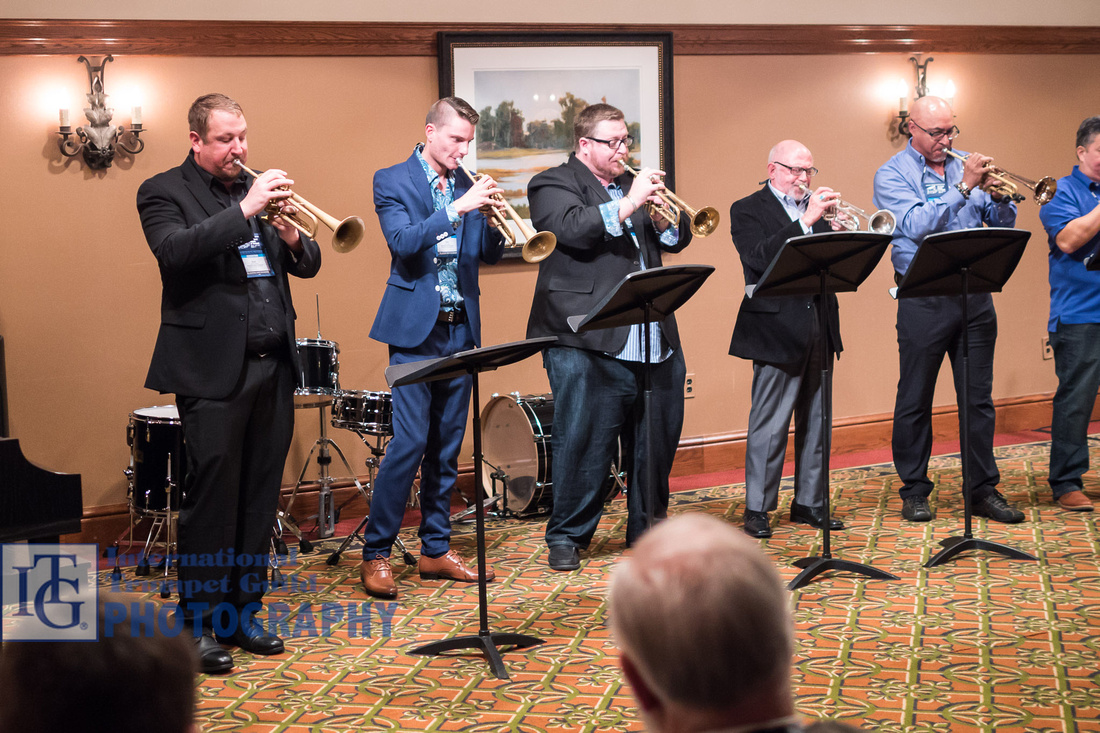 UIndy Trumpet Ensemble, University of Indianapolis
UIndy Trumpet Ensemble, University of Indianapolis
Fanfare for St. Edmundsbury by Benjamin Britten
Fanfare of the Bells by Jennifer Fletcher
The UIndy Trumpet Ensemble, led by Professor Larry Powell, opened the recital by Olivier Anthony Theurillat with a prelude of two fantastic fanfares. First performing Benjamin Britten’s Fanfare for St. Edmundsbury, the ensemble of eight trumpeters played with precision and power, demonstrating good technique, sound, and flair. The audience then enjoyed Jennifer Fletcher’s Fanfare of the Bells, a complex piece in which the ensemble played musically, with an exciting flourish that served as a great finish to this prelude performance. (SW)
Click here for more prelude ensemble photos
UMaine Trumpet Ensemble, University of Maine
Dr. Jack Burt, director
Kyle Goupille, Annie Morgan, Brandon Emerson, Anneliese Smith, Vanessa Caron, Hannah Edgecomb
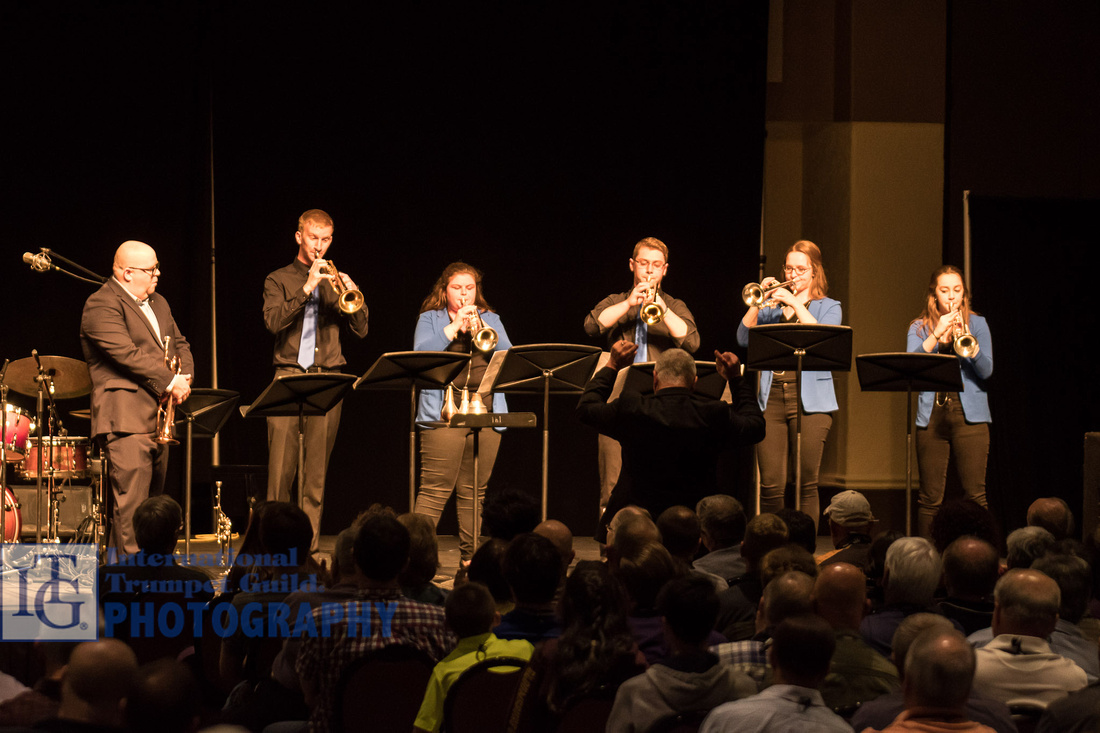 University of Maine Trumpet Ensemble
University of Maine Trumpet Ensemble
Idea #24 by Terry Everson
The University of Maine Trumpet Ensemble, directed by Dr. Jack Burt, excited the audience with their performance of Terry Everson's Idea #24. Special guest Trent Austin added flair to the ensemble with his impressive high-tessitura playing. Idea #24 is a virtuosic composition, which this ensemble performed spectacularly. All members demonstrated great technical command in playing quick running lines that passed seamlessly from voice to voice and musical sensitivity in performing numerous styles from Classical to Latin jazz. (AW)
UNCP Trumpet Ensemble, University of North Carolina at Pembroke
Dr. Timothy M. Altman, director
Terri Smith, Rachel McCoy, William Hebert, William Boyce, Breion Thomas, Dylan Quick, Timothy Altman
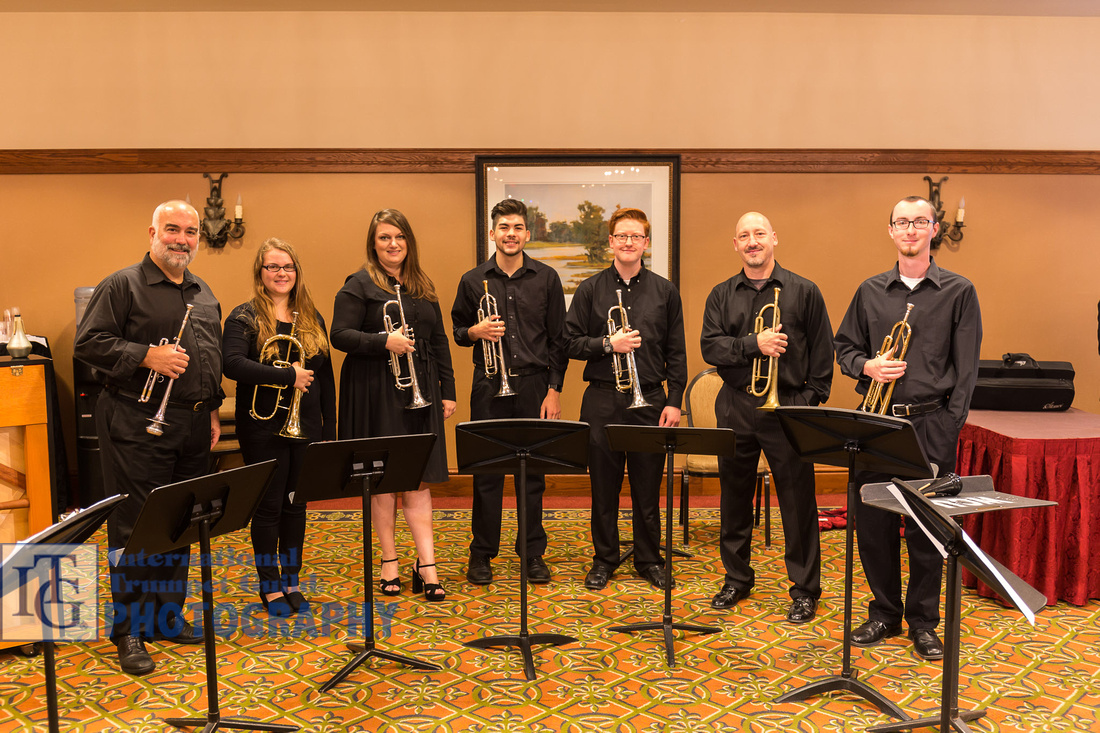 UNC at Pembroke Trumpet Ensemble
UNC at Pembroke Trumpet Ensemble
Subo by Joseph Sheehan
The trumpet ensemble from the University of North Carolina at Pembroke performed Subo, a piece inspired by the music of Ghana and featuring syncopated rhythms and allusions to African drumming and jazz. The trumpeters performed with great dynamic contrast and versatility as the piece featured a variety of styles that required great flexibility, rapid articulation, and quick stylistic changes. The rhythmic ostinato in the flugelhorn prevailed throughout the piece as muted trumpets oscillated between pointed articulated sections and soaring melodic passages, culminating in a sweet, lyrical finish. (OF)
UNF Trumpet Ensemble, University of North Florida
Dr. Randall Tinnin, director
Trumpets: Ashton Sharrett, Matthew Rossmann, Carson Smisek, Brian Hickey, Jonathan McRae, Kevin Fulford, Stephen Grondin, Elizabeth Risner, Anthony Stagnitta; Horns: Aaron Lehrian, Greg Balut; Tuba: Clement Dutheil
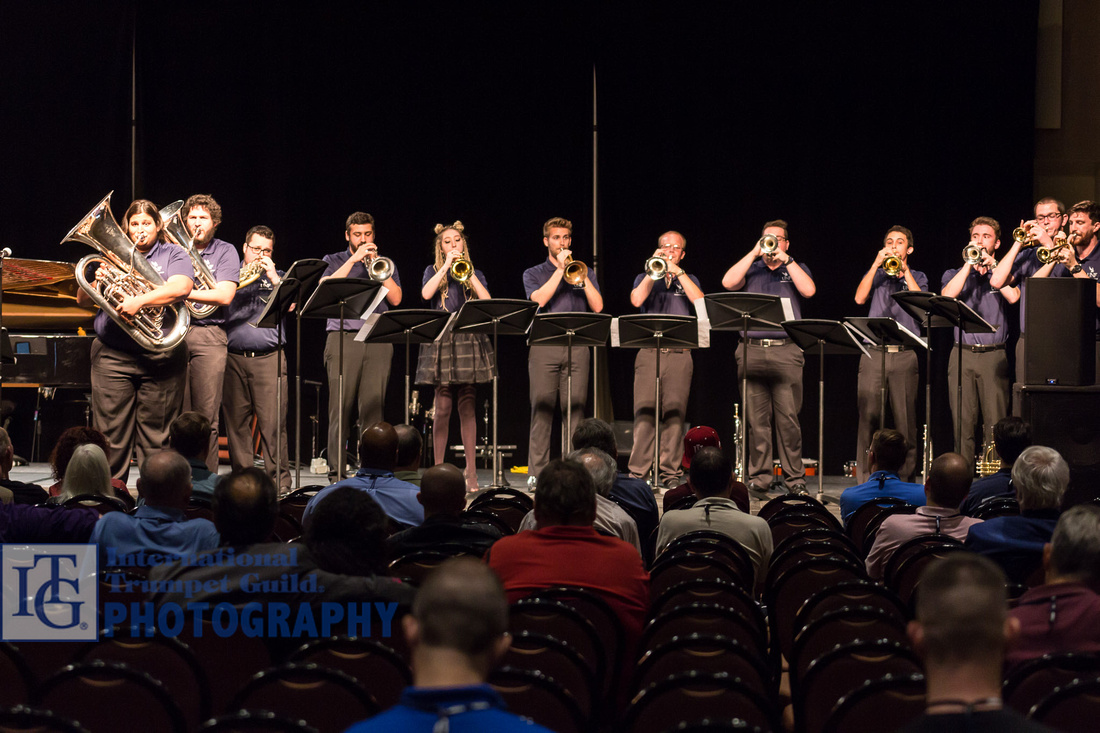 University of North Florida Trumpet Ensemble
University of North Florida Trumpet Ensemble
Frozen by Christophe Beck
The Ceremonial Brass, consisting of students at University of North Florida under the direction of Dr. Randall Tinnin, performed Christophe Beck’s Frozen. The ensemble ranged from piccolo trumpet to tuba, giving the ensemble a wide range within which to play. Mutes, stomping, change of direction, and ornaments all contributed to the eclectic mixture of colors throughout the work that alternated between driving passages, full chords, and singing lyrical sections. Heralding fanfares in the piccolo trumpet combined with lush chords formed by the rest of the ensemble to generate an exciting finish. (WK)
United States Air Force Academy Band Trumpets
Lieutenant Colonel Daniel L. Price, Commander
MSgt Tim Allums, TSgt Patrick Brush, TSgt Chris Hammiel, SSgt Adrian Holton, SSgt Benjamin Sampson, SrA Andrew Fowler
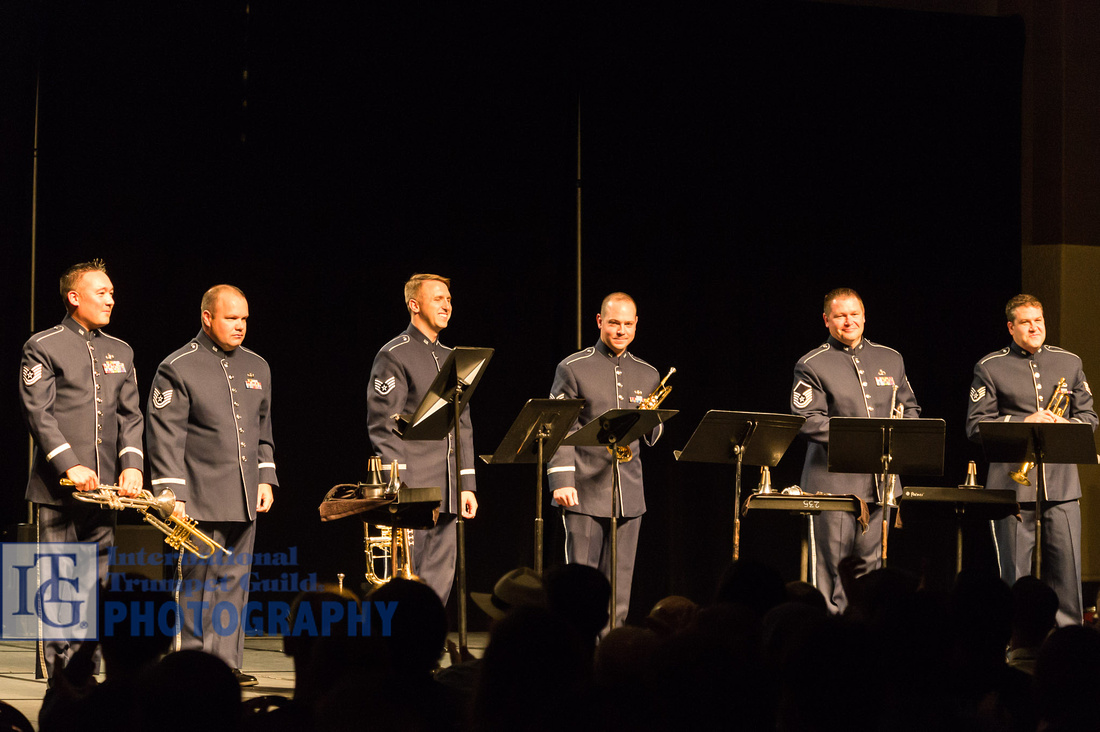 US Air Force Academy Trumpet Ensemble
US Air Force Academy Trumpet Ensemble
Americana Medley by Aaron Copland and George Gershwin, arranged by Ssgts Adrian Holton and Benjamin Sampson
The US Air Force Academy Band Trumpets performed a brilliant Americana Medley, arranged by ensemble members Staff Sergeants Adrian Holton and Benjamin Sampson. The instrumentation of the six-member group included piccolo trumpet and four B-flat trumpets, along with a four-valve flugelhorn that maximized its lowest range to provide a bass line that at times sounded surprisingly like a euphonium. The creative arrangement made effective use of cup mutes on the quartet of B-flat trumpets to accompany solo passages by the excellent piccolo trumpet and flugelhorn. Beginning with “Buckaroo Holiday” from Copland’s Rodeo, the medley also featured excerpts from Gershwin’s Porgy and Bess. Ranging from crisp ensemble virtuosity to raucous big band section playing, the US Air Force Academy Trumpets dazzled the appreciative audience. (EK)
Click here for more prelude ensemble photos
University of Iowa Trumpet Ensemble
Dr. Amy Schendel, director
Kenken Gorder, Evan Fowler, Jarrid Jaynes, Lee Stickney, Joseph Arch, Aunna Marzen, Claire McCall
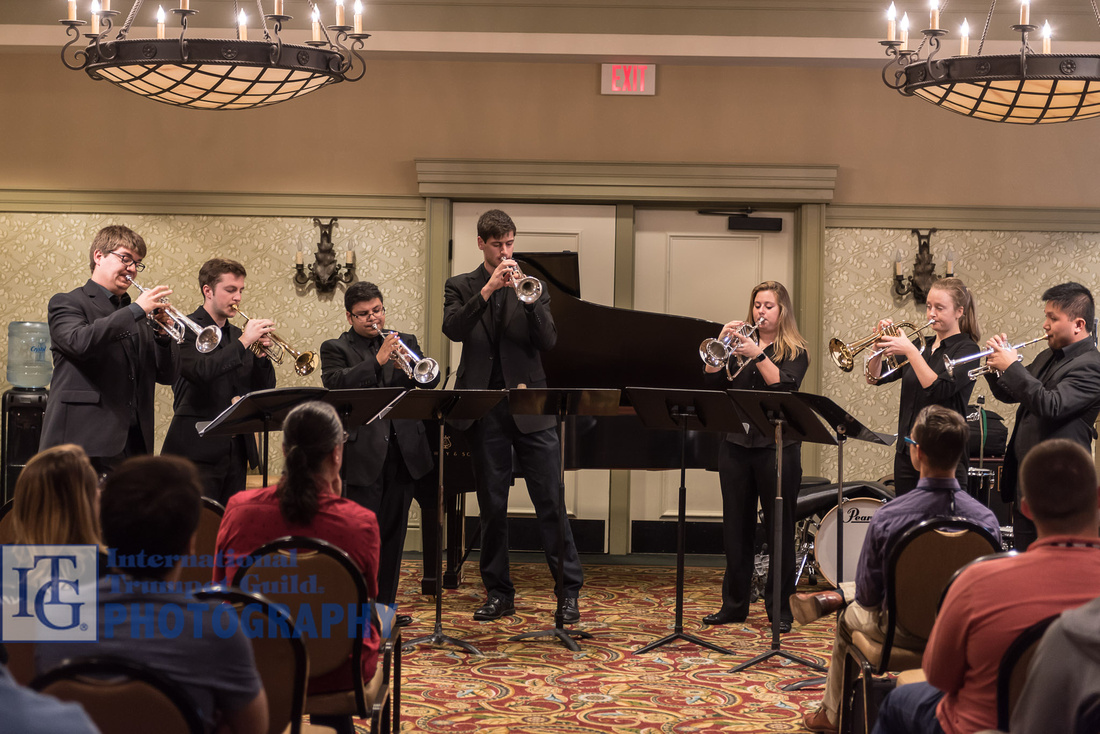 University of Iowa Trumpet Ensemble
University of Iowa Trumpet Ensemble
Let It Rest by Andrew Koss
James Wood’s clinic opened with a performance by the University of Iowa Trumpet Ensemble, under the guidance of Dr. Amy Schendel, of Andrew Koss’s Let It Rest. The ensemble handled the opening rhythmic motive as it passed from player to player with ease. The shared fragmented line evoked images for the listener of moving parts within a machine. The piece transitioned to a beautiful array of swelling lines and harmonic motion as it came to a close. Overall, it was a fantastic performance by the ensemble, showcasing a wide variety of colors and timbres for the audience to enjoy. (JS)
University of Tennessee Trumpet Ensemble
Dr. Cathy Leach and Ms. Tina Erickson, directors
Aaron Kannengieser, Elise Armstrong, Elliott Rose, Garry Tyler Smith, Zane Winchester, Seth Felker, Darby Flaherty, Joseph Goyeau
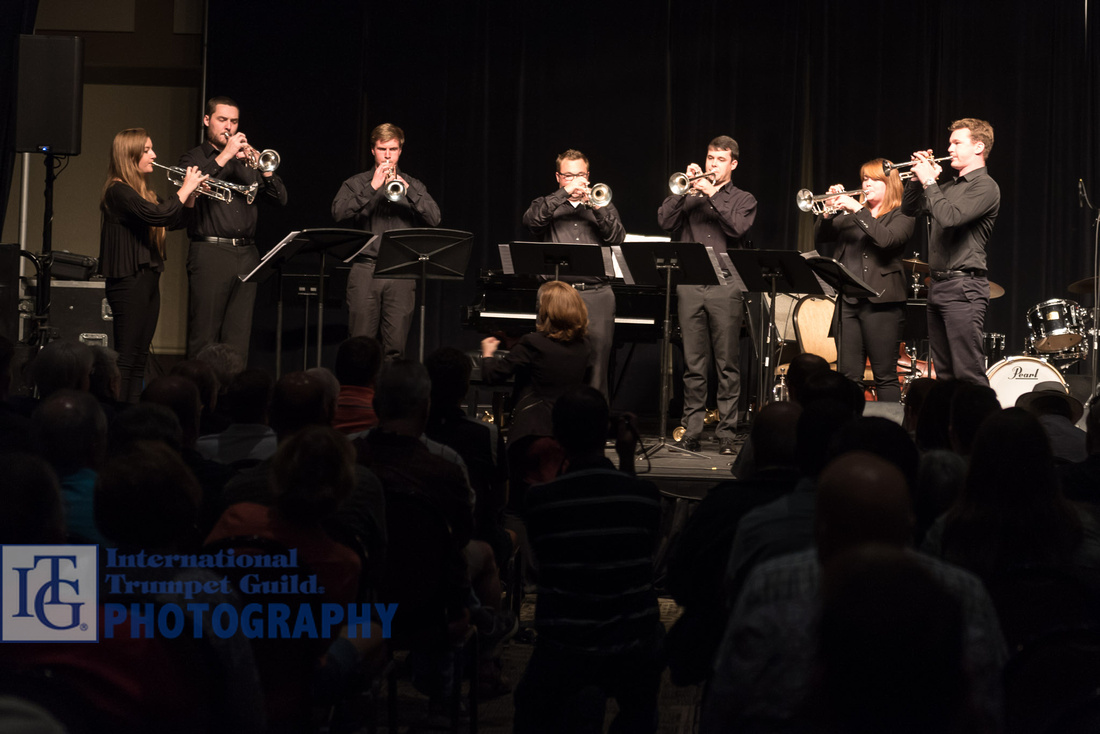 University of Tennessee Trumpet Ensemble
University of Tennessee Trumpet Ensemble
Light Cavalry Overture by Franz von Suppé, arranged by Cathy Leach
The University of Tennessee Trumpet Ensemble launched into the von Suppé classic with a spirited fanfare bursting with energy. The unit demonstrated superior dynamic control and expressiveness as they proceeded into the second suspense-filled section, as well as the more morose romantic section. The well-known “galloping” melody was performed with focus and style - never “campy” - and built to a dramatic climax. This refreshing performance was a terrific new take on an older warhorse. (NM)
UNLV Trumpet Ensemble, University of Nevada, Las Vegas
Dr. Barbara Hull, director
Viccenzo Pinto, Bronson Pascual, Avery Yonehiro, Matt Wright, Marlee Witt
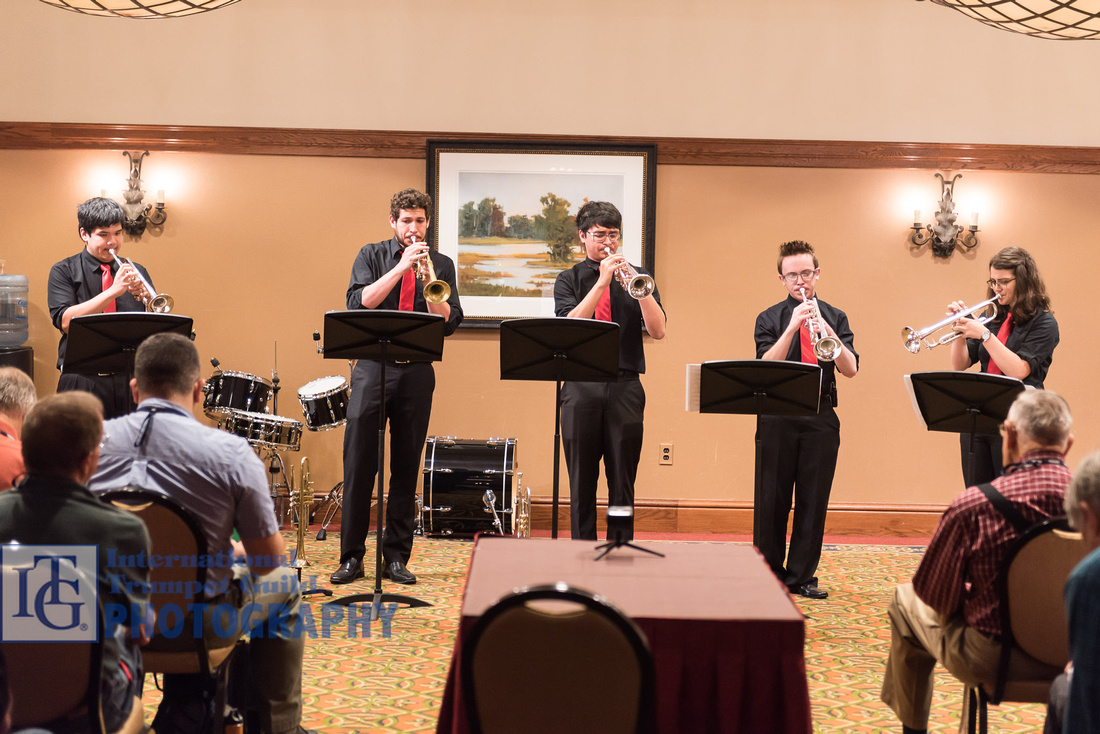 UNLV Trumpet Ensemble
UNLV Trumpet Ensemble
Debussy’s Violin Sonata: A One-Movement Adaptation by Claude Debussy, arranged by Gretchen Hull
The UNLV Trumpet Ensemble opened the session with a performance of Gretchen Hull’s arrangement Debussy’s Violin Sonata. The work featured a series of sparse, meandering lines that built to an effective unison arrival. The group played with a consistency of articulation and style, as they used various combinations of flugelhorn with trumpets in E-flat, C, and B-flat. The ensemble should be commended on performing the demanding arrangement and embracing the challenging tonal colors abundant in Debussy’s music. (NV)
USA Trumpet Ensemble, University of South Alabama
Dr. Peter Wood, director
Cody Morrison, Paige Nelson, Erick Wicklund, Shawn Wright
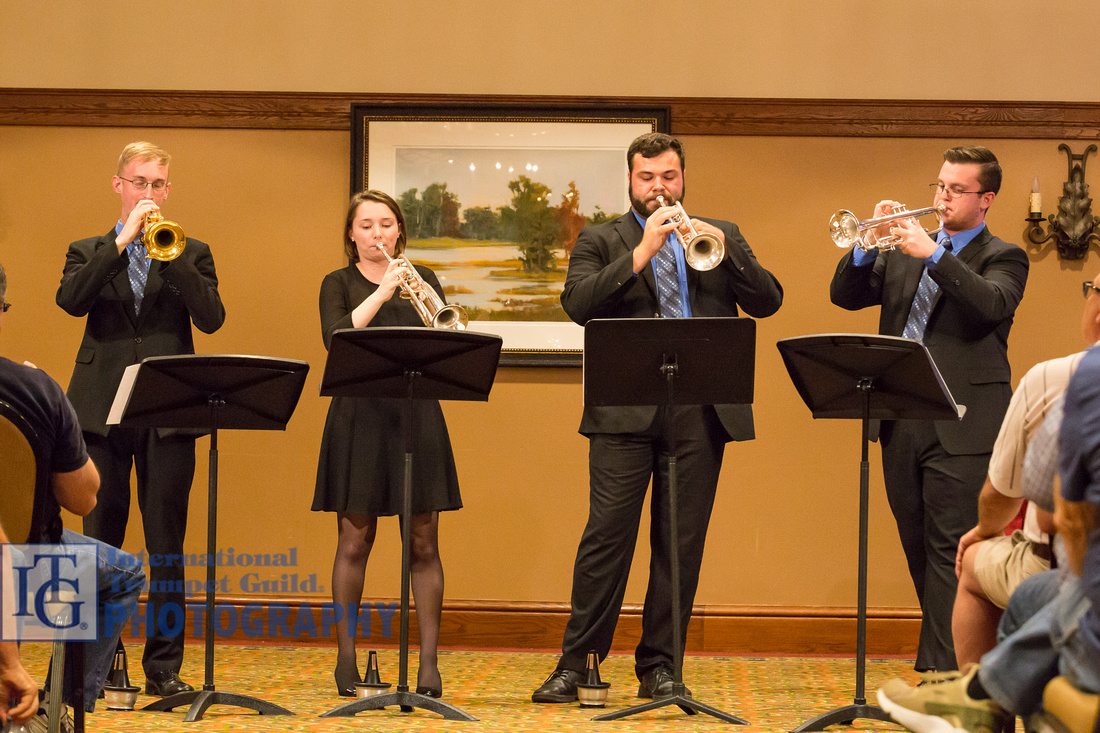 University of South Alabama Trumpet Ensemble
University of South Alabama Trumpet Ensemble
Träumerei: Hommage à Schumann by Takuya Shigeta
* Epiphanies I: Oakleigh Mists by Shawn Wright (World Premiere)
The Bijon Watson clinic opened with a performance by the University of South Alabama Trumpet Ensemble. The group performed Takuya Shigeta’s Träumerei: Hommage à Schumann and the world premiere of Epiphanies I: Oakleigh Mists by South Alabama student and ensemble member Shawn Wright. Wright’s work is an excellent addition to the trumpet ensemble repertoire, featuring an impressive range of colors, textures, and characters. Both of these very difficult works were performed with ease by this fine ensemble. (JC)
Click here for more prelude ensemble photos
Virginia Tech Trumpet Ensemble
Dr. Jason Crafton, director
Elizabeth Kania, Ryan Fuhrman, Caroline Amodeo, Chris Thomas, Jameson O’Donnell
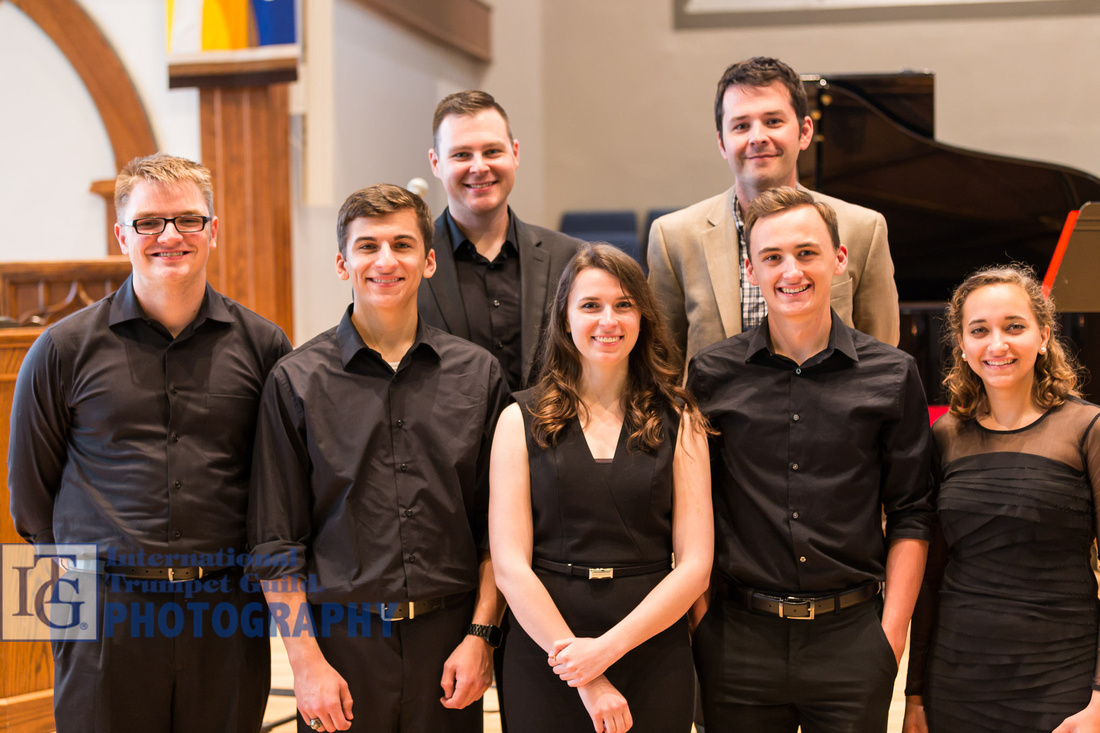 Virginia Tech Trumpet Ensemble
Virginia Tech Trumpet Ensemble
Sextet by Oskar Böhme
The Virginia Tech Trumpet Ensemble, directed by Dr. Jason Crafton, performed the first movement (Adagio-Allegro molto) of Böhme’s Sextet. This famous work for brass quintet and solo trumpet was adapted for six trumpets by Adam Gautille, a graduate of Baylor University who currently studies with Ryan Anthony. The Virginia Tech Trumpet Ensemble handled the tricky passing of melodic lines with great precision and ease. (KE)
West Chester University Women’s Trumpet Ensemble
Dr. Jean-Christophe Dobrzelewski, director
Hayley Daub, Amanda Ficca, Mary Maule, Rebecca Palmer, Morganne Piestrak
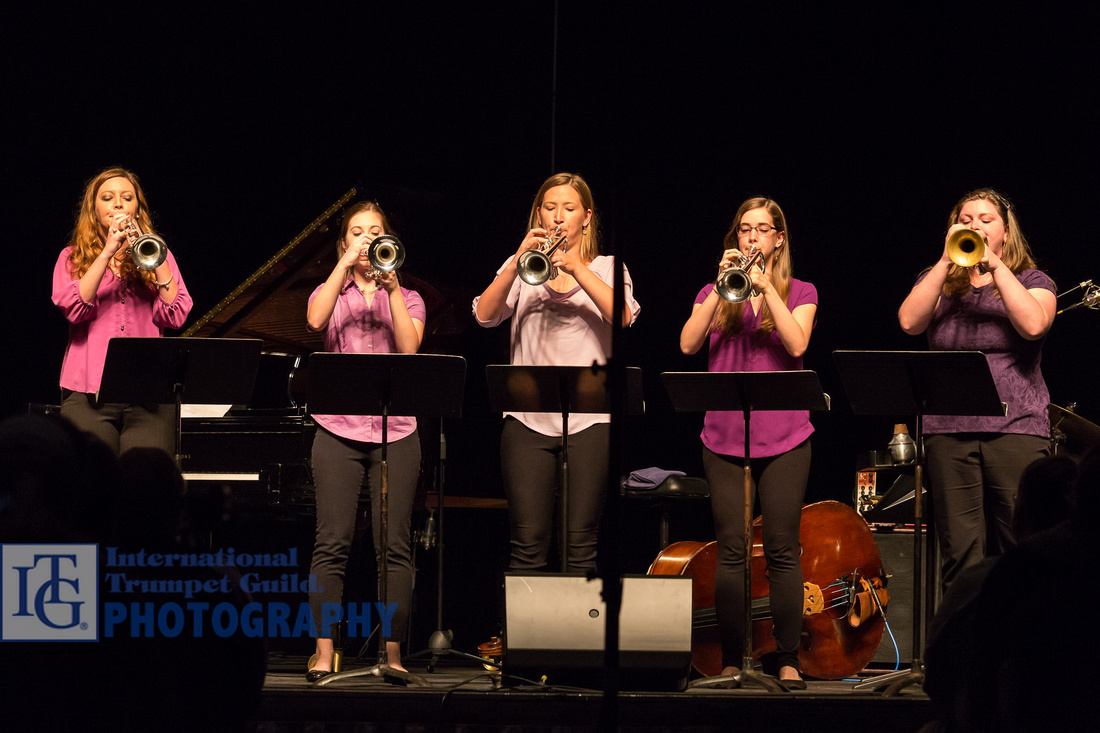 West Chester University Women's Trumpet Ensemble
West Chester University Women's Trumpet Ensemble
X1 by Erik Morales
The West Chester University Women’s Trumpet Ensemble provided a marvelous performance of Erik Morales's X1. The demanding piece showcased their wonderful ensemble skills, including excellent intonation and a uniform tone quality. Their spirited playing and solid double-tonguing built to a climactic finish. The group was rock-solid and a pleasure to hear. (NV)
Click here for more prelude ensemble photos
Conference Reporting and Photography Staff
Reporting Staff
Brianne Borden (BB) currently serves as a teaching assistant at Arizona State University, where she is pursuing her Doctor of Music degree under Professor David Hickman. She travels regularly to perform recitals and present Yoga for Musicians clinics.
Jason Crafton (JC) is assistant professor of trumpet at Virginia Tech in Blacksburg, Virginia.
Davy DeArmond (DD) is trumpet instrumentalist with the United States Naval Academy Band and serves on faculties of The Catholic University of America, Washington College, and Anne Arundel Community College.
Kevin Eisensmith (KE) is professor of trumpet and assistant chair of the music department at Indiana University of Pennsylvania. He served as president of ITG from 2009 to 2011 and was recently elected to serve as secretary from 2017 to 2019.
Luis Engelke (LE) is professor of trumpet at Towson University and principal trumpet with several orchestras. He serves as editor of the Music Reviews column for the ITG Journal and chair of the ITG Commissions Committee.
Olivia Funkhouser (OF) is currently pursuing a master's degree in trumpet performance at the University of North Texas with Dr. Jason Bergman after earning bachelor's degrees in trumpet performance and music education at the University of Southern Mississippi.
Ryan Gardner (RG) is associate professor of trumpet at Oklahoma State University. He is an avid performer and a member of the ITG Board of Directors and serves as the New York and Los Angeles artistic coordinator for Music for Autism.
Alan Klaus (AK) is assistant professor of trumpet at Memorial University of Newfoundland, Canada.
Elisa Koehler (EK) is professor of music and director of the Center for Dance, Music, and Theatre at Goucher College. She is the author of Fanfares and Finesse: A Performer's Guide to Trumpet History and Literature and has served on the editorial staff of the ITG Journal since 2002.
Will Koehler (WK) is an active performer, educator, and writer and teaches at Bloomington High School North, Northview High School, and Tri-North Middle School in Bloomington, Indiana. He is a DM student in trumpet performance at the Indiana University Jacobs School of Music.
Marie Mencher (MM) is a music education candidate at Indiana University of Pennsylvania, where she studies trumpet with Dr. Kevin Eisensmith. She holds a BA in Latin American Studies from Wesleyan University.
Eric Millard (EM) currently serves as third trumpet with the Tallahassee Symphony and is pursuing his doctorate in trumpet performance at Florida State University.
Kyle Millsap (KM) is assistant professor of trumpet and jazz at Texas A&M University-Kingsville. He oversees the dynamic trumpet program and directs the trumpet ensembles, jazz trumpet ensembles, and Jazz Band 3.
Nick Mondello (NM) is a freelance trumpeter, educator/clinician/consultant and writer. He is the author of 365 Trumpet Lessons, writes for many jazz publications, and is the editor of the Studio/Commercial Scene column for the ITG Journal.
Paige Nelson, editorial assistant, is a master’s trumpet student at the University of Northern Colorado and a recent graduate of the University of South Alabama.
Donald K. Roeder (DR), MD, FACS, is a retired thoracic surgeon who lives in Boiling Springs, Pennsylvania. He serves as a bugler with the Cumberland County Honor Guard and performs with the Carlisle Town Band and the Carlisle Brass Quintet.
J. Peyden Shelton (JS) is currently assistant professor of trumpet at the University of Utah. He is also a Stomvi Flex mouthpiece artist and a Torpedo Bag professional artist.
Steve Siegel (SS) is a recordings reviewer and sheet music reviewer for the International Trumpet Guild Journal. He is the instructor of trumpet at Centre College in Danville, Kentucky.
Nick Volz (NV) is associate professor of classical and jazz trumpet at Loyola University New Orleans. He performs with a variety of groups, including the Louisiana Philharmonic Orchestra.
Rebecca Walenz (RW) is the editor of the itg journal, jr. column in the ITG Journal. She is a doctoral teaching assistant in trumpet performance at Florida State University, where she studies with Christopher Moore.
Spencer Wallin (SW) is currently a teaching fellow at the University of North Texas, where he studies with Jason Bergman. Wallin has performed with the Dallas Winds, the Detroit Symphony Orchestra, and the Utah Symphony Orchestra.
Aaron Witek (AW) is assistant professor of trumpet at the University of Louisiana at Monroe, where he is a member of the Black Bayou Brass.
Jodi Graham Wood is the assistant editor and principal proofreader of the ITG Journal and also serves as instructor of horn at the University of South Alabama.
Photography Staff
Michael Anderson (MA) is the ITG Website director and head photographer for the conference. He serves as professor of trumpet at Oklahoma City University and is a member of the Oklahoma City Philharmonic.
Norman Bergstrom (NB) has been a member of the Blawenburg (New Jersey) Band trumpet section since 1962. He is also the photographer for the Nova Orchestra in West Windsor, New Jersey.
Del Lyren (DL) is professor of trumpet and jazz at Bemidji State University. He has been active in many aspects of ITG, including co-hosting the 2011 conference in Minneapolis.
Brian Shook (BS) is associate professor of trumpet at Lamar University in Beaumont, Texas, and is the editor of the Recording Reviews column for the ITG Journal. He also serves as stage manager for the ITG Conference.
John Tamer (JT) is a trumpet player living in Ellicott City, Maryland, who works as an engineer at Johns Hopkins University.
]]>
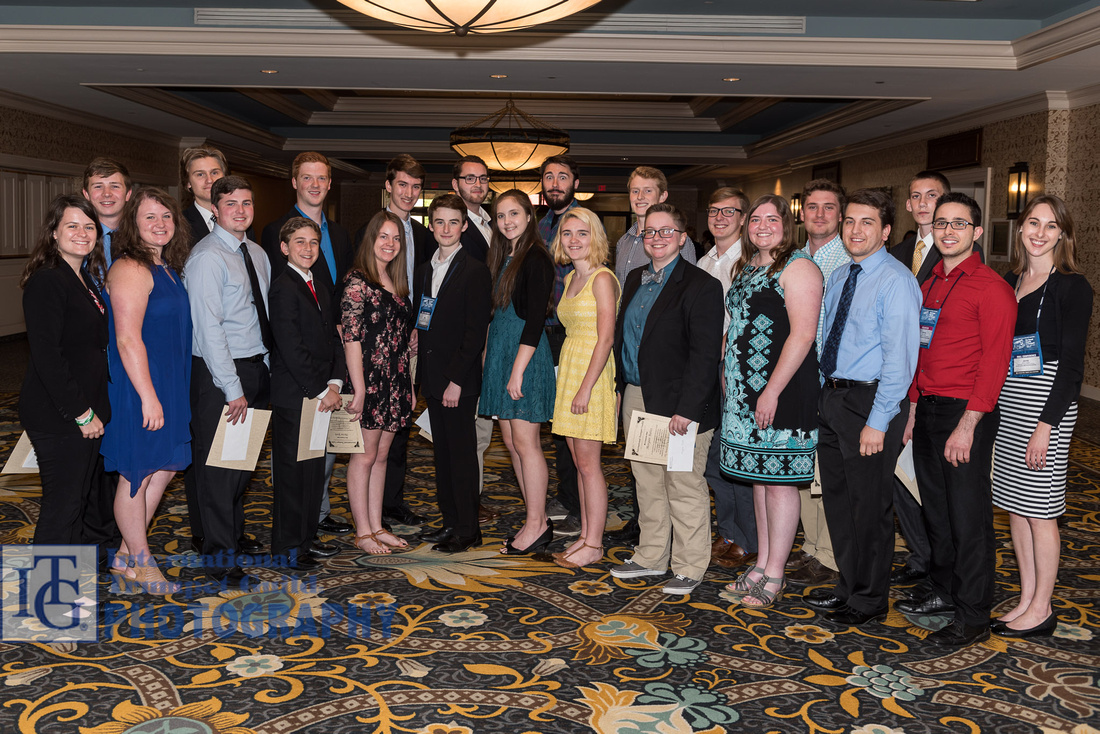 170603-0001-73Conference Scholarship winners
170603-0001-73Conference Scholarship winners
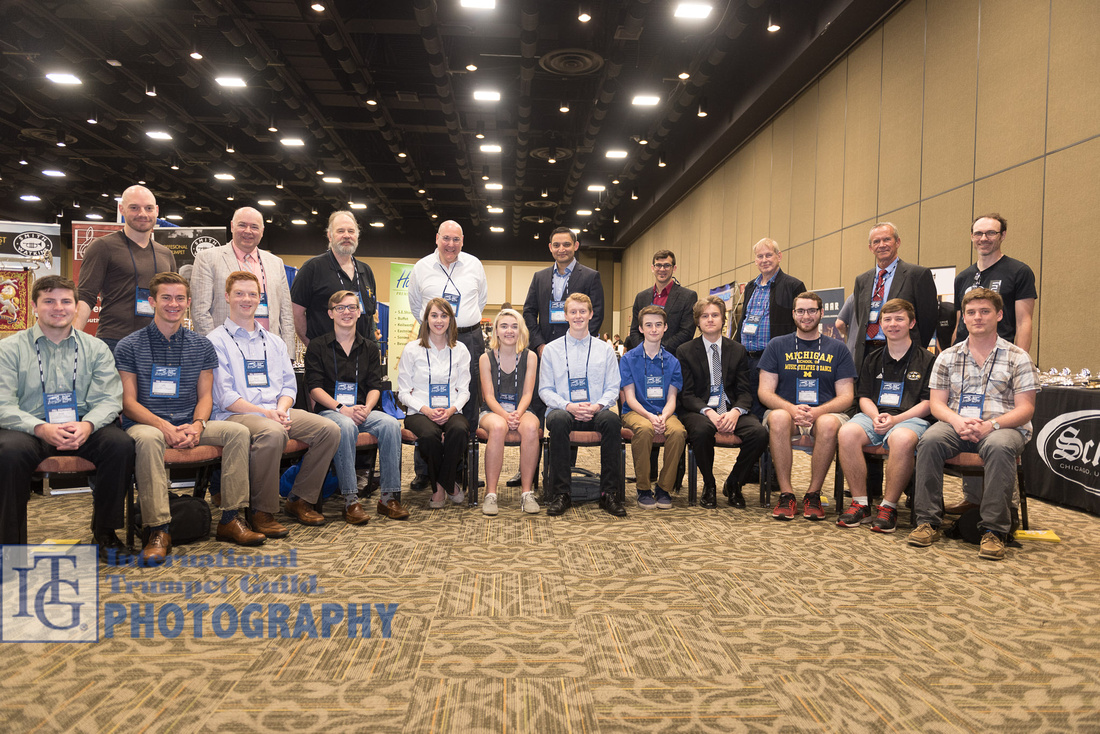 170601-0001Scholarship winners and their vendors. Back row (donors, L-R): LOTUS Trumpets, Thompson Music Company, Ken Larsen's BrassWerks, Washington Music Company, Gard Bags, Smith Watkins/DF Music, Husonics, Warburton Music Products, Puje Trumpets.
Front row (students, L-R): Jacob Howard, Luke Hoeft, Stephen Spink, Justin Way, Jenna Veverka, Xan Denker, Connor Holland, Max Stephenson, Jacob Fekete, Francis Chiodo, Alan Tolbert, Jackson Delany-McCudden.
170601-0001Scholarship winners and their vendors. Back row (donors, L-R): LOTUS Trumpets, Thompson Music Company, Ken Larsen's BrassWerks, Washington Music Company, Gard Bags, Smith Watkins/DF Music, Husonics, Warburton Music Products, Puje Trumpets.
Front row (students, L-R): Jacob Howard, Luke Hoeft, Stephen Spink, Justin Way, Jenna Veverka, Xan Denker, Connor Holland, Max Stephenson, Jacob Fekete, Francis Chiodo, Alan Tolbert, Jackson Delany-McCudden.
15-19 Division
Chuck Levins Memorial Scholarship
Xan Denker
Teacher: Michael Miller
Donor: Washington Music Center
Smith Watkins/DF Music Scholarship
Jacob Fekete, Bowling Green State University
Teacher: Charles Saenz
Donor: Smith Watkins/DF Music
Clifton Plog Memorial Fund Scholarship
Forrest Johnston, Langley High School
Teacher: Rich Johnston
Donor: ITG Memorial Scholarship Fund
Charles Patrick Wristen Memorial Scholarship
Joseph Mysza, Clovis High School
Teacher: Keith Sacane
Donor: Friends & Family of Pat Wristen
Richard B. Lehman Memorial Fund Scholarship
Alexa York, Bowling Green State University
Teacher: Charles Saenz
Donor: ITG Memorial Scholarship Fund
19-22 Division
Donald P. Bullock Memorial Fund Scholarship
Morgan Bates, Dickinson College
Teacher: Jeffrey Wohlbach
Donor: ITG Memorial Scholarship Fund
Anatoly Selianin Memorial Scholarship
Ethan Berkebile, University of North Texas
Teacher: Jason Bergman
Donor: Stephen Chenette
Charles Patrick Wristen Memorial Scholarship
Jade Carr, University of Arkansas
Teacher: Richard Rulli
Donor: Paula Wristen
Husonics Scholarship
Frank Chiodo, University of Michigan
Teacher: Bill Campbell
Donor: Husonics
Thompson Music Company Scholarship
Luke Hoeft, Baylor University
Teacher: Wiff Rudd
Donor: Thompson Music Company
Gard Bags Scholarship
Connor Holland, Florida State University
Teacher: Christopher Moore
Donor: Talwar Brothers Ltd
Sandra Rapa Memorial Scholarship
Jacob Howard, Florida State University
Teacher: Christopher Moore
Donor: LOTUS Trumpets
Dino Tofanelli Memorial Scholarship
Michael Pranger, Illinois State University
Teacher: Amy Gilreath
Donor: Tony Johnson
Ken Larsen's BrassWerks Scholarship
Steven Spink, Baylor University
Teacher: Wiff Rudd
Donor: Ken Larsen's BrassWerks
Keith Clark Memorial Fund Scholarship
Steffi Tetzloff, Oklahoma State University
Teacher: Ryan Gardner
Donor: ITG Memorial Scholarship Fund
Warburton Music Products Scholarship
Alan Tolbert, Temple University
Teacher: David Bilger
Donor: Warburton Music Products
Chuck Levins Memorial Scholarship
Justin Way, Florida State University
Teacher: Christopher Moore
Donor: Washington Music Center
22-25 Division
Puje Trumpet Scholarship
Jackson Delany, Loyola University
Teacher: Nick Volz
Donor: Puje Trumpets
Michael Tunnell Memorial Scholarship
Olivia Funkhouser, University of Southern Mississippi
Teacher: Jason Bergman
Donor: Friends & Family of Michael Tunnell
Charles Patrick Wristen Memorial Scholarship
Emily Korth, University of Massachusetts
Teacher: Eric Berlin
Donor: Friends & Family of Pat Wristen
Sandy Sandberg Memorial Fund Scholarship
Enrico Solito, Bowling Green State University
Teacher: Charles Saenz
Donor: ITG Memorial Scholarship Fund
Chuck Levins Memorial Scholarship
Jenna Veverka, Cincinnati College-Conservatory of Music
Teacher: Alan Siebert
Donor: Washington Music Center
ITG Legacy Fund Scholarship
Stephen Wadsack, Cincinnati College-Conservatory of Music
Teachers: Alan Siebert, Philip Collins
Donor: ITG Legacy Fund
Renold O. Schilke Memorial Fund Scholarship
Jared Wallis, Eastman School of Music
Teacher: James Thompson
Donor: ITG Memorial Scholarship Fund
Jazz 19-25 Division
Stuart D. Shanler Scholarship
Elliot Bild, Temple University
Teacher: Terell Stafford
Donor: Stuart Shanler
Under 15 Division
Bryan & Nancy Goff Scholarship
Harrison Epstein, King Philip Middle School
Teacher: Phil Snedecor
Donor: Bryan Goff
Bill Pfund Scholarship
Beth Johnston, Cooper Middle School
Teacher: Rich Johnston
Donor: Bill Pfund Trumpets
Smith Watkins/DF Music Scholarship
Max Stephenson, Ithaca High School
Teacher: Jane Dunnick
Donor: Smith Watkins/DF Music
Scholarships Coordinator
Jennifer Dearden
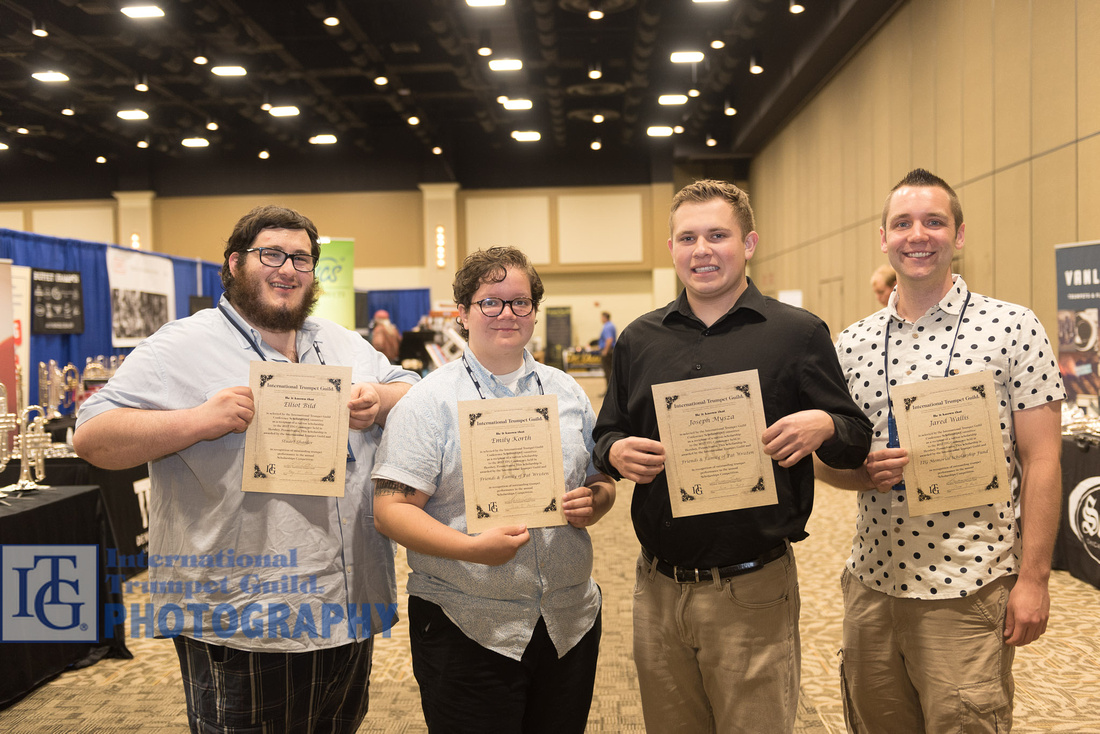 170601-0001Scholarship winners not present at banquet (L-R): Elliott Bild, Emily Korth, Joseph Mysza, Jared Wallis
170601-0001Scholarship winners not present at banquet (L-R): Elliott Bild, Emily Korth, Joseph Mysza, Jared Wallis
Competition Winners
Jazz Improvisation Competition
Chair: Jason Carder
Winners: Tony Glausi (first prize), Jeremy Alvarez (second), Cody Rowlands (third)
 170603-0001-25Jazz Competition winners (L-R): Jeremy Alvarez, Tony Glausi, Cody Rowlands
170603-0001-25Jazz Competition winners (L-R): Jeremy Alvarez, Tony Glausi, Cody Rowlands
Orchestral Excerpts Competition
Chair: Robert White
Winners: Alex Wilborn (first prize), David Koch (second), Francis LaPorte (third)
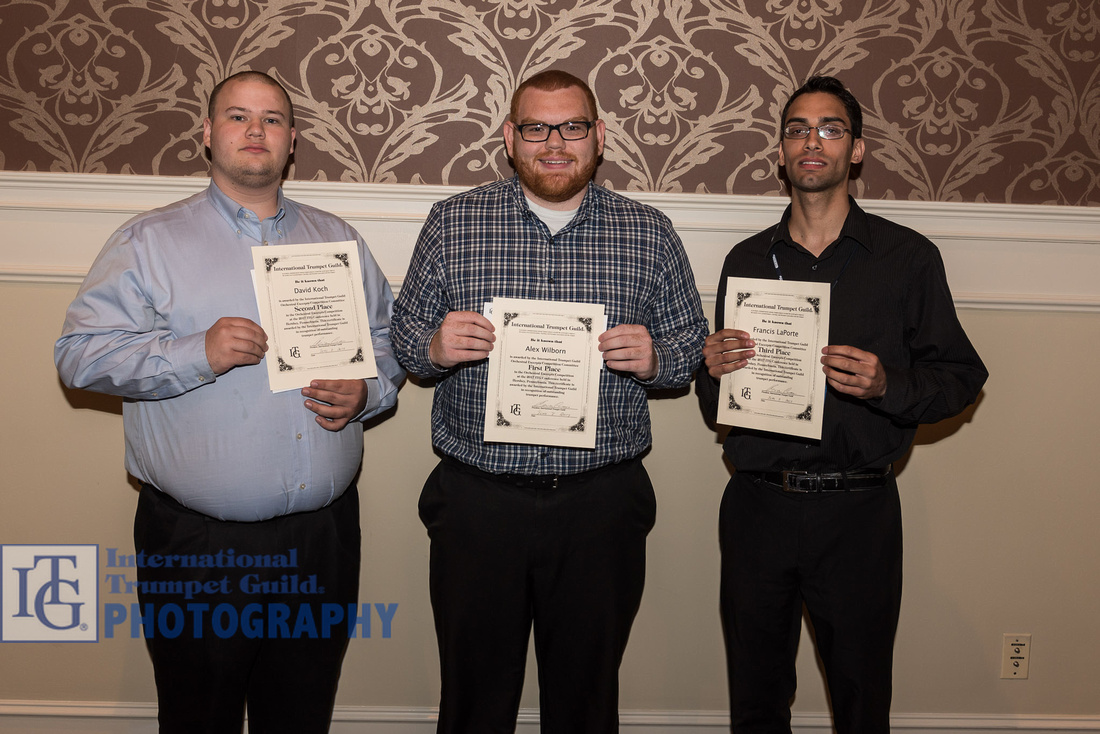 170603-0001-25Orchestral Excerpts Competition winners (L-R): David Koch, Alex Wilborn, Francis LaPorte
170603-0001-25Orchestral Excerpts Competition winners (L-R): David Koch, Alex Wilborn, Francis LaPorte
Military Band Excerpts Competition
Chair: Amy McCabe
Winners: Brent Proseus (first prize), Alex Wilborn (second), Matthew Mignardi (third)
 170603-0001-25Military Band Excerpts Competition winners (L-R): Alex Wilborn, Brent Proseus, Matthew Mignardi
170603-0001-25Military Band Excerpts Competition winners (L-R): Alex Wilborn, Brent Proseus, Matthew Mignardi
Solo Competition
Chair: Jason Dovel
Winners: Daniel Haddock (first prize), Miguel Pais (second), Bryan Powell (third)
 170603-0001-38Solo Competition winners (L-R): Bryan Powell, Daniel Haddock, Miguel Pais
170603-0001-38Solo Competition winners (L-R): Bryan Powell, Daniel Haddock, Miguel Pais
Youth Competition (Junior Division)
Chair: Marc Reed
Winners: Harrison Epstein (first prize), Stefan Filip (second), Sophie Urban (third)
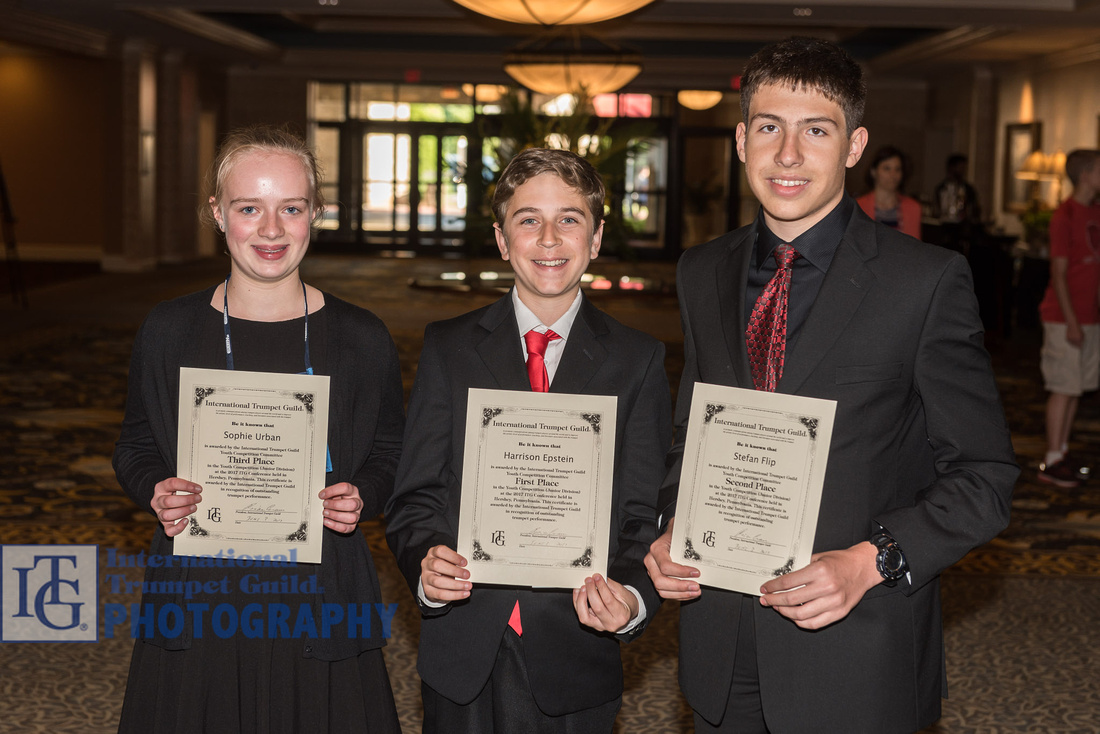 170603-0001-38Youth Competition (Junior Division) winners (L-R): Sophie Urban, Harrison Epstein, Stefan Filip
170603-0001-38Youth Competition (Junior Division) winners (L-R): Sophie Urban, Harrison Epstein, Stefan Filip
Youth Competition (Senior Division)
Chair: Marc Reed
Winners: Forrest Johnston (first prize), Charlie Jones (second), Yoojeong Kim (third)
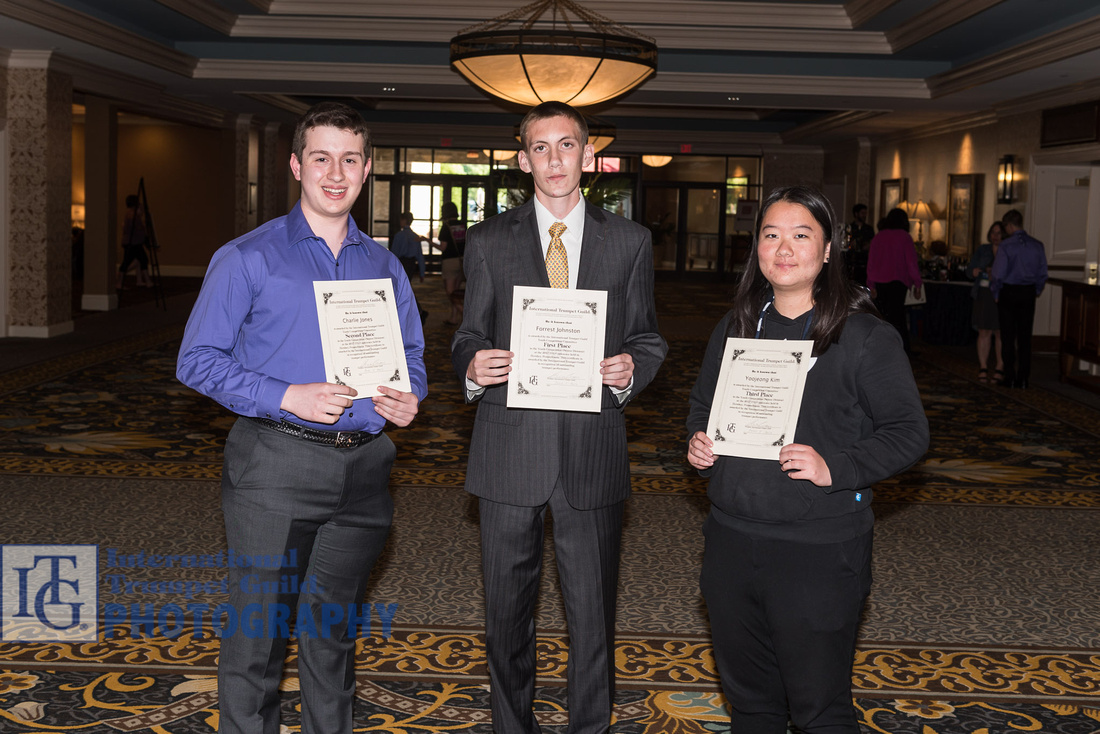 170603-0001-49Youth Competition (Senior Division) winners (L-R): Charlie Jones, Forrest Johnston, Yoojeong Kim
170603-0001-49Youth Competition (Senior Division) winners (L-R): Charlie Jones, Forrest Johnston, Yoojeong Kim
]]>
Special Daily Report • Compiled by Peter Wood
Photos by Michael Anderson, Norman Bergstrom, Del Lyren, Brian Shook, and John Tamer
Saturday, June 3 - Evening events
Click here for more photos from the ITG Conference
Closing Concert - The United States Army Blues Featuring Anthony Kadleck, Dontae Winslow, and Bijon Watson
This august group opened the concert with a most apropos selection for the ITG performance, featuring the superb solo talents of members of the trumpet section. FSG Graham Breedlove, SM Kenny Rittenhouse, and MSG Craig Fraedrich spewed fire in their respective solos. The burning tempo was laid down by the terrific rhythm section, which was spearheaded by drummer Harold Summy. Pianist Dan Roberts comped along brilliantly. The group then offered up the original arrangement of the Count Basie classic Corner Pocket (also known as Till I Met You), featuring a marvelous plungered trumpet solo by Breedlove. The tune was an ultimate “Army Blues Basie” tribute.
New York studio trumpet great Tony Kadleck came onstage to perform two superb numbers. A Latin-tinged arrangement of Joe Henderson’s Recordame was performed first. Kadleck’s beautiful horn tone delivered the melody, and the Army Blues dug into the piece with vigor and superior textures, especially from the reed section. Kadleck then rendered the melody on trumpet, screaming high and hard above the ensemble in a most Maynard Ferguson-esque style. His tone, facility, and intonation in the upper register were outstanding. On How Do You Keep the Music Playing, Kadleck’s incredibly lush flugelhorn playing was on full display. He covered the melody over the ensemble impeccably.
Baltimore’s Dontae Winslow, recently of ABC’s Dancing with the Stars, invigorated the crowd with his dreadlocks flying, body dancing, hands clapping, and horn (complete with red inner bell, matching his boots) screaming. Thelonius Monk’s Brake Sake was played in a hard-funk driving style by Winslow and the Blues. Highly energetic and deeply involved, Winslow incorporated an intense vocal rap segment that took the audience by surprise and garnered an extremely positive reception. It was dramatic, for sure. Winslow’s trumpet came back to solo and scream over the pulses and musical shouts of the band. A more reserved second selection, J.J. Johnson’s ballad Lament had Winslow’s trumpet spinning melody over the woodwinds. Winslow’s stage presence engaged the crowd, and his playing put them over the top.
Bijon Watson entered the stage and offered a terrific version of the hard-bop tune Black Nile. Watson held nothing back as he soared into the upper register with enormous power. His facility in that range was outstanding, and the Blues performed superbly in support. Watson then sent up You Stepped Out of a Dream in a Samba style in which he played a very warm flugelhorn. The piece included a fine solo by drummer Harold Summy. As a finale, all of the guests - including new-to-the-Blues trumpeter Joshua Kauffman - came onstage and swung into a speedball titled Commotion. Each of the guests blew multiple intensely screaming choruses. Their individual and combined playing there brought the house down. It was a perfect ending to a superb evening and an outstanding 42nd ITG Conference! (NM)
 170603-0001Tony Kadleck
170603-0001Tony Kadleck
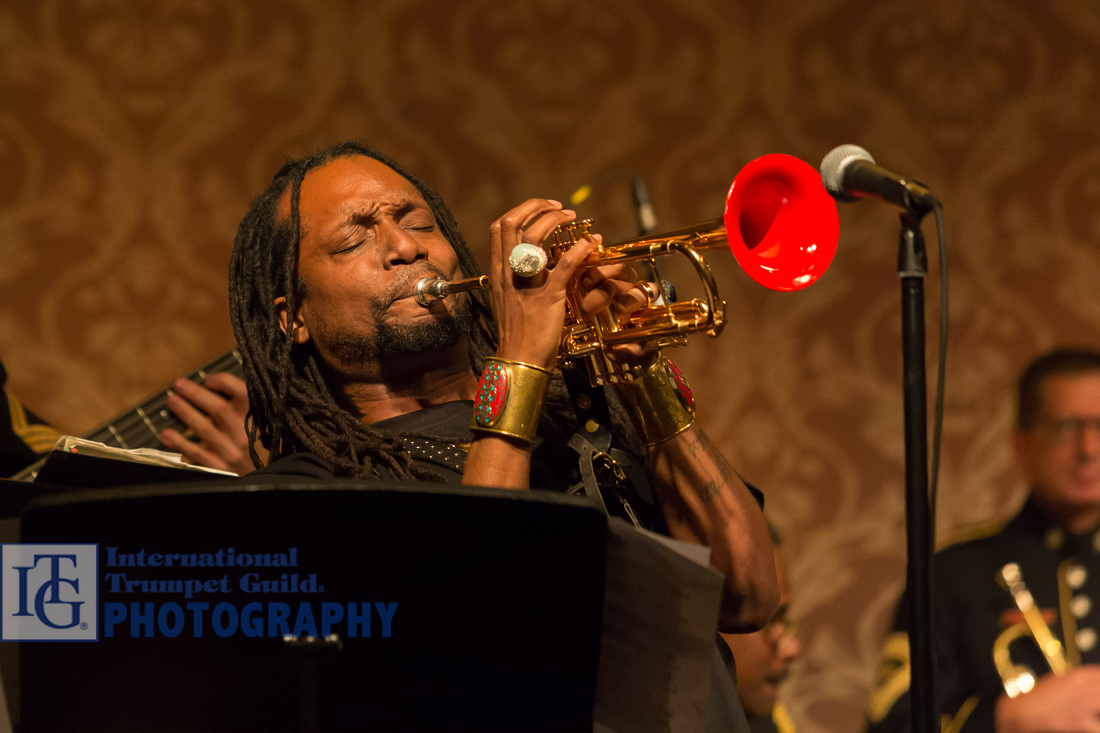 170603-0001Dontae Winslow
170603-0001Dontae Winslow
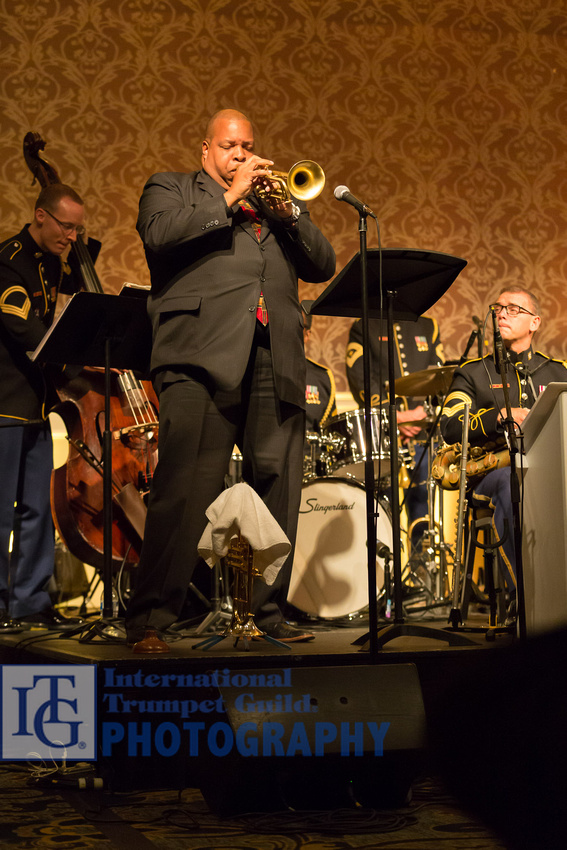 170603-0001Bijon Watson
170603-0001Bijon Watson
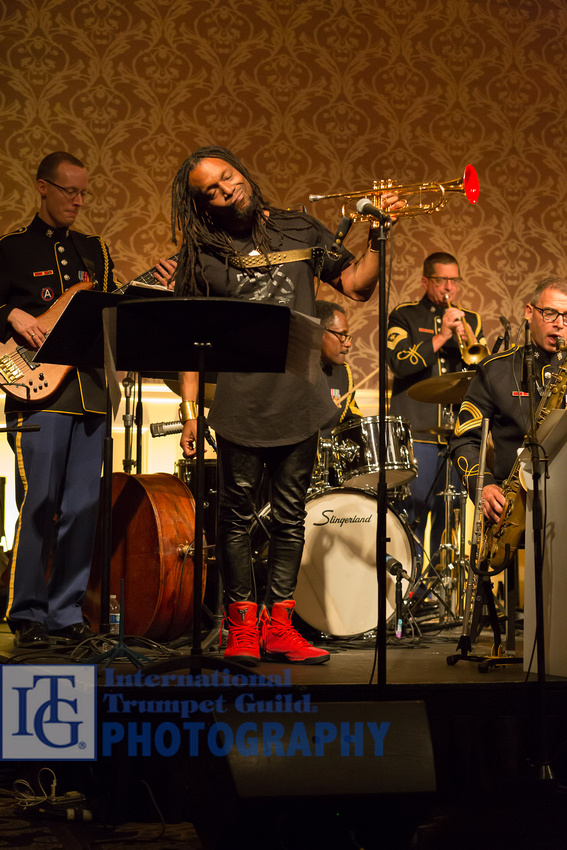 170603-0001Dontae Winslow
170603-0001Dontae Winslow
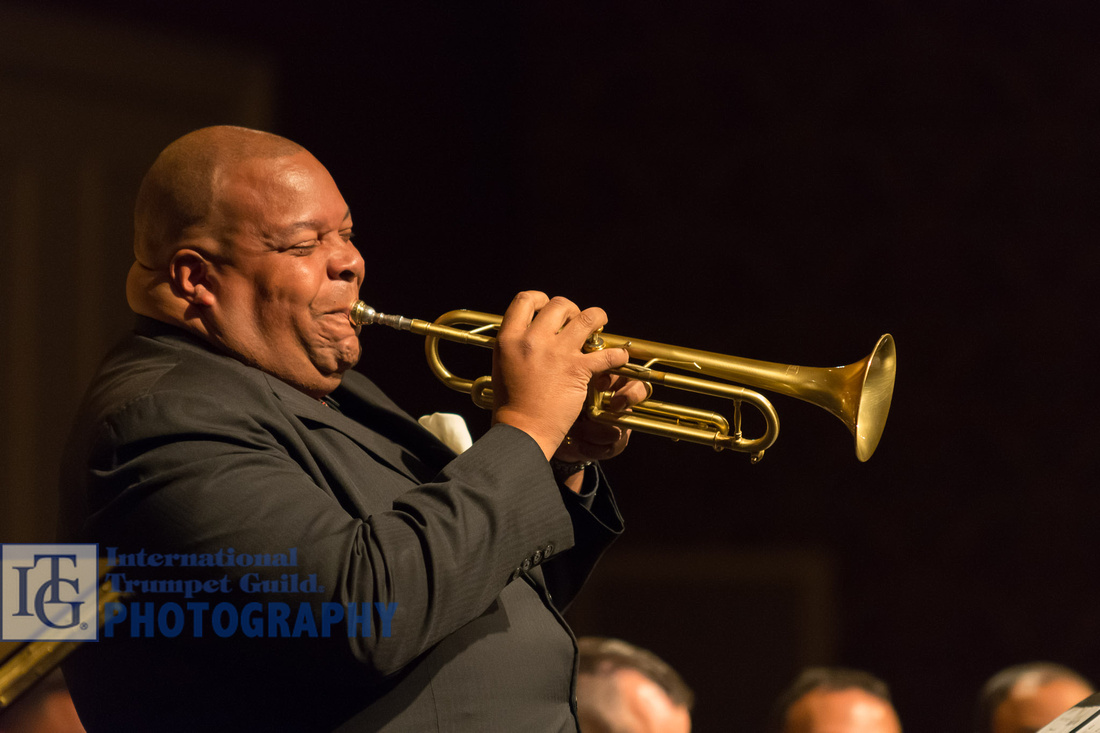 170603-0001Bijon Watson
170603-0001Bijon Watson
Special Daily Report • Compiled by Peter Wood
Photos by Michael Anderson, Norman Bergstrom, Del Lyren, and John Tamer
Saturday, June 3 - Daytime events
As usual, all good things must come to an end! The 42nd annual ITG Conference is in the books and was, by all signs, a tremendous success. The week has been filled with awe-inspiring performances by a great number of wonderful artists, and many, many trumpeters, young and old, are ready to head home and begin again refining this activity that brings joy to so many. Thanks are due to the very large number of unpaid volunteers who made it all possible. Please take a look at the list of conference reporters and photographers who took time out of their conference to write reviews of all the various conference events. They and many others deserve great credit for making the conference what it is. Please join us for another memorable music-filled week next May (2018) in San Antonio!
Click here for more photos from the ITG Conference
Jason Crafton Warm-Up Session - From Theory to Practice: Understanding the How and Why of the Trumpet Warm-Up Routine
Jason Crafton offered an approachable warm-up routine for players of all ability levels. Incorporating both mouthpiece and leadpipe buzzing, Crafton’s focus was centered around obtaining the most resonant sound possible through all registers of the horn. Following these exercises were repeated chromatic scale studies (Clarke’s first study), which began on G4 and expanded outward. These exercises were slurred the first time and tongued on the repeat in order to warm up the tongue and develop consistency in sound between slurred and tongued passages. Crafton discussed variables in trumpet performance that can change from day to day. Variables include the physical aspects of performing, such as how one uses their air or the way their lips feel. In order to control these variables, one should focus on the constant, which is concept of sound. Crafton provided a marvelous sound quality for the audience as the call and response remained constant throughout the session. (SS)
Jessica Williams - Youth Day Warm-up Session
At Jessica Williams's morning warm-up session, she addressed the importance of a daily warmup and shared her story of how that routine helped her return to playing after time off for military basic training. She stressed the need to be mindful and honest and that it is not a maintenance time, but a warm-up time. She worked with students, got the audience involved, and reminded all that each note should be like a performance. The key elements covered were knowing what (or who) to sound like, taking a good breath using "po-to" as the model, playing the mouthpiece for a minute or two, and playing patterns that address sound, articulation, finger dexterity, range, and flexibility. The final step of her warmup is to play something pretty, which is intended to be something enjoyable that brings everything together and that can be different every day. (KM)
ITG Youth Competition: Junior Division finals
Ten young trumpet players competed on Saturday morning for the Junior Division of the ITG Youth Competition. All players, ranging in age from ten to fifteen, performed Barat’s French contest piece Fantasy in E-flat and another piece of their own choosing. The chosen works included the Arutunian Concerto played by two performers, the Geodicke Concert Etude played by four competitors, and works by Senée, Hummel, Handel, and Balay. Each work created a pleasant contrast to the Barat, expanding on the various strengths of each competitor. The morning was filled with fine trumpet playing from these most promising young musicians. Results were announced later in the afternoon at the President’s Banquet. (WK)
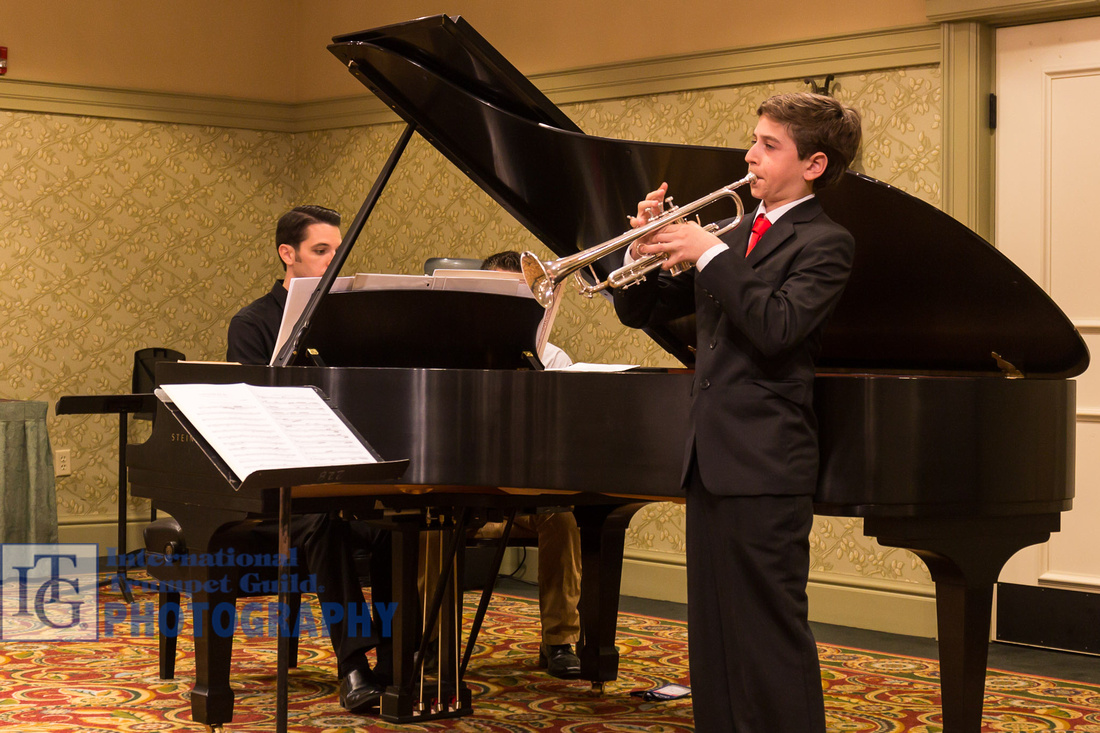 170603-0001-3Harrison Epstein, Youth Competition (Junior Division) winner
170603-0001-3Harrison Epstein, Youth Competition (Junior Division) winner
Rebecca Walenz Presentation - Choosing Solo Repertoire: A Recipe for Success
Rebecca Walenz, editor of the jr. column in the ITG Journal, led an engaging and memorable clinic Saturday morning as she discussed useful methods for choosing solo repertoire and explained how the correct choice of music can lead to success. Emphasizing the importance of finding balance between challenge and accessibility, Walenz gave a detailed explanation of three solos selected from her new CD, In the Light. She shared how each solo would help any trumpet player learn various techniques to become a well-rounded musician. She then performed each solo with pianist Miriam Hickman, allowing the audience to view the score projected on a screen, in order to demonstrate a variety of lesser-known solo literature available to young trumpet players. The clinic was highly informative as Walenz finished with the reminder that a maintaining a good attitude, being kind to all, and working hard are essential to finding success and enjoyment while playing the trumpet. (SW)
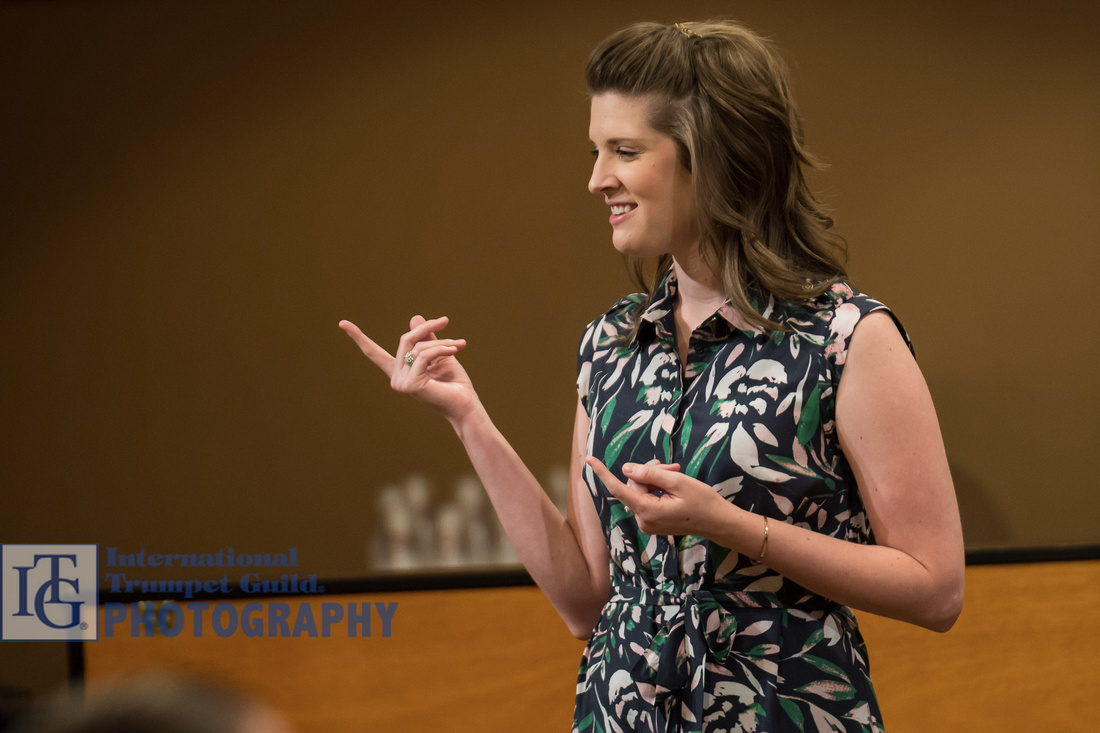 170603-0001-2Rebecca Walenz
170603-0001-2Rebecca Walenz
ITG Open Members Meeting
President Brian Evans called the meeting to order by introducing the ITG Executive Committee and Board of Directors. A summary of the annual board meeting included addressing declining membership while maintaining services. While a budget deficit is expected over the next year, reserve funds are available, and the organization is in good financial order. Last year’s competitions went well, and plans for this year’s Carmine Caruso competition are underway.
New ITG commissions include a work for trumpet, piano, and percussion by Indian composer Lakshminarayana Subramaniam, completed and set for premiere in 2018. The 2019 commission will be a work for trumpet, voice (notated scat singer), and piano by the Brazilian-American Clarice Assad. Ryan Anthony’s recording of Vassily Brandt’s etudes is set for digital download as a free ITG supplement in 2019.
Other topics discussed were the Sponsor-a-Trumpeter program, the Legacy Endowment Fund, ITG Affiliate Chapters, the newly formed Artistic Advisory Council, and international outreach, including Journal translations.
Treasurer Dixie Burress discussed diminishing revenue and strategies for addressing that. The student membership demographic has been a particular concern, and redefining membership levels and adding auto-renew were also discussed. Vice President/President-Elect Cathy Leach presented efforts to increase membership, including the creation of a new promotional video that highlights benefits of guild membership. Members were asked for input, and they brought up a number of excellent ideas for increasing outreach and membership and improving conference processes. (LE)
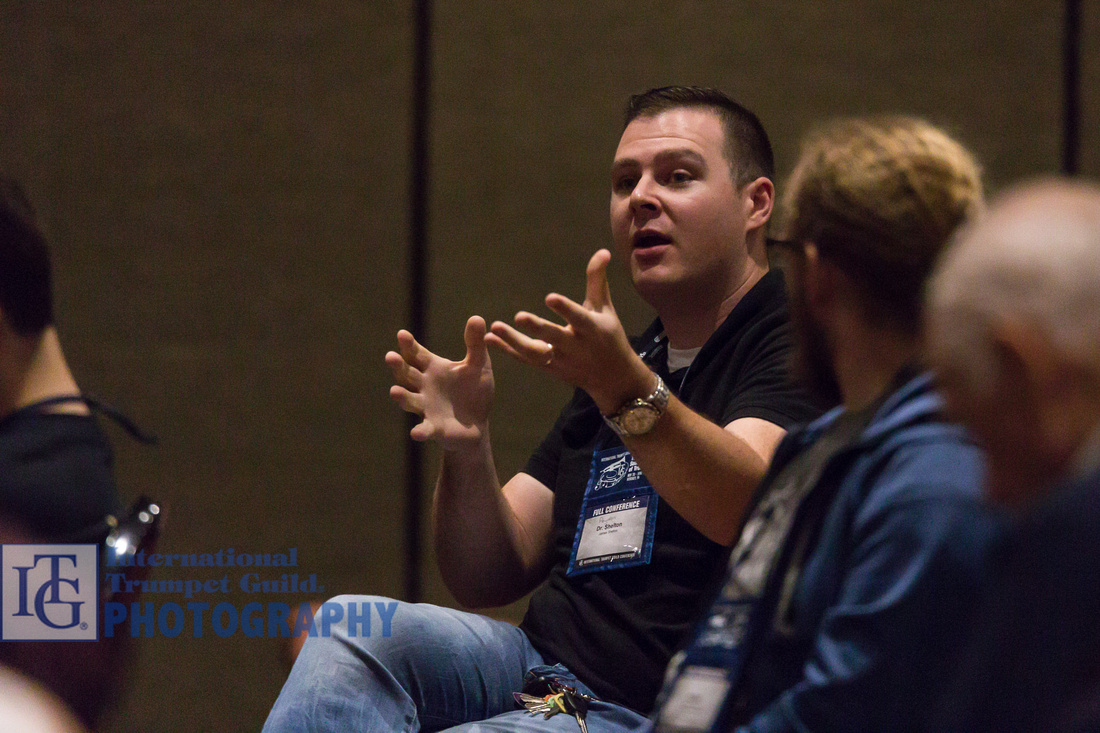 170603-0001-6James Peyden Shelton, asking a question at the Open Members Meeting
170603-0001-6James Peyden Shelton, asking a question at the Open Members Meeting
Ryan Gardner Youth Day Presentation - Audition and Competition Preparation
Students of Dr. Ryan Gardner are consistently successful, both while studying with him at Oklahoma State University and after graduation, so he was an ideal person to present a clinic on this topic. The audience of mostly students was treated to a wealth of information presented in an interactive format with engaging doses of honesty and humor. After an initial conversation about the most important elements for which judges listen was followed by tips on what and how to practice in preparation for an audition. It was a treat to see how Gardner linked various concepts in the process of creating an optimal mindset for performance. A highlight of the session was his work with a student volunteer, in which Gardner offered simple and practical methods to work through an array of common challenges and discussed symptoms that can arise from performance anxiety. (AK)
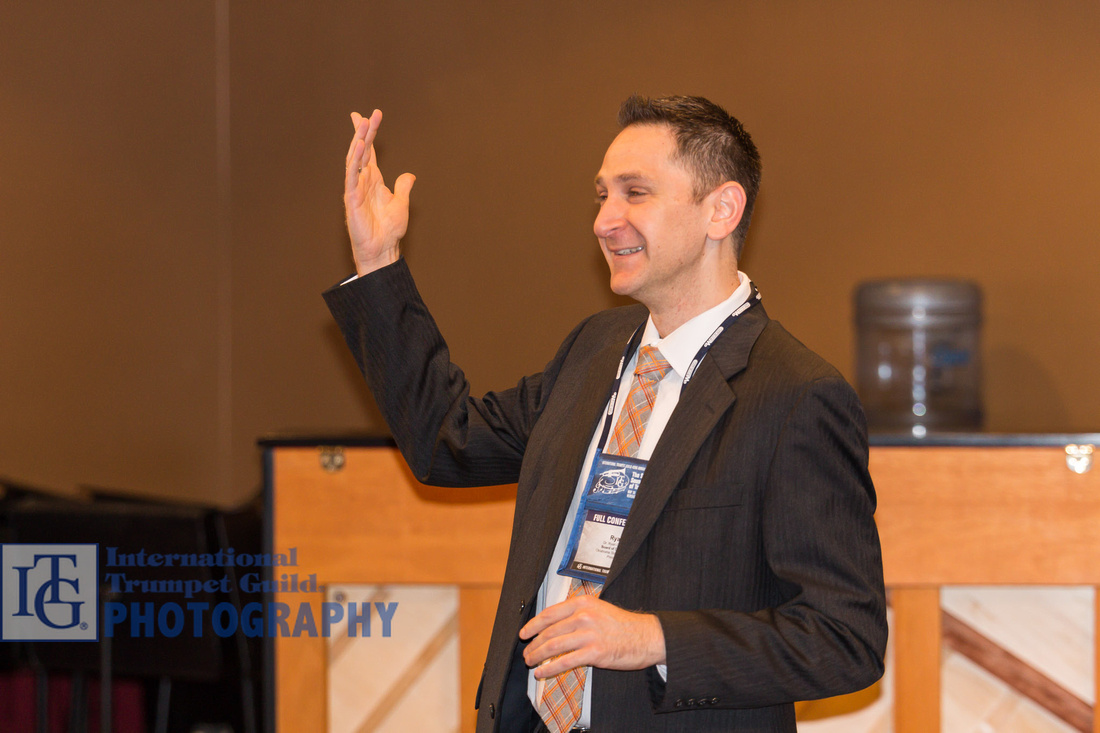 170603-0001-7Ryan Gardner
170603-0001-7Ryan Gardner
ITG Youth Competition: Senior Division finals
For the Senior Division of the ITG Youth Competition, each competitor was required to play Joseph Turrin's Caprice and another solo selection of their choice. First to perform was Michael Bauer from Quince Orchard High School. His strong tone in the upper register stood out in both the required piece and the first movement of the Böhme Concerto. Claire Bruns performed Vivaldi/Fitzgerald's Allegro with a beautiful tone and grace. The fast double-tongued passages in Noelle Geisler’s exciting rendition of James Stephenson's L'Espirit de la Trompette were well executed. Ashley Irvin selected Balay's Prelude et Ballade as her piece of choice. She demonstrated beautiful sound and clear articulation throughout. Forrest Johnston performed a very well prepared Tomasi's Triptyque and filled the ballroom with his excellent tone. The quick passages in Enesco's Legend performed by Charlie Jones was an exhilarating listen. Yoojeong Kim played an enduring, yet very successful, performance of both the required work and Arutunian's Concerto. The last two performers, Ryan Lee and David Yang, both selected the first movement of the Hummel Concerto. They each maintained great poise on stage and played with a very mature sound. (AW)
Research Room Presentations
This year’s research room presentations encompassed a wide variety of topics. Robert Rizzo, from the Australian Institute of Music, presented his work on developing pedagogical tools in the performance of big band lead trumpet repertoire. Rizzo demonstrated the evolution of lead trumpet playing by coupling audio recordings with sheet music examples to show changing articulations, note lengths, and mutes throughout the history of jazz. Rizzo’s work is pitched at the crossover player wanting to play lead trumpet in a big band. Using recordings and visual examples, Rizzo led the audience through the evolution of the role of the lead trumpet, beginning with New Orleans ragtime bands and Buddy Bolden, through Louis Armstrong, Bix Biederbecke, and Bubber Miley.
Fred Sienkiewicz’s research on Alexander Arutunian’s life and works for brass provides a fresh, deeper understanding of Arutunian’s compositional techniques and stylistic expression. In traveling to Yerevan, Armenia, Sienkiewicz gained access to recordings and scores that were previously locked behind the iron curtain during the Cold War. Sienkiewicz’s contextual and stylistic examination, performed in conjunction with Armenian musicologists, led to the discovery of a deeper understanding of the compositional influences of Arutunian’s work, including the use of Armenian folk melodies, absorption of the Russian tradition of the “Mighty Five,” the use of counterpoint in the tradition of ethnomusicologist Komitas Vardapet, and neoclassical influences of Shostakovich and Prokofiev.
As a result of conducting case studies with brass-playing cancer patients, Ryan Gross demonstrated how music positively affects the physical, psychological, and social lives of musicians with cancer. His research showed that music provides a psychological therapeutic effect through the expression and release of emotions. Additionally, participants in his study reported a social benefit to listening to and playing music, because they could communicate their emotions and thoughts through music. Physically, brass-playing cancer patients reported quicker recovery of their lungs with consistent trumpet practice and greatly improved breath support.
Antonio Cardoso and Alessandro Costa, from Brazil’s Universidade Federal de Goiás, showed how recent technologies that depict graphical representations of trumpet playing can be used to illustrate the difference between proper and improper performance techniques. For example, sonic visualizer software shows the differences between fortissimo and pianissimo dynamics by clearly showing the larger amplitudes in loud playing. The visualizer also depicts the difference between various articulation styles and vibrato. Students can see the width of their vibrato and the shape of their articulations. Teachers who struggle to teach their students abstract concepts can use visualizer software to quantify auditory concepts. (OF)
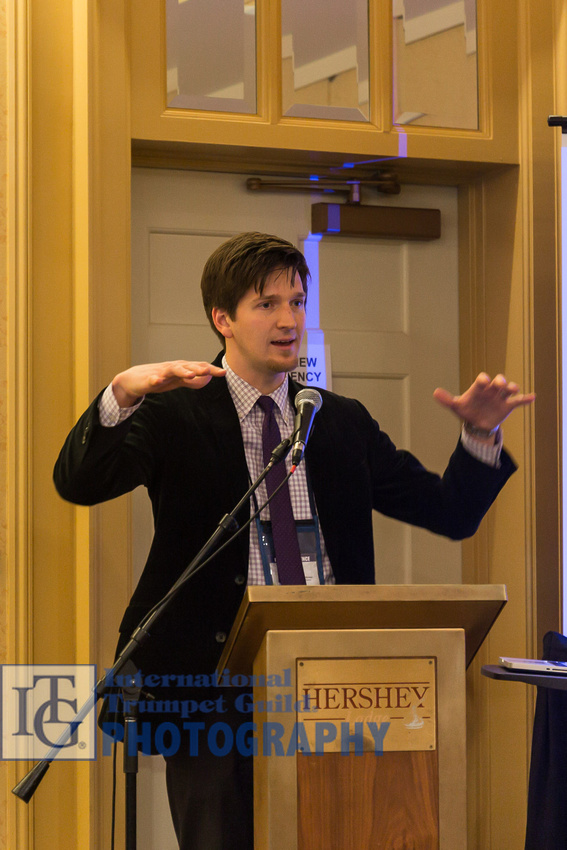 170603-0001-10Fred Sienkiewicz
170603-0001-10Fred Sienkiewicz
Dontae Winslow Youth Day Jazz Presentation - How to Succeed and Monopolize Every Opportunity in the Music Industry
Dontae Winslow began his career as a classical trumpet student, but he has become one of the most in-demand popular musicians in the world, having performed with Justin Timberlake, Lady Antebellum, Dr. Dre, and a host of others across the musical spectrum. His inspirational clinic opened with a performance of Chrysalis, an original composition that developed from hip-hop vocals into an intense and passionate trumpet solo. A true student of all music, Winslow referenced Mozart and Stravinsky as easily as he did Clifford Brown, Dr. Dre, and Hank Williams. Winslow’s class provided an abundance of information about harmony, rhythm, horn arranging, being on time, and building one’s reputation. However, the best lessons learned were about living life and communicating effectively to an audience. He closed with a blazing rendition of Straight No Chaser, showcasing his mastery of modern jazz and his tremendous passion for life. (NV)
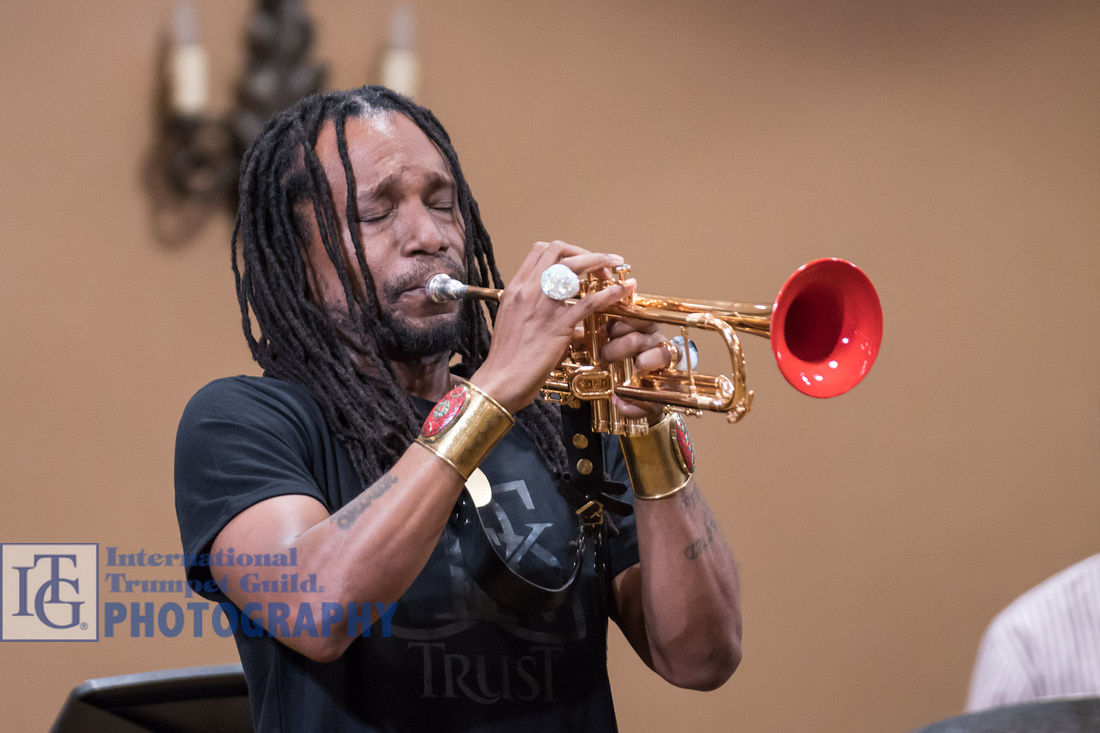 170603-0001-8Dontae Winslow
170603-0001-8Dontae Winslow
Alias Brass Youth Day Concert - Soundtrack of Our Lives
The Youth Day recital by the Alias Brass featured a great variety of works, new and old, from all different styles. Opening with Anthony DiLorenzo's exciting Fire Dance, they quickly transitioned to a beautiful horn ballad performed by Natalie Brooke Higgins, titled Saudade and composed for the group by Madeline Lee. Staying true to the tradition of brass quintets entertaining with stagecraft as well as music, the group sought to bring out the character of some of the works. Their performance of St. James Infirmary had the group creating a funeral procession, with members acting as pallbearers for the tuba, while Timothy Dueppen led the way with his trombone solo. Their Fugue on a Theme from Tetris had the ensemble stacking themselves like blocks from the game. It will be exciting to see what this ensemble continues to offer in the future. (KM)
 170603-0001-12Alias Brass
170603-0001-12Alias Brass
2017 ITG Honorary Award Recital - Allen and Laura Vizzutti
He still makes it look so easy. Allen Vizzutti, accompanied by his wife, Laura, gave yet another varied, interesting, and amazing recital. Vizzutti has been a featured artist at many ITG conferences over the years.
From the opening moments of Albinoni’s Concerto in D, performed with Vizzutti’s crystal-clear piccolo sound, to Shadows and Dragons (a dissonant and “kind of scary” - his description - work performed flawlessly on the B-flat trumpet), to his signature rendition of The Carnival of Venice, Vizzutti never fails to thrill.
He performed Three World Winds on piccolo trumpet, flugelhorn, and B-flat trumpet, representing three different types of winds: Scirocco (a warm desert wind), Chinook (a gentle wind), and Cyclone. Whether swirling eddies, a flowing breeze, or a whirling dervish, Vizzutti’s sound, intonation, and musical phrasing were breathtaking.
At the conclusion of The Carnival of Venice, Vizzutti returned to the stage, repeated the final variation and cadenza, held out his (beater) trumpet toward the audience, and, in true “drop the mic” fashion, dropped his instrument to the floor (to gasps from the audience)! This will certainly be viewed thousands of times on YouTube. And he still makes it look easy. (KE)
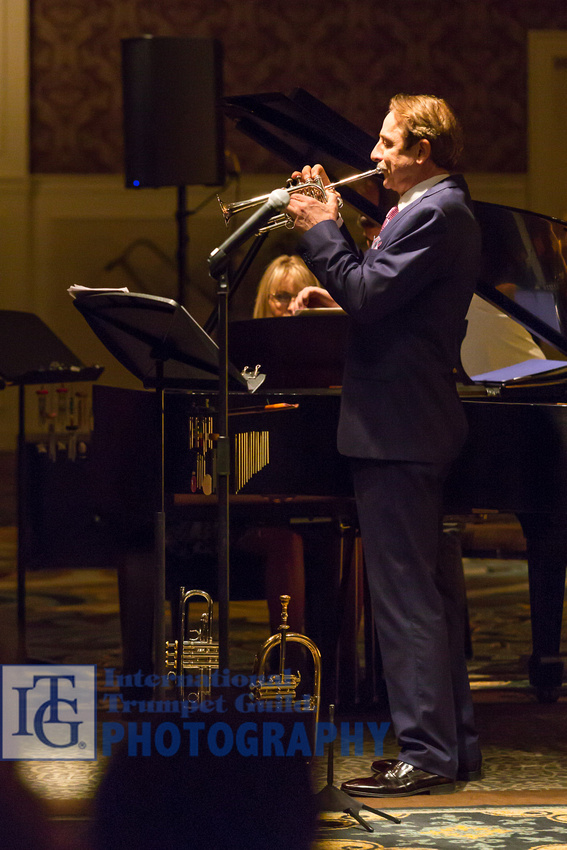 170603-0001Allen and Laura Vizzutti
170603-0001Allen and Laura Vizzutti
Festival of Trumpets Concert
Old and new friends gathered in the Great American Red Hall for the Festival of Trumpets to perform and hear a wide variety of repertoire for trumpet ensemble. The invigorating program featured fine players from all walks of life and performance experience.
First on the program was Walter Piston’s Salute, edited by Luis C. Engelke and Carl B. Schmidt and conducted by Engelke. This clean, crisp fanfare featured unison rhythms and repetitious triplet patterns. Although the piece was somewhat short, its impact was strong.
Jason Dovel’s Centrifuge (2014) featured a very unique opening trumpet solo that returned throughout. Creative mute effects and beautiful lyrical lines were passed through the ensemble.
ITG President Brian Evans conducted Paul Terracini’s Exaudi Orationen Nostrum (2010). Before the performance, Evans dedicated the piece to the trumpet players who had passed away in the last year. A soft, flowing ballad, the beauty of the piece likely lowered heart rates and relaxed shoulders of all.
Samuel Scheidt’s Canzona, edited by David Baldwin, was performed with four trumpets and piano and featured terraced dynamics and cascading musical lines commonly found in the early Baroque period.
James Olcott’s The Standard was conducted by David Brown. It included both flugelhorns and trumpets and featured many qualities of a traditional march. Audience members were tapping their toes to the beat of its lovely, singable melodies.
David Reynolds conducted Normand Lockwood’s Eidolons. This work featured all kinds of equipment, including flugelhorns, trumpets in various keys, and mute changes, providing endless interesting colors and timbres. Its eerie and mysterious musical qualities were in stark contrast to The Standard.
The virtuosic Segments (1978), by Fisher Tull, was conducted by Allyson Keyser. Two groups of four trumpet players were set up on stage, each with an impressive number of mutes prepared for quick changes during the performance. The piece opened with a bell-tone statement and maintained intensity and energy throughout.
Scott Belck arranged Michel Legrand’s jazzy The Summer Knows for trumpet ensemble. This piece could be described as a “power ballad” with its beautiful, singing, and memorable melodies.
The last piece on the program was Hector Berlioz’s “Judex crederis” from Te Deum, arranged for mass trumpet ensemble by David Turnbull. The sheer number of trumpet players on stage was impressive in itself, though not quite as impressive as the massive, glorious sound they produced. Celebratory melodic lines were an appropriate end to a wonderful concert of trumpet ensemble music. (RW)
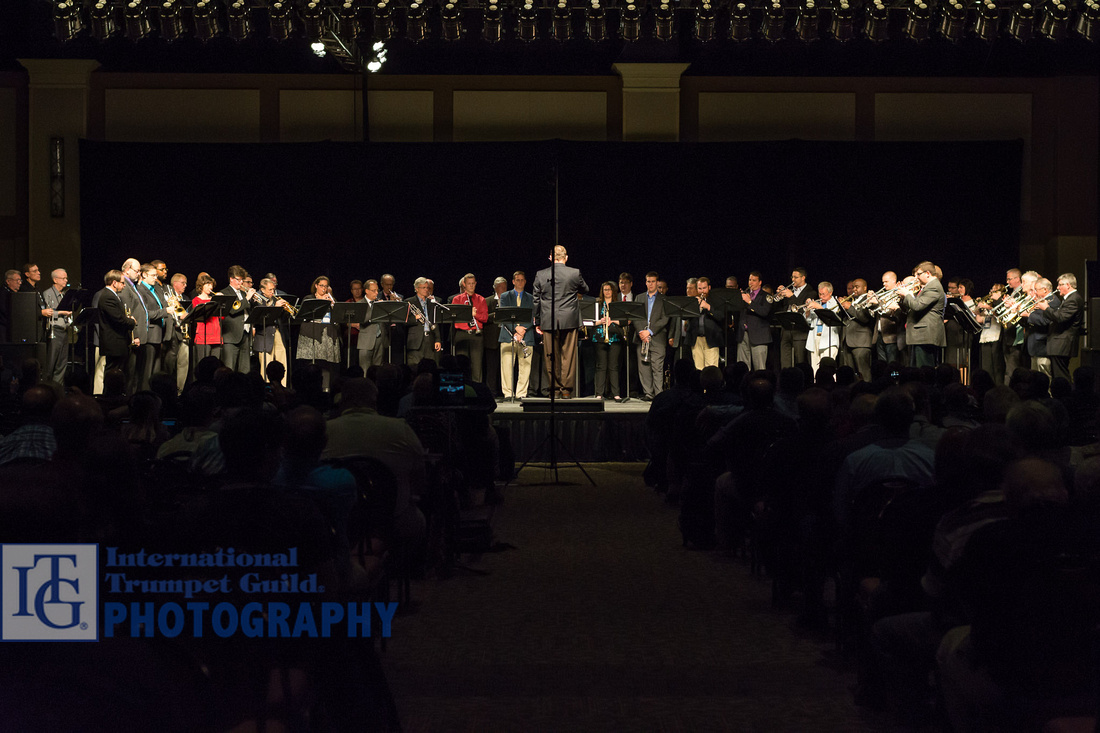 170603-0001-17Mass trumpet ensemble for Festival of Trumpets concert
170603-0001-17Mass trumpet ensemble for Festival of Trumpets concert
President’s Awards Reception
At the end of a delicious banquet dinner, the ITG Awards Banquet presentation began with ITG President Brian Evans introducing the ITG officers and honorees sitting at the head table and thanking everyone who worked at the conference, including executive staff, volunteers, accompanists, presenters, performers, exhibitors, and sponsors. He then acknowledged past presidents, conference hosts, and award recipients who were in attendance.
Jason Dovel, acting competitions coordinator, along with the coordinator of each individual competition, then announced the winners of the ITG competitions and scholarships. That list of winners is contained within the Competition and Scholarship Results blog post.
Following acknowledgment of the many scholarship winners, the ITG Honorary Awards were distributed. David Hickman accepted his award by telling the story of how ITG was founded in 1974 at the prodding of tuba legend Harvey Phillips. Hickman also expressed his pride at how much the ITG has grown over the years. Allen Vizzutti accepted his award by proclaiming, “I’m not dead yet or retiring!” and by reminding everyone in attendance that our main job as trumpeters is “to communicate happiness and joy to other people.” After relating a story about how he met Doc Severinsen at the age of 15, Doc came to the podium to say that Vizzutti is the best trumpeter of all time. He also praised Vizzutti as a husband and father, saying, “He is an incredible human being, and I love him.” (EK)
 170603-0001-22L-R: Miriam Hickman, David Hickman, Laura Vizzutti, Allen Vizzutti
170603-0001-22L-R: Miriam Hickman, David Hickman, Laura Vizzutti, Allen Vizzutti
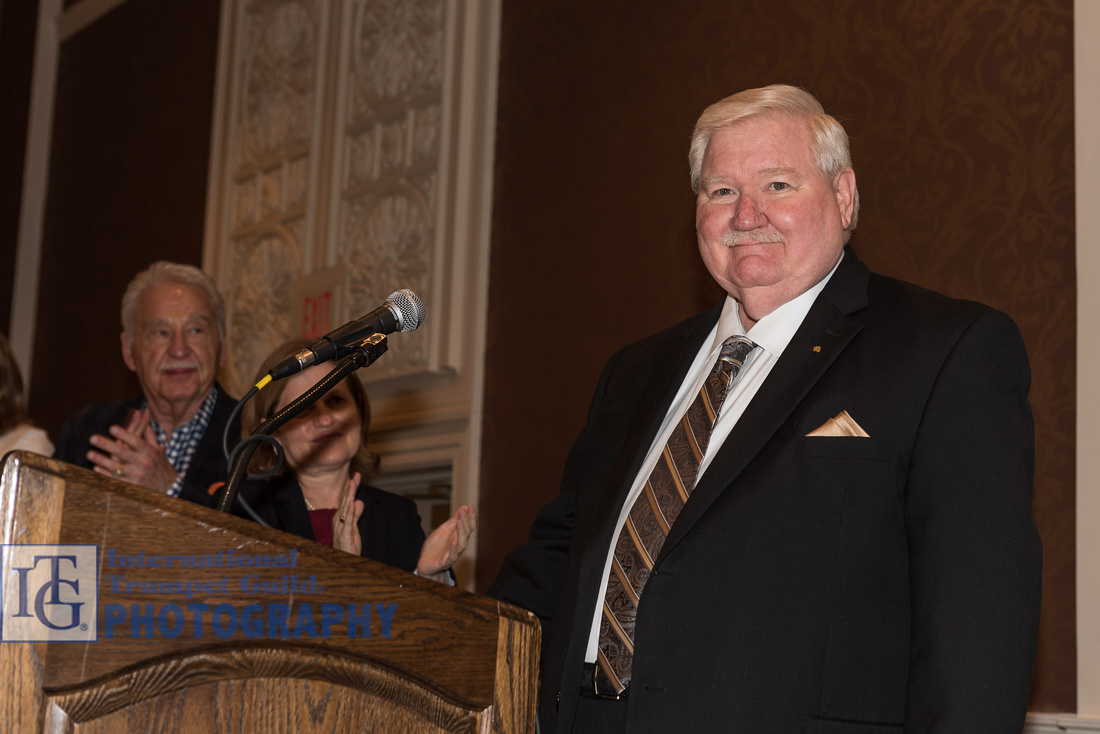 170603-0001-19David Hickman
170603-0001-19David Hickman
 170603-0001-22L-R: Doc Severinsen and Allen Vizzutti
170603-0001-22L-R: Doc Severinsen and Allen Vizzutti
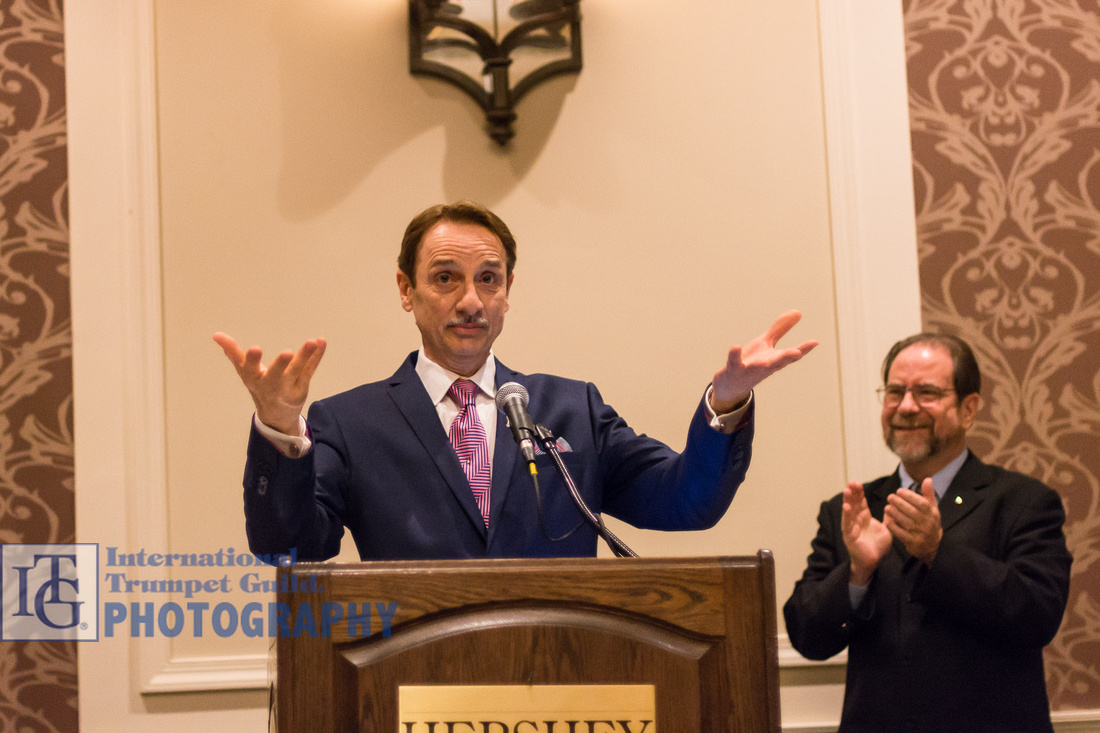 170603-0001-22Allen Vizzutti
170603-0001-22Allen Vizzutti
Click here for more photos from the ITG Conference
]]>
Special Daily Report • Compiled by Peter Wood
Photos by Michael Anderson, Norman Bergstrom, Del Lyren, and John Tamer
Friday, June 2 - Evening events
There was something for just about everyone during Friday’s third full day of the jam-packed conference. Beginning with two warm-up sessions, the fast-paced schedule included thought-provoking and highly engaging masterclasses and concerts in a wide variety of styles. Spirits remain high!
Click here for more photos from the ITG Conference
Washington Symphonic Brass Concert - Back in the USSR
The Washington Symphonic Brass, a professional brass ensemble led by trumpeter Phil Snedecor and dexterously conducted by trumpeter A. Scott Wood, consists of some of the finest brass musicians in the Washington, DC, metro area and beyond. The theme of Friday evening's program was "Back in the USSR" and was attended by a standing-room-only audience in the large Great American Red Ballroom. Serge Prokofiev's March, Op. 99, opened the concert in splendid fashion. This march featured virtuoso work from the trumpet section, particularly through the pinpoint precision of brilliant flourishes that Snedecor himself demonstrated. Anthony DiLorenzo's A Little Russian Circus is a cinematic suite that unfolds in four movements: "Tent of Terror," "Nikolai the Magnificent," "The Clown," and "Rings of Fire." The third movement of the work offered a surprise treat with trumpeter Kevin Gebo doubling on harmonica.
Snedecor's arrangement of Prokofiev's Suite from Romeo and Juliet is an extremely effective adaptation because of thunderous contributions of the percussion and low brass. The trumpets shined in this movement with virtuoso technique.
In place of an intermission, Snedecor took time to introduce each member of the ensemble and told some personal stories and whimsical anecdotes about his relationship with each player. The second half of the program began with Snedecor's brilliant arrangement of Borodin's Polovtsian Dances, a real highlight of the evening. This work featured all four trumpet players, which, in addition to Snedecor, included Matthew Harding from the US Marine Band, Joseph Burgstaller from the Peabody Conservatory, and Kevin Gebo from the US Army Band. Playing a wide variety of instruments and styles, the trumpet section showcased their extreme virtuosity, replete with everything the audience could ask for - exacting technique, sensitive lyricism, delicate pianissimos, and commanding fortissimos.
Prior to playing Snedecor's fantastic arrangement of Igor Stravinsky's Petrouchka ballet, Burgstaller asked for the house lights to be turned up, and he explained that rather having any of the four trumpet players on stage play the Ballerina’s Dance solo, he wished for the entire audience to sing the solo and "set the world record for most people singing the Ballerina's Dance from Petrouchka." While the Washington Symphonic Brass did a wonderful job with the piece, it is challenging to recreate the orchestral colors of this ballet with a brass ensemble, and some moments of this arrangement were greeted by friendly chuckles from the audience, likely the arranger's intended result.
The final piece on the program was Snedecor's arrangement of Dmitri Shostakovich's String Quartet No. 8, which was delivered in a most excellent and exciting fashion. While there were many brass-playing luminaries on stage for this concert, the most remarkable quality of the group was their ability to play with a singular, transcendent, diaphanous voice. Truly, Friday's concert showed that the Washington Symphonic Brass represents the very best in American brass playing. (JD)
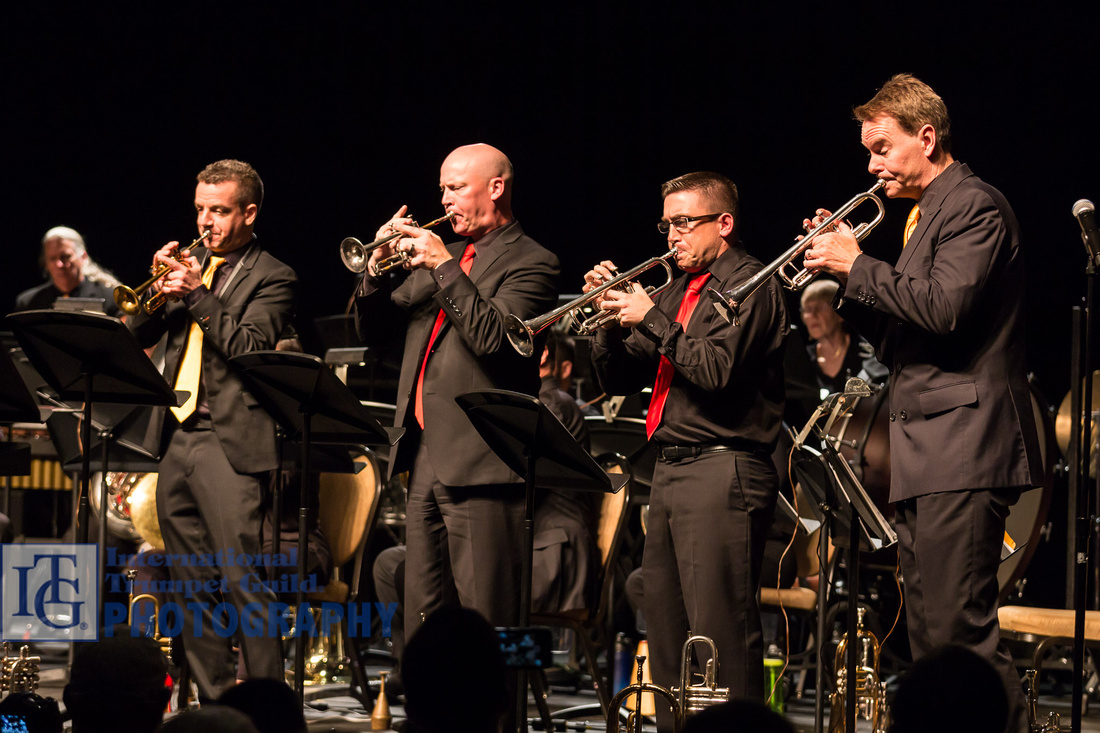 170602-0001-60Washington Symphonic Brass Trumpet Section. (L-R): Joe Burgstaller, Matthew Harding, Kevin Gebo, Phil Snedecor
170602-0001-60Washington Symphonic Brass Trumpet Section. (L-R): Joe Burgstaller, Matthew Harding, Kevin Gebo, Phil Snedecor
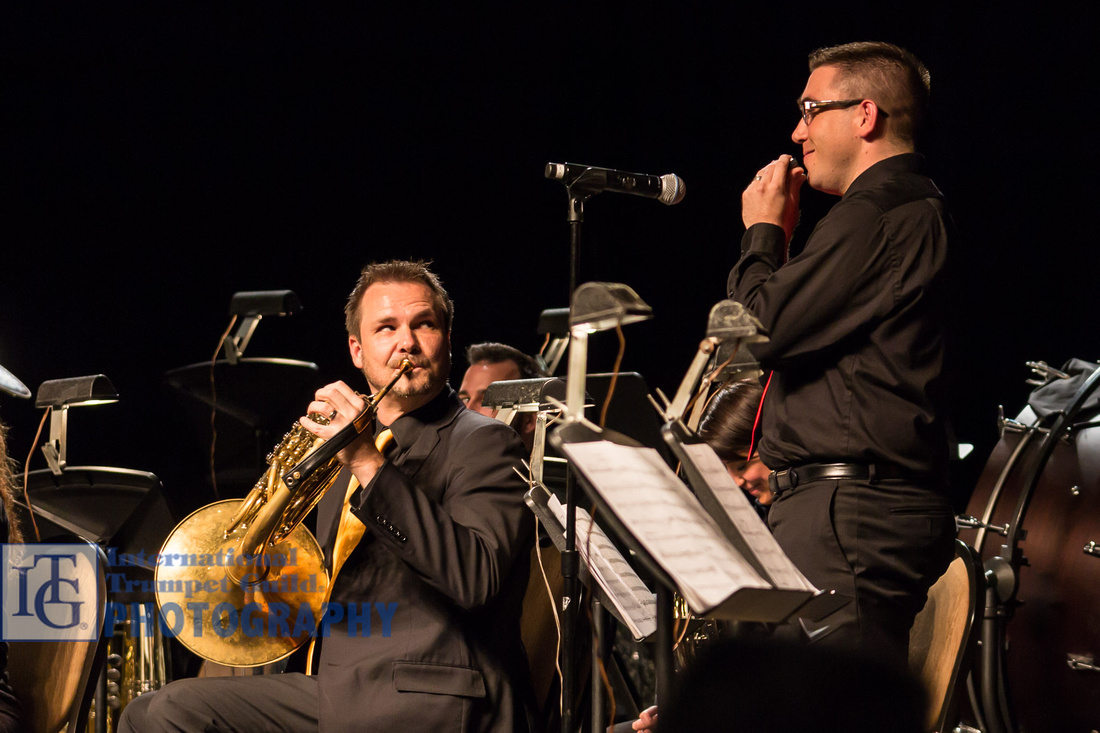 170602-0001-60In a humorous moment, principal hornist Jeff Nelsen looks up as Kevin Gebo performs a harmonica solo.
170602-0001-60In a humorous moment, principal hornist Jeff Nelsen looks up as Kevin Gebo performs a harmonica solo.
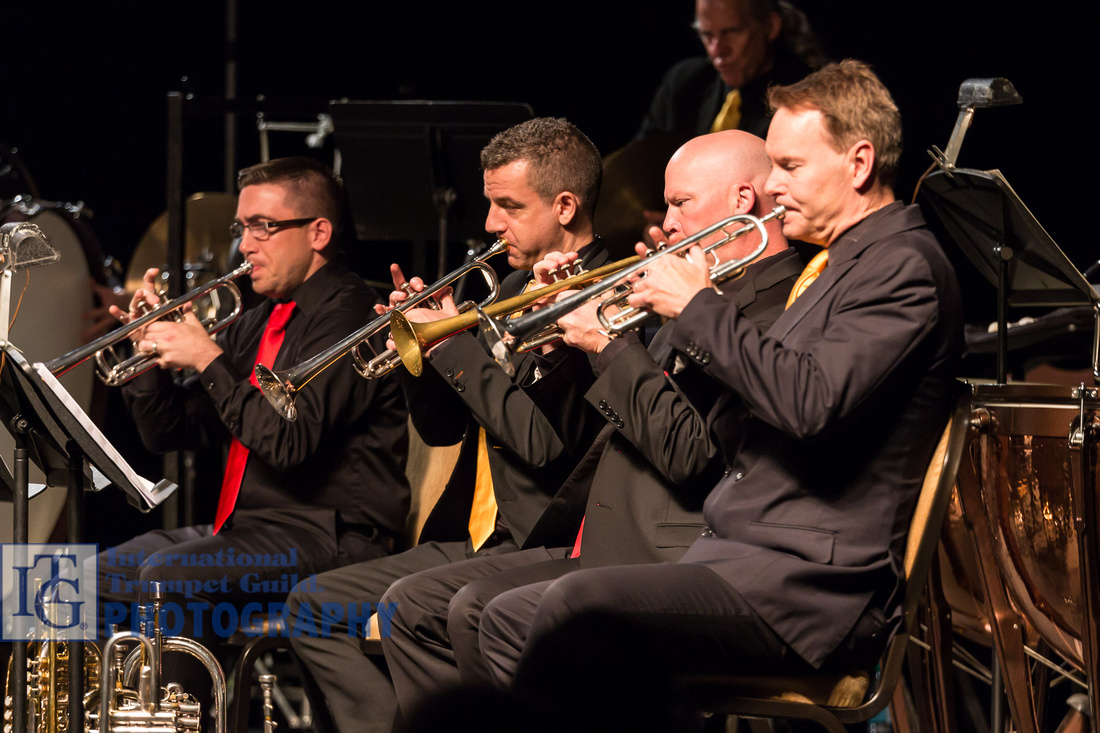 170602-0001-60Washington Symphonic Brass Trumpet Section. (L-R): Kevin Gebo, Joe Burgstaller, Matthew Harding, Phil Snedecor
170602-0001-60Washington Symphonic Brass Trumpet Section. (L-R): Kevin Gebo, Joe Burgstaller, Matthew Harding, Phil Snedecor
 170602-0001-60
170602-0001-60
Evening Jazz Concert: Thomas Gansch
Thomas Gansch and his quartet, consisting of piano, bass, and drums, transformed the large conference ball room into a jazz club with their artistry, energy, and infectious humor. Lee Morgan's Kozo's Waltz ending on a double C, and Gary Bartz’s Libra was a perfect vehicle for showing off Gansch's powerful sound and remarkable ability to play wide intervals from low to high. Stardust and the Star Spangled Banner - containing harmonic twists - were both performed on flugelhorn. Duke Ellington’s Caravan allowed Gansch to demonstrate his virtuosic technical skills, and he fluently and humorously added several trumpet quotes to his solos, including Clarke's second study, Trumpet Voluntary, and others. For the final tune of the concert, special guest Trent Austin joined the quartet on stage to perform Irving Berlin's There's No Business Like Show Business. Austin and Gansch brought the concert to a rousing ending, showcasing their technical skills and impressive range and not holding anything back. (AW)
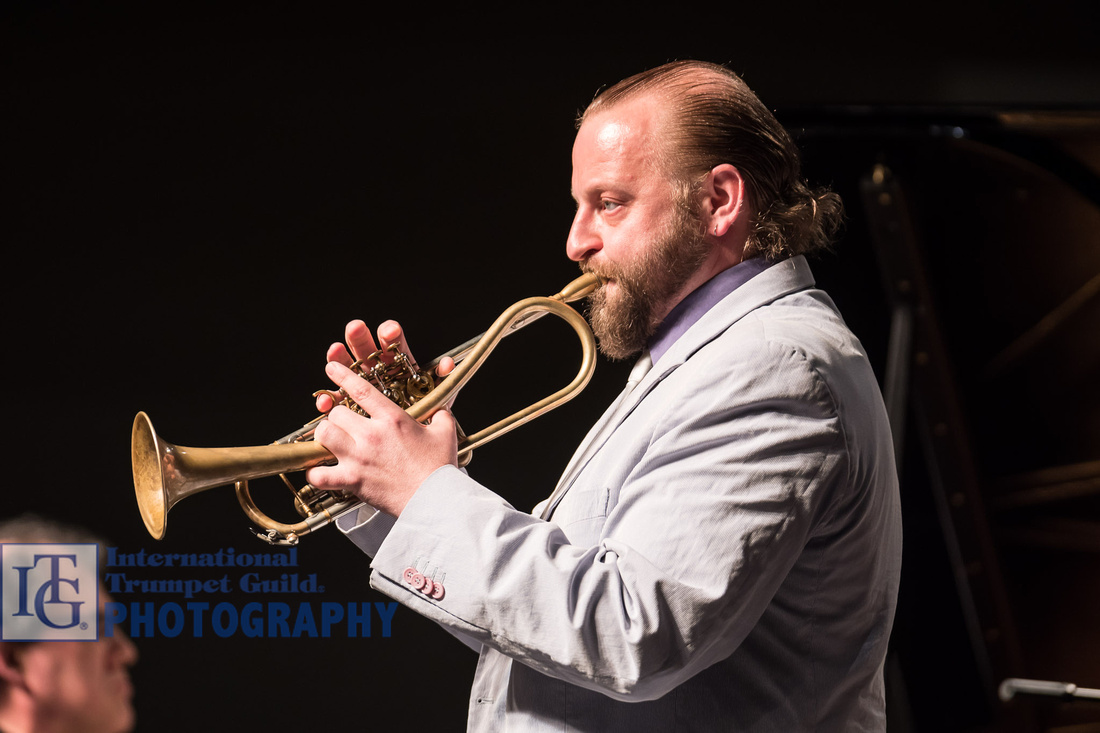 170602-0001-63Thomas Gansch
170602-0001-63Thomas Gansch
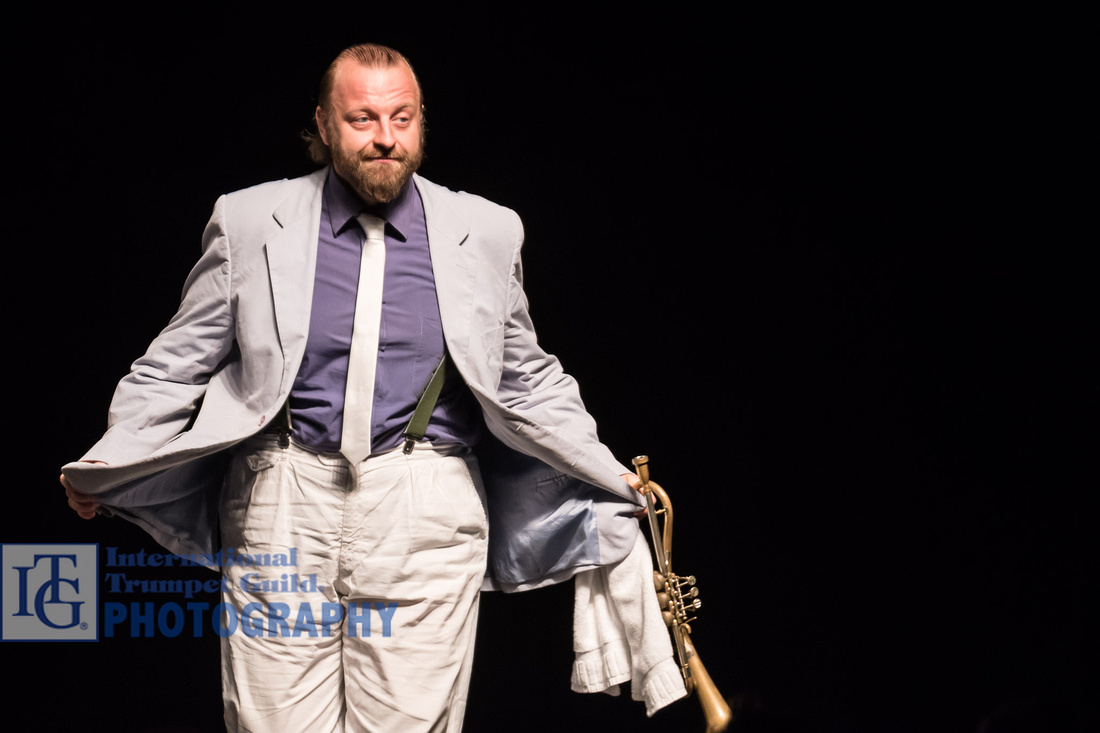 170602-0001-63Thomas Gansch
170602-0001-63Thomas Gansch
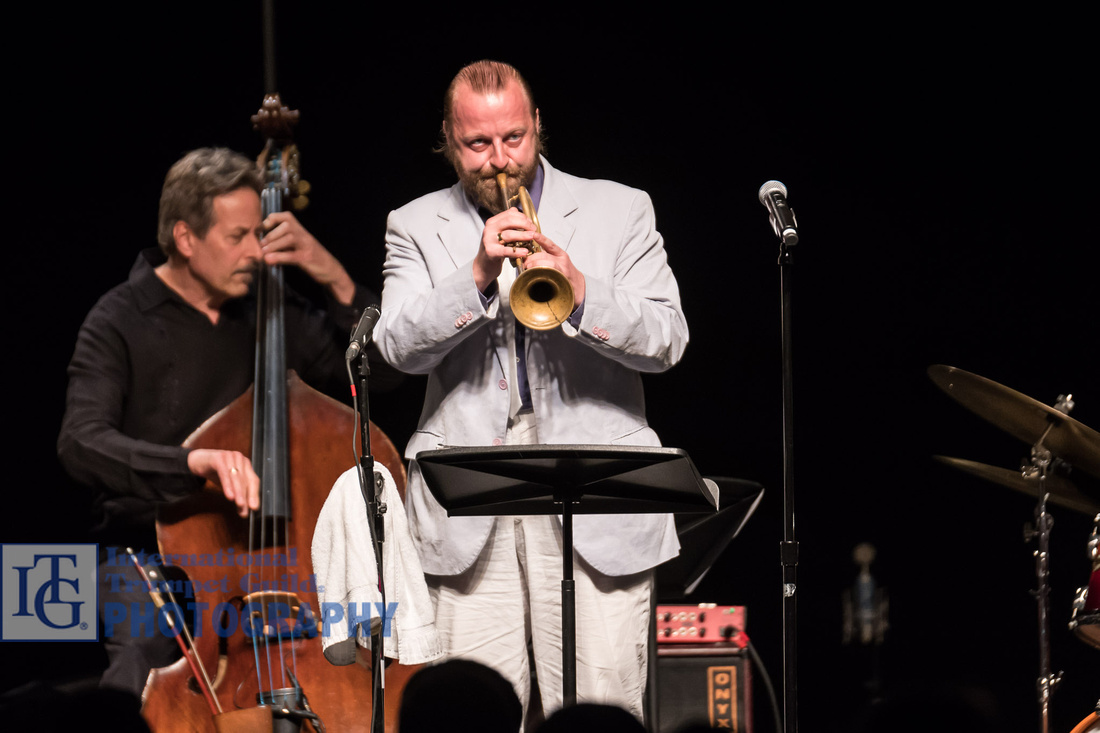 170602-0001-63Thomas Gansch
170602-0001-63Thomas Gansch
Click here for more photos from the ITG Conference
]]>
Brianne Borden (BB) currently serves as a teaching assistant at Arizona State University, where she is pursuing her Doctor of Music degree under Professor David Hickman. She travels regularly to perform recitals and present Yoga for Musicians clinics.
Jason Crafton (JC) is assistant professor of trumpet at Virginia Tech in Blacksburg, Virginia.
Davy DeArmond (DD) is trumpet instrumentalist with the United States Naval Academy Band and serves on faculties of The Catholic University of America, Washington College, and Anne Arundel Community College.
Kevin Eisensmith (KE) is professor of trumpet and assistant chair of the music department at Indiana University of Pennsylvania. He served as president of ITG from 2009 to 2011 and was recently elected to serve as secretary from 2017 to 2019.
Luis Engelke (LE) is professor of trumpet at Towson University and principal trumpet with several orchestras. He serves as editor of the Music Reviews column for the ITG Journal and chair of the ITG Commissions Committee.
Olivia Funkhouser (OF) is currently pursuing a master's degree in trumpet performance at the University of North Texas with Dr. Jason Bergman after earning bachelor's degrees in trumpet performance and music education at the University of Southern Mississippi.
Ryan Gardner (RG) is associate professor of trumpet at Oklahoma State University. He is an avid performer and a member of the ITG Board of Directors and serves as the New York and Los Angeles artistic coordinator for Music for Autism.
Alan Klaus (AK) is assistant professor of trumpet at Memorial University of Newfoundland, Canada.
Elisa Koehler (EK) is professor of music and director of the Center for Dance, Music, and Theatre at Goucher College. She is the author of Fanfares and Finesse: A Performer's Guide to Trumpet History and Literature and has served on the editorial staff of the ITG Journal since 2002.
Will Koehler (WK) is an active performer, educator, and writer and teaches at Bloomington High School North, Northview High School, and Tri-North Middle School in Bloomington, Indiana. He is a DM student in trumpet performance at the Indiana University Jacobs School of Music.
Marie Mencher (MM) is a music education candidate at Indiana University of Pennsylvania, where she studies trumpet with Dr. Kevin Eisensmith. She holds a BA in Latin American Studies from Wesleyan University.
Eric Millard (EM) currently serves as third trumpet with the Tallahassee Symphony and is pursuing his doctorate in trumpet performance at Florida State University.
Kyle Millsap (KM) is assistant professor of trumpet and jazz at Texas A&M University-Kingsville. He oversees the dynamic trumpet program and directs the trumpet ensembles, jazz trumpet ensembles, and Jazz Band 3.
Nick Mondello (NM) is a freelance trumpeter, educator/clinician/consultant and writer. He is the author of 365 Trumpet Lessons, writes for many jazz publications, and is the editor of the Studio/Commercial Scene column for the ITG Journal.
Paige Nelson, editorial assistant, is a master’s trumpet student at the University of Northern Colorado and a recent graduate of the University of South Alabama.
Donald K. Roeder (DR), MD, FACS, is a retired thoracic surgeon who lives in Boiling Springs, Pennsylvania. He serves as a bugler with the Cumberland County Honor Guard and performs with the Carlisle Town Band and the Carlisle Brass Quintet.
J. Peyden Shelton (JS) is currently assistant professor of trumpet at the University of Utah. He is also a Stomvi Flex mouthpiece artist and a Torpedo Bag professional artist.
Steve Siegel (SS) is a recordings reviewer and sheet music reviewer for the International Trumpet Guild Journal. He is the instructor of trumpet at Centre College in Danville, Kentucky.
Nick Volz (NV) is associate professor of classical and jazz trumpet at Loyola University New Orleans. He performs with a variety of groups, including the Louisiana Philharmonic Orchestra.
Rebecca Walenz (RW) is the editor of the itg journal, jr. column in the ITG Journal. She is a doctoral teaching assistant in trumpet performance at Florida State University, where she studies with Christopher Moore.
Spencer Wallin (SW) is currently a teaching fellow at the University of North Texas, where he studies with Jason Bergman. Wallin has performed with the Dallas Winds, the Detroit Symphony Orchestra, and the Utah Symphony Orchestra.
Aaron Witek (AW) is assistant professor of trumpet at the University of Louisiana at Monroe, where he is a member of the Black Bayou Brass.
Jodi Graham Wood is the assistant editor and principal proofreader of the ITG Journal and also serves as instructor of horn at the University of South Alabama.
Photography Staff
Michael Anderson (MA) is the ITG Website director and head photographer for the conference. He serves as professor of trumpet at Oklahoma City University and is a member of the Oklahoma City Philharmonic.
Norman Bergstrom (NB) has been a member of the Blawenburg (New Jersey) Band trumpet section since 1962. He is also the photographer for the Nova Orchestra in West Windsor, New Jersey.
Del Lyren (DL) is professor of trumpet and jazz at Bemidji State University. He has been active in many aspects of ITG, including co-hosting the 2011 conference in Minneapolis.
Brian Shook (BS) is associate professor of trumpet at Lamar University in Beaumont, Texas, and is the editor of the Recording Reviews column for the ITG Journal. He also serves as stage manager for the ITG Conference.
John Tamer (JT) is a trumpet player living in Ellicott City, Maryland, who works as an engineer at Johns Hopkins University.
]]>
Special Daily Report • Compiled by Peter Wood
Photos by Michael Anderson, Norman Bergstrom, Del Lyren, and John Tamer
Friday, June 2 - Daytime events
There was something for just about everyone during Friday’s third full day of the jam-packed conference. Beginning with two warm-up sessions, the fast-paced schedule included thought-provoking and highly engaging masterclasses and concerts in a wide variety of styles. Spirits remain high!
Click here for more photos from the ITG Conference
Ryan Gardner Warm-Up Session - Singing Through Stamp
Ryan Gardner led a room full of early risers through his warm-up routine of Boyd Hood/James Stamp exercises. Gardner’s packet of exercises was prefaced by an organized list of all the important fundamentals that need to be addressed on a daily basis, and his routine efficiently covered the entire list in a methodical approach. Gardner emphasized that one should always play with great ease and a beautiful sound, and his playing exemplified those qualities as he demonstrated each exercise. From breathing drills to flow studies and flexibility, Gardner’s comprehensive warmup prepared the participants to be able to play anything during the day ahead. A fresh perspective on the Stamp routine, Gardner encouraged incorporating four components of trumpet playing into the warmup - playing, listening, singing, and resting. Gardner also stressed the importance of “Having Fun!” every time you play, and it is safe to say the entire class did just that. (EM)
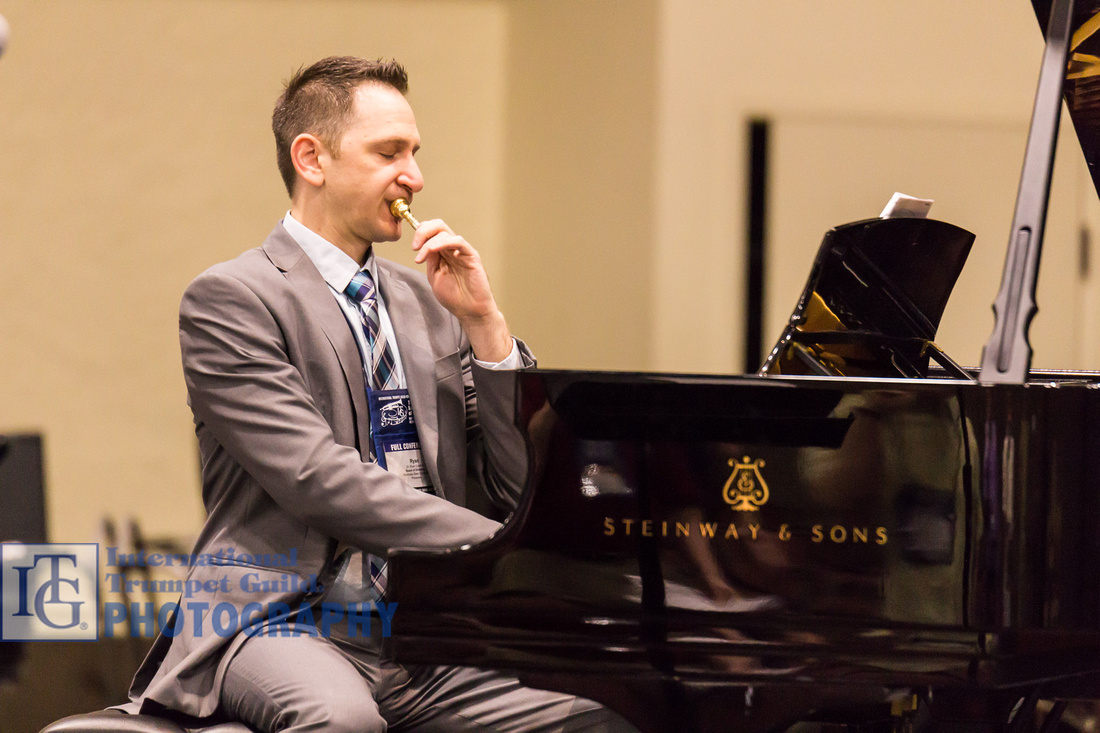 170602-0001-2Ryan Gardner
170602-0001-2Ryan Gardner
Judith Saxton - Non-Pro Warmup Session: Alexander Technique
Judith Saxton’s interactive warm-up session featured principles of the Alexander Technique. Not only was mindfulness an important topic, but she also explained “bodyfulness,” saying, “The body and mind are connected; what we think is how we move.” The process of the warm-up session began with becoming aware of one’s surroundings. This transitioned into singing, playing buzzing exercises on the mouthpiece, and, finally, performing on a fully assembled trumpet. As new steps were introduced, the question “Did you lose your feet?” followed, reminding the audience of the bodyfulness concept. Saxton discussed the importance of one’s mindset while warming up. The mindset of performers should be purposefully involved in music, rather than thinking “How do I feel today?” Singing, moving with and visualizing music before one performs on the instrument will result in a clearer, more focused sound. Saxton’s class was well received as the energy of the room evolved into a welcoming, spirited environment. (SS)
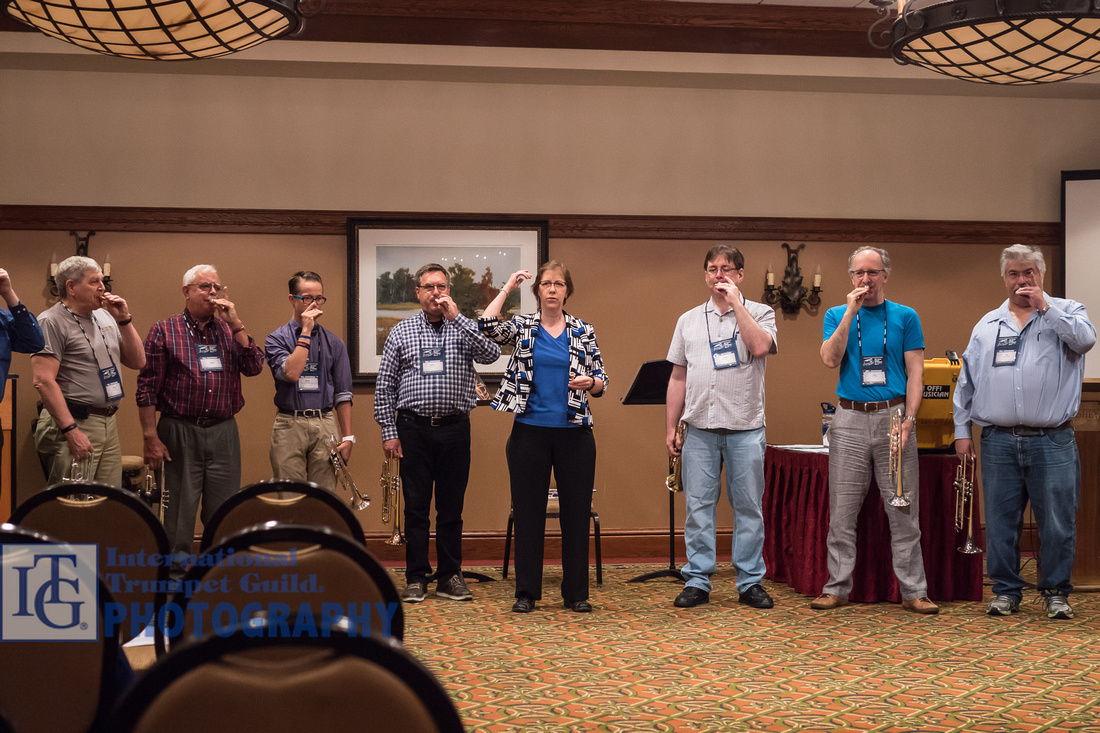 170602-0001Judith Saxton warm-up session
170602-0001Judith Saxton warm-up session
Judith Saxton Non-Pro Masterclass
Trumpet players of all ages and playing levels gathered in the Empire Ballroom to receive constructive feedback on their trumpet playing from Judith Saxton. A variety of players found the courage to perform for those in attendance, playing a portion of a solo or etude of their choice. Saxton delivered excellent and effective advice, often referencing her extensive knowledge of the Alexander Technique. Despite the early starting time of the clinic, particularly toward the end of the conference, those in attendance were energetic and actively engaged in the question-and-answer session, creating an informative and educational environment. Although Saxton provided many valuable constructive comments, this author most appreciated her ability to give feedback on performances in an honest, yet kind, fashion. (RW)
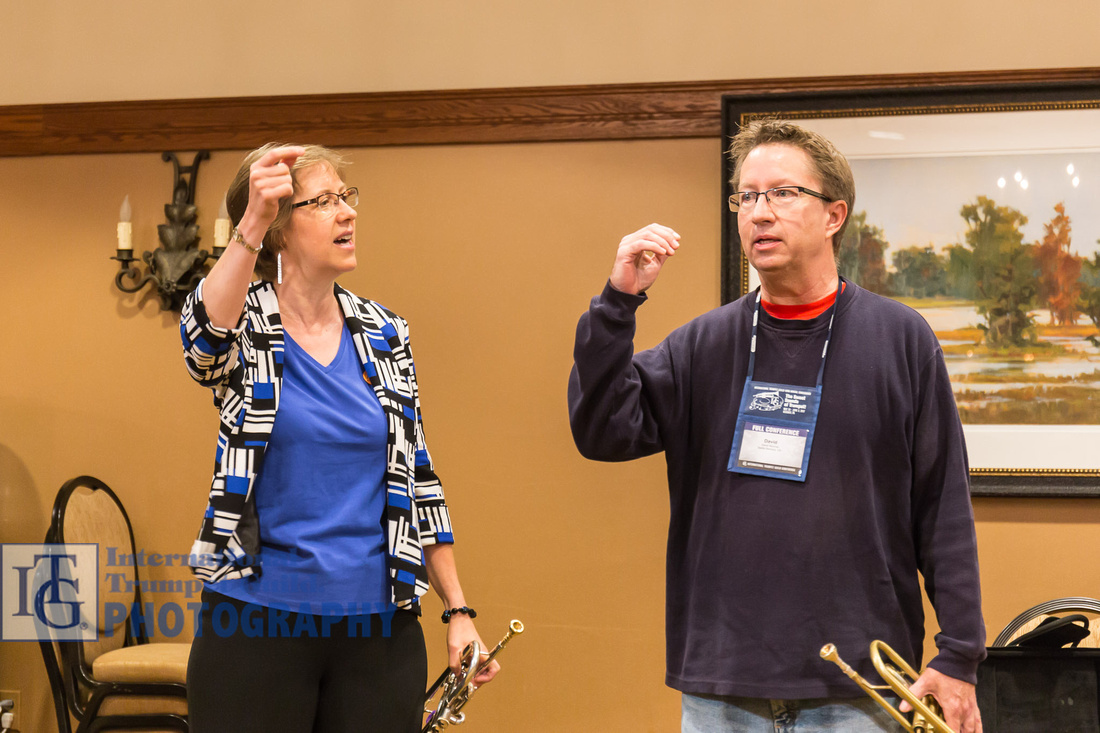 170602-0001-4Judith Saxton masterclass
170602-0001-4Judith Saxton masterclass
Eric Berlin Trio Recital - Music for Trumpet, Trombone, and Piano
Eric Berlin, a native of Manheim, Pennsylvania, proudly held up his half gallon of Turkey Hill Iced Tea and acknowledged his parents in the audience. He had traveled back to his home turf for a morning recital of twentieth-century repertoire for trumpet, trombone, and piano, including several adaptations. Berlin and trombonist Greg Spiridopoulos are longtime colleagues in the Albany Symphony Orchestra and have cultivated a superb blend after years of collaboration. Pianist Ludmila Krasin provided sensitive and versatile accompaniment, playing a wind ensemble reduction of Jeffrey Wayne Holmes’s jazzy Continuum and brass band reduction on Anthony Plog’s Concertino. The trio opened the recital with Eric Ewazen’s Double Concerto, a high-energy piece that showcased the players’ melodic and technical abilities. The trumpet and trombone lines are ever so slightly offset rhythmically, a feat that was executed with seeming effortlessness. The trio closed the recital with Herbert L. Clarke’s Cousins to honor this region’s band tradition. (MM)
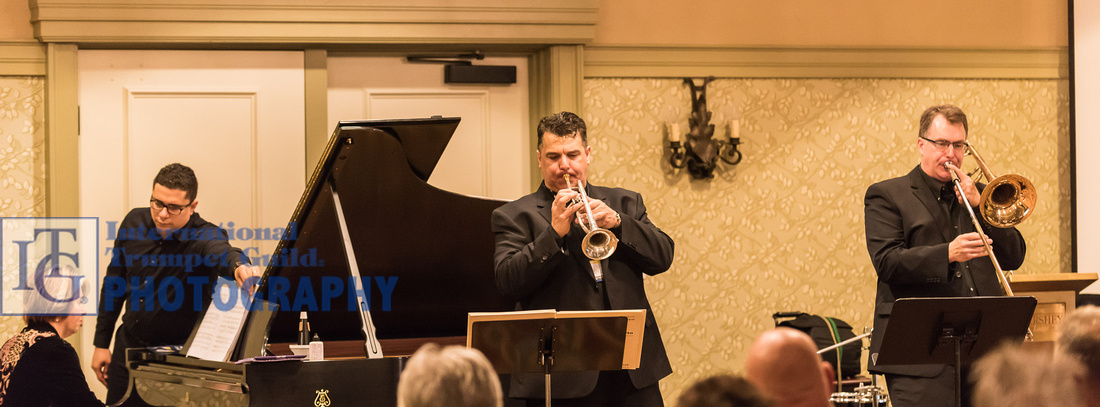 170602-0001-3Eric Berlin Trio
170602-0001-3Eric Berlin Trio
James Wood Presentation - Resumes and Recordings: Presenting Your Best First Impression
Following the prelude ensemble’s performance, Master Sergeant James Wood began his clinic. Wood currently represents The United States Army Field Band as their auditions coordinator, and he also served as a trumpet player in the ensemble for over fourteen years. He provided insight from various sides of the audition process - applying for positions, sitting on the selection committees, and coordinating and corresponding with potential candidates. Wood emphasized how important both the look and content of the resume impacts the committee’s impression of a candidate. He also shared insights on how to record for pre-screenings and on what the committees are listening for in each audition. He emphasized the importance of having the right recording devices and how different environments can impact a player’s final product despite the overall abilities of the player. (JS)
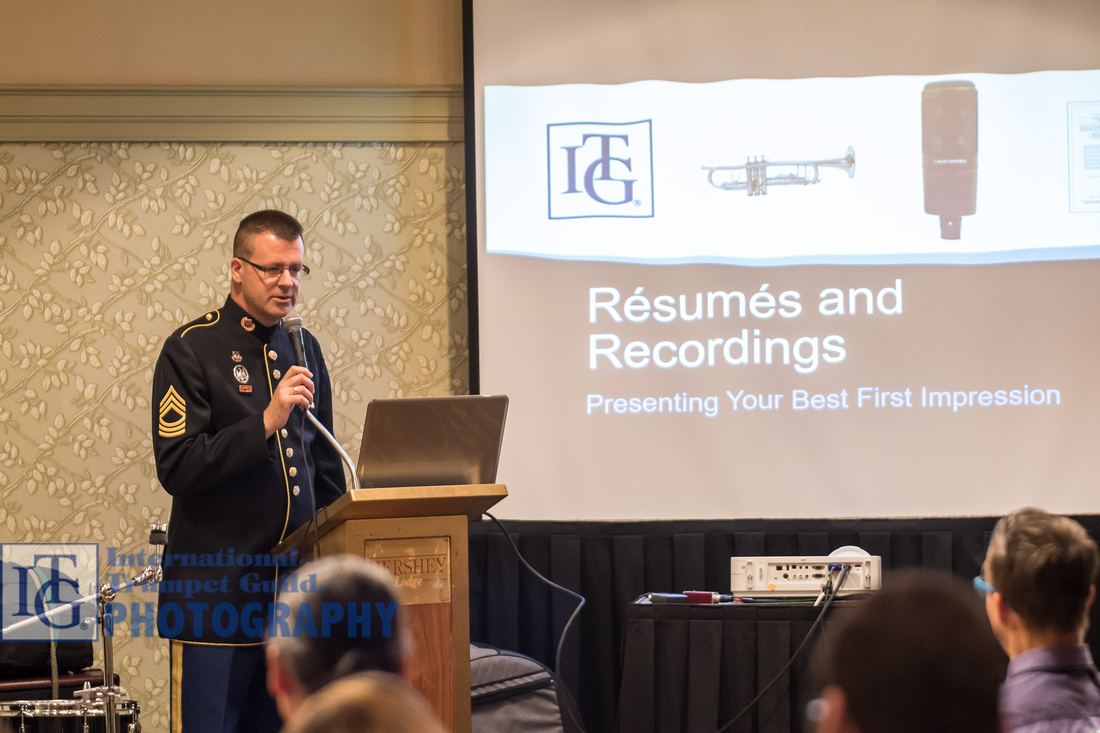 170602-0001-12MSGT James Wood
170602-0001-12MSGT James Wood
Jordi Albert Presentation - Focal Dystonia in Brass Players: Treatment Strategies
Jordi Albert, Stomvi artist and researcher in motor skills in brass players, presented a highly informative and detailed clinic based on his comprehensive methodology for treatment of focal dystonia (FTSD). Through his work teaching over 130 students with FTSD, Albert has developed a holistic approach to treating the condition based on “Expert Motor Program Theory,” which states that there are four motor actions required for trumpet playing, including body position, respiratory cycle, sound production, and diction. For each of these actions, there is a threshold of minimum effort that produces maximum results. When the maximum threshold of effort is surpassed, the employment of unnecessary effort can lead to focal dystonia. After an initial evaluation of the problem, Albert applies a three-step treatment approach, including rebalancing the orofacial muscles through the “Musclebrass” program, development of self-regulated treatment using auditory feedback, then eventually sending the student to another teacher for further development. (OF)
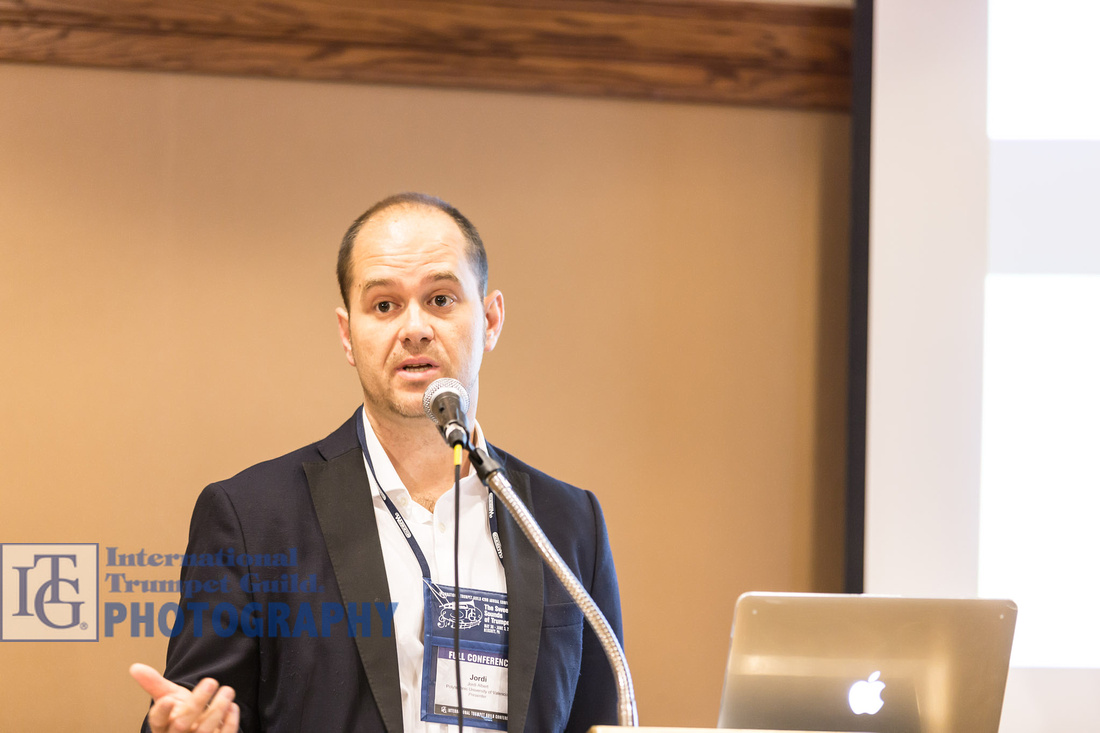 170602-0001-10Jordi Albert
170602-0001-10Jordi Albert
David Hickman Tribute Concert
The Hickman Tribute Concert began with Dave's Fanfare, a world premiere composed by Anthony Plog. The recital was organized to recognize Hickman, who is receiving this year’s ITG Honorary Award. Selections were performed by colleagues and former students, highlighting his many roles as a teacher, performer, and entrepreneur. Allan Dean, Ronald Romm, and John Marchiando brilliantly performed two Rafael Méndez trios. Two large ensembles featured arrangements by Hickman for twelve trumpets, and a third performed the second world premiere of the recital, composed by Daniel Thrower. Former students Nancy Taylor, Michael Arndt, Ginger Turner, and Luis Engelke all performed duets or solos. Joe Burgstaller attempted to turn the recital into a "roast" with stories of near-death experiences with Hickman before performing a set of pieces to great applause. The recital closed with Hickman conducting a mass ensemble of his students who had performed on the recital plus Dean and Romm. (KM)
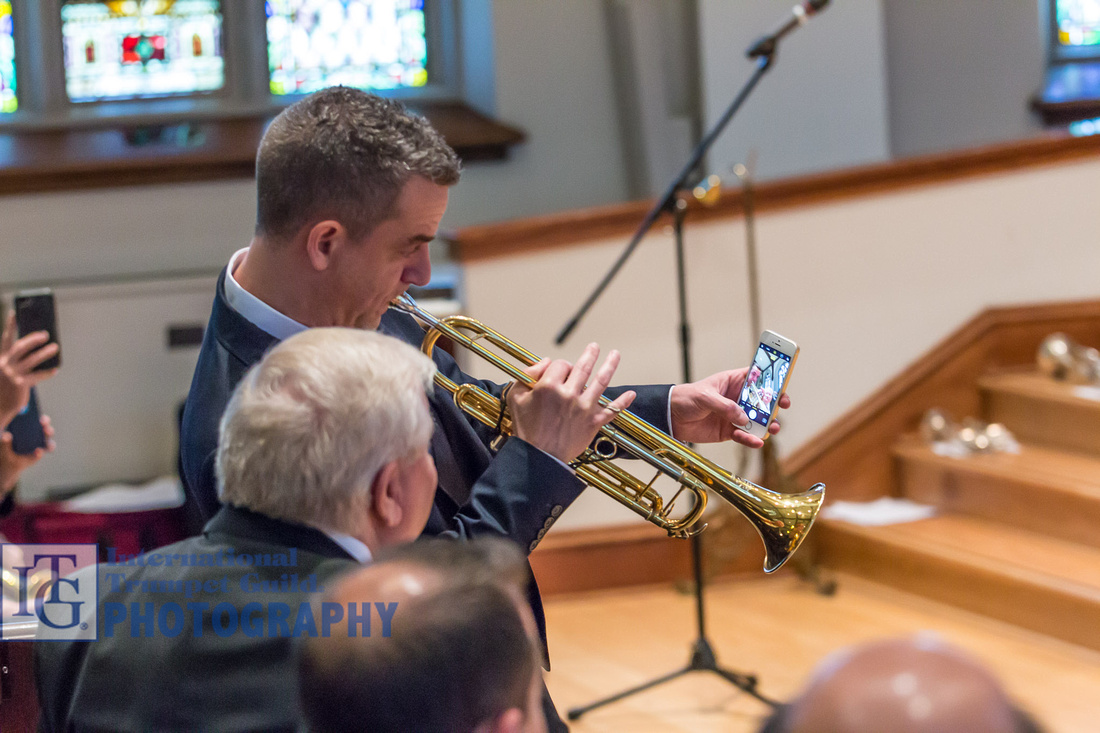 170602-0001-18Joe Burgstaller and David Hickman
170602-0001-18Joe Burgstaller and David Hickman
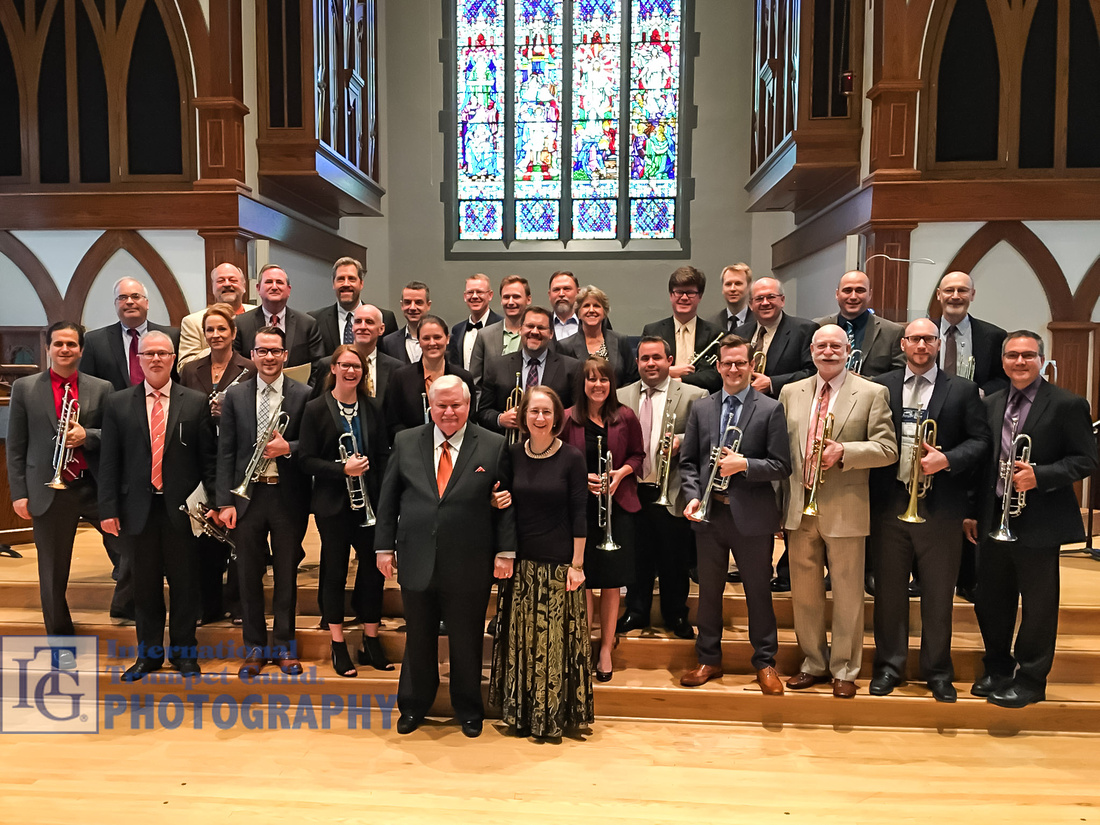 170602-0001-18Performers on the David Hickman Tribute Concert
170602-0001-18Performers on the David Hickman Tribute Concert
Graham Breedlove Jazz Recital - Music of the Masters: Tunes from the Legends of Jazz Trumpet
Breedlove, along with the Conference Jazz Trio consisting of Tom Lawton, Peter Paulsen, and Chris Hanning, presented an informative, entertaining, and up-to-date retrospective of the history of jazz trumpet. The concert featured music associated with and popularized by some of the greatest jazz trumpet players. The arrangements, all by Breedlove, were written especially for this performance and provided a fresh take on familiar repertoire. First on the concert was Bobby Timmons’s Moanin’, arranged in a Latin style. Breedlove’s performance on this tune showed his considerable skills as a trumpet player and his creativity and ingenuity as an improviser. Perhaps the most exciting performance of the concert was Breedlove’s Plausible Deniability. All ensemble members demonstrated their full range of abilities and virtuosity in this hard-driving composition. Breedlove’s solo showcased his formidable technique and harmonic language. This was an impressive performance featuring four quality musicians at the top of their game. (JC)
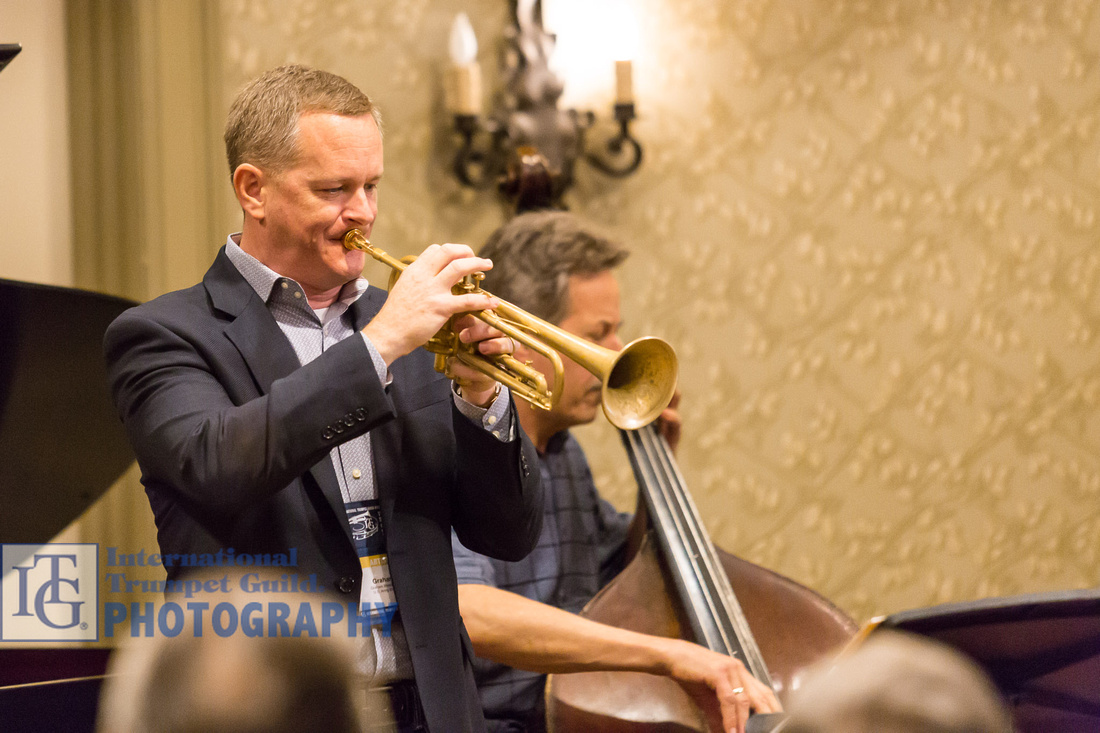 170602-0001-27Graham Breedlove
170602-0001-27Graham Breedlove
K.O. Skinsnes Presentation - Cheater Mouthpieces and Other Delights: Reach Your Playing Goals Faster and Easier with the Correct Gear and Approach for the Job
K.O. Skinsnes opened his presentation by stating that there is no such thing as a "cheater" mouthpiece. He went on to present how each individual trumpet player should approach finding what unique mouthpiece and horn suits them best. He emphasized intonation and how important it is to ensure that one’s mouthpiece and trumpet combination is as in tune with itself as possible. Additionally, Skinsnes demonstrated the importance of the mouthpiece gap with recordings of an in-tune setup vs. an out-of-tune setup. He stressed the fact that it is impossible to calculate the correct gap, since lip insertion is a determining factor. Before opening the session to questions, Skinses concluded by explaining the importance of aiming for good intonation, choosing the appropriate gear, and studying your trumpet with the goal of being efficient. (BB)
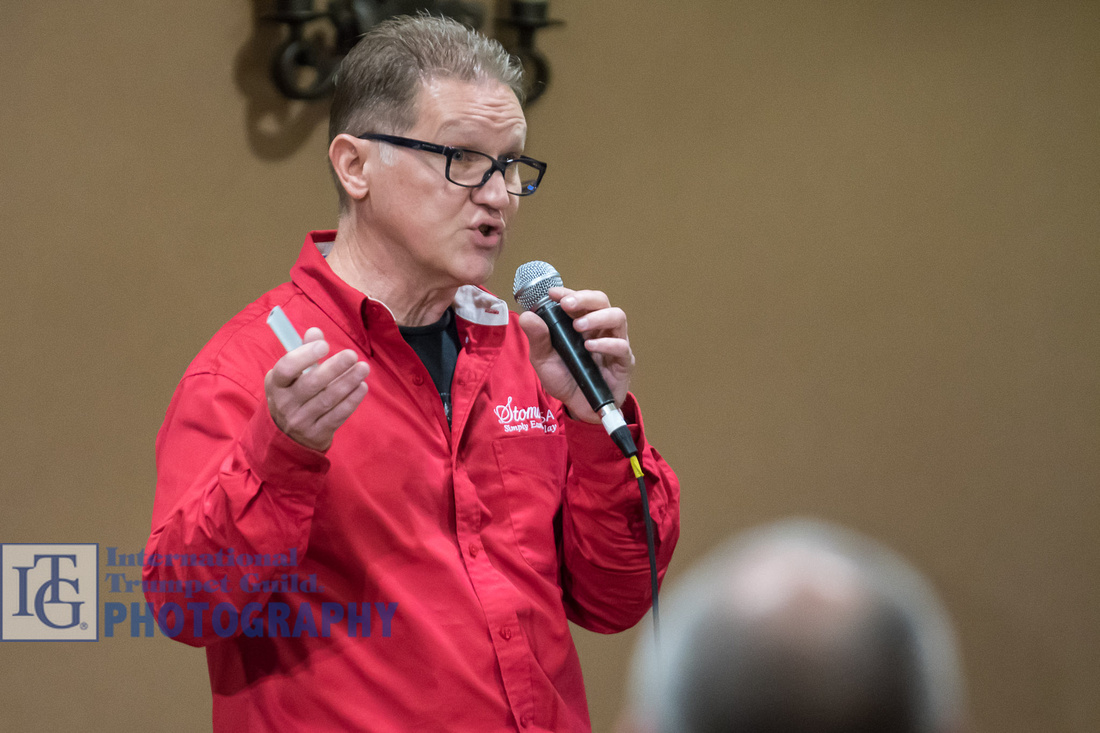 170602-0001-23K.O. Skinsnes
170602-0001-23K.O. Skinsnes
ITG Military Band Excerpts Competition Finals
Matthew Mignardi, Brent Proseus, and Alex Wilborn all performed admirably in the second year of the Military Band Excerpts Competition Finals. The competitors all displayed full sounds, refined technical abilities, and lyrical expression in a rigorous audition setting. Matthew Mignardi engulfed the room with his warm vibrant sound, Brent Proseus showcased his virtuosic technique, and Alex Wilborn highlighted his finesse and control across the range of the horn. All three performed at an extremely high level and have incredibly bright futures ahead of them (perhaps in a military band). The list included standard excerpts from such band pieces as Fantasie Brilliante (Arban), Variations on America (Ives), Divertimento for Band (Persichetti), and Festive Overture (Shostakovich), among others. The judges were MGySgt Christian Ferrari of the US Marine Band, and SGM Ginger Turner and MSgt James Wood of the US Army Field Band. (EM)
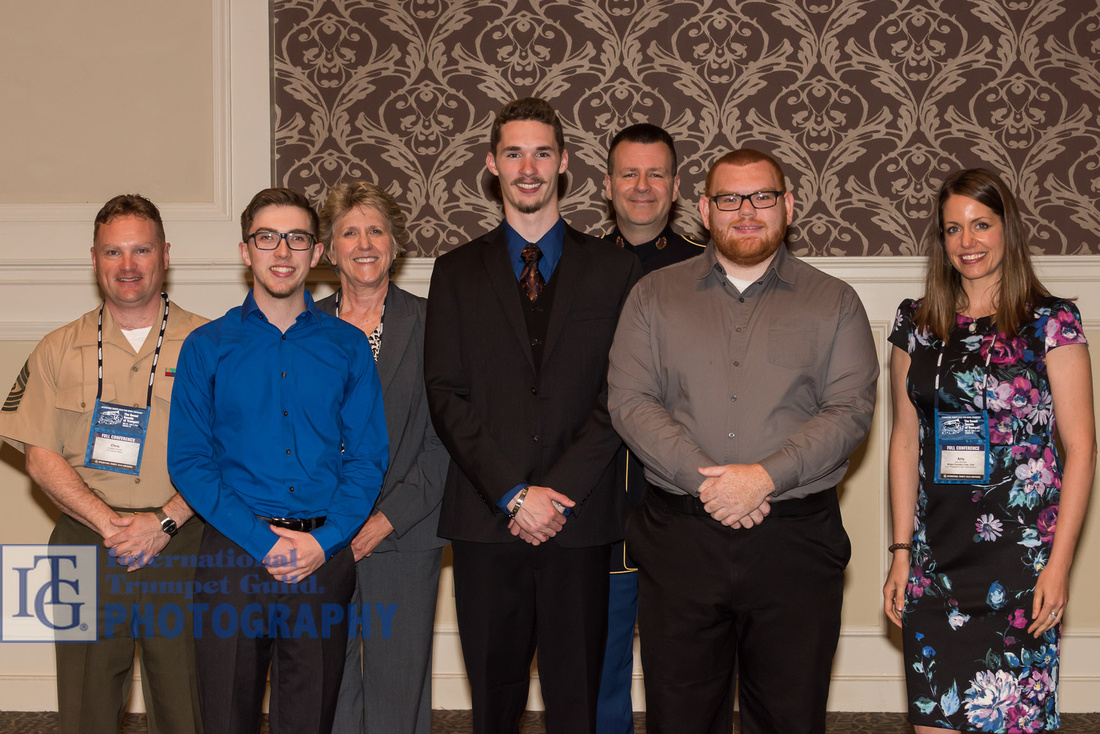 170602-0001-28ITG Military Band Excerpts Competition finalists and judges. L-R: MGySgt Christian Ferrari, Matthew Mignardi, SGM Ginger Turner, Brent Proseus, MSgt James Wood, Alex Wilborn, coordinator GySgt Amy McCabe
170602-0001-28ITG Military Band Excerpts Competition finalists and judges. L-R: MGySgt Christian Ferrari, Matthew Mignardi, SGM Ginger Turner, Brent Proseus, MSgt James Wood, Alex Wilborn, coordinator GySgt Amy McCabe
Elisa Koehler Lecture-Recital - Arban at the Opera
Elisa Koehler’s lecture recital, Arban at the Opera, provided the audience with an insightful look into the correlation between Jean-Baptiste Arban’s arrangements for cornet and the Bel Canto style of singing in many nineteenth-century Italian operas. Opening with a performance of Arban’s Fantasia sur Verdi’s “La Traviata,” Koehler provided beautiful examples that reflected the cornet’s true singing potential. She then briefly traced the development of the cornet to the modern trumpet and discussed various editions of the Arban method and the numerous supplemental materials that exist on the market. Koehler provided detailed research that documented the various operas from which Arban drew for his creation of The Art of the Phrase. Koehler closed her lecture-recital with a beautiful rendition of Arban’s arrangement of Variations on a Theme from “Norma.” (JS)
 170602-0001-34Elisa Koehler
170602-0001-34Elisa Koehler
Chris Legaux, Erik Morales, and Peter Pickett Presentation - Career Opportunity Beyond Performance
Chris Legaux (Trumcor Mutes), Erik Morales (composer), and Peter Pickett (Pickett Brass) led a wonderful discussion on how each of them became successful professionals in the music industry through non-performing careers. With the underlying themes of working hard, being willing to take risks, and finding ways to leave a positive impact on others, all enjoyed the opportunity to ask questions and learn from these highly successful entrepreneurs. It was particularly helpful to hear their distinct stories of success, and the audience joined in laughter as Legaux shared his struggles with making his first metal mute. Pickett and Morales agreed that people may experience small failures along any path - and not everyone may like a particular product - but ultimately, with hard work and dedication, anyone will be able to find their place in the trumpet community. (SW)
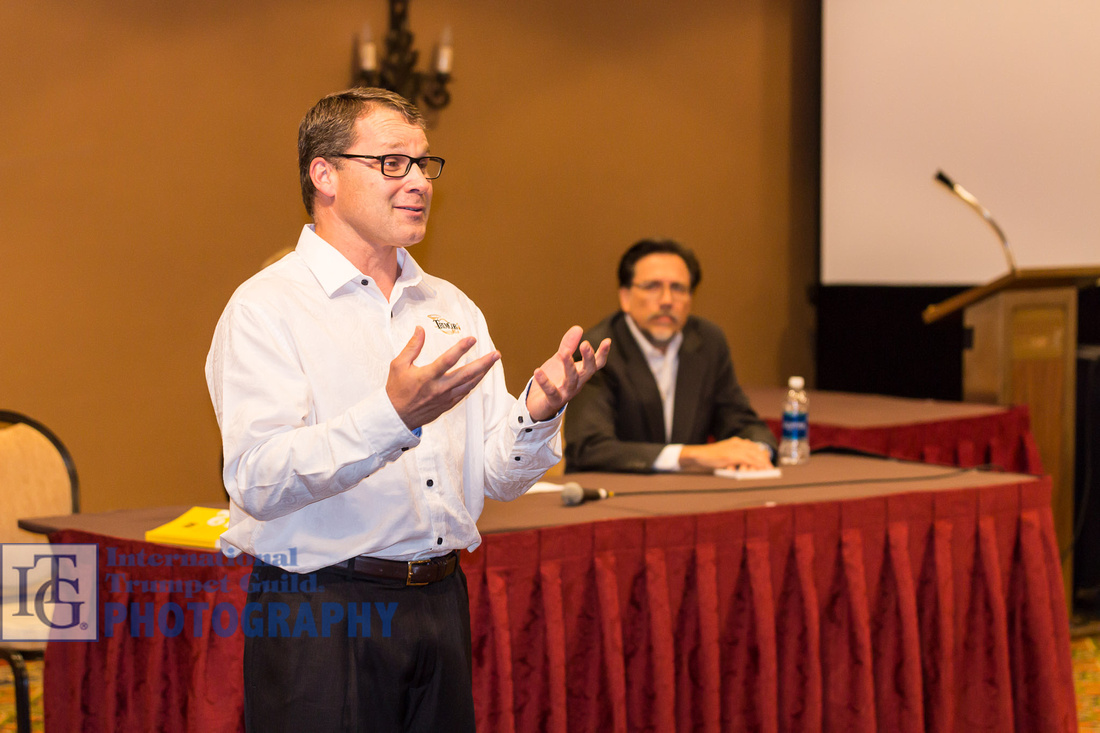 170602-0001-30Chris Legaux (L) and Erik Morales
170602-0001-30Chris Legaux (L) and Erik Morales
New Works Recital
Carson Cooman’s Sonata for a Flugelhorn and Piano was the result of a commission from soloist Anne McNamara and a consortium. McNamara performed Ludus, the second of two movements, with precision and flair. As the program notes describe, “Largely lyrical material [is developed] with a distinctive nervous energy.”
Max Matzen performed Convergence for trumpet, piano, and tape by Michaela Eremiášová, a three-movement work that represents a disagreement between the diametrically opposed worlds of man (trumpet) and woman (piano). In the second movement, contrast between the trumpet and piano was marked with wide intervals and driving rhythmic lines in the piano, juxtaposed against insistent repetitive lines in the trumpet. The electronic background acted as a facilitator, introducing new arhythmic and atonal melodic ideas that were acted upon and varied by the trumpet and piano.
Set for flugelhorn and string quartet, Stefan Schuck’s Sounds of the Wilderness received inspiration from a camping trip into the forests of Goose Creek State Park. Lyrical, jaunting melodies are heard first by only flugelhorn and followed by various textures in the strings. Buddy Deshler’s alluring flugelhorn sound and expressive lyricism complemented the work extremely well.
Sarah Herbert and the Texas Guitar Quartet (Isaac Bustos, Jonathan Dotson, Alejandro Montiel, and Joseph Williams II) gave a lively performance of John Truitt’s Fin de Fiesta for trumpet and guitar quartet. One could easily imagine a Spanish gypsy dancer as Herbert performed an energetic solo accompanied by driving Bulerias rhythms in the guitar. Herbert had few opportunities for rest, as she danced between quickly moving chromatic lines and wide intervals. The piece ended with fast accented notes, characteristic of Flamenco style.
Steven Siegel and Taylor Gustad rendered a brilliant and energetic performance of Jason Dovel’s Ascent for two piccolo trumpets. The effective and fast-paced work is appropriately described as “a flashy concert opener [with] forceful dissonances, incisive rhythms, and a sense of building, upward motion.”
Daniel Thrower gave an impressive rendition of the fourth movement of his own unaccompanied composition, Dimensions. Opening with a lyrical flugelhorn solo, the movement, titled “Mystery of 4D Matter,” featured Thrower’s flexibility and smooth sound. Approaching the development section, the movement gradually increased in rhythmic and technical requirements, including several multiple-tongued arpeggiated lines. Although brief, this movement requires mastery of every fundamental aspect of trumpeting from lyrical playing to wide lip slurs, extended range, and fast fingering and tonguing.
Jet Lag Voodoo by Rusty Banks features the combination of flugelhorn, alto flute, and piano. Highly effective were the changes in instrumental colors that the trio was able to create and the various sound effects by flute and flugelhorn with plunger. All three musicians, including trumpeter Brian Walker and his wife, flutist Julee Kim Walker, rendered a superb, energetic performance.
Zachary Ploeger’s Proclamation for Trumpet and Piano, commissioned by Scott Thornburg, opens with a bang and continues the theme of surprise throughout the entirety of the piece. Trumpeter Scott Thornburg engaged the audience from the very first brilliant tone, and pianist Helen Lukan continued to command attention with her aggressive entrance. If one is looking for continuity or transitions to make sense of the different sections of this piece, they will find none, as the composer sets up and then deliberately rejects the listener’s expectations. The somewhat disjointed nature of the first movement is in stark contrast to the second movement that features soft, docile lines and soaring high notes. Thornburg performed with unwavering consistency of tone and endurance throughout, and Lukan’s energy never faltered.
Robert Waugh presented the celebratory third movement from Nicole Piunno’s Refractions for Trumpet and Piano, which is appropriately titled “Cadenza-Joyful.” Waugh’s lyricism and playful articulation were highly effective in contrasting sections.
Trumpeter Hollie Lifshey and pianist Rebecca Wilt performed the third movement of Sonata for Trumpet and Piano by Greg McLean. This movement begins with a dance-like introduction from the trumpet and continues in a gigue that slowly morphs into a Dixieland jazz style with a playful, swinging trumpet solo. The gigue returns with a restatement of the second part of the melody from the beginning of the piece, with a few modulations and the addition of several double-tongued passages, which Lifshey performed with apparent ease.
Amarillo Nascimento’s warm sound and expressiveness were highly effective in this performance of Celso Mojola’s unaccompanied Abril desconhecido (Unknown April). Mojola worked to “highlight the lyrical and transcendent personality of the instrument.” Lilting sighs in the upper register beautifully rendered by Nascimento were particularly moving.
James Stephenson’s Concerto for Piccolo Trumpet and Piano is certainly different from other piccolo trumpet concertos in that, instead of being composed in Baroque style, it showcases jazz harmonies and rhythms. Trumpeter Joshua Ganger and Rebecca Wilt performed the third movement, featuring wildly ascending lines and syncopated patterns in the trumpet. The piano and trumpet rarely play on the same beat, making this piece a challenge to coordinate, but it is a very interesting and dynamic piece to hear. Ganger performed with impeccable accuracy and demonstrated versatility and sensitivity in his piccolo playing.
Jesse Cook’s presentation of David Sterrett’s Rhapsody was passionate throughout, with a highly charged dynamic contrast that captured a sense of longing. His cup-muted sound at the close was particularly ethereal, setting a sense of calm, peace, and resolution.
Will Koehler and Rebecca Wilt opened Dave Hanson’s Pairs from Three Pieces for Trumpet and Piano with a quick, repeated motive moving upwards in triads. Each short melodic idea featured in this piece moved through several tonal centers and used harmonic vocabulary influenced by jazz pianists of the 1960s. The fast-paced introduction gradually transformed into a slower, more stable middle section with lyrical trumpet lines written in a more classical style. However, this did not last long, as the final section featured more of the same jazz harmonies heard in the beginning, culminating in a flashy chromatic ascent to high C.
Jason Dovel’s A Stroll Through Kalavryta is about a small Greek town that possesses “a tragic history that includes the 1943 ‘Greek Holocaust’ in which most adult men in the village were massacred by the German Army.” Flowing piano lines with a melancholy melody depict the quaintness and simplicity of parts of the town. Steven Siegel and Rebecca Wilt rendered a very moving performance.
The final work of the program, Daniel Perttu’s Torngat: a sonata for trumpet and piano, was inspired by Torngat National Park in Labrador, Canada. Tim Winfield’s opening solo with brilliant accents and powerful tones embody the majesty of the mountains, while the following peaceful muted section is akin to flowing mountain creeks. The dotted rhythms and darting notes in the piano represent the vivacious nature of the wildlife, and the piece culminates in a series of stately phrases mimicked back and forth between trumpet and piano. (LE & OF)
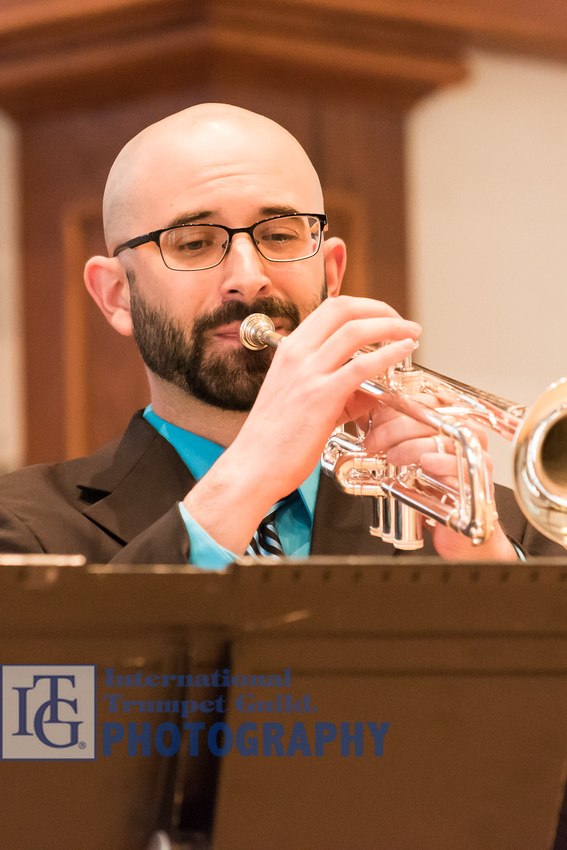 170602-0001-48Steve Siegel
170602-0001-48Steve Siegel
ITG Jazz Competition Finals
The ITG Jazz Improvisation Competition Finals featured performances from three outstanding young jazz trumpeters, accompanied by the Conference Jazz Trio (Tom Lawton, Peter Paulsen, and Christopher Lanning). Each competitor performed Anthropology, St. James Infirmary, and a composition of his choice. The first performer was Cody Rowlands from New School for Jazz. Rowlands’ performance was notable for the breadth of styles included. He was able to demonstrate command of both the swing and bebop languages, in addition to outstanding time feel. Much to the delight of all, Jeremy Alvarez, from the Berklee School of Music, filled the space with his brash and brilliant trumpet sound. His arrangements of the required music is to be commended, as it was clear that he put the tunes together not only in a highly musical manner, but also in a way that showcased his strengths as a player. The final performer was Tony Glausi from the University of Oregon. He opened with an unaccompanied chorus before being joined by the rhythm section as he launched into All the Things You Are. Glausi’s playing was wonderfully nuanced while still able to explore the full dynamic and registral range of the trumpet. All three musicians gave outstanding performances and certainly have bright futures as jazz musicians. (JC)
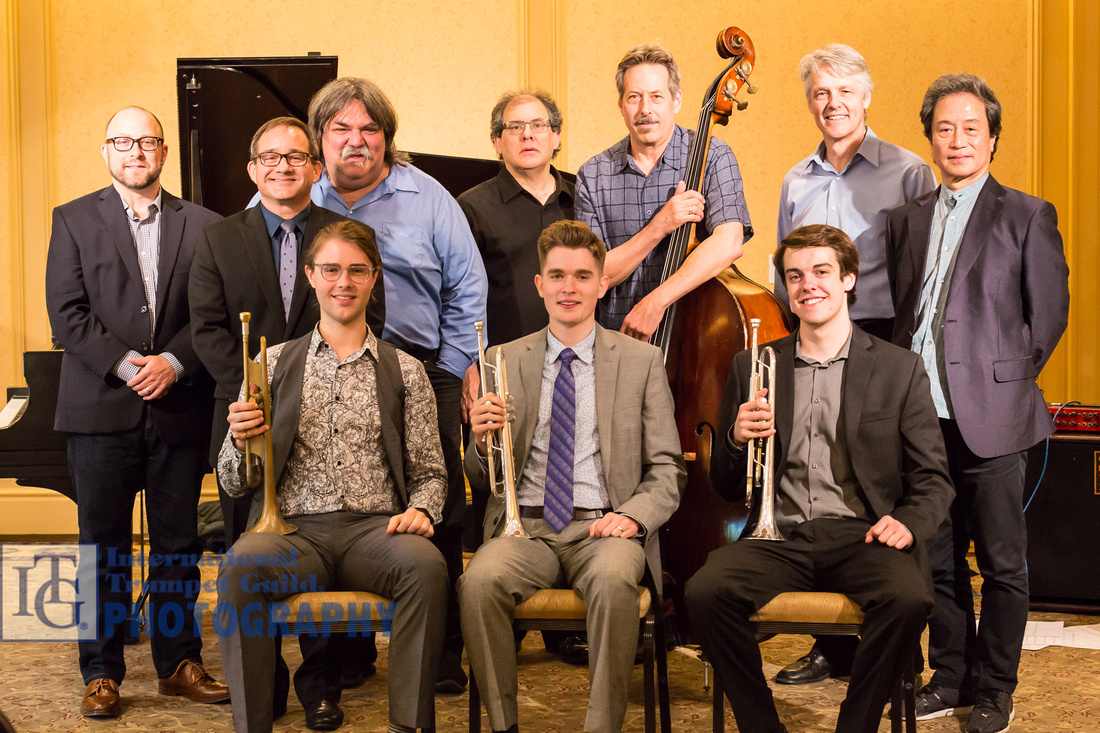 170602-0001-54ITG Jazz Improvisation Competition rhythm section, finalists, and judges
170602-0001-54ITG Jazz Improvisation Competition rhythm section, finalists, and judges
Micah Wilkinson Recital
Miriam Hickman joined Micah Wilkinson, principal trumpet of the San Diego Symphony, for a beautiful recital that opened with Hanson’s Sonata for Cornet and Piano, Op. 18. The Romantic-era sonata made for a warm opening and set a great tone for the French contest piece that followed. Wilkinson continued with Gaubert’s Cantabile et Scherzetto, which showcased Wilkinson’s technical finesse. Thanking his mentor for guidance while navigating equipment for the previous pieces, Wilkinson explained that Hickman’s pedagogy is ever evolving. Canzonetta for Oboe and Piano, Op. 48, the last piece that Samuel Barber ever wrote, was a beautiful transcription performed on C trumpet. Wilkinson concluded the recital with two standards in the trumpet repertoire, Enesco’s Légende and Neruda’s Concerto in E-flat, ably highlighting multiple facets of his outstanding playing. (WK)
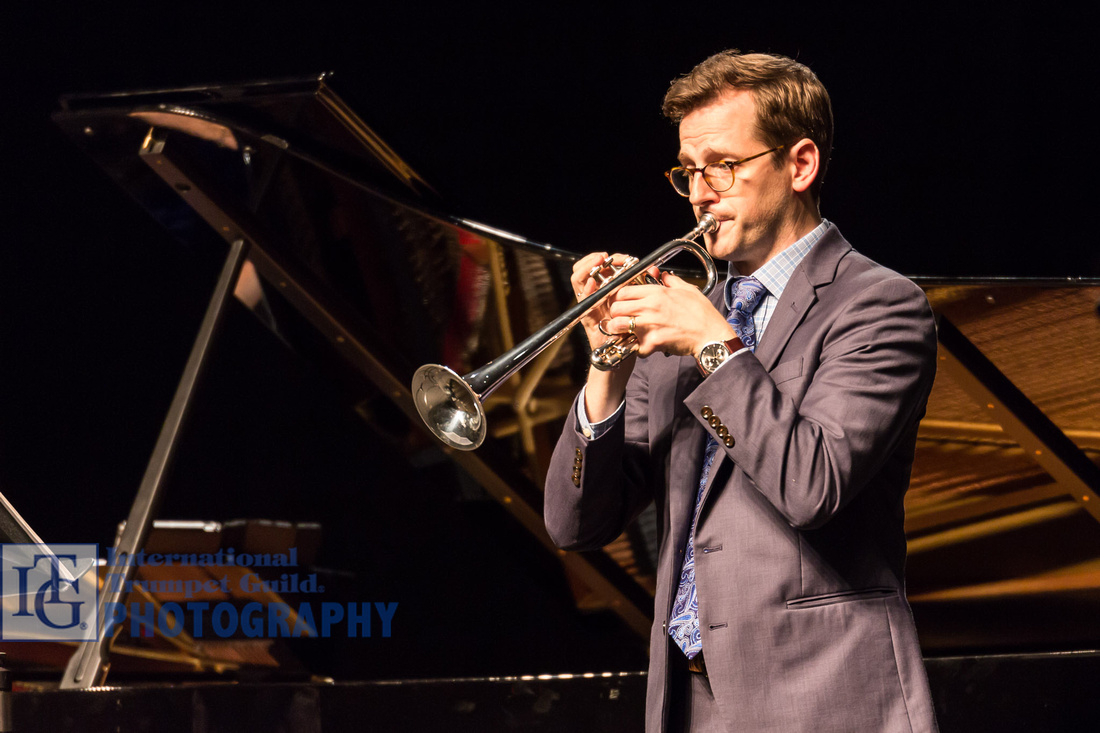 170602-0001-55Micah Wilkinson
170602-0001-55Micah Wilkinson
Student Meet and Greet
The 2017 ITG Student Meet and Greet was held Friday night in the Chocolate Ballroom. Over 160 students attended to meet new friends, eat free food, and get many prizes donated by our sponsors. Grant and Marcia Manhart and Fred Powell of Powell Trumpets were the sponsors. Roger Ingram, Past President Alan Siebert, President Brian Evans, and conference host JC Dobrzelewski dropped by to spend time with the students as well. Plans for the Student Meet and Greet in San Antonio are already in the making!
The sponsors included generous donations of musical gifts by:
A Minor Tune-Up
Art of Sound Music
Brass Herald
Chase Sanborn
Chopsaver
Eastman/Shires
Hickeys
Hot Chops
Husonics
Kanstul
Michael Thomas Music
Pickett Music
Powell Trumpets
Qpress Music Publshing
Quintessential Brass
Reynolds Lip Renew and Lip Repair
Royalton Music
Taylor Trumpets
Triplo Press
US Marines
Vincent Bach/Conn-Selmer Corporation
Click here for more photos from the ITG Conference
]]>
Special Daily Report • Compiled by Peter Wood
Photos by Michael Anderson, Norman Bergstrom, Del Lyren, and John Tamer
Thursday, June 1 - Evening events
Click here for more photos from the ITG Conference
Evening Jazz Concert - Terrell Stafford and the Jazz Orchestra of Philadelphia
This exciting big band, comprised of some of Philadelphia’s and New Jersey’s finest jazz professionals, launched the concert under Terell Stafford’s leadership with a fiercely played rendition of McCoy Tyner’s Passion Dance. From the get-go, the band’s rhythm section, led by drummer Steve Fidyk, set fire to this burner, featuring an outstanding, head-turning soprano saxophone solo by Jim Oatts and sky-high lead trumpeting from Nick Marchione. It was apparent early-on that this was going to an energized and swinging concert, and the remainder of the program certainly did not disappoint.
Straight Street followed, featuring a guitar solo and swinging sax section soli, spearheaded by lead alto player Jim Oatts. Following a neat piano intro by Joshua Richman, Stafford played a gorgeous flugelhorn ballad, Blame It on My Youth. The piece also highlighted a solo from tenor saxophonist Chris Farr. Stafford’s flugelhorn playing was luscious and tasteful. Stafford introduced the next selection, Candy, as a tribute to Philadelphia native, trumpet great Lee Morgan. The standard, which Morgan recorded during his hey-day, was covered in an up-tempo style in which Terell’s solo flights brilliantly displayed his upper-register pyrotechnics and improvised ribbons played at blazing speed. Over multiple solo choruses, Stafford’s swinging style had the audience highly engaged, inspired, and definitely amazed. The 1960s Linda Scott hit (written years earlier by Jerome Kern and Oscar Hammerstein II) I Told Every Little Star was delivered in a novel Mambo style by arranger Michael Mossman and featured a cool call-and-response segment between the ensemble and the tenor saxophone. Alto saxophonist Chris Oatts delivered a tasty solo, and the ensemble pulsed its way through the ending chorus.
Stafford assumed the soloist role again on Blues on the Corner. Here and elsewhere throughout the evening, Stafford’s playing was pure, unadulterated energy and intensity. His gorgeous flugelhorn tone was mesmerizing. The Great American Standard My Shining Hour was a fast-tempo swinger in which tenor saxophone and trumpet responded to each other. Trumpeter Marchione’s spirited lead playing and ensemble drive via drummer Steve Fidyk helped command the ensemble throughout the tune. Manteca, the Afro-Cuban bebop classic from Dizzy Gillespie and Chano Pozo, was rendered in its original style with Marchione assuming the Gillespie spotlight. Alto saxophonist Dick Oatts added a superb and intense solo. The piece ended the band’s stellar performance for the evening, and the audience left enthralled. (NM)
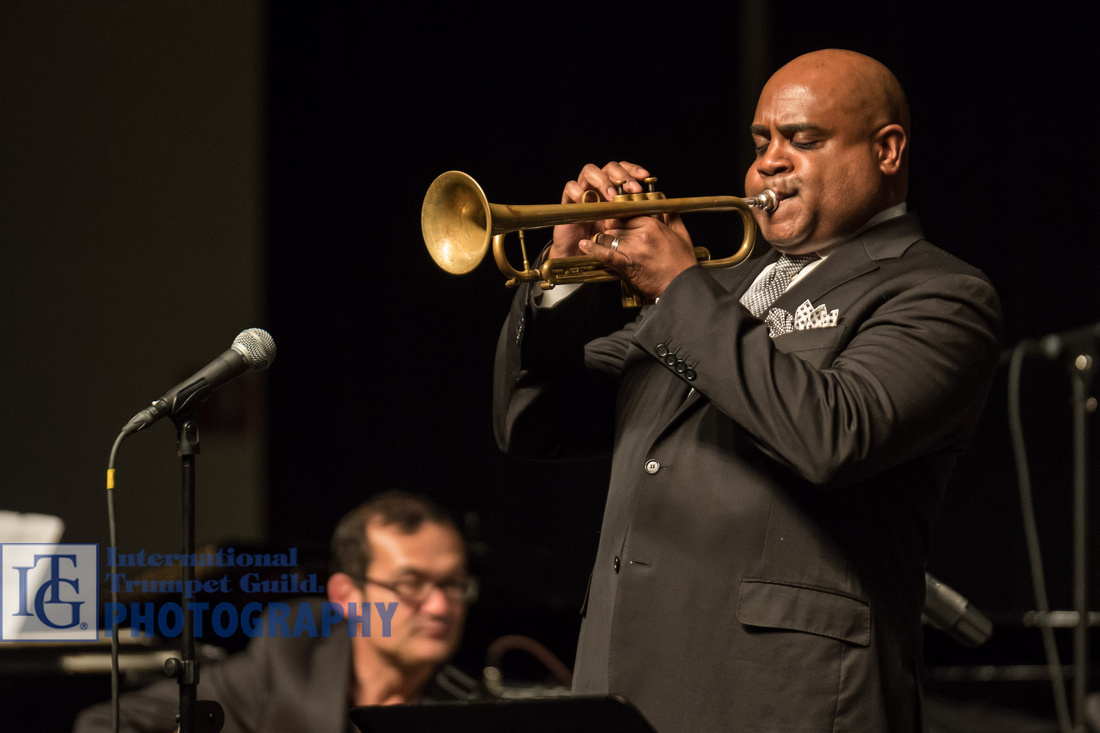 170601-0001-23Terell Stafford
170601-0001-23Terell Stafford
 170601-0001-23Terell Stafford and the Jazz Orchestra of Phliadelphia
170601-0001-23Terell Stafford and the Jazz Orchestra of Phliadelphia
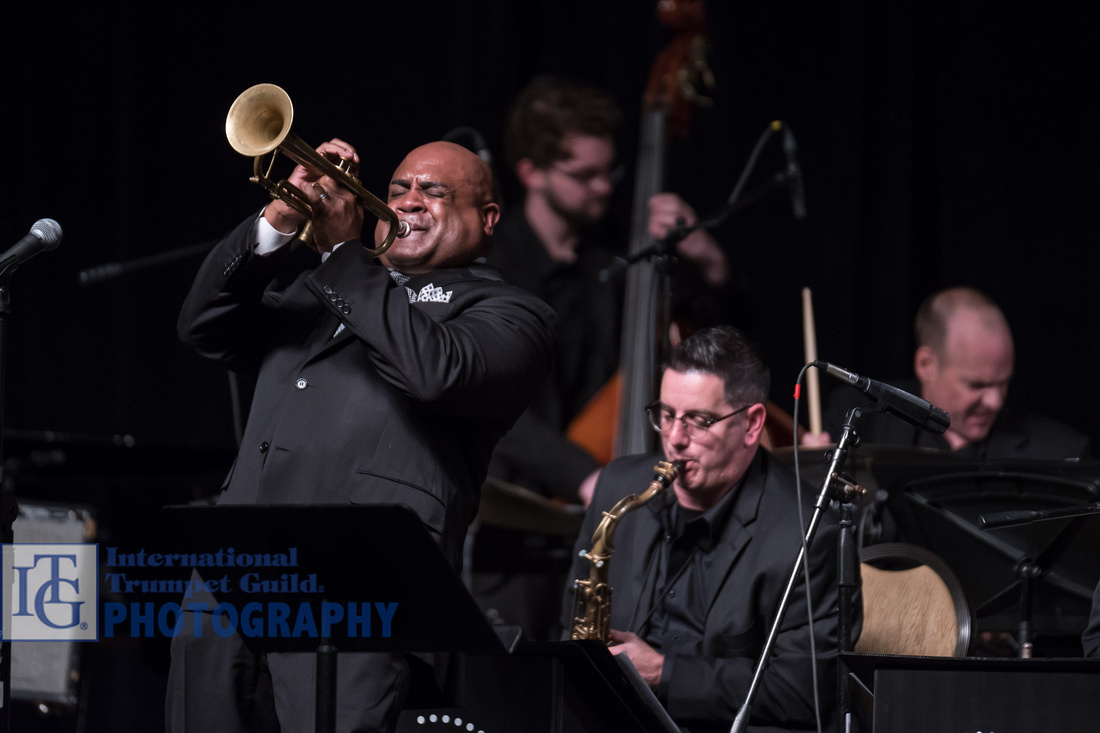 170601-0001-23Terell Stafford
170601-0001-23Terell Stafford
Jazz Concert - Andrea Motis
Andrea Motis, the sensational young jazz artist from Barcelona, Spain, captivated Thursday night’s audience with her spectacular performance. Her set included marvelous arrangements of such classic standards as Lazy River and Honeysuckle Rose, as well as original compositions from her newly released solo album, Emotional Dance. Although she only sang three of the songs, Motis is a phenomenal jazz singer, and her vocals make an excellent complement to her trumpet playing. Her warm, velvety tone is reminiscent of Chet Baker, only with more ease and facility on the instrument. She takes a singing approach to her improvisation that is a tasteful use of classic language with a fresh twist. Supported by a strong performance from the conference rhythm section trio of Tom Lawton, Peter Paulsen, and Chris Hanning, she provided a special treat to all in attendance. (NV)
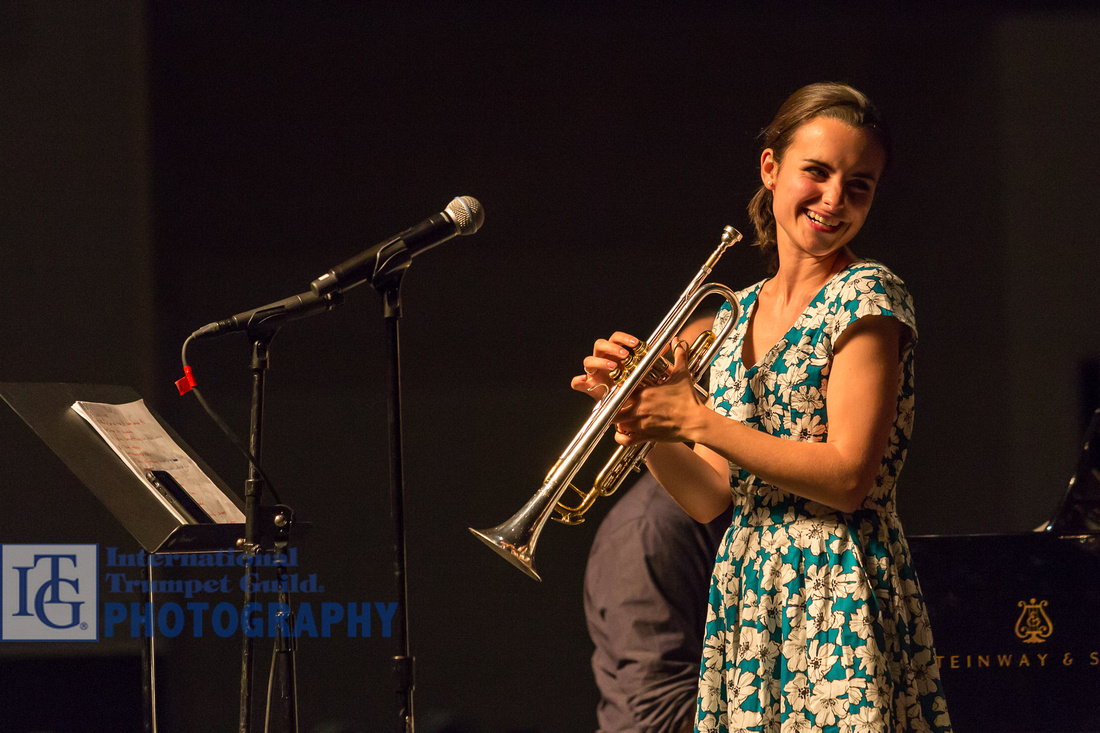 170601-0001-28Andrea Motis
170601-0001-28Andrea Motis
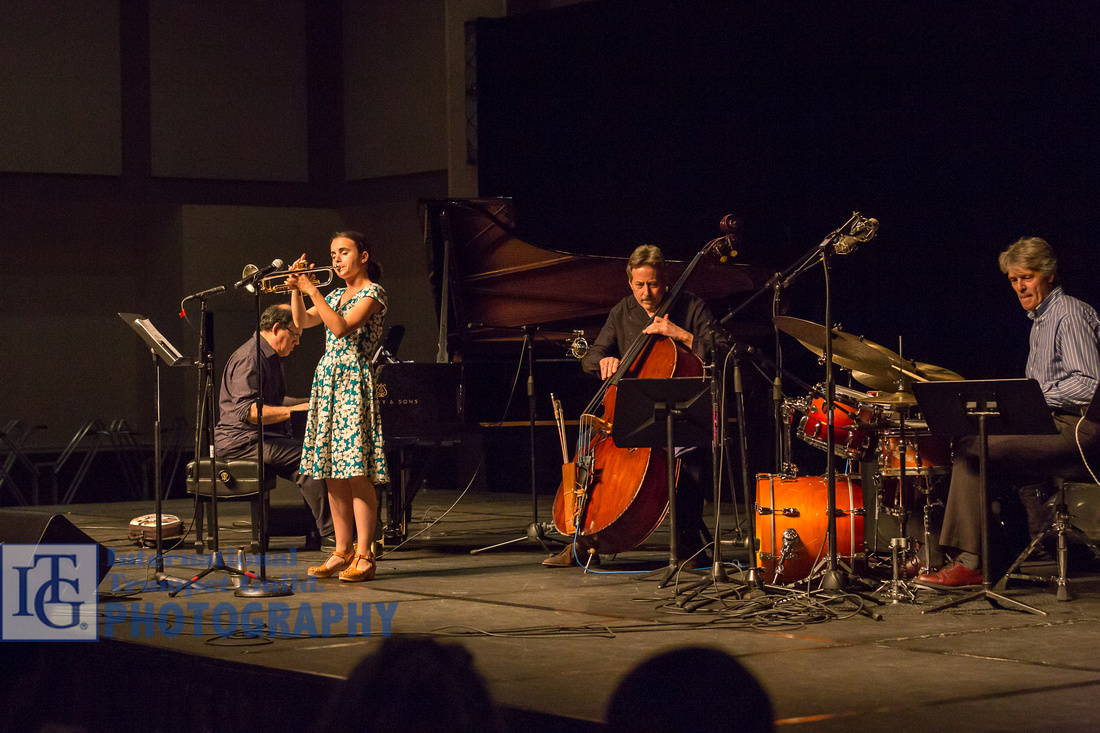 170601-0001-28Andrea Motis
170601-0001-28Andrea Motis
Click here for more photos from the ITG Conference
]]>
Special Daily Report • Compiled by Peter Wood
Photos by Michael Anderson, Norman Bergstrom, Del Lyren, and John Tamer
Thursday, June 1 - Daytime events
Thursday's clinics and concerts featured a terrific array of performances in many different styles and genres, delivered by a truly international collection of artists. Audiences were again exposed to faces old and new, providing untold inspiration to all in attendance.
Click here for more photos from the ITG Conference
Marco Braito Warm-Up Session
Marco Braito’s warm-up session was taught primarily through a call-and-response method between Braito and the audience. Featuring dynamic stretches, numerous breathing exercises, singing, mouthpiece buzzing, and performance on the trumpet, Braito placed a large emphasis on always performing in a singing style in order to play with one’s best sound. All breathing exercises involved inhaling without equipment. Exhalations were done with no equipment, through the mouthpiece, through the trumpet without a mouthpiece, and through the trumpet fully assembled. This approach allowed performers to become acclimated to the resistance of the equipment without adding tension to the rest of their bodies. Before beginning mouthpiece buzzing or long-tone exercises, Braito sang each phrase. This method reminded the audience of the singing style which led to softer volumes, beautiful sounds, and less tension overall. While a majority of the class was taught by modelling, one message stated repeatedly throughout the session was “always sing!” (SS)
Daniel Thrower Warm-Up Session - Warming Up for the Athletic Event of Trumpet Playing
Staff Sergeant Daniel Thrower of the US Air Force broke down the physical components of trumpet playing into four categories: air (aided by a relaxed glottis), embouchure, fingers (especially the weak third finger), and tongue. In a typical warm-up session lasting anywhere from five to fifteen minutes, he said that it is important to address each aspect. Using a running analogy, Thrower explained the primary functions of a warmup - to prepare the body for physical demands, to loosen muscles and increase blood flow, and to prevent injury and unnecessary fatigue. In fact, he stressed that the warmup should never reach the point of fatigue; this is what distinguishes it from a practice session. The warmup also serves a diagnostic function: things that are not going well become the focus of that day’s practice. As with running, the key to successful trumpet playing is relaxation; the only activated muscles are those involved in playing. (MM)
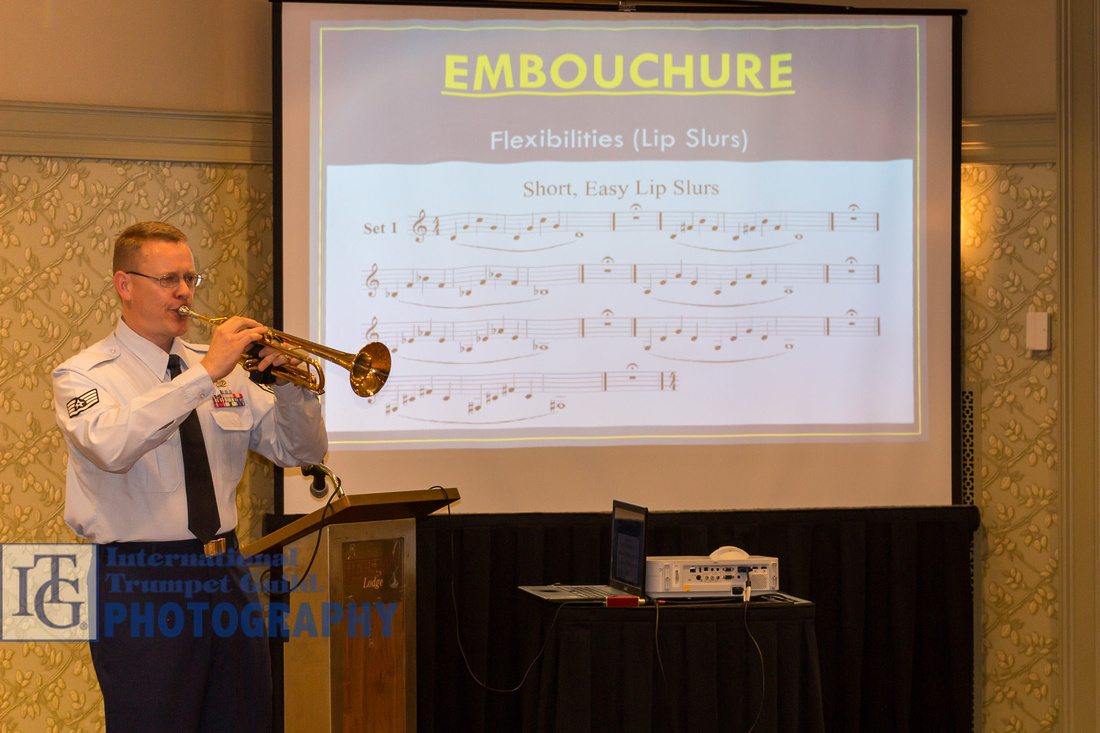 170601-0001Daniel Thrower
170601-0001Daniel Thrower
Brian Walker Presentation - Technology in the Trumpet Studio: New Devices for Teachers and Players Alike
Brian Walker presented an engaging clinic that highlighted new technological resources for professors, performers, and students. He opened by discussing Yamaha’s Harmony Director HD-200, which offers multiple systems of tuning, including equal temperament, just intonation, and drones. Since the speaker on this device is small, he suggested the purchase of a portable keyboard amplifier like the Roland KC-60/KC-150. Walker also discussed the need for good audio and video recorders. He considered the advantages and disadvantages of the Zoom iQ7, which plugs into an iPhone; the GoPro Hero5 Black; and the Zoom Q4n and Zoom Q8. Walker then highlighted the ease of storing and reading music on a tablet. He uses the iPad Pro but also considered products by Samsung, Google, and Asus. After showcasing different foot pedals, Walker demonstrated the potential of such apps as forScore, Tonal Energy tuner, TimeGuru metronome, Drum School, Dropbox, and Scanner Pro. The highly informative session concluded with a question-and-answer session that clearly highlighted why Walker is a leading authority in this field. (RG)
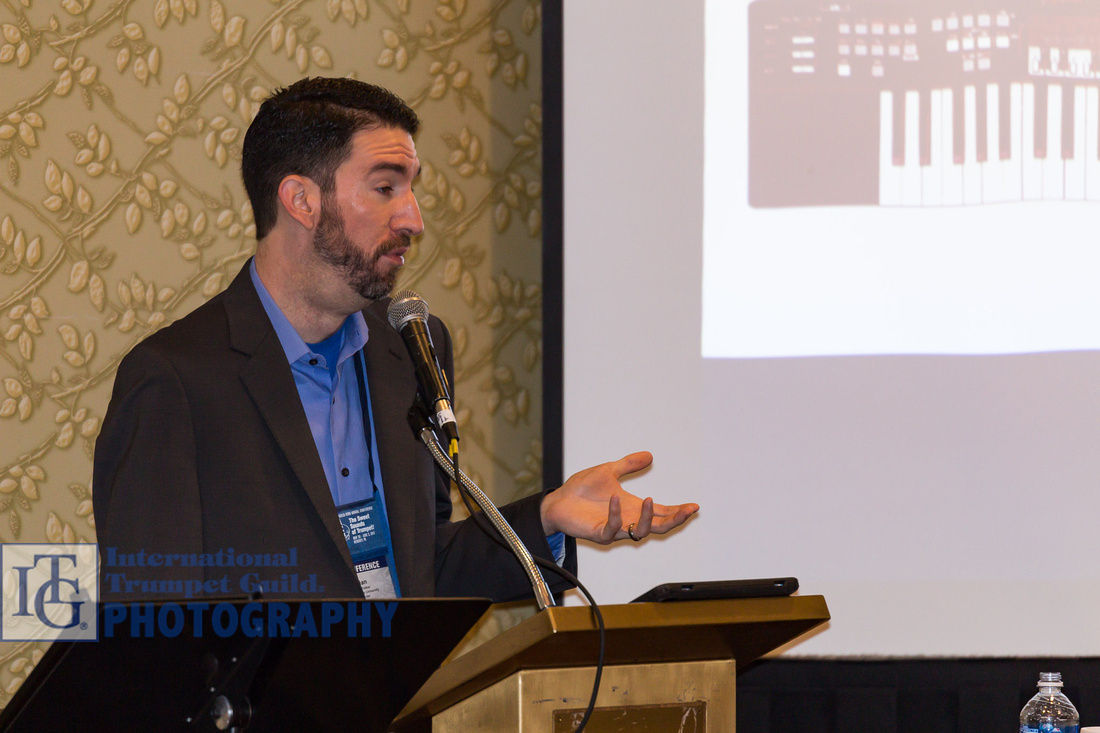 170601-0001-2Brian Walker
170601-0001-2Brian Walker
Chase Sanborn Non-Pro Clinic - How to Sustain Level on Limited Practice
The Empire Ballroom was the venue for Chase Sanborn’s presentation, also called “Circuit Training for Brass Players.” While aimed at non-professional players, the concepts presented by Sanborn were applicable to trumpeters of all backgrounds and levels. By dividing a typical warm-up/practice routine into focused five- to six-minute segments, he is able to address a myriad of specific technical, musical, and time-management challenges on a daily basis. Sanborn demonstrated his warm-up routine in real time, utilizing built-in rest periods to explain a conceptual basis for each exercise. This session was well constructed for non-pro players who often struggle to find time to maintain their trumpet playing. By regularly utilizing Sanborn’s concepts, players will be able to increase significantly the efficiency of their practice time. (JC)
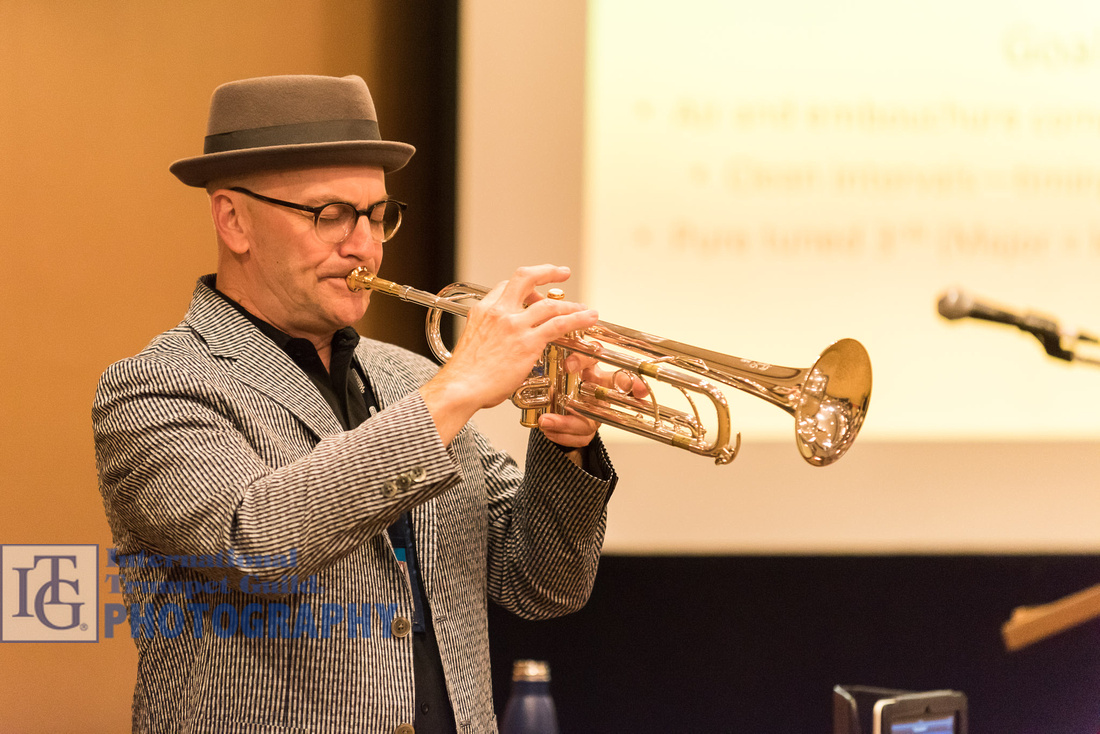 170601-0001-3Chase Sanborn
170601-0001-3Chase Sanborn
Alexis Morales Barrientos Recital - Costa Rican Music for Trumpet and Piano
Professor of trumpet at the University of Costa Rica, Alexis Morales Barrientos is also co-founder of the Yamaha Brass Academy for Latin America. His recital opened with Vinicio Meza’s Portrait. After a cadenza reminiscent of a traditional bullfight fanfare, ethereal-sounding piano chords set the tone for the lyrical melodies that followed. Parlor-like melodies and harmonies were featured in the second movement; floating and tearful melodies over lush harmonies in the ballad third; and bluesy, mysterious, and playful tunes in the finale. Allen Torres’s fast-paced Costa Rican Potpourri followed. Marvin Camacho is among the most prominent Costa Rican composers, and his 2012 Sonata for Trumpet and Piano is a notable contribution to the repertoire. Quartal harmonies alternate with sections featuring more South American flair. The well-crafted collaborative piano parts were beautifully rendered by Miriam Hickman throughout. Daniel Garrigues’s Reminiscencias featured the duo with magnificent ensemble and accord. Jorge Alvarado Bravos’s arrangement of Three Costa Rican Pieces for Trumpet and Piano include traditional melodies from the north, as well as virtuoso articulation, a waltz, and a calypso-inspired movement. Barrientos’ lyricism was particularly engaging here. This was an outstanding performance showcasing the rich, yet little-known, solo trumpet repertoire from Costa Rica. (LE)
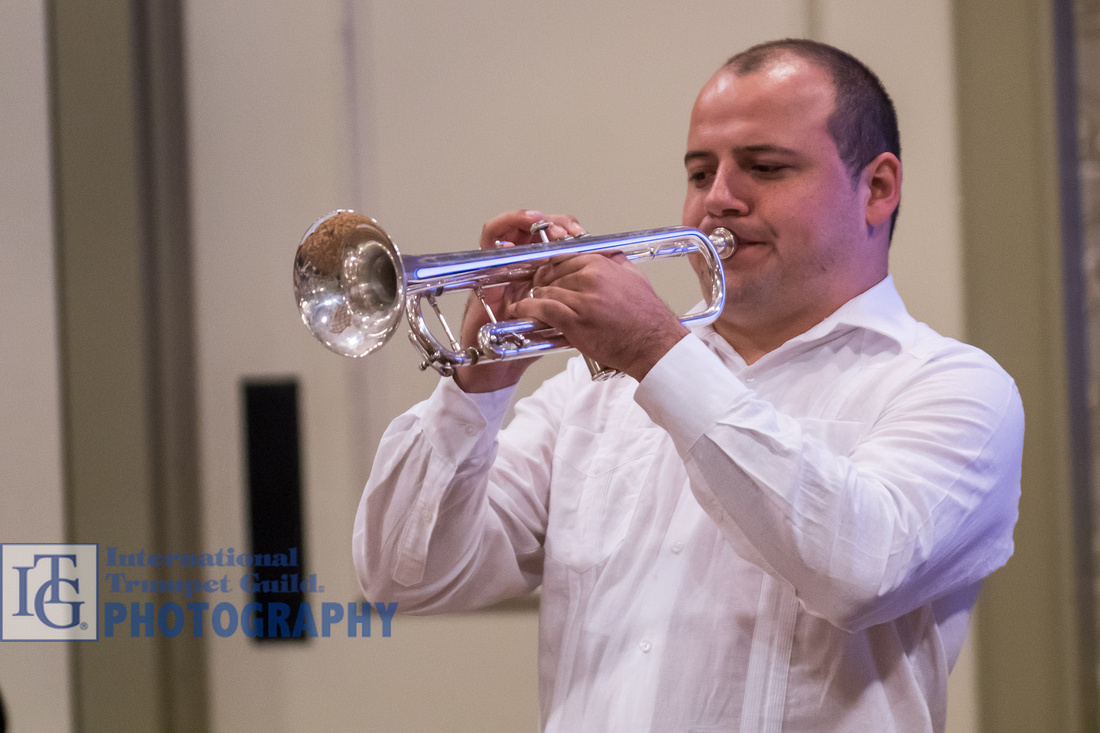 170601-0001-5Alexis Morales Barrientos
170601-0001-5Alexis Morales Barrientos
Benjamin Fairfield Presentation - From the Practice Room to the Concert Hall: The Importance of Deliberate Practice in Trumpet Performance
Today’s clinic by Dr. Benjamin Fairfield provided both an engaging and entertaining approach to gaining the most out of each practice session. Fairfield provided specific goals in both structure and organization that a performer should evaluate during each practice session. Key elements in this approach focused on pinpointing an achievable goal for each practice session, practicing elements that take the performer outside of their “comfort zone,” and always finding ways to identify experts in our field so we may assess our progress through their guidance or performance standards. Fairfield provided extensive references in current scholarship, particularly those by Dr. Peak Ericsson on how the human body can cultivate learned skills through deliberate practice. (JS)
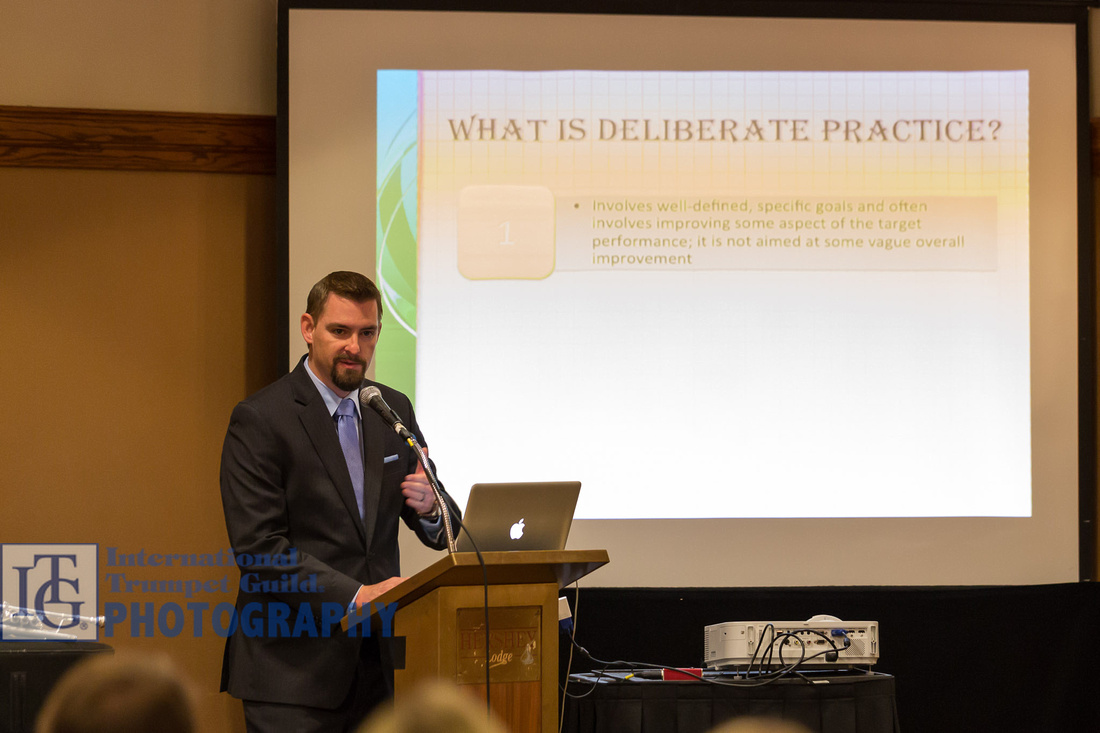 170601-0001-4Benjamin Fairfield
170601-0001-4Benjamin Fairfield
Phil Snedecor Recital - Trumpet with Organ: Innovative Programming with Endless Possibilities
Phil Snedecor opened his recital by sharing his brilliant piccolo trumpet playing on selections from Corelli’s Concerto Grosso (Christmas Concerto), Op. 6. Snedecor stated that his goal was to “take the familiar in a new direction,” so he continued with “The Swan” from Camille Saint-Saëns’ Carnival of the Animals. Snedecor was joined by cellist Erin Snedecor for a refreshing trio setting of “A Simple Song” from Bernstein’s Mass. Showcasing the various color possibilities that the duo had to offer, Snedecor and organist Paul Skevington continued with Variations on a Hymn. Insisting that performance must be “more than just the notes,” he continued with Blumine by Gustav Mahler. Written for his daughter, Air for Erin made for a very peaceful addition to the program. The program concluded with Dan Locklair’s Phoenix. This uplifting work uses E-flat trumpet throughout and created an appropriately majestic ending for the recital. (WK)
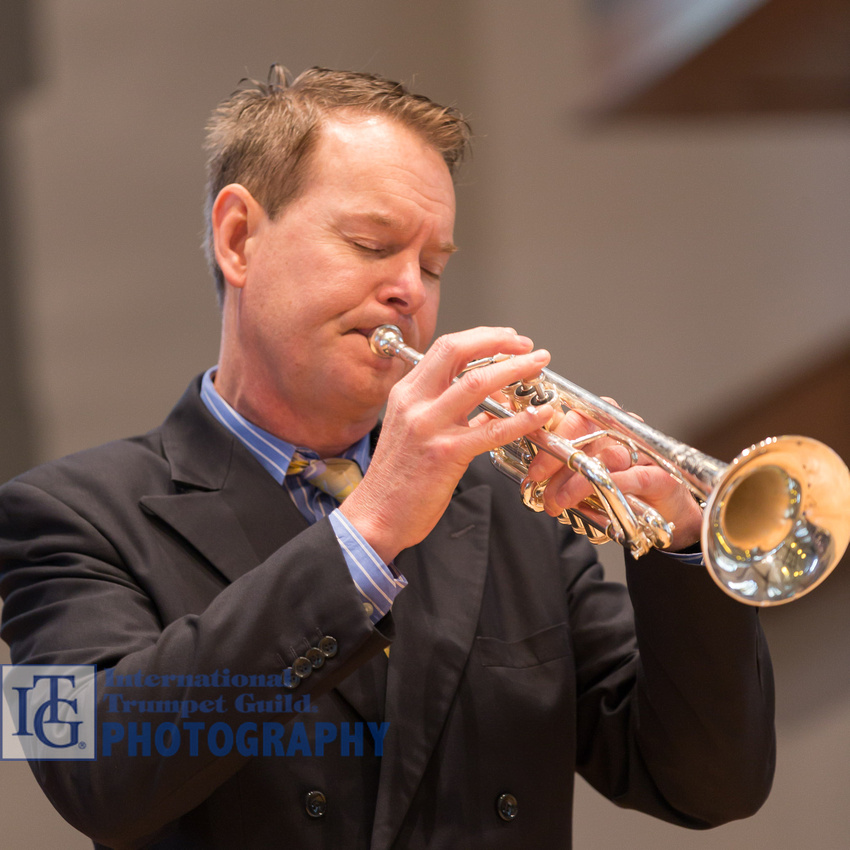 170601-0001-6Phil Snedecor
170601-0001-6Phil Snedecor
John Marchiando Clinic - Why We Still Practice Orchestral Excerpts
Dr. John Marchiando and five of his students from the University of New Mexico took the stage to talk about (and demonstrate) the benefits of practicing orchestral excerpts. While Marchiando acknowledged that not every trumpet player ultimately wants to play in an orchestra, he presented a strong argument for the pedagogical benefits of practicing orchestral excerpts for all trumpet players, no matter where their goals lie. Marchiando emphasized that a trumpet player, through the study of orchestral excerpts, can learn basic overall sound and sustain, singing style, volume control, articulation, musical style, and national differences. The audience enjoyed numerous performances of well-known orchestral passages, which Marchiando used to exemplify these major benefits. He emphasized that practicing excerpts is not just about playing correctly, but about knowing how the particular passages are supposed to be expressed and the context in which one plays. (BB)
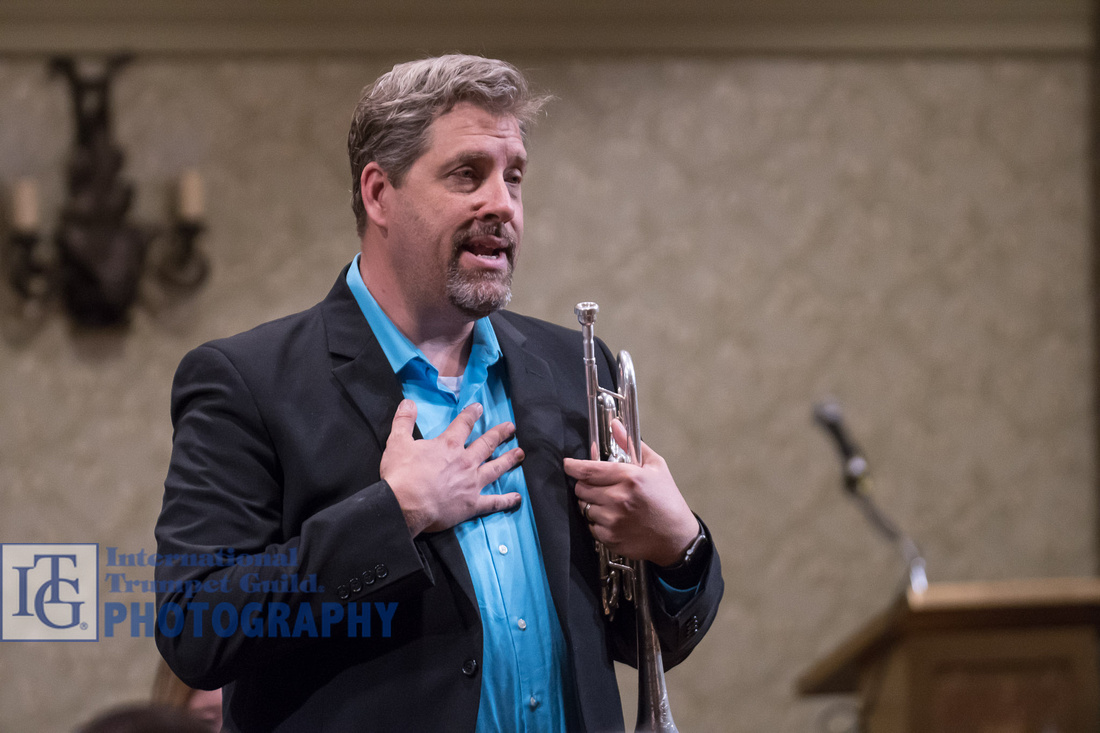 170601-0001-9John Marchiando
170601-0001-9John Marchiando
Bijon Watson Clinic - Taking the Lead: In Big Band and Beyond
Bijon Watson’s clinic focused on the skills necessary to perform successfully as a lead trumpeter. After a brief discussion of his background, Watson began a fascinating and informative talk on lead playing. His first topic related to defining the role of a lead player within a section. By encouraging all section players to “think like a lead player” and all lead players to develop consistency, Watson was effectively able to establish priorities for successful ensemble playing. Additional conversations regarding the importance of phrasing and style over simple high range were of great value. Watson spoke about a few topics related to trumpet playing in general before spending the rest of the session answering questions from the audience. His insight into trumpet playing and performance was highly informative to all in attendance. (JC)
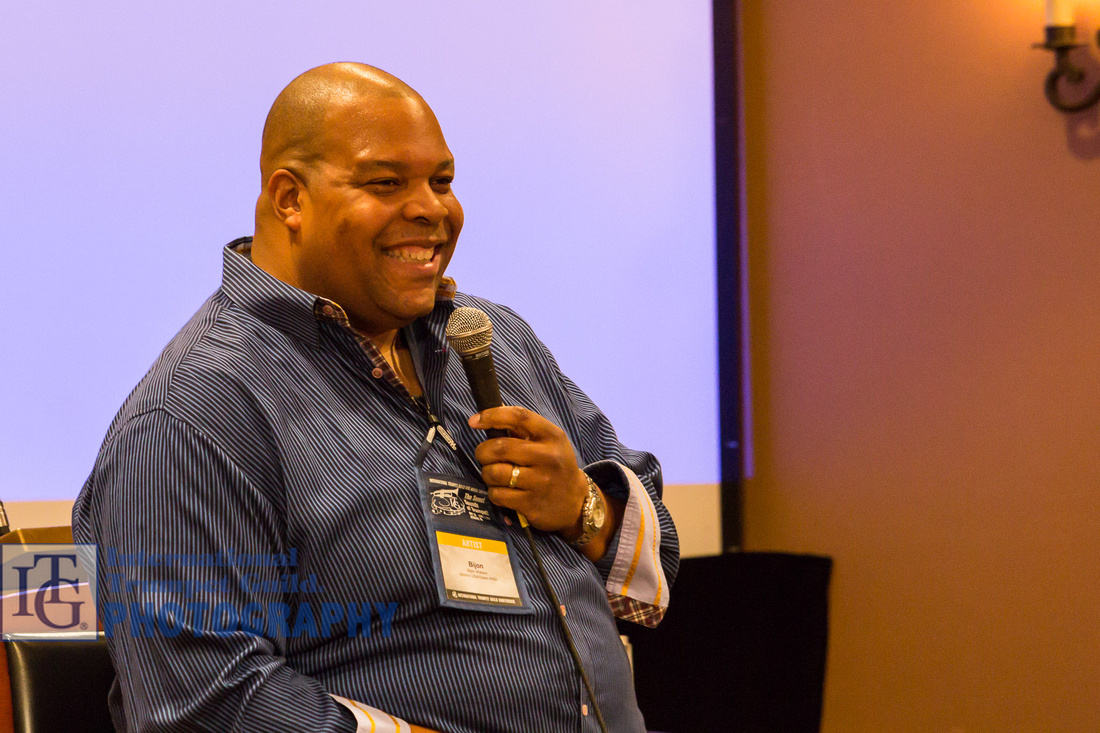 170601-0001-10Bijon Watson
170601-0001-10Bijon Watson
Reveille Trumpet Collective Lecture Recital - Performer as Curator: Presenting to Audiences in the 21st Century
The Reveille Trumpet Collective, consisting of Joel Brennan, Aaron Hodgson, and Timothy Quinlan, presented a lecture-recital that began with a performance of Harry Sdraulig’s Fanfare for 8 Trumpets, conducted by Quinlan. Brennan and Hodgson were joined by their teachers (Allan Dean and Roy Poper) and colleagues (Mary Bowden, Michael Brest, Guilian Favrin, and Alan Klaus) for the performance. The group then suggested “Five Rules for Presenting New Music,” illustrated with video examples and live performances - 1) Everybody loves a good story; 2) Know your audience; 3) Bridge the gap; 4) Play well with others; and 5) Leave room for opinions. Aaron Hodgson’s compelling performances of Aiden Hartery’s The First Recitation: The Old Hag and Patrick McGraw’s A Force of Nature for trumpet, electronics, and video were notable highlights. The works are available on Quinlan’s digital sheet music site (http://qpress.ca). (EK)
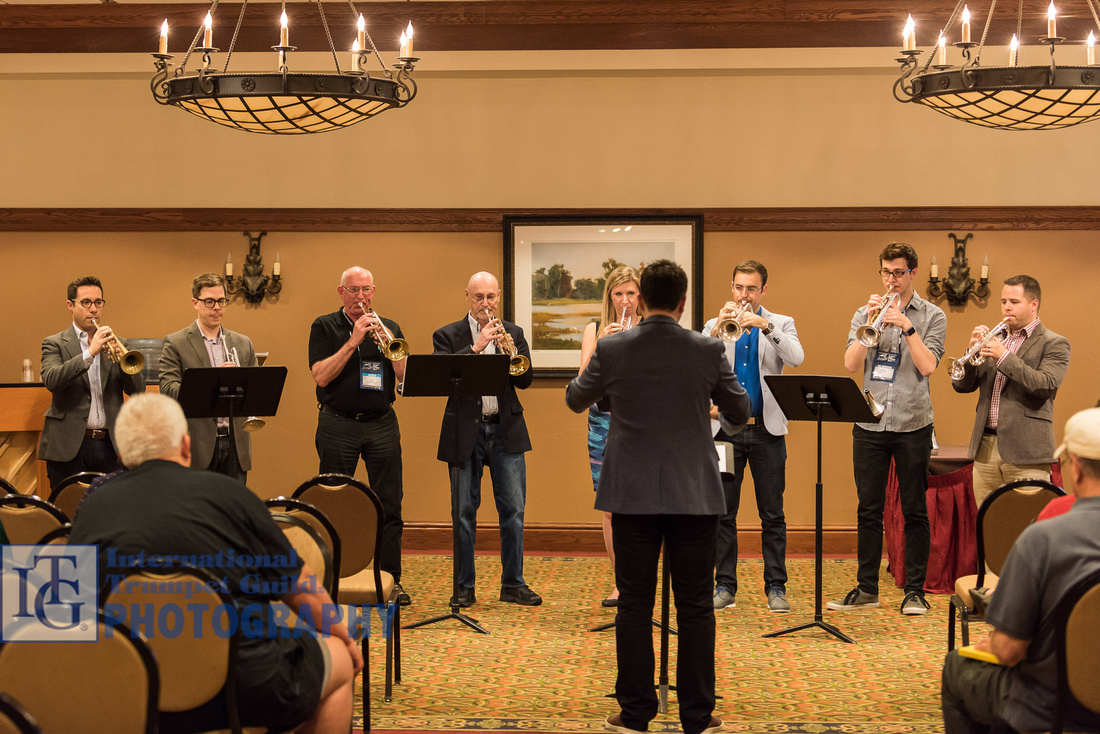 170601-0001-12Reveille Trumpet Collective
170601-0001-12Reveille Trumpet Collective
ITG Affiliate Chapters Showcase Recital
The Affiliate Chapters Showcase Recital was held at the First United Methodist Church and featured a wide variety of chapters from the United States and beyond. Chapters featured on the recital included the Alabama, Australia, Brazil, Cincinnati, Louisville, Smokey Mountain, and Texas A&M University-Kingsville trumpet guilds. Tina Erickson shared at the beginning of the event that this was the first time that there has been an affiliate chapter recital at the ITG conference. What made the event particularly unique was the cool blend of student players and seasoned professionals performing together, as well as the vast array of musical styles represented. Featured on the program were compositions by Robert Bradshaw, Tobin Stokes, José Uriciscino Duda da Silva, Frederick Speck, and Bobby Collins, as well as arrangements by Scott Belck and Martin Hebel. The recital was a wonderfully casual and friendly atmosphere and was enjoyed by all in attendance. (RW)
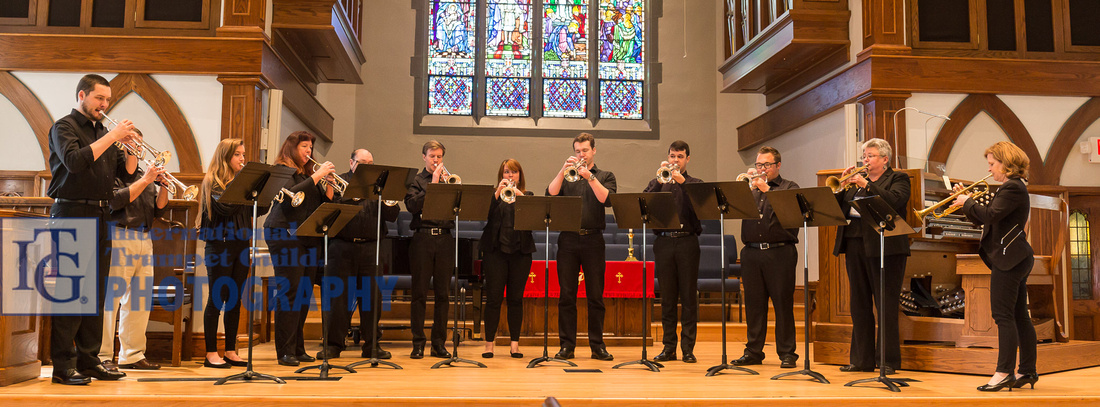 170601-0001-15Smokey Mountain ITG Affiliate Chapter
170601-0001-15Smokey Mountain ITG Affiliate Chapter
Olivier Anthony Theurillat Recital - Swiss Music for Trumpet and Piano
Olivier Anthony Theurillat presented an outstanding recital with Rebecca Wilt (piano) Thursday afternoon, a program comprised exclusively of music by Swiss composers. Opening with Ernest Bloch’s Proclamation, Theurillat demonstrated his ability to play with clarity of sound, color, and technique, which continued throughout the recital. Highlights were Cyril James Squire’s 1985 Aubade, a small piece written for trumpet and bells, but performed with piano, and Arthur Honegger’s 3 Poems, written originally for piano and voice. Theurillat demonstrated a remarkable ability to play lightly and expressively, perfectly imitating the voice. These works contrasted well with Daniel Schnyder’s Concerto, in which Theurillat’s versatility as an artist was heard in the execution of long, difficult passages that were heavily influenced by jazz. Theurillat highlighted his firm command of all registers of the trumpet and the ability to adapt his tone to fit the character of each piece. The recital closed with a short, beautiful, jazz waltz by Thierry Lang, in which Theurillat once again showed his ability to perform in all styles with beautiful tone and musicianship. (SW)
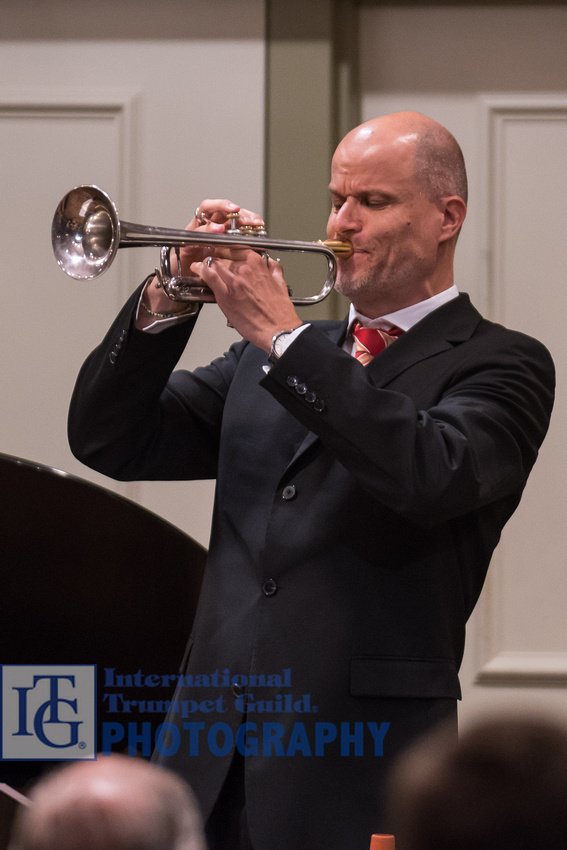 170601-0001-14Olivier Anthony Theurillat
170601-0001-14Olivier Anthony Theurillat
ITG Solo Competition Finals
The finals of this year’s ITG Solo Competition saw a very high level of performance. The three finalists, accompanied by Miriam Hickman, performed Brendan Collins’s Concert Gallop, along with a multi-movement work of their choice. Daniel Haddock, from Florida State University, brought a characteristically dark Russian sound to Peskin’s Trumpet Concerto. He demonstrated both technical agility and lyrical sensitivity in the cup-muted section. Miguel Pais, from Portugal’s Universidade de Aveiro, followed with a musically mature performance of Neruda’s Trumpet Concerto. Pais delivered clean articulations and huge dynamic contrast, from true pianos to full, tasteful fortes in the cadenza. Bryan Powell, from Bowling Green State University, closed the competition with a challenging contemporary piece, Fisher Tull’s Sonata for Trumpet and Piano, which was commissioned by the ITG and premiered at the London conference in 1986. Powell played with precision and a huge sound and showed off his high range. The talent in today’s competition was on full display. (MM)
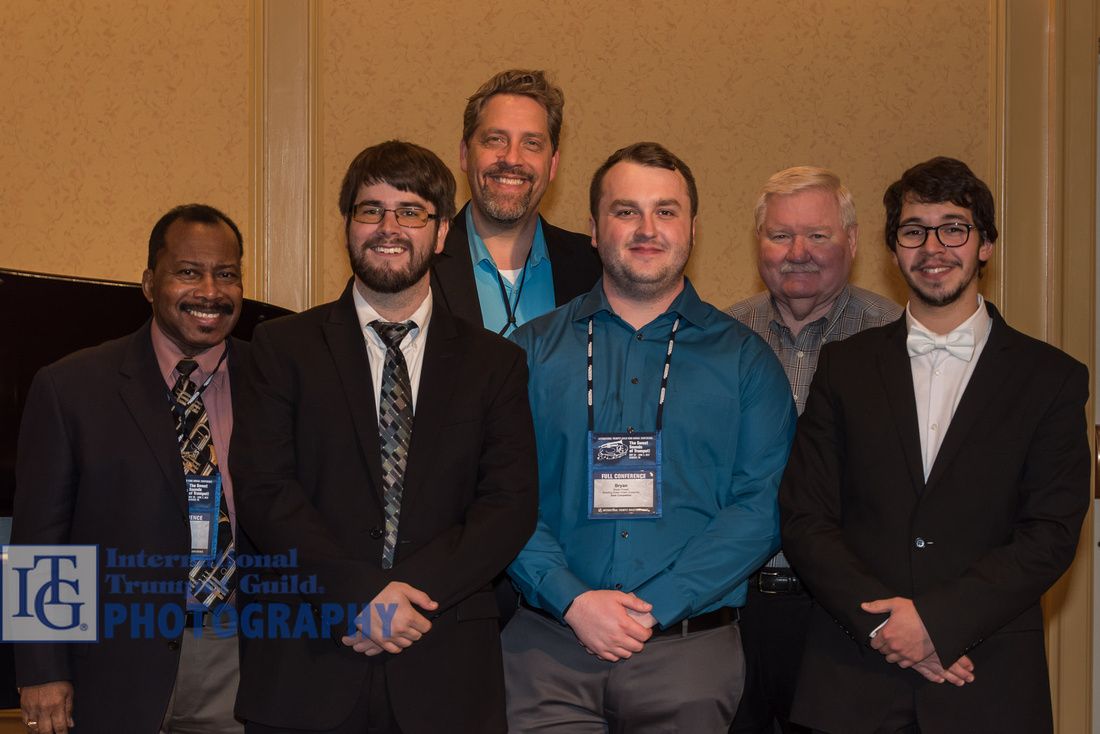 170601-0001-21ITG Solo Competition finalists and judges
170601-0001-21ITG Solo Competition finalists and judges
Marco Pierobon and Marco Braito Recital
Undoubtedly, a large number of those in attendance for the Marco Pierobon and Marco Braito recital had heard Gomalan Brass the evening before. If Gomalan were considered the Italian version of Canadian Brass, then Pierobon’s fiery and flashy approach to the trumpet would be the equivalent of Ronald Romm’s, while Braito’s compact, focused sound and delicate articulation would be comparable to that of Fred Mills. Just as Romm and Mills complemented each other so well, so too did Pierobon and Braito. Beautiful tone quality, impeccable intonation and lovely musical phrasing were hallmarks of this recital. The program of works by mostly Italian composers, accompanied by pianist Rebecca Wilt, began and ended with duets. In between, both Pierobon and Braito performed solo works. While many of the pieces were operatic in nature, compositions in more contemporary styles were also featured. Highlights included Pierobon’s performance of Giancarlo Aquilanti’s Sonata for Trumpet and Piano. This work, originally for solo trumpet and wind band, was in the jazz idiom, with amazingly acrobatic solo lines that sounded improvised, but, in fact, were all notated! Braito performed Corrado Maria Saglietti’s Concertino for Trumpet and Piano, reminiscent of a “kinder, gentler” cousin of the Halsey Stevens Sonata. Let’s hope that these musicians continue to be featured at future conferences! (KE)
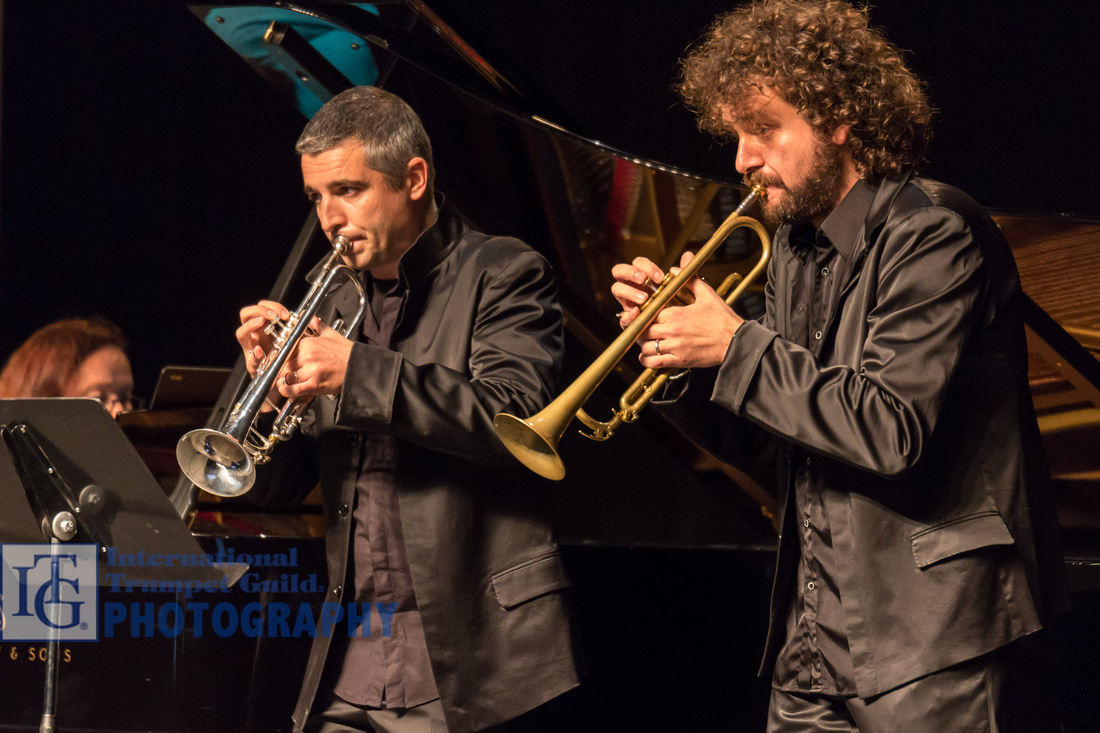 170601-0001-18L-R: Rebecca Wilt, Marco Braito, Marco Pierobon
170601-0001-18L-R: Rebecca Wilt, Marco Braito, Marco Pierobon
Click here for more photos from the ITG Conference
]]>
Special Daily Report • Compiled by Peter Wood
Photos by Michael Anderson, Norman Bergstrom, Del Lyren, Brian Shook, and John Tamer
Wednesday, May 31 - Evening events
Click here for more photos from the ITG Conference
Concert - Gomalan Brass
Performing with theatricality and blazing virtuosity, the Gomalan Brass dazzled the capacity audience in the Great American Red ballroom with a program highlighting music by Italian composers. Comprised of principal players and soloists from major Italian orchestras, Gomalan Brass includes trumpeters Marco Braito and Marco Pierobon, hornist Nilo Caracristi, trombonist Gianluca Scipioni, and tubist Stefano Ammannati. The program opened with an arrangement of a Gabrieli Canzona and quickly moved into operatic repertoire with a colorful rendition of “Nessun dorma” from Puccini’s Turandot, in which the solo line is passed around to each member of the group. To the delight of the audience, the musicians also took turns introducing program selections with humorous anecdotes and good-natured ribbing between the trumpets and the low brass.
The genius of Gomalan Brass was on ample display in Marco Pierobon’s medley of selections from Verdi operas. Including excerpts from La forza del destino, Nabucco, La traviata, Il trovatore, Rigoletto, and Aïda (among others), the performance featured brilliant musicianship and elaborate choreography. At one point, the musicians even burst into song! The Triumphal March from Aïda was a particular highlight, as the two trumpeters abruptly stopped playing, jumped off the stage, and ran to back of the ballroom. What followed was a slow procession up the side aisles of the ballroom as the trumpeters taunted each other to play ever louder while moving through the audience. Their colossal sound at incredible volumes was a wonder to behold. Once back on stage, the trumpeters took turns posing as Roman statues on either side of the stage and processing in front of the low brass.
Music by the eminent Italian film composer Ennio Morricone followed in a medley featuring “Gabriel’s Oboe” from The Mission and several selections from “spaghetti westerns,” including The Good, The Bad, and The Ugly. Once again, brilliant playing and entertaining stage action delighted the audience. Highlights included the trumpeters imitating gunfighters in a duel and a beautiful muted solo by the trombonist, Gianluca Scipioni. Morricone’s haunting theme from Cinema Paradiso was also featured. The next piece was an arrangement of silent film music titled Buster Keaton Blues, which featured a solo from horn player Nilo Caracristi, as well as some surprising Satchmo-like scat singing. The artistry and versatility of Gomalan Brass were amazing, as was their stamina, especially considering the continual passion, power, and control with which they performed. Perhaps the lengthy ovations between selections renewed their energy?
The final piece on the program was an arrangement of themes from a popular Italian television cartoon, Lupin the Third, which included a waltz, a rock-flavored tune, and some dancing. Following a thunderous, prolonged standing ovation, the group signaled that the show was not yet over by leading the audience in fast rhythmic clapping and launching into the theme from Austin Powers. Full of infectious, joyful exuberance – and more dancing! – the audience clapped along for the entire piece. The energy in the room was palpable. Following another lengthy ovation, Gomalan Brass treated the audience to a lyrical second encore. (EK)
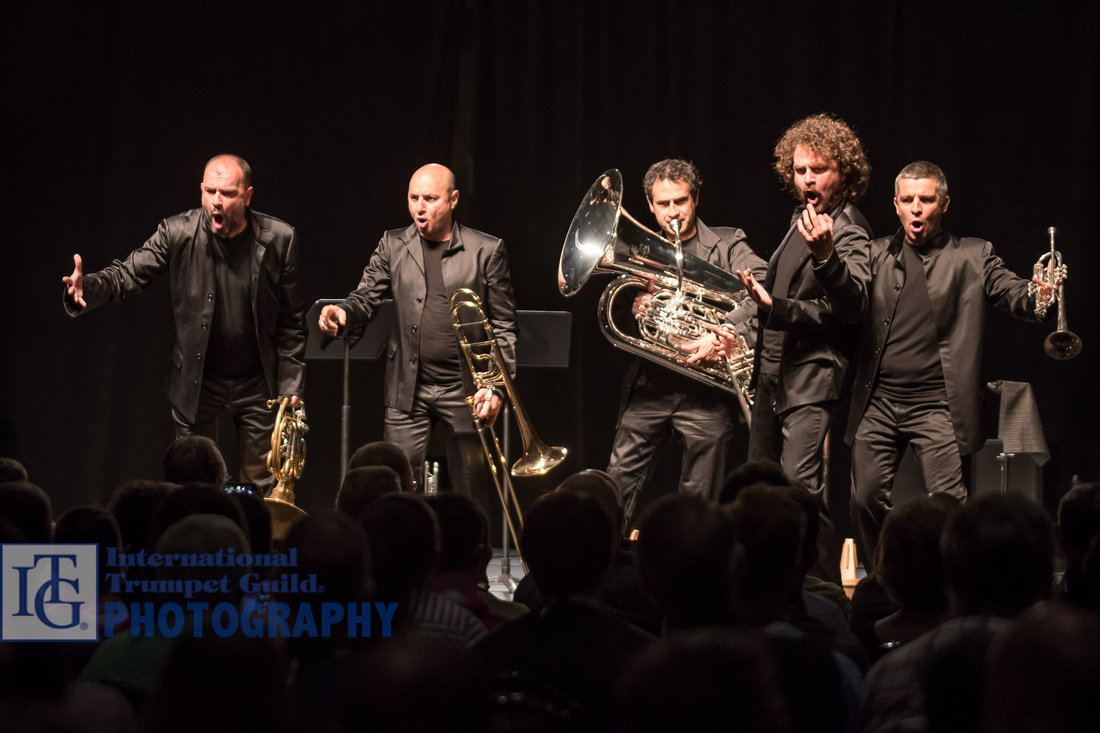 170531-0001-20Gomalan Brass Quintet
170531-0001-20Gomalan Brass Quintet
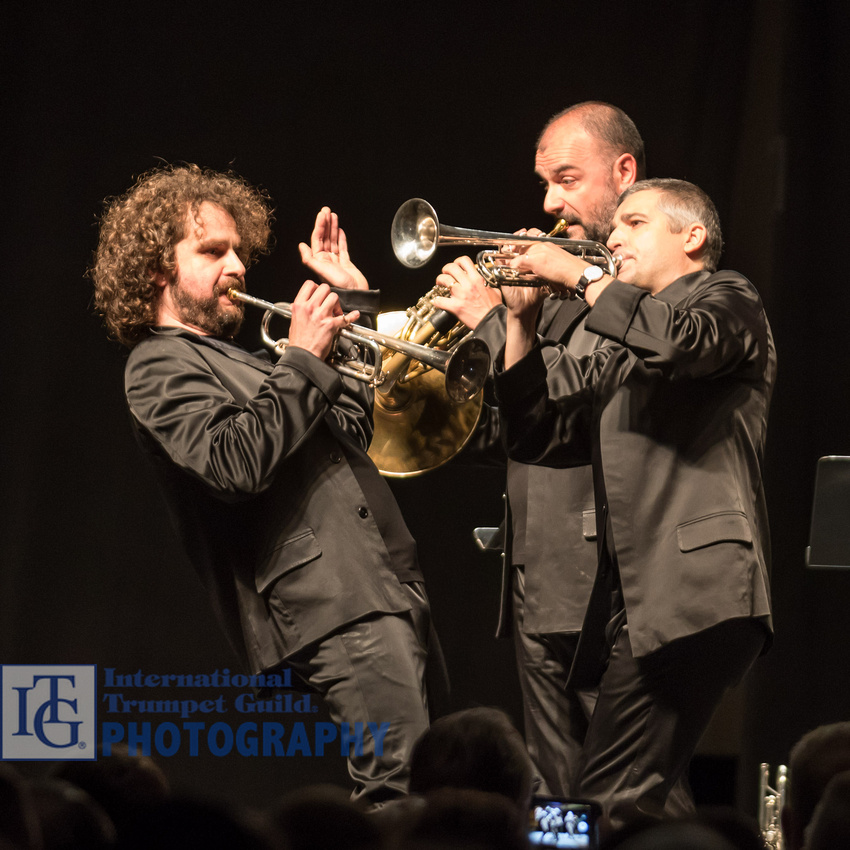 170531-0001-22Marco Pierobon (left), Marco Braito, (right)
170531-0001-22Marco Pierobon (left), Marco Braito, (right)
 170531-0001-18Marco Pierobon
170531-0001-18Marco Pierobon
 170531-0001-23Marco Pierobonn
170531-0001-23Marco Pierobonn
Evening Jazz Concert - Bria Skonberg and Her Quartet
Bria Skonberg, no longer a rising trumpet star, but one whose career as an all-around jazz artist has hit new heights, including a JUNO Award, offered the ITG audience an evening of superior “hot” and swinging jazz trumpeting and vocalizing. Backed by a superb and highly involved quartet, Skonberg and crew let all fly with terrific intensity and unbridled energy. Her program covered a marvelous variety of tempos from the “hot” classics (Louis Armstrong and Valaida Snow) to more texturally presented selections (Down in the Deep and So Is the Day), in which her sweet and sassy vocal approach engaged all. Skonberg’s arrangements of classic and original jazz standard tunes were involving and framed her soaring and swinging trumpet, superior vocal skills, and the ensemble’s outstanding group and solo efforts. This was a perfect close to a marvelous opening night at ITG! (NM)
]]>Special Daily Report • Compiled by Peter Wood
Photos by Michael Anderson, Norman Bergstrom, Del Lyren, and John Tamer
Wednesday, May 31 - Daytime events
This first full day of the conference saw delegates flooding the halls to see the plethora of exhibits, clinic sessions, and concerts. There is a great spirit in the air, and people seem genuinely pleased with the conference so far. The evening performances, in particular, were quite a thrill. If the rest of the conference goes like today, this will be an event to remember for sure!
Click here for more photos from the ITG Conference
Tim Hudson Warm-Up Session - Setting the Templates: A Guide to Daily Fundamentals
“As artists, our vision and mindset affects everything we do.” These were some of the first words spoken by Tim Hudson during his warm-up class. One of the key points of the session revolved around the mental approach to and process of trumpet playing. Focusing on the process is far more important than the product, as the process facilitates many aspects of performance, including tone production, note accuracy, anxiety, etc. He stressed playing in the center of the sound with a demonstration by first performing on the high side of center and then in the most resonant part of the pitch. “Hear what you want to sound like and then sound like what you want to hear.” Hudson’s claim to be a musician who happens to play the trumpet was demonstrated exquisitely through his performance in a singing style and through his ability to answer all questions from the audience fully and clearly. (SS)
Brianne Borden Warm-Up Session - Yoga for Trumpets: Bring Your Horn!
What do yoga and trumpet playing have in common? According to Brianne Borden, doctoral candidate at Arizona State University and yoga instructor, the answer is holding a physical posture while manipulating breath. In her early-morning warm-up session, Borden guided players through a series of physical and mental exercises derived from yoga, which help trumpeters play more efficiently and prevent career-ending injuries. She began the session by establishing foundational alignment and ended with a guided meditation in which players projected themselves into a successful performance scenario. “Yoga is a practice of body awareness,” she informed the audience; and when the body is healthy, the brain functions better. Stretches targeted three areas that affect trumpet players - wrists, shoulders, and intercostal muscles. Yoga won’t get a person into the practice room, but it is known to improve two other aspects of a successful performance - mental health and physical wellness. (MM)
Jason Bergman Presentation - Adaptive Teaching: Pedagogical Insights and Techniques Used in Teaching Students with Asperger’s Syndrome
Jason Bergman’s session concerned adaptive teaching strategies for students with Autism Spectrum Disorder (ASD). He was joined by his student, Olivia Funkhouser (ITG 2017 Scholarship winner), who earned her bachelor’s degree with Bergman at the University of Southern Mississippi and who will be entering the master's program to study with him at the University of North Texas next year. Bergman explained that 1 in 68 students have ASD, and Funkhouser was diagnosed with Asperger’s Syndrome during her first year of college. The teacher and student discussed and demonstrated various symptoms of ASD, including hypersensitivity, social deficits, inflexible thinking, and repetitive behaviors. Bergman prescribed such adaptive teaching strategies as social coaching, giving specific instructions (not metaphors), using blunt and direct feedback, encouraging a growth mindset, and structuring practice schedules and lesson plans. Funkhouser was an expert co-presenter and advocate for ASD students. Bergman posted his detailed slideshow notes and handout on his website (http://jasonbergman.com - click on “Blog”). (EK)
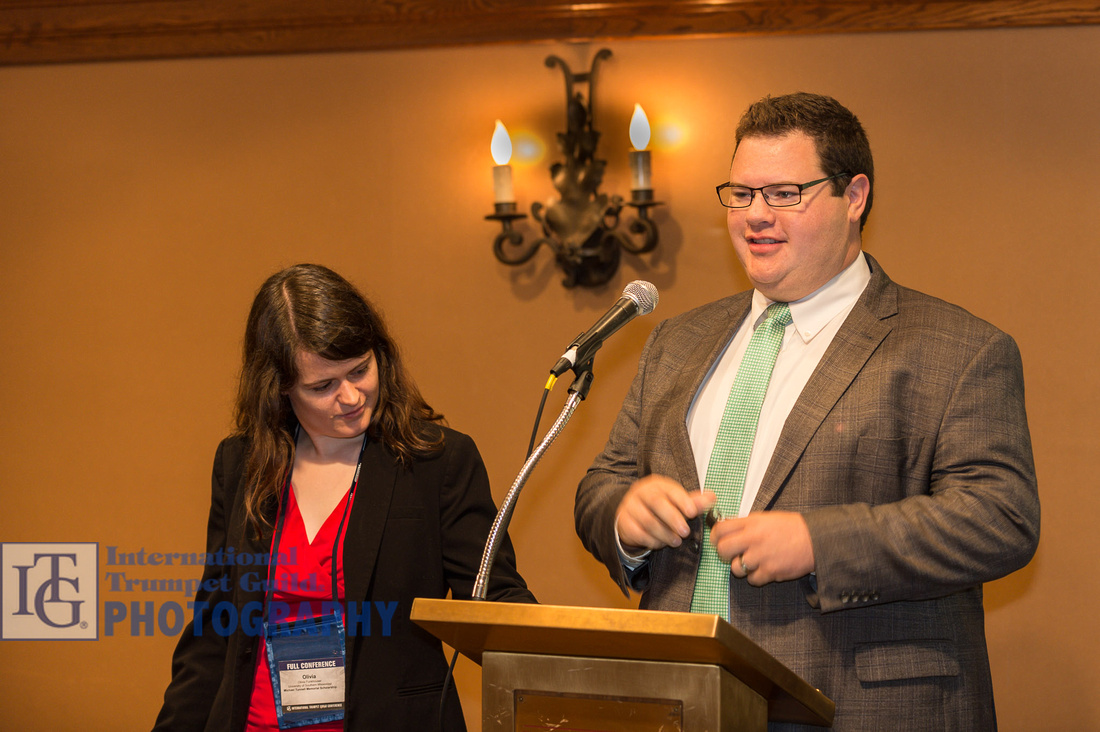 170531-0001L-R: Olivia Funkhouser and Jason Bergman
170531-0001L-R: Olivia Funkhouser and Jason Bergman
Jeff Purtle Presentation - Hit it Hard & Wish it Well: Claude Gordon’s Approach to Trumpet Playing
Having studied with Claude Gordon for a decade, there is perhaps no one more well versed in the famous pedagogue’s methods and routines than Jeff Purtle. The presentation focused on the primary teachings of Gordon and how to incorporate his methods into developing a strong, effective practice routine. Purtle emphasized Gordon’s approach that there is no music without mastery of technique and that it is, therefore, imperative to become a master on the instrument in order to make great music. In developing a routine, Purtle emphasized that consistency in practice leads to consistency in execution. While demonstrating many of the exercises in Gordon’s method books, Purtle detailed how to utilize each drill to enhance and stretch a player’s fundamental abilities. Purtle showed how Gordon’s approach of perfecting small excerpts of exercises, repeating them, and then gradually adding material can help a player refine any etude or piece. (EM)
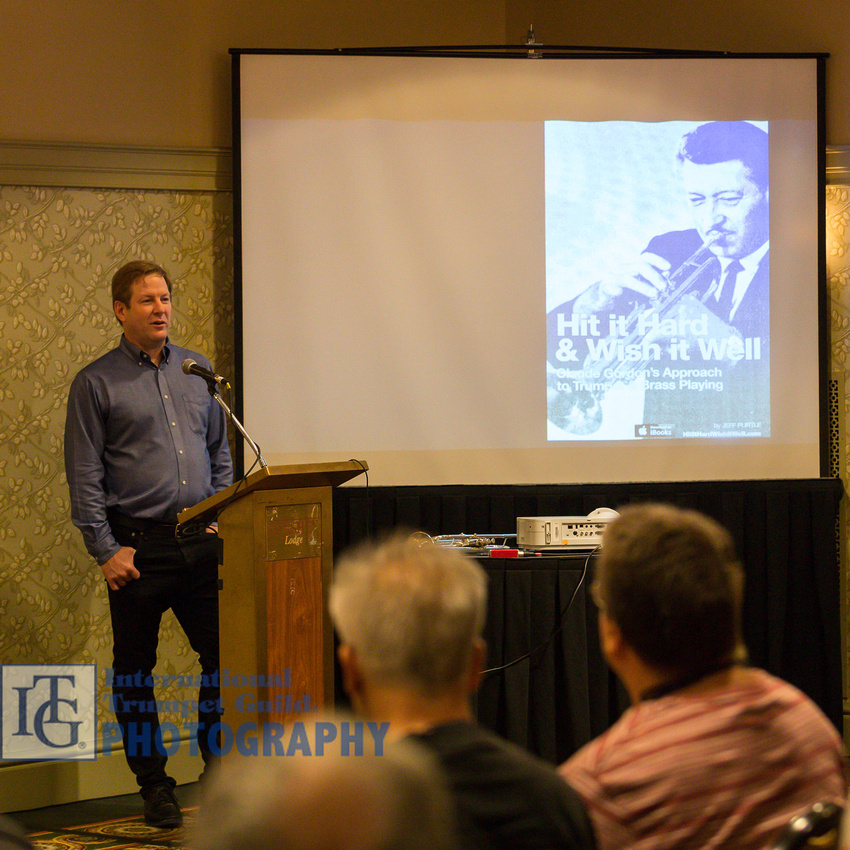 170531-0001-2Jeff Purtle
170531-0001-2Jeff Purtle
James Newcomb Presentation - MusicPreneur: Making Money, Making Music
James Newcomb presented a relaxed, informative clinic before a welcoming and interested audience. With his central message that musicians must always put music first and strive to share a story, Newcomb discussed how to harness the tools available in order to be a successful "MusicPreneur" (music entrepreneur). He encouraged audience members to find their niche in the market, establish rapport with a willingness to do things for free, and connect with audiences using every means available. There was a thought-provoking discussion about how to transition from offering services for free to actually making money, and Newcomb further stressed the importance of providing a valuable product to society. He shared that musicians should use their music to bring people together and help develop community. His clinic was enjoyable and informative. (SW)
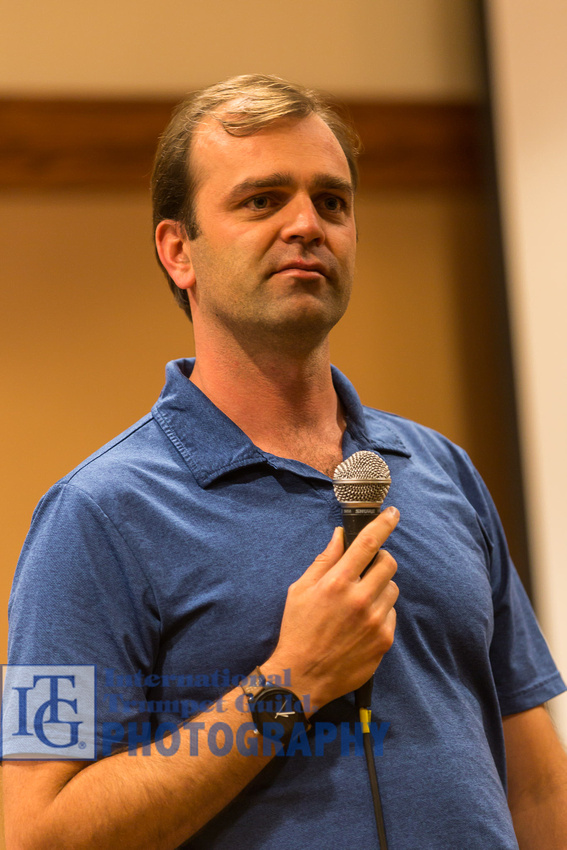 170531-0001-3James Newcomb
170531-0001-3James Newcomb
Bernardo Medel Recital - Rafael Méndez Extravaganza
From the very beginning of his recital, the virtuosity of Bernardo Medel, the acting principal trumpet of the Xalapa Symphony Orchestra in Mexico, was on full display. Medel’s program, in collaboration with pianist Miriam Hickman, highlighted his magnificent facility, multiple-tonguing prowess, and technical mastery throughout, and he also serenaded the audience with soft, delicate tones and vibrato. One of the most stunning aspects of his playing was the character that he instilled in every flourish. While pieces by Arban, Vizzutti, and Hartmann were included, the majority of the works were composed or arranged by the great Rafael Méndez. Through a translator, the humble Medel described how honored he was to perform at an ITG Conference and what a thrill it was to present music by "the best Mexican trumpet player." (DD)
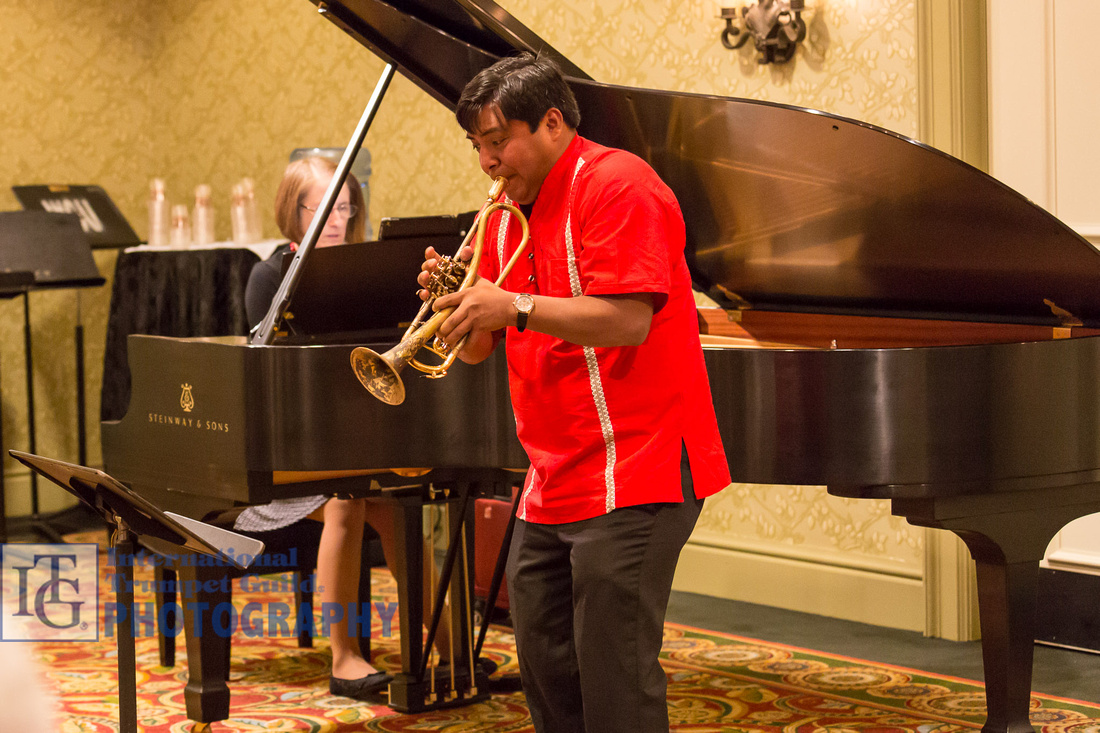 170531-0001-4Bernardo Medel with pianist Miriam Hickman
170531-0001-4Bernardo Medel with pianist Miriam Hickman
William Stowman Recital - A Timeless Place
The one word to describe William Stowman’s recital is clearly “versatility.” He not only performed on six different trumpets, but he also showed effortless skill in a multitude of styles. He was joined on stage with numerous colleagues, as well as past and previous students. Stowman’s repertoire ranged from a delicate and graceful performance of Bach with a powerful vocal soloist, to a more contrasting and creatively expressive performance of Shchedrin. The program included a world premiere, composed for ITG, by Leidhecker, in which Stowman stood among the Messiah College Brass Quintet and displayed his beautiful tone on the E-flat trumpet. The tear-jerker of the recital was the final piece, Jimmy Rowles’s A Timeless Place, which was dedicated to the memory of Stowman’s father, who had consistently supported his son’s musical career. (BB)
 170531-0001-5Bill Stowman
170531-0001-5Bill Stowman
Virginia “Ginger” Turner Presentation - Prepare to Win!!
Trumpet players of all ages filled Magnolia ballroom for SGM Turner’s clinic on preparing to win a military band audition. Turner’s wonderfully authentic and honest style of communication put audience members instantly at ease as she discussed a wide range of topics regarding the audition process. Although an array of topics emerged and resonated with those in attendance, a few subjects stood out from the others. Turner discussed at length different ways to practice trouble spots in popular military band excerpts efficiently. She also stressed the value of preparedness and reminded audience members to stay true to themselves and not to worry about what is out of their control. The clinic ended with a rousing performance of everyone in the audience buzzing Sousa’s Stars and Stripes Forever on their mouthpieces, ending the clinic with laughter as a wonderful sense of camaraderie filled the room. (RW)
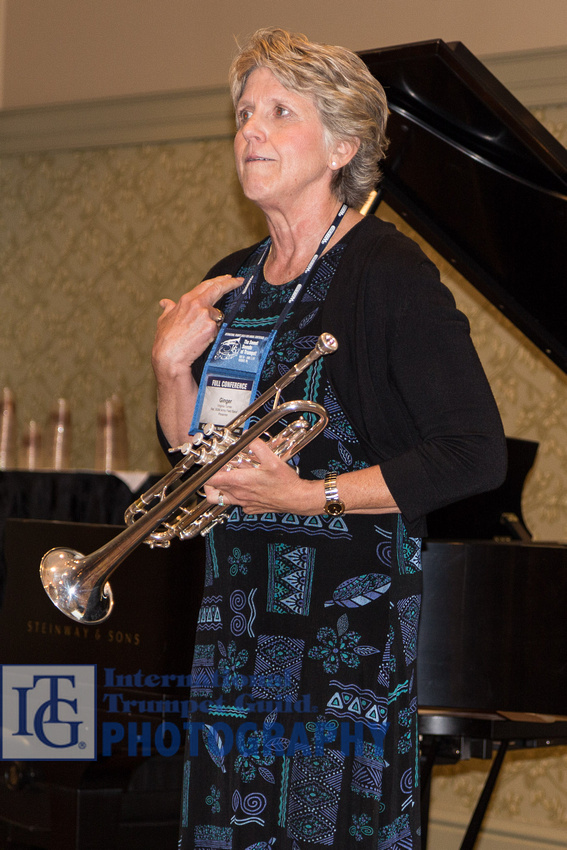 170531-0001-6Ginger Turner
170531-0001-6Ginger Turner
Terry Warburton Presentation - Finding the Right Tool for the Job: Why Equipment Matters
Prior to Terry Warburton’s clinic, an ensemble of Warburton artists, including Rob Quallich, Tyler Jaeger, Ryan Chapman, Mike Vax, Jose Johnson, Gerry Lopez, Kim Aubuchon, and Max Deforest (and conducted by JB Scott), performed a bright fanfare medley arranged by Ryan Chapman. The medley featured Gonna Fly Now, Home to Emily, MacArthur Park, and Here Comes the King. This eclectic mix of tunes had the audience eagerly engaged, as the trumpets began playing with no holds barred from the start, featuring several screaming trumpet solos. The entire group performed with energy and enthusiasm after just one rehearsal.
After a brief introduction by ITG President Brian Evans, Terry Warburton set the tone for a playful and enjoyable clinic session with some lighthearted banter between himself and the prelude trumpeters. Warburton proceeded to discuss the importance of selecting equipment that matches each player’s unique physique and performing style. Warburton stated that many players are under the assumption that they must play with a large mouthpiece cup to demonstrate strength, but this is not true. He remarked that a mouthpiece found to be appropriate for a player twenty years ago is not necessarily the best selection for that player now, based on changing physical characteristics and playing demands. Sometimes an adjustment of one one-thousandth of an inch in diameter can make the difference between playing comfortably with a great sound and struggling unnecessarily. His presentation was followed by a dynamic question-and-answer session on mouthpiece construction and equipment choice. (OF)
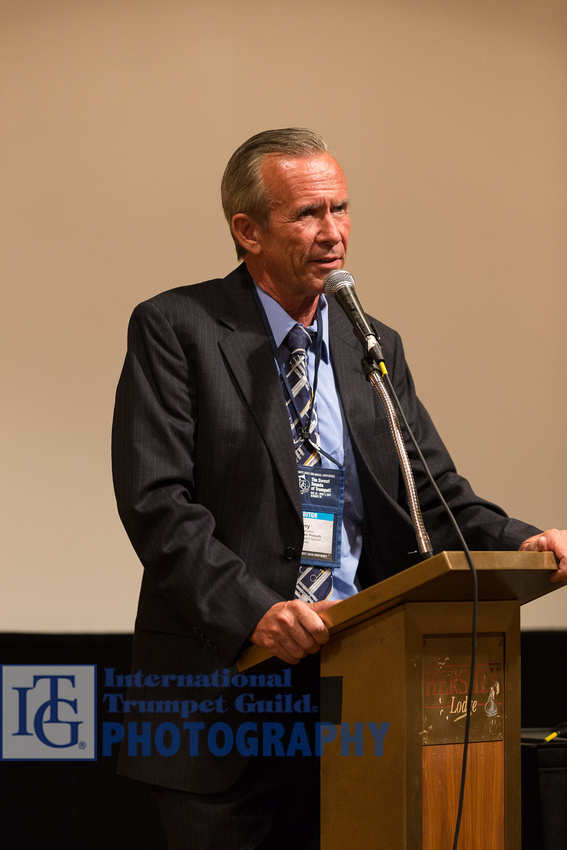 170531-0001-7Terry Warburton
170531-0001-7Terry Warburton
Bria Skonberg Presentation - Evolutionary Improvising
During her afternoon clinic, Bria Skonberg discussed her life as a jazz artist and presented an approach to performing traditional jazz. She opened with a wonderful a capella version of “Happy Birthday,” showcasing her easy melodic approach with great time-feel and harmonic language. She did an excellent job of providing historical context for the development of jazz in New Orleans. She led the audience in layered hand clapping of habañera and clave rhythms, which was reminiscent of what would have been heard in Congo Square in the late nineteenth century. She explored the three primary elements of music for improvisation - rhythm, melody, and harmony. For each element, she discussed and demonstrated different approaches to practicing improvisation on “Happy Birthday.” The constant element throughout the clinic was Skonberg’s amiable personality; her wonderful sense of humor and jovial nature were a valuable lesson to all of us on how to connect with an audience. (NV)
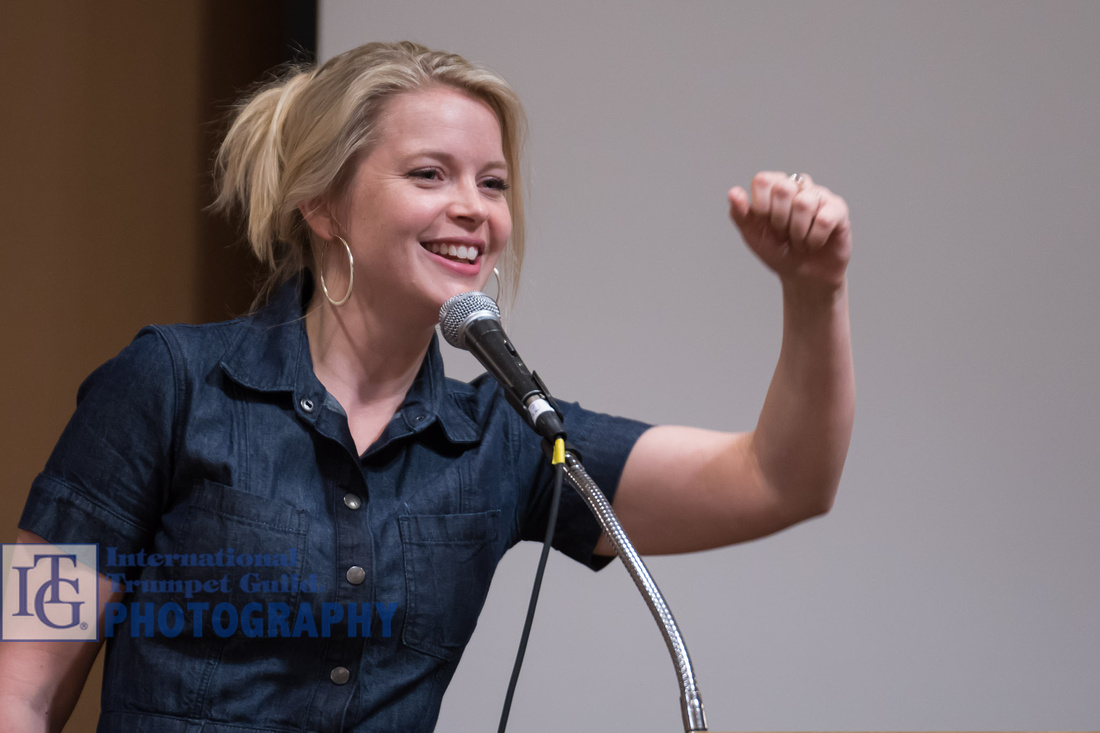 170531-0001-10Bria Skonberg
170531-0001-10Bria Skonberg
Huw Morgan Recital - The French Connection
Winner of the 2016 Ellsworth Smith Competition and the 2016 Prague Spring Competition, Huw Morgan is currently the principal trumpet of the Basel Symphony Orchestra. His recital with pianist Rebecca Wilt took place before a full audience in the Magnolia Ballroom and featured a masterful and virtuosic performance of French recital repertoire. An elegant performance of Hubeau’s Sonata highlighted Morgan’s ability to contrast his full rich tone with silky smooth soft dynamics. The second work, Reynaldo Hahn’s “A Chloris,” is an approachable love song that would make a beautiful addition to student recitals. The Enesco Légende was performed with stunning lyricism, brilliant technique, and a haunting rendition of the muted ending. The recital closed with Arban’s Fantasie Brilliante, superbly showcasing Morgan’s gorgeous cornet sound, always-elegant phrasing, and polished flair. The audience gave both performers an enthusiastic and well deserved standing ovation. (AK)
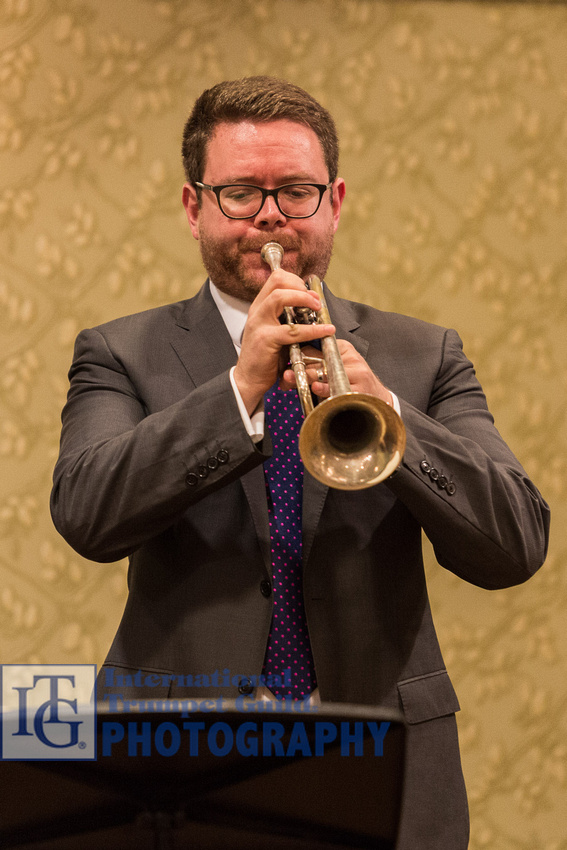 170531-0001-9Huw Morgan
170531-0001-9Huw Morgan
Marc Reese and Robert Sullivan Recital
Marc Reese explained to the audience that he “just wanted to play with the great trumpeter Bob Sullivan,” and the result was a varied, extremely musical, and highly enjoyable recital held at the First United Methodist Church in downtown Hershey. The recital began and ended with works for two trumpets and organ. Reese explained that the works were arranged from pieces originally performed by the Empire Brass Quintet, including Handel's Prelude in F Major for Two Trumpets and Organ (originally known simply as "Aria"), and J. S. Bach's Three Cantatas for Two Trumpets and Organ, including “My Spirit Be Joyful” from Cantata No. 146. Marc Reese performed Alan Hovhaness's Prayer of St. Gregory and the first movement of the Neruda Concerto in E-flat. Robert Sullivan chose such lesser-known works as Naji Hakim’s three-movement Sonata (written in 1994 for Håkan Hardenberger), and Gunther Schuller’s Pavane. Organist Dan Umholtz provided the able accompaniment on the church’s 2010 Letourneau organ. (KE)
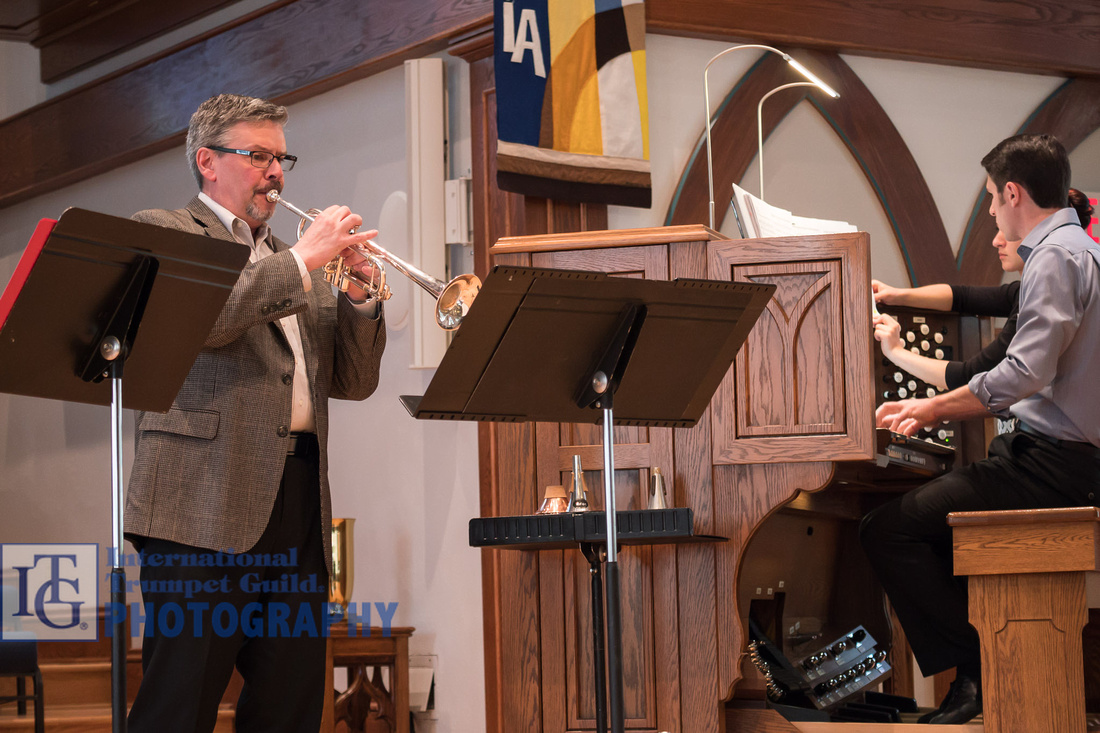 170531-0001-11Robert Sullivan with organist Dan Umholtz
170531-0001-11Robert Sullivan with organist Dan Umholtz
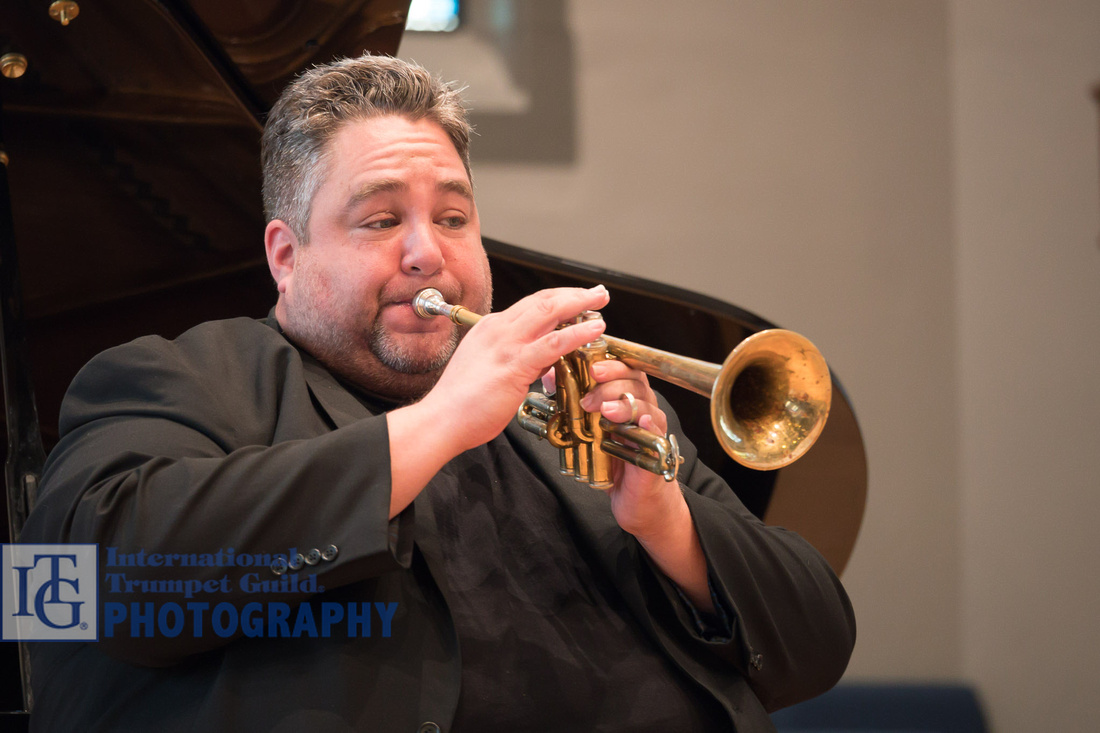 170531-0001-12Marc Reese
170531-0001-12Marc Reese
Orchestral Excerpts Competition Finals
During the final round of the Orchestra Excerpts Competition, audience members were treated to beautiful music as the competitors performed a diverse and challenging list of excerpts. David Koch (student of Paul Merkelo at McGill University) played first, demonstrating good musical understanding and expression throughout. His soft playing on Debussy’s Fêtes was impressive, with a particularly brilliant Finale from Stravinsky’s Pulcinella Suite. Francis LaPorte (student of Richard Stoelzel at McGill University) showed his ability to play with strength and power, particularly in the excerpts from Strauss’s Ein Heldenleben. Lastly, Alex Wilborn (student of Raquel Rodriquez at Tennessee Technology University) demonstrated beauty and finesse with an outstanding performance of the excerpt from J. S. Bach’s Christmas Oratorio. All three finalists played extremely well, and the audience thoroughly enjoyed the performance by all three competitors. (SW)
Nadje Noordhuis Jazz Concert
On Nadje Noordhuis's highly enjoyable jazz recital, all of the selections were her own and ranged in style from tributes to more conceptual, genre-inspired tunes. Le Hameau Omi is a tango that enabled Noordhuis to display her velvety sound with fiery interjections and lines that seemed to lead listeners around the dance floor. Mirror Ball was inspired by her love of 1970s cop shows and disco music, with the group sounding like a mixture of Peter Gunn, Shaft, and film-noir. A tribute to Bix Beiderbecke, called Blues 4 Bix, was an inventive blend of Beiderbecke style and Kansas City blues. Indigo allowed Noordhuis to highlight a new area of interest, using effects pedals to add delays and reverb. This was a well mixed recital and showcased well Noordhuis’s remarkable versatility as a trumpeter and composer on the jazz scene. (KM)
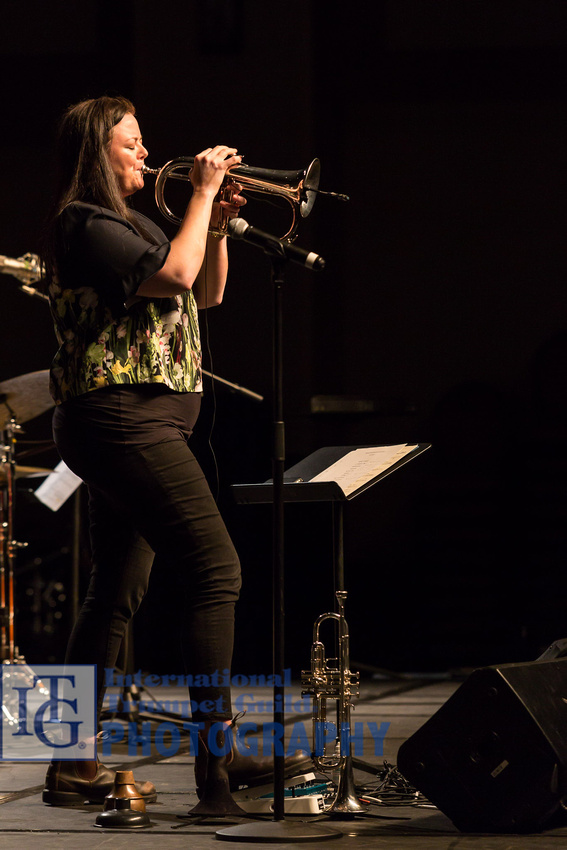 170531-0001-17Nadje Noordhuis
170531-0001-17Nadje Noordhuis
Non-Pro and Comeback Players Reception
A gathering of approximately 80-100 of the non-pro members of ITG was held at Your Place Sports Bar. The group was joined by many ITG Board members, including the current and three past presidents of ITG. Non-Pro Player Committee Chairman Dan Hallock introduced the members of the committee, explained its mission, and described what has been done on behalf of this very large group of the ITG membership in the past year. ITG President Brian Evans welcomed all those in attendance and shared his greetings and appreciation to all. As always at these events, old friendships were renewed and new friends were welcomed. This annual event is always one of lively discussion and exchange of information, and this year’s gathering was no exception. It remains an event that all non-professional members of ITG should attend. (DR)
Click here for more photos from the ITG Conference
]]>
Special Daily Report • Compiled by Peter Wood
Photos by Michael Anderson and Brian Shook
Tuesday, May 30
This opening evening of the 42nd annual ITG Conference was filled with the usual sense of excited anticipation of the wonderful trumpet-related events to come over the next four days and five nights. The Hershey Lodge is a warm, welcoming environment with chocolate-themed decor everywhere. As hundreds of people began arriving with both suitcases and gig bags in hand, there were plenty of smiles, handshakes, hugs, and laughs to go around with new friendships forged and old ones reaffirmed.
Click here for more photos from the ITG Conference
Mass Trumpet Ensemble with Doc Severinsen
To kick off the 42nd annual ITG Conference, a trumpet ensemble of several hundred players of all ages performed Dennis L. Horton’s four-part arrangement of highlights from the second act of Verdi’s Aïda, under the baton of the legendary Doc Severinsen. Players stood all over the ballroom - in the rows of seats in the audience or around the room’s perimeter - with Doc conducting from the stage. Some attendees brought wire music stands, while others had sheet music propped on open cases, flat on tables, or in their left hand. The sounds of trumpeters warming up gave way to applause as Doc crossed the stage to the piano to strike a tuning note. Everyone stood as if on cue. Doc then approached the microphone and shouted, “Are you ready?” after which the room exploded into glorious sound. A couple of players stepped into the holes, and another handful screamed above the staff on the last note. It was what all mass ensembles are at their best: informal, joyful, and oh-so-loud! A good time was had by all. (MM)
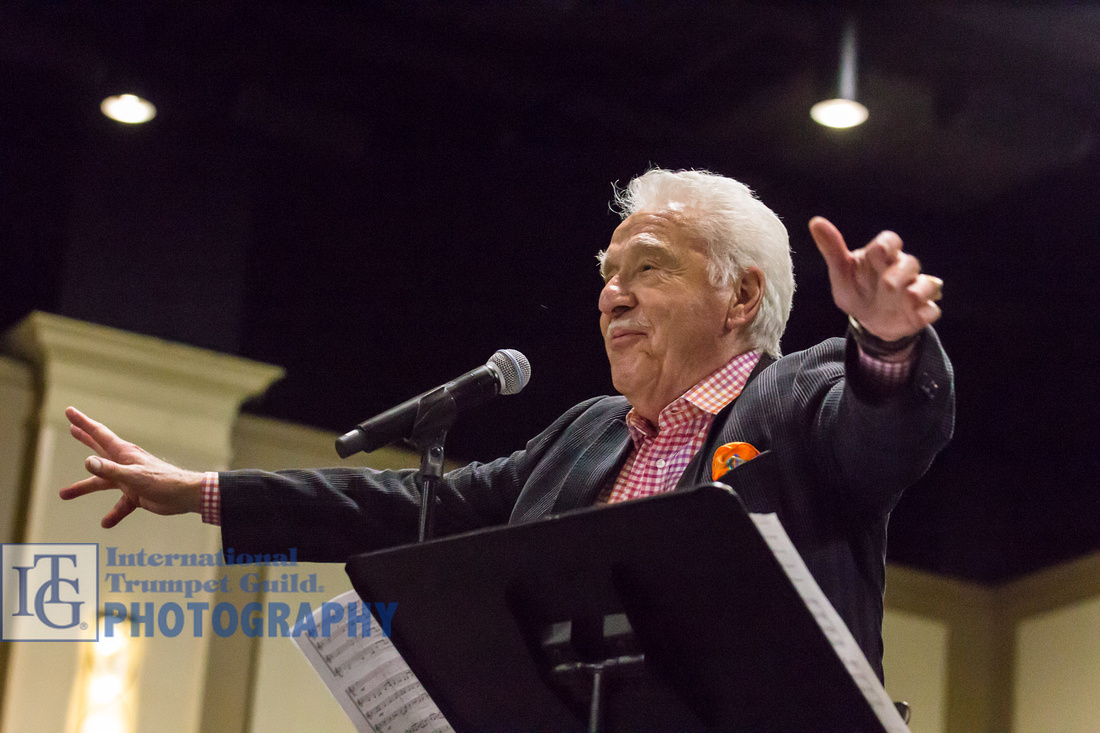 Large Trumpet Ensemble With Doc Severinsen
Large Trumpet Ensemble With Doc Severinsen
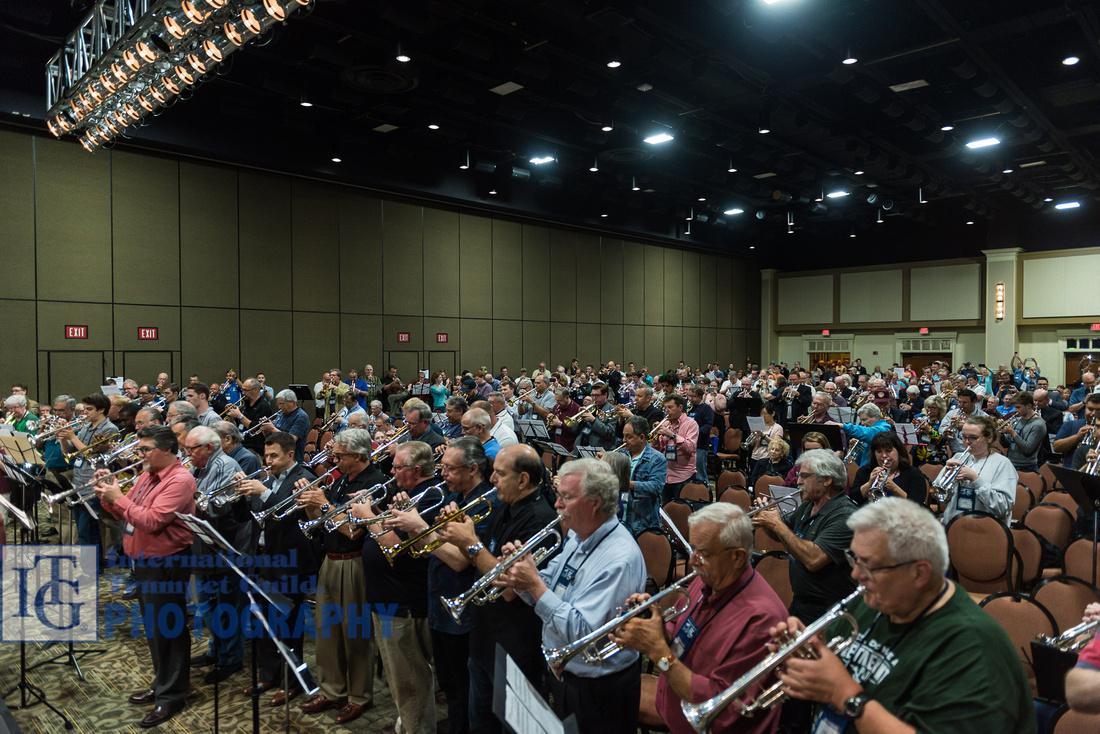 Large Trumpet Ensemble With Doc Severinsen
Large Trumpet Ensemble With Doc Severinsen
Opening Gala Concert: Eastern Wind Symphony and Soloists
The Opening Gala Concert featured both new and familiar faces. Held in the Great American Red Hall of the Hershey Lodge, five trumpeters performed solos and ensemble works, accompanied by the Eastern Wind Ensemble. Immediately evident were the surprisingly good acoustics of the hall. The wind ensemble was well balanced and generally did not overpower the soloists, and the entire range of dynamics performed by the soloists could be heard easily.
Kevin Gebo and Matthew Harding were the evening’s first soloists. Gebo is currently a Staff Sergeant in the United States Army Band, and Harding is a former member of “The President’s Own” United States Marine Band. They performed Anthony Plog’s Double Concerto. This work is modeled after Antonio Vivaldi’s Concerto for Two Trumpets, utilizing a similar instrumentation for the accompanying ensemble. Plog even goes so far as to quote Vivaldi’s work toward the end of the piece. Gebo’s and Harding’s sounds matched perfectly, using C trumpets for the outer movements and switching to flugelhorns for the Lento movement, this reviewer’s favorite.
Ryan Anthony is the principal trumpet with the Dallas Symphony. Known for creating the Ryan Anthony Foundation and for hosting a series of all-star Cancer Blows concerts during his battle with multiple myeloma, Anthony performed Peter Meechan’s Renaissance of Wonder. Anthony explained that the work is based on five inspirational quotations that he read throughout his battle with cancer. Anthony said that the piece is about hope, and his lush sound, especially in the lyrical sections of the piece, resulted in the first standing ovation of the conference.
Robert Sullivan, professor of trumpet at Northwestern University, is a familiar face to regular attendees at ITG conferences. He performed Joseph Turrin’s The Sounding of the Call. In three sections, the opening march-like theme gives way to a beautiful, at times urgent, slower middle section, before returning. Sullivan’s clarity and focus of sound were striking.
Anthony, Sullivan and Gebo returned to the stage to perform Peter Meechan’s Song of Hope. Originally the second movement of Meechan’s cornet concerto, Anthony asked Meecham to rewrite it as a stand-alone work. The result is a breathtaking work that was performed brilliantly by all three soloists.
Currently the principal trumpet of the Royal Philharmonic Orchestra in London, James Fountain performed Blaze, by British composer Philip W. Lawrence. With a bit of a “Latin” feel, the piece is reminiscent of works by Allen Vizzutti, featuring angular lines that require great agility by the soloist. While it was, at times, difficult to hear the soloist over the ensemble, Fountain’s remarkable virtuosity was clearly evident throughout.
The concert ended with two works for multiple trumpets - Anthony DiLorenzo’s Trumpets on Parade, featuring Ryan Anthony, James Fountain and Matthew Harding, and Anthony Naulais’ Le Vent des Hélices (The Wind of the Propellers), featuring all five soloists. Trumpets on Parade was a fun Bugler’s Holiday type of piece, even quoting this work near the end. Equally playful, Le Vent des Hélices again highlighted the impressive acoustics of the hall, with the audience able to hear the soloists above the ensemble, even when three of them used harmon mutes.
The audience left thrilled. What an exciting and inspiring start to the conference! (KE)
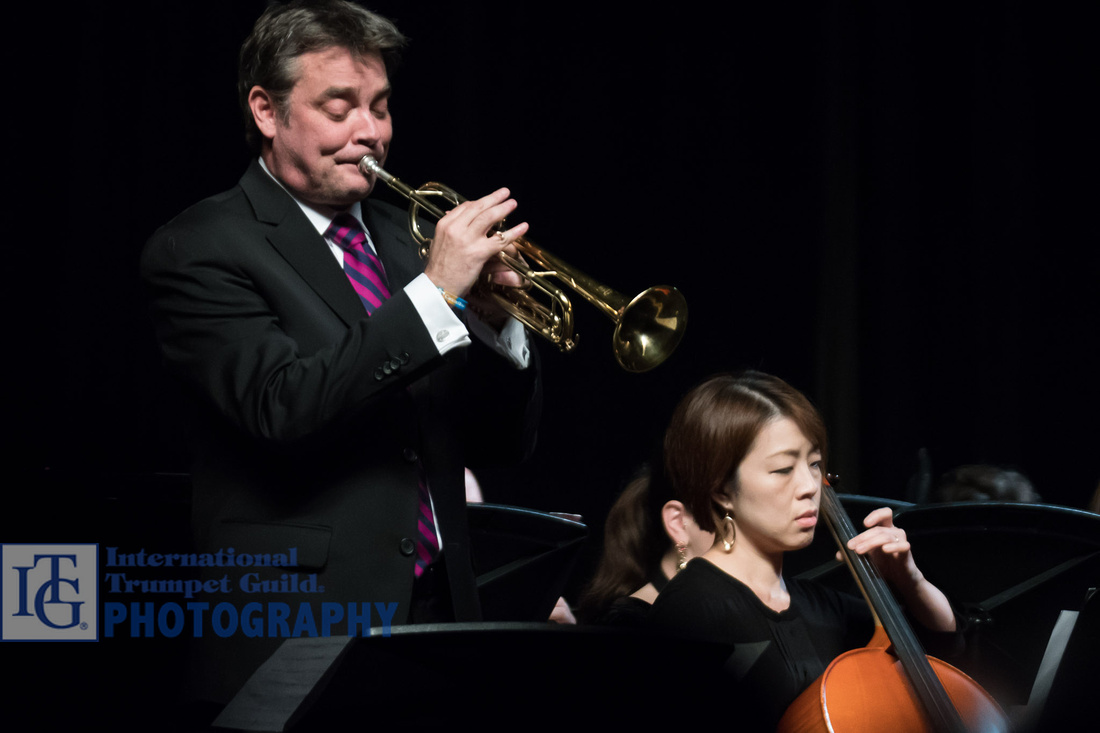 170530-0001-8Ryan Anthony
170530-0001-8Ryan Anthony
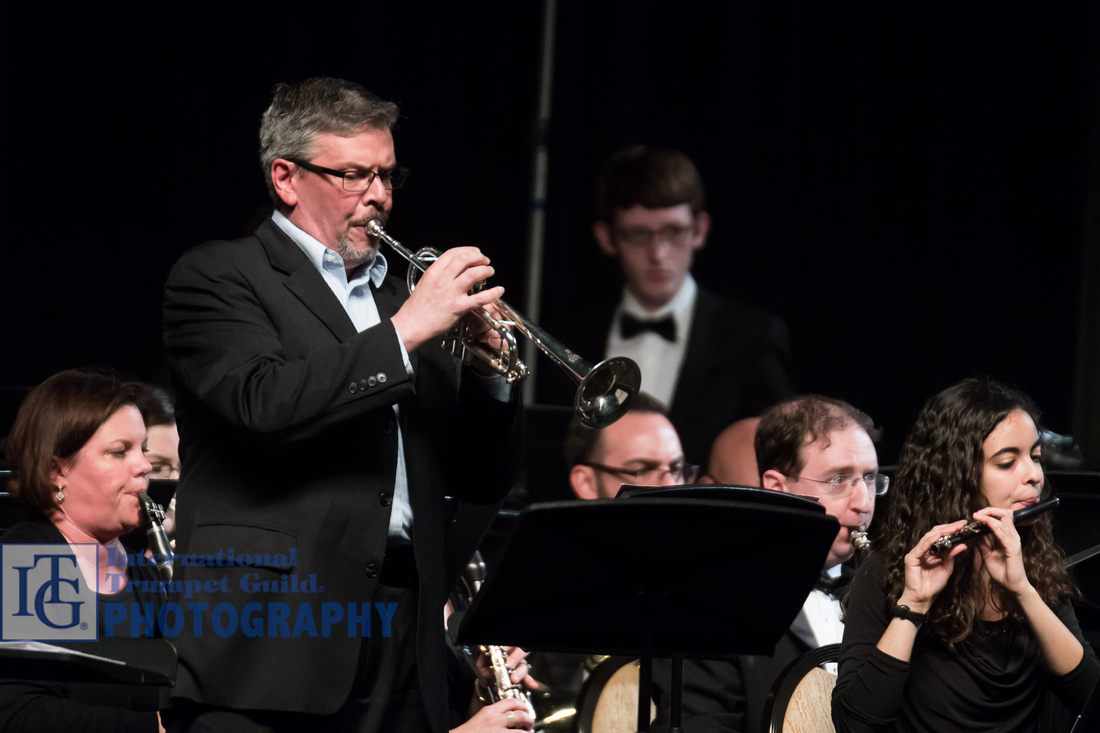 170530-0001-12Robert Sullivan
170530-0001-12Robert Sullivan
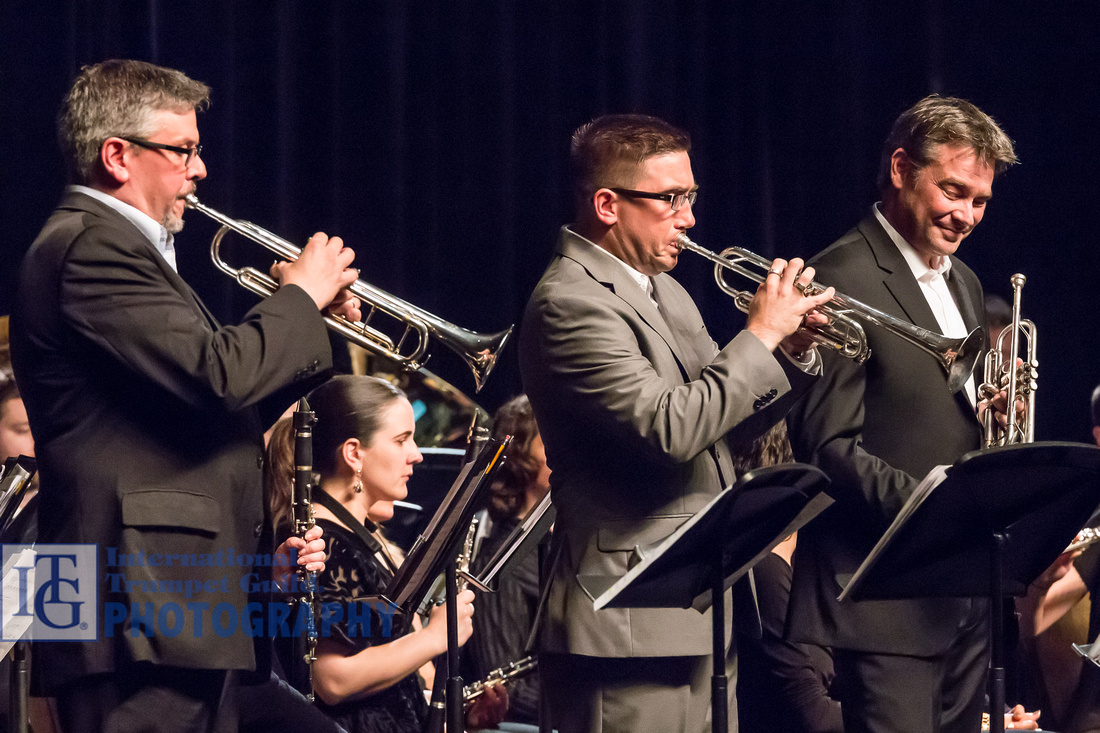 170530-0001-13L-R: Robert Sullivan, Kevin Gebo, Ryan Anthony
170530-0001-13L-R: Robert Sullivan, Kevin Gebo, Ryan Anthony
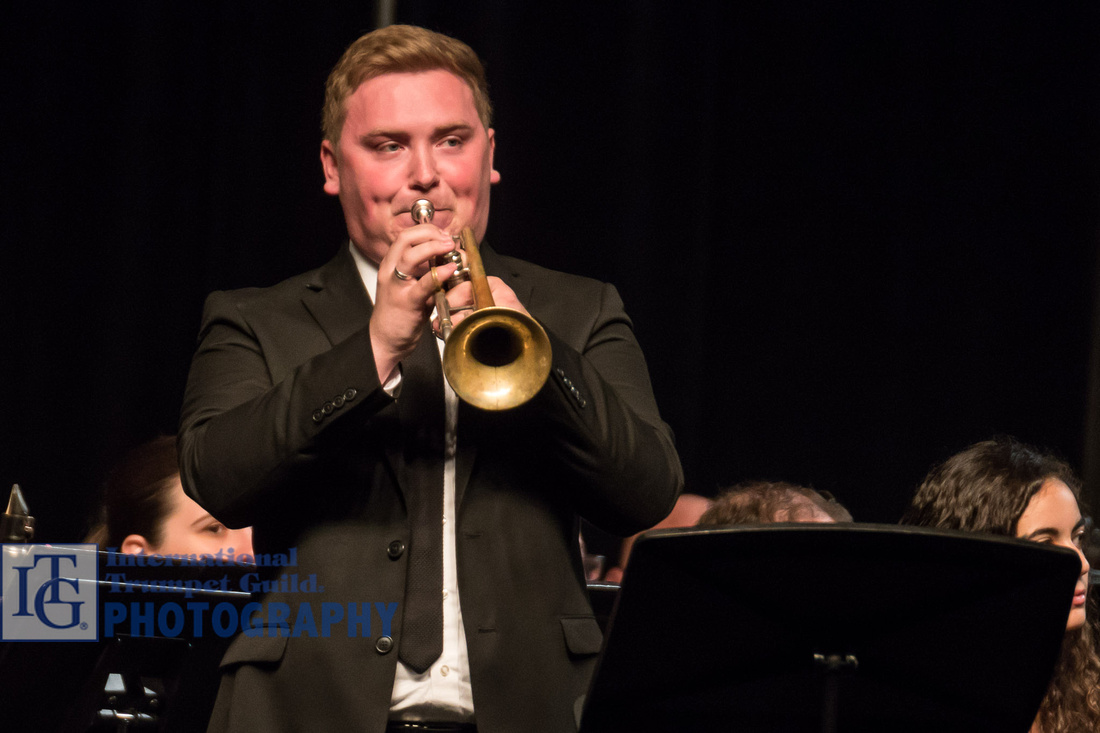 170530-0001-13James Fountain
170530-0001-13James Fountain
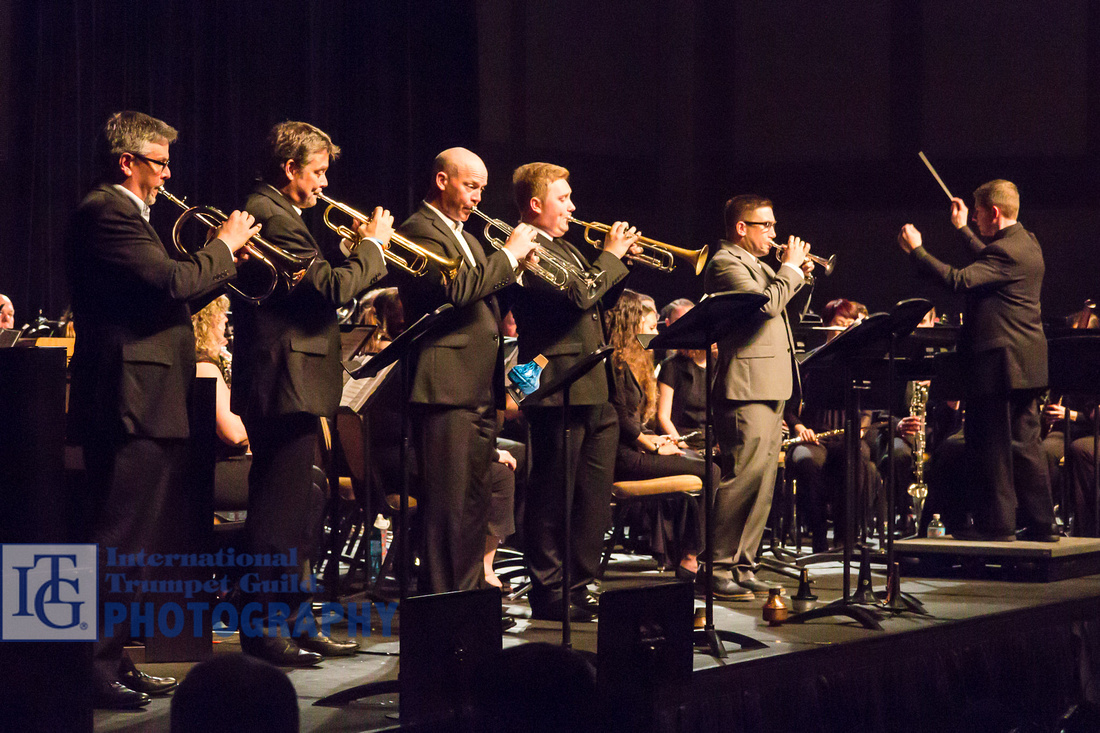 170530-0001-13L-R: Robert Sullivan, Ryan Anthony, Matthew Harding, James Fountain, Kevin Gebo
170530-0001-13L-R: Robert Sullivan, Ryan Anthony, Matthew Harding, James Fountain, Kevin Gebo
Click here for more photos from the ITG Conference
]]>
